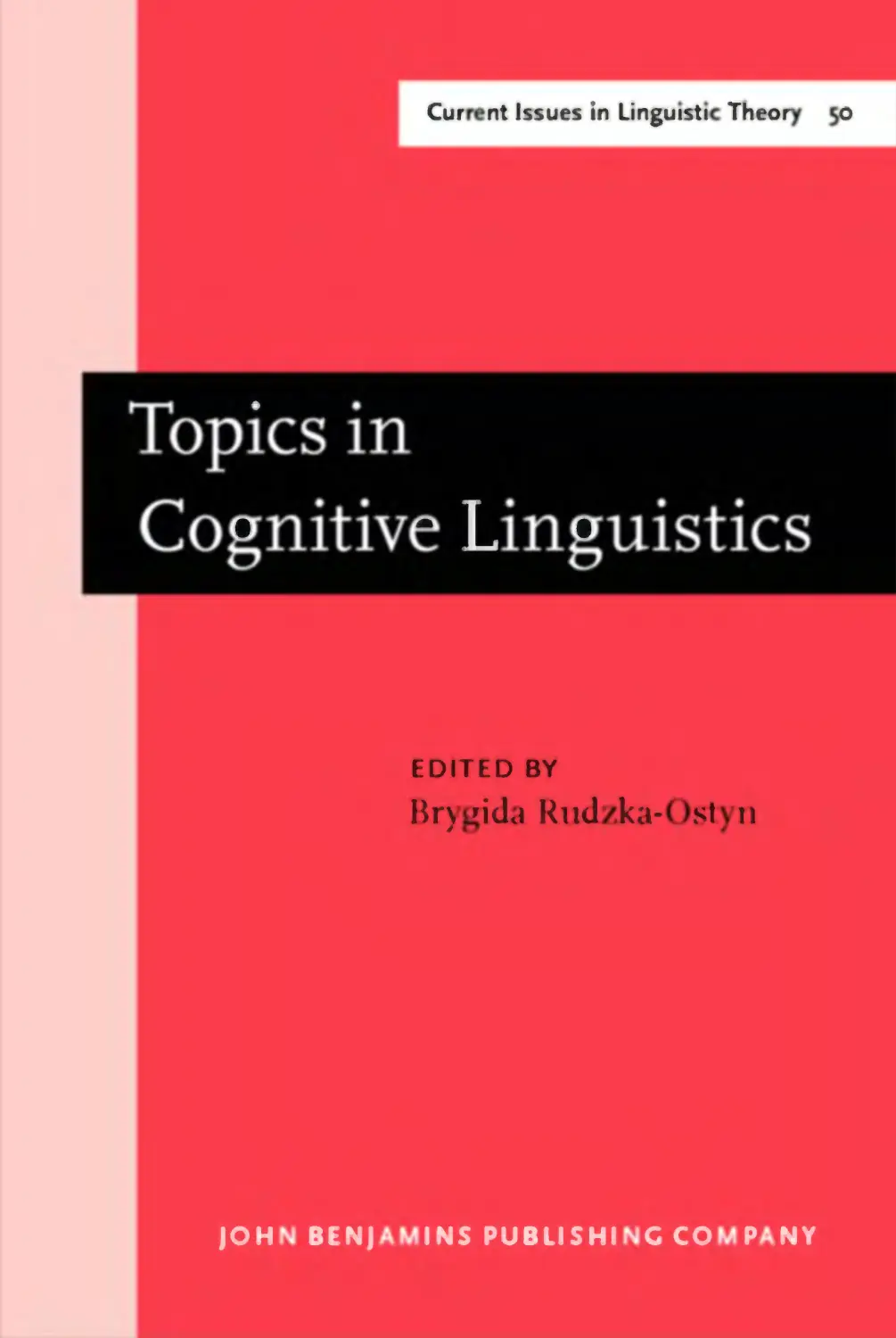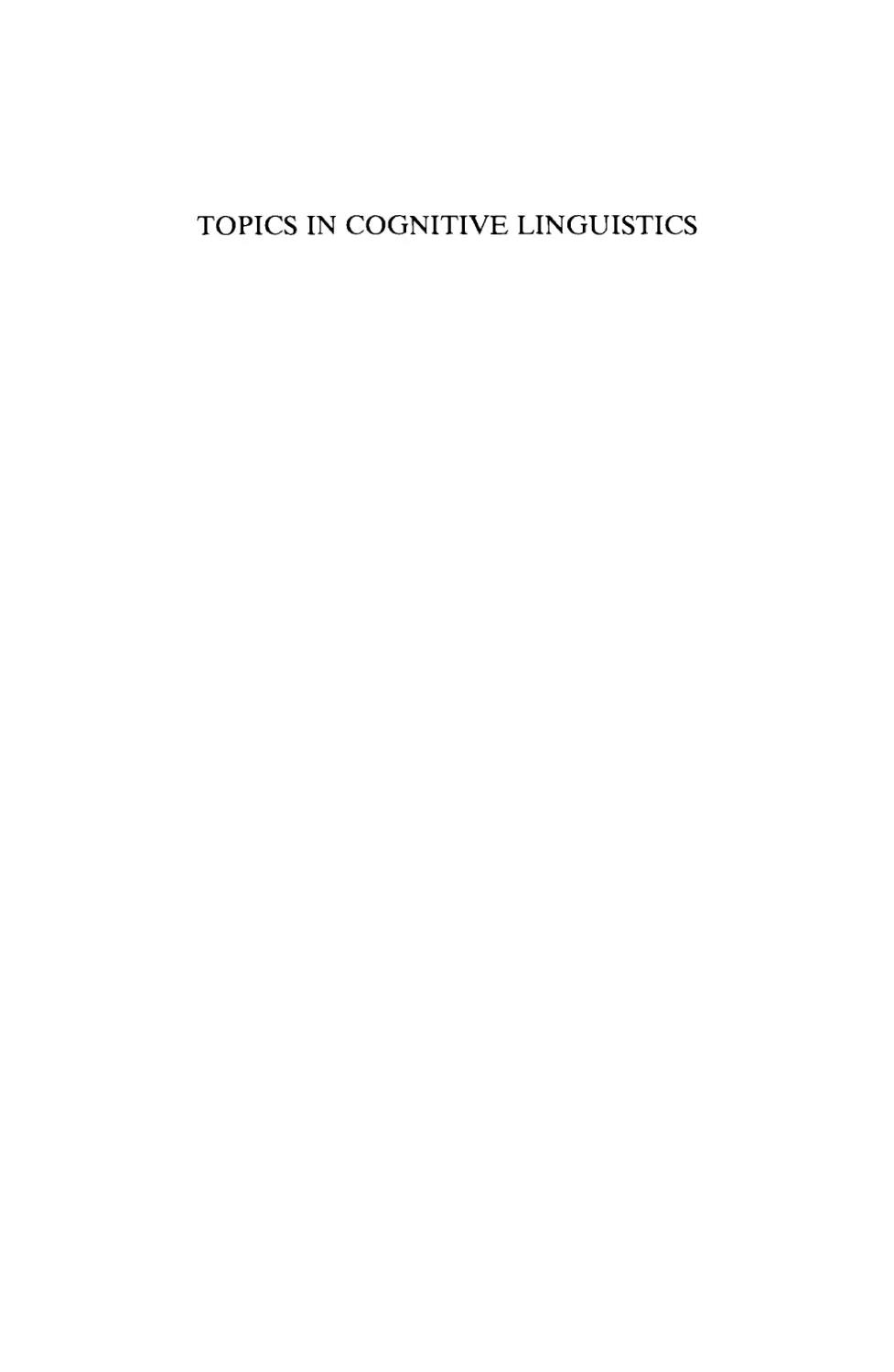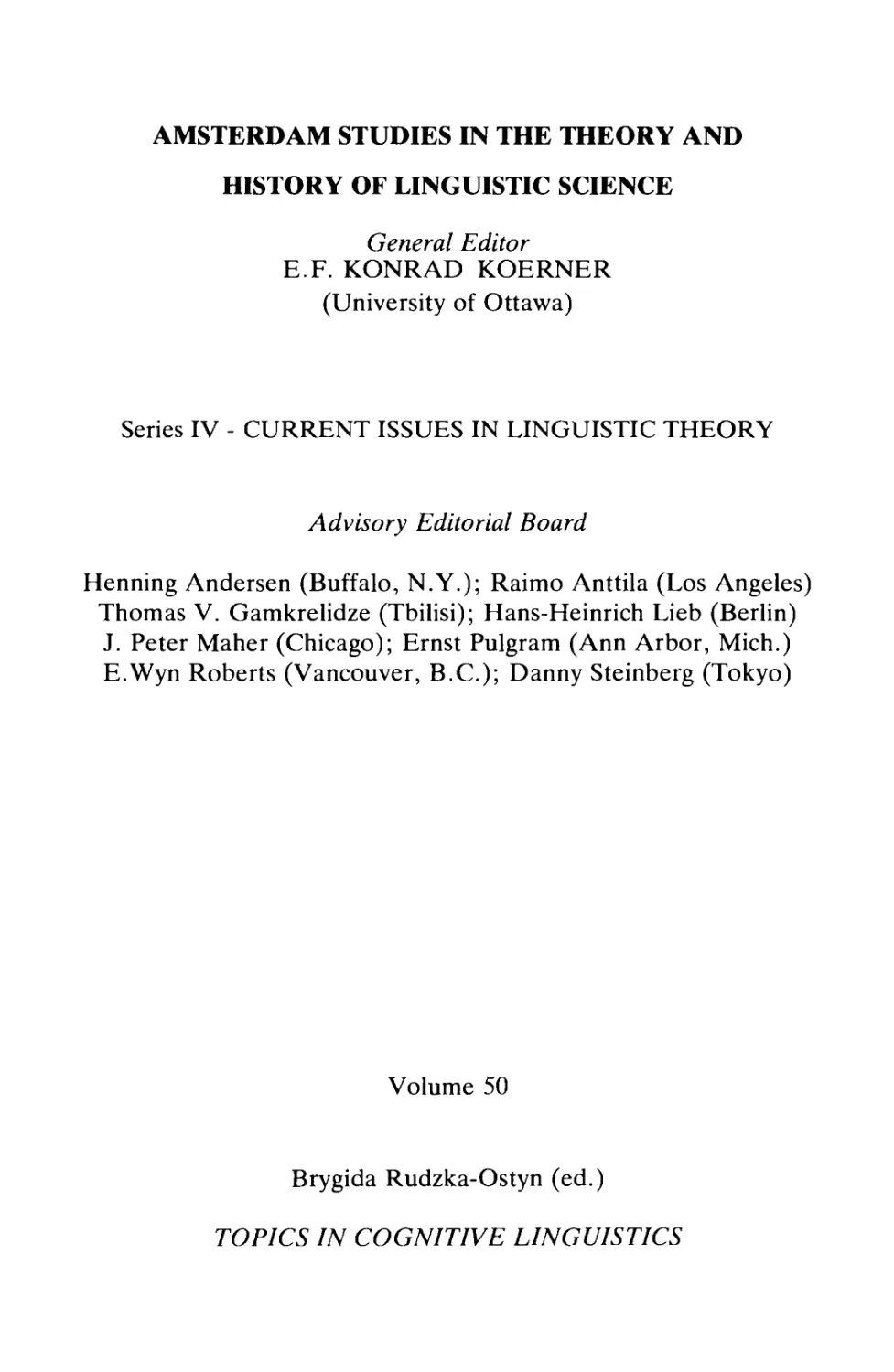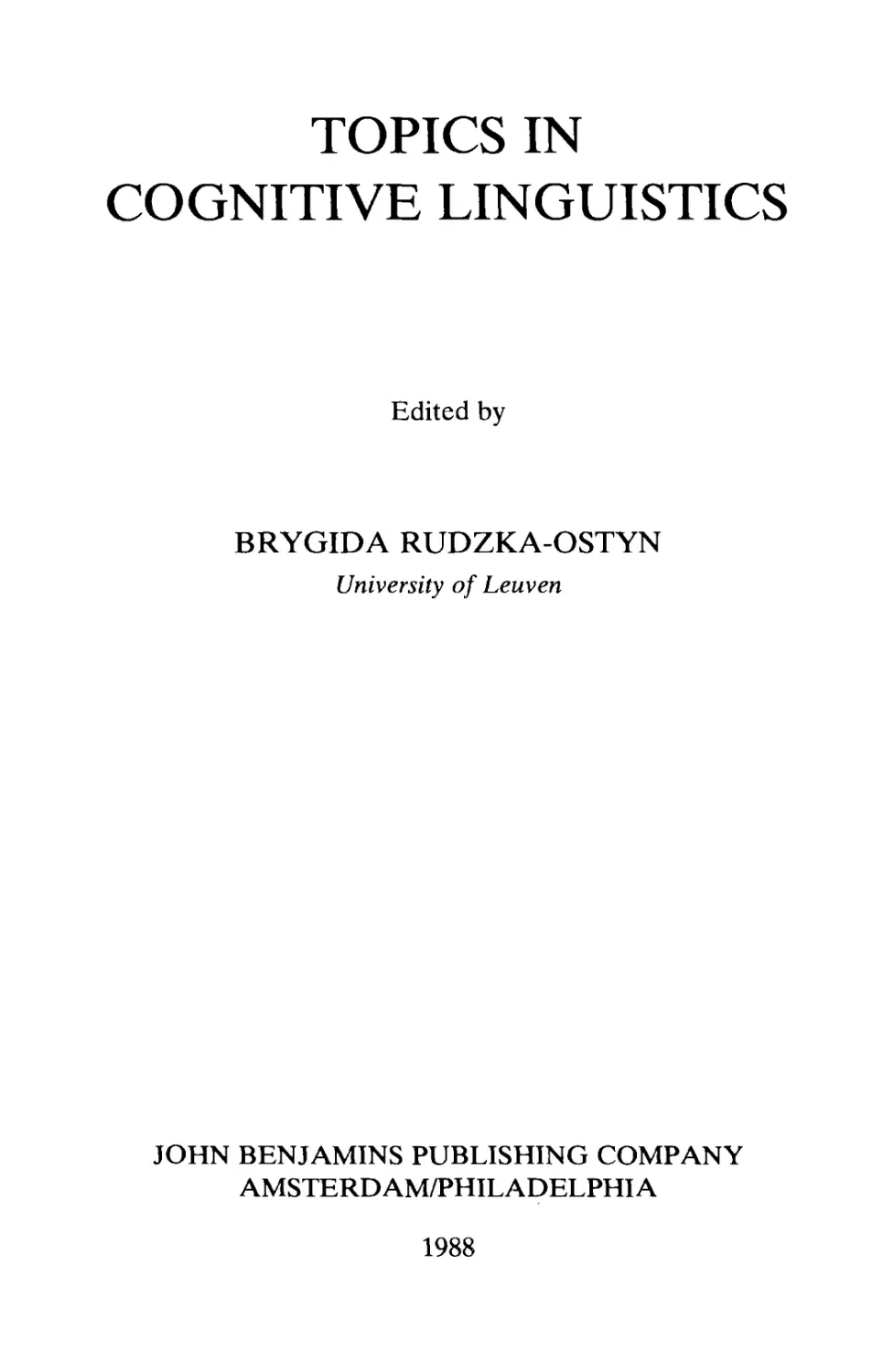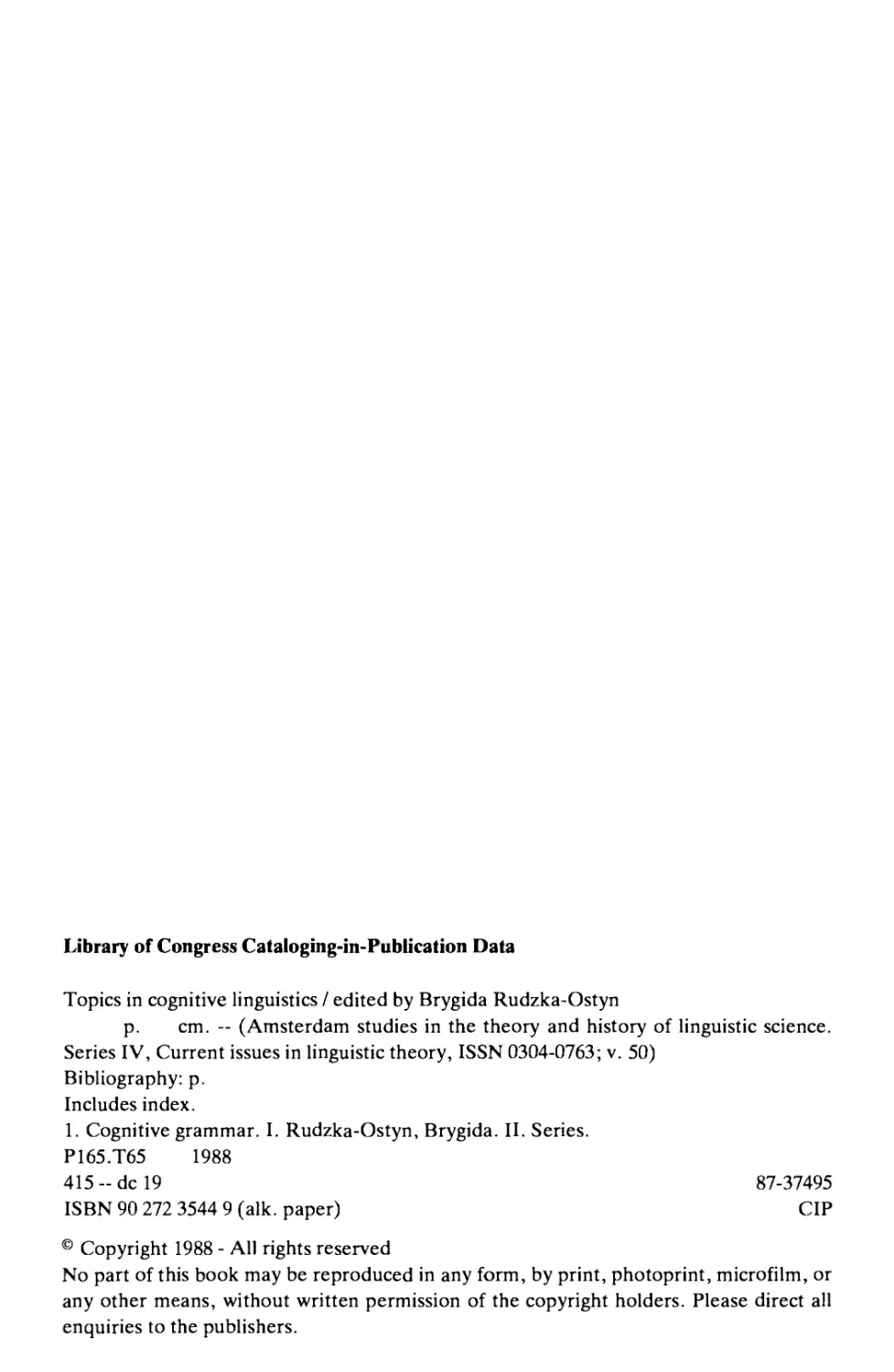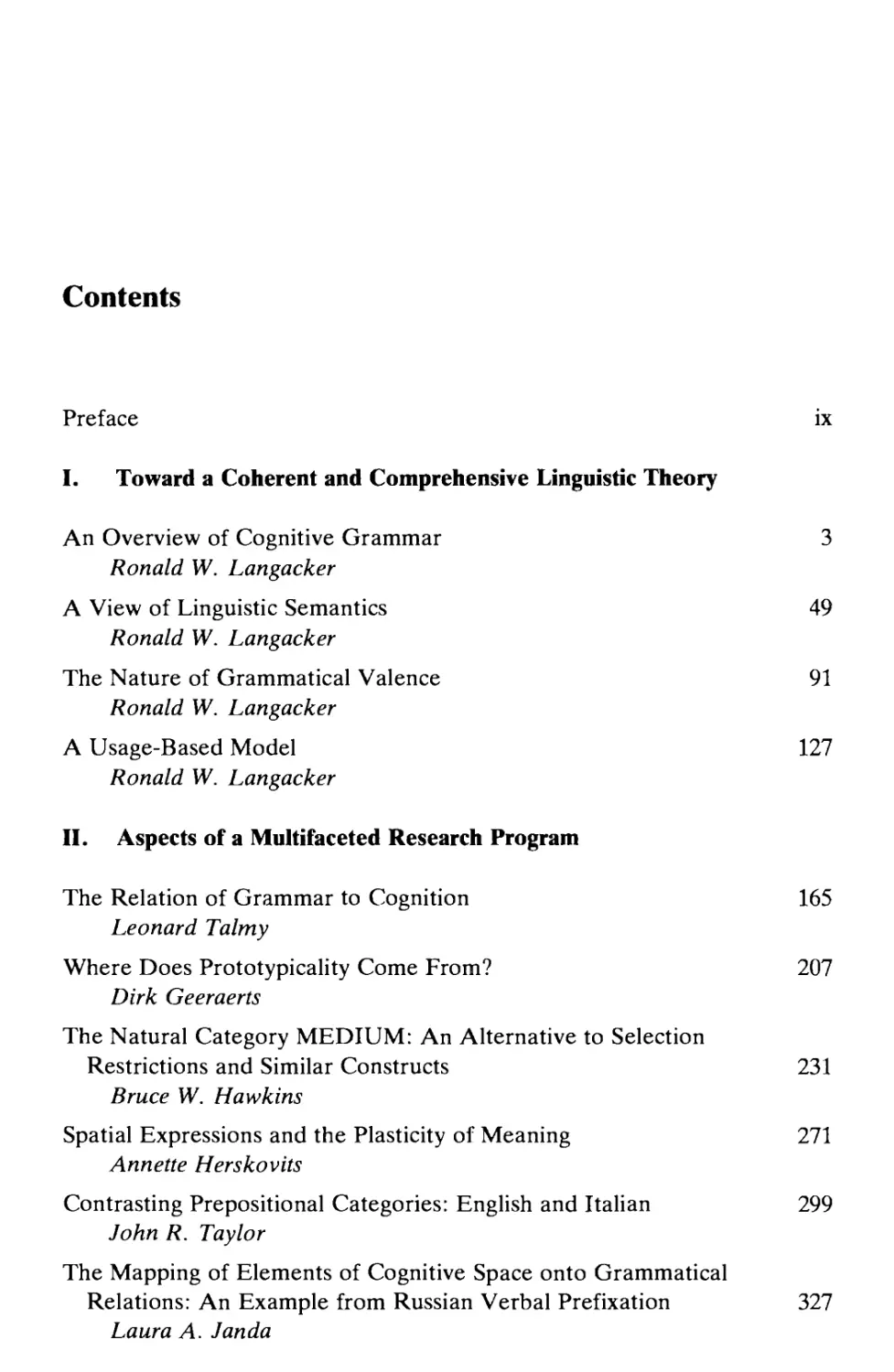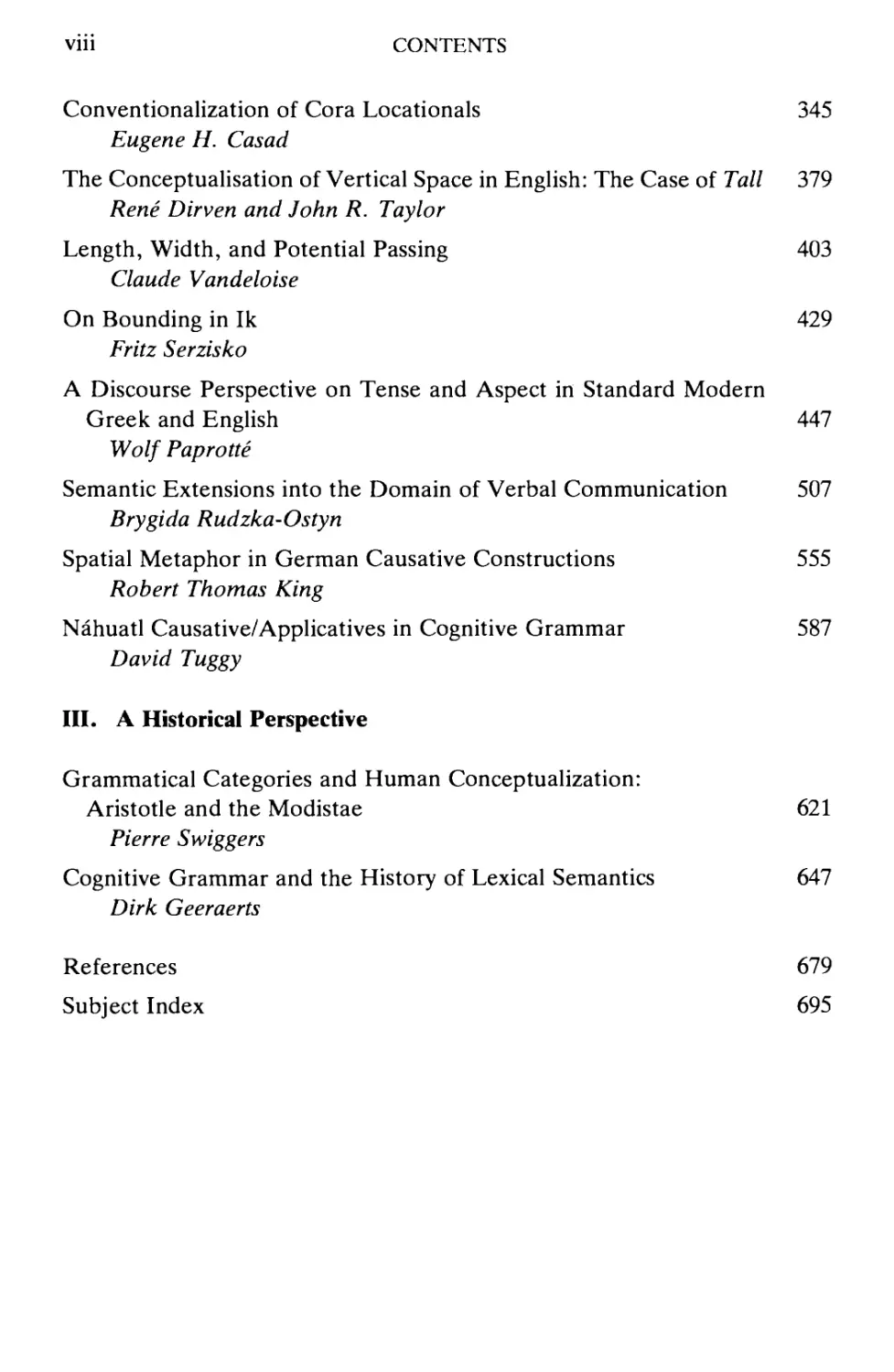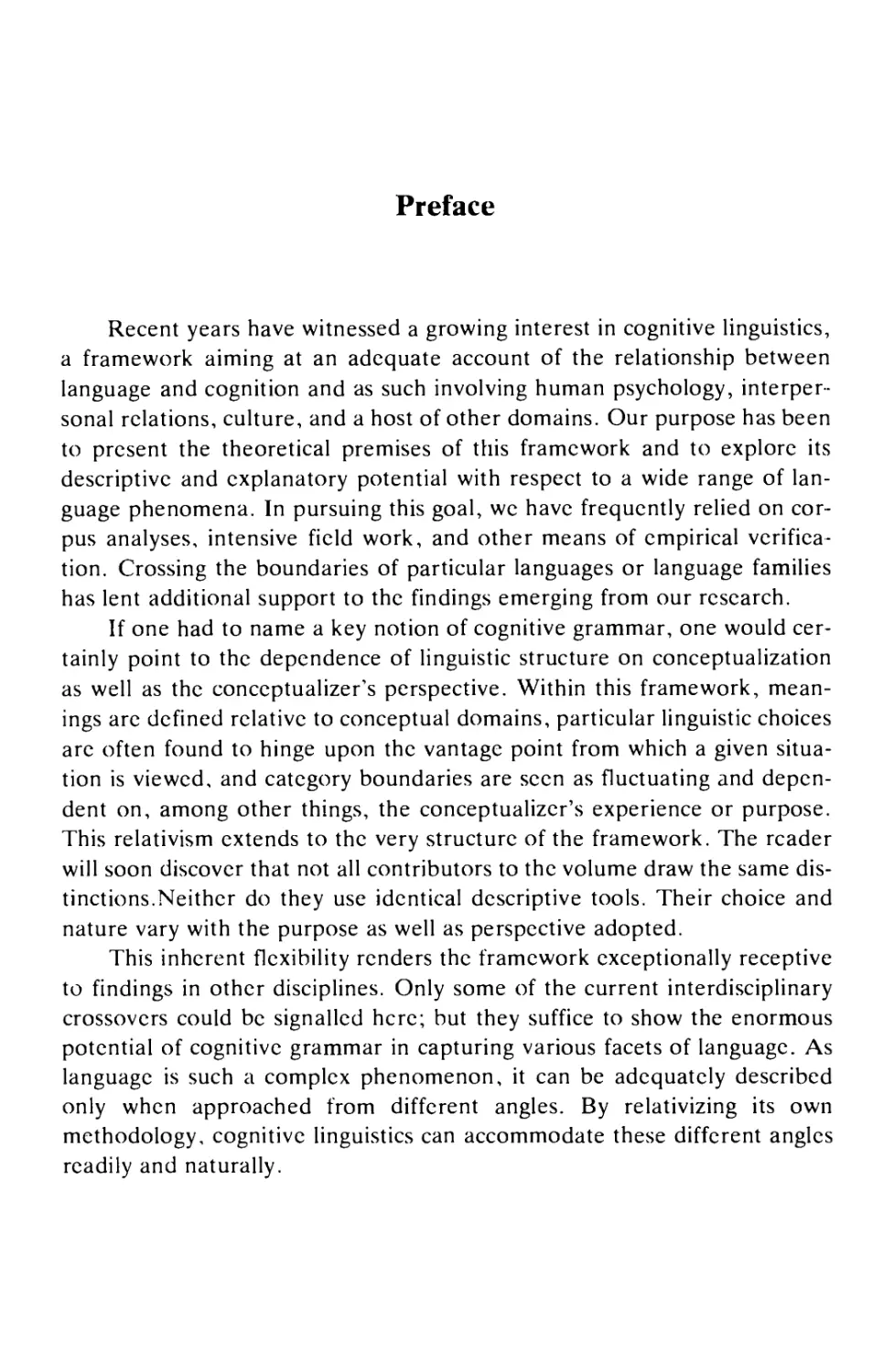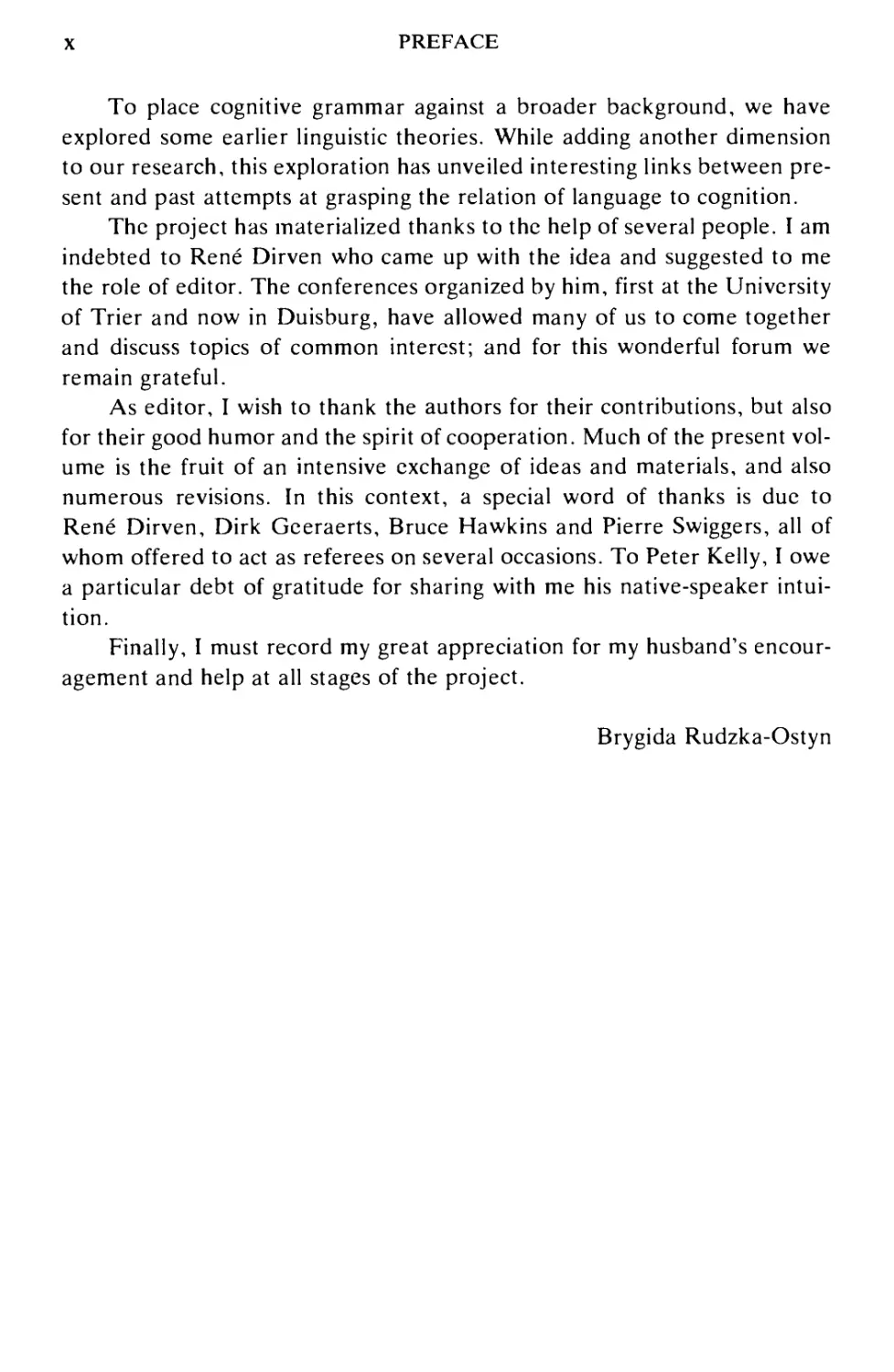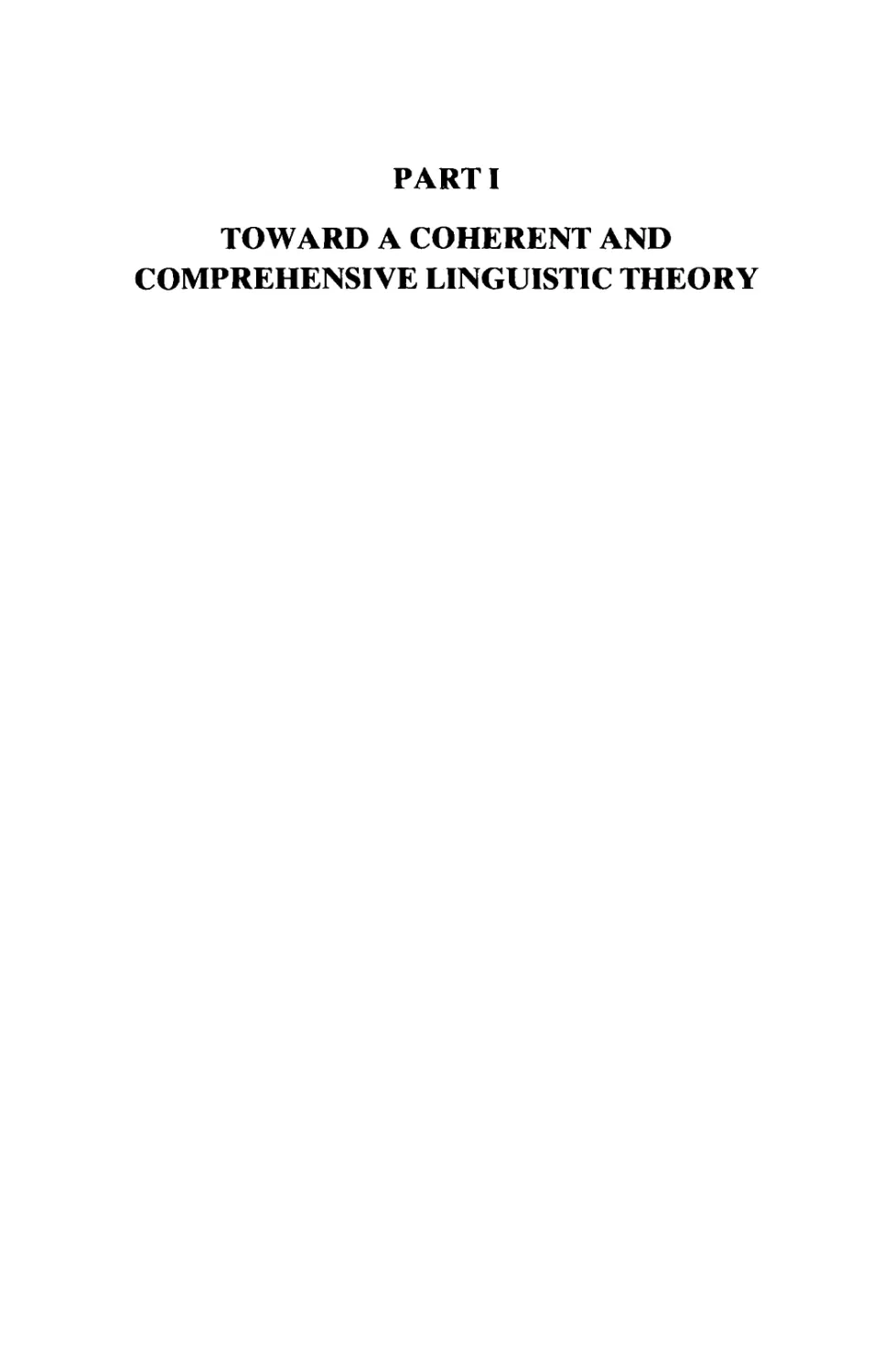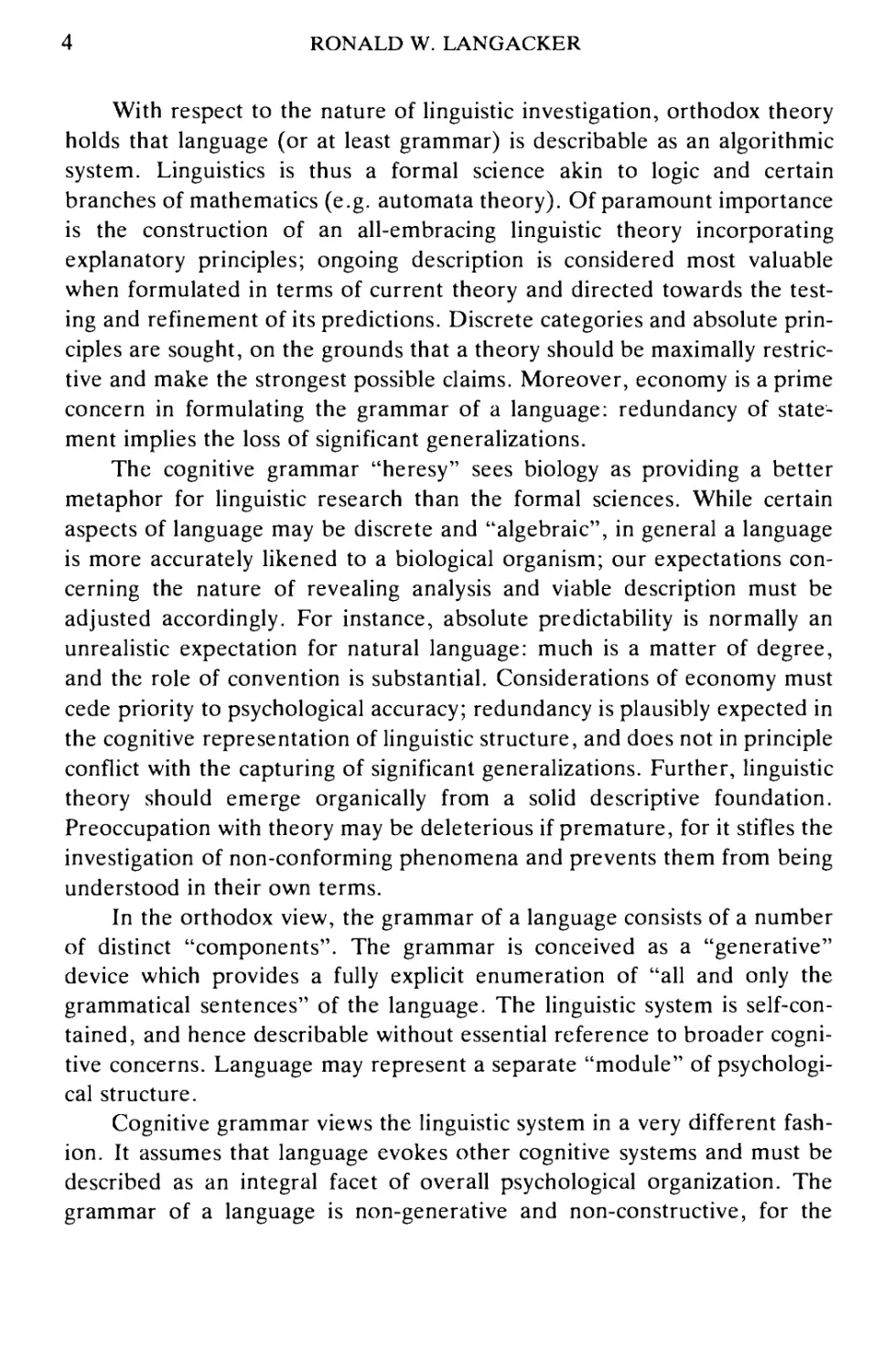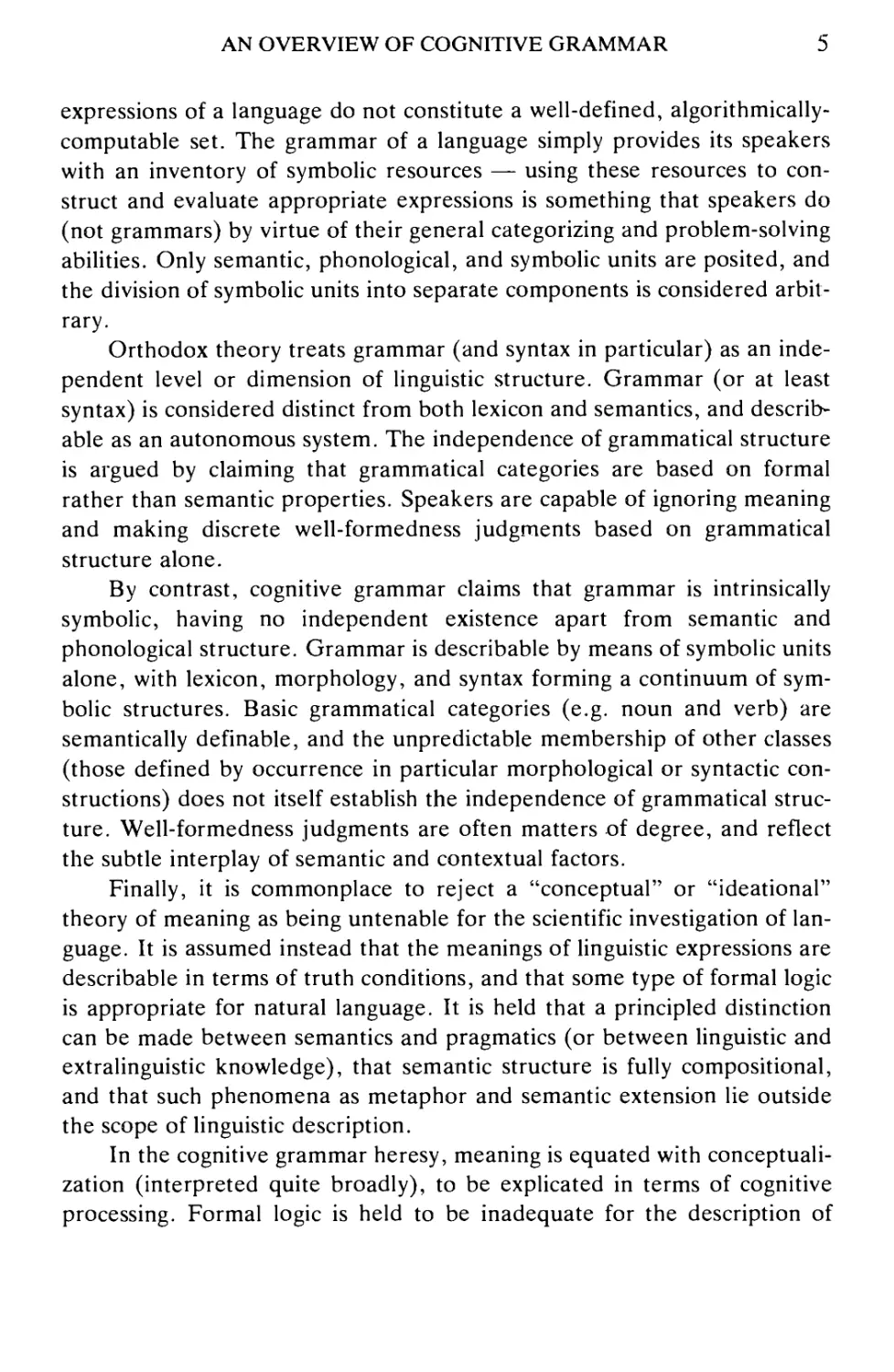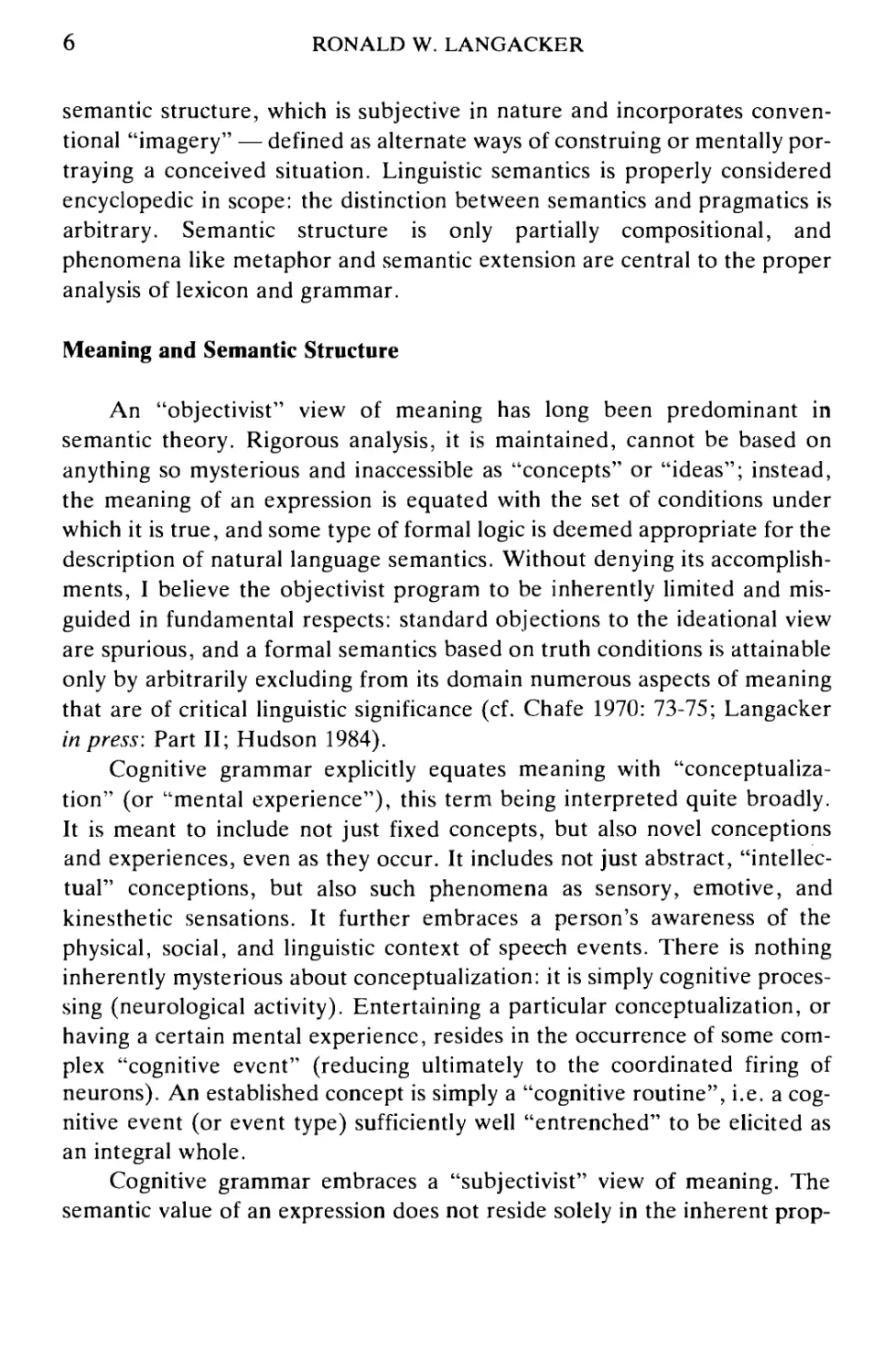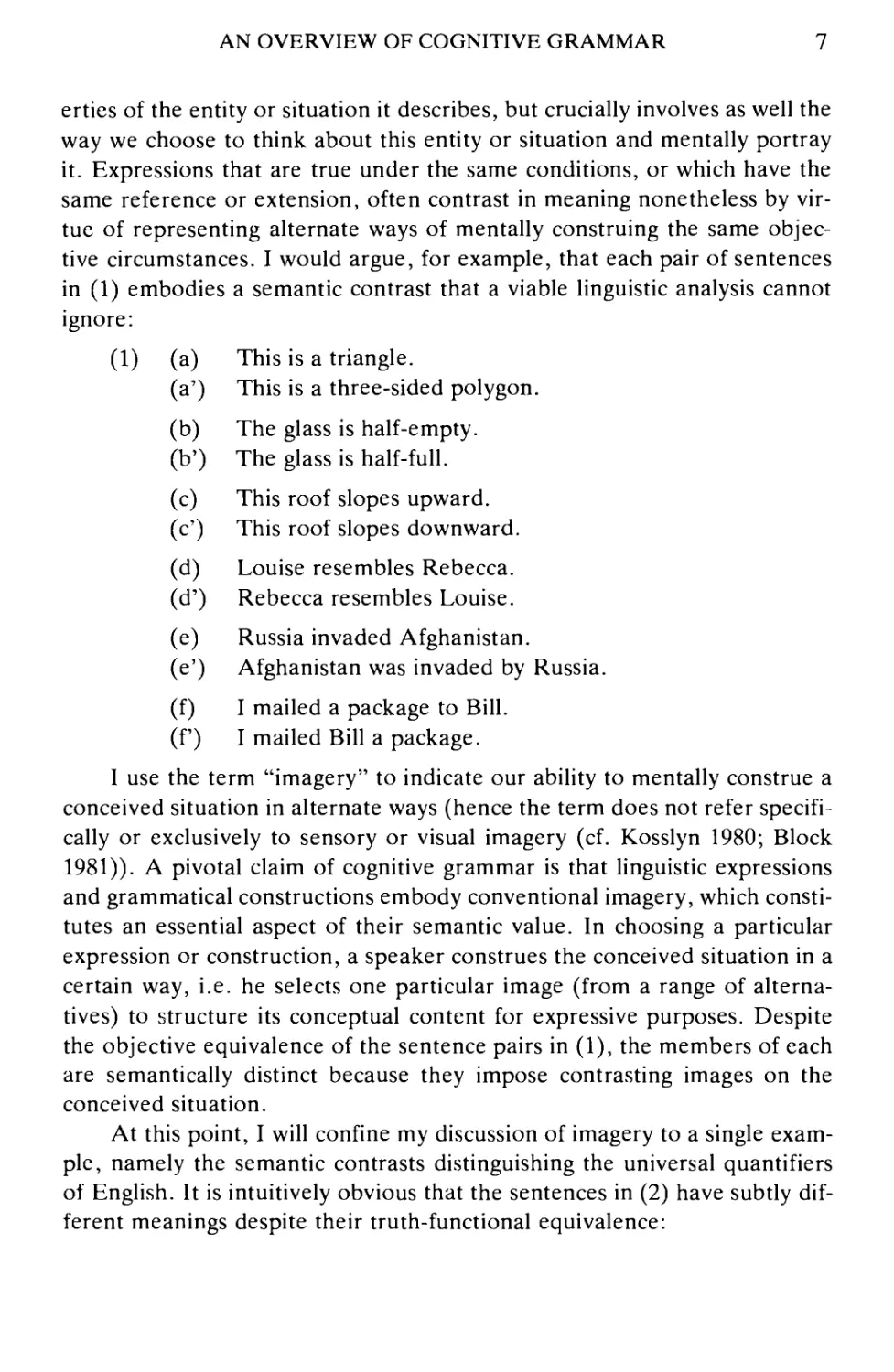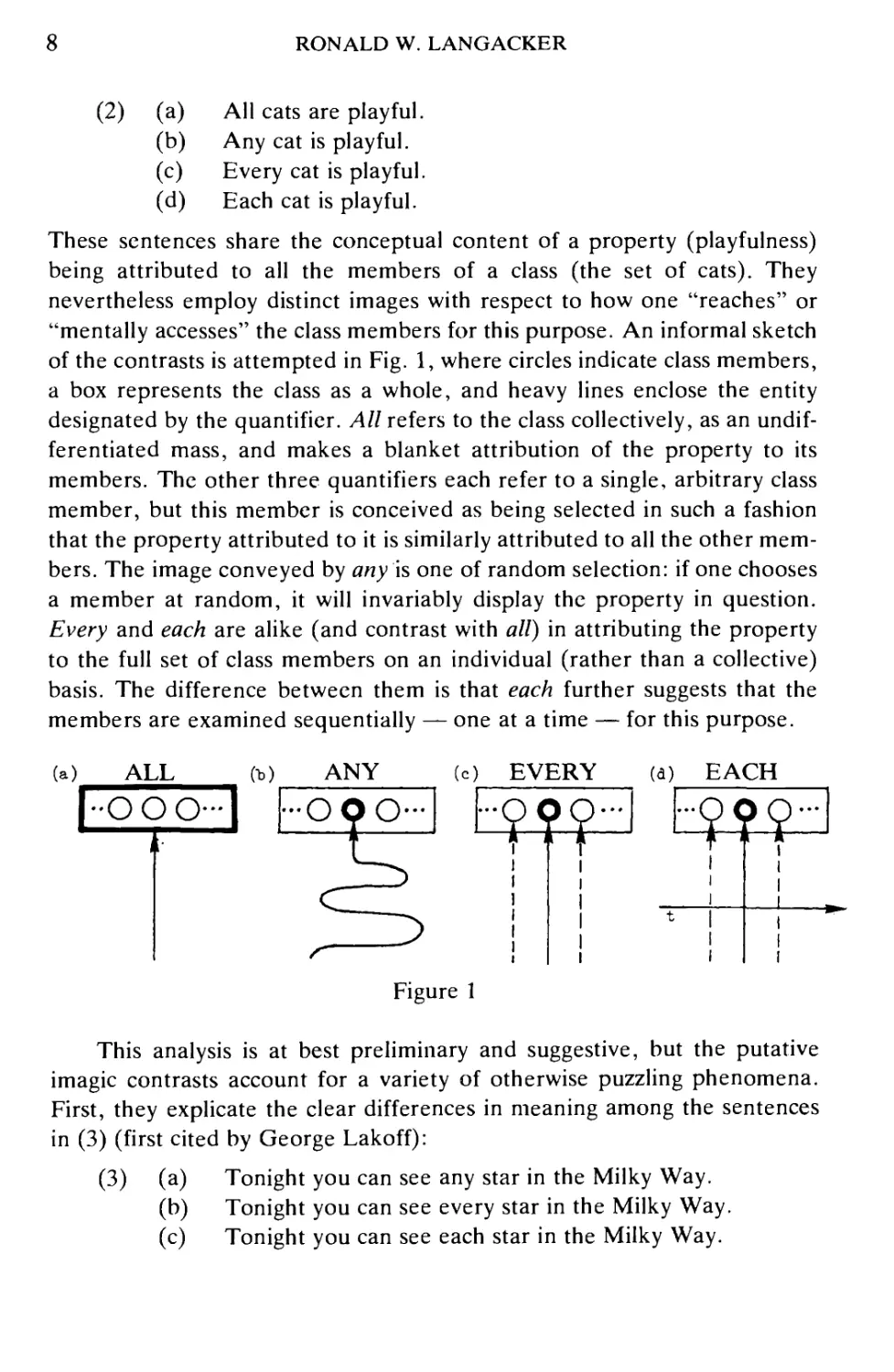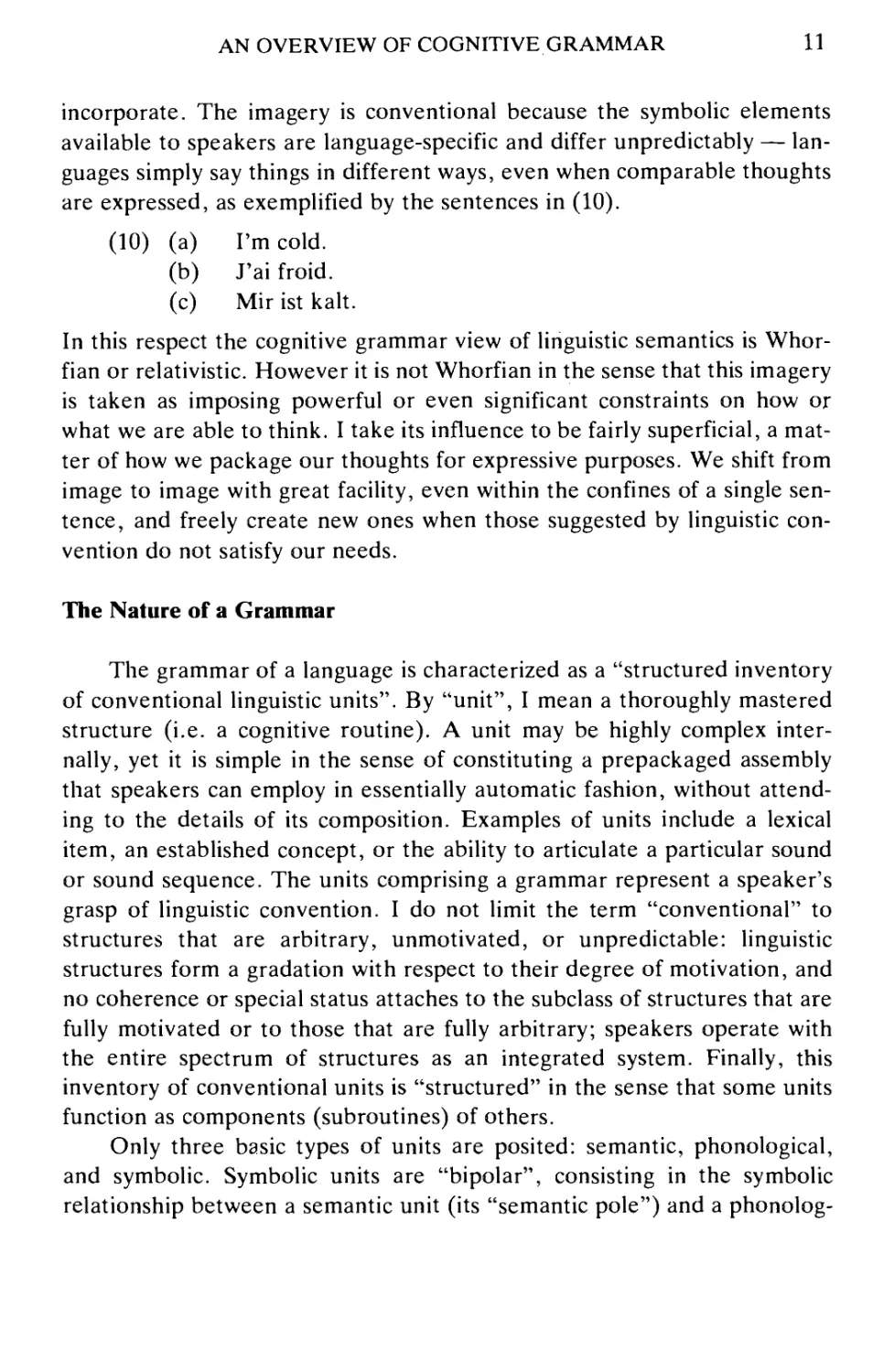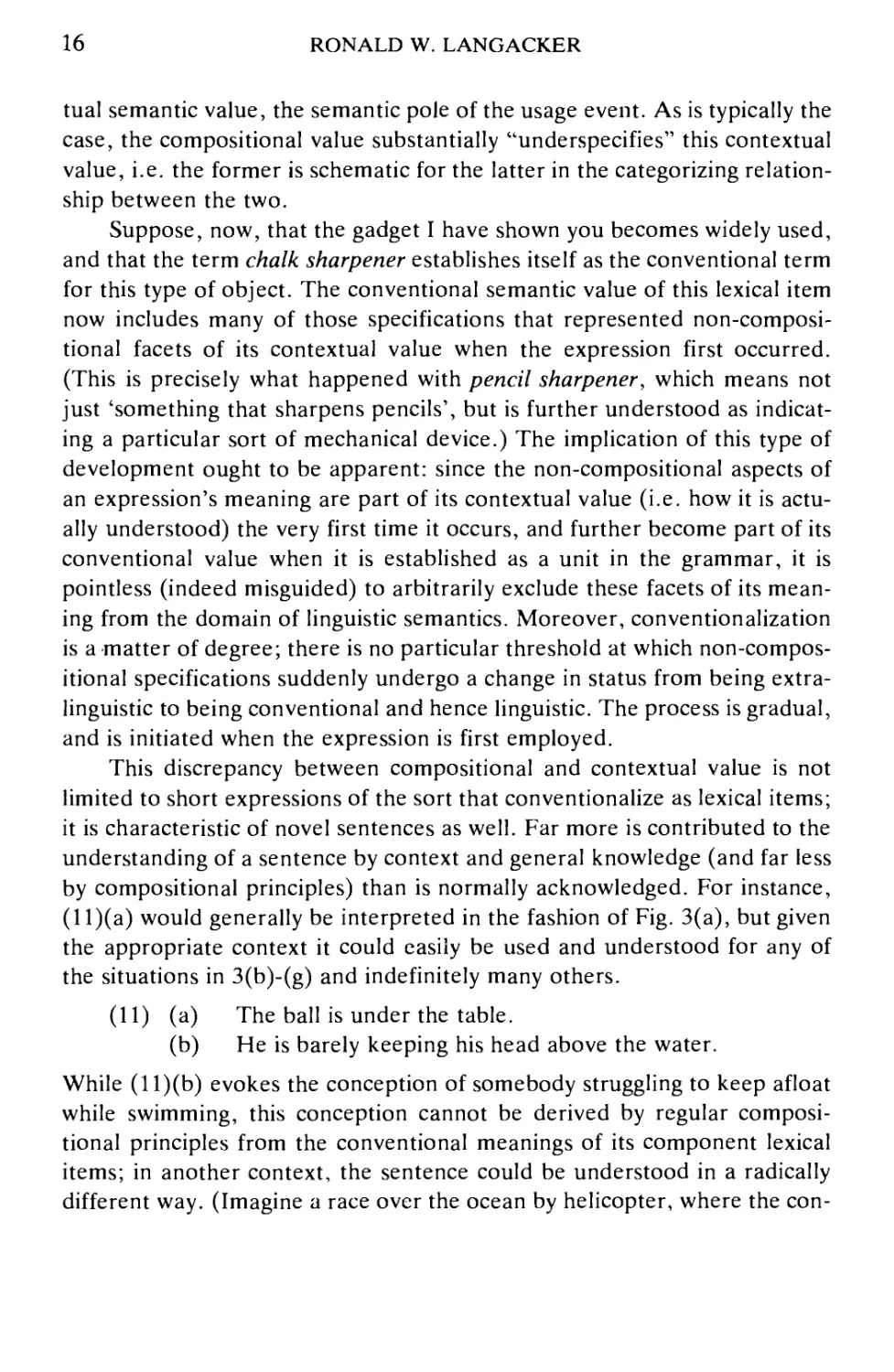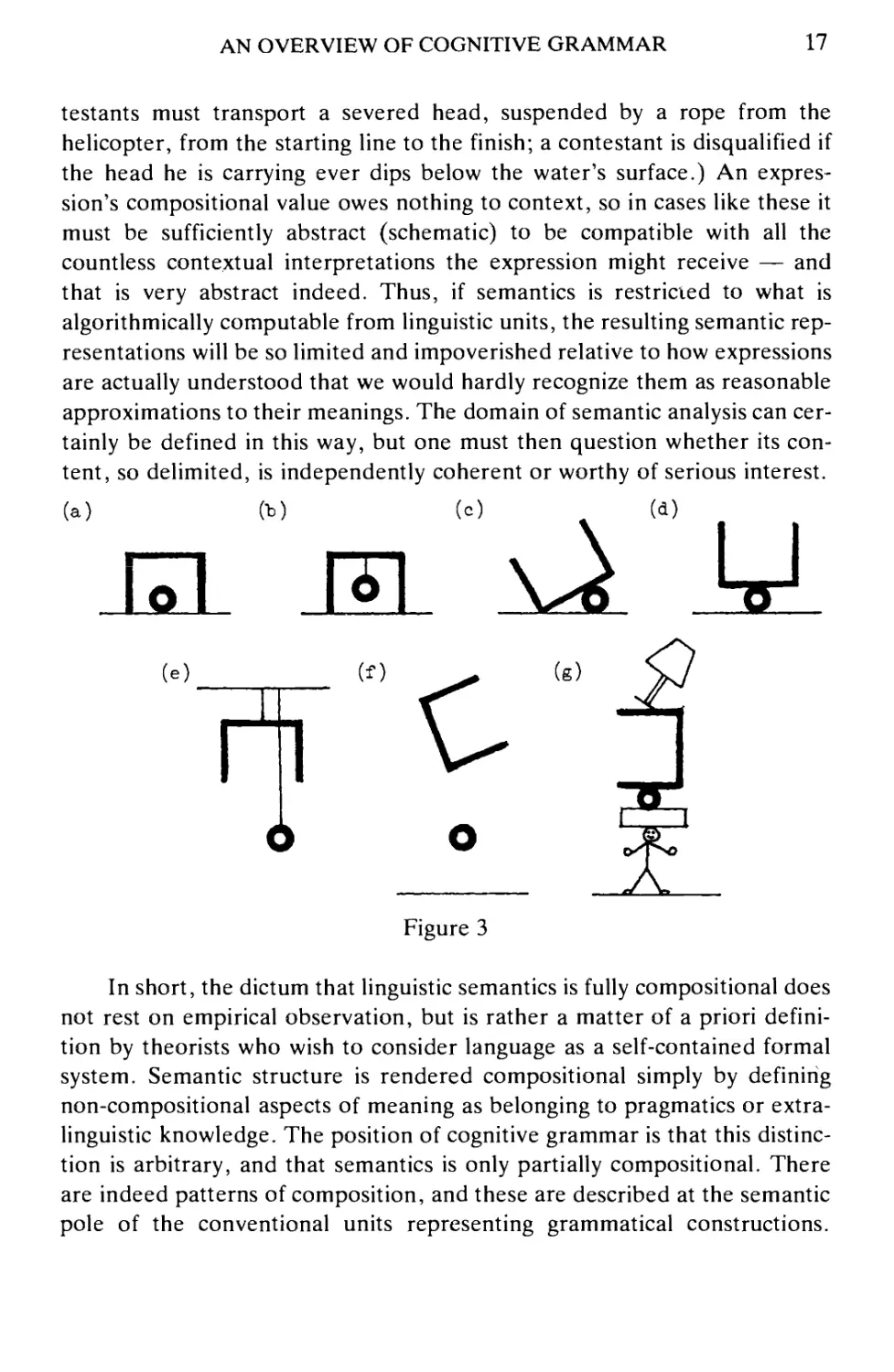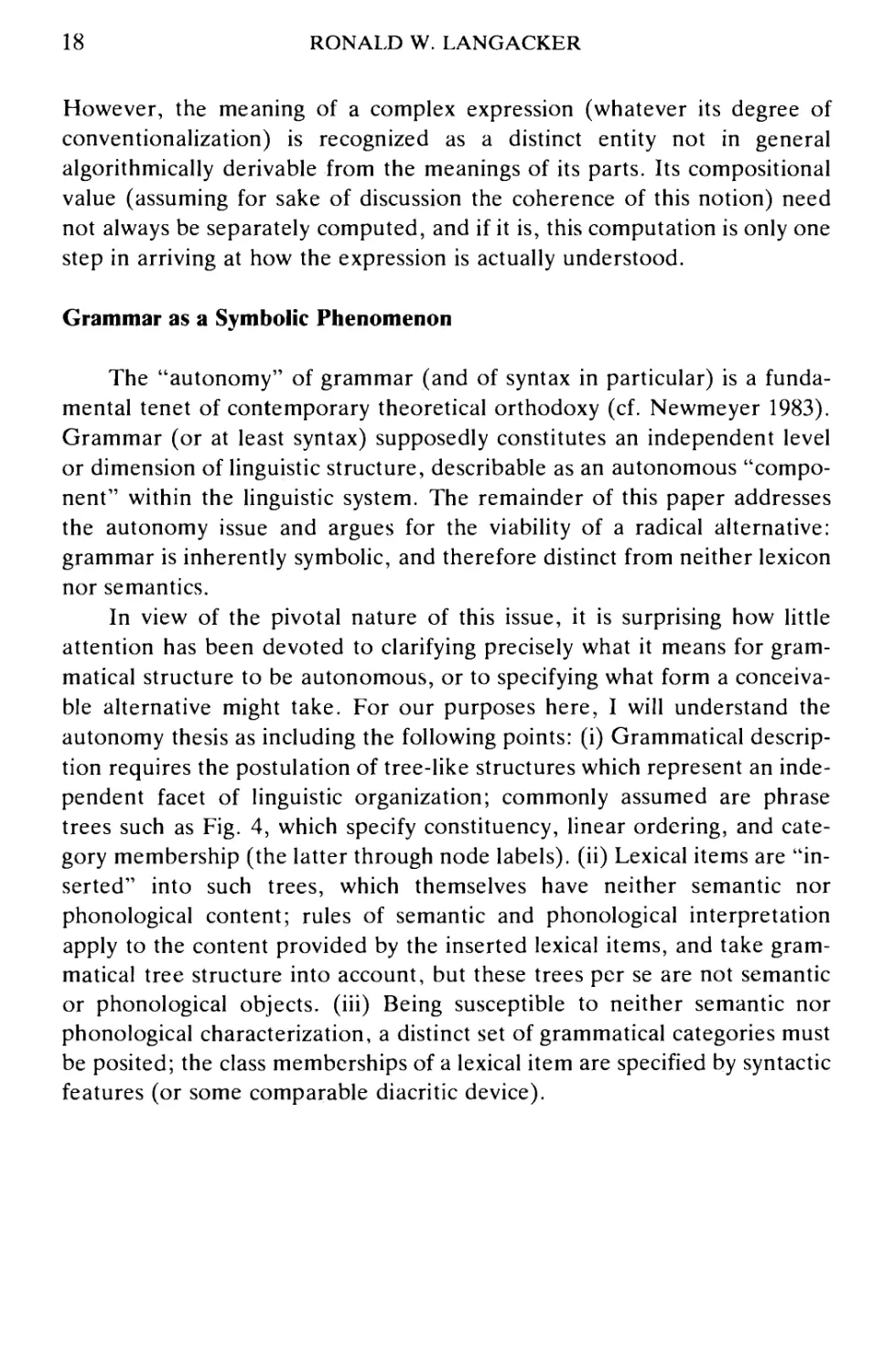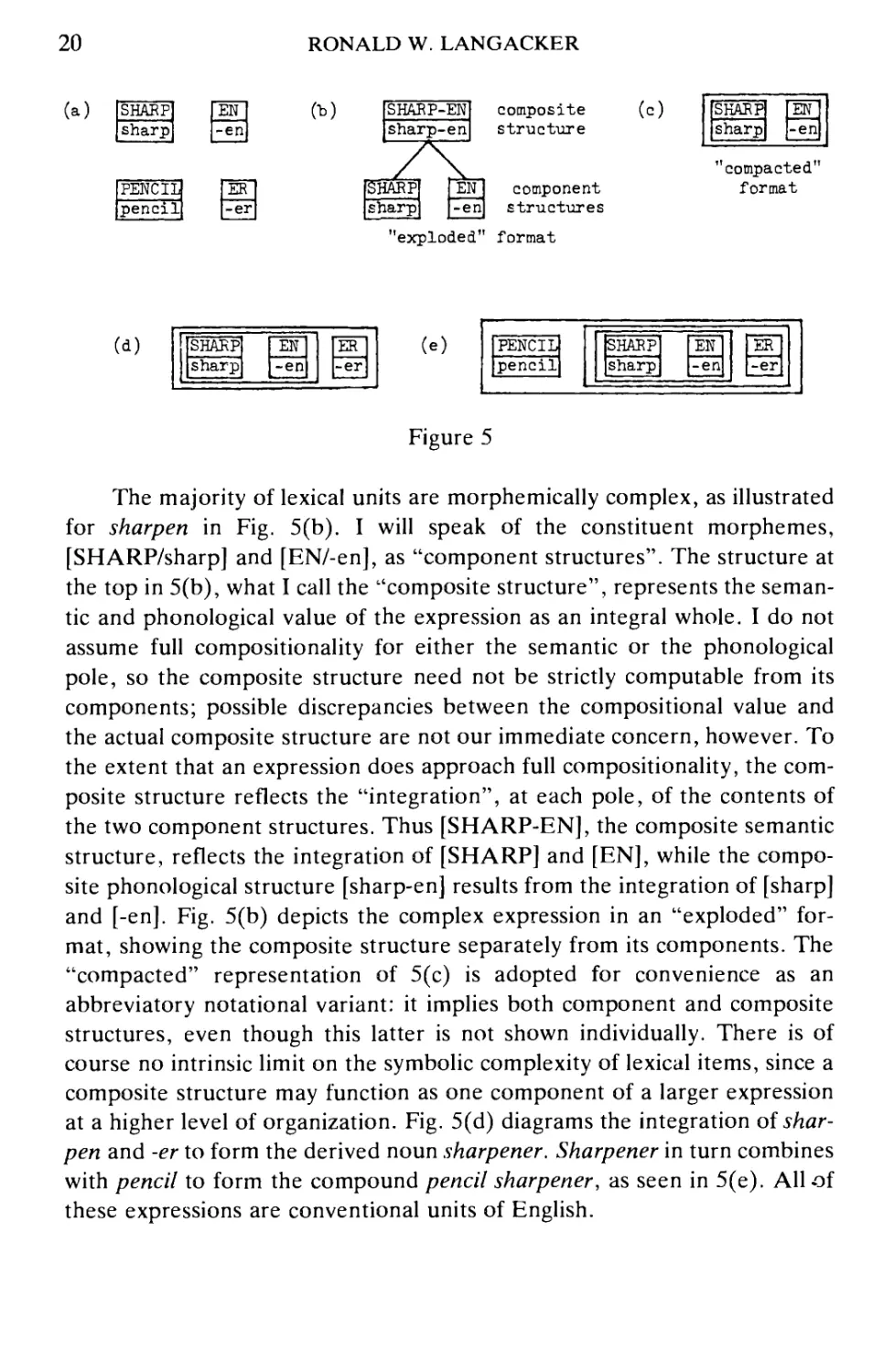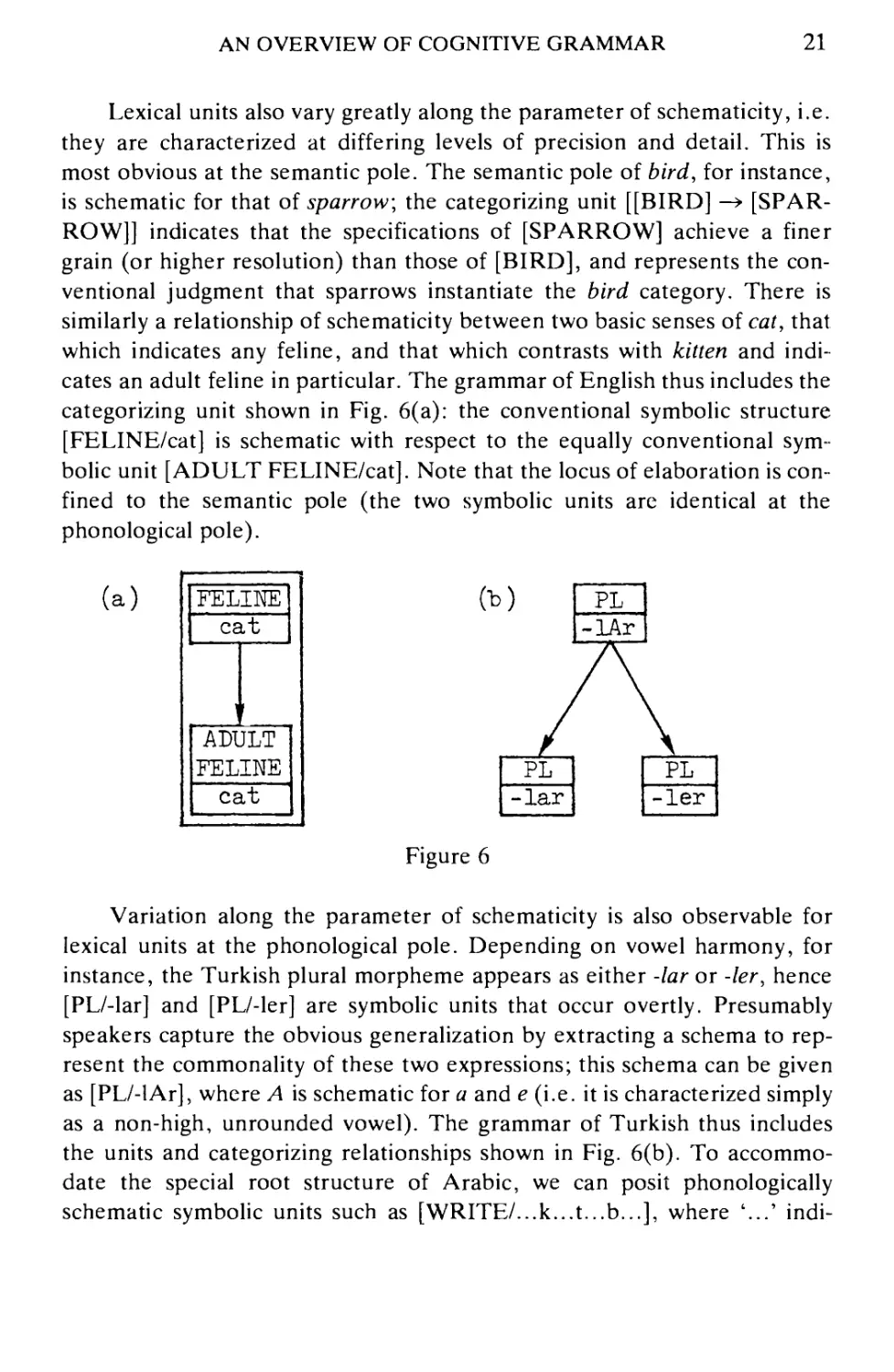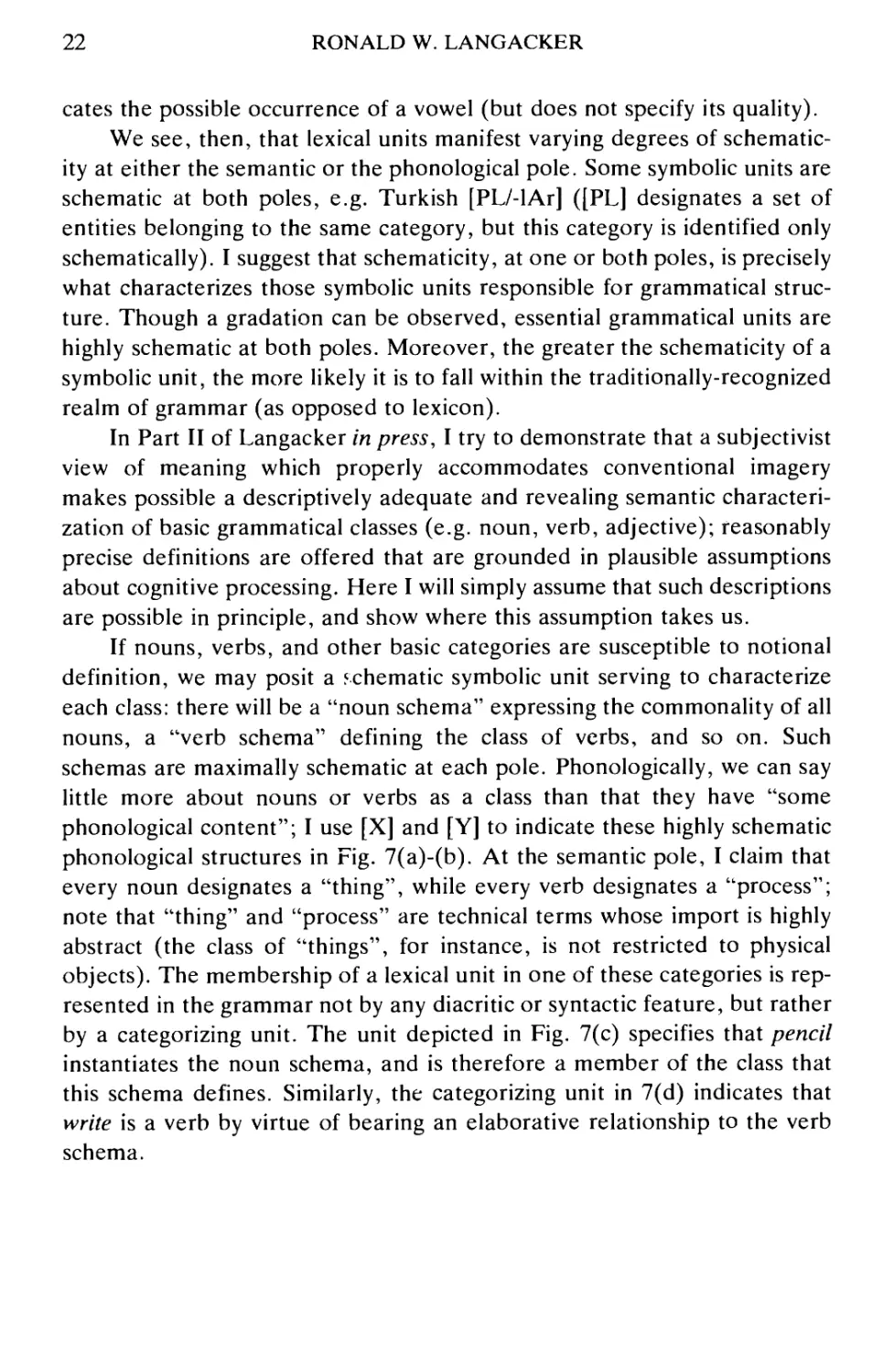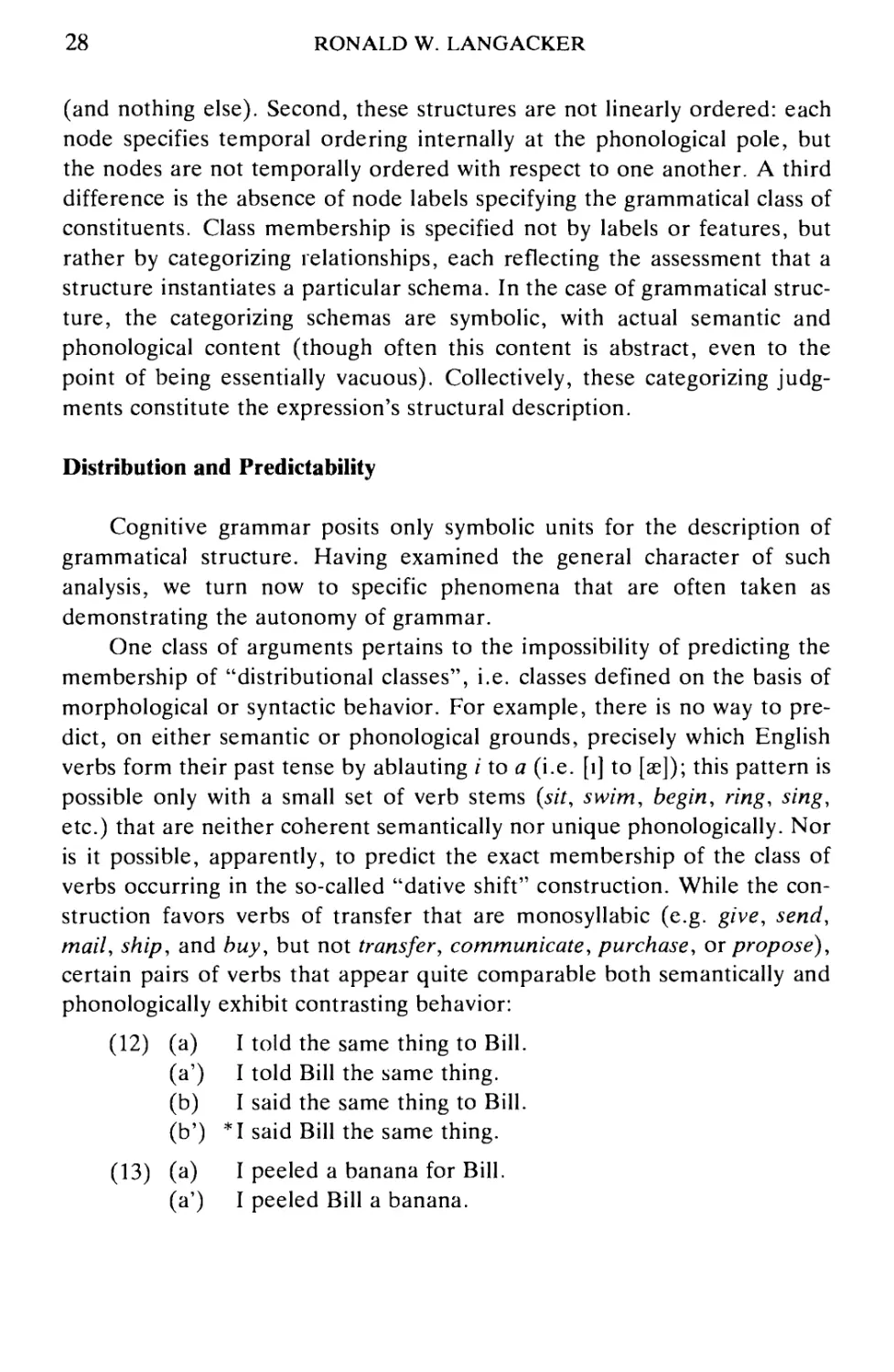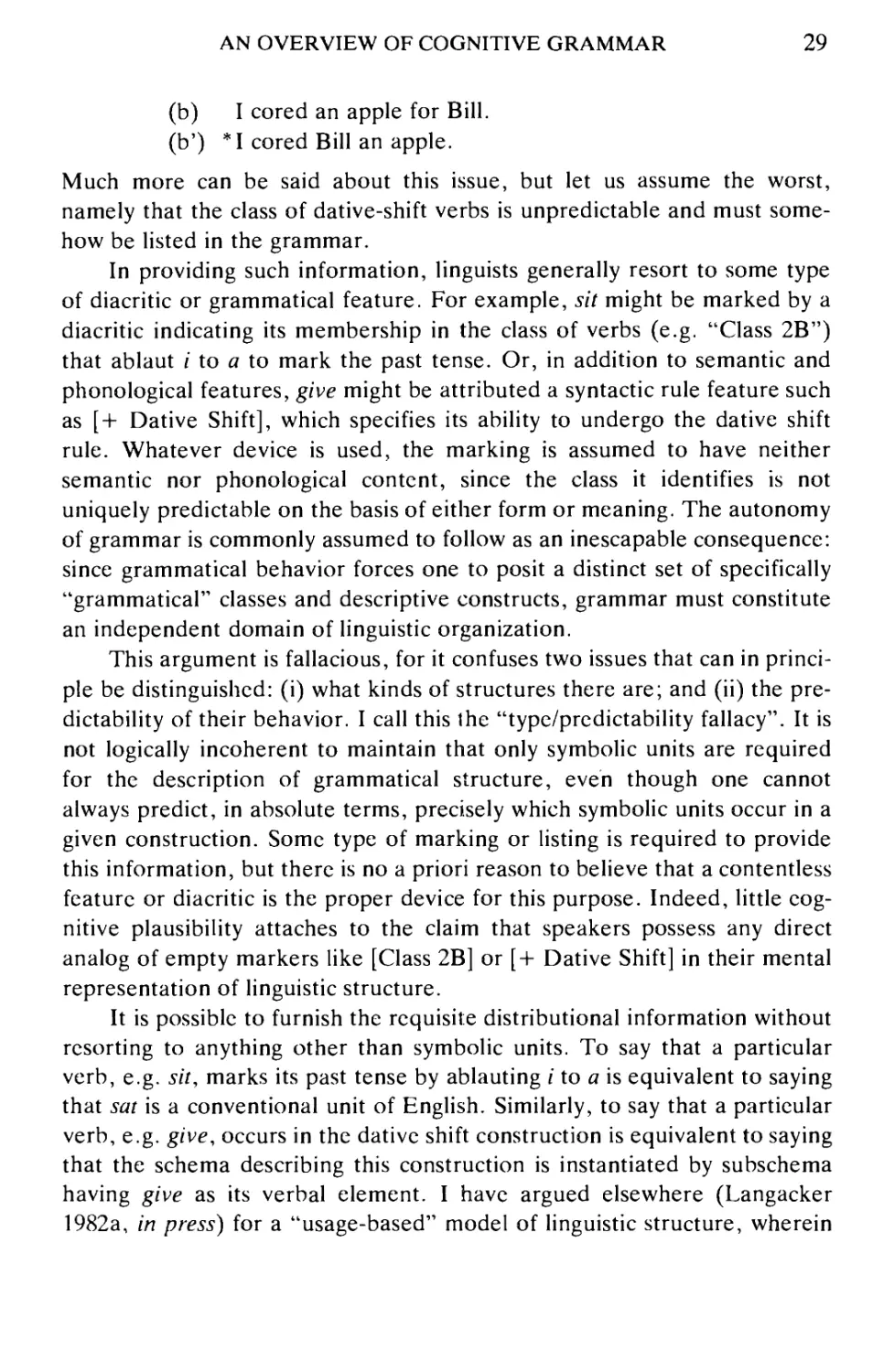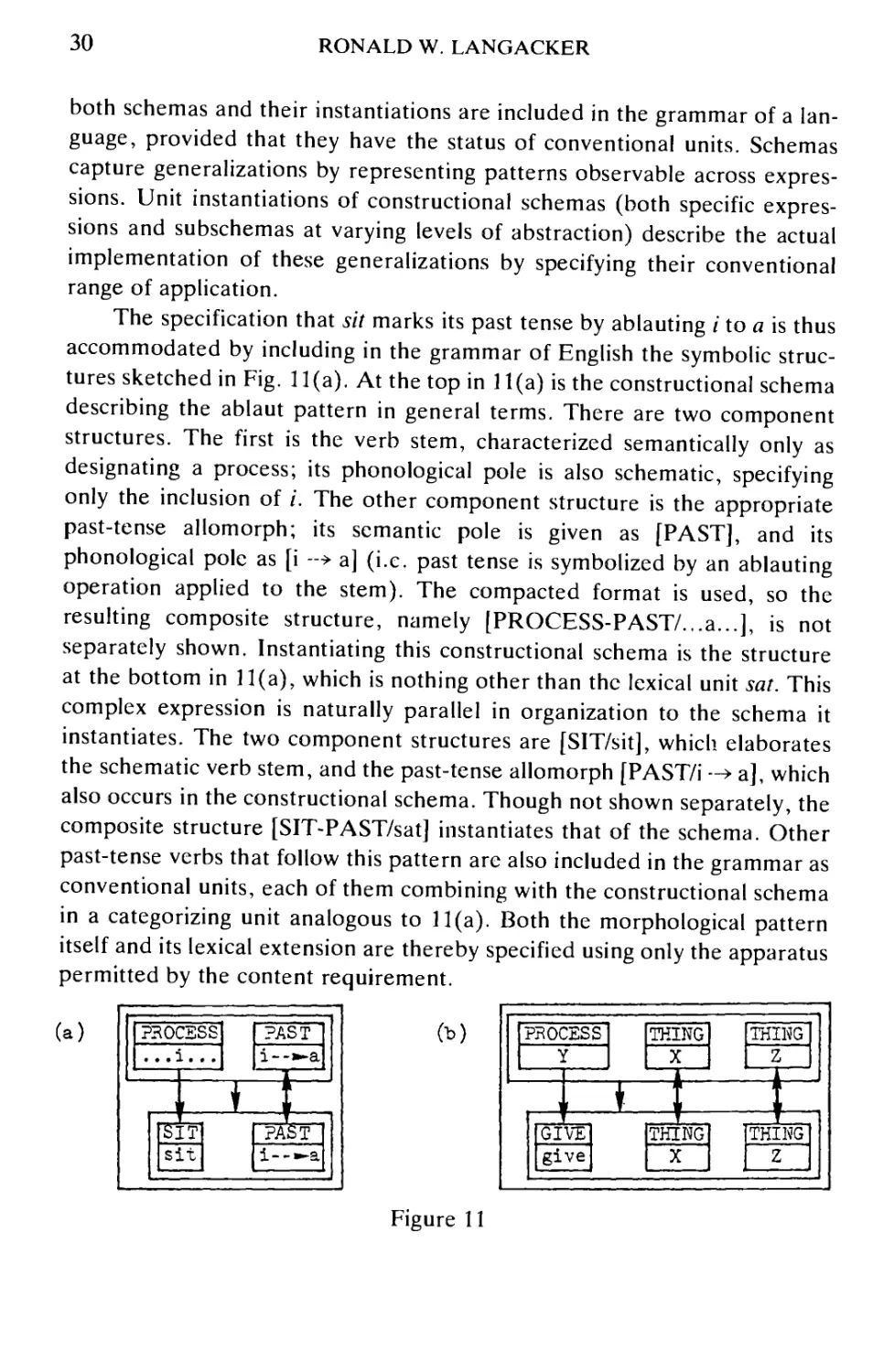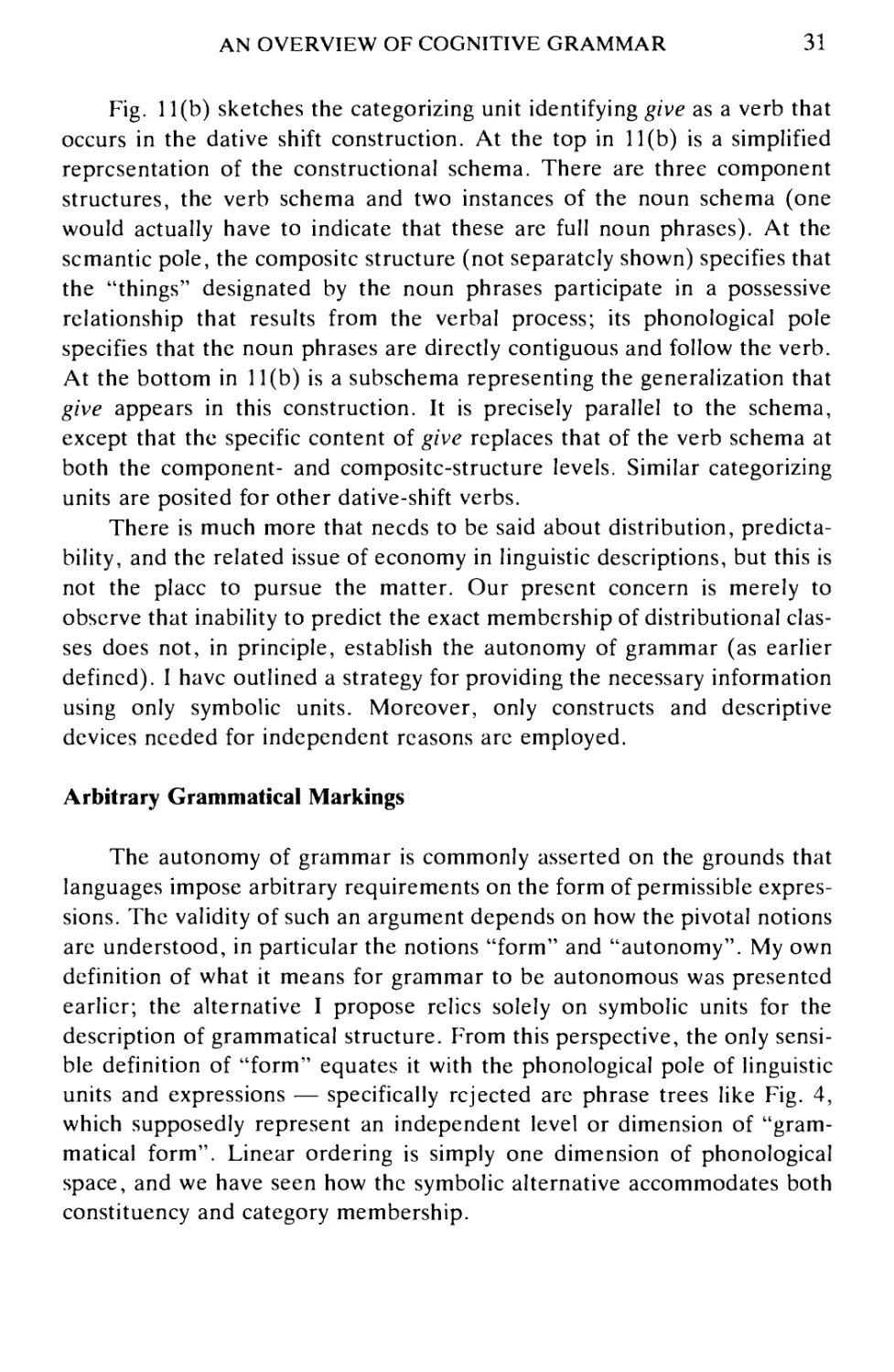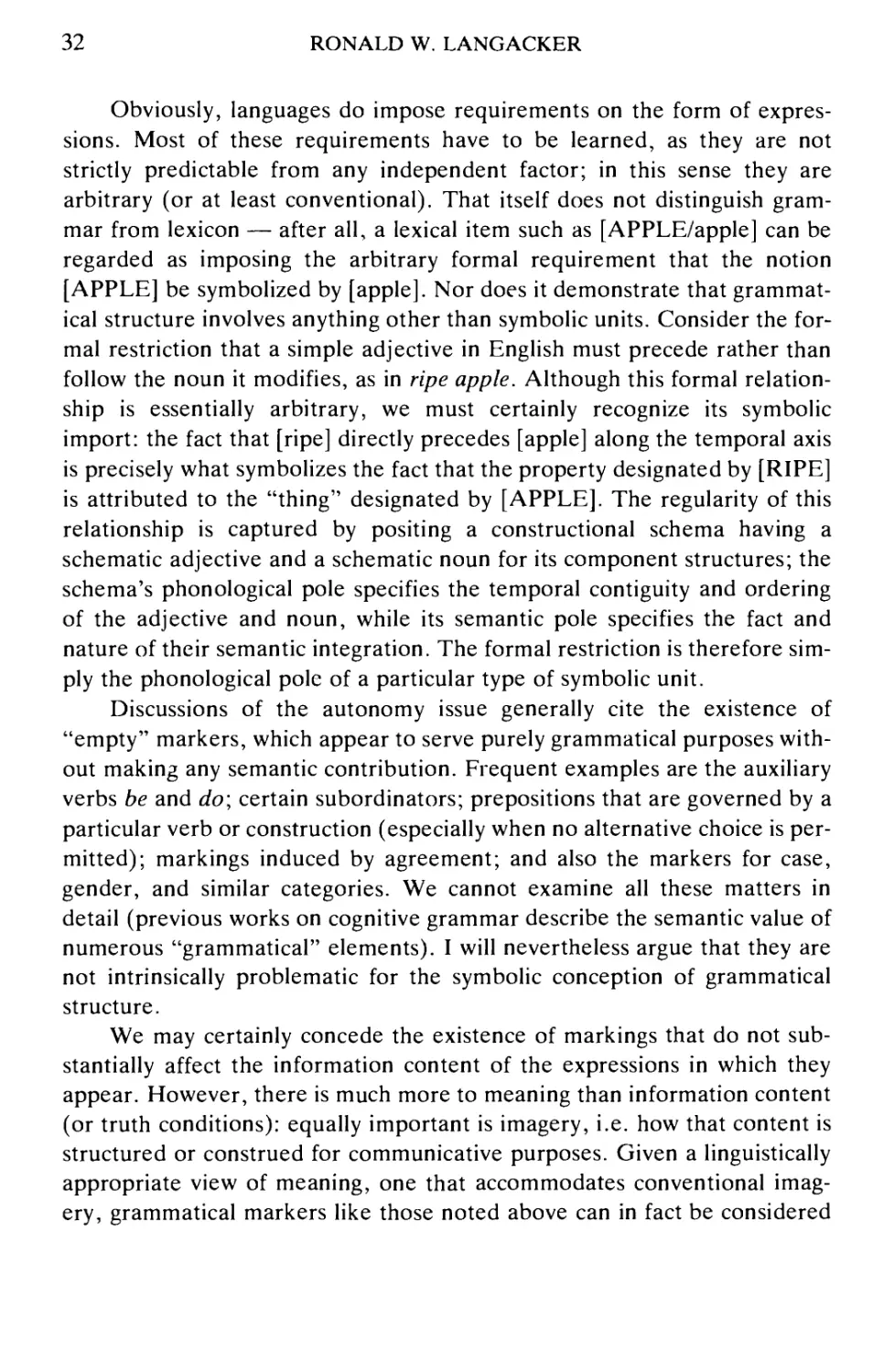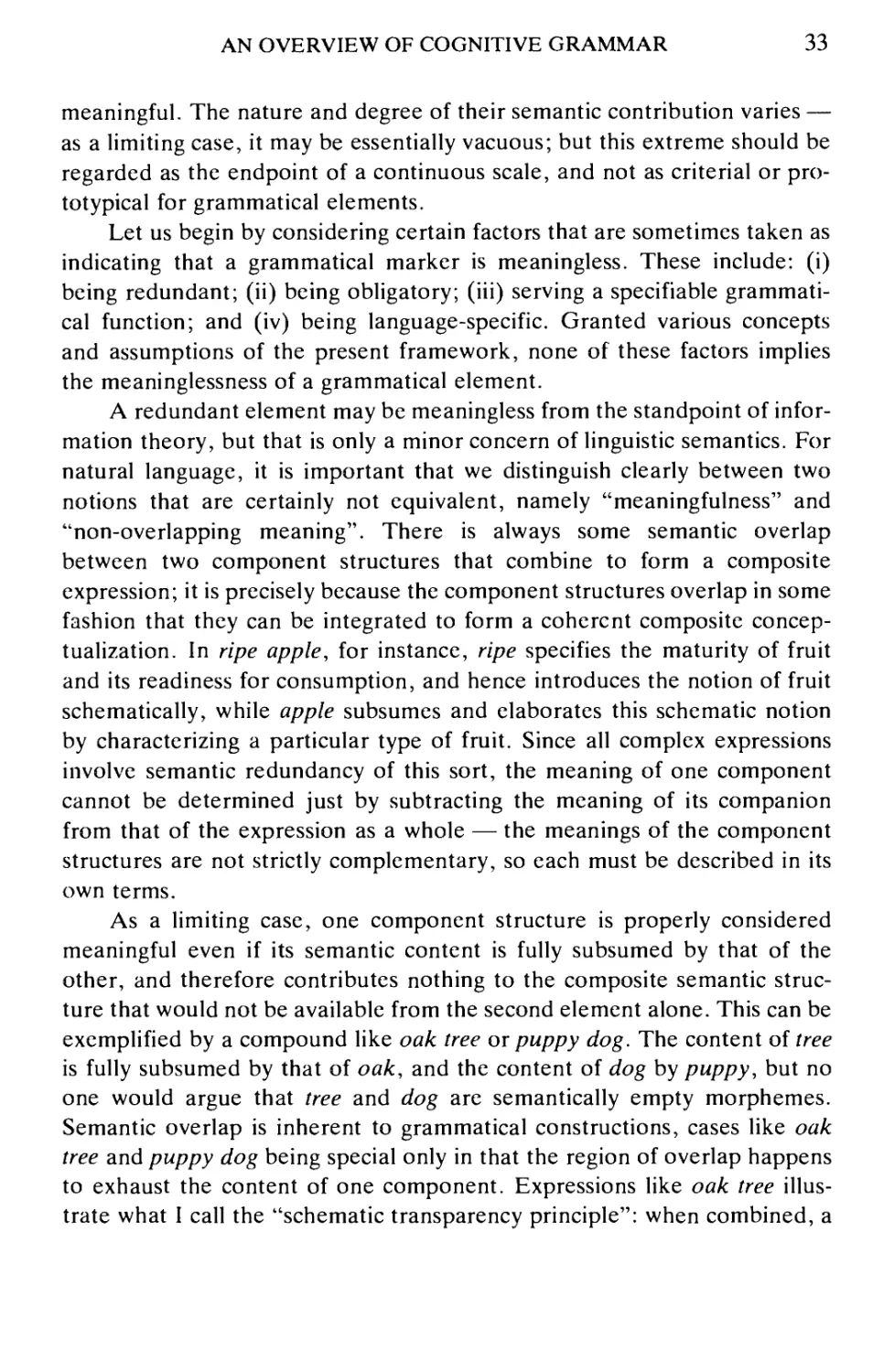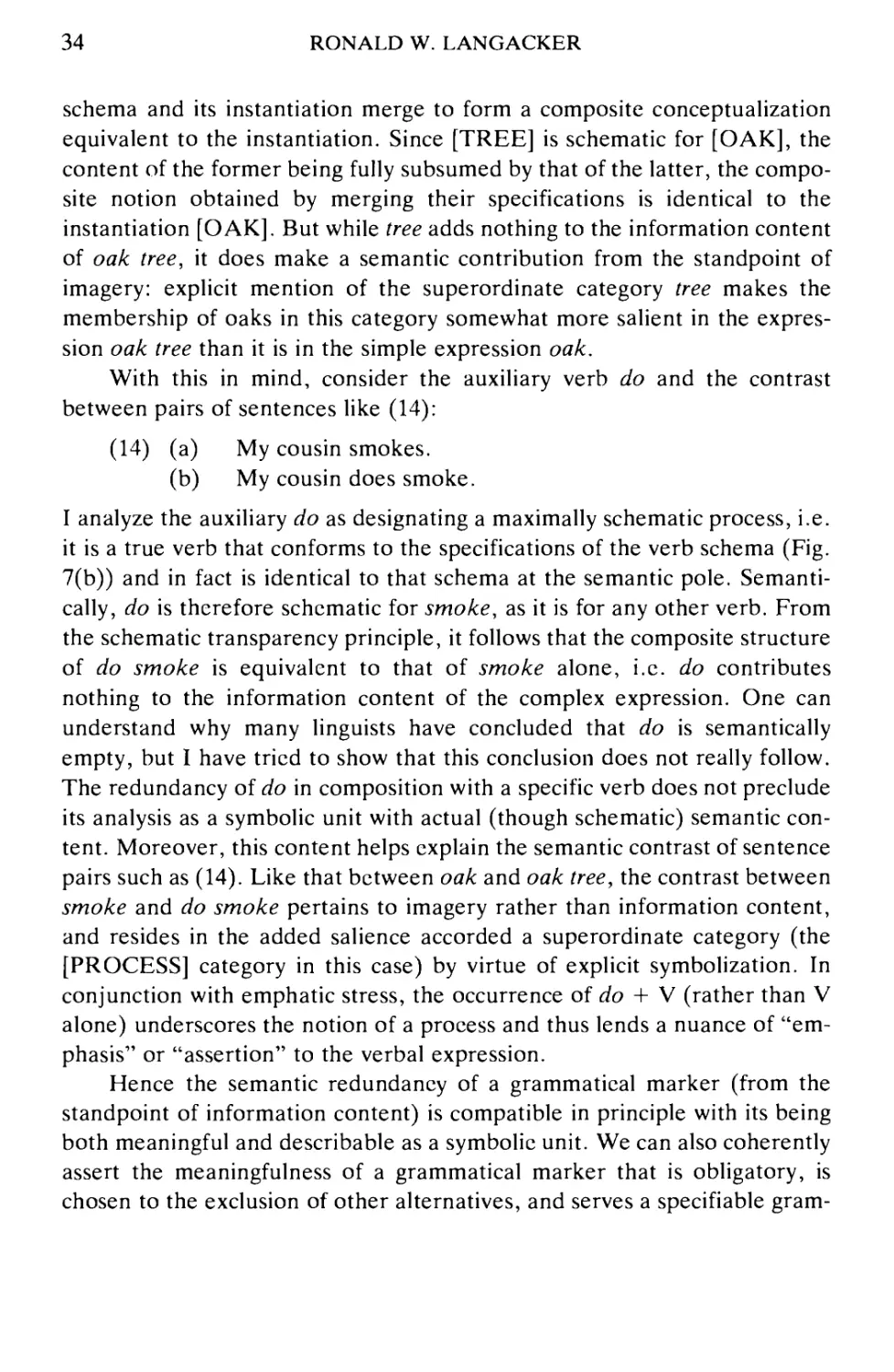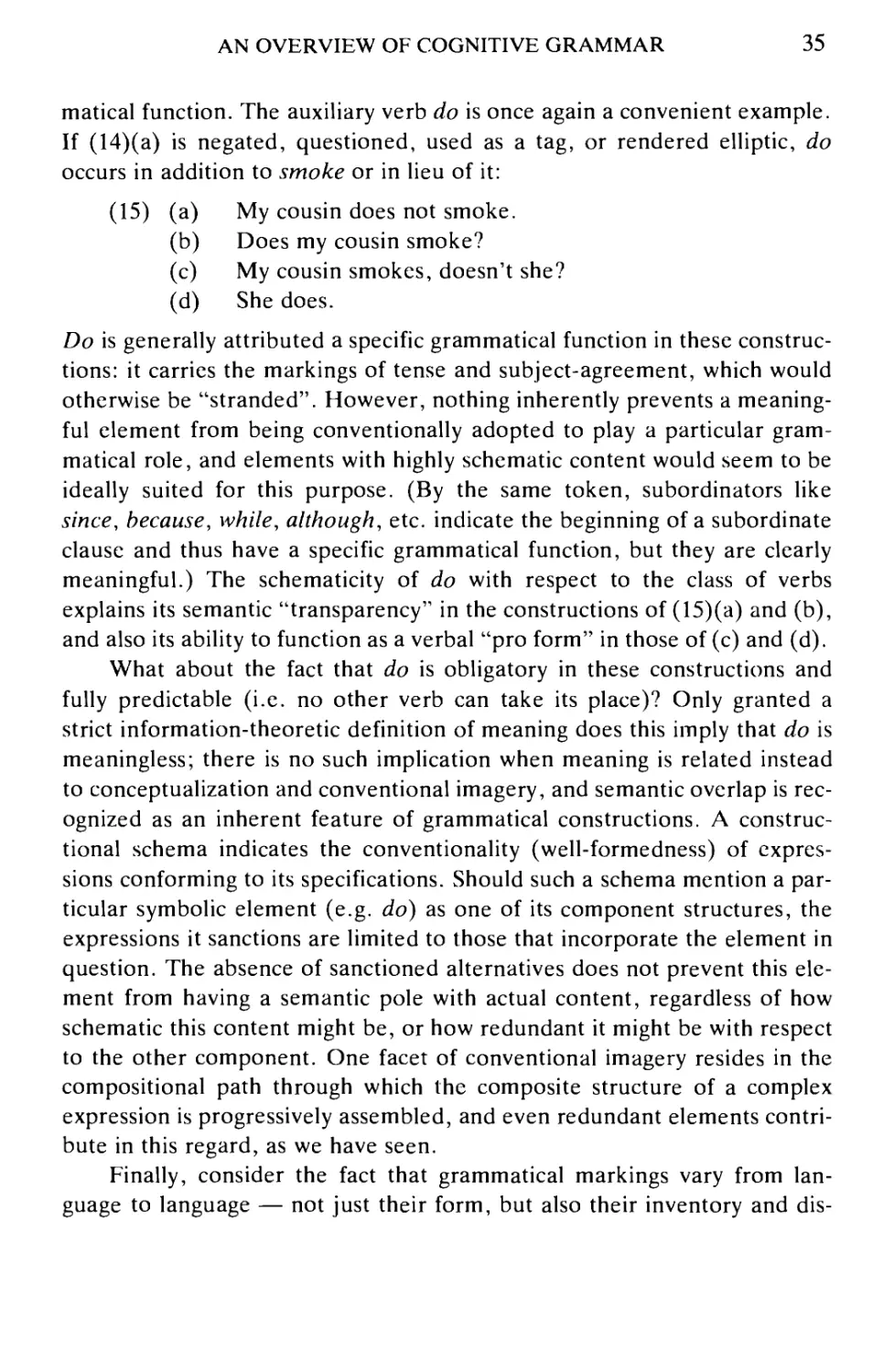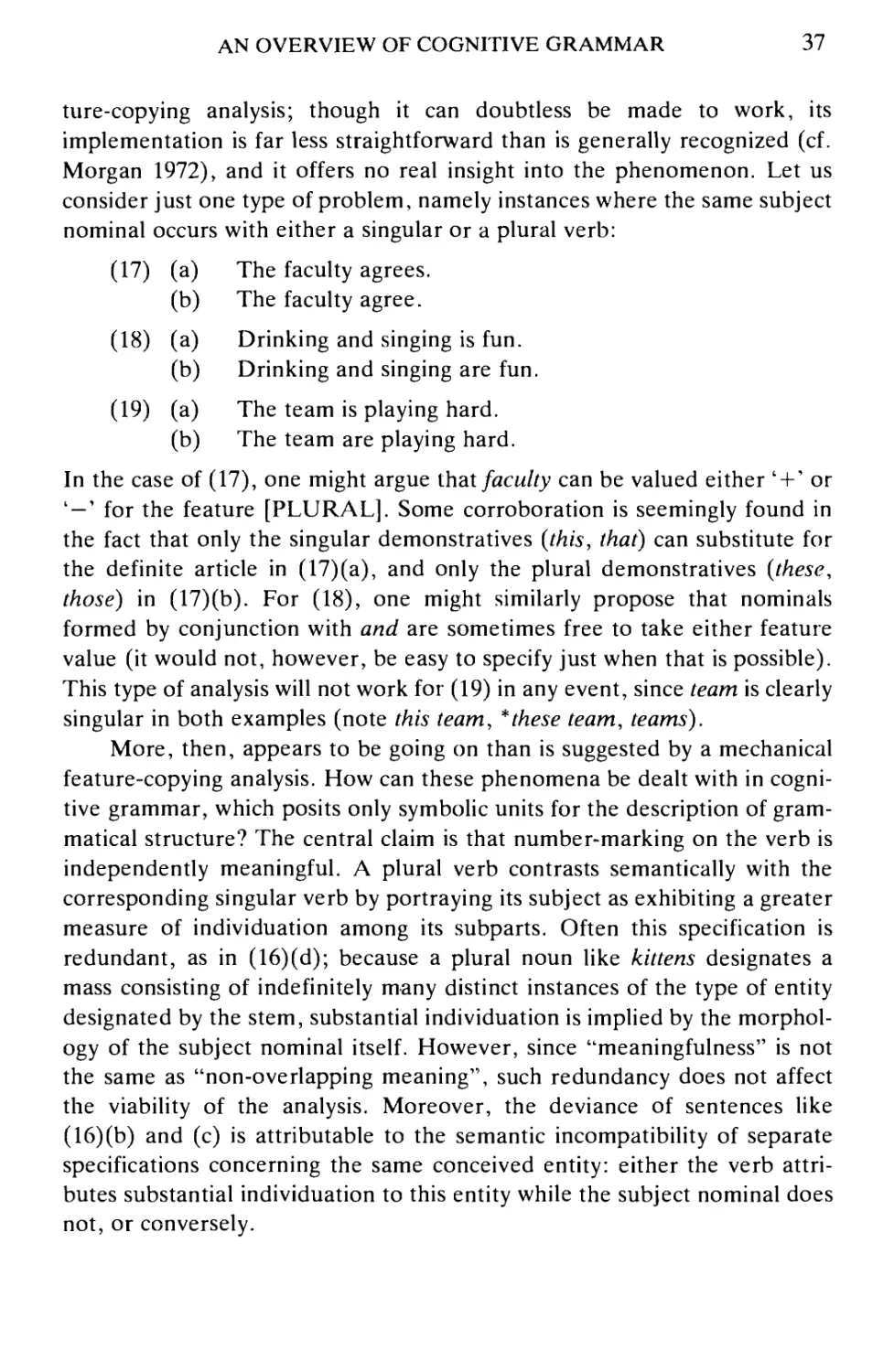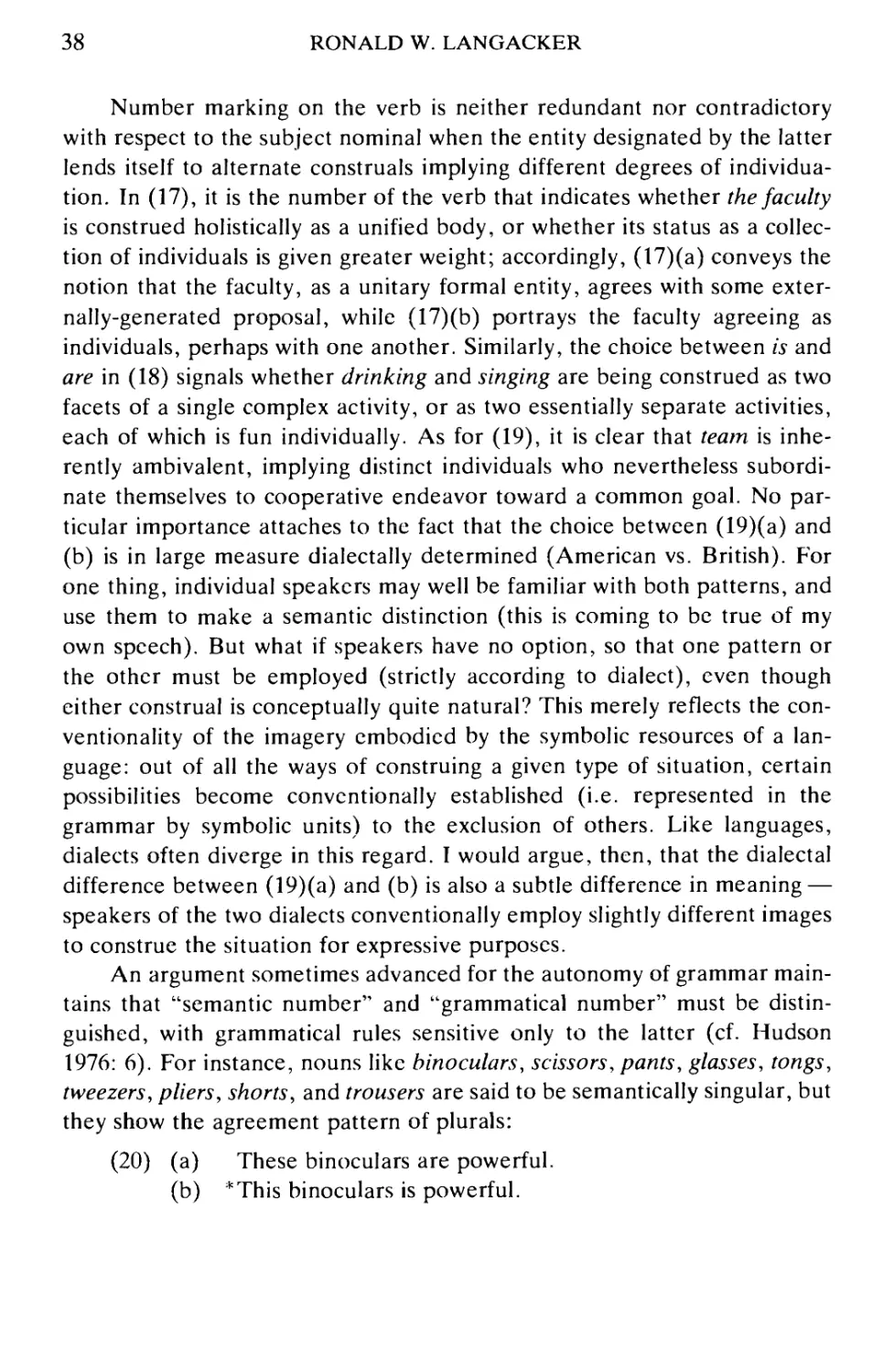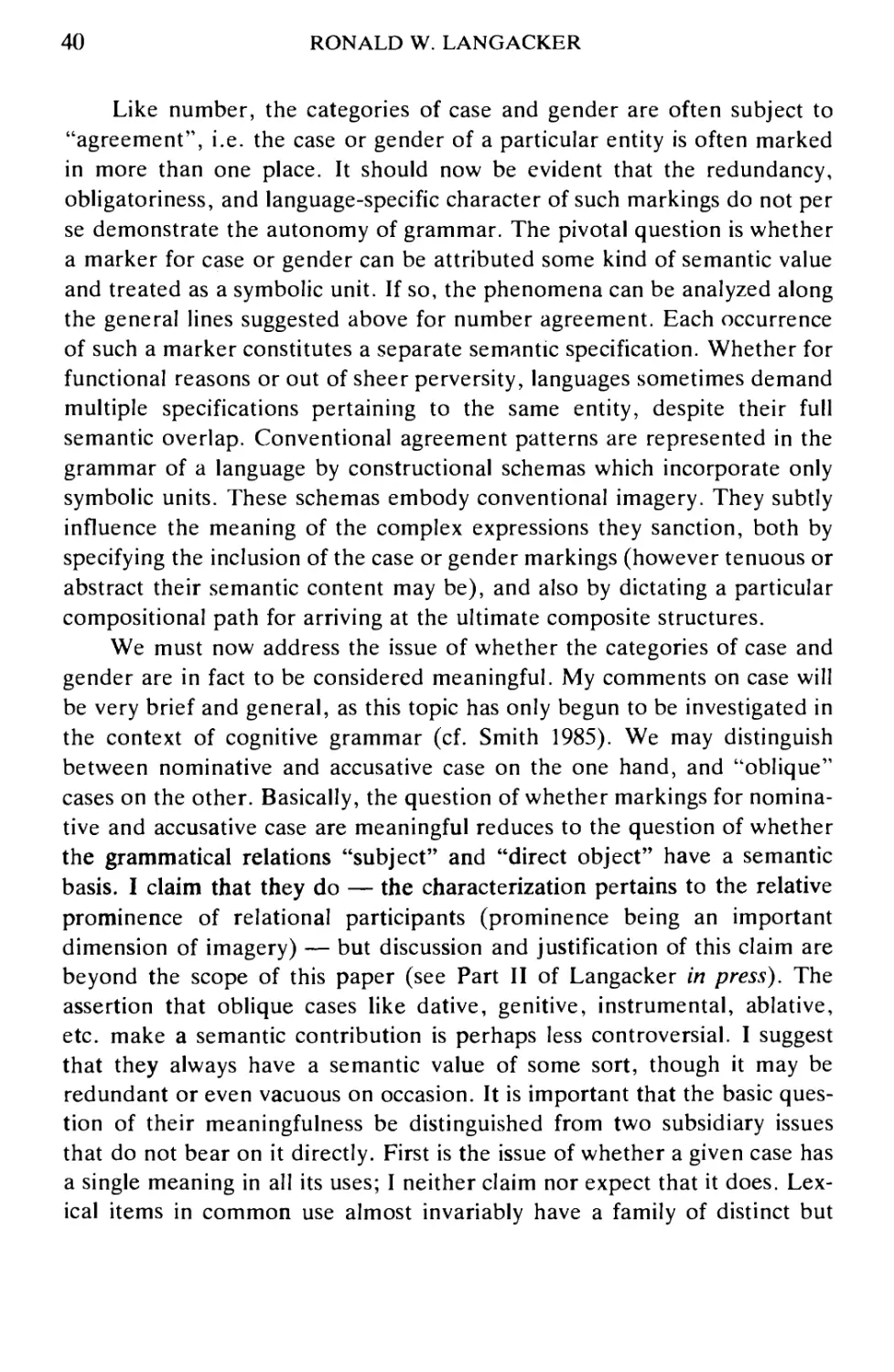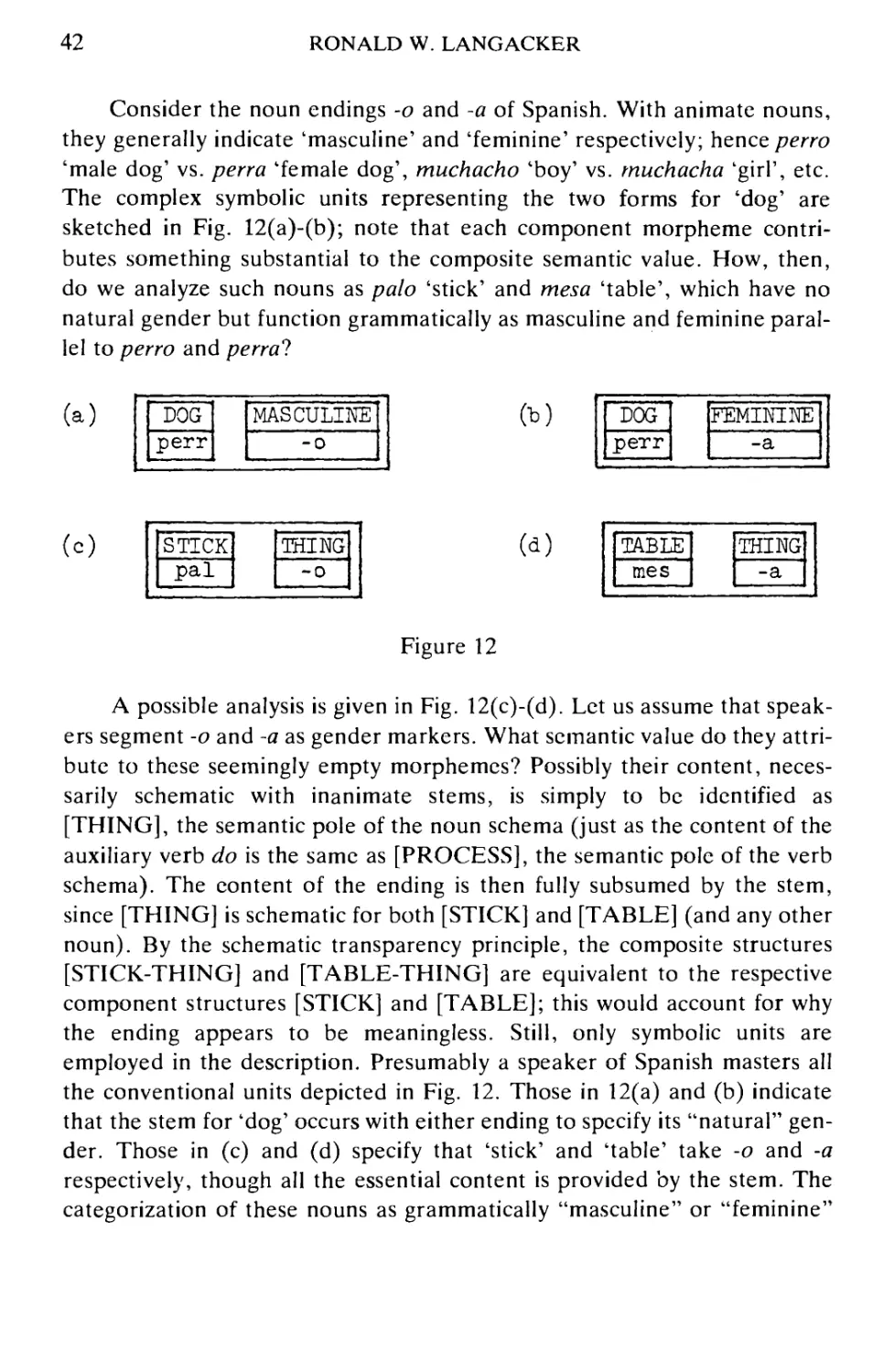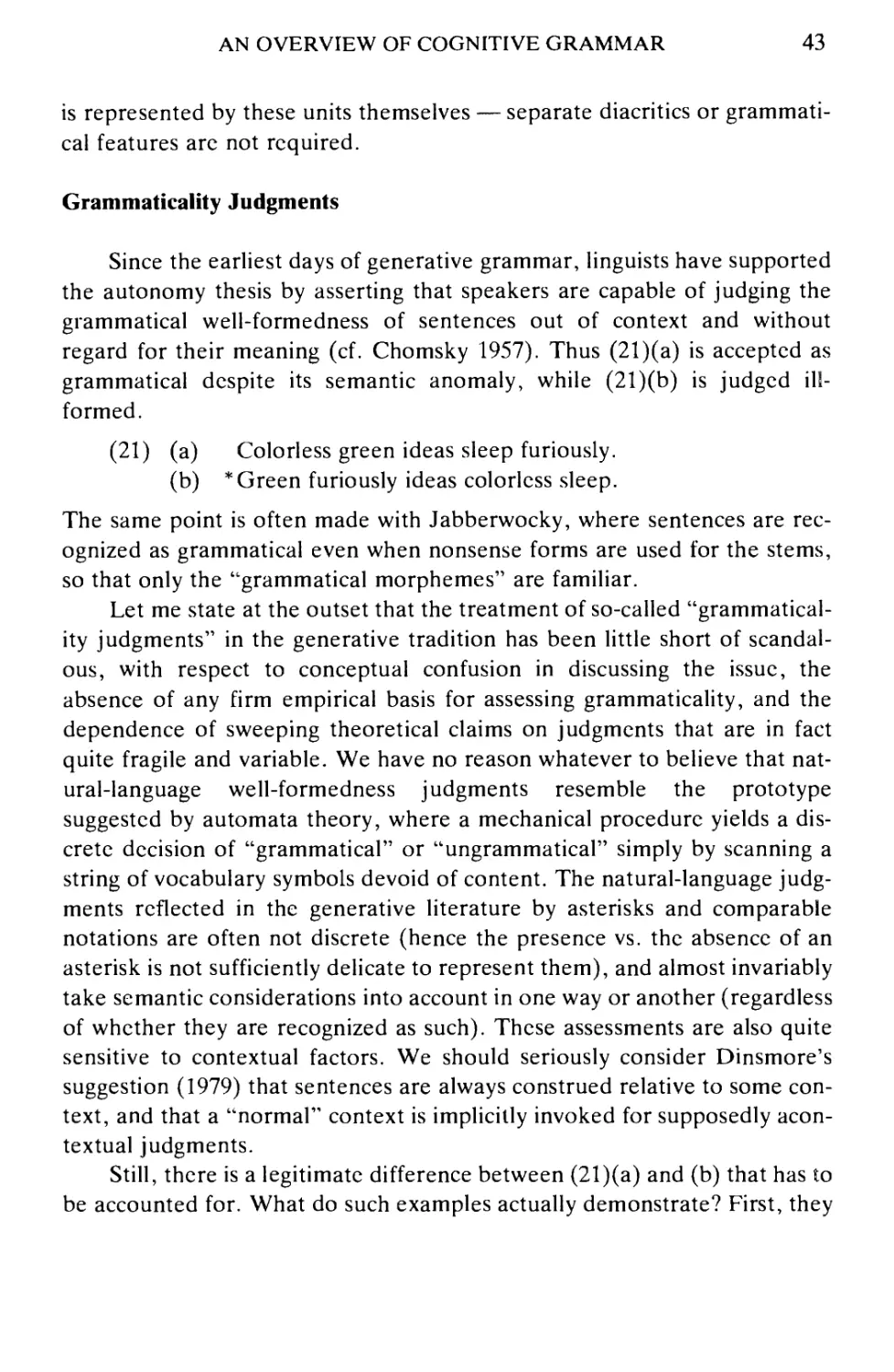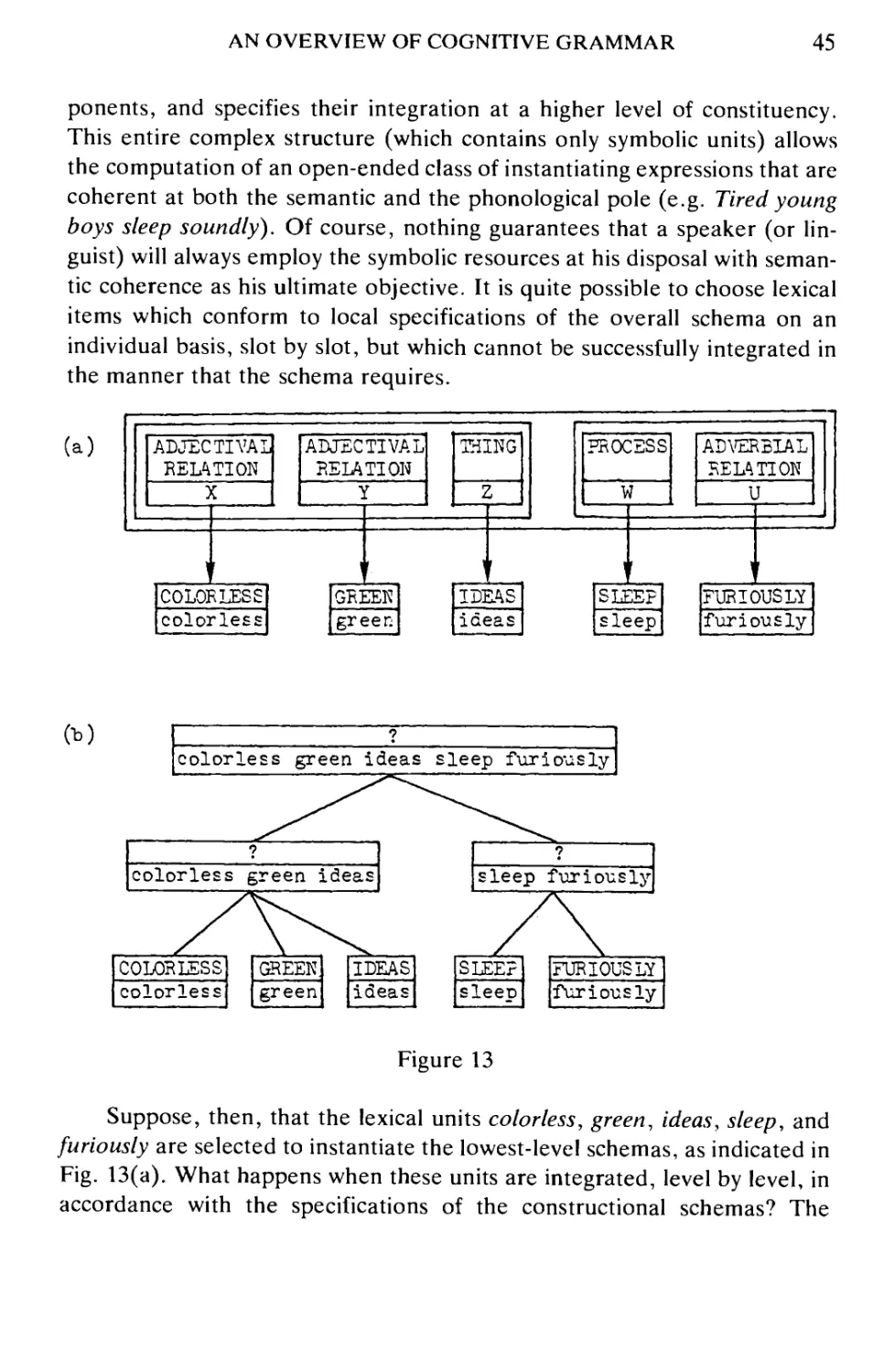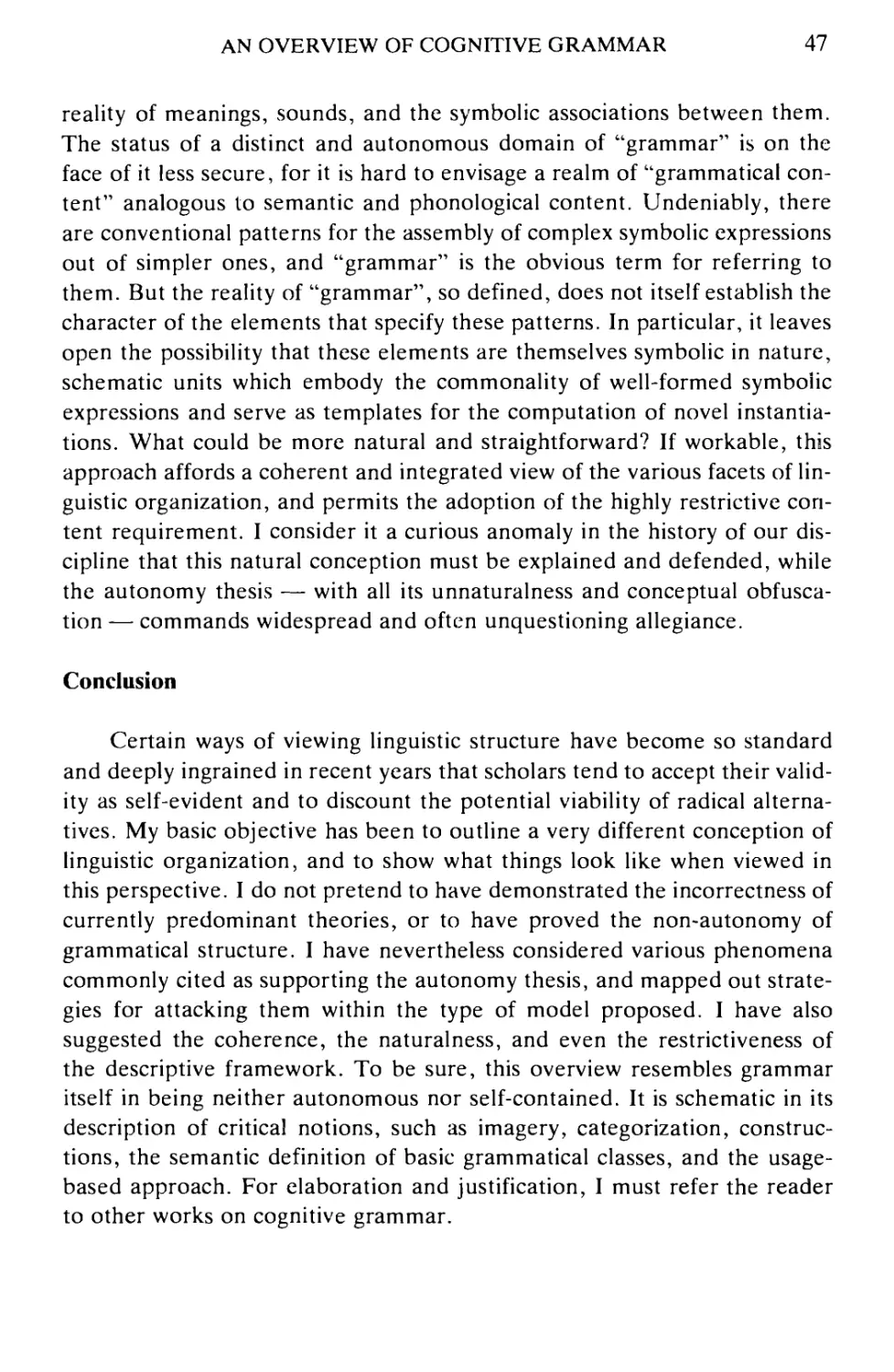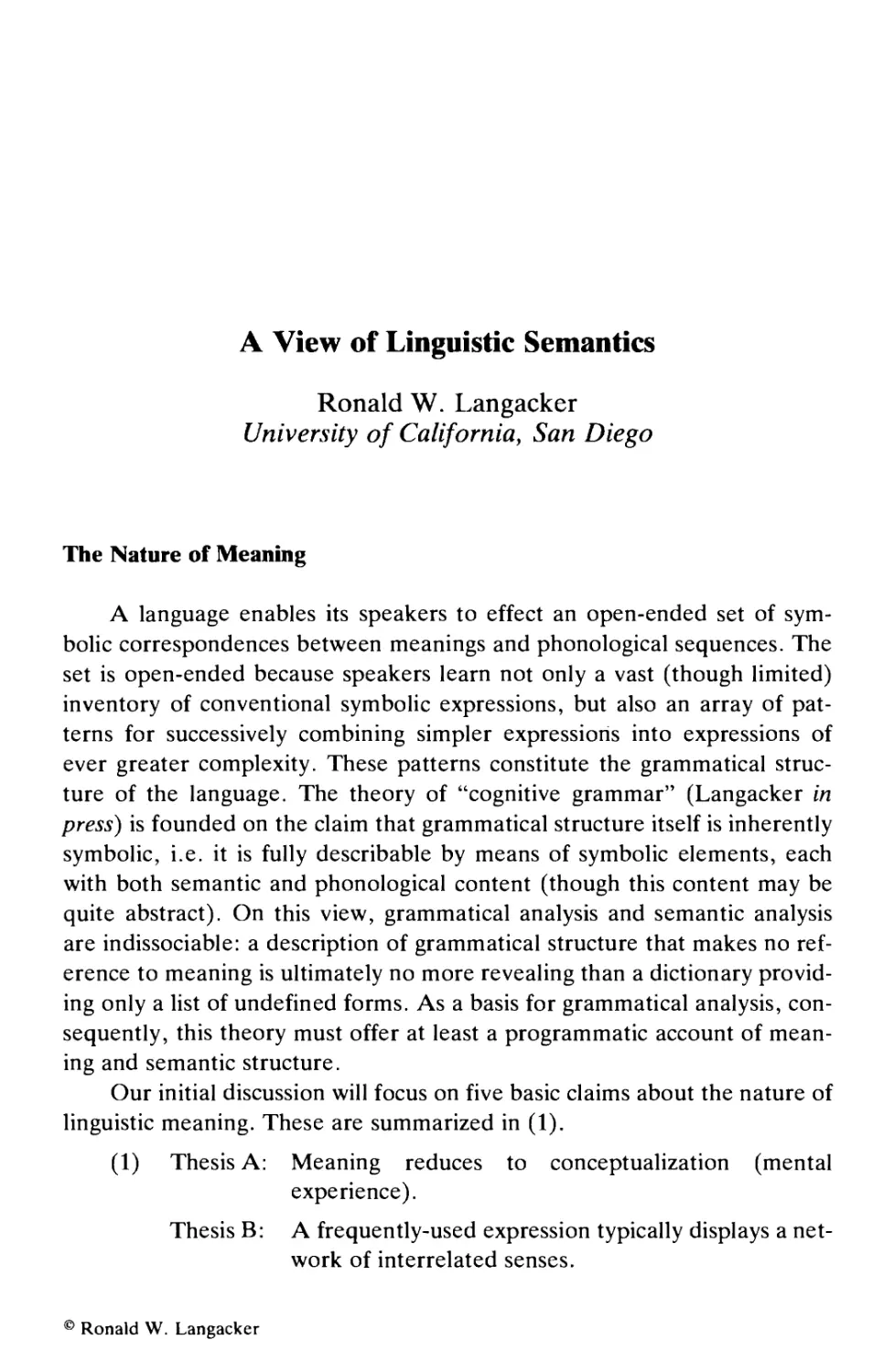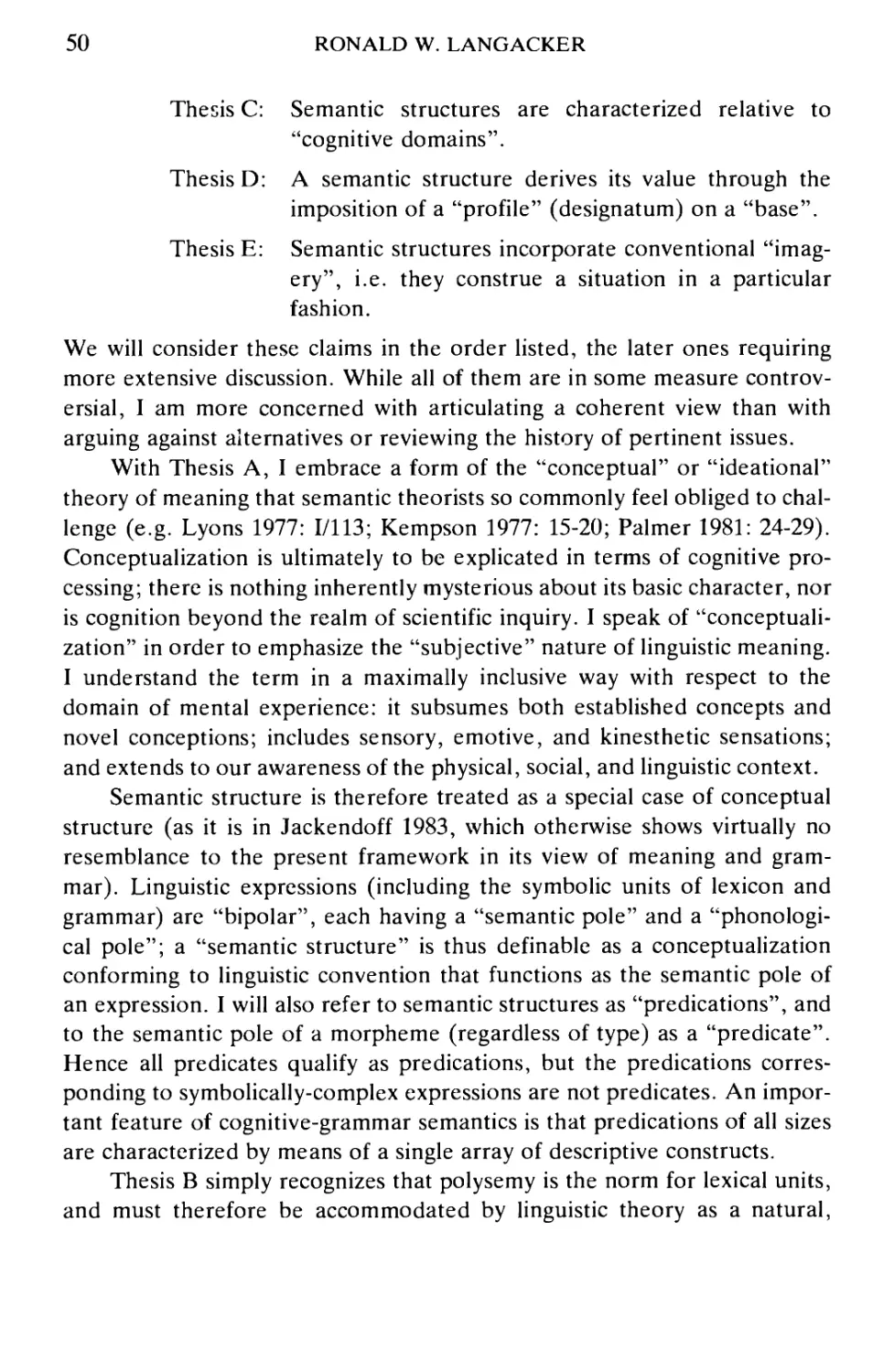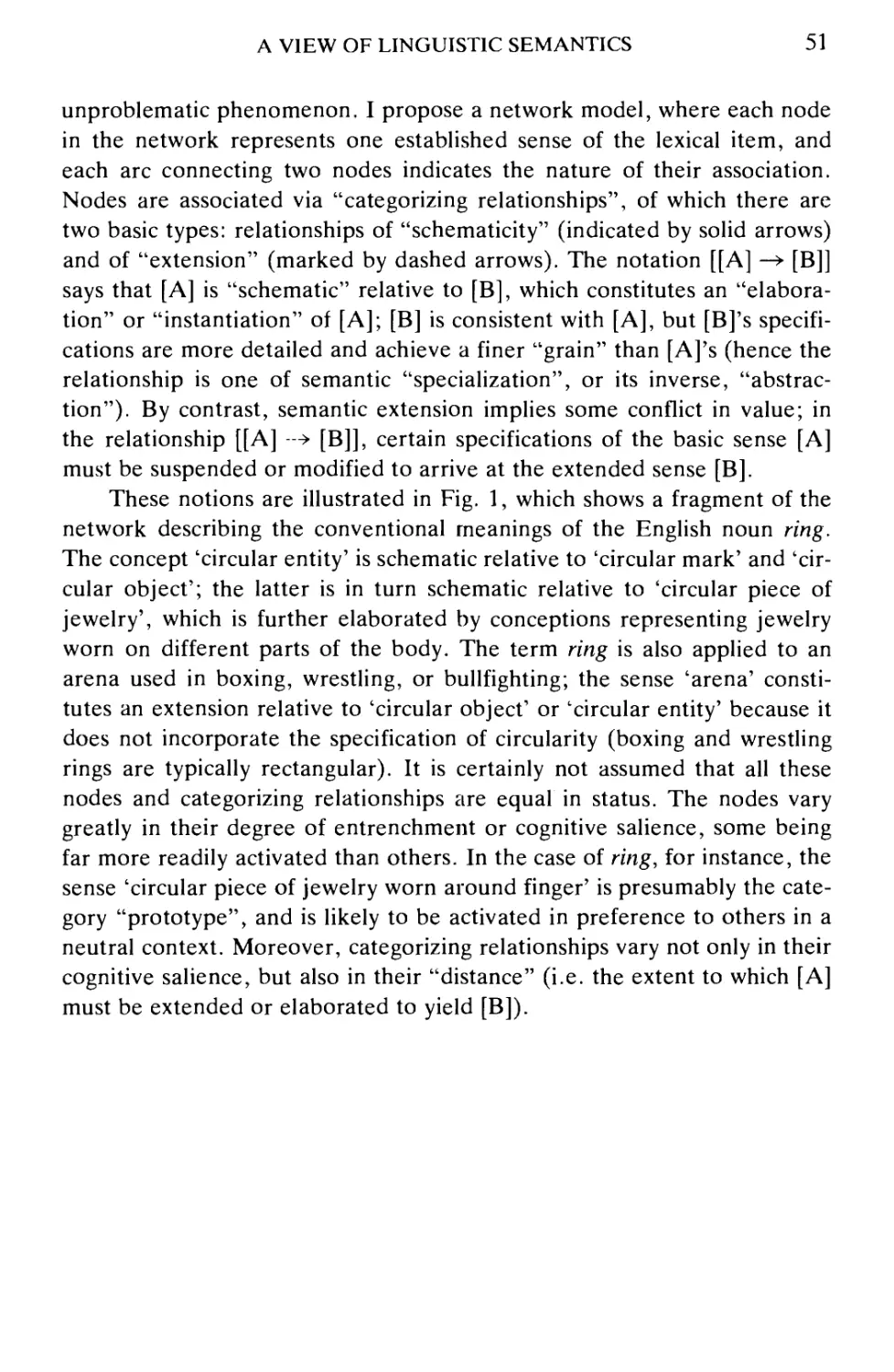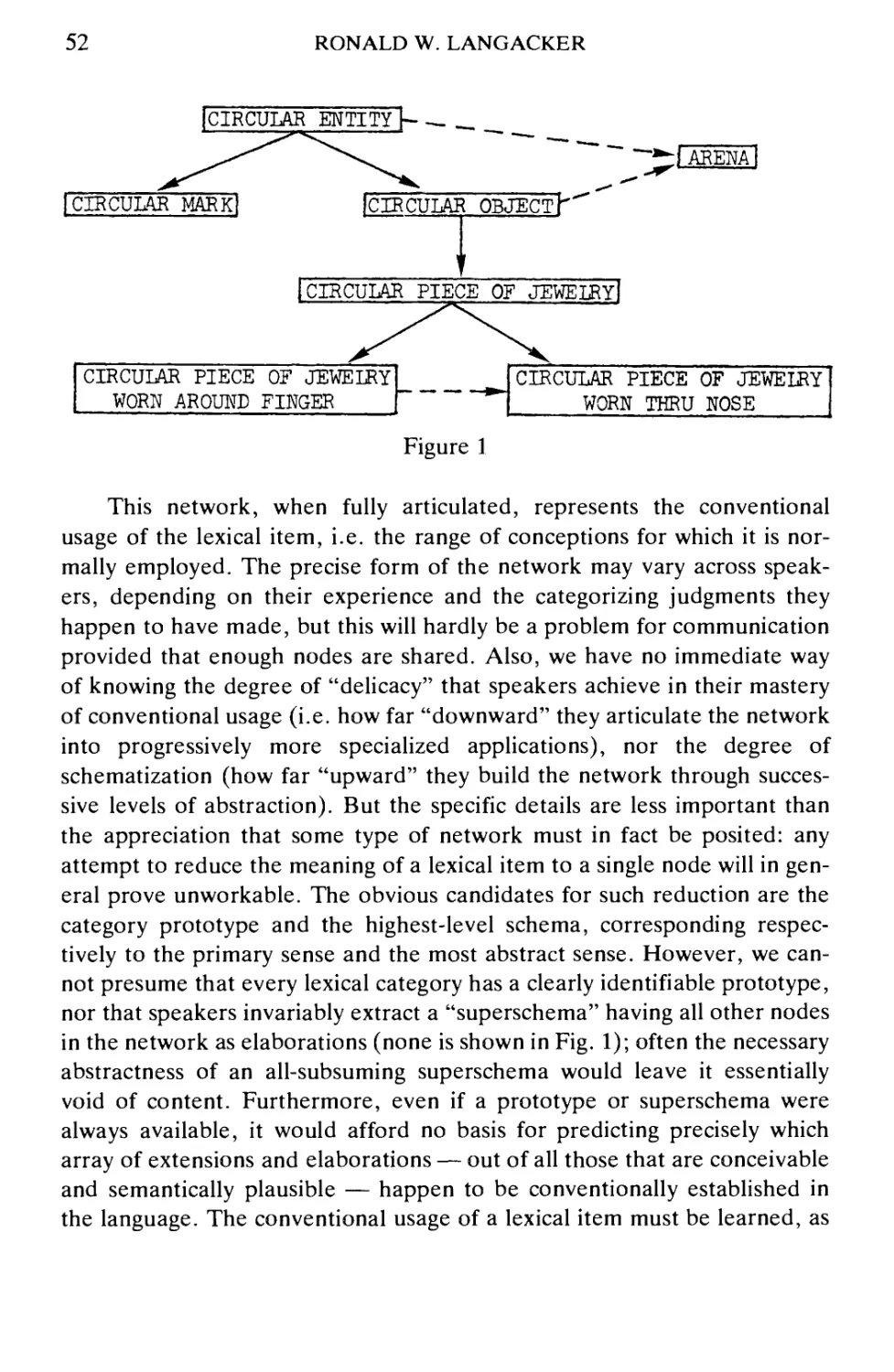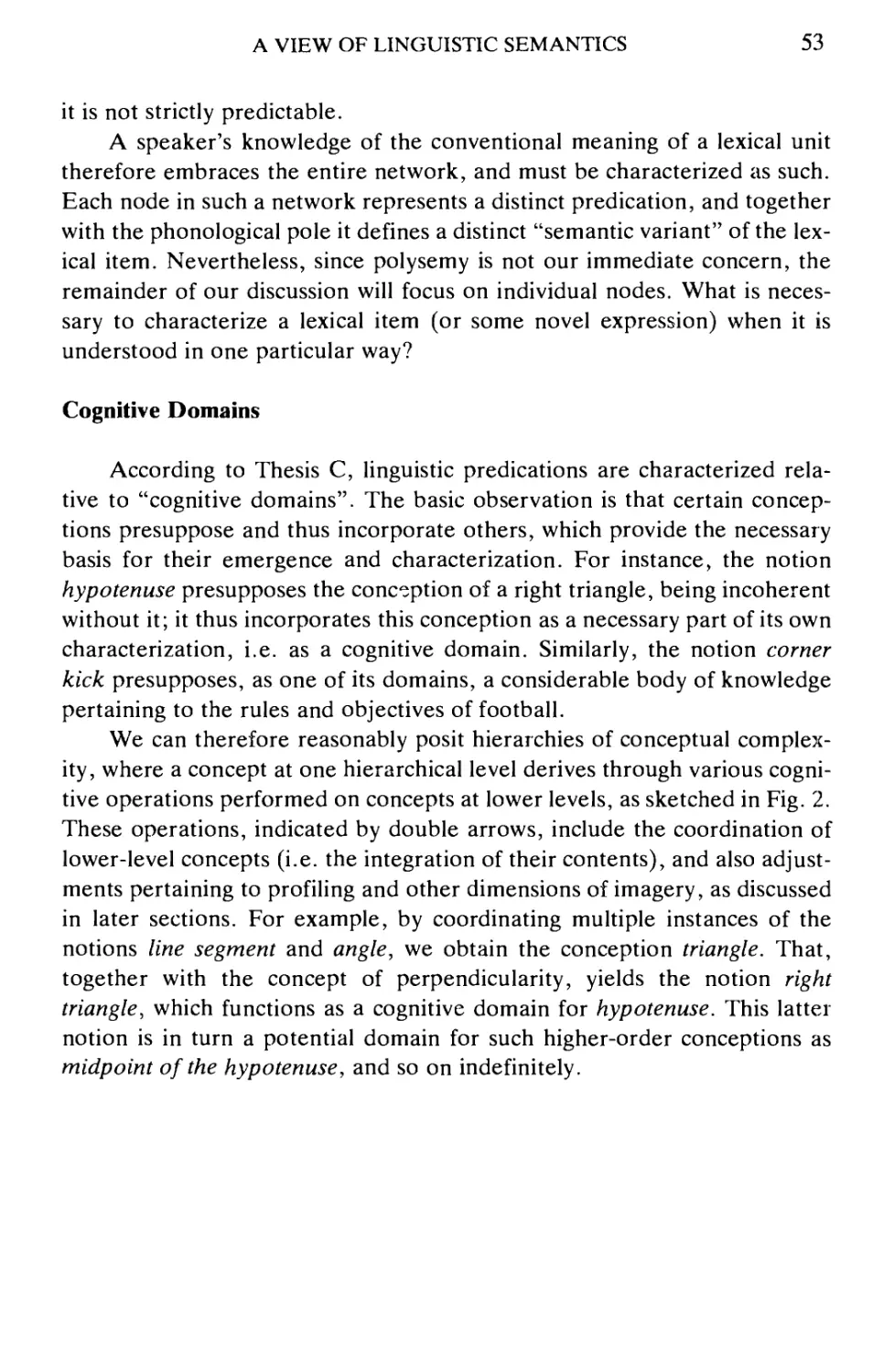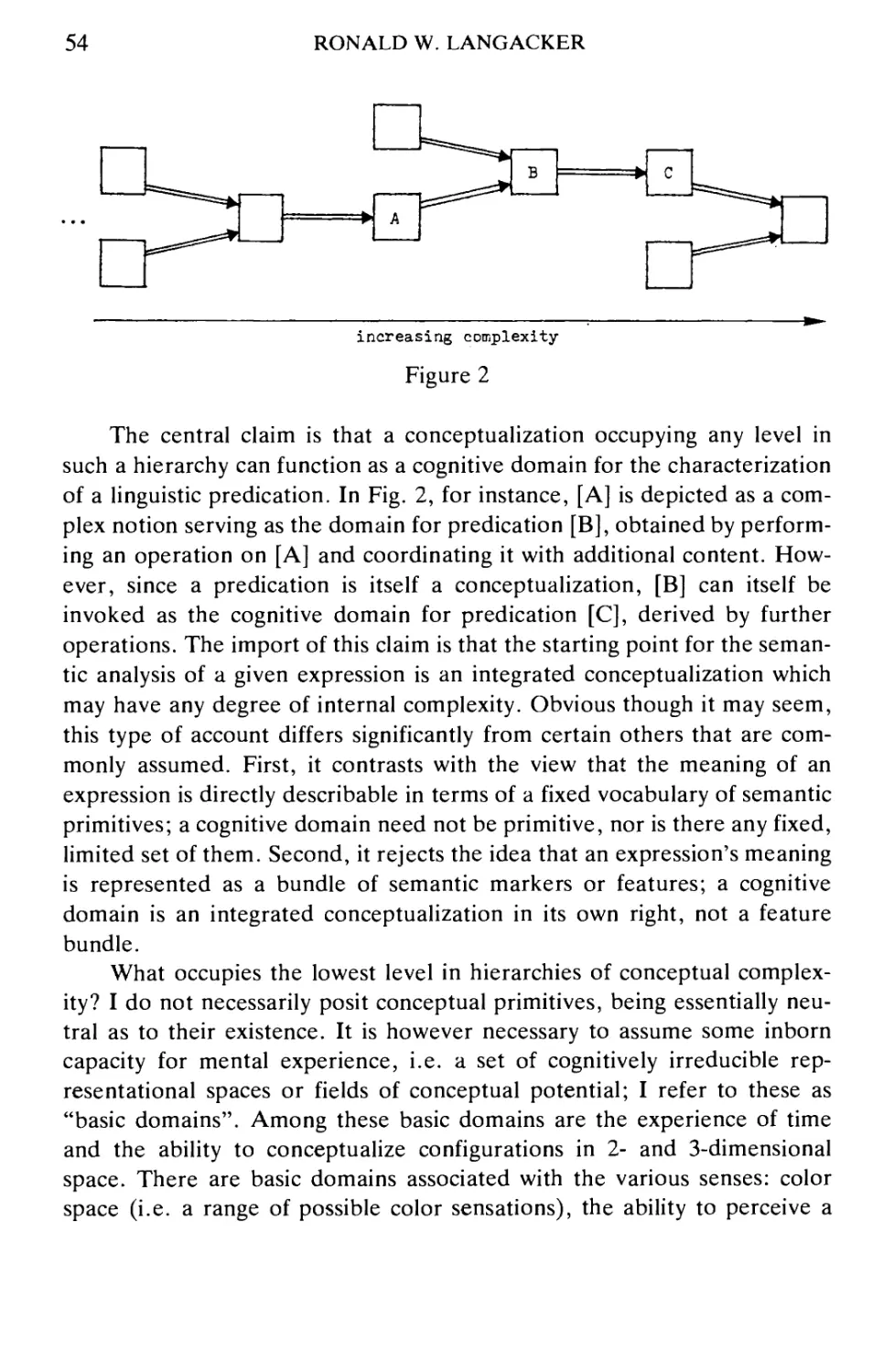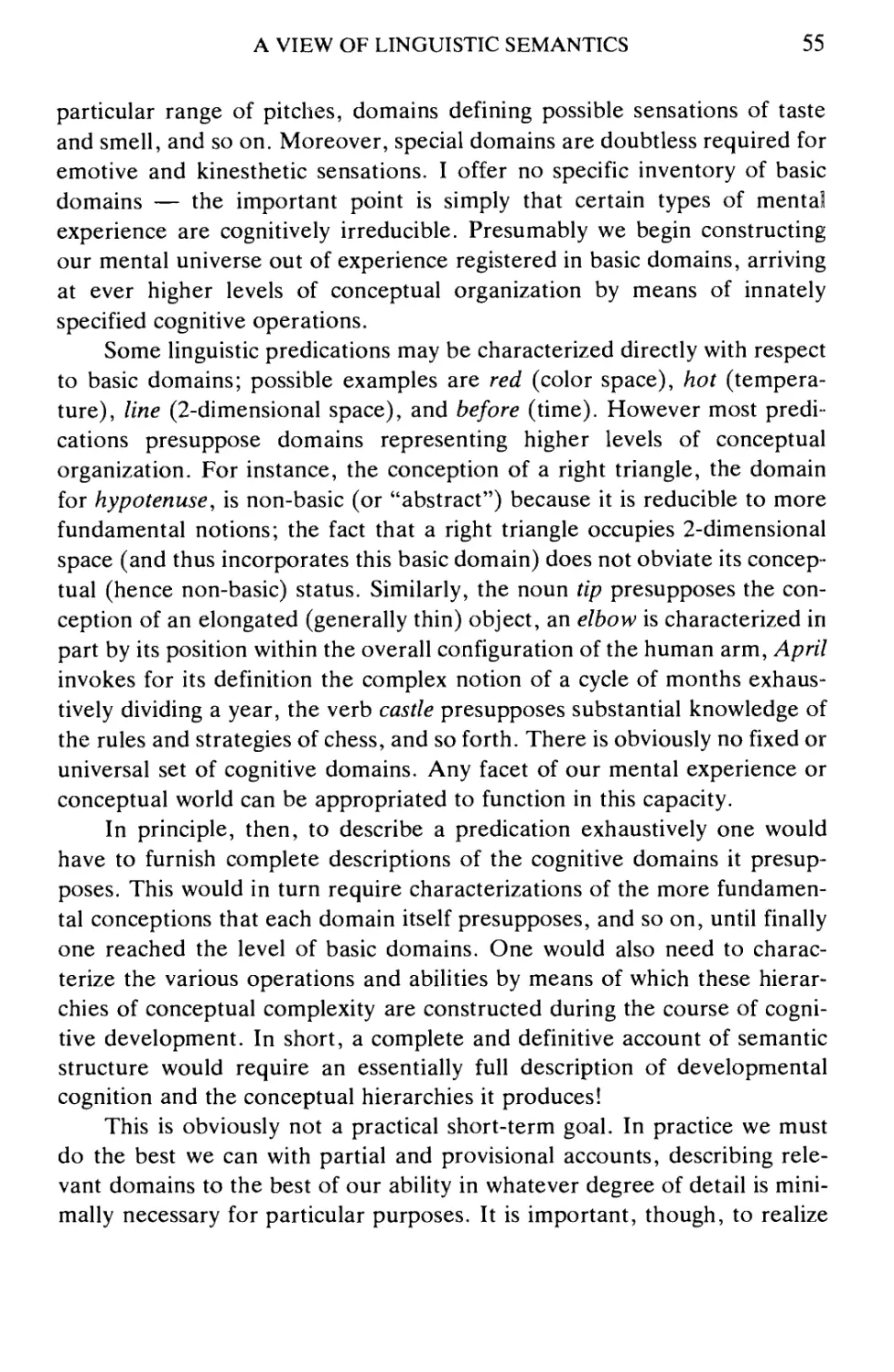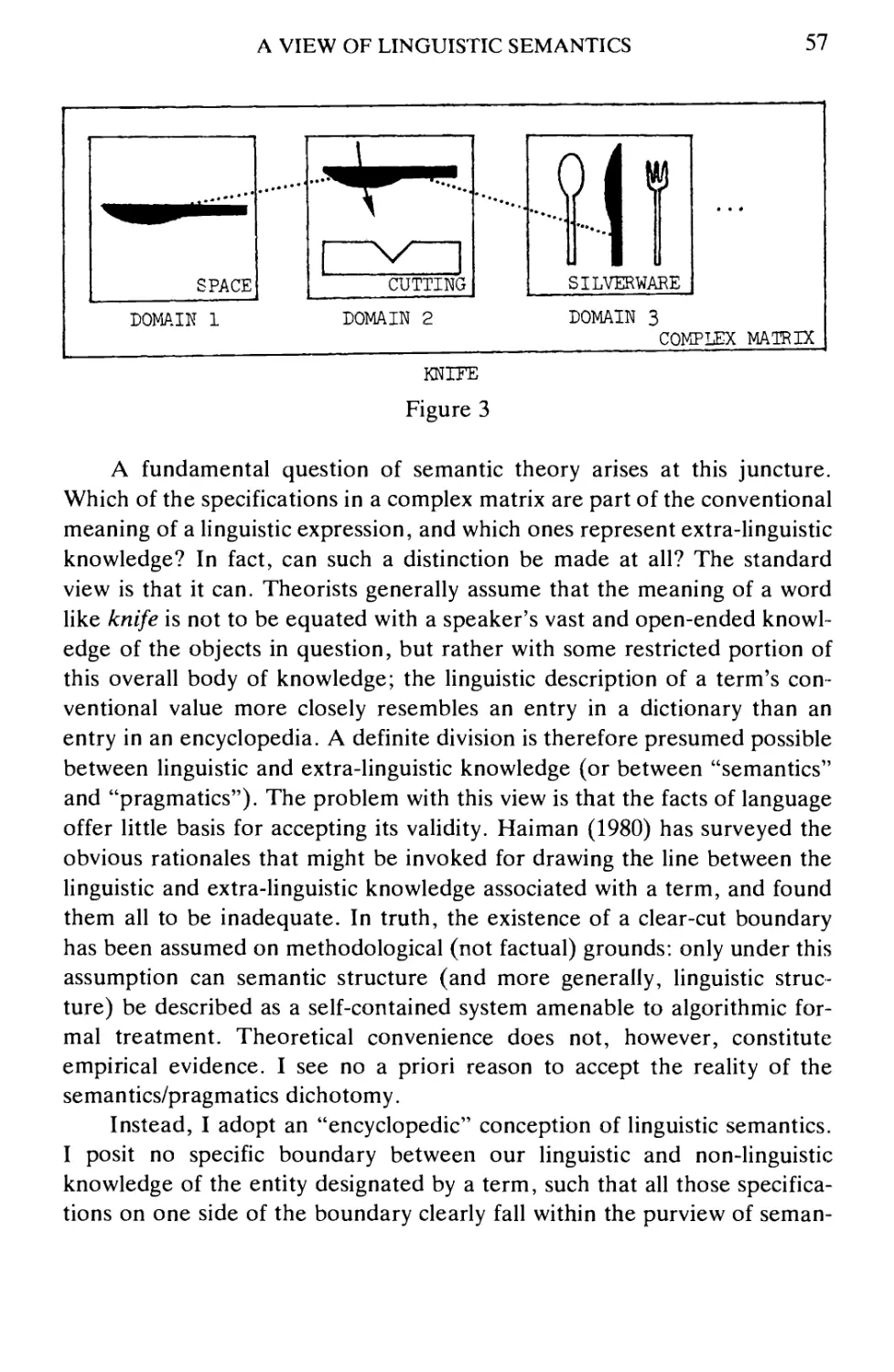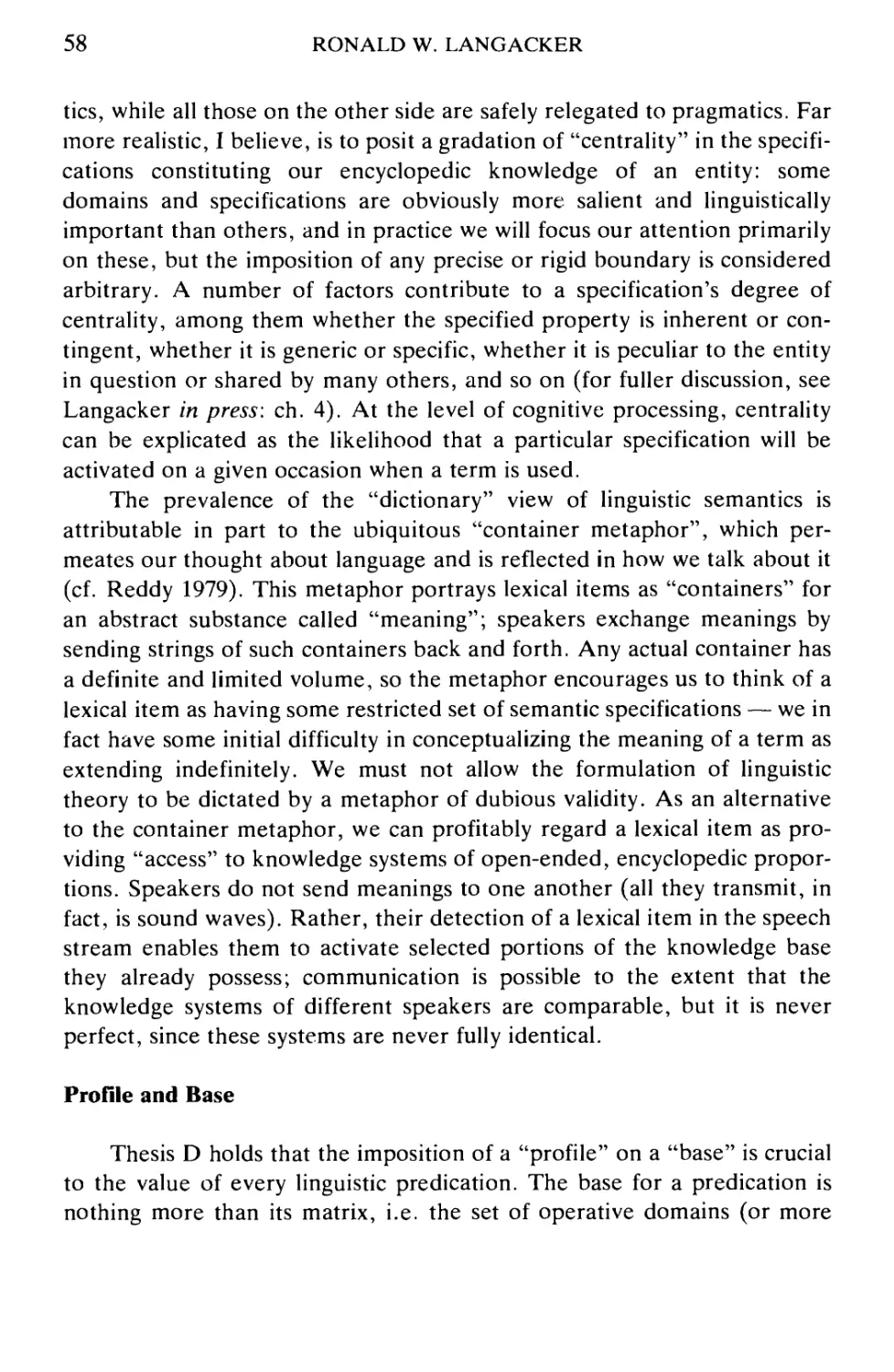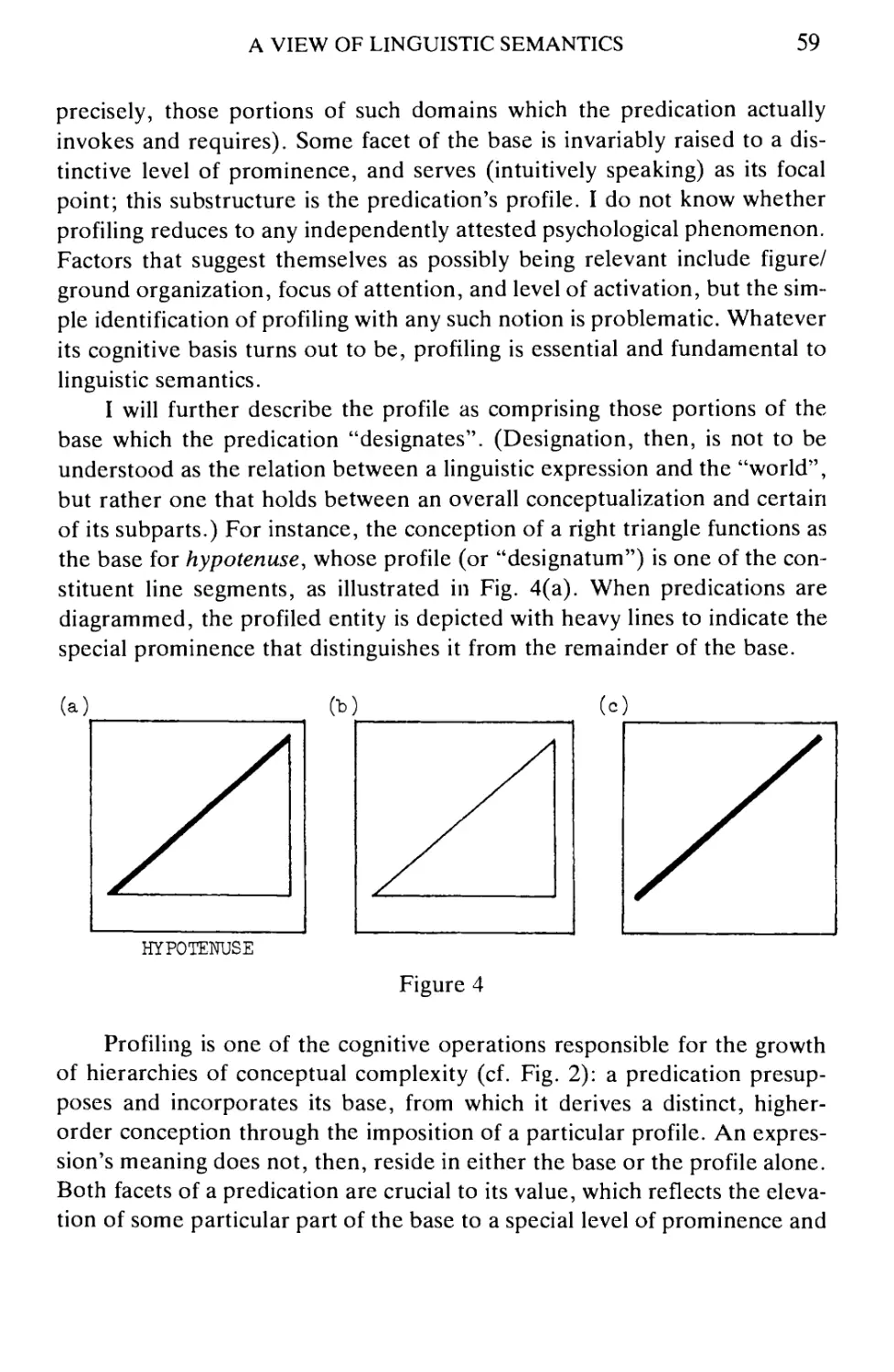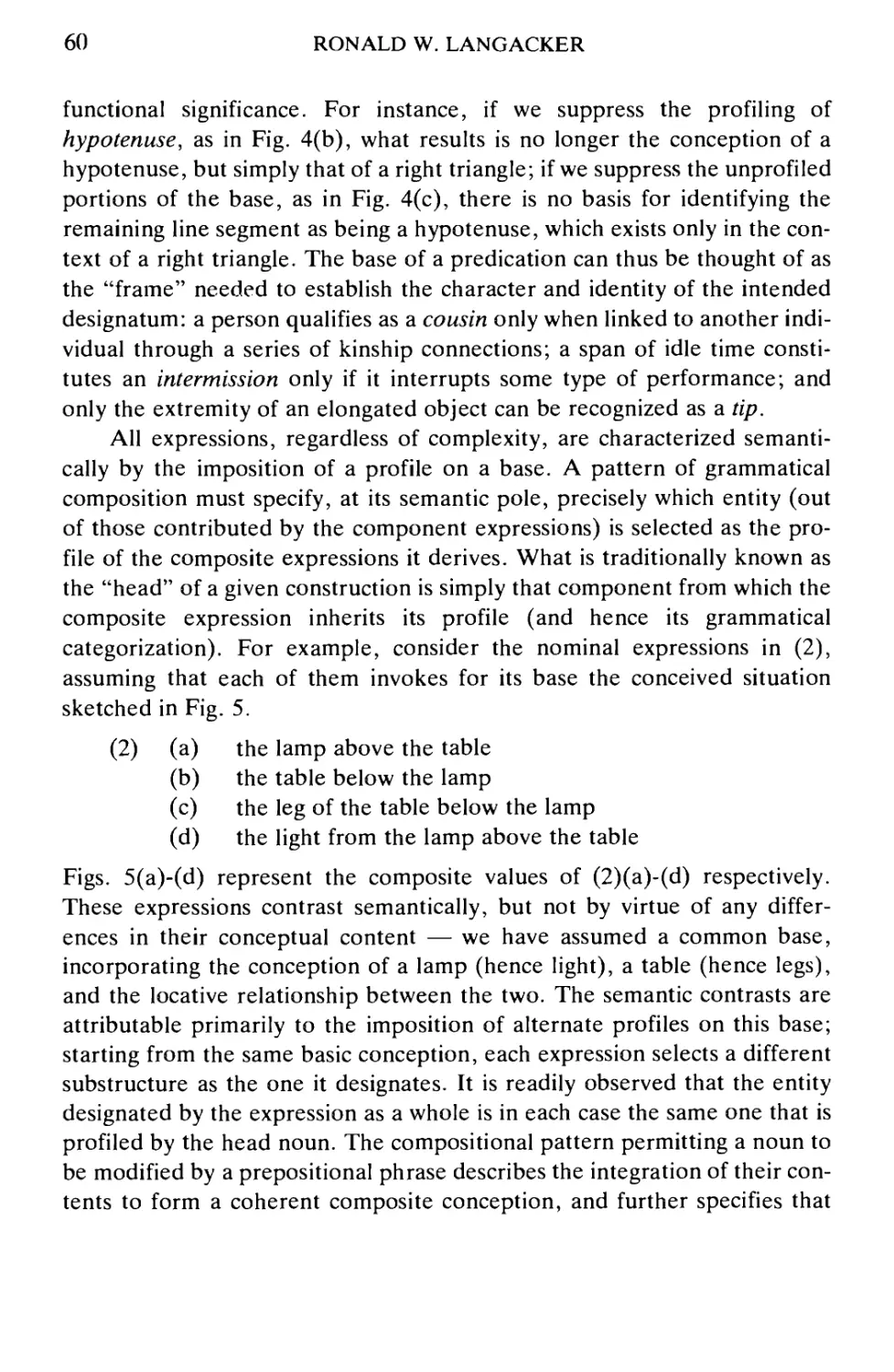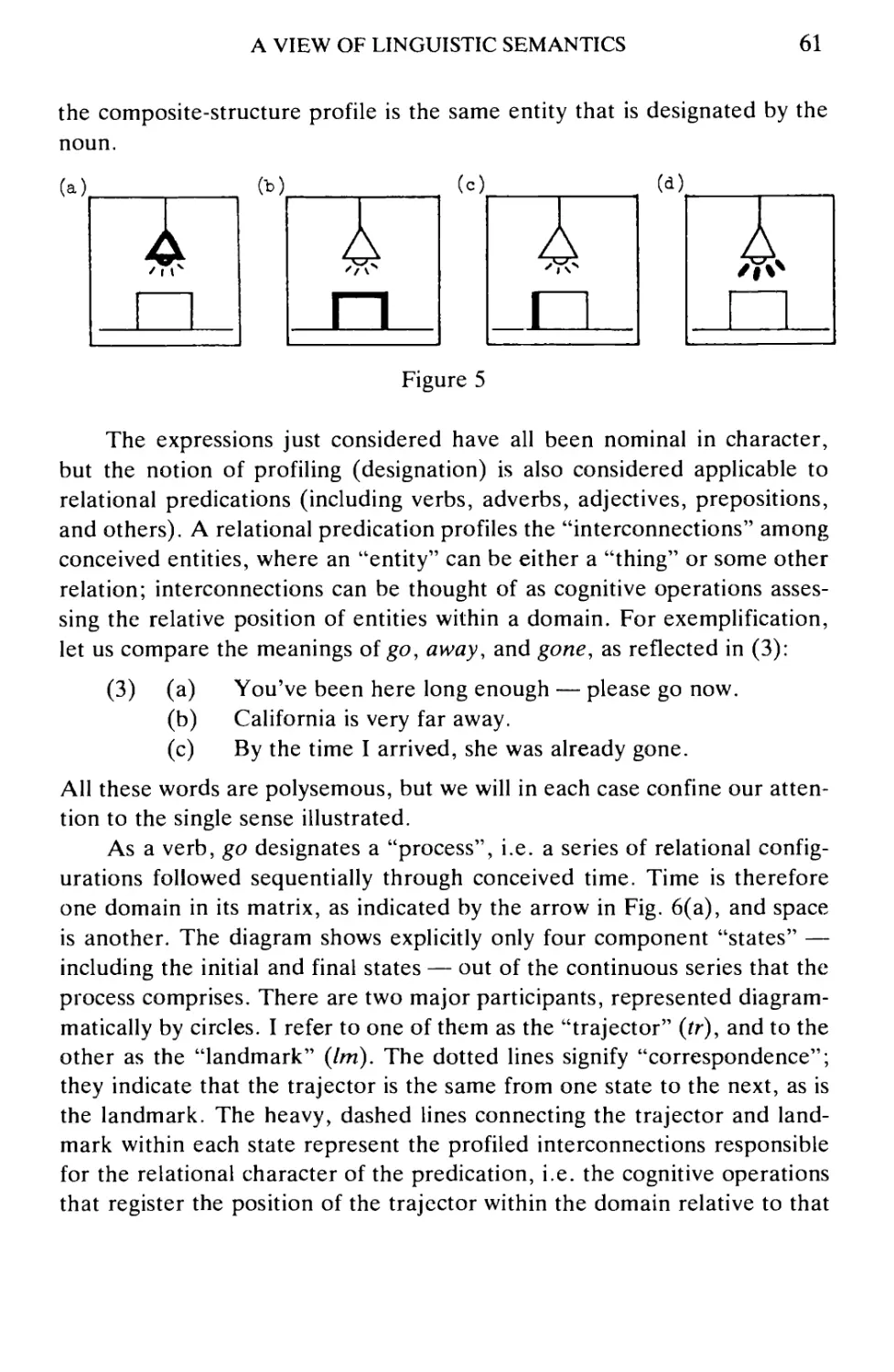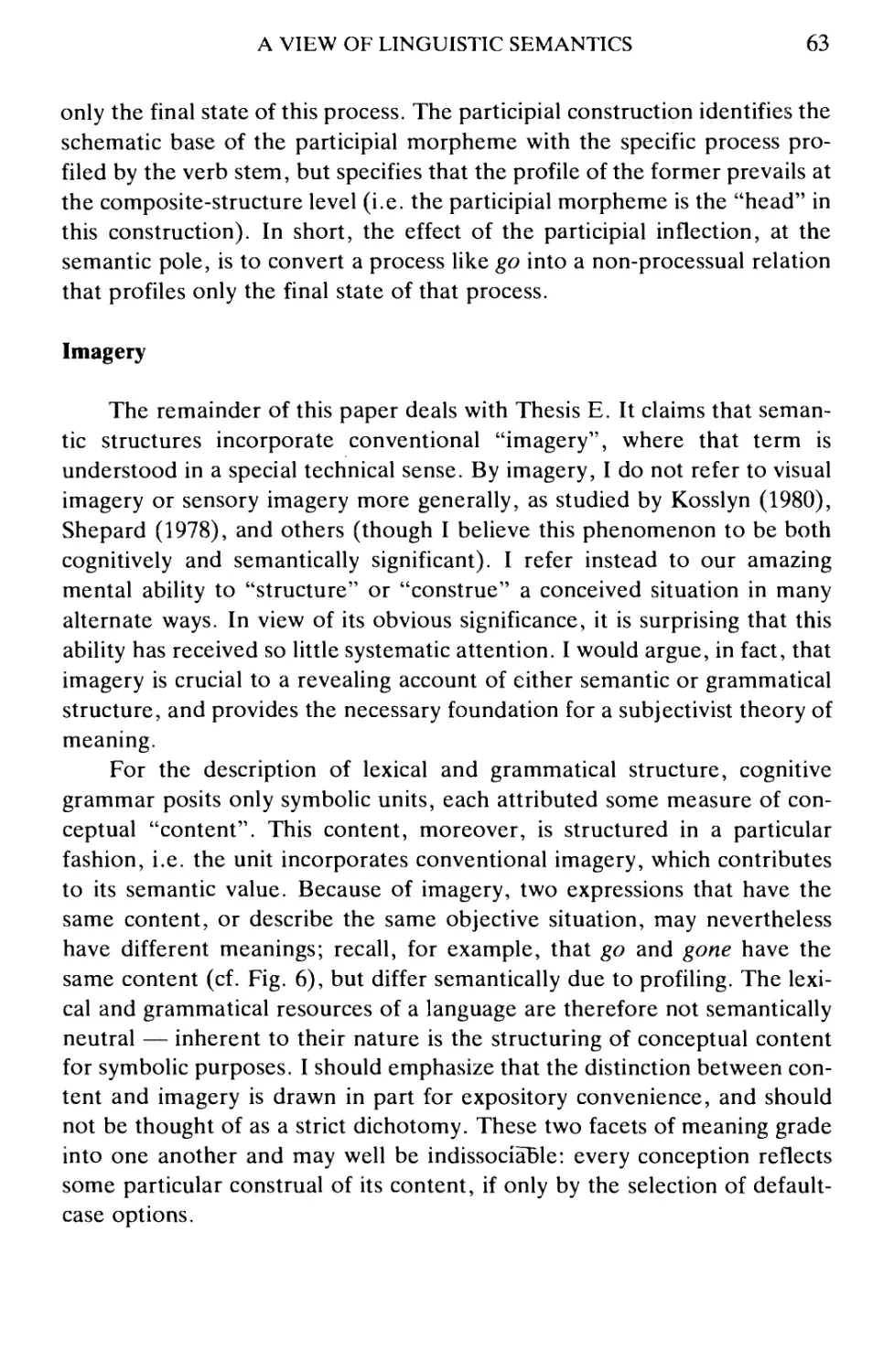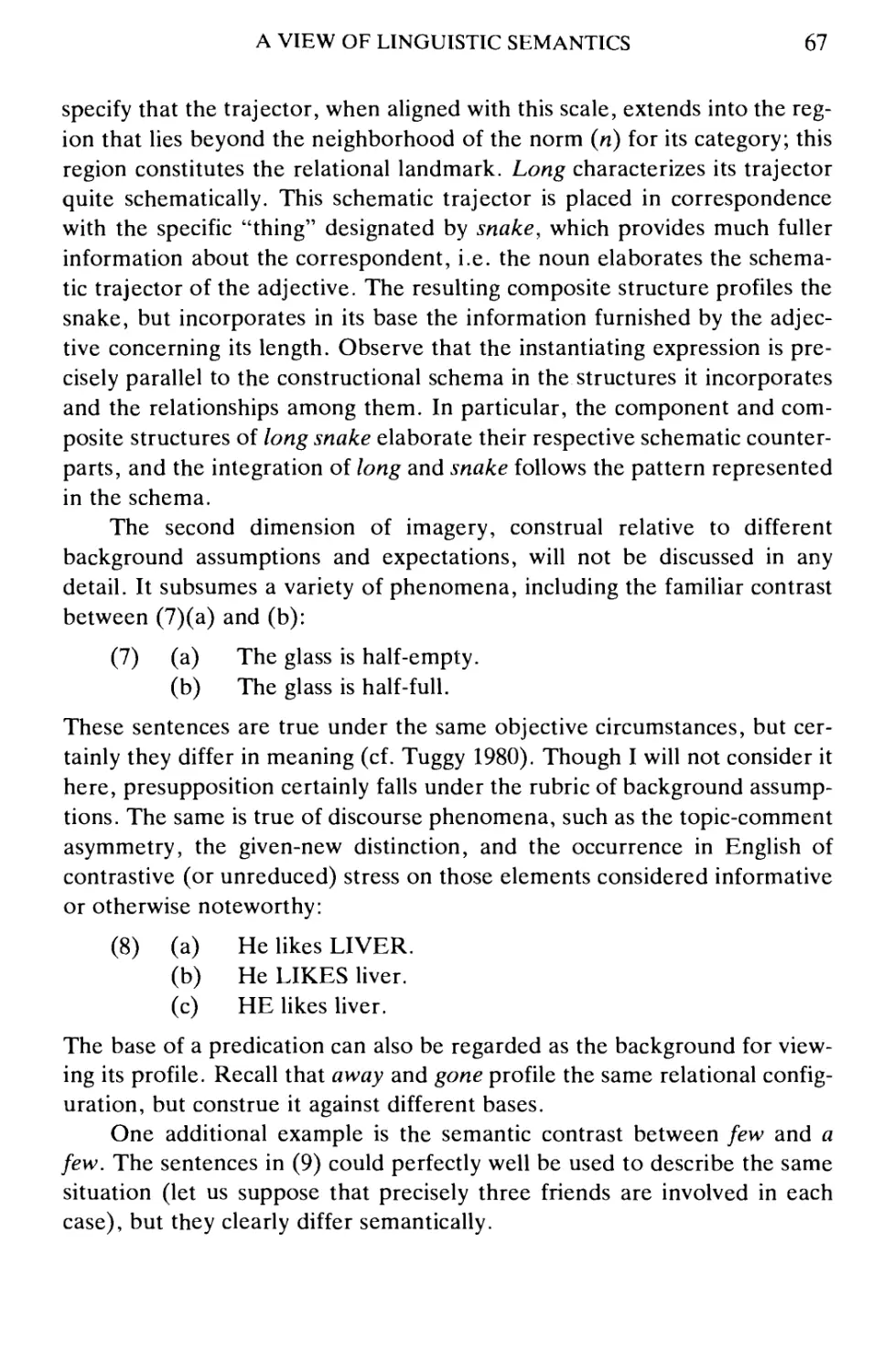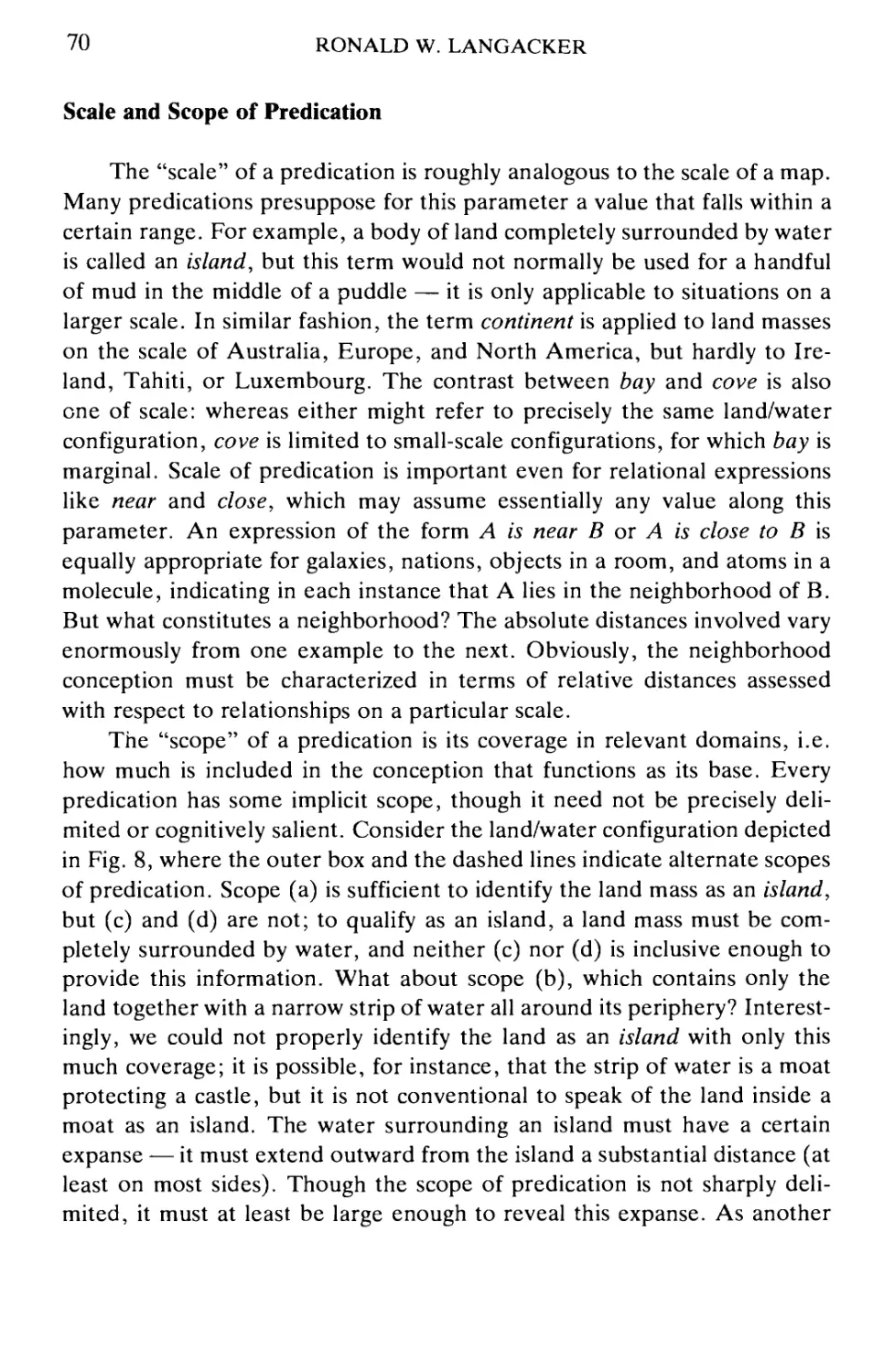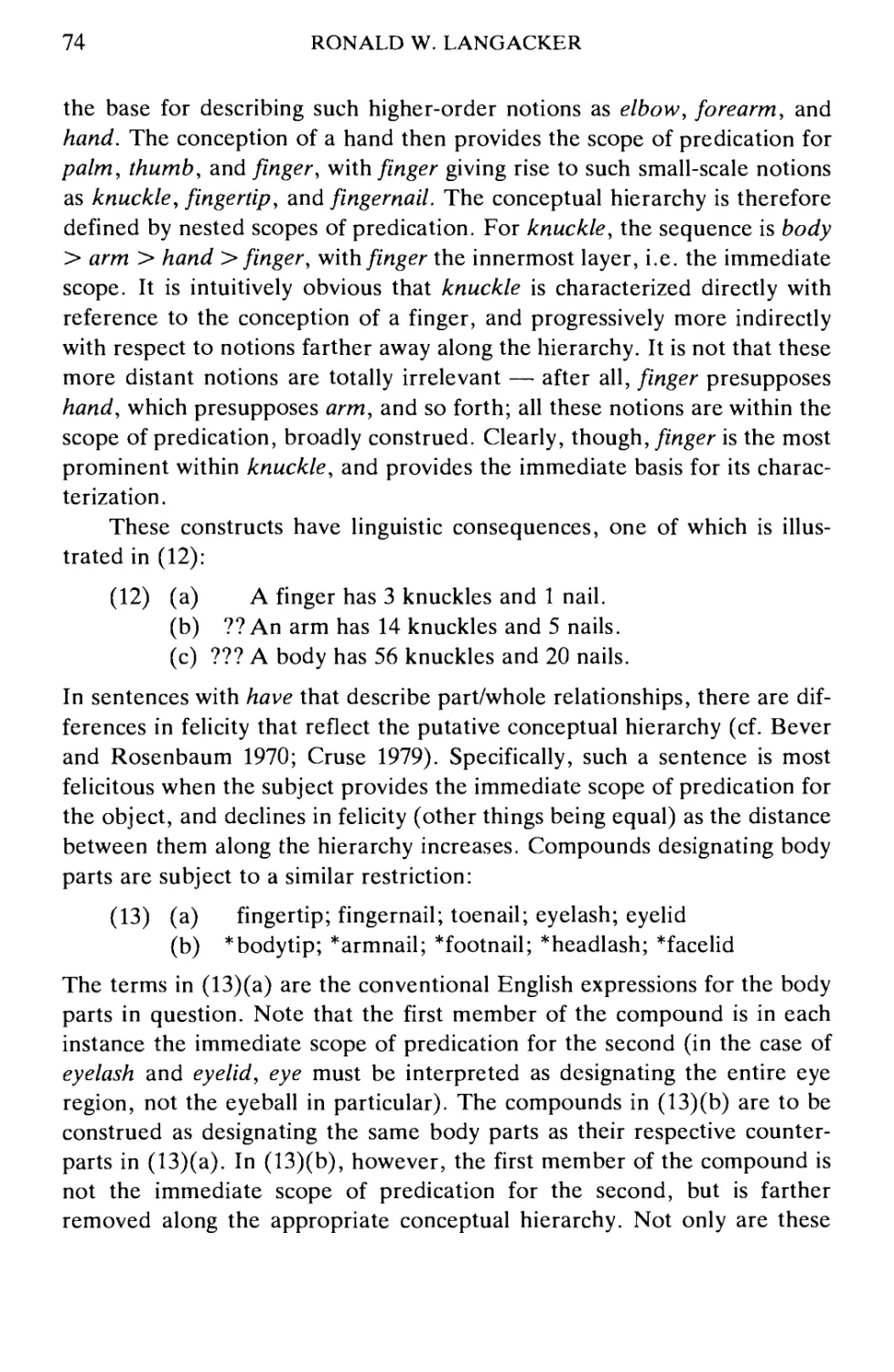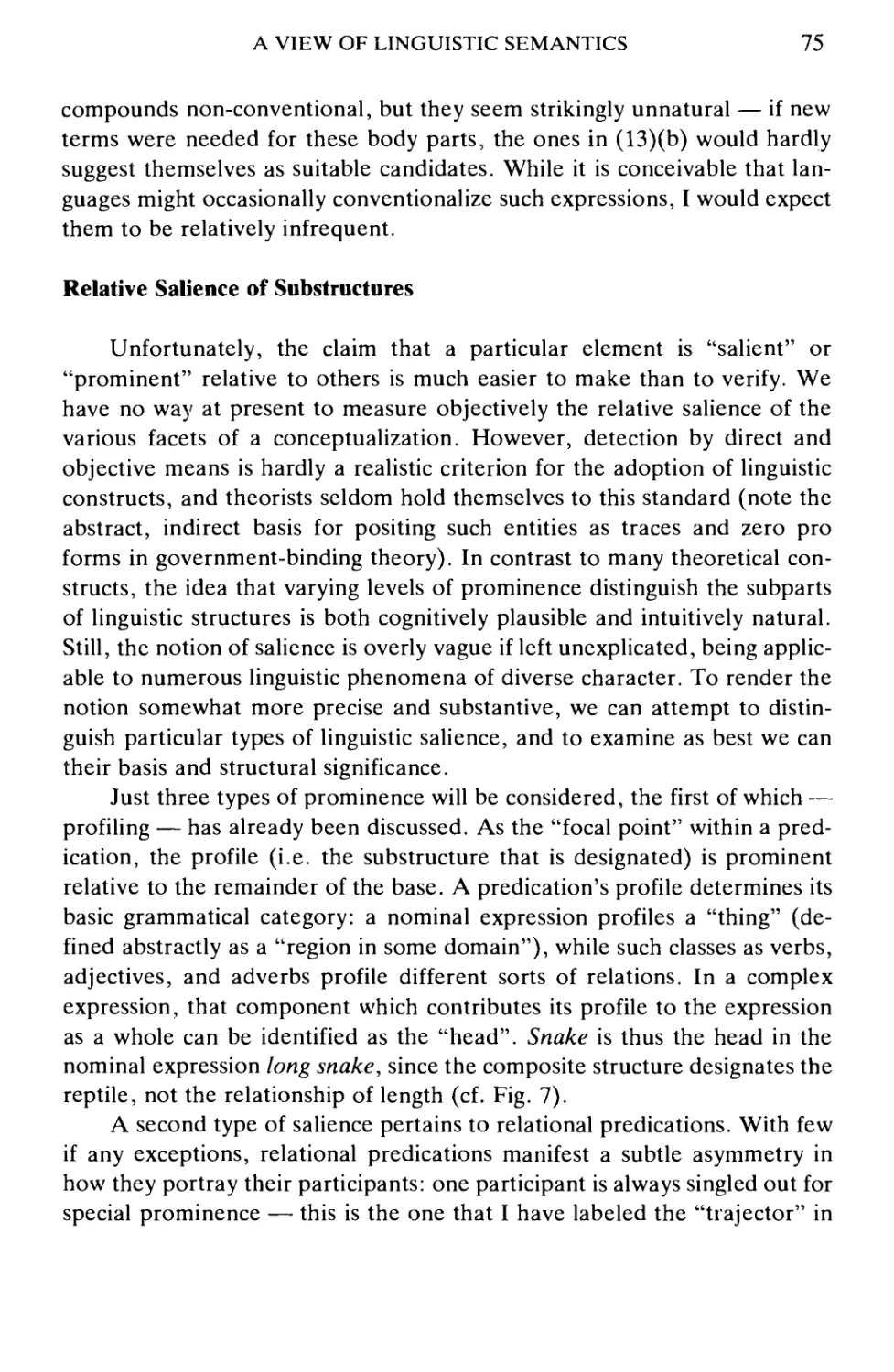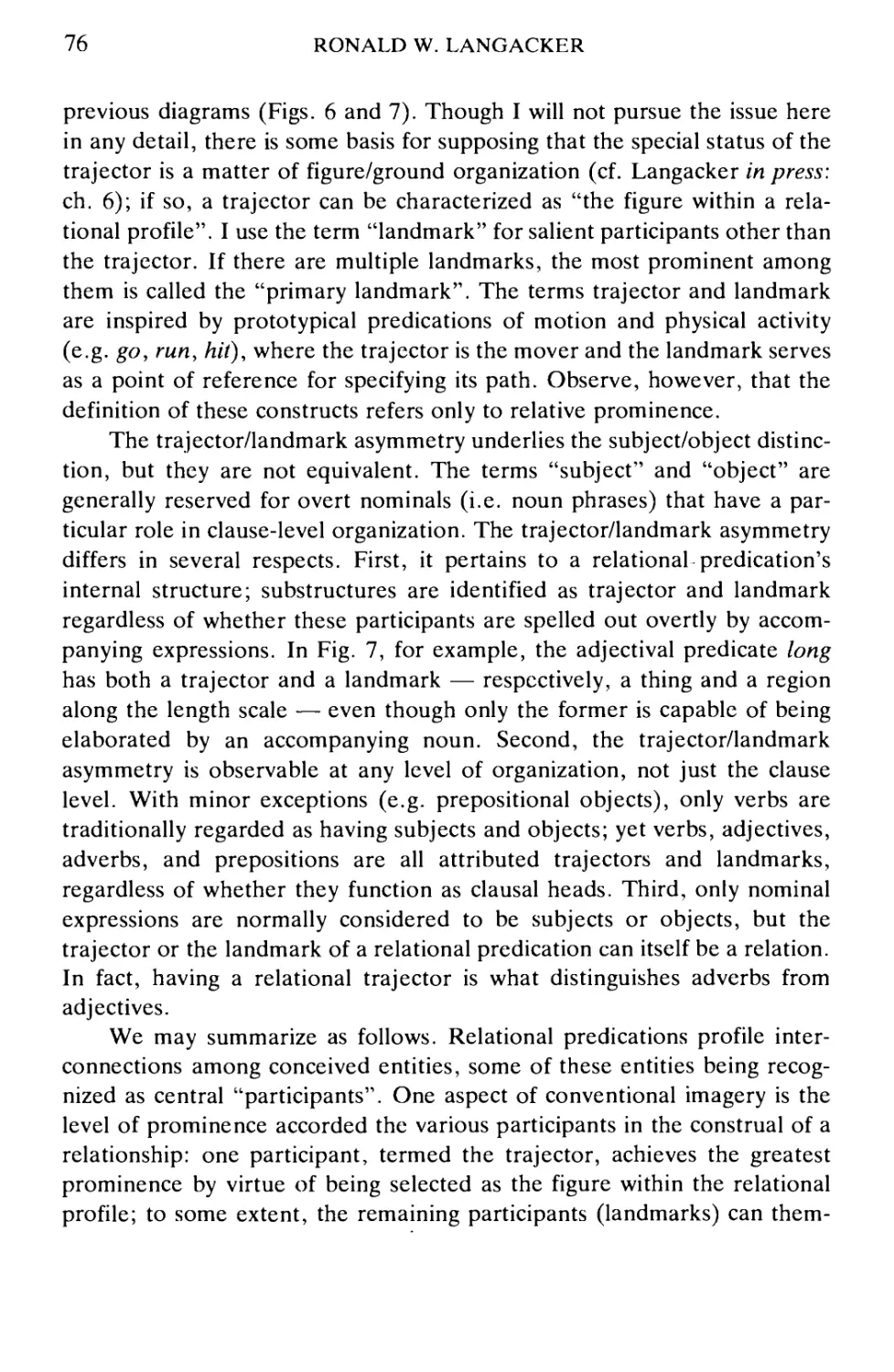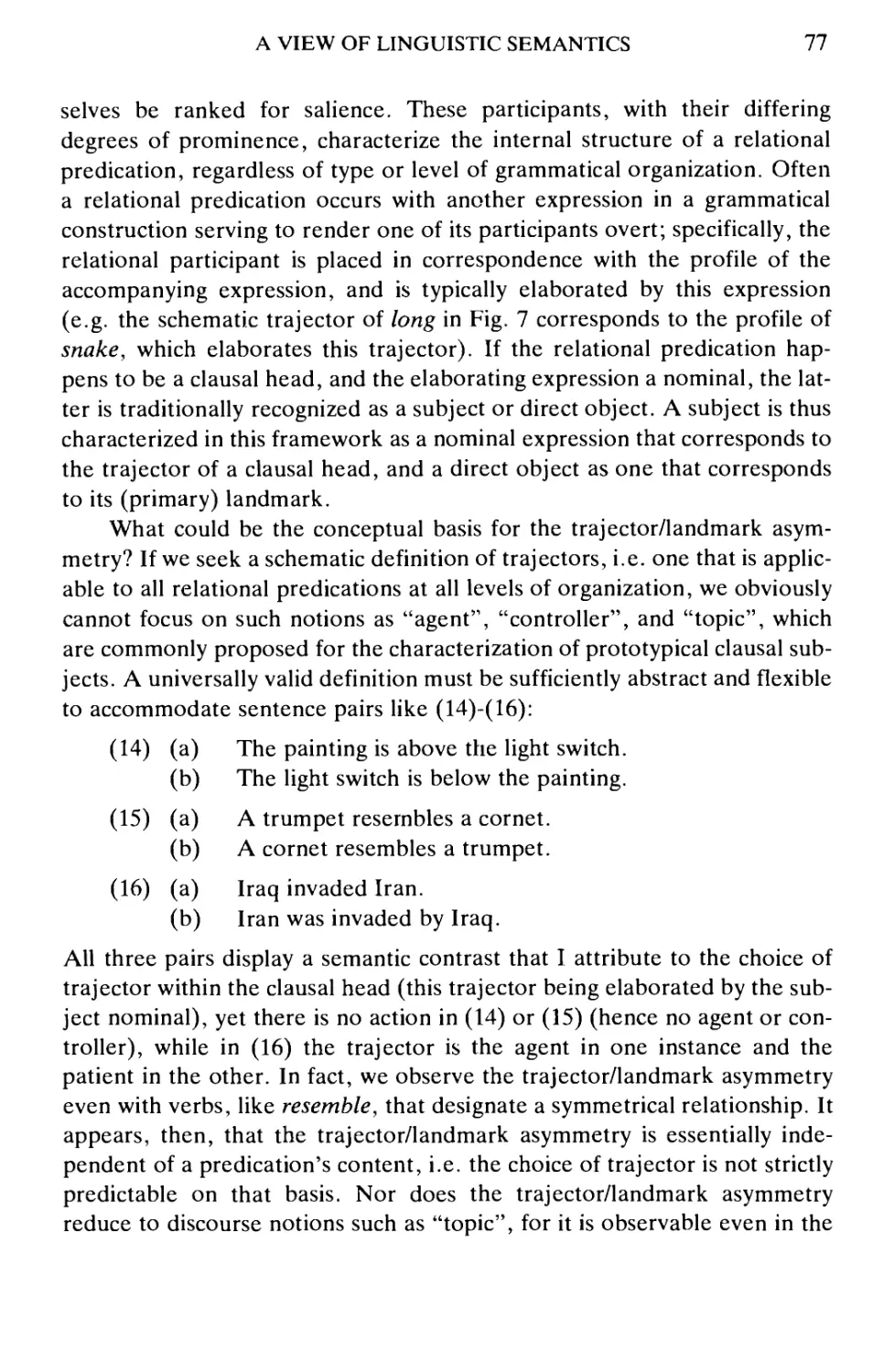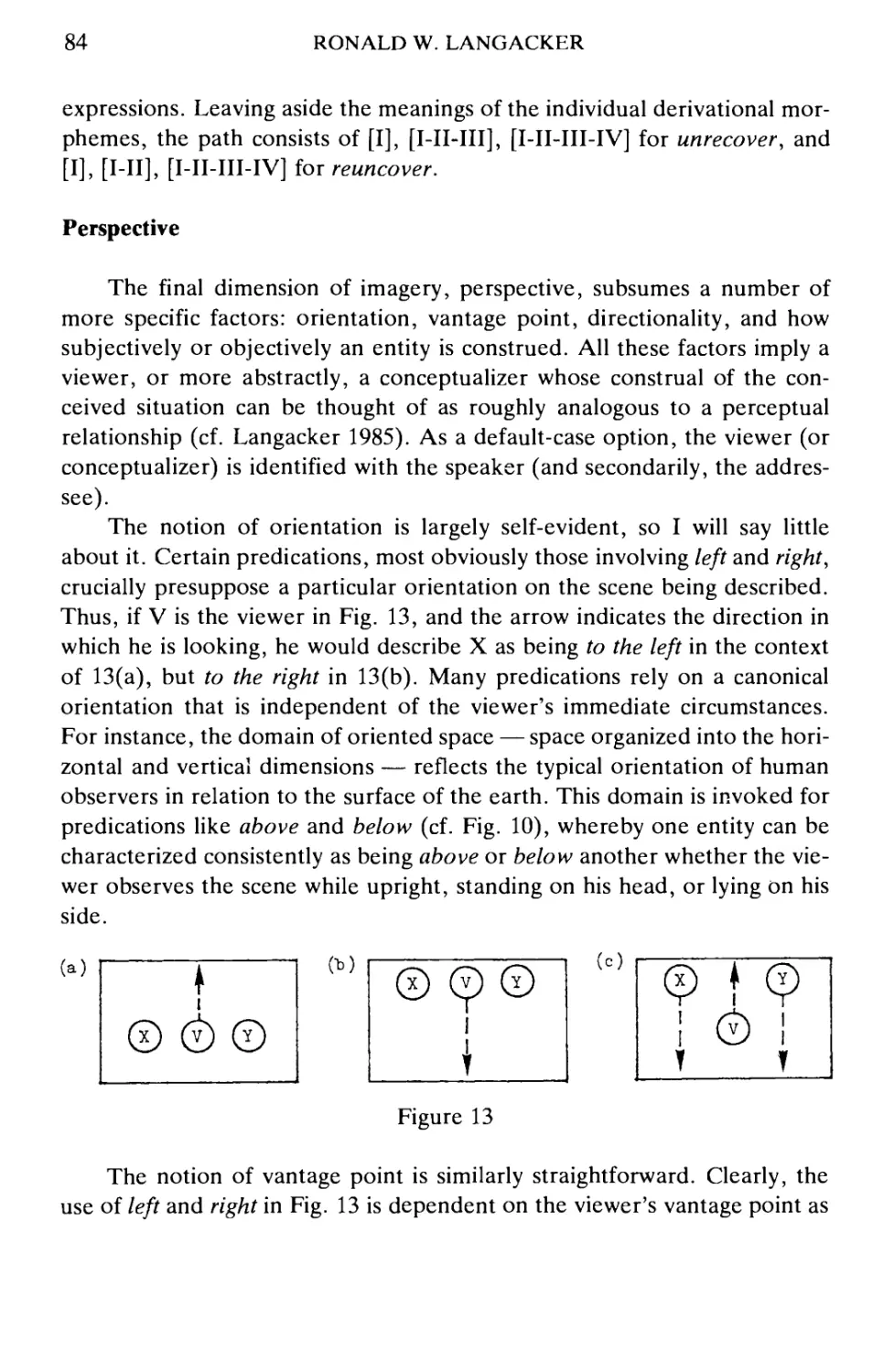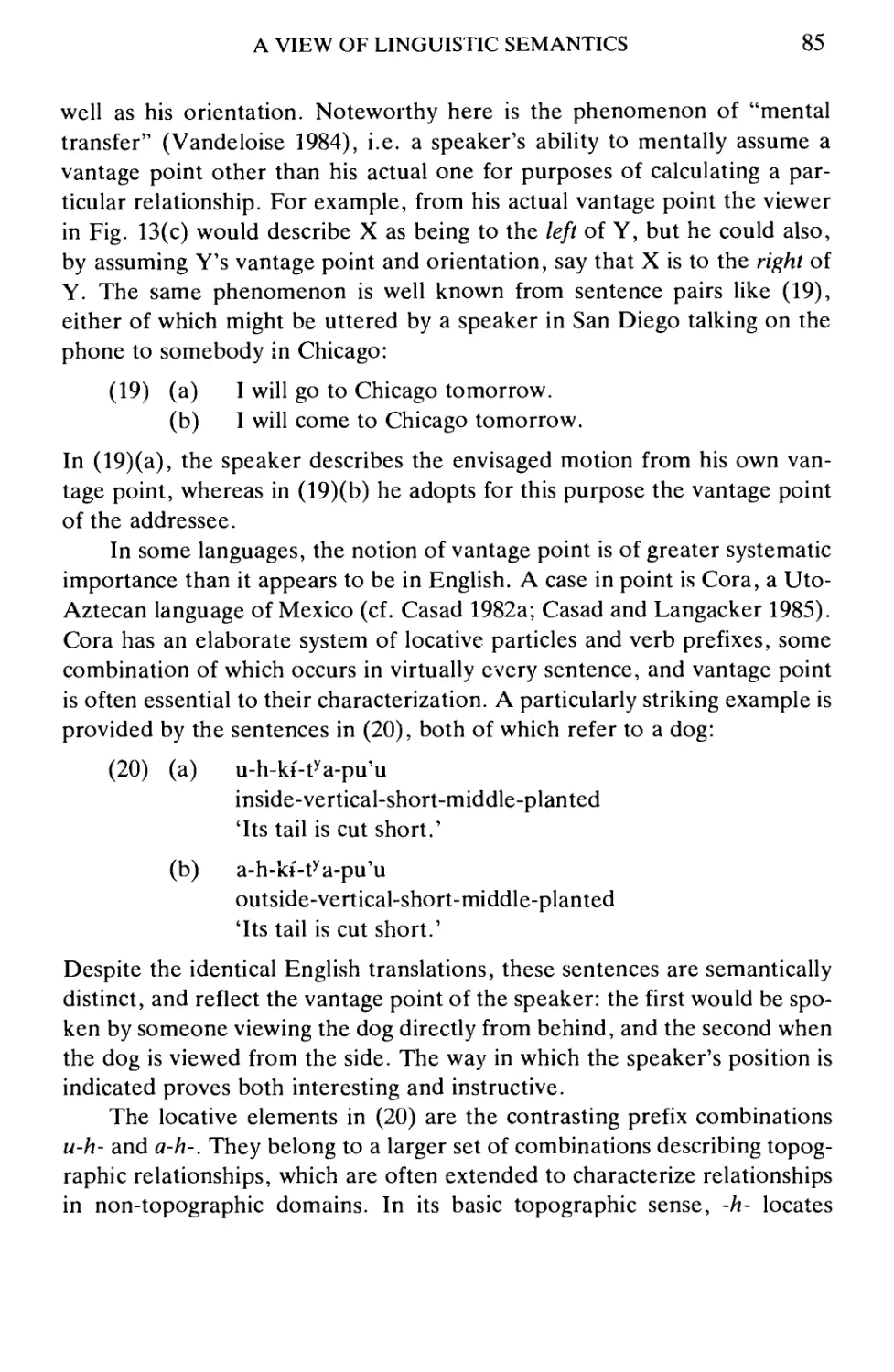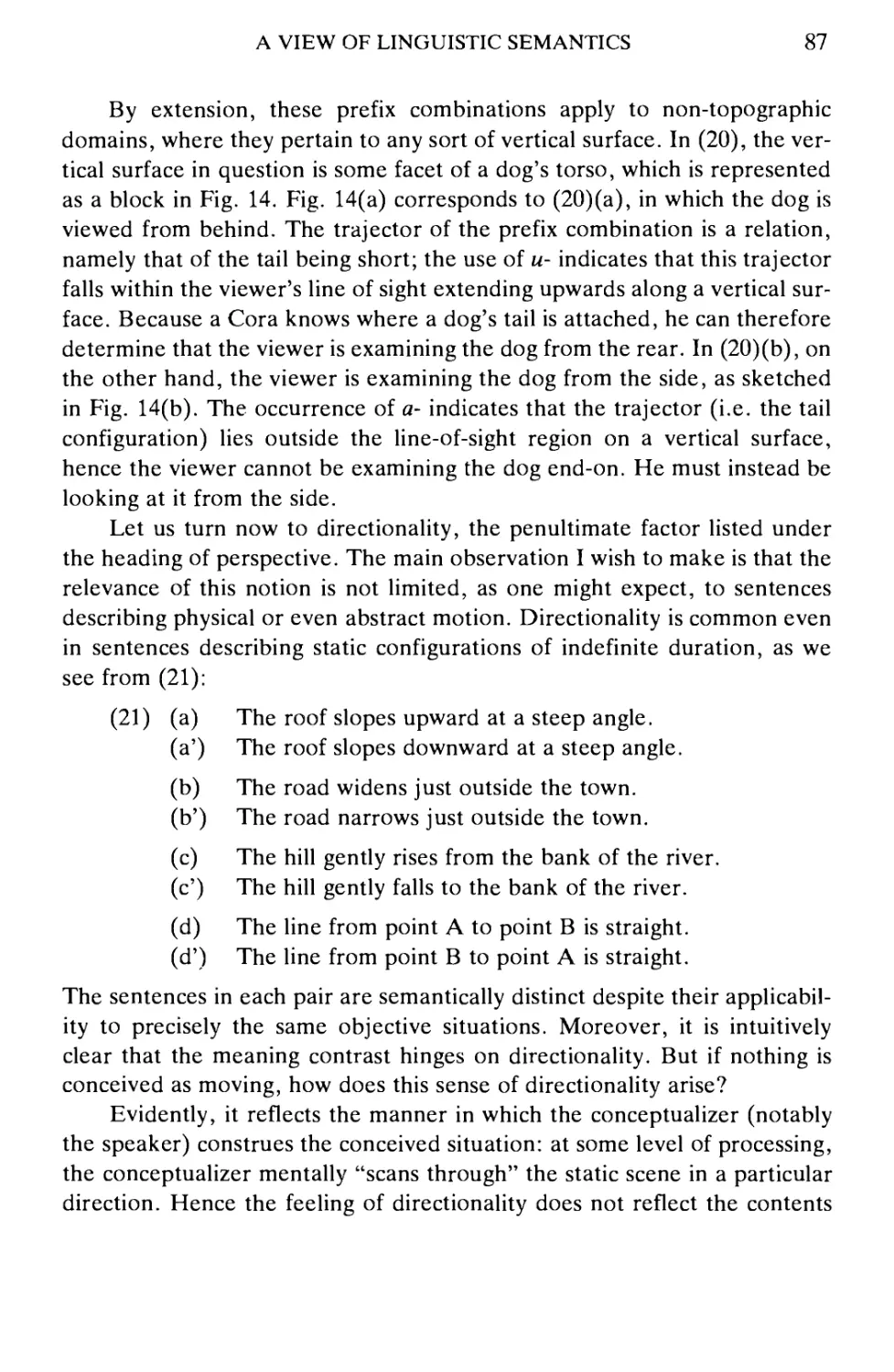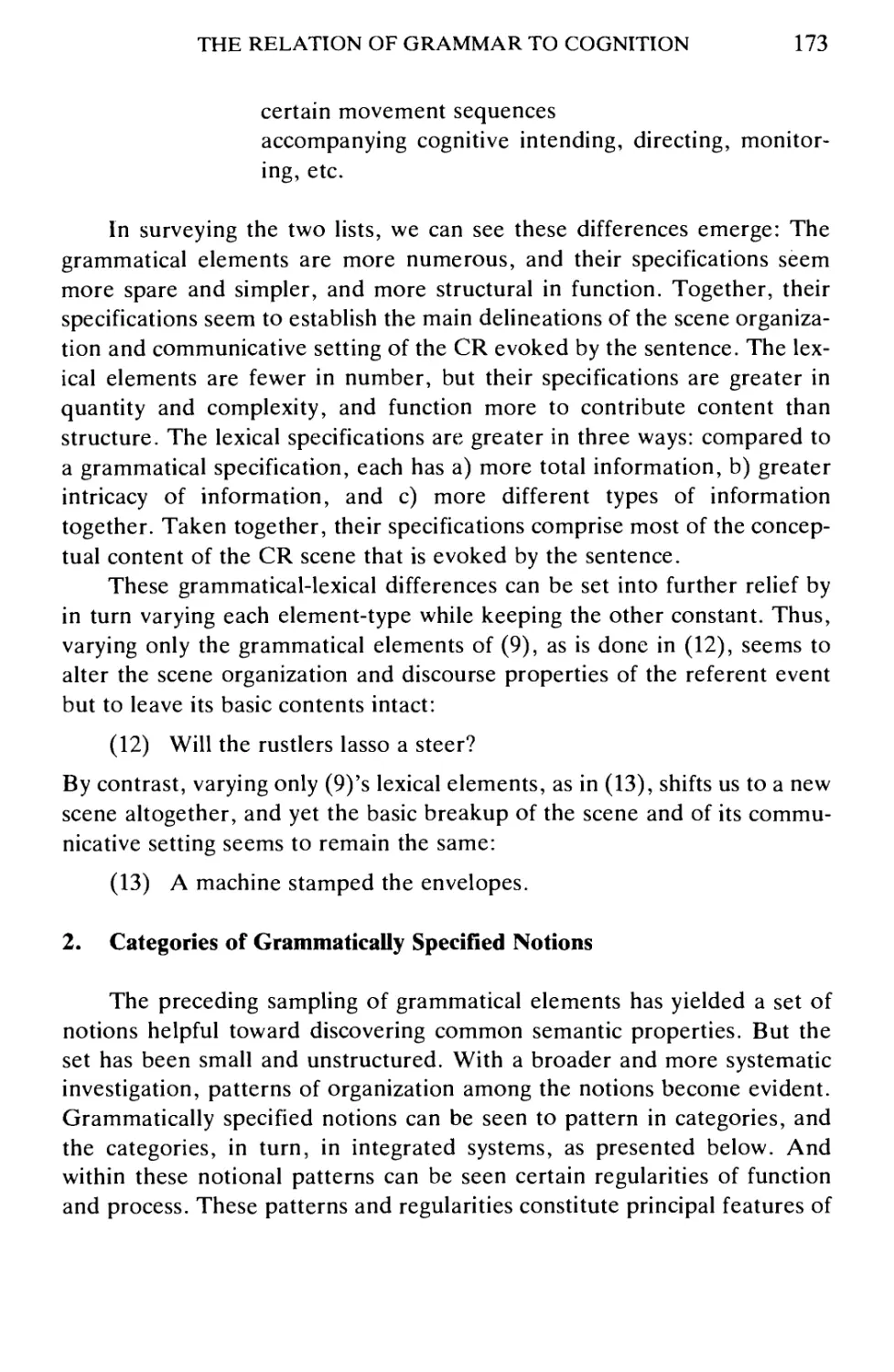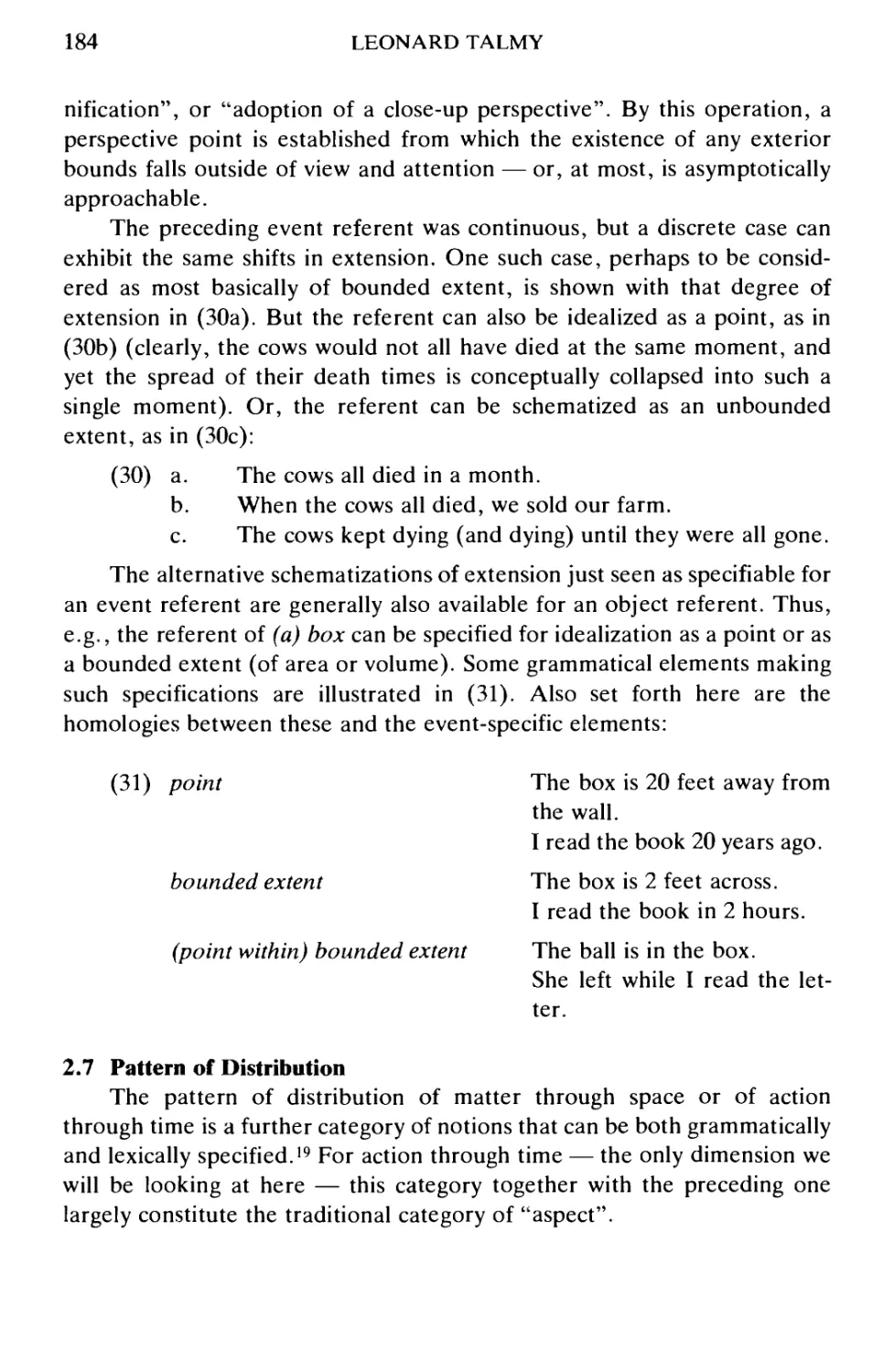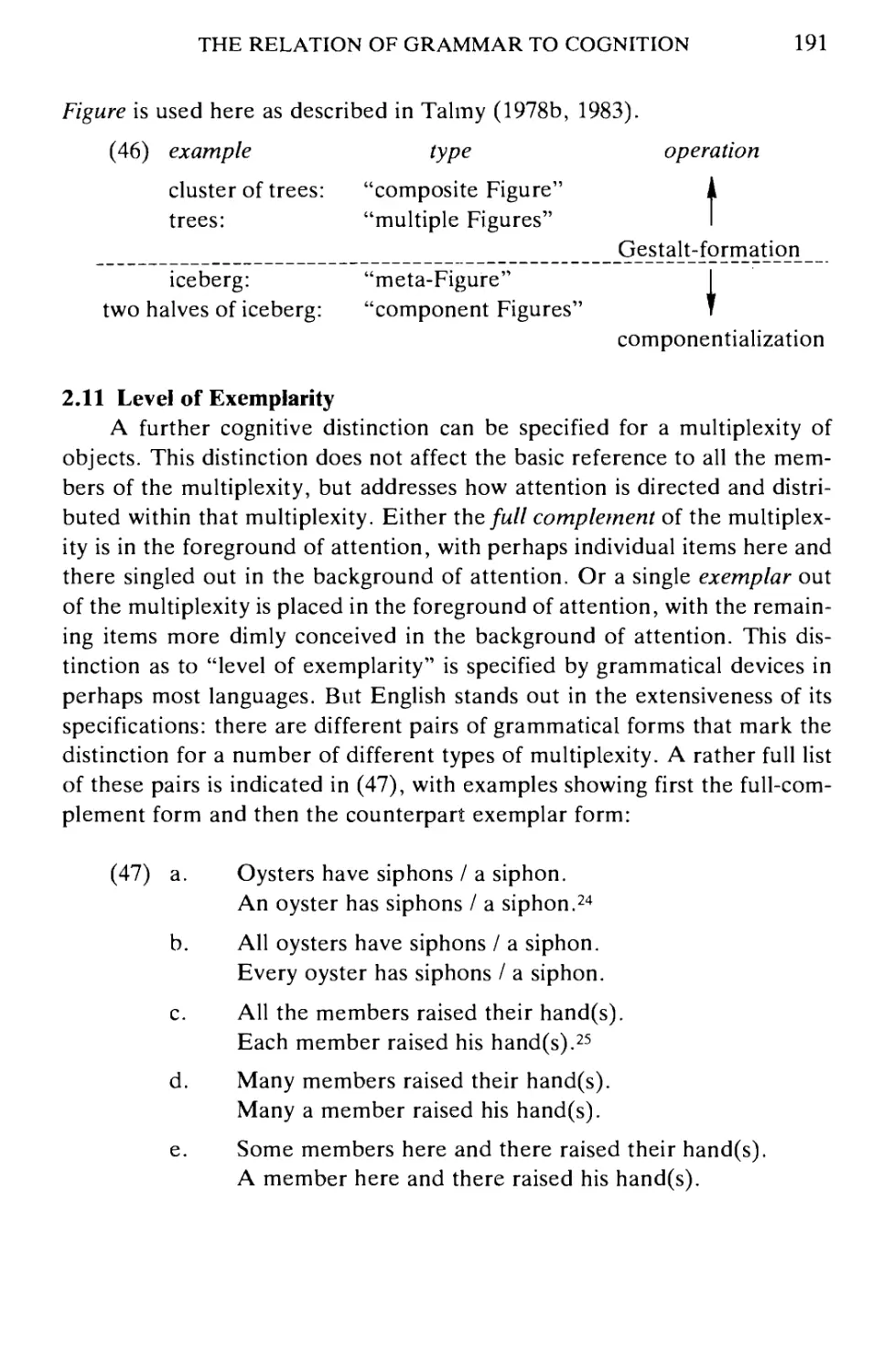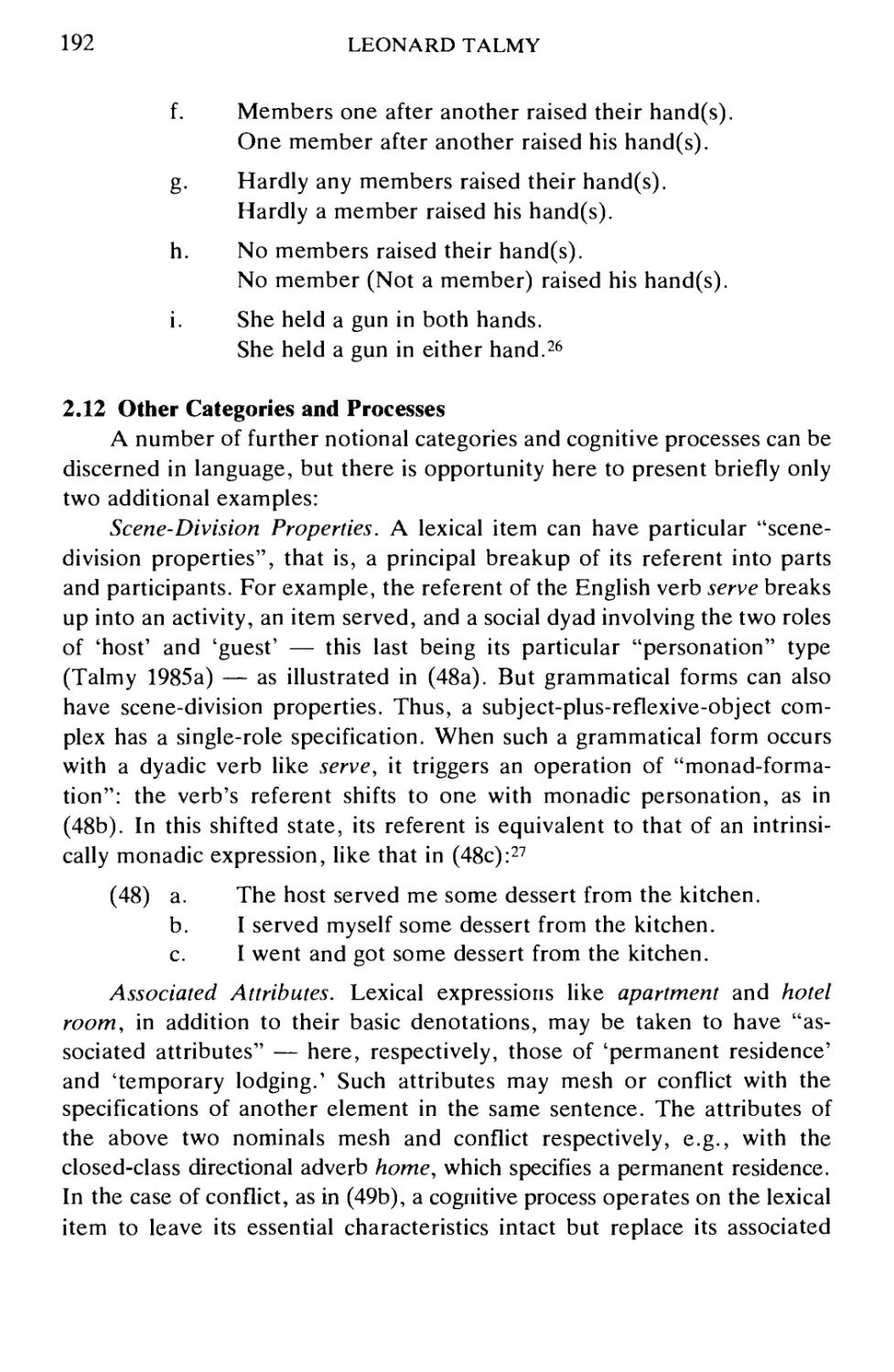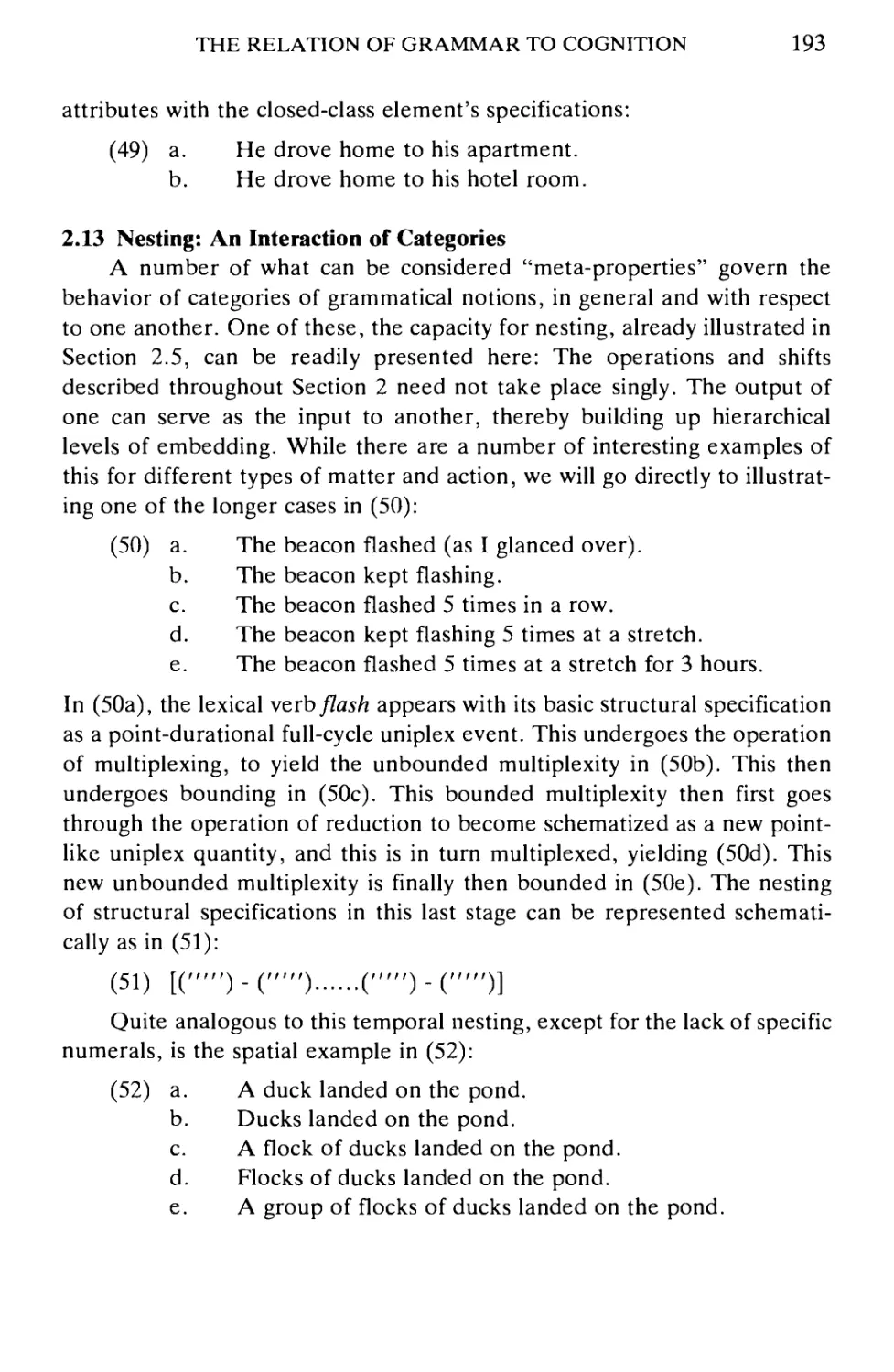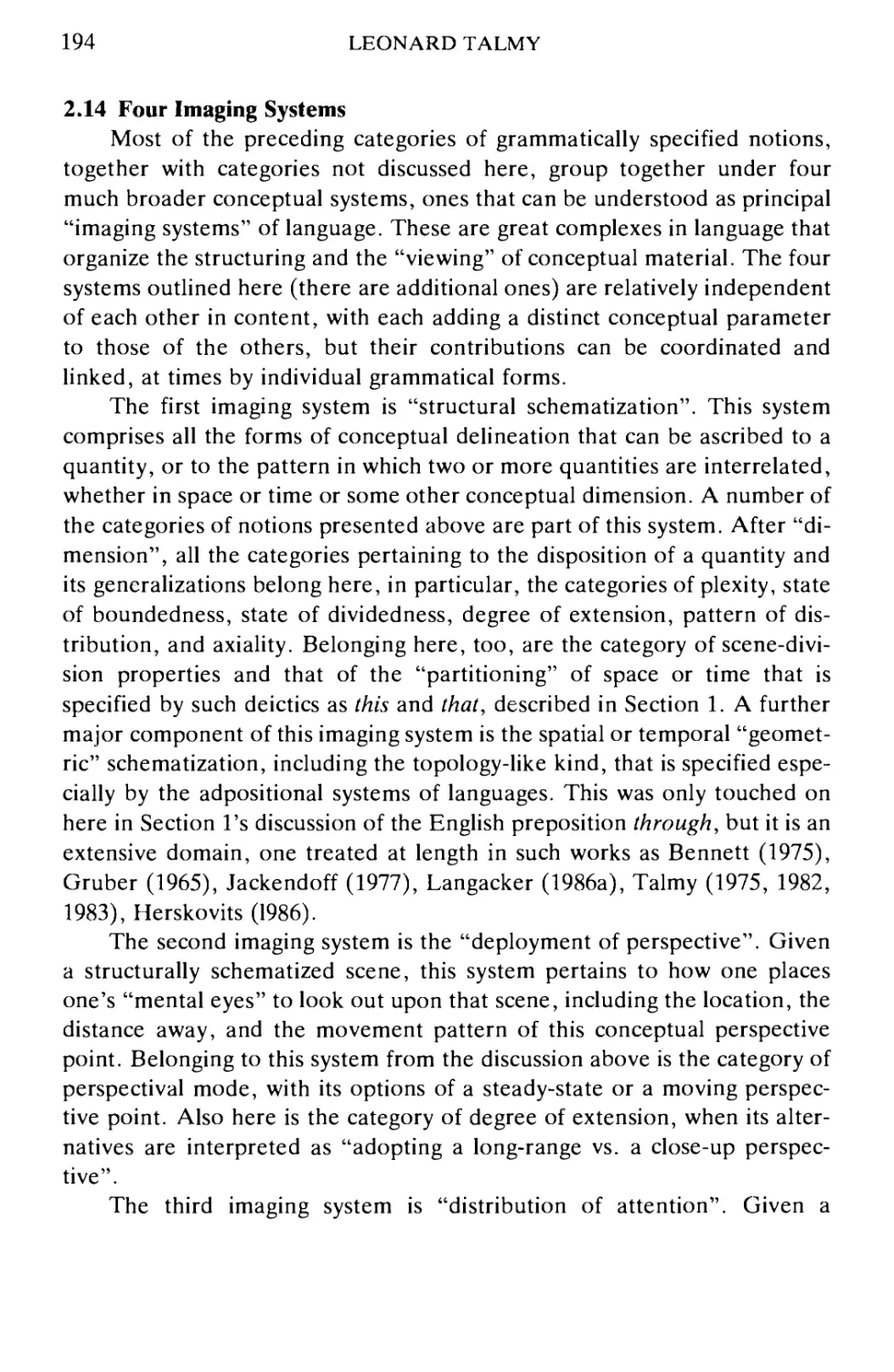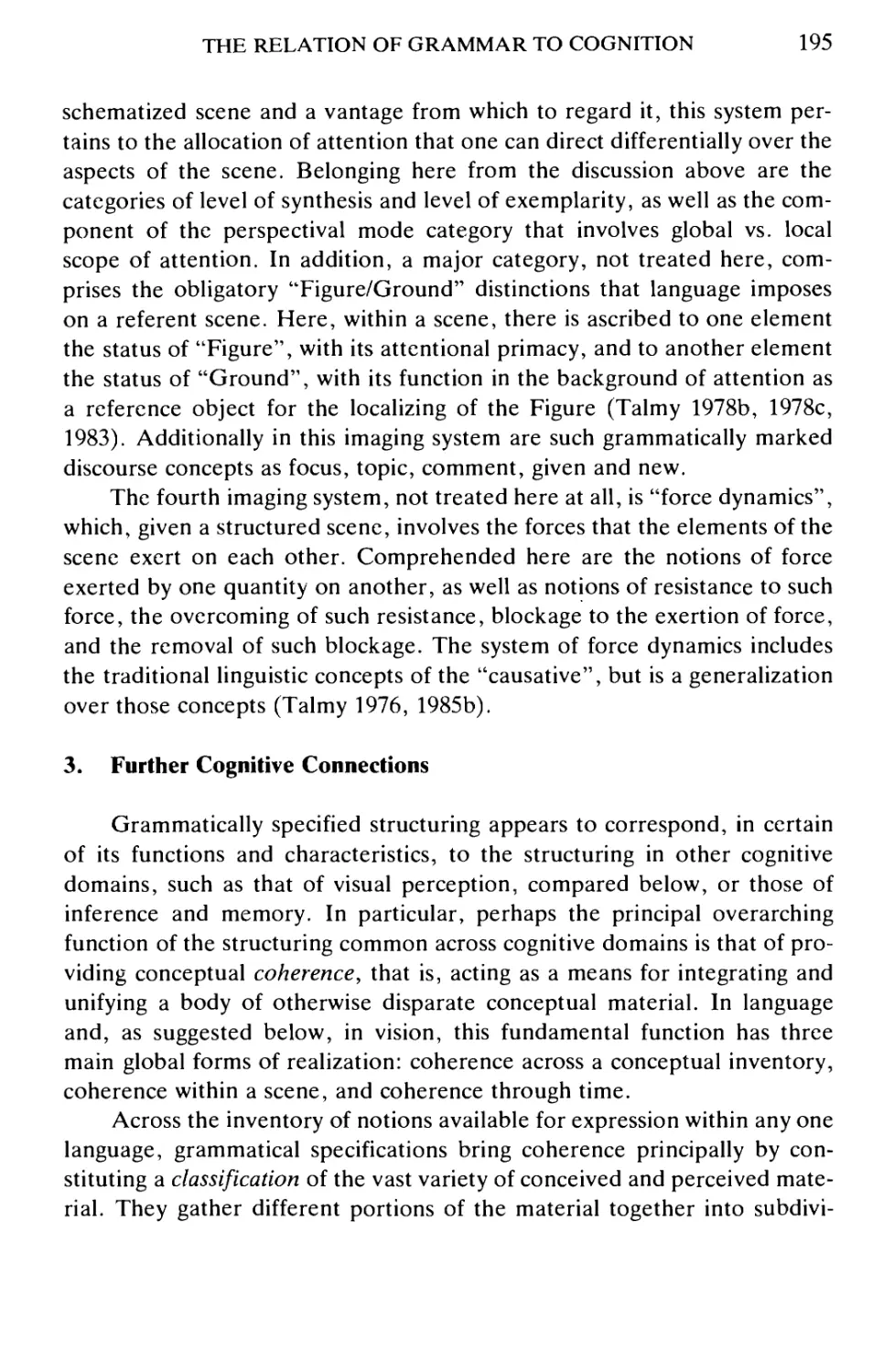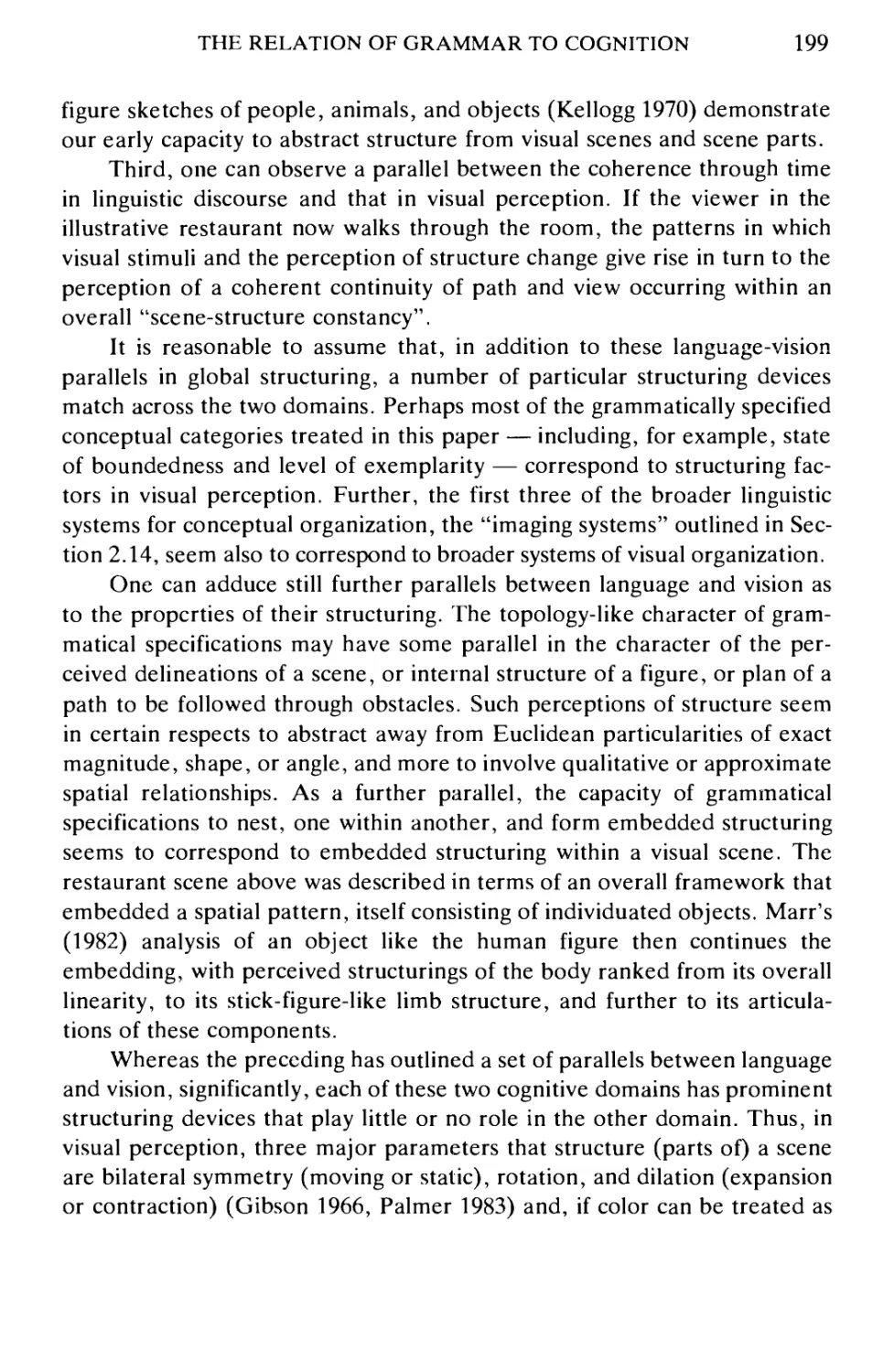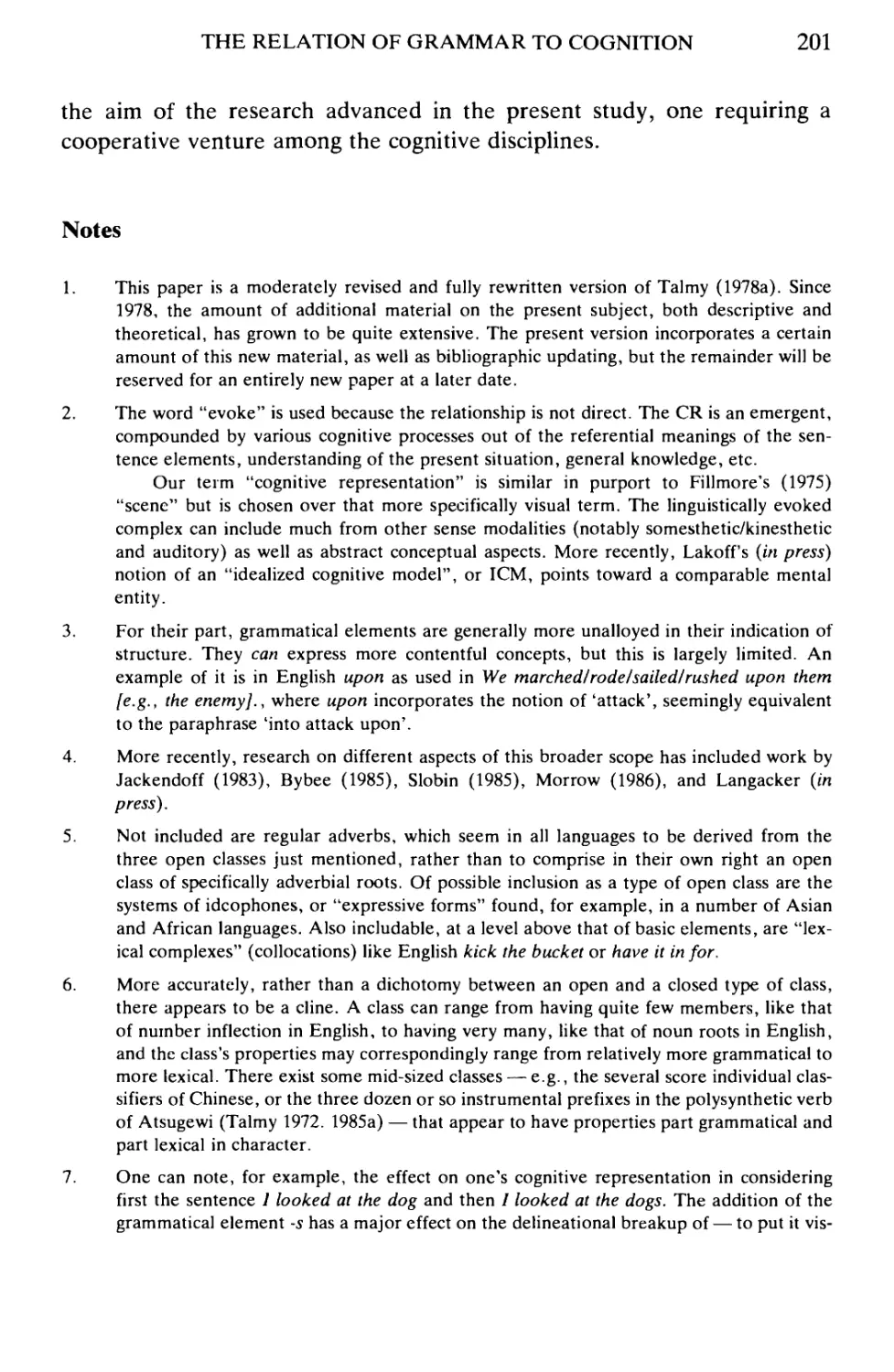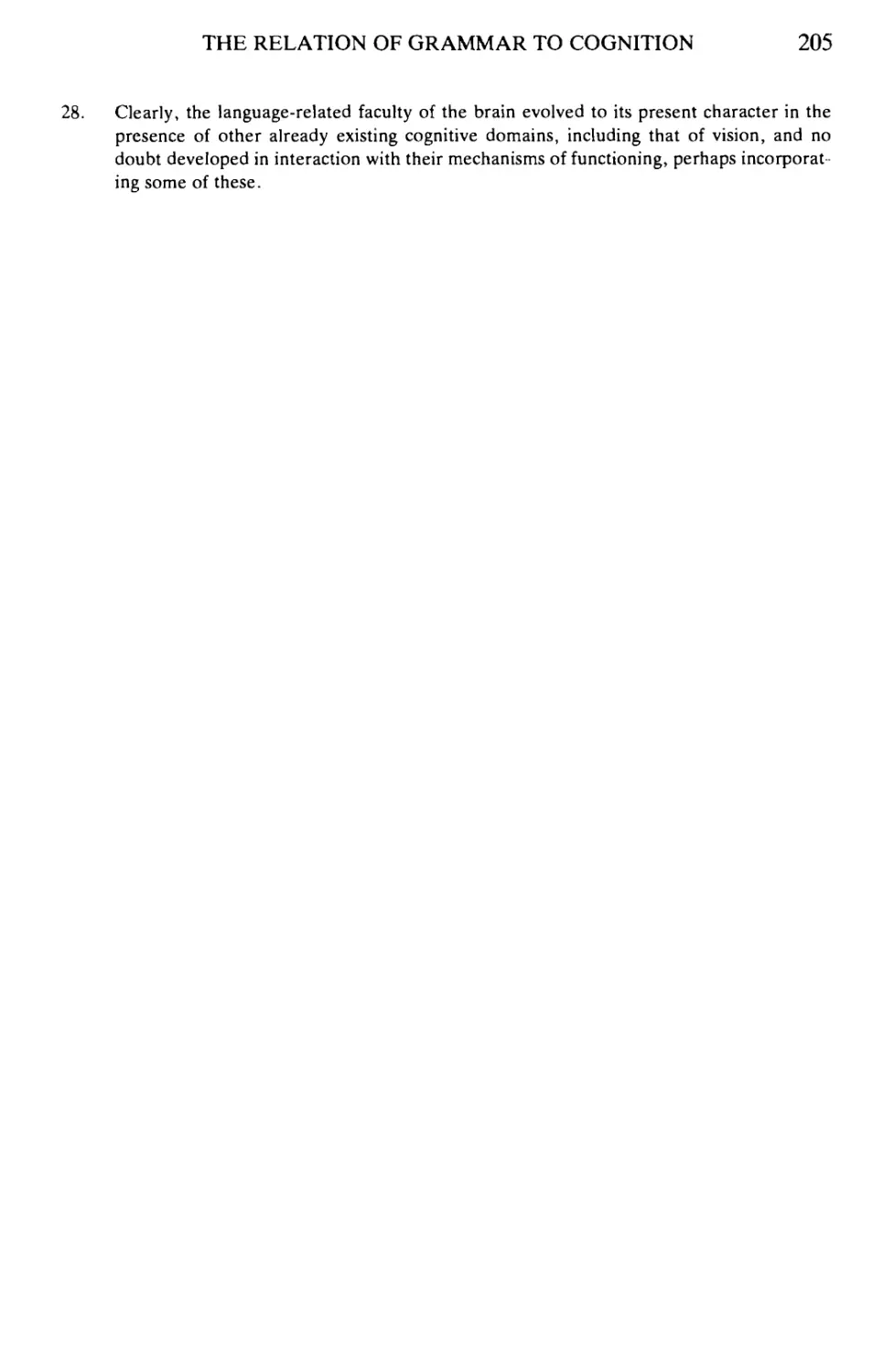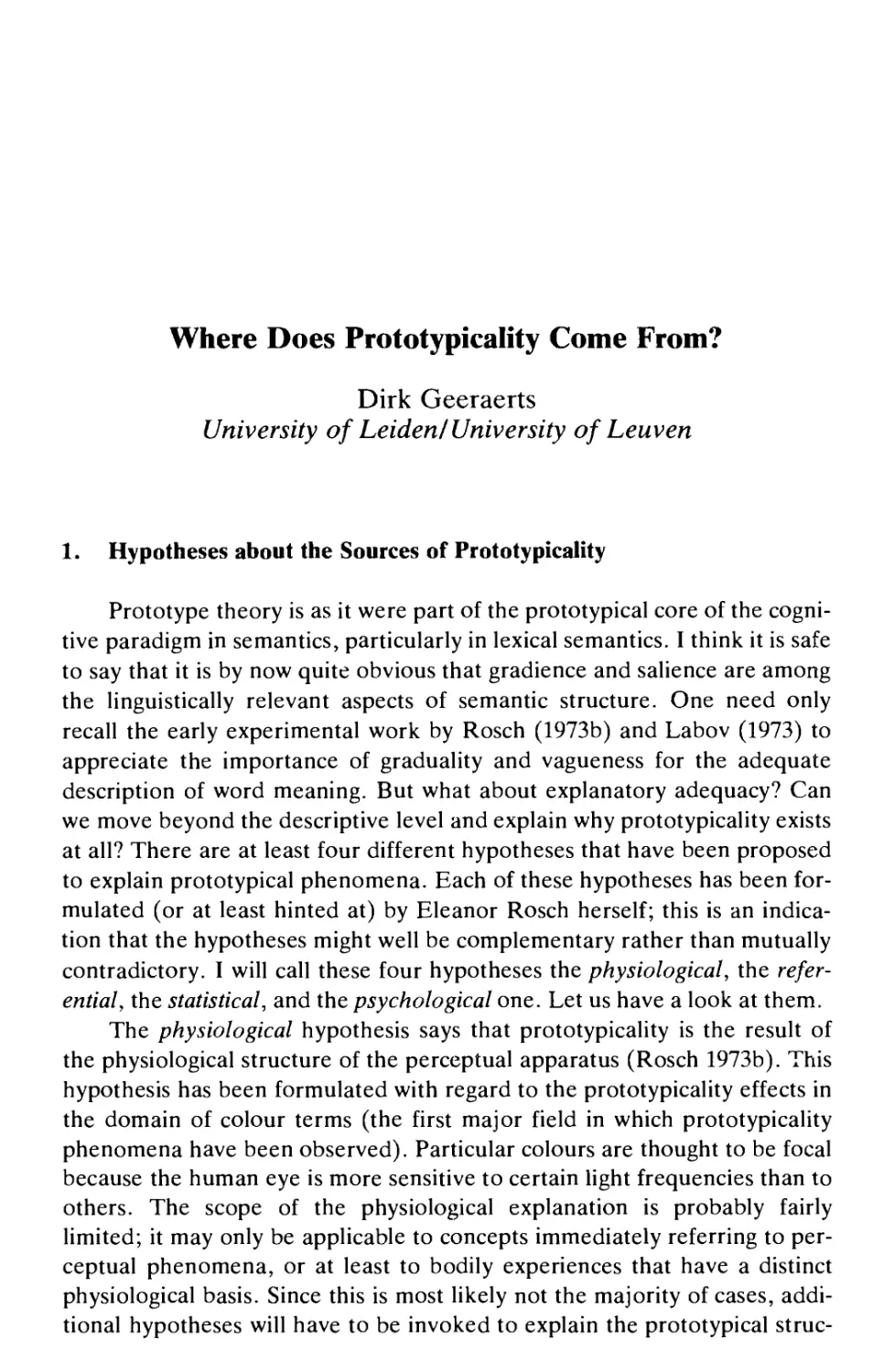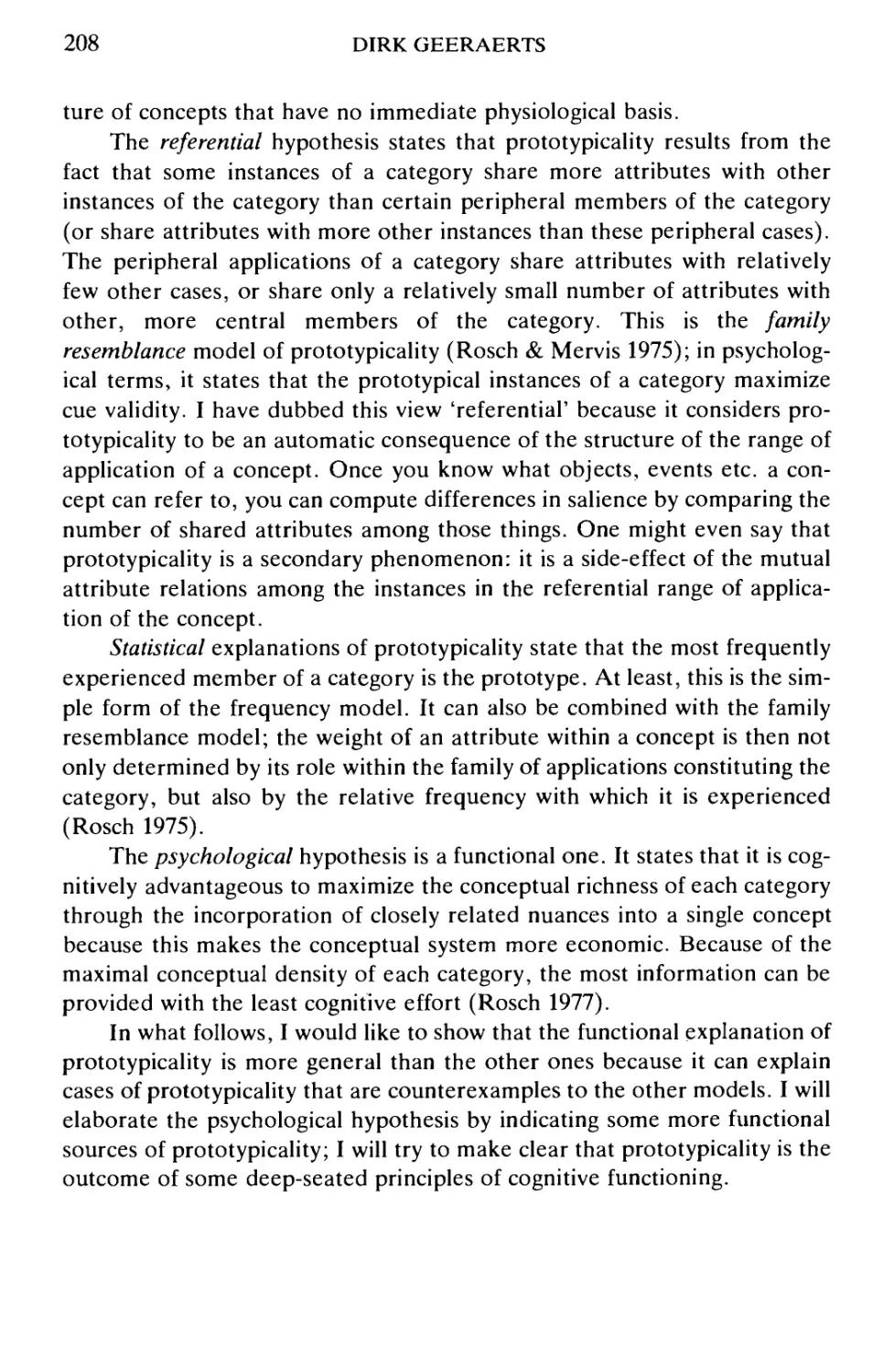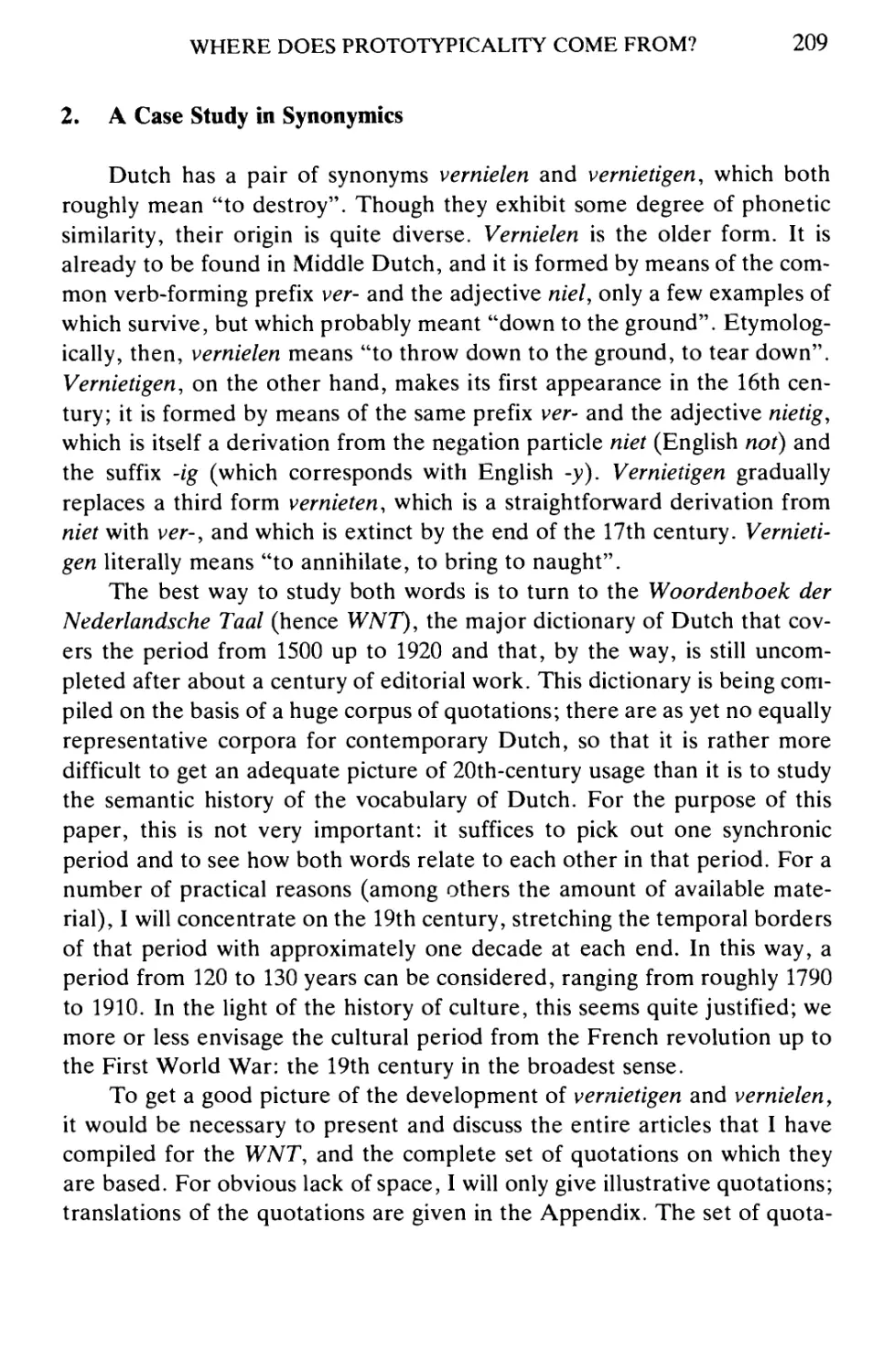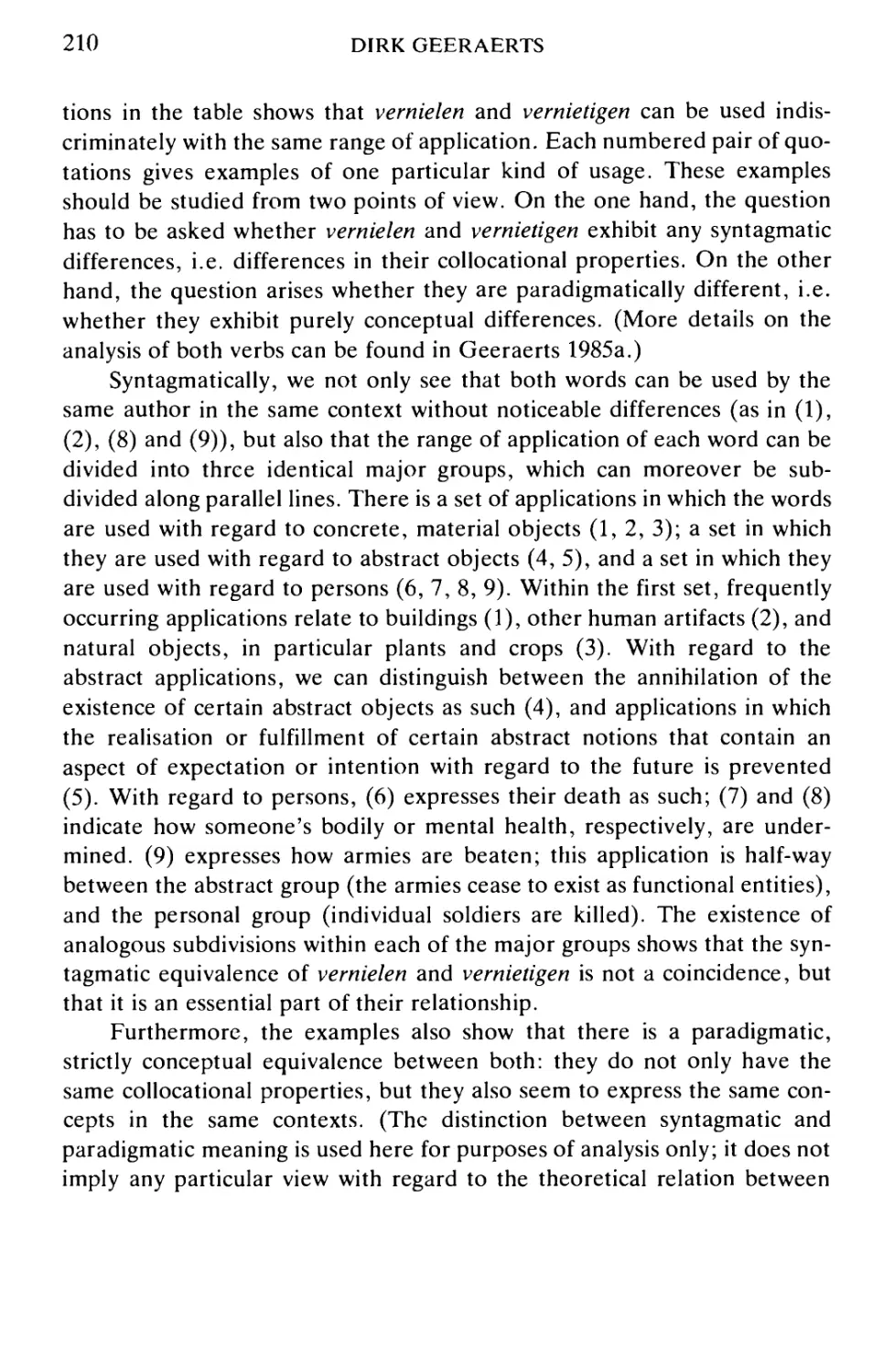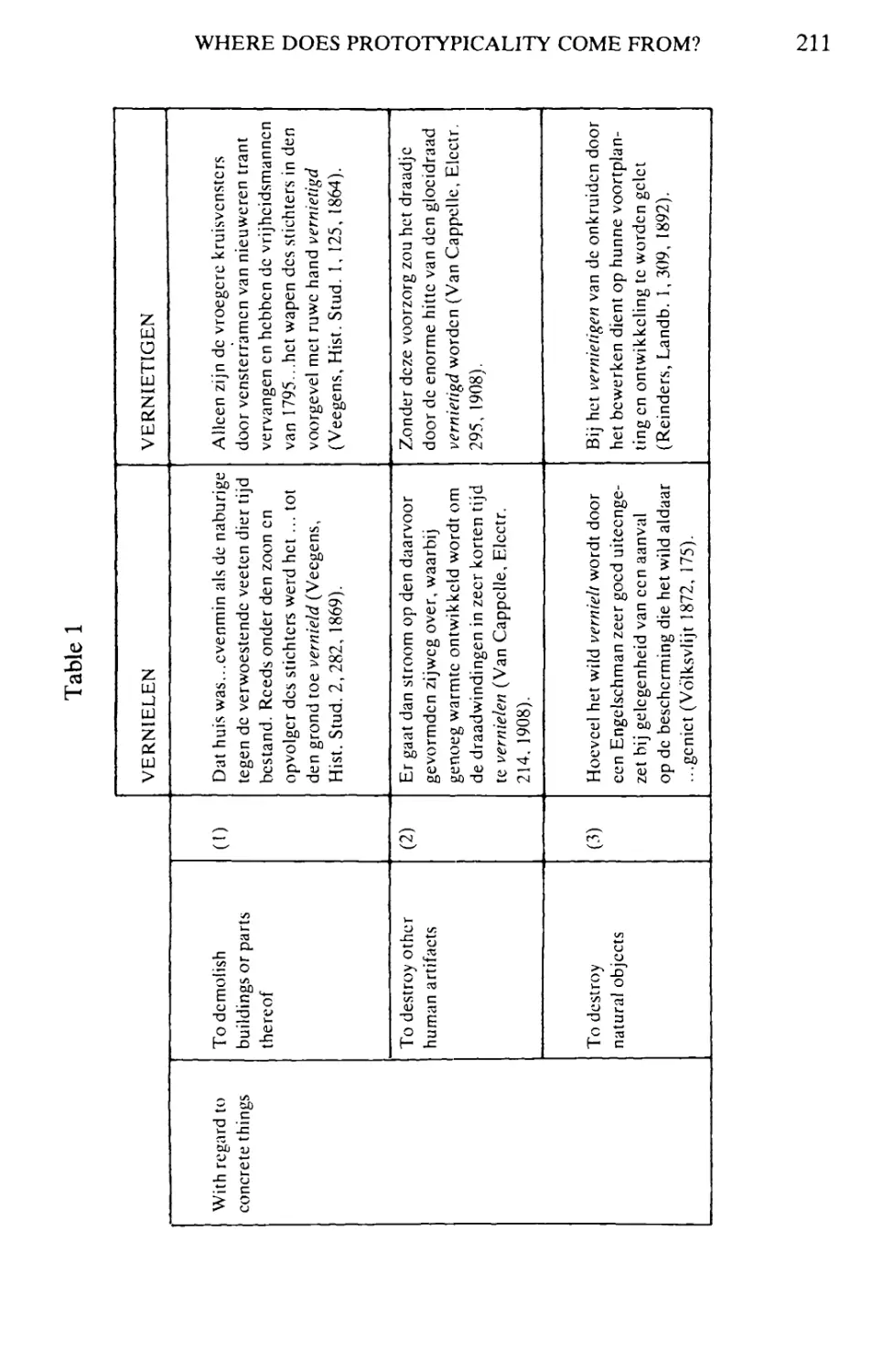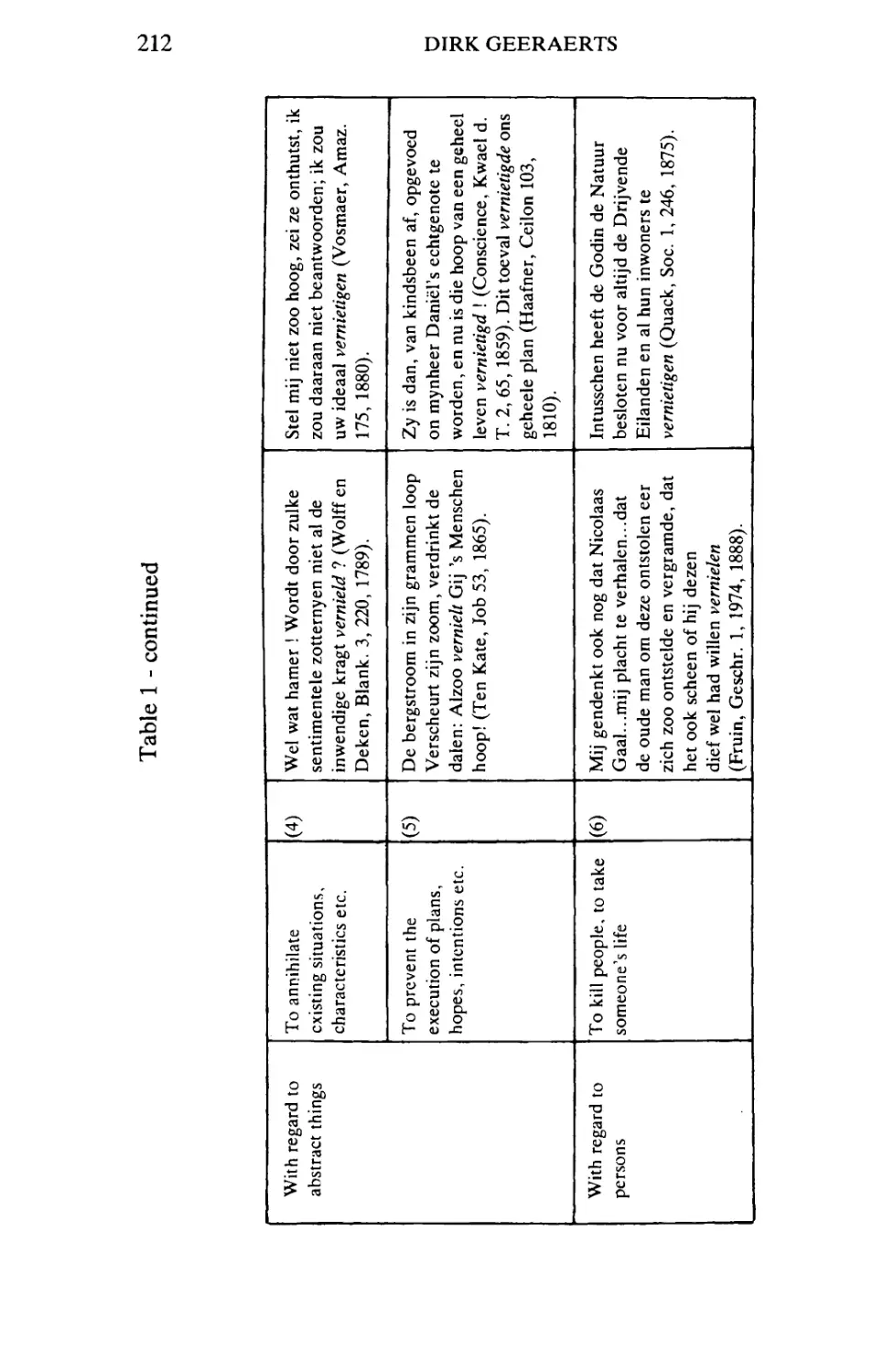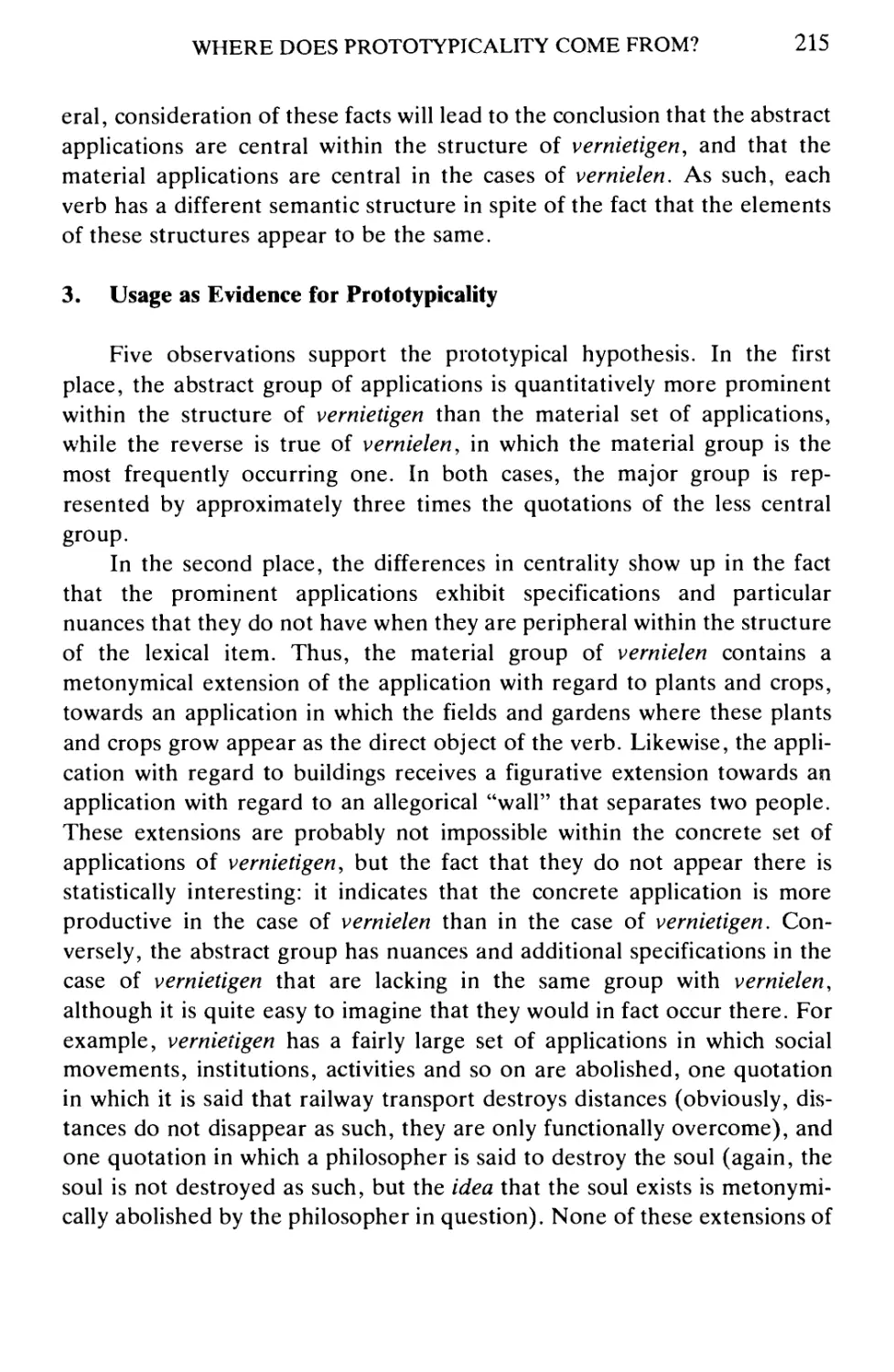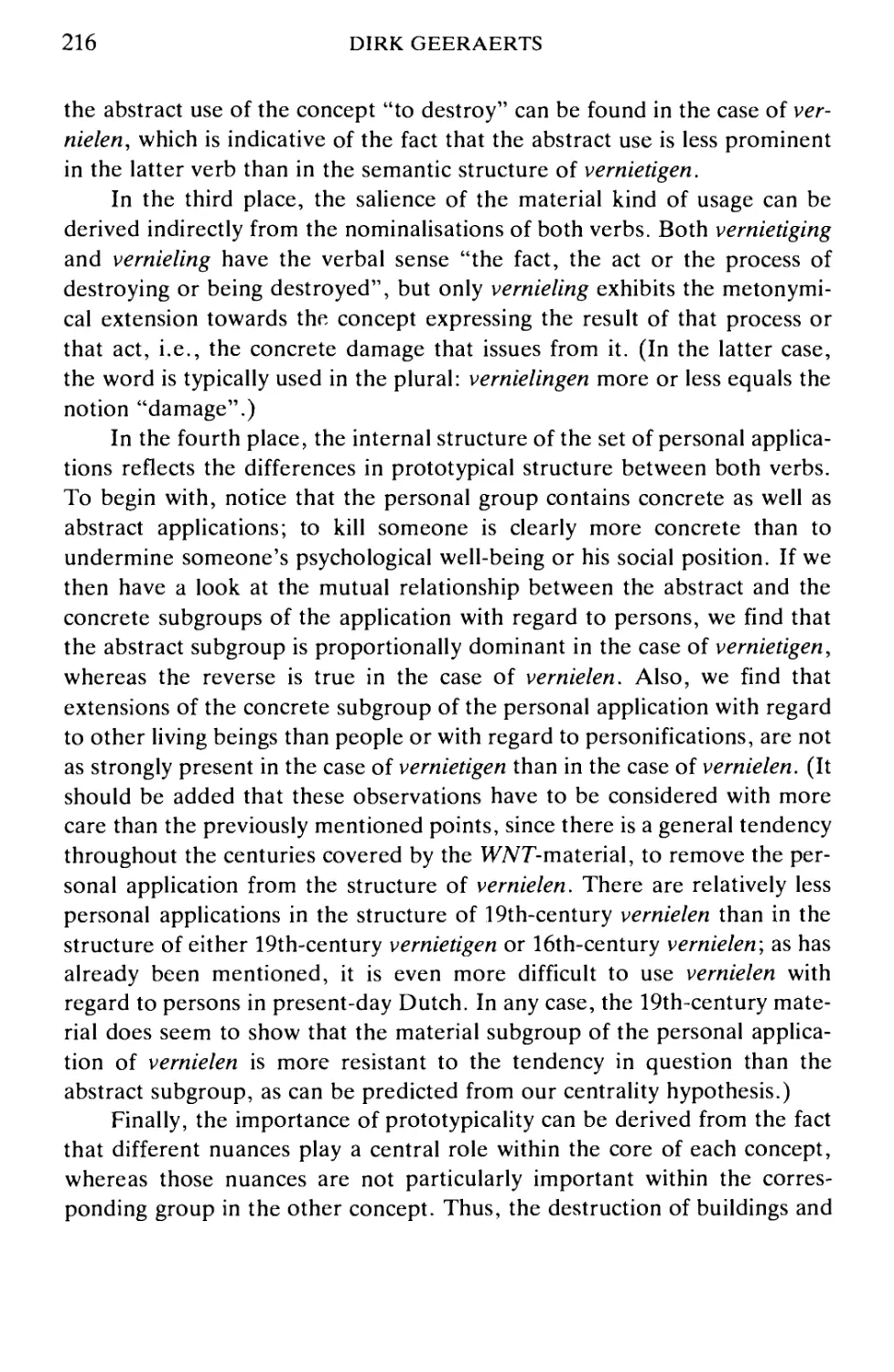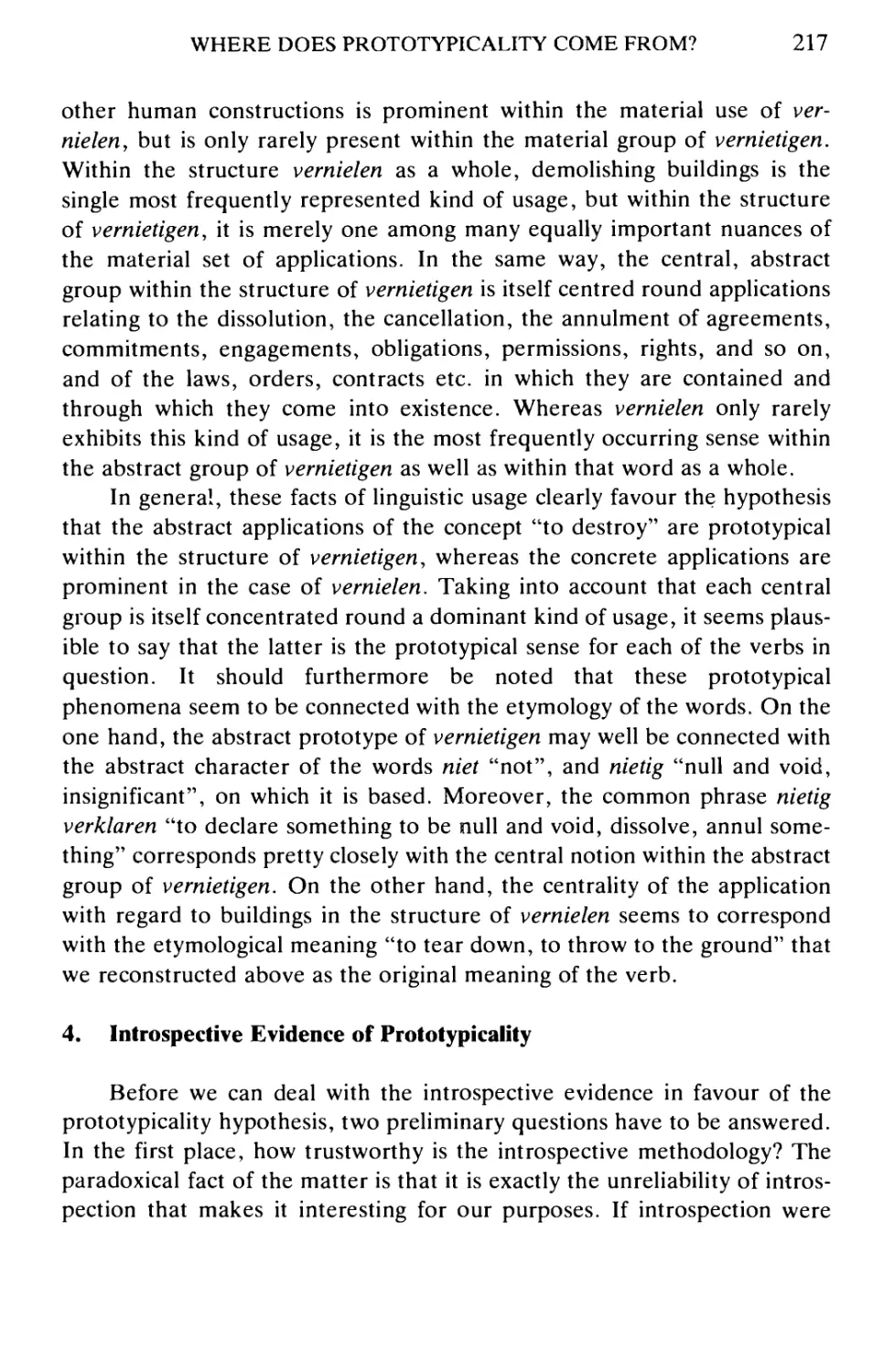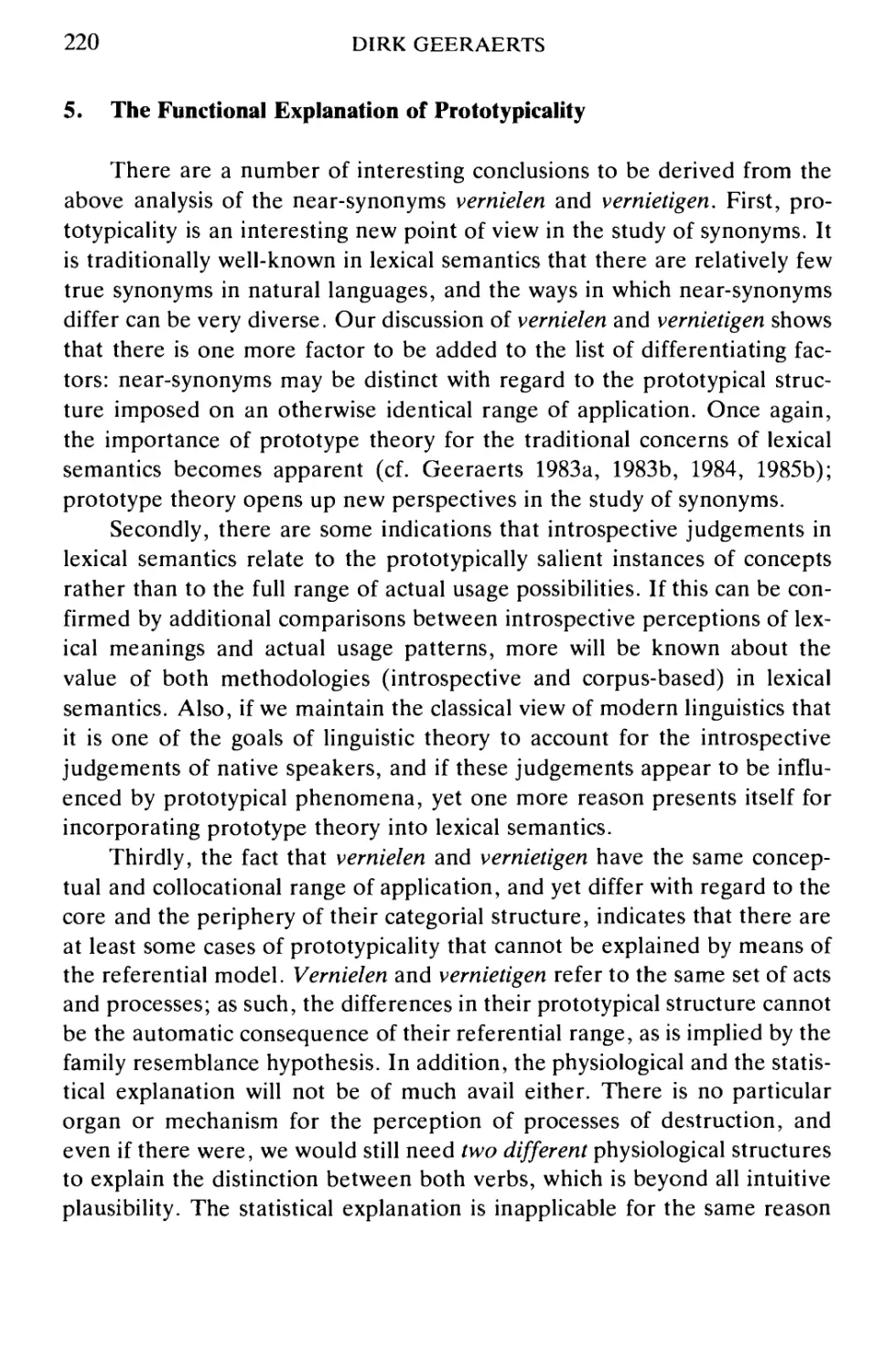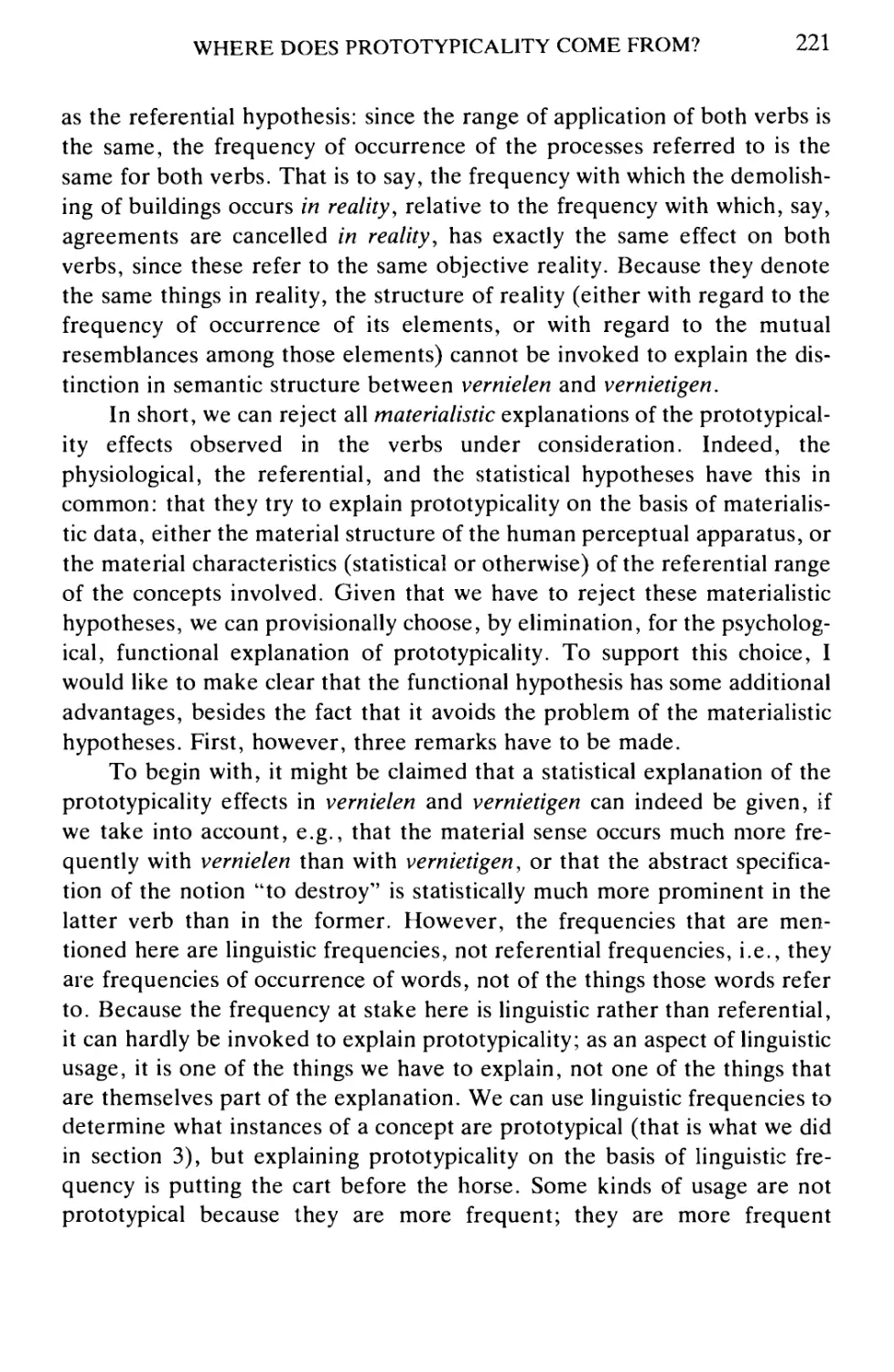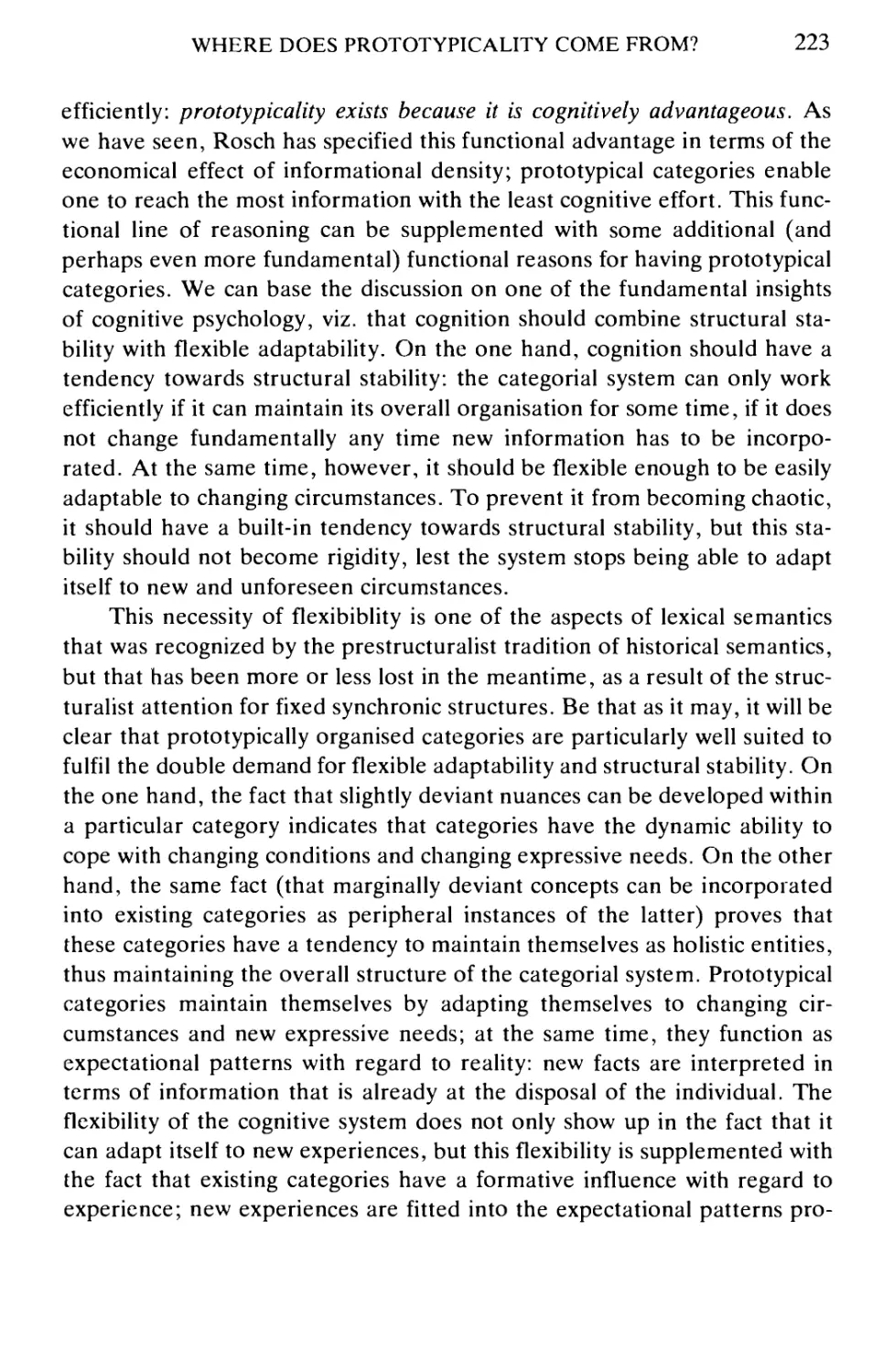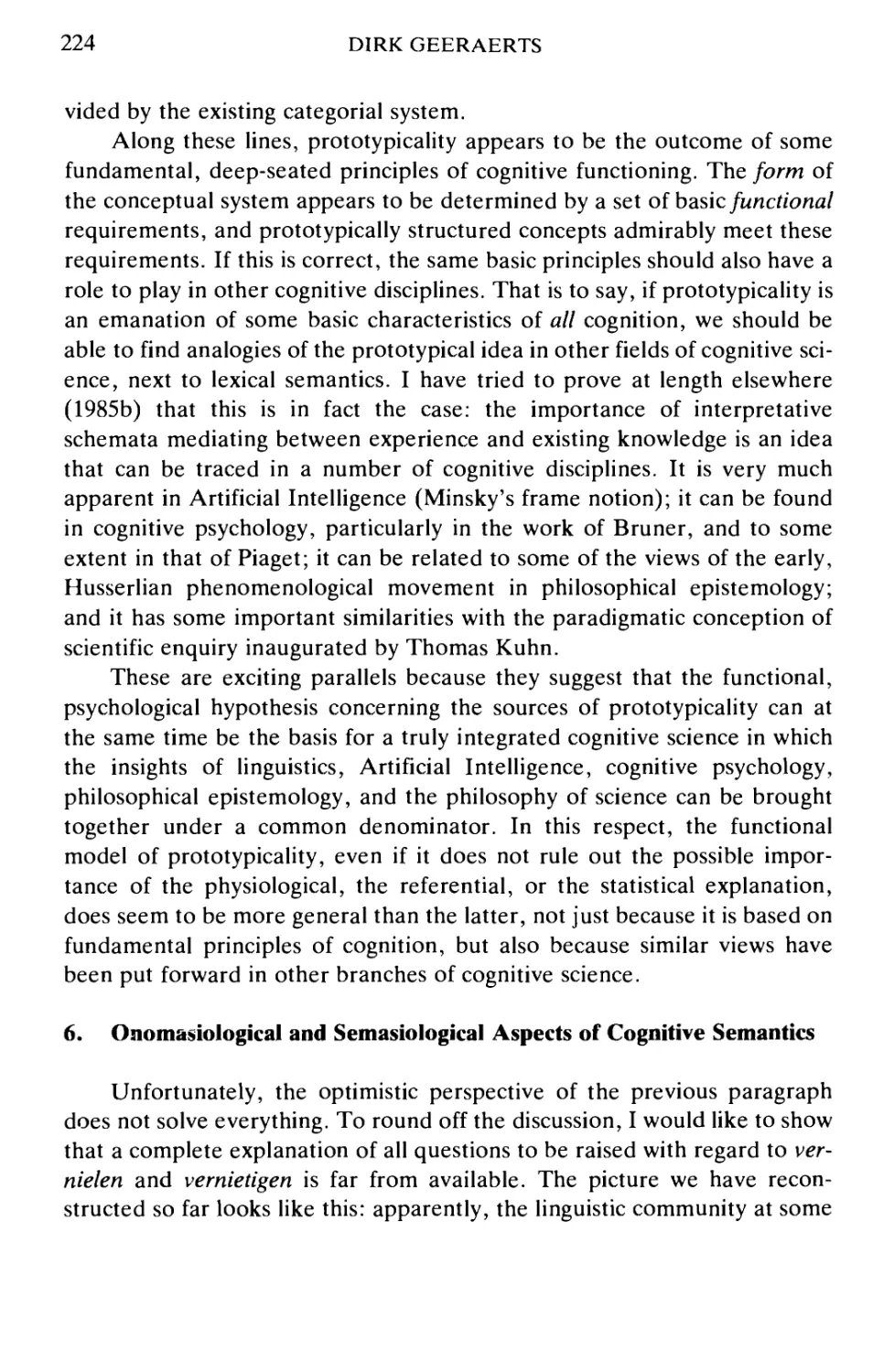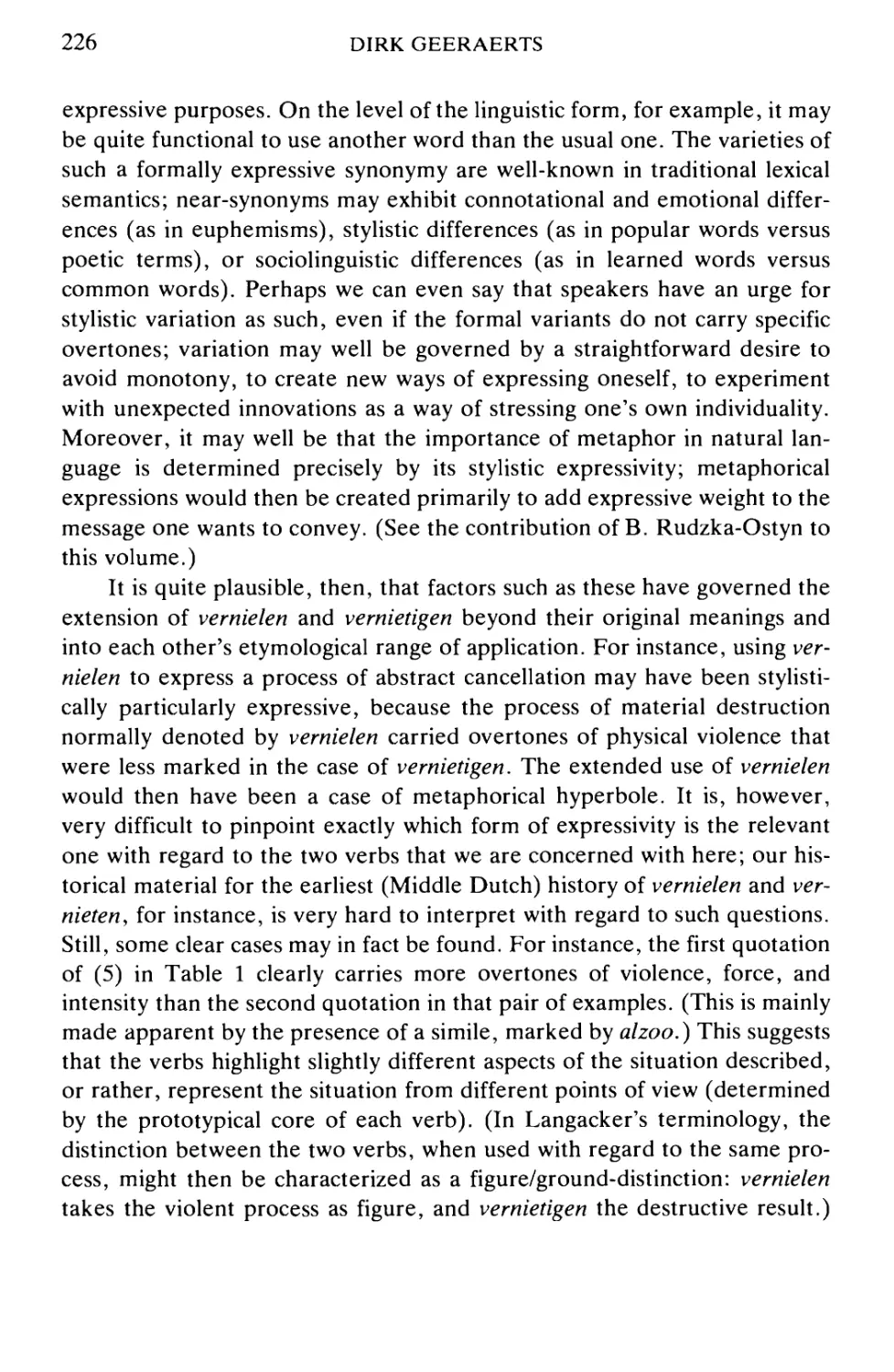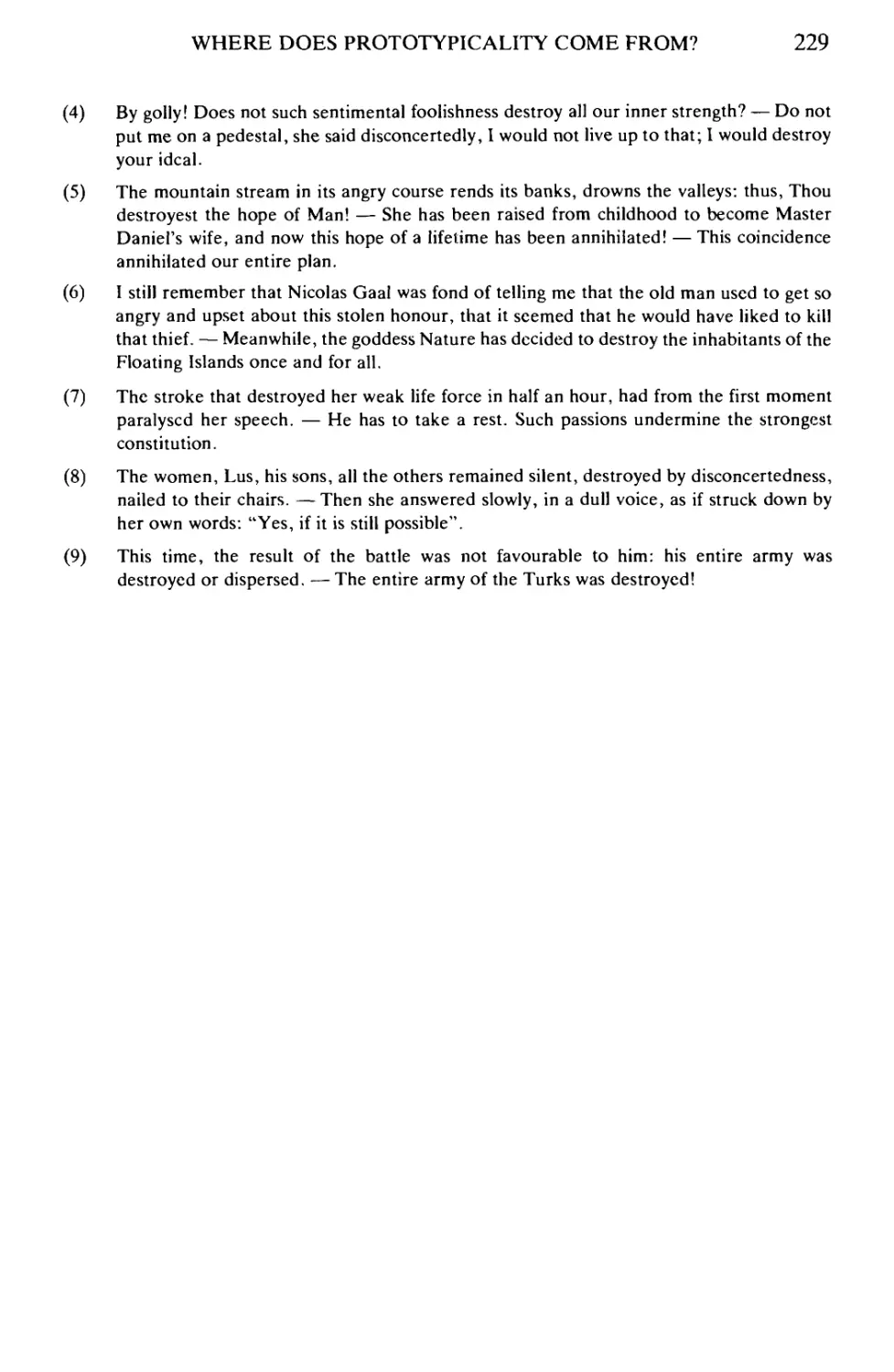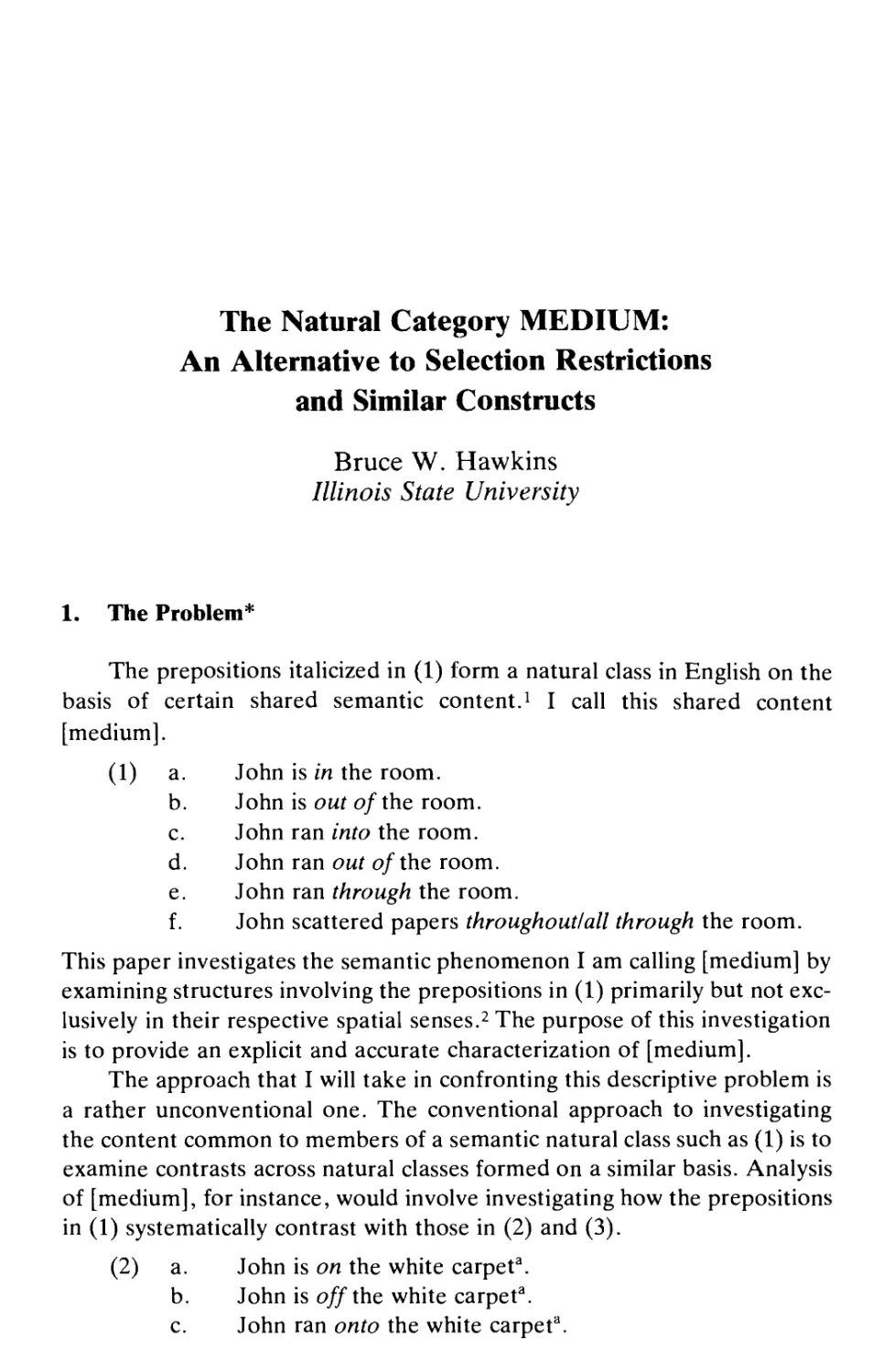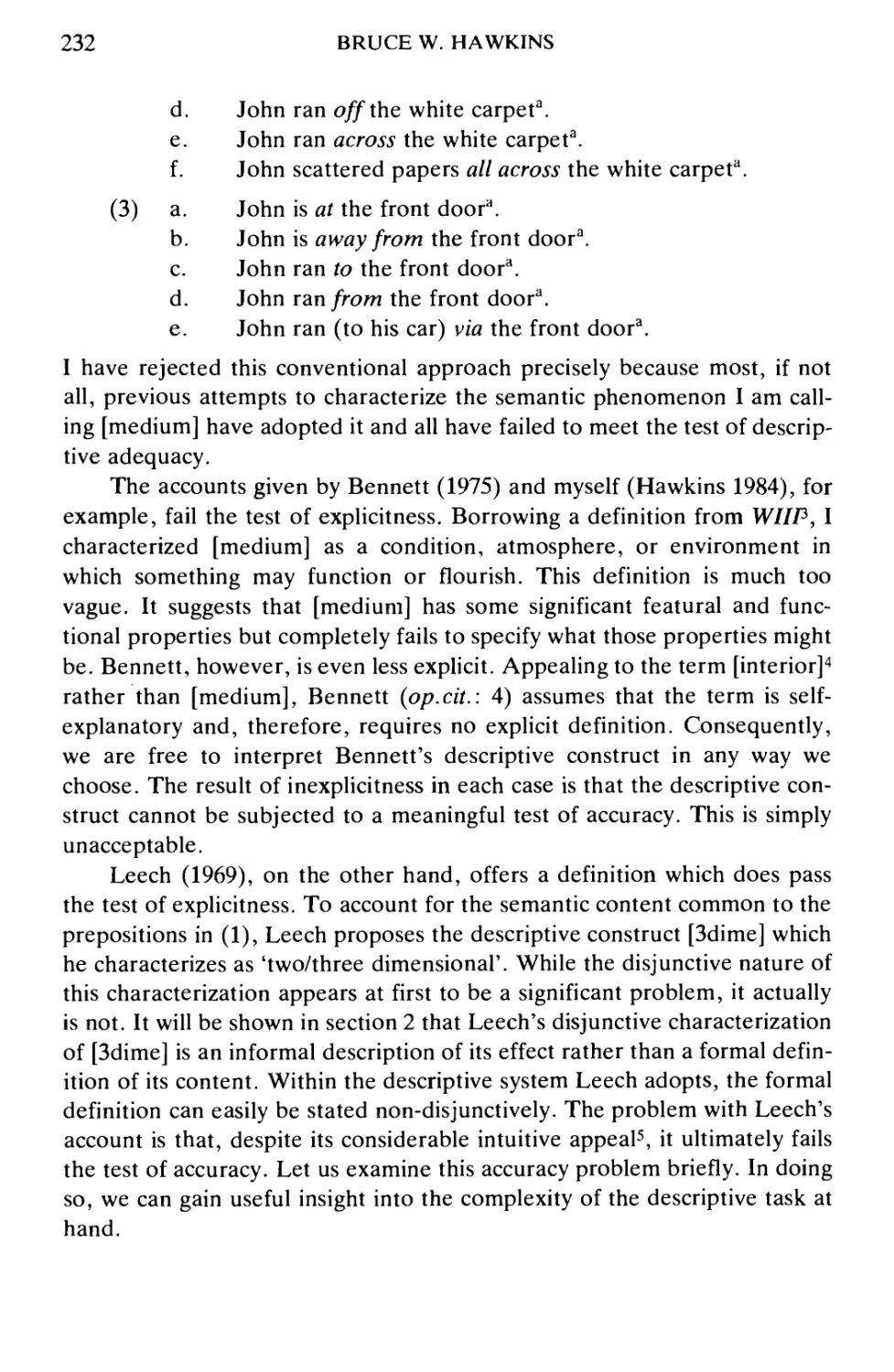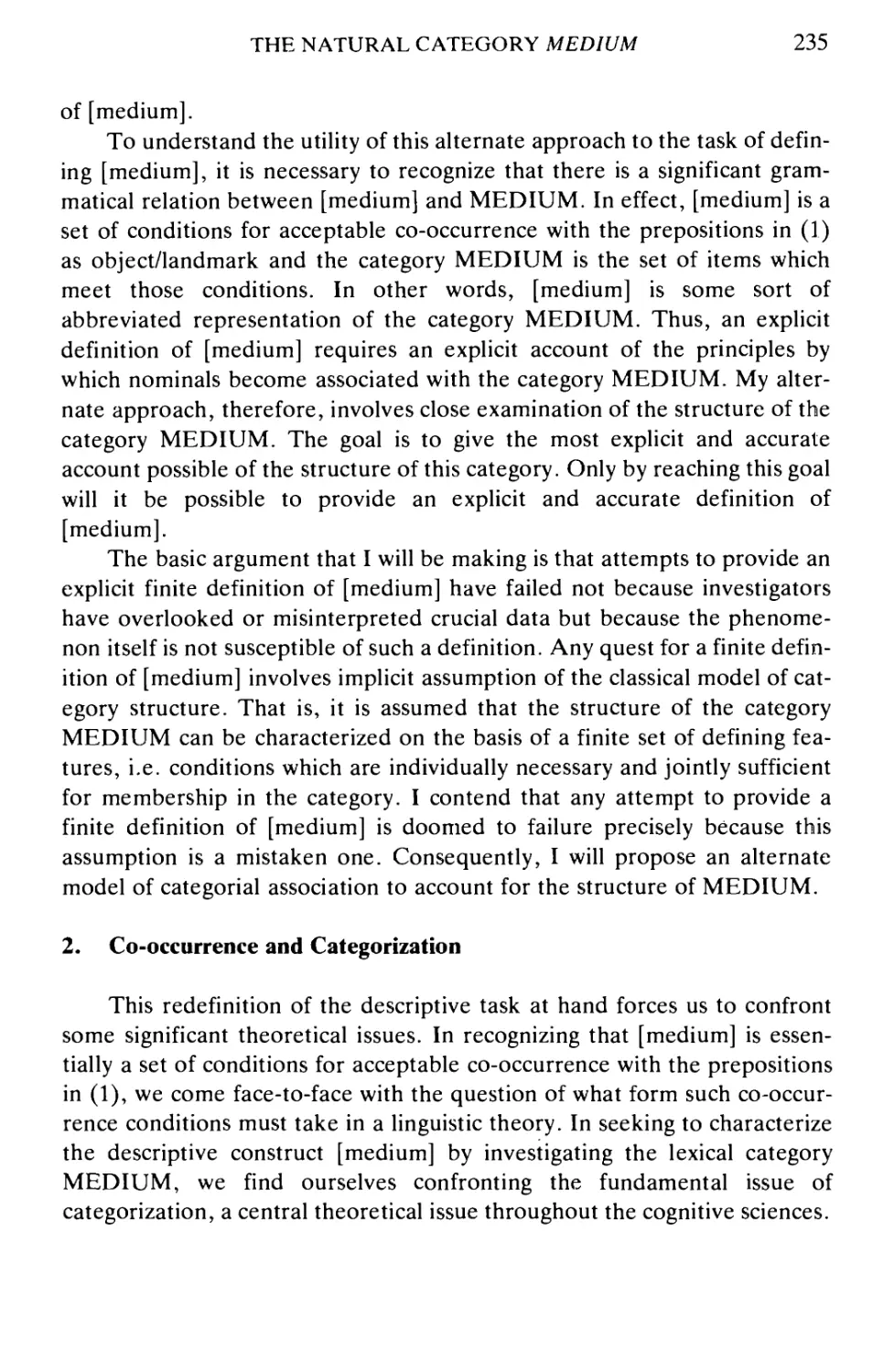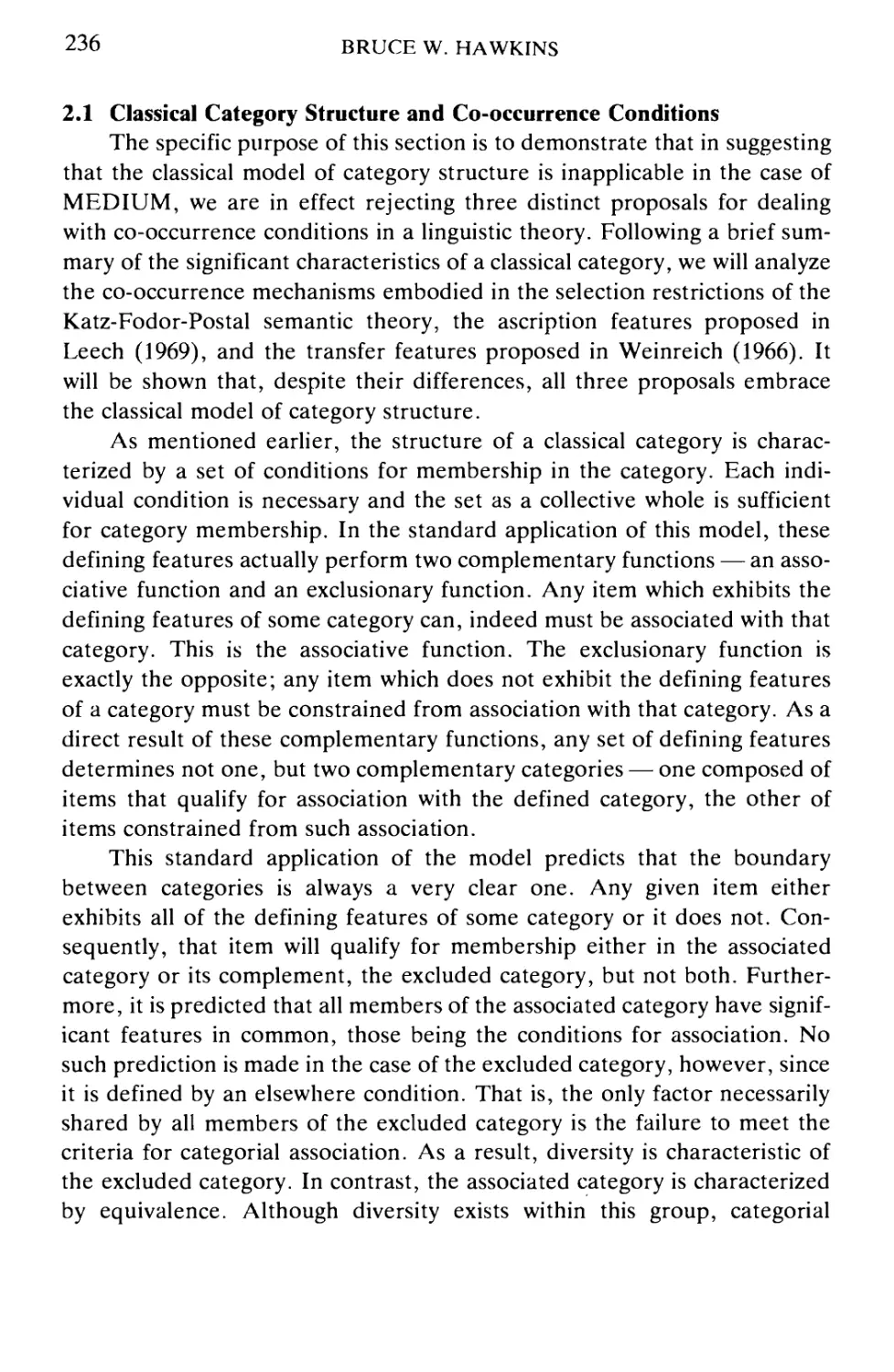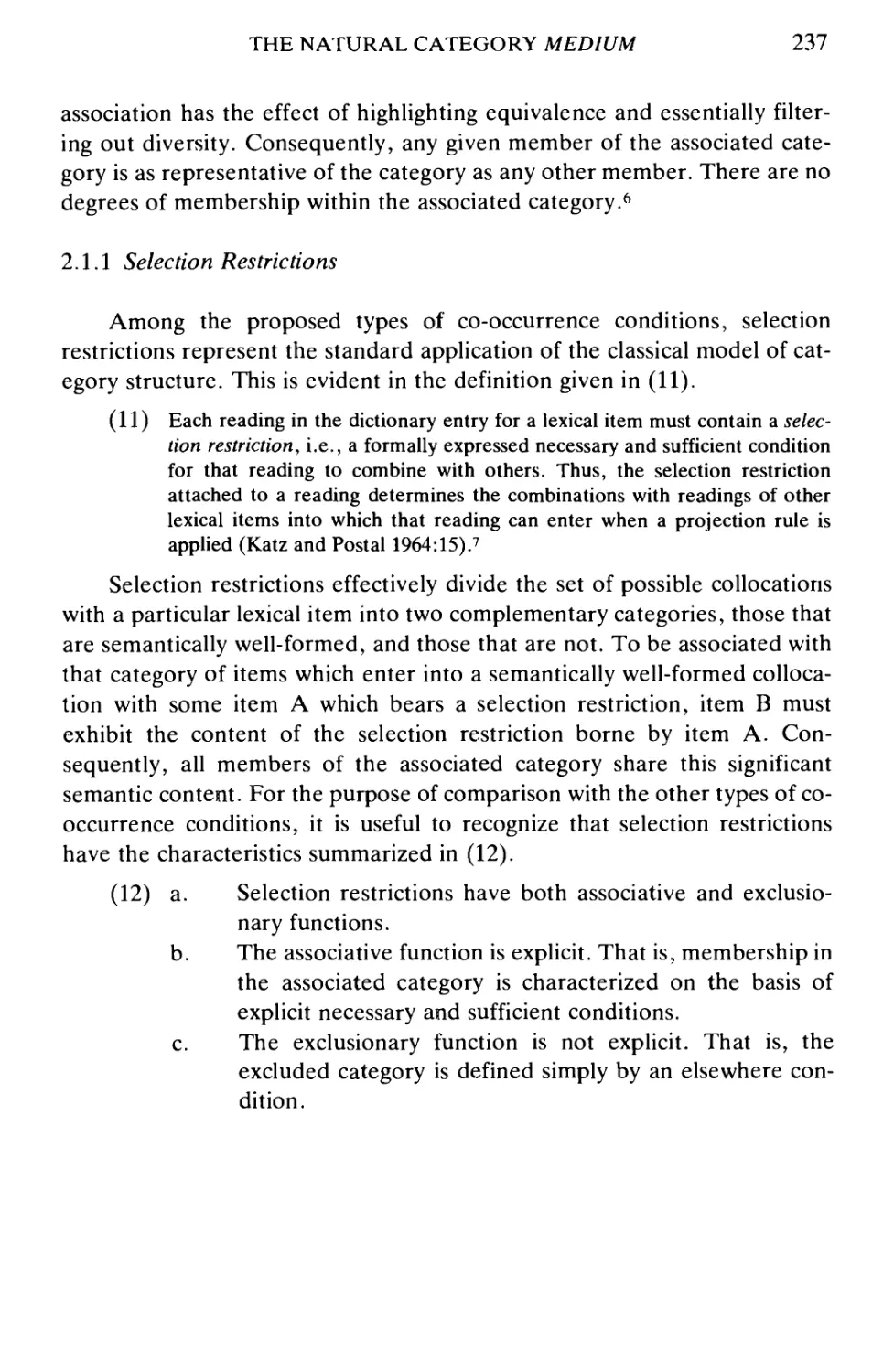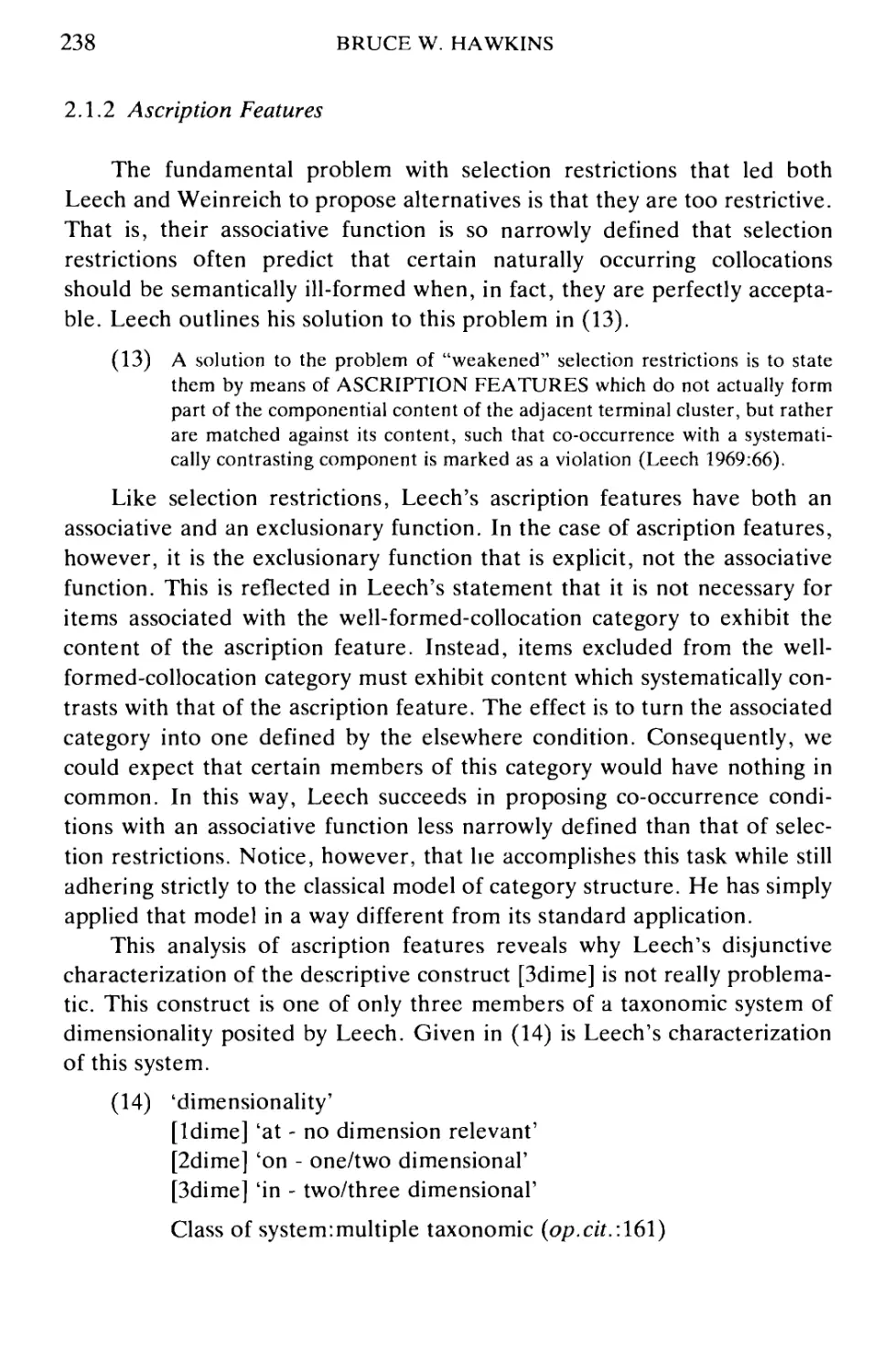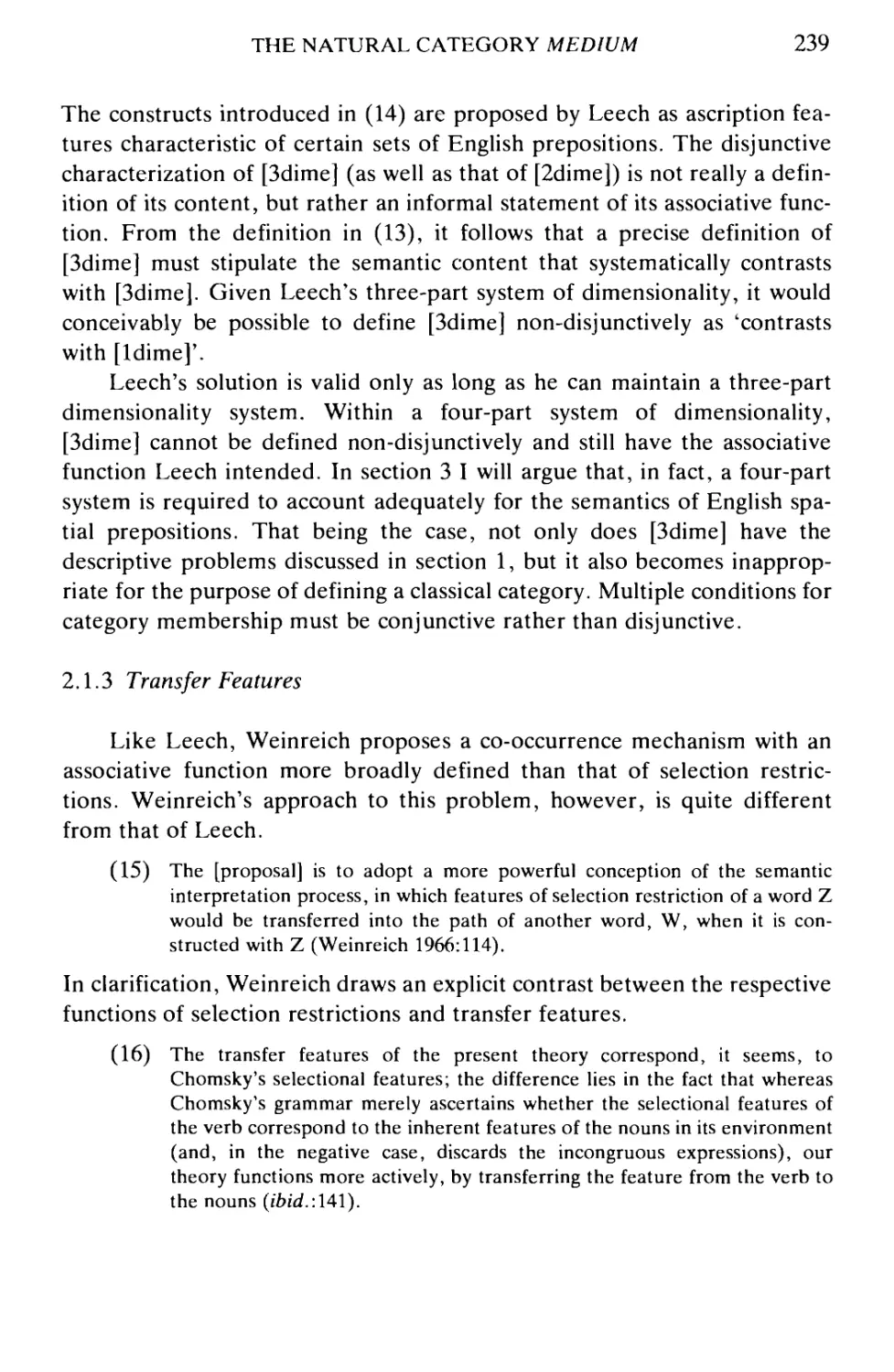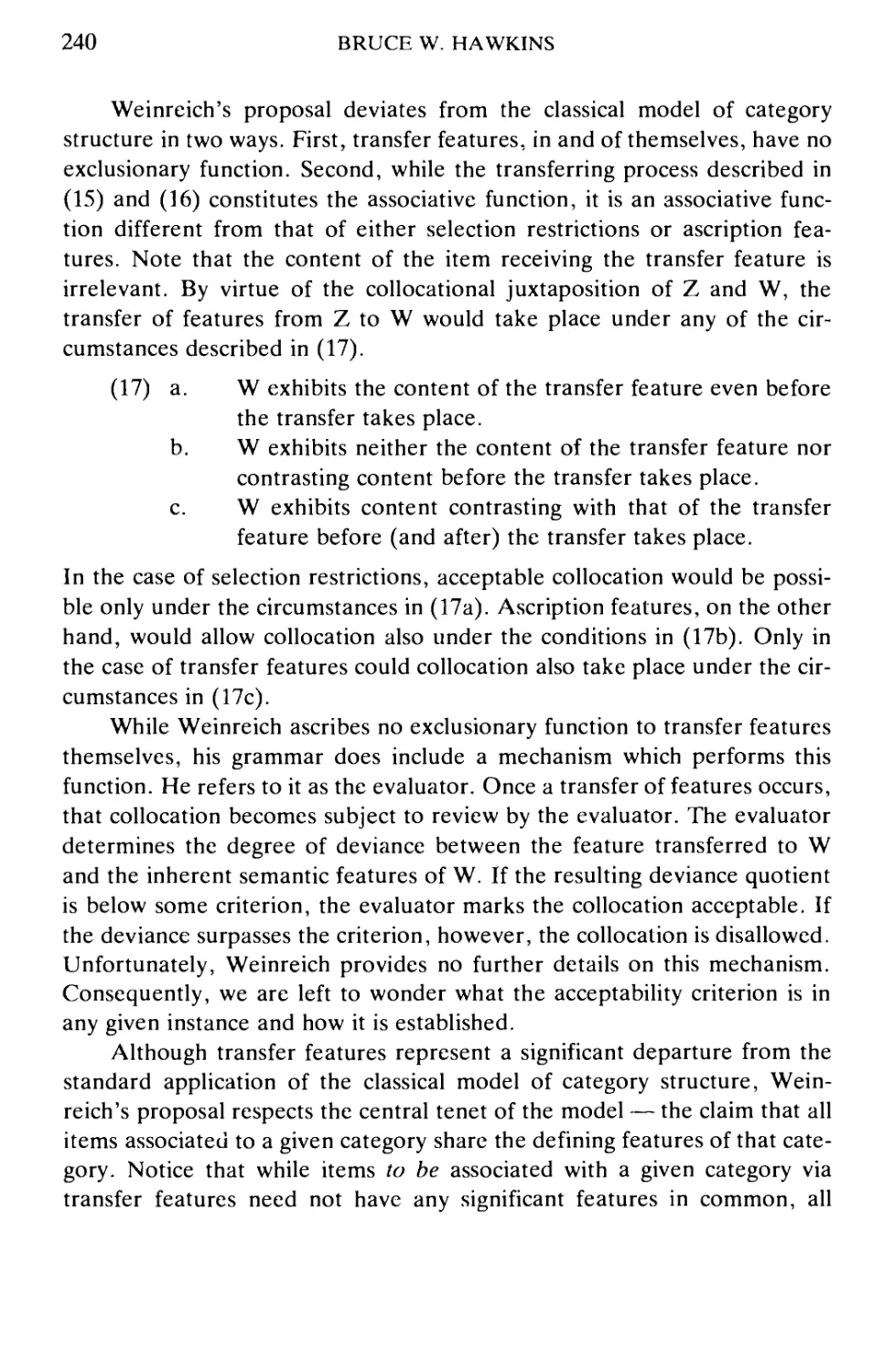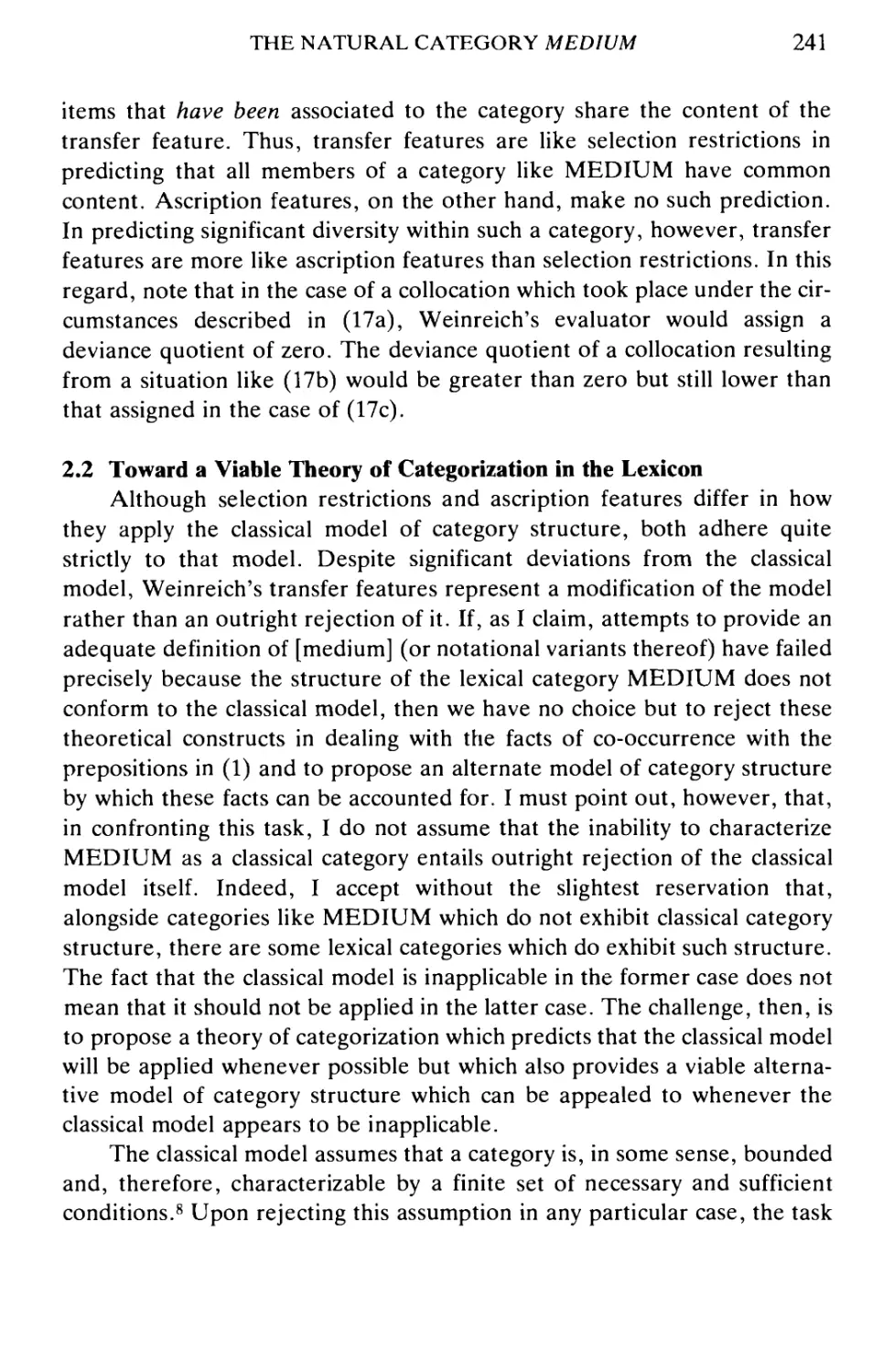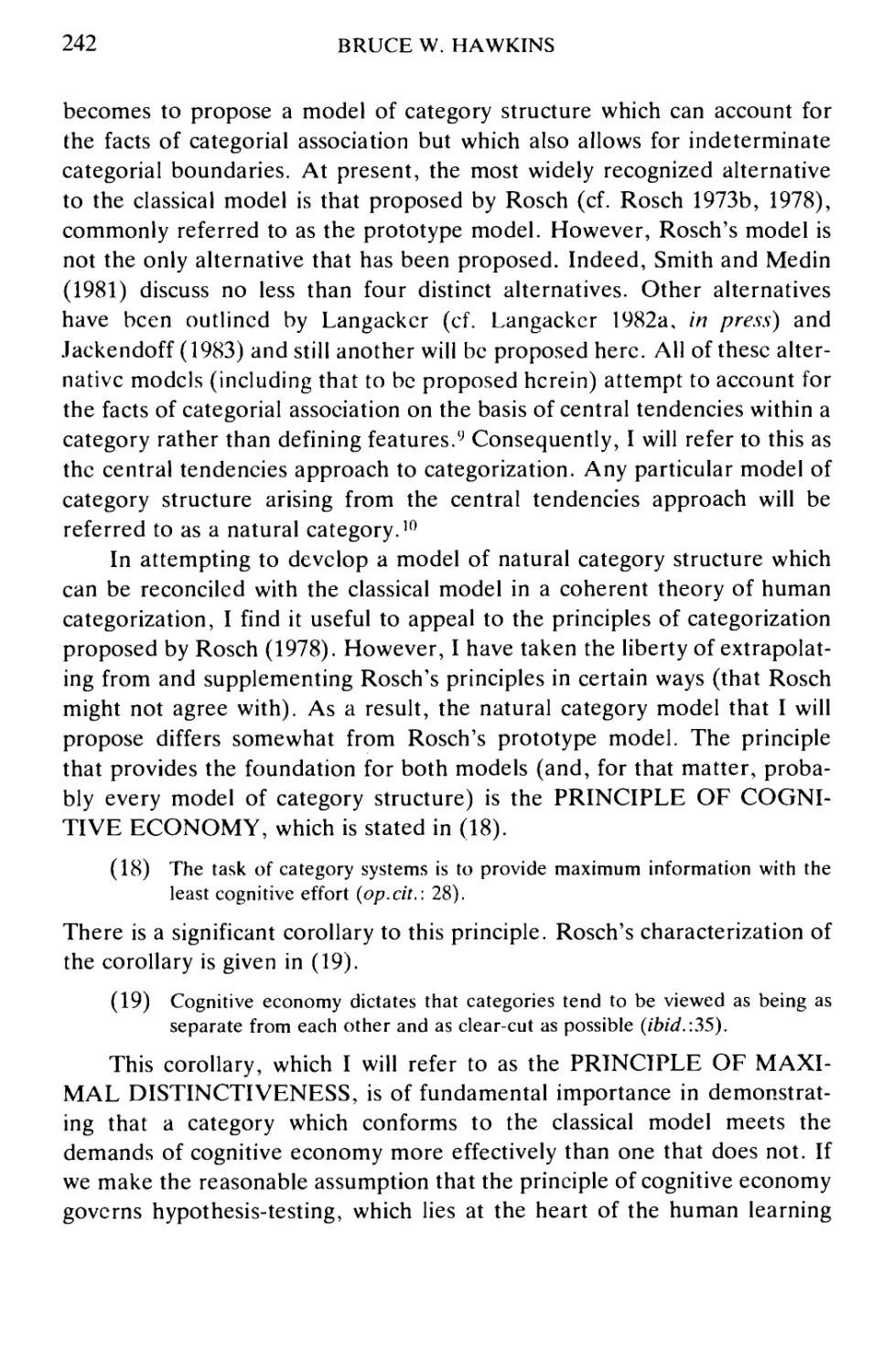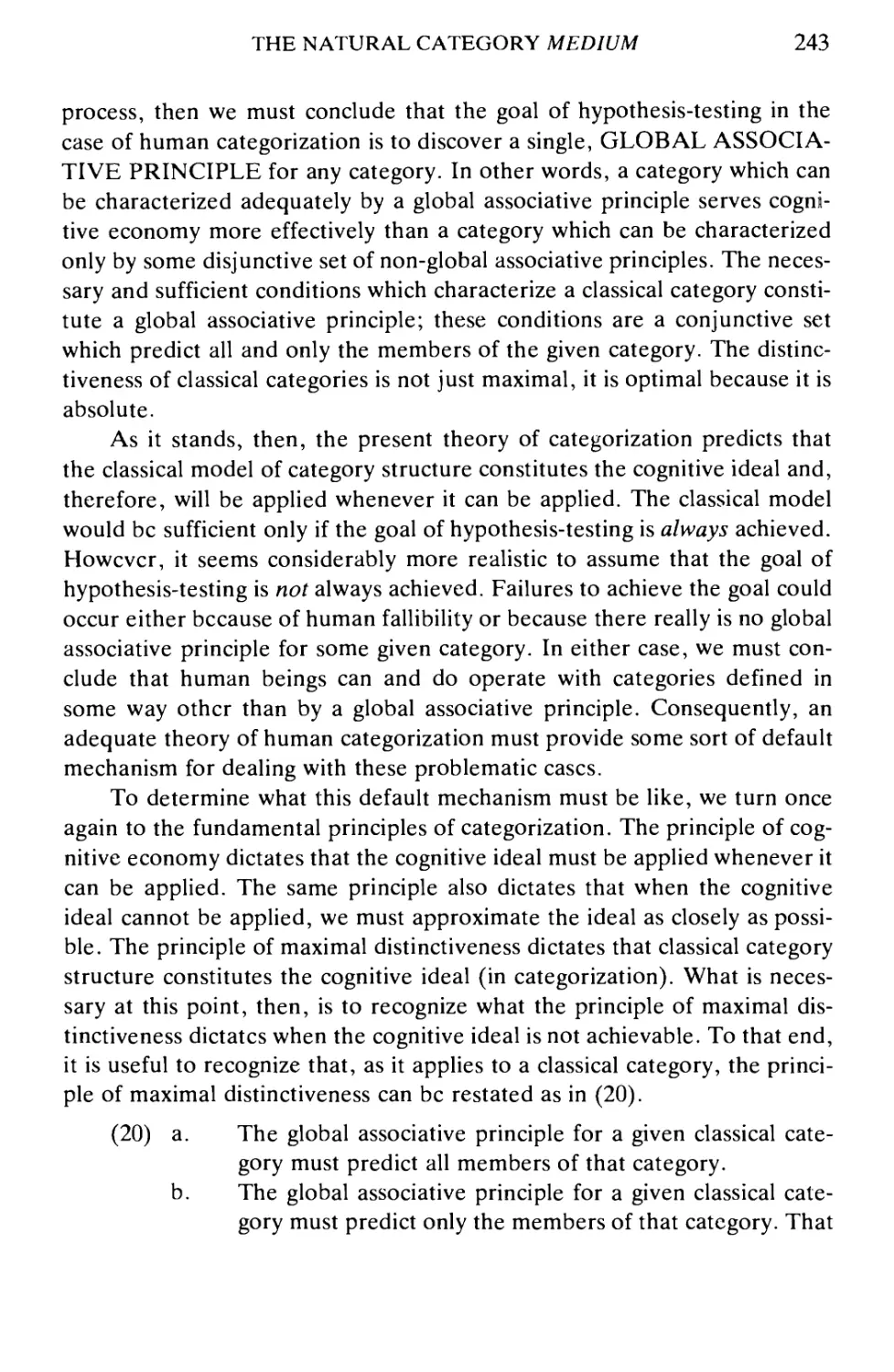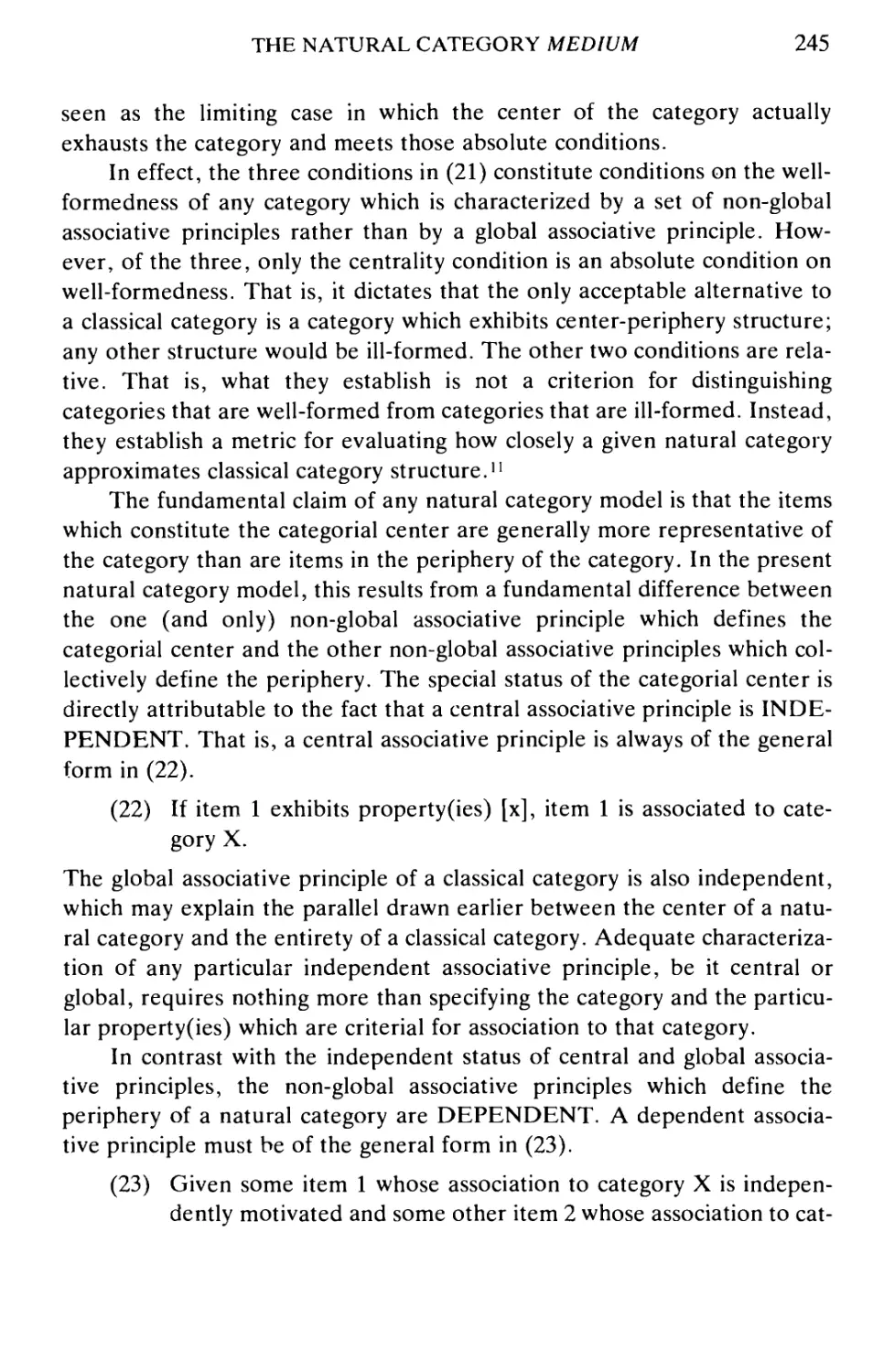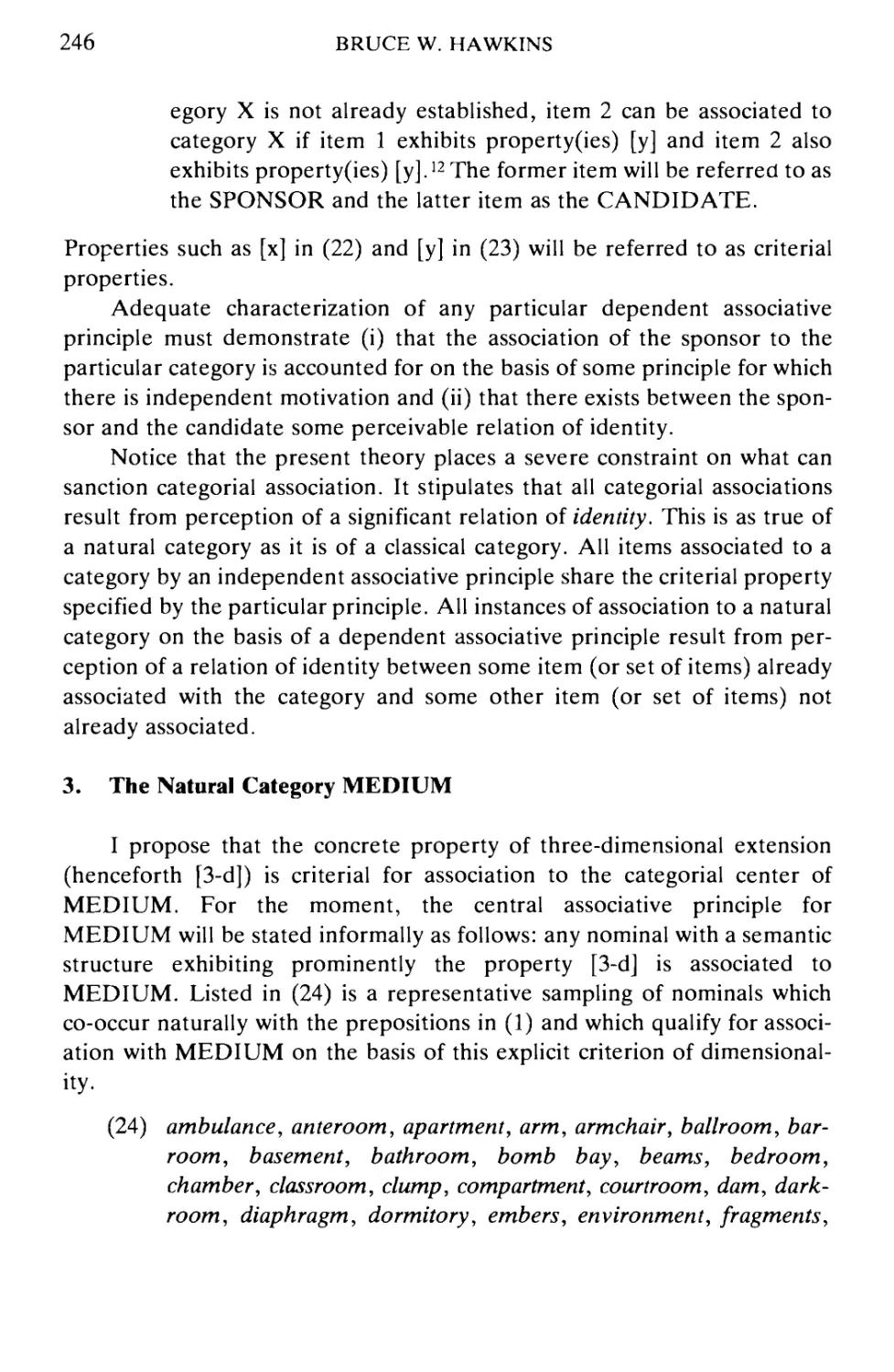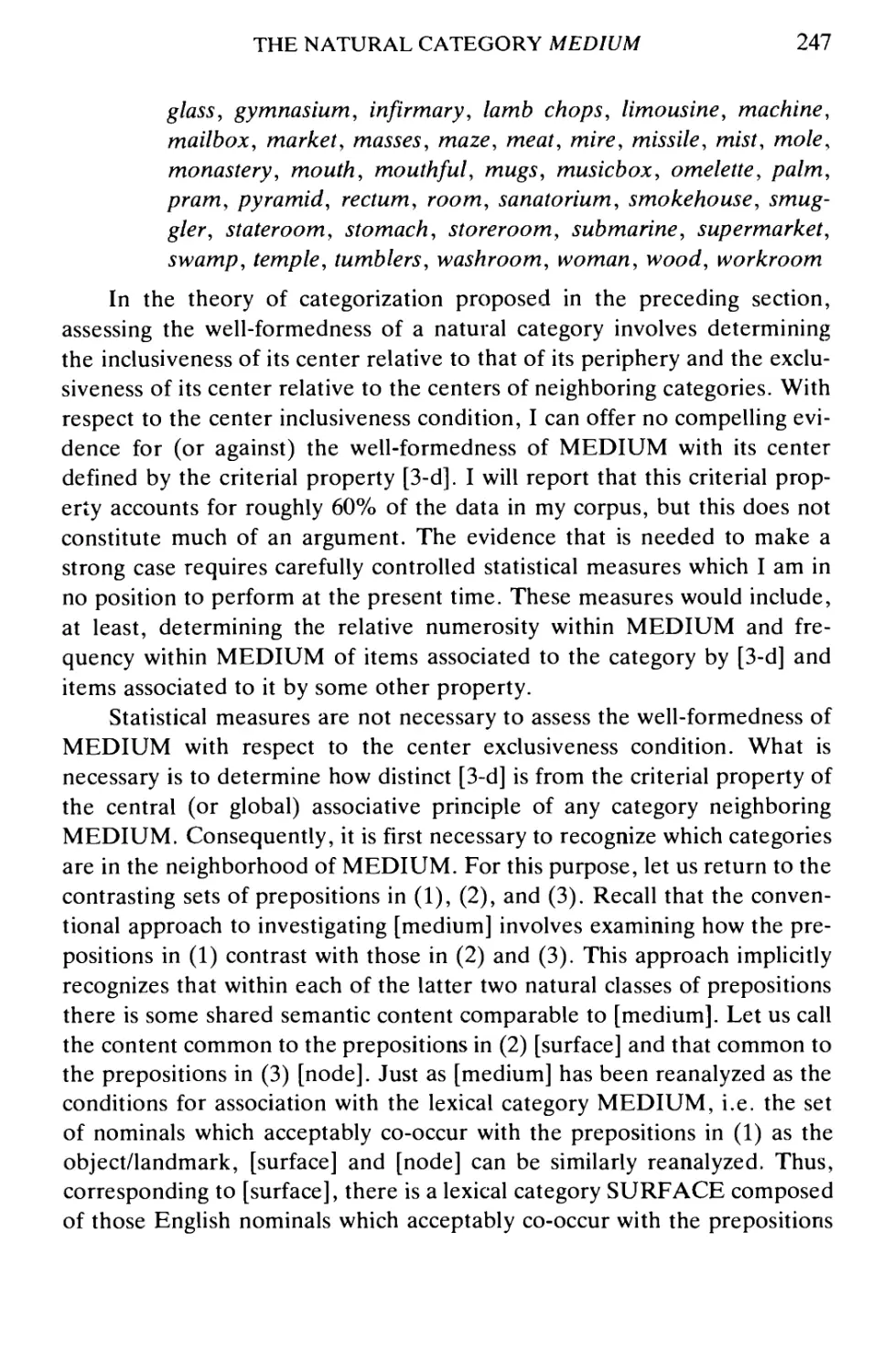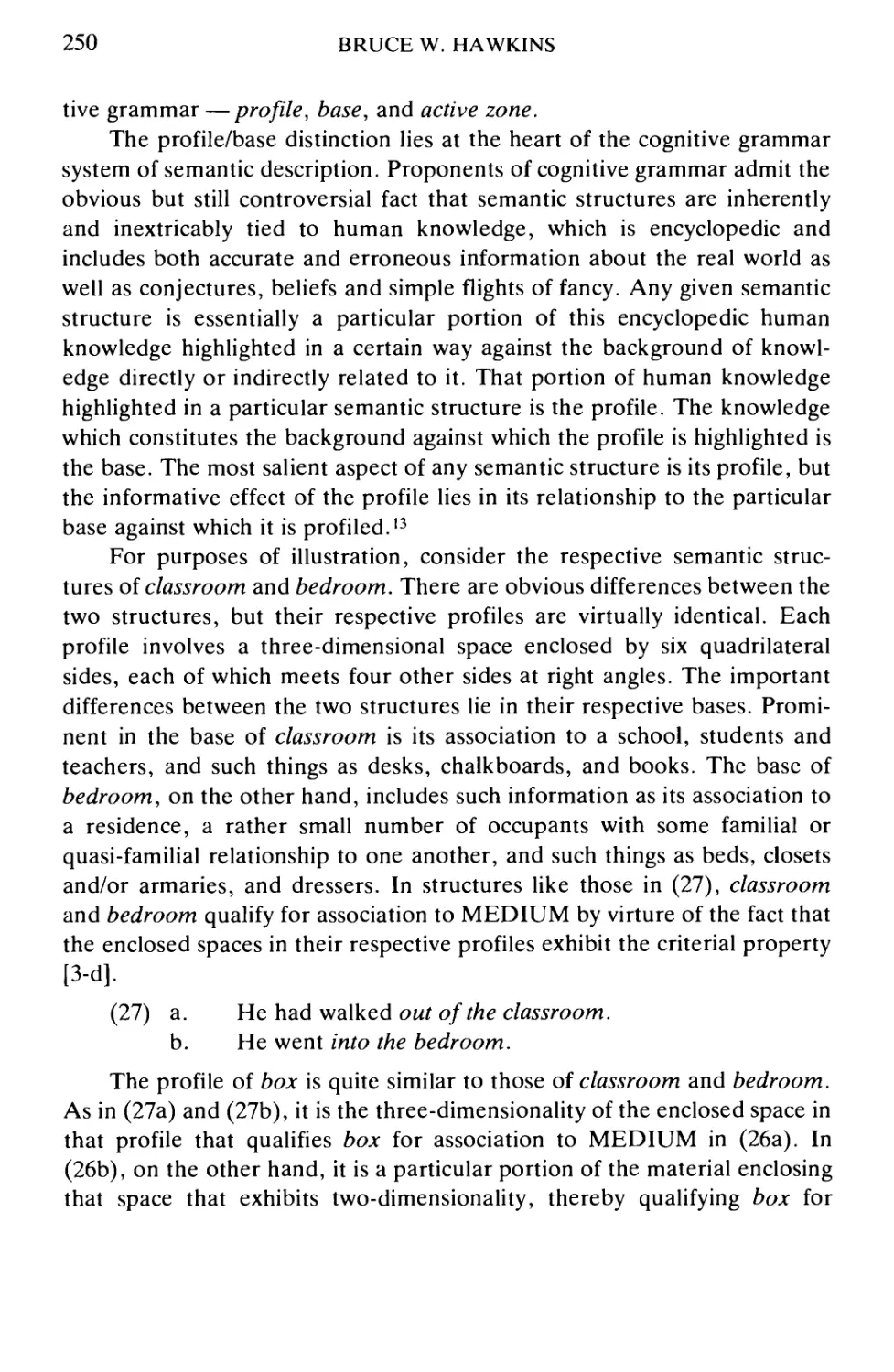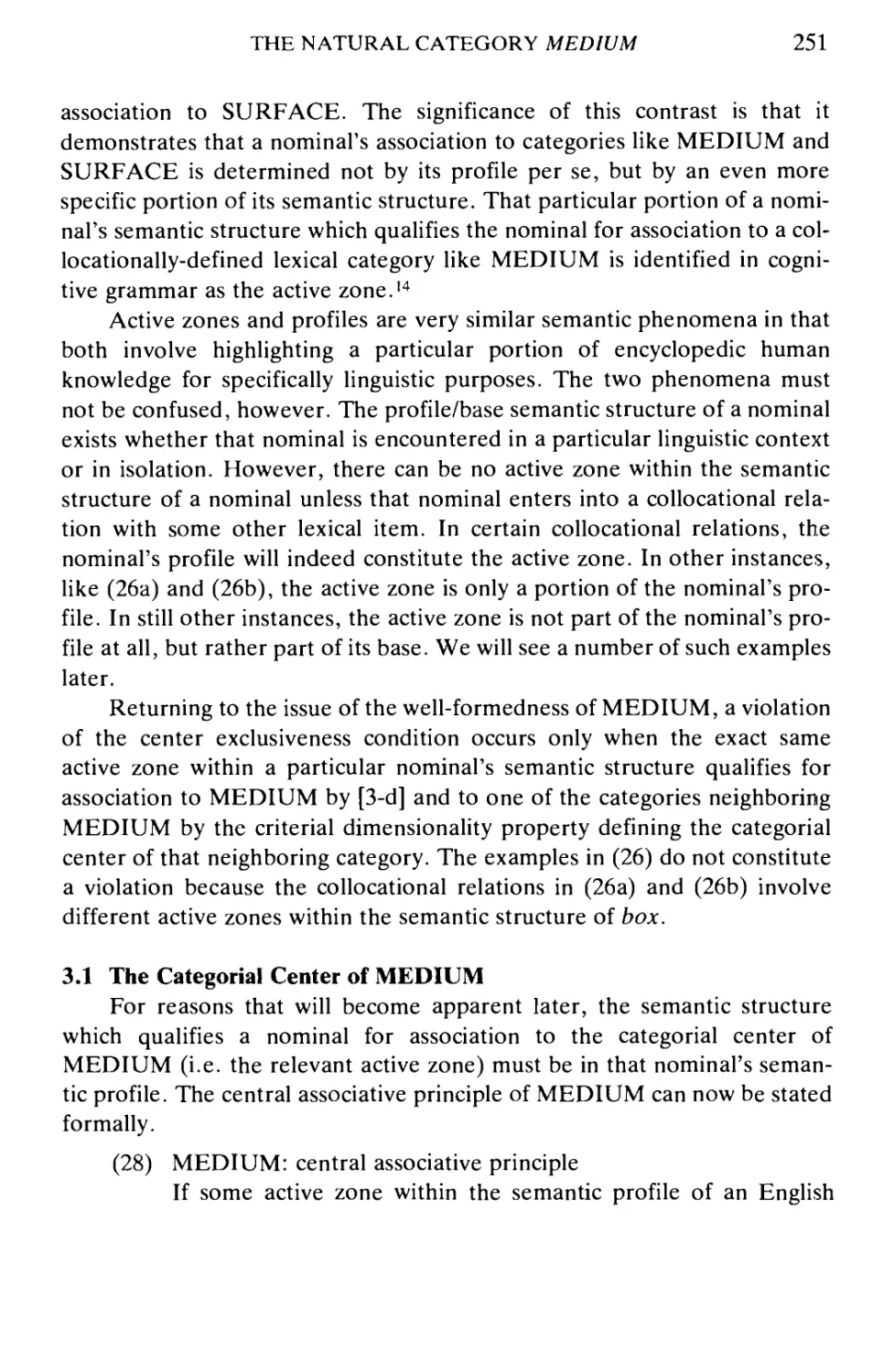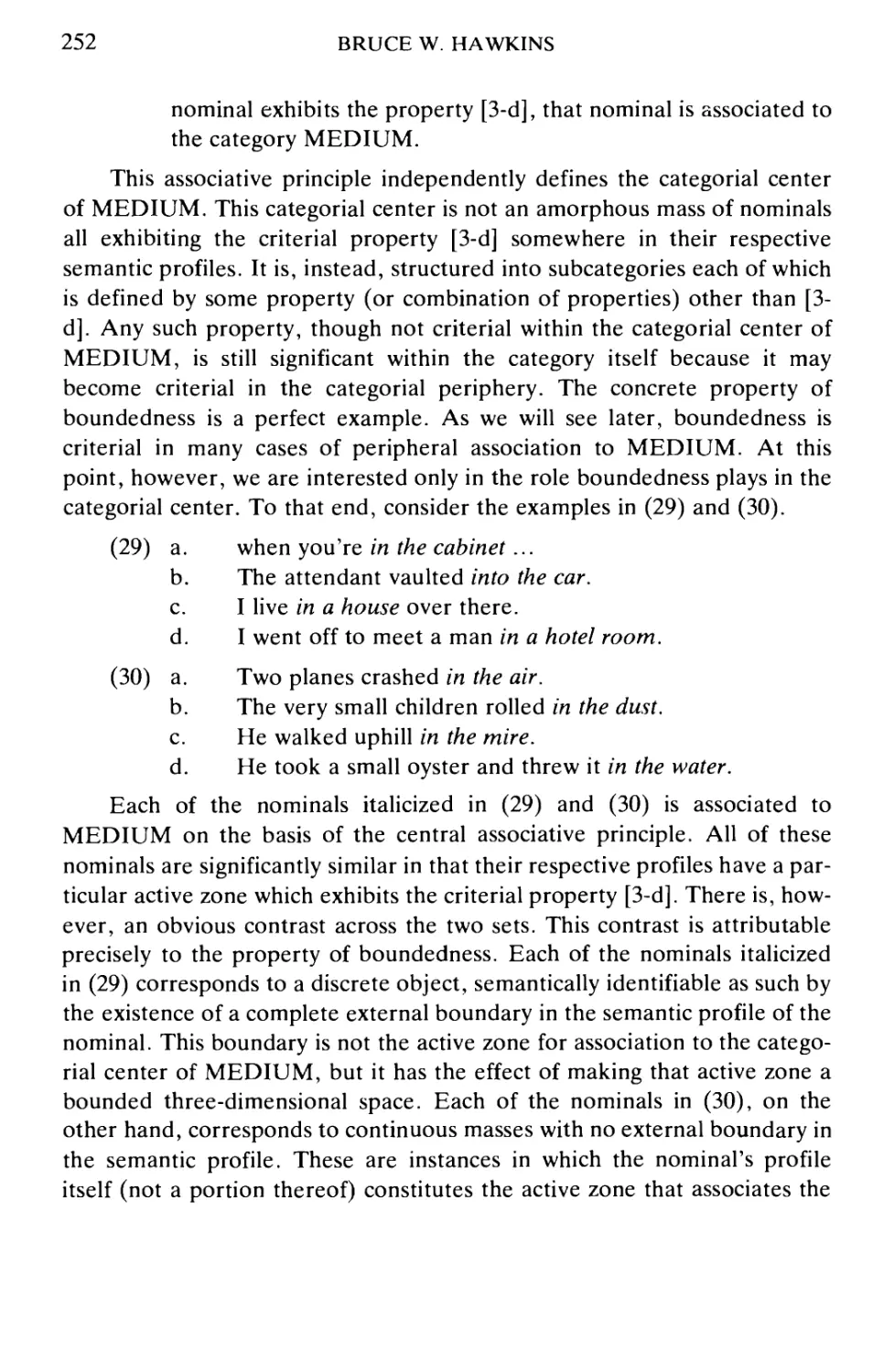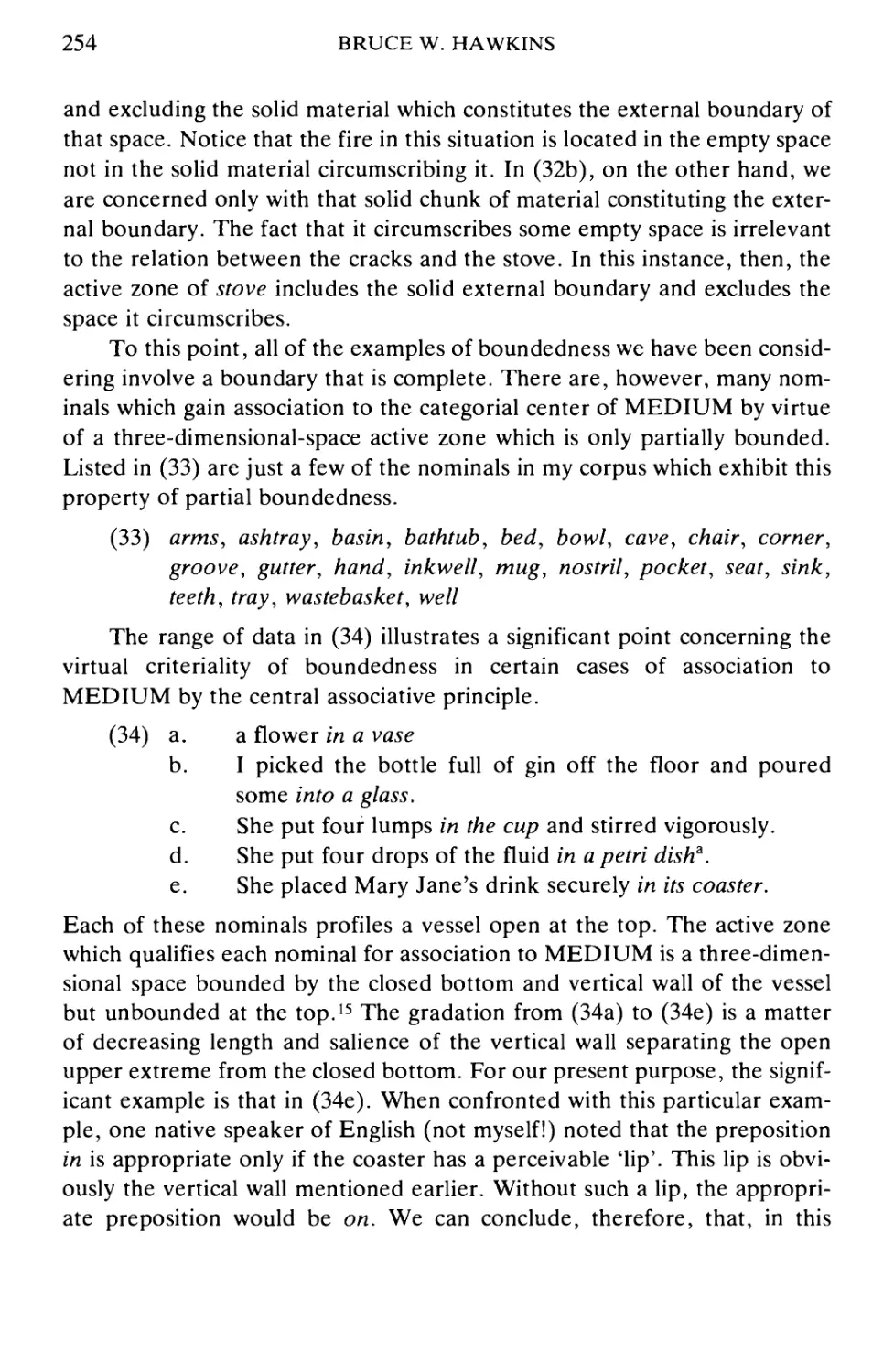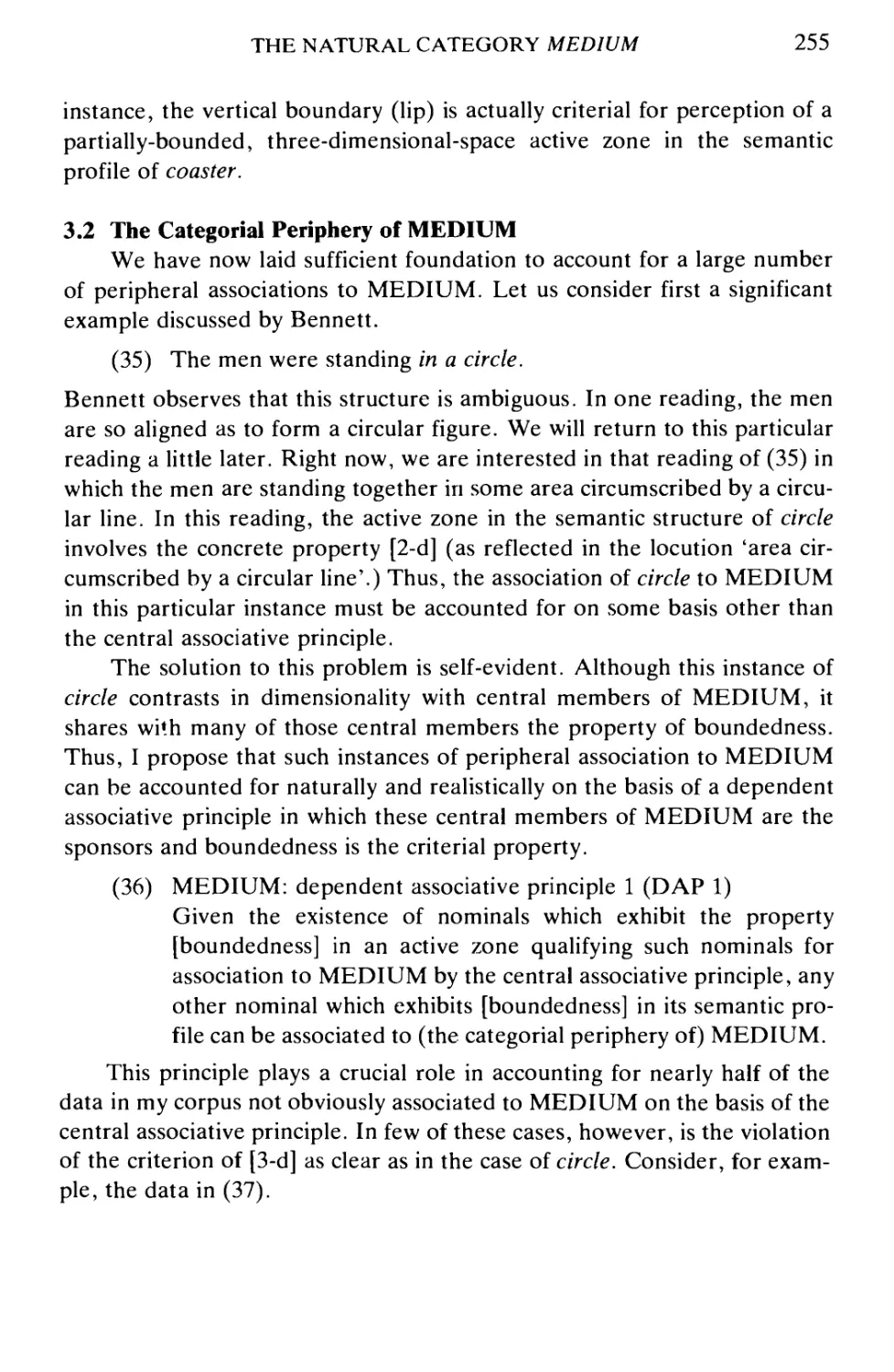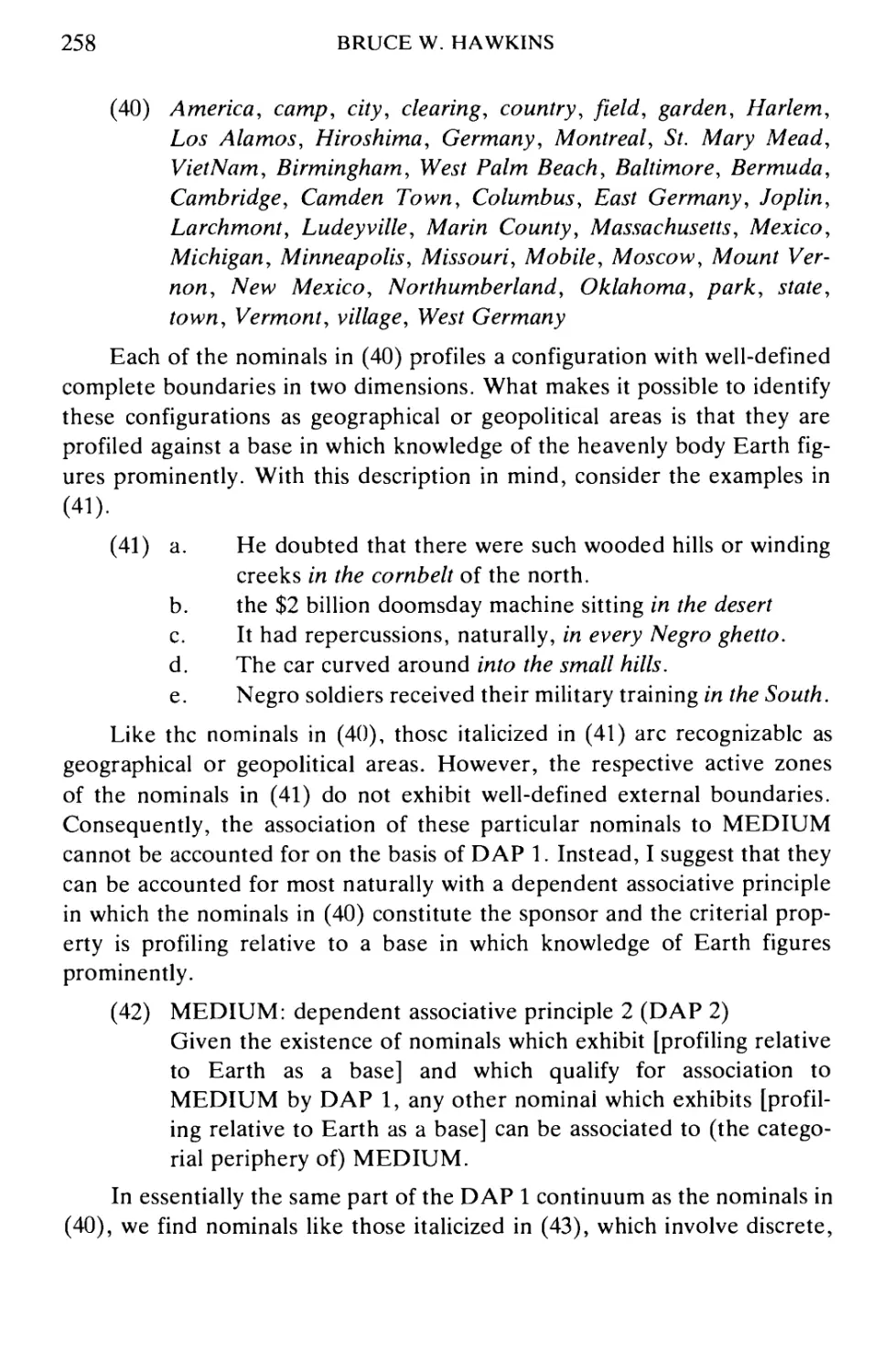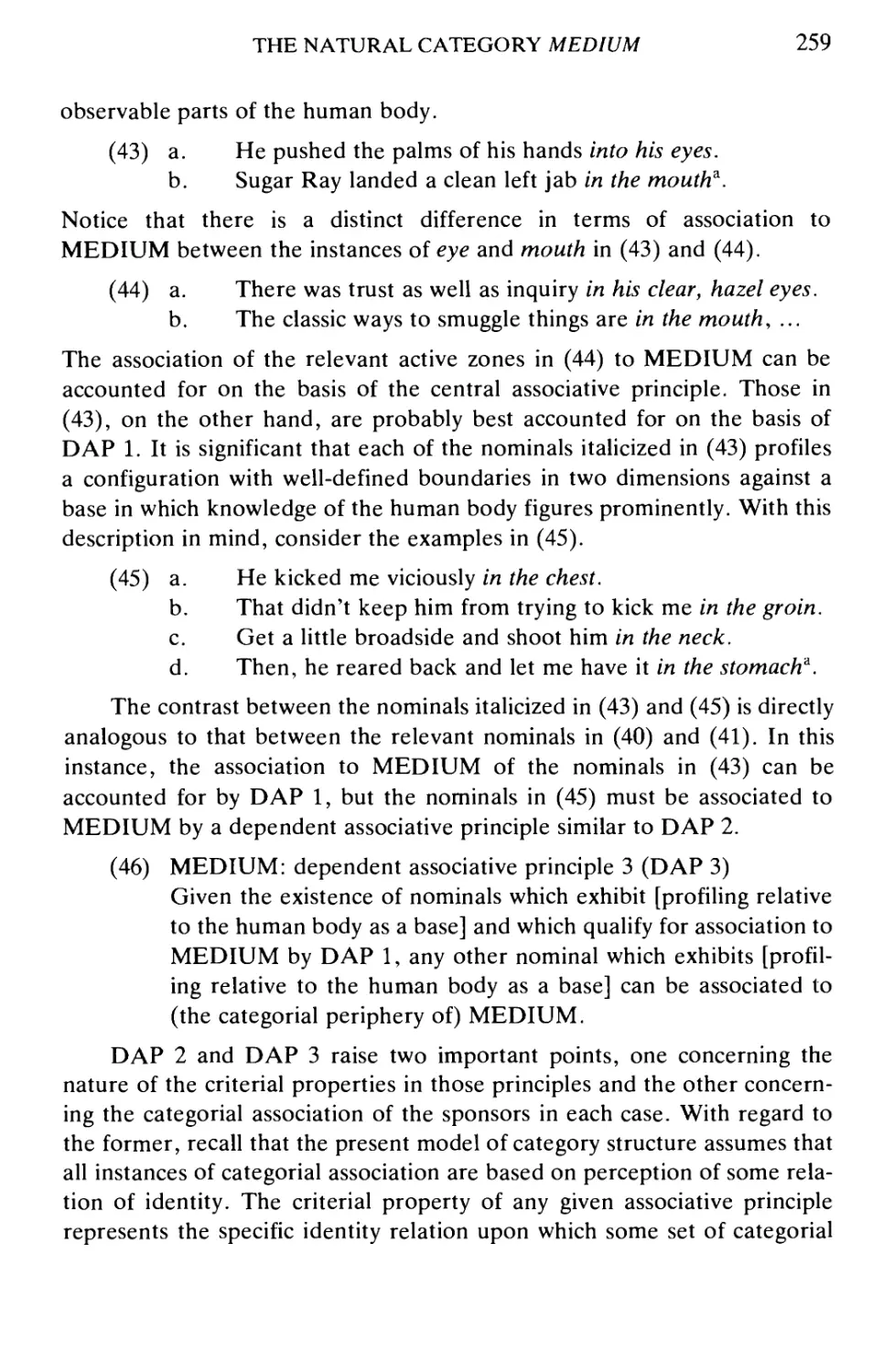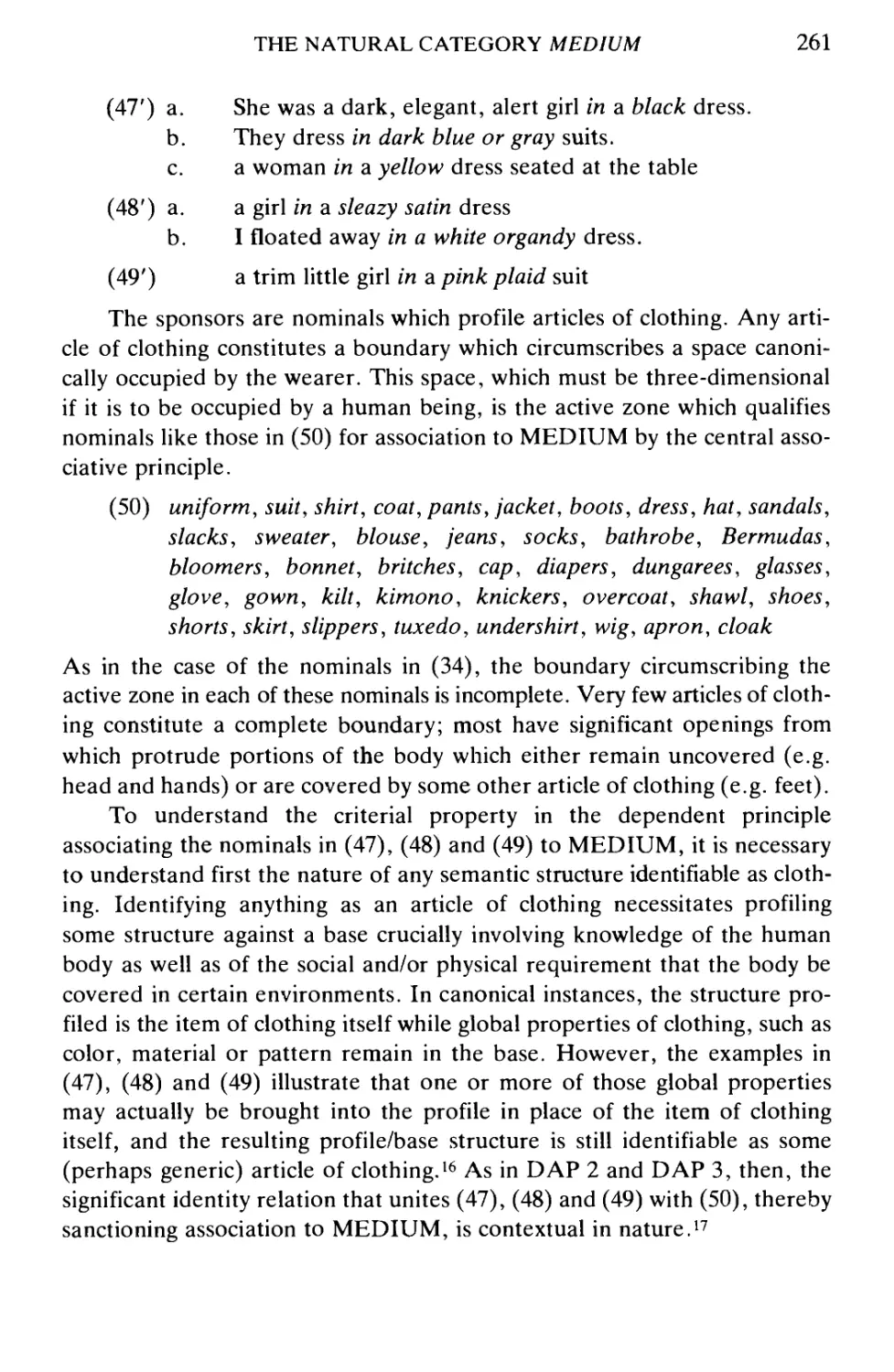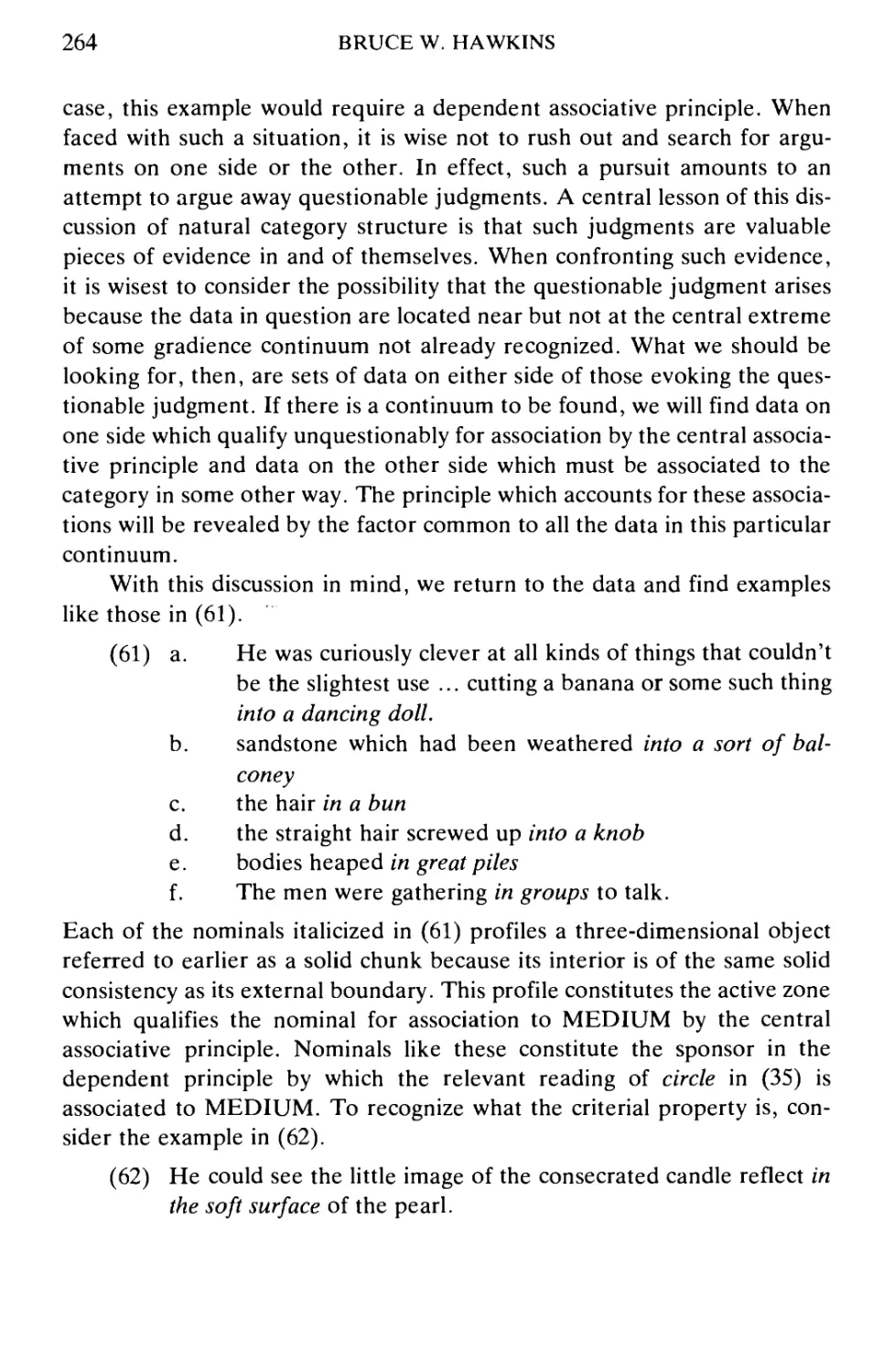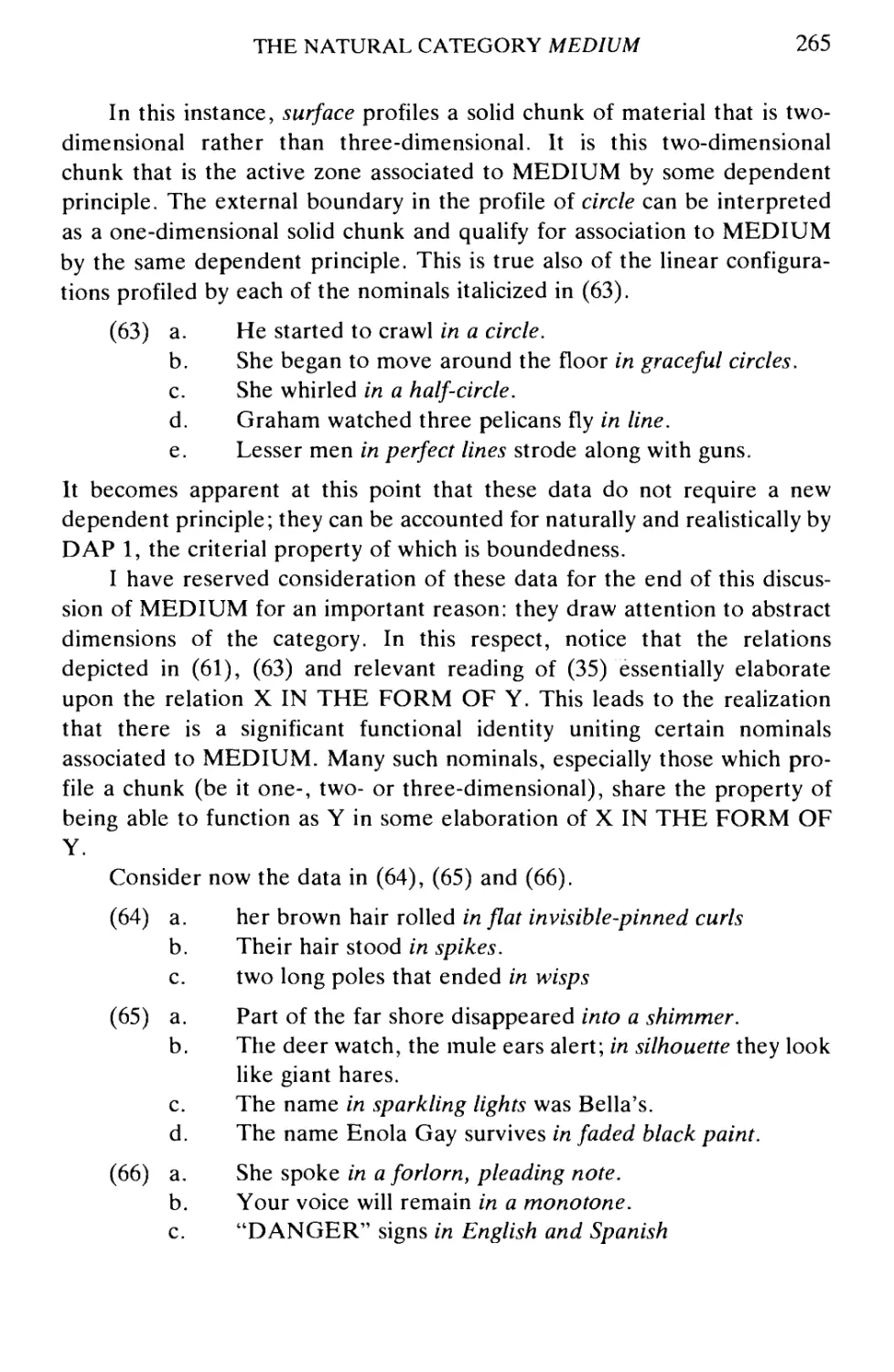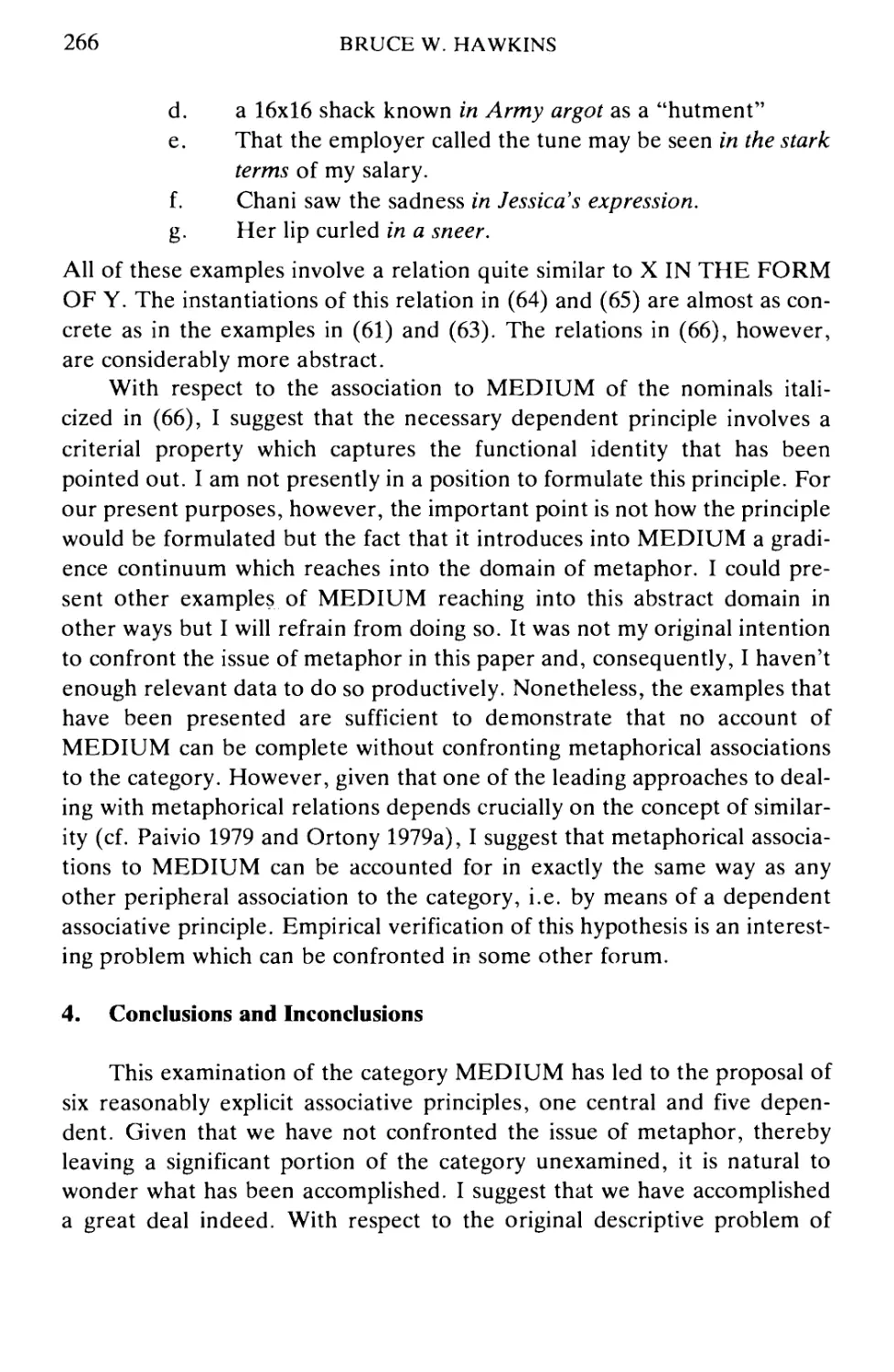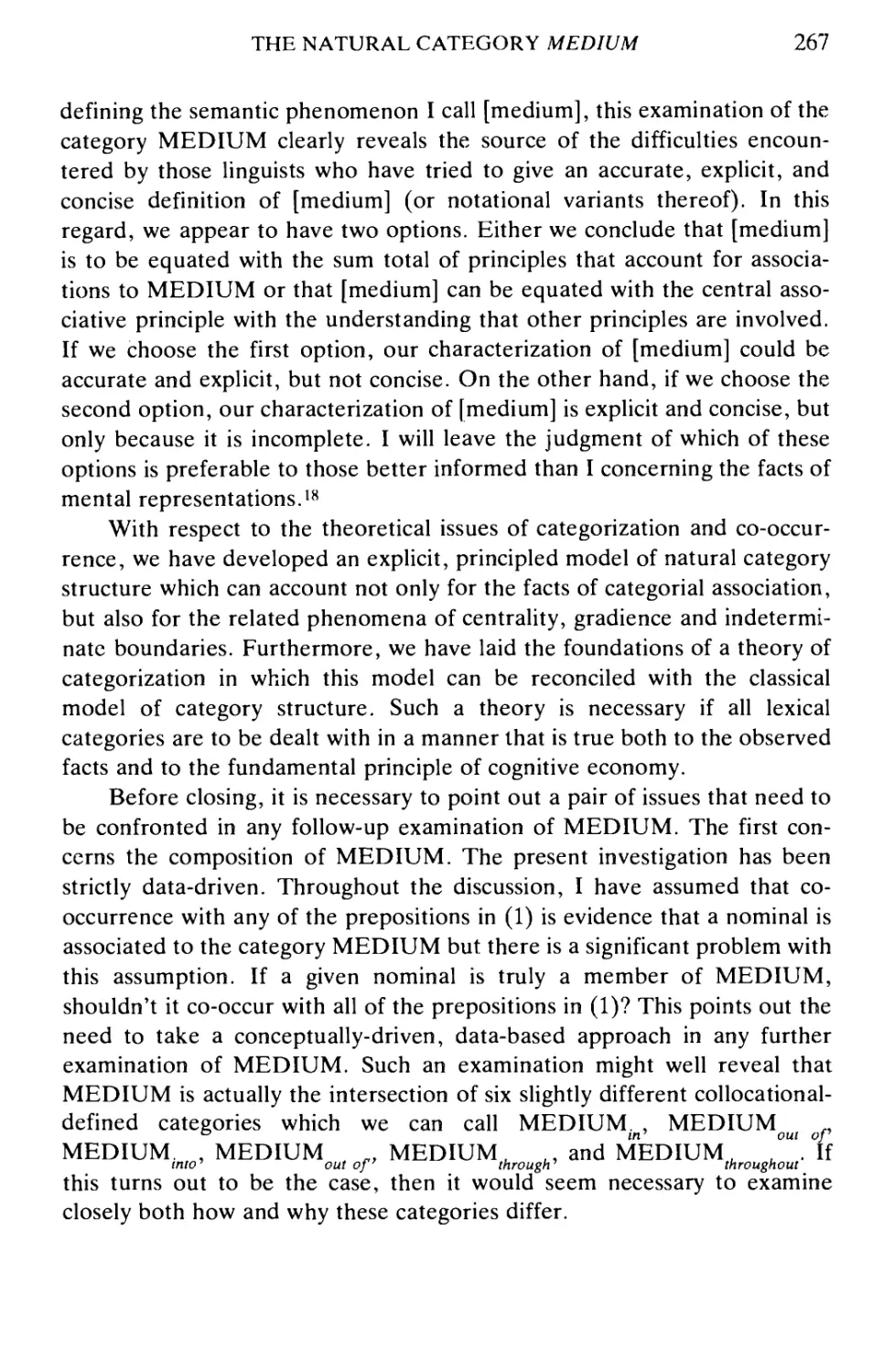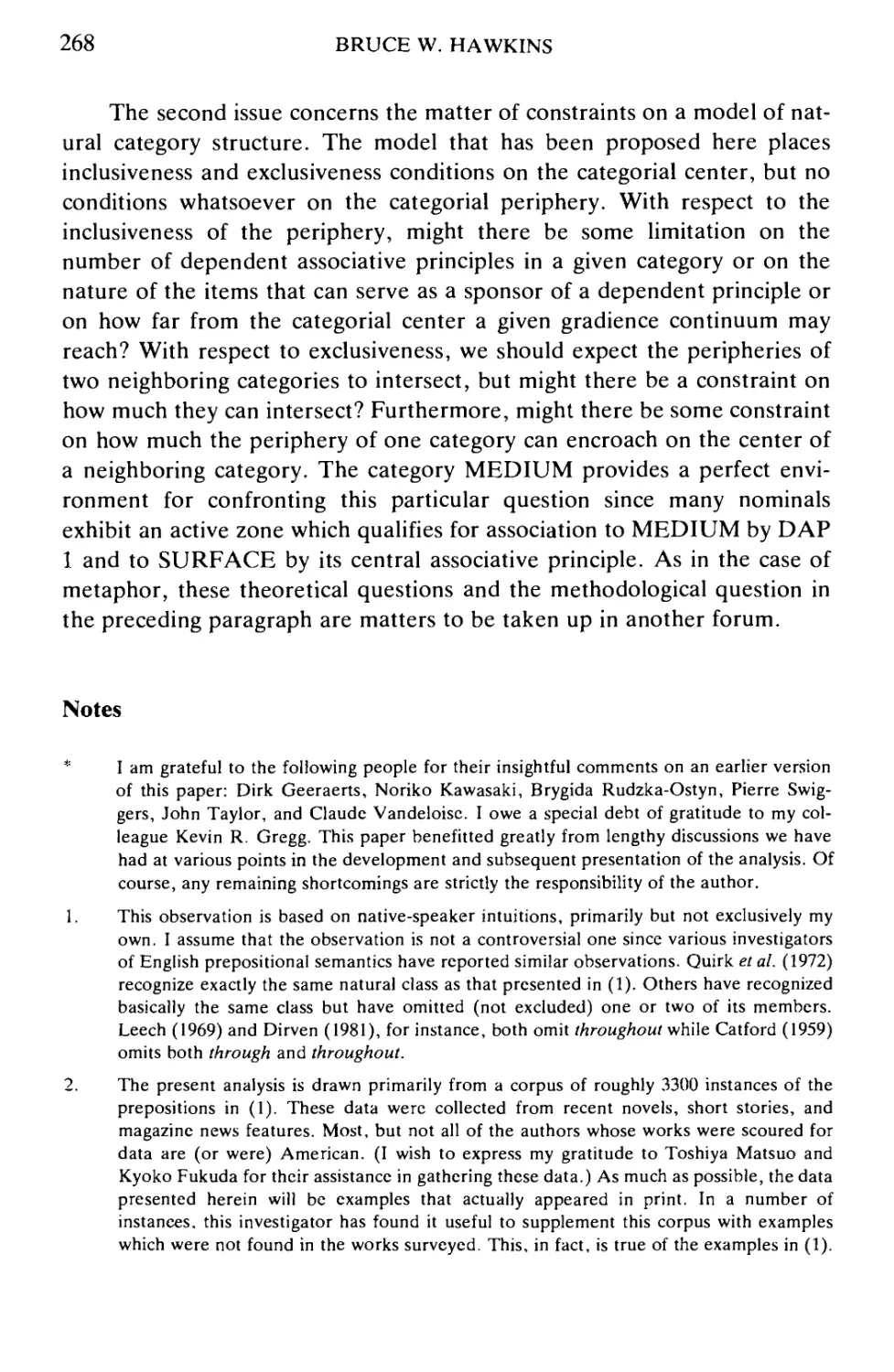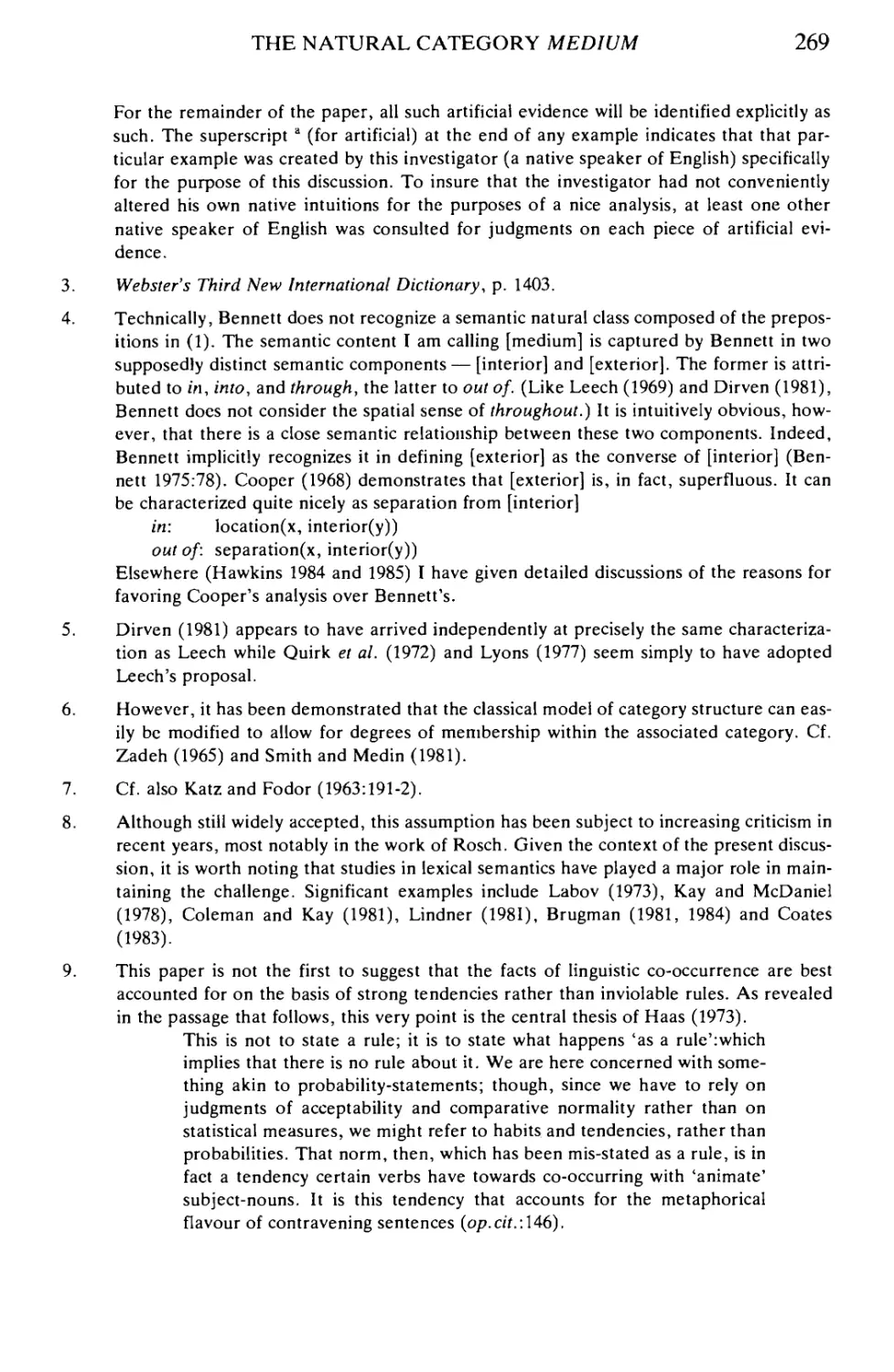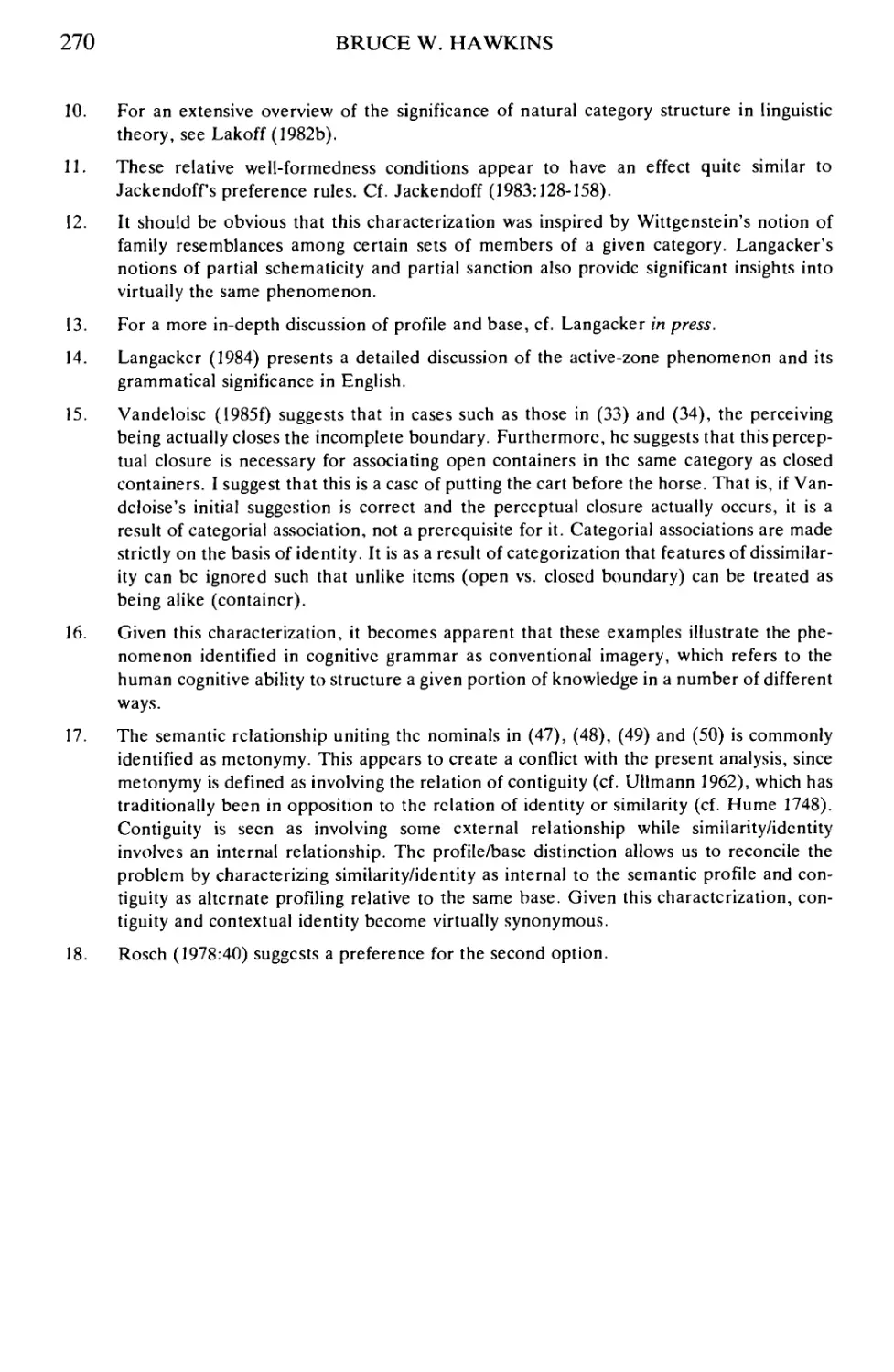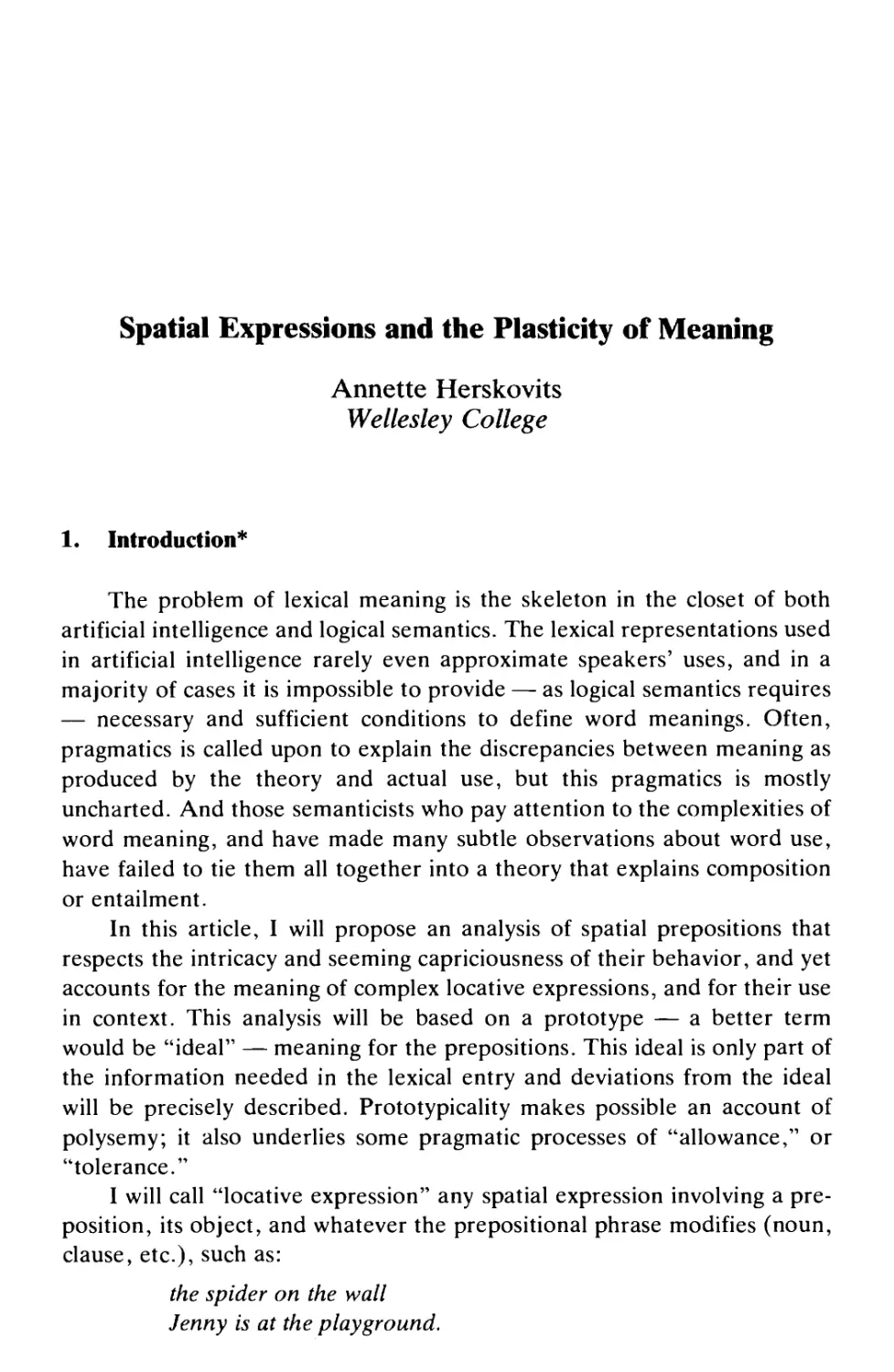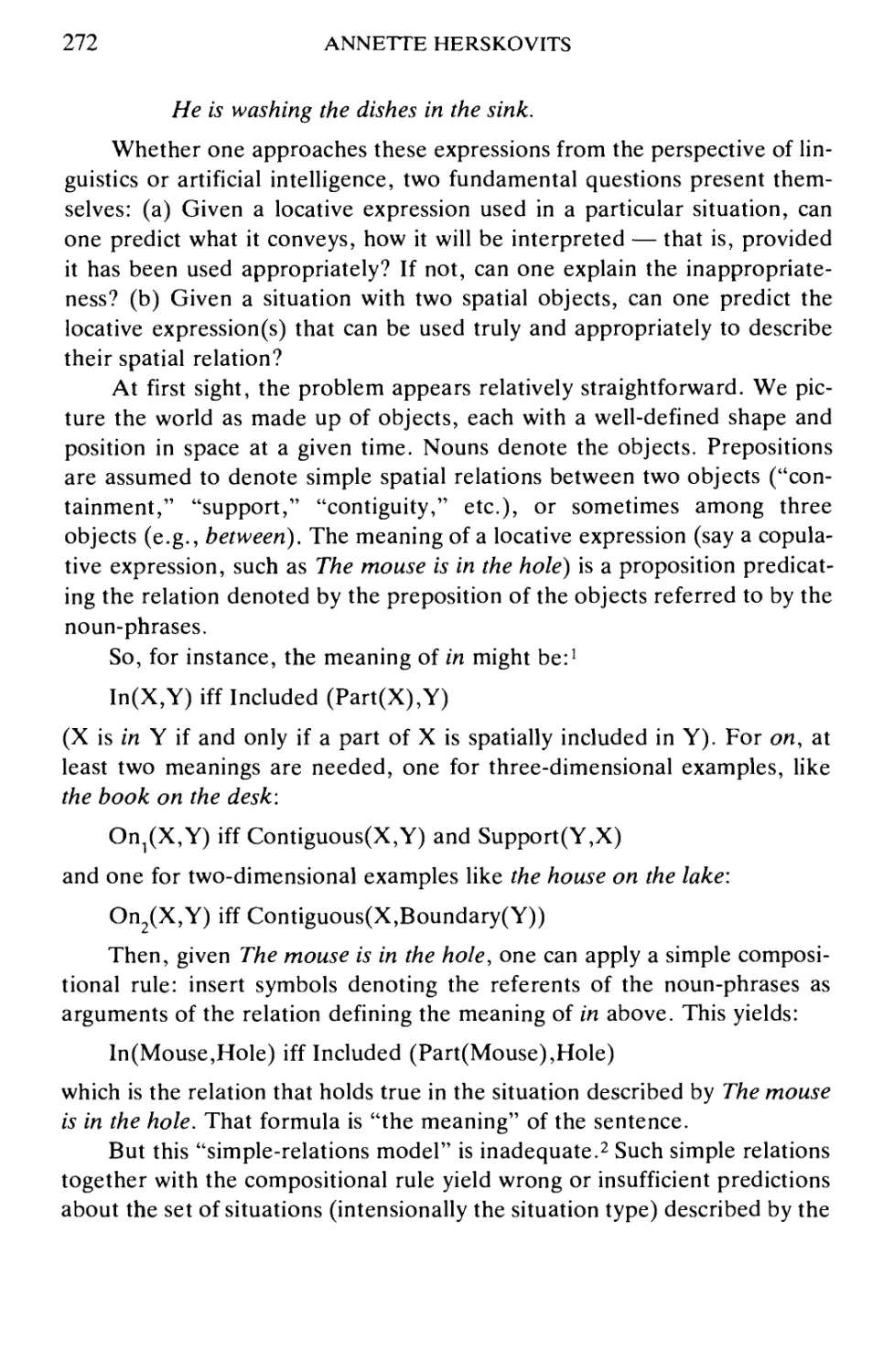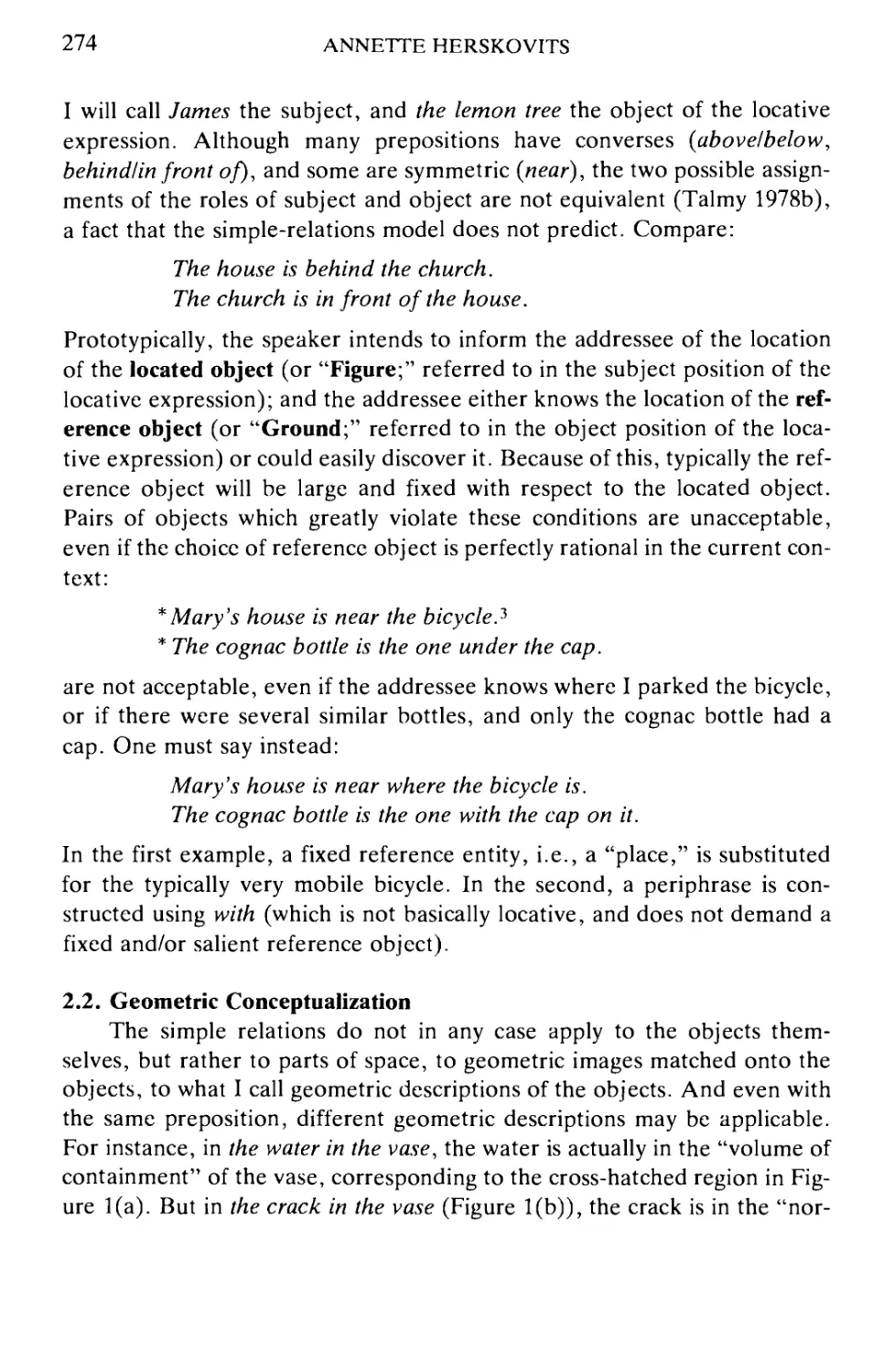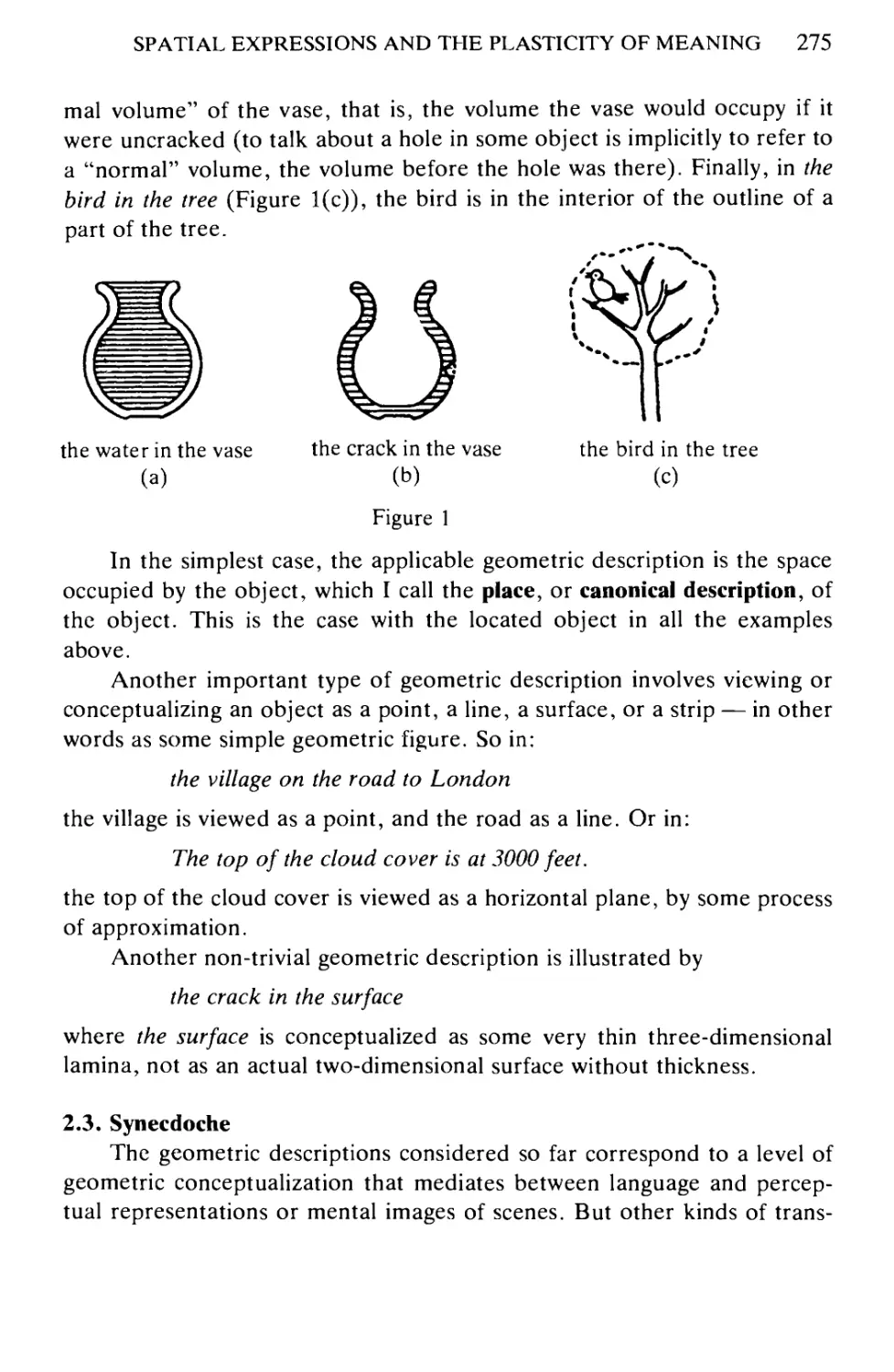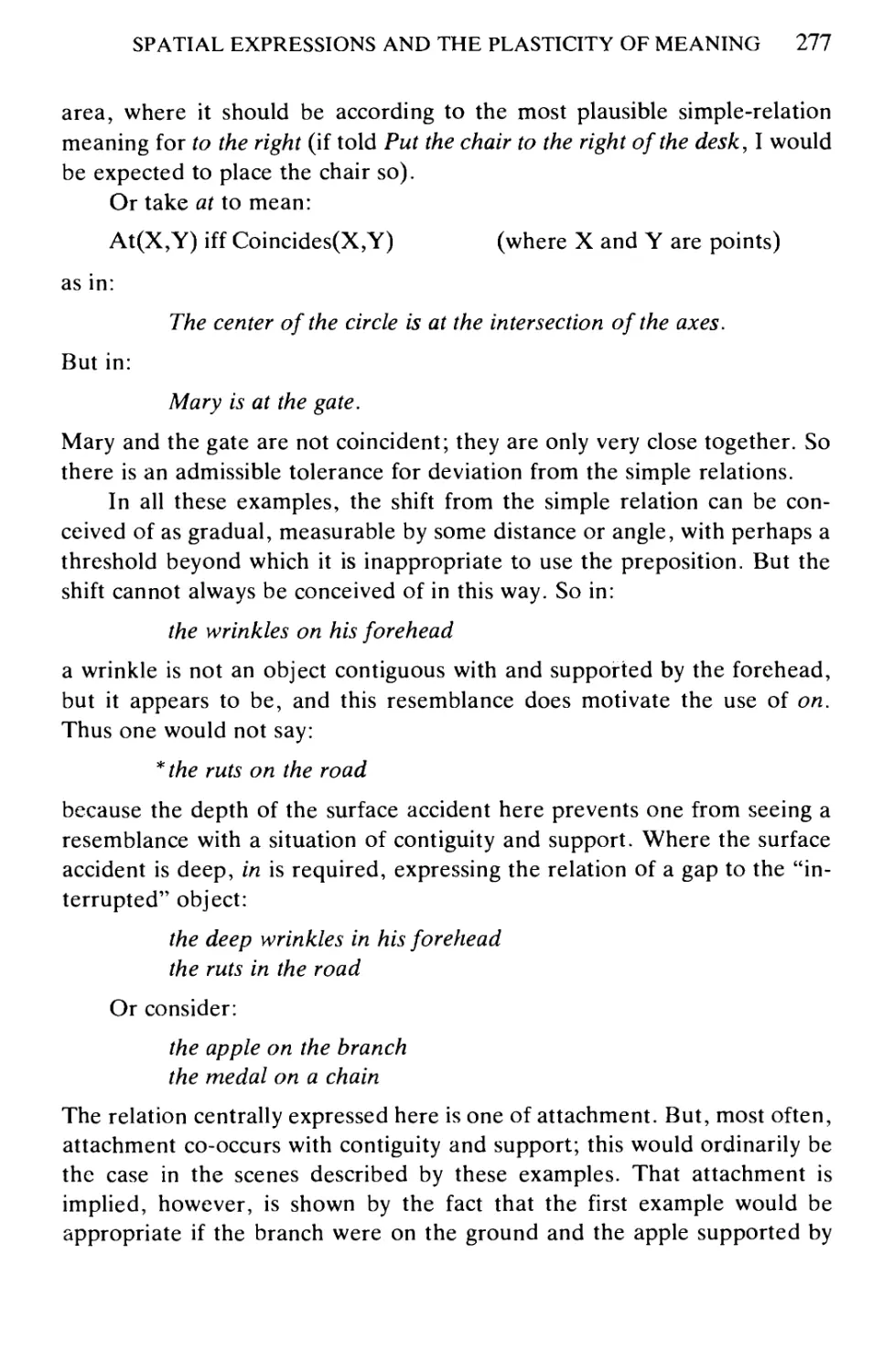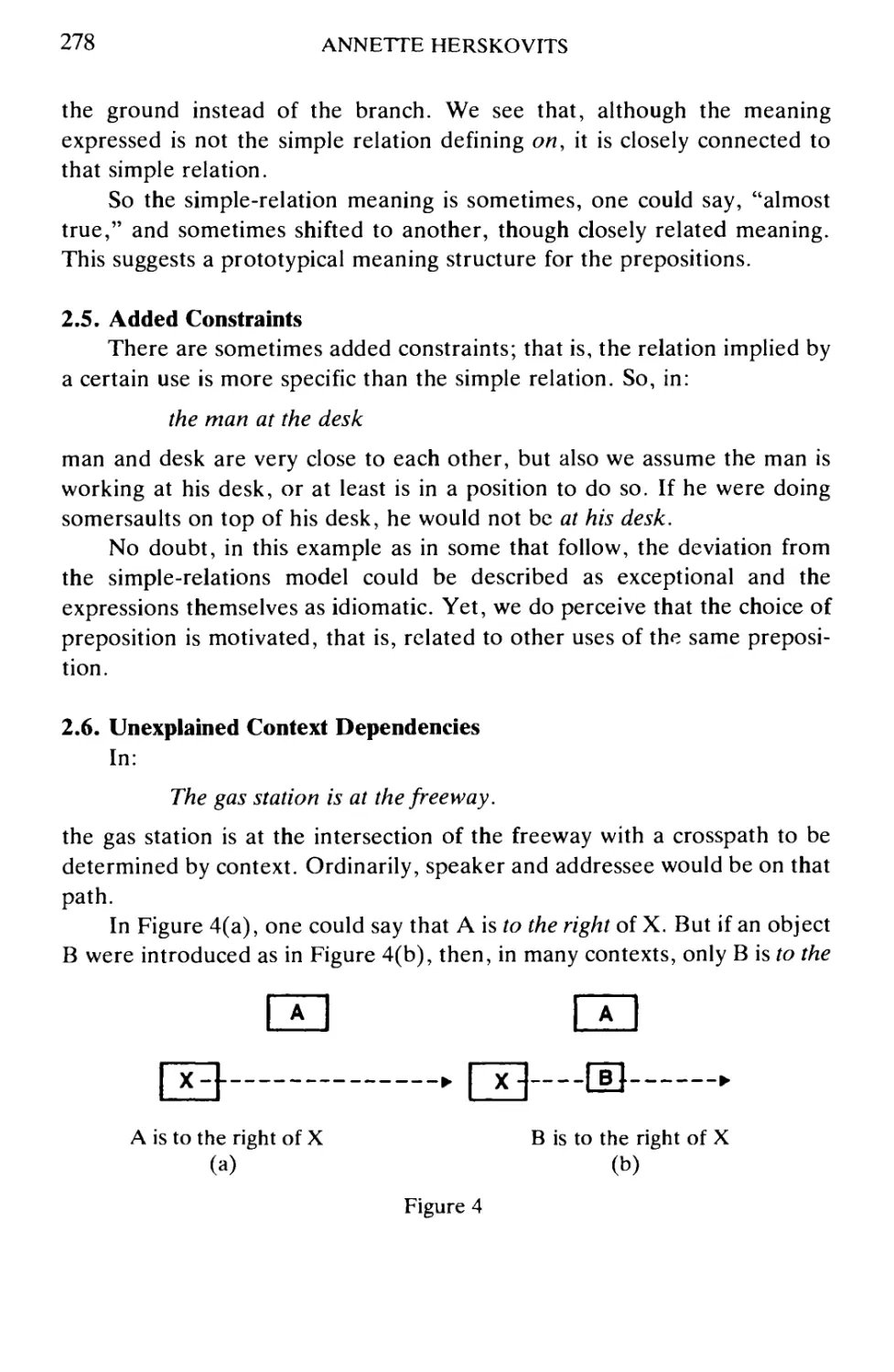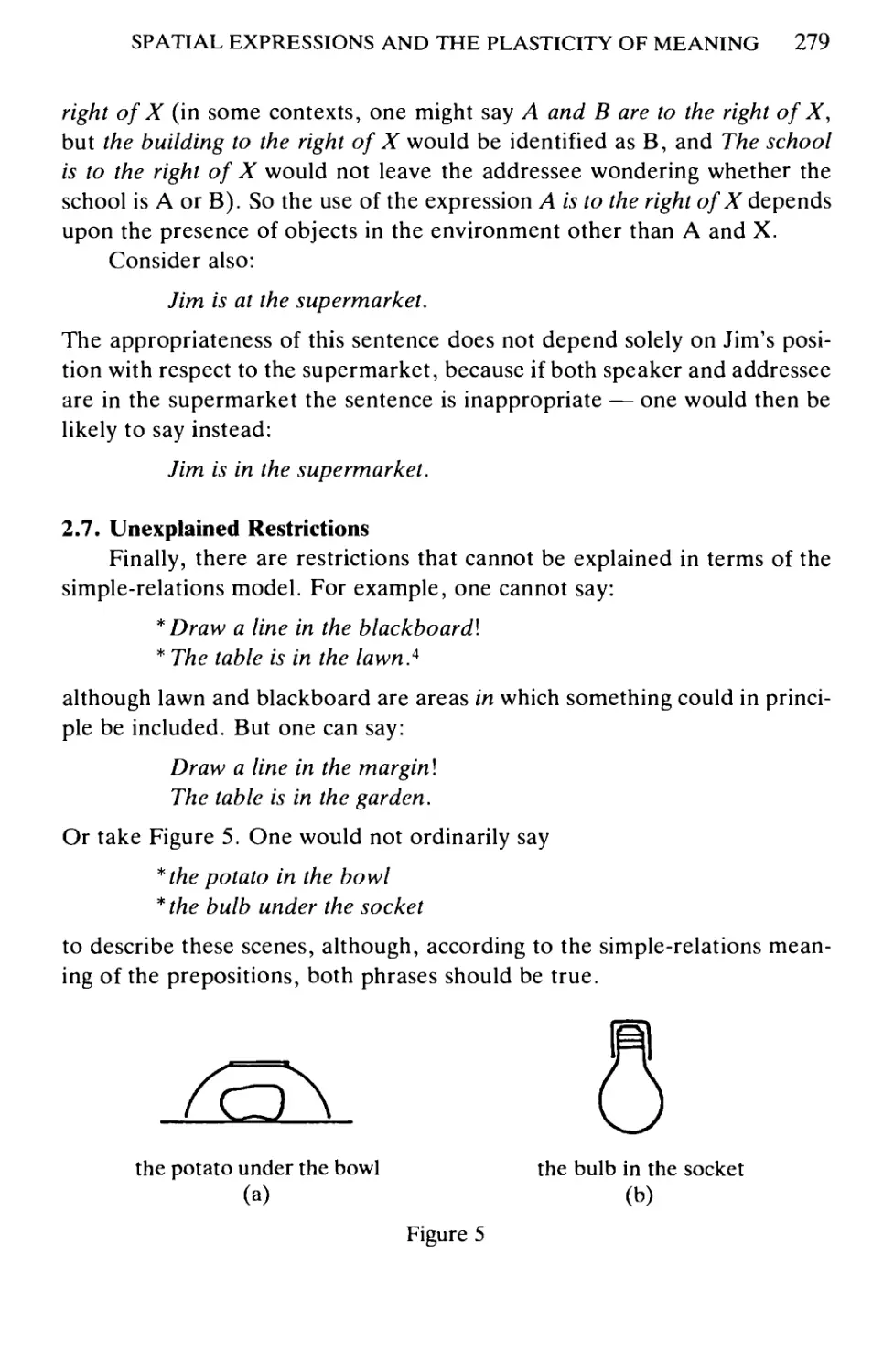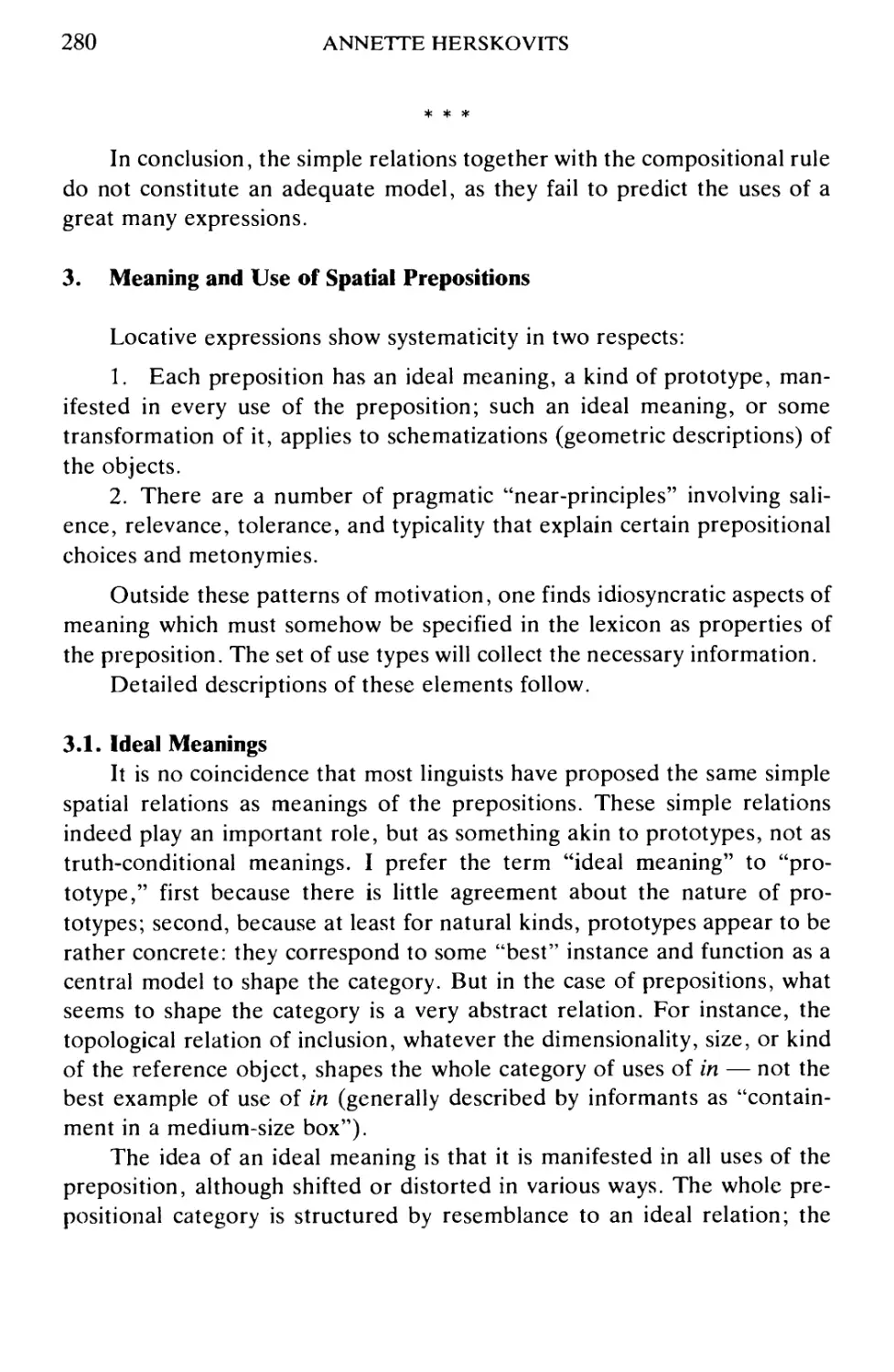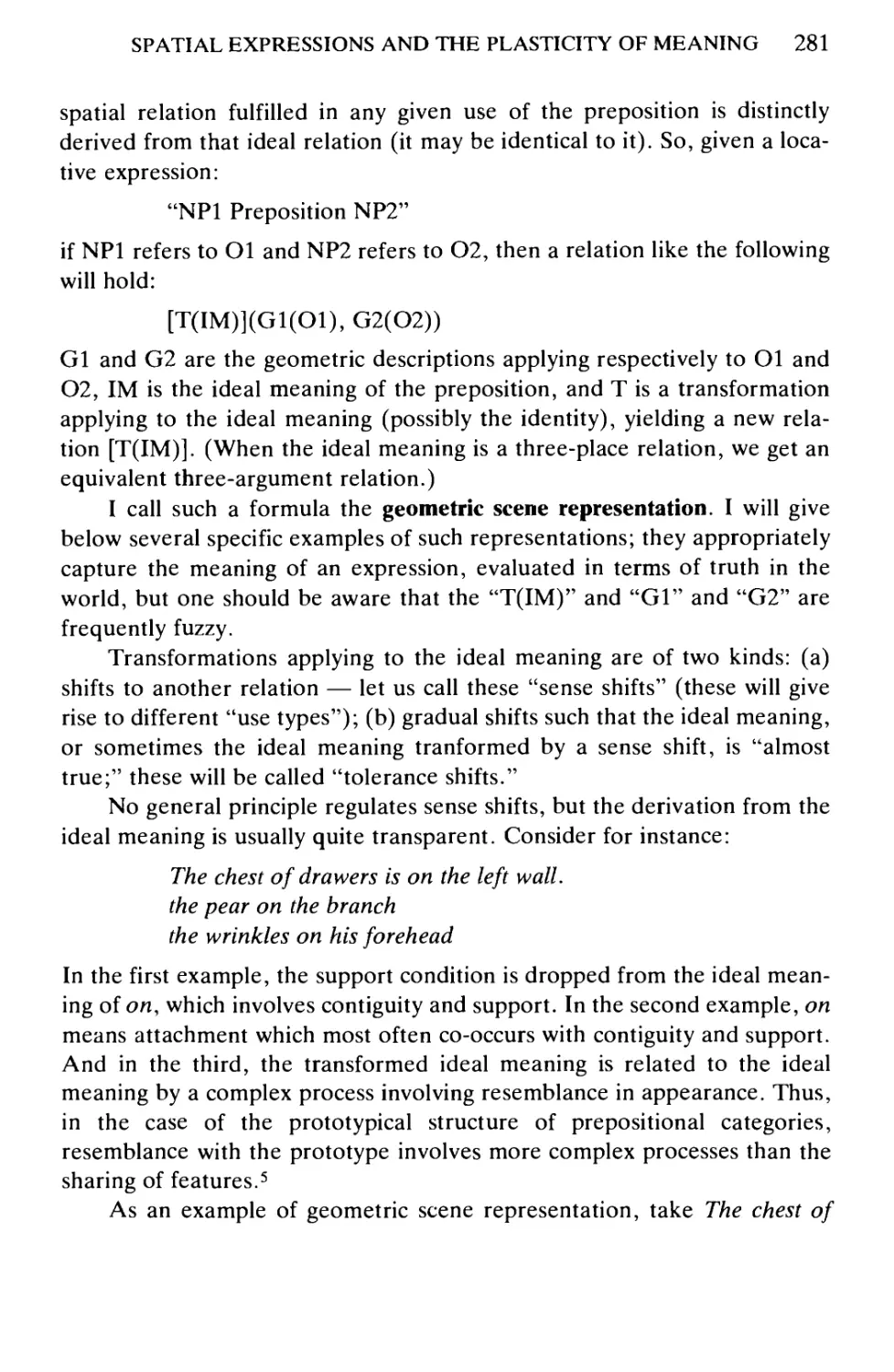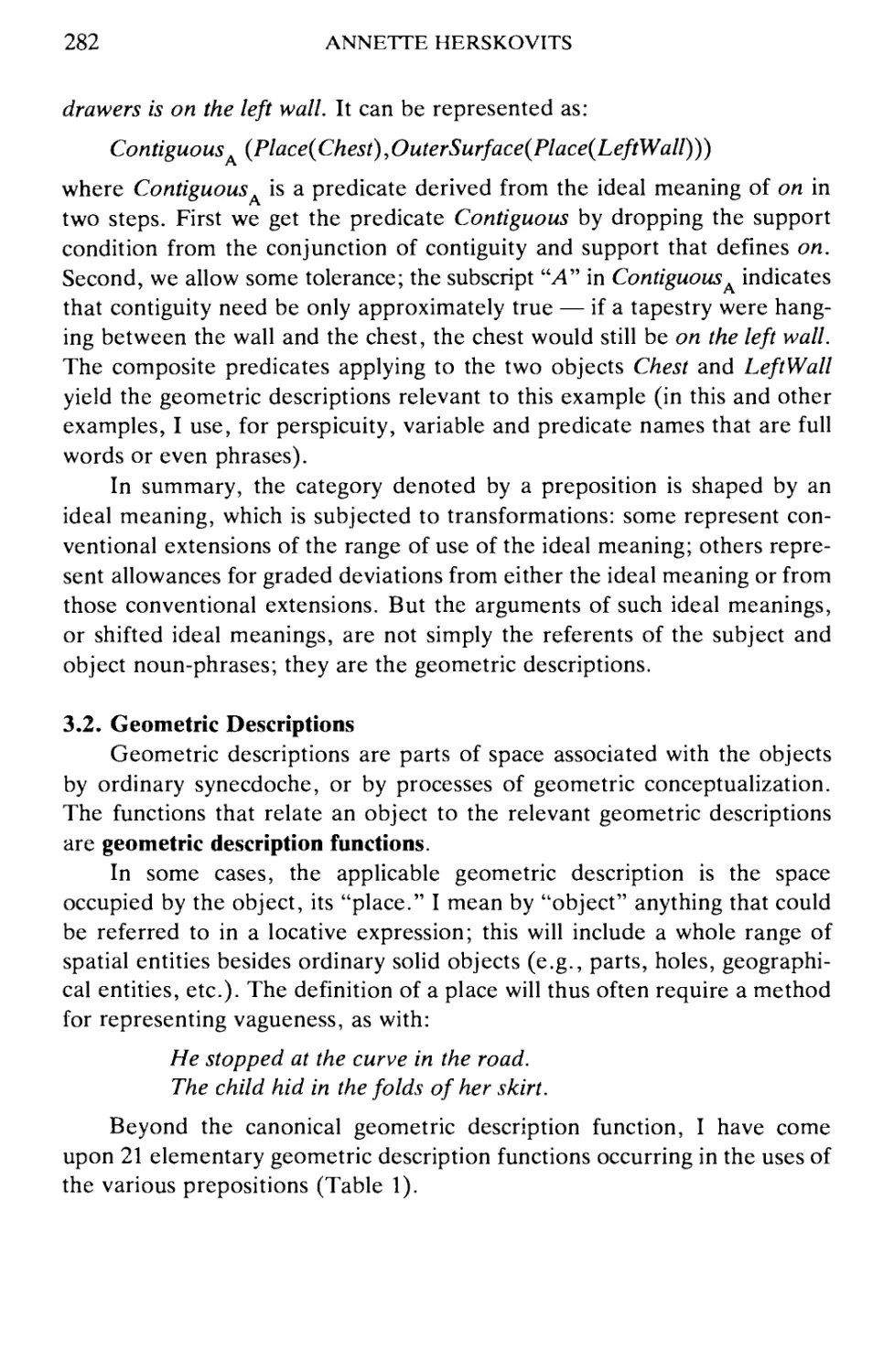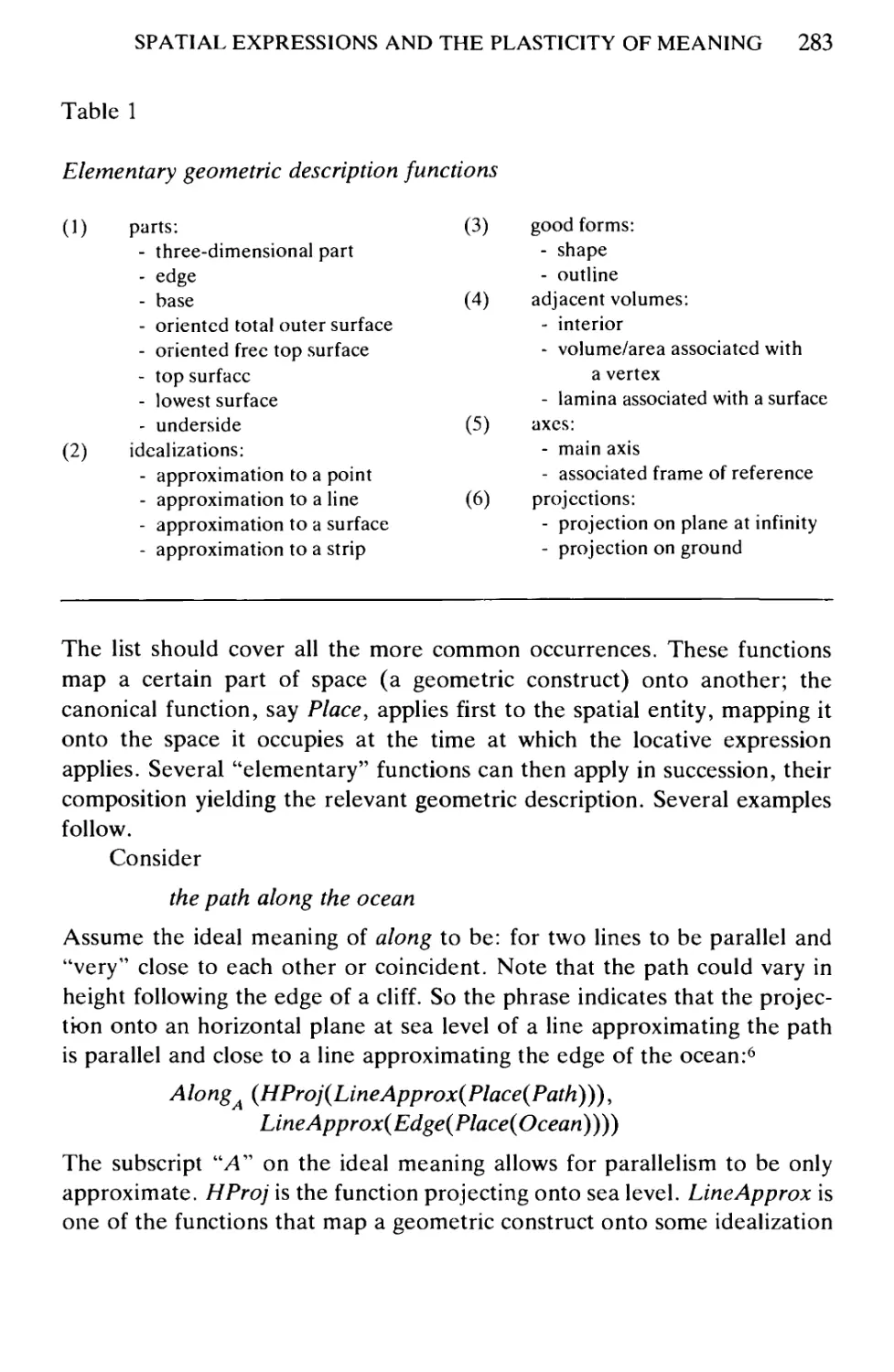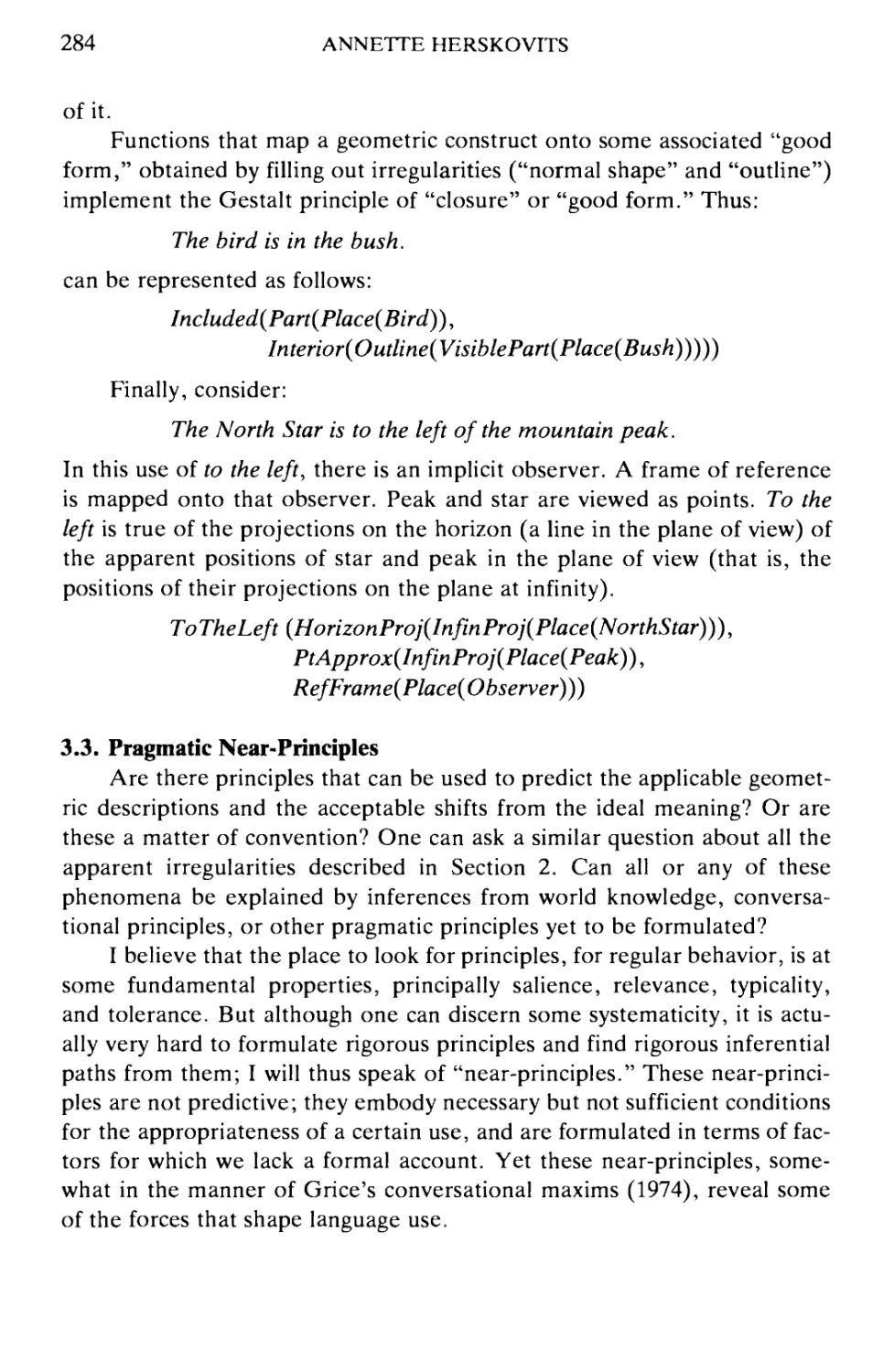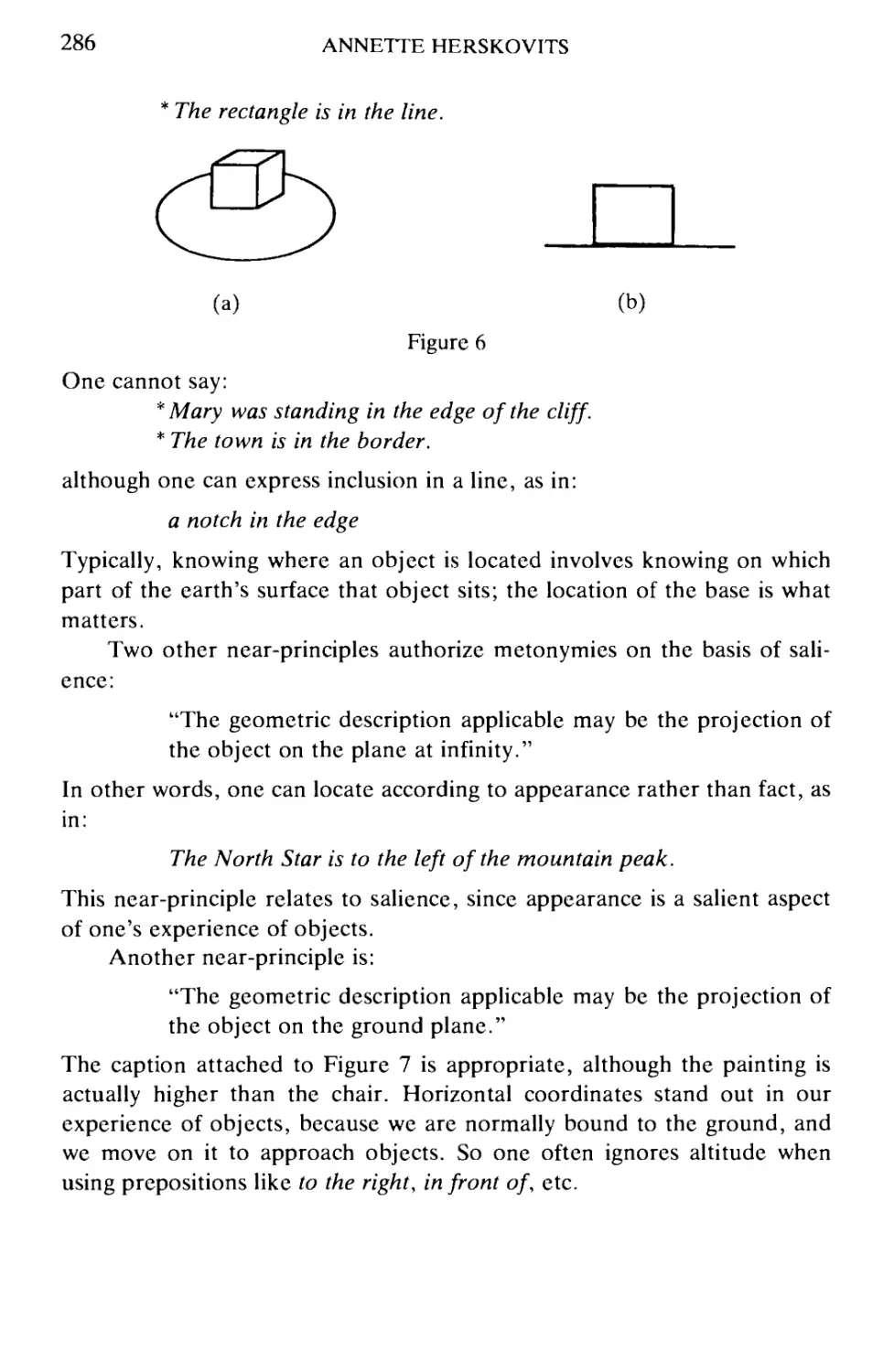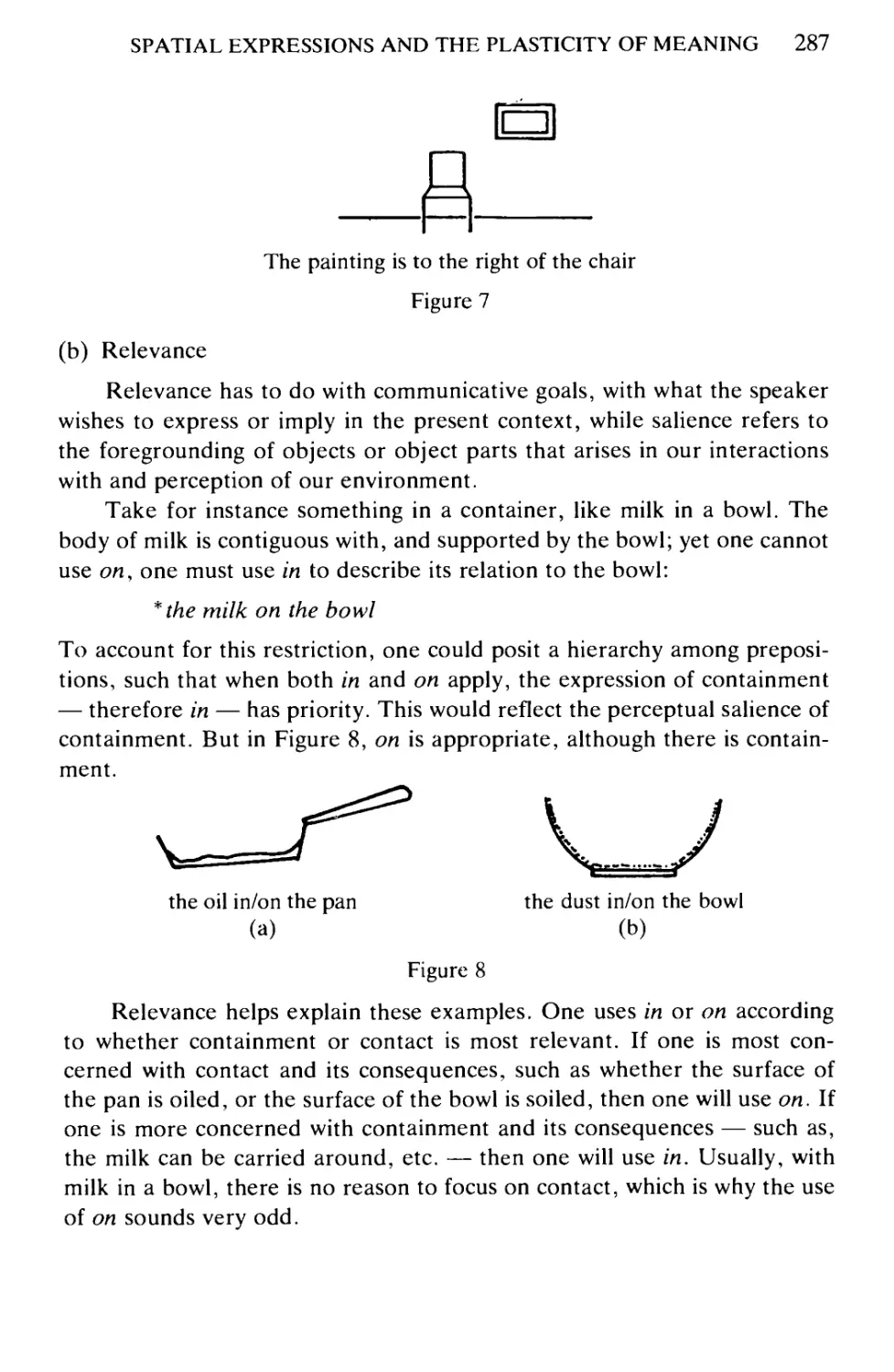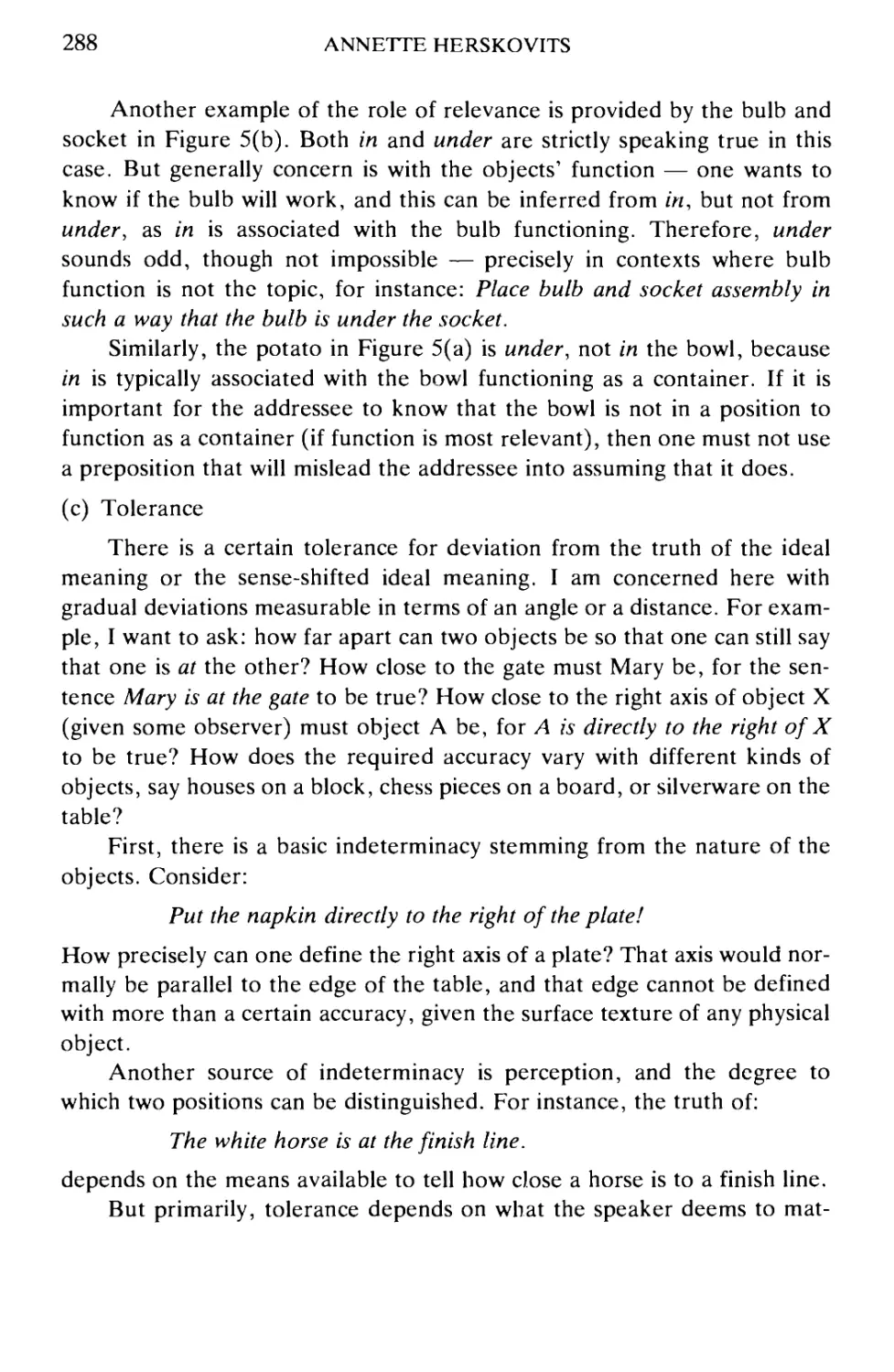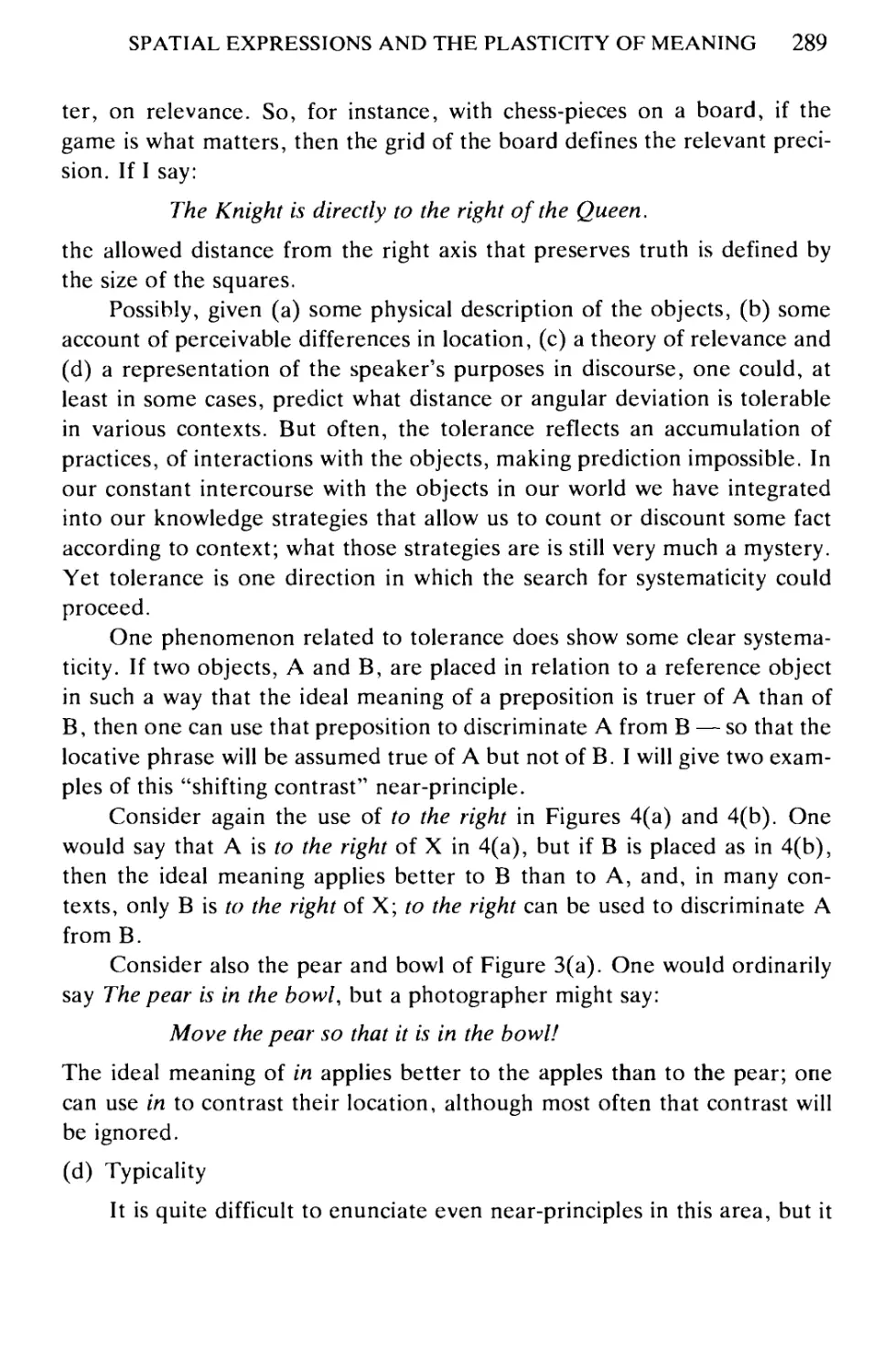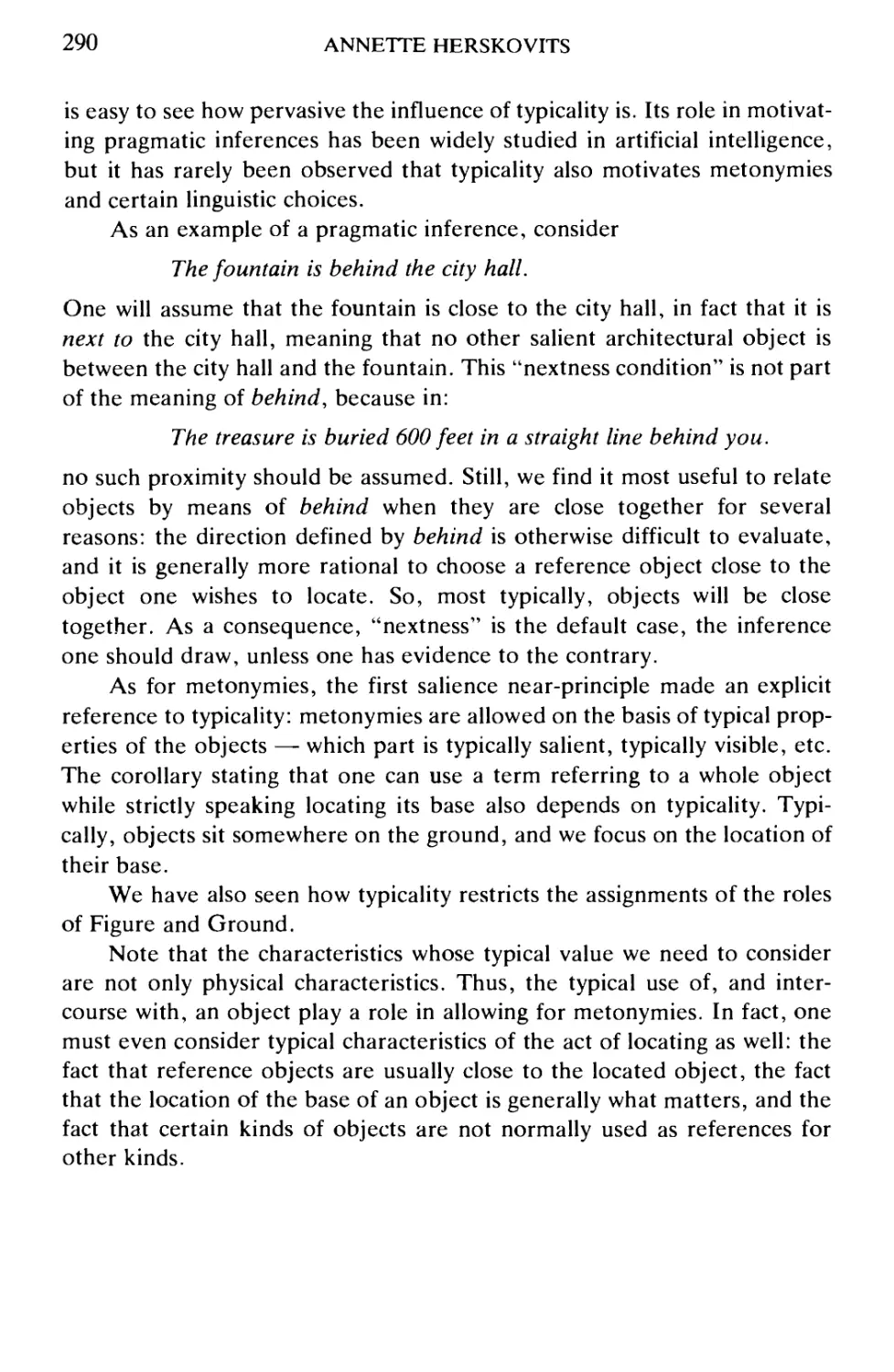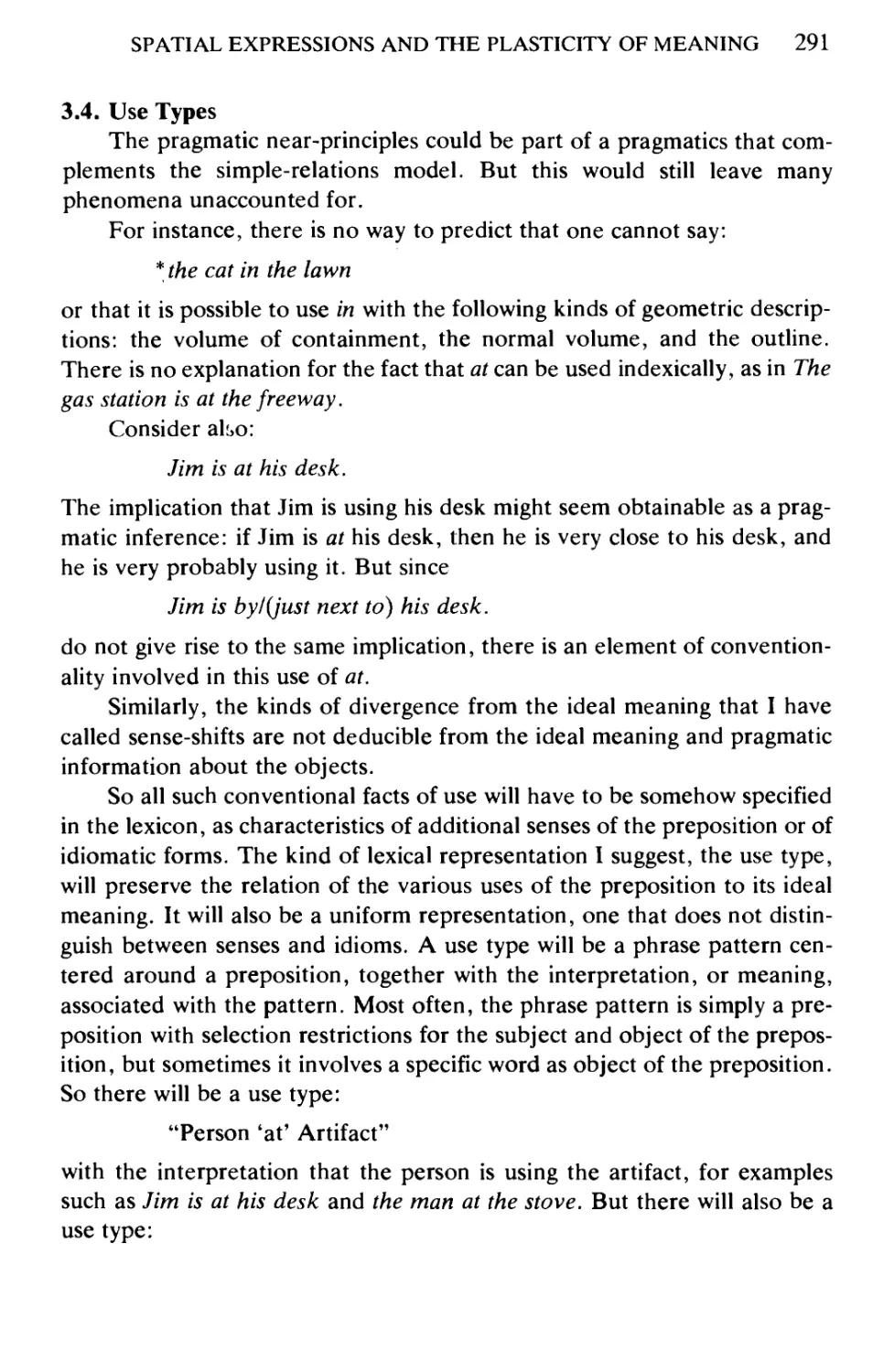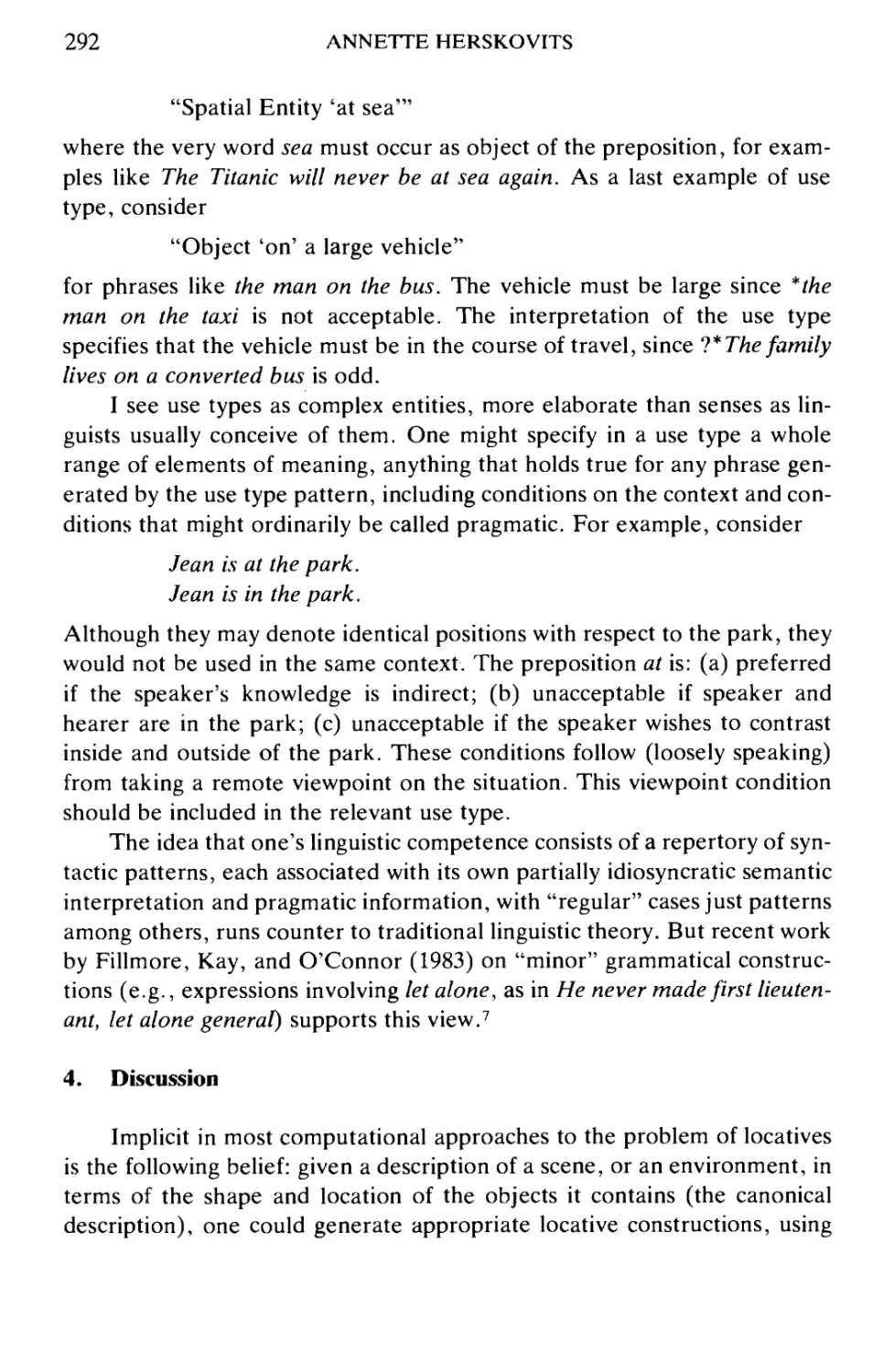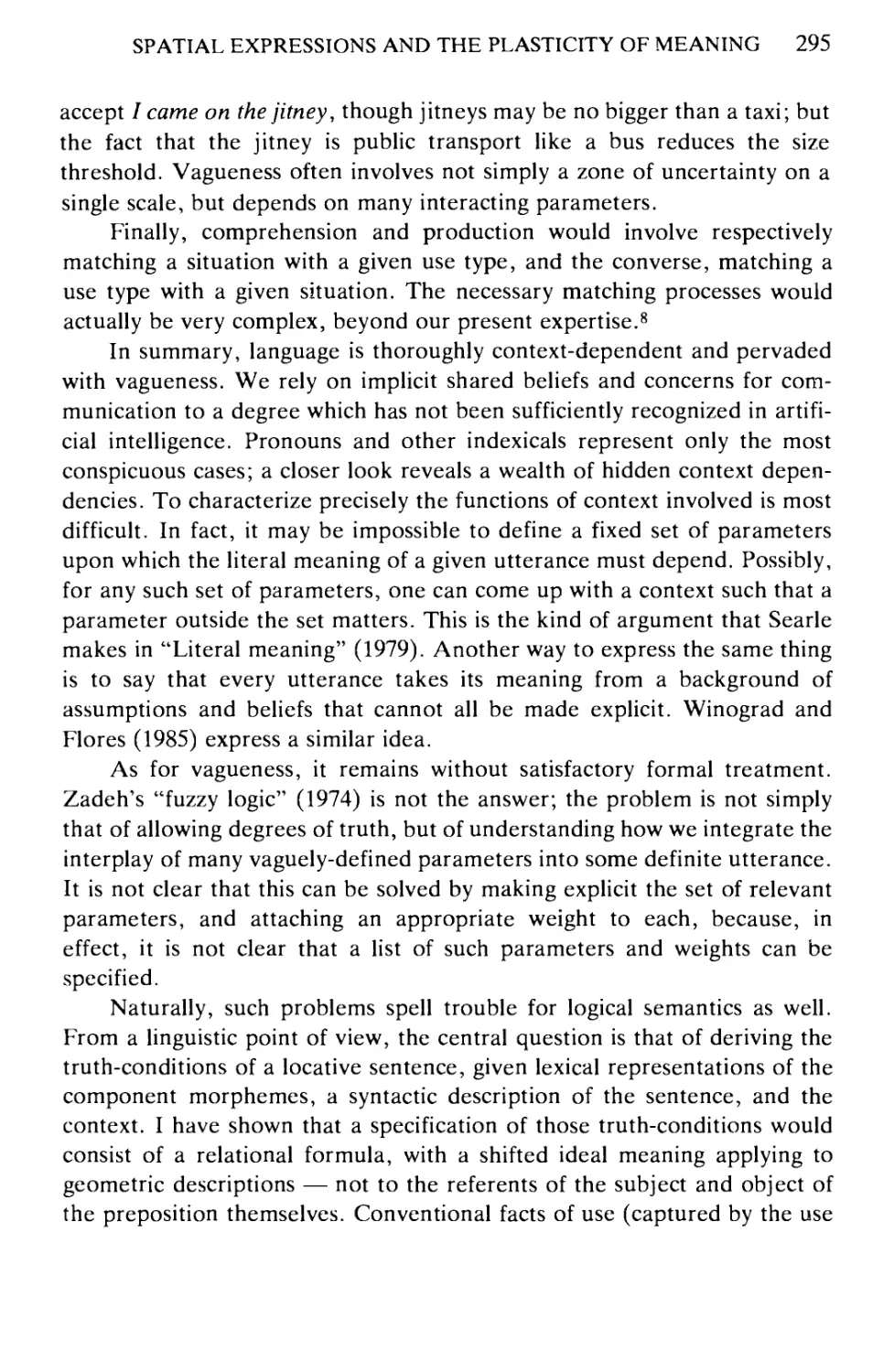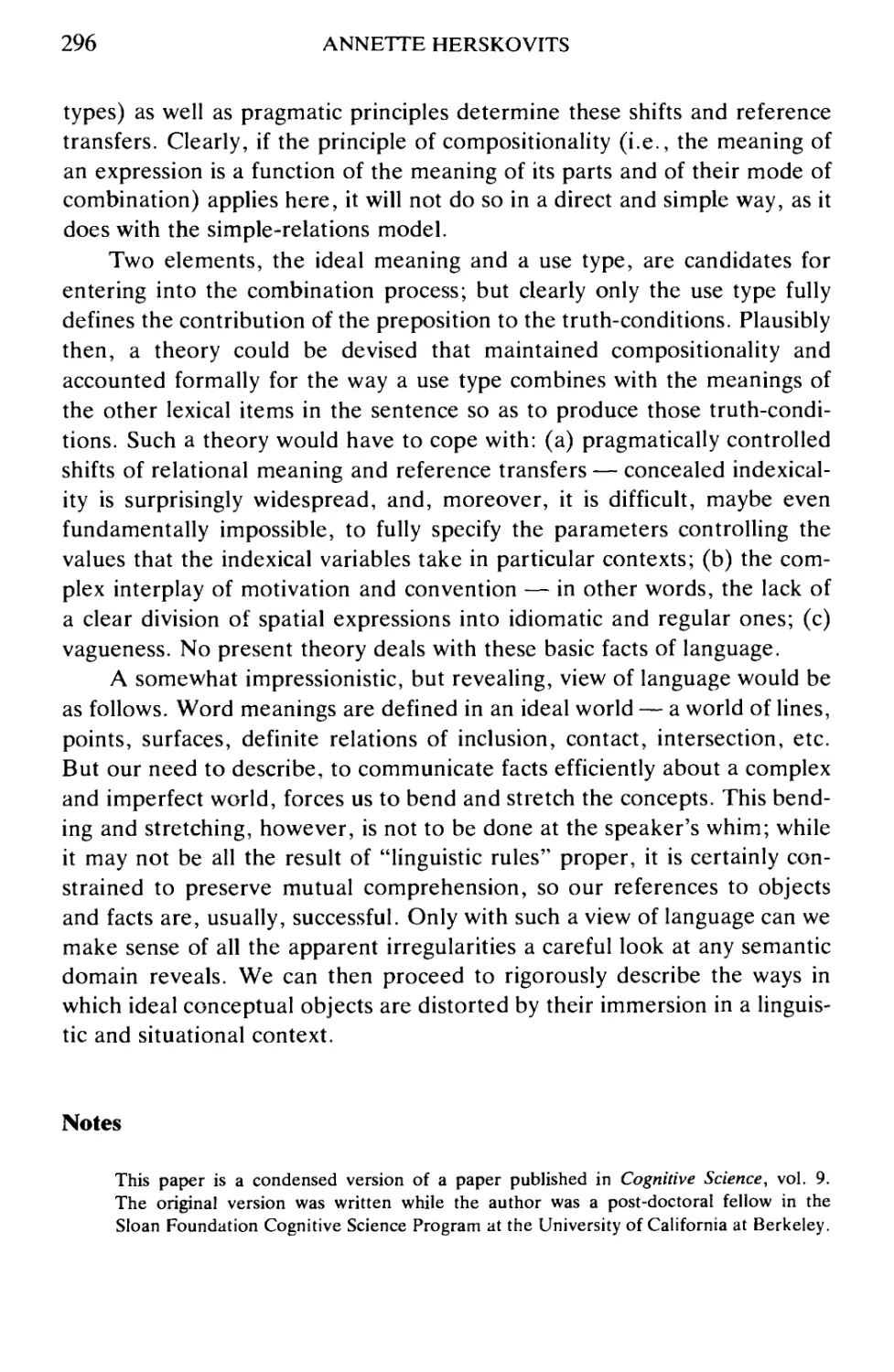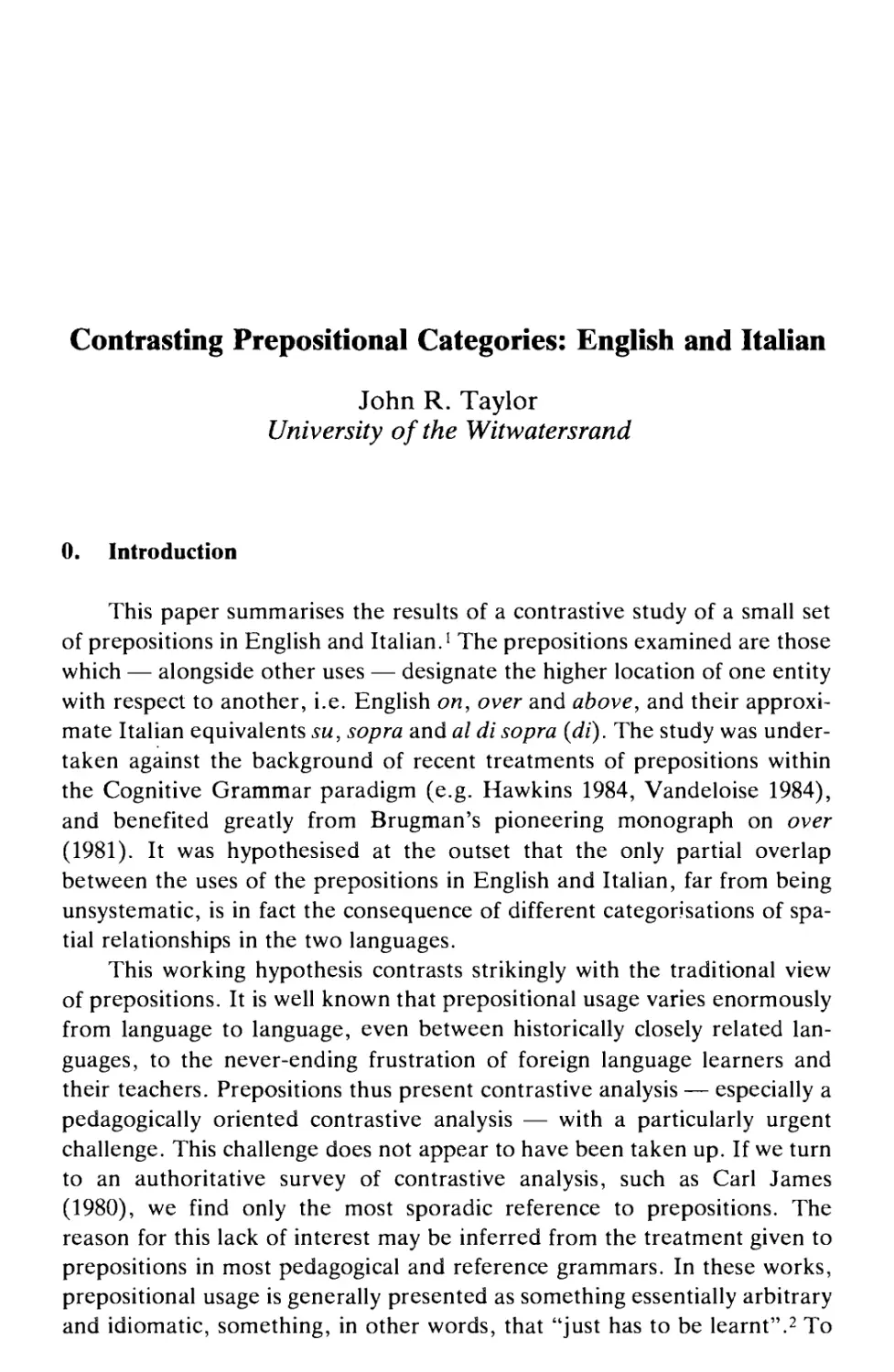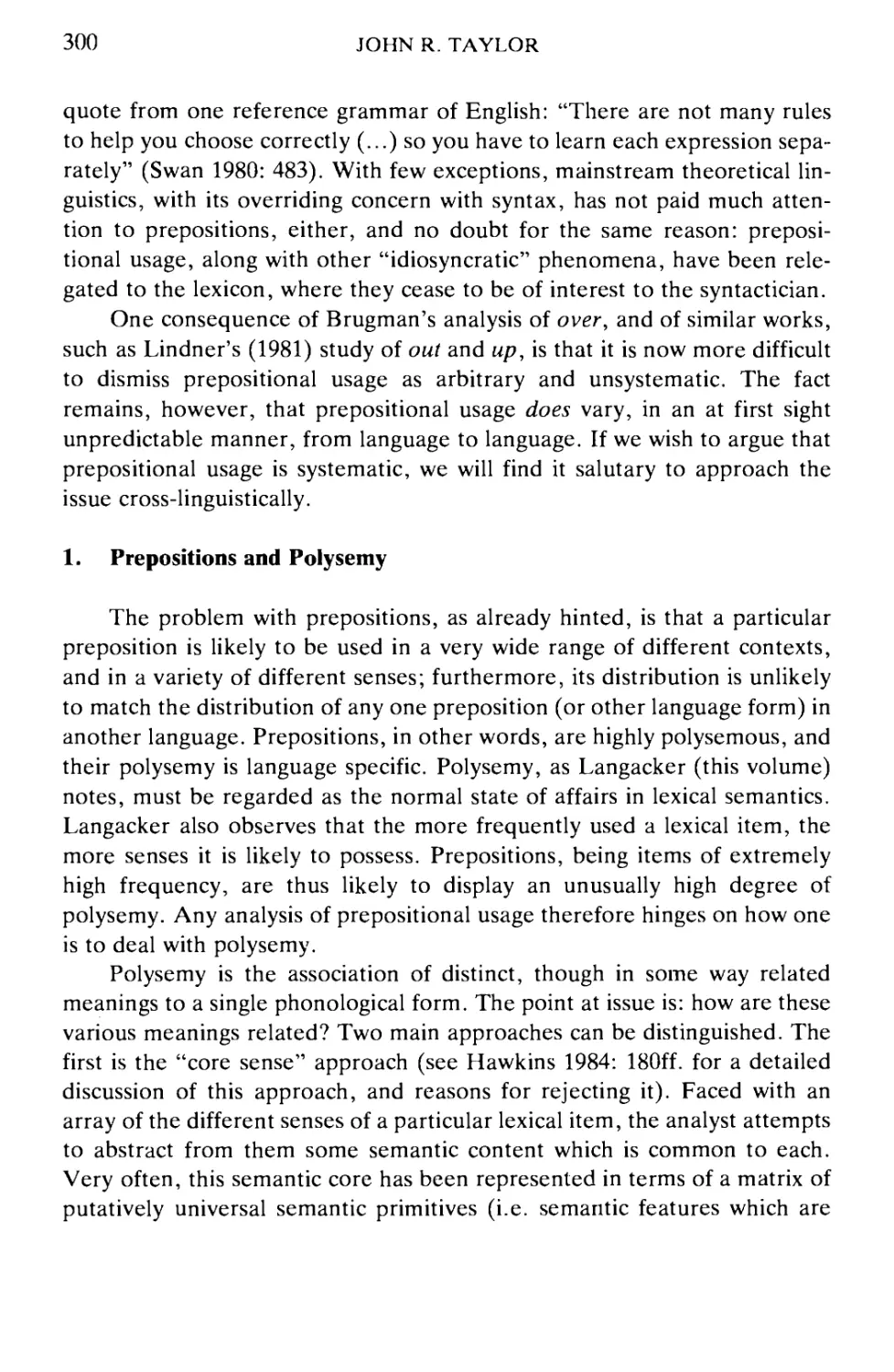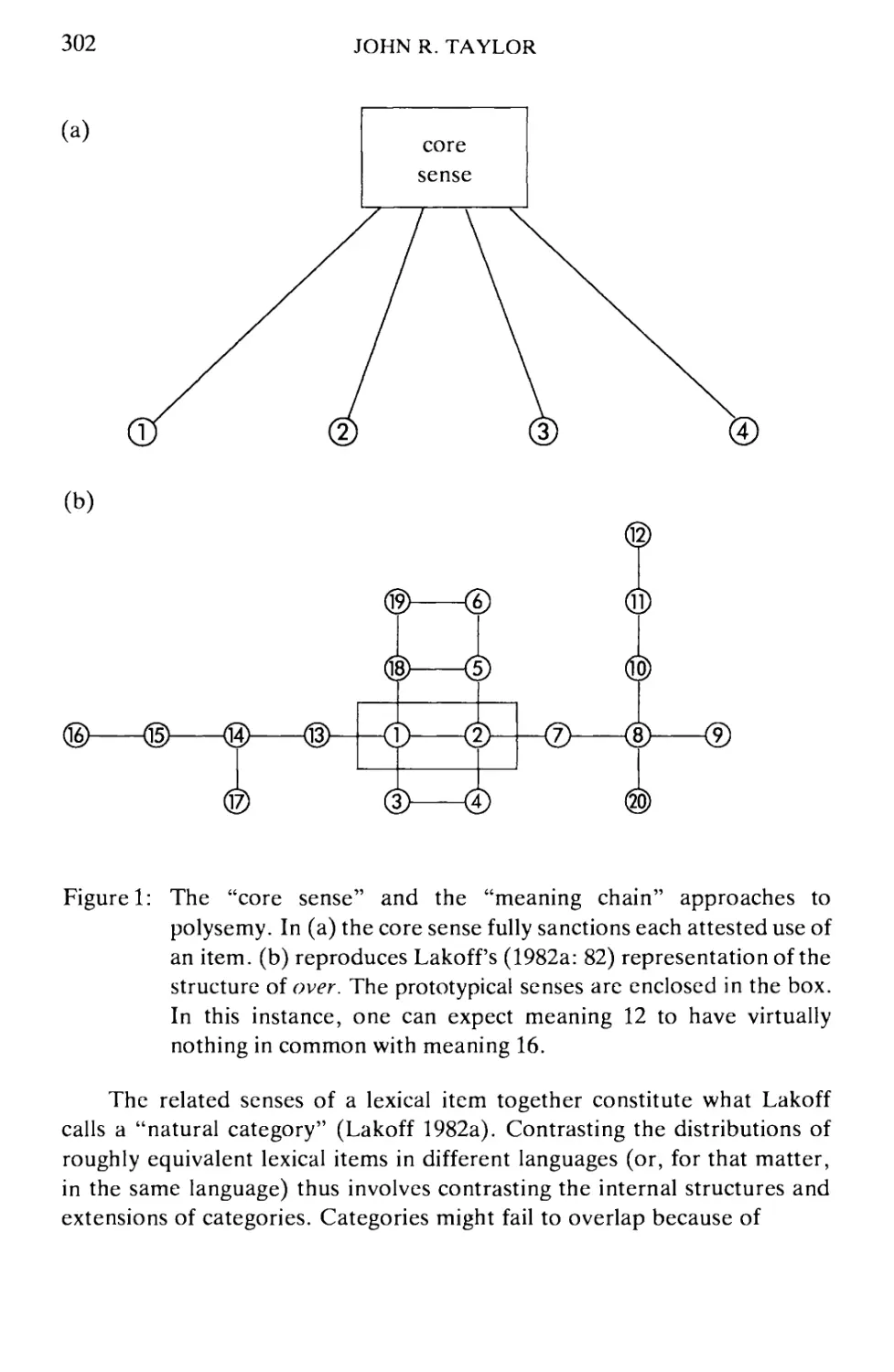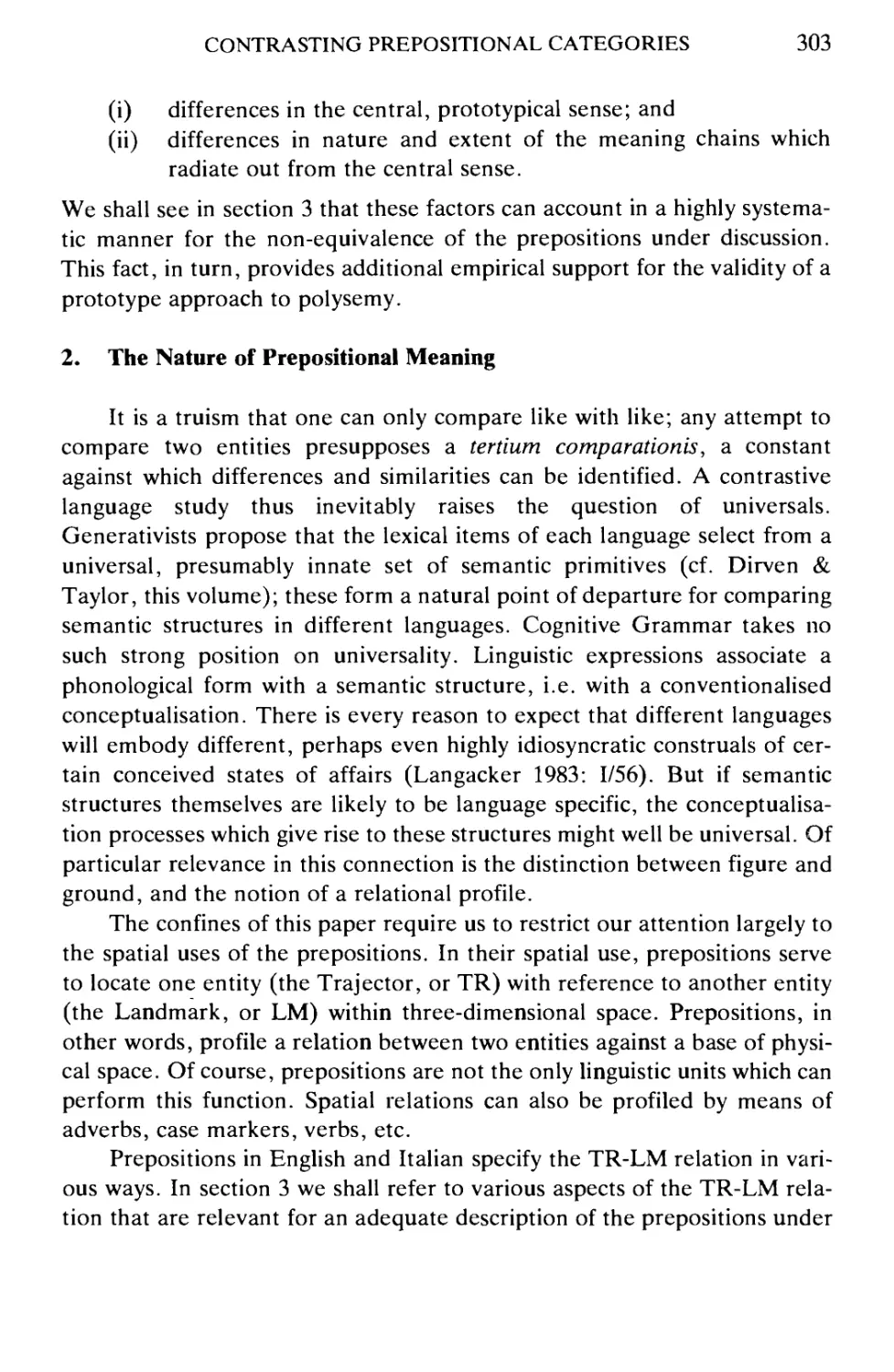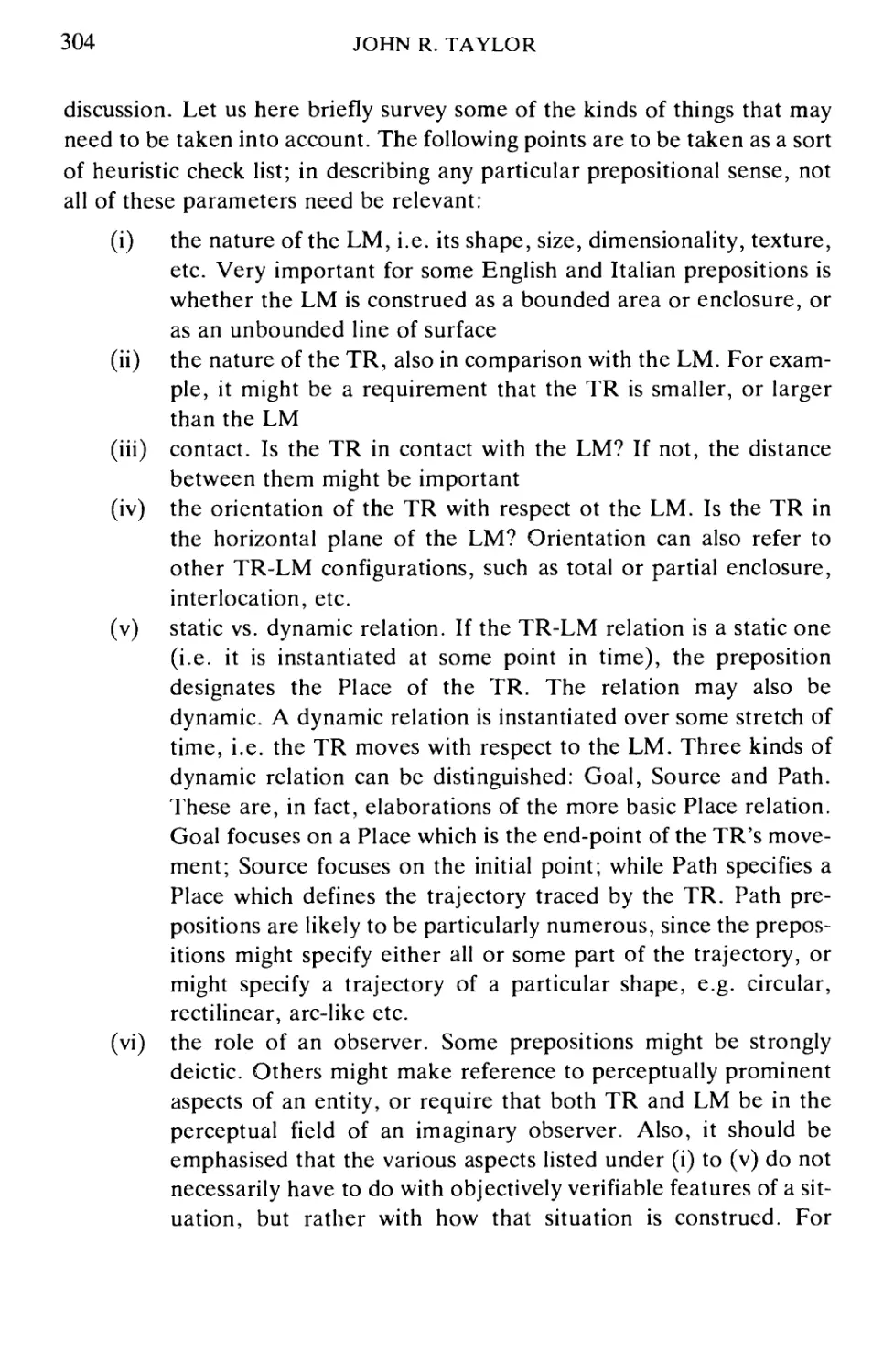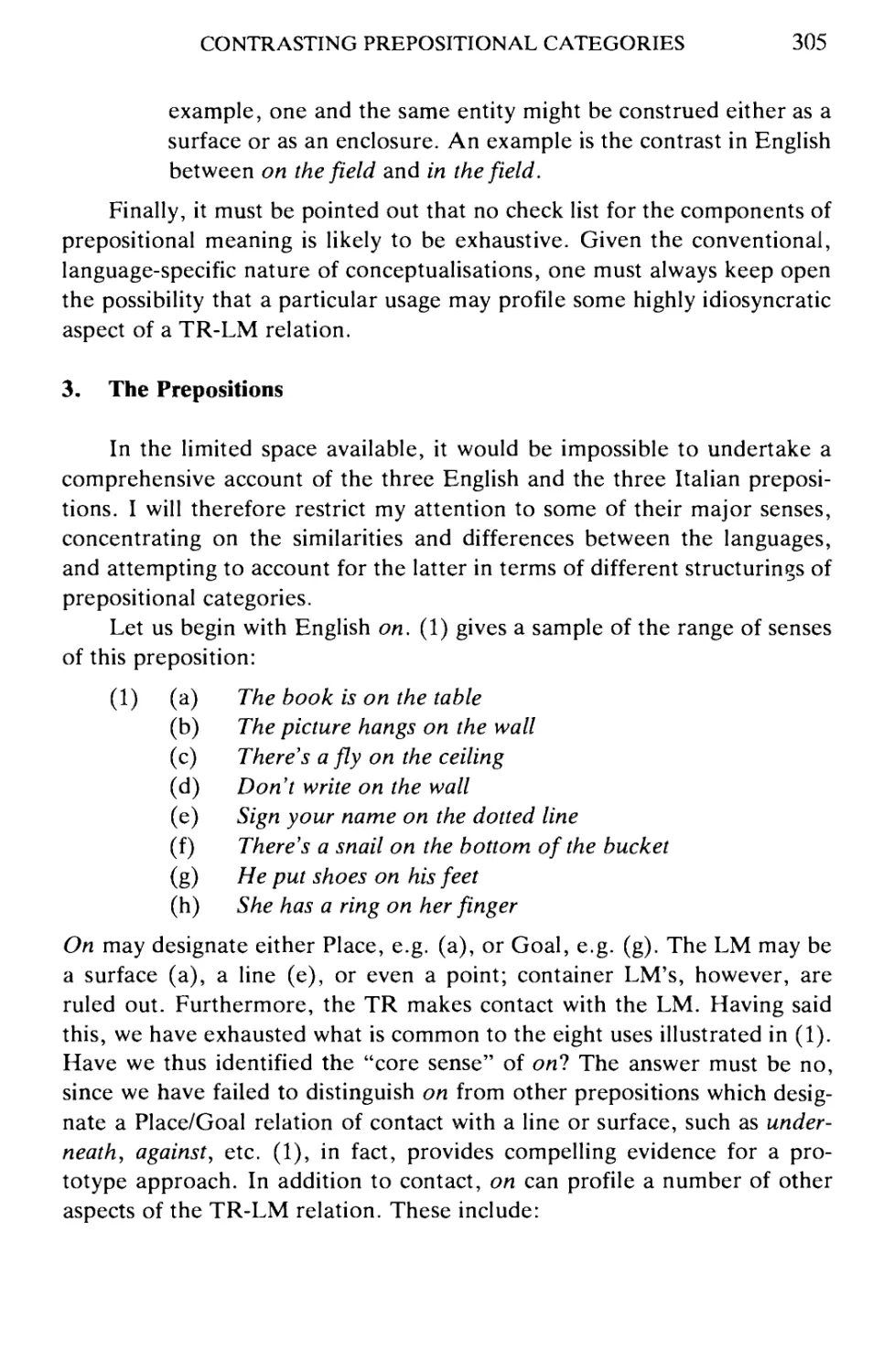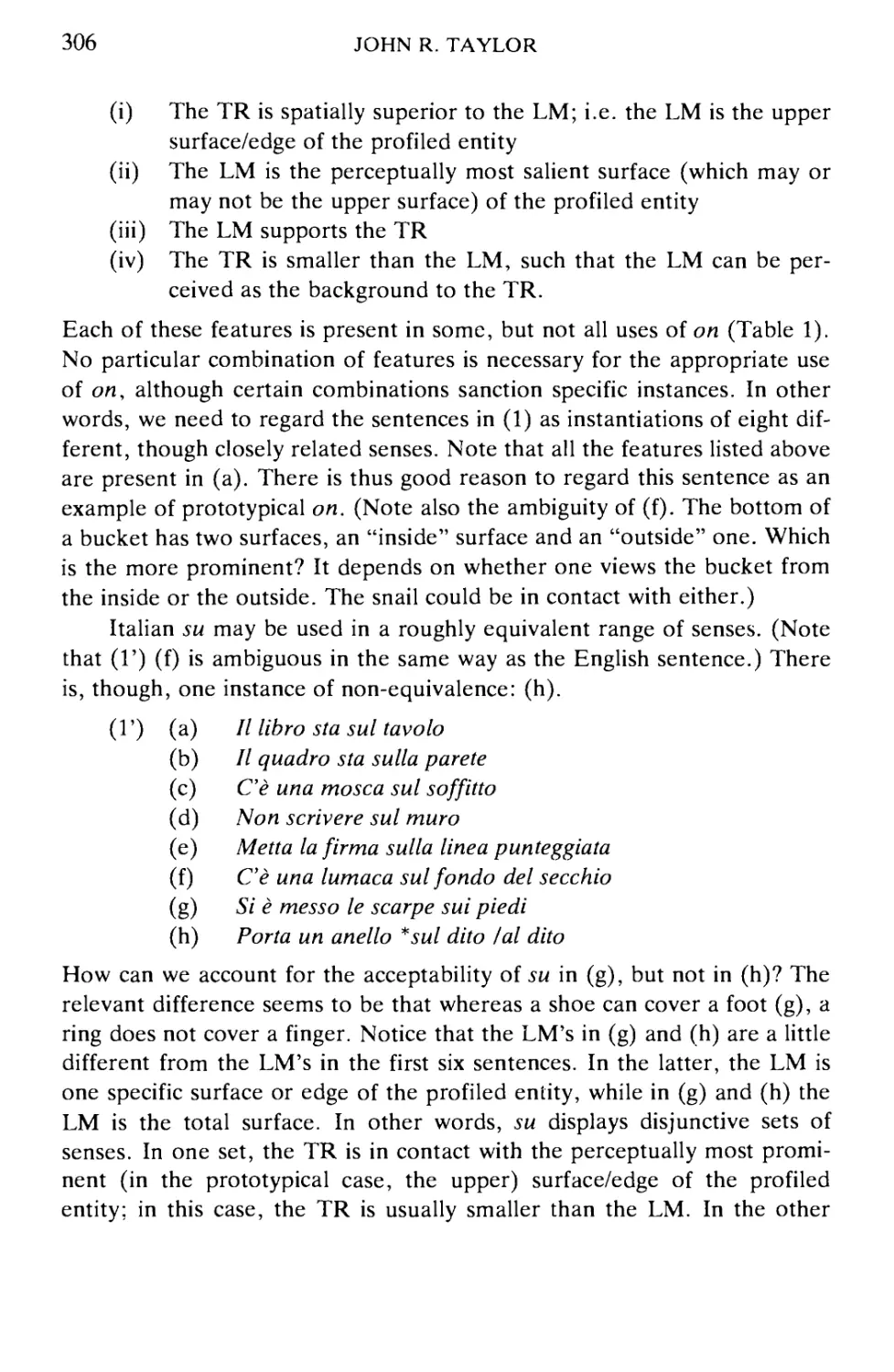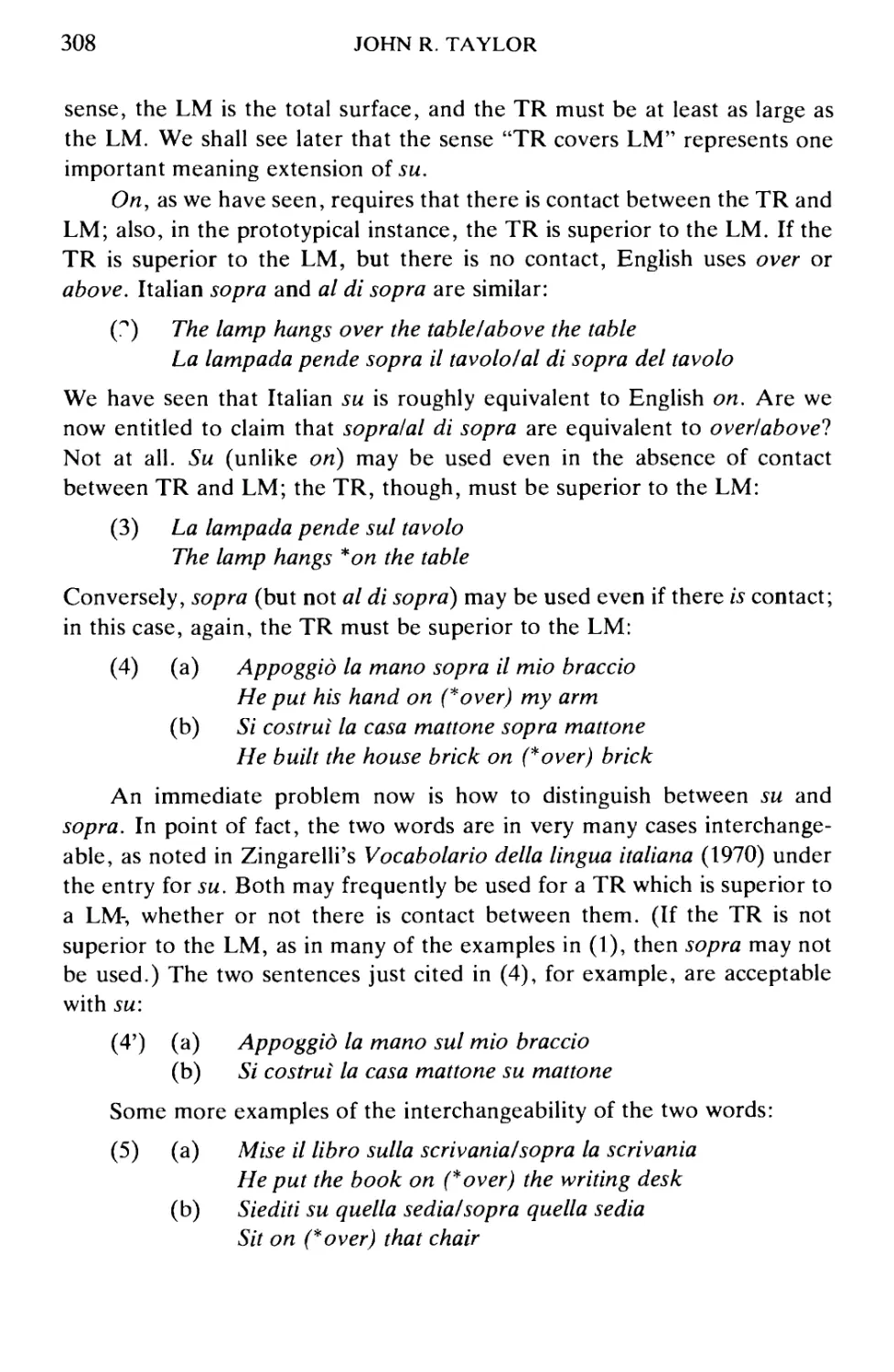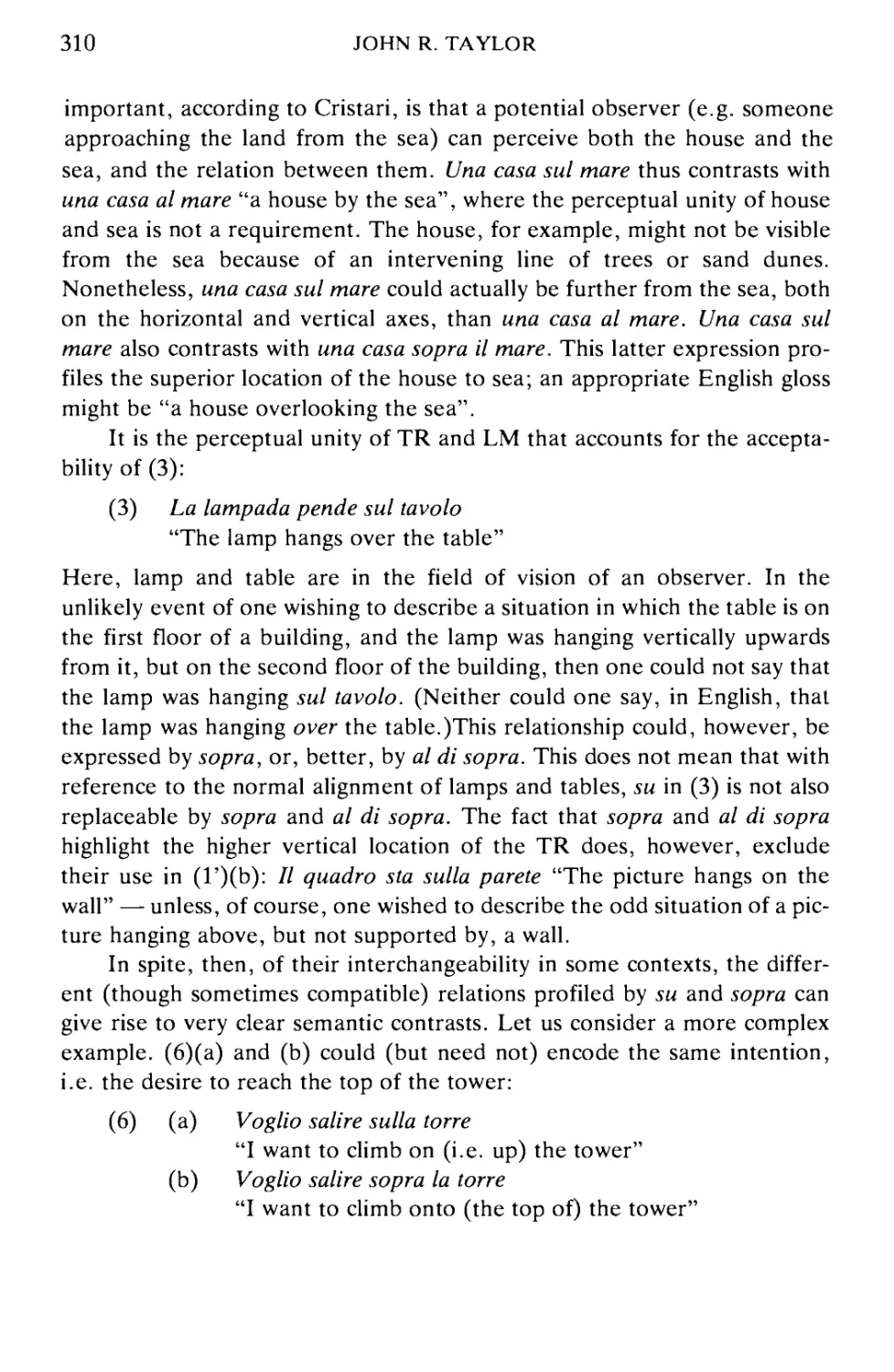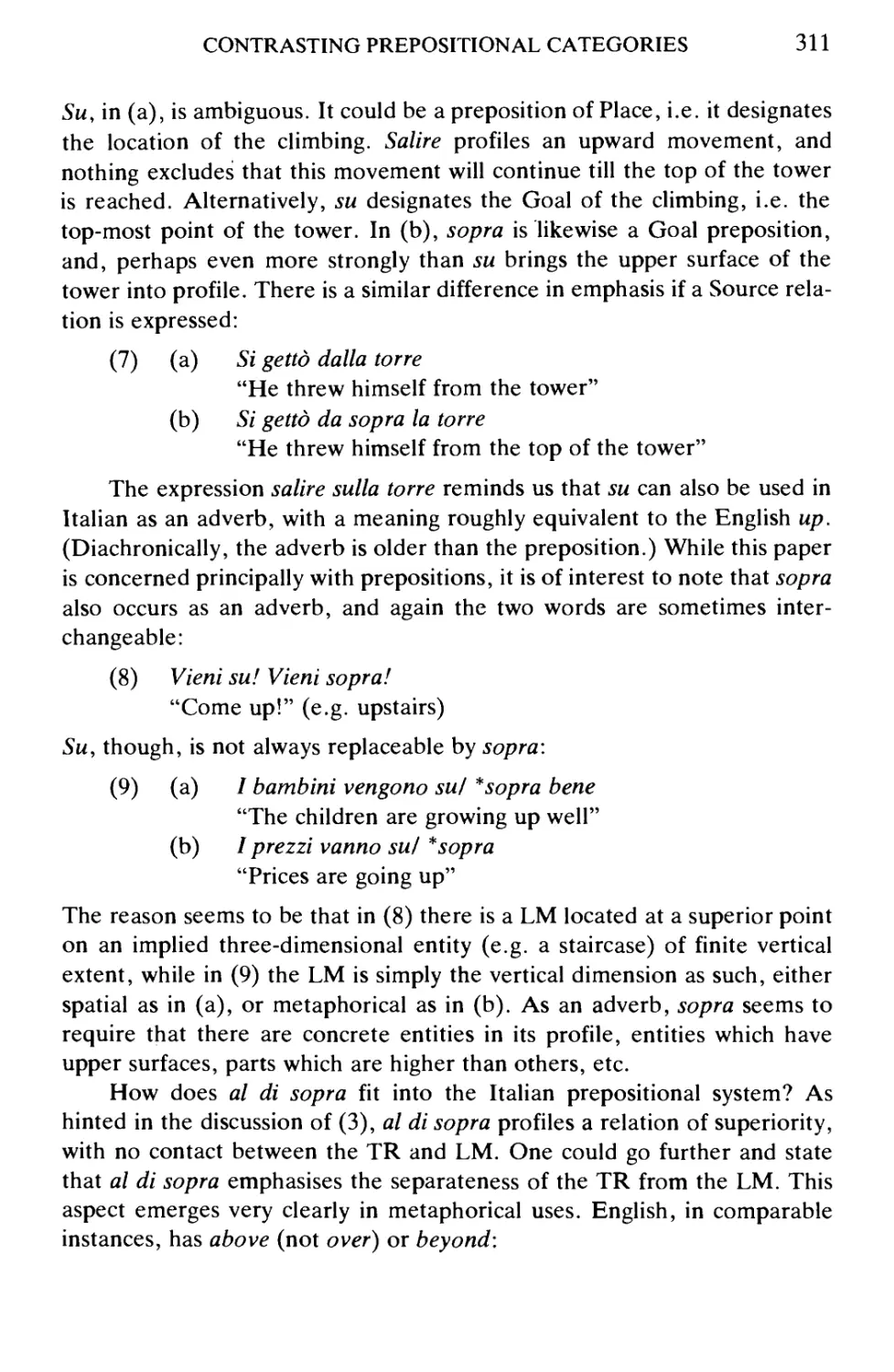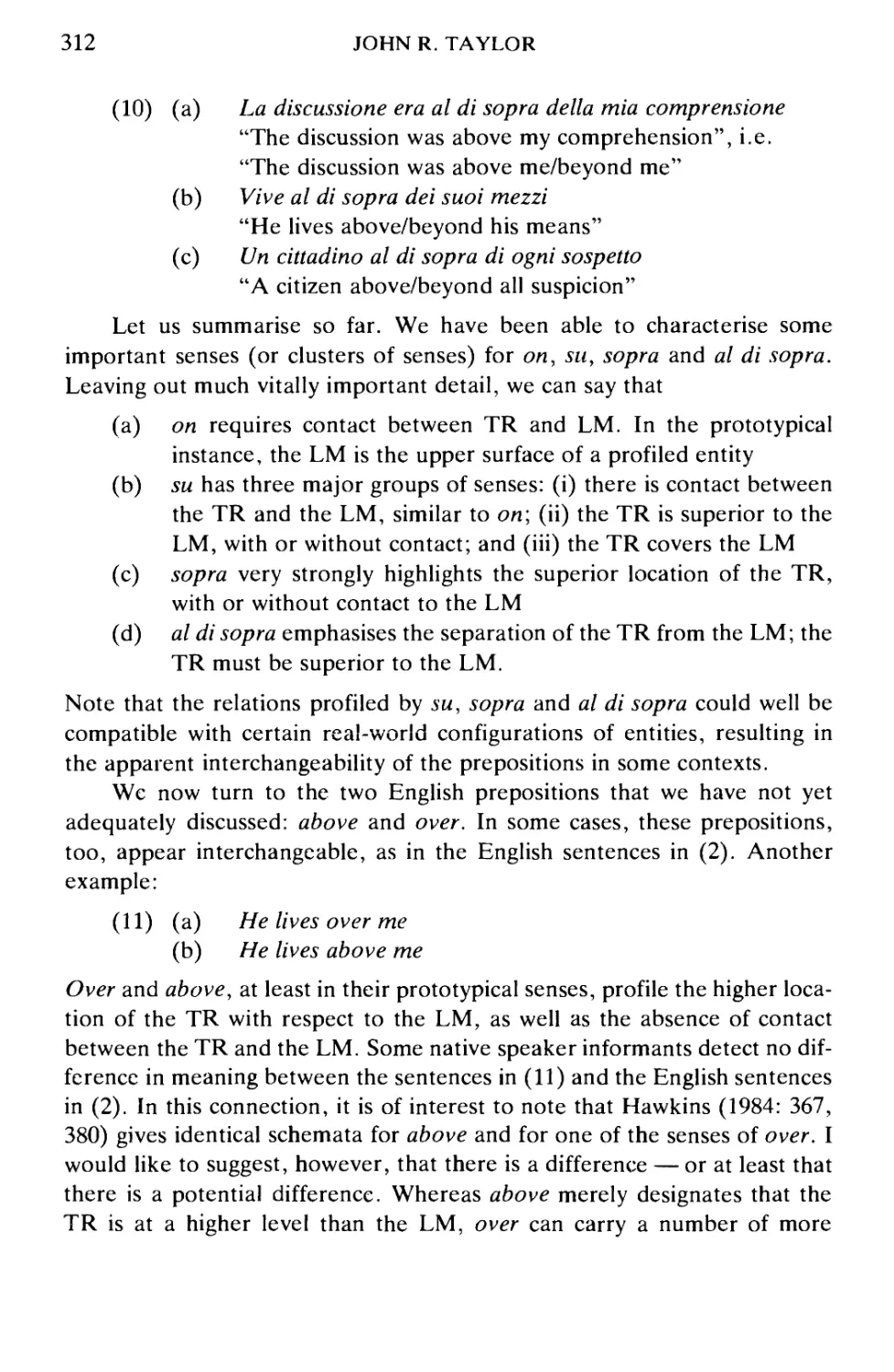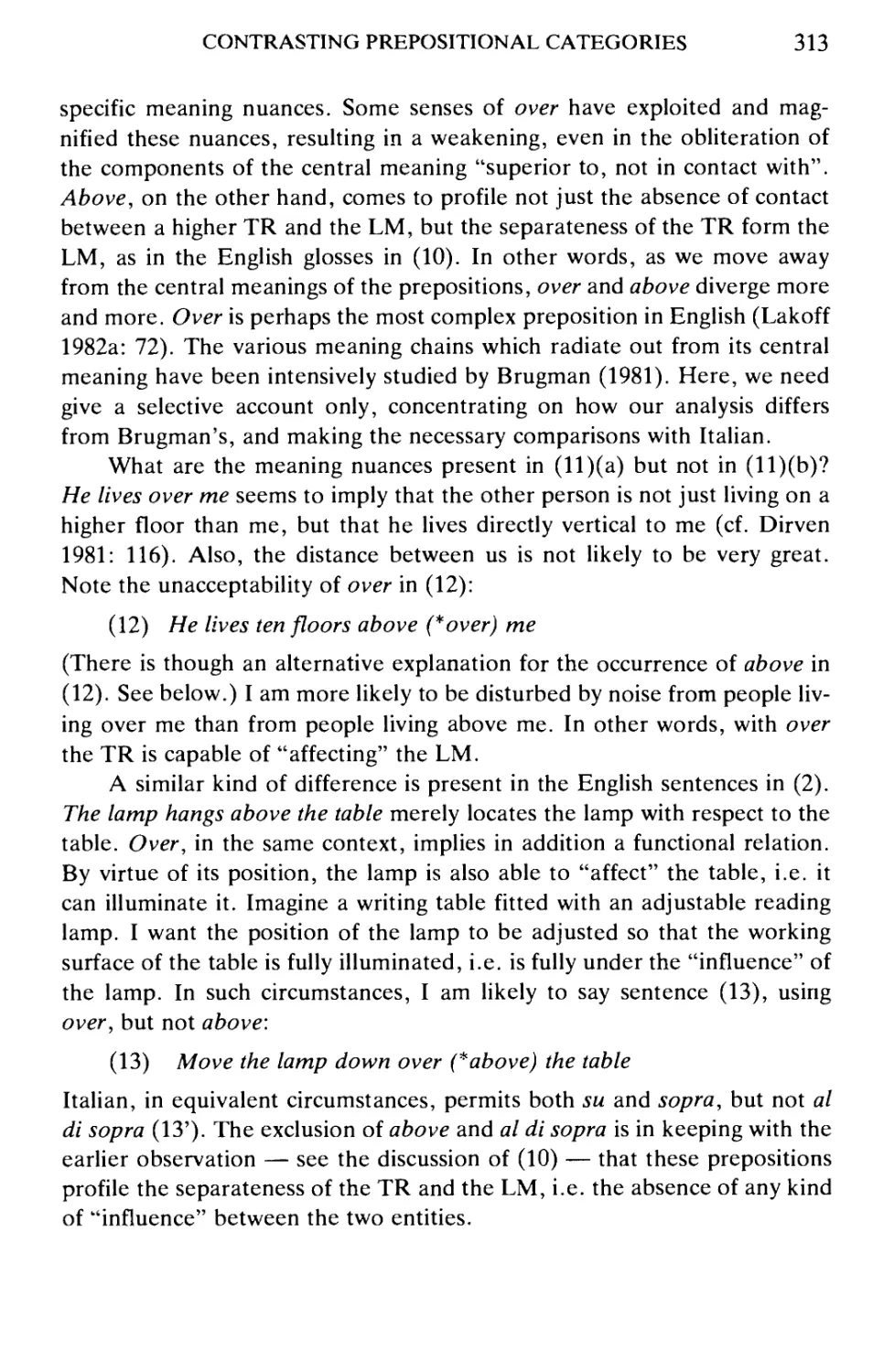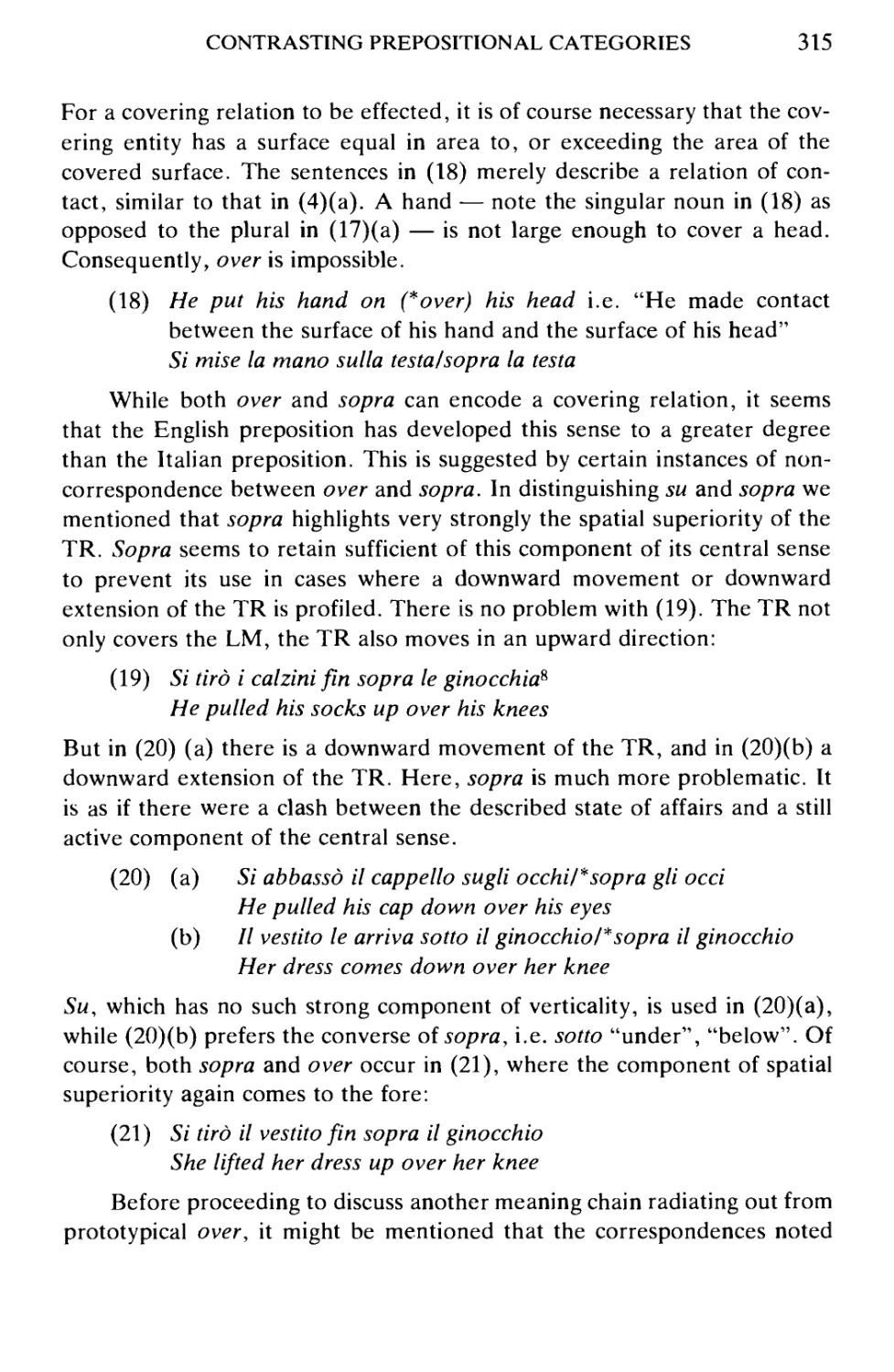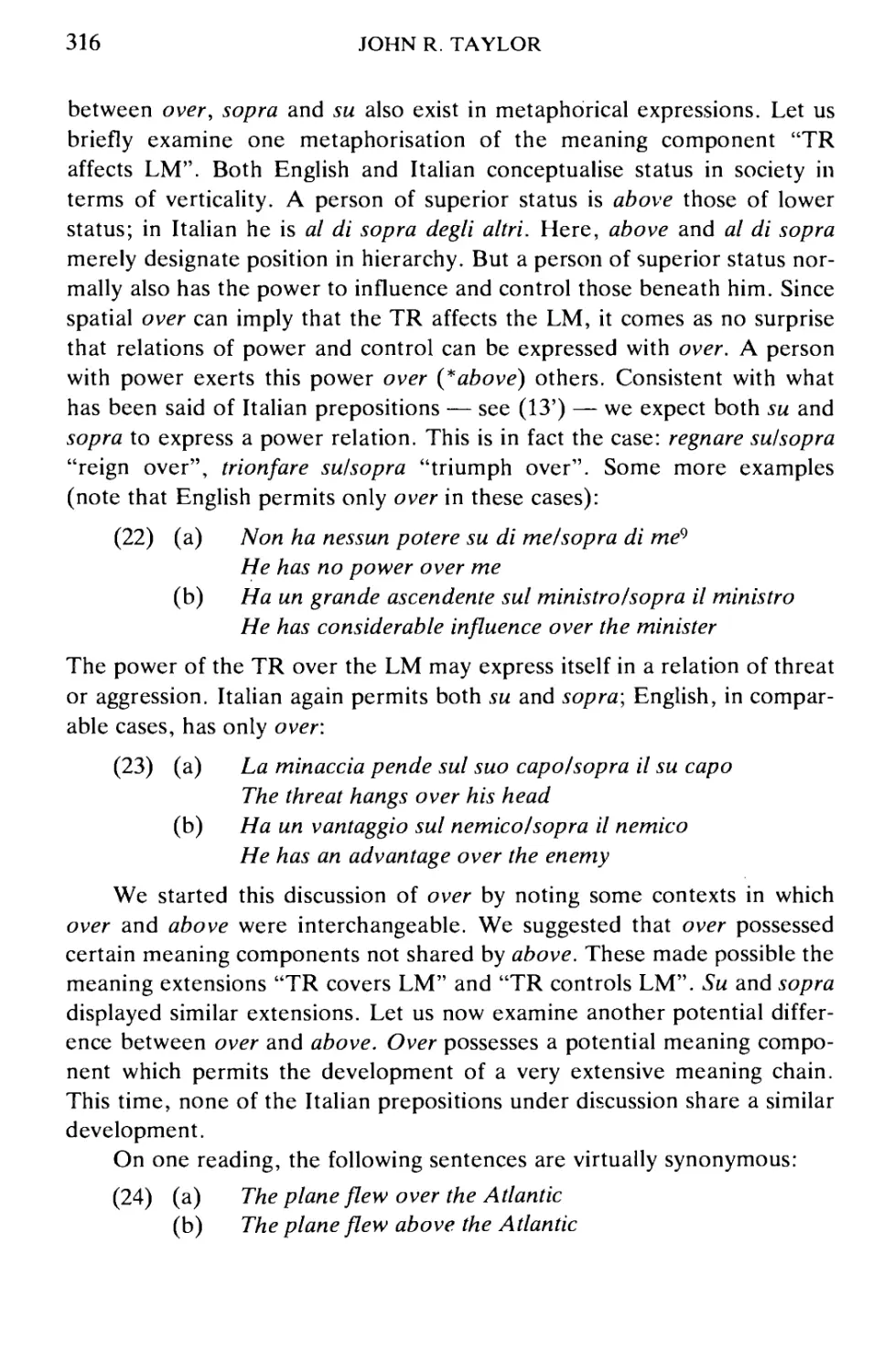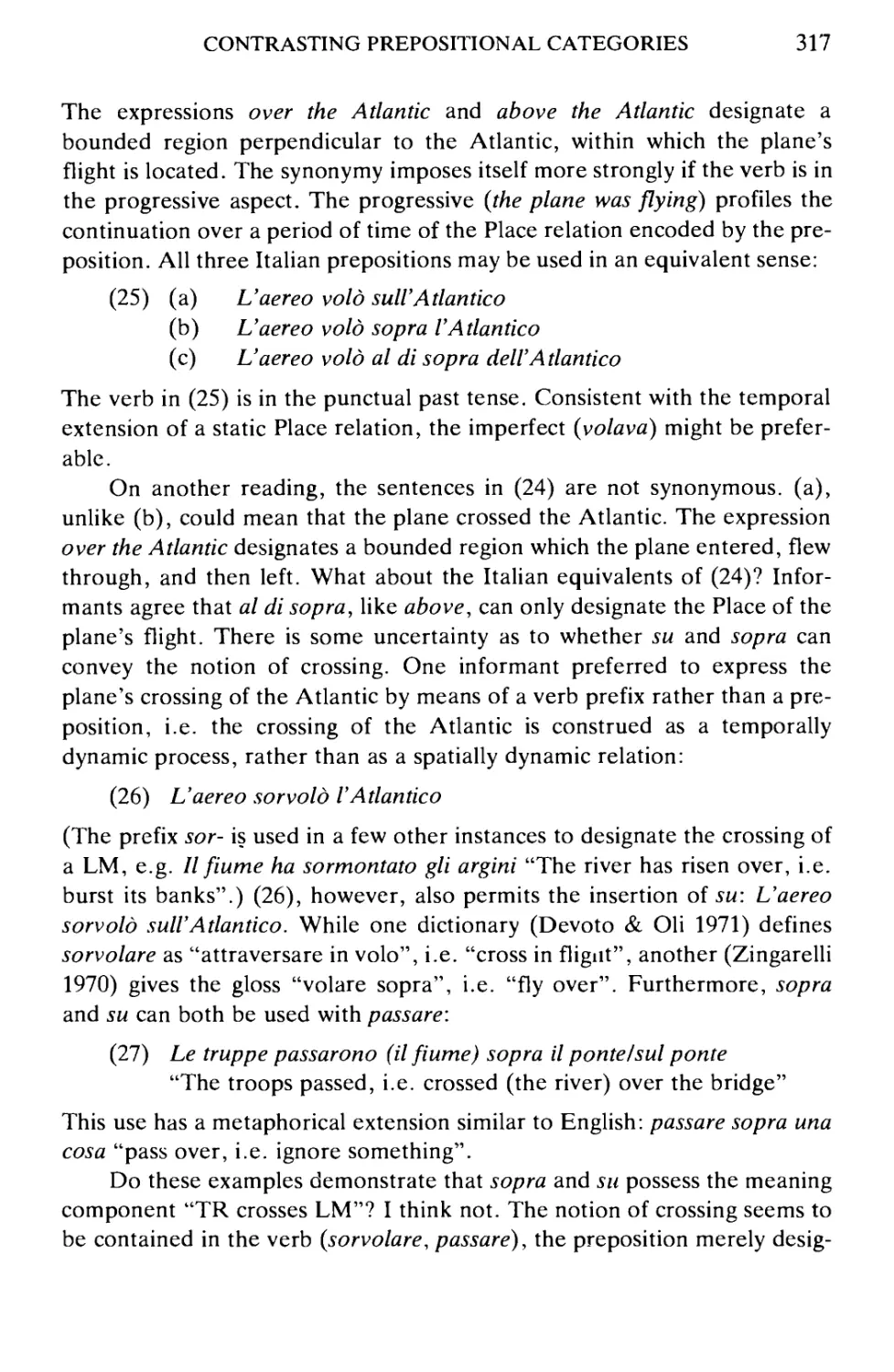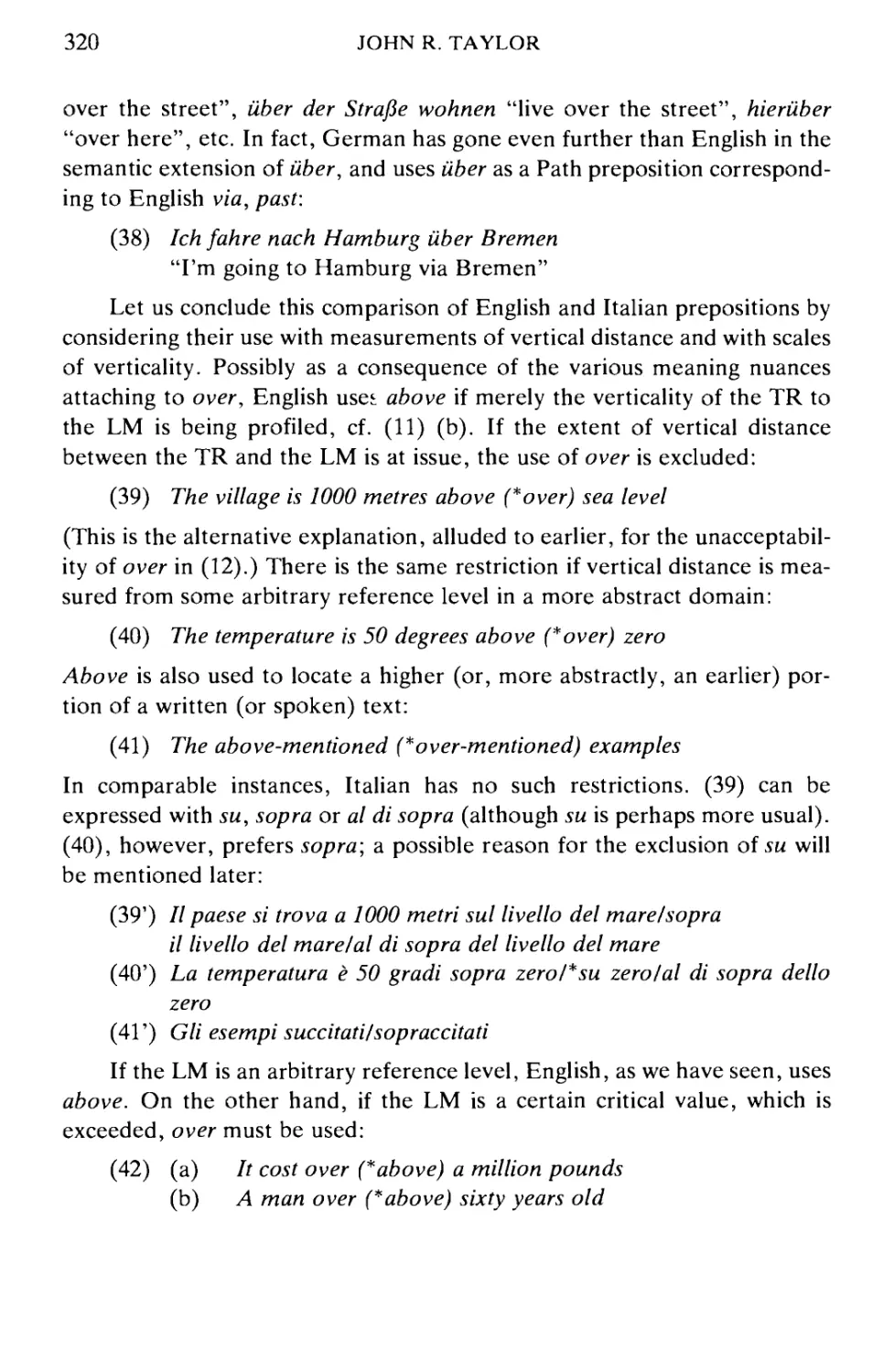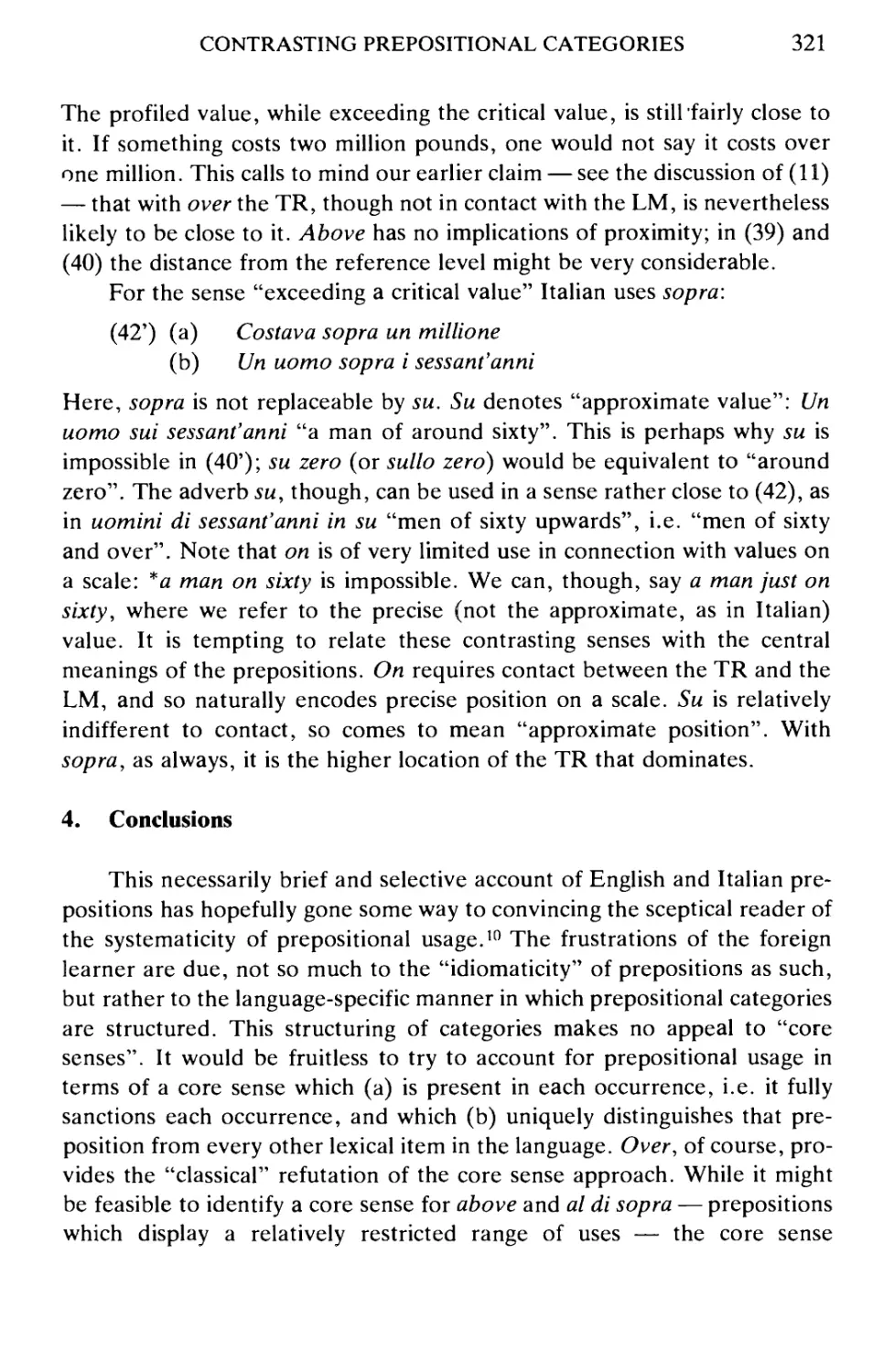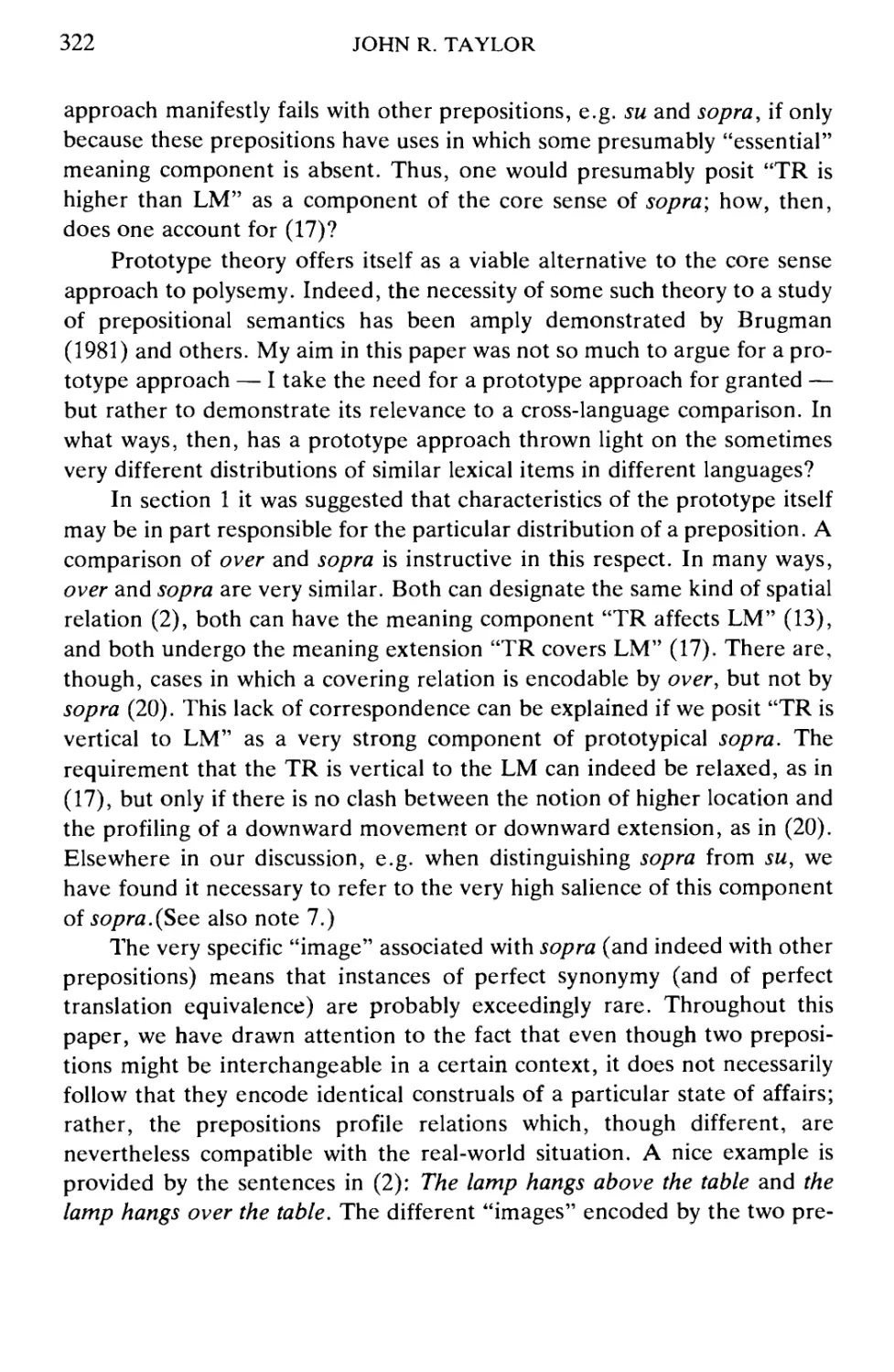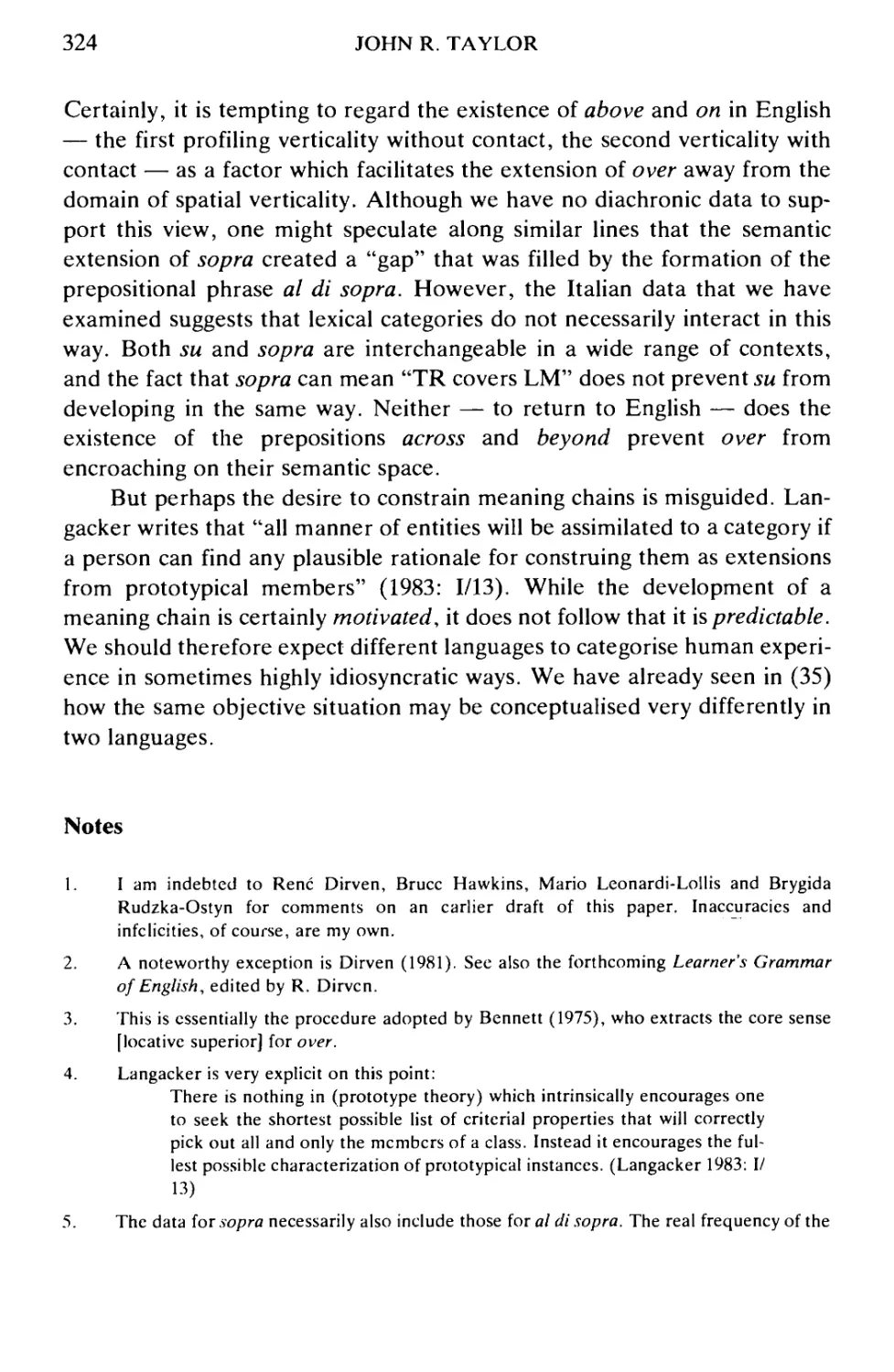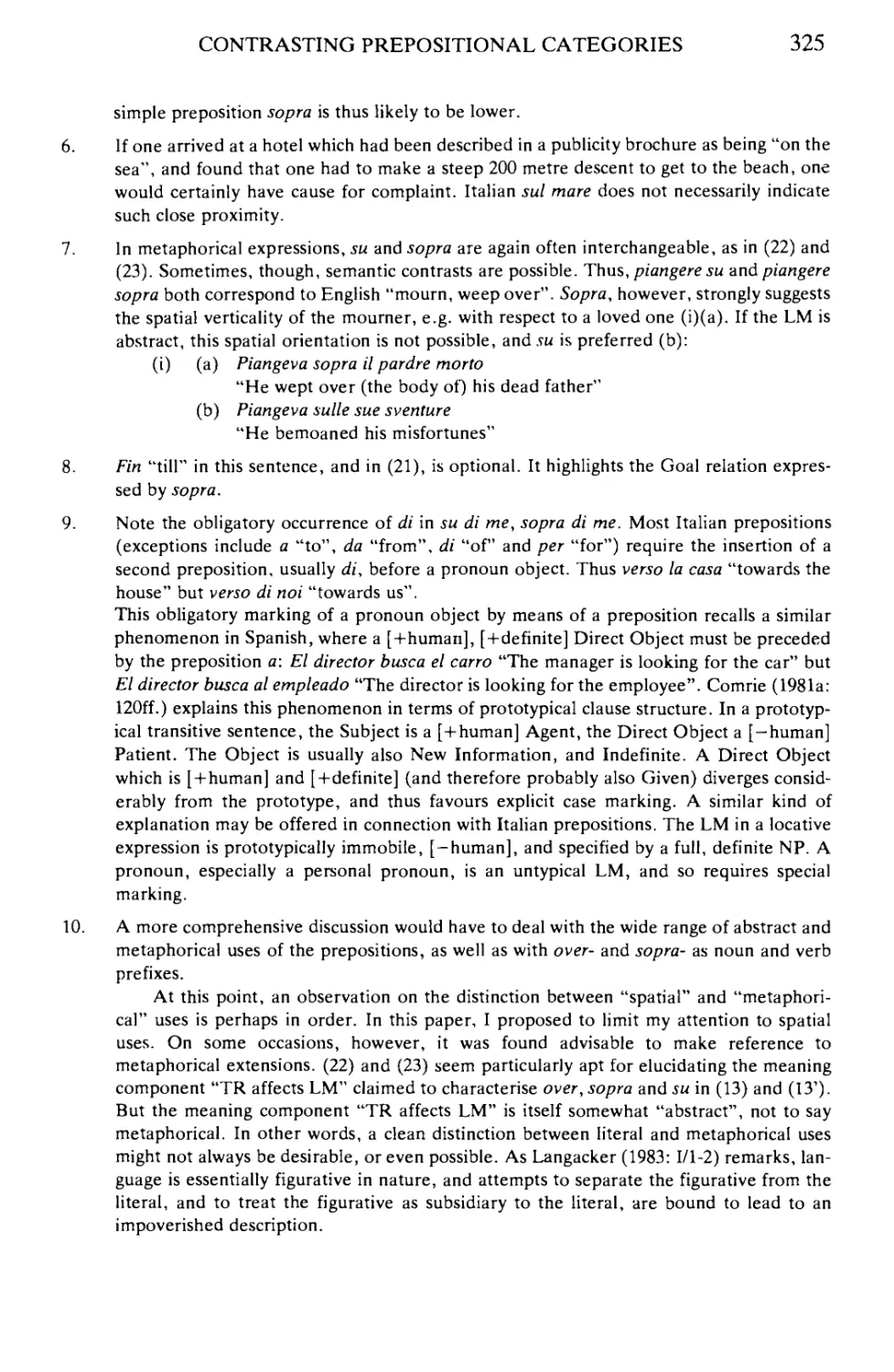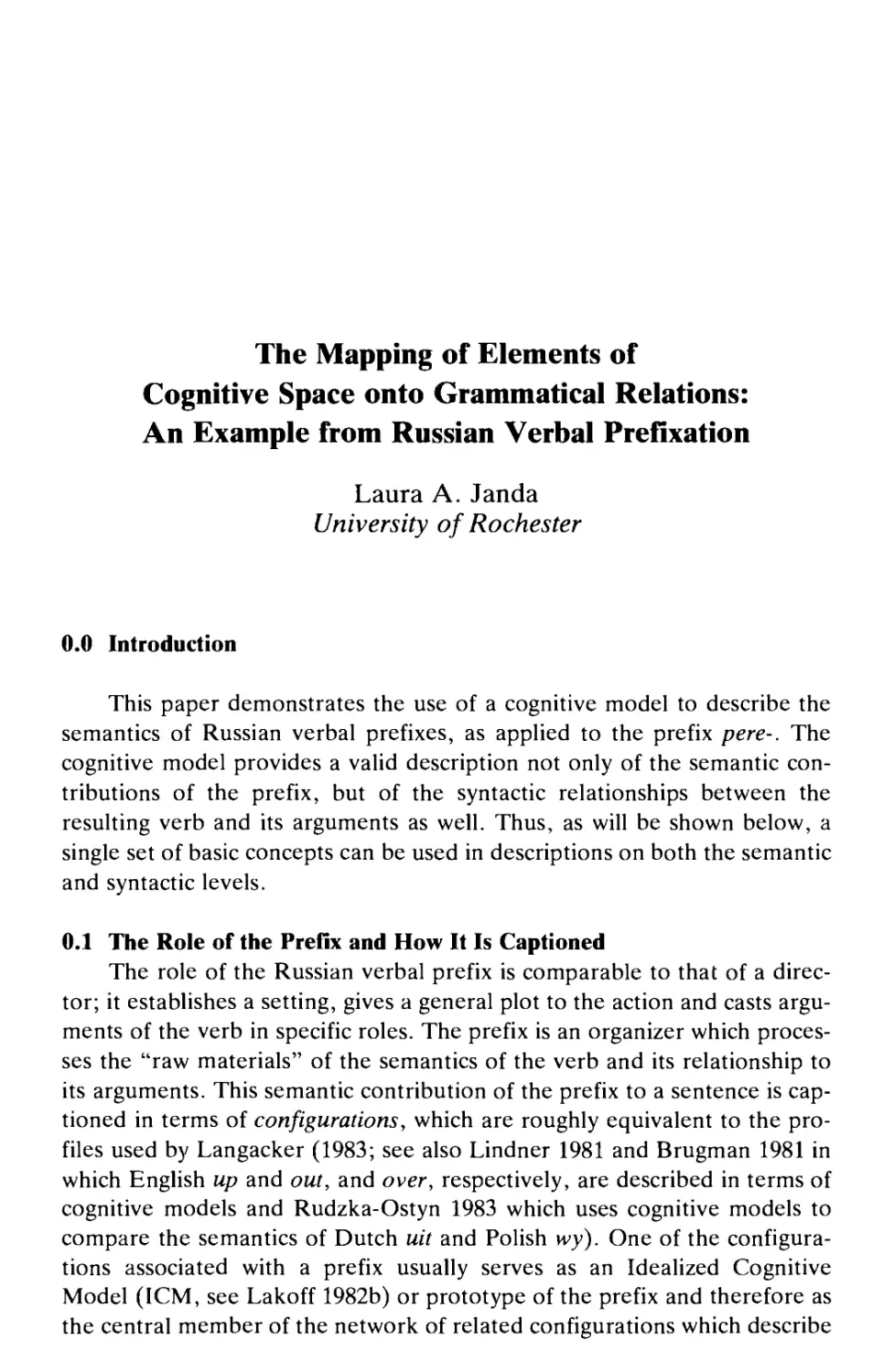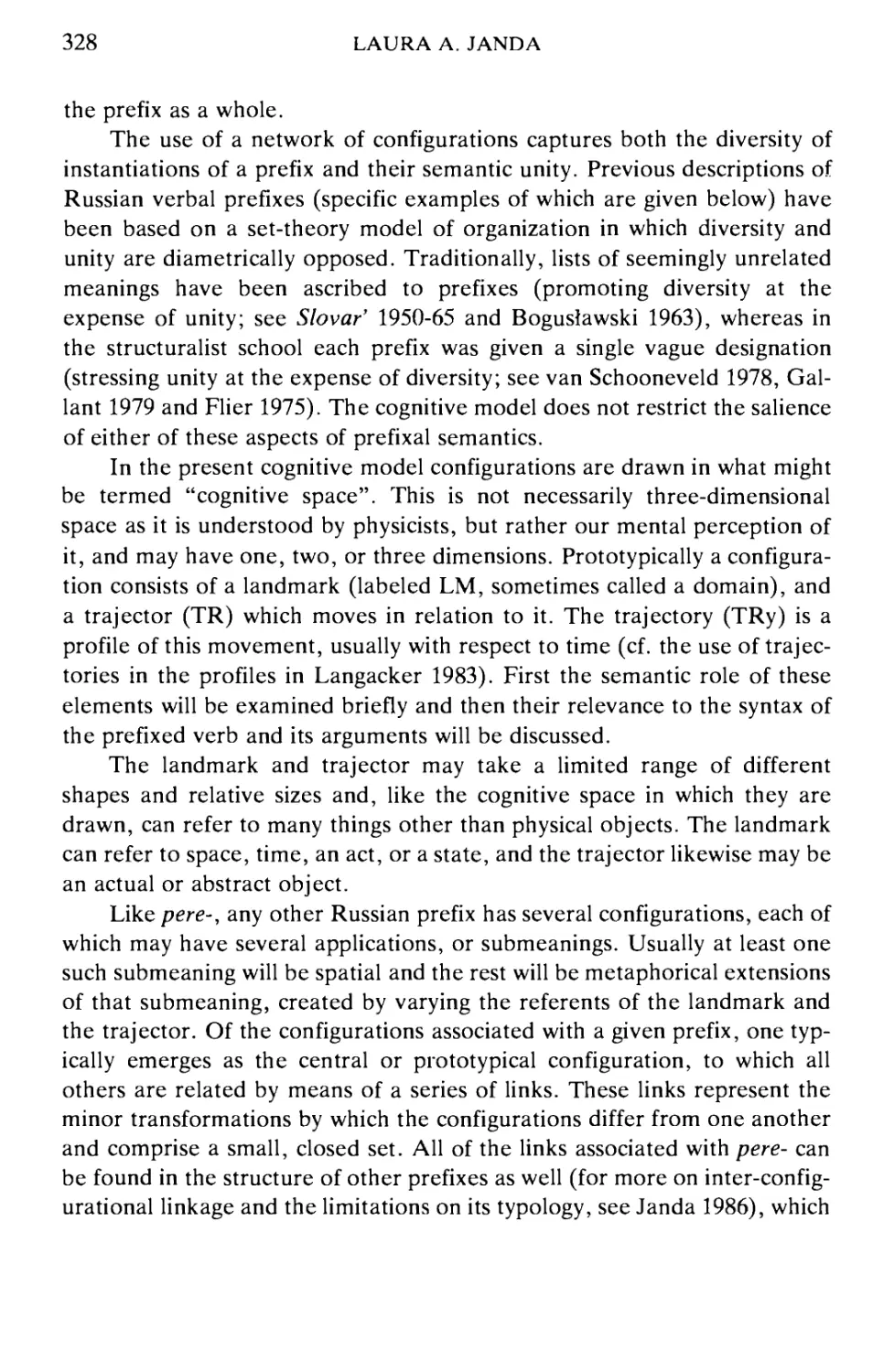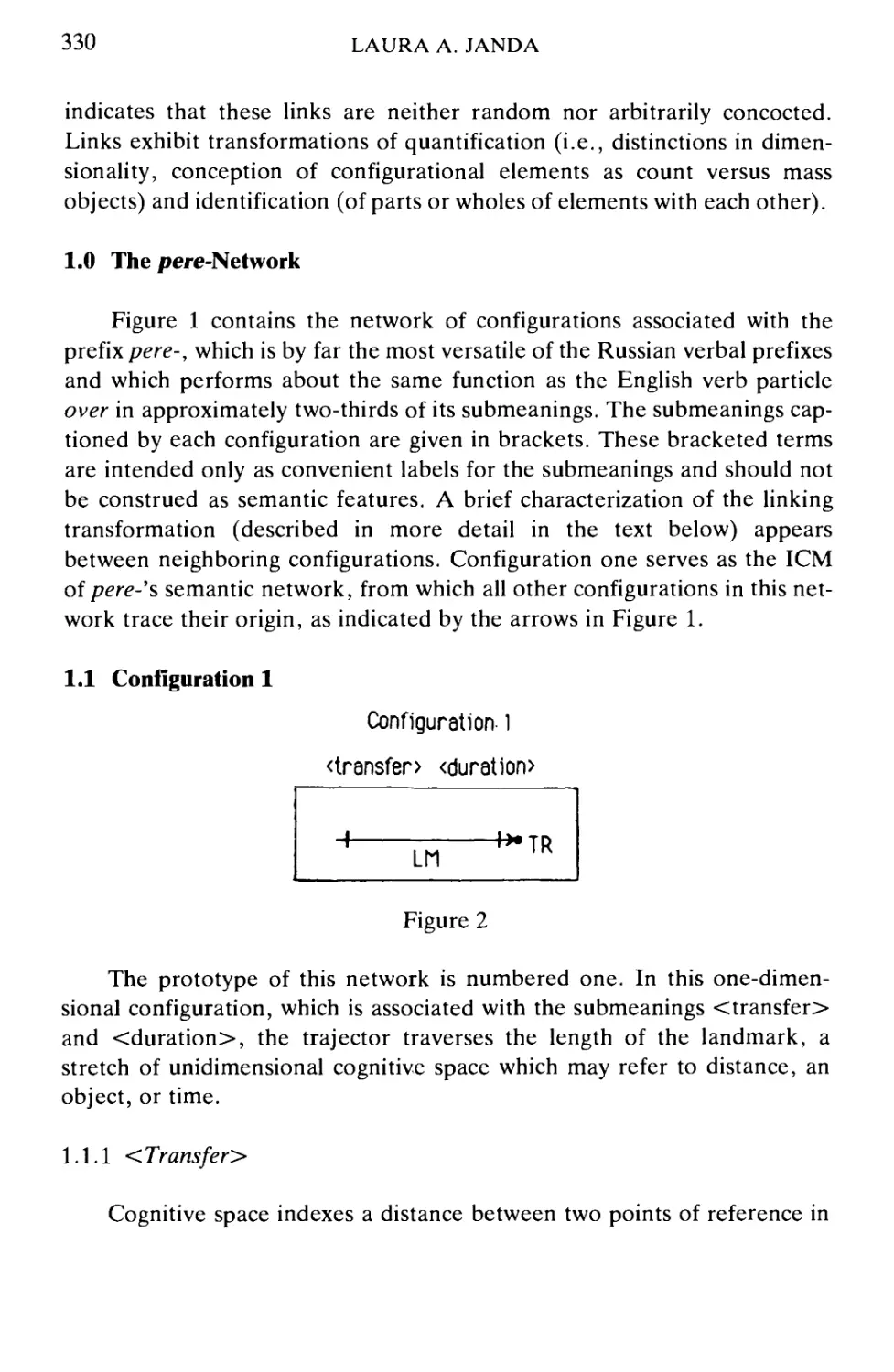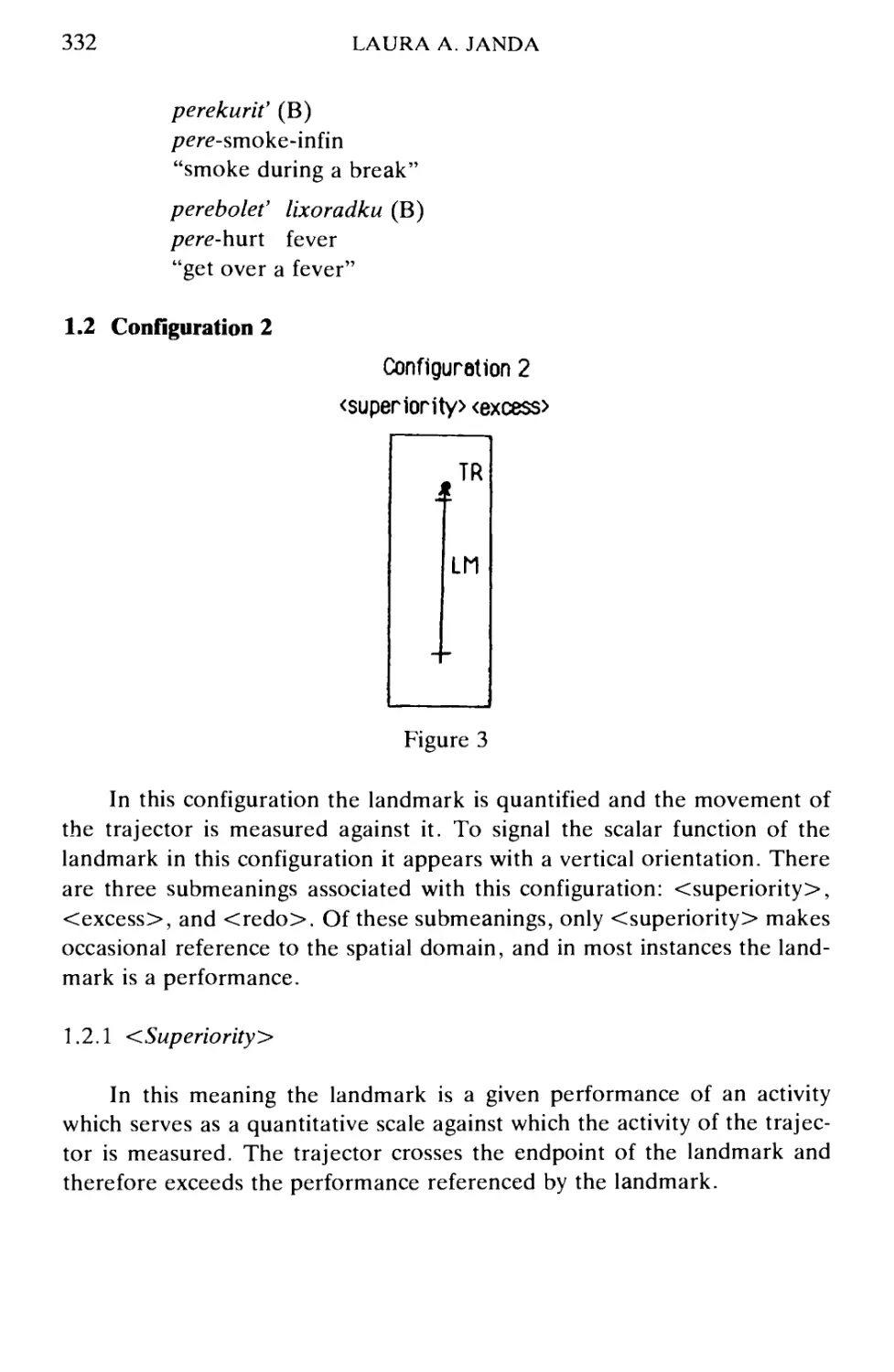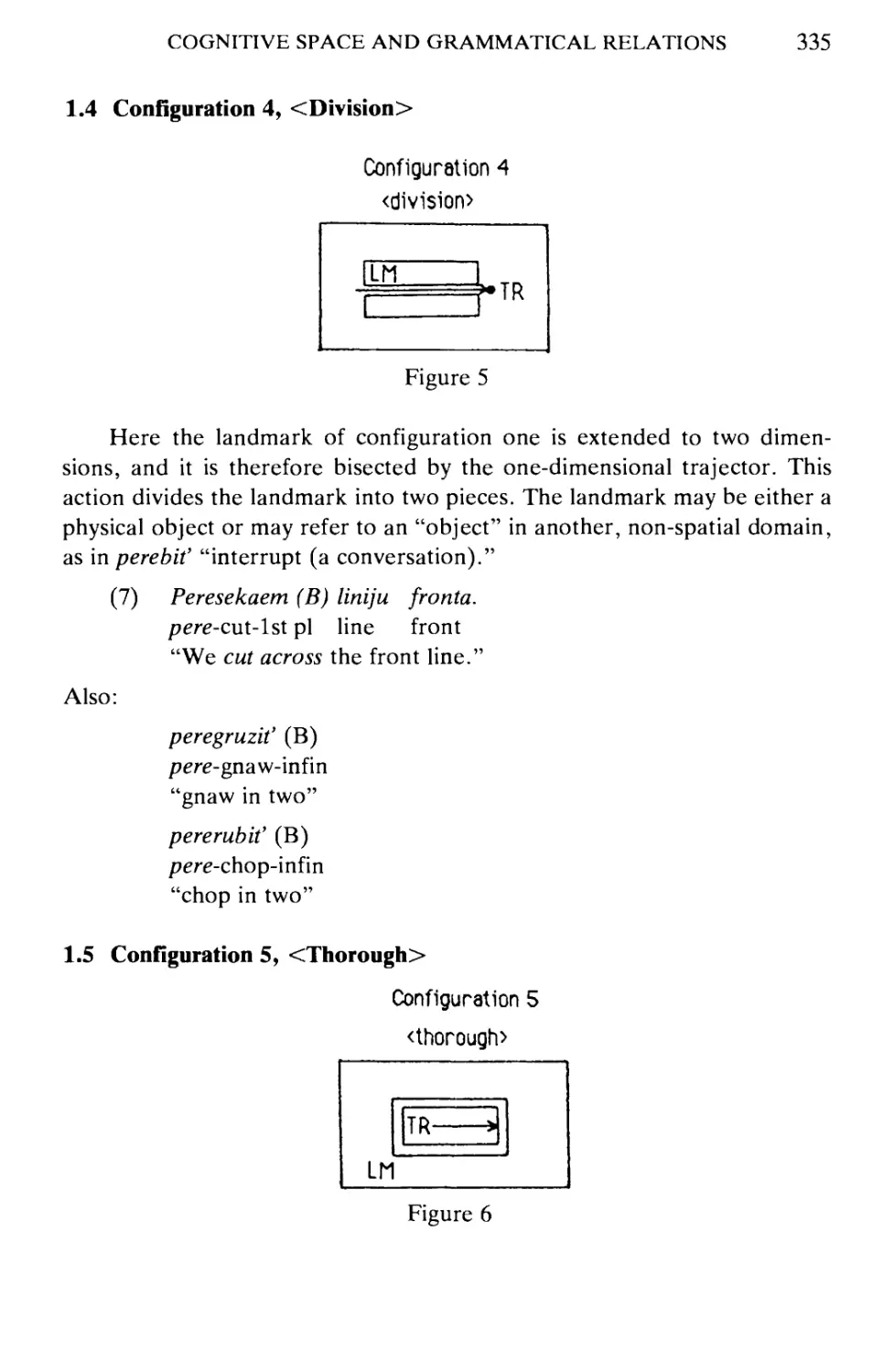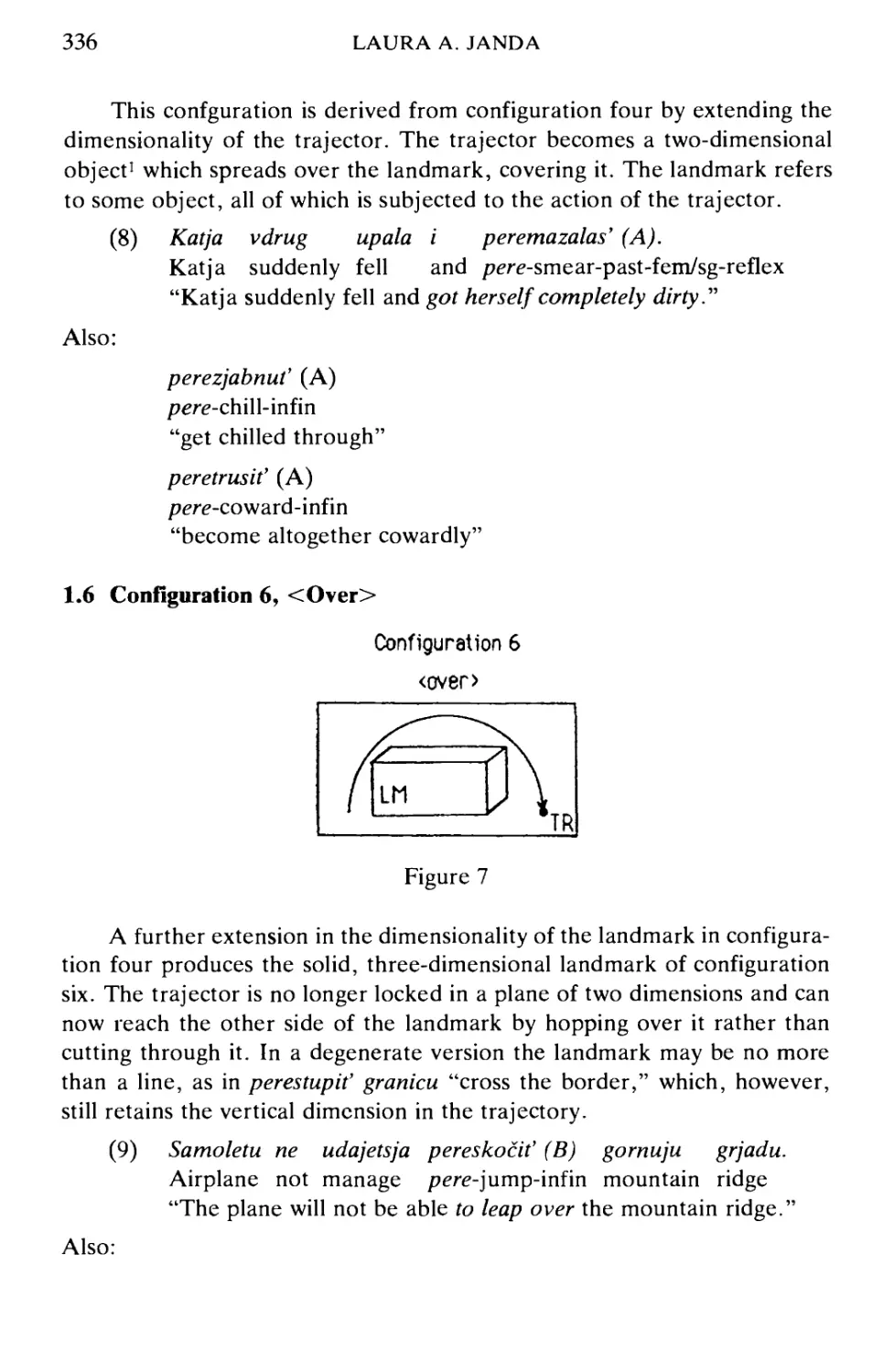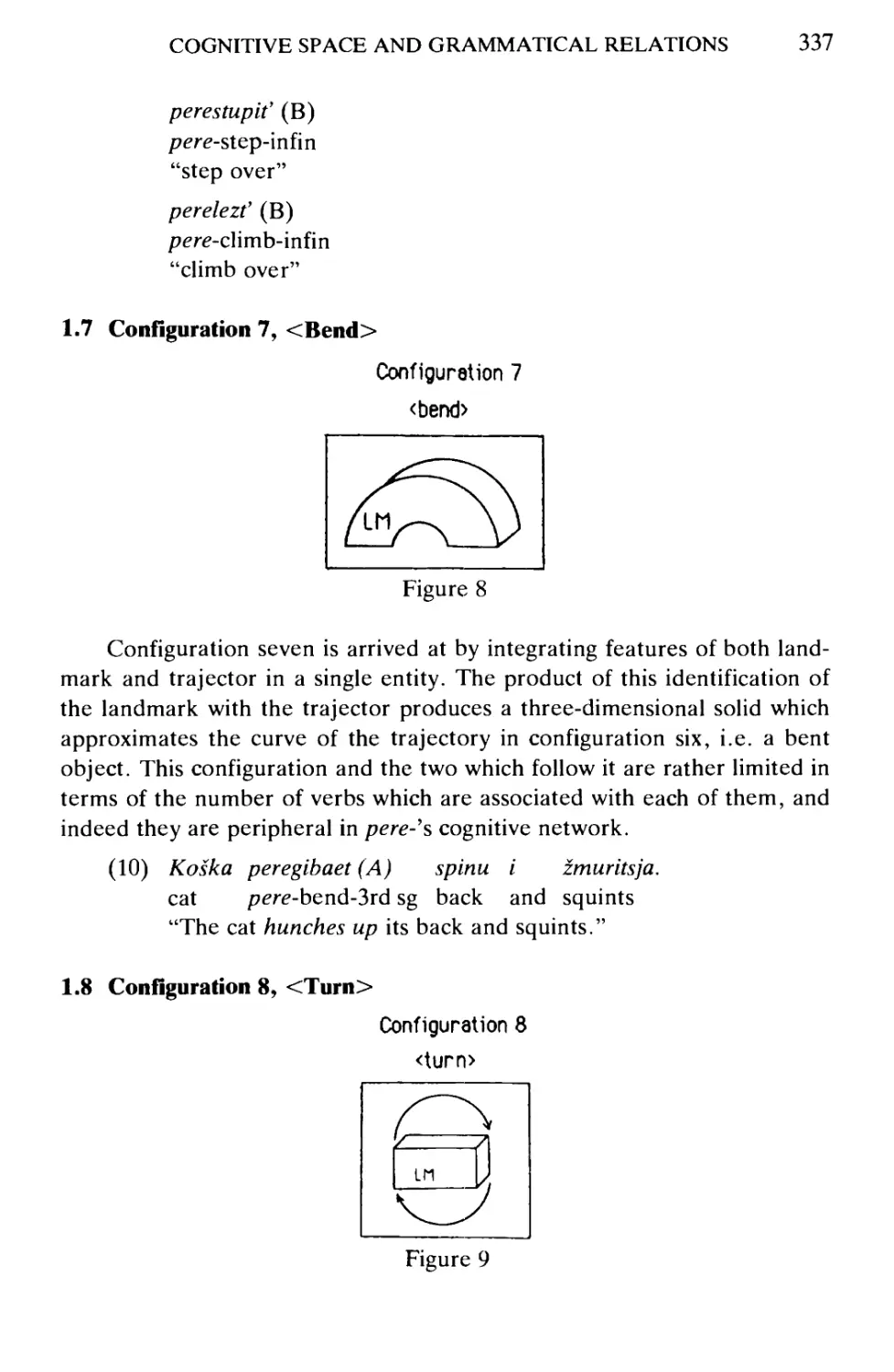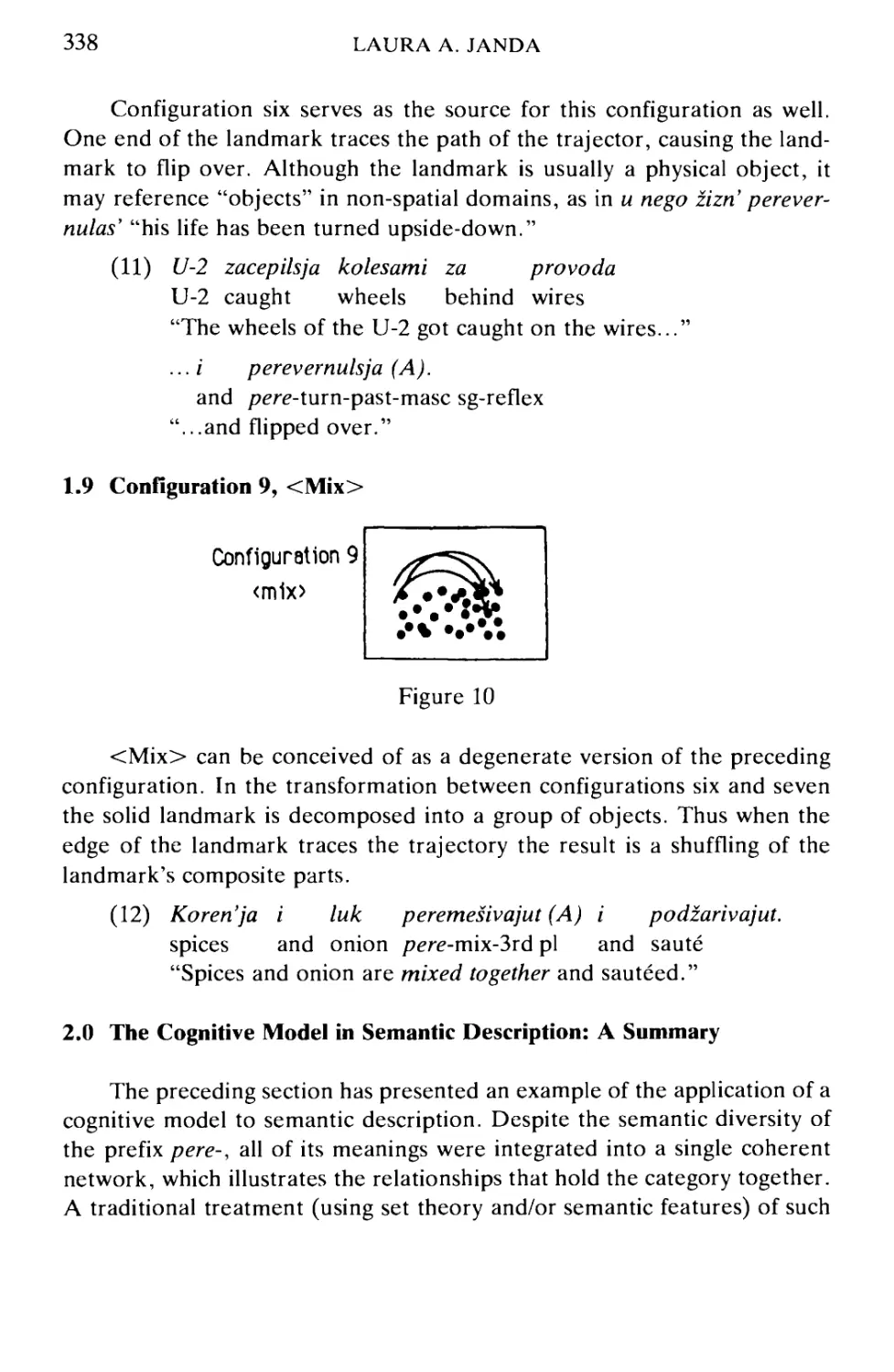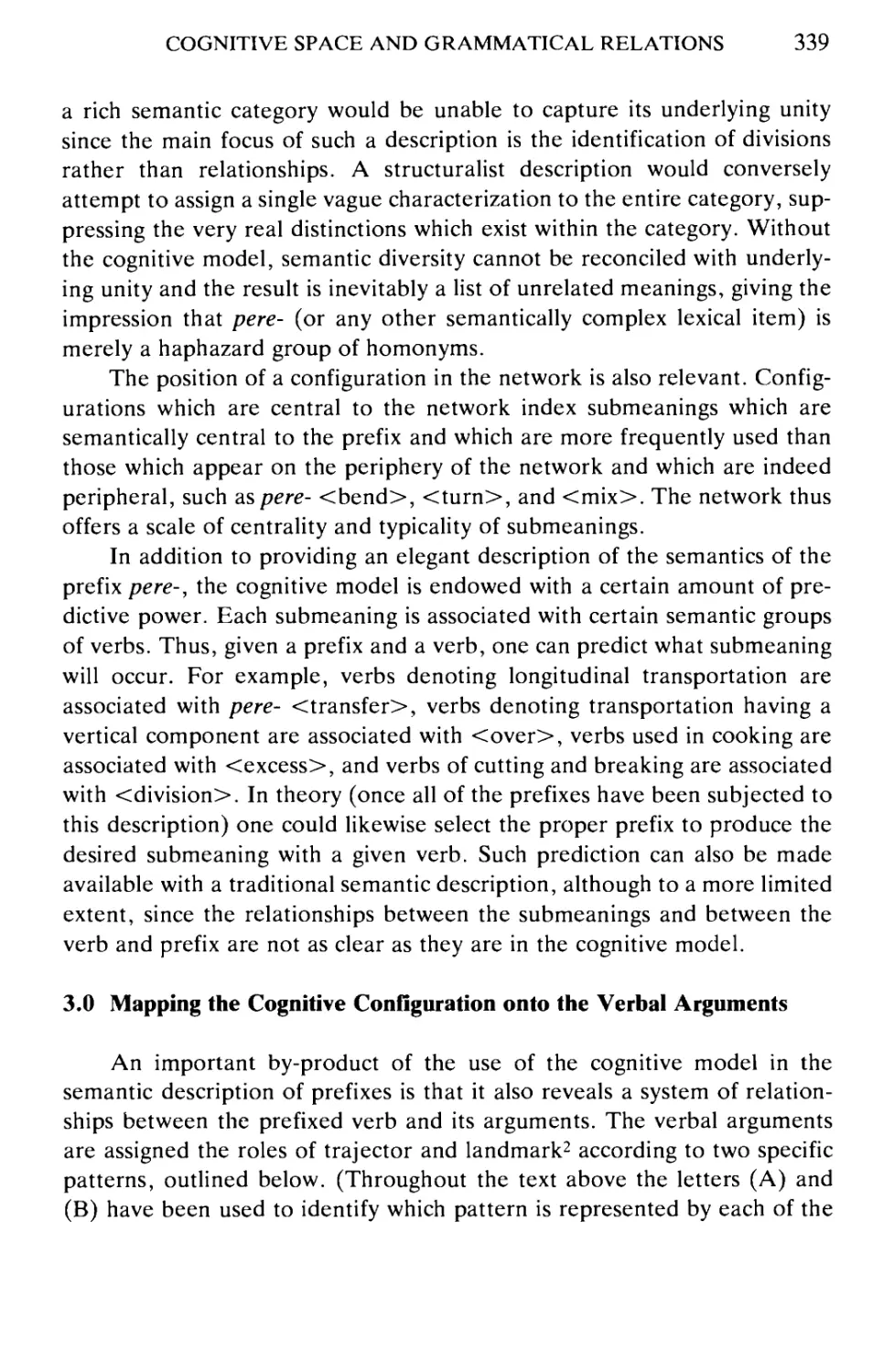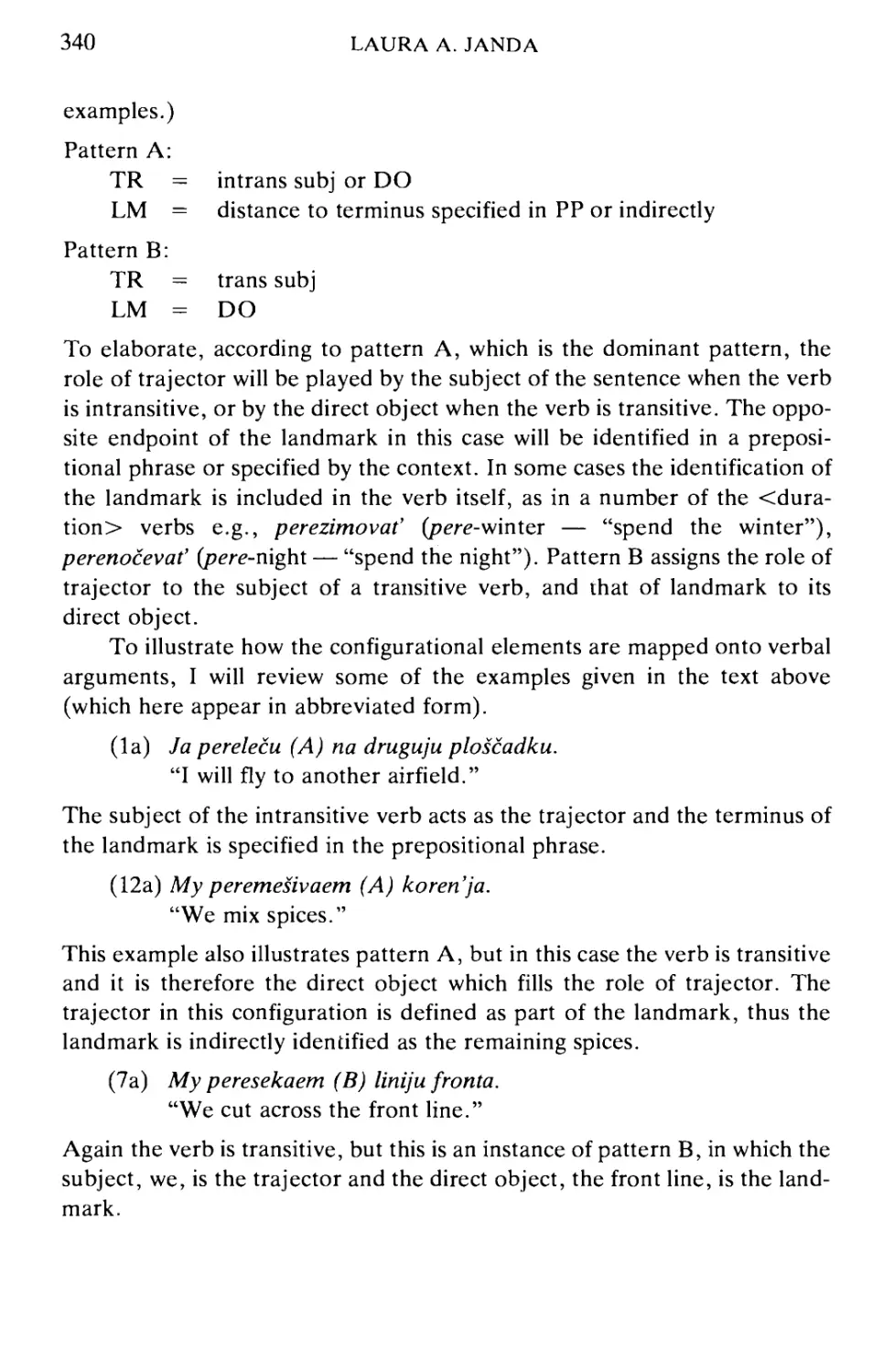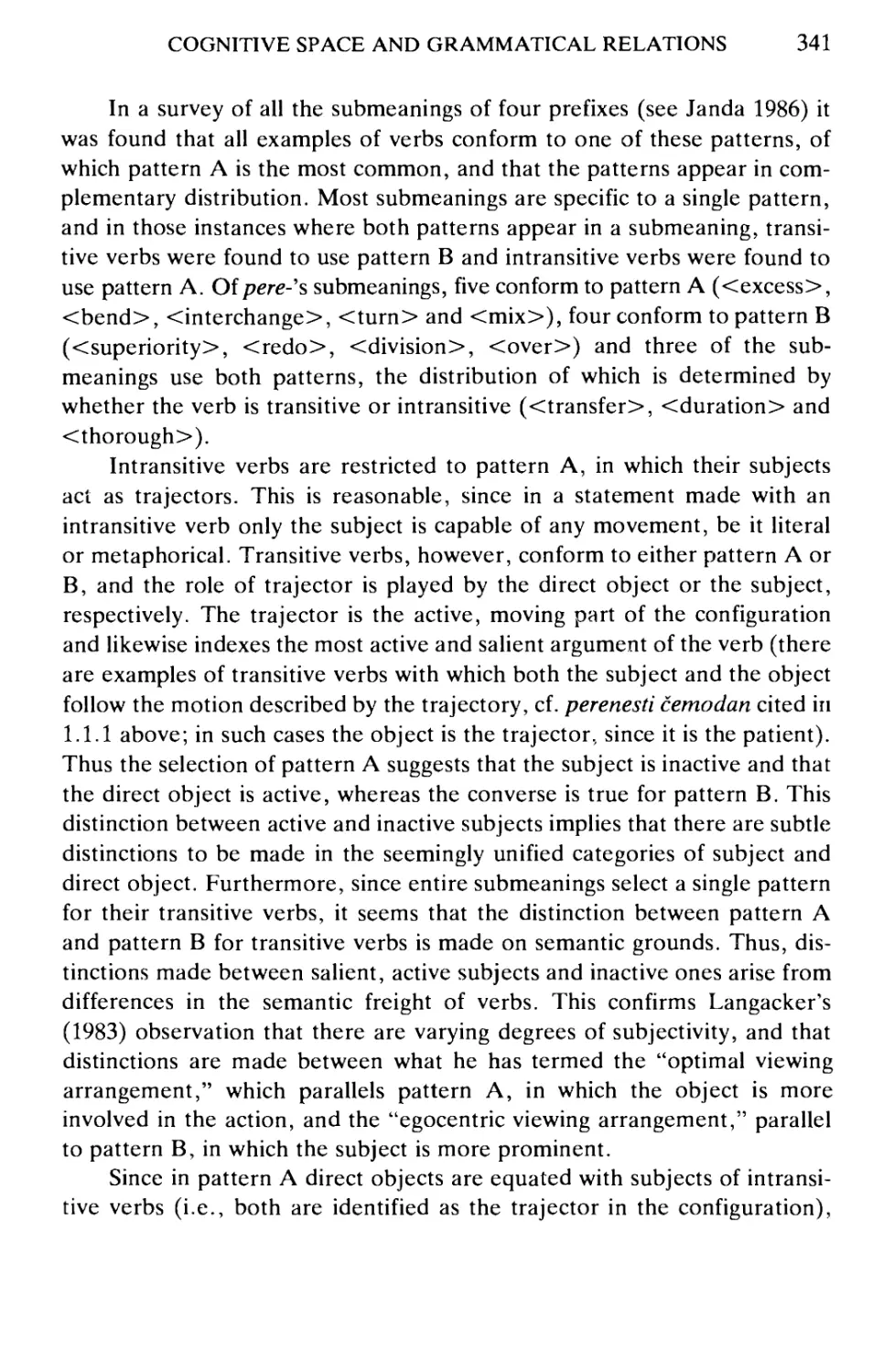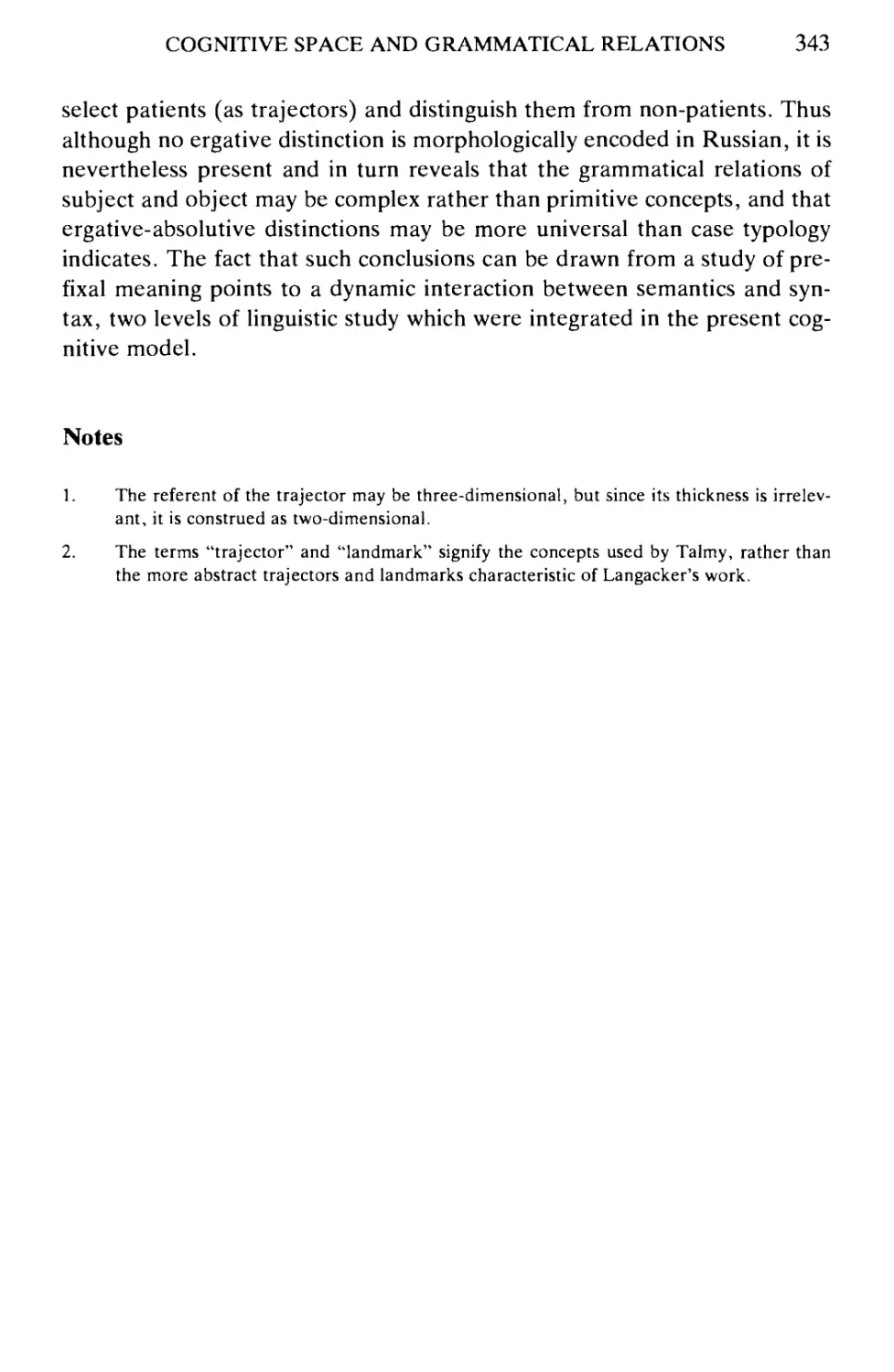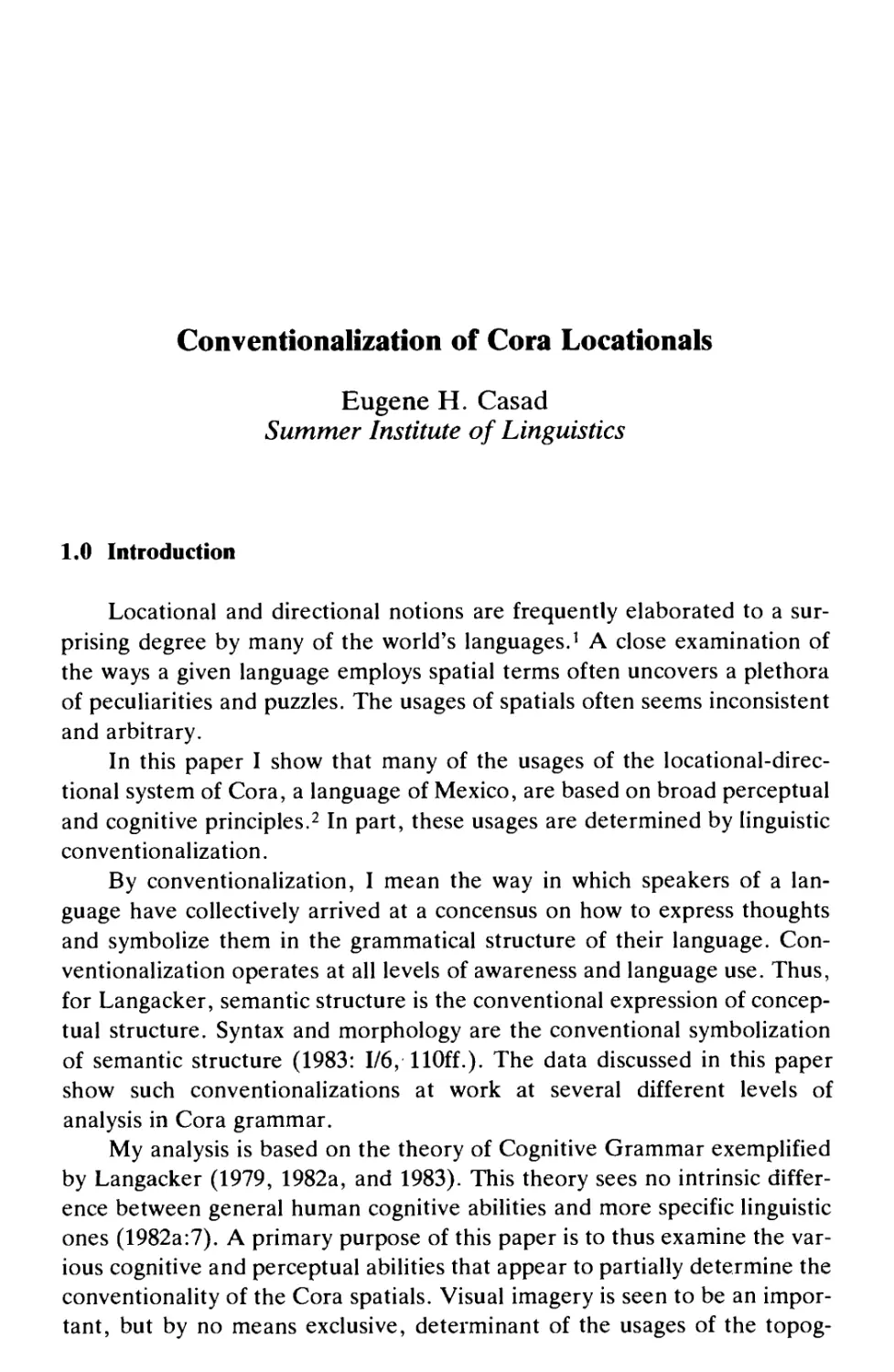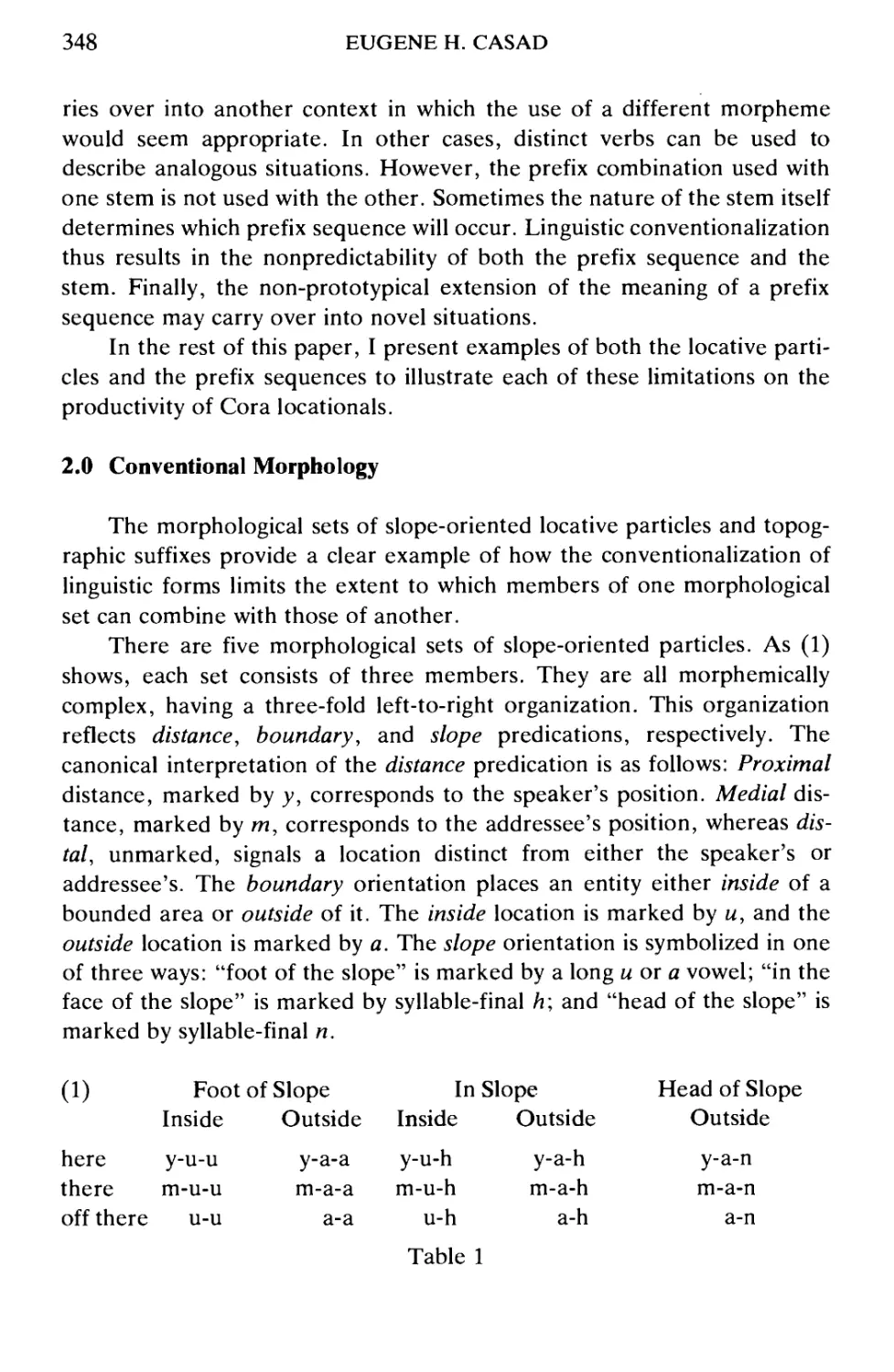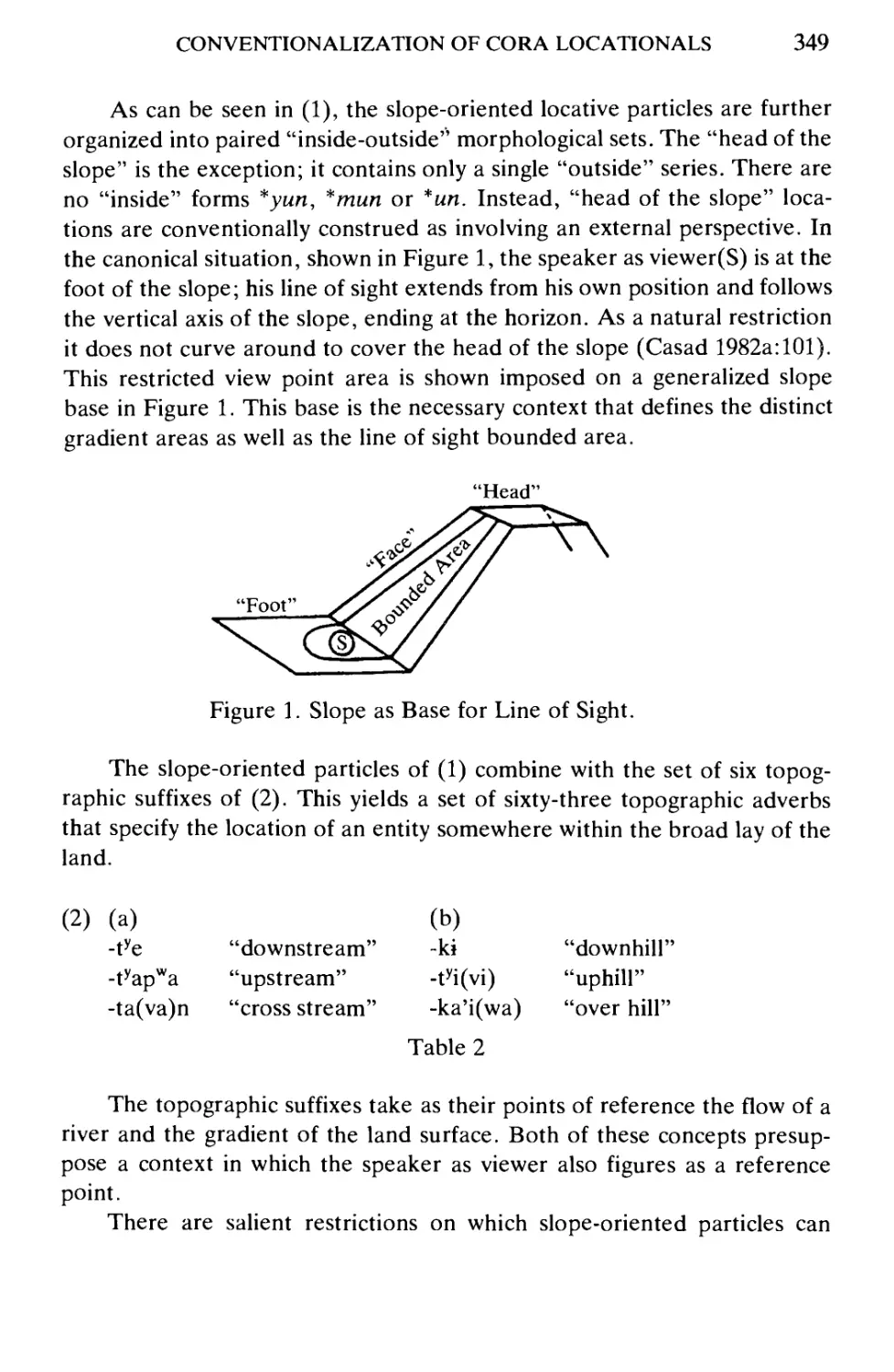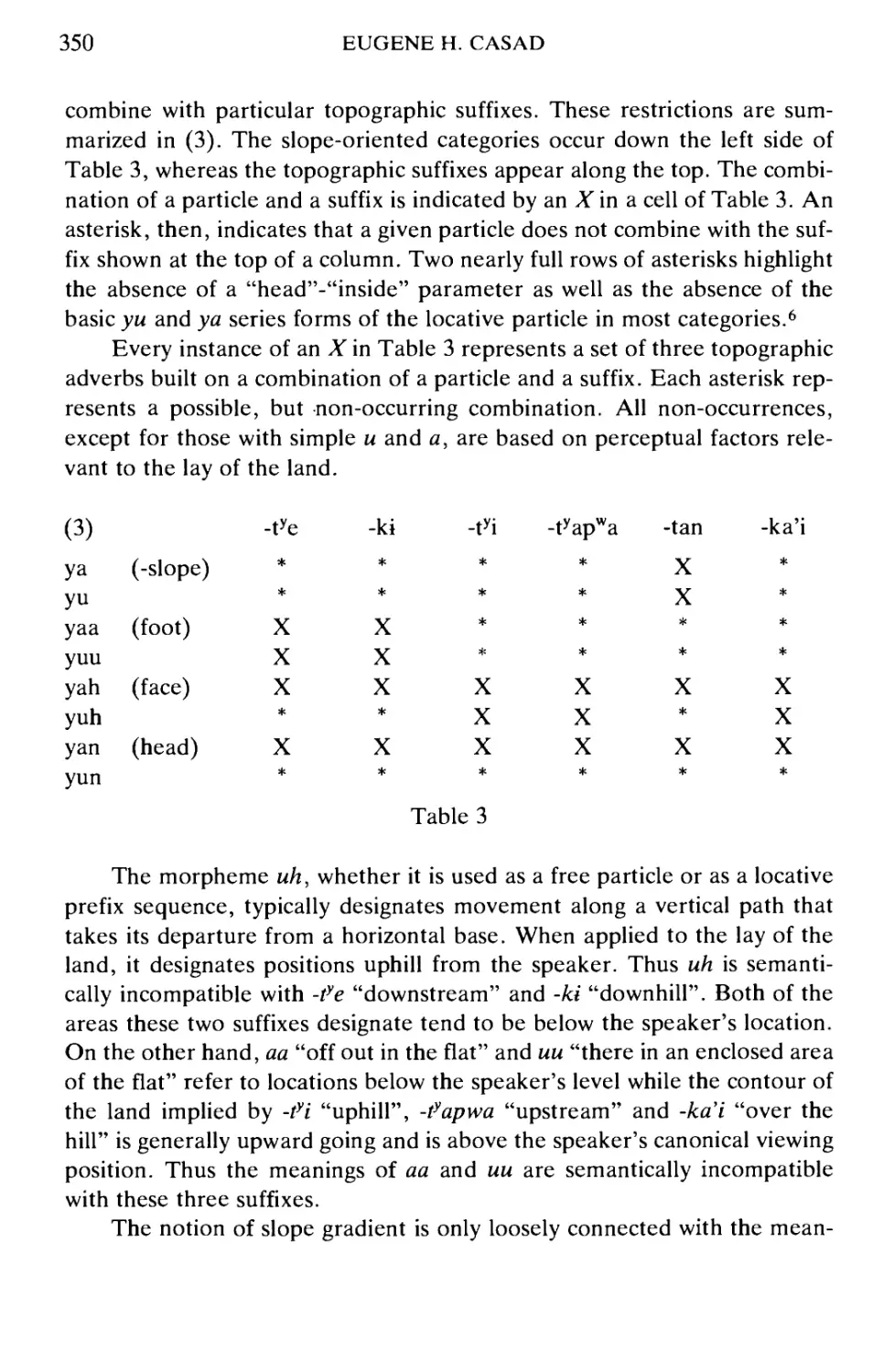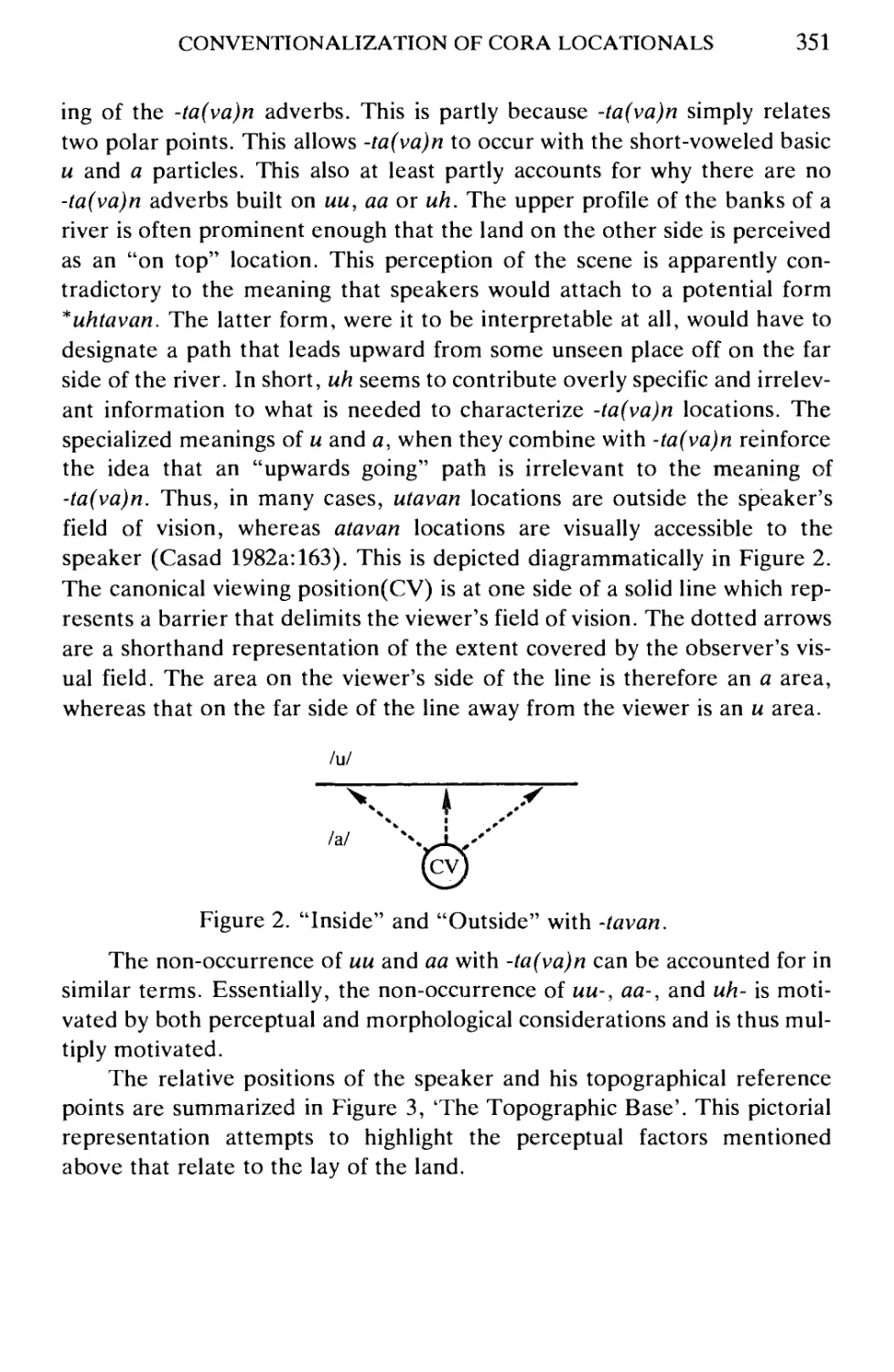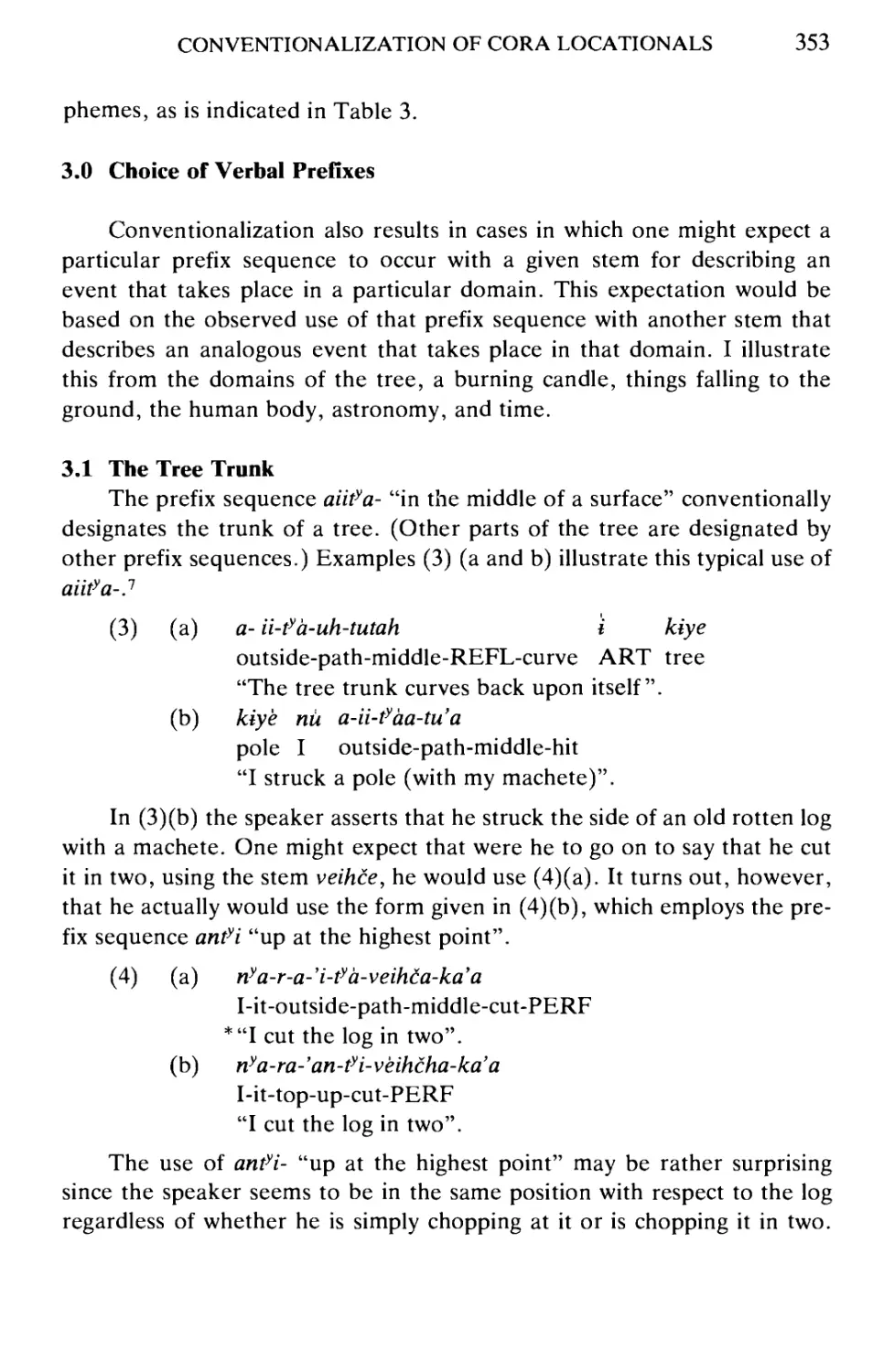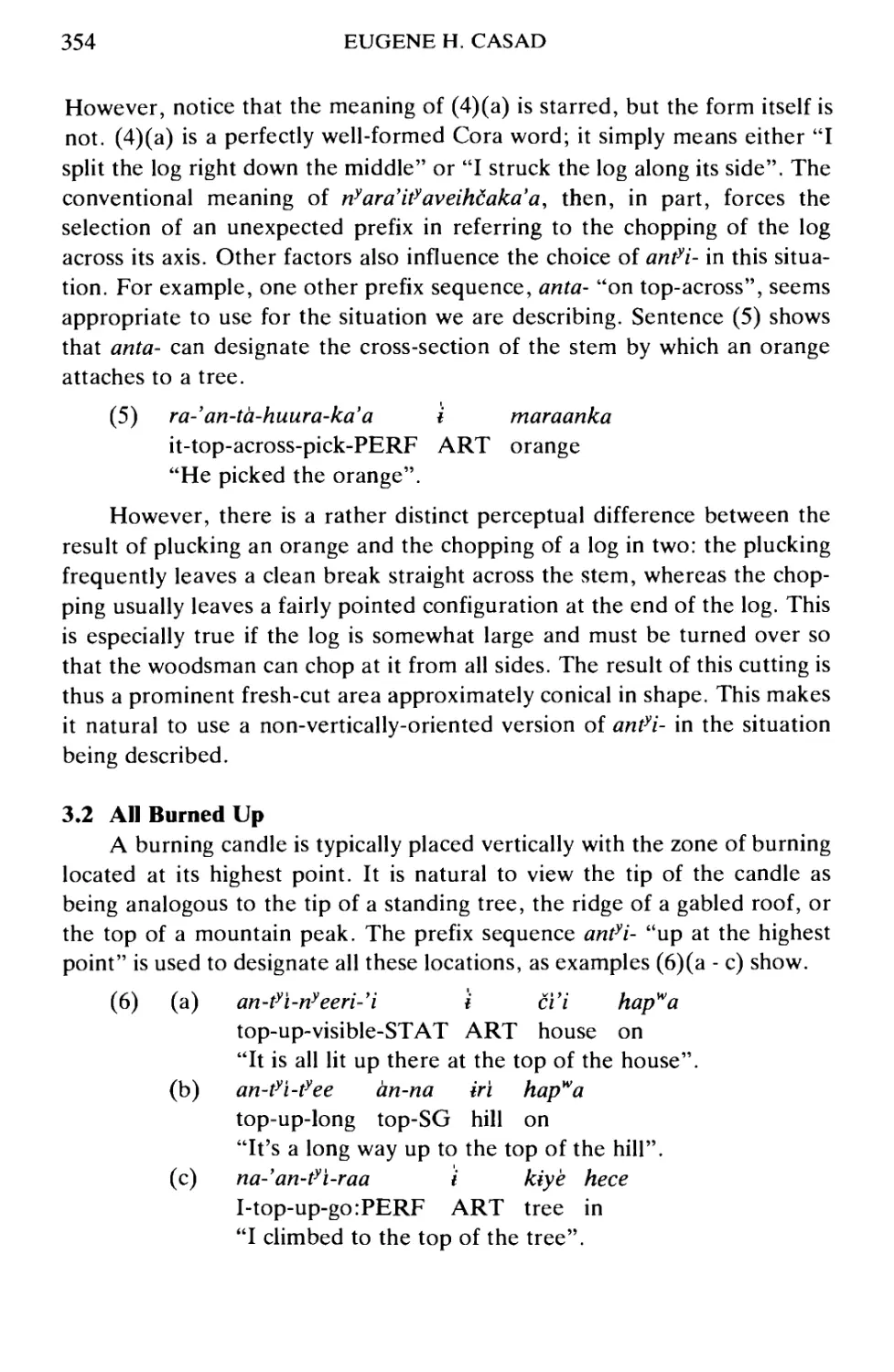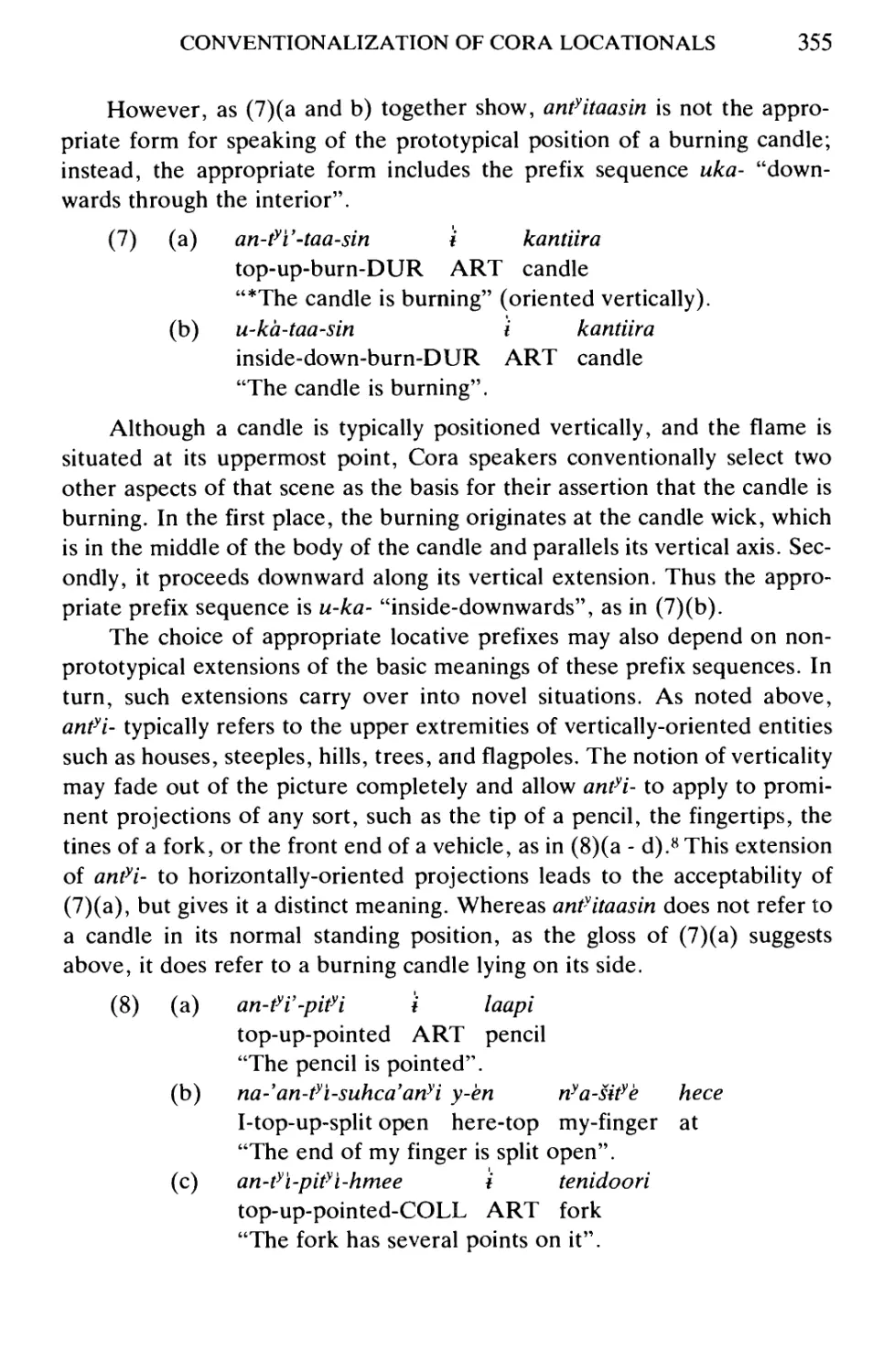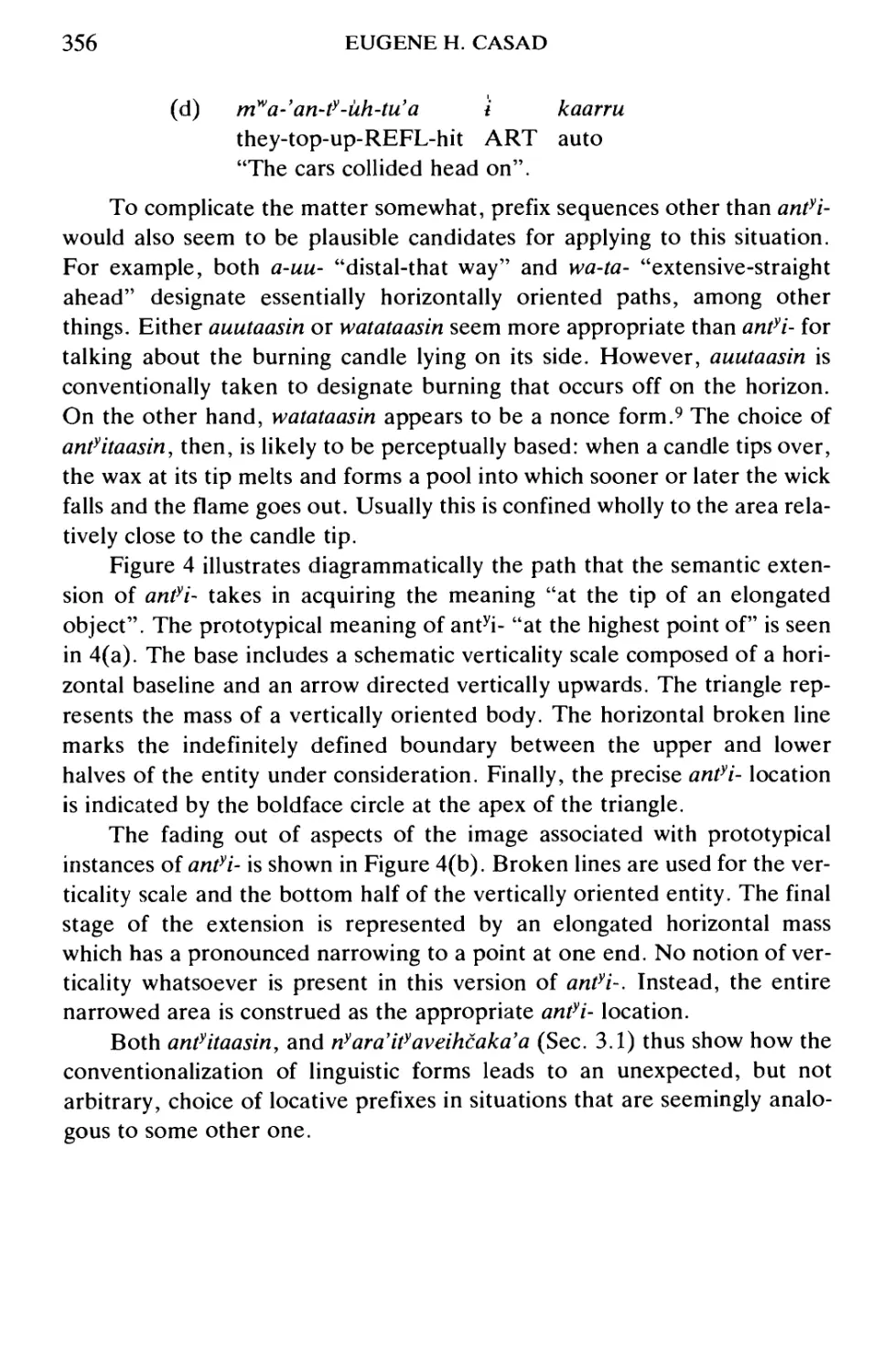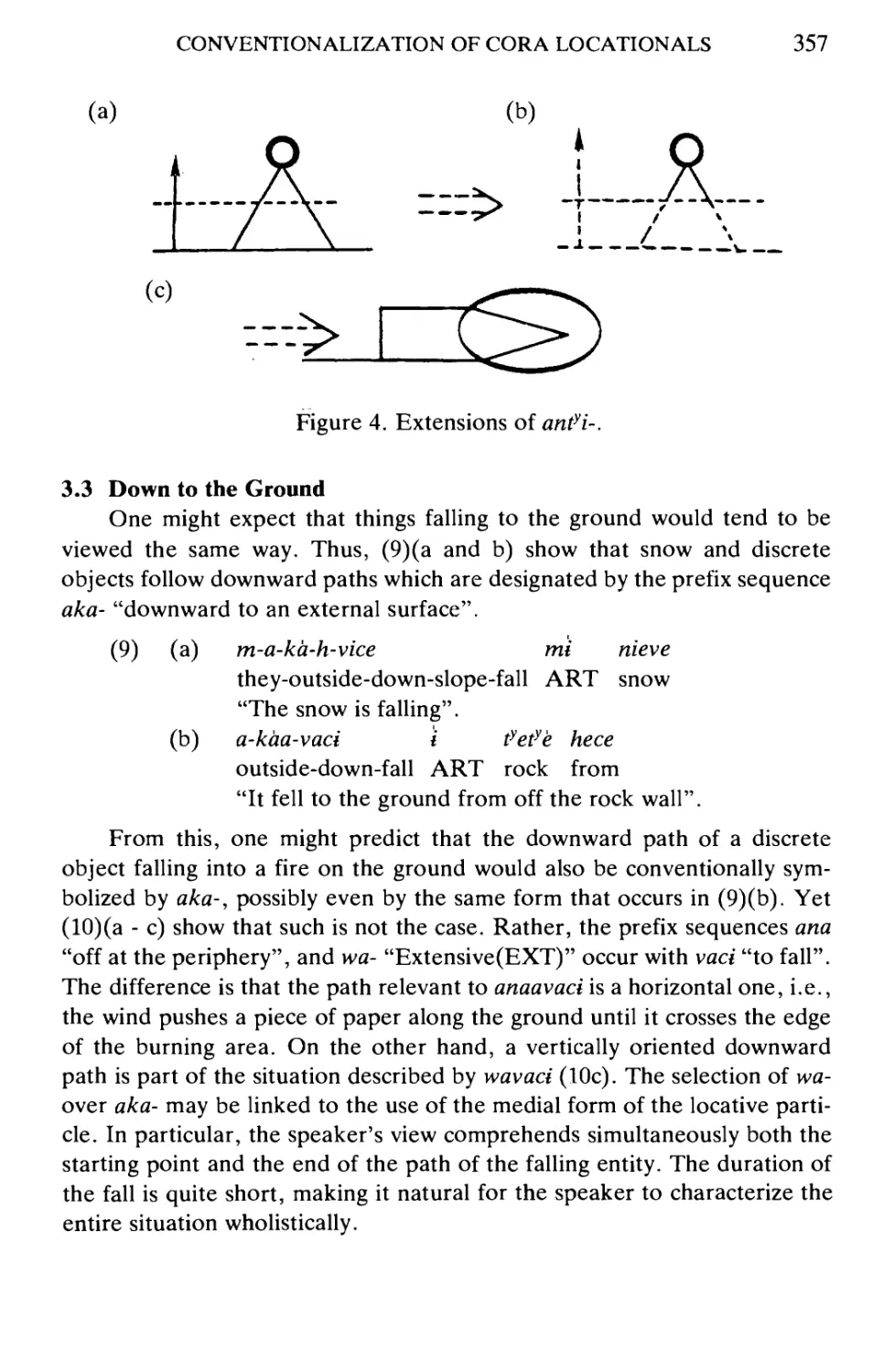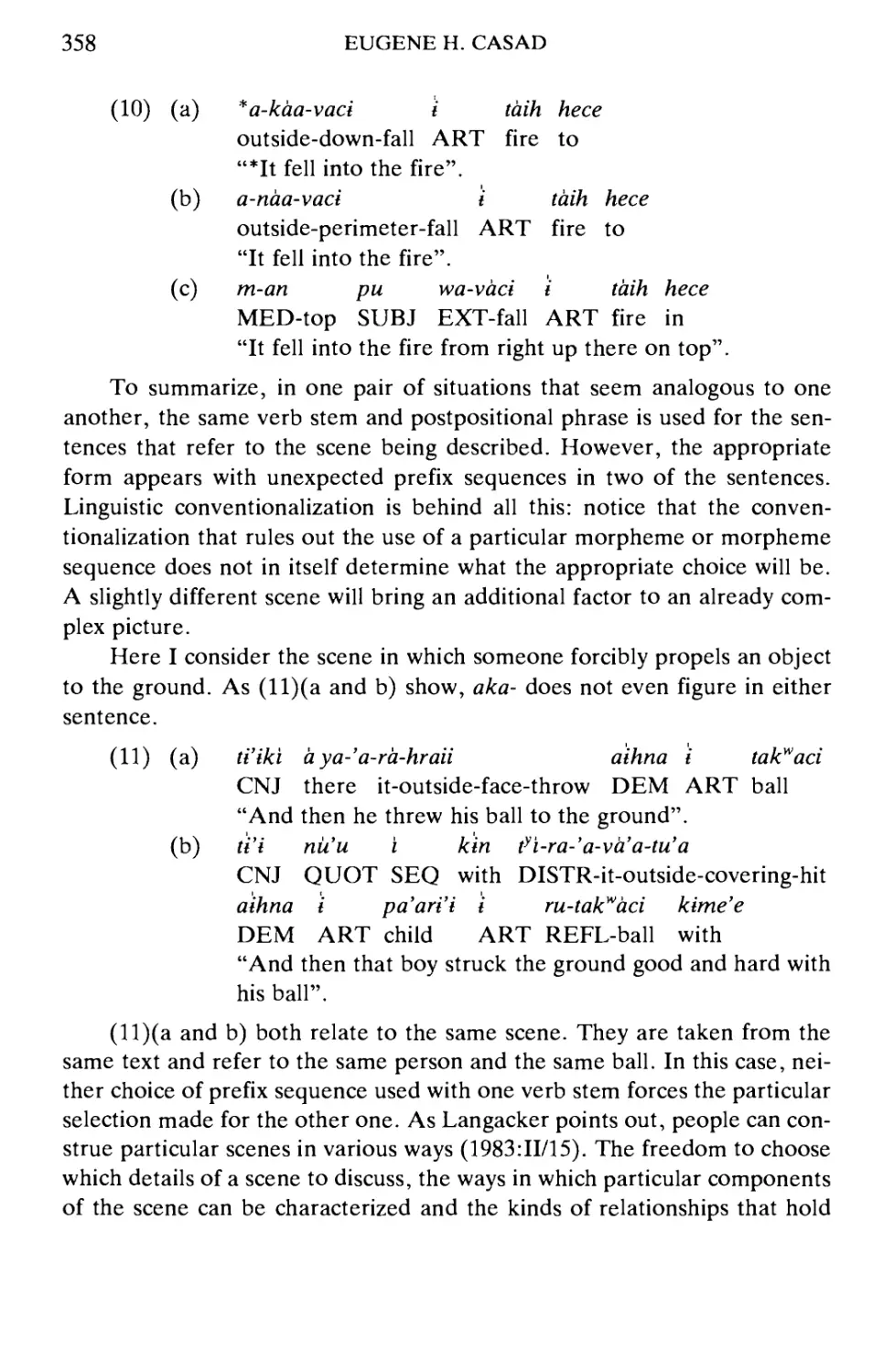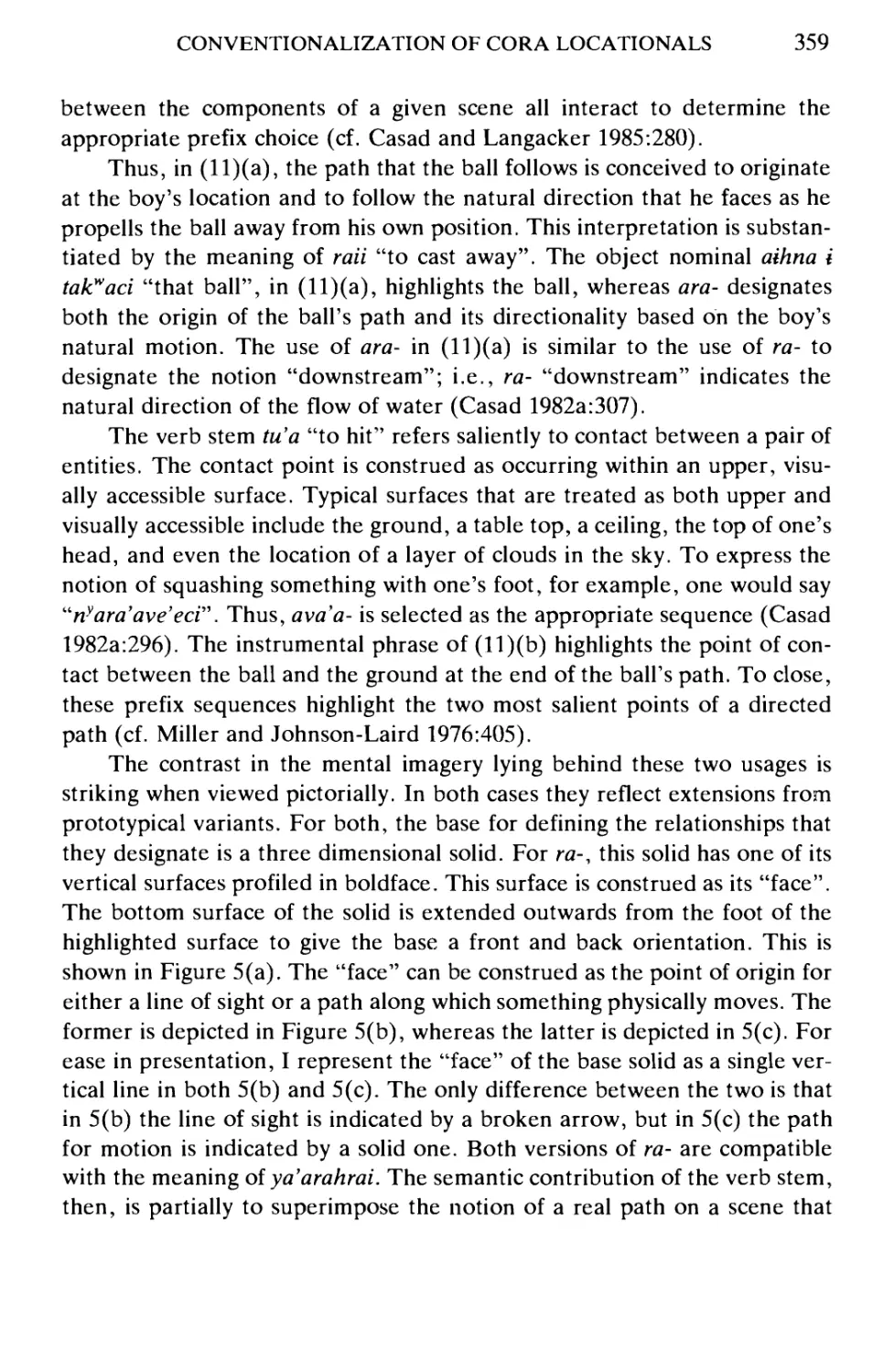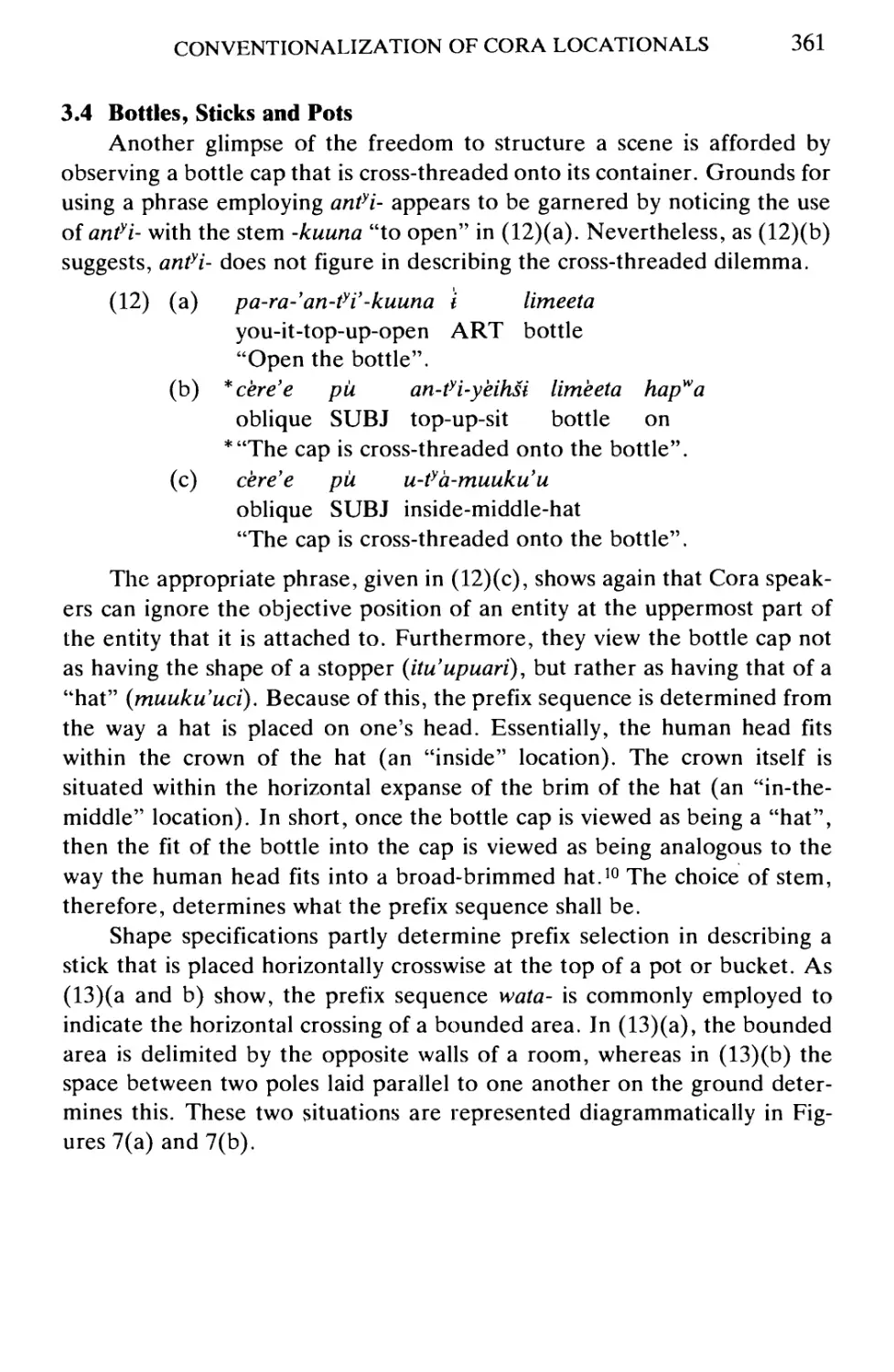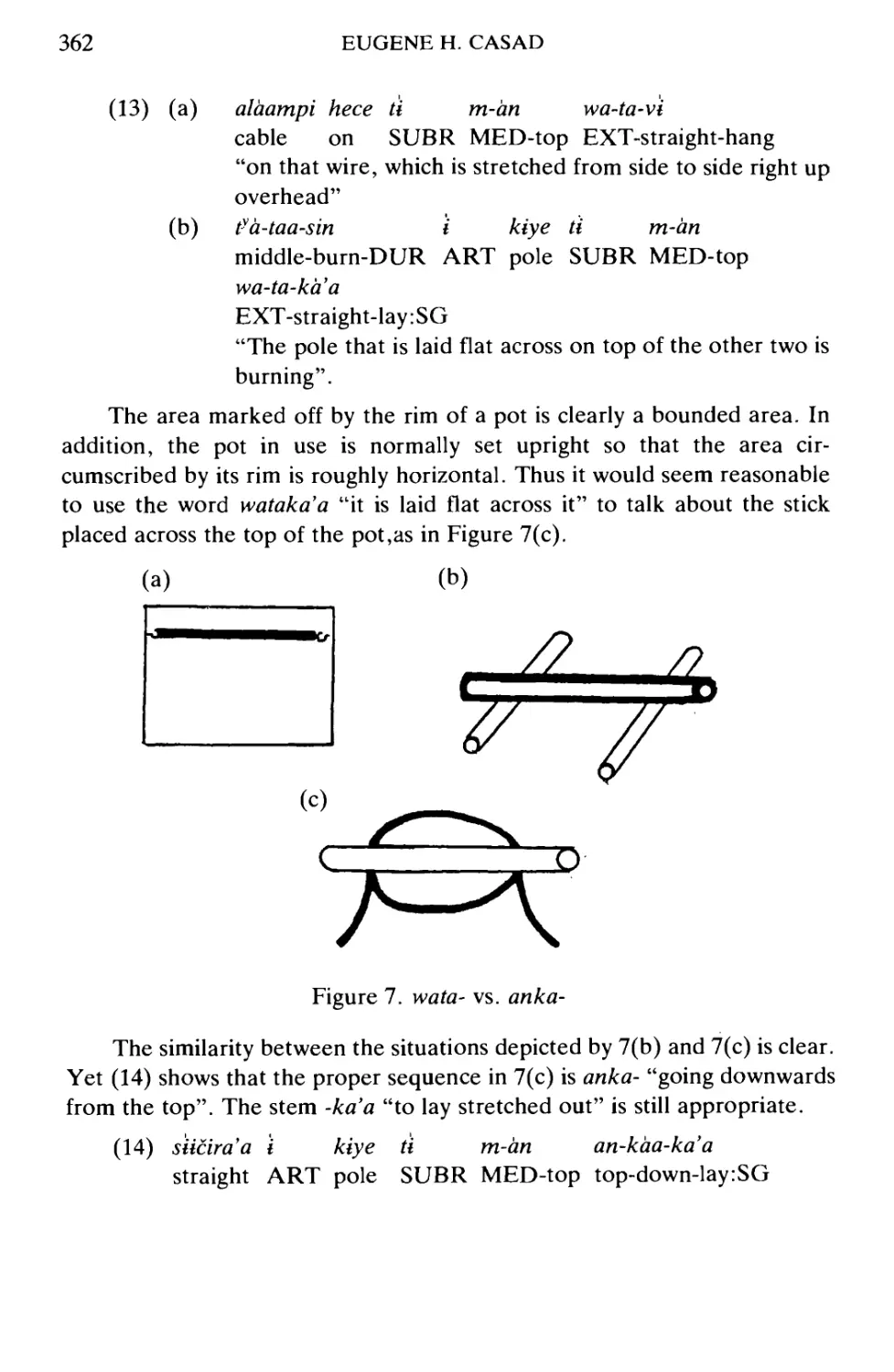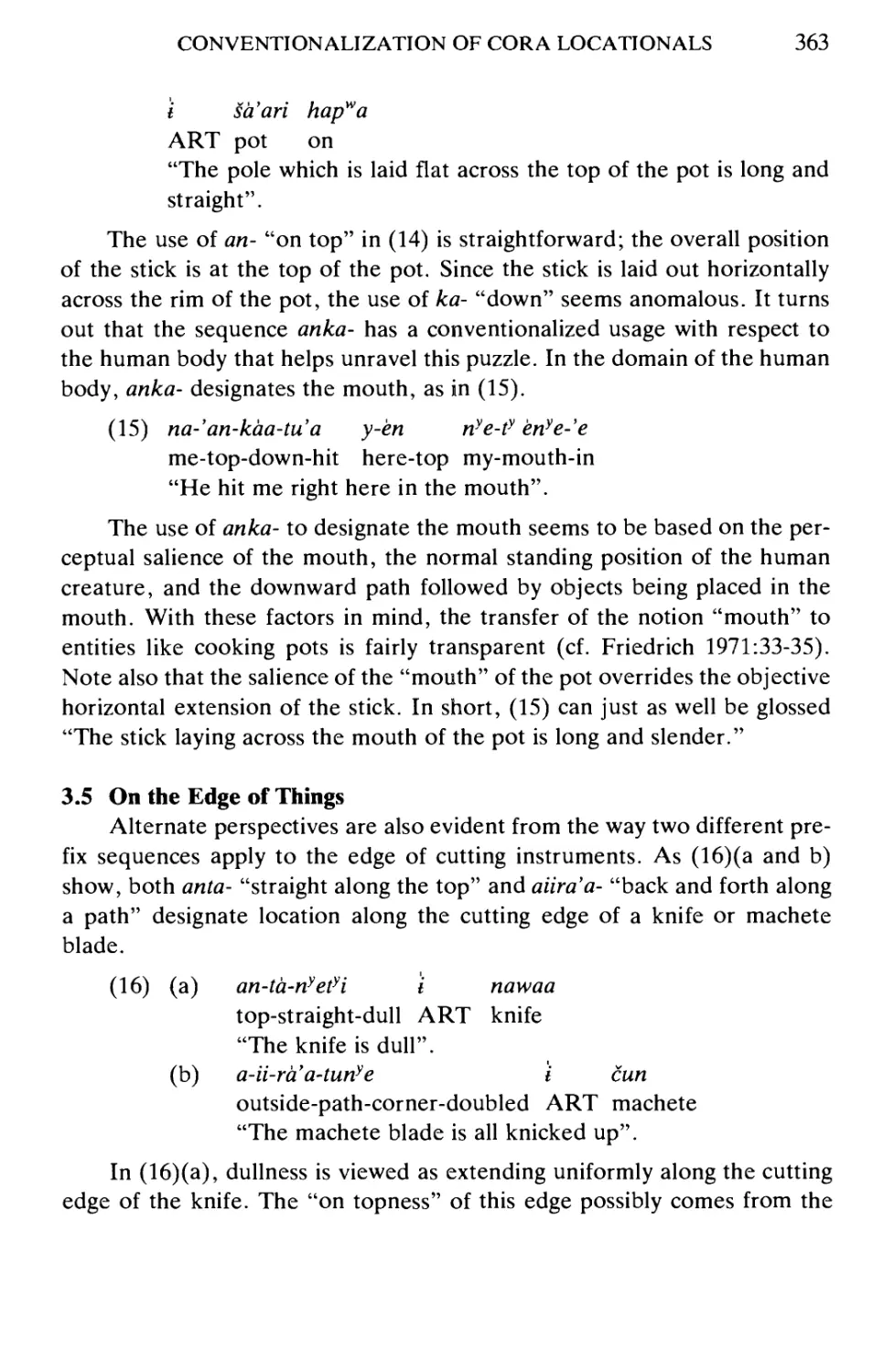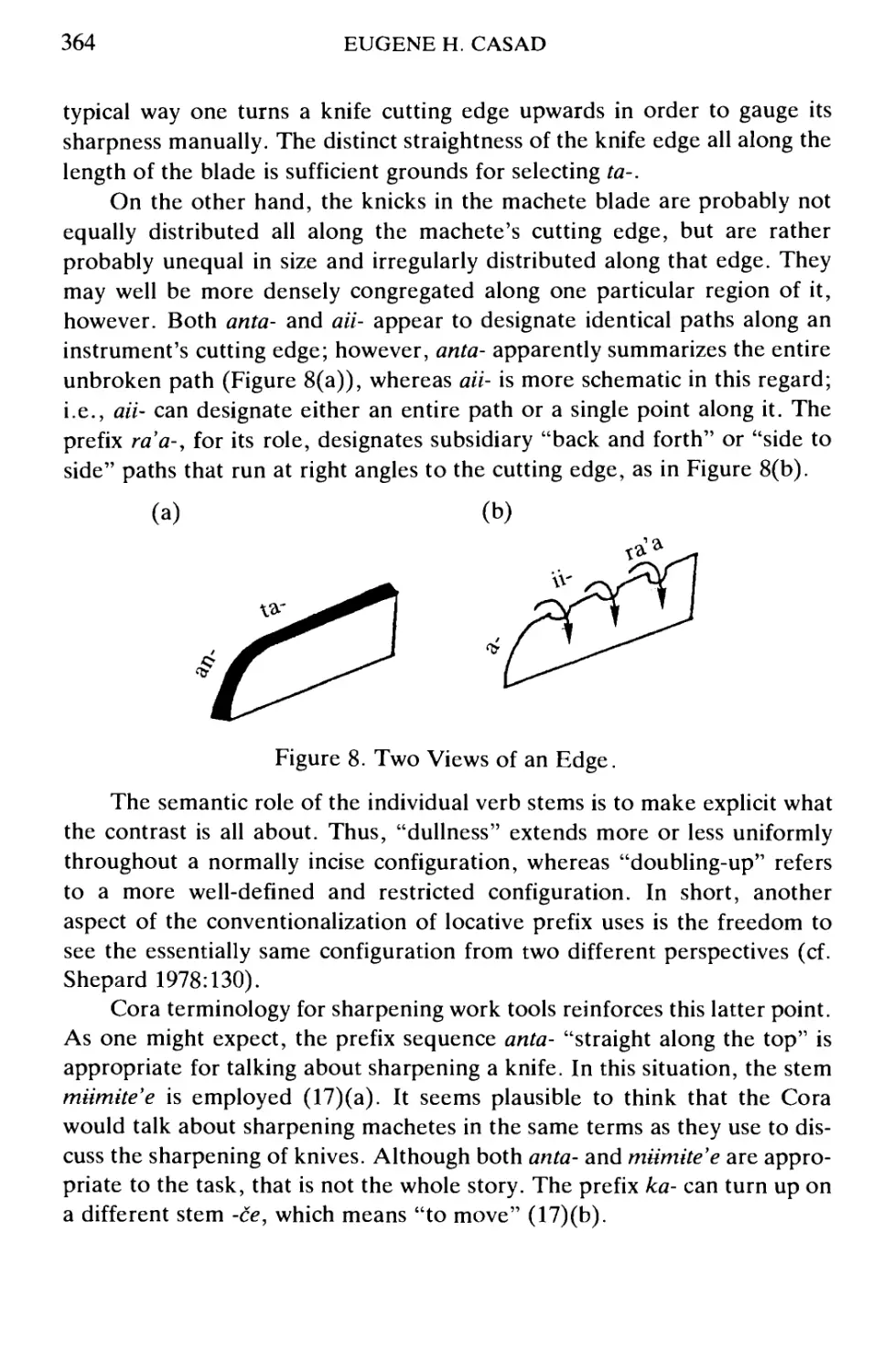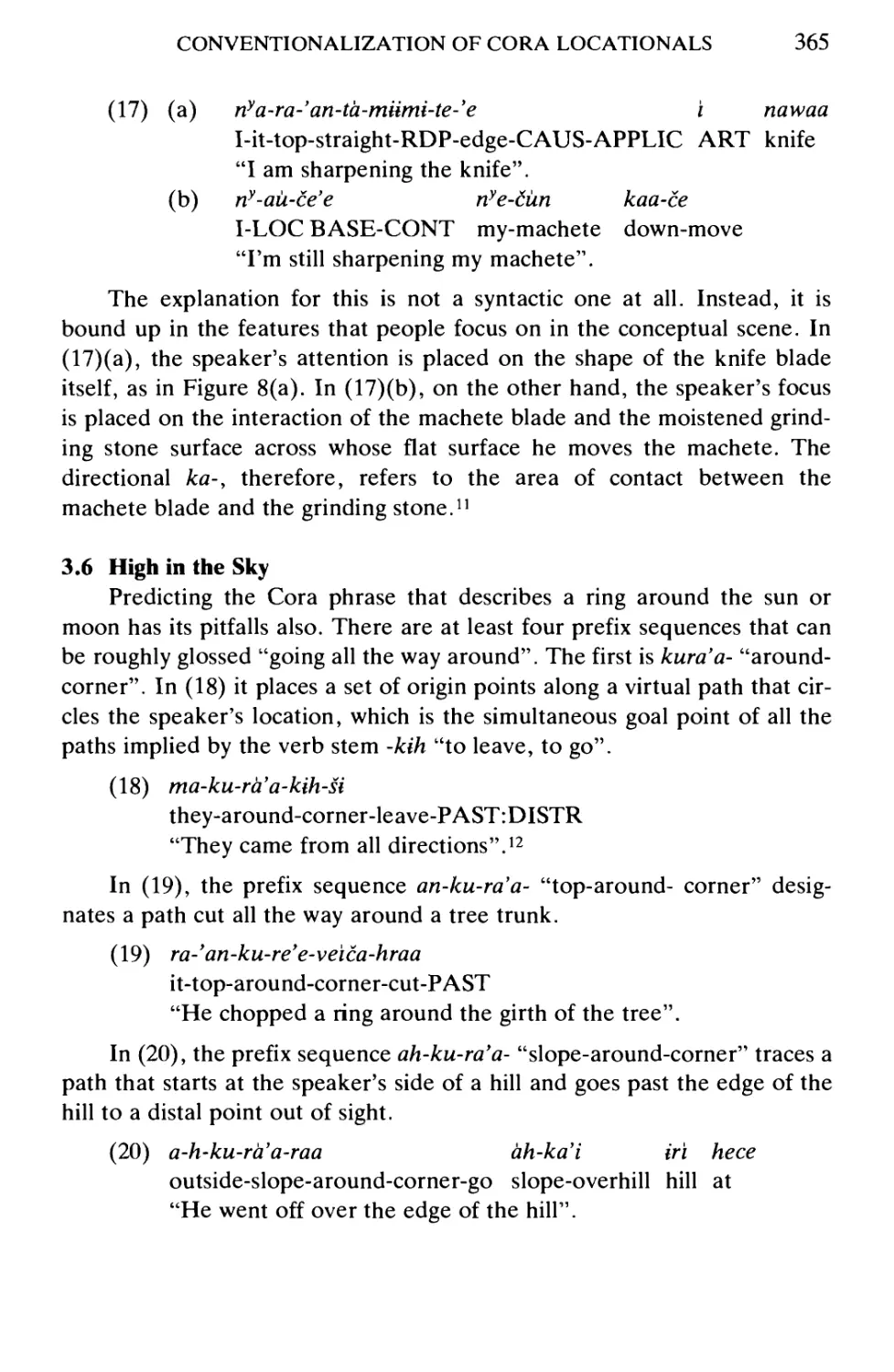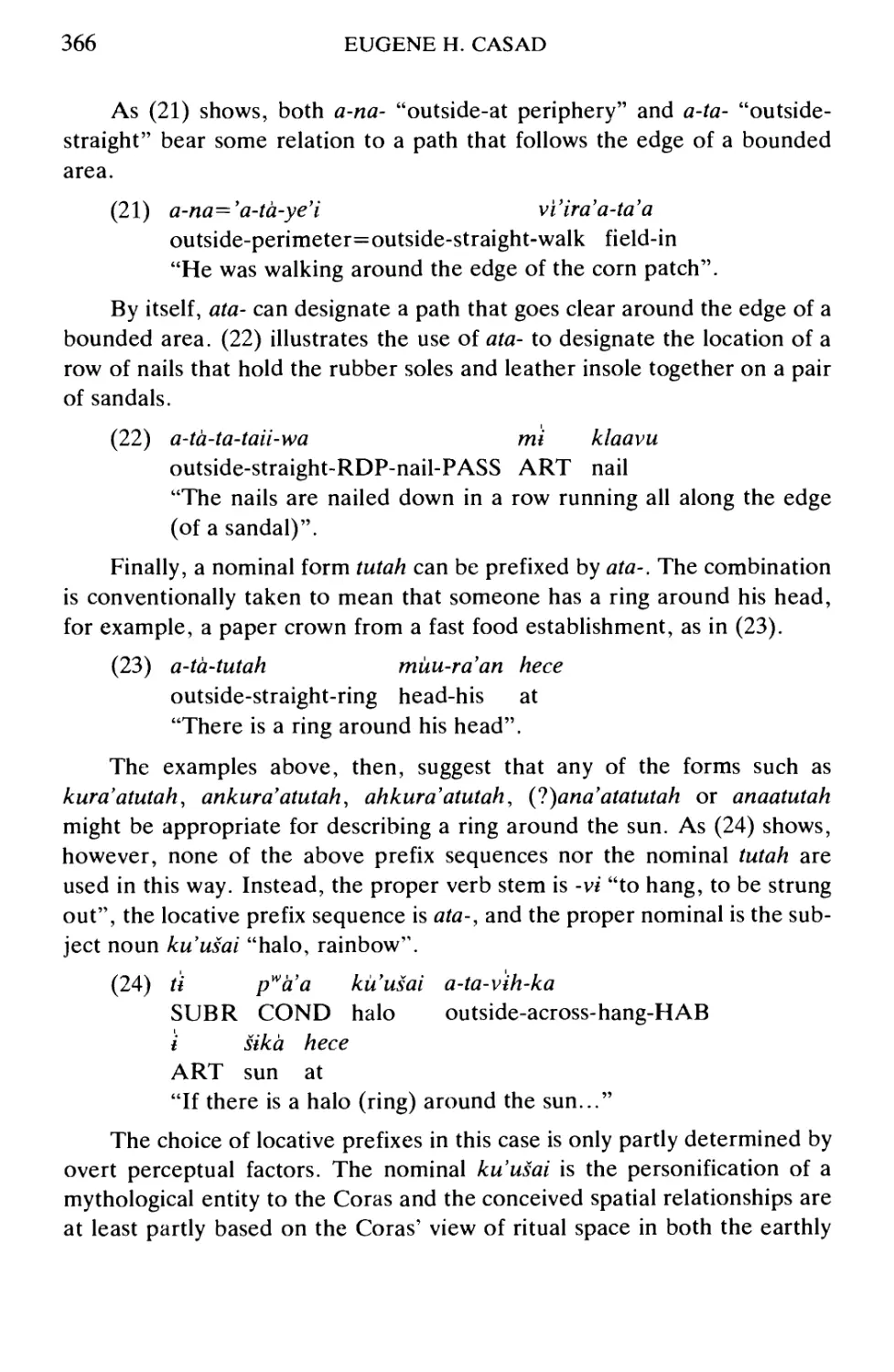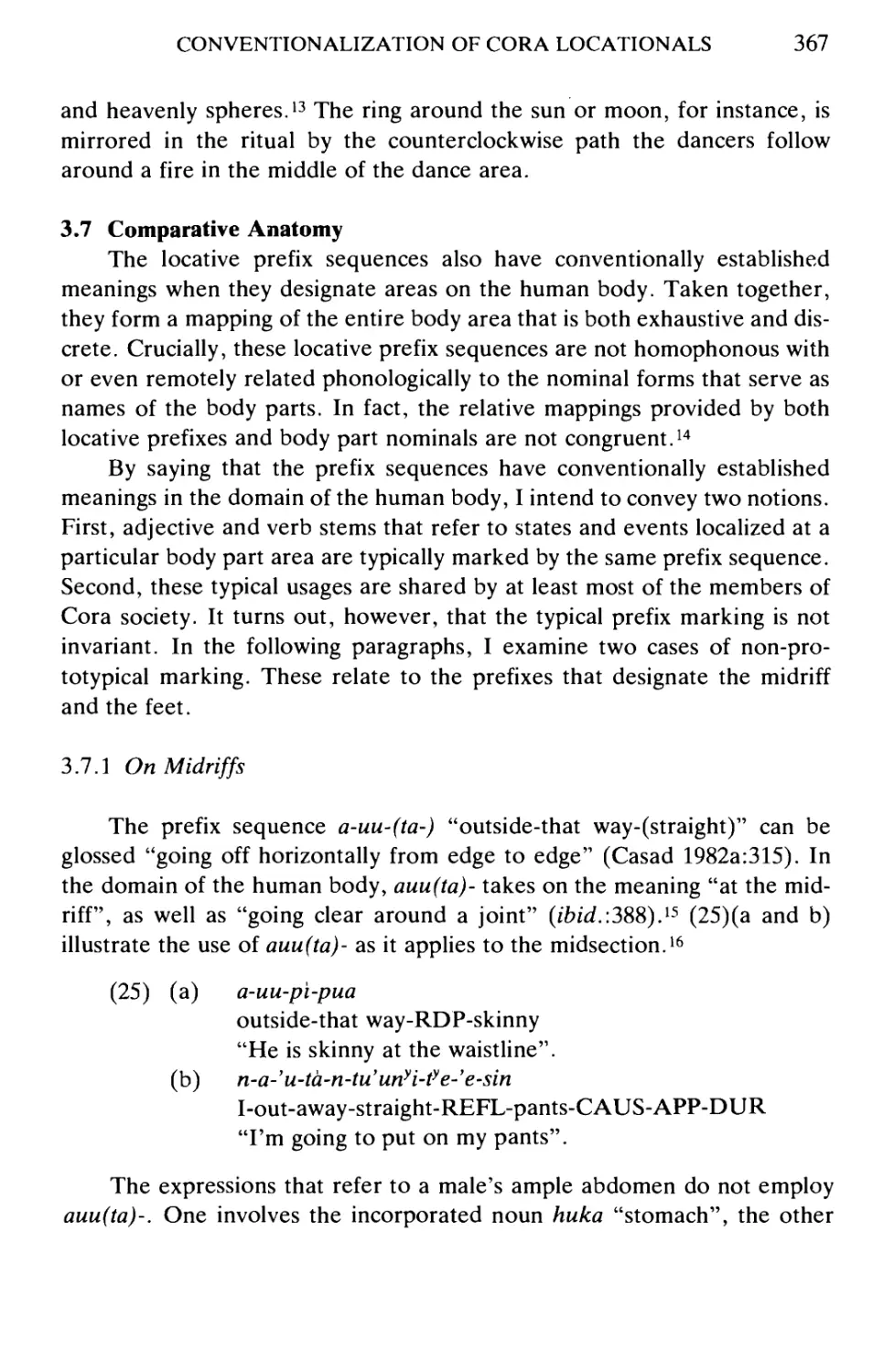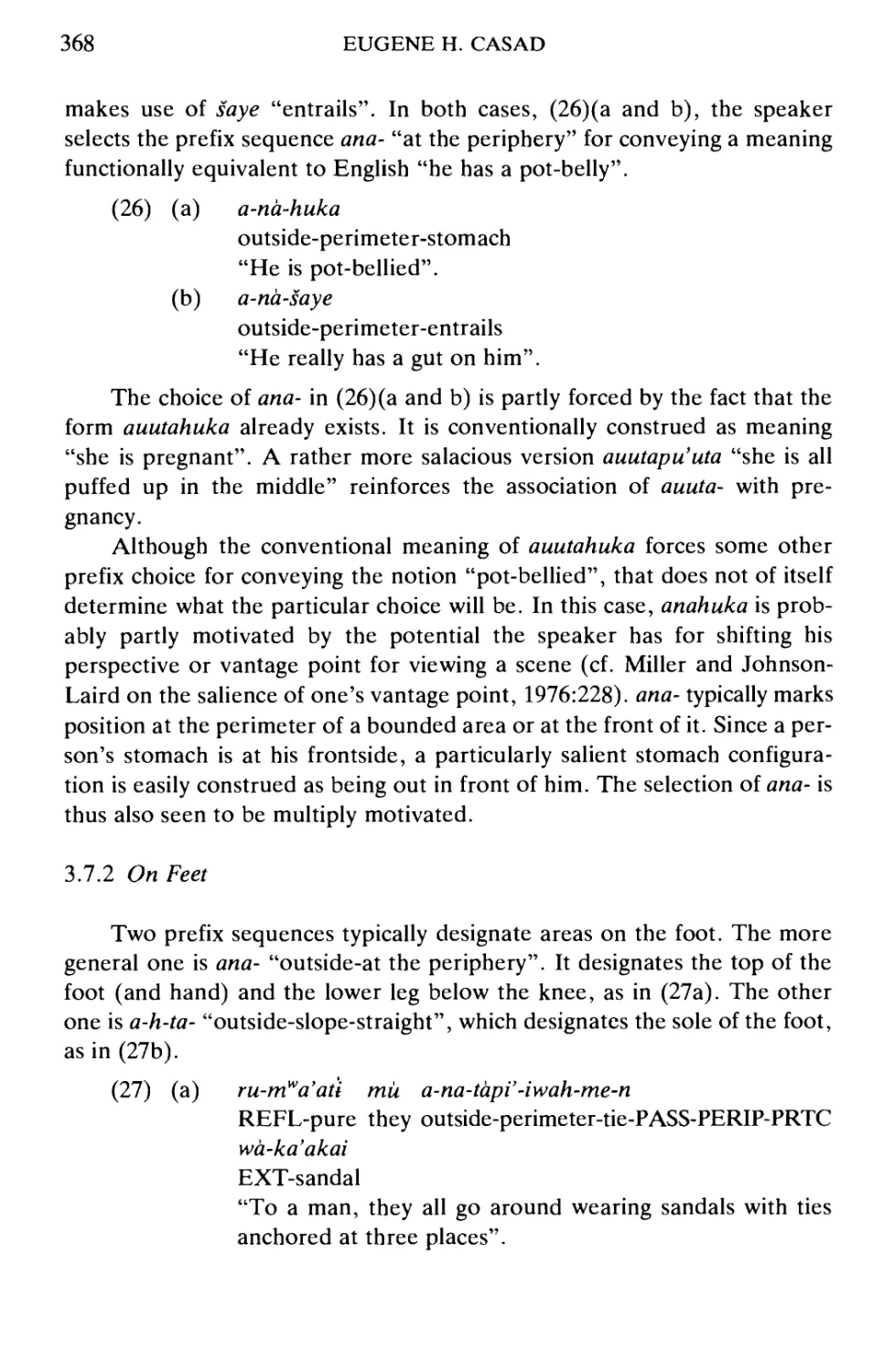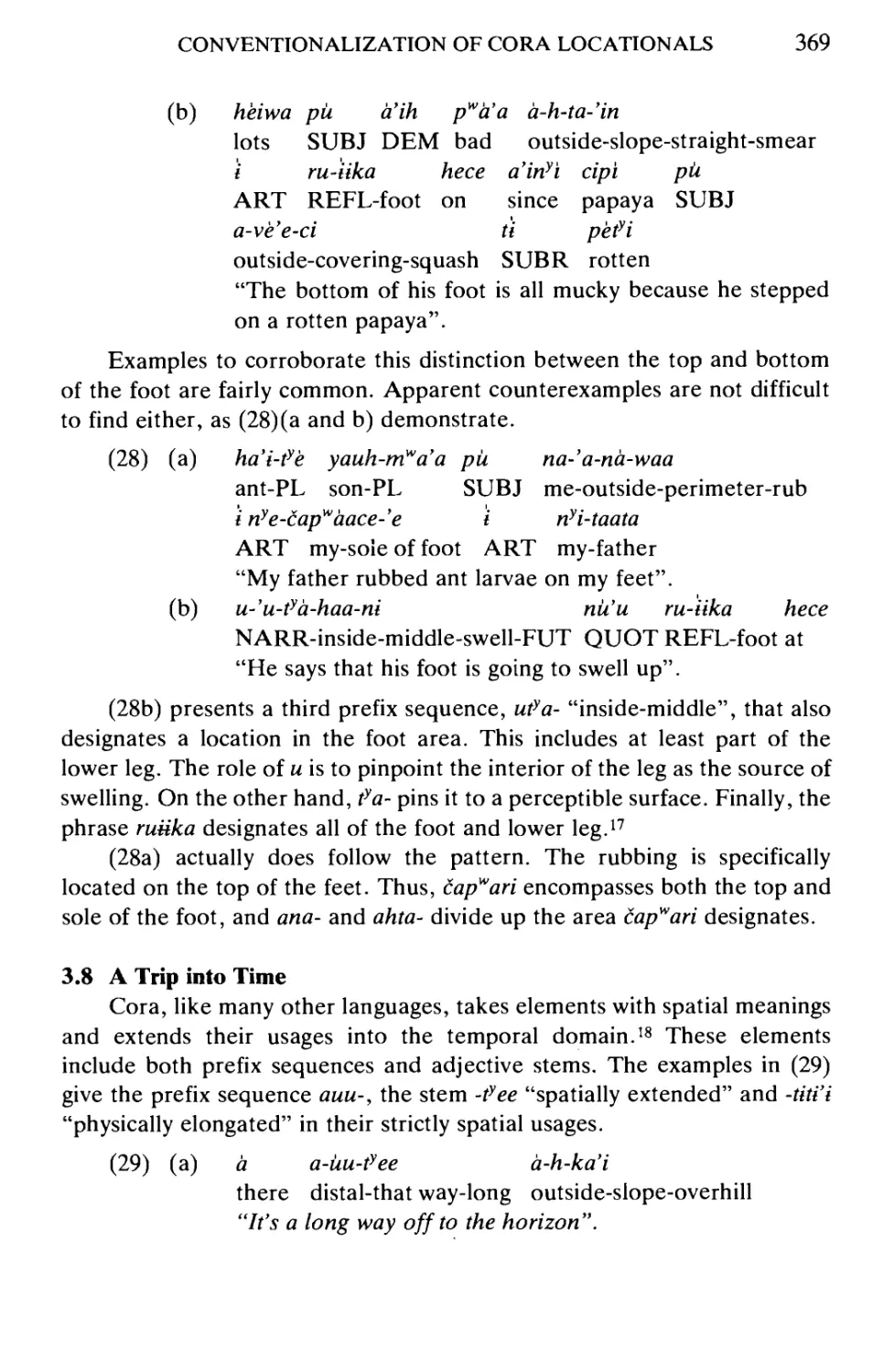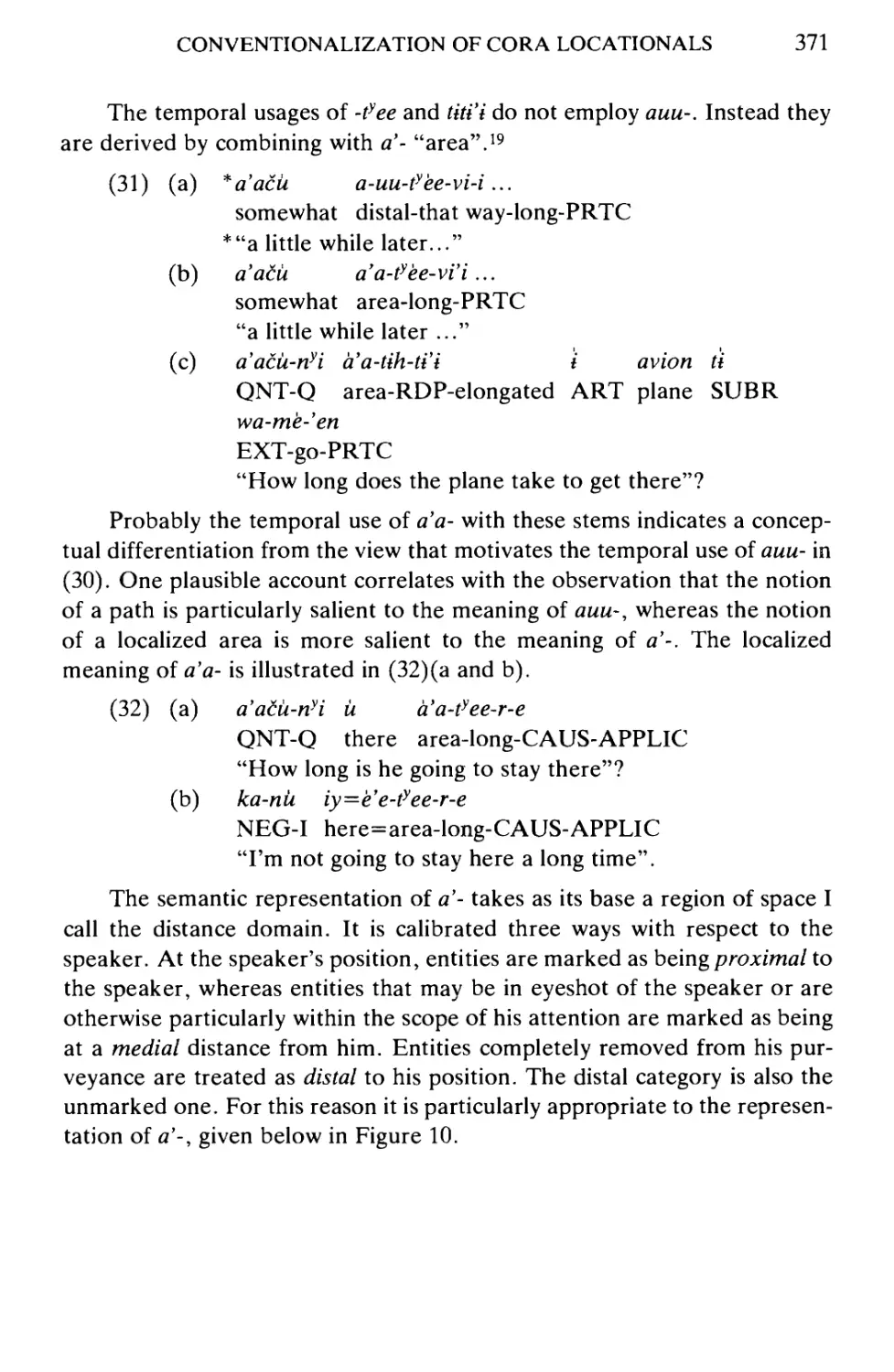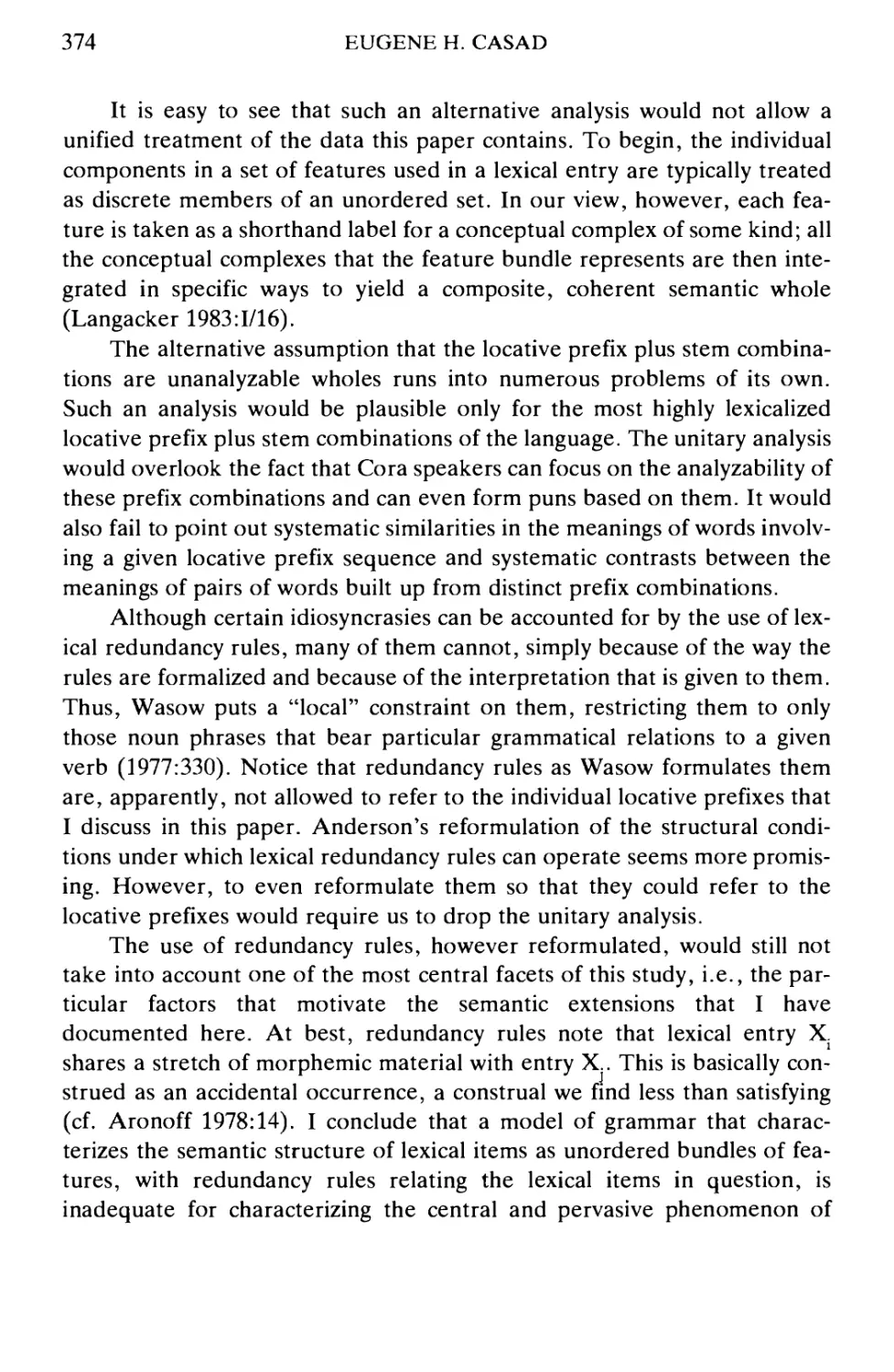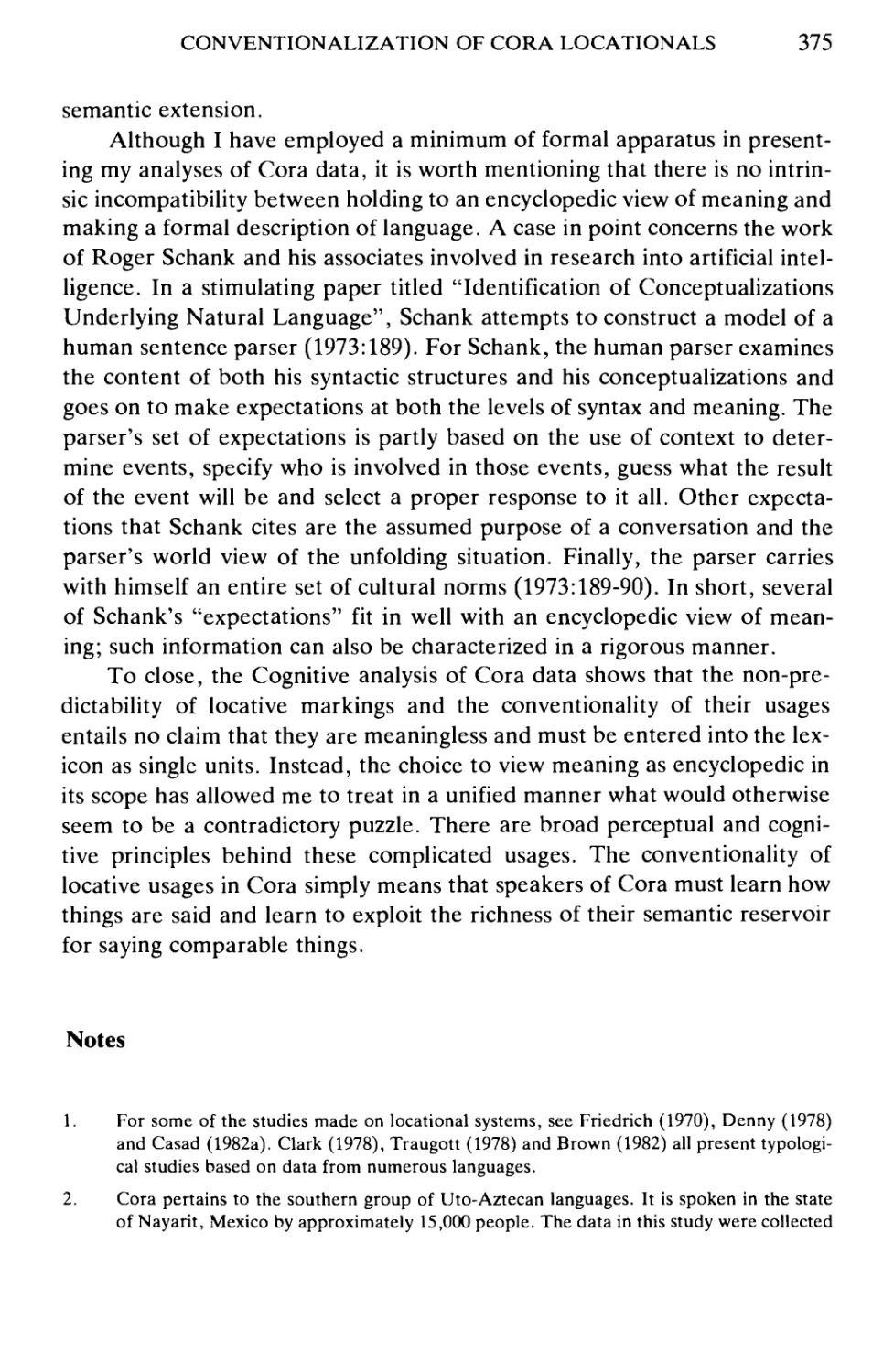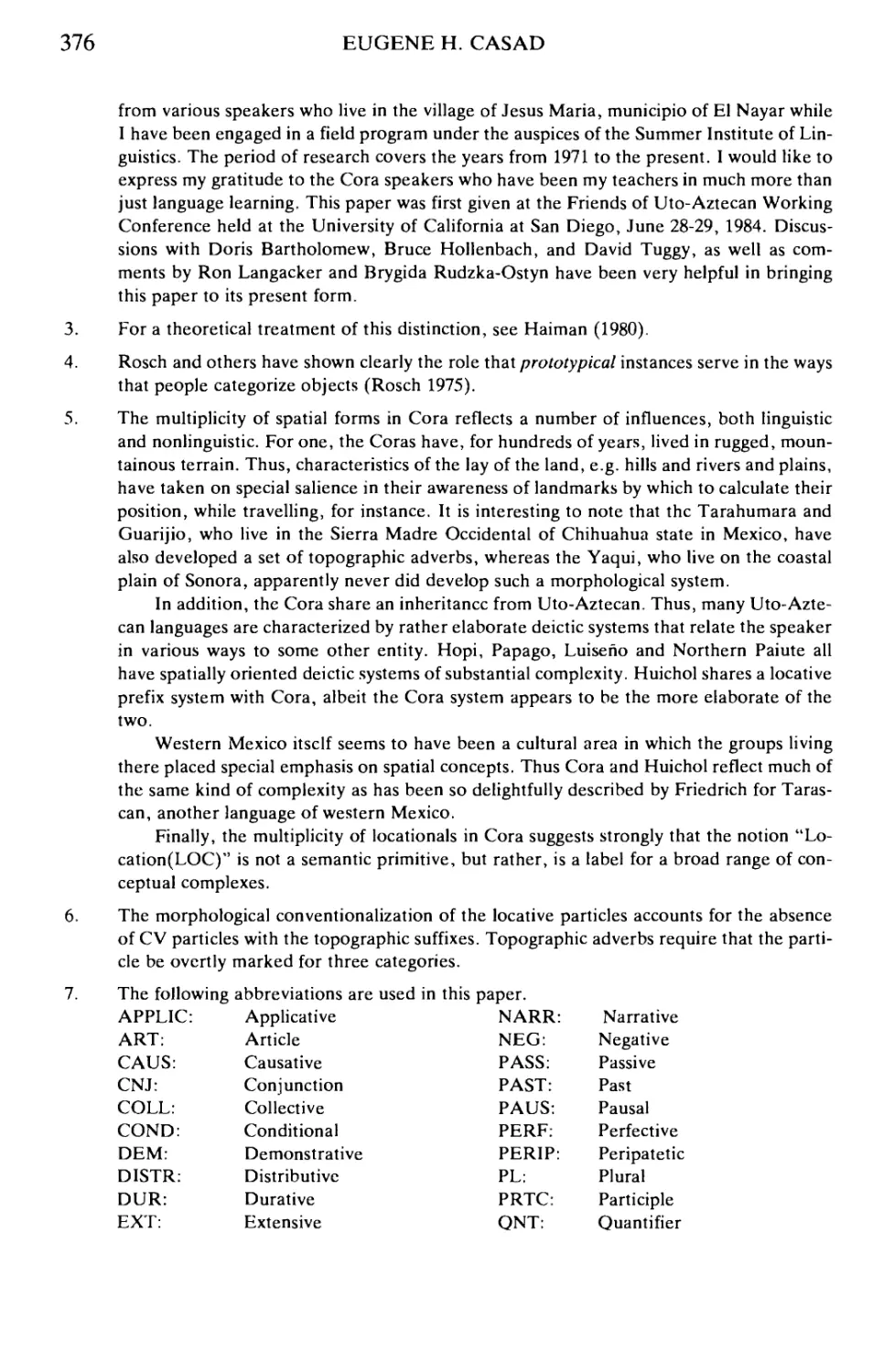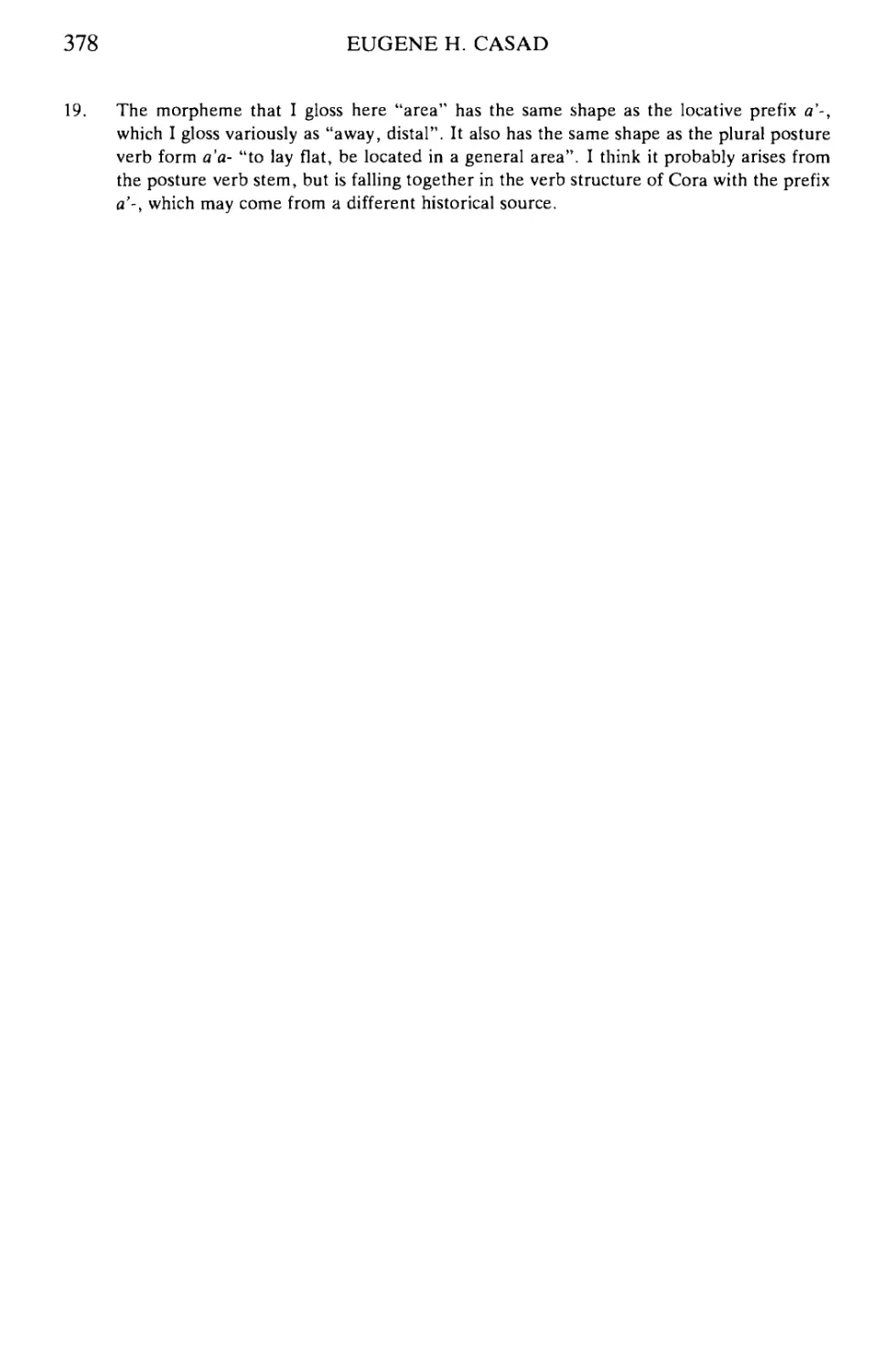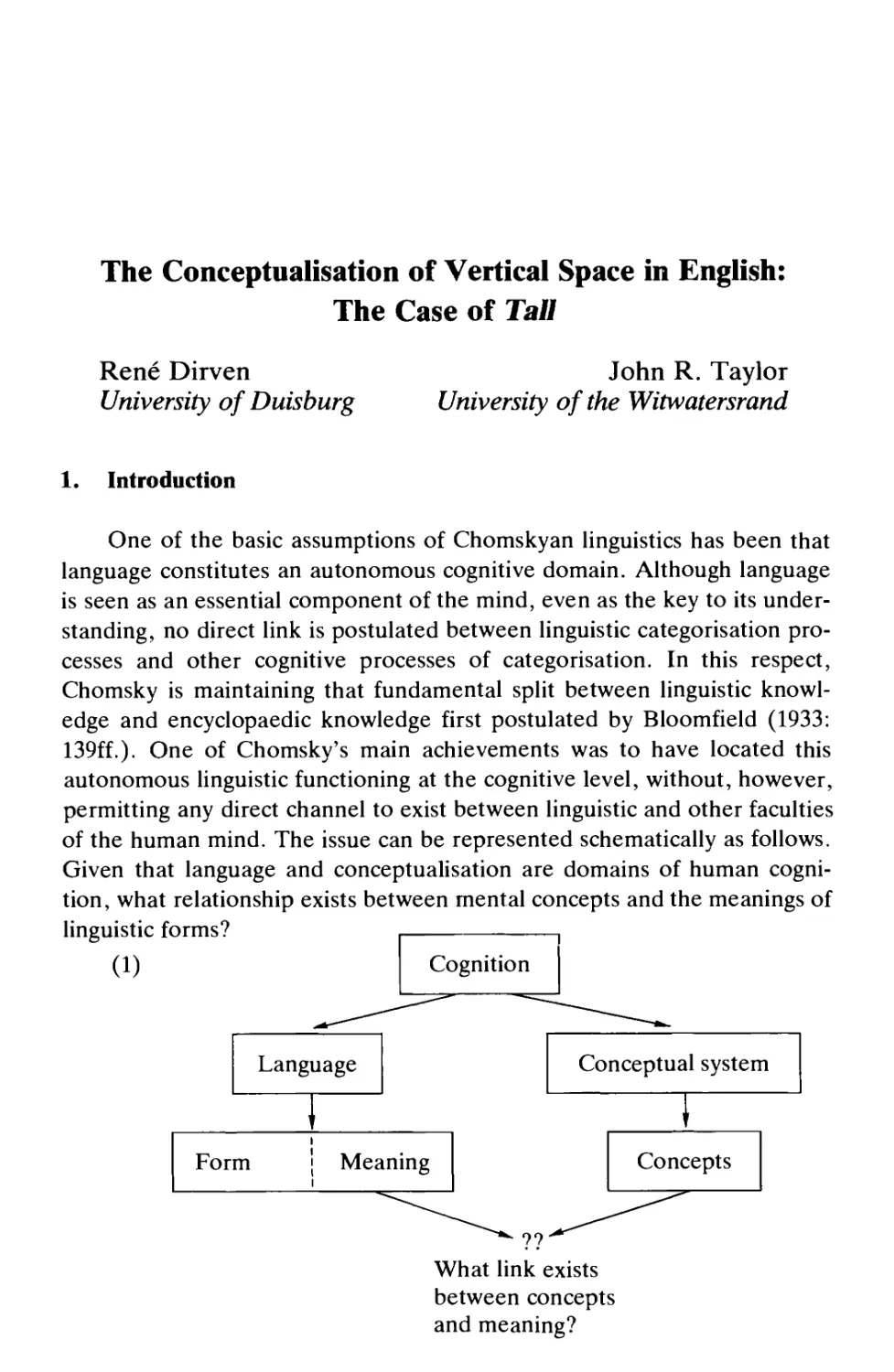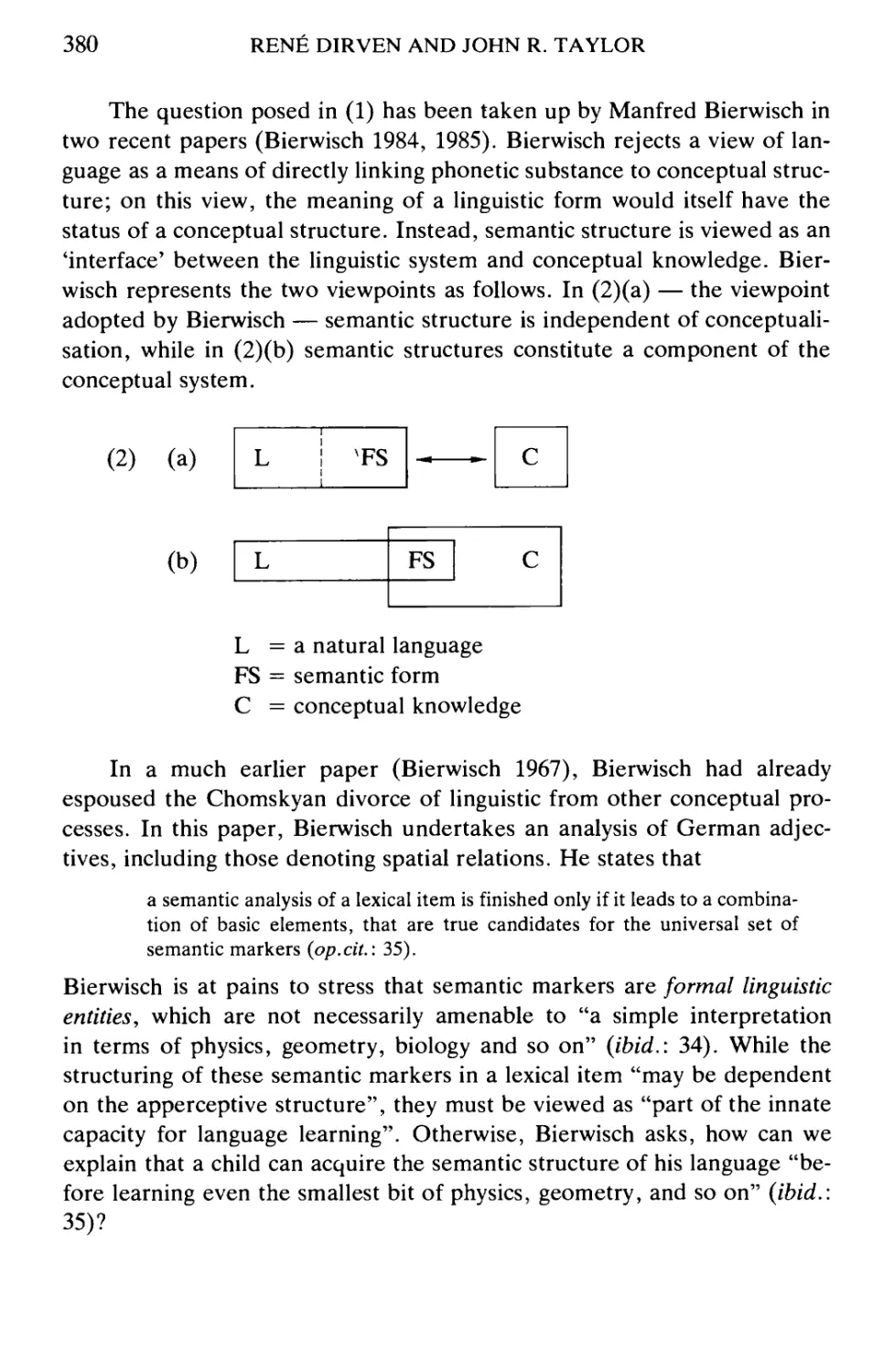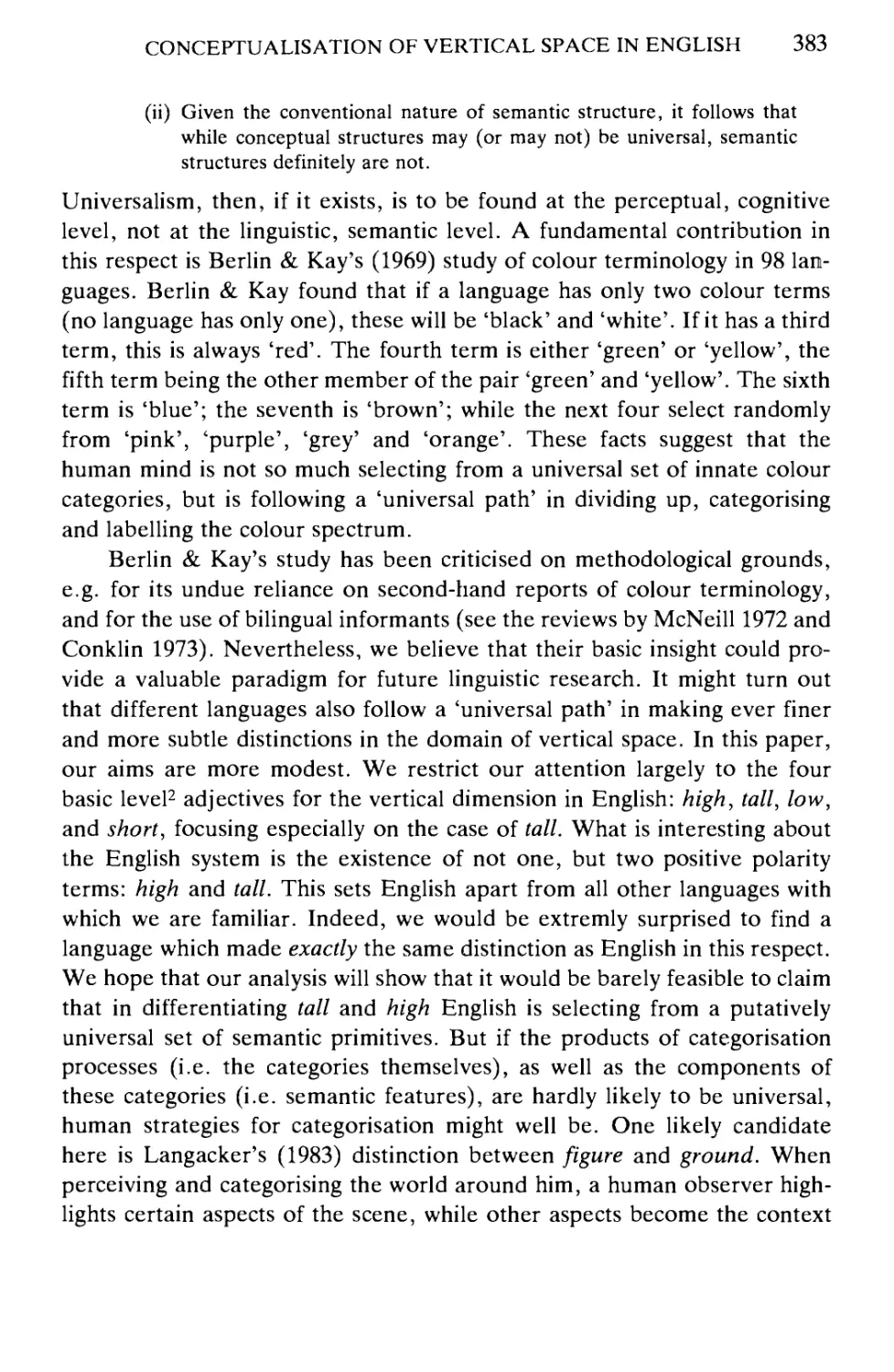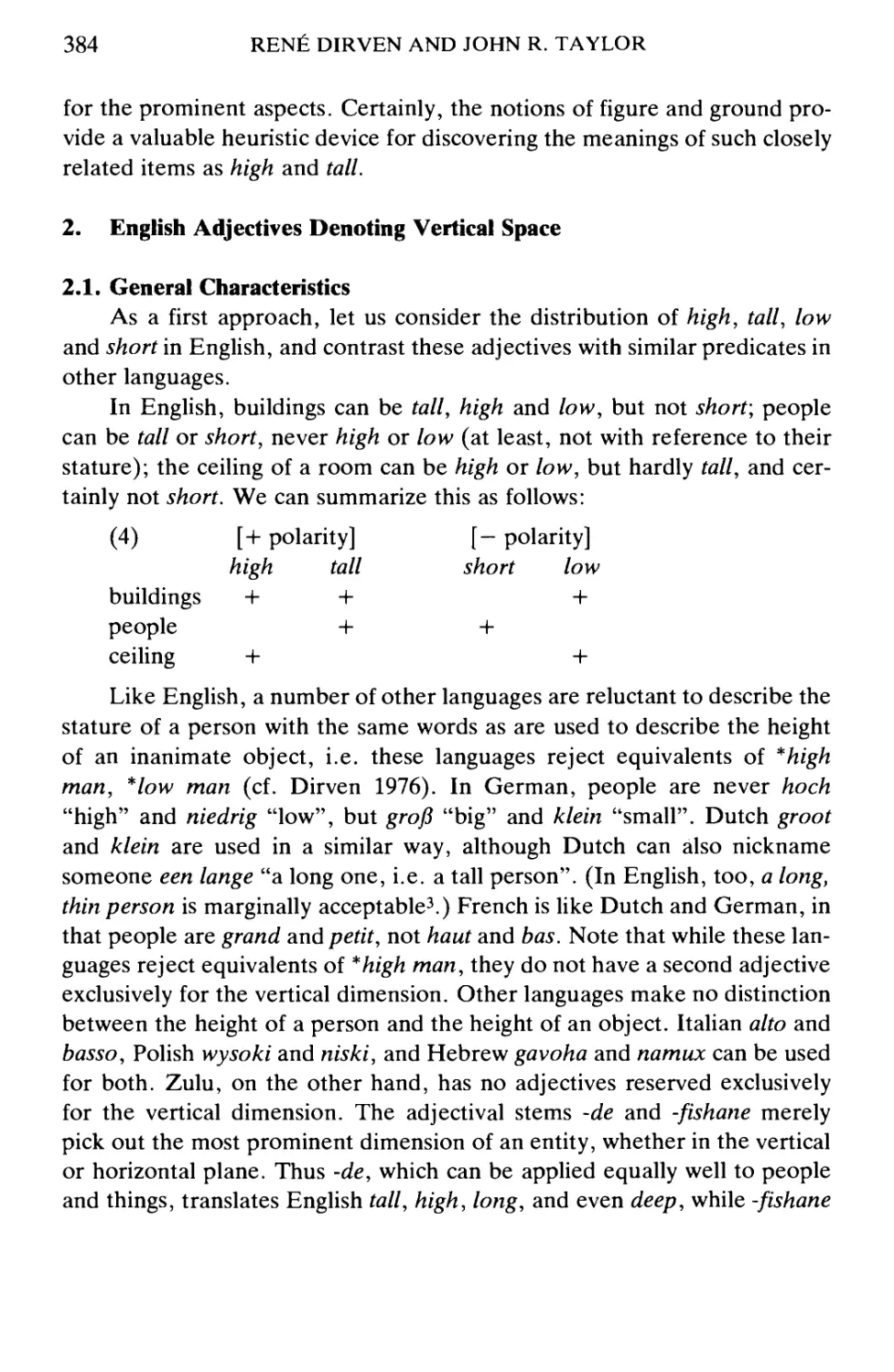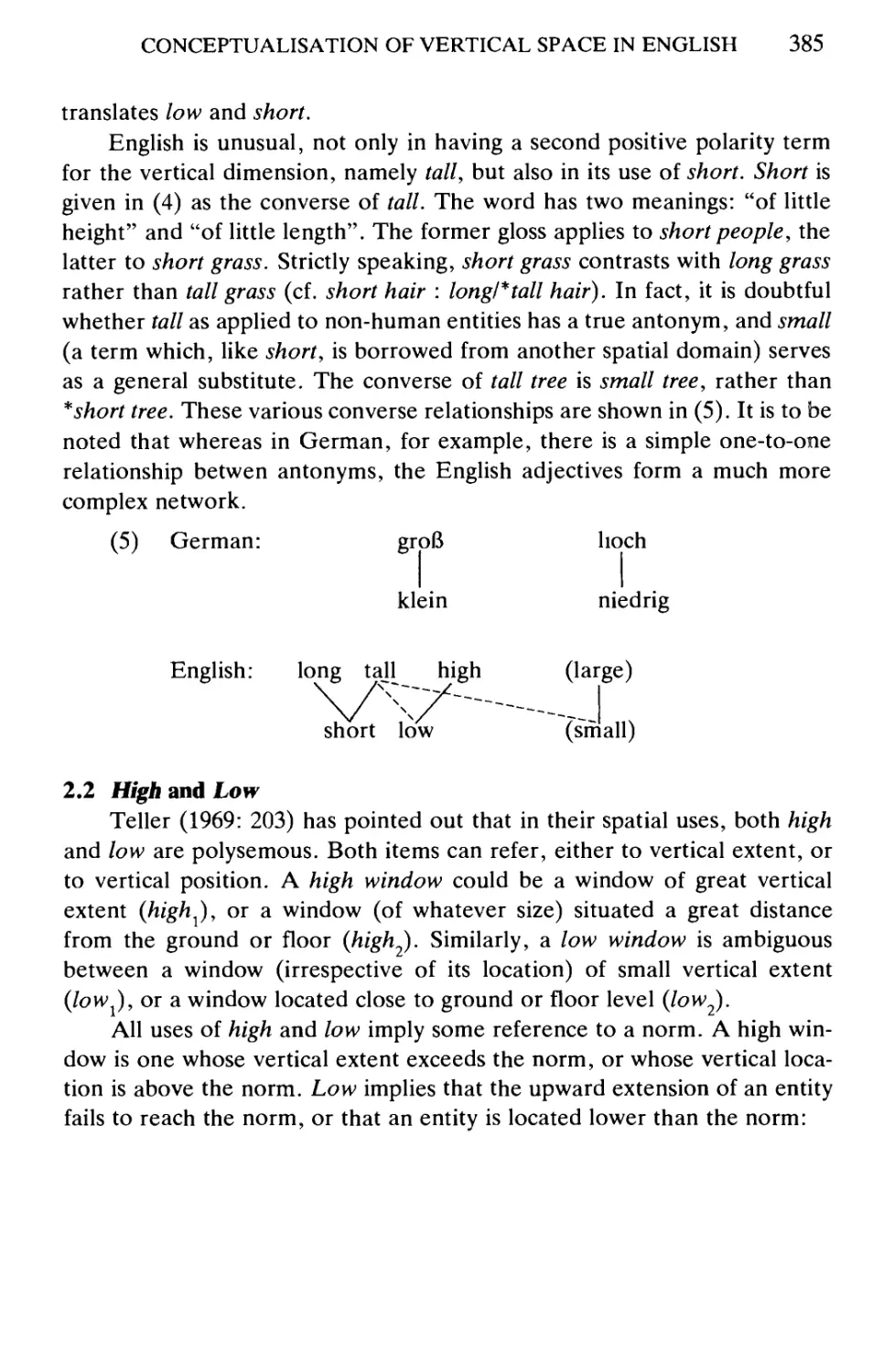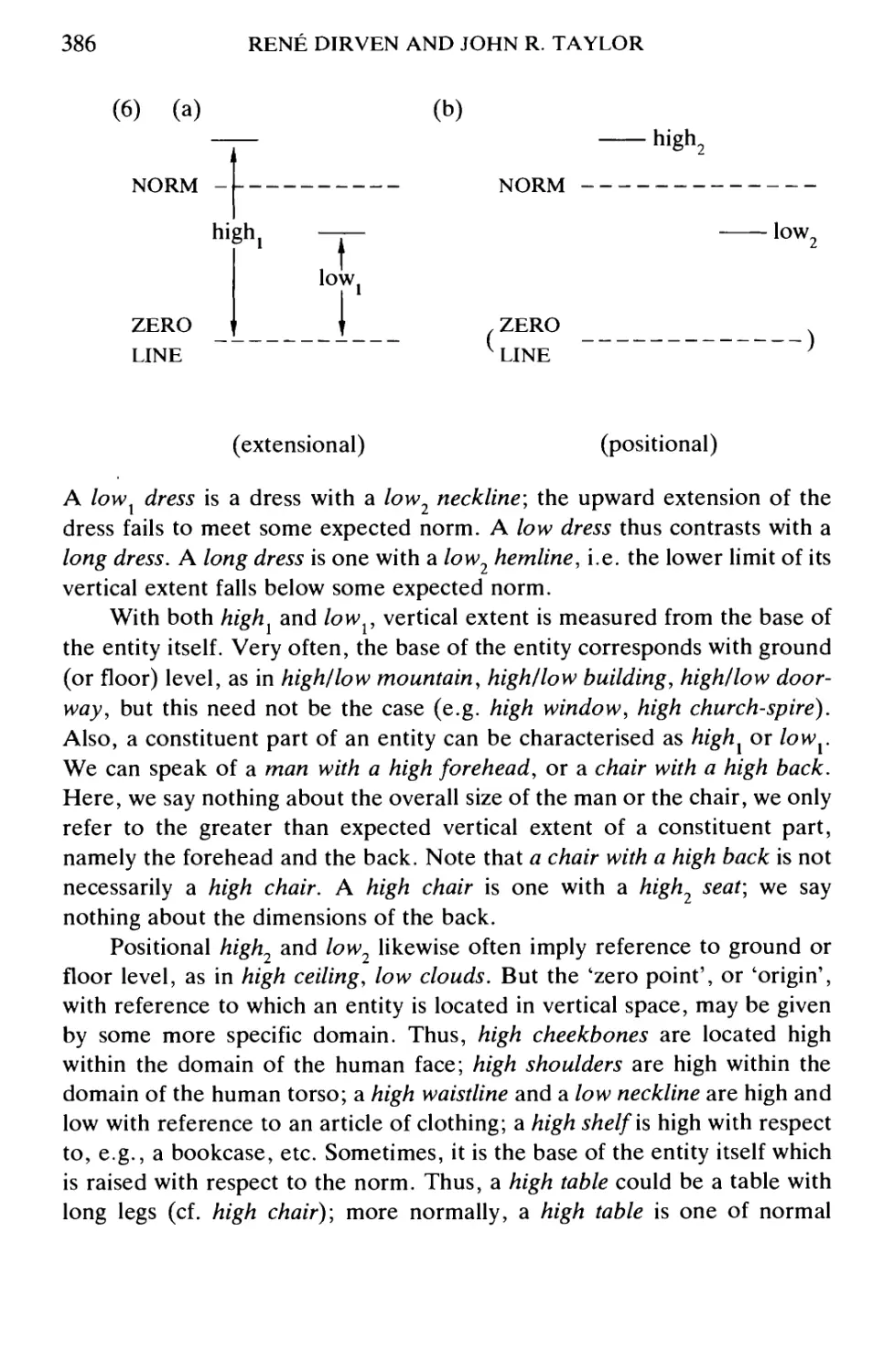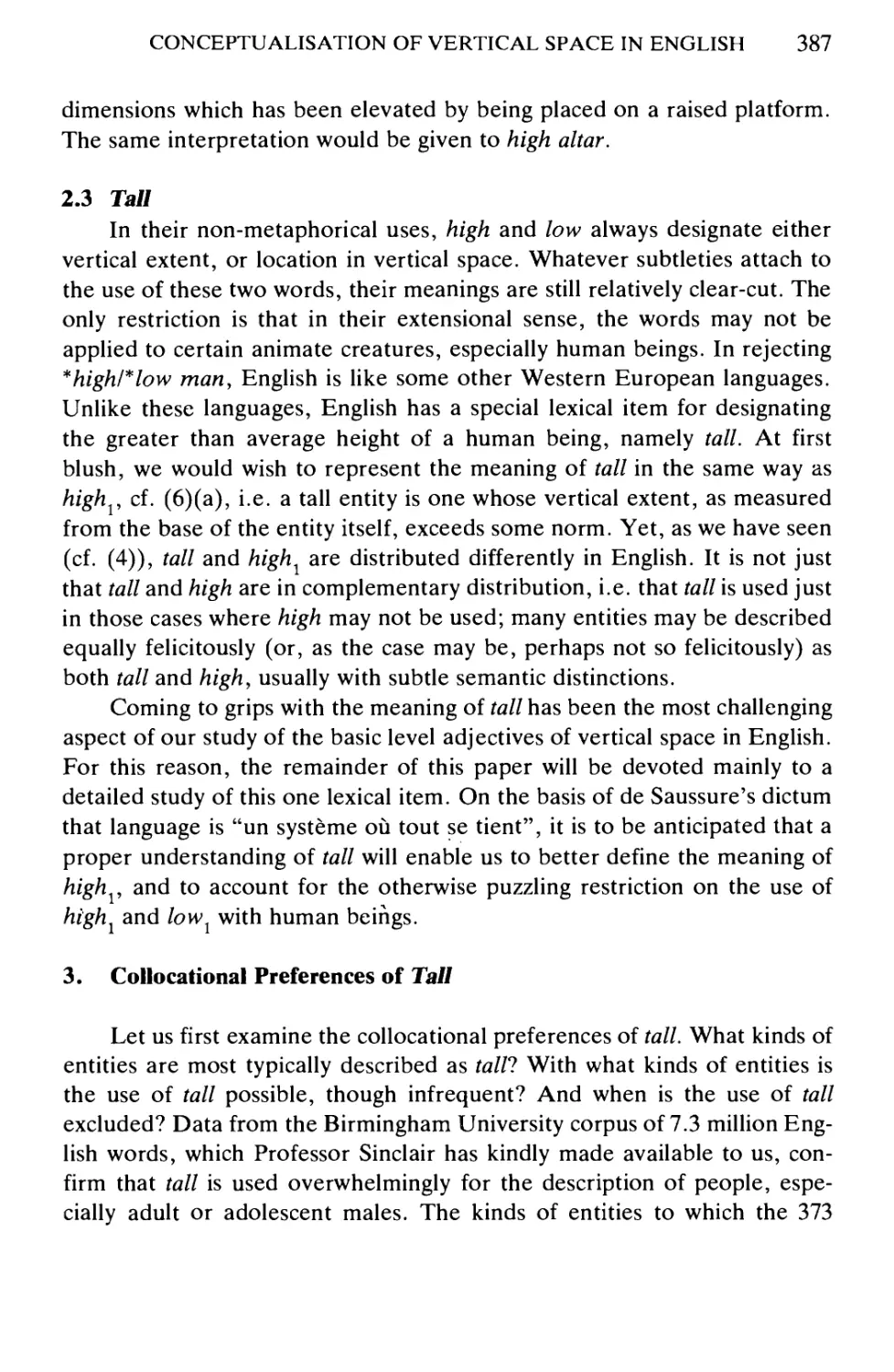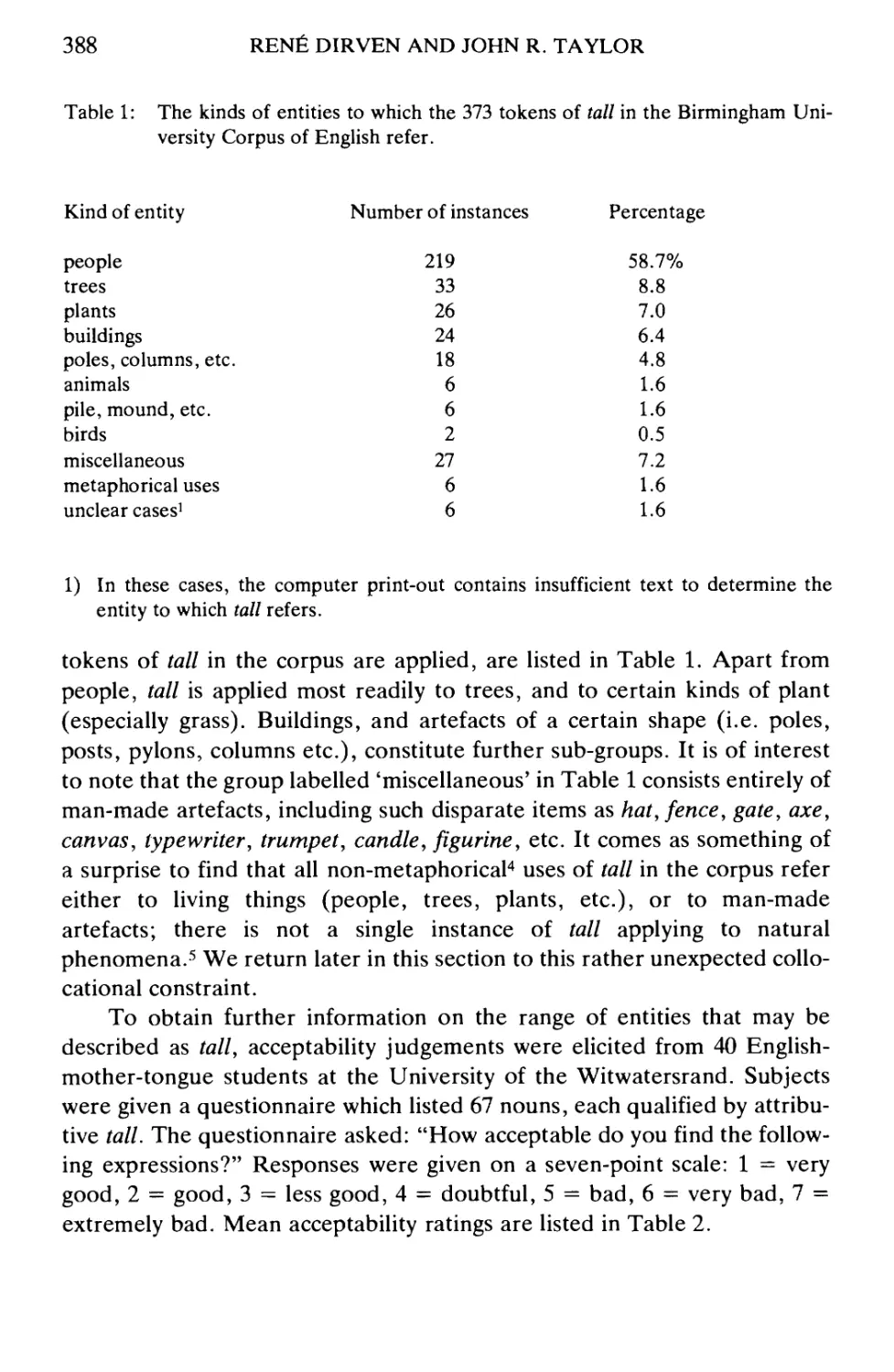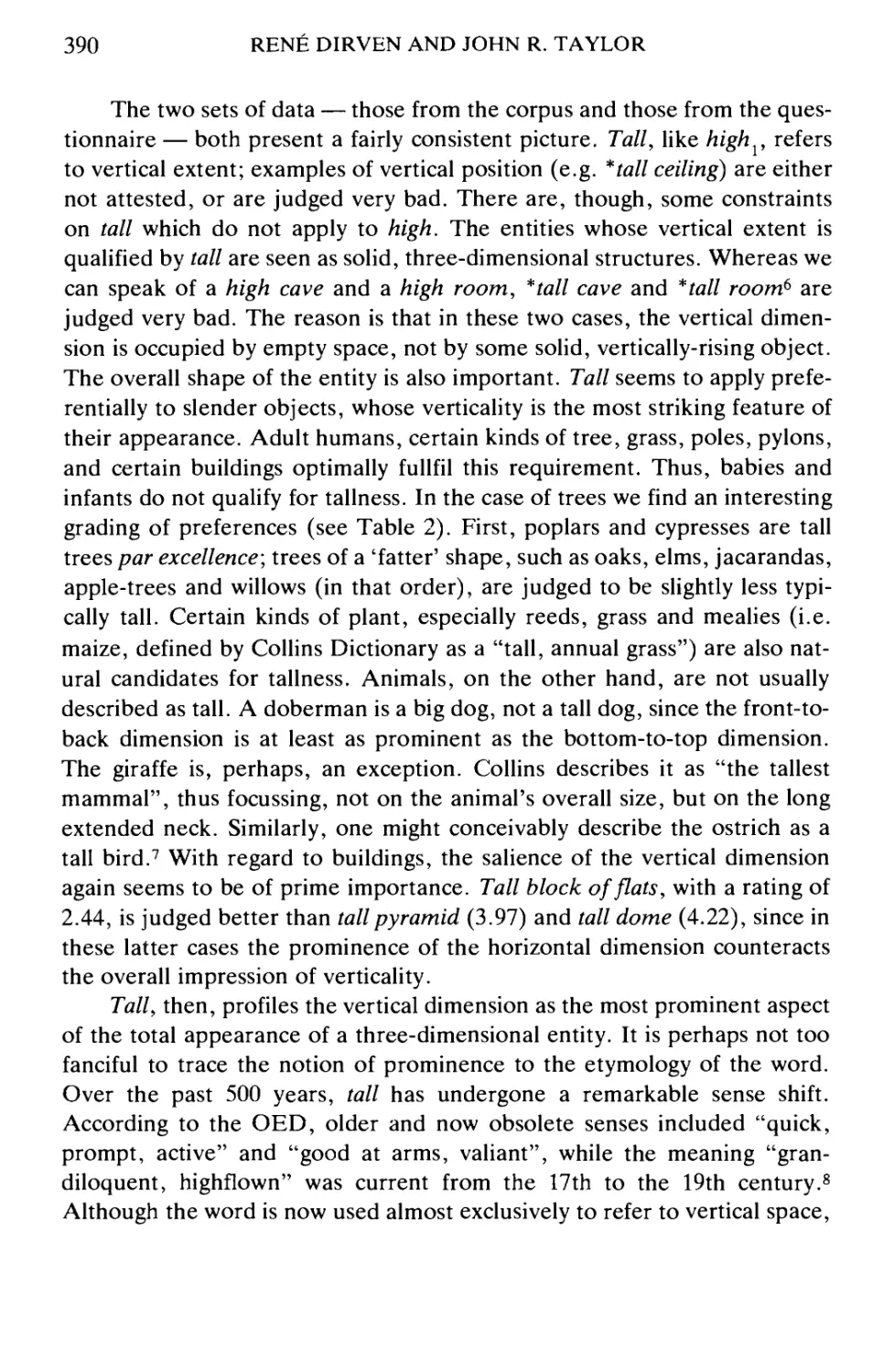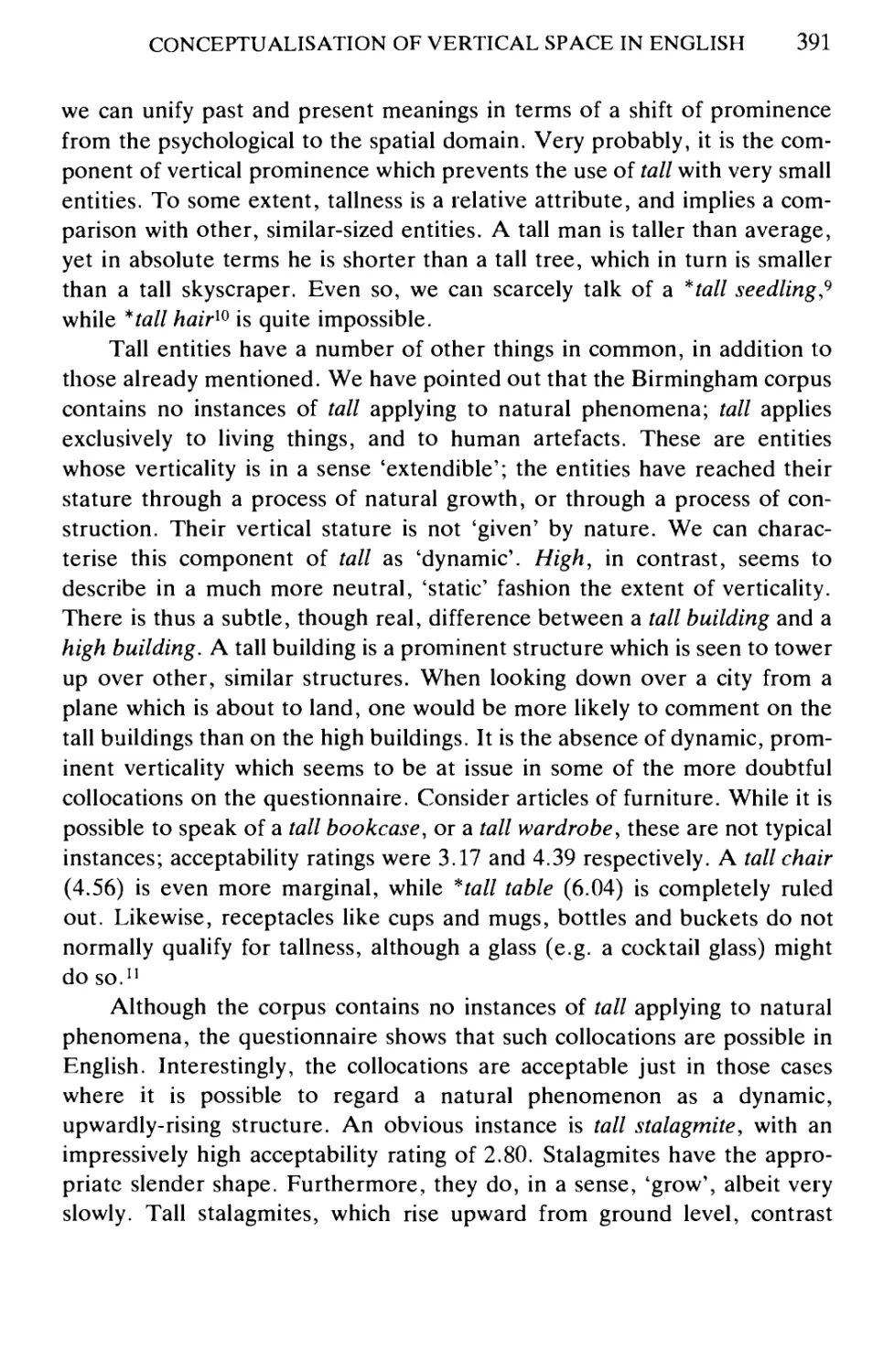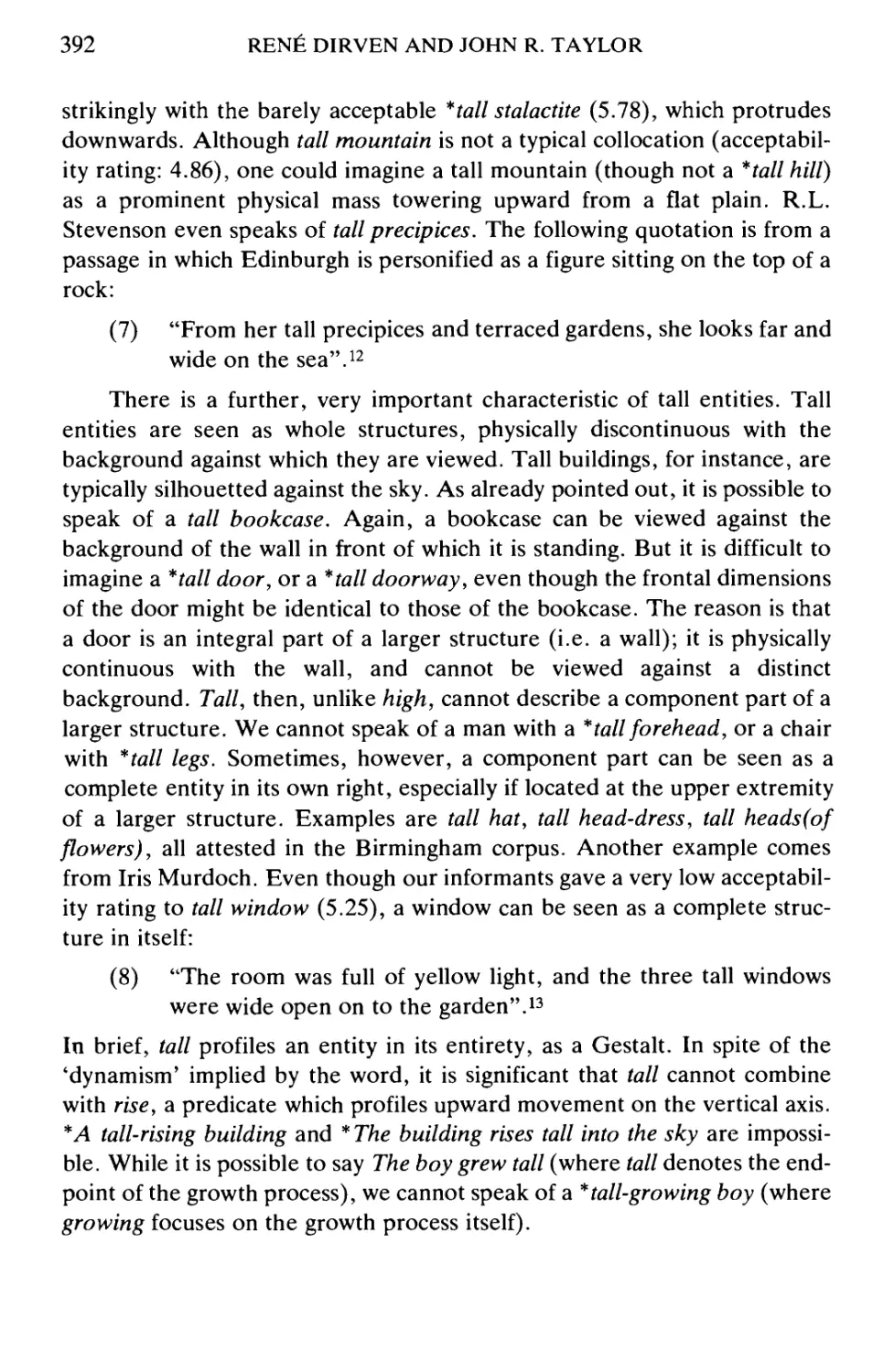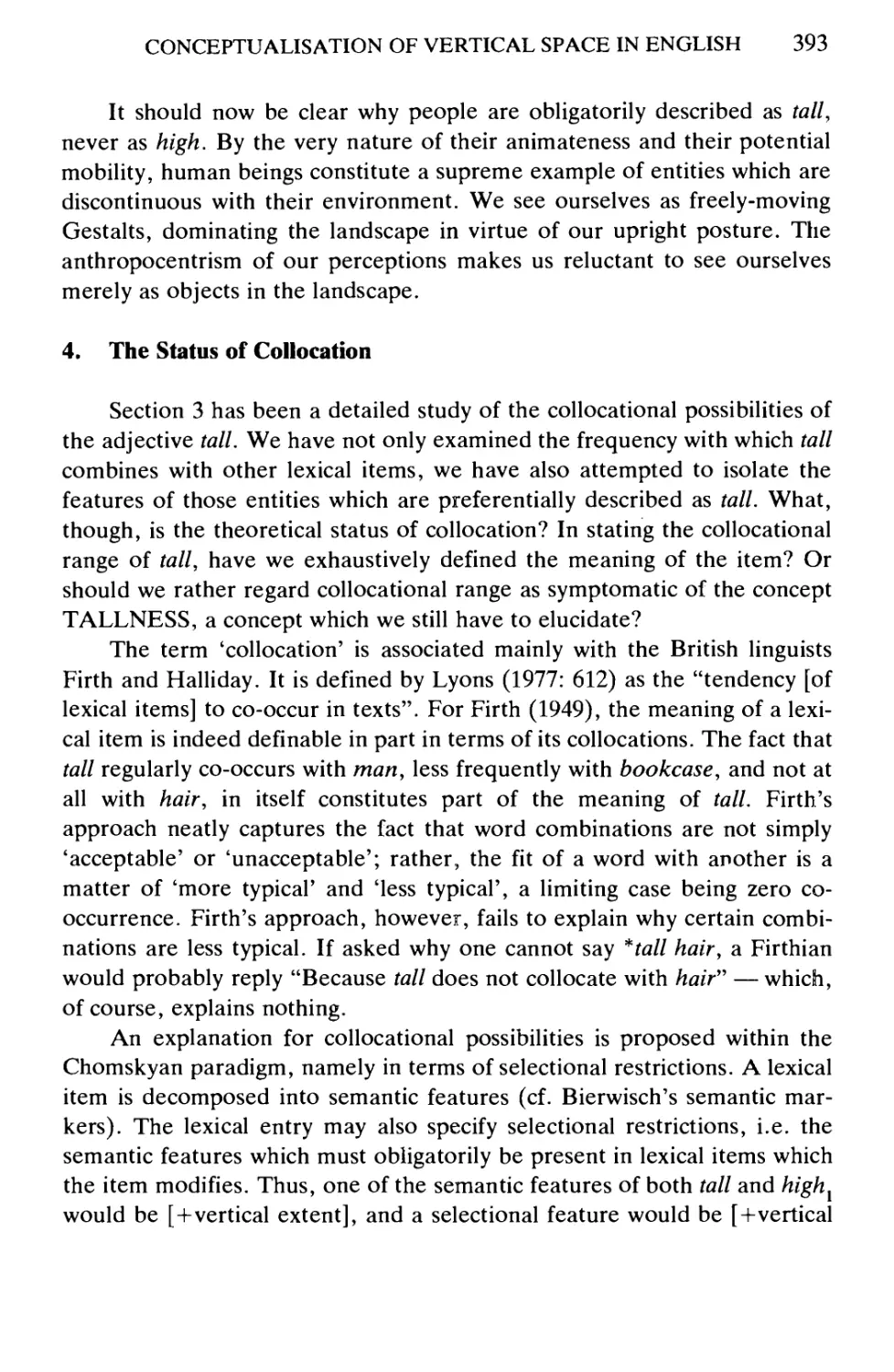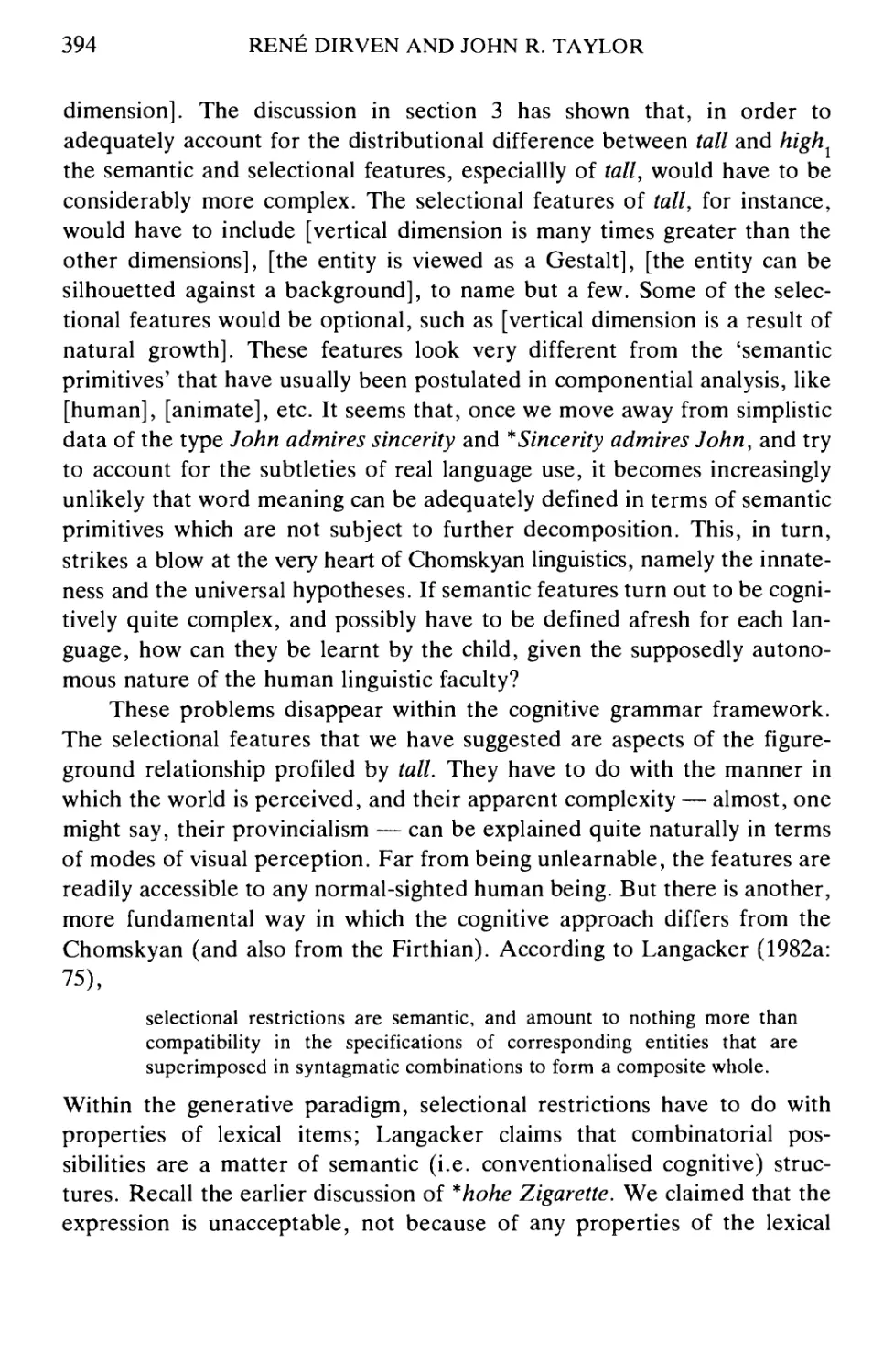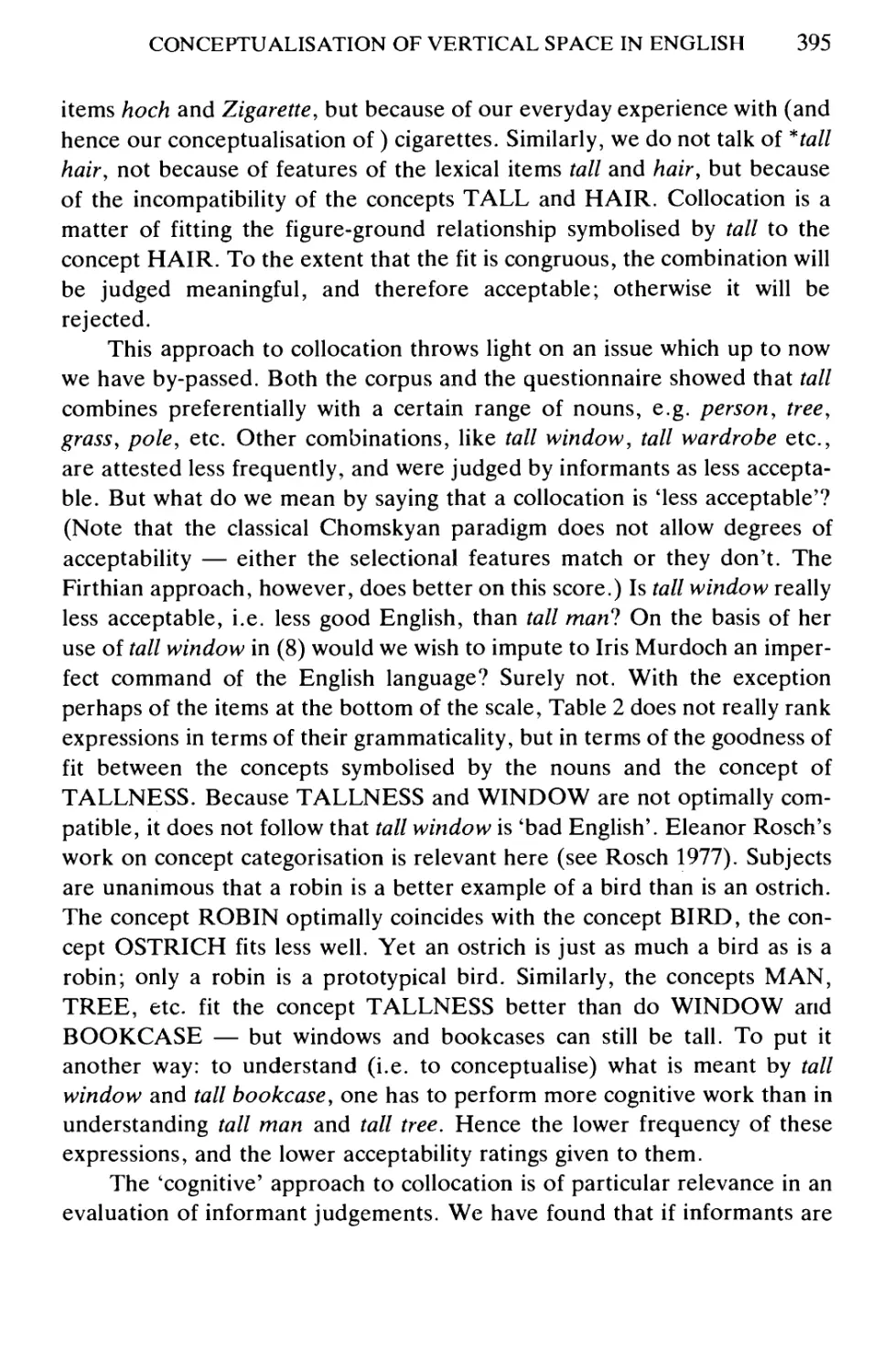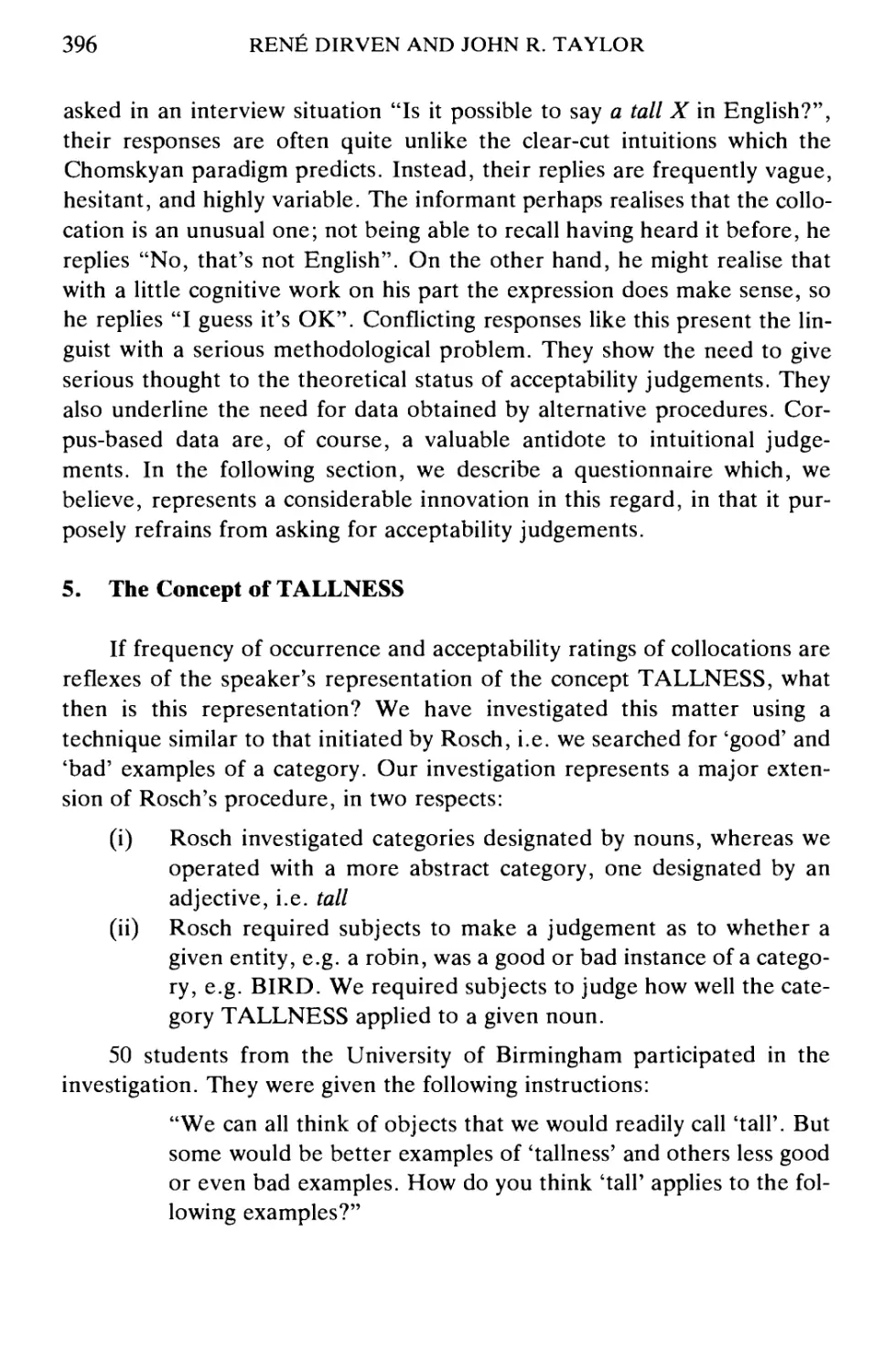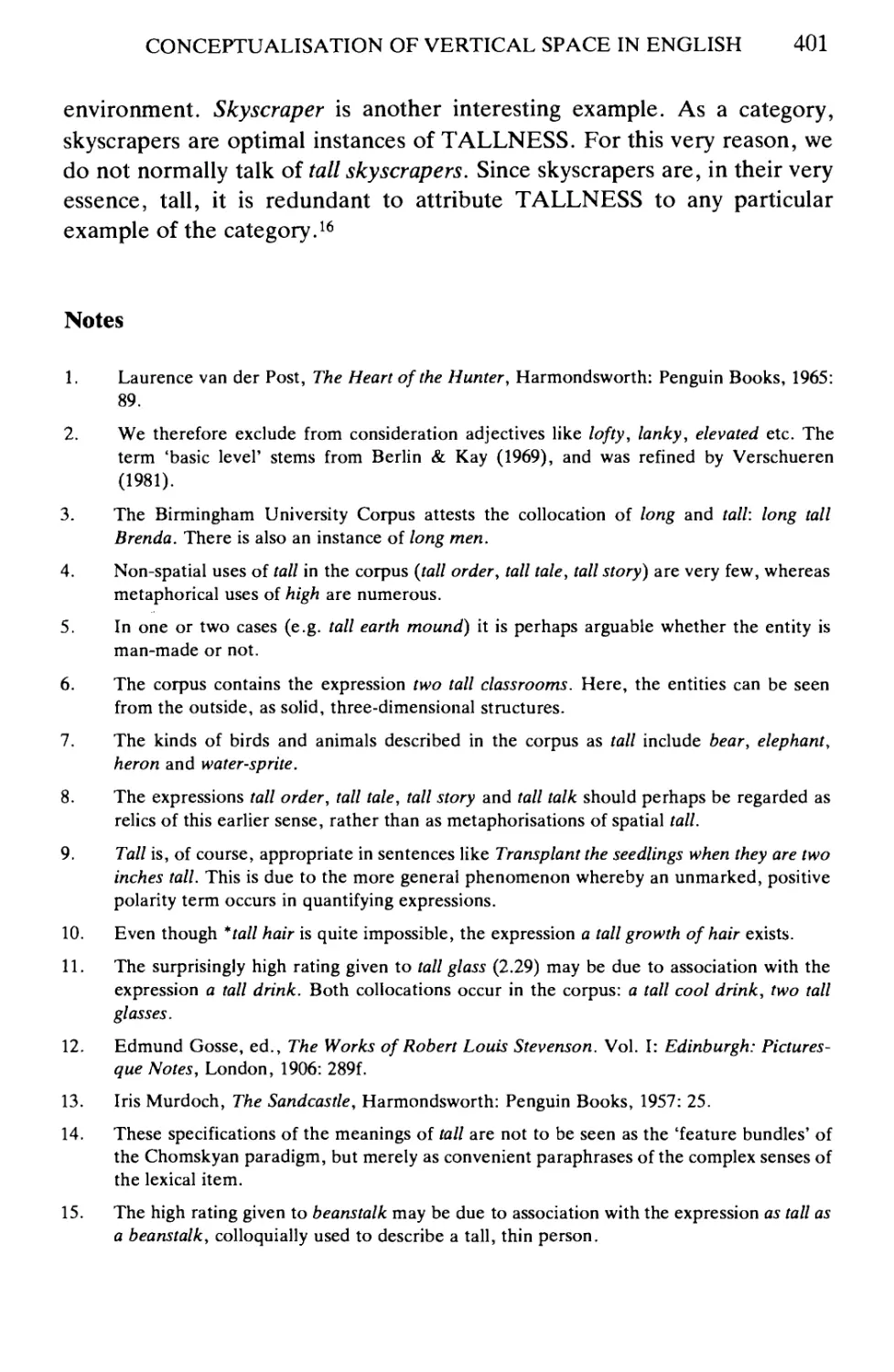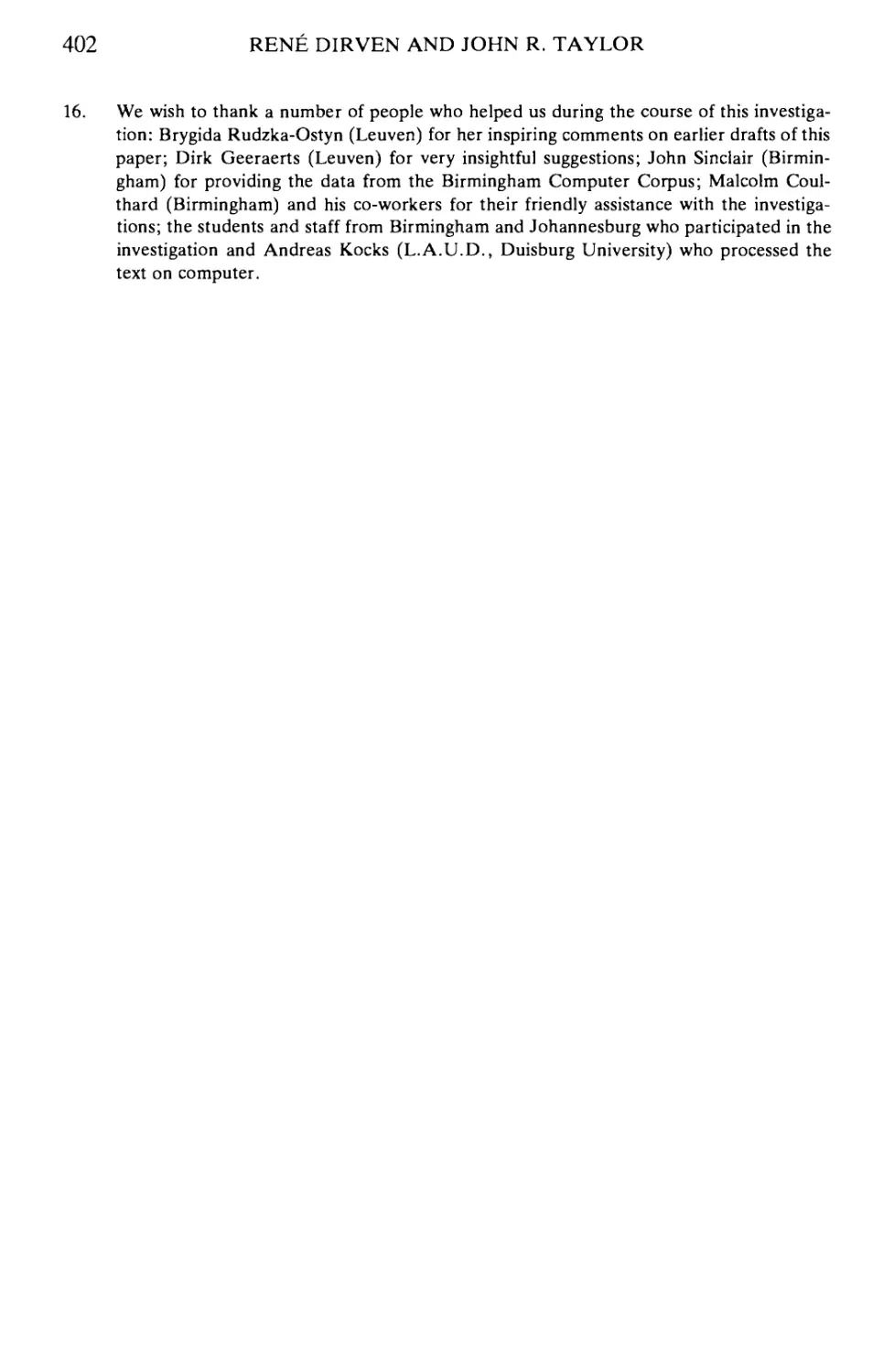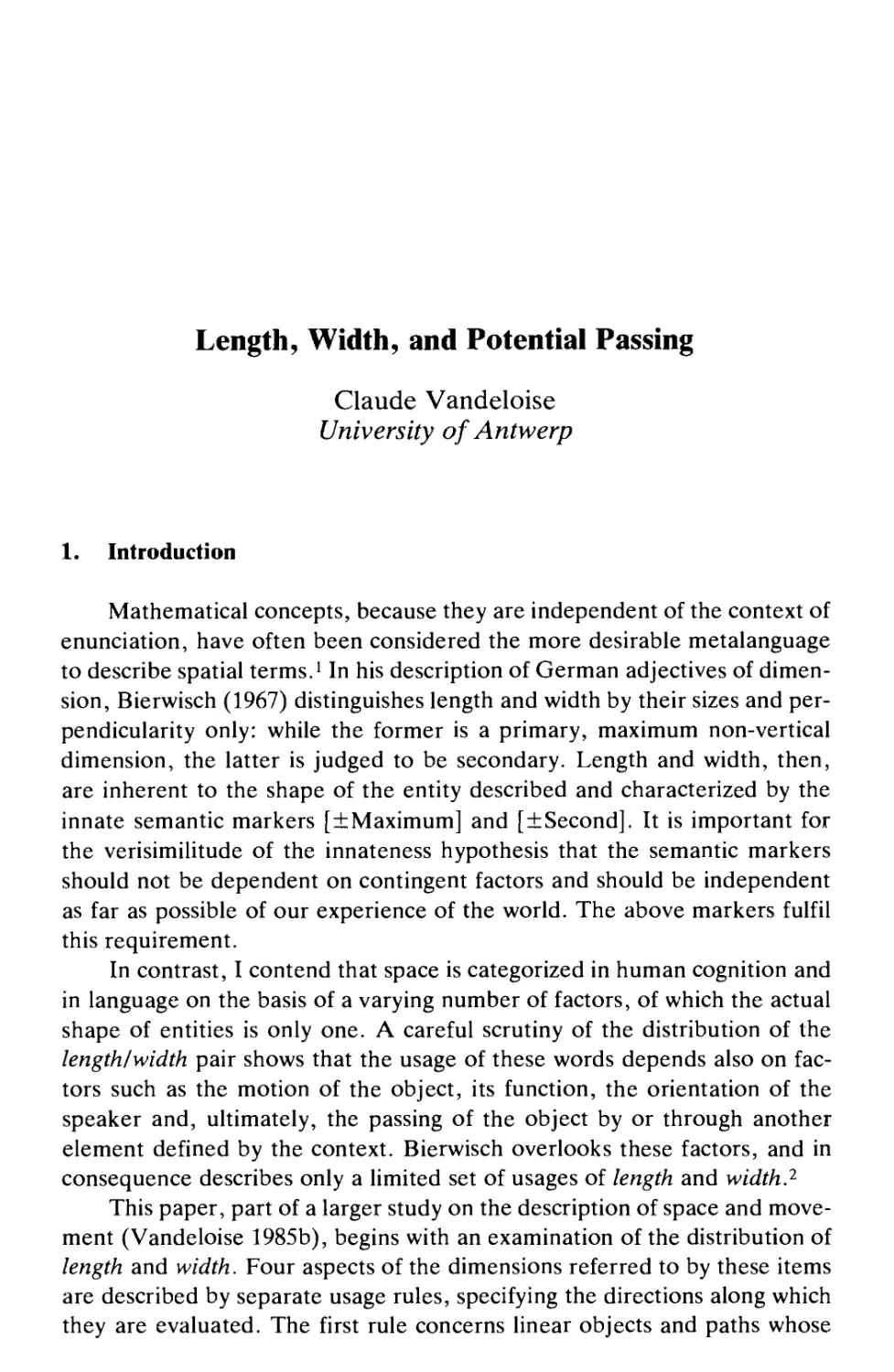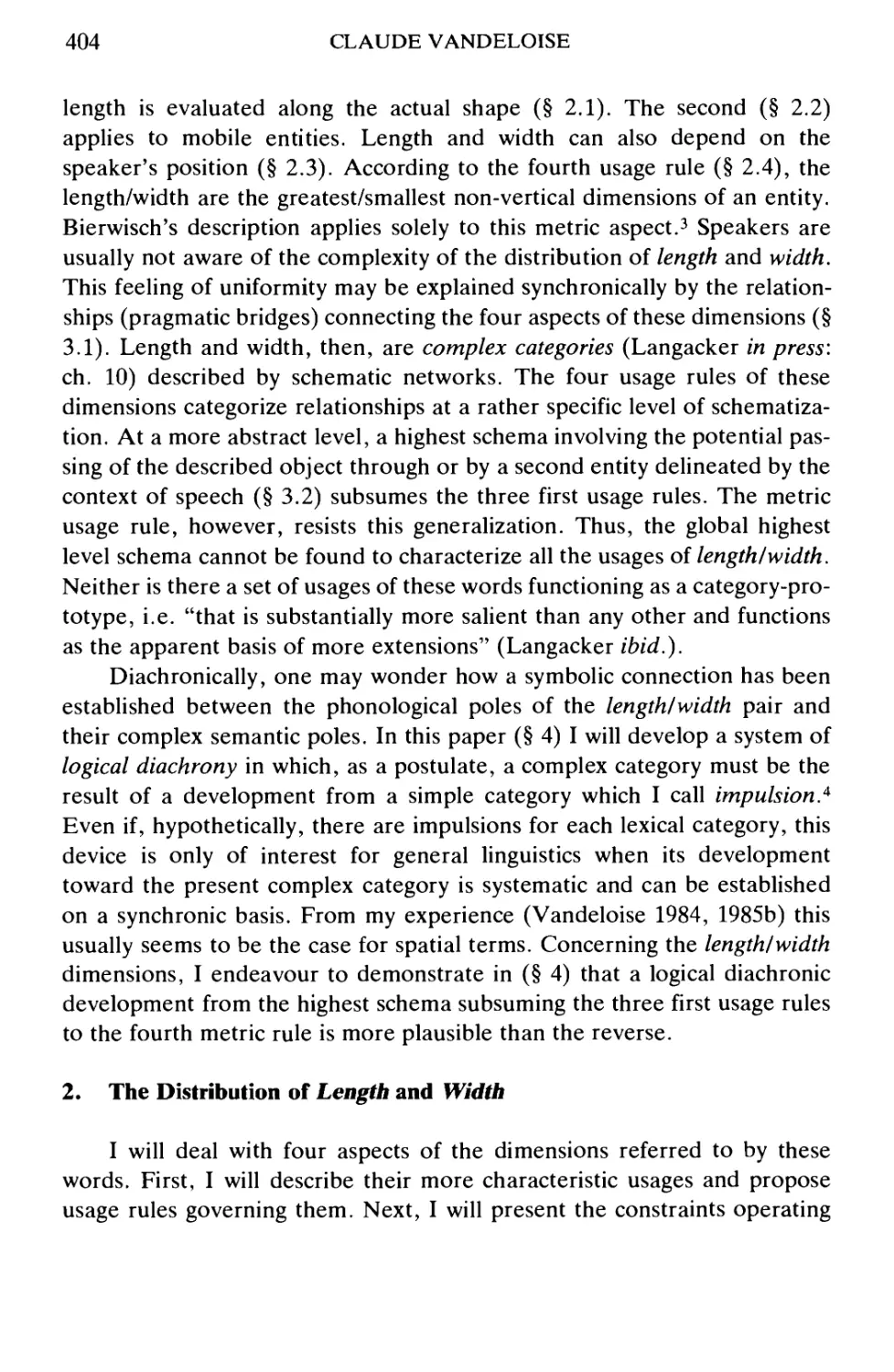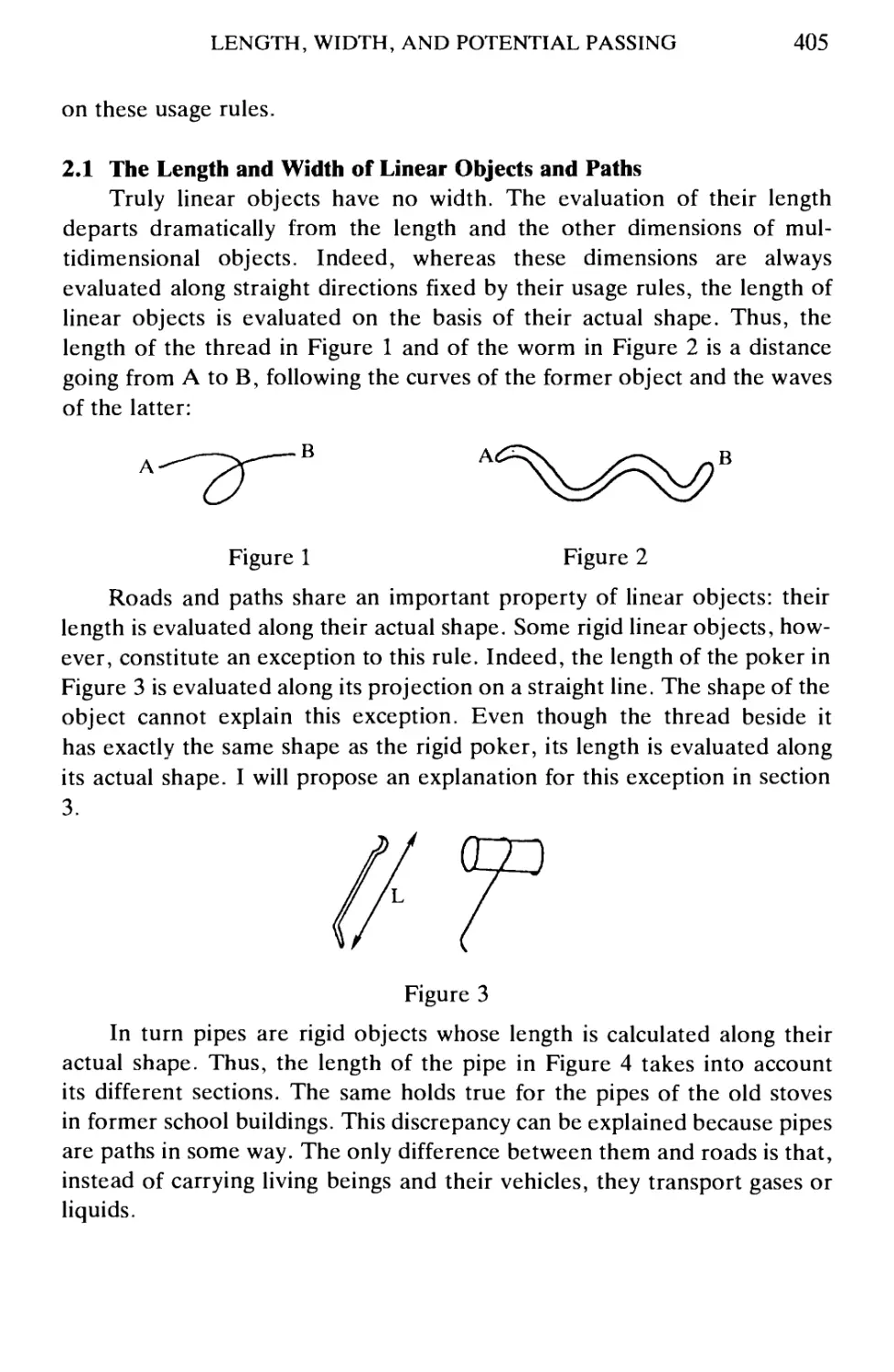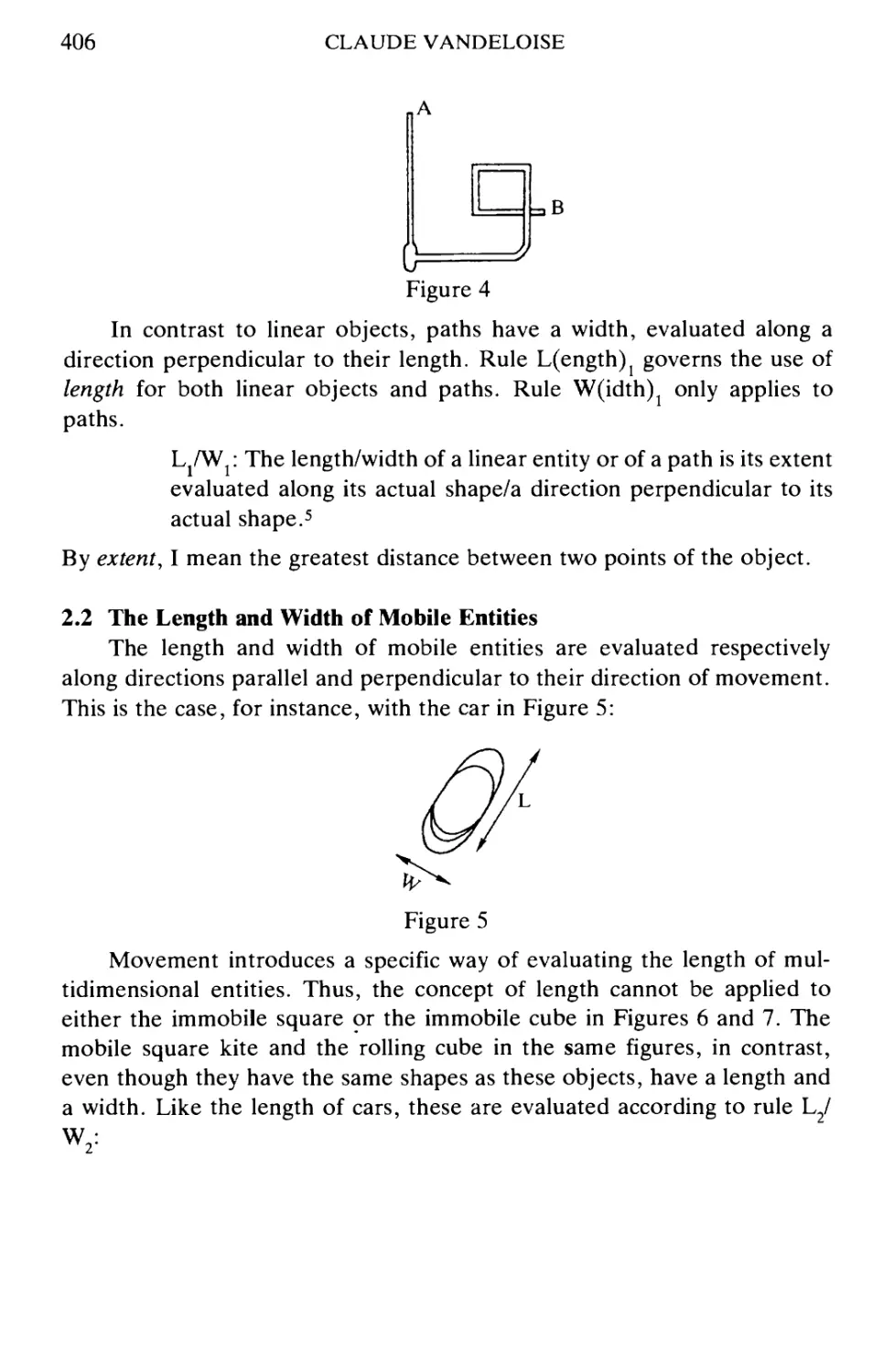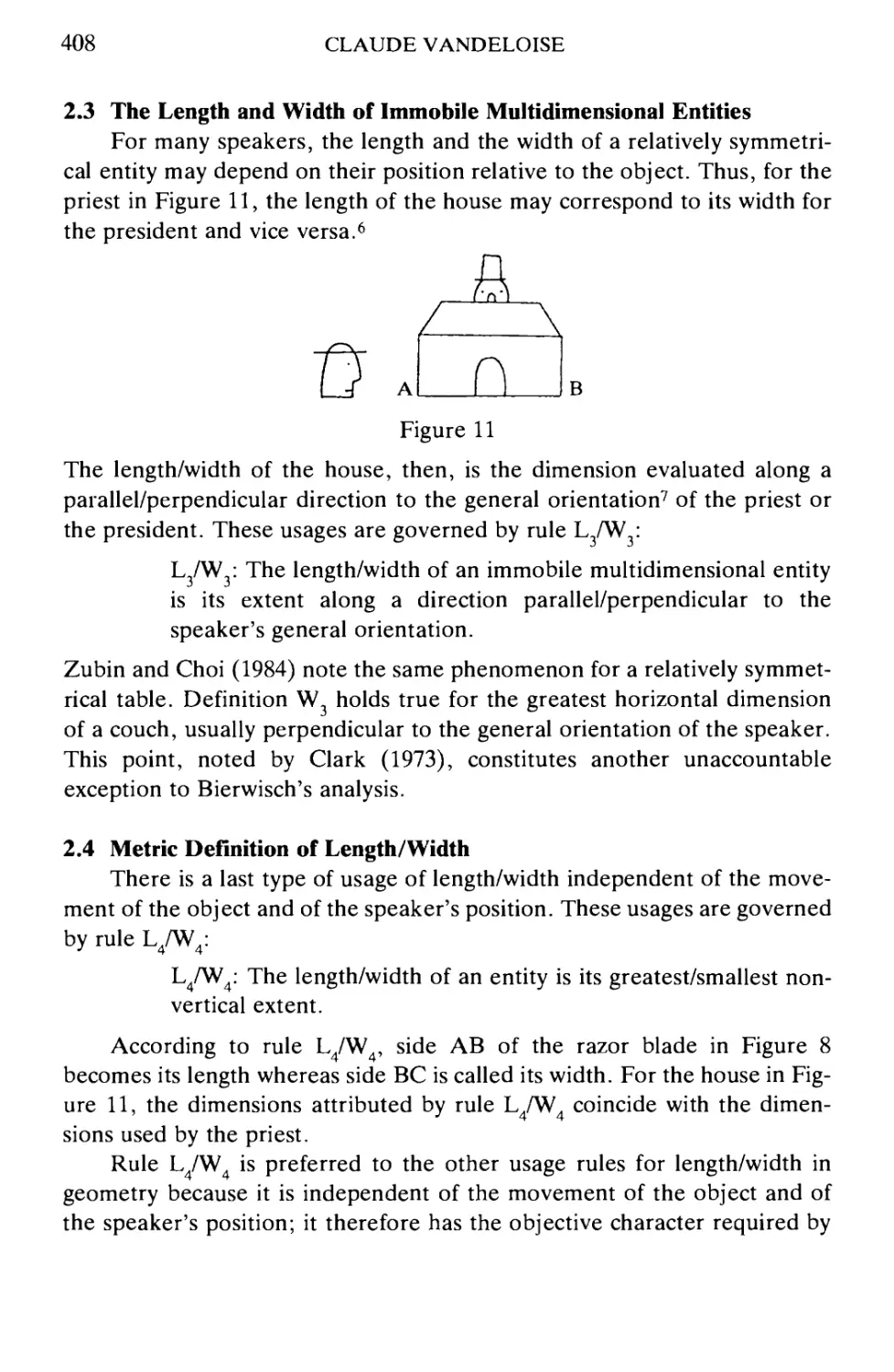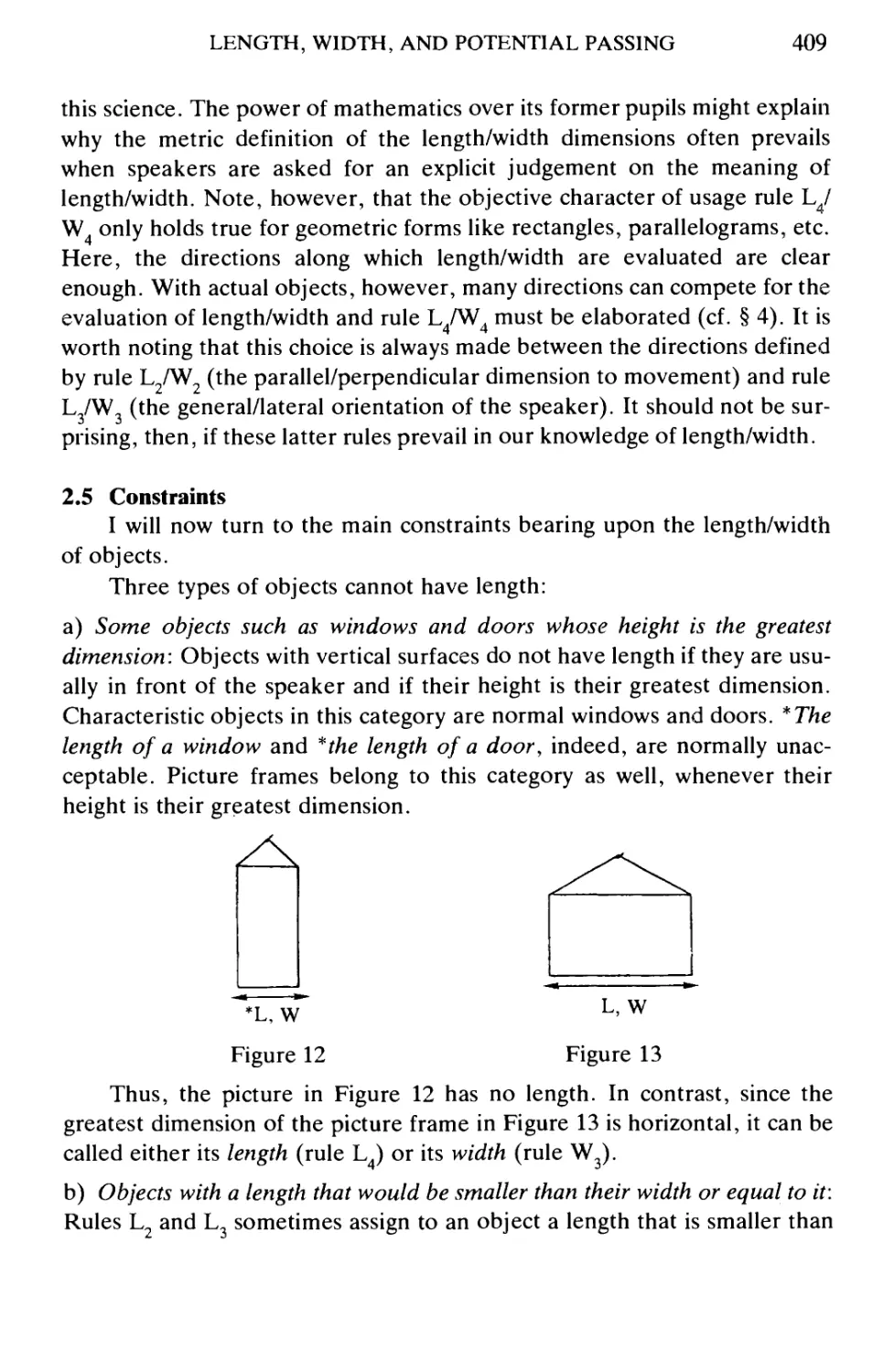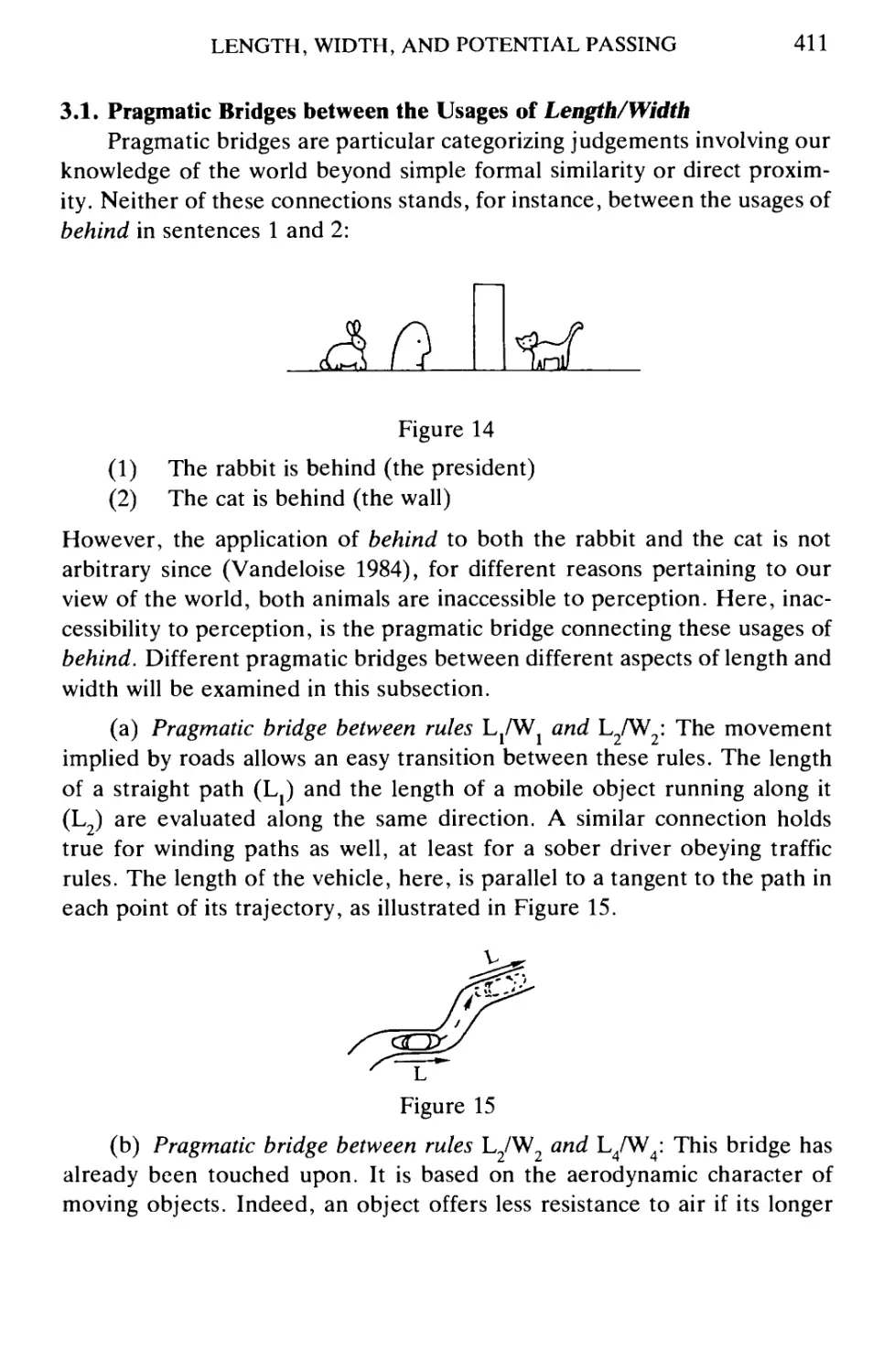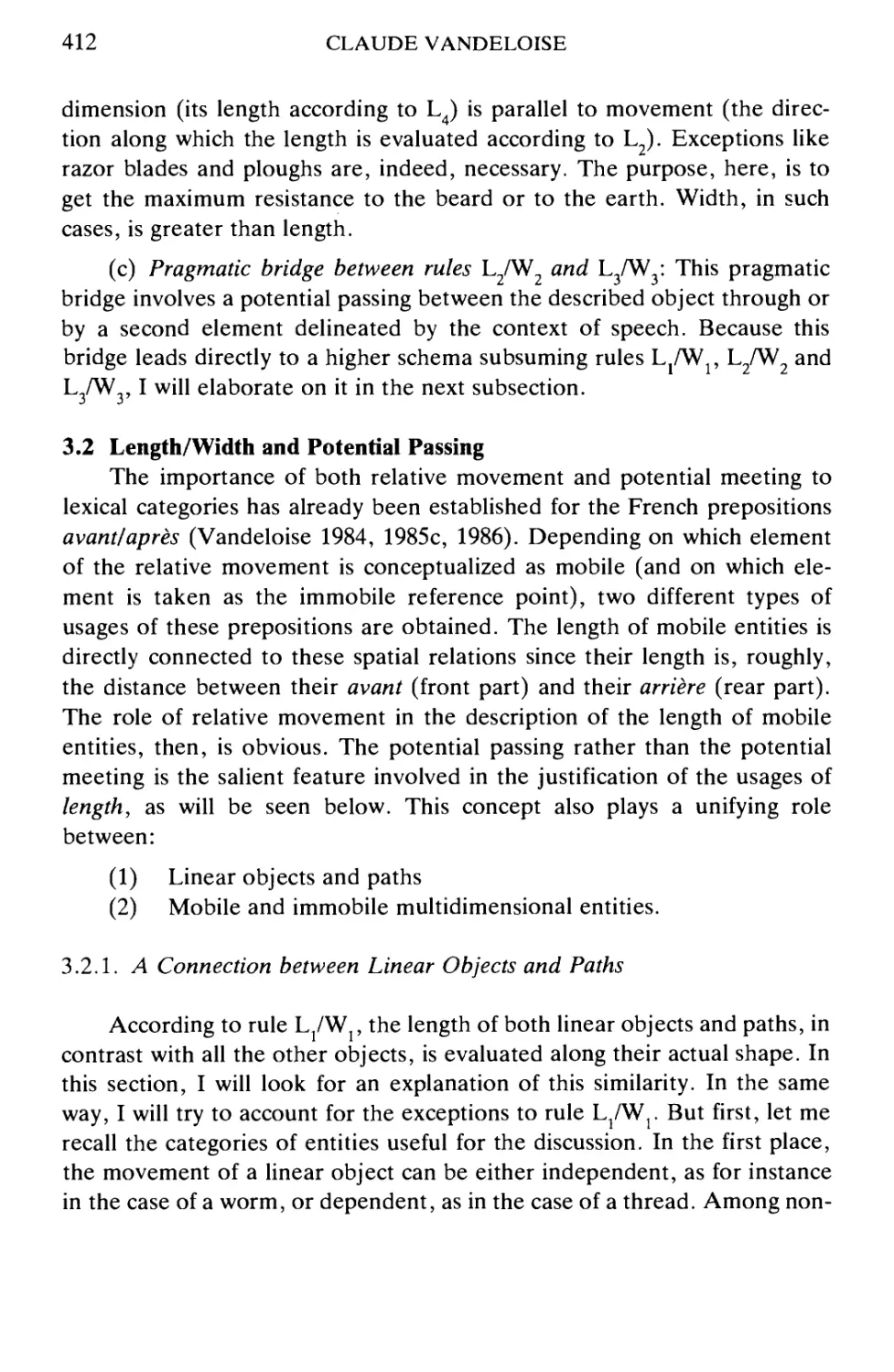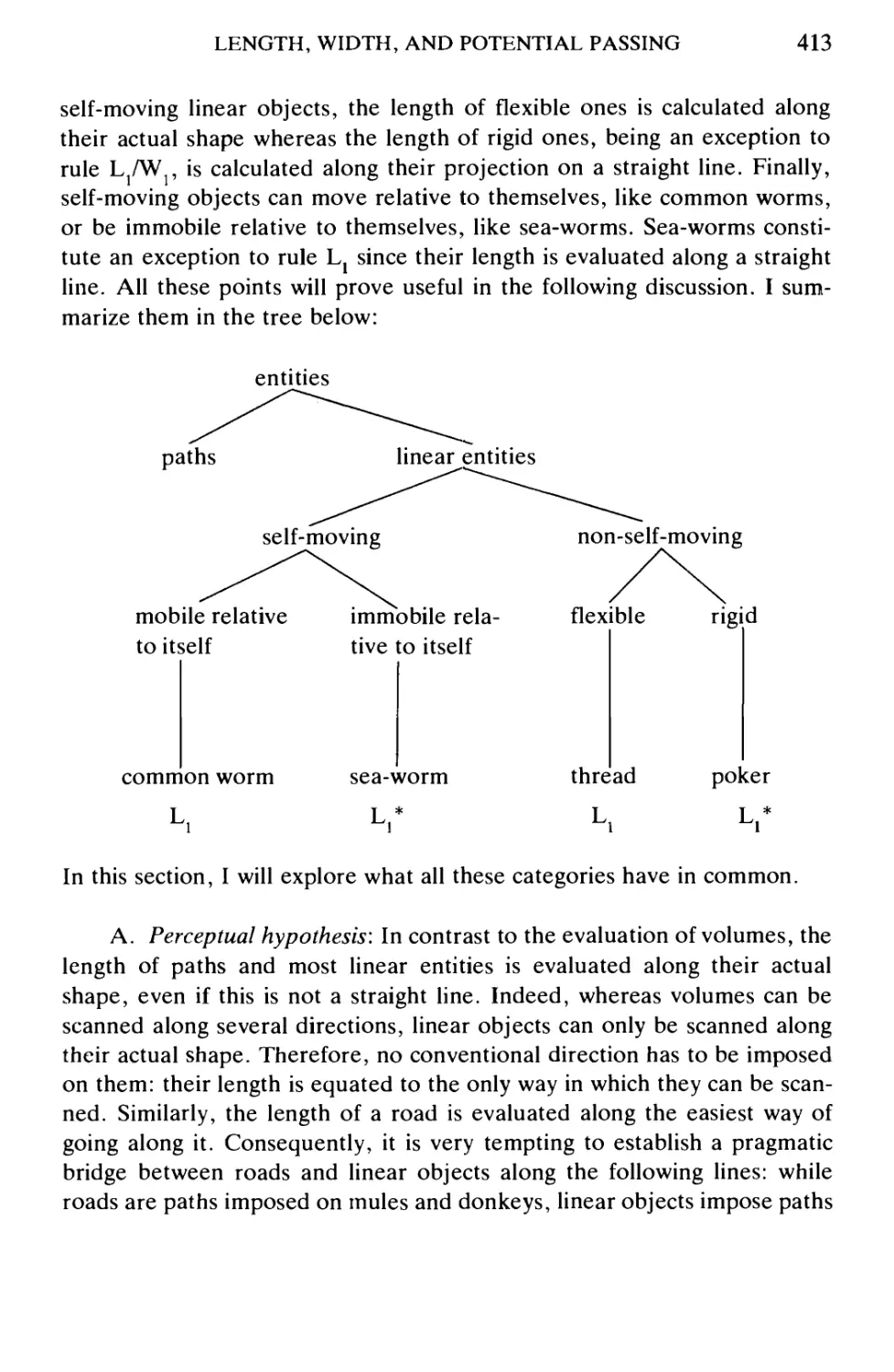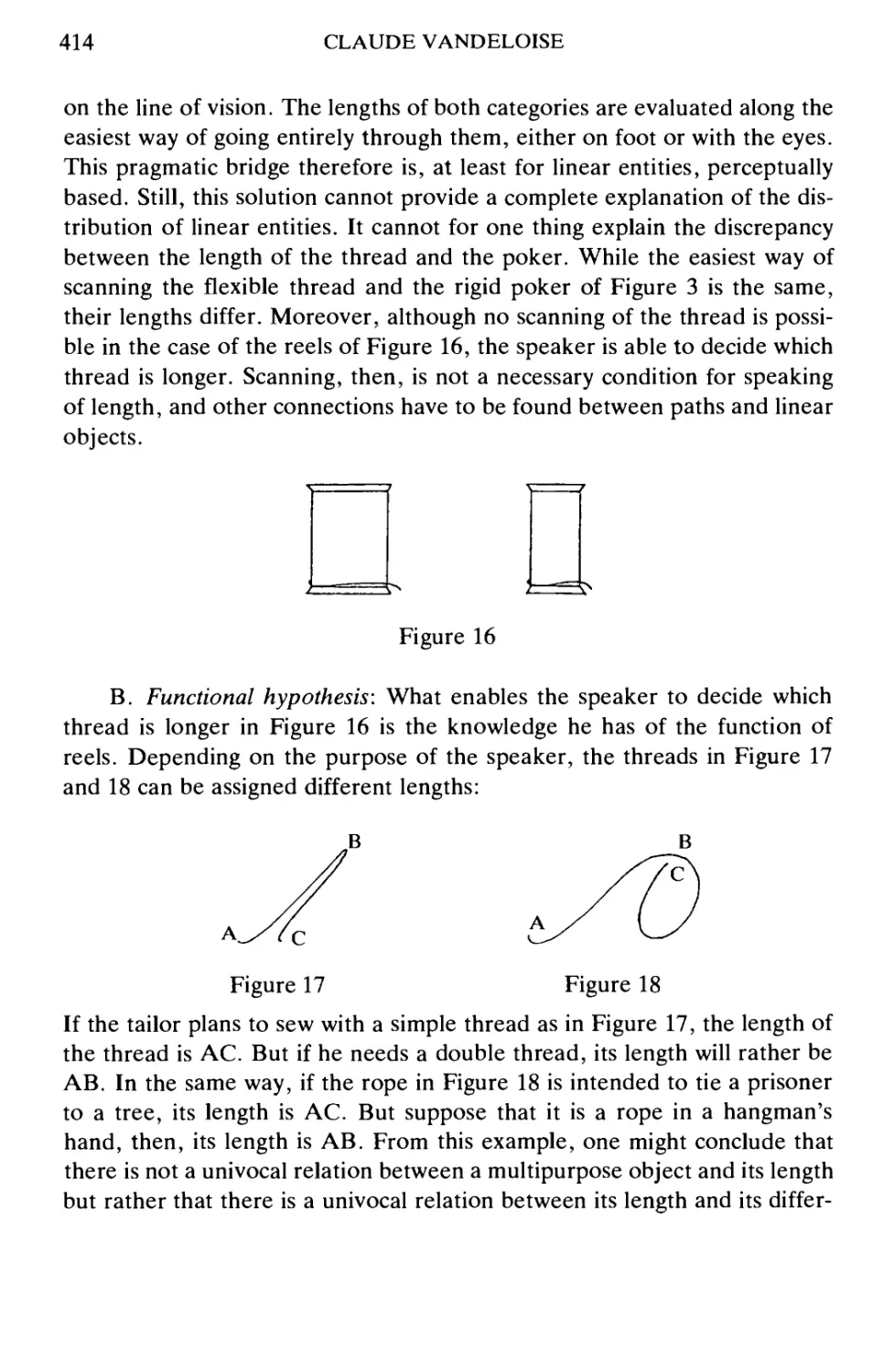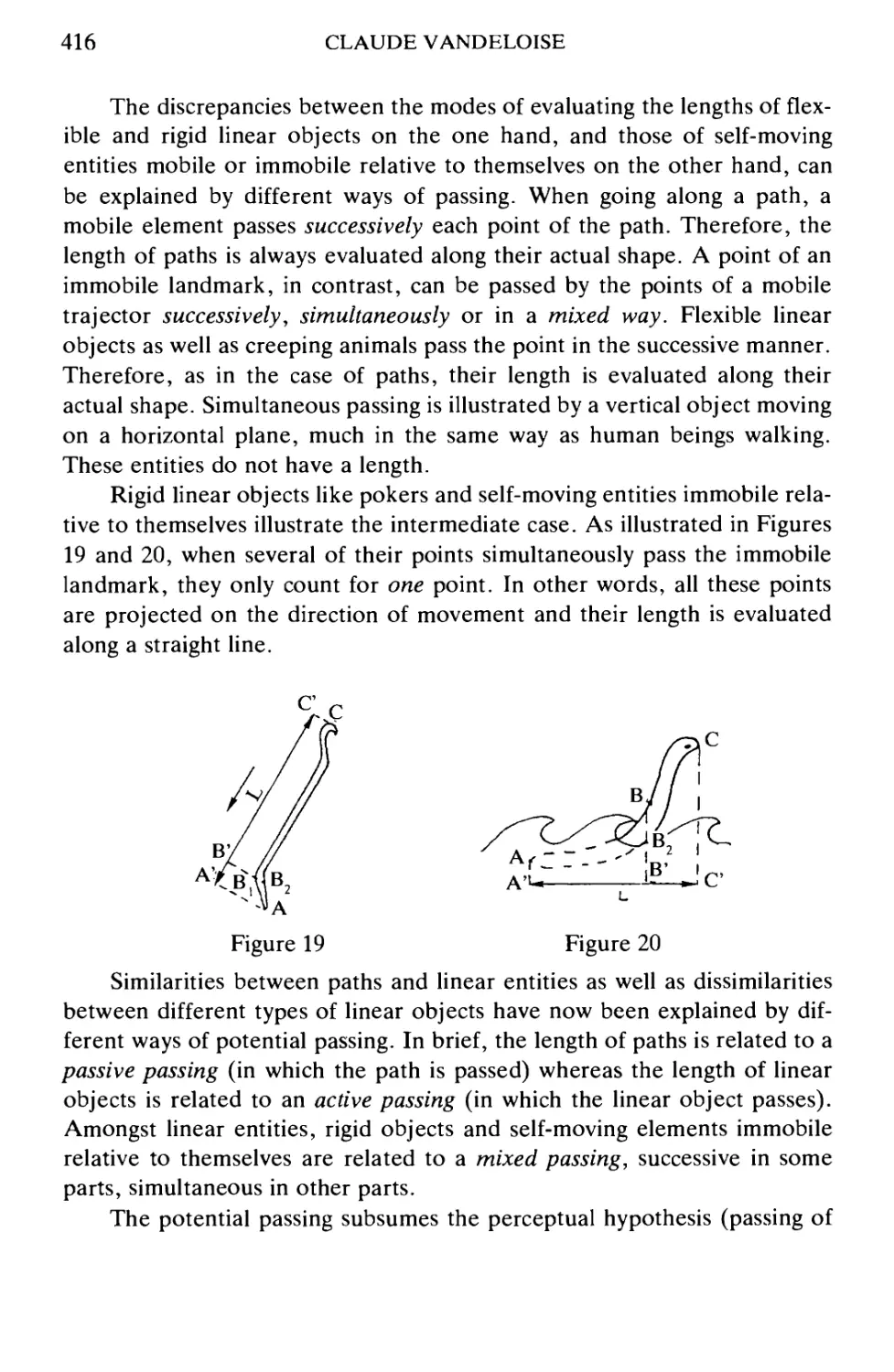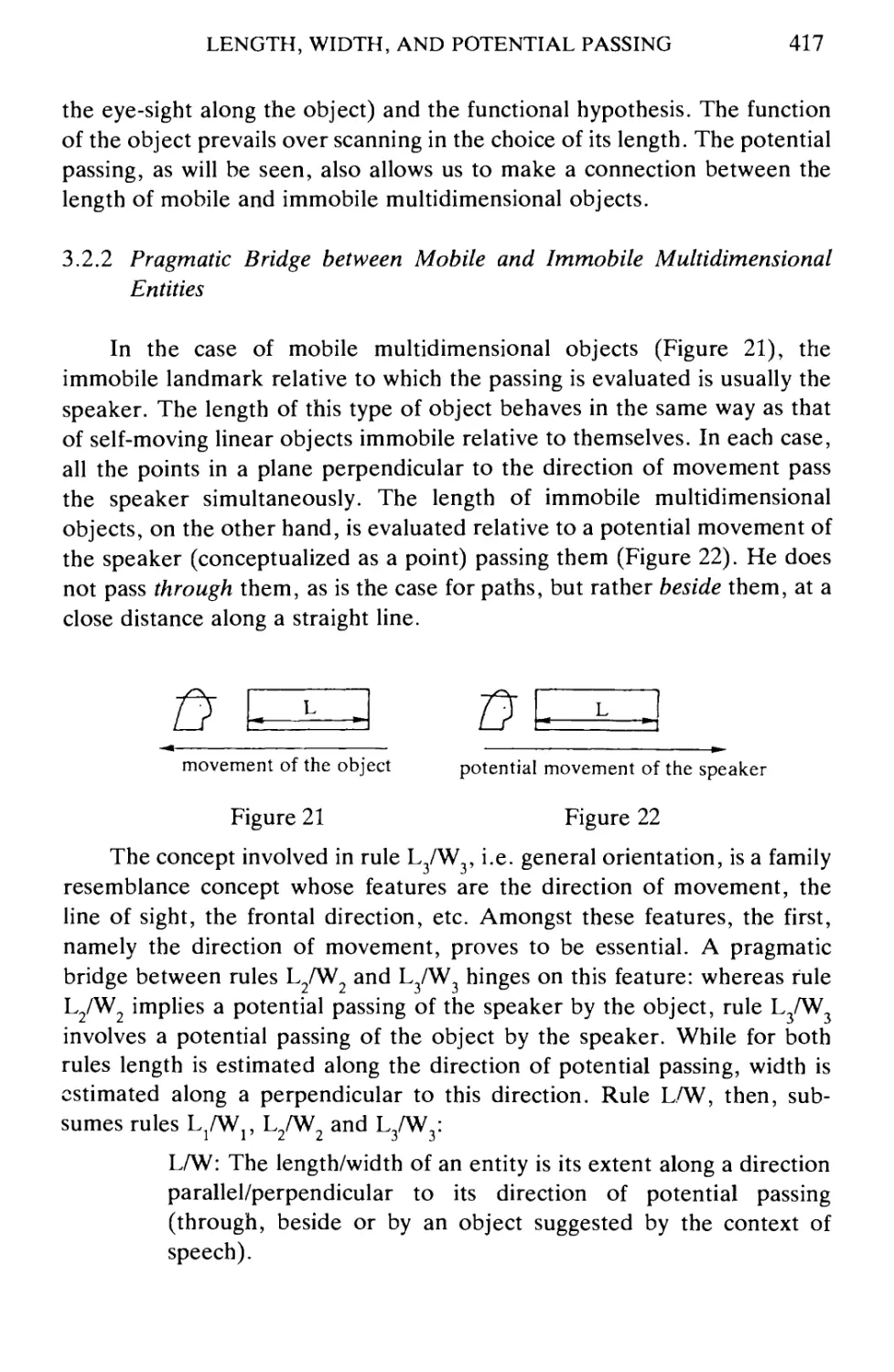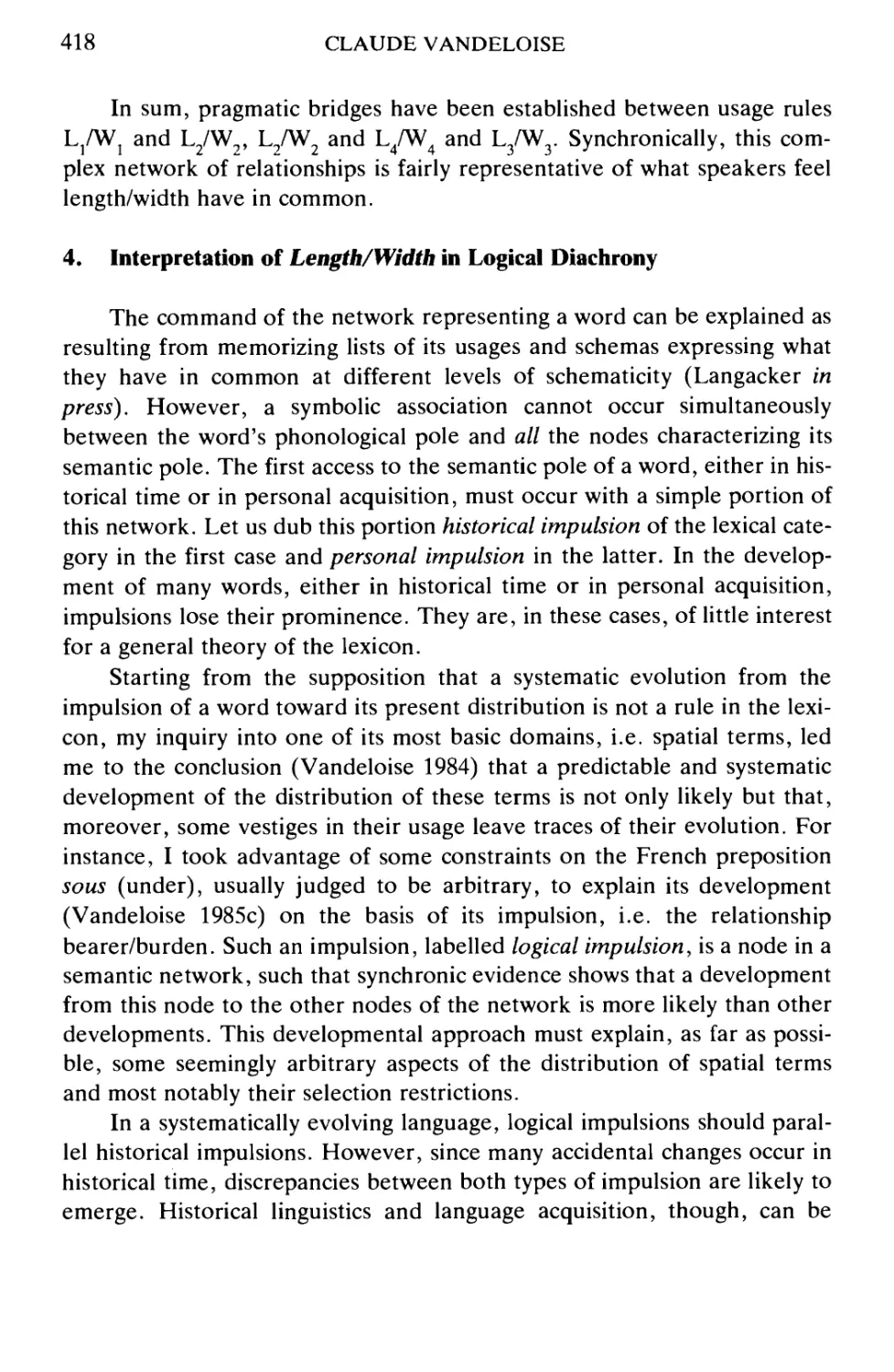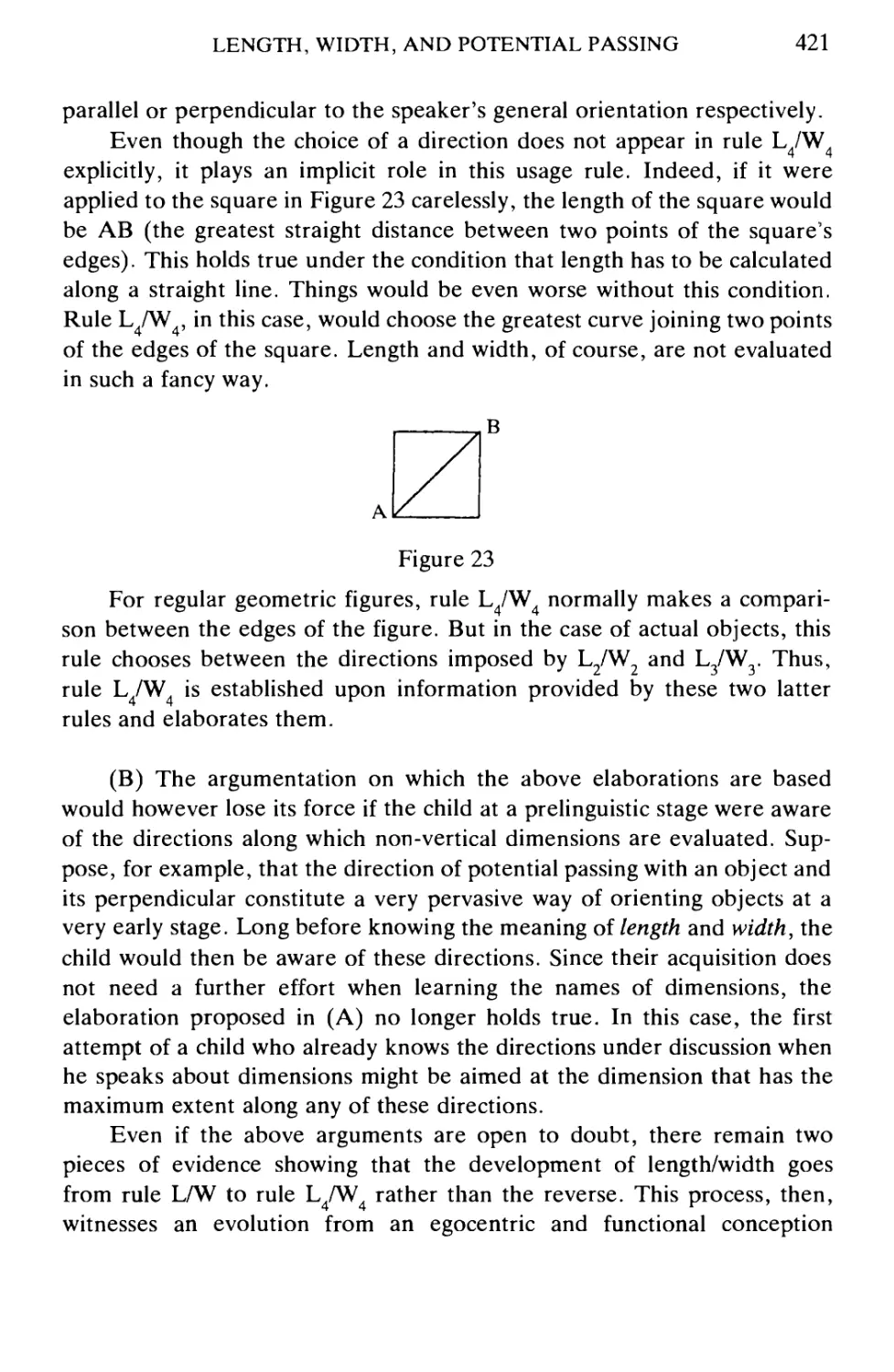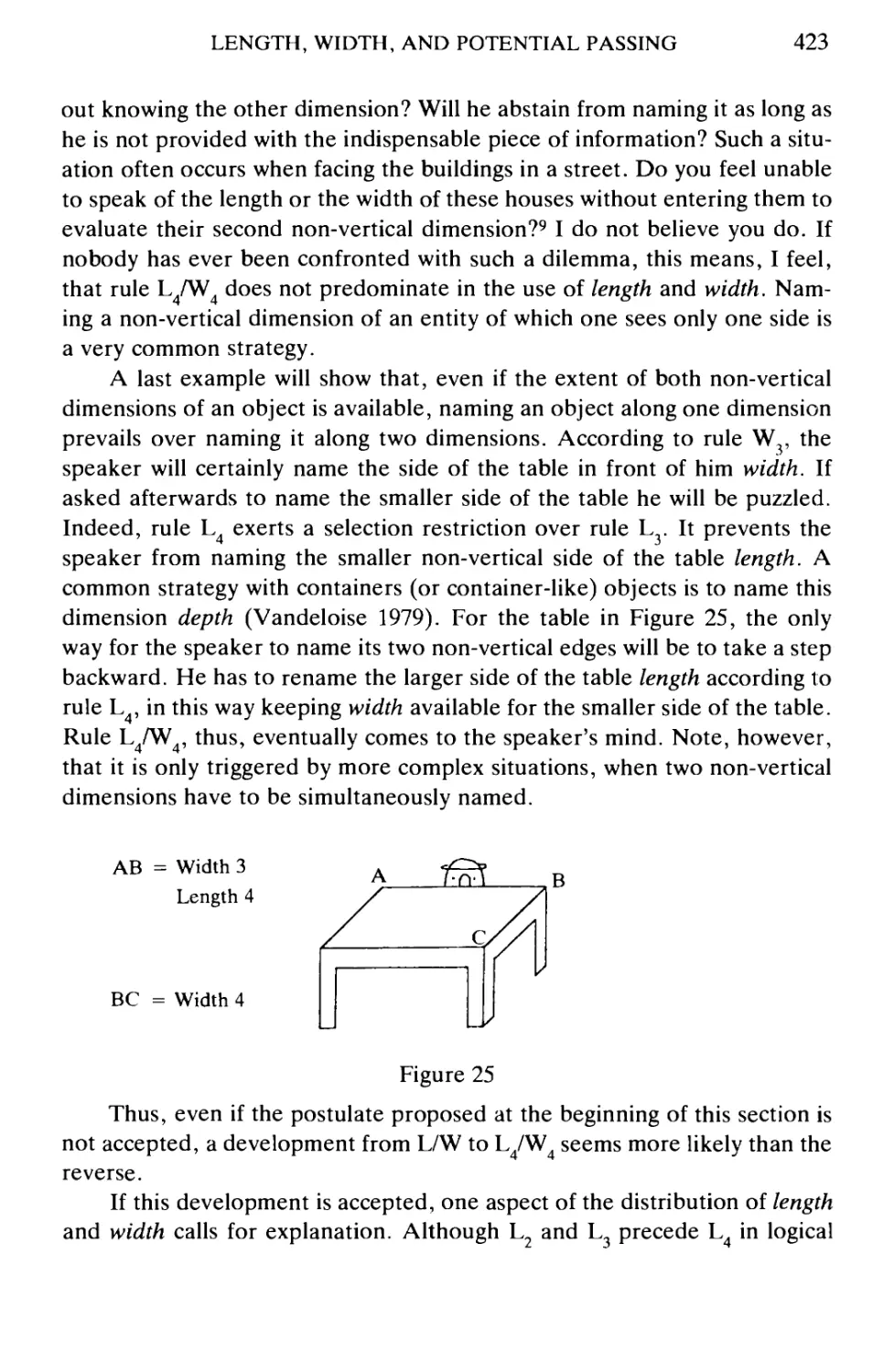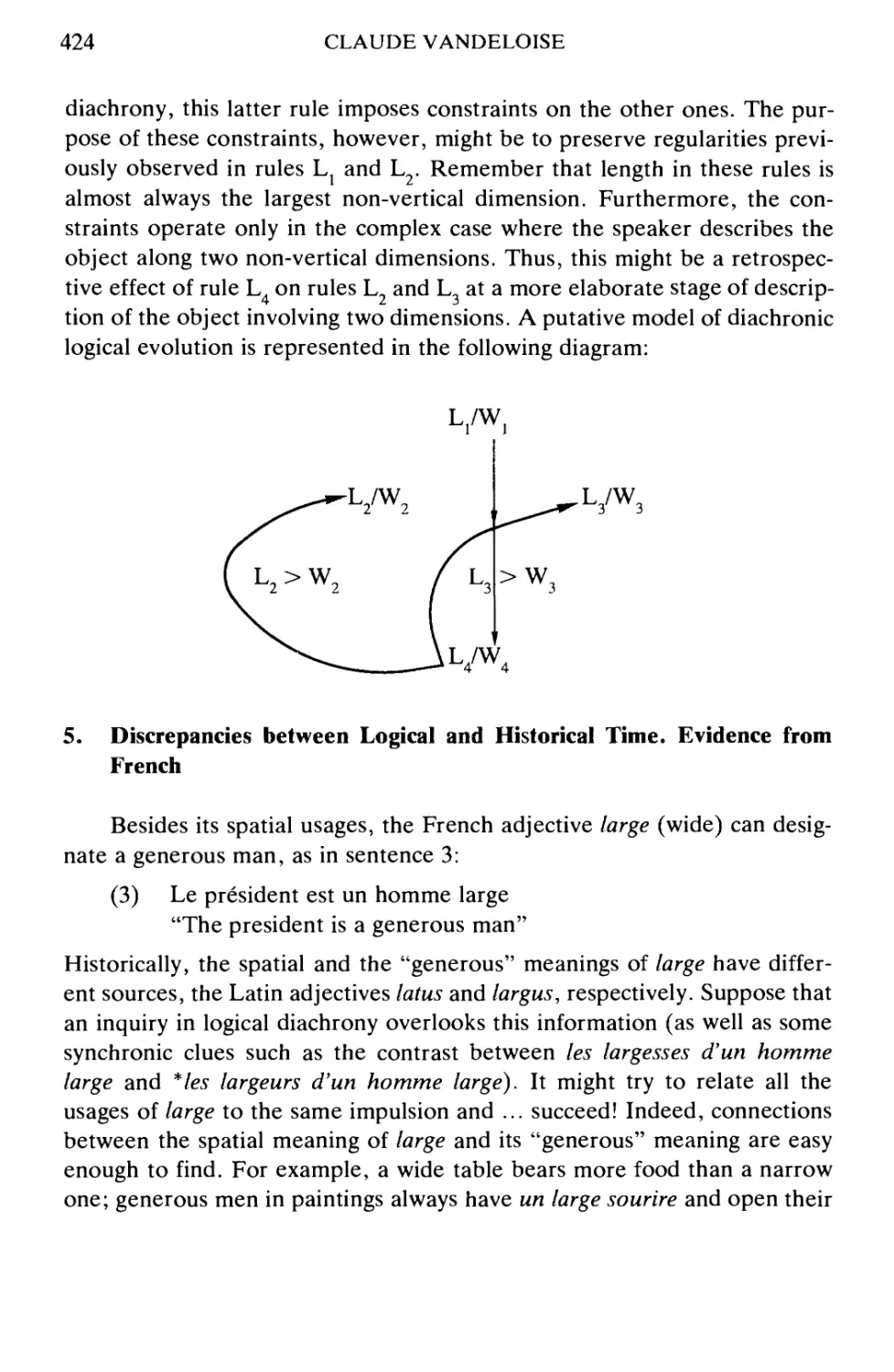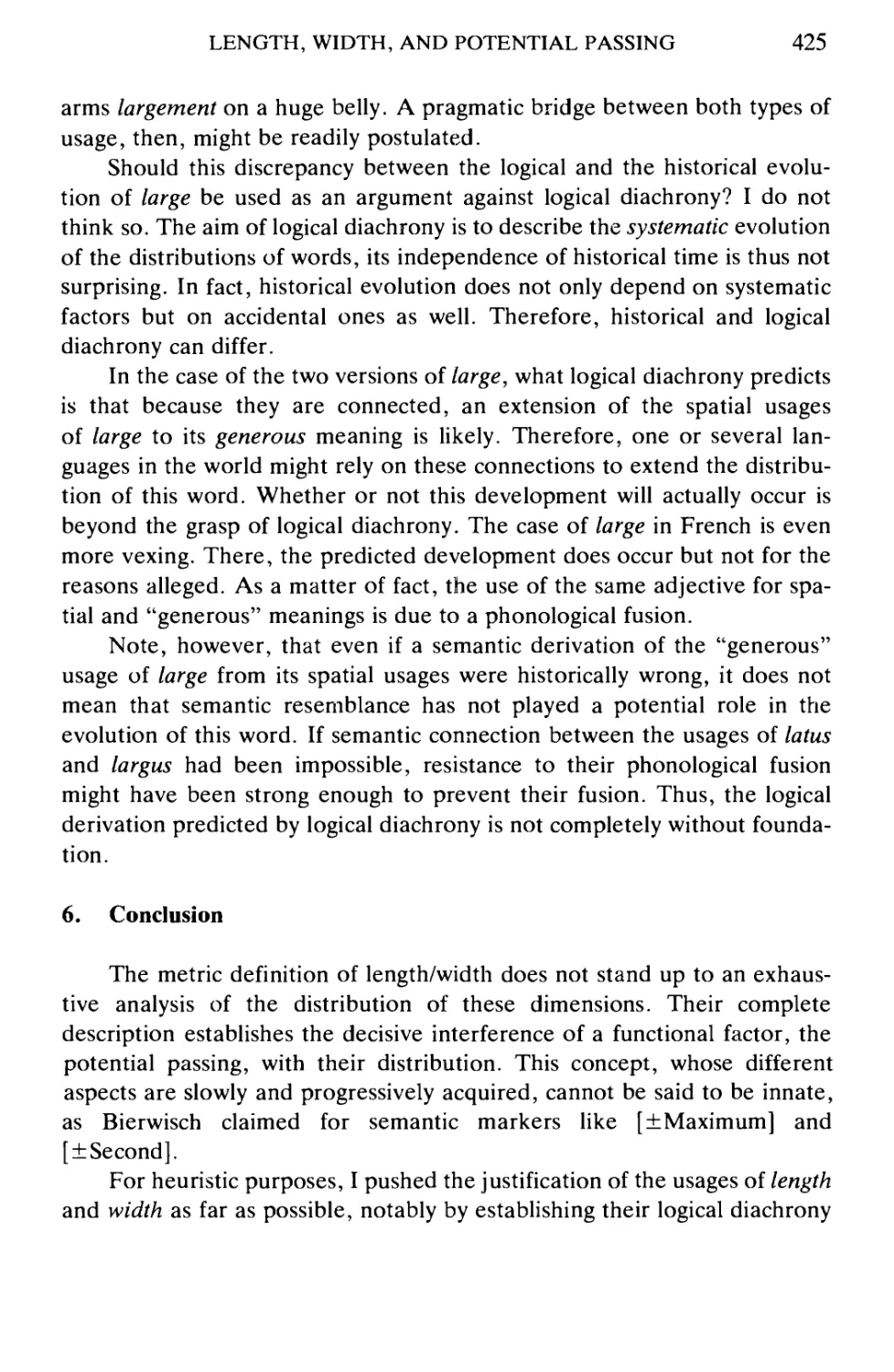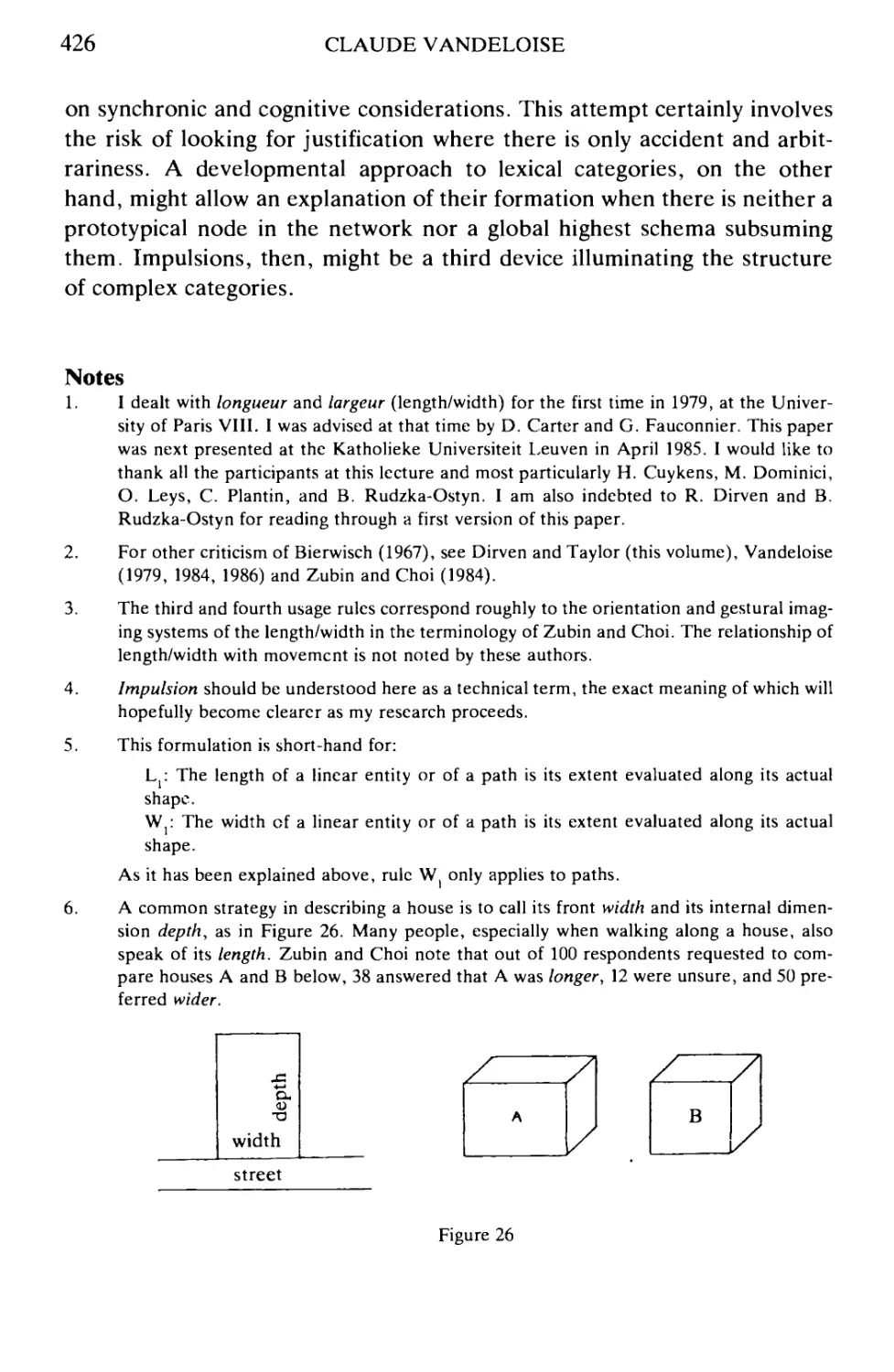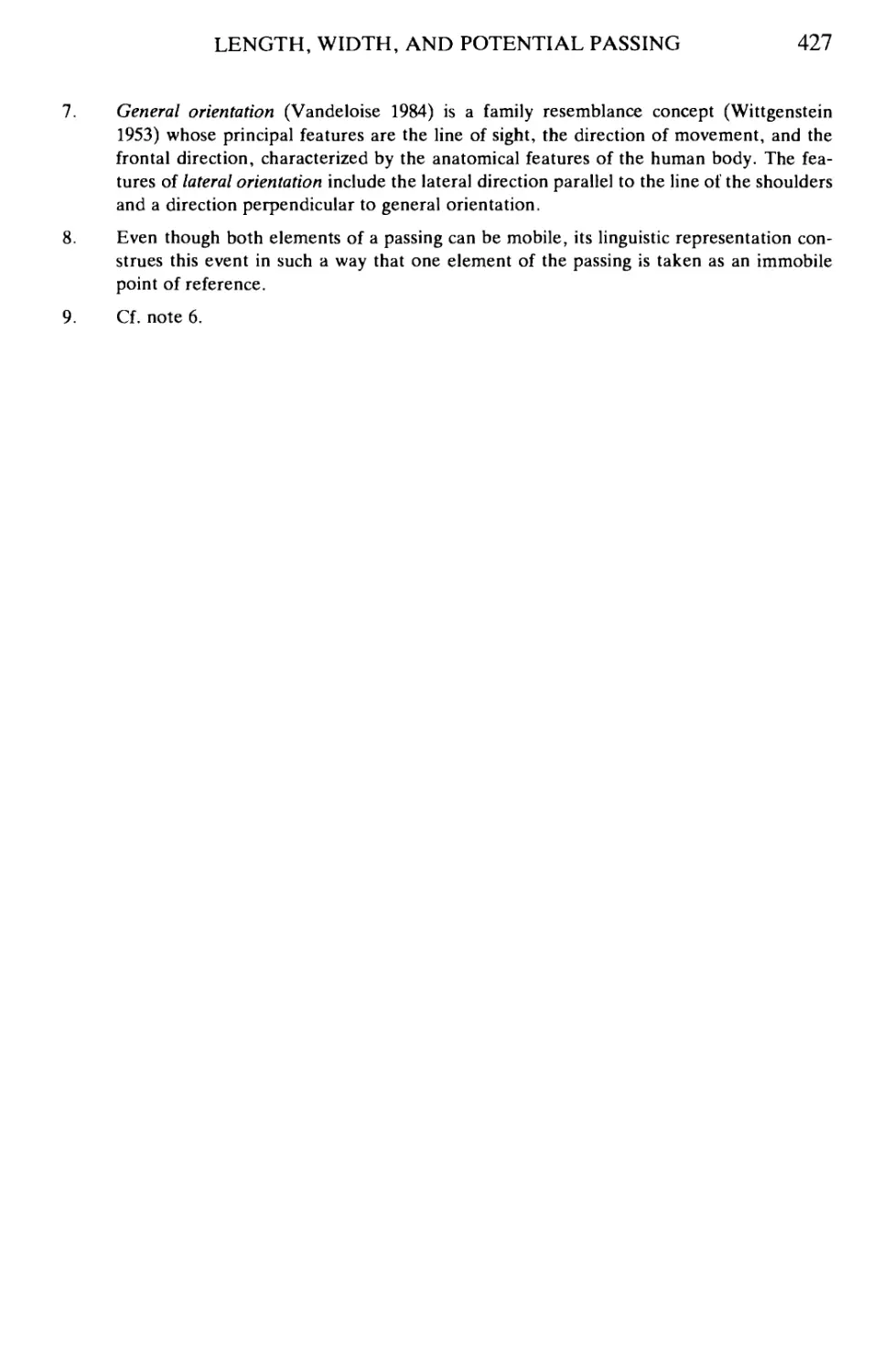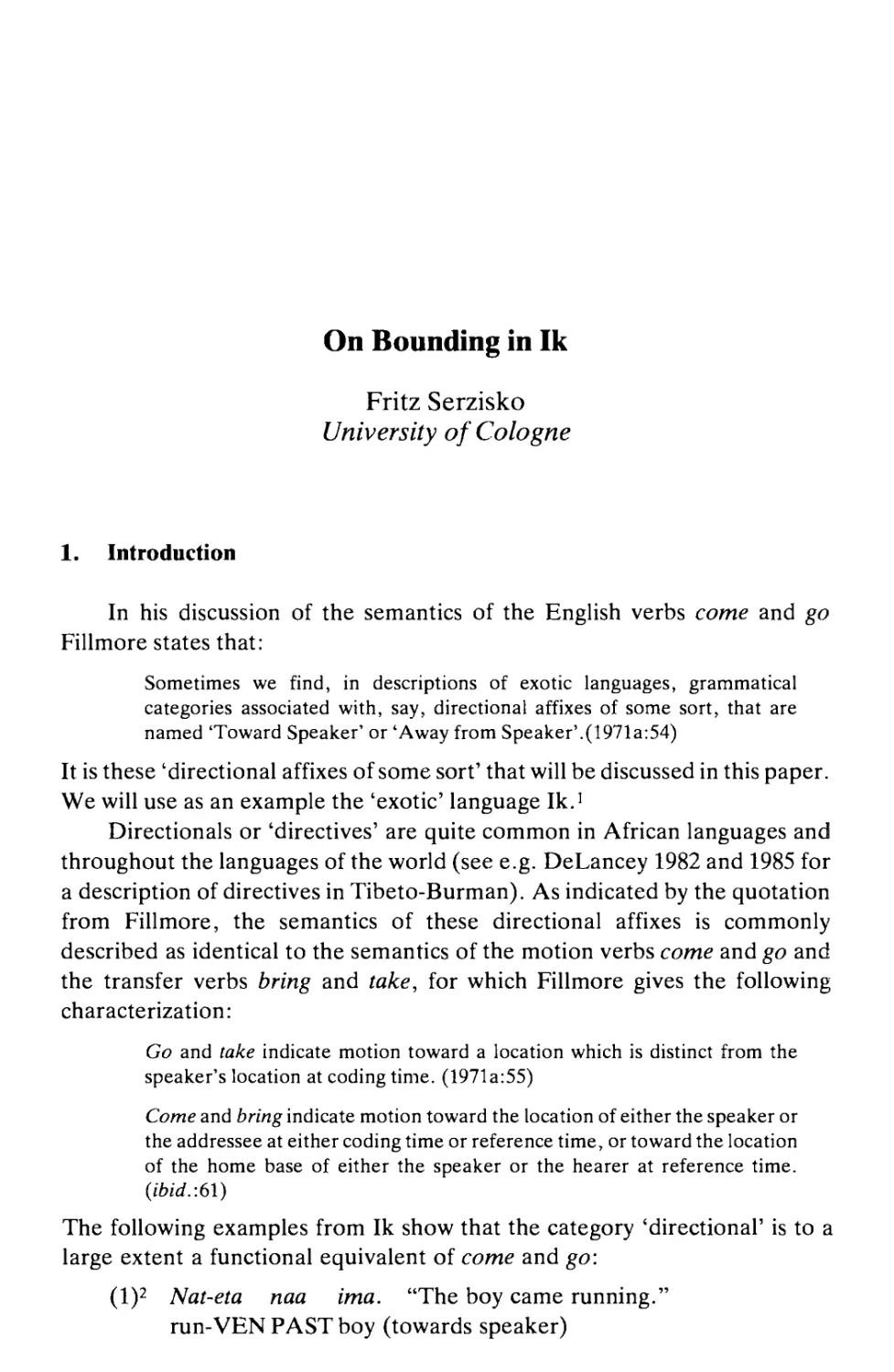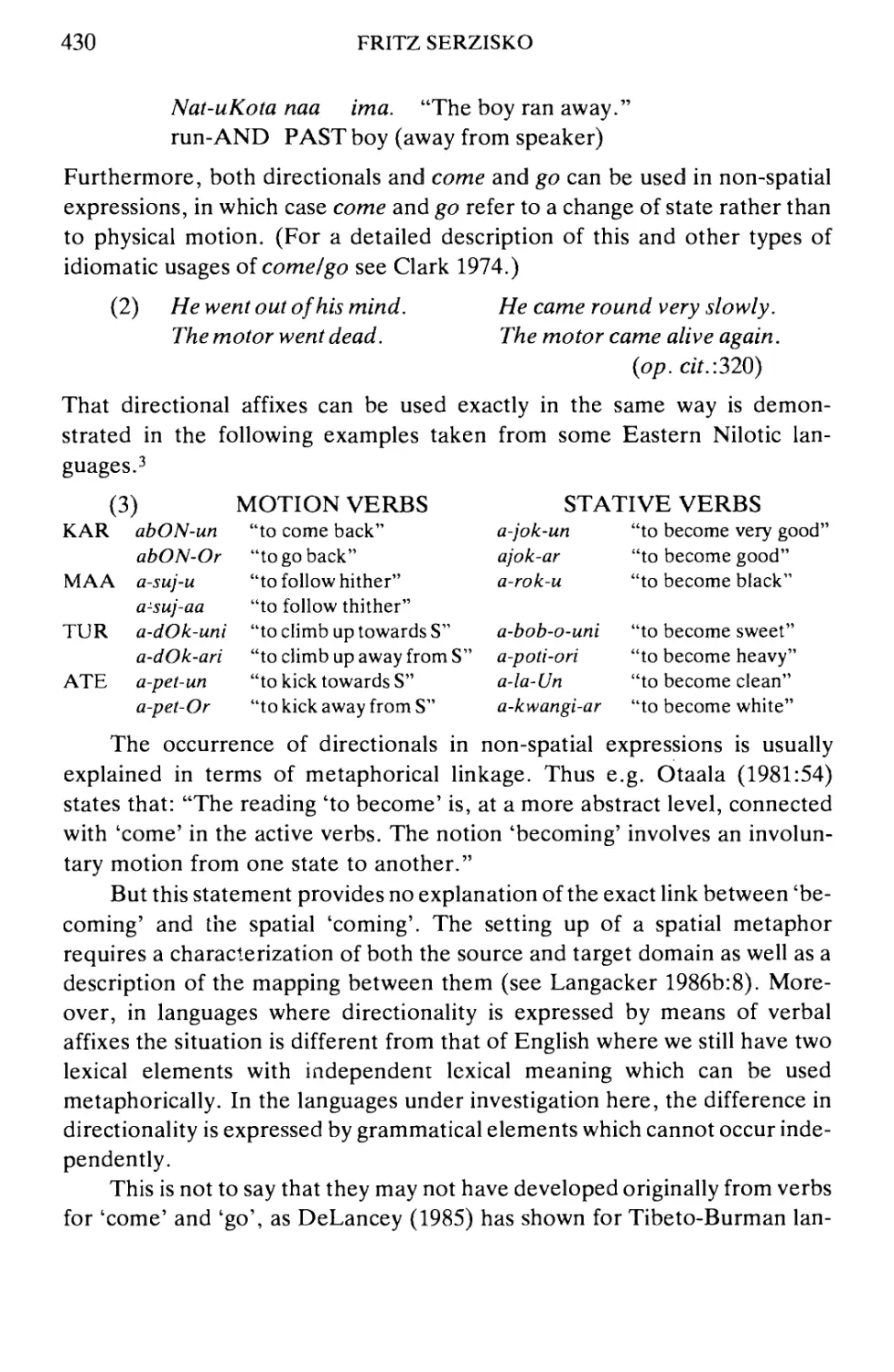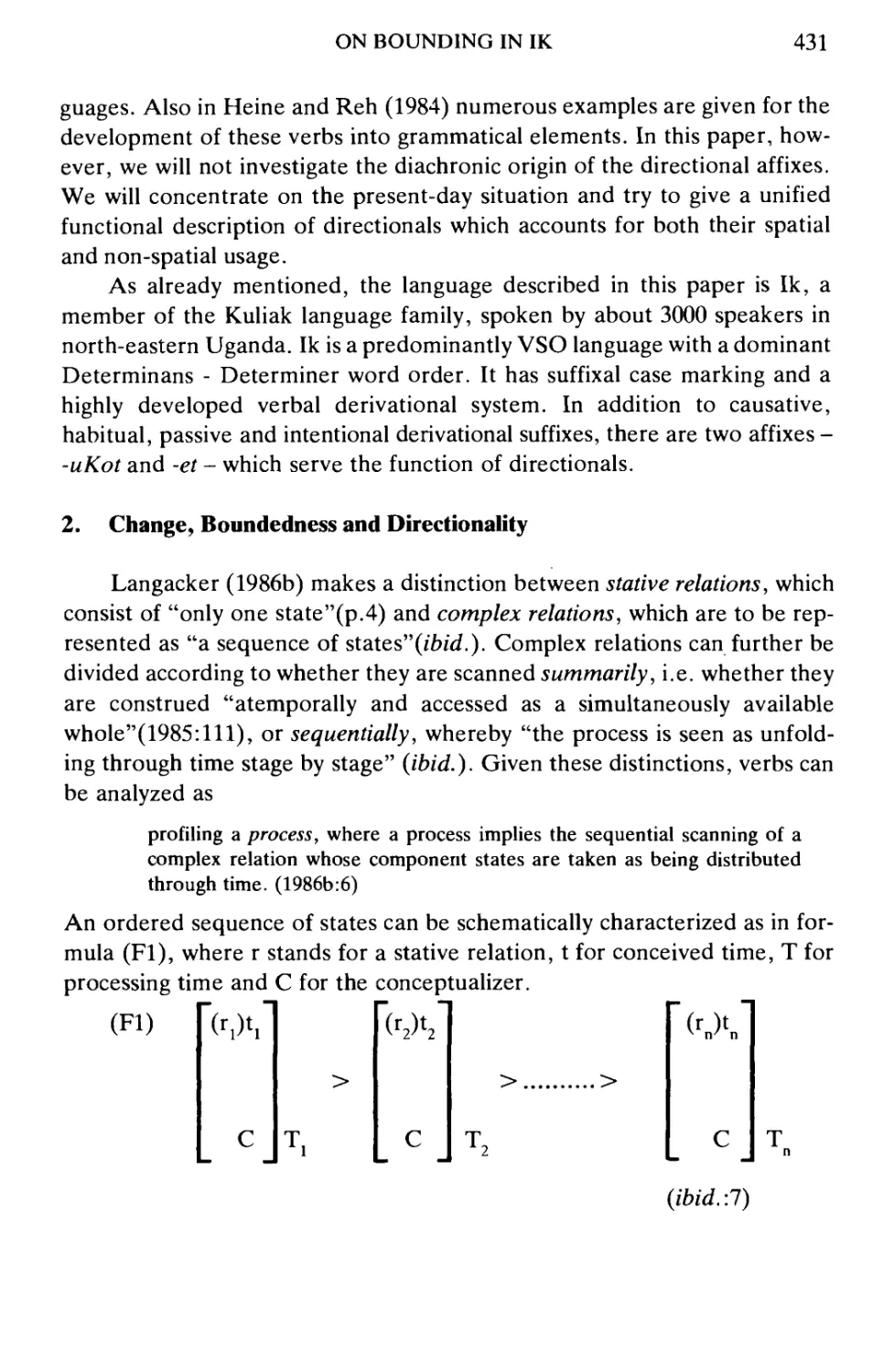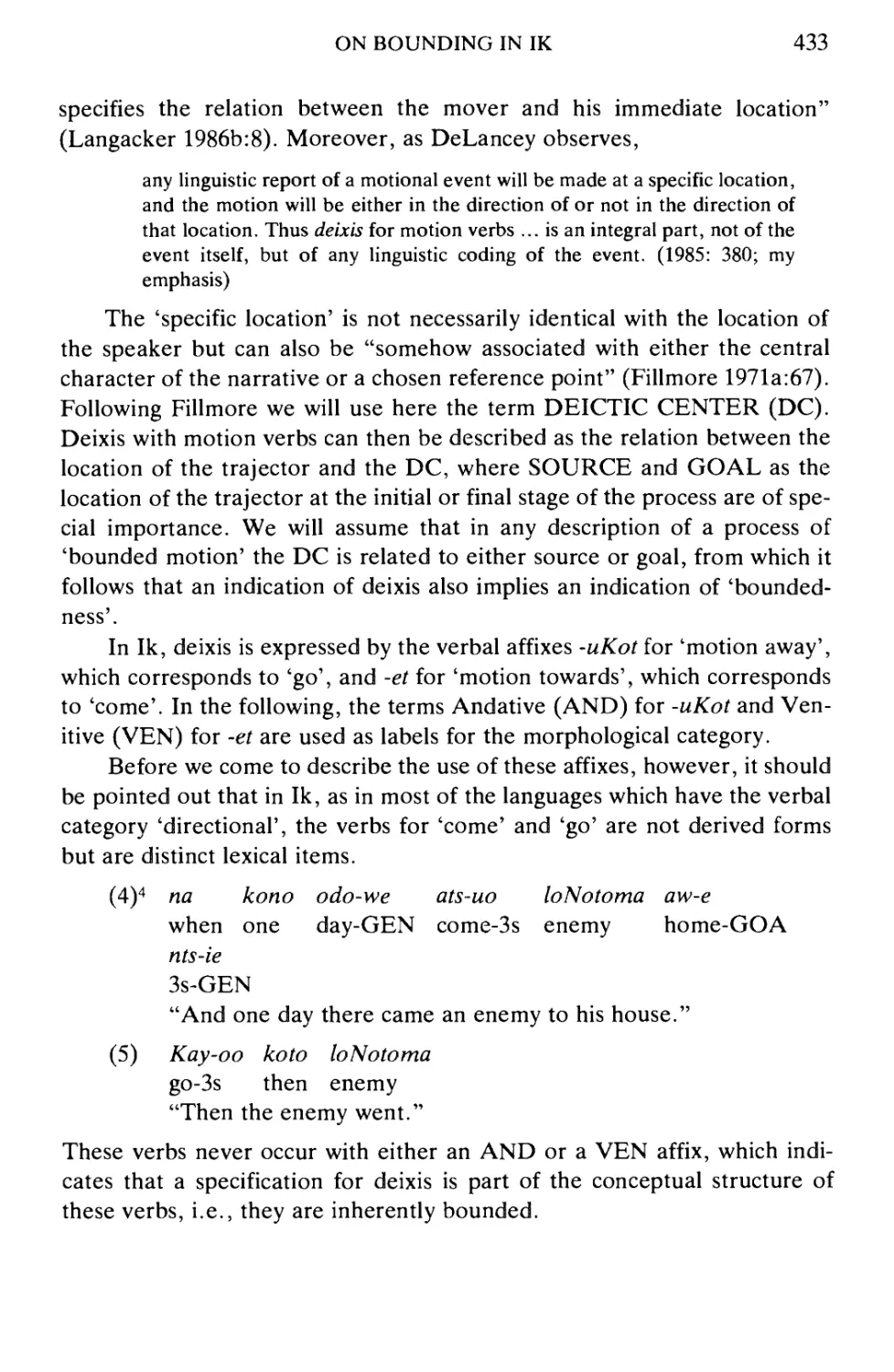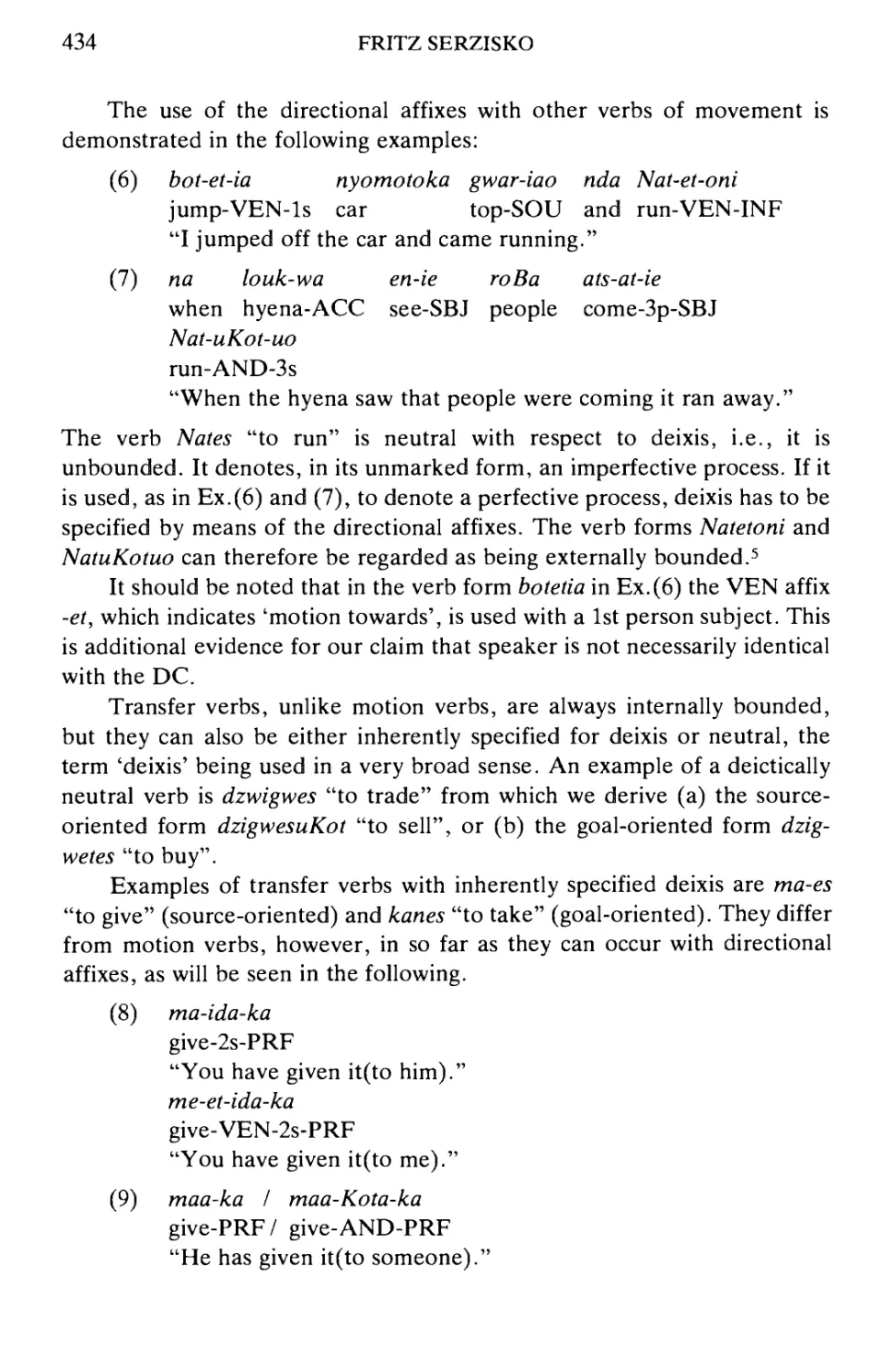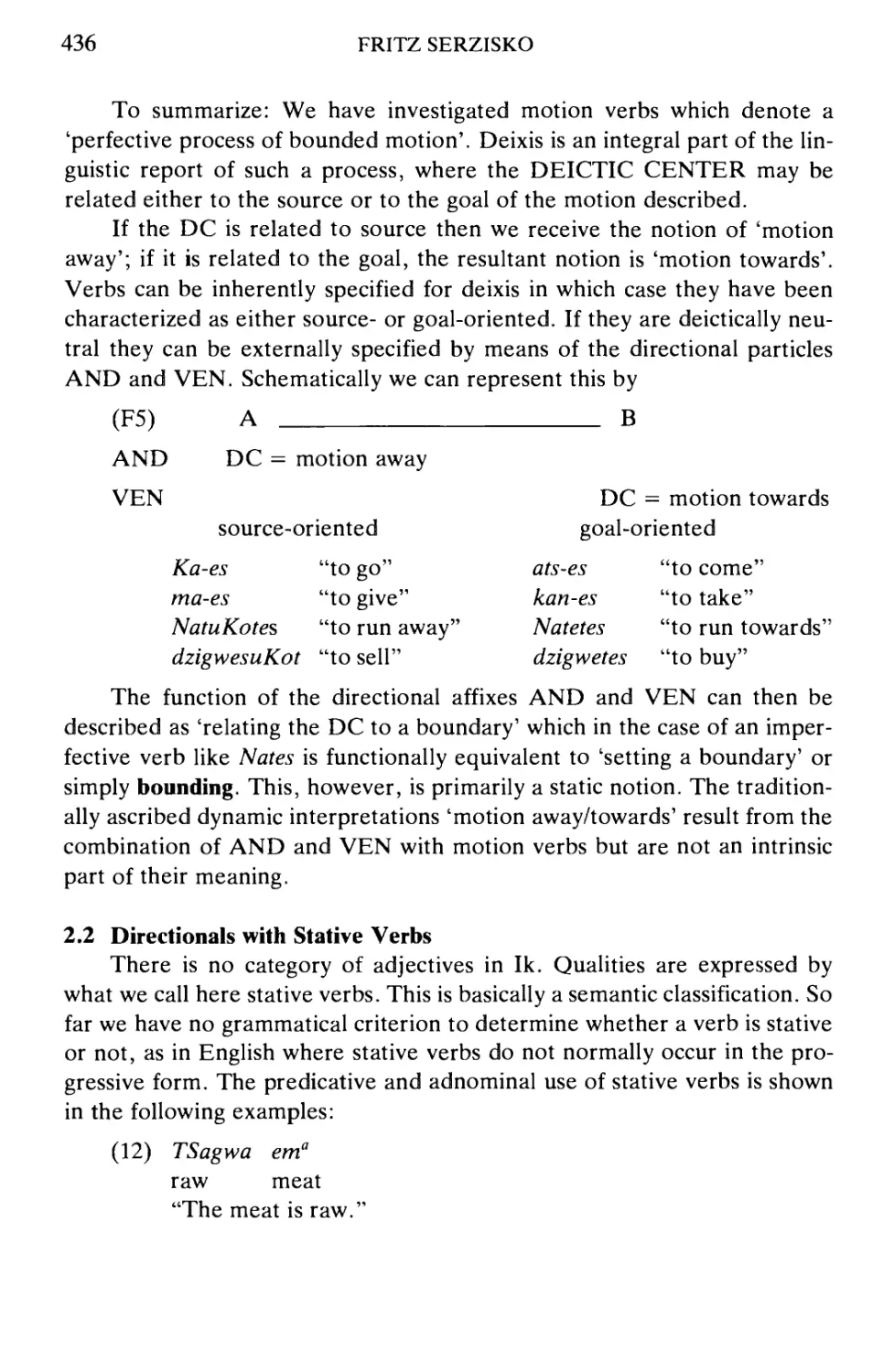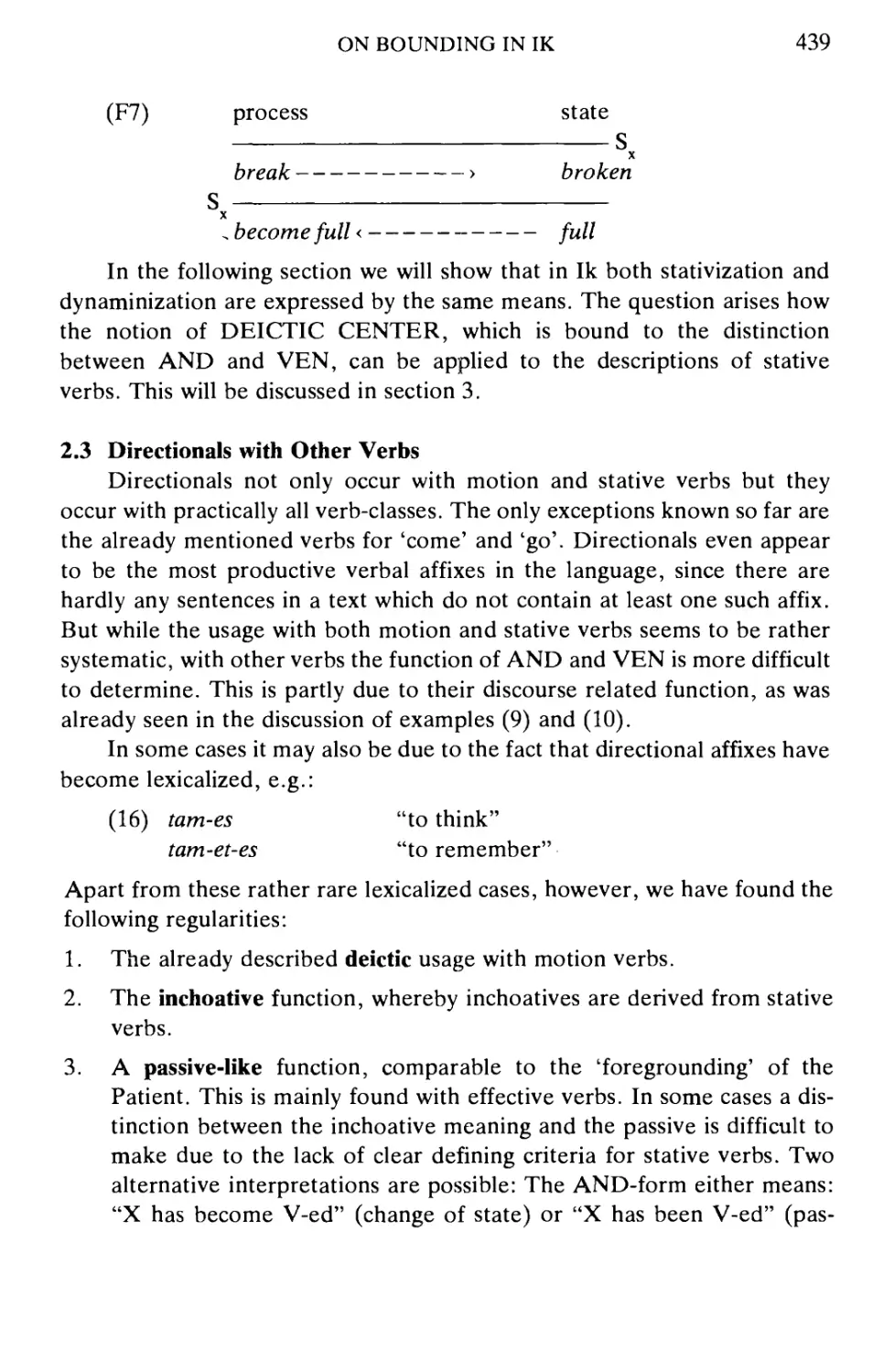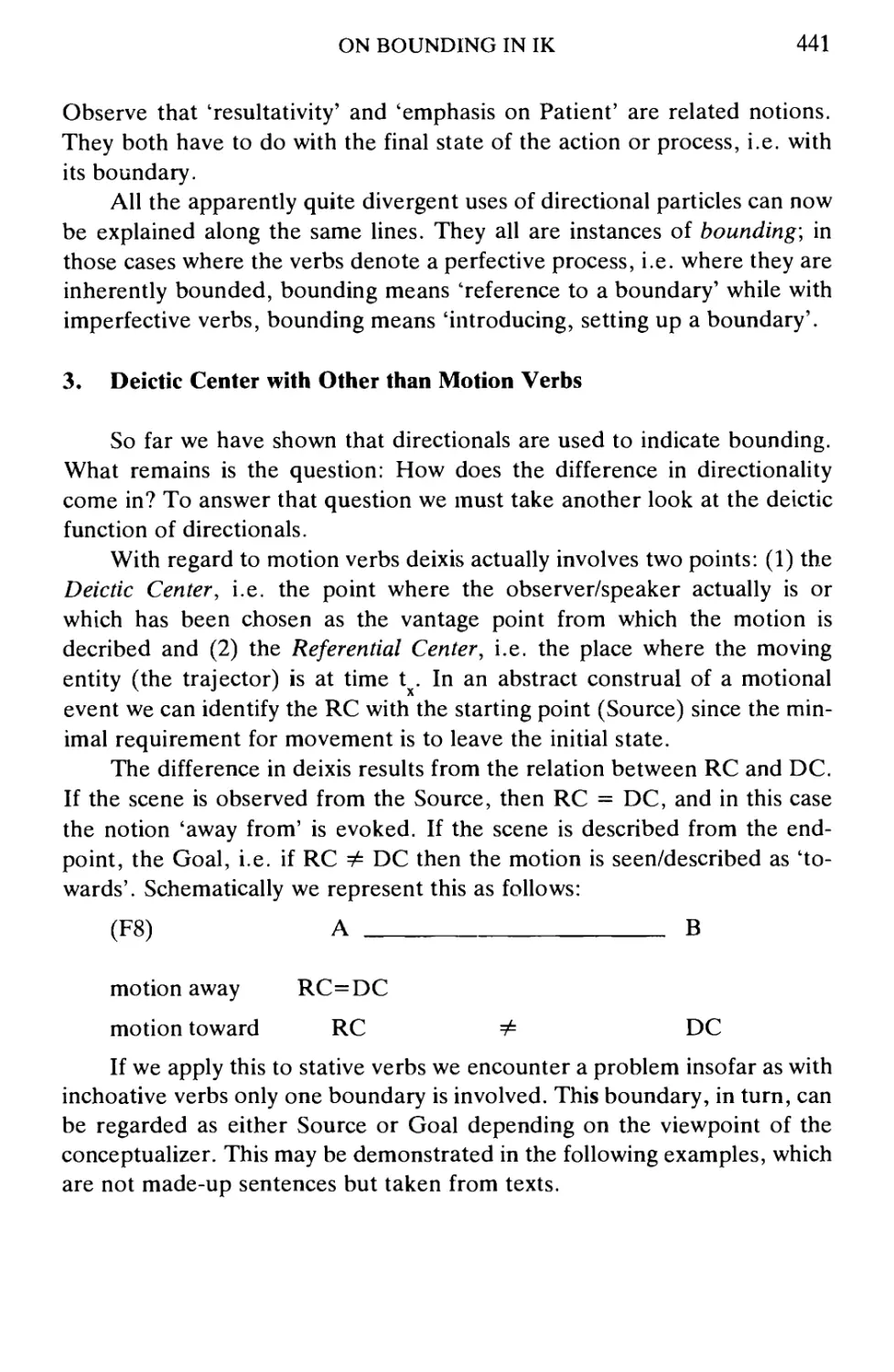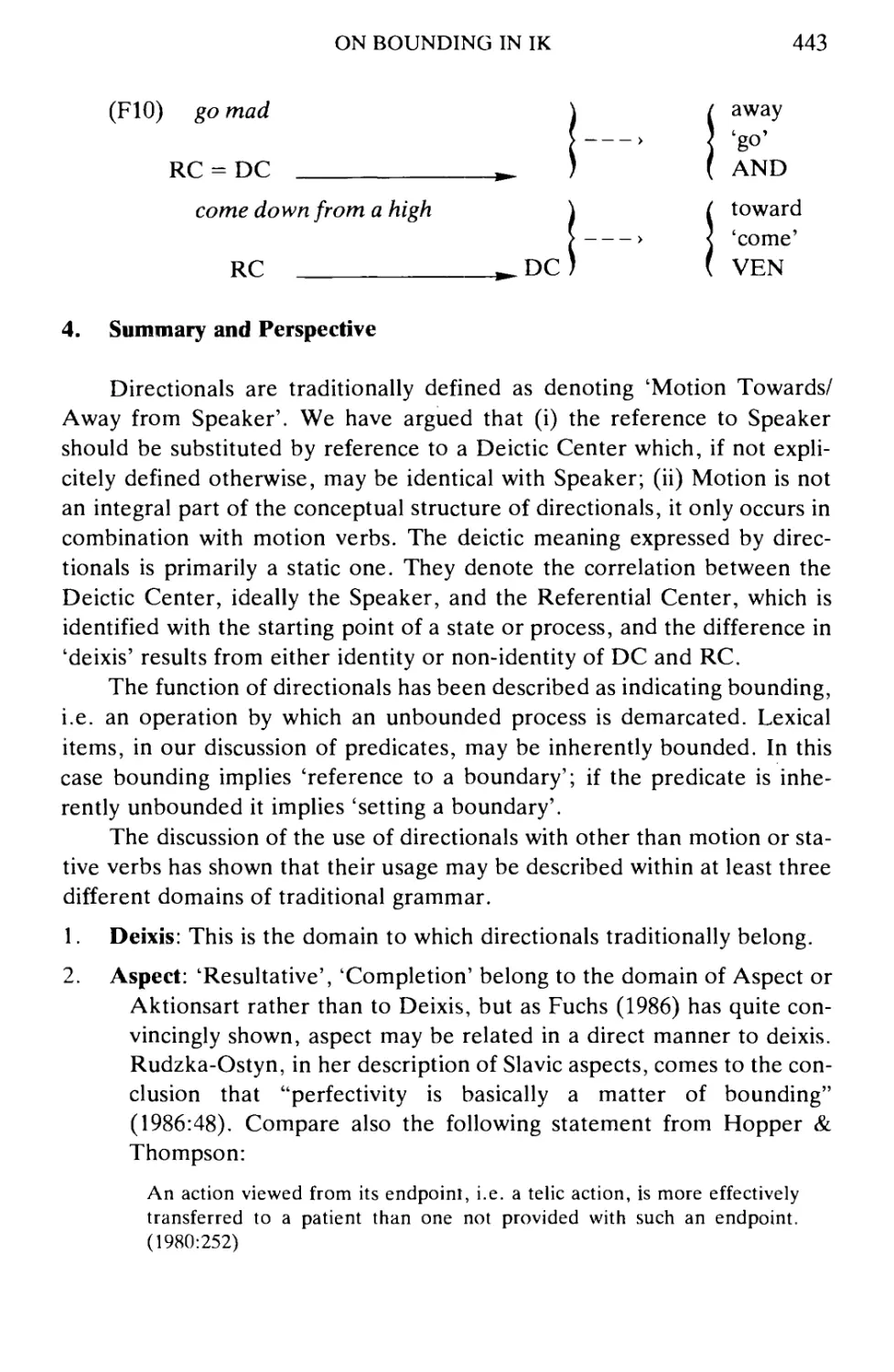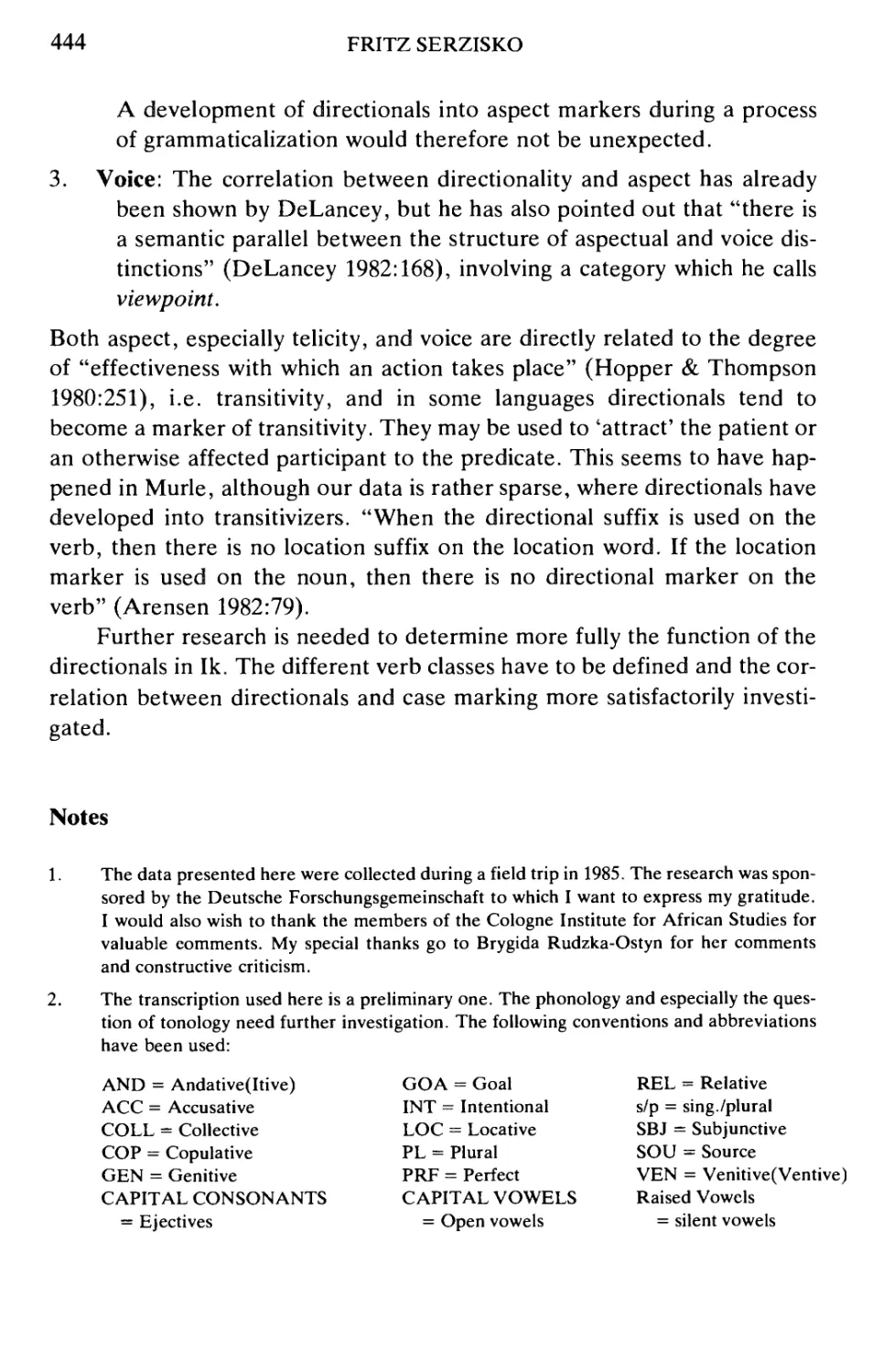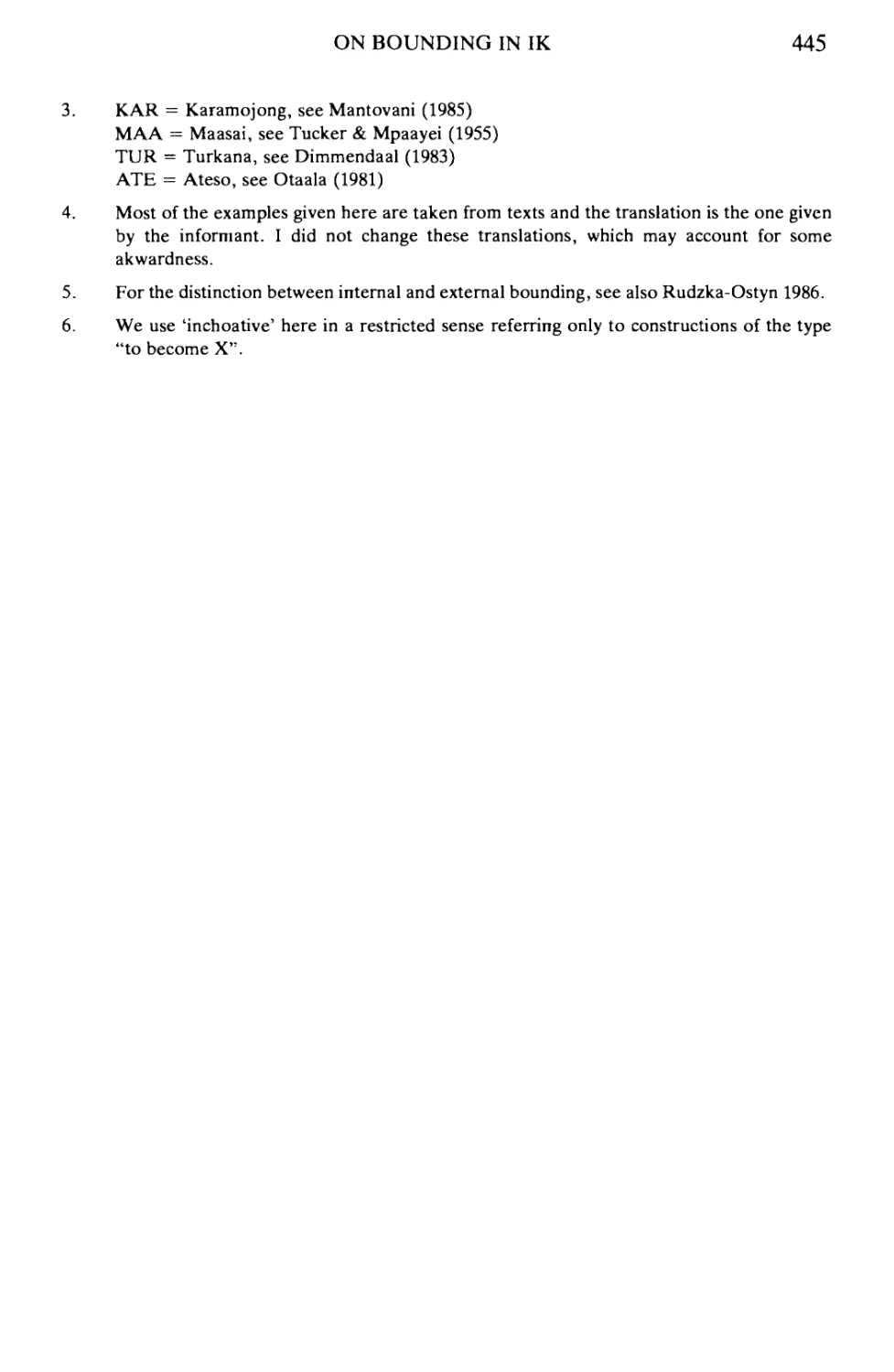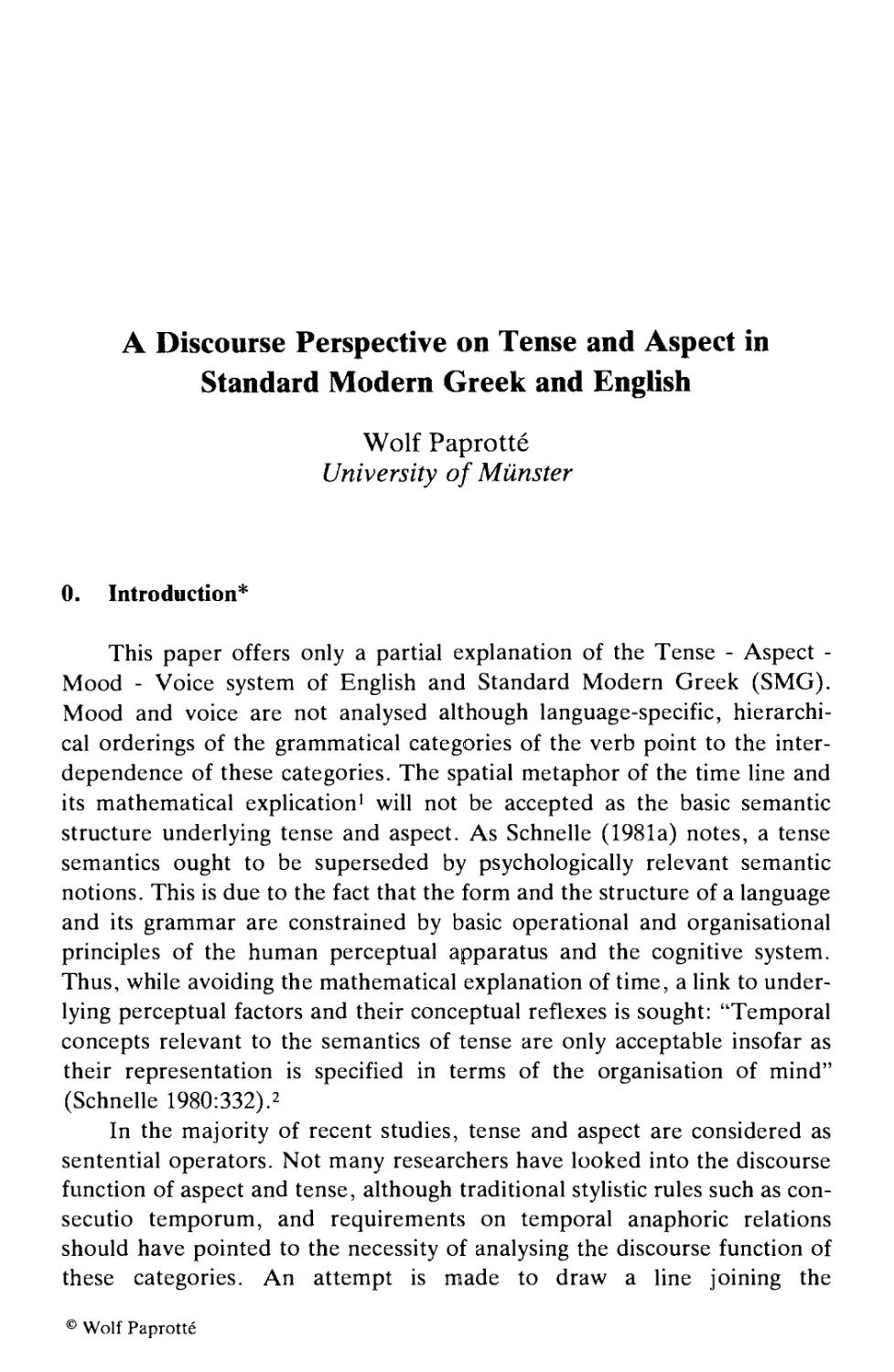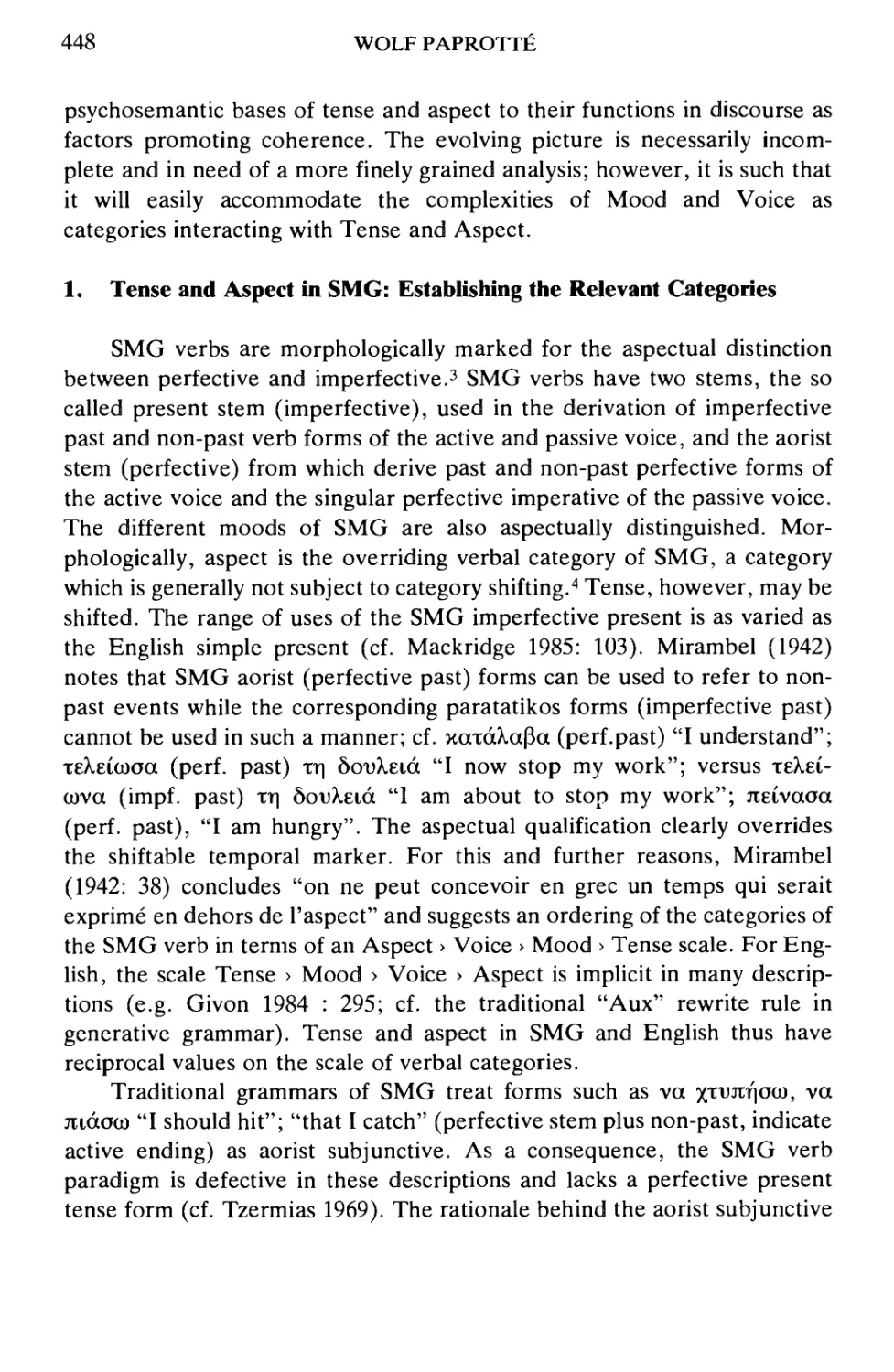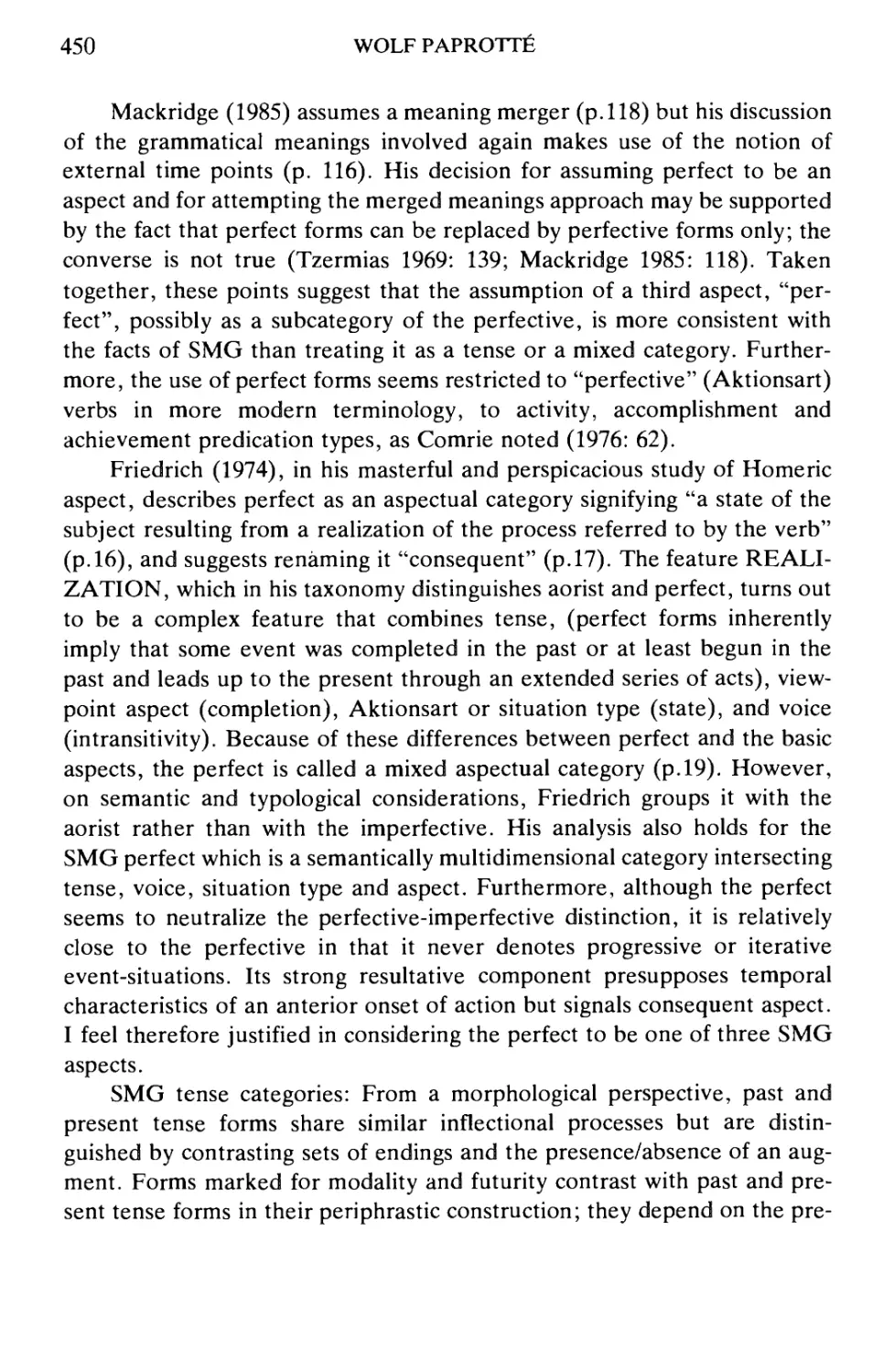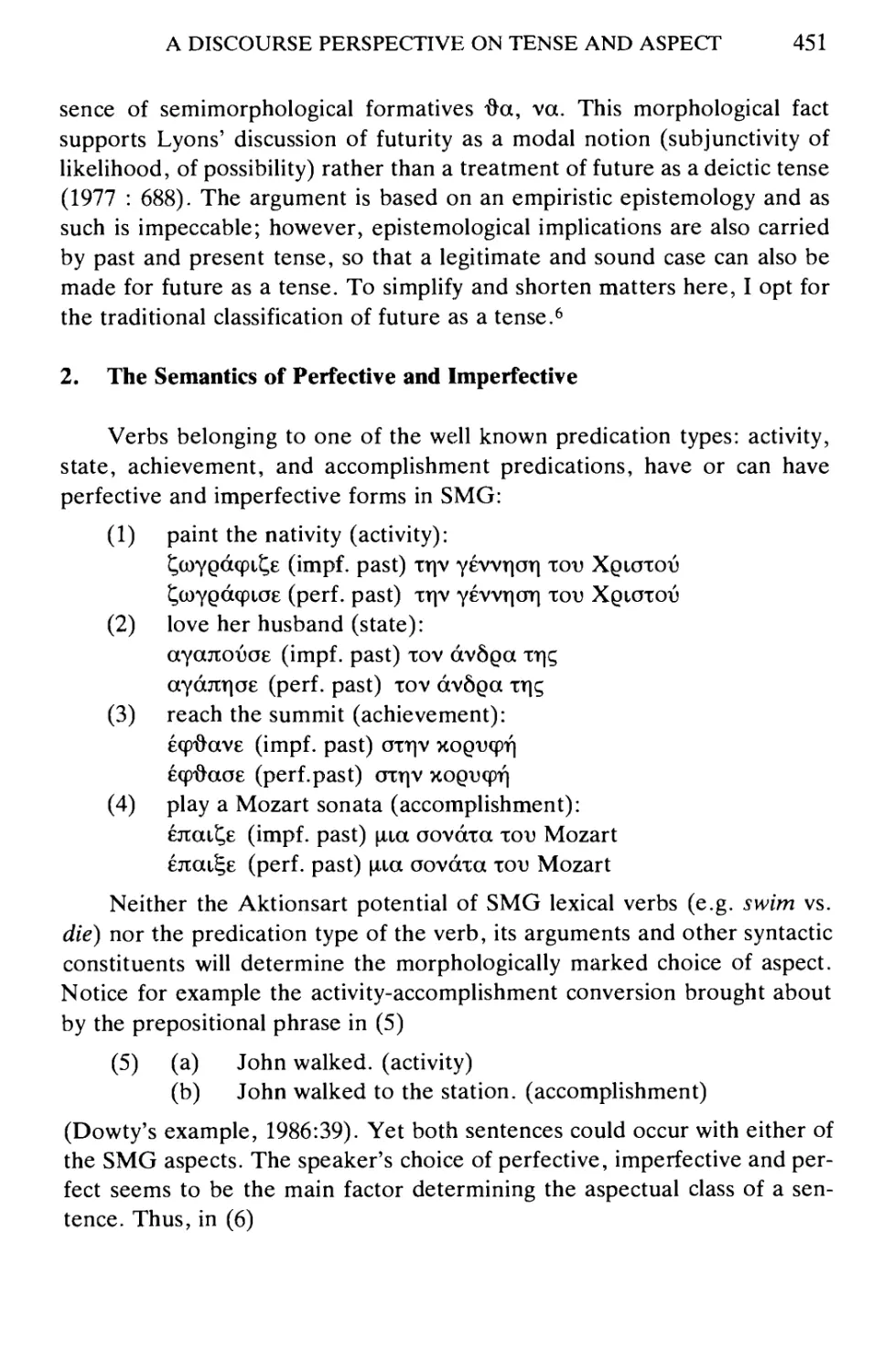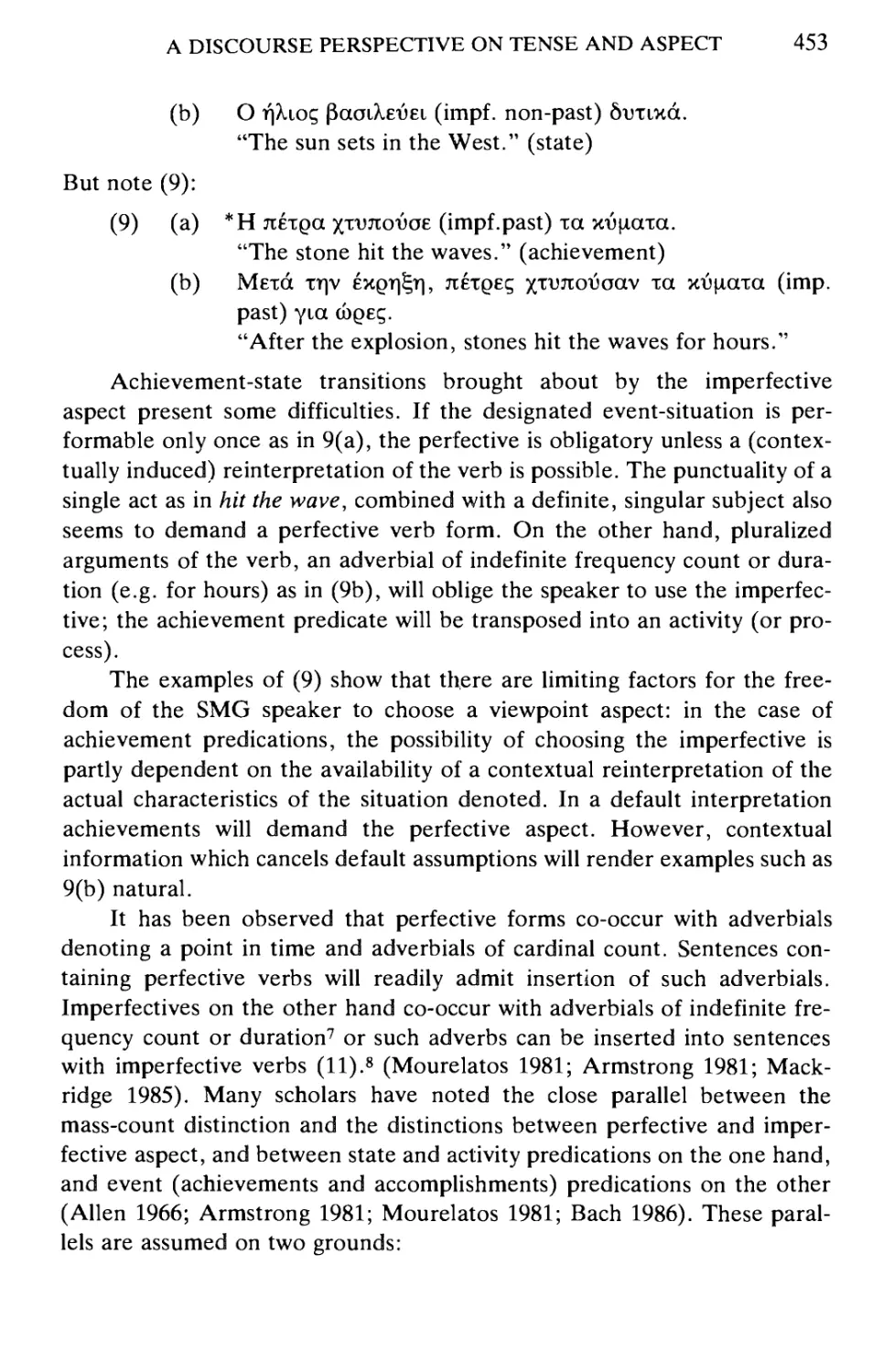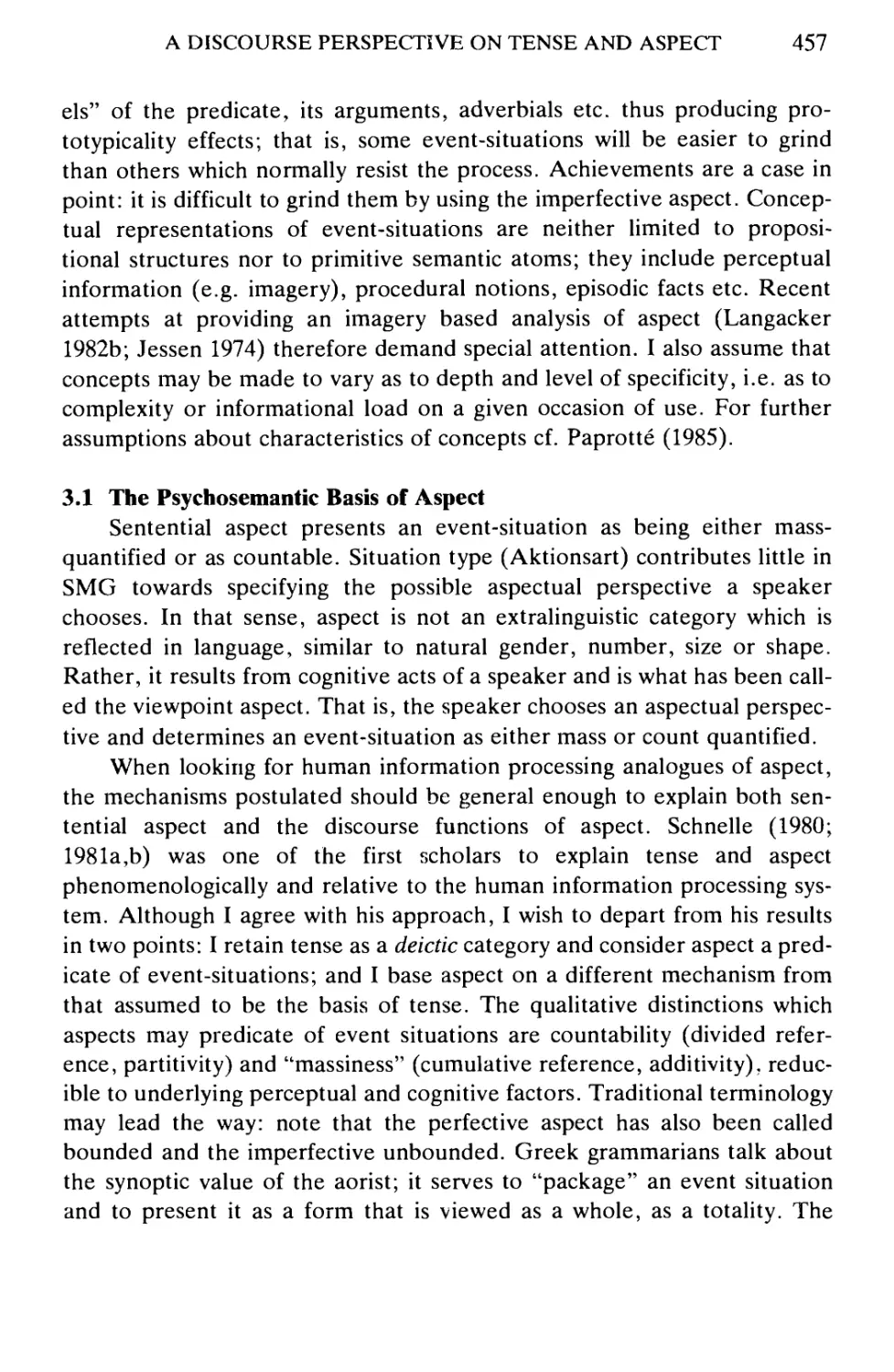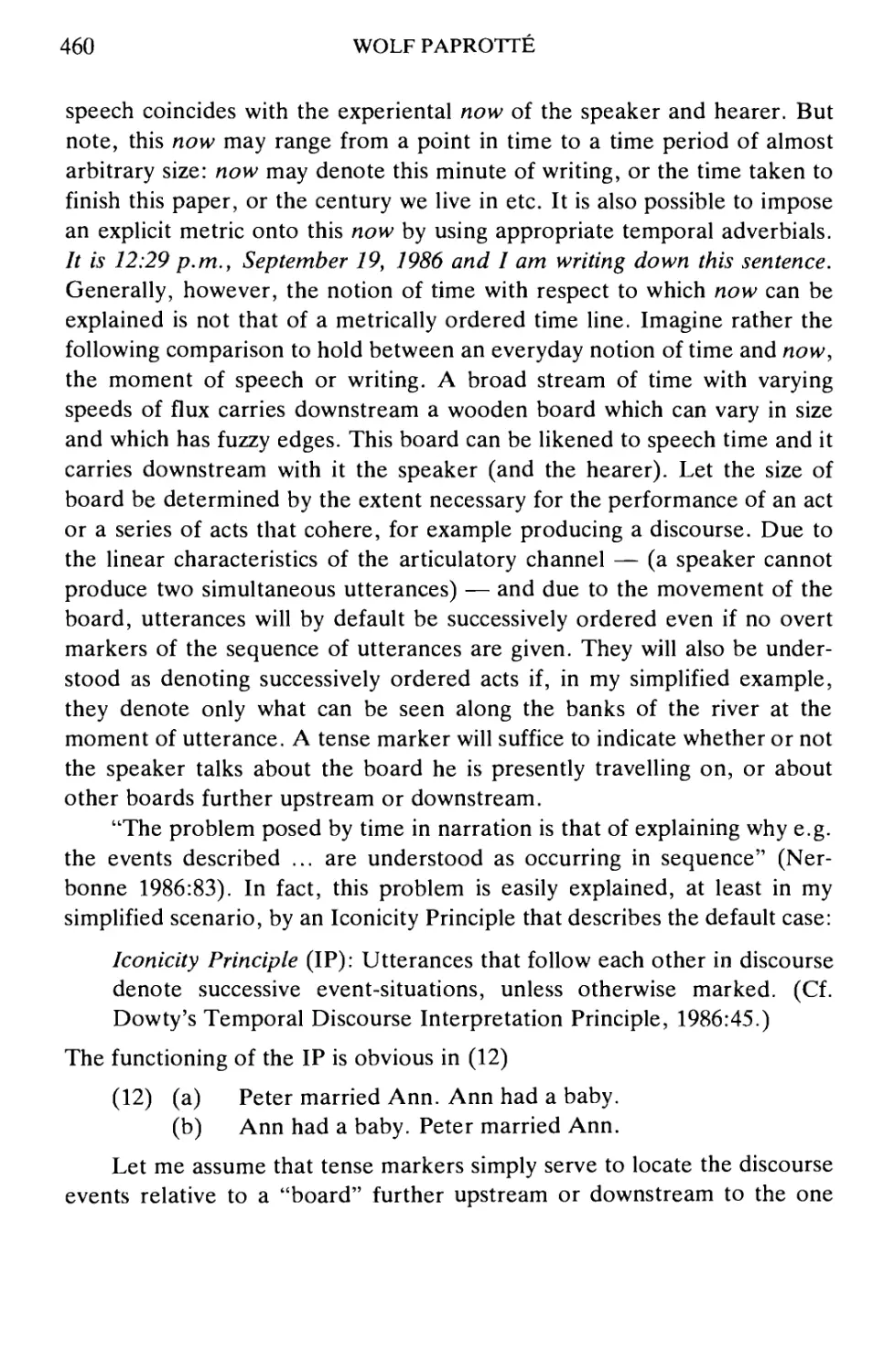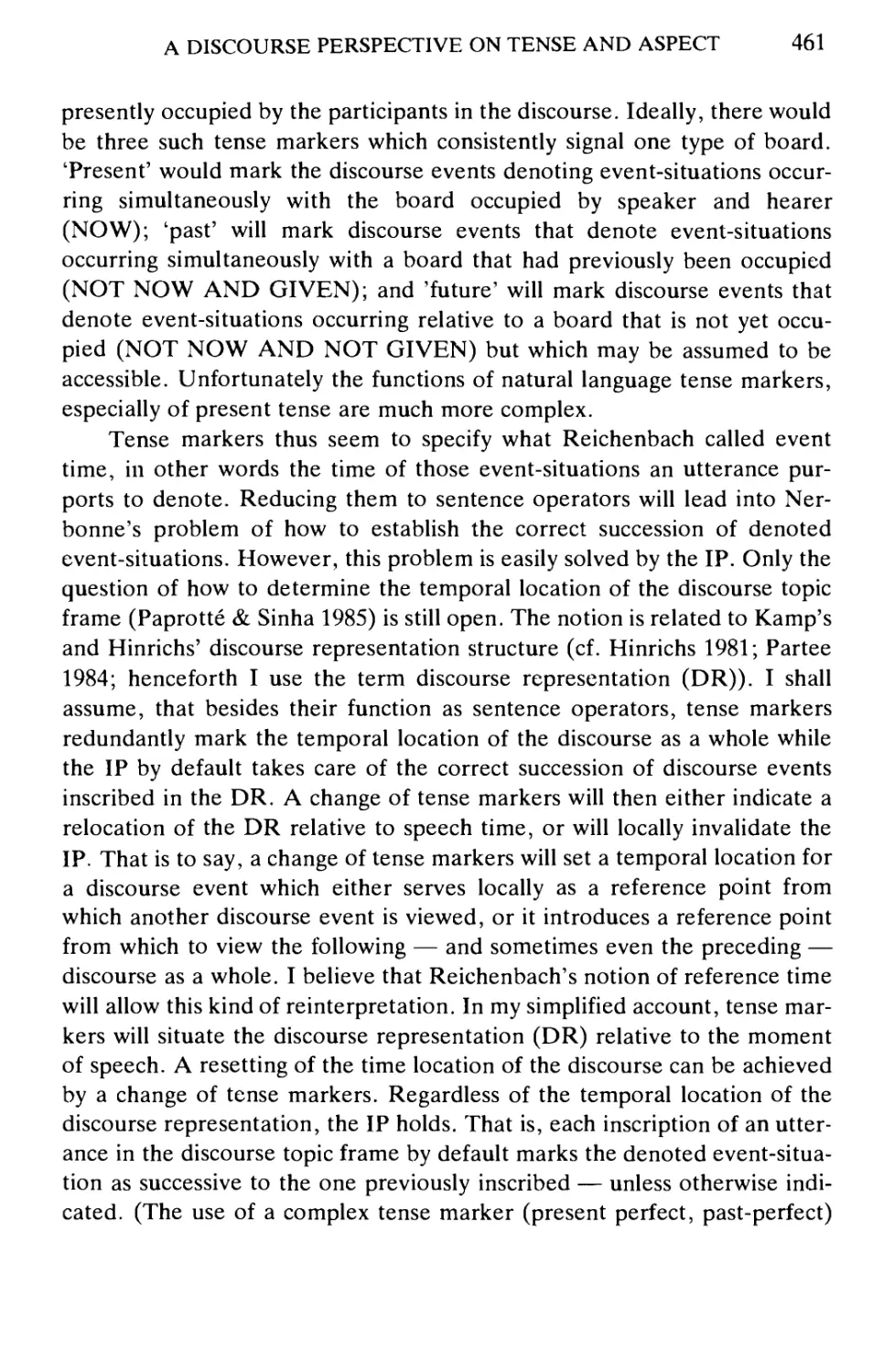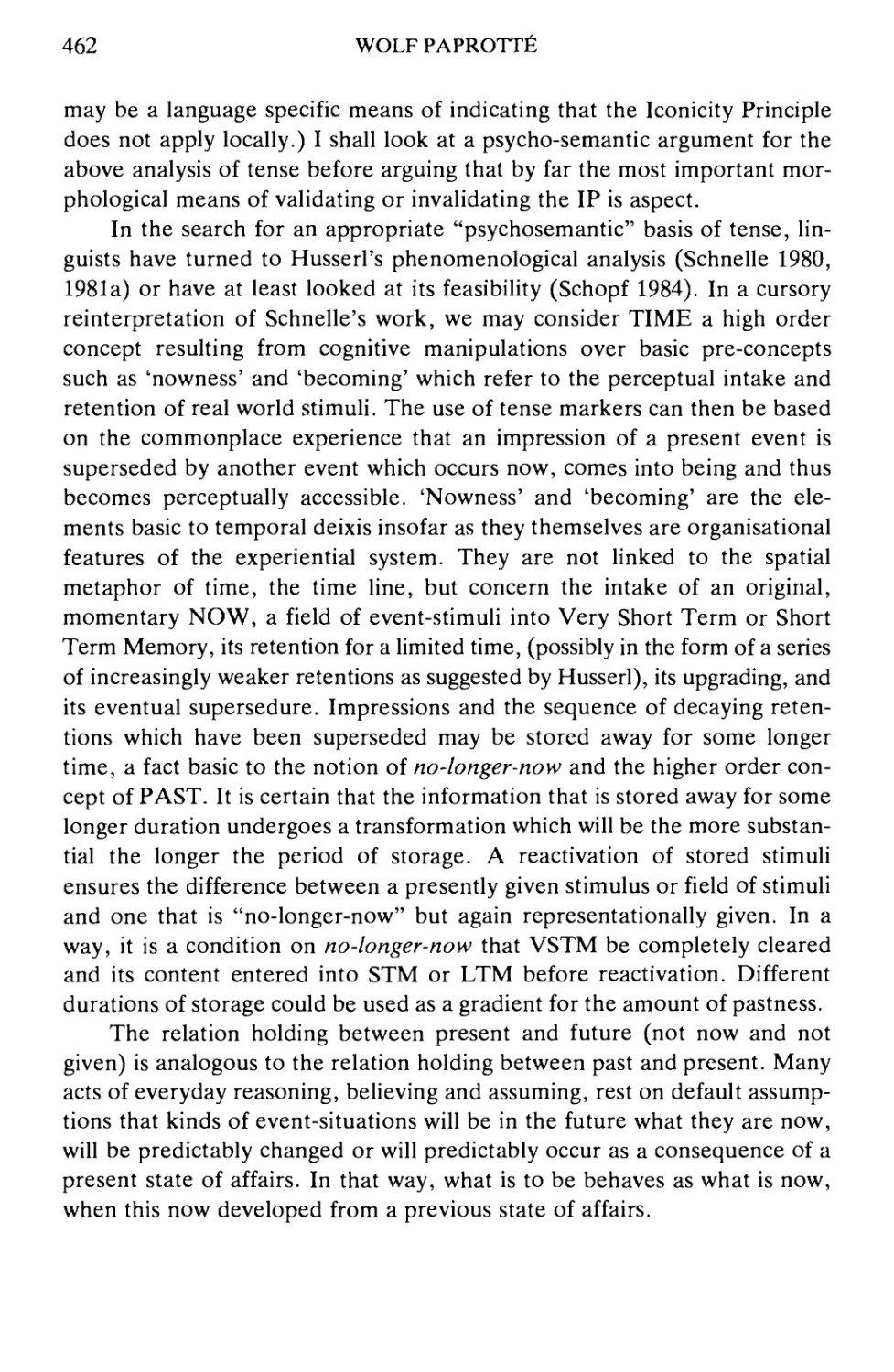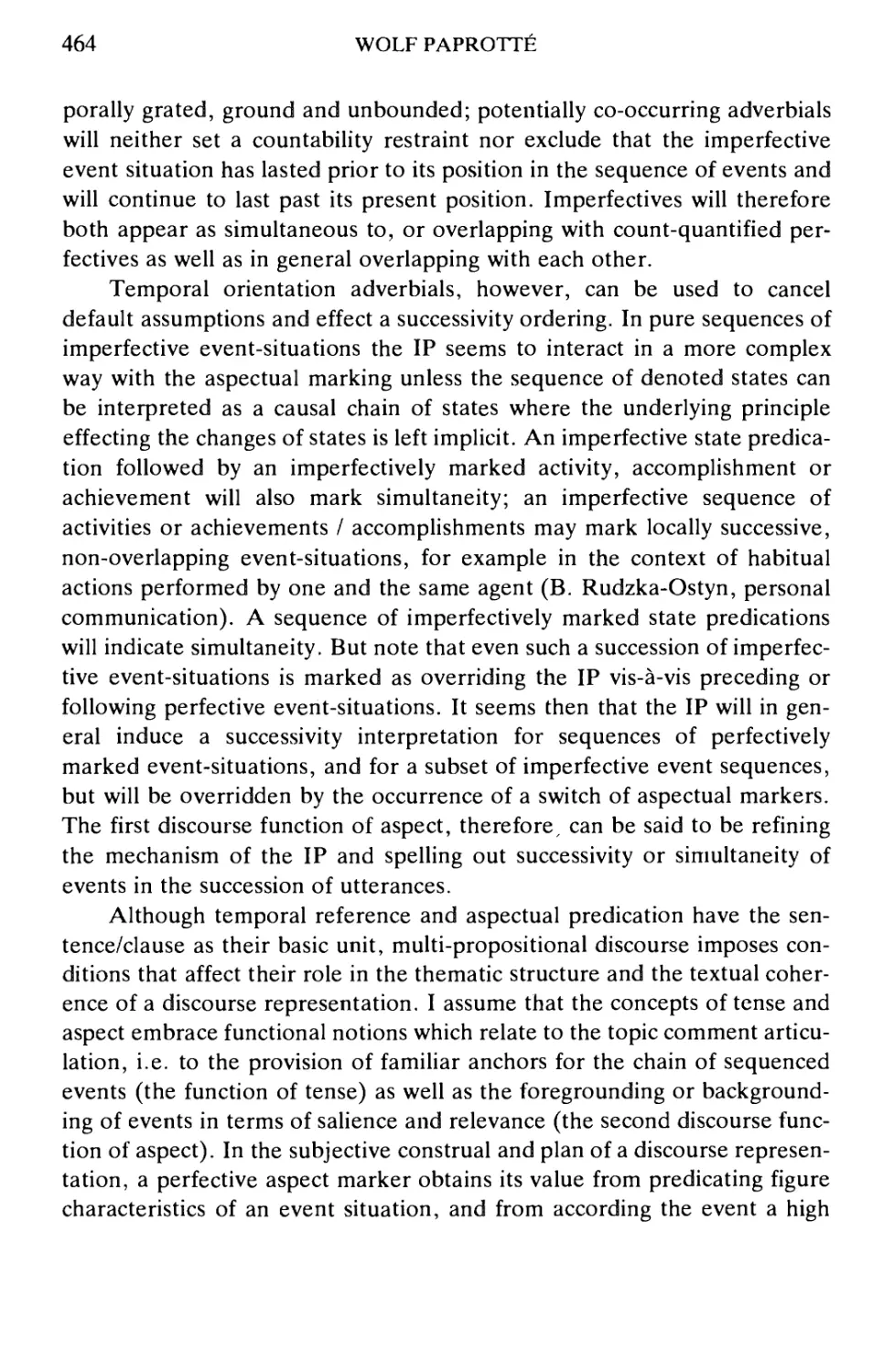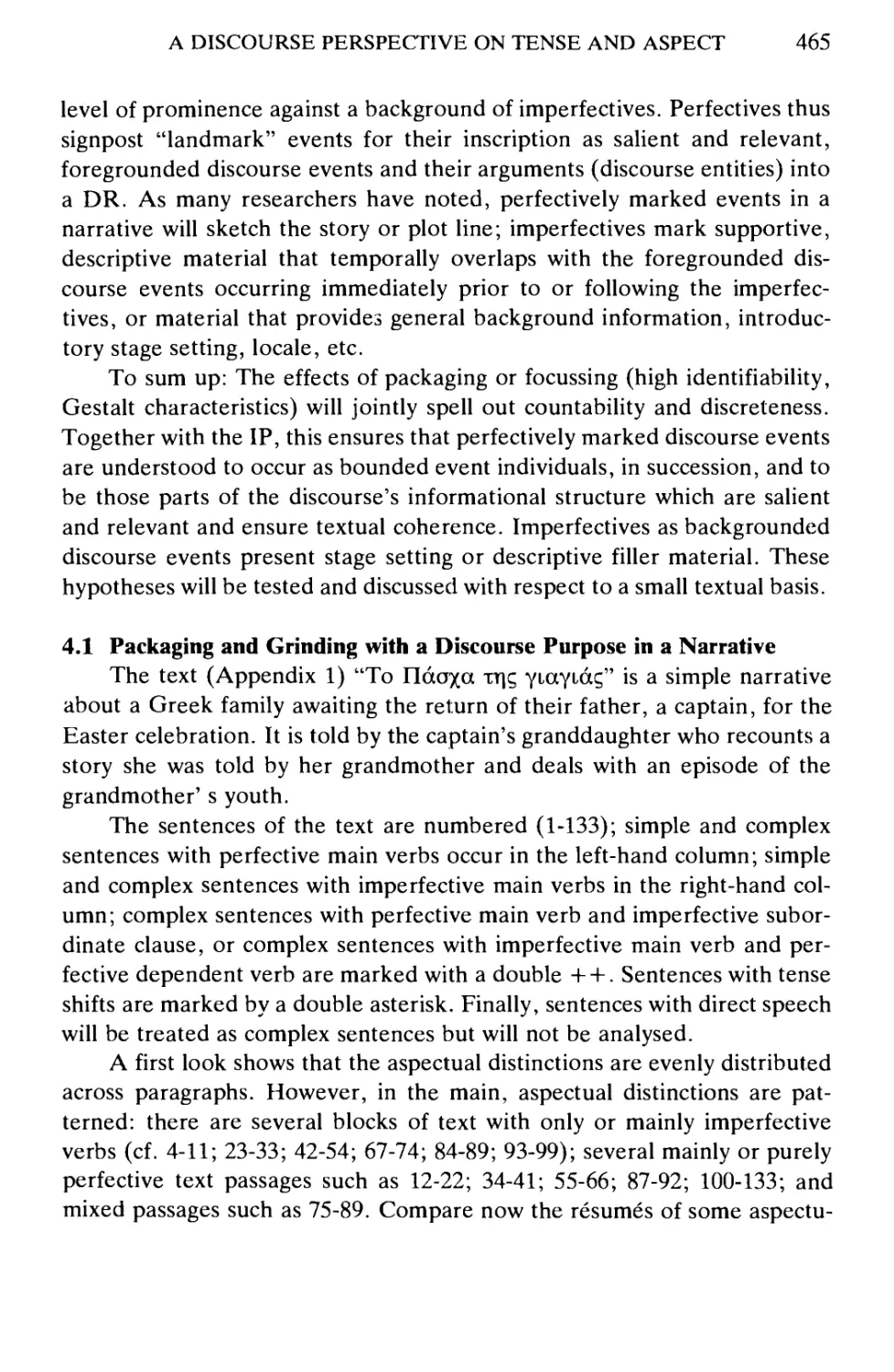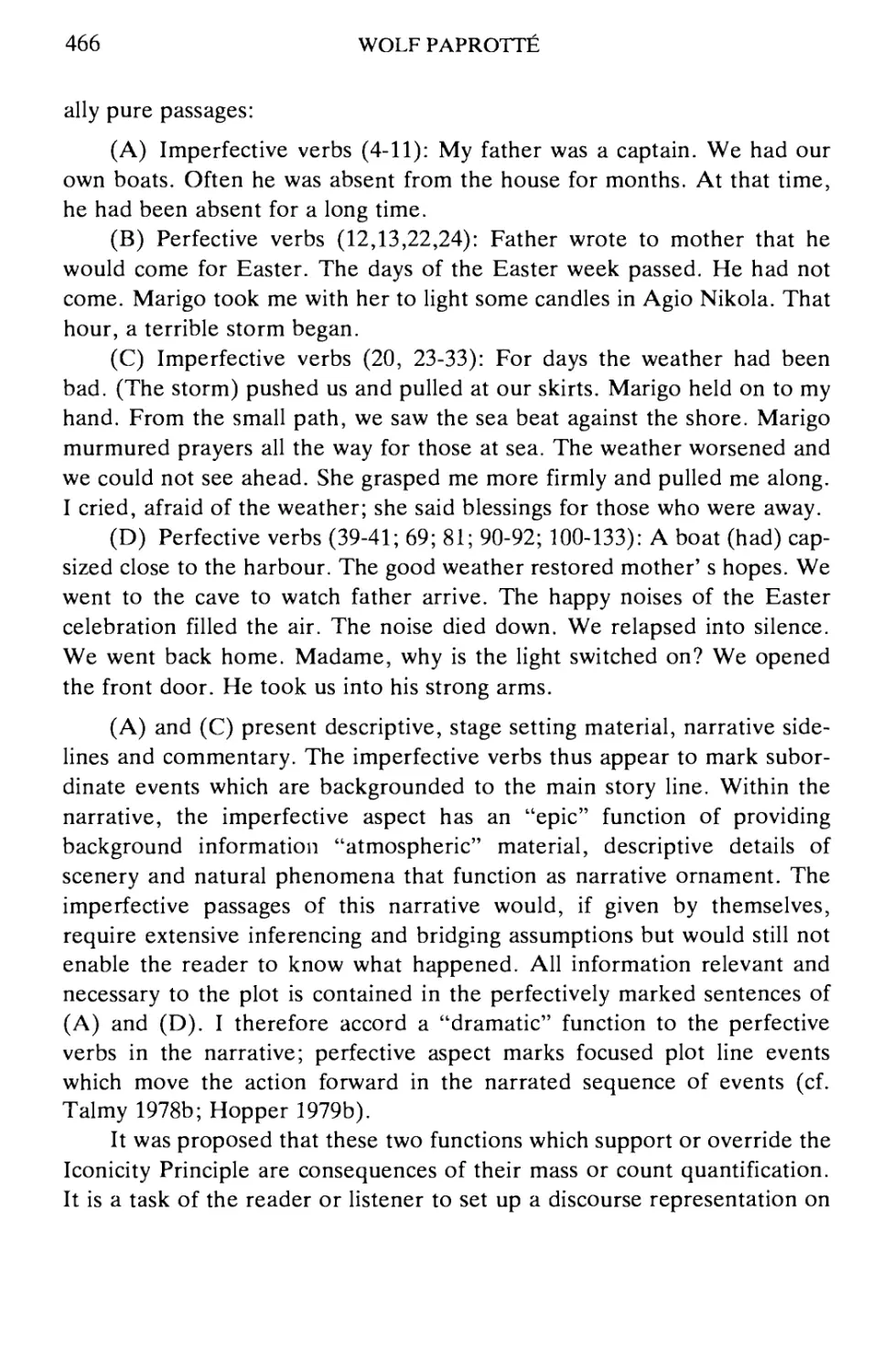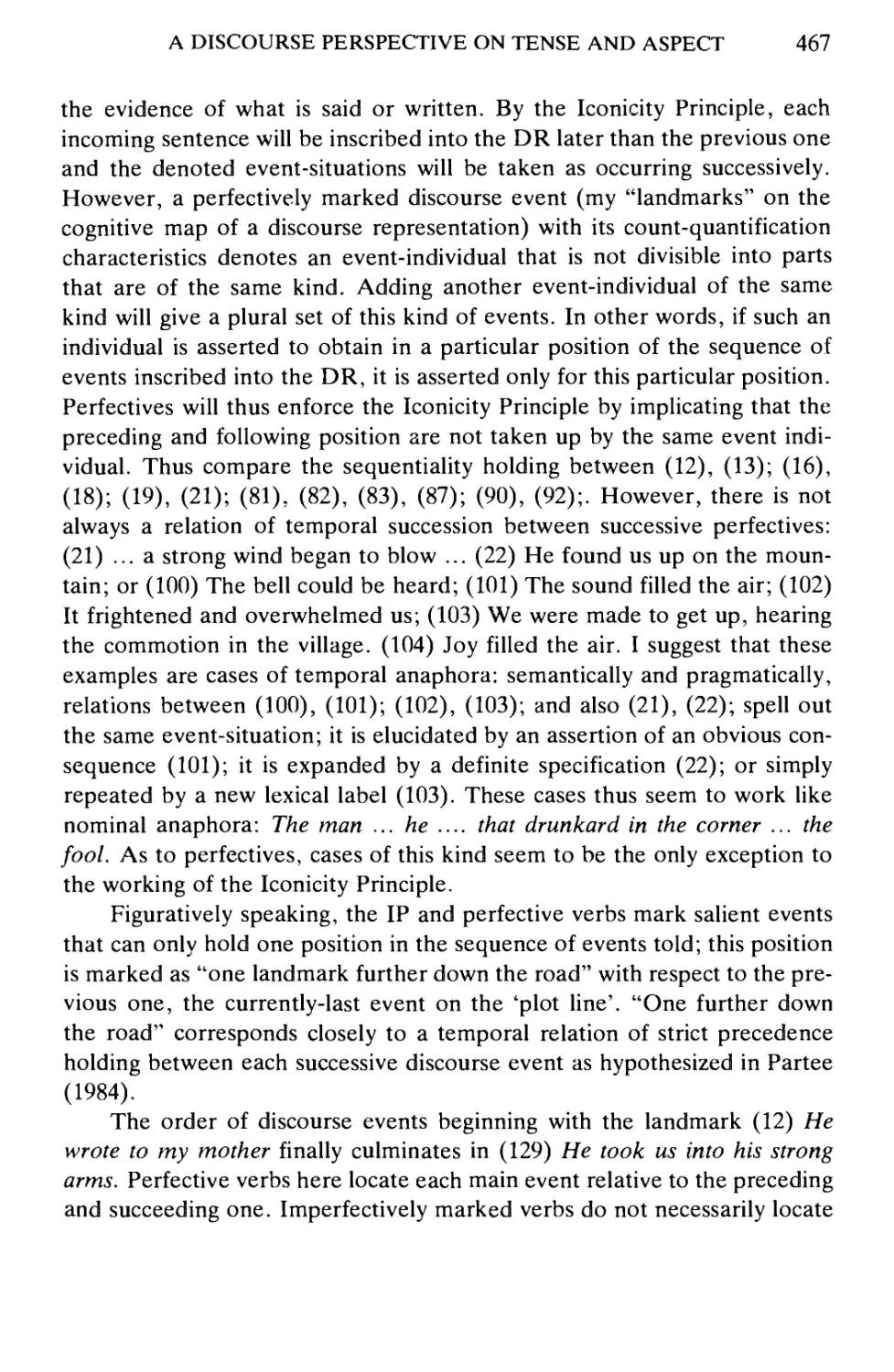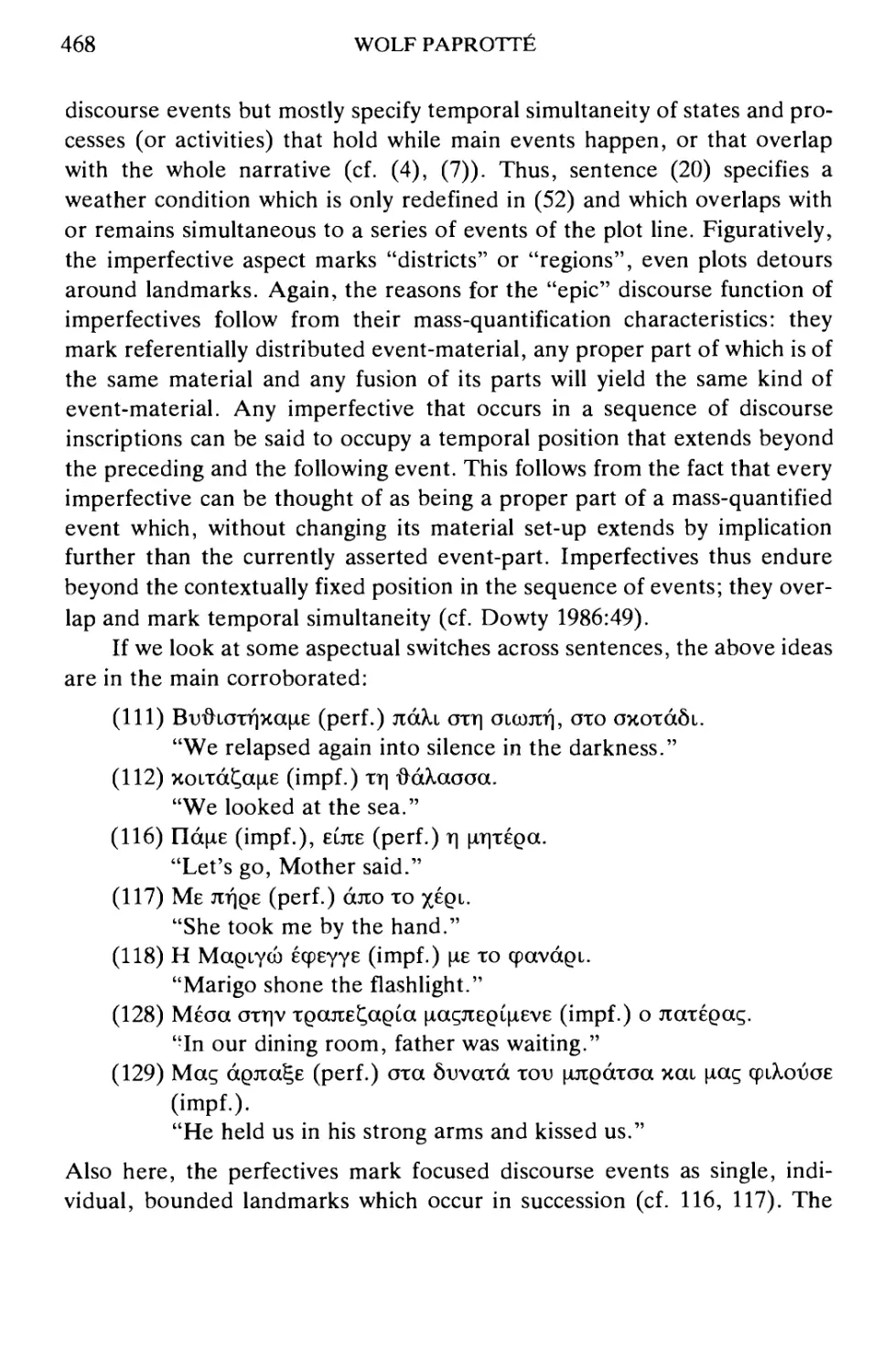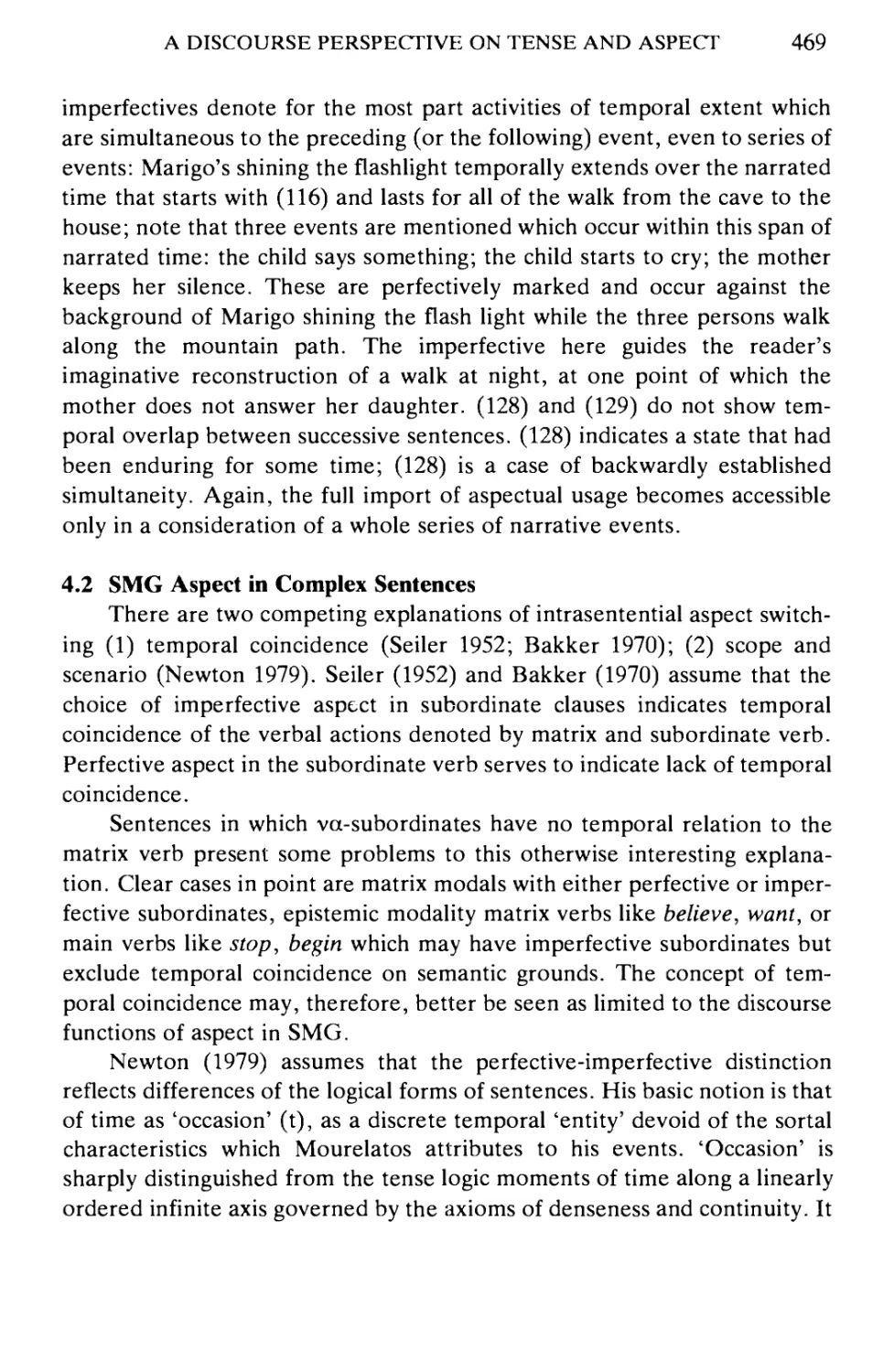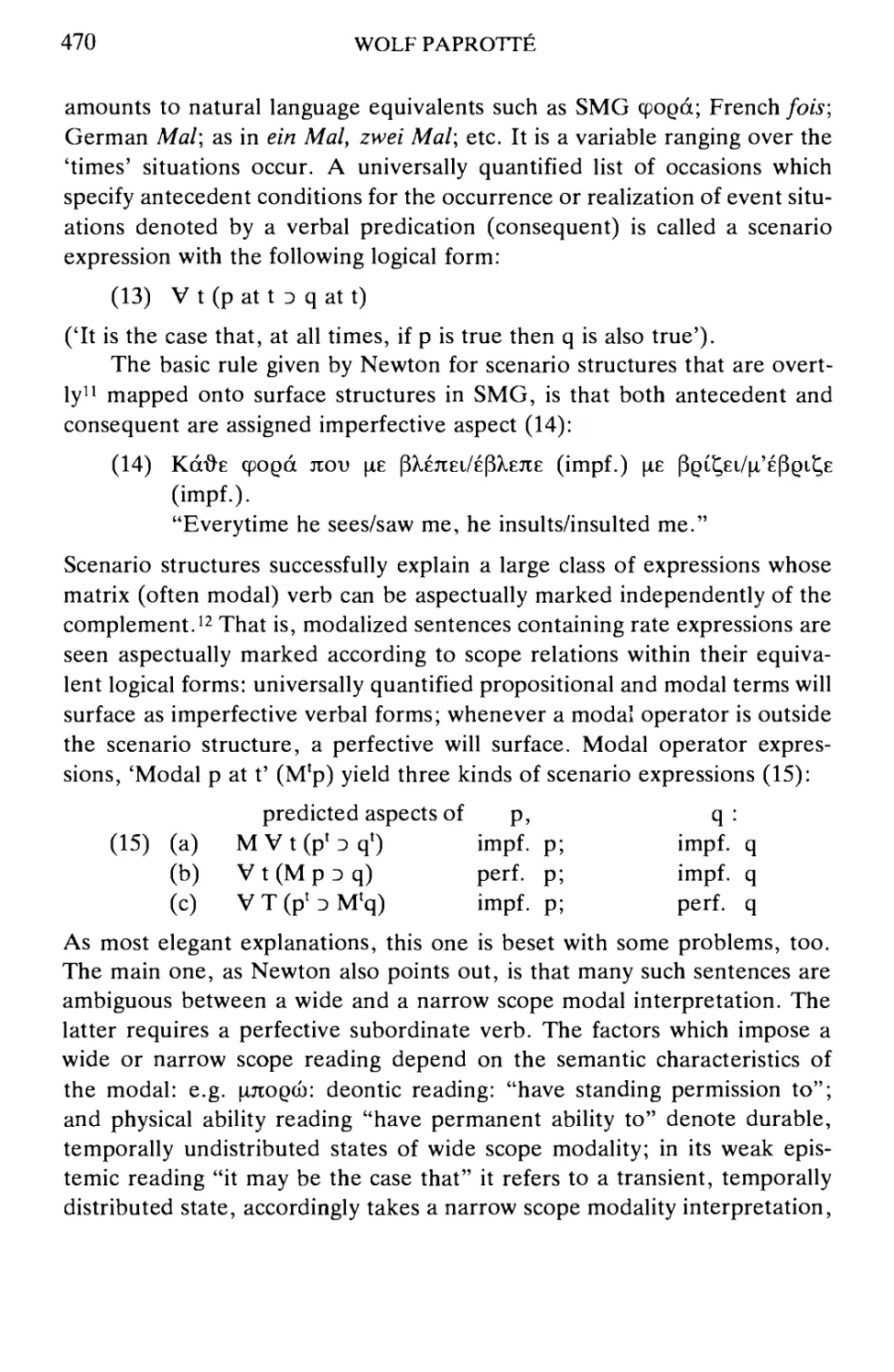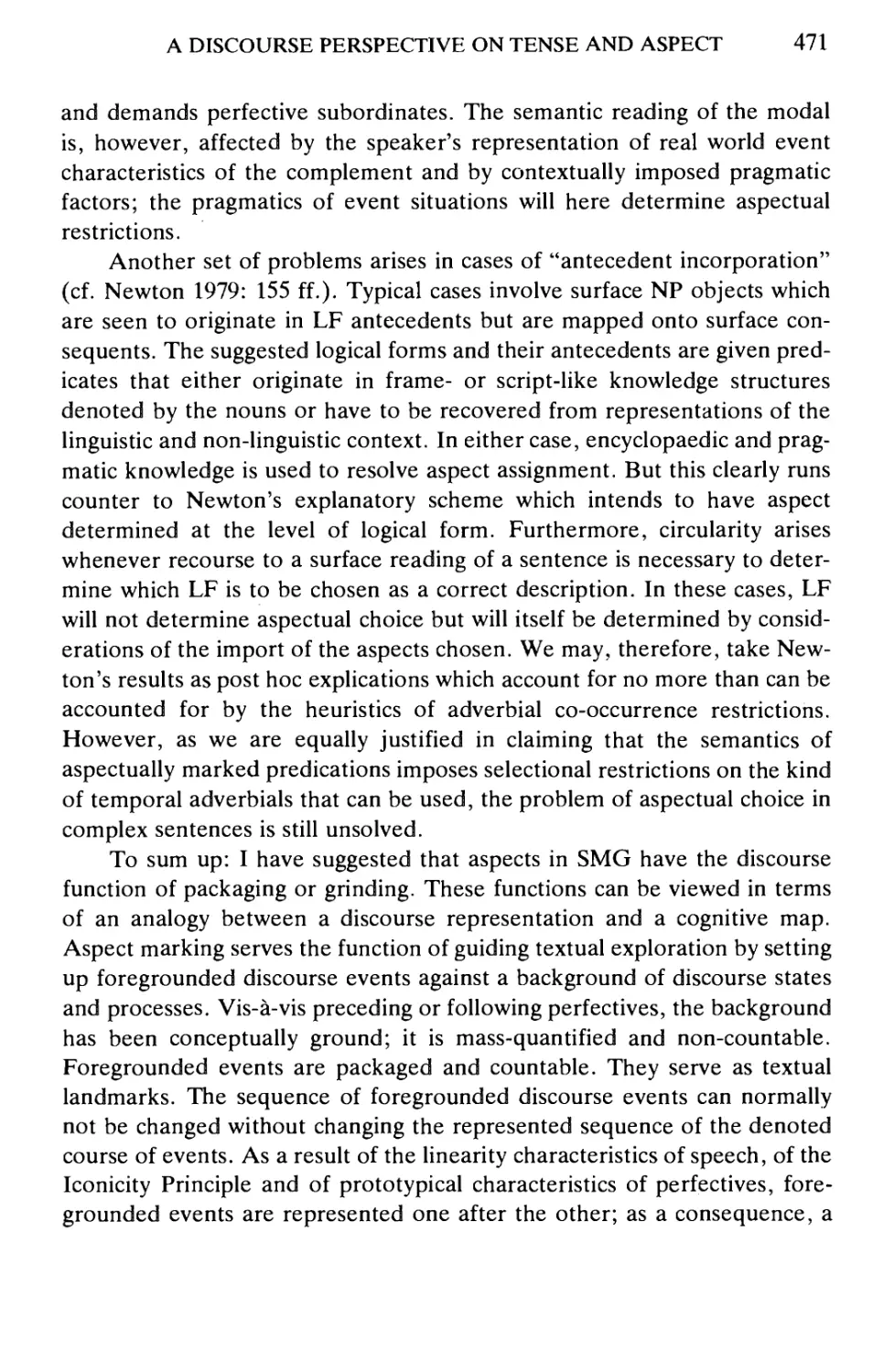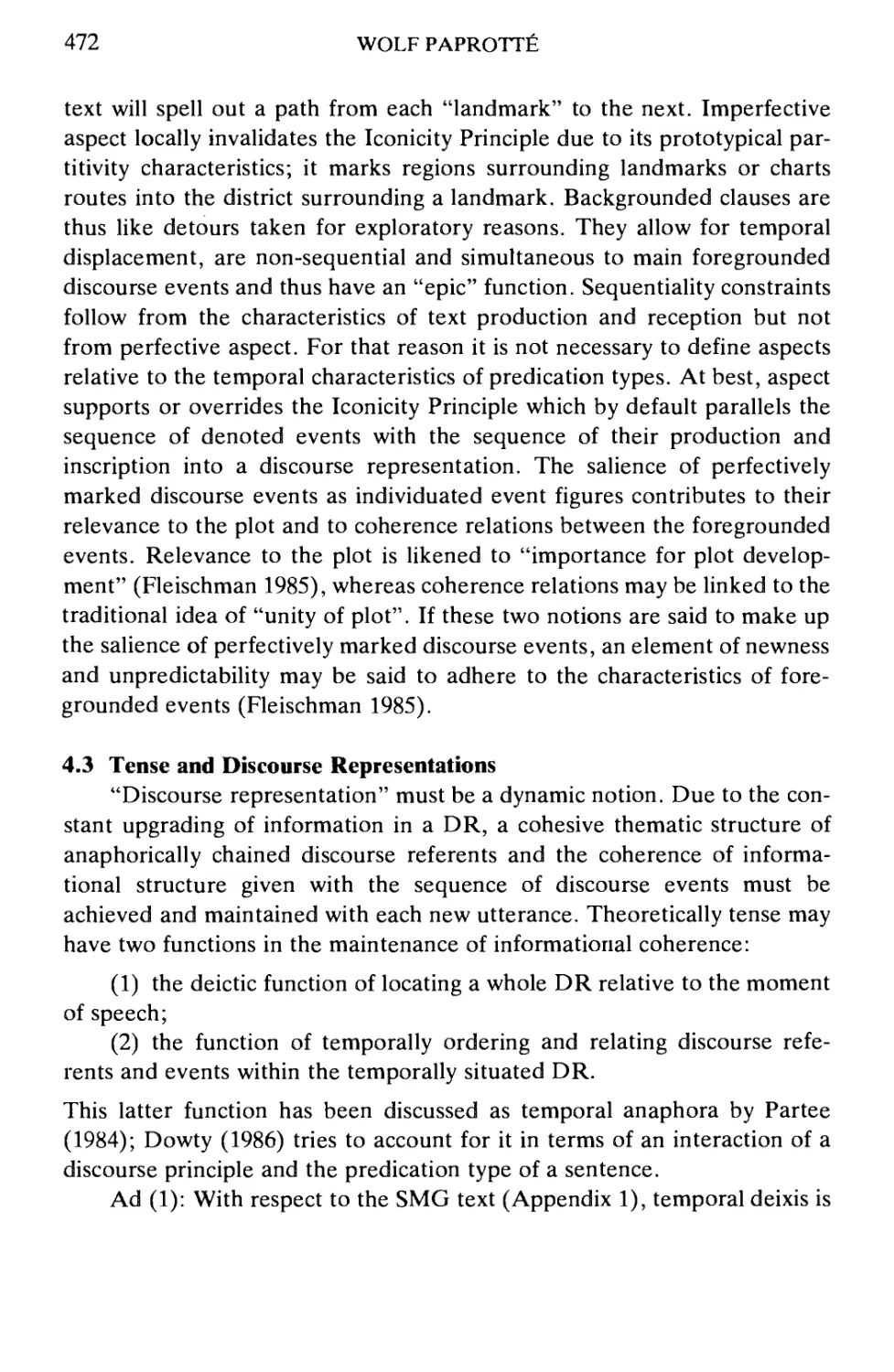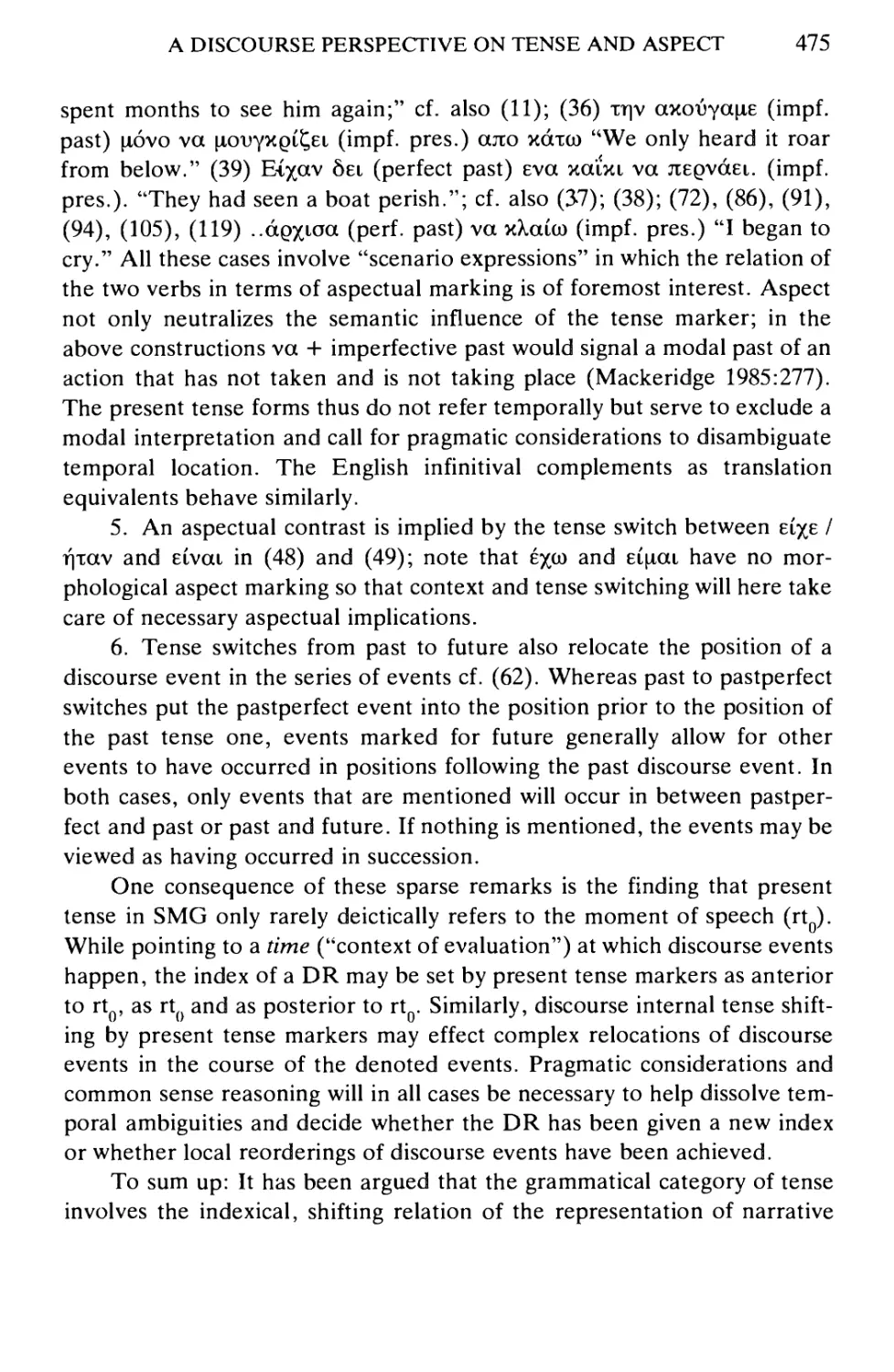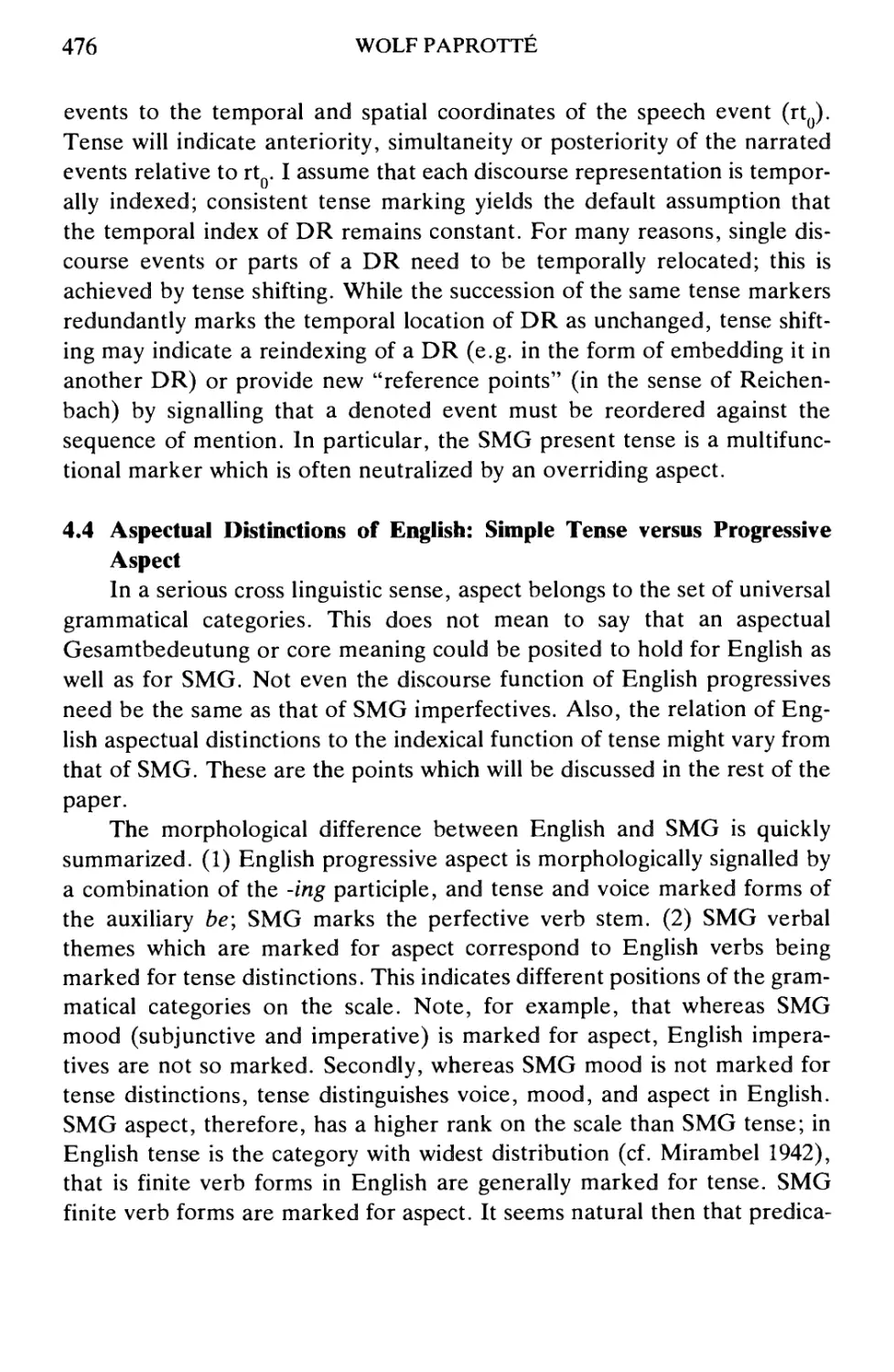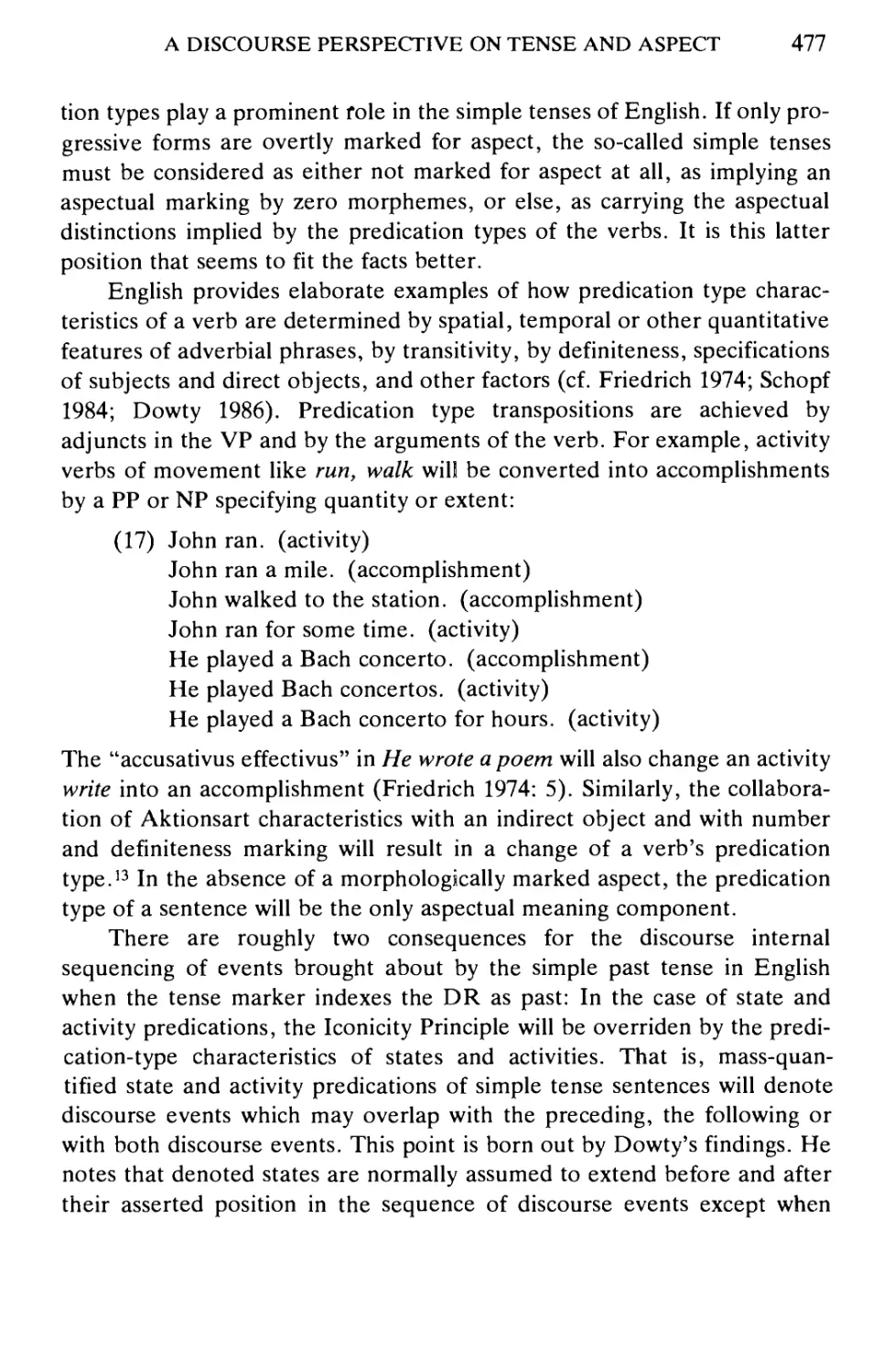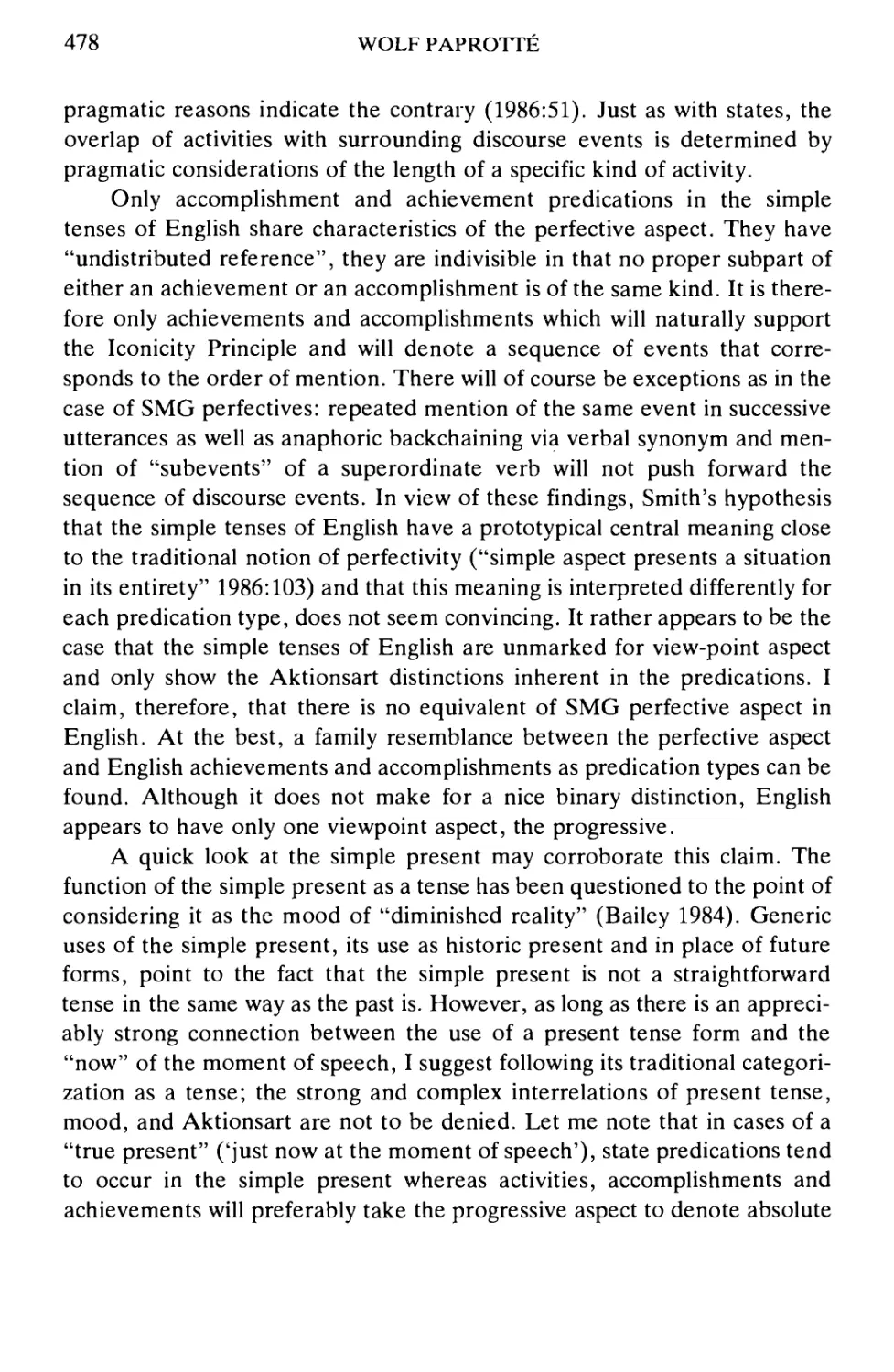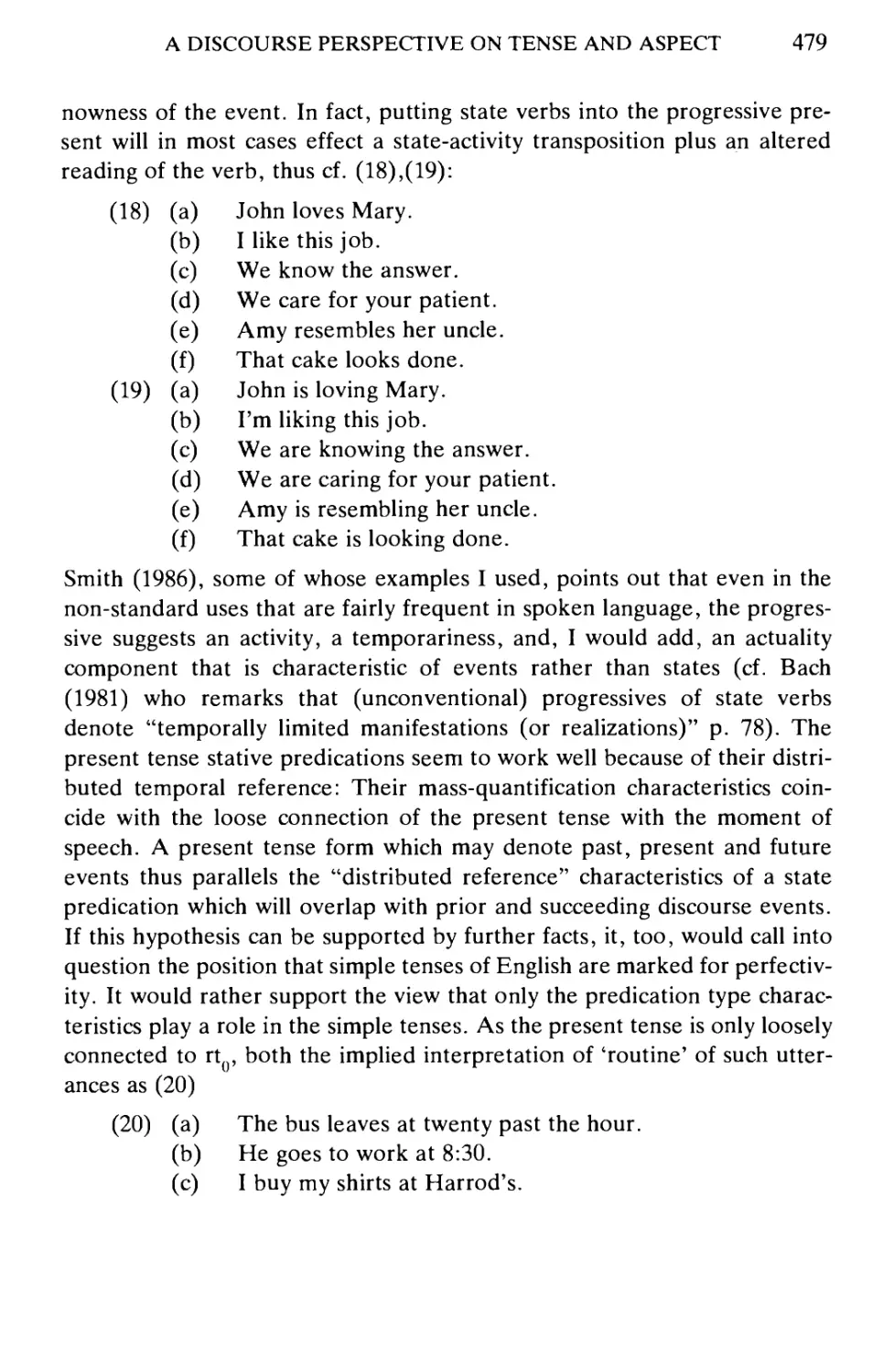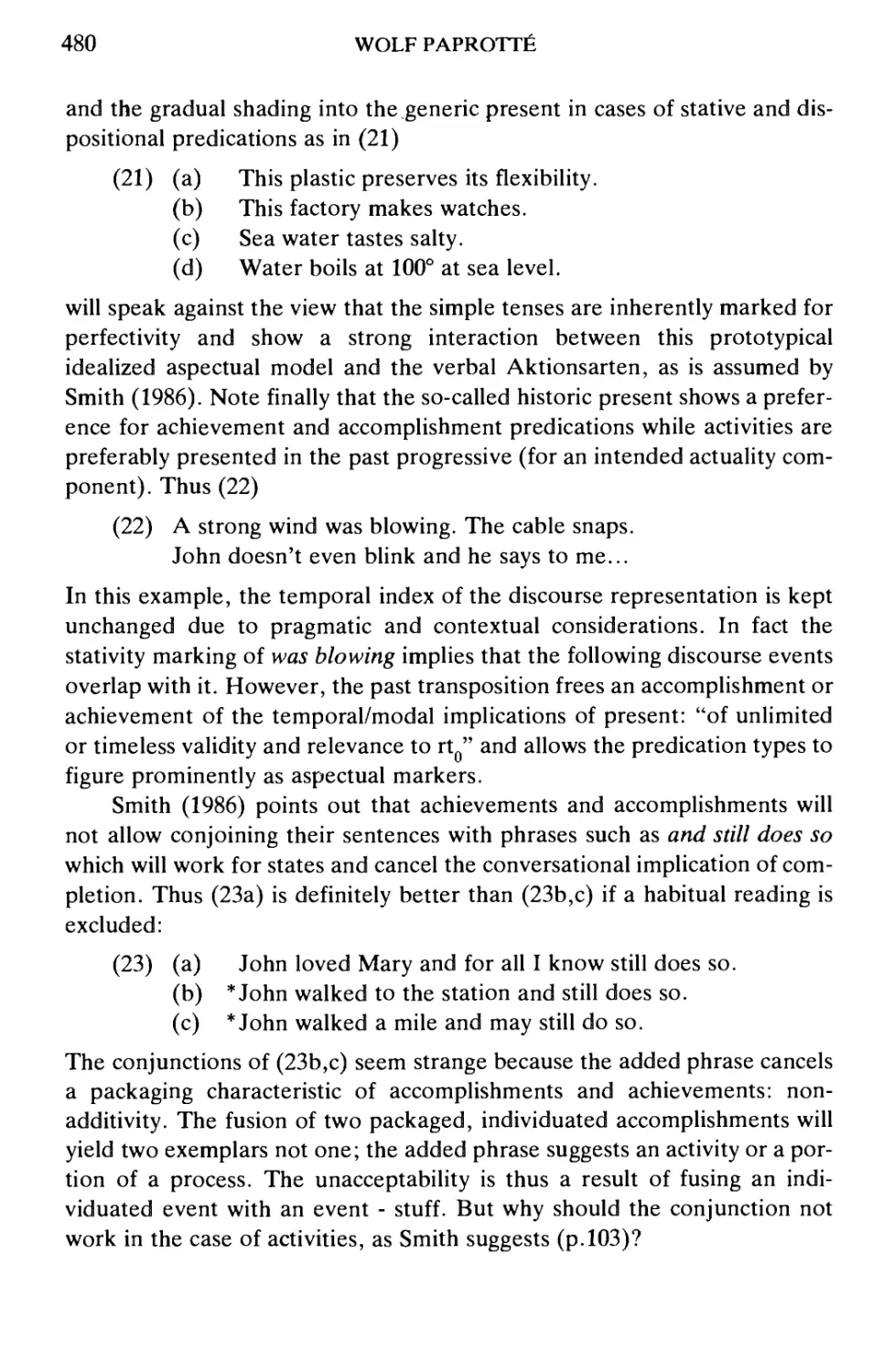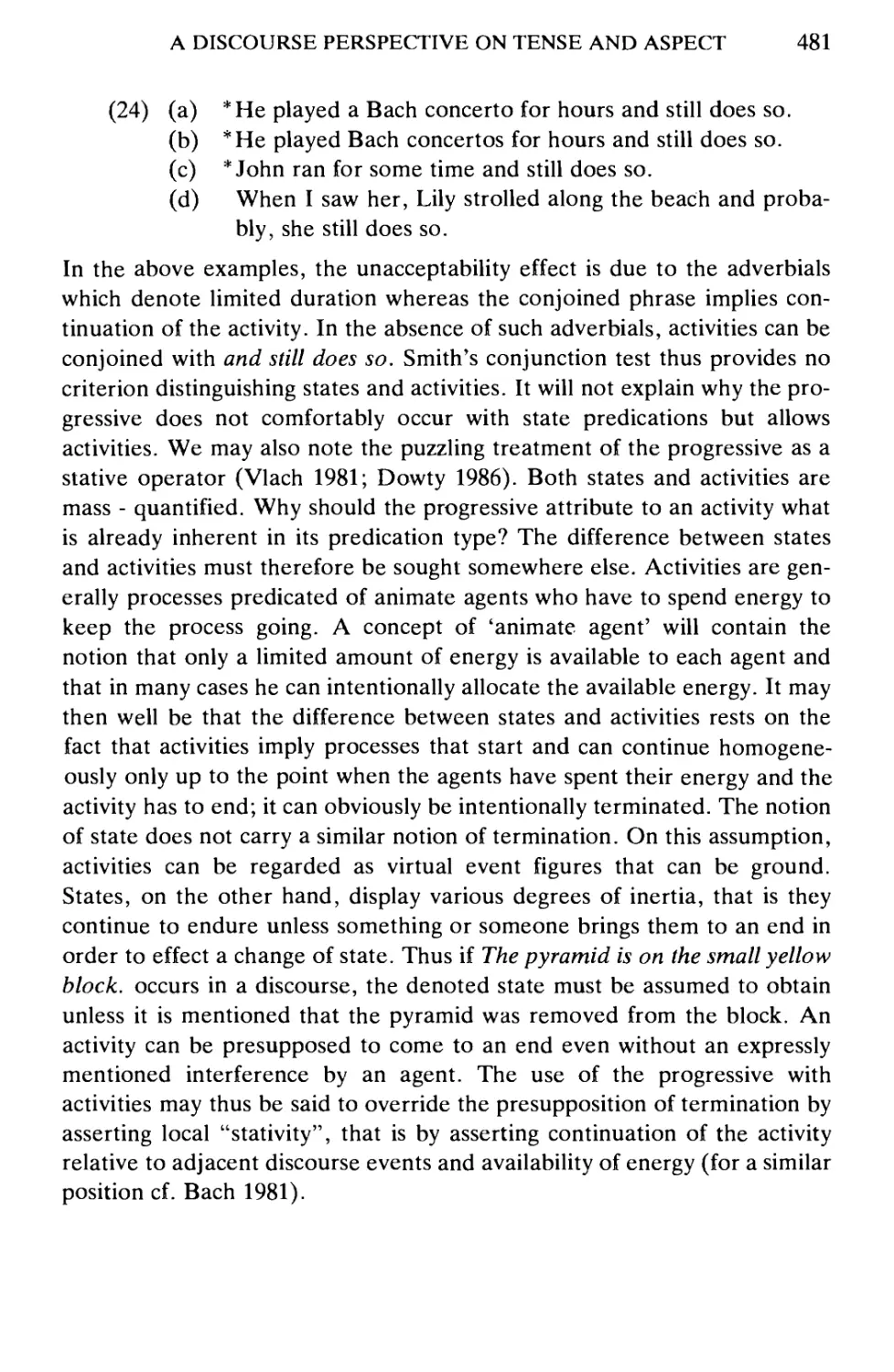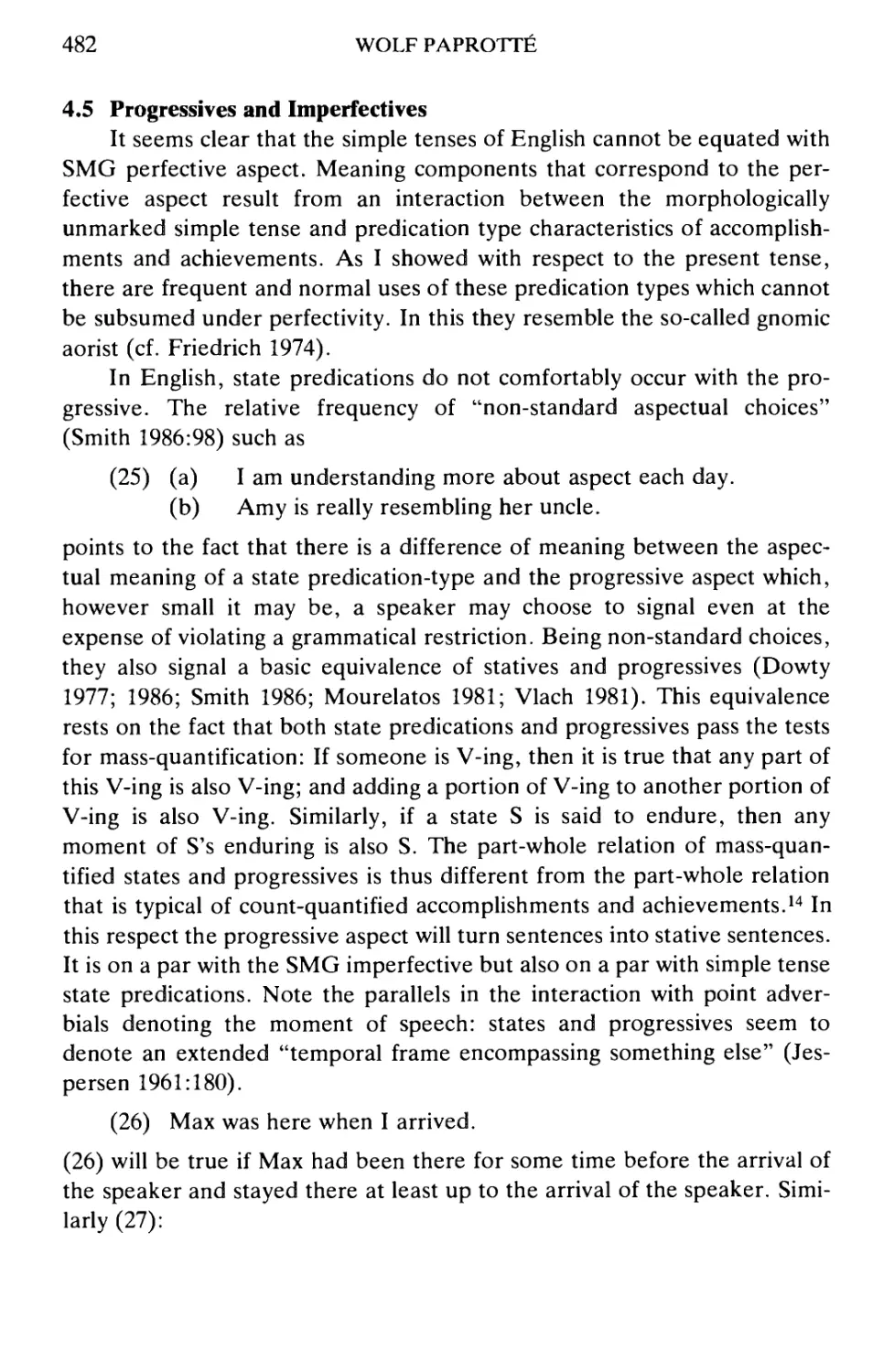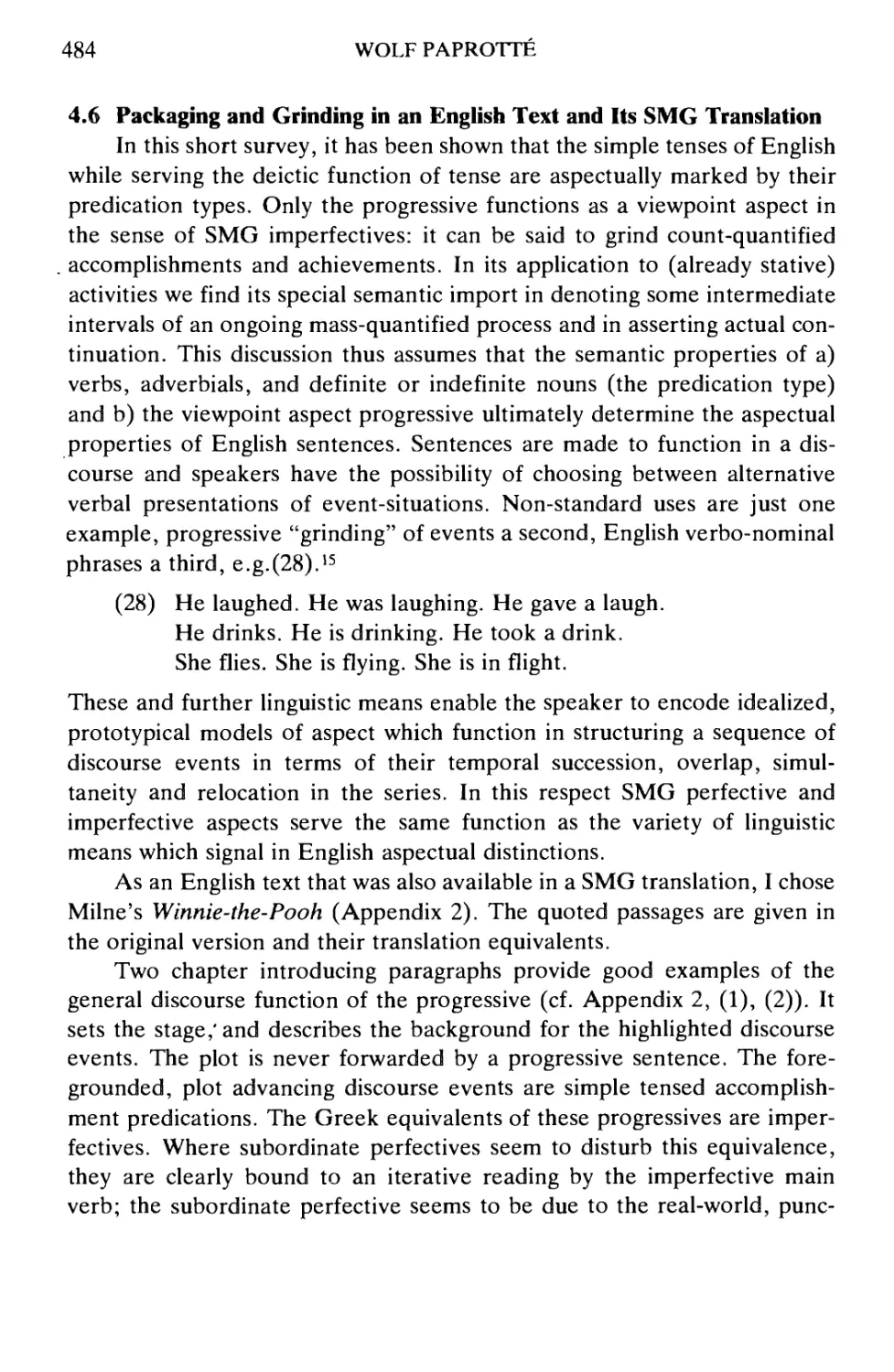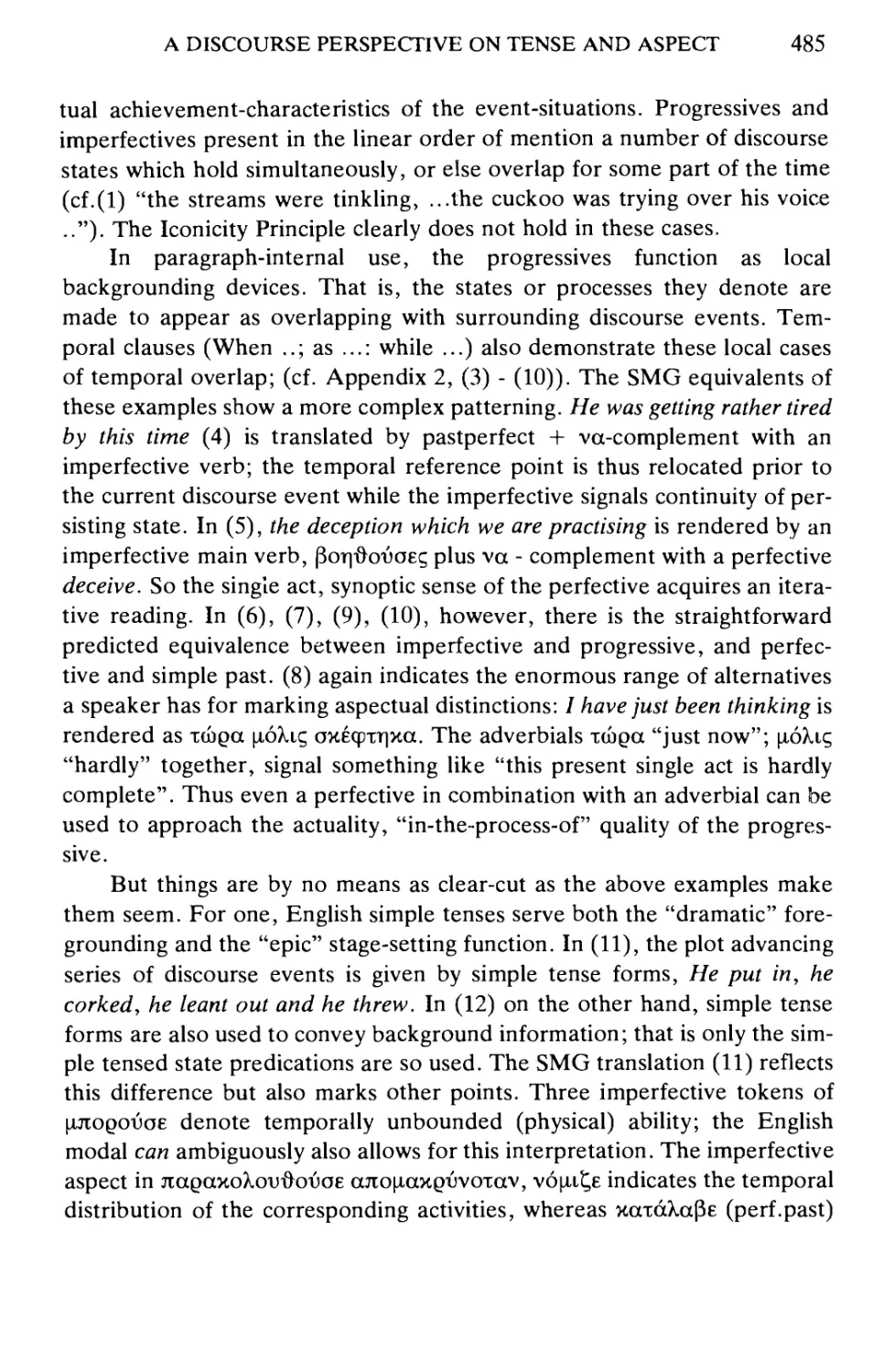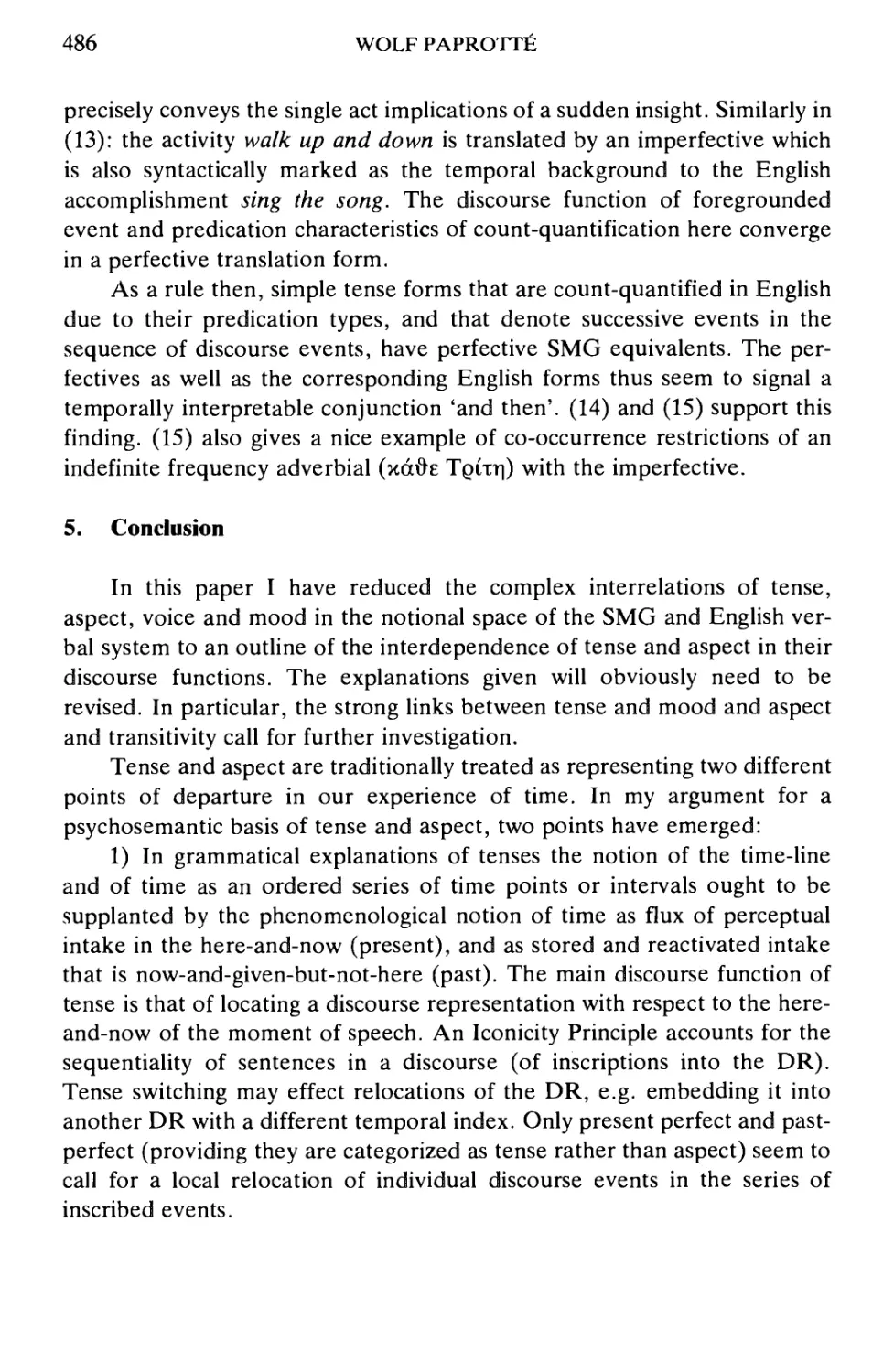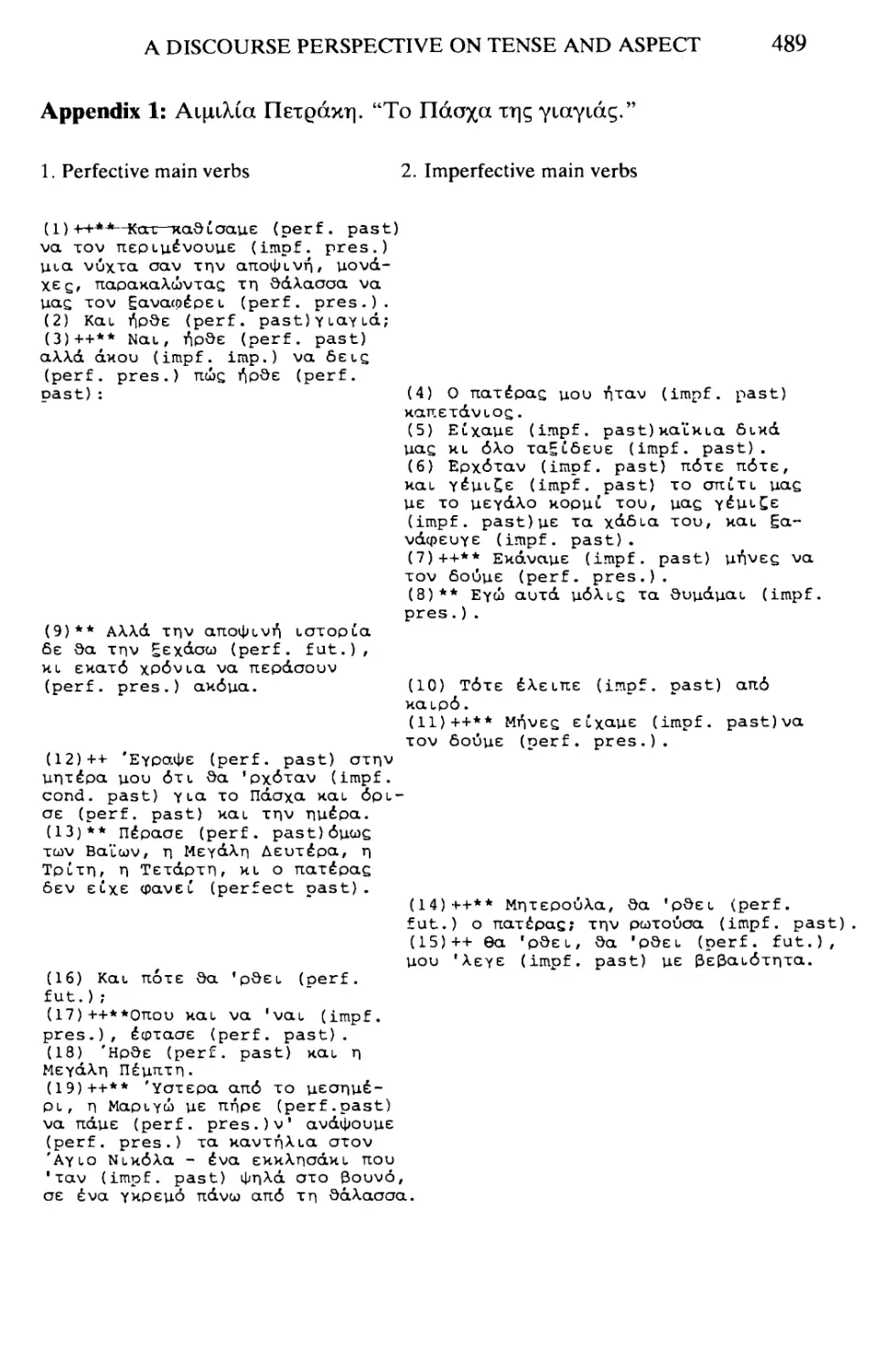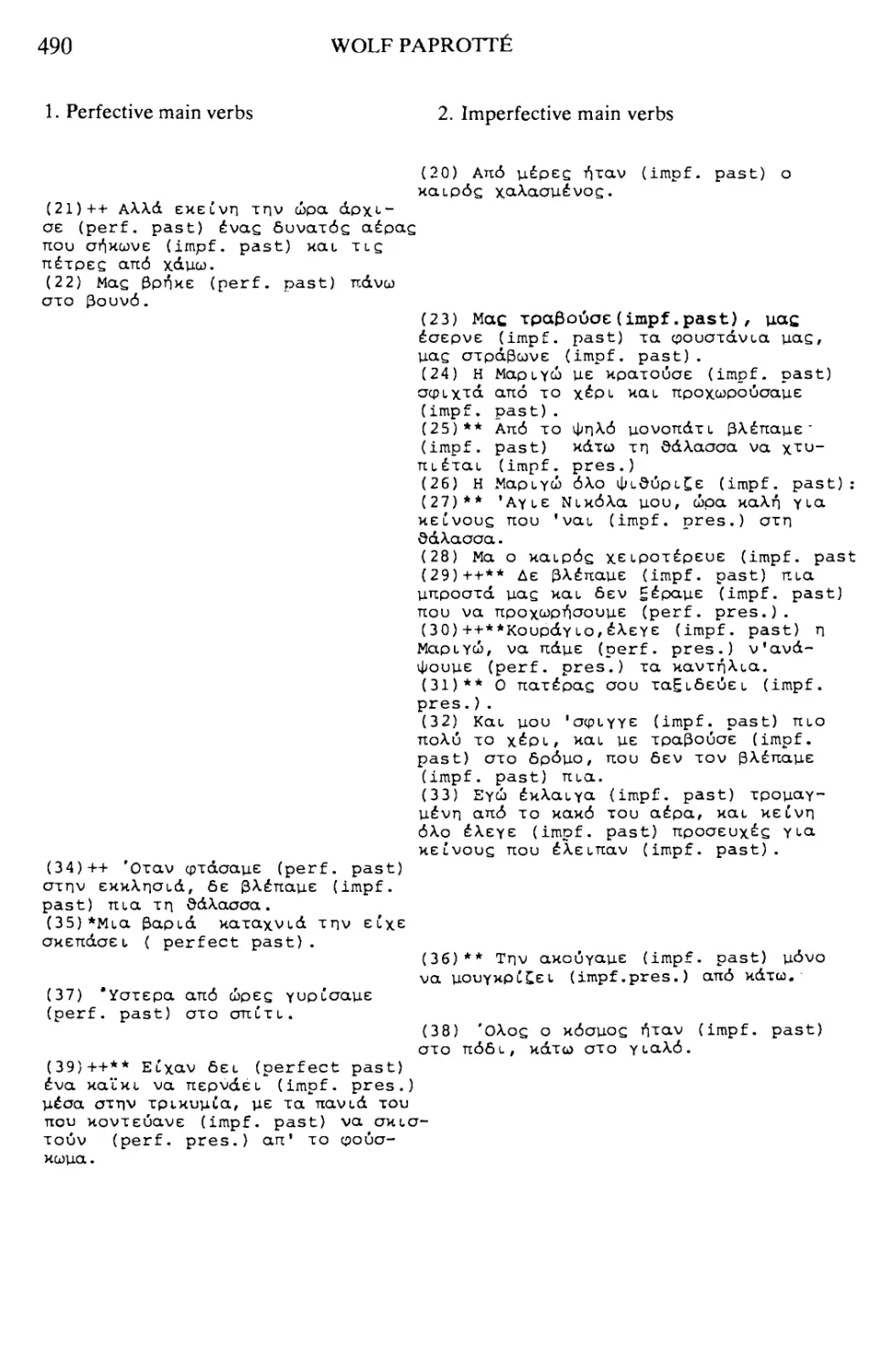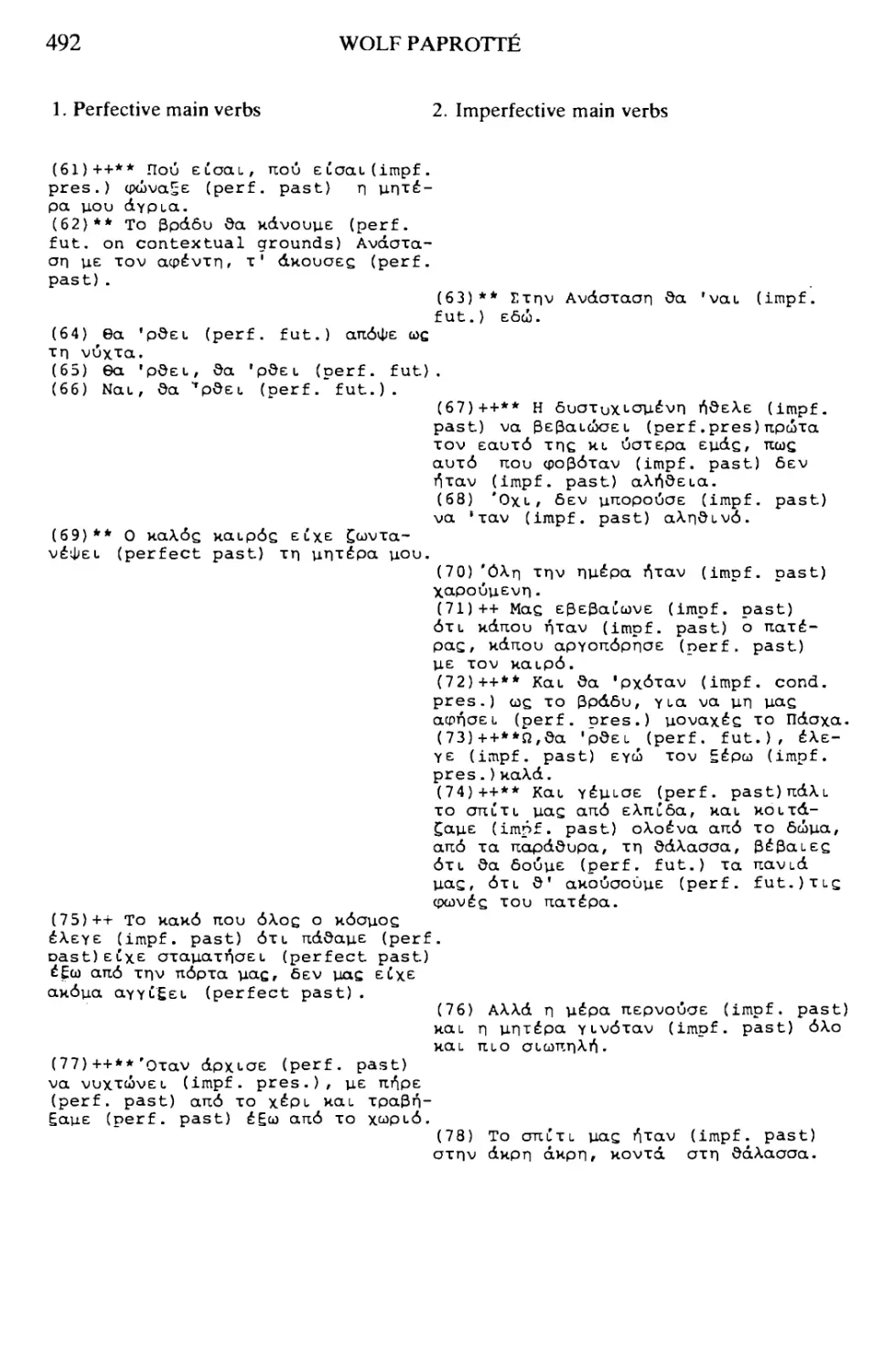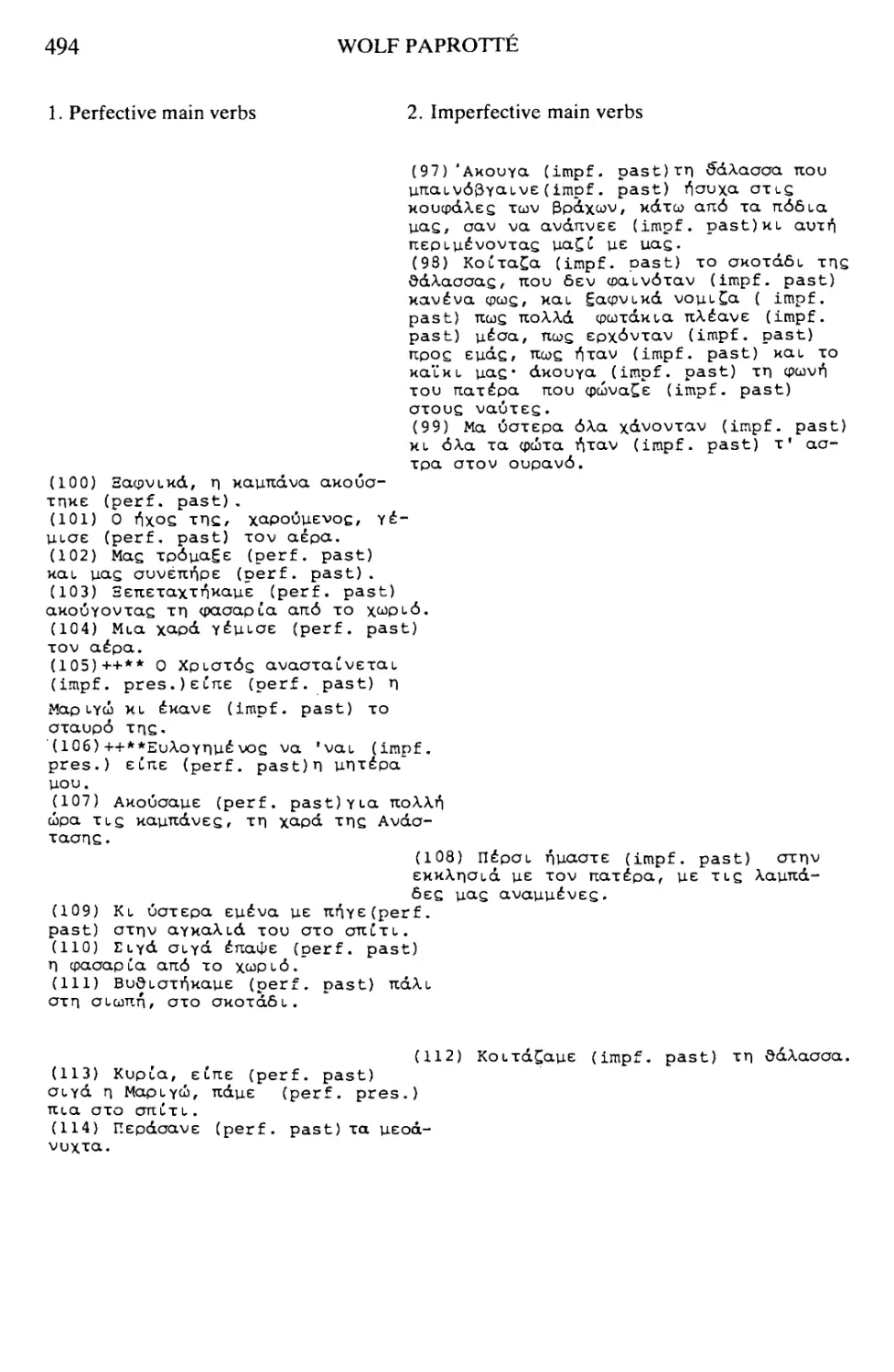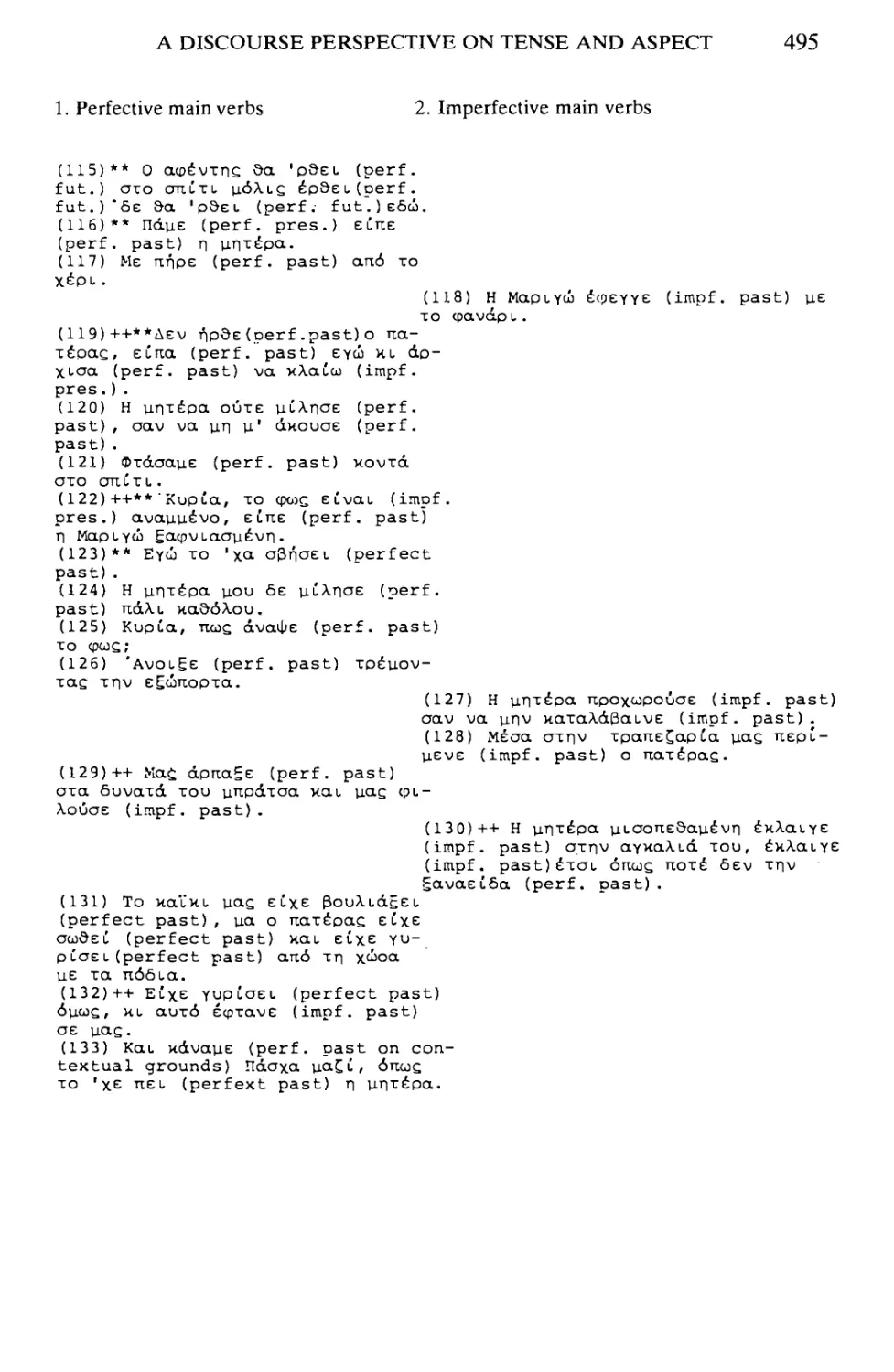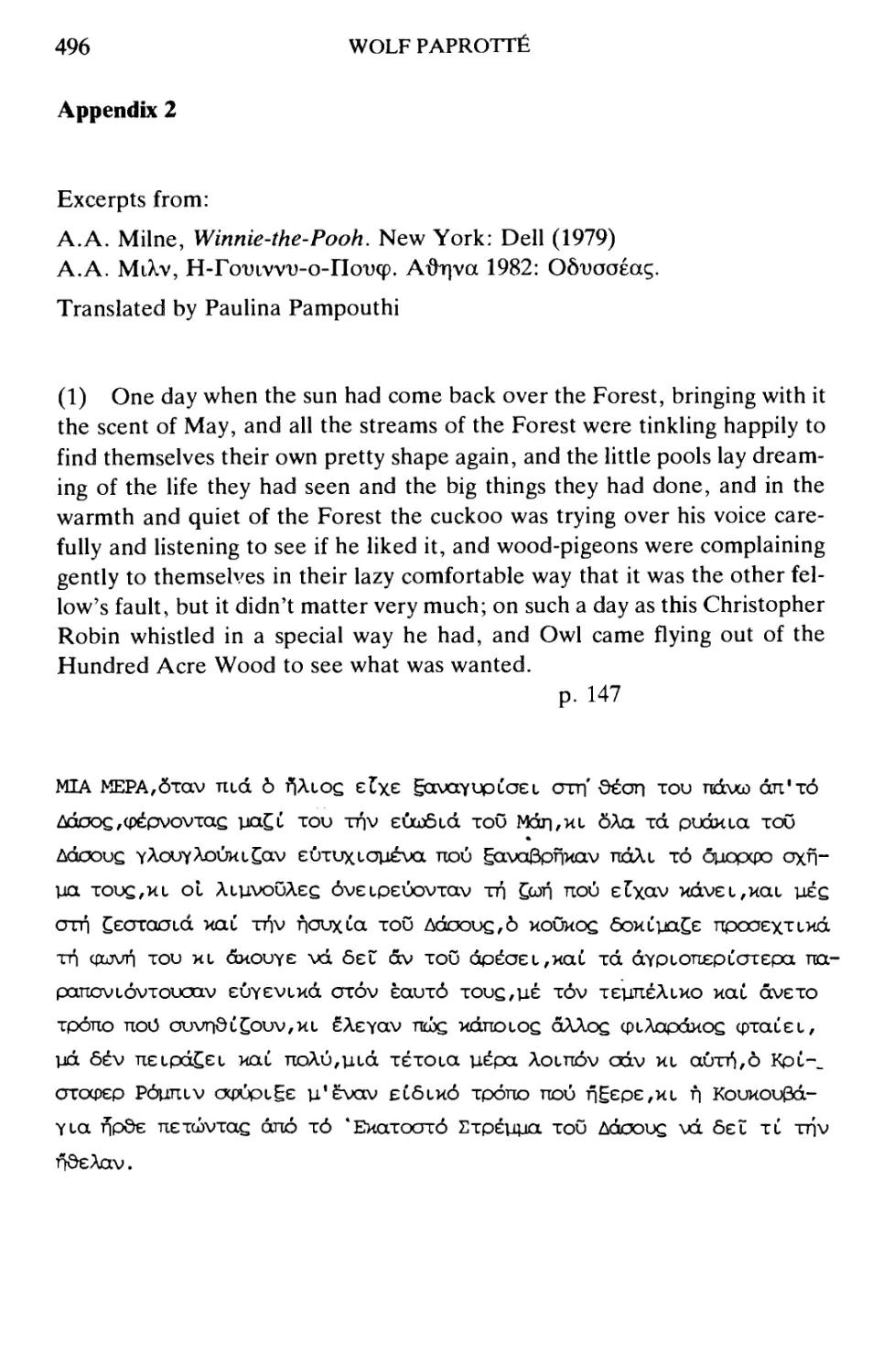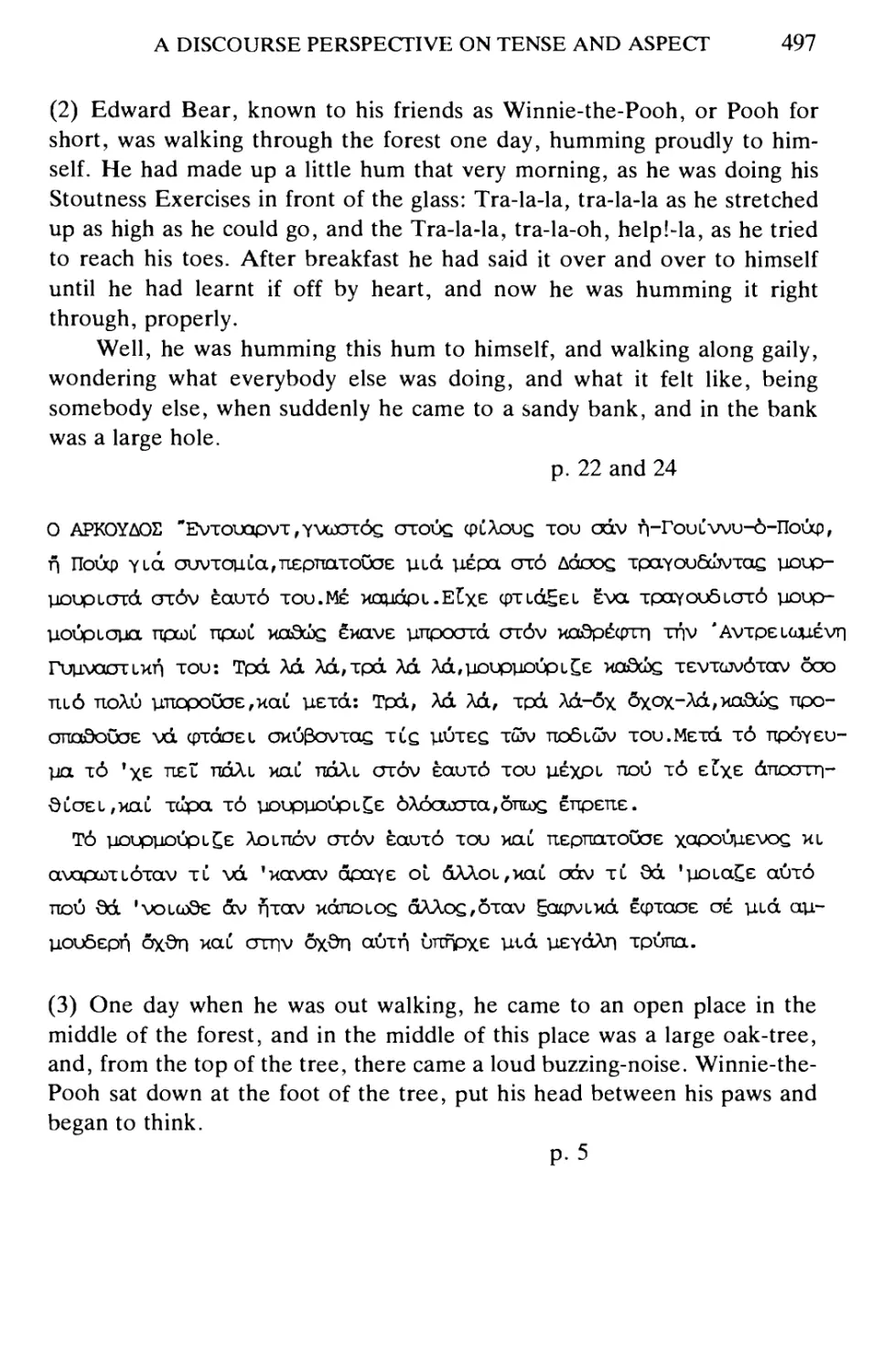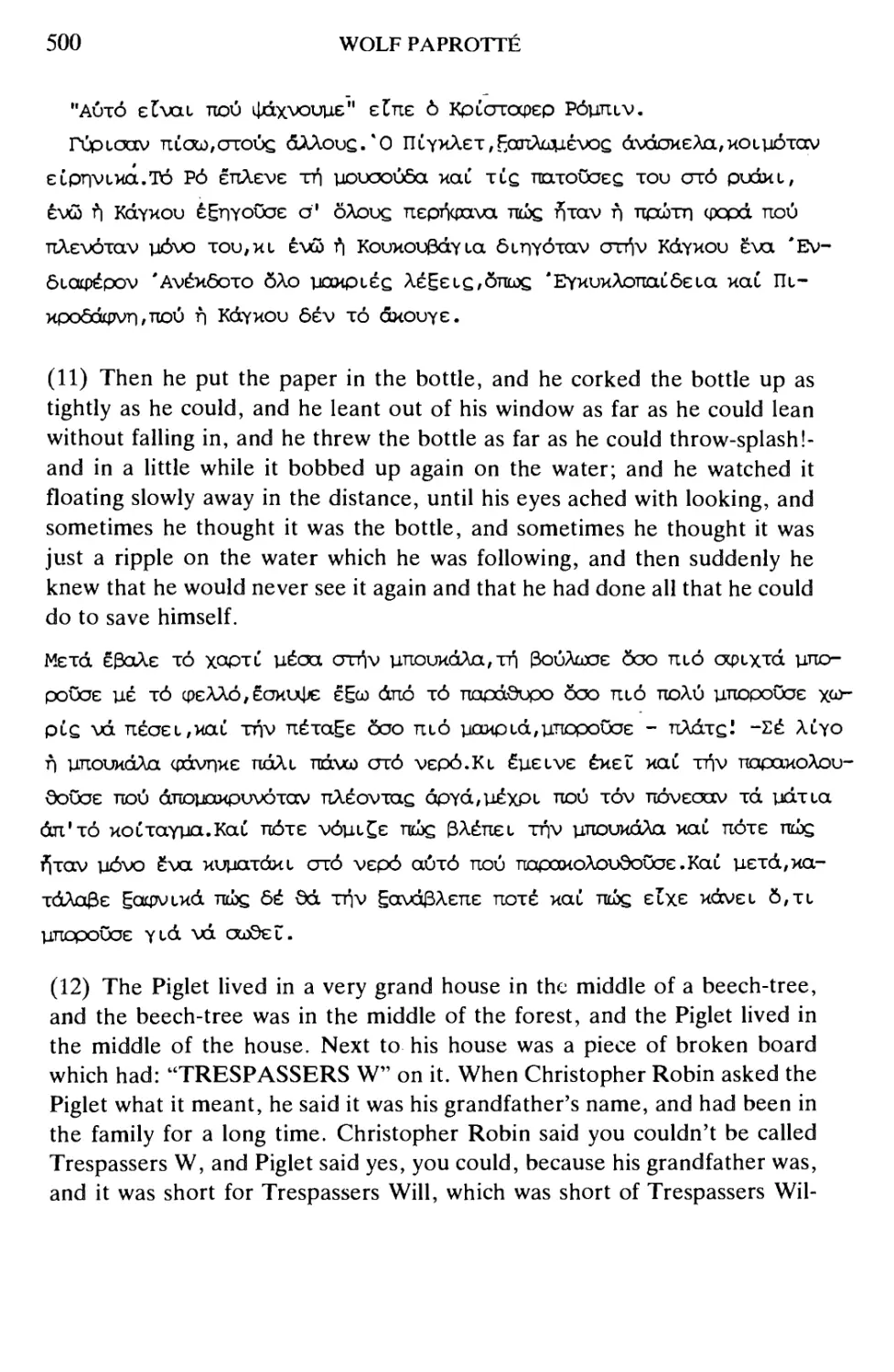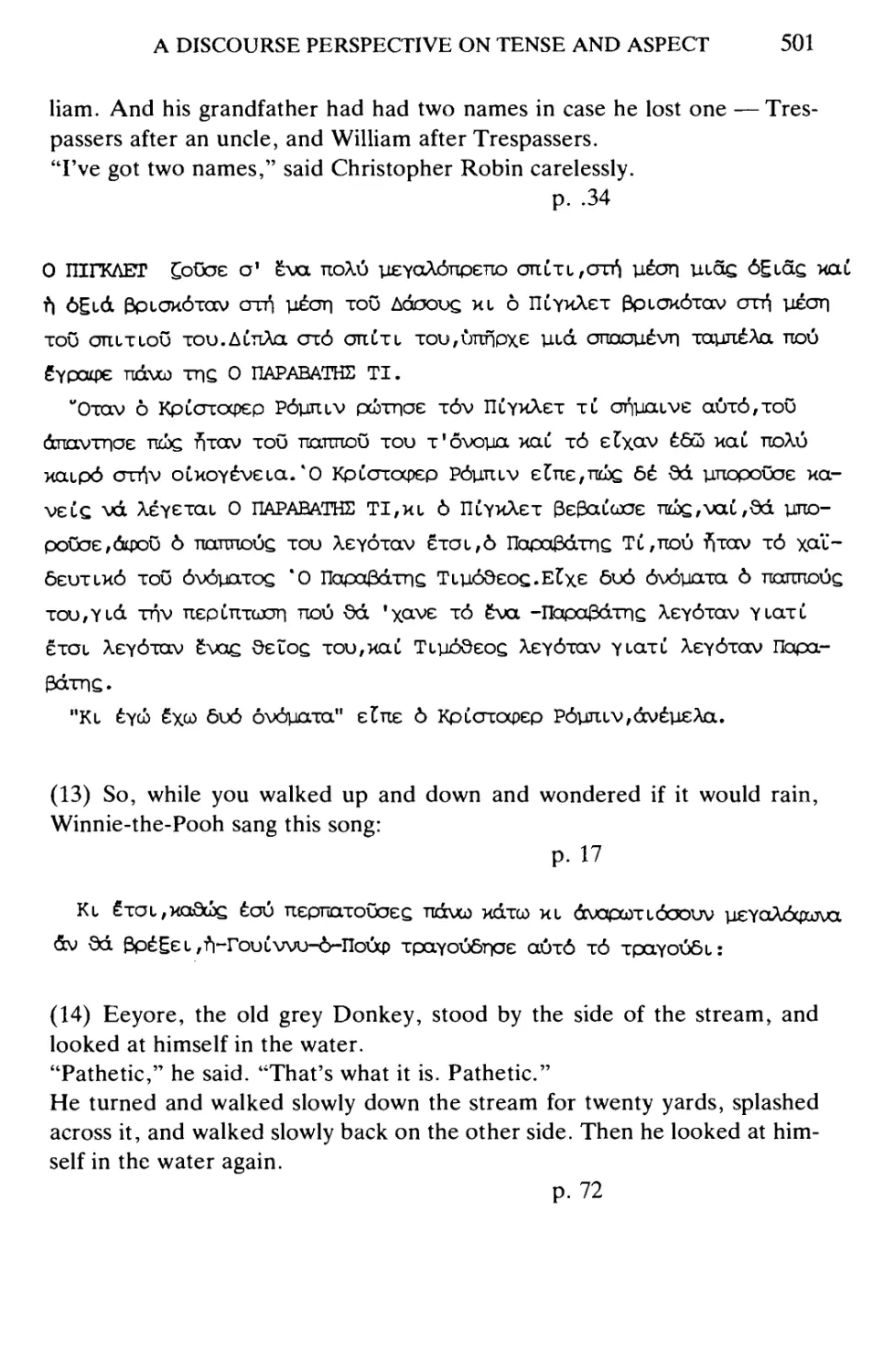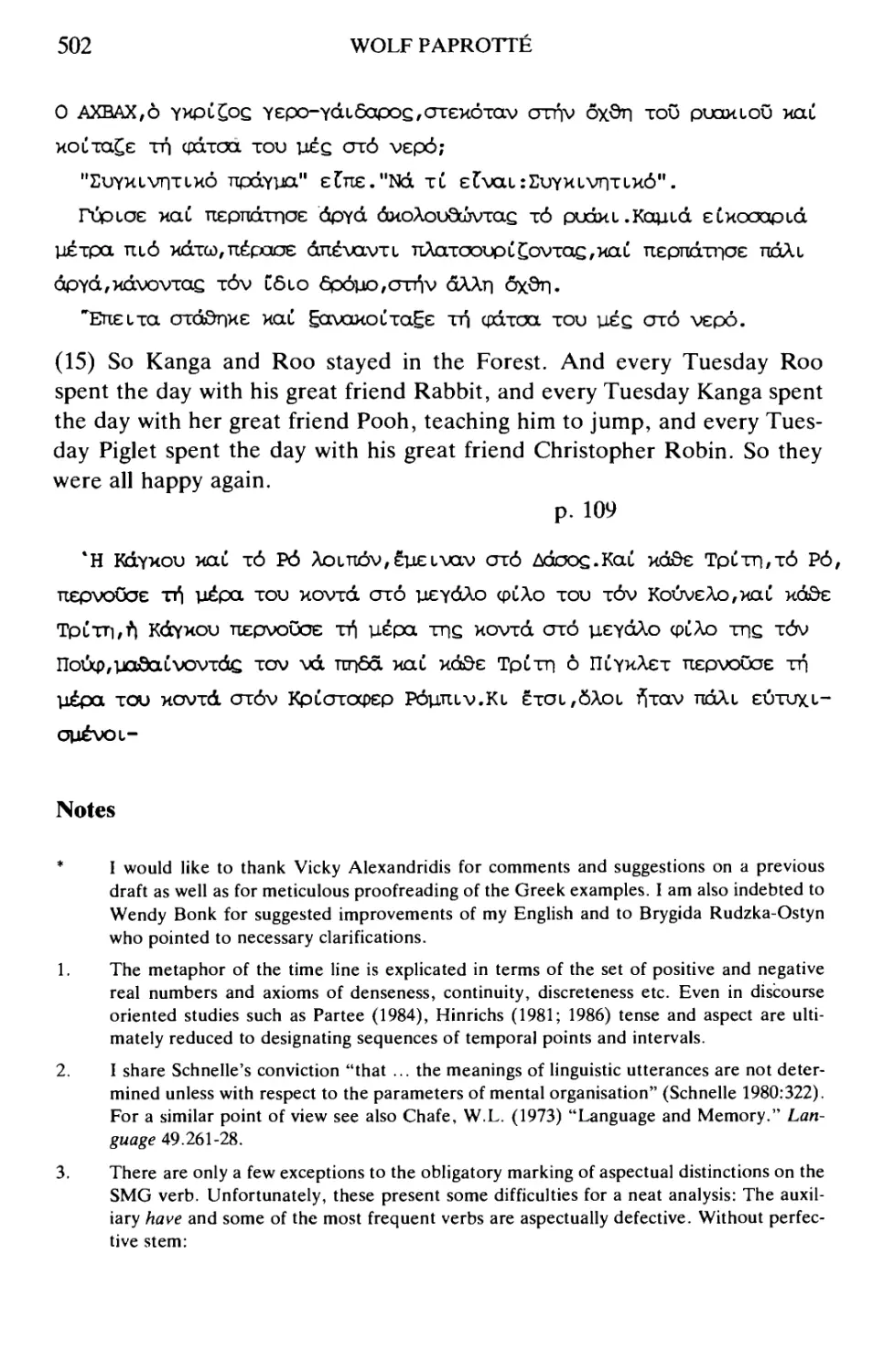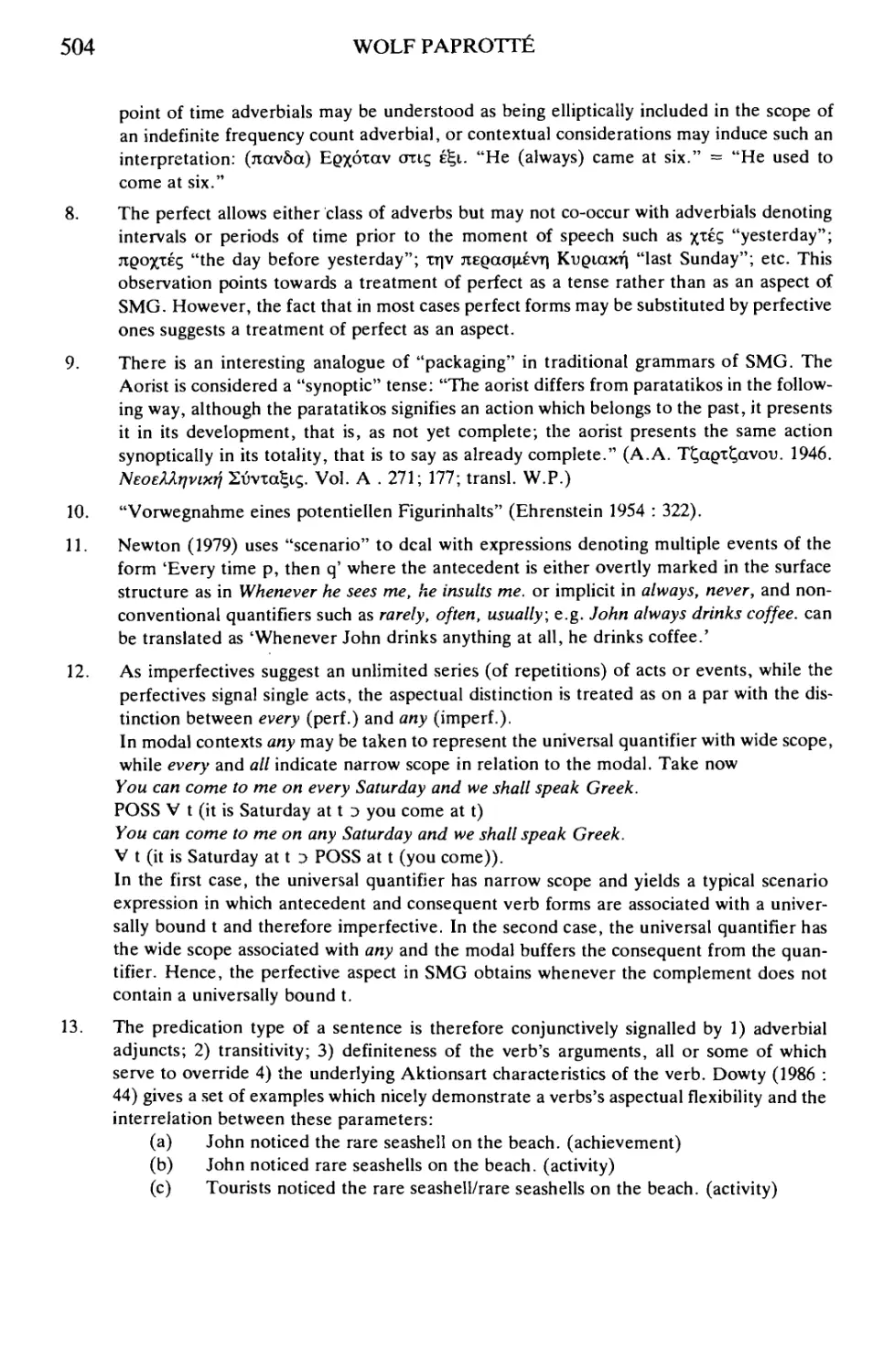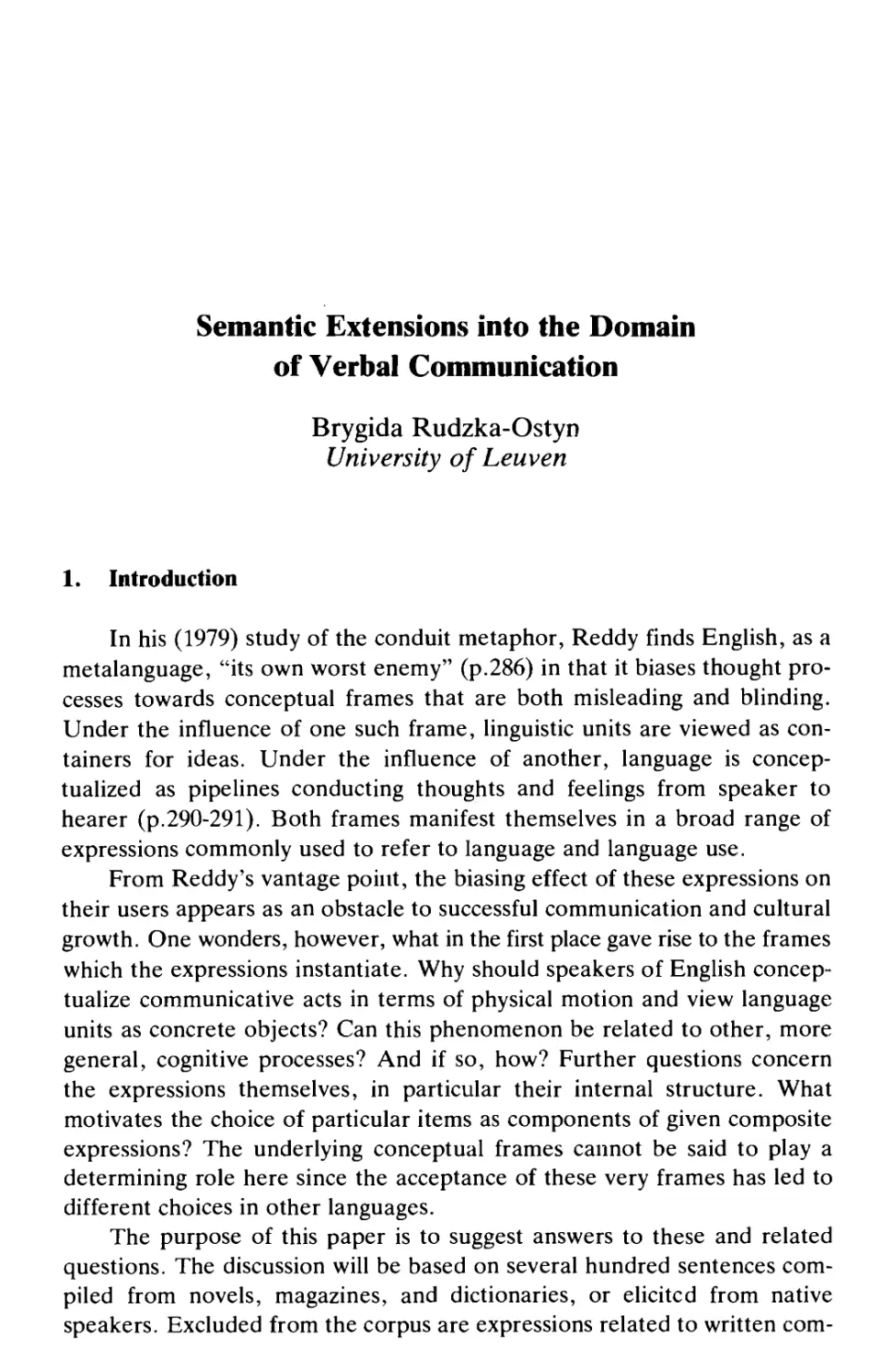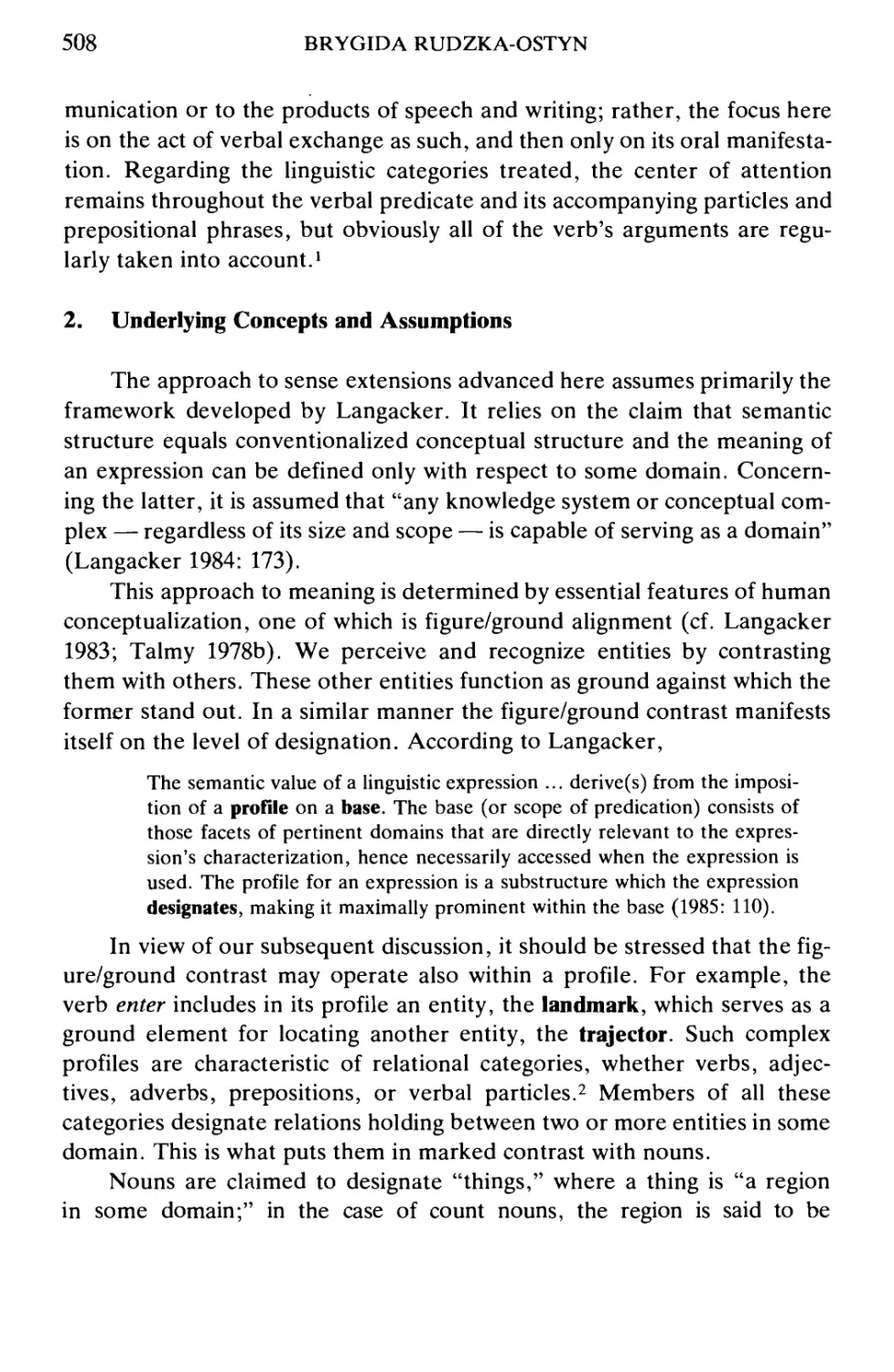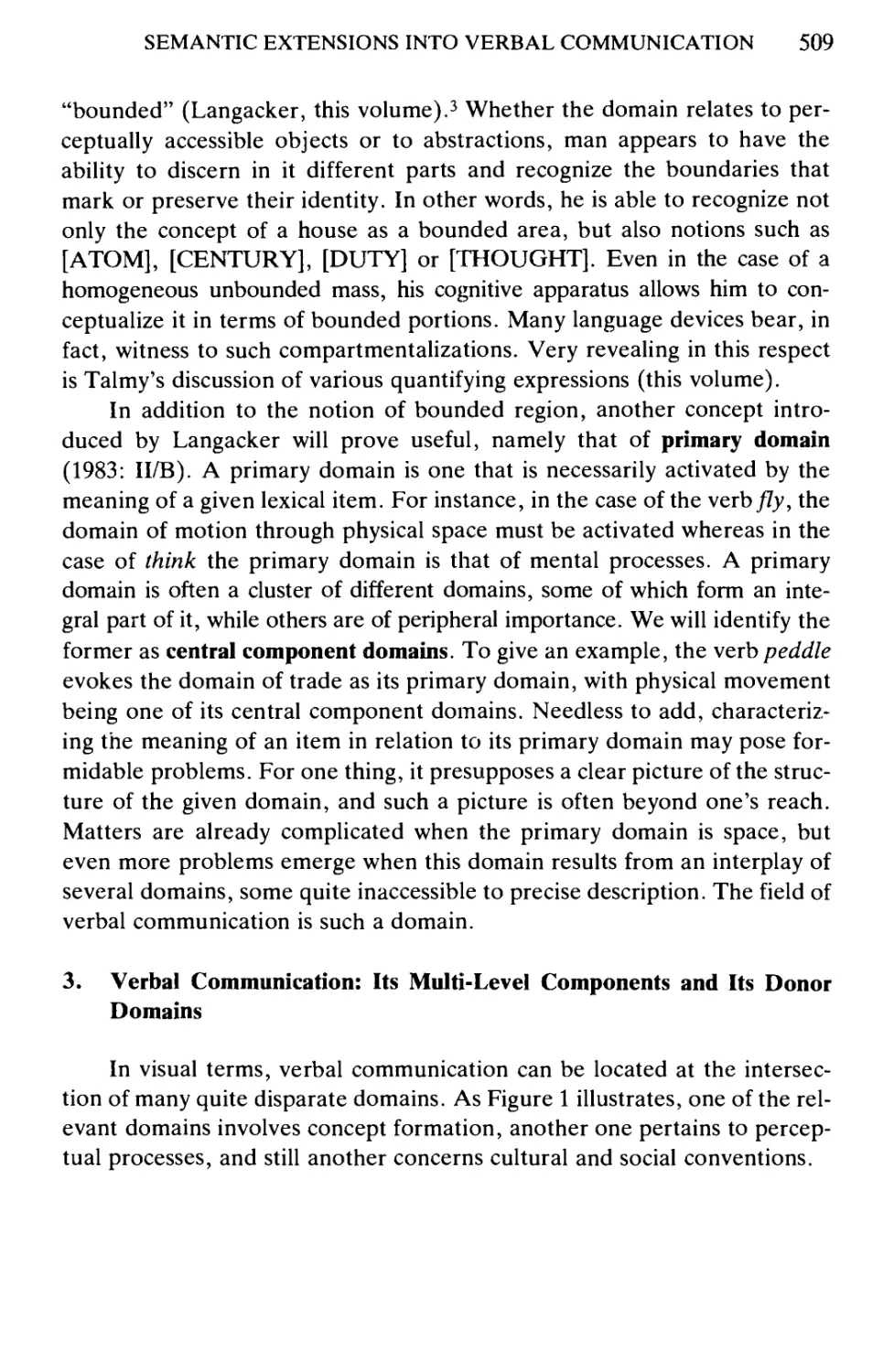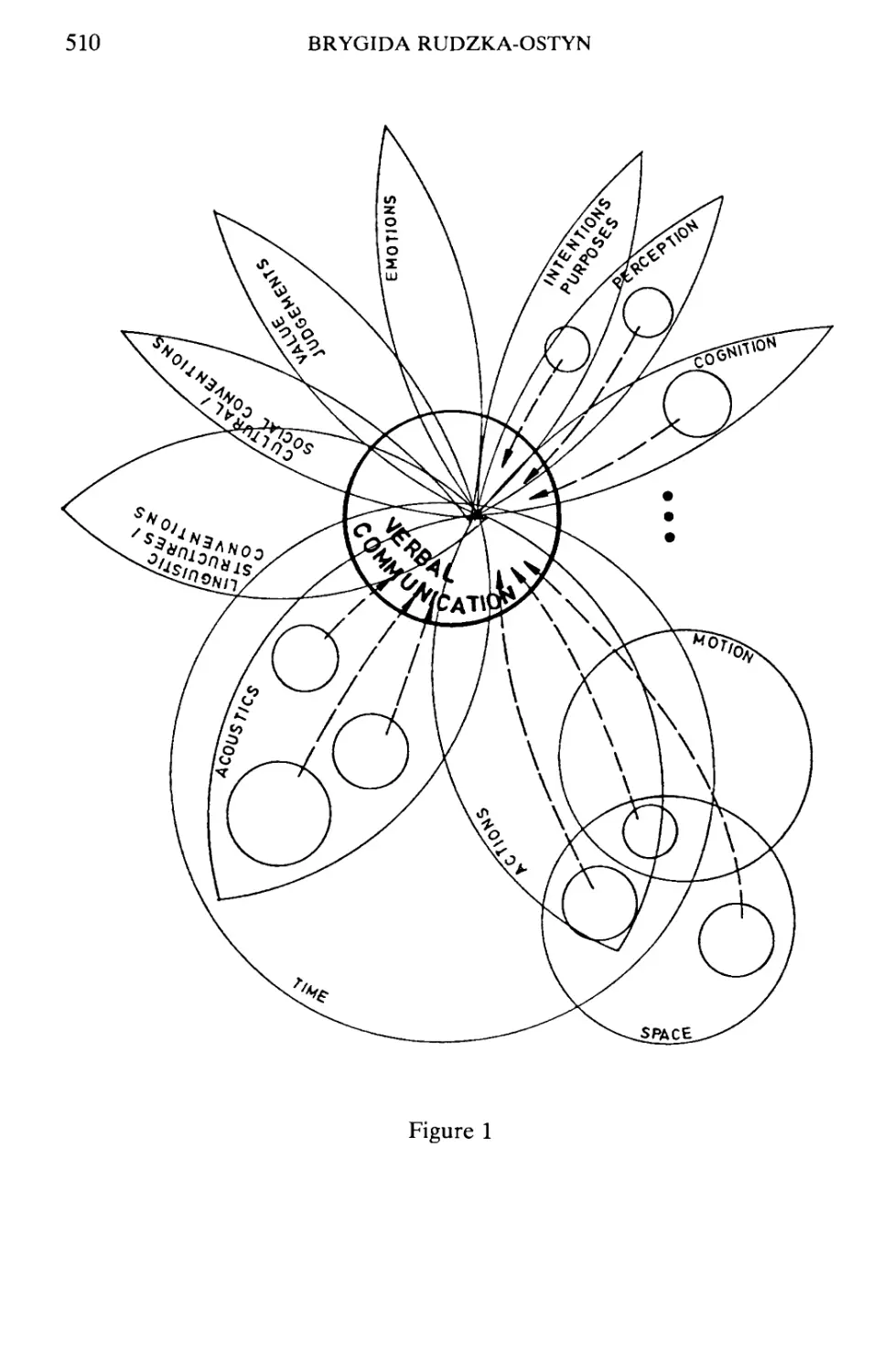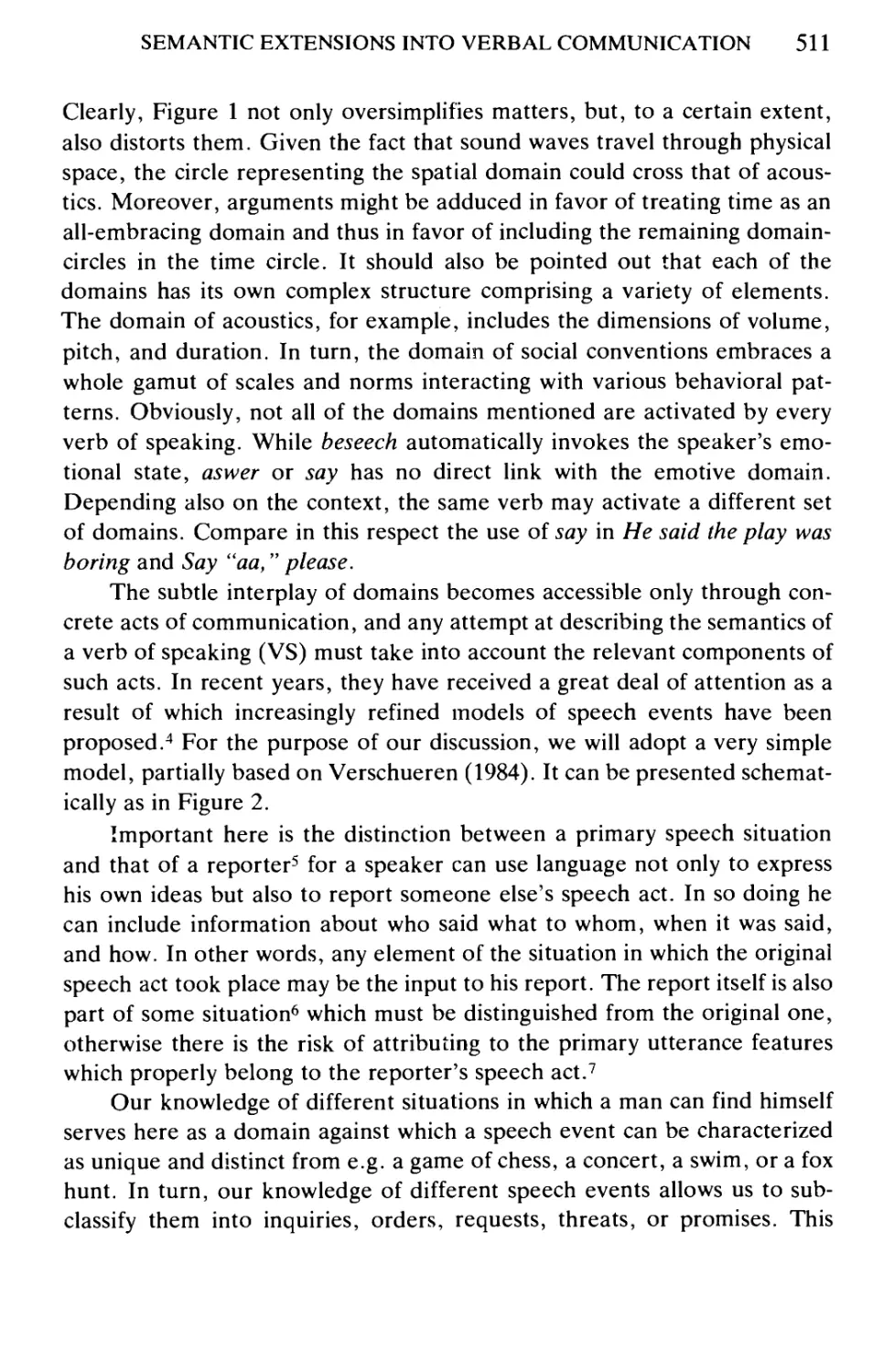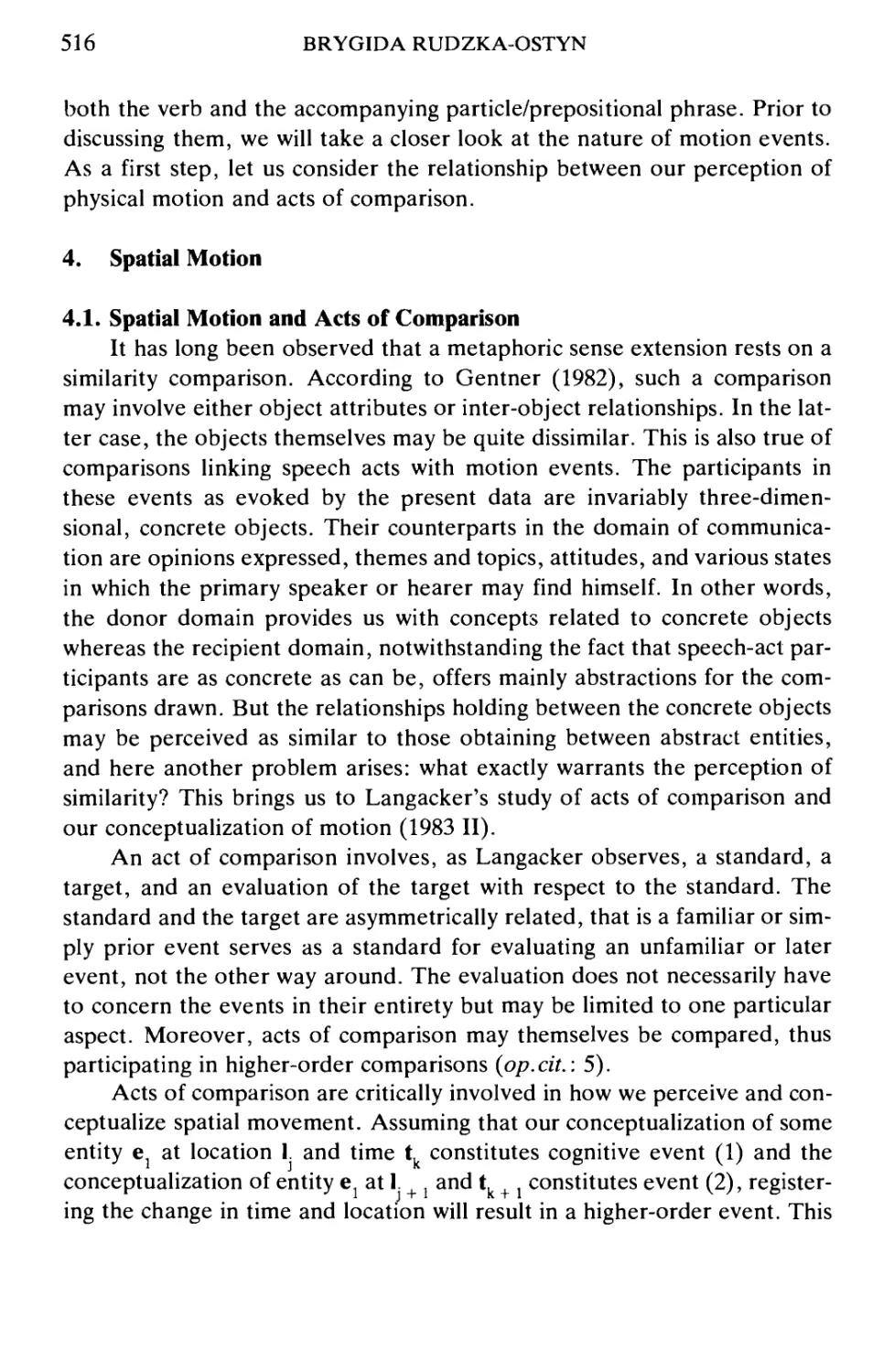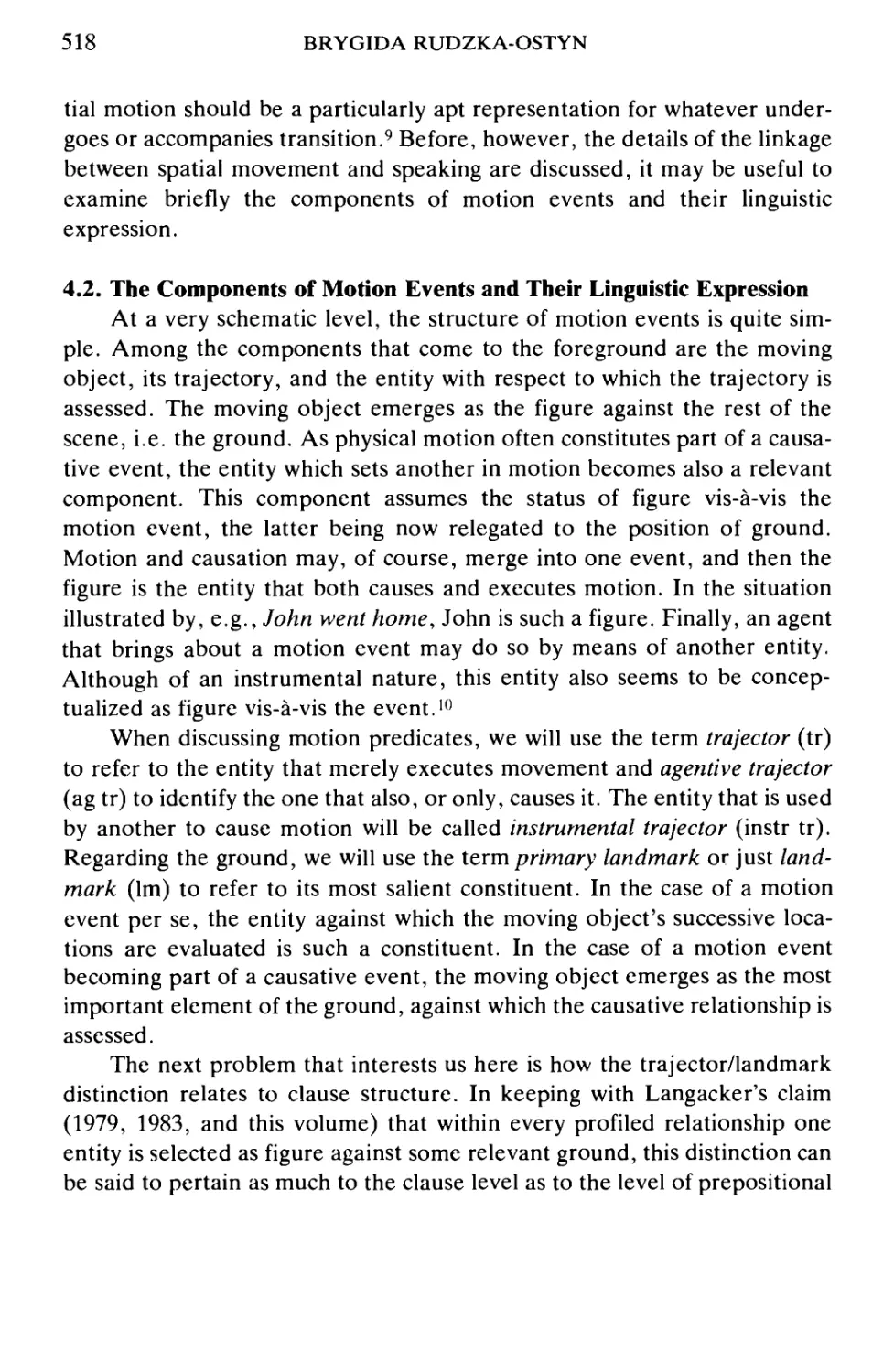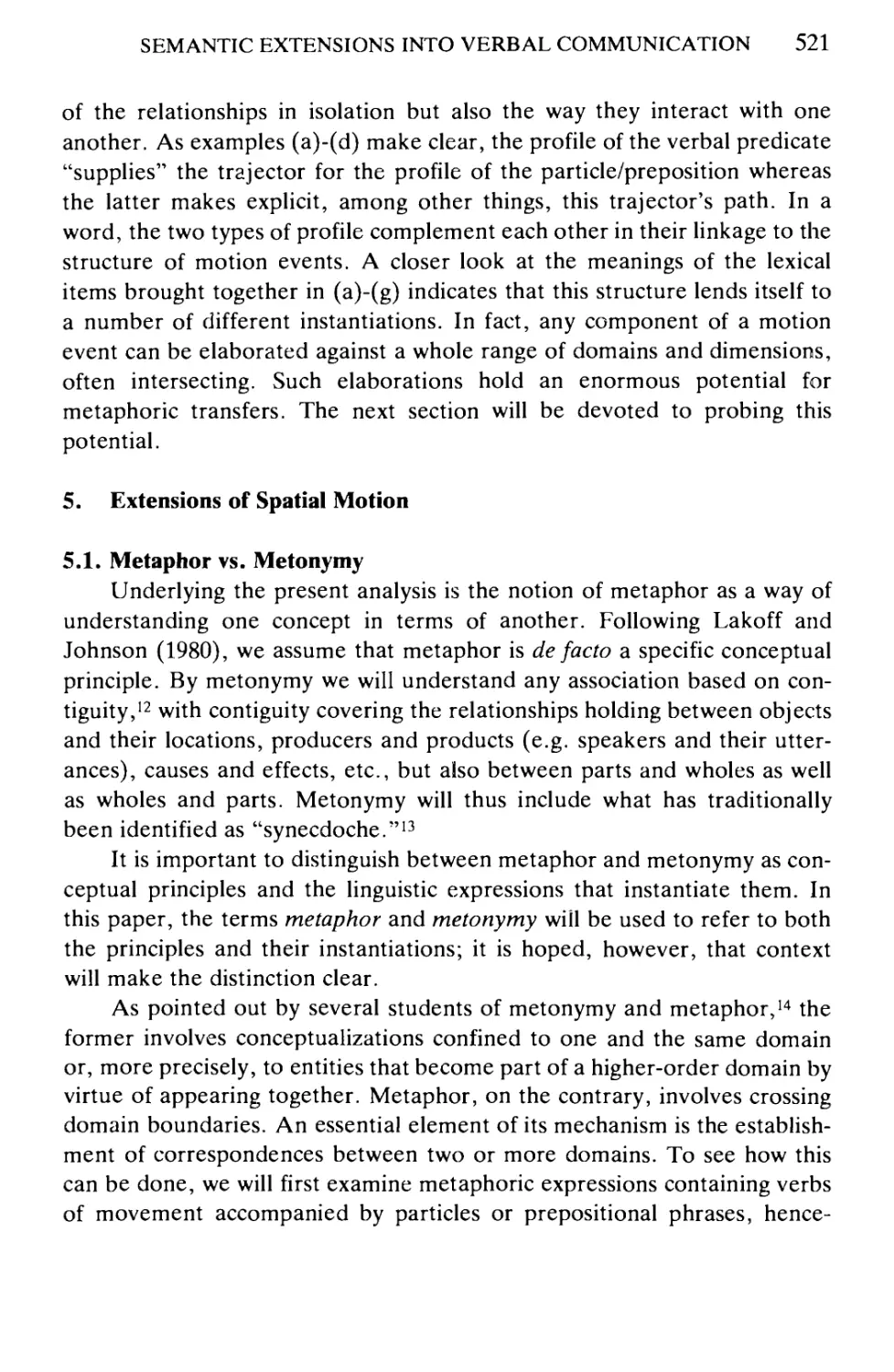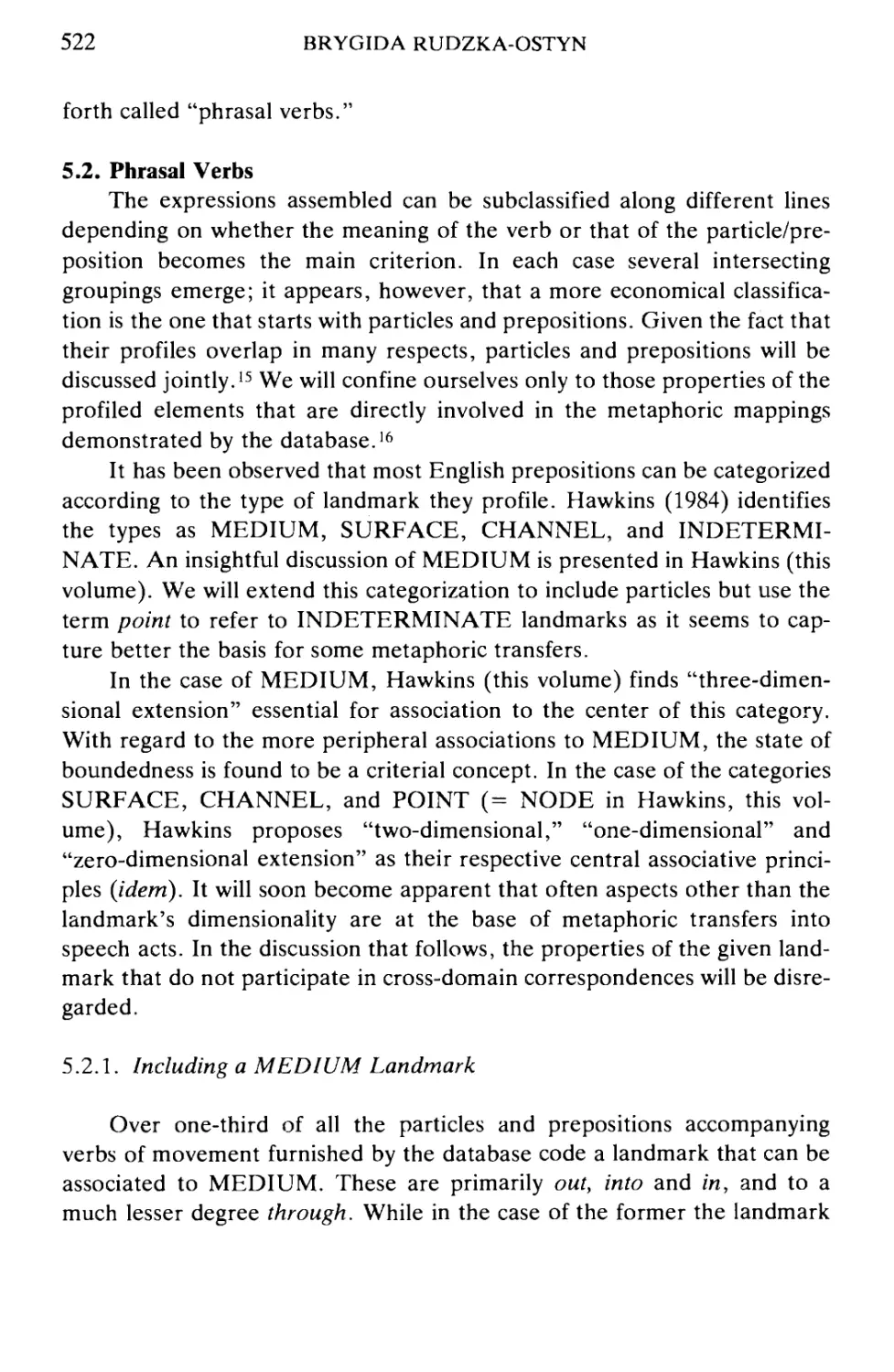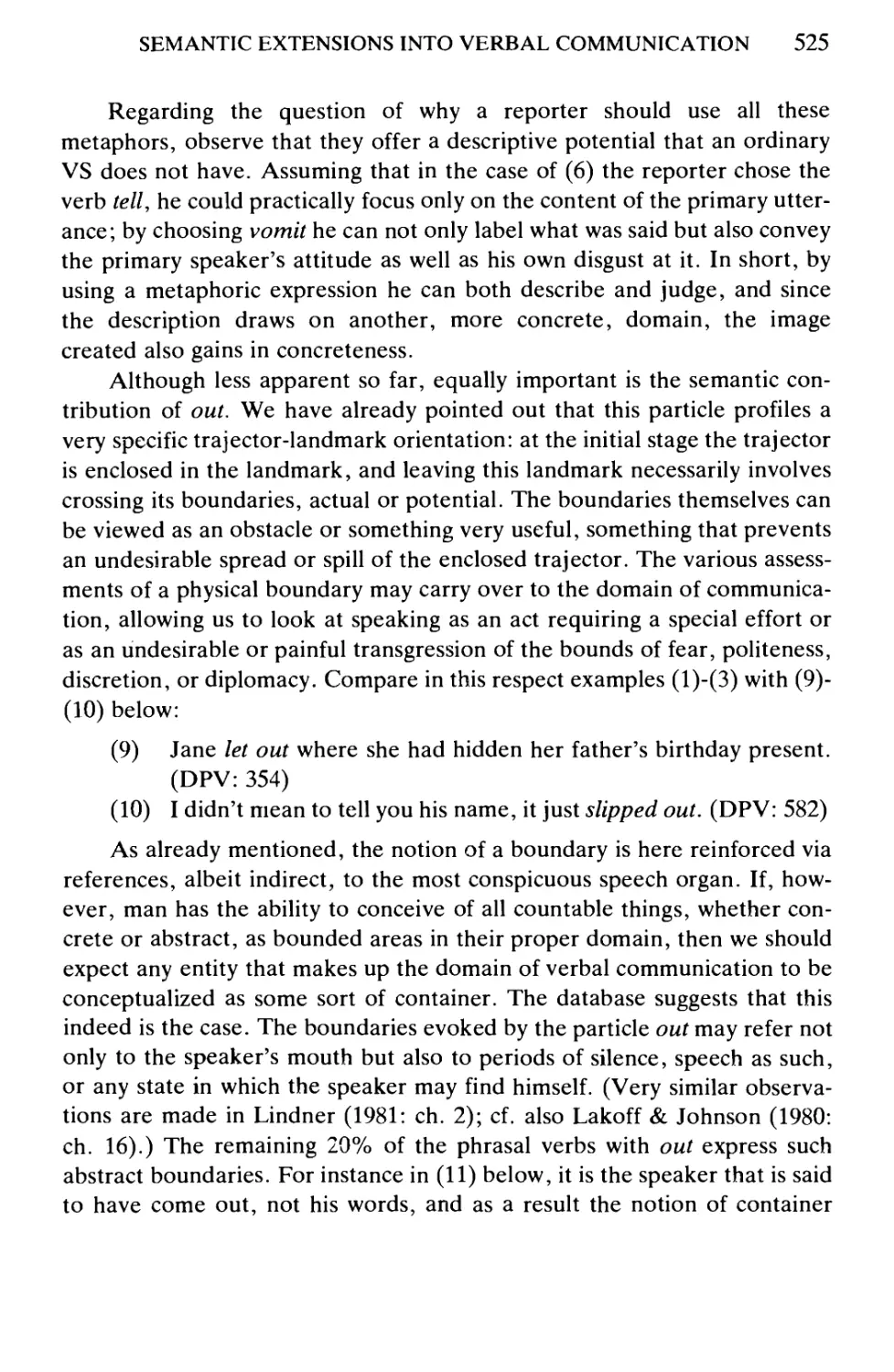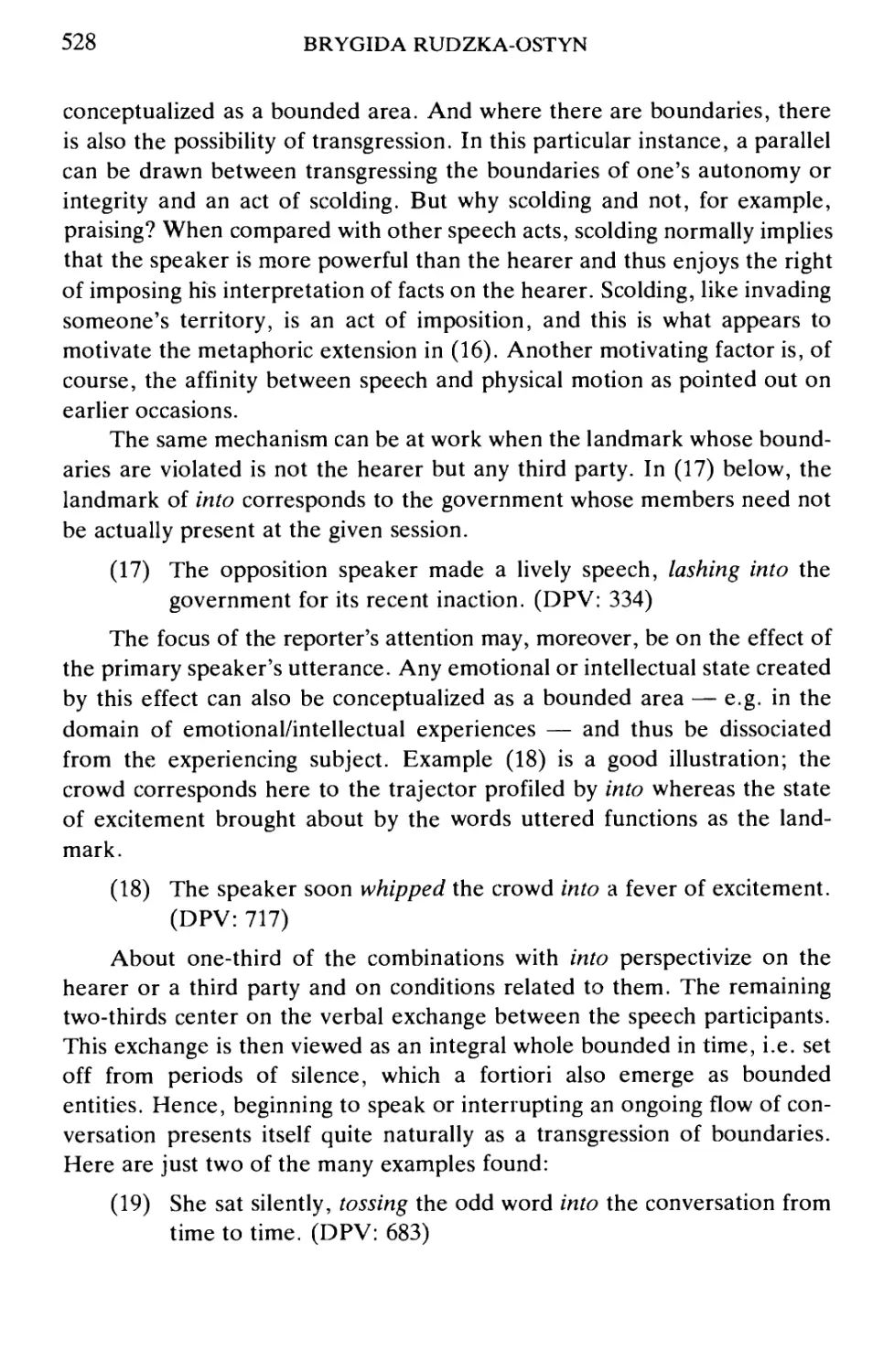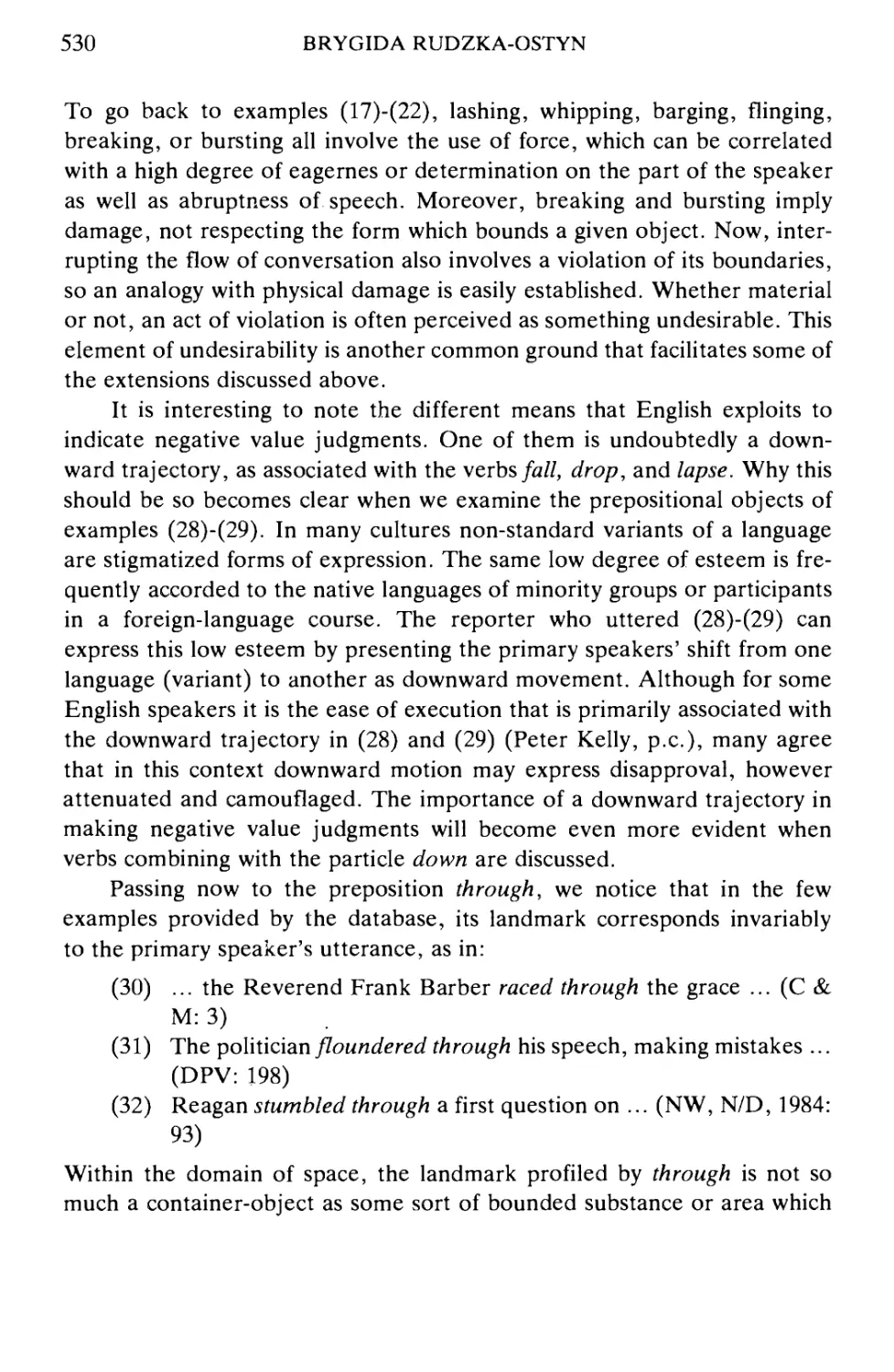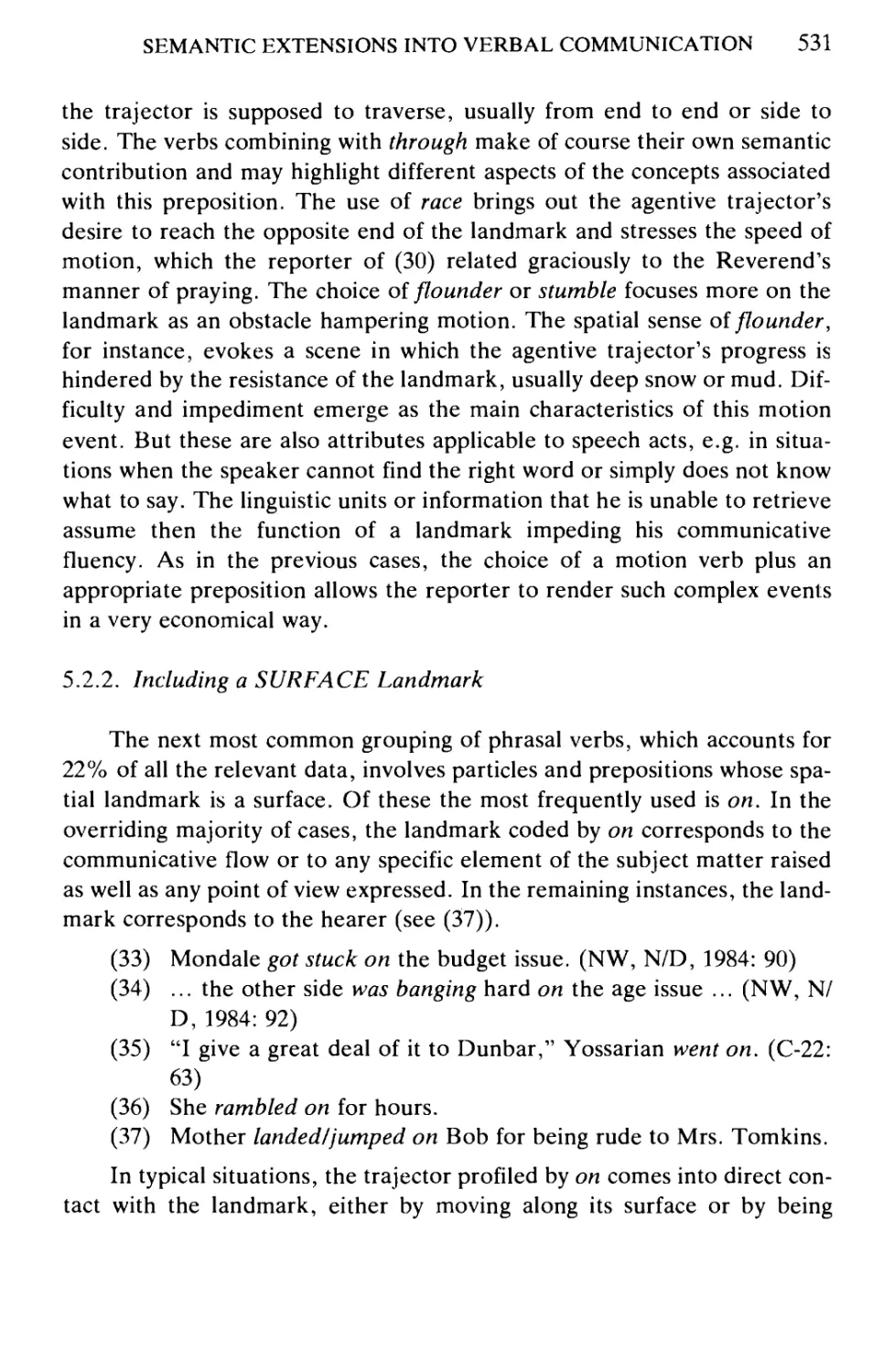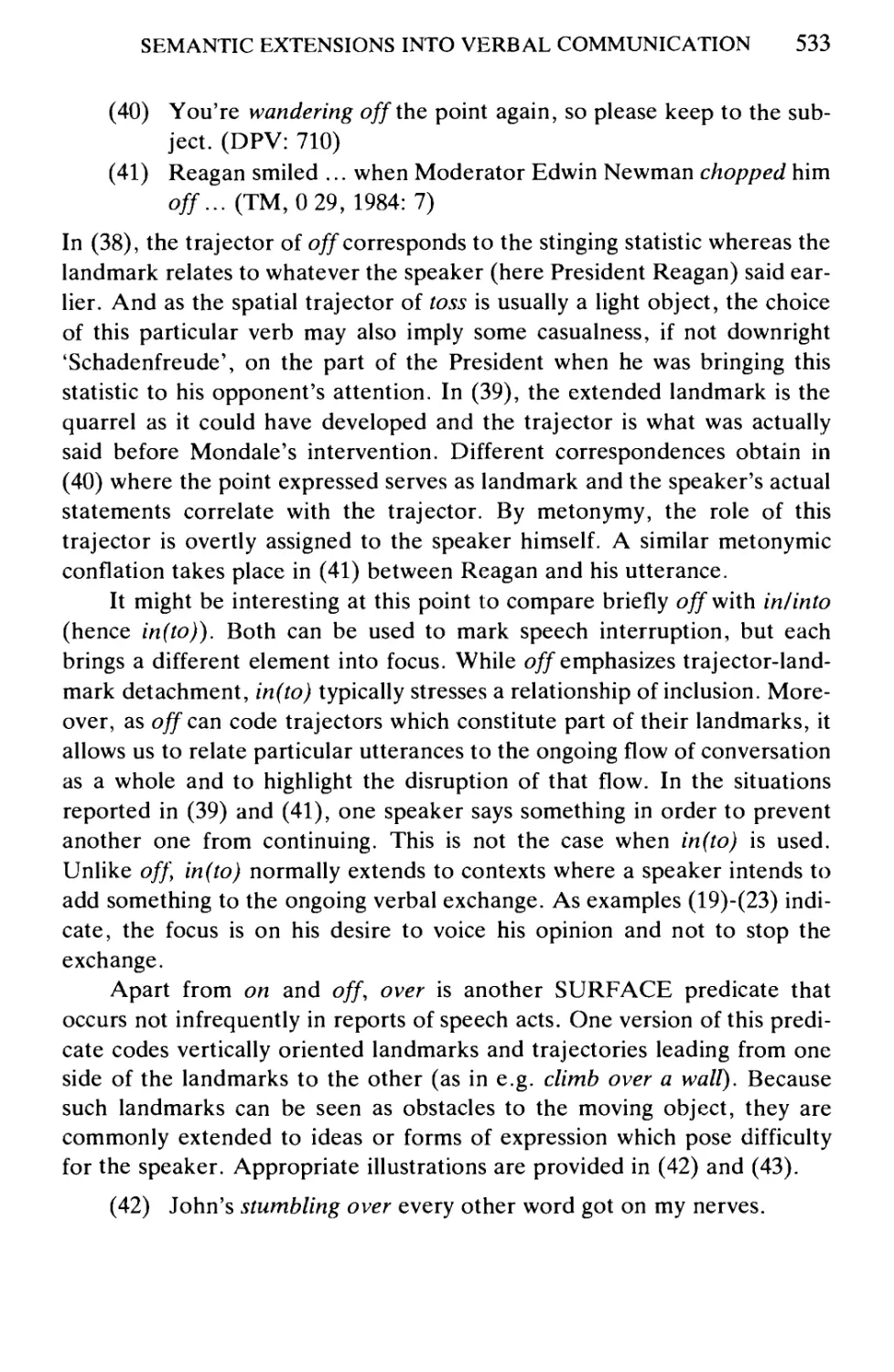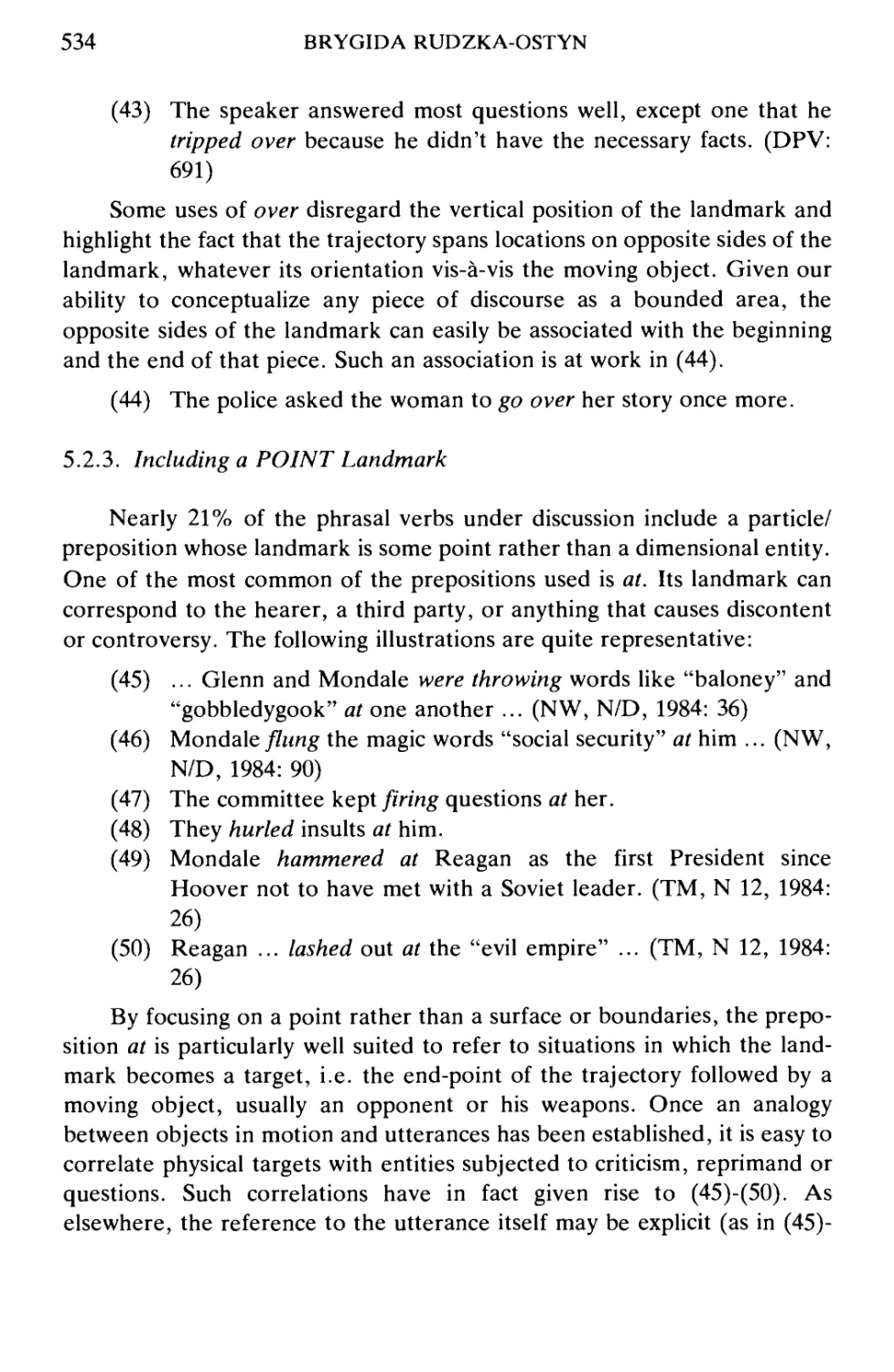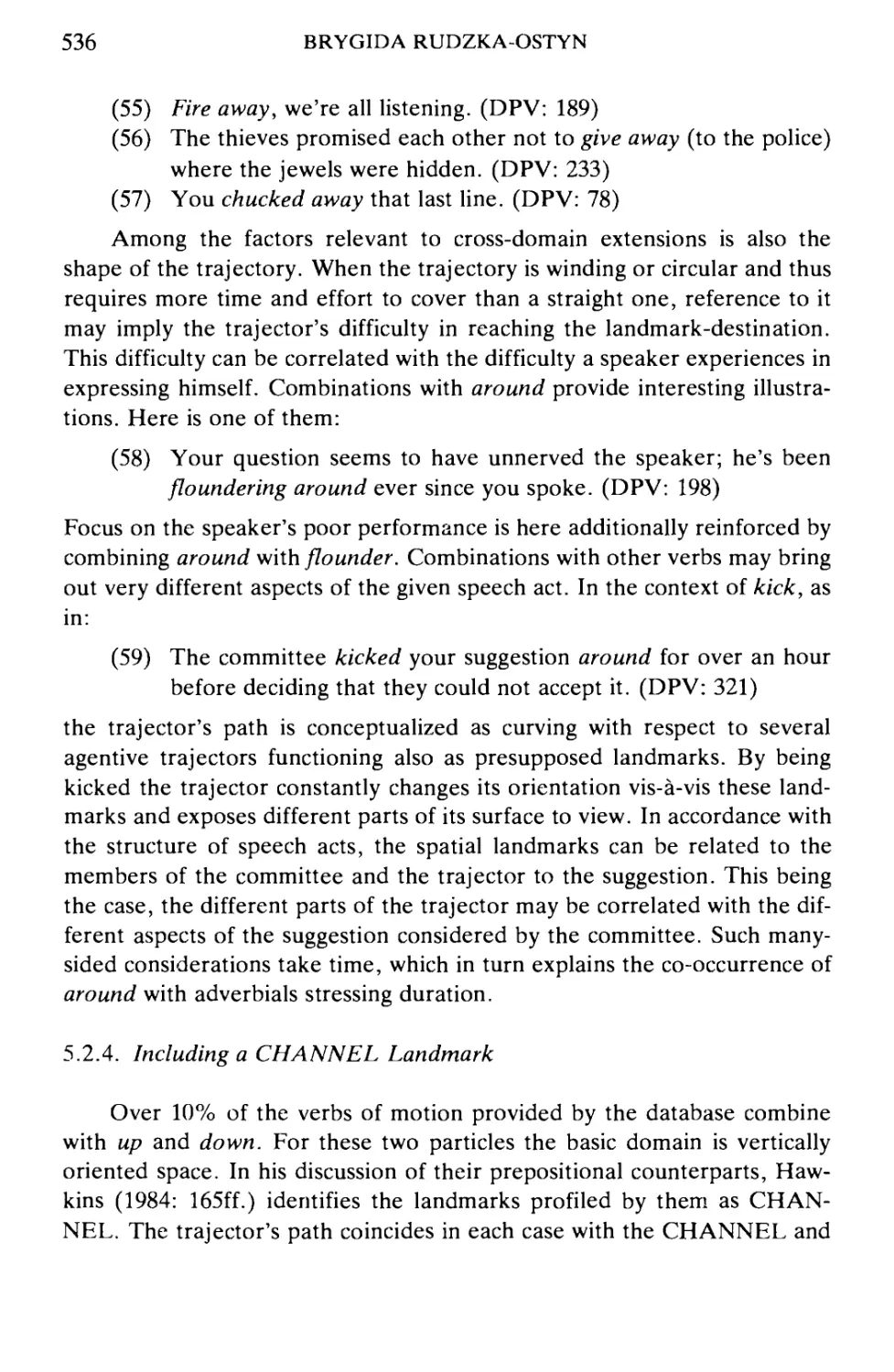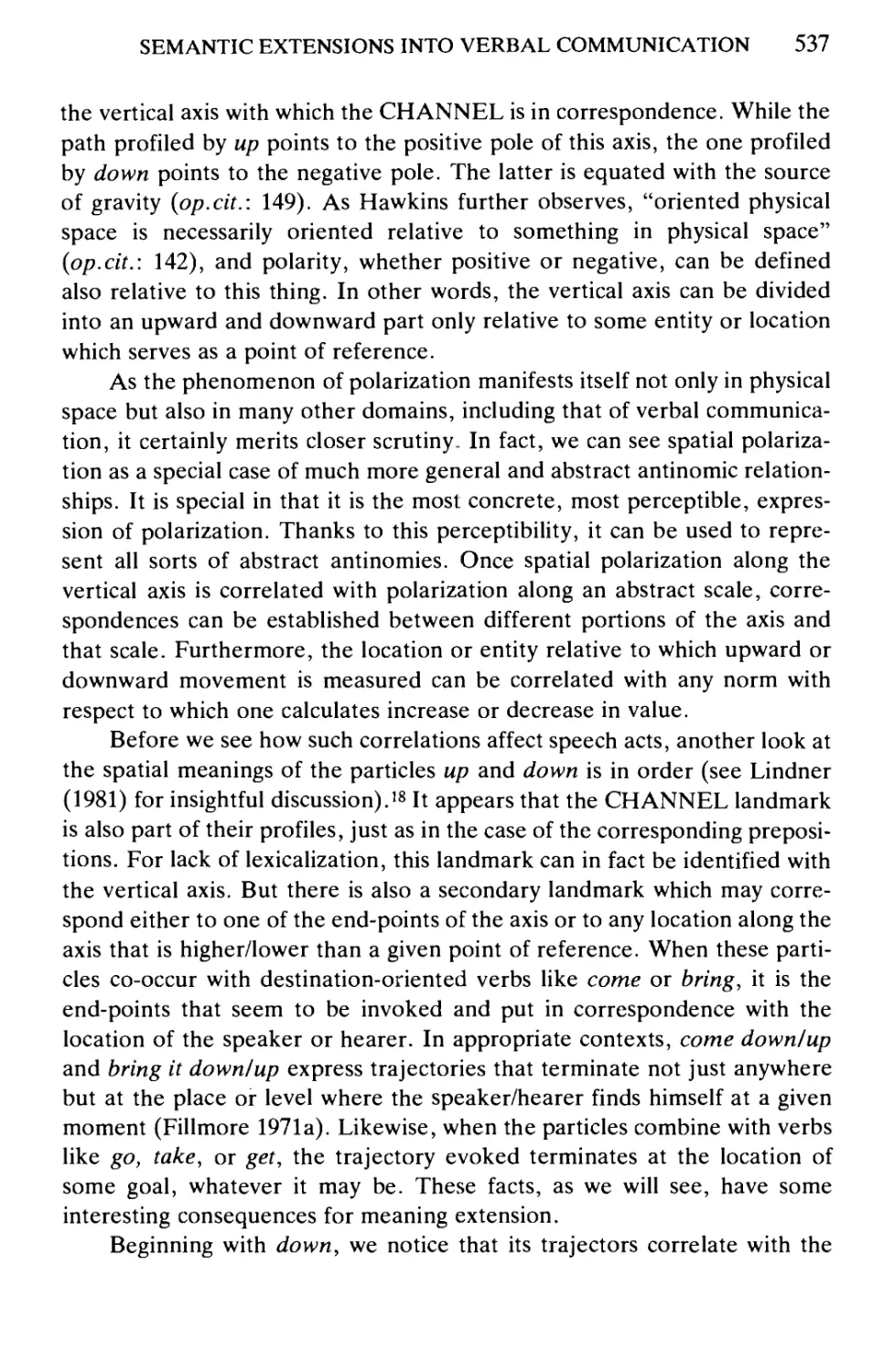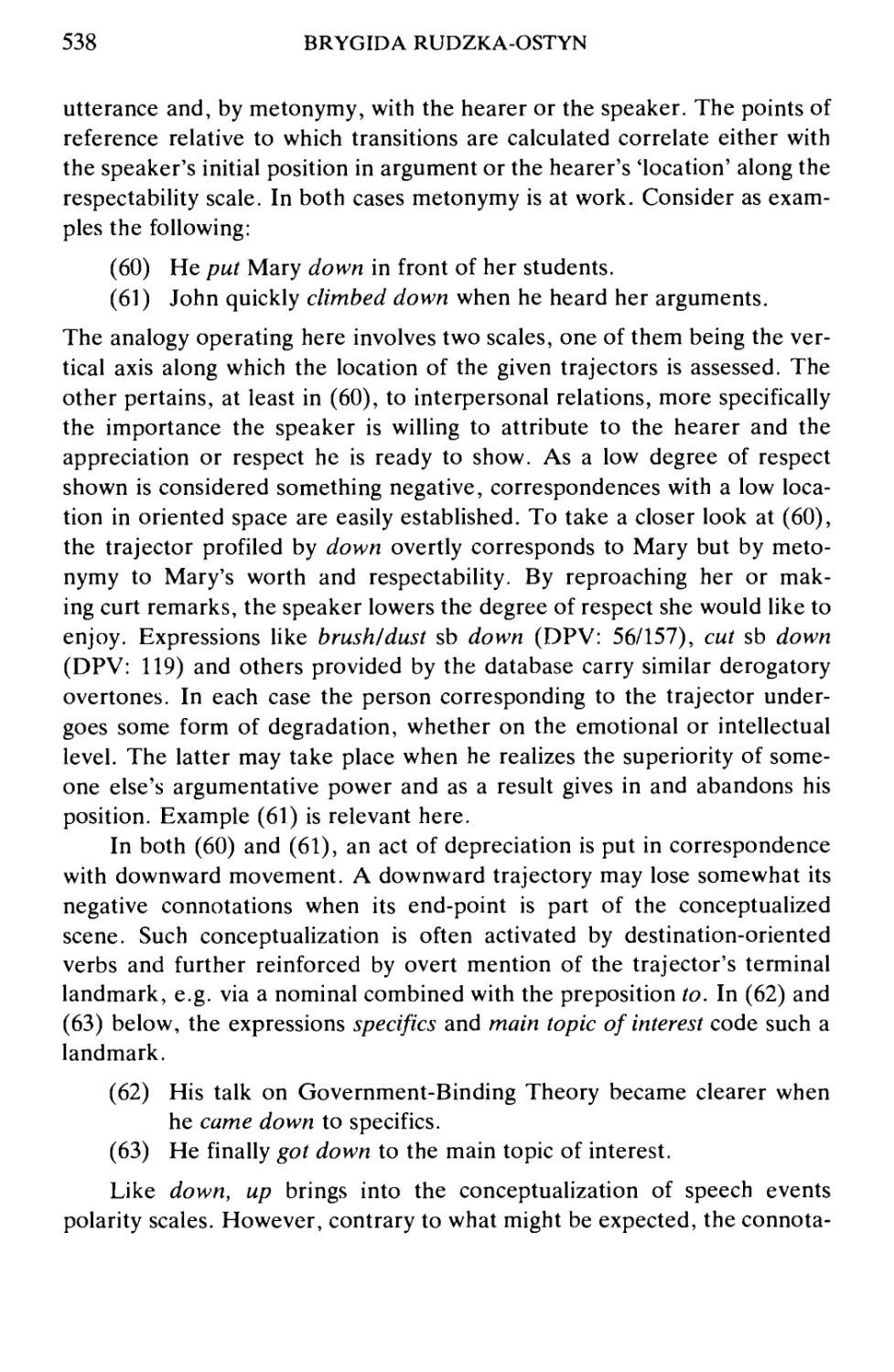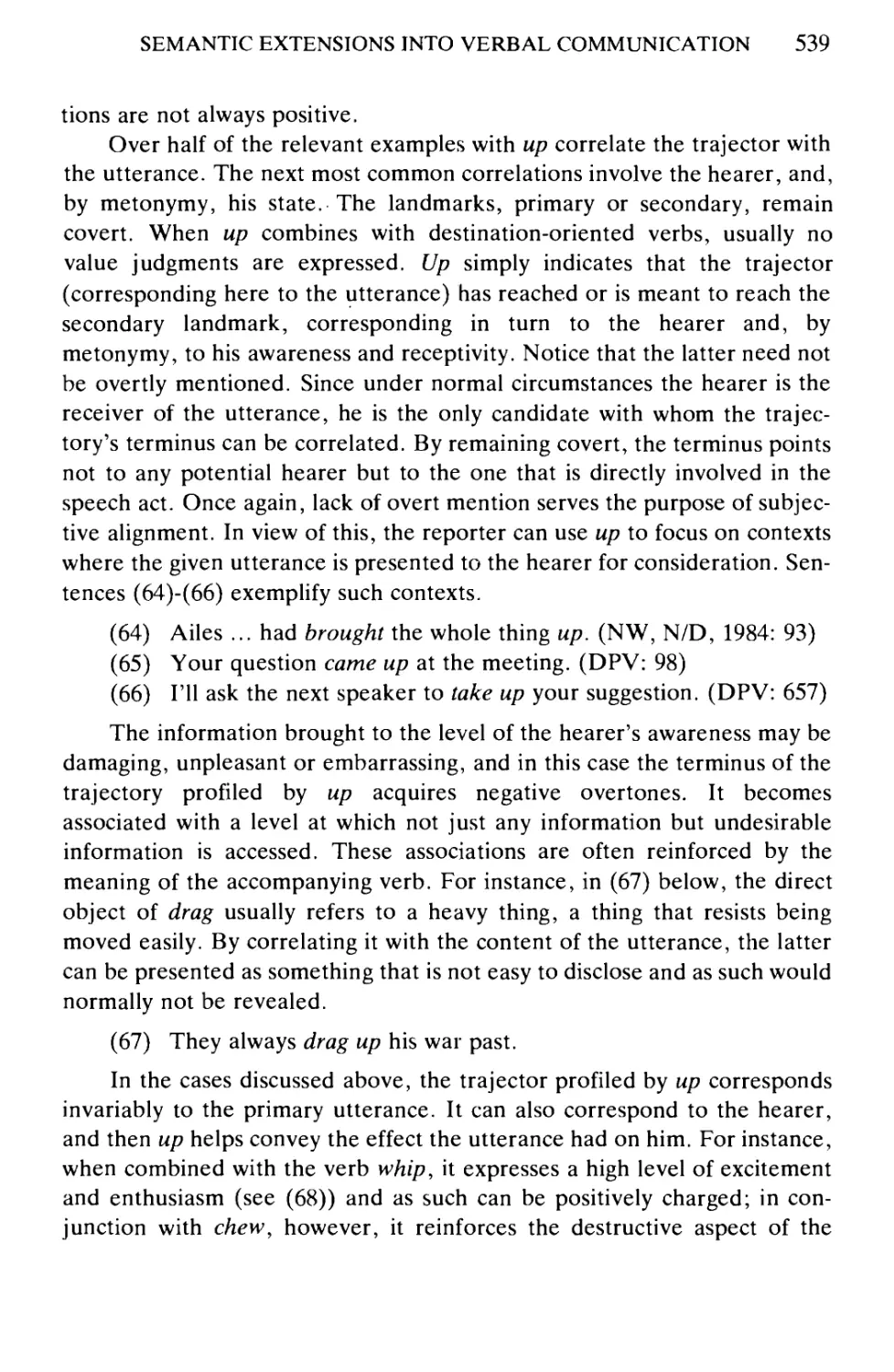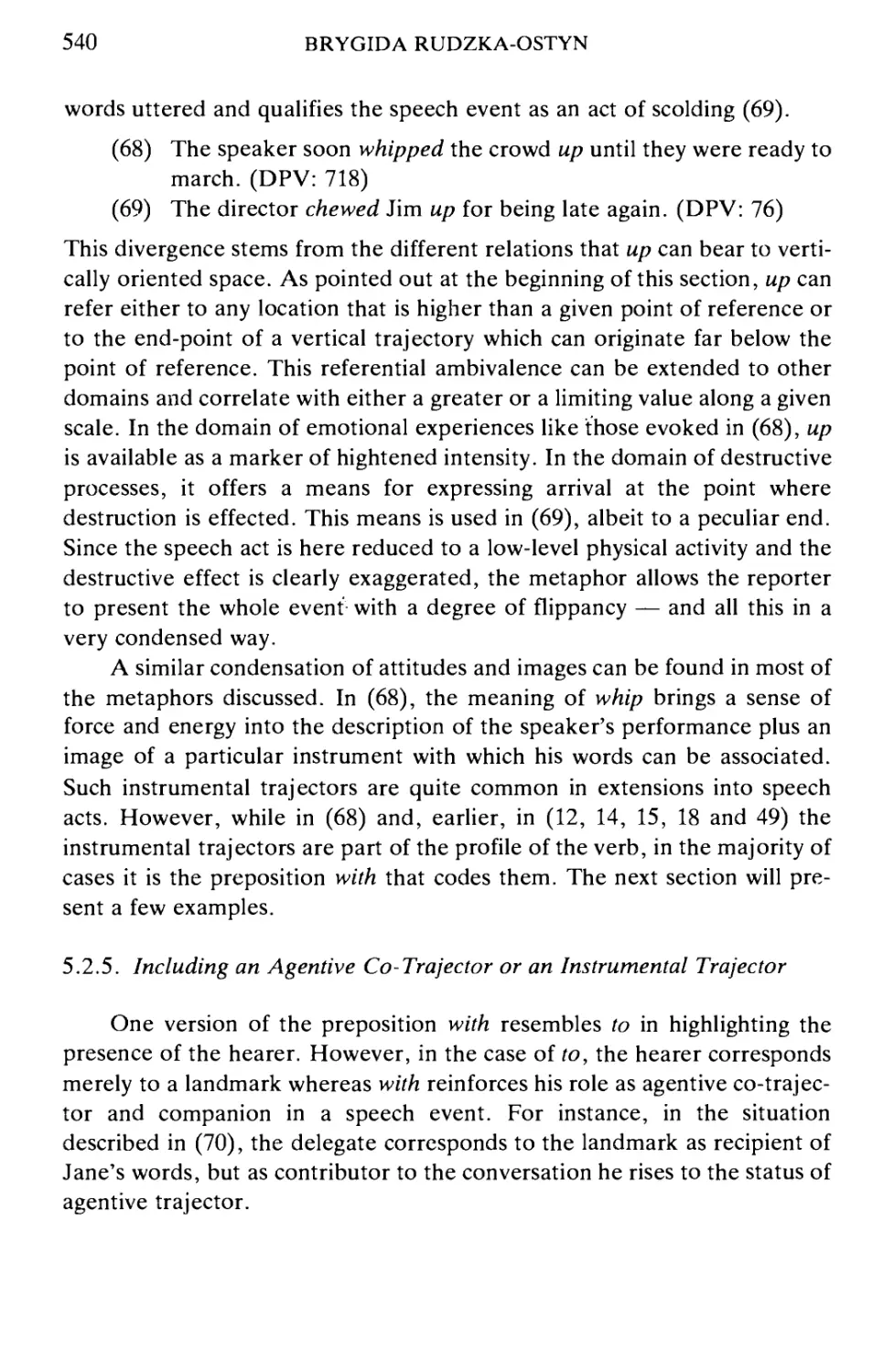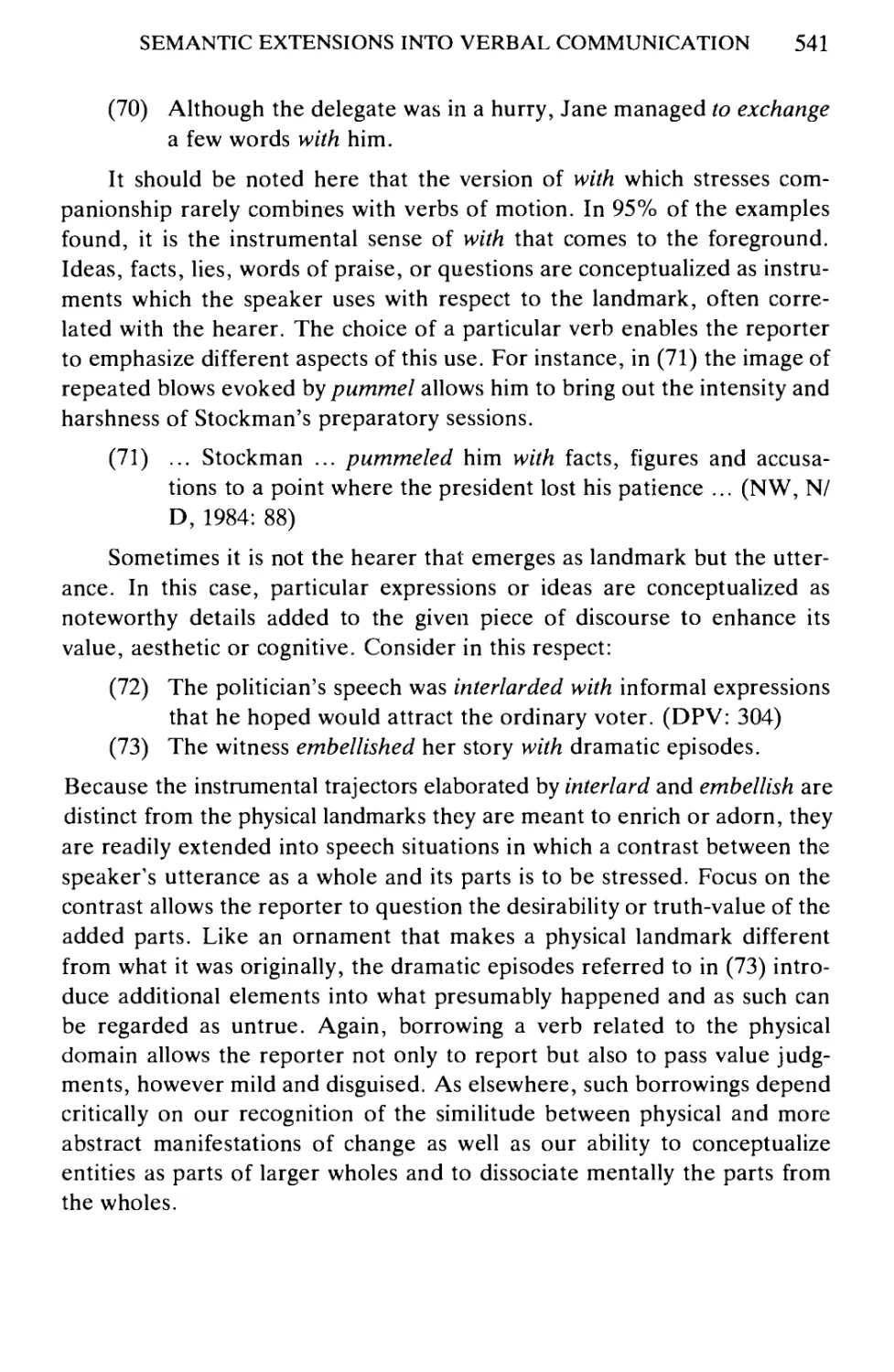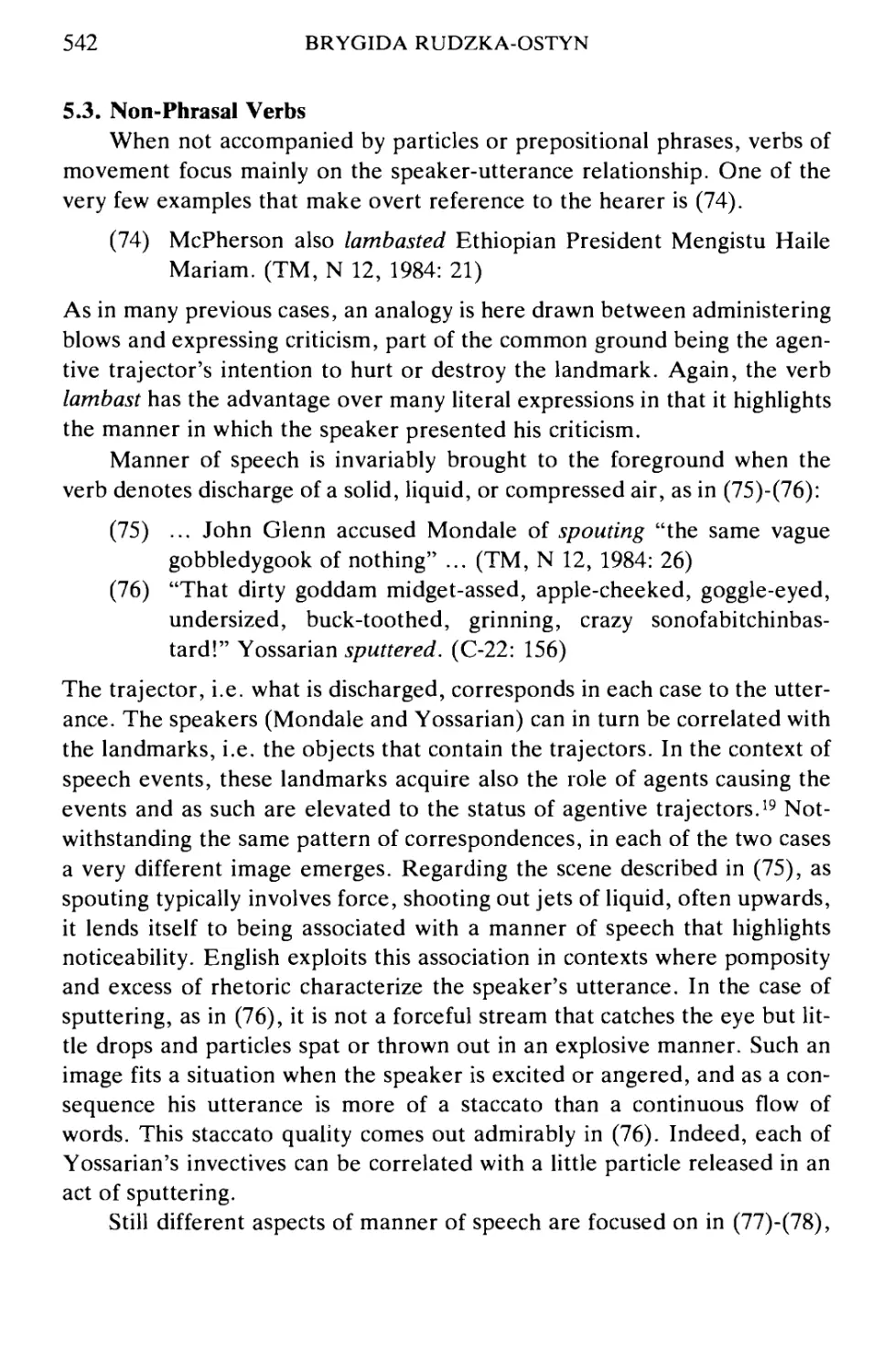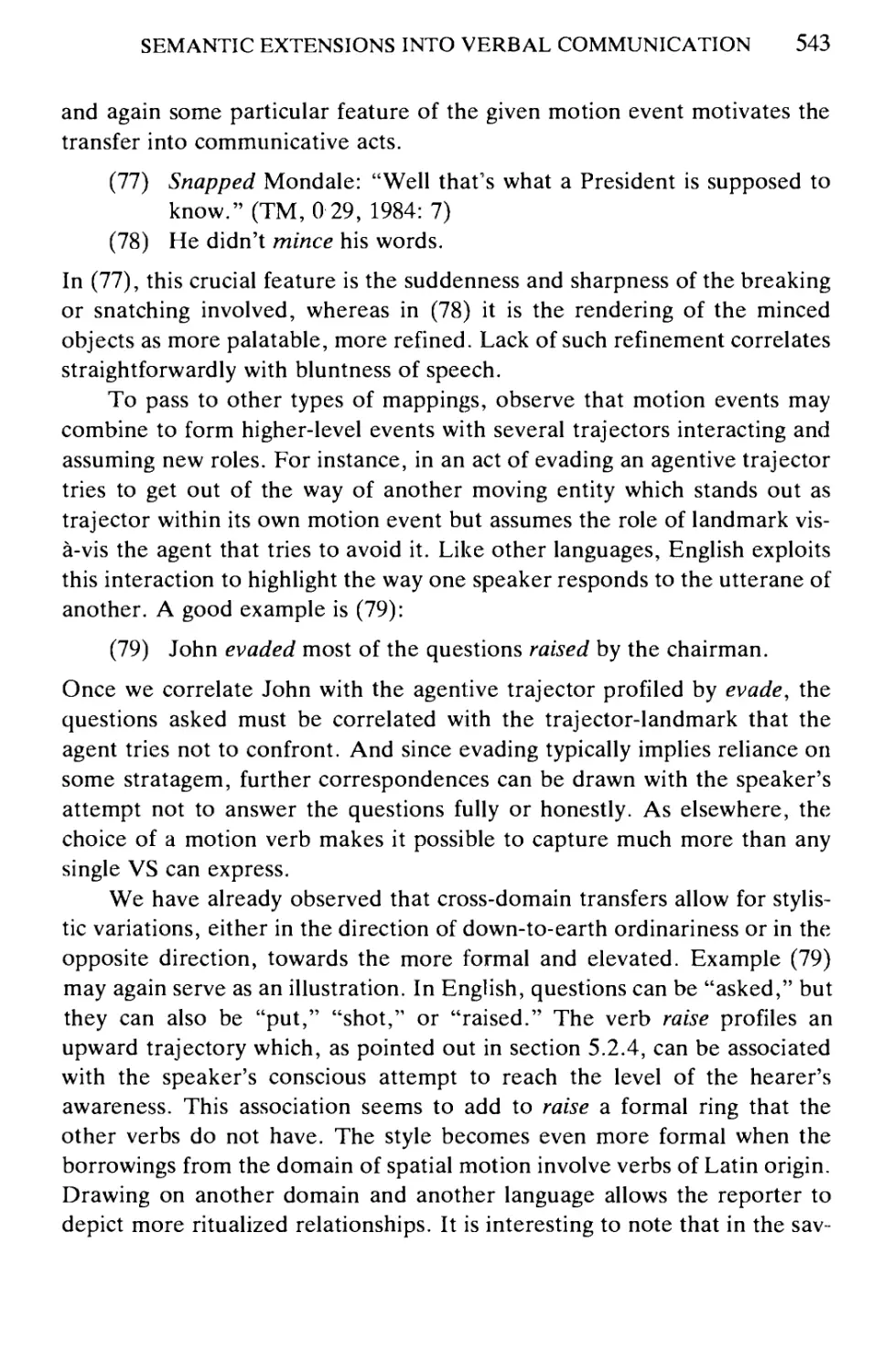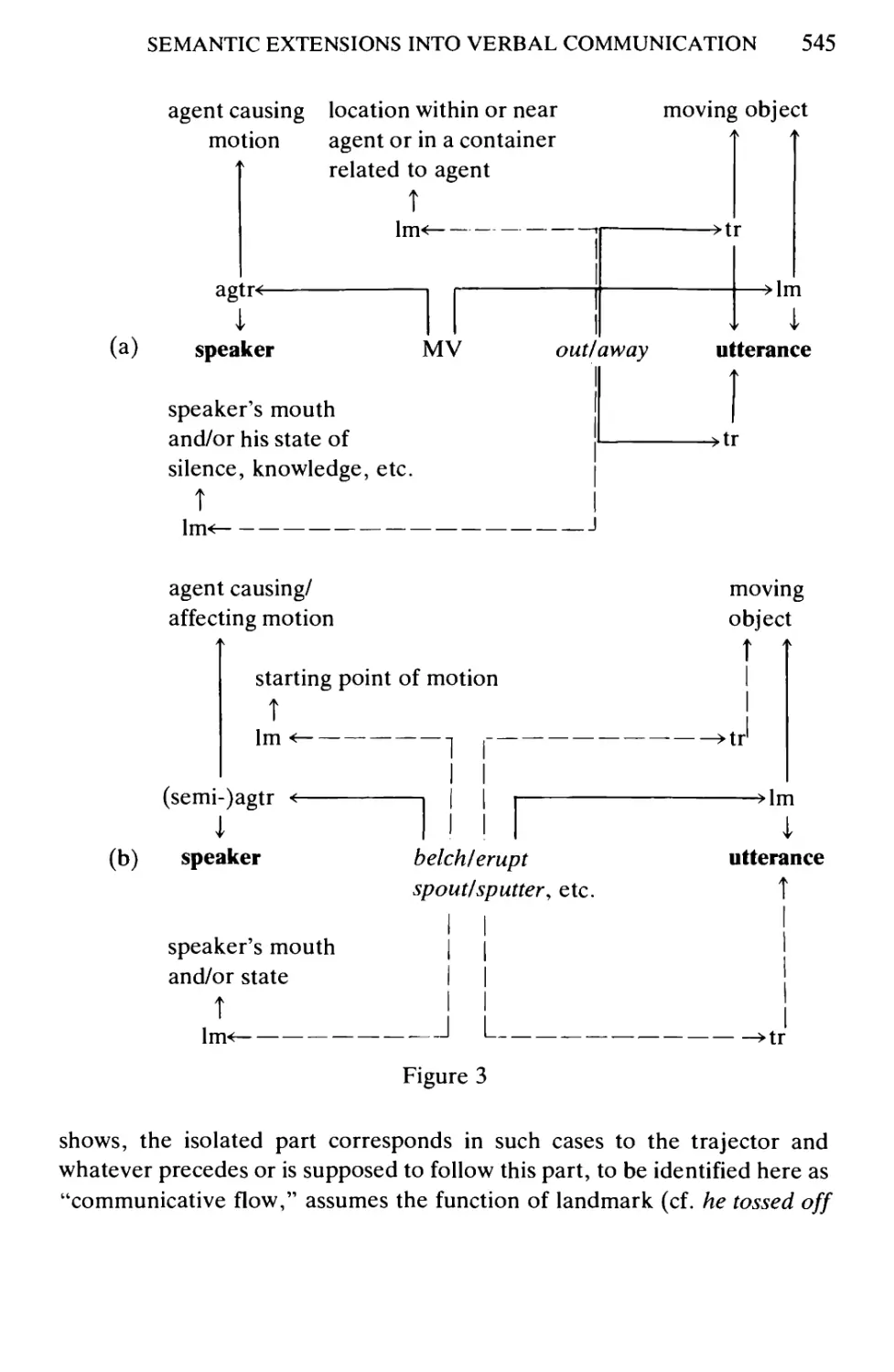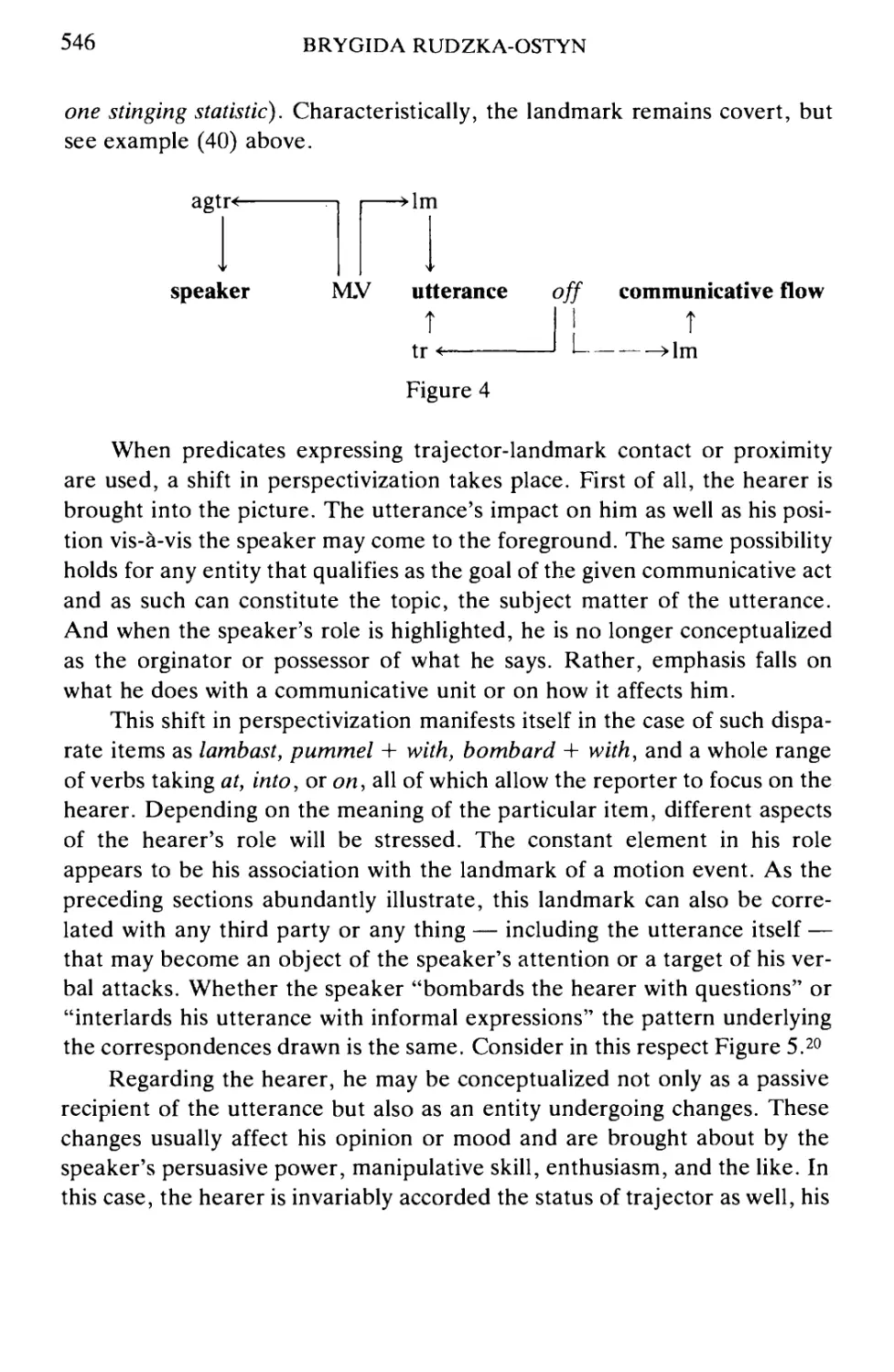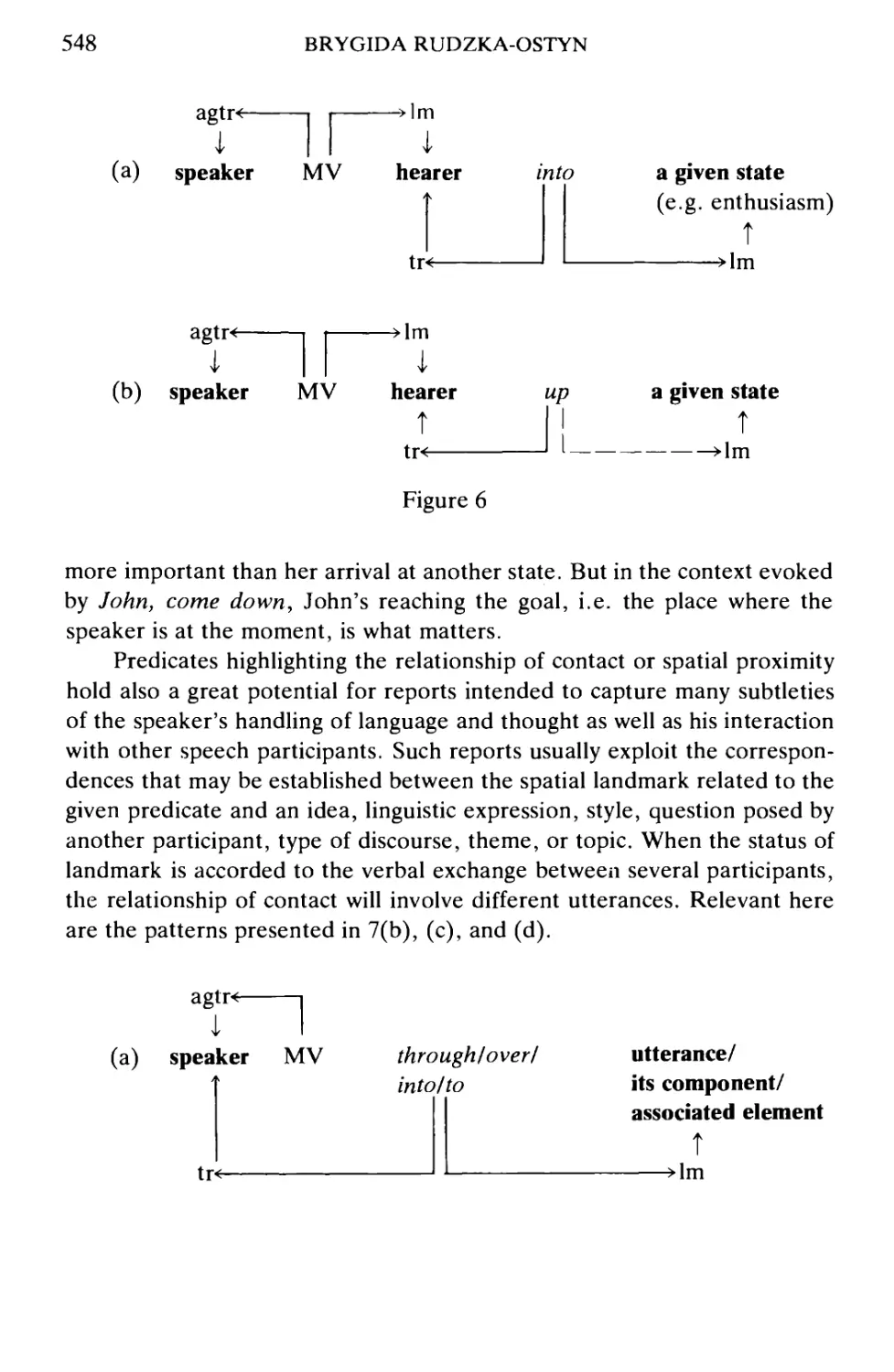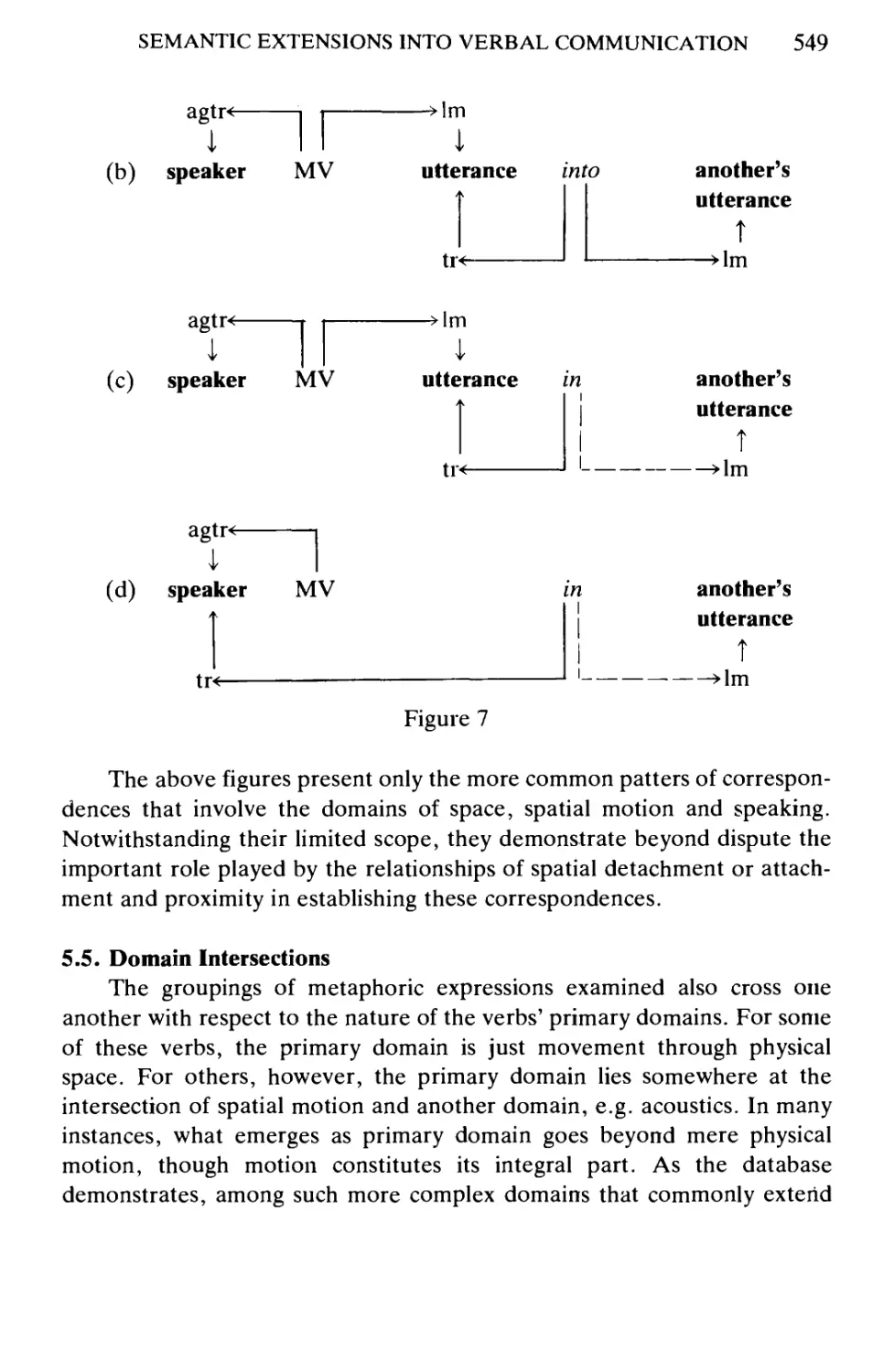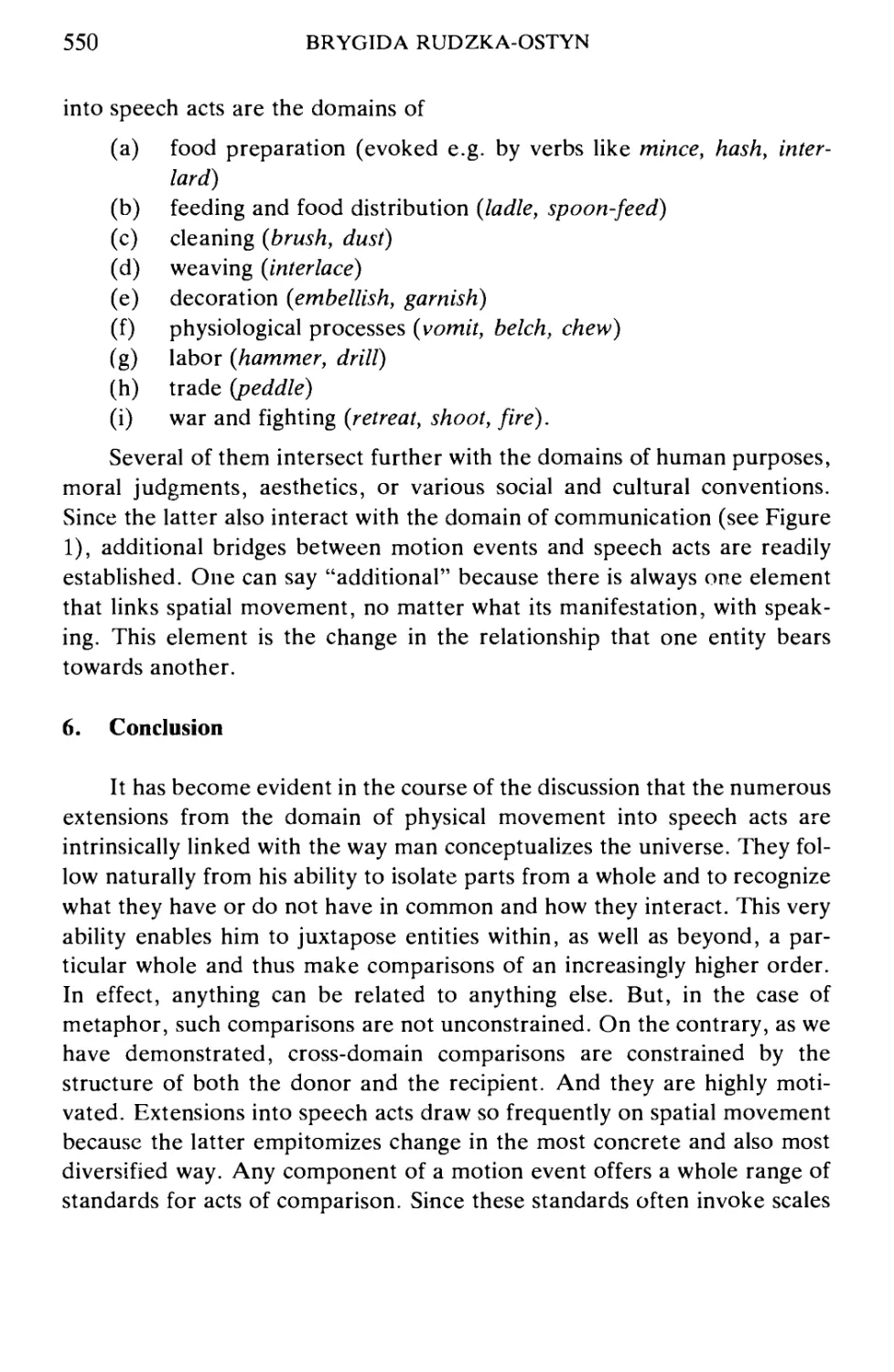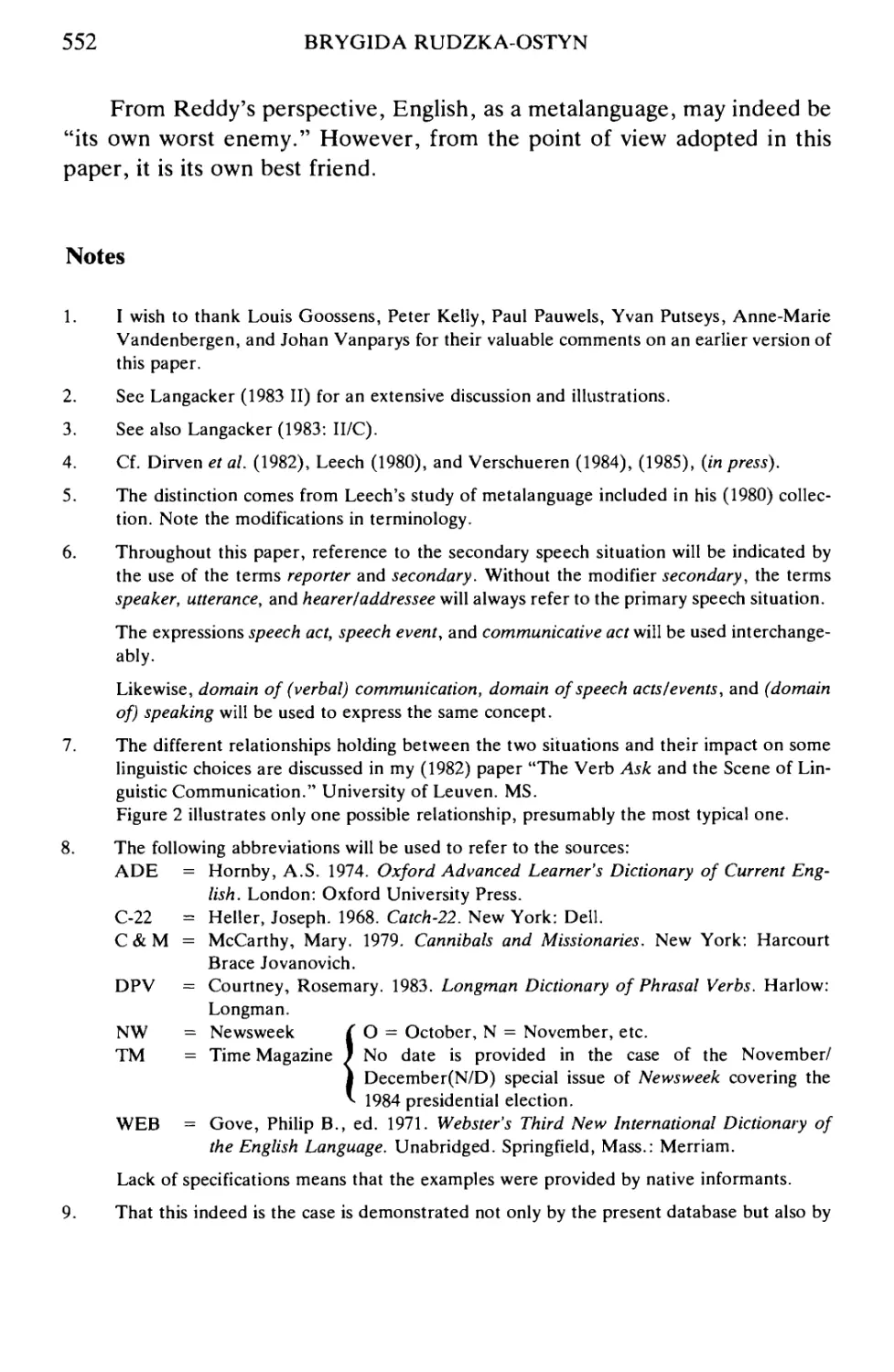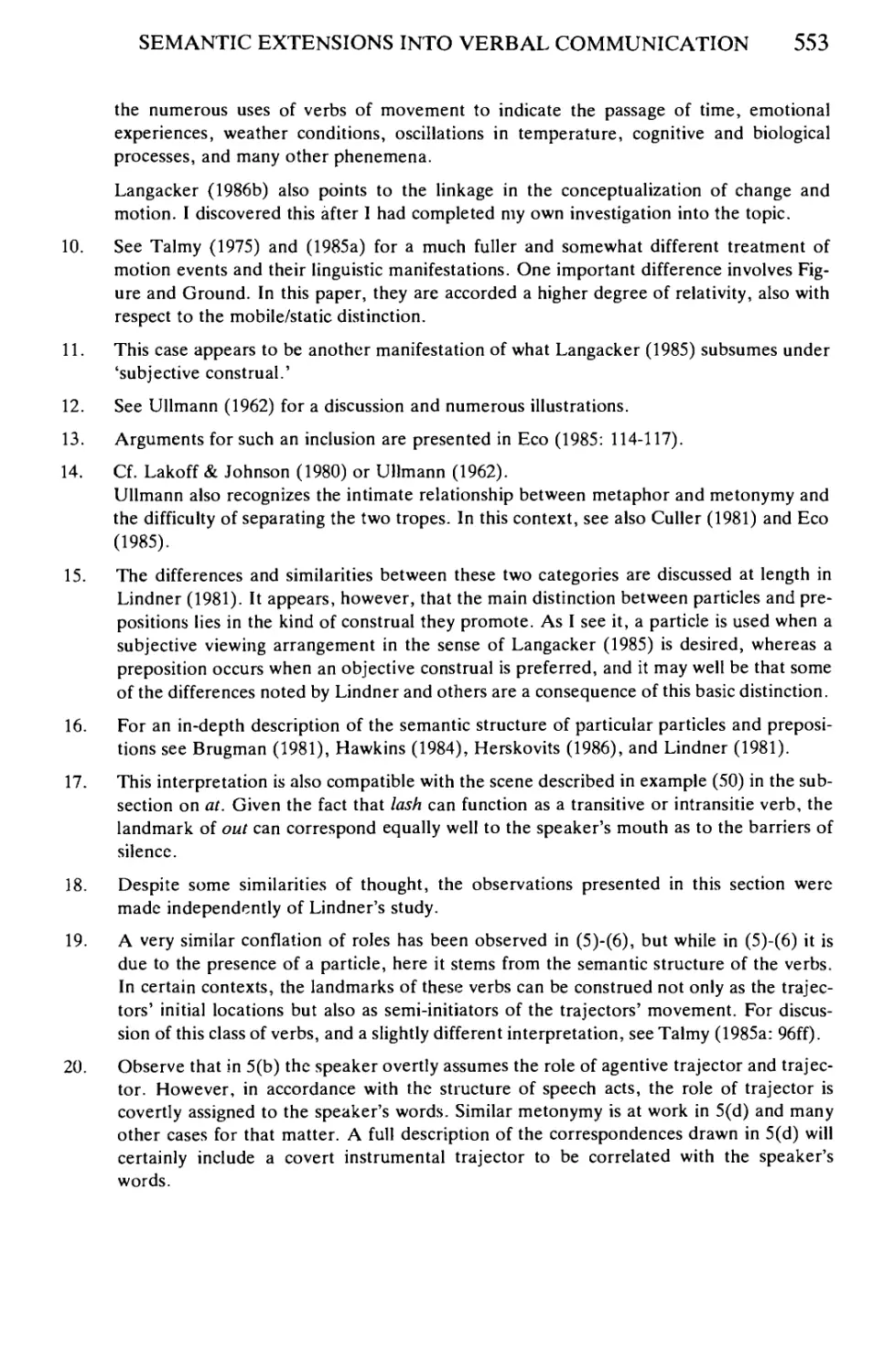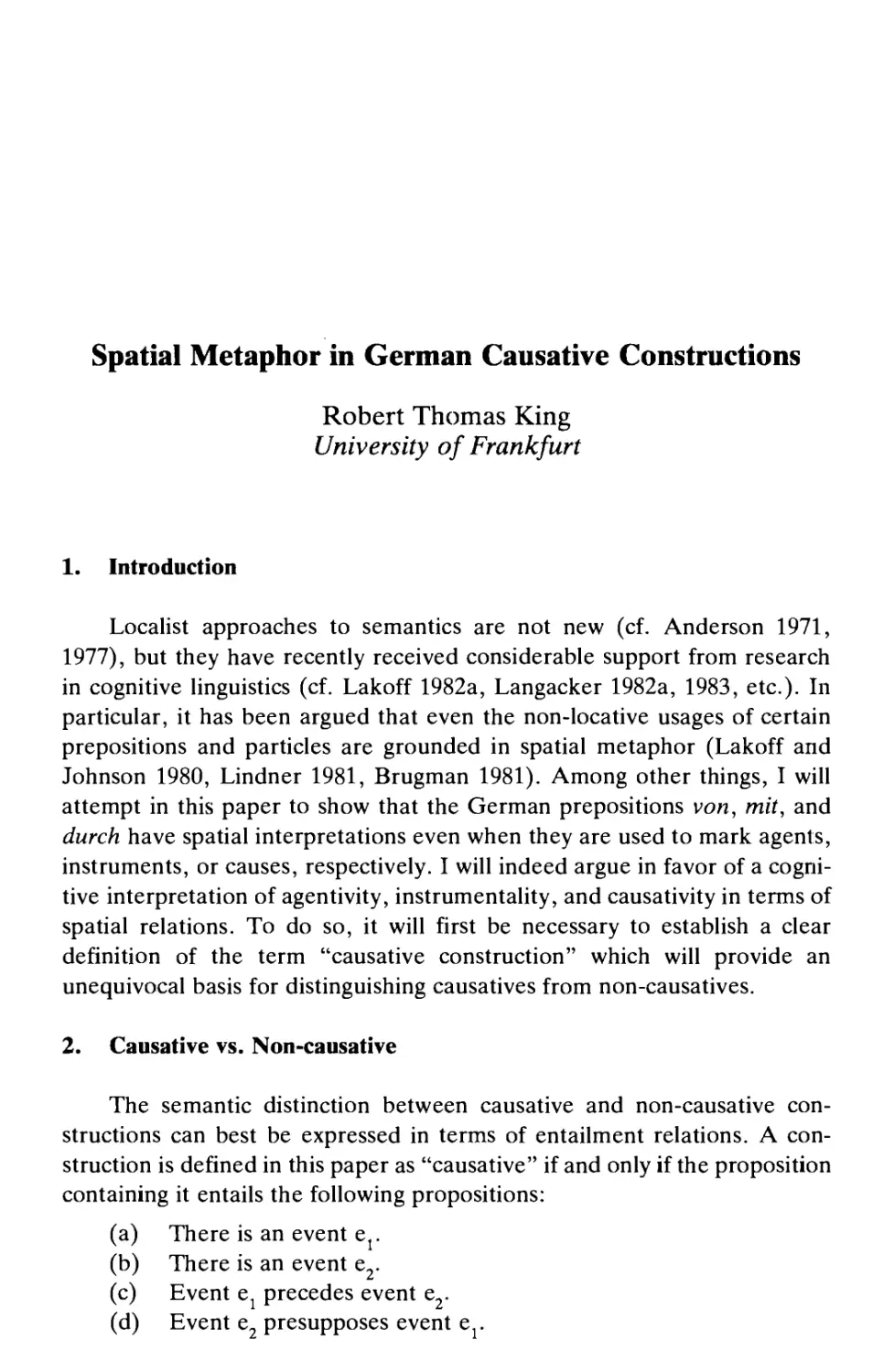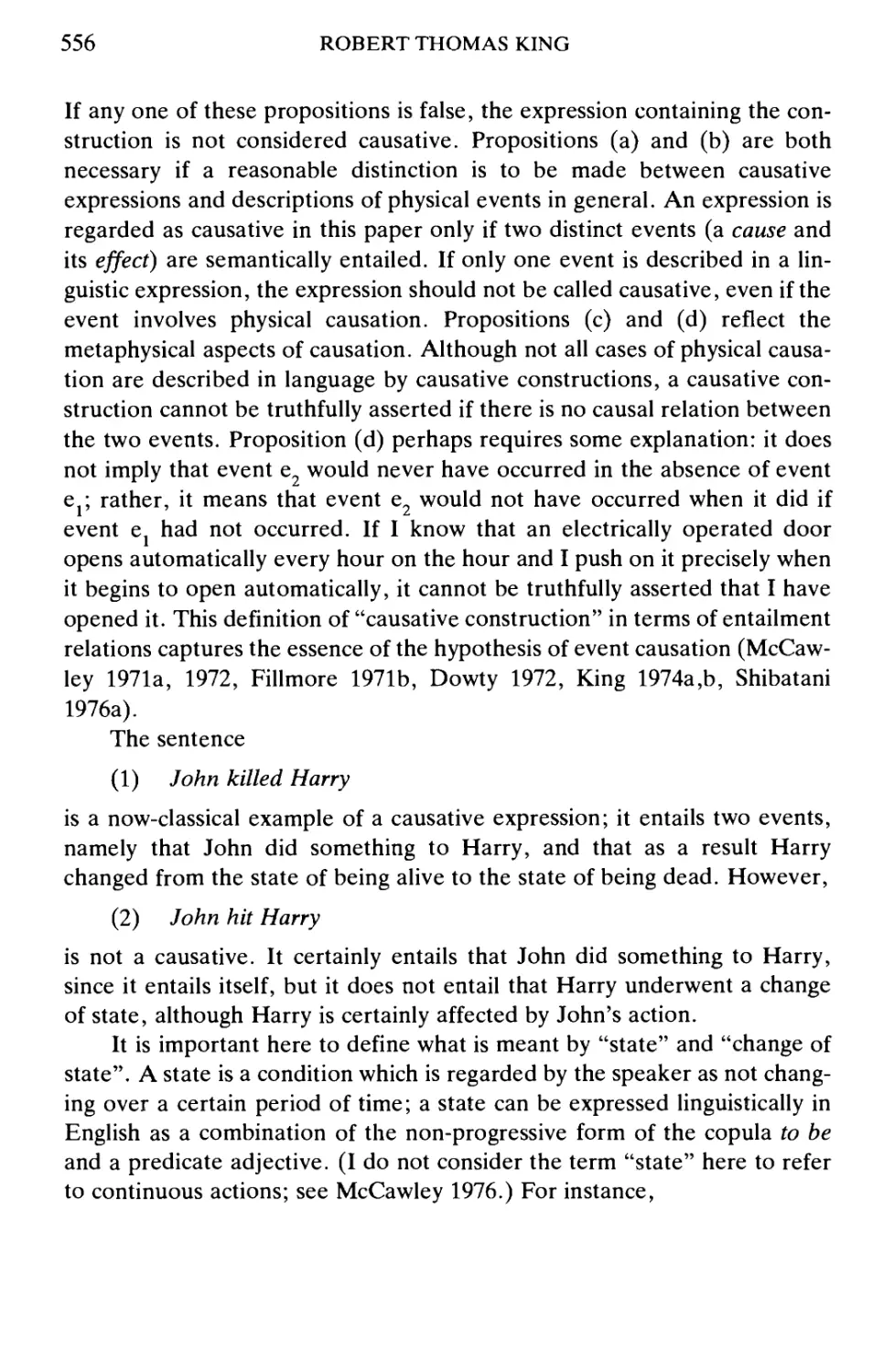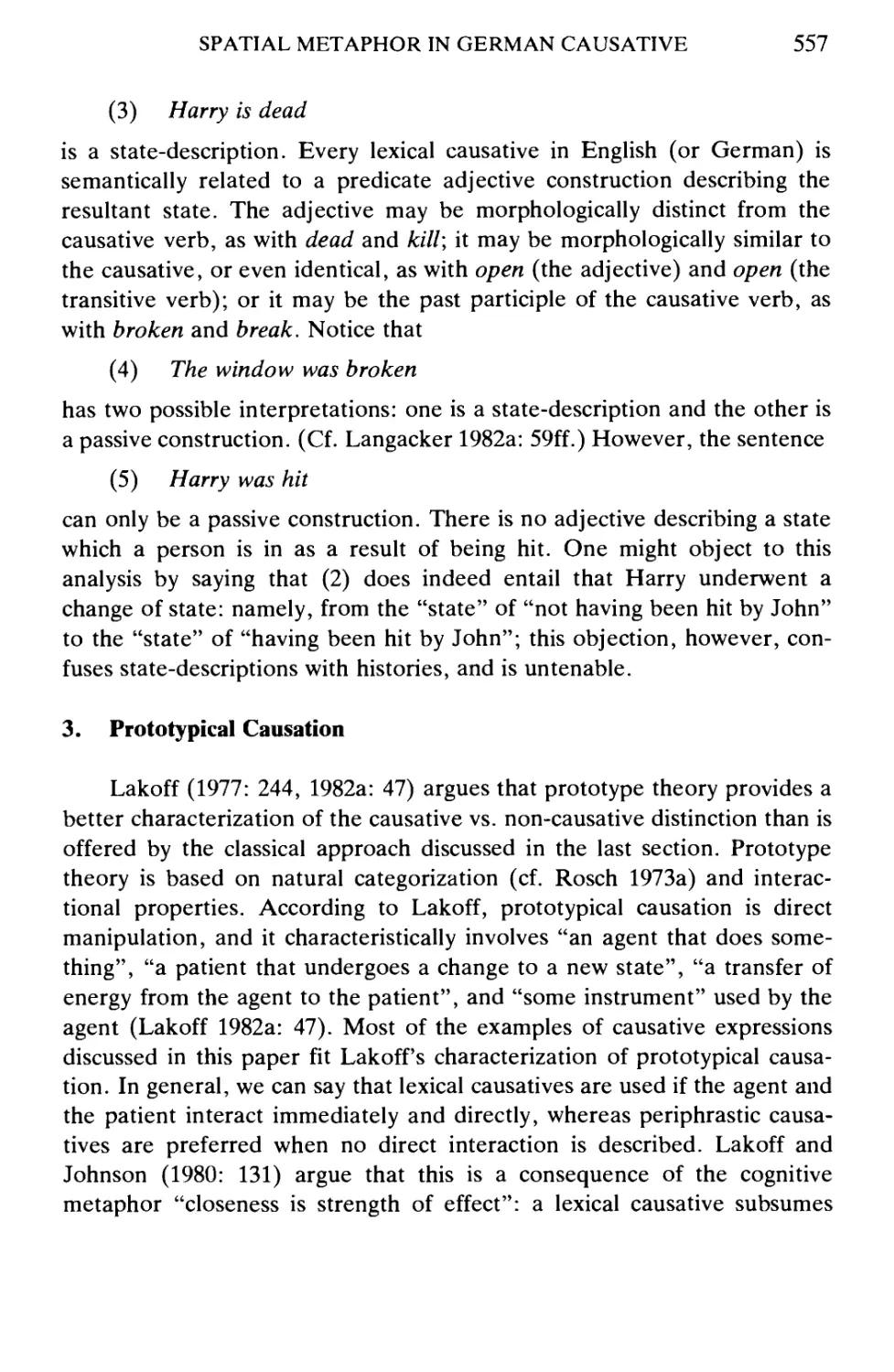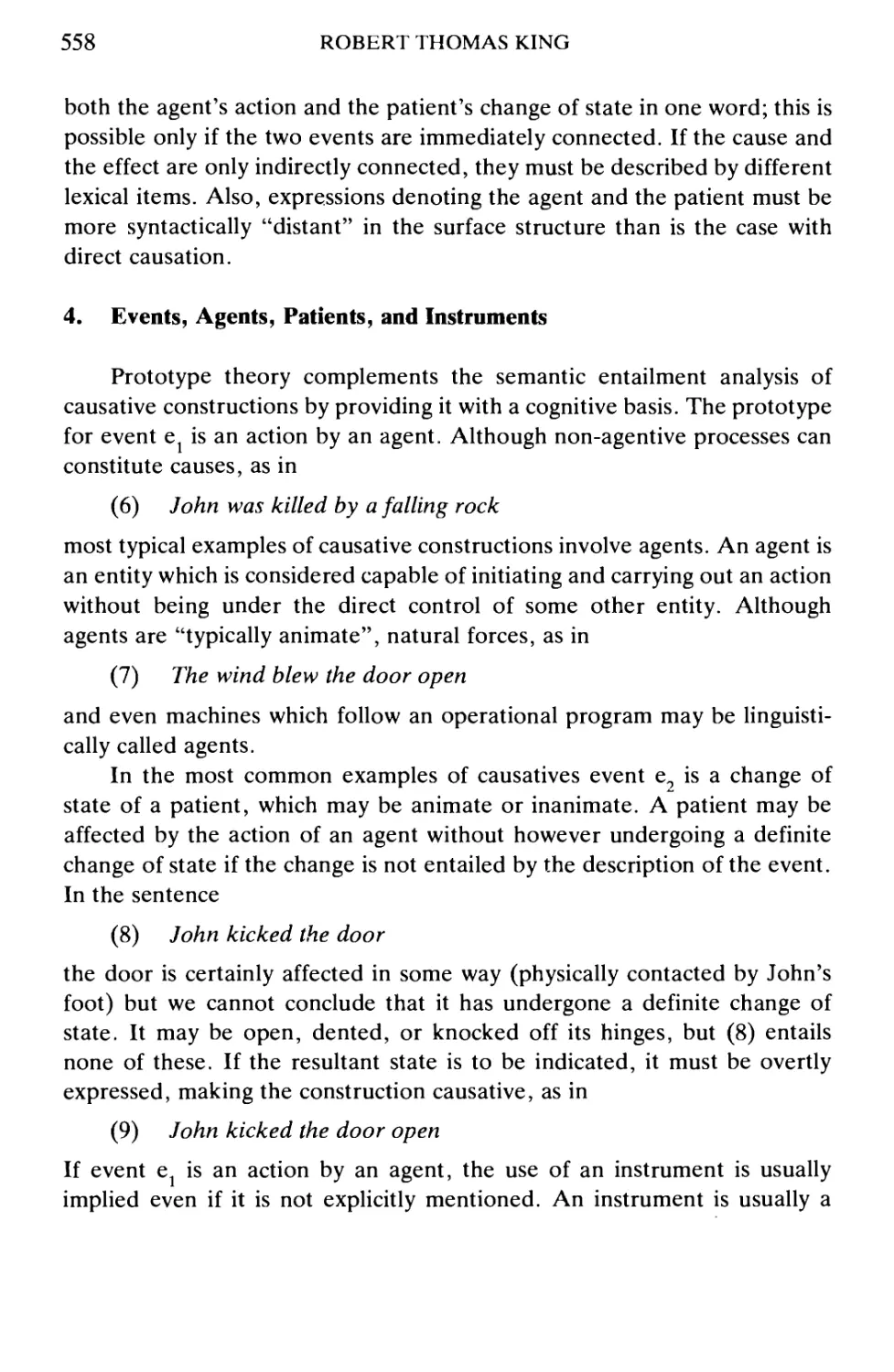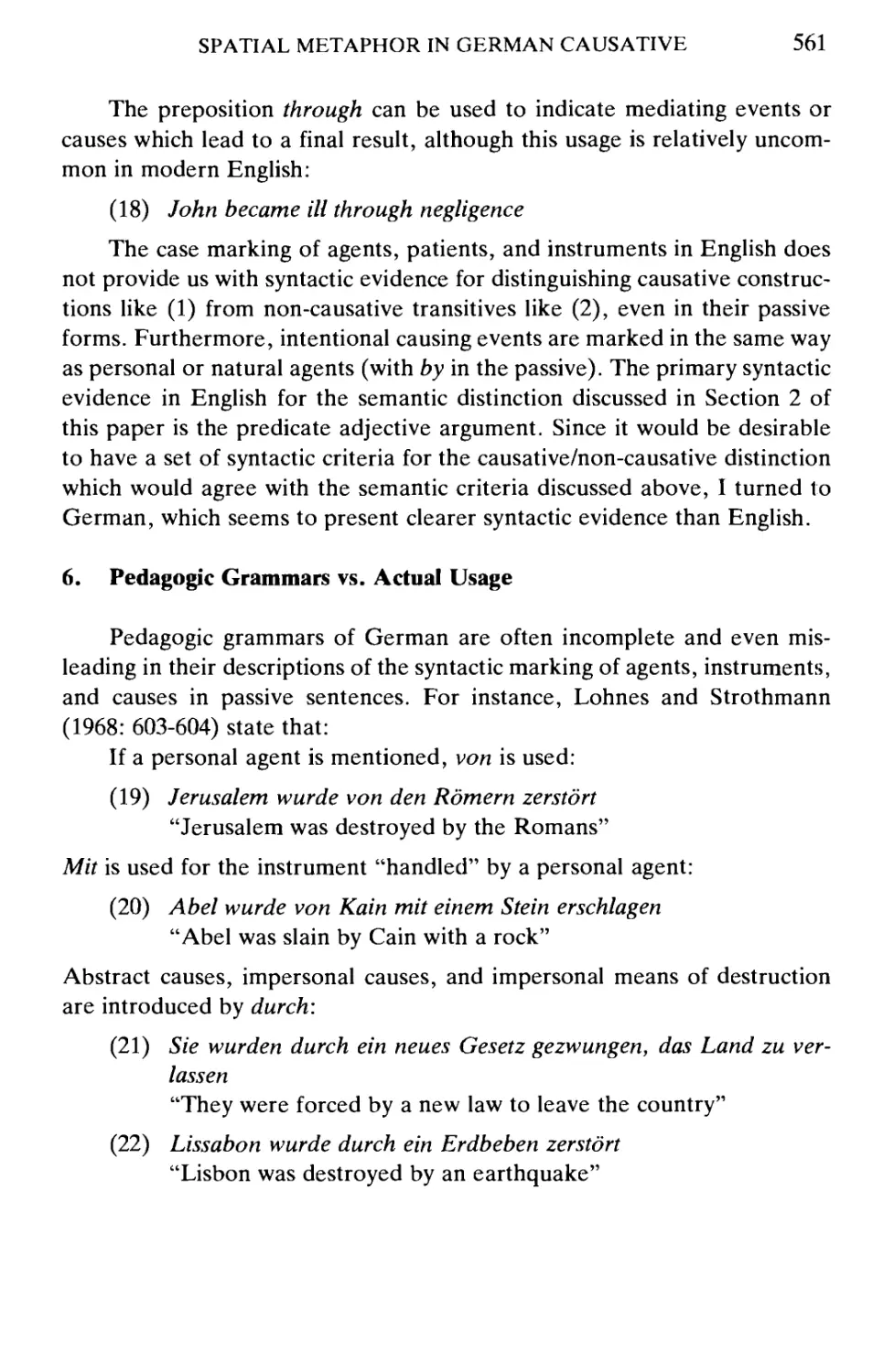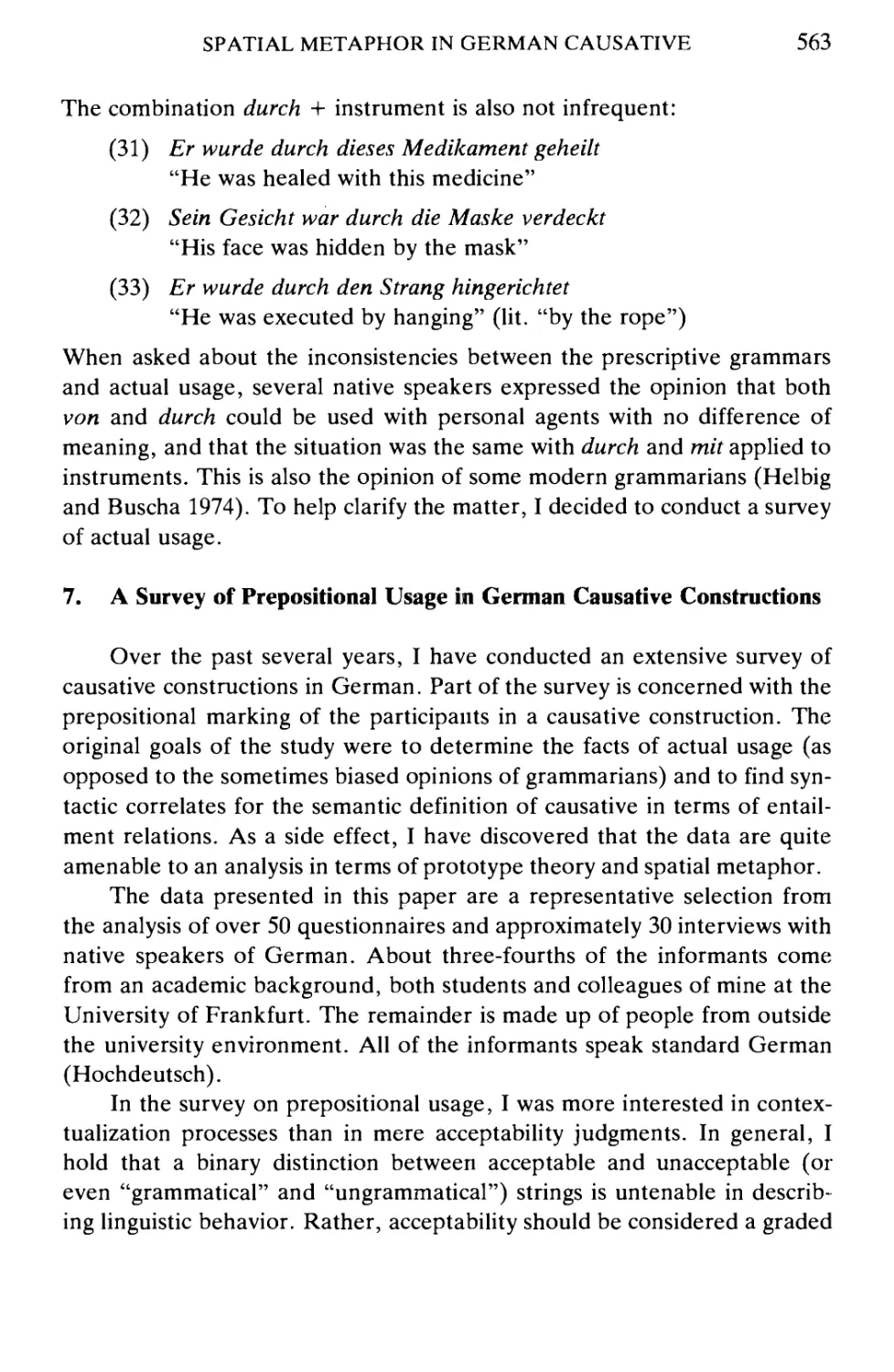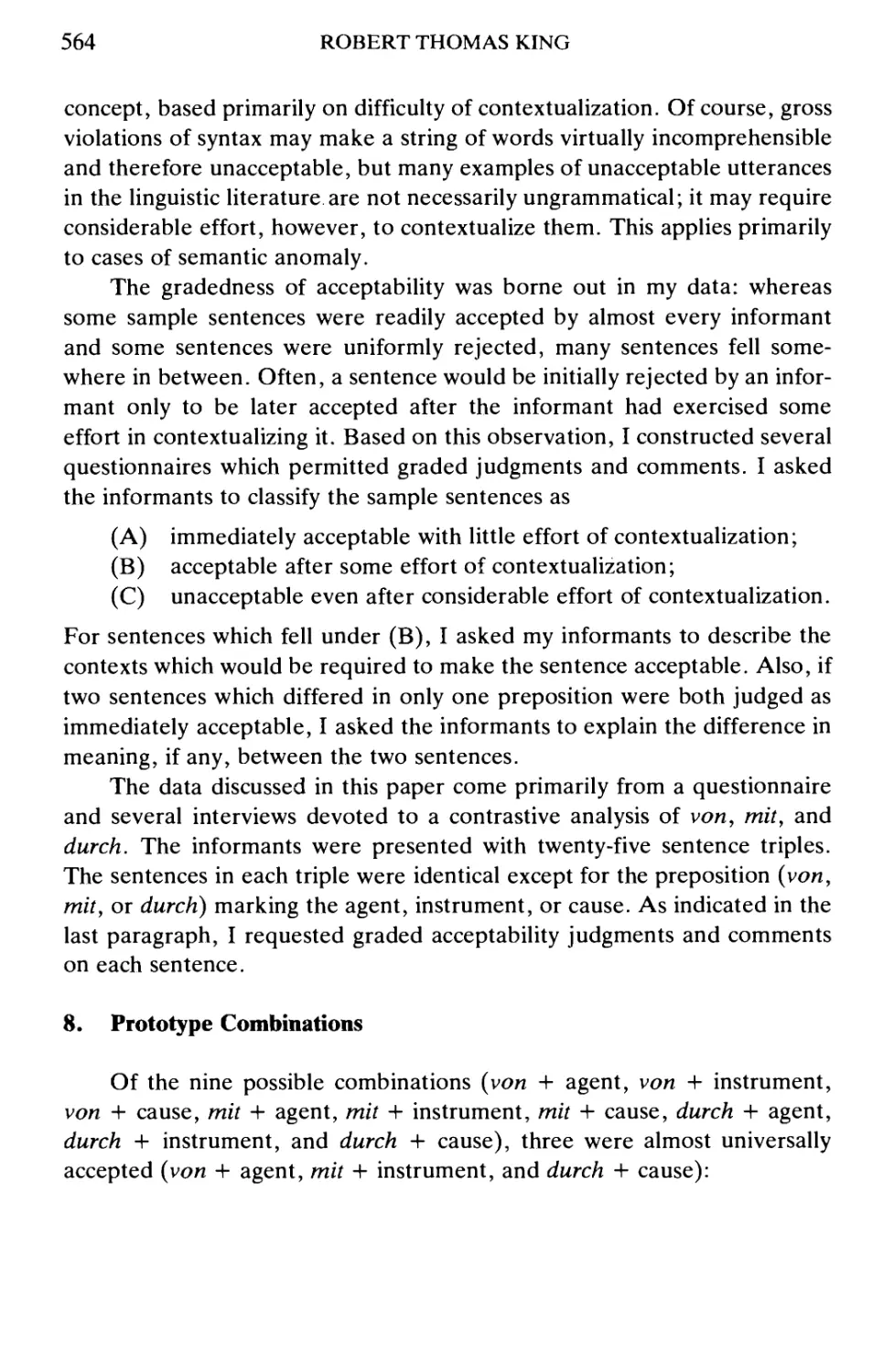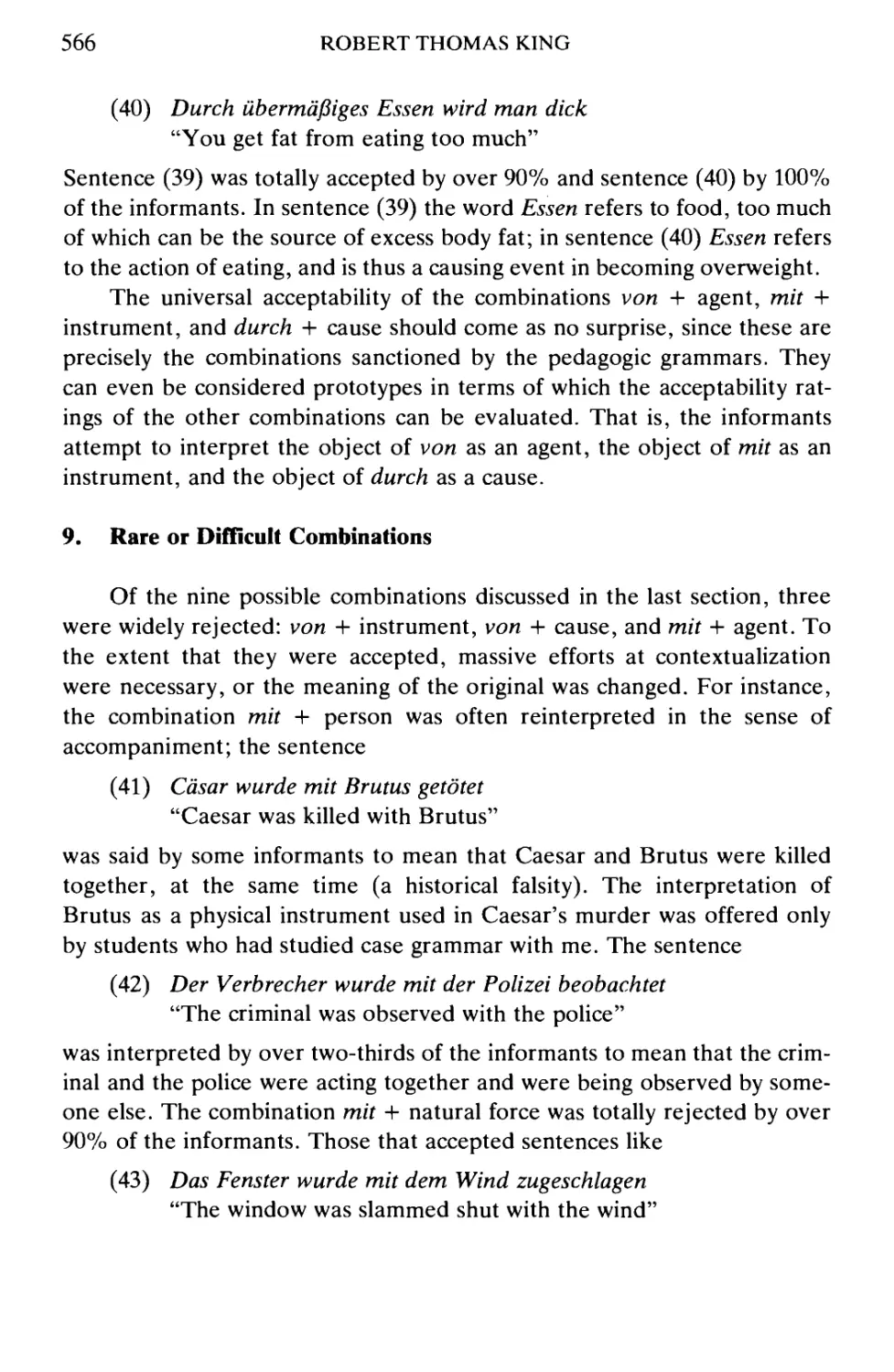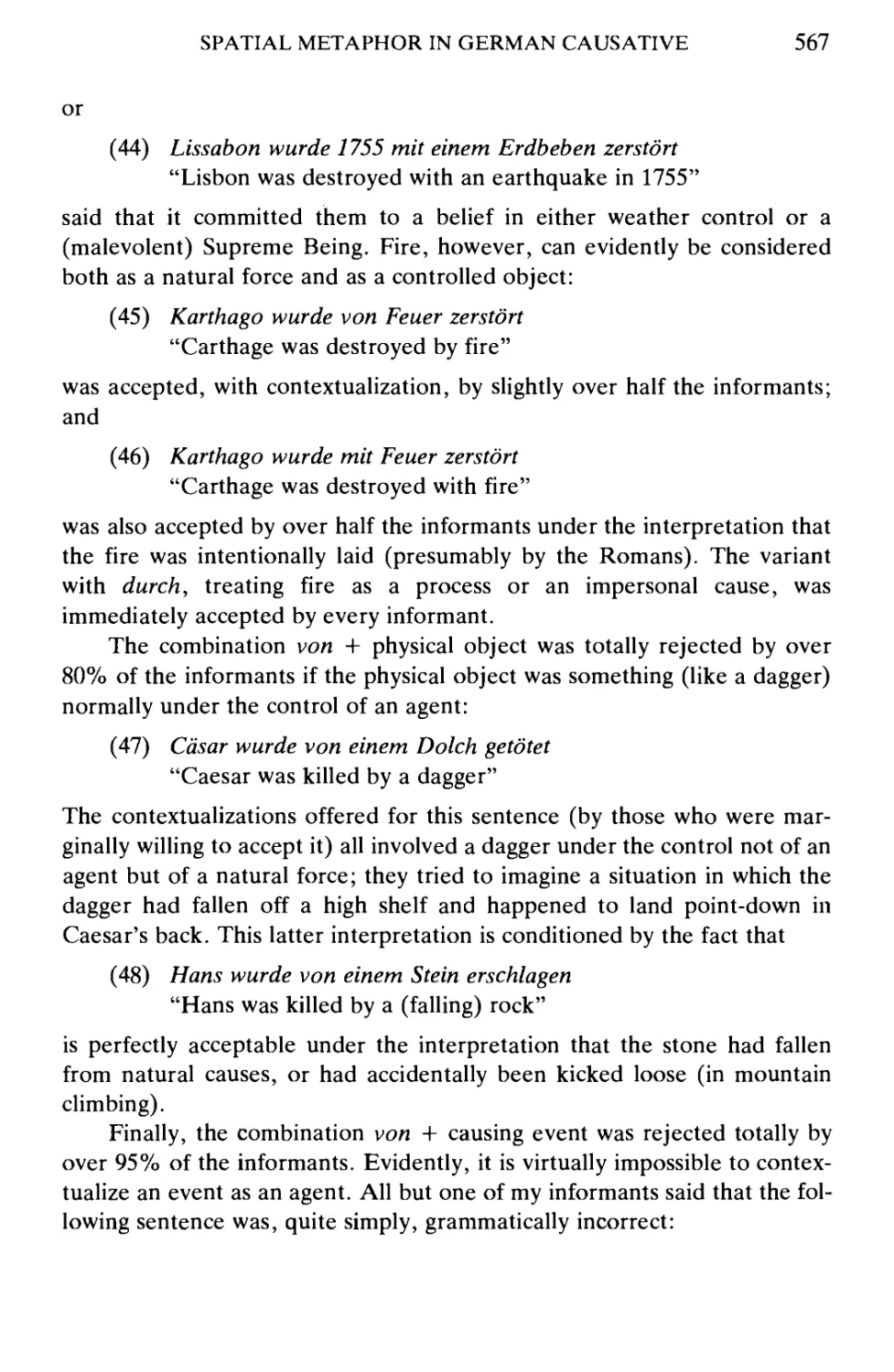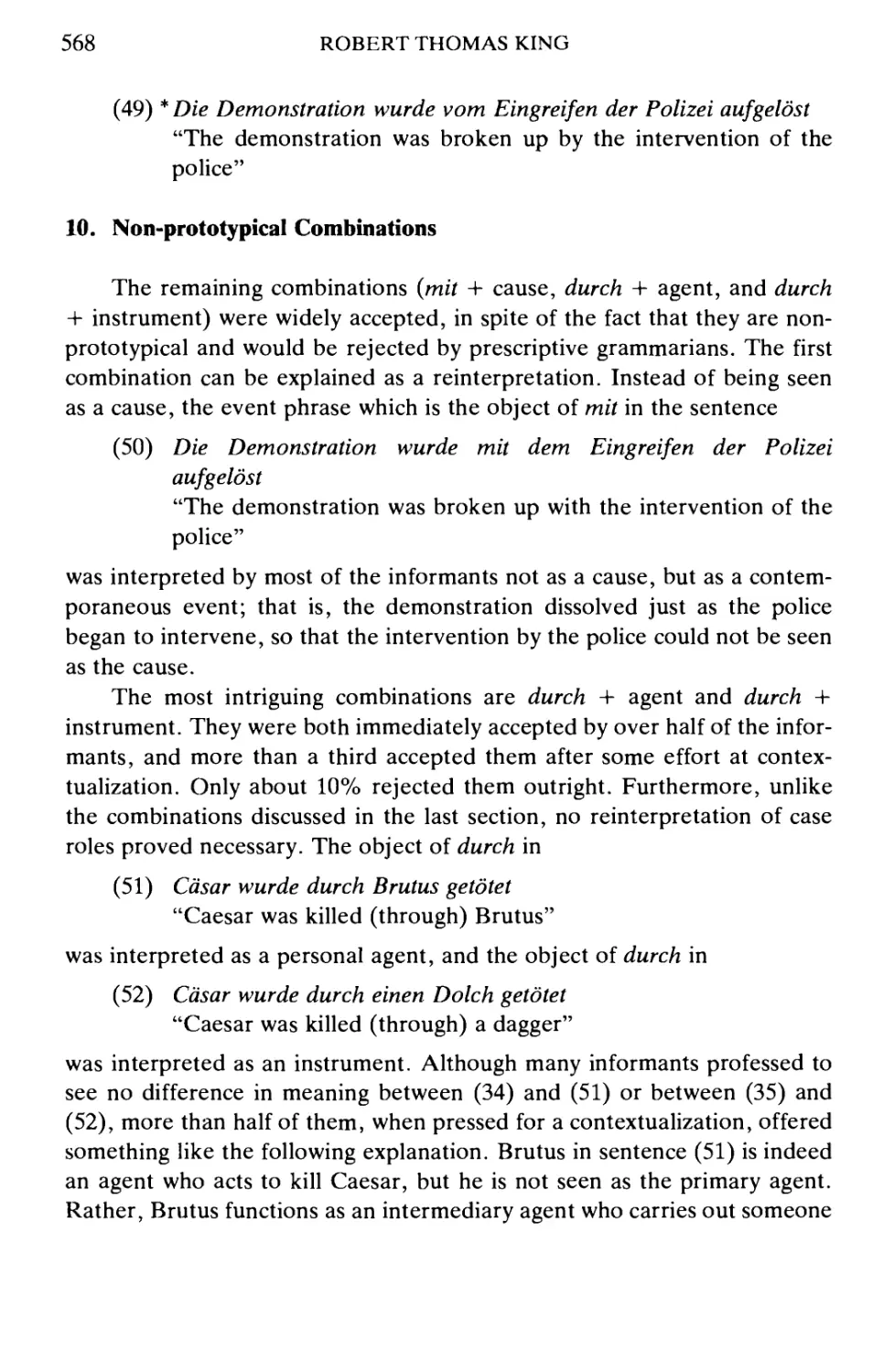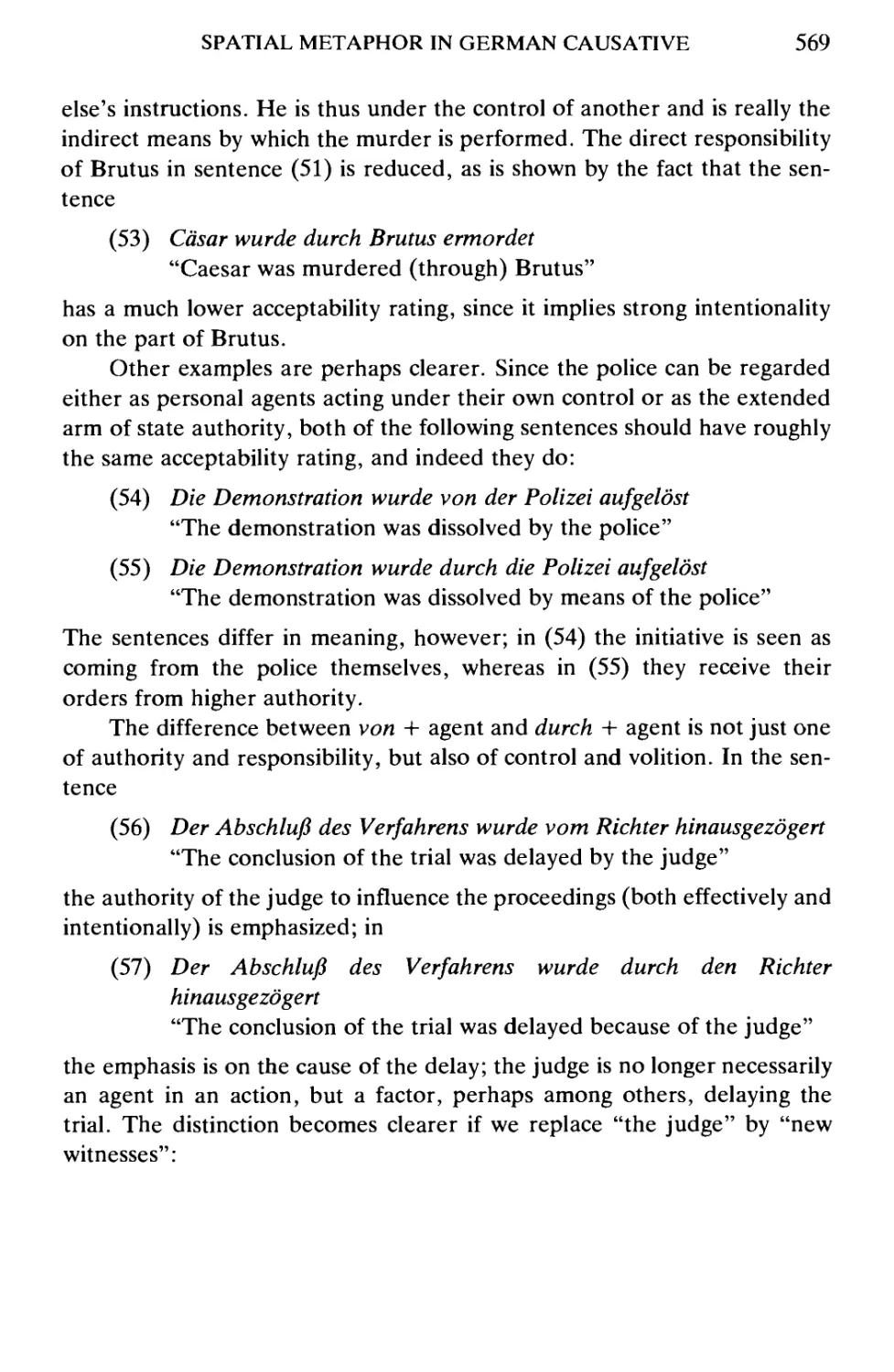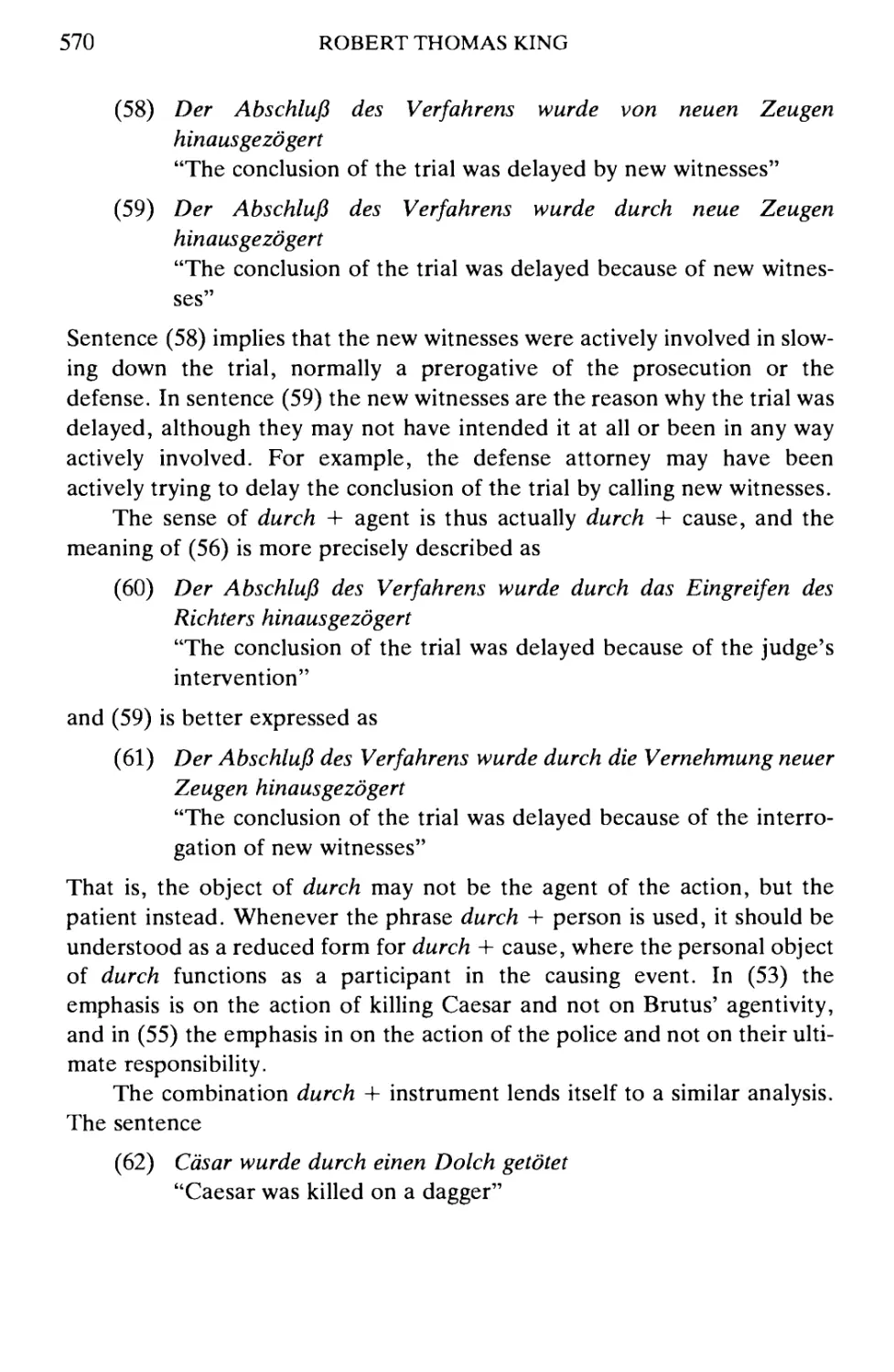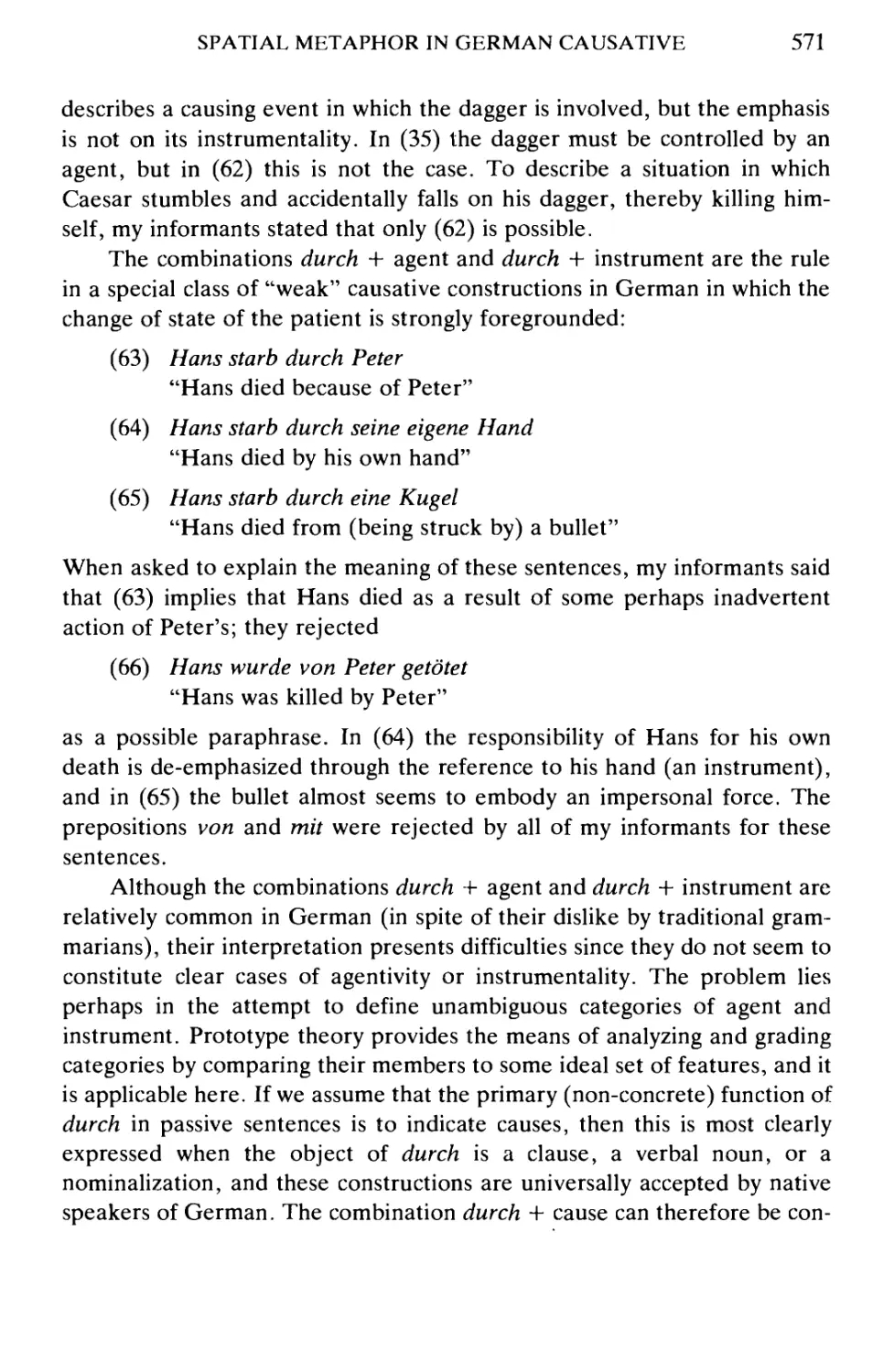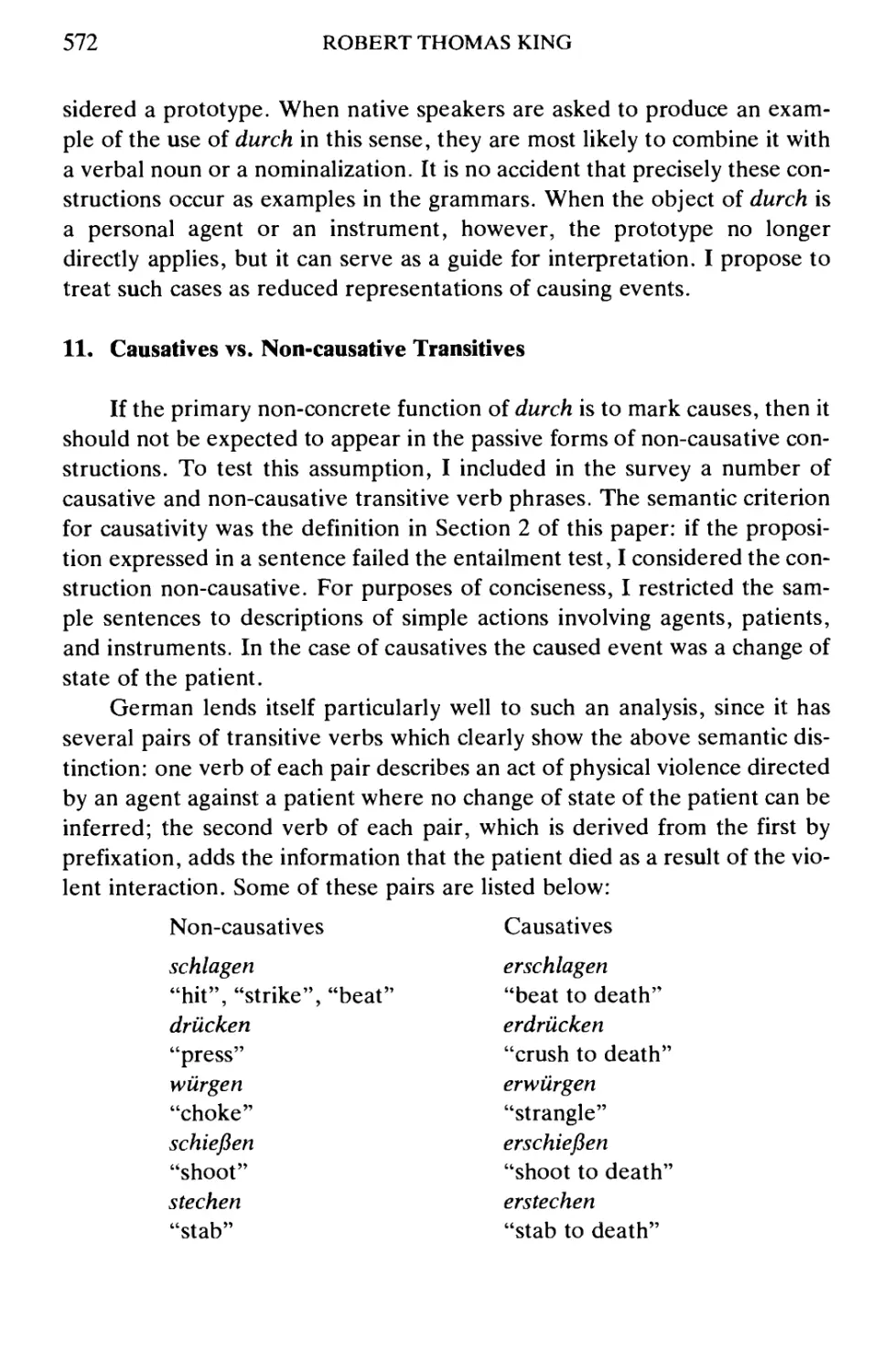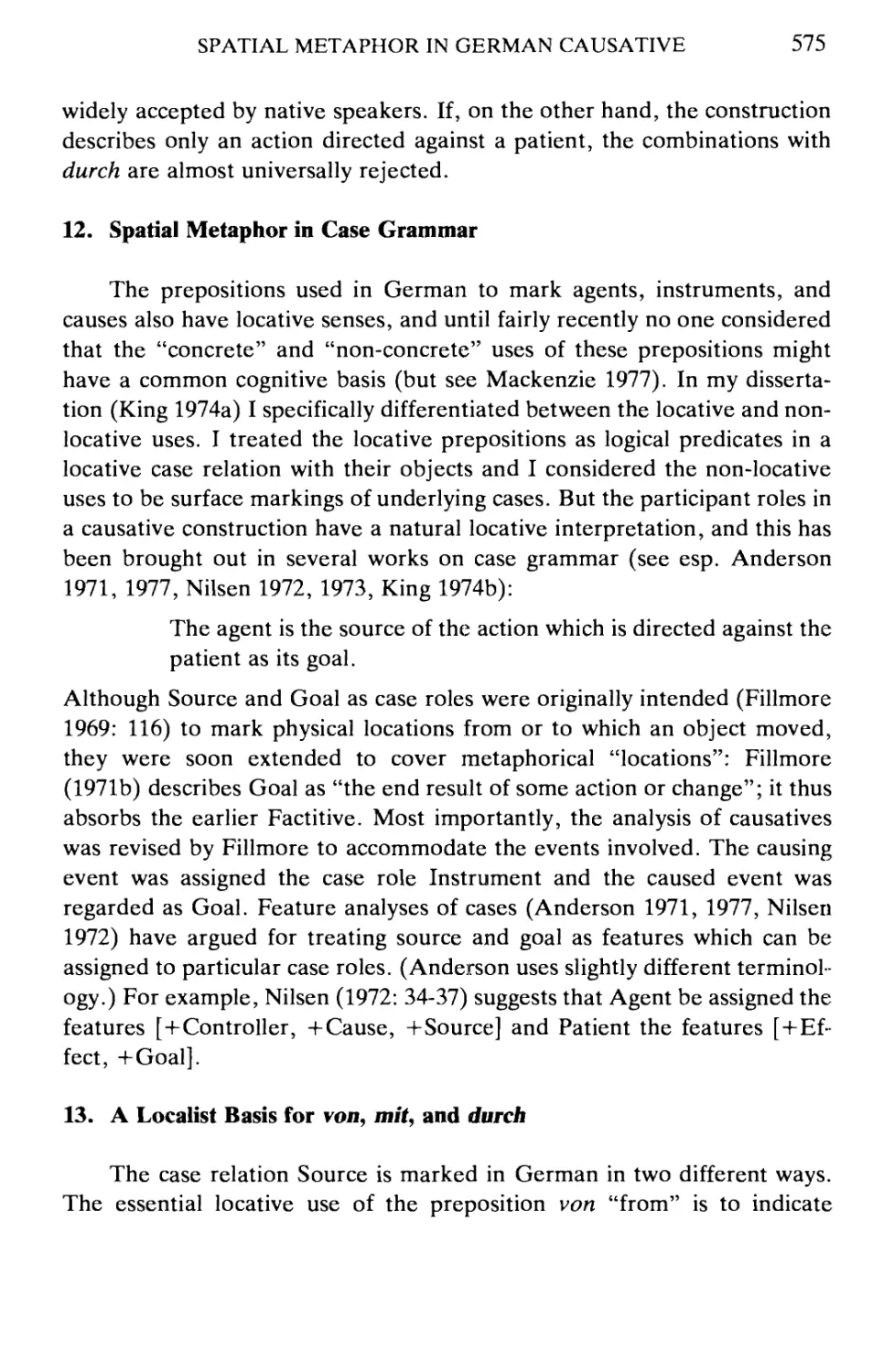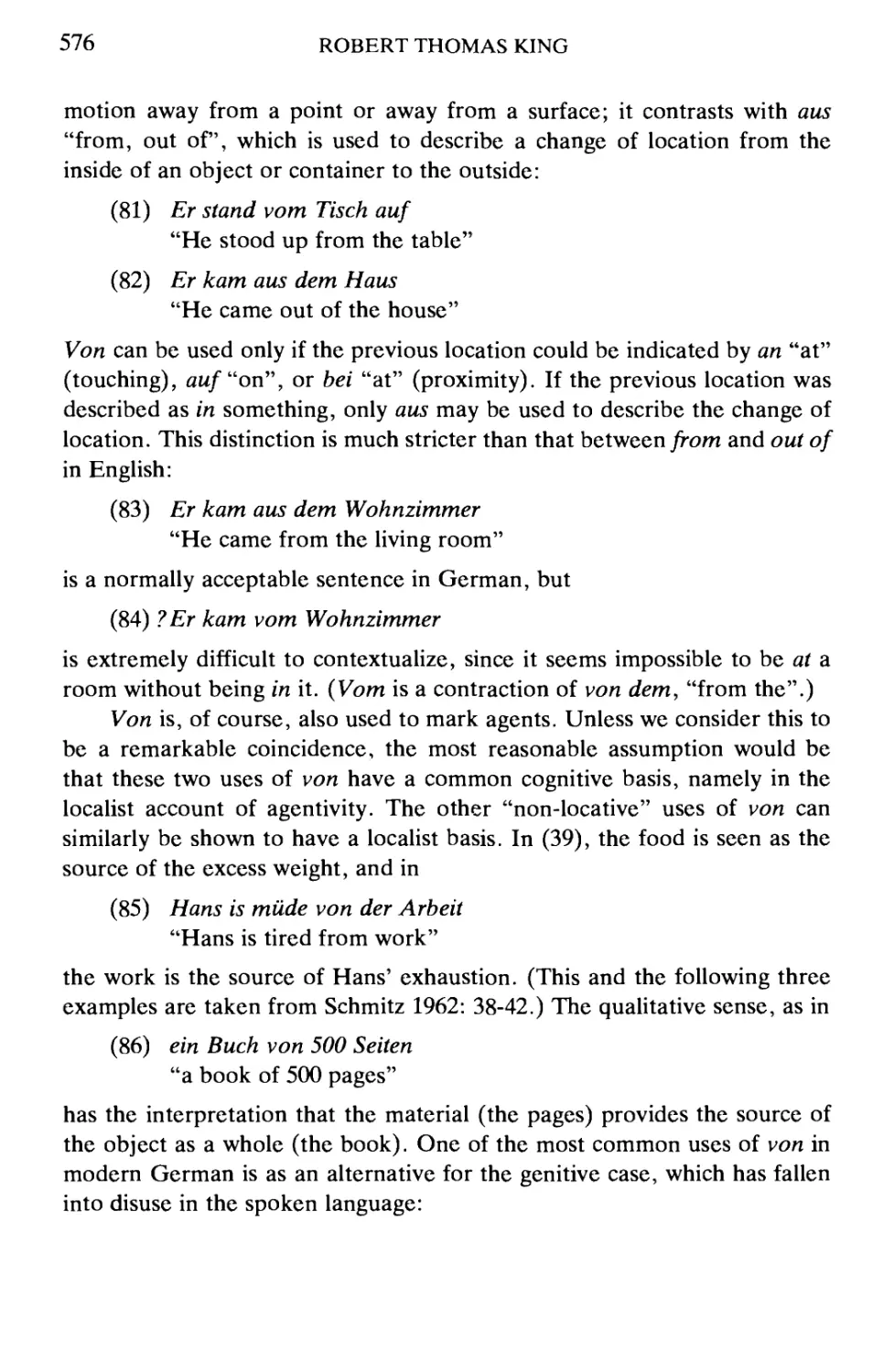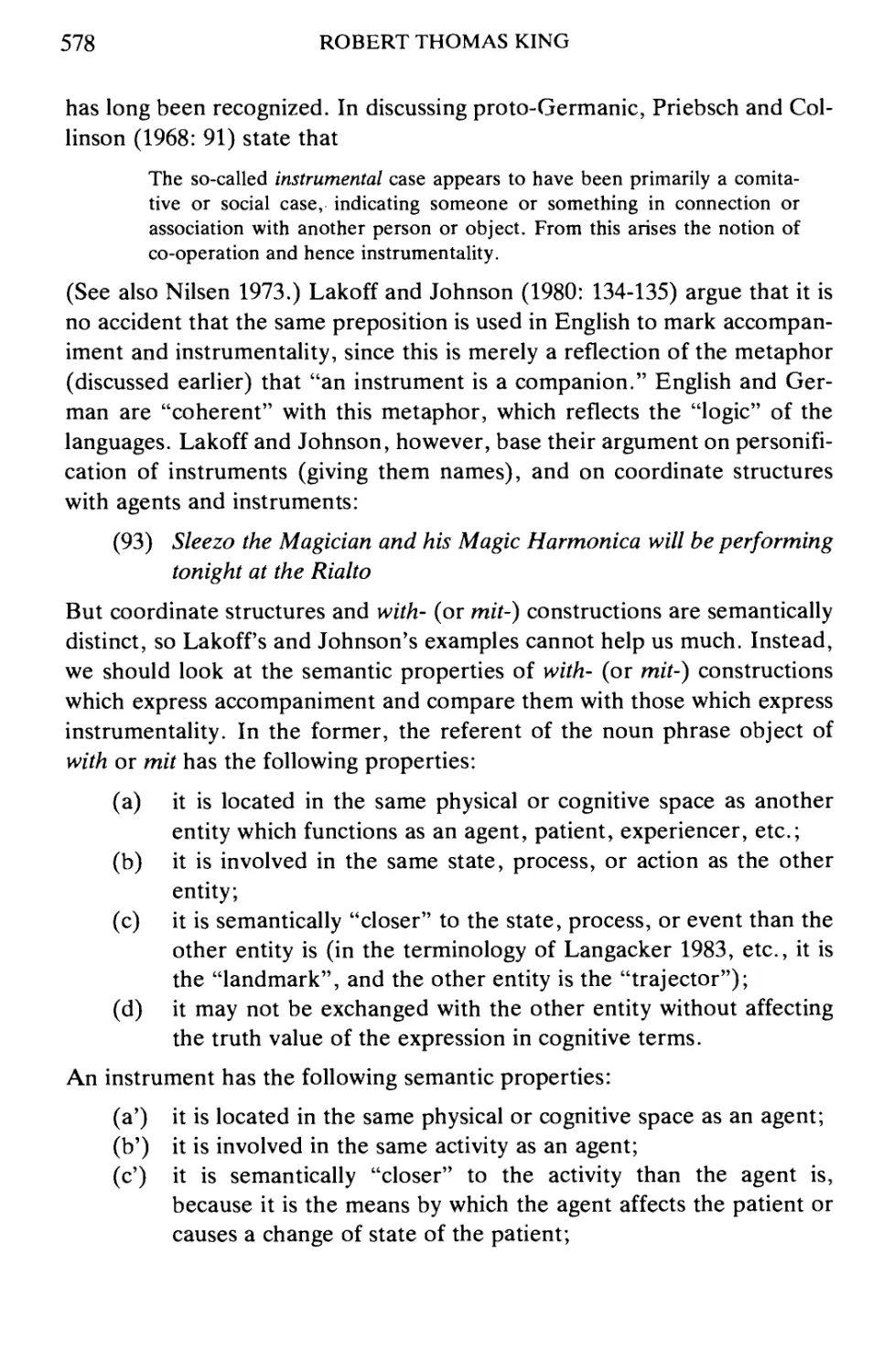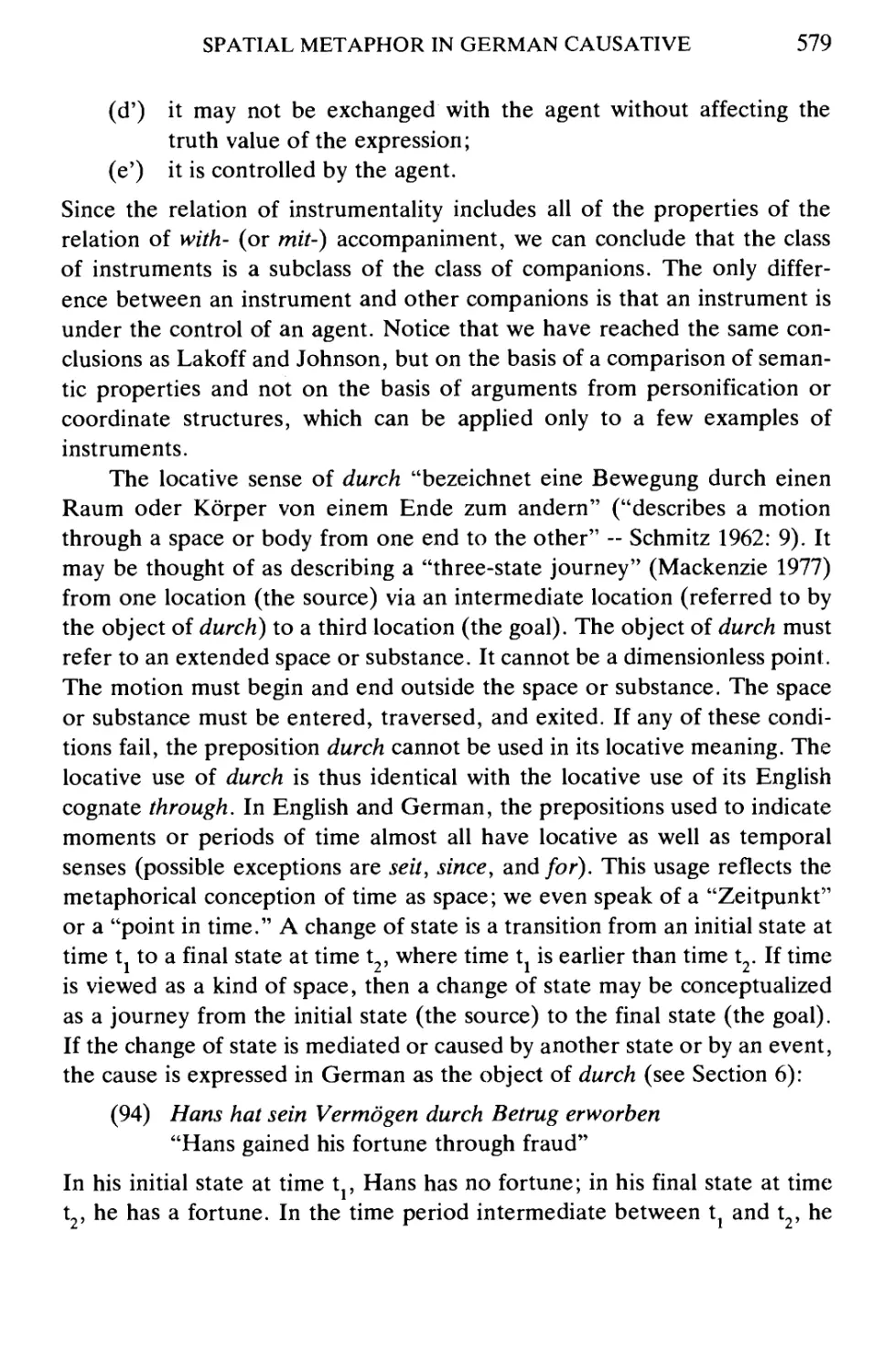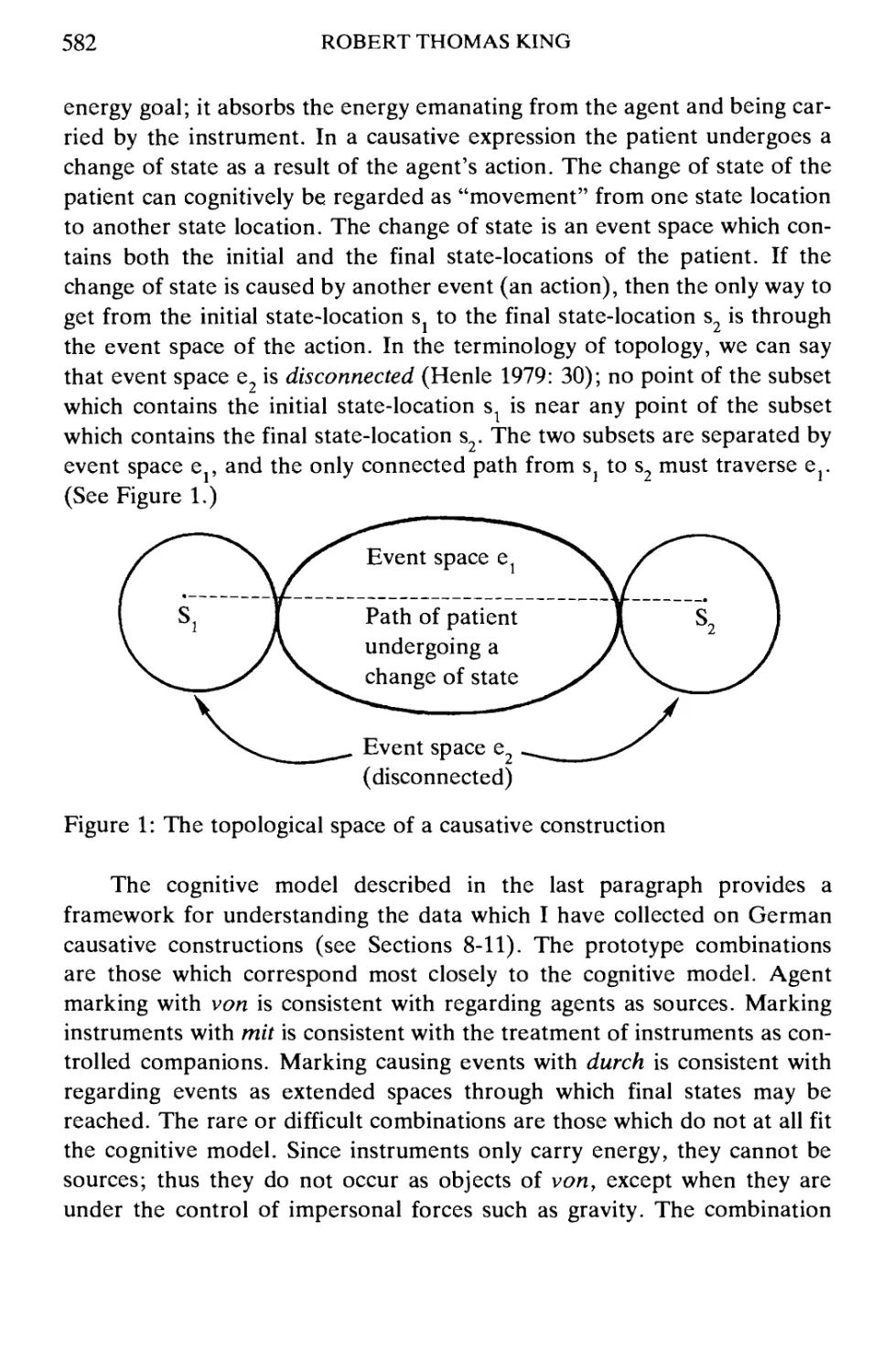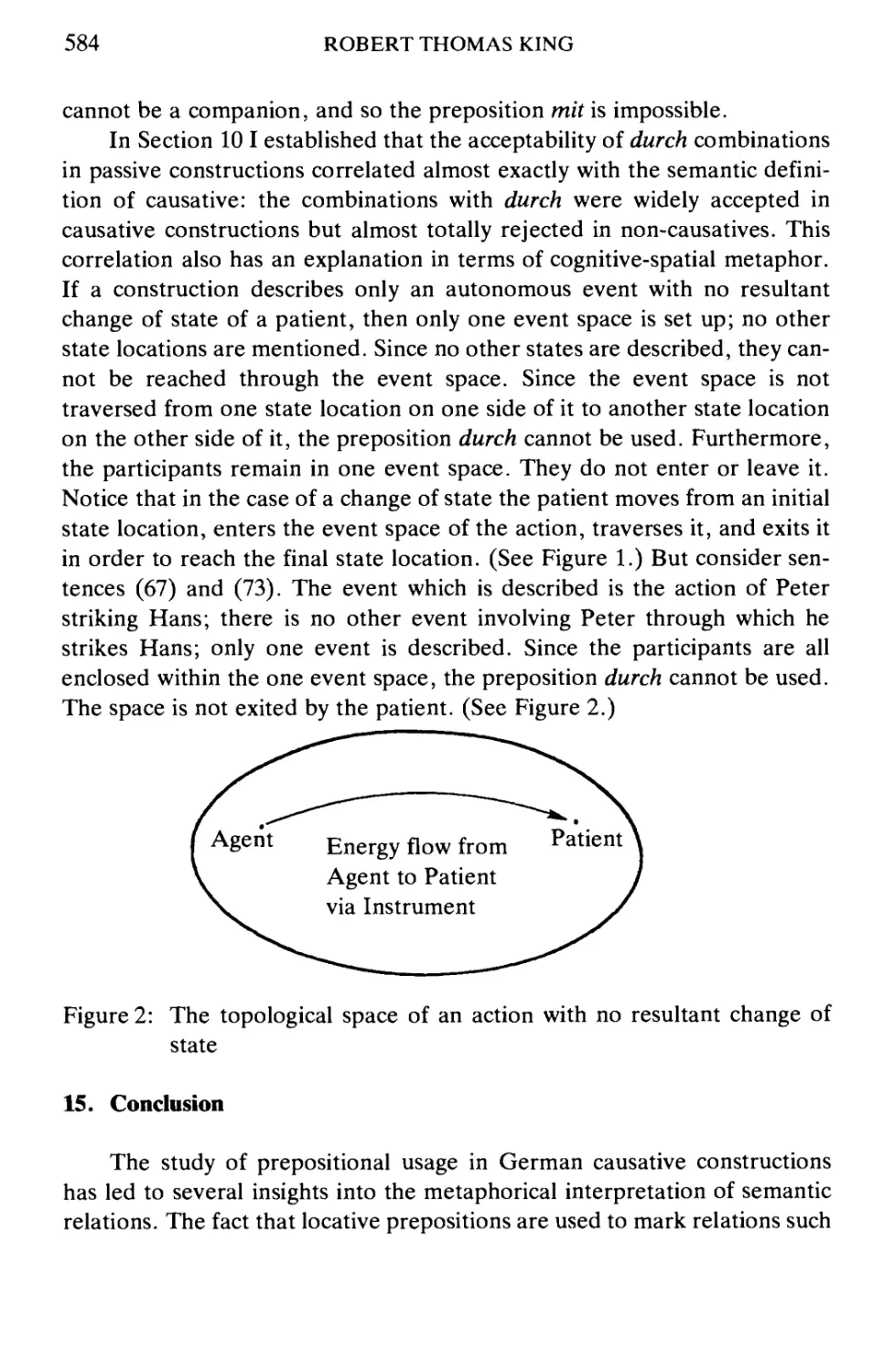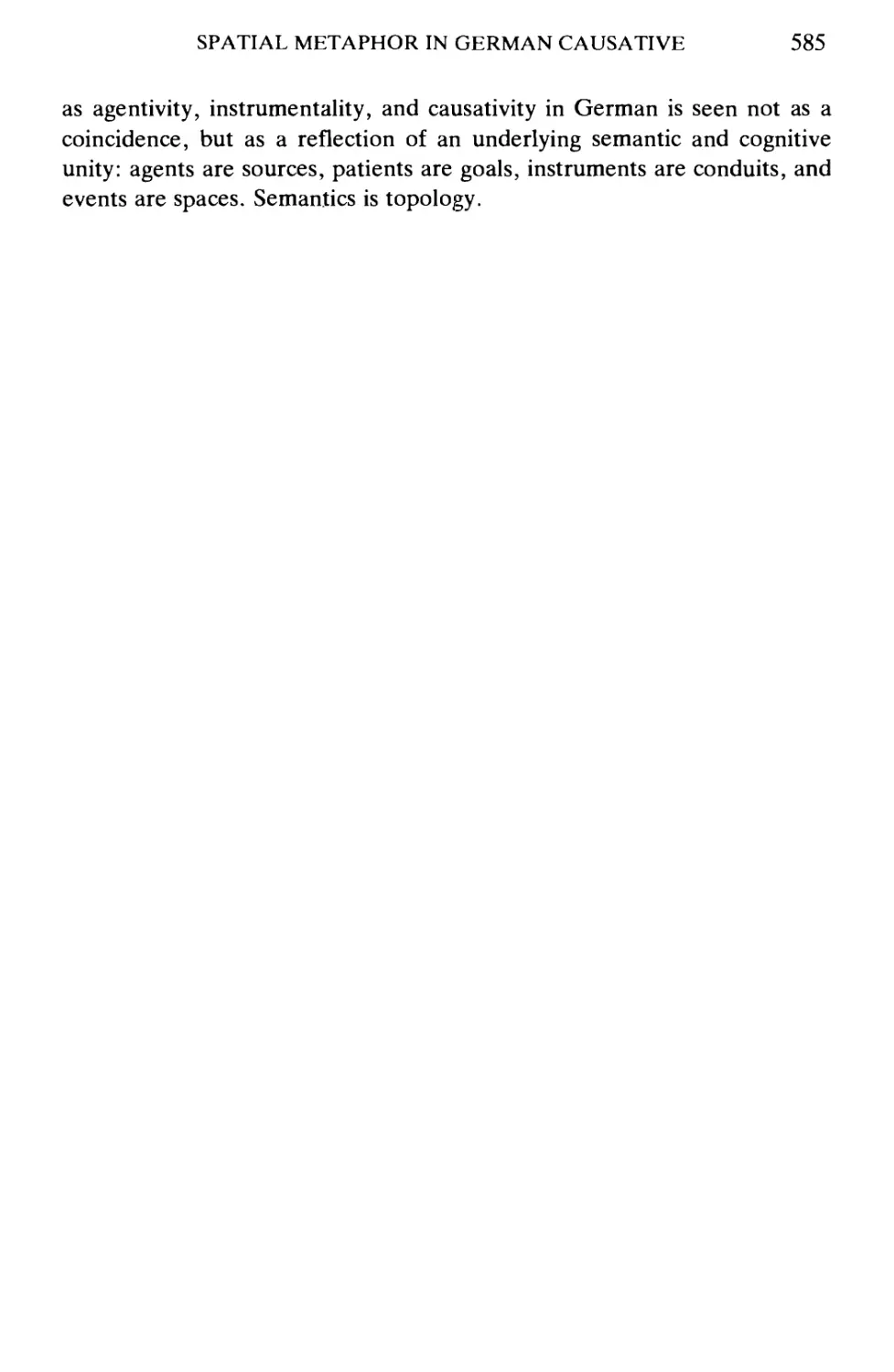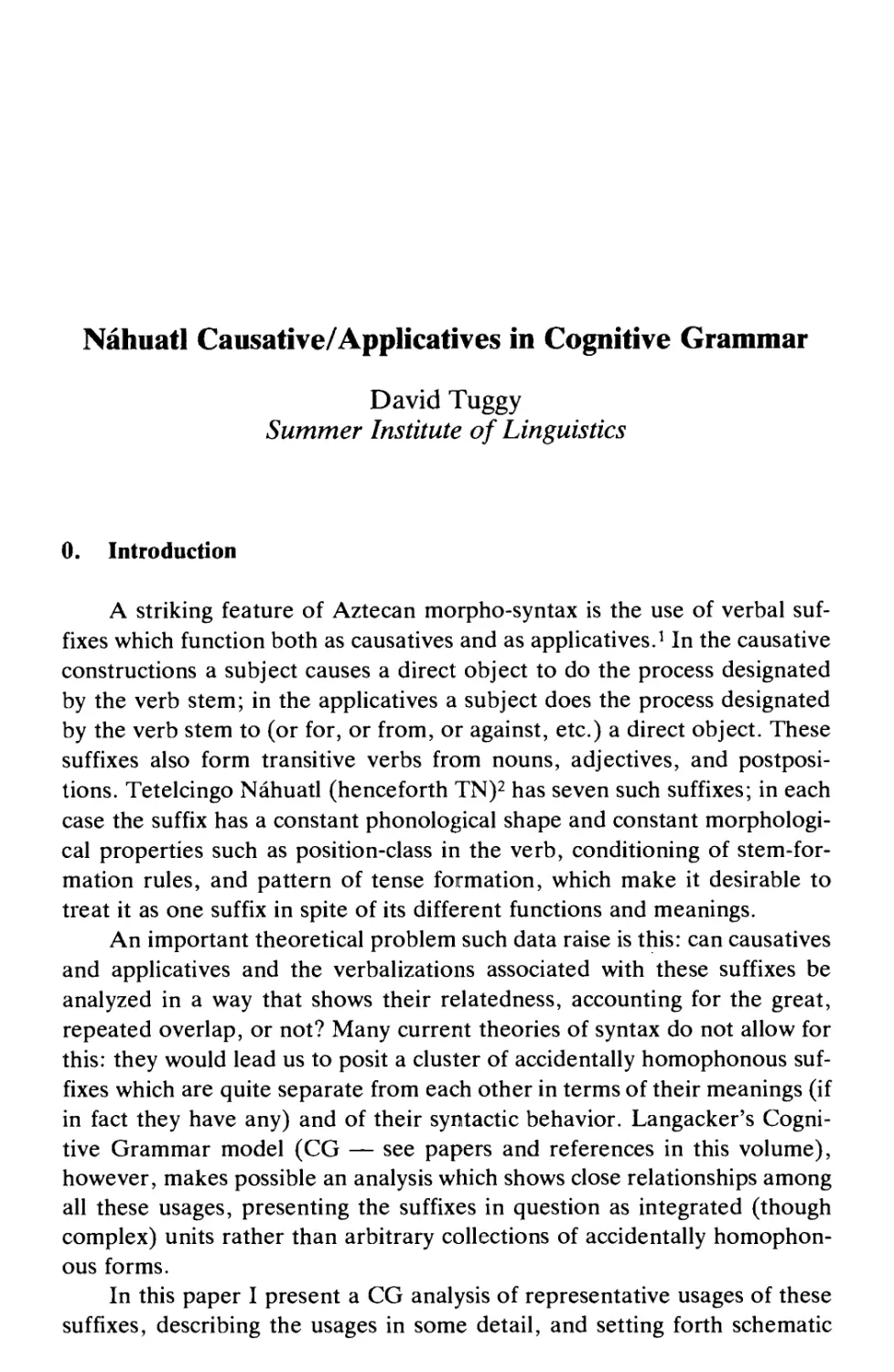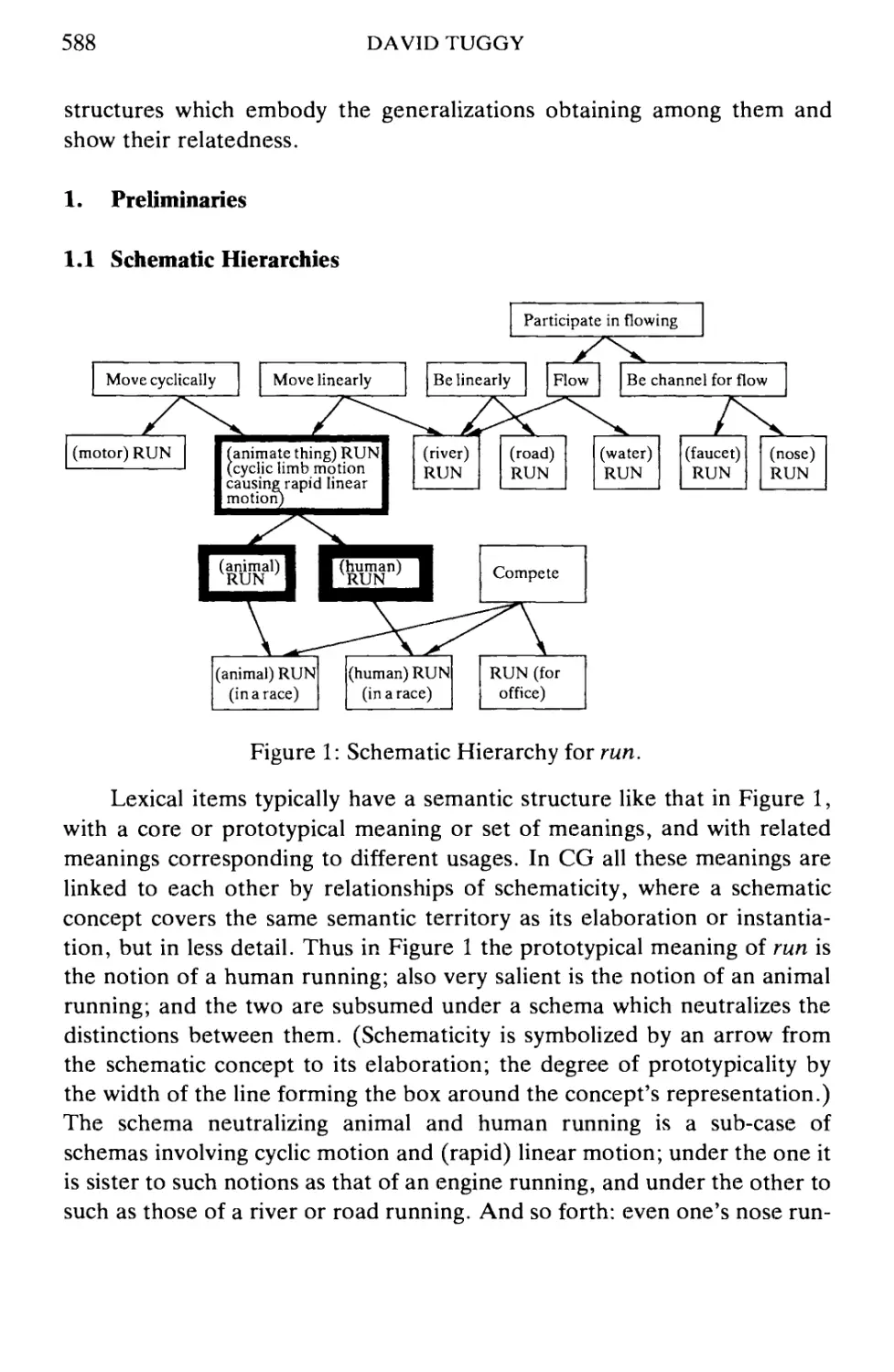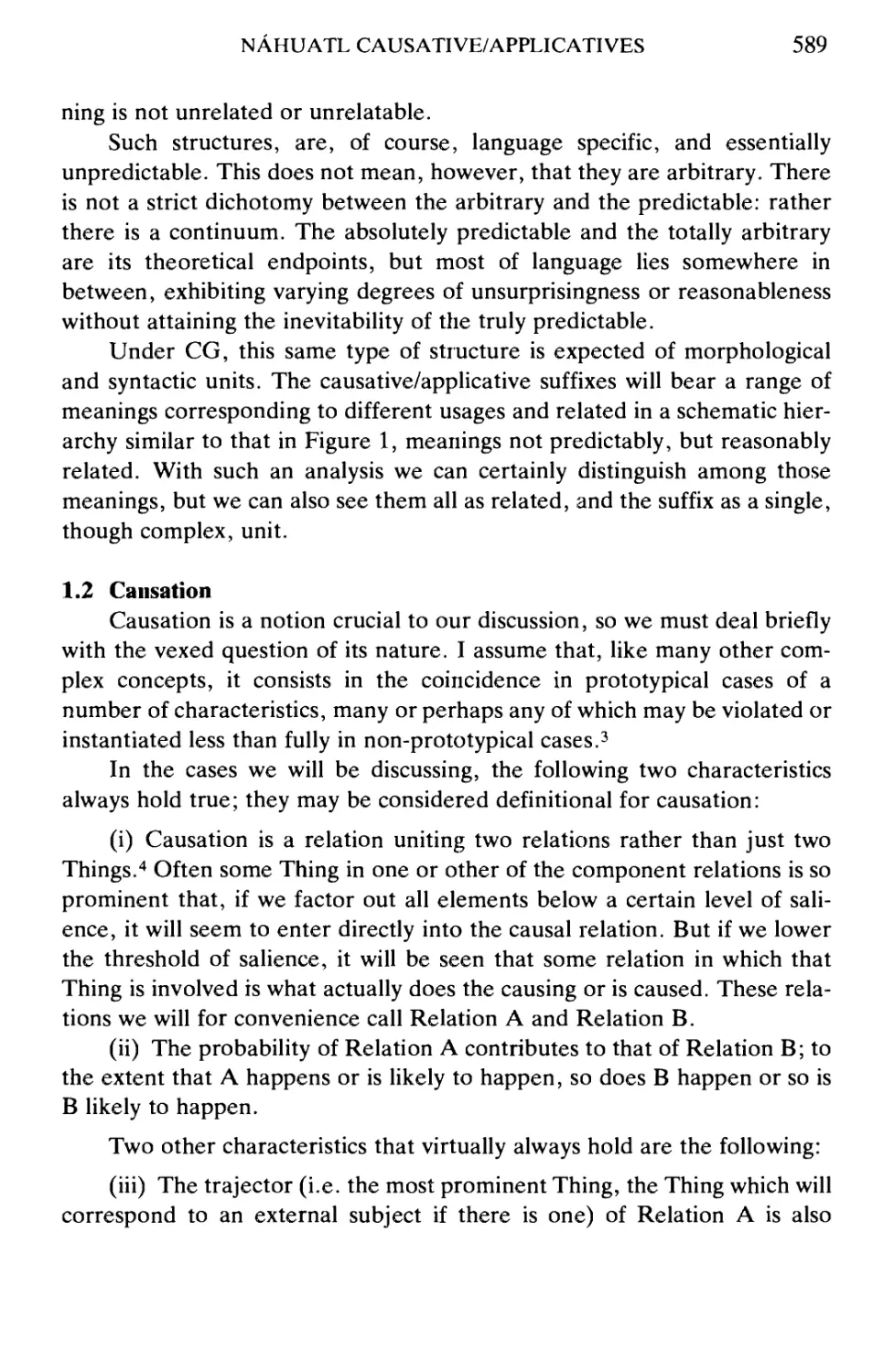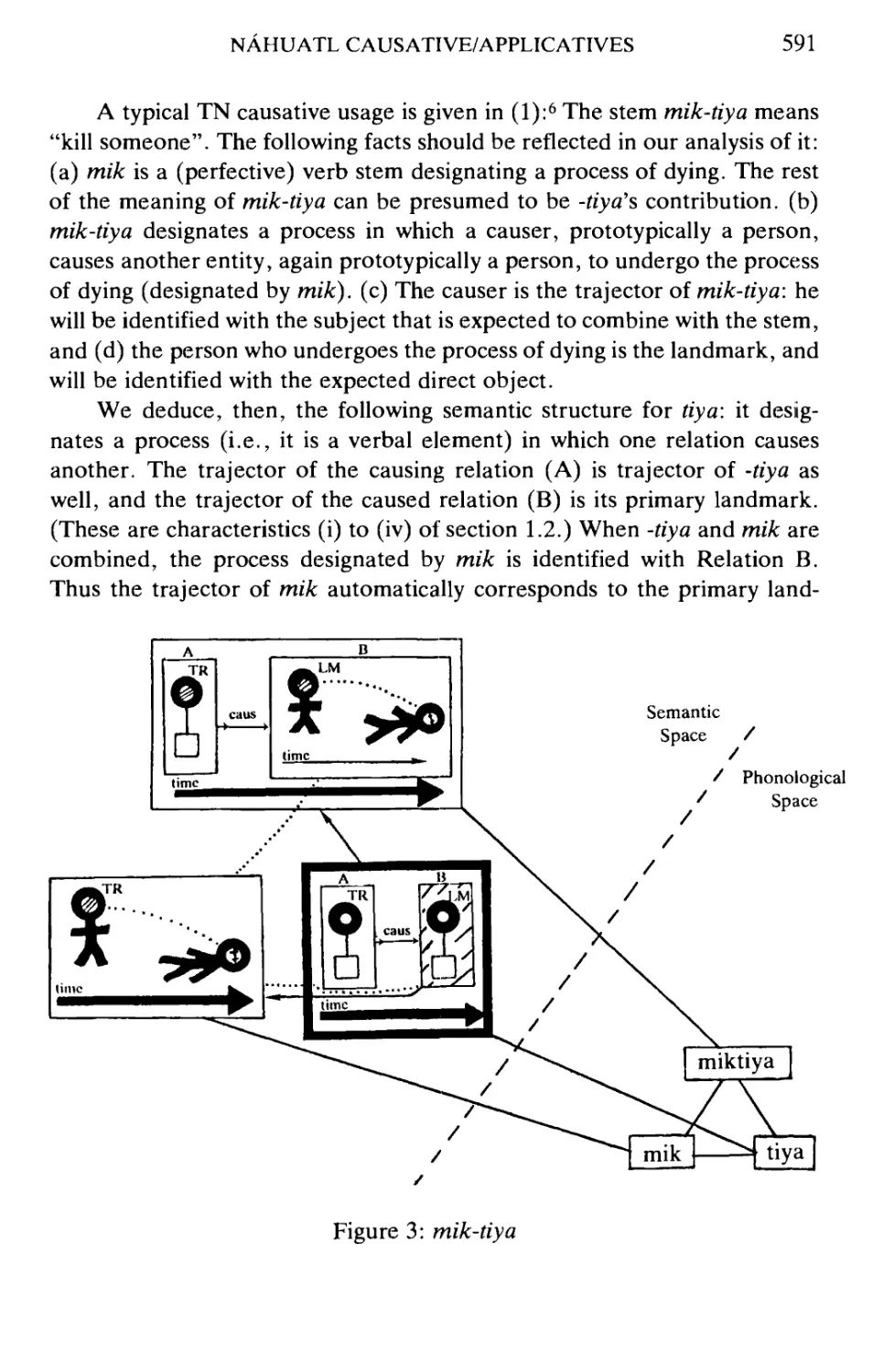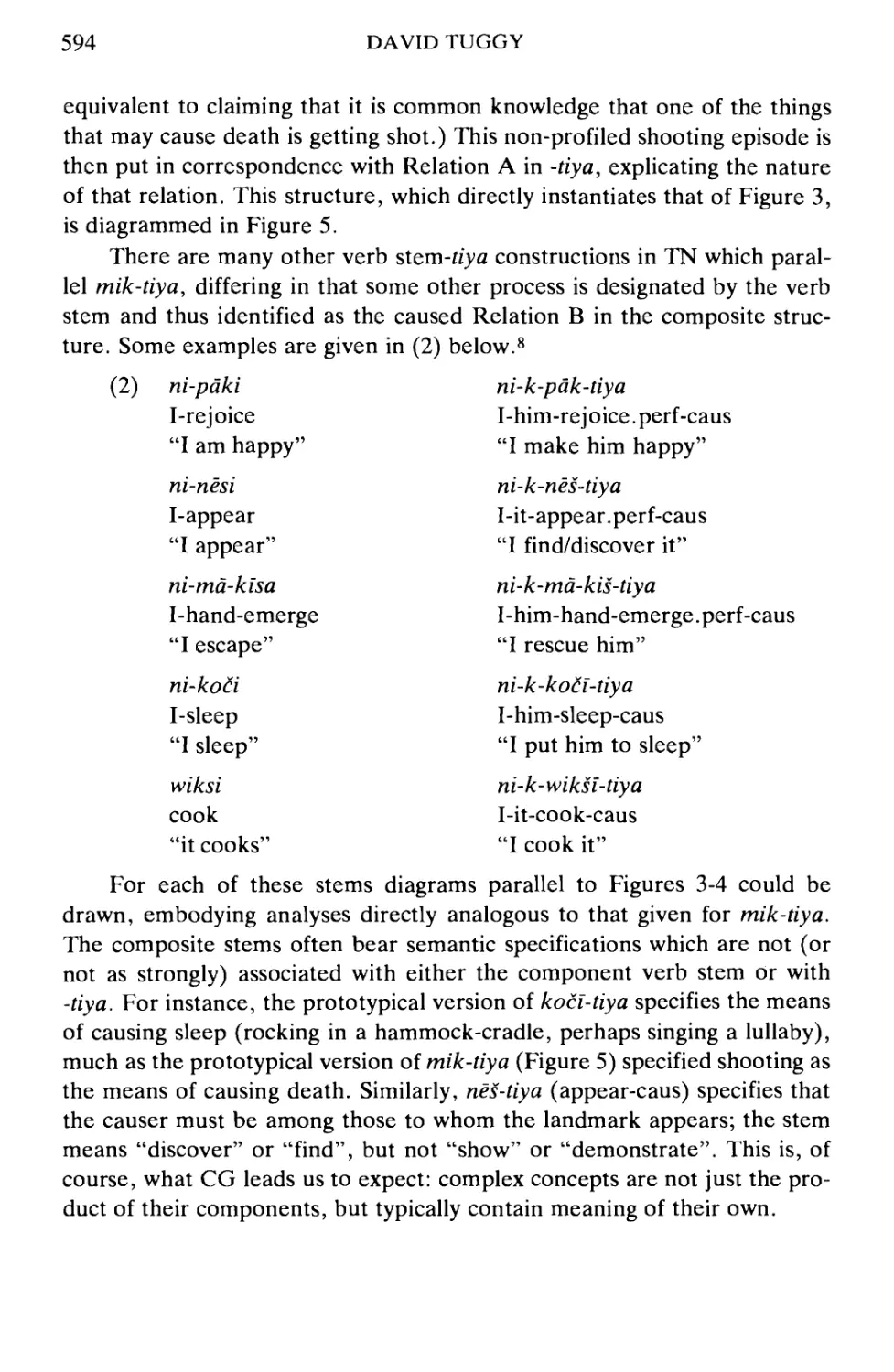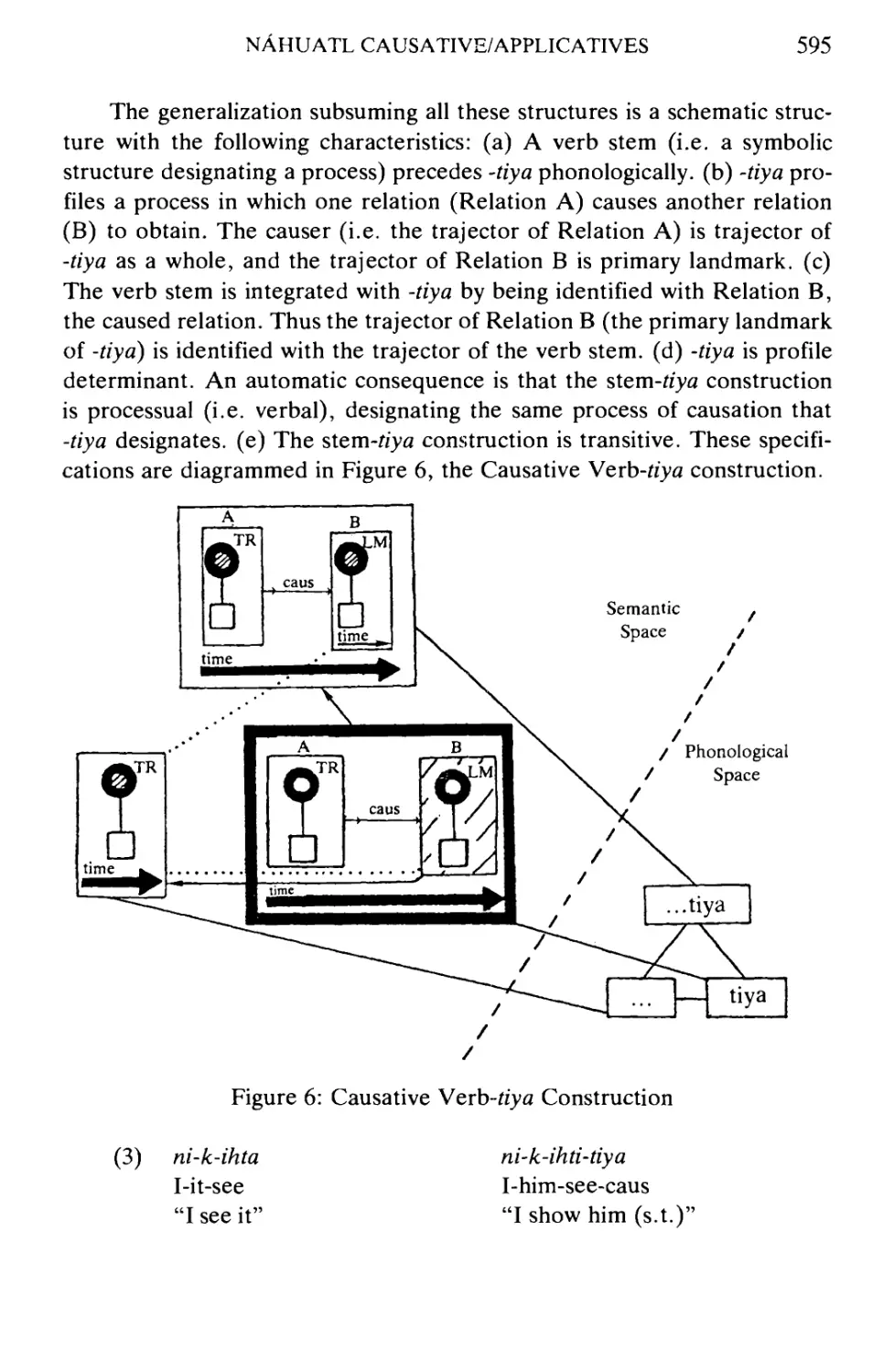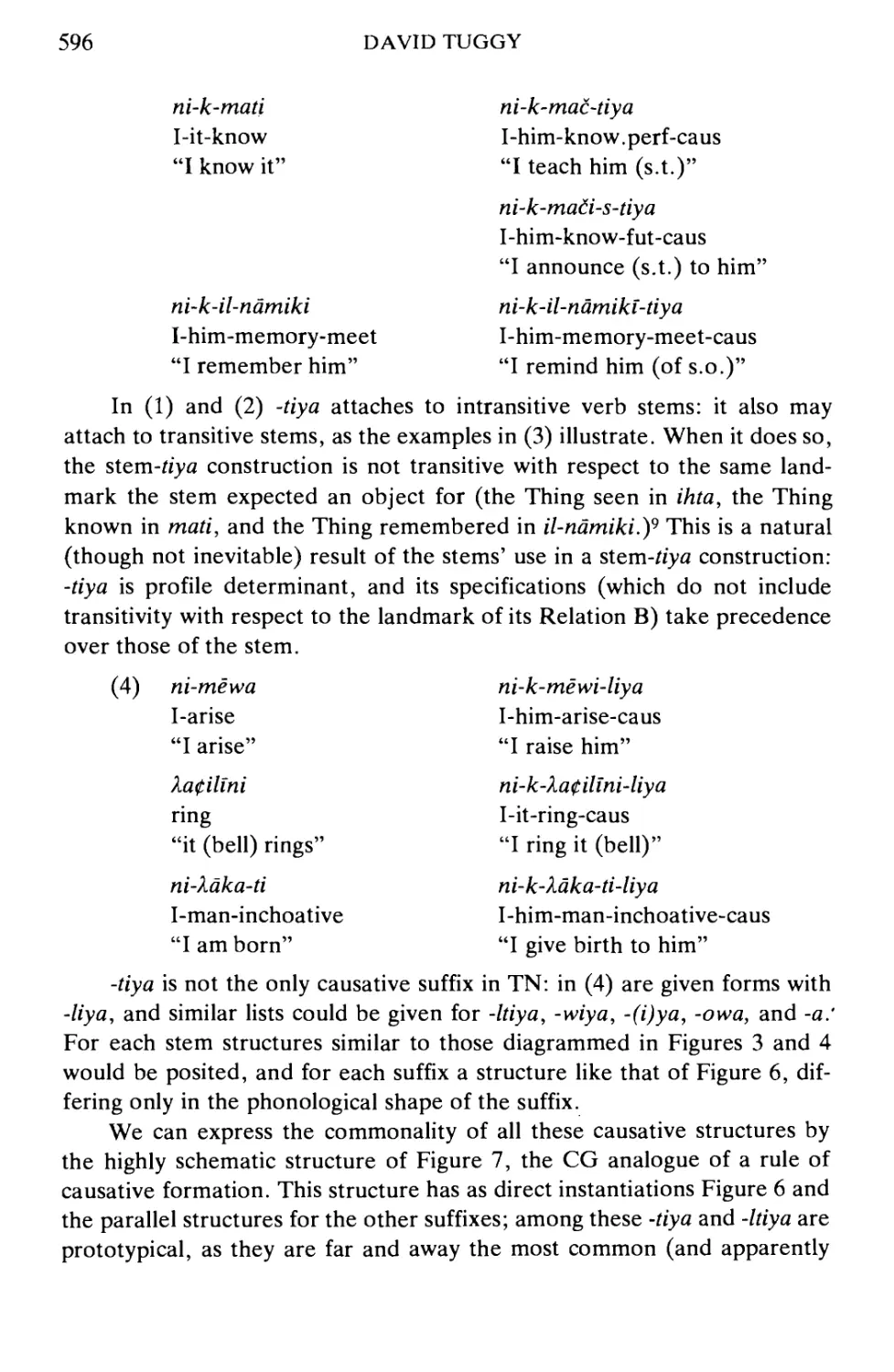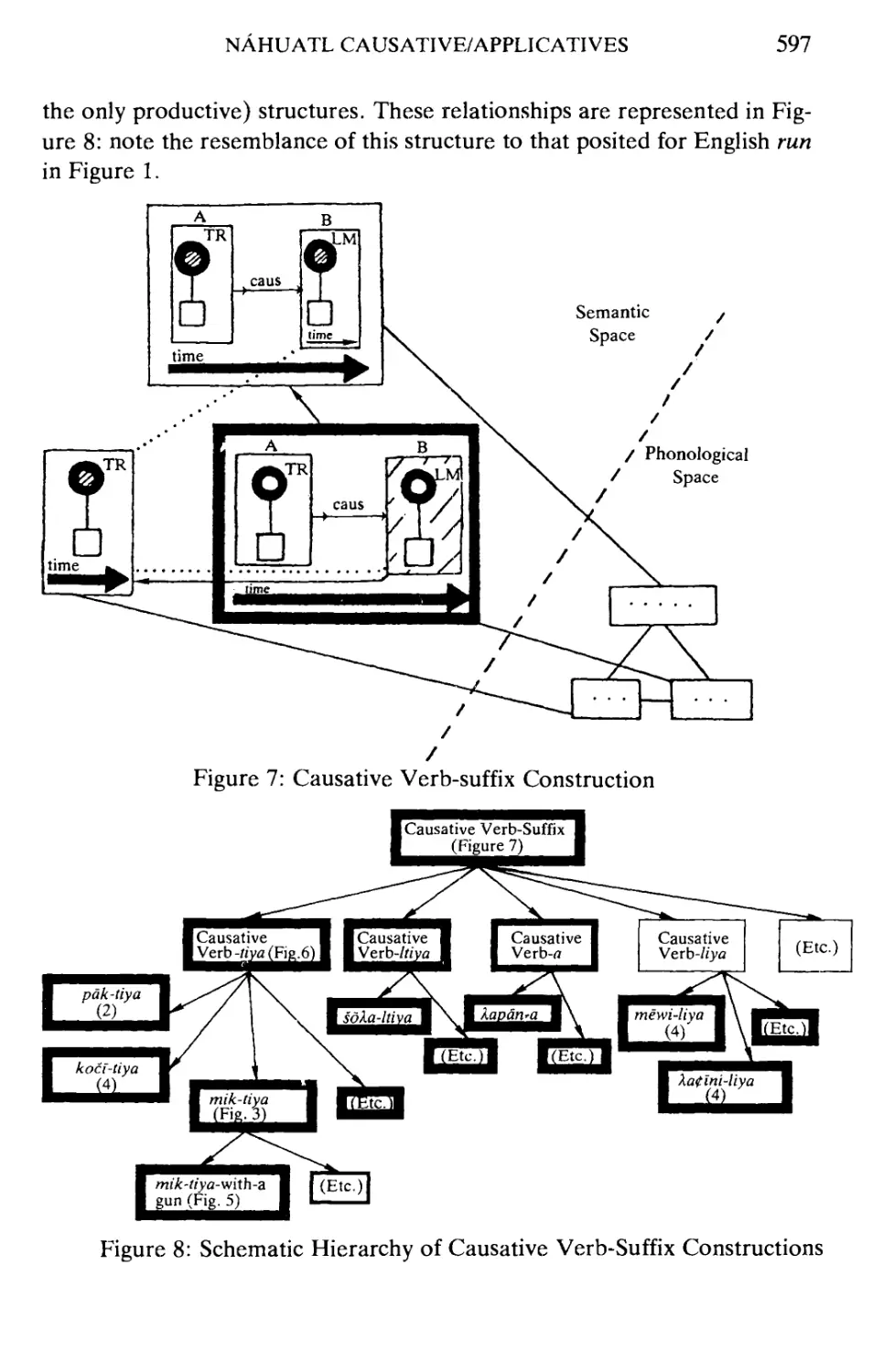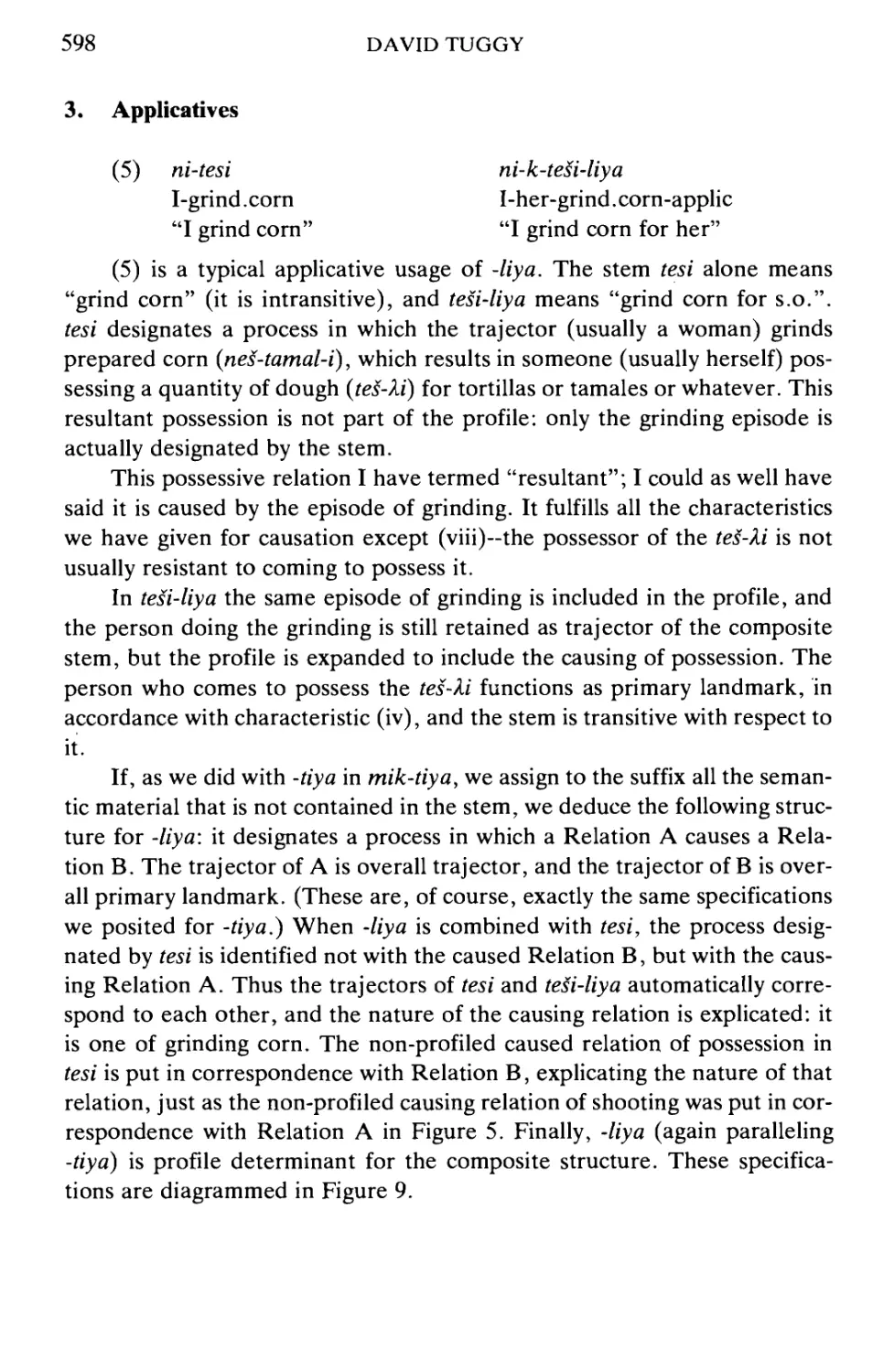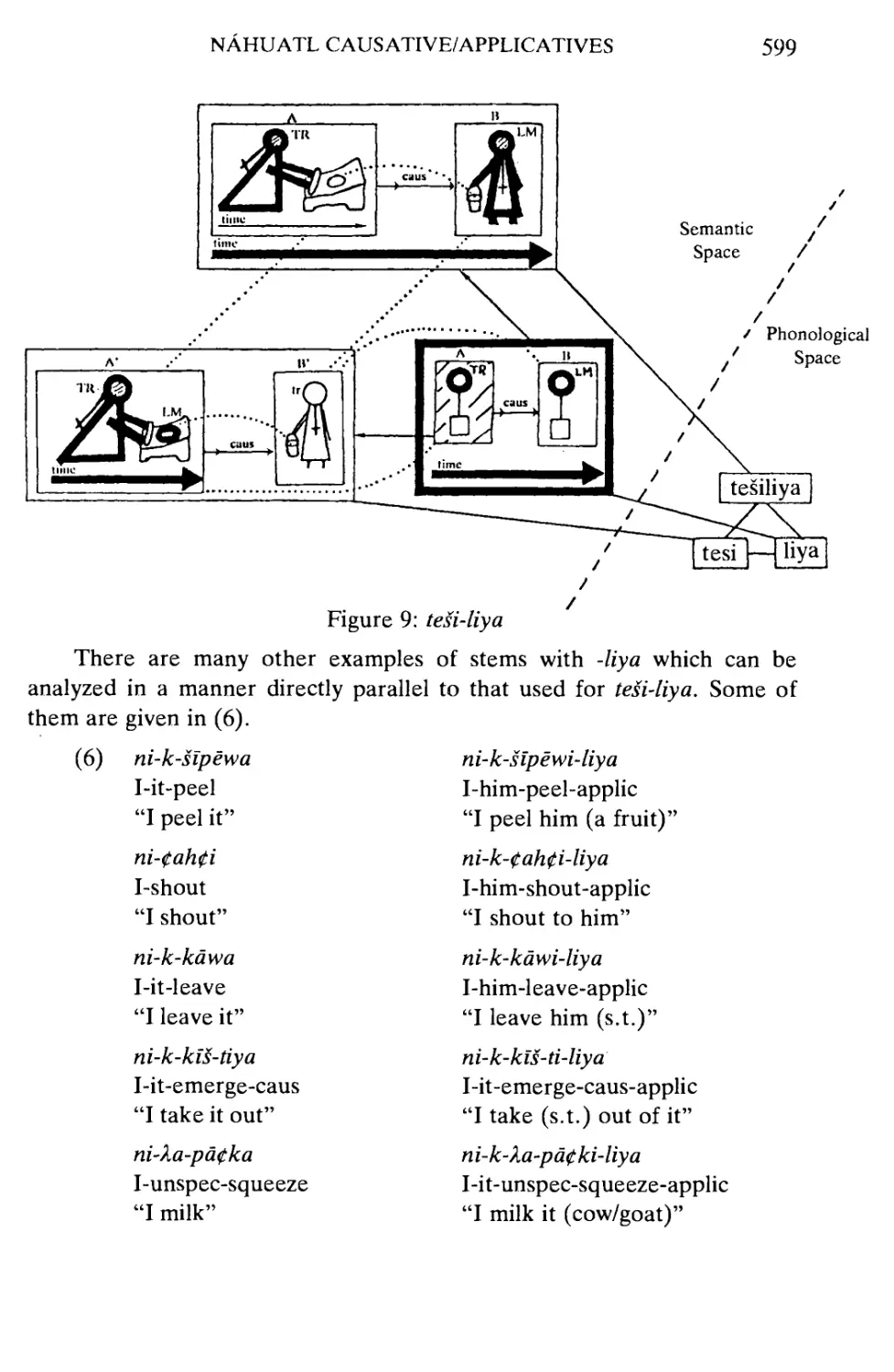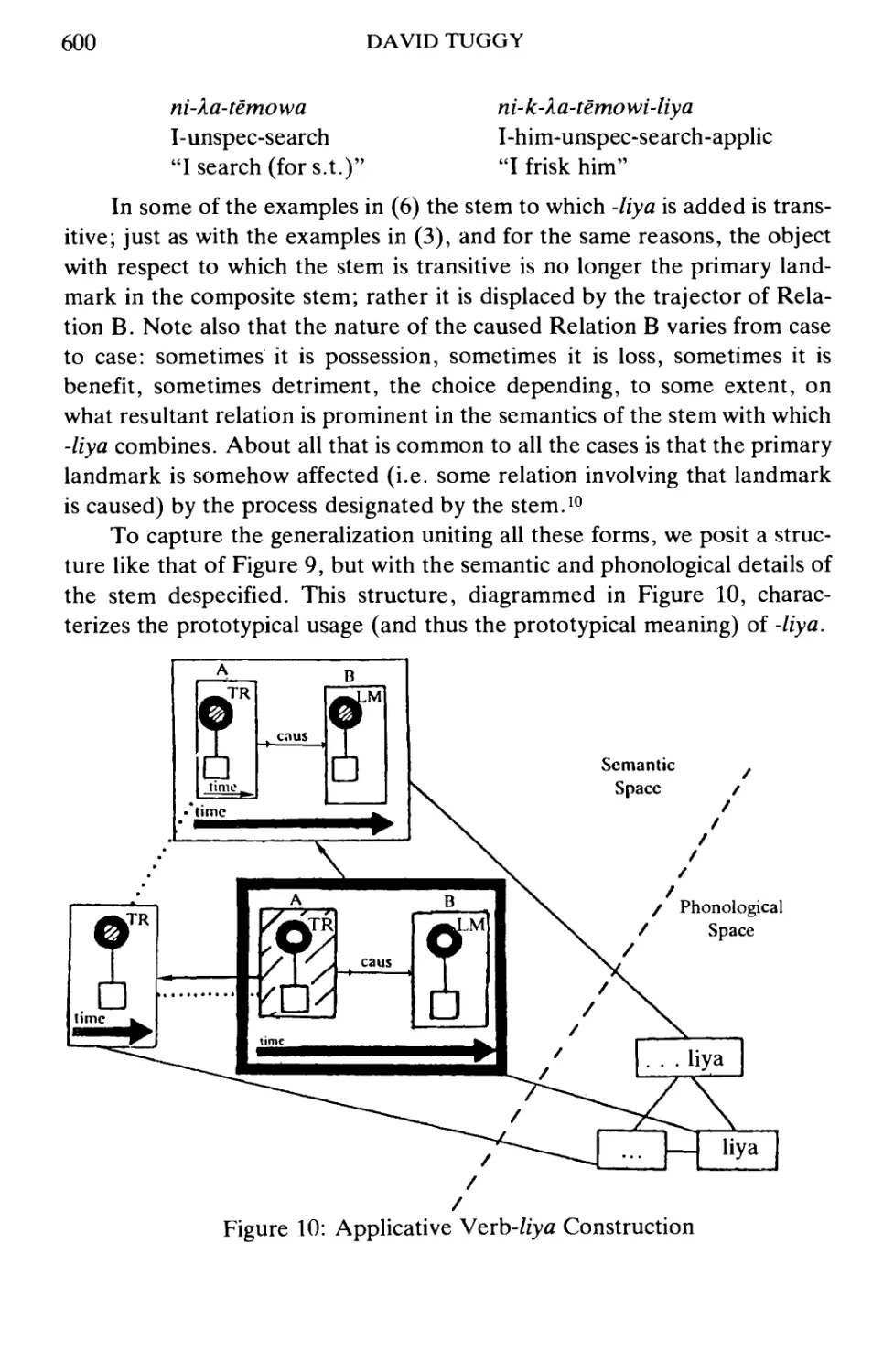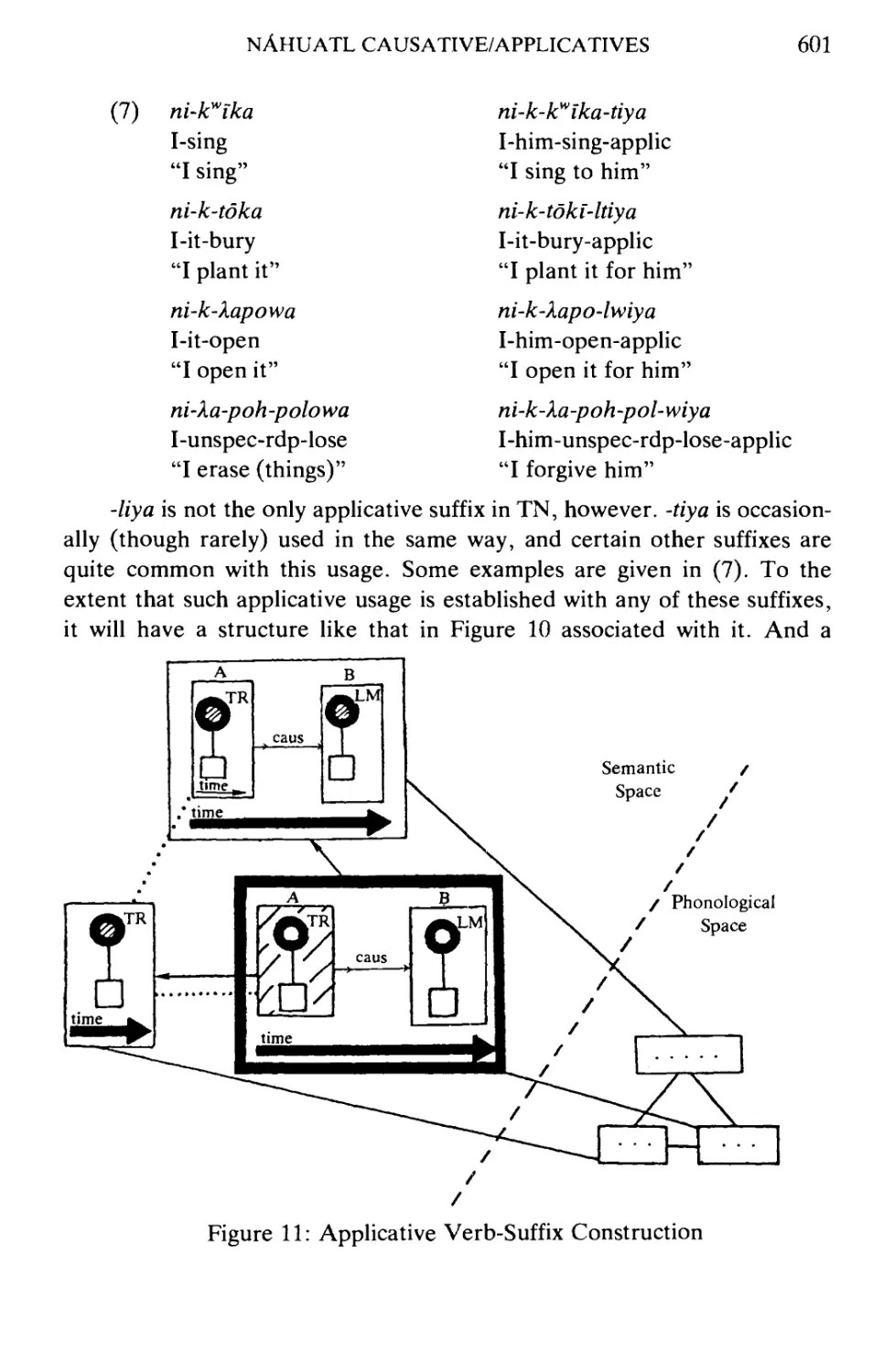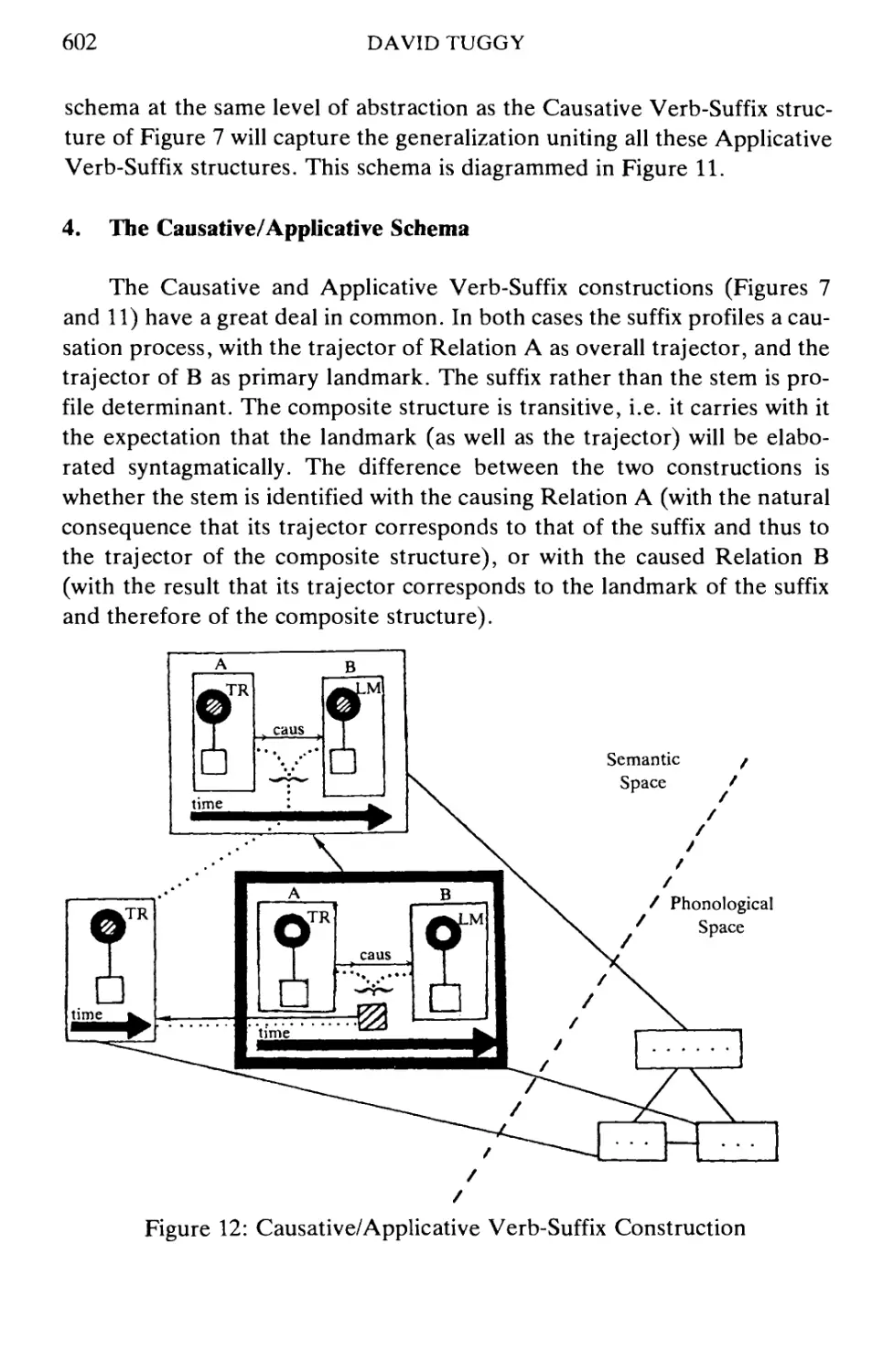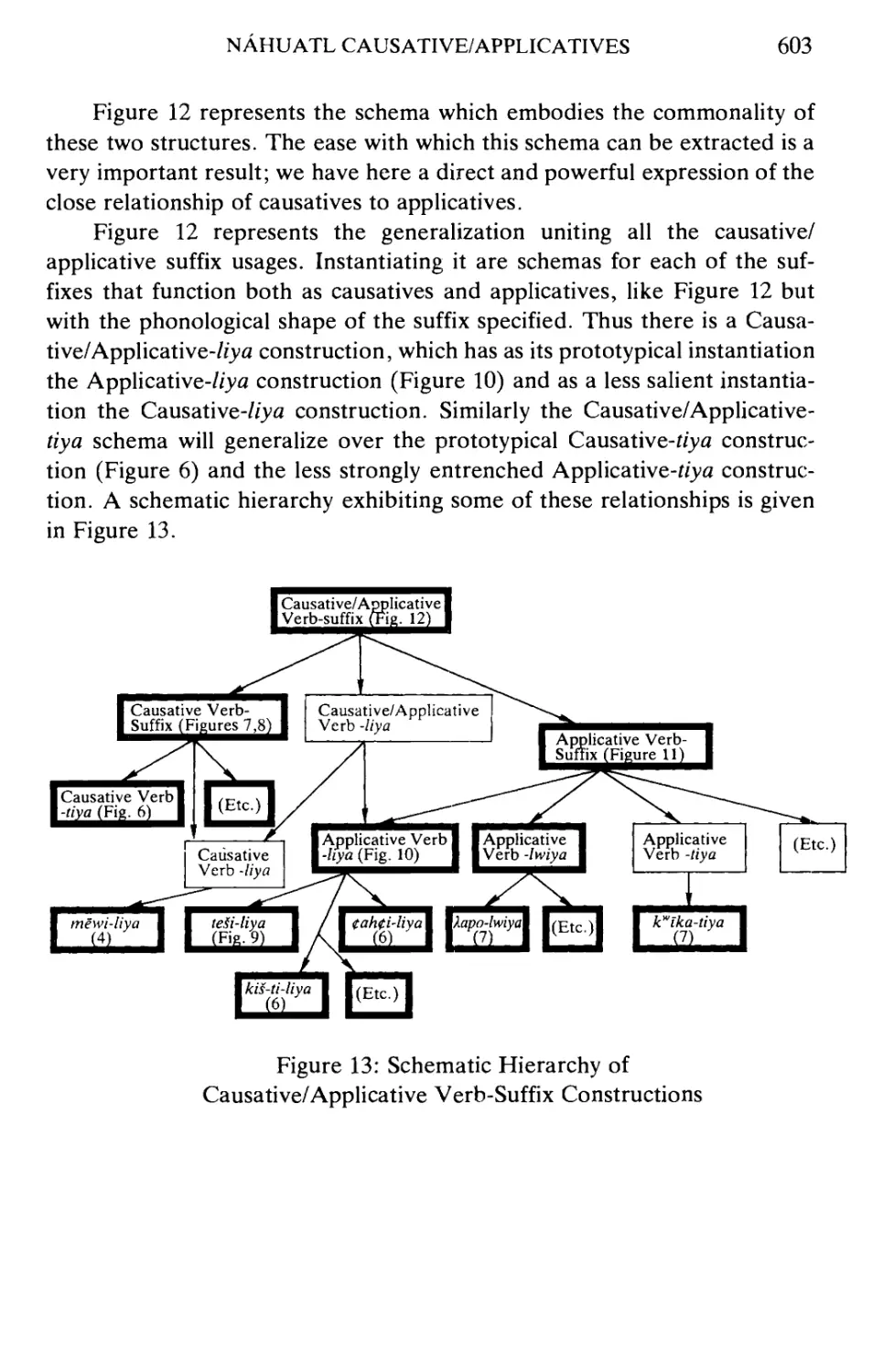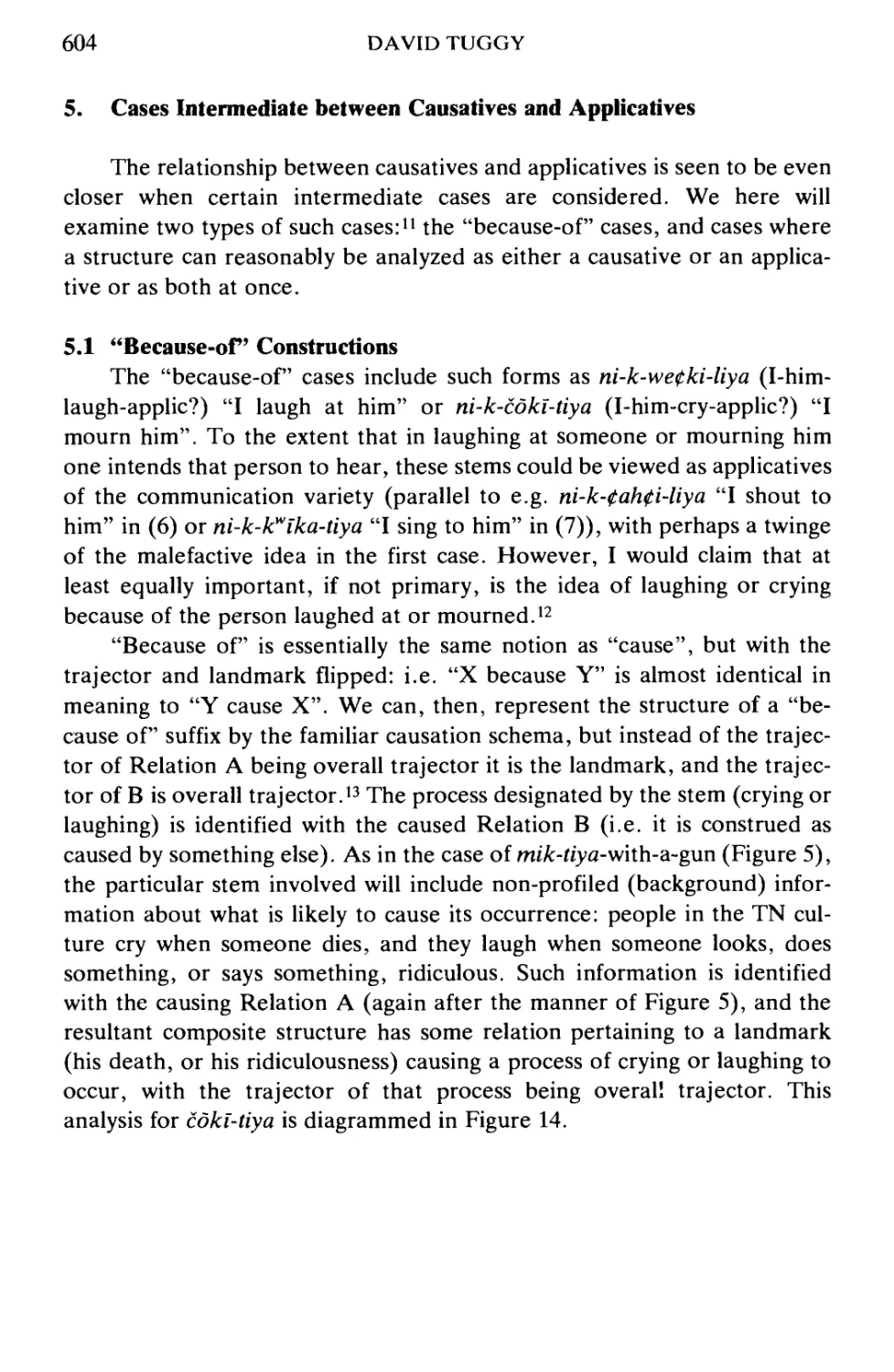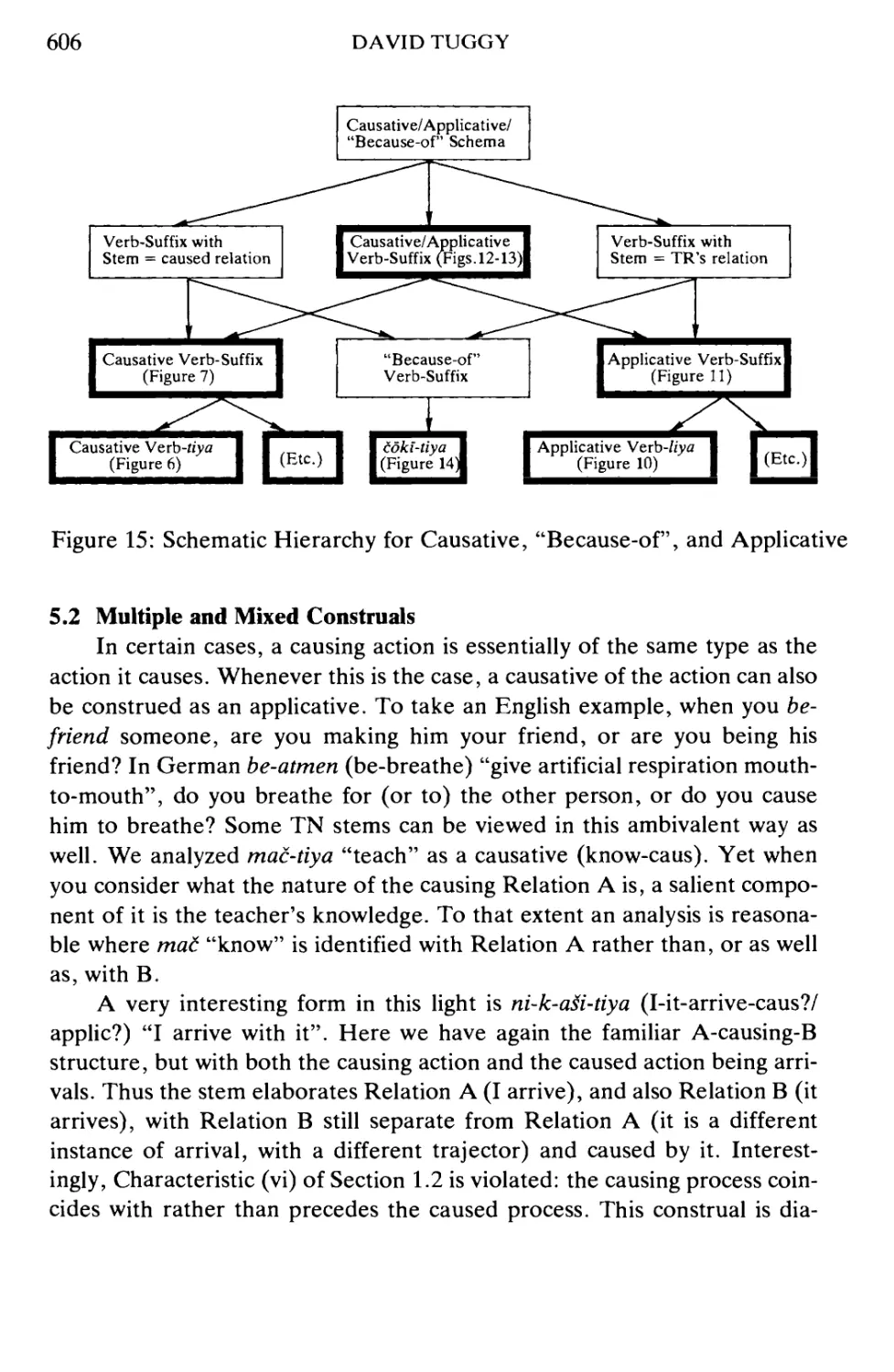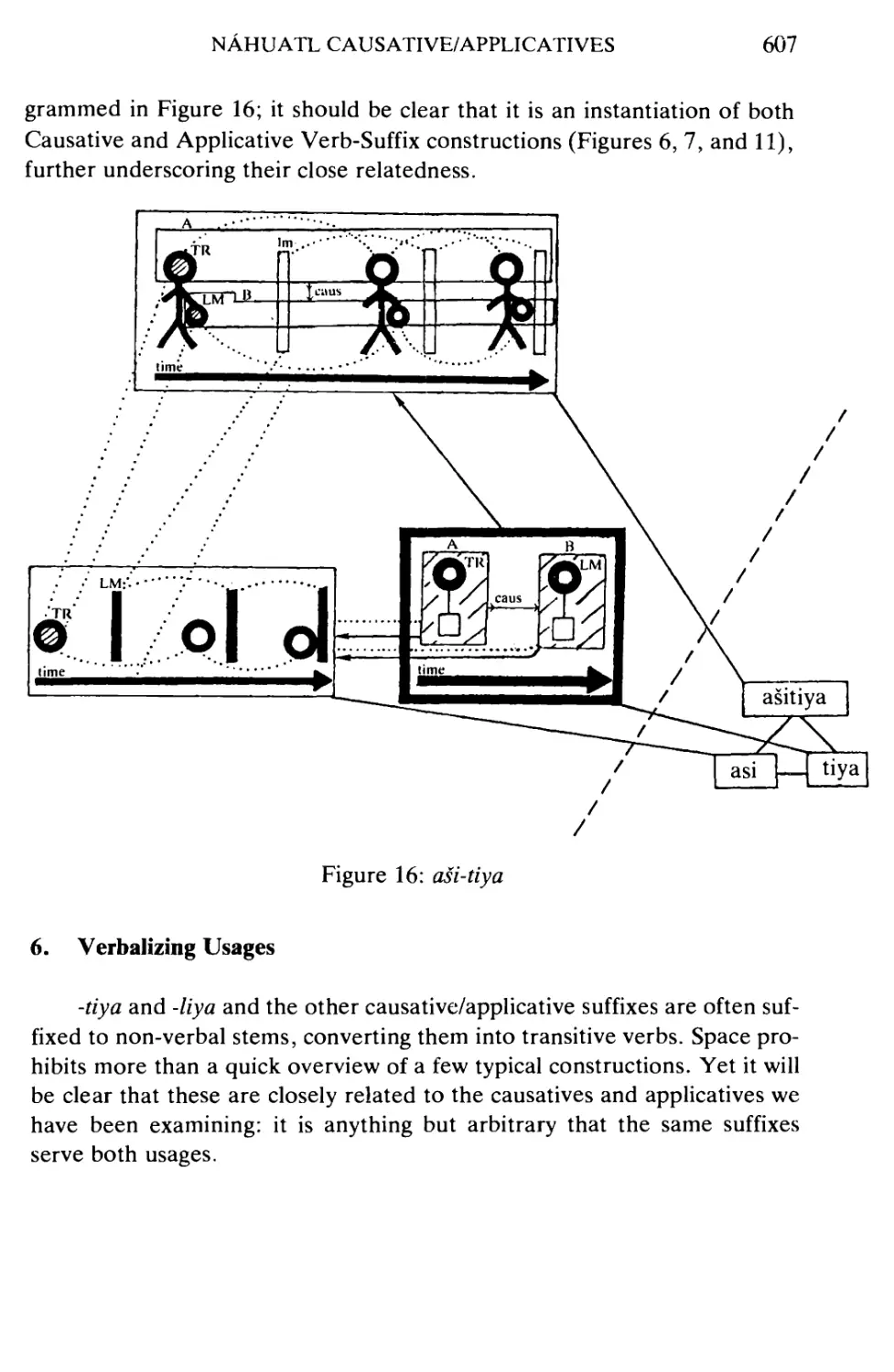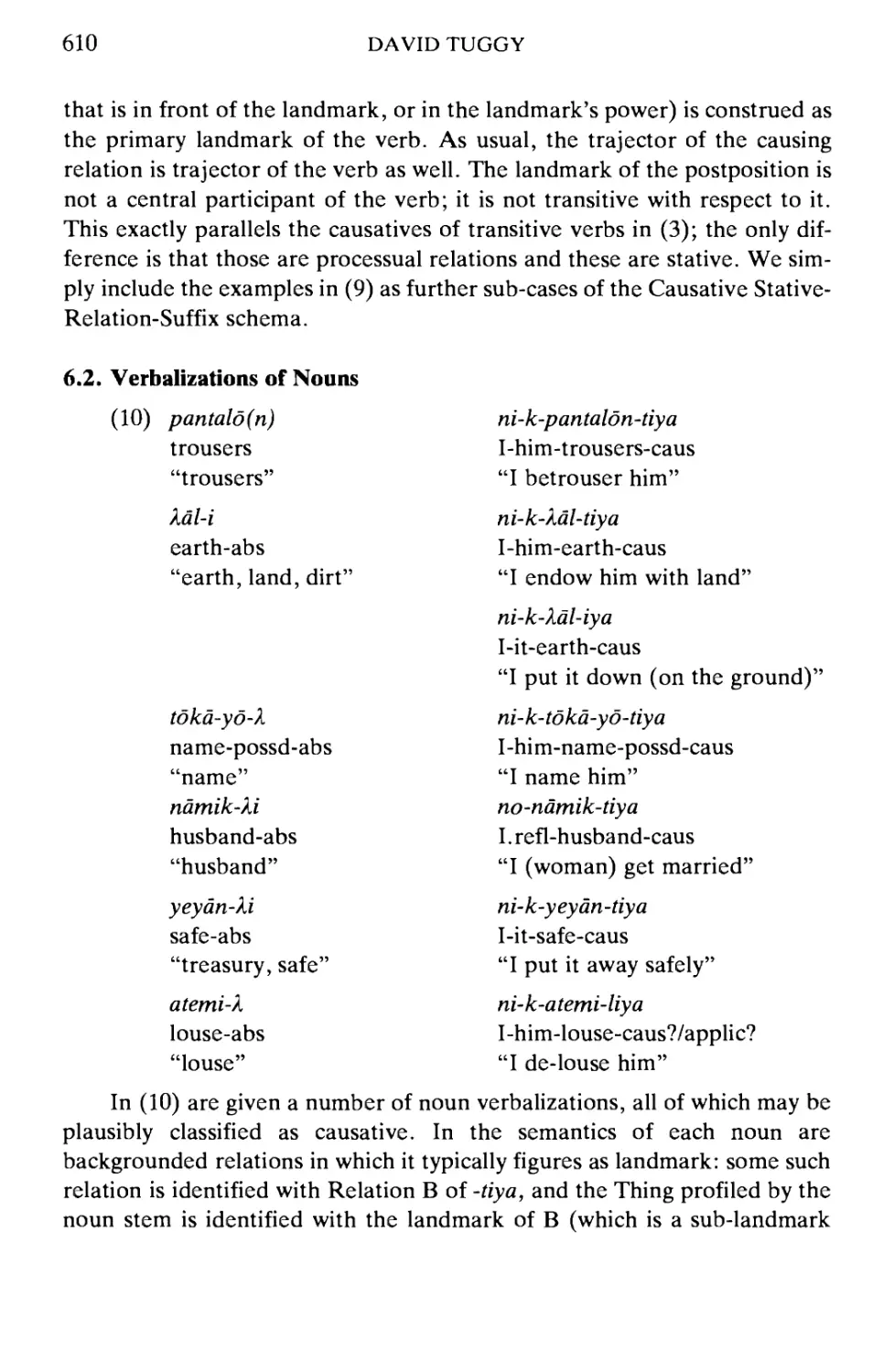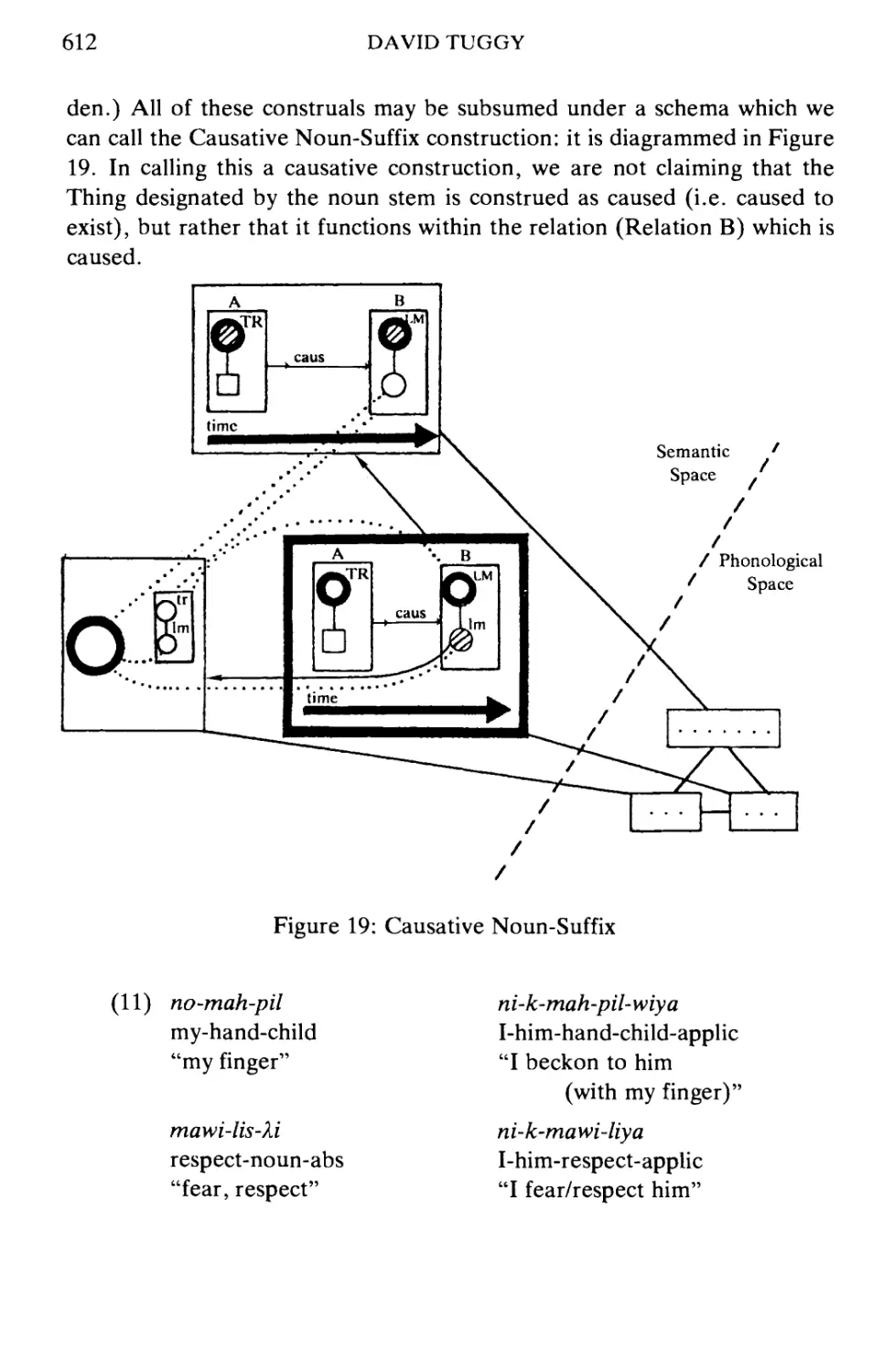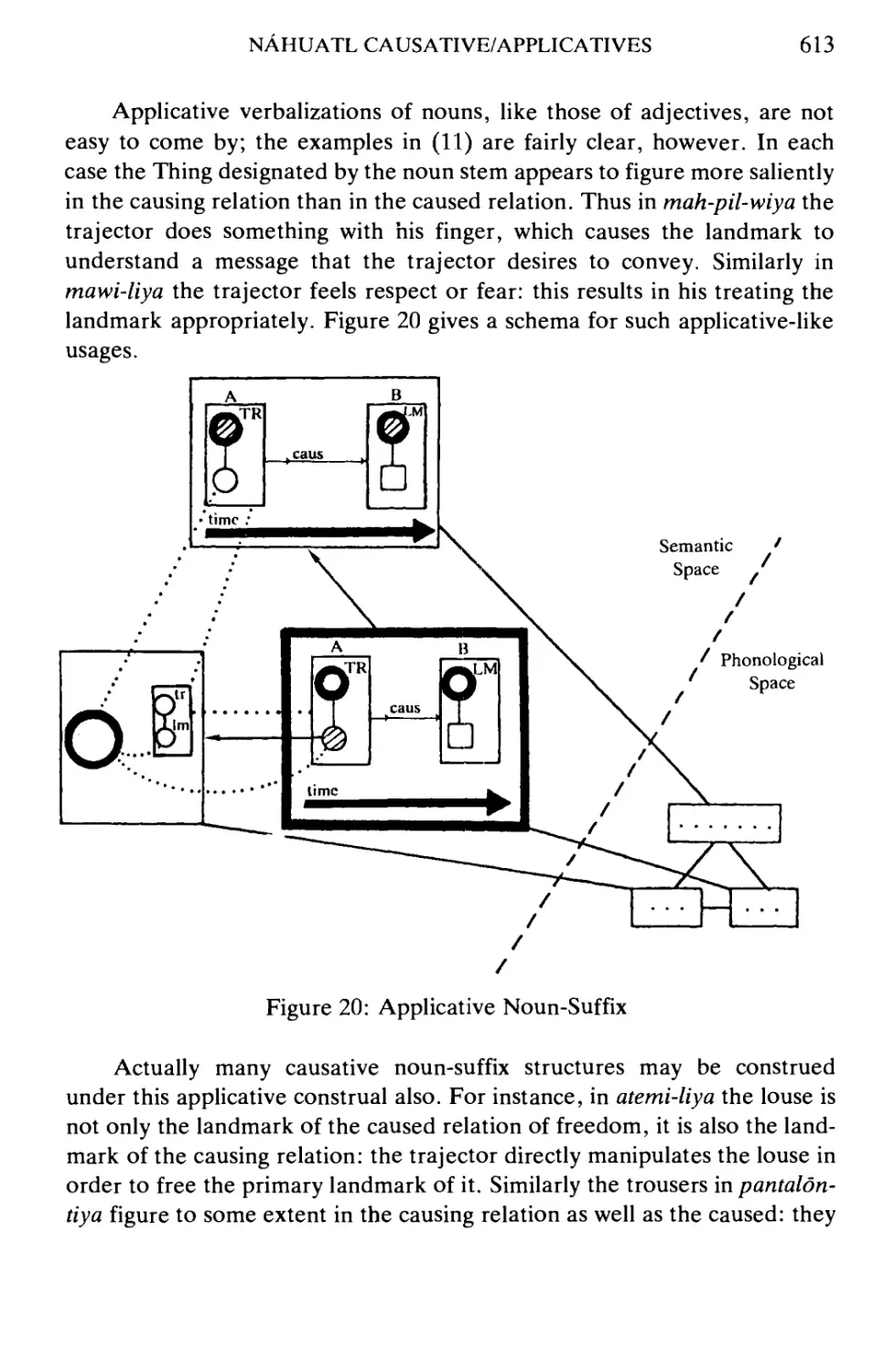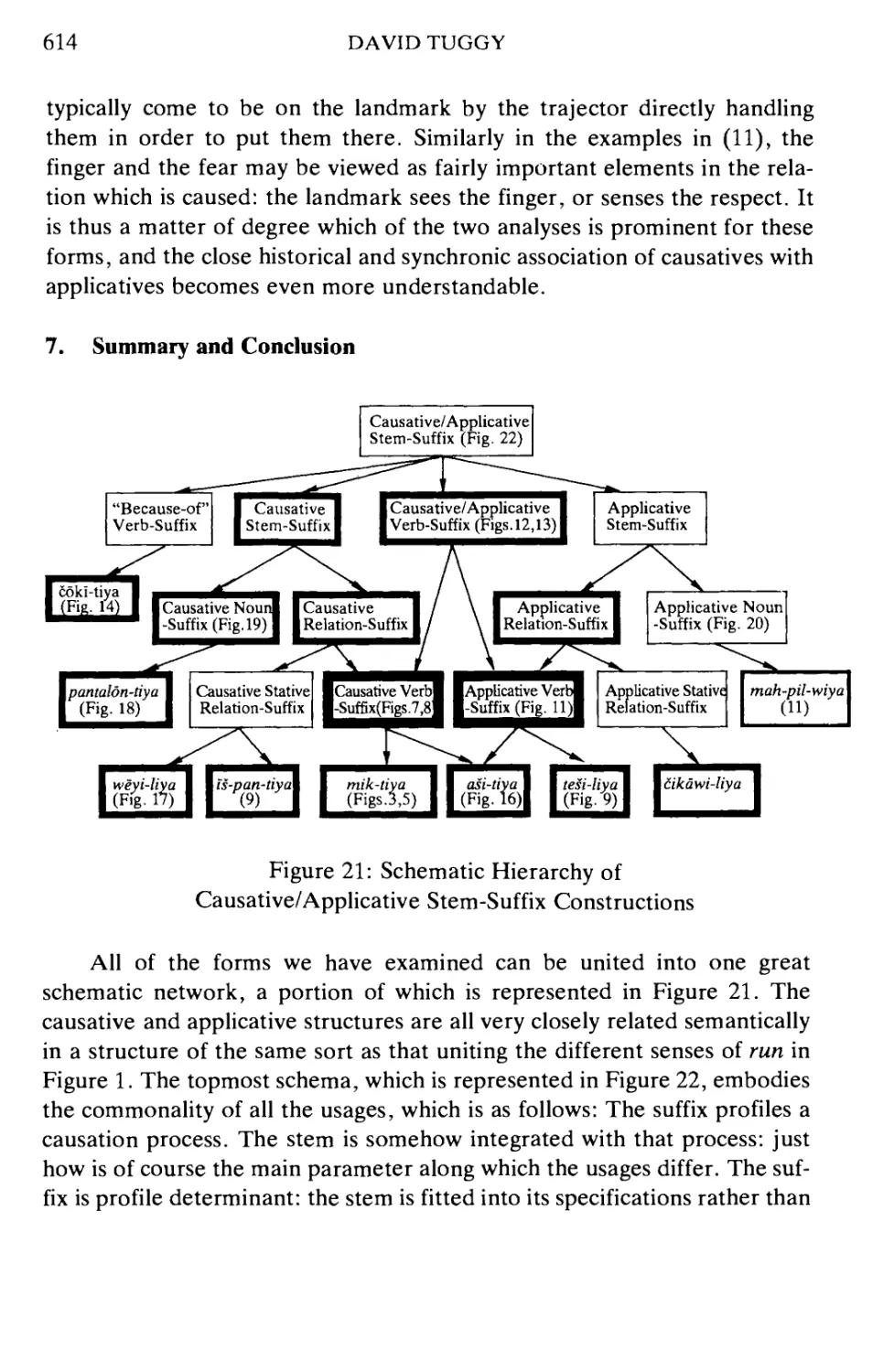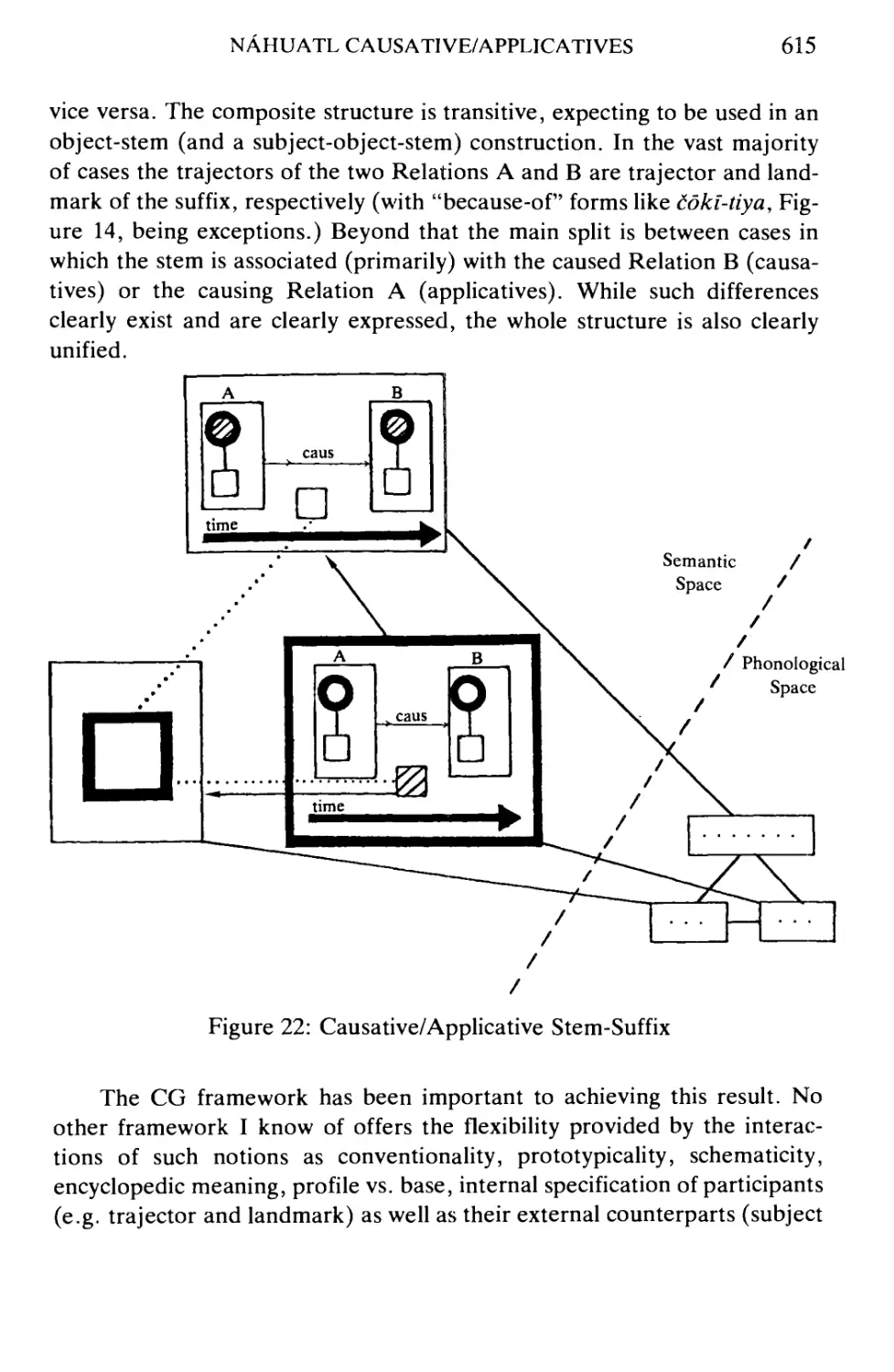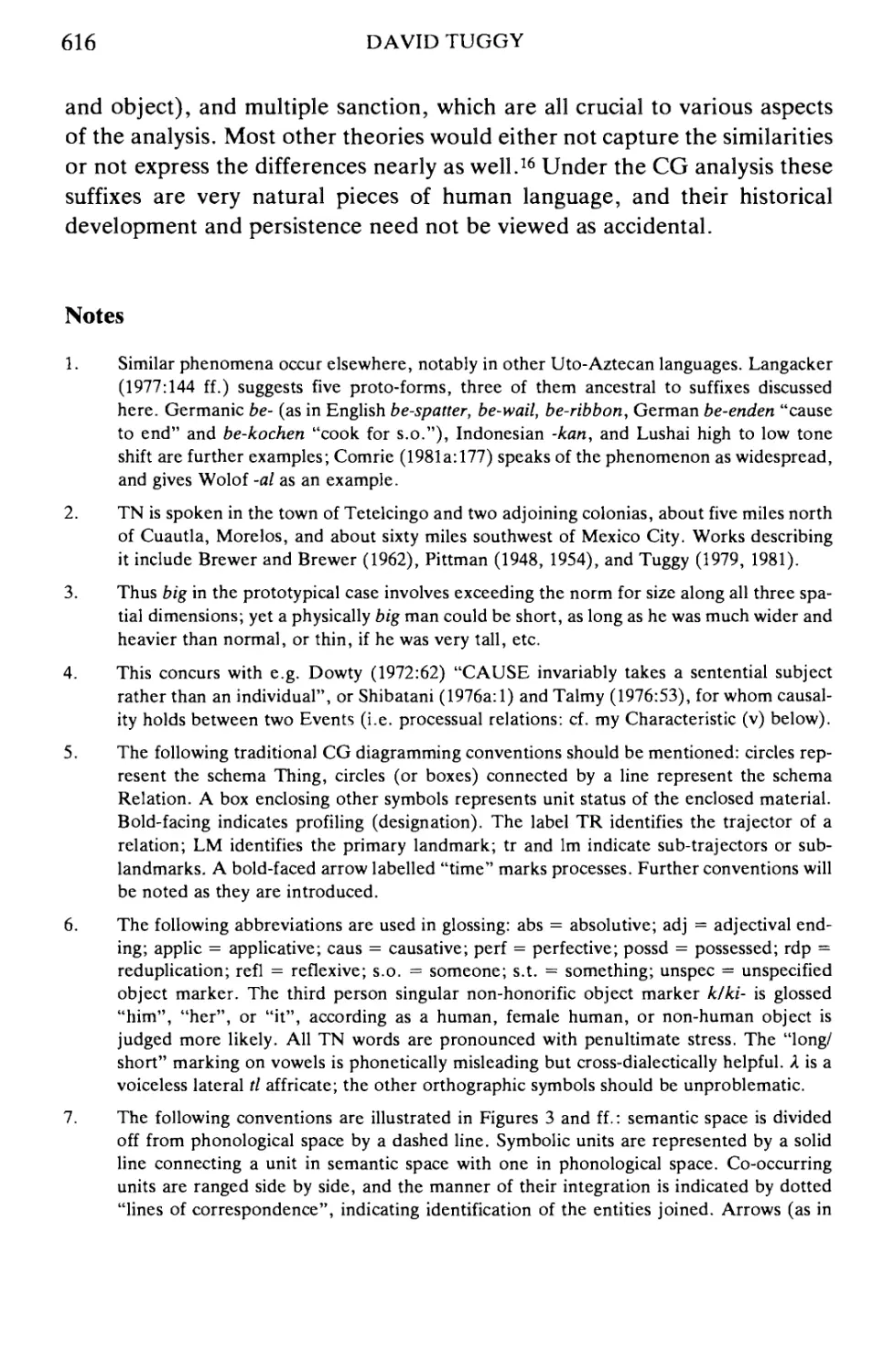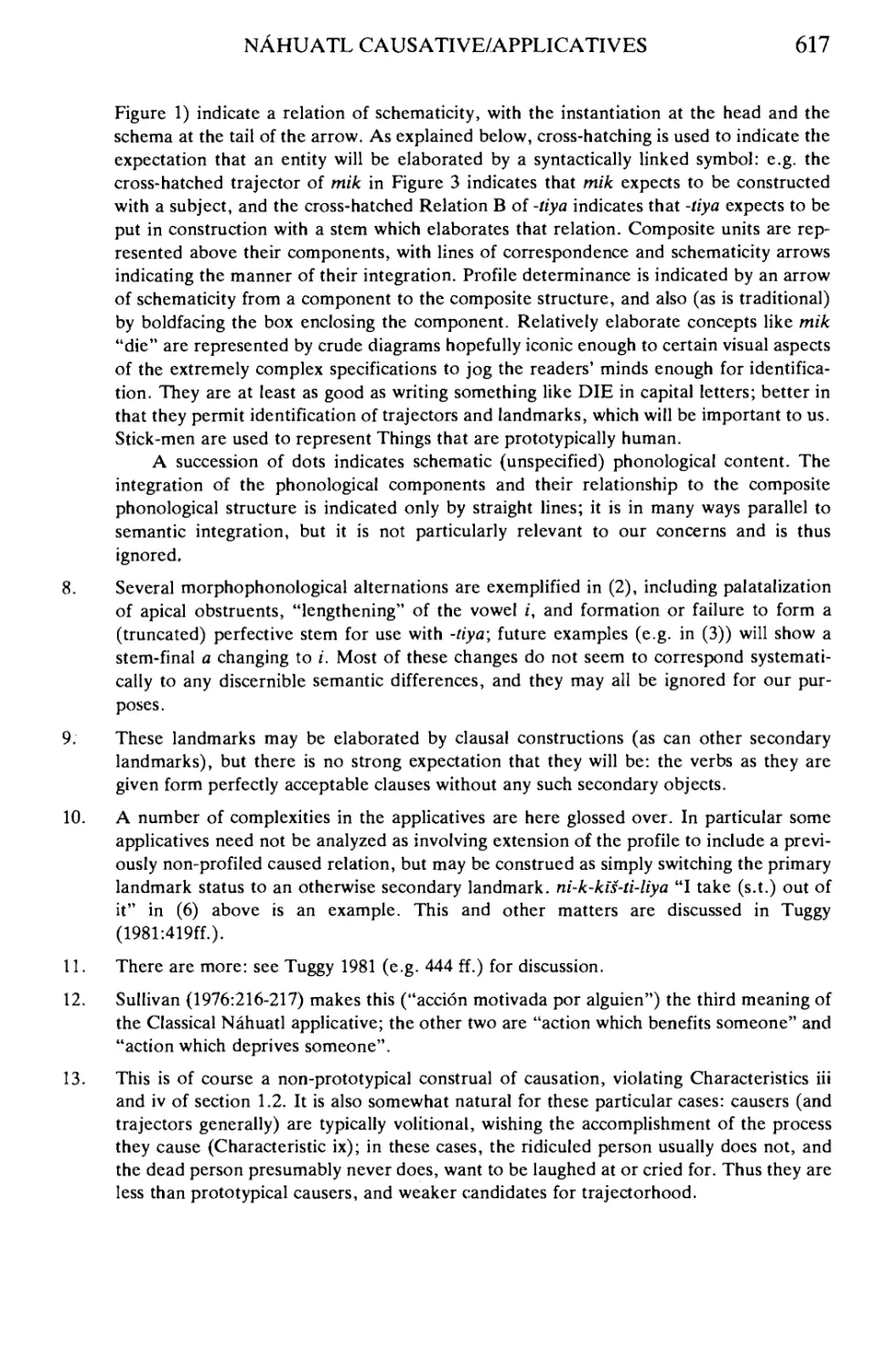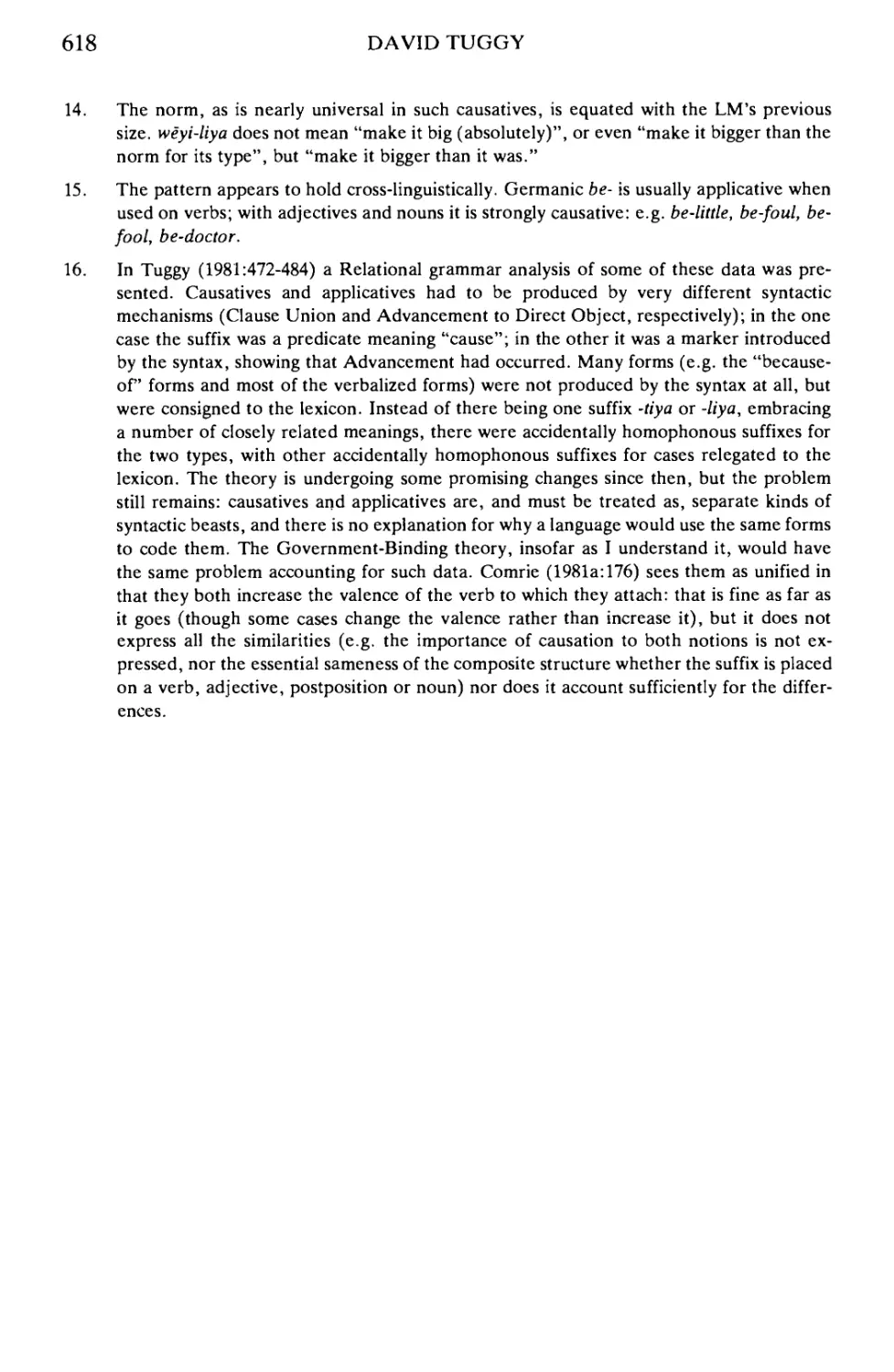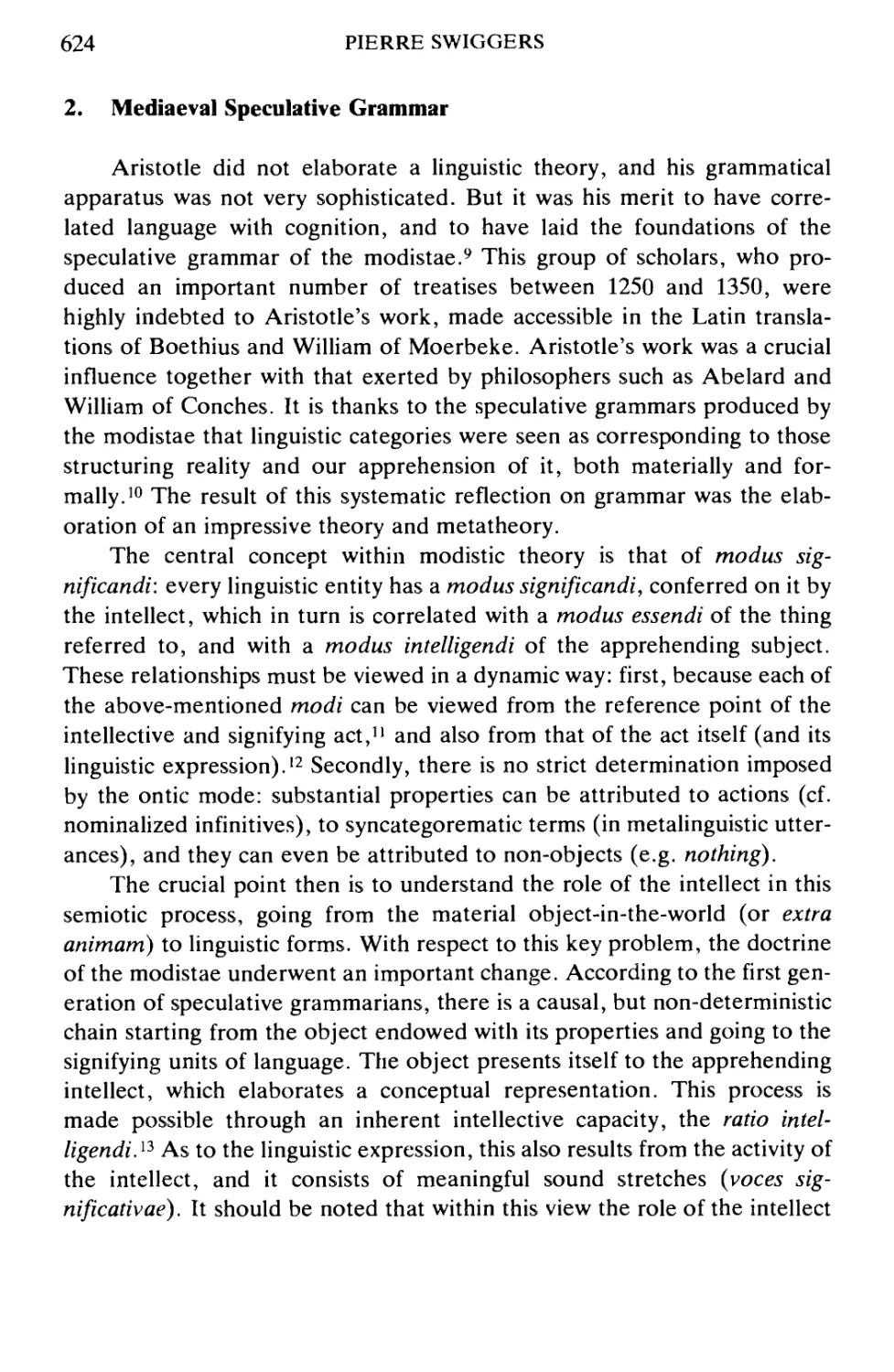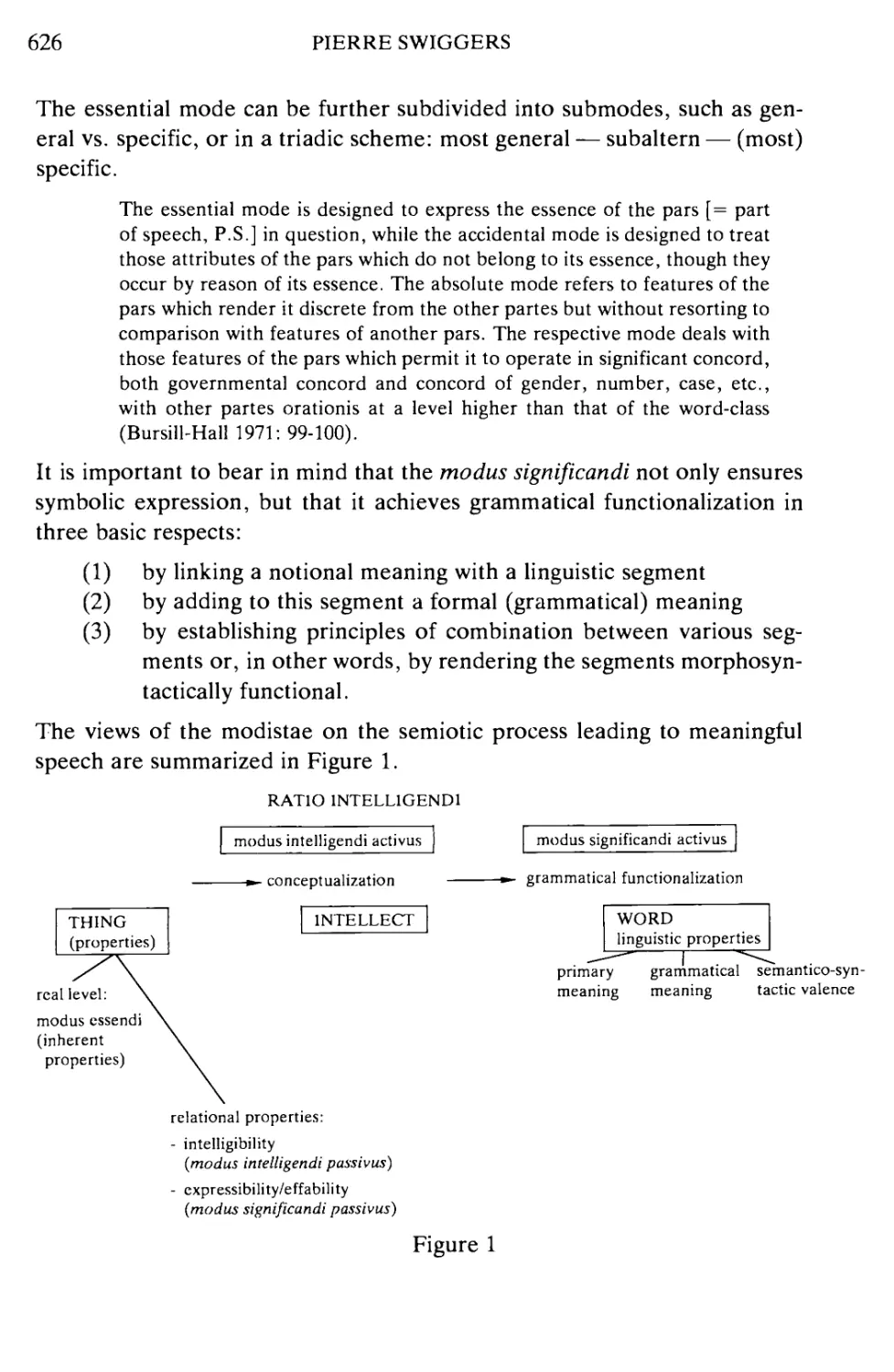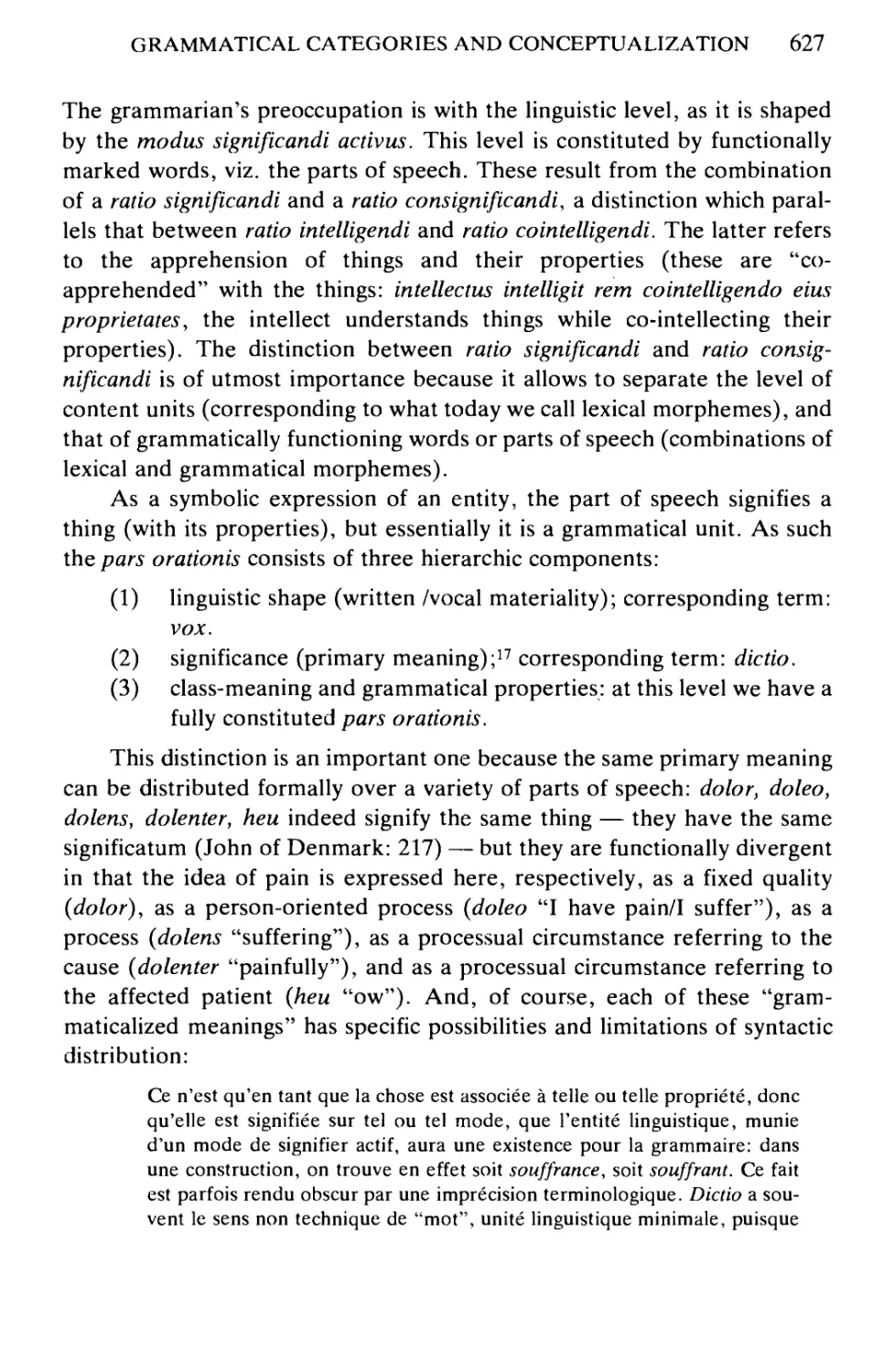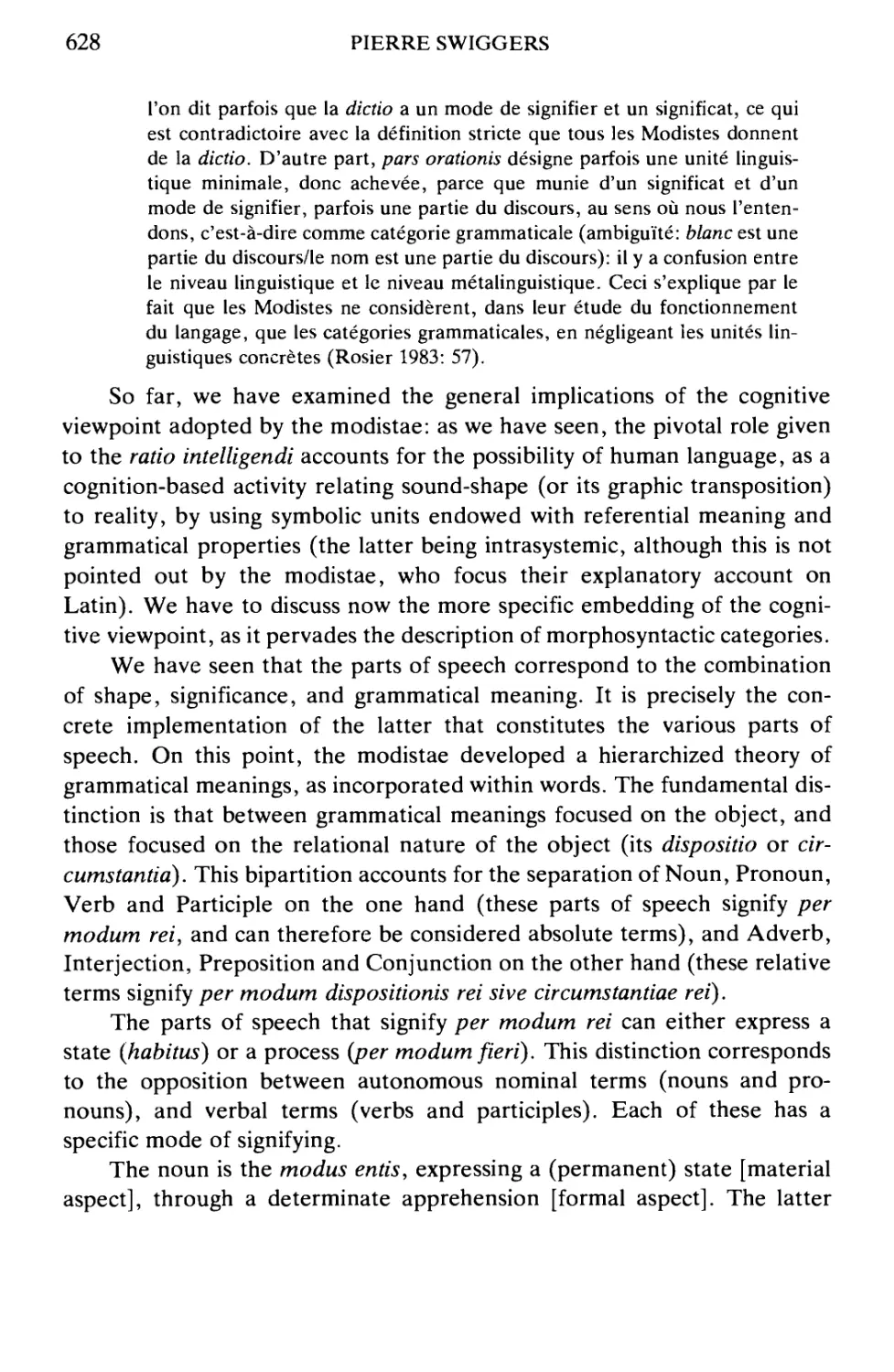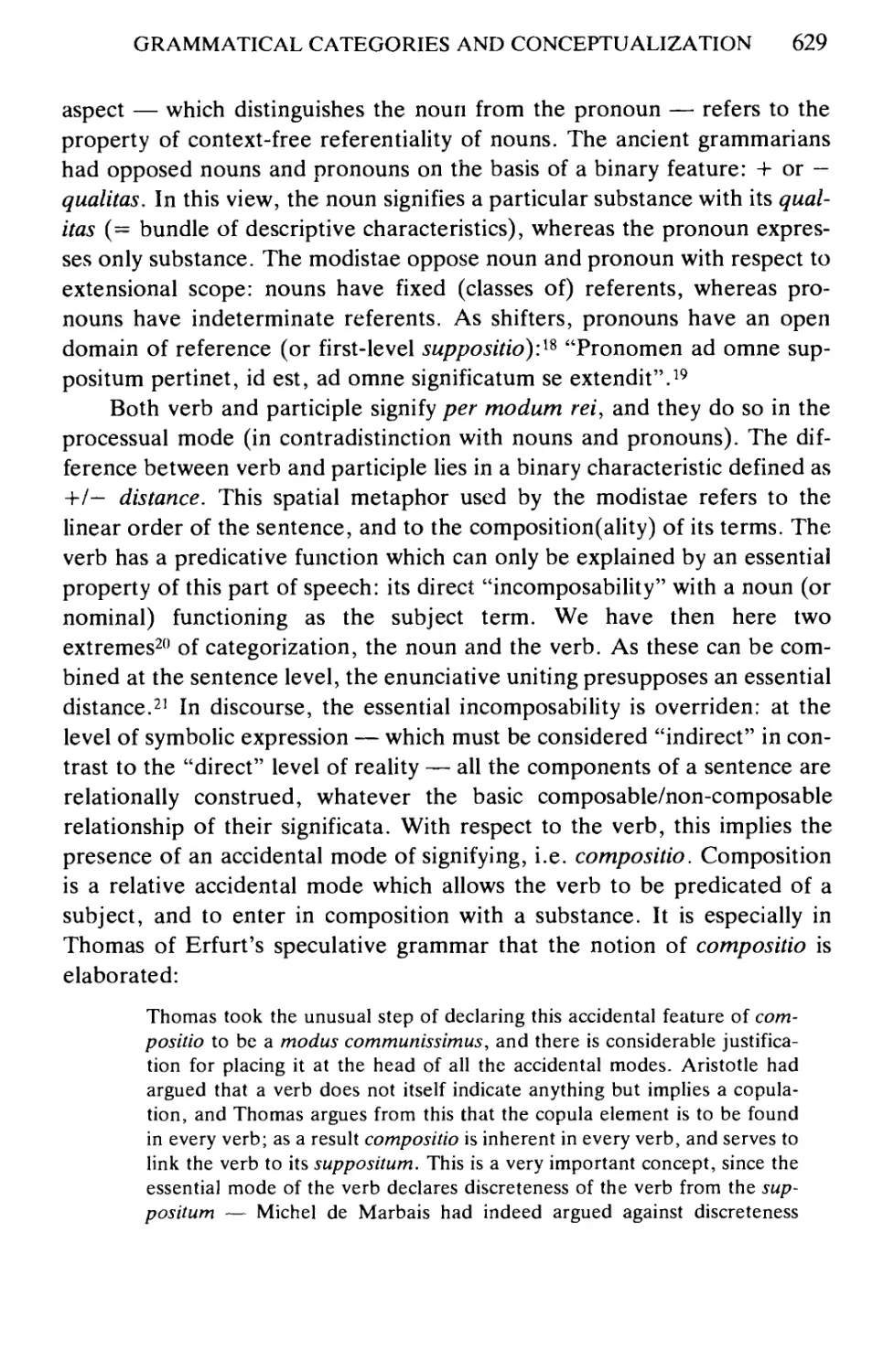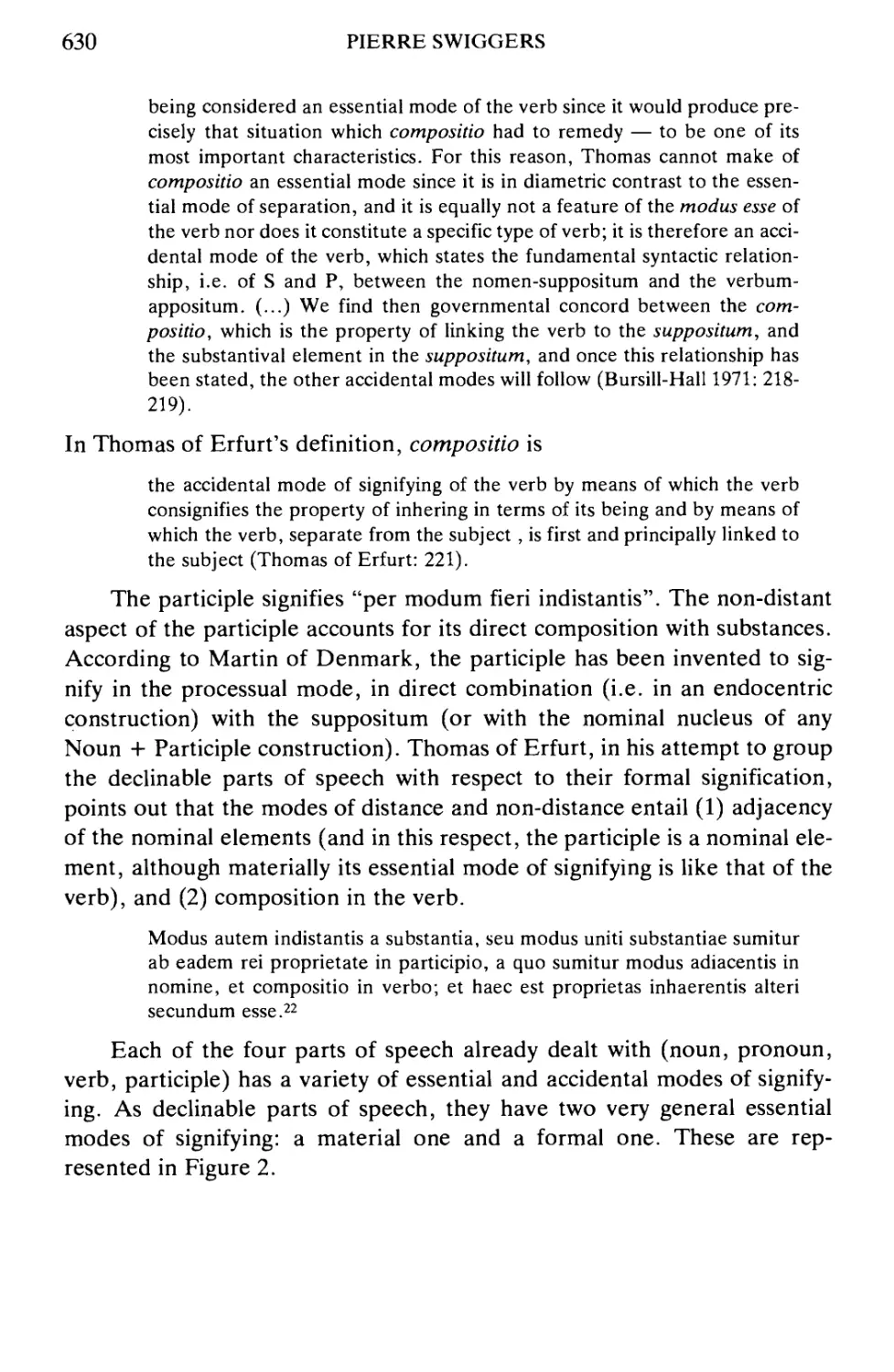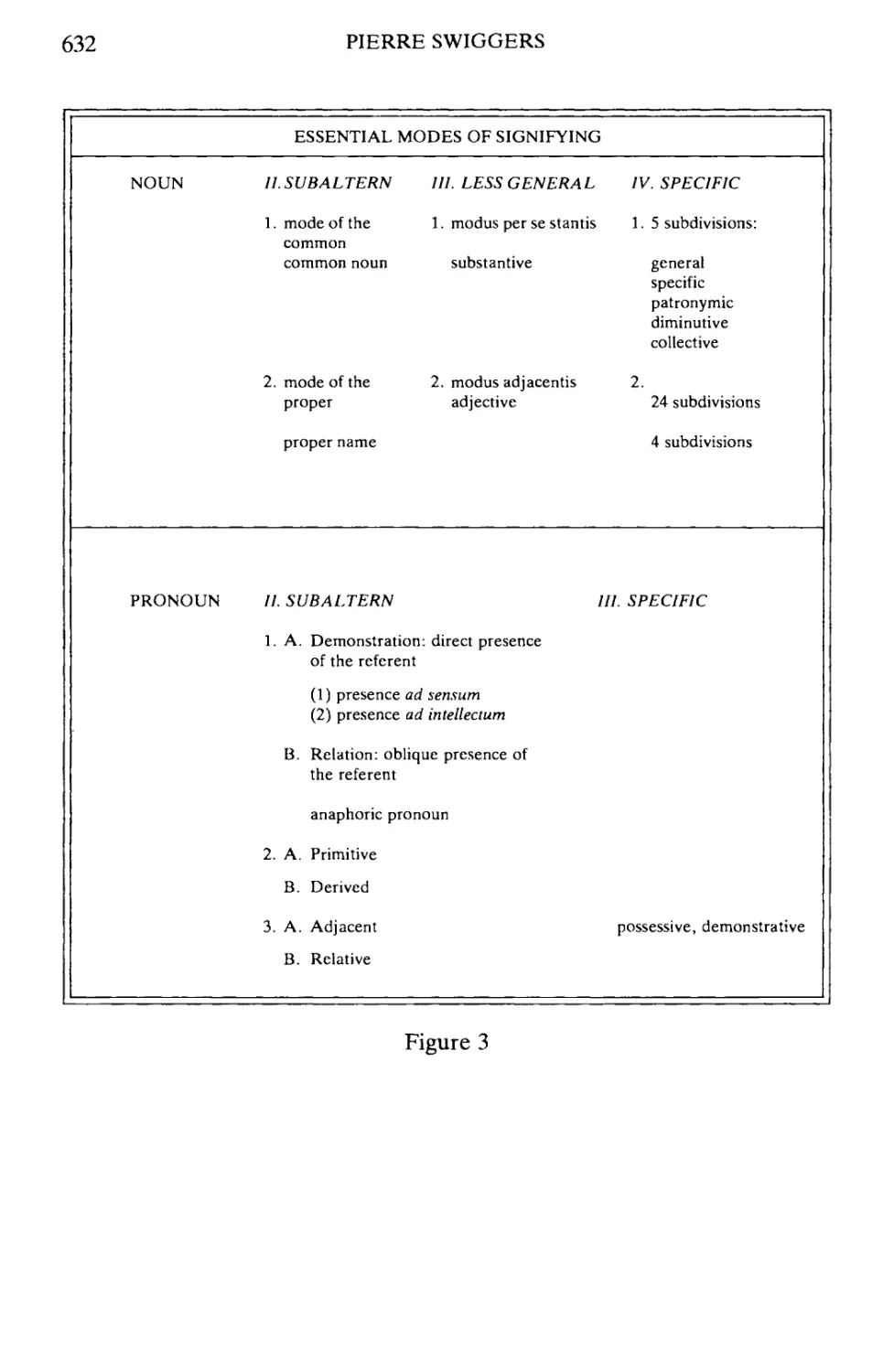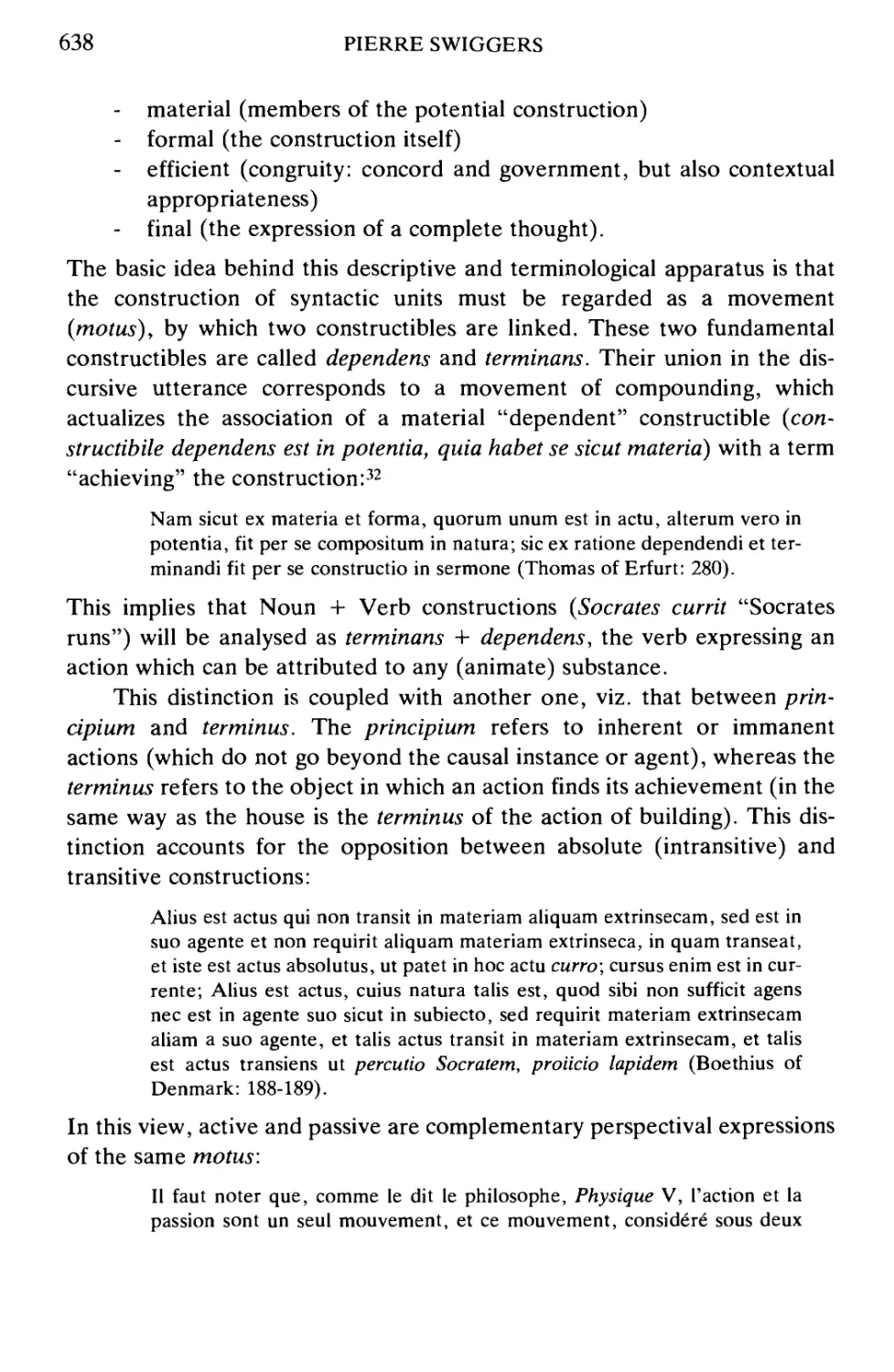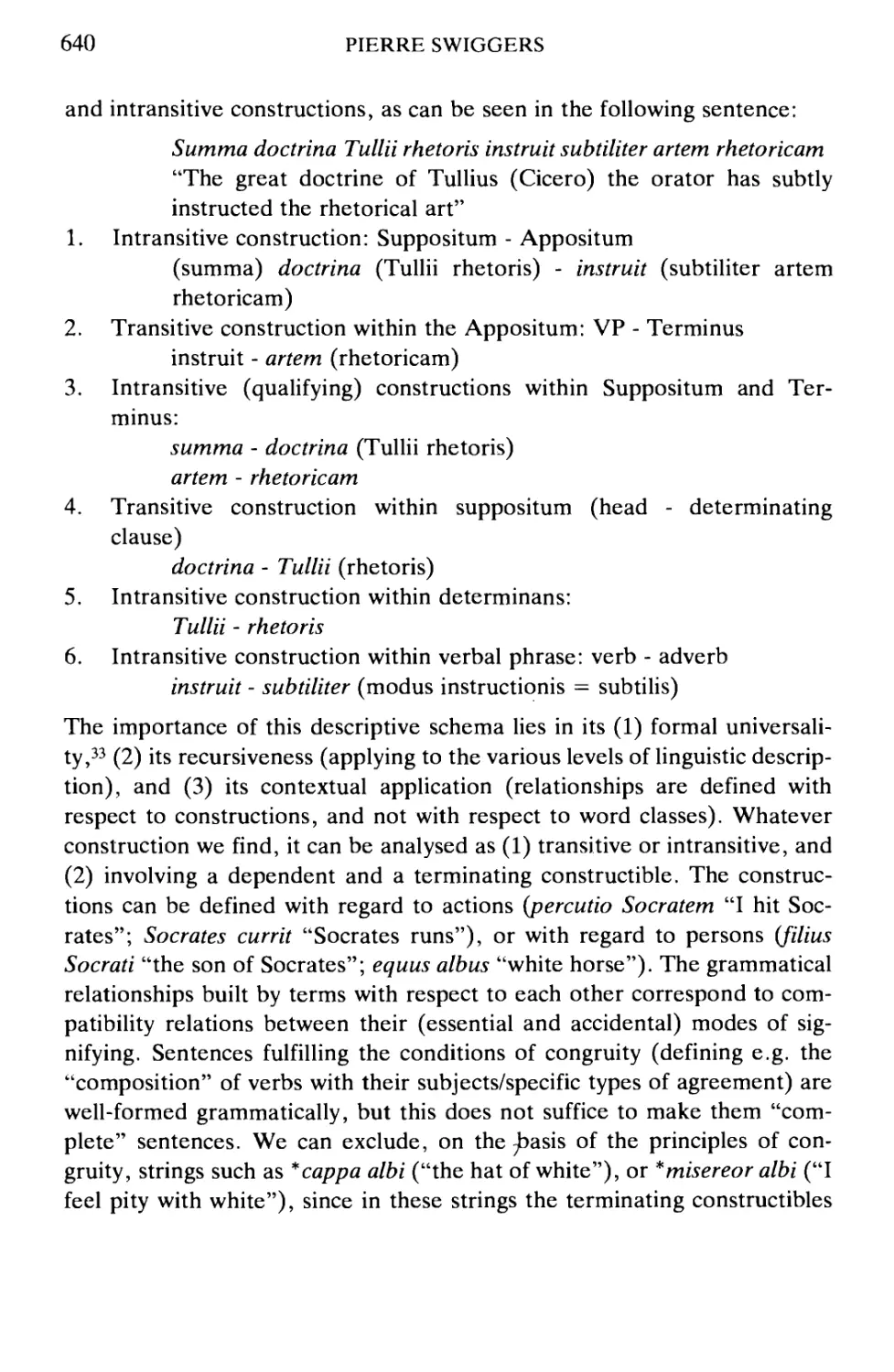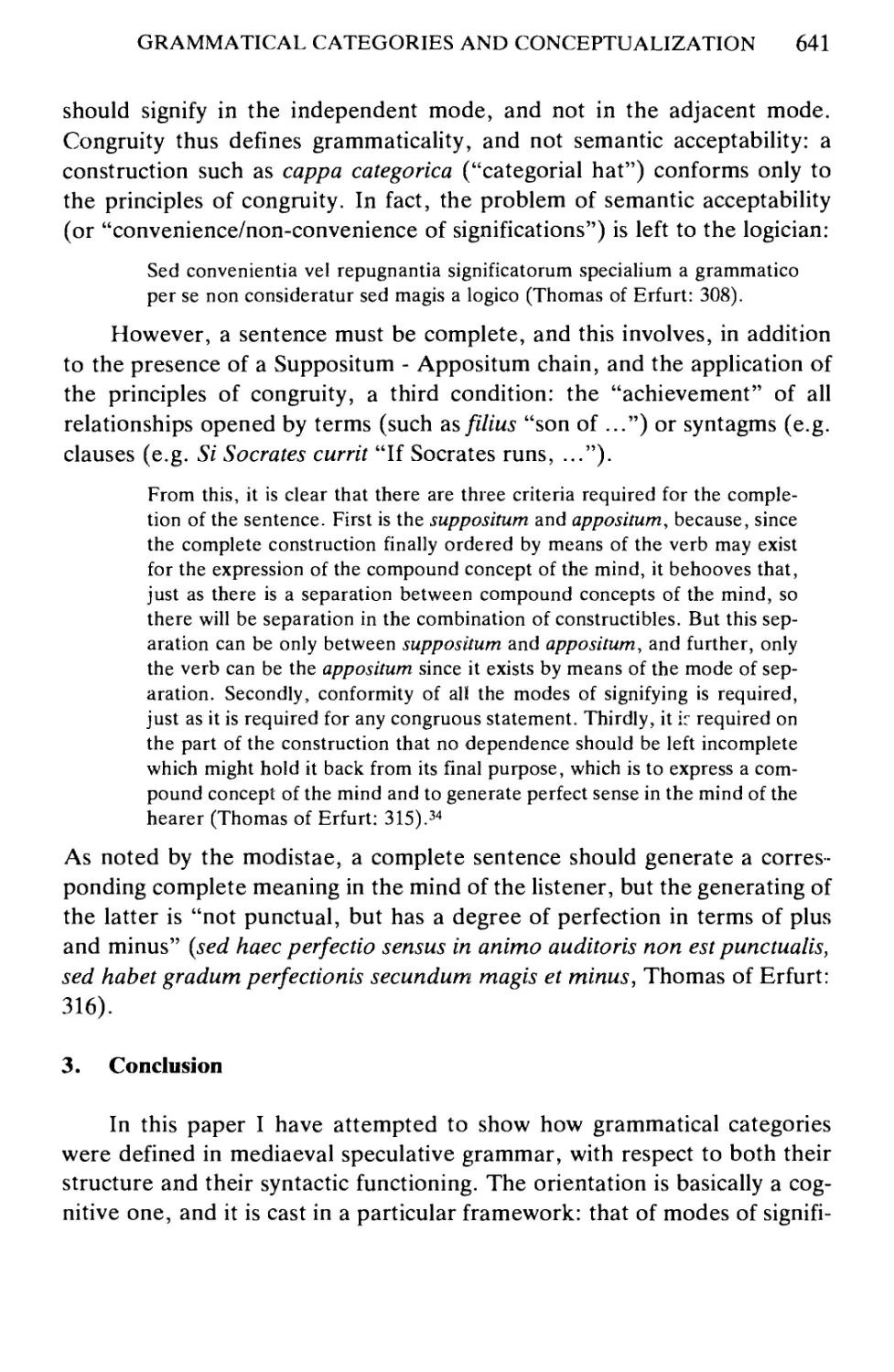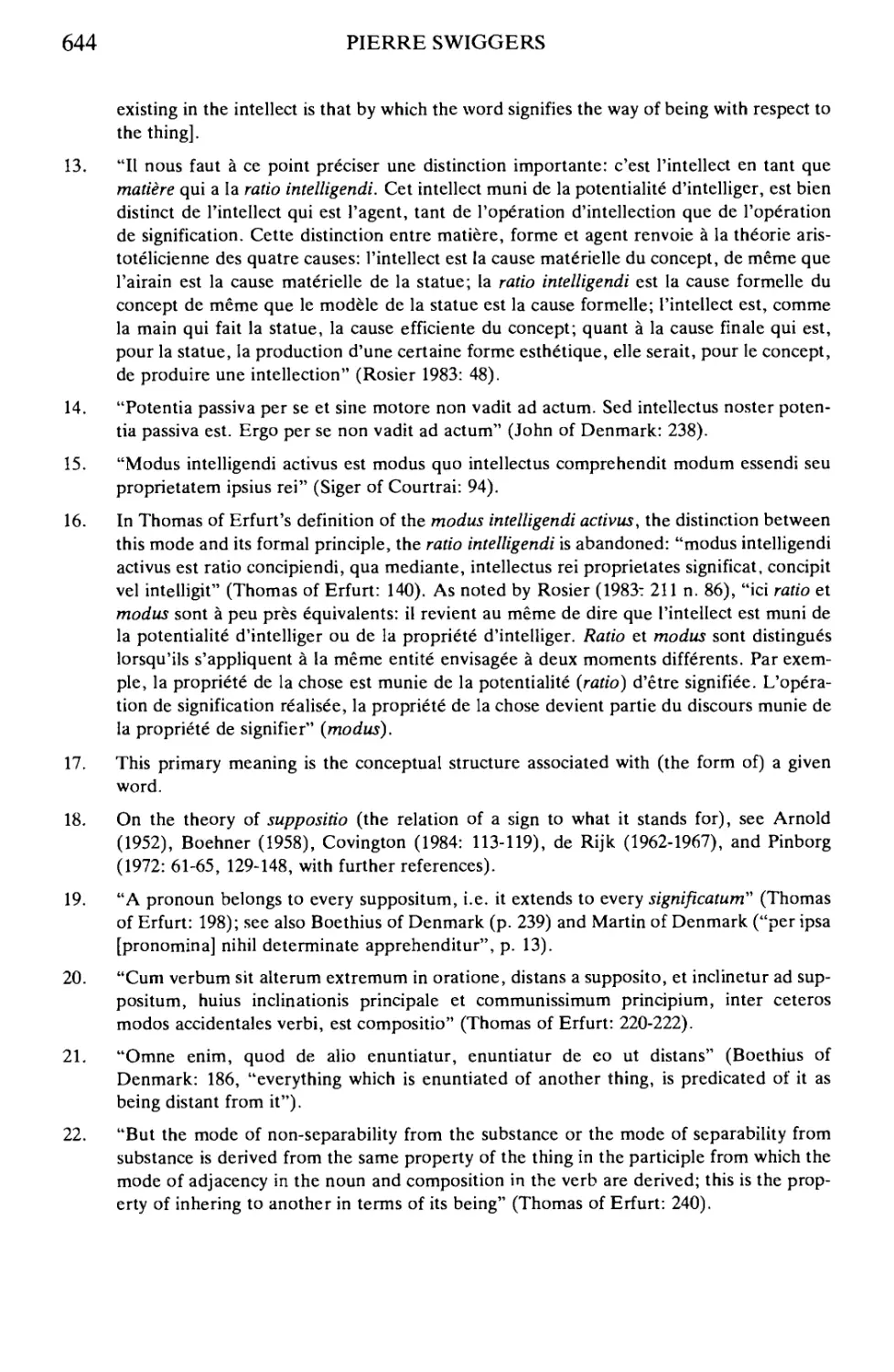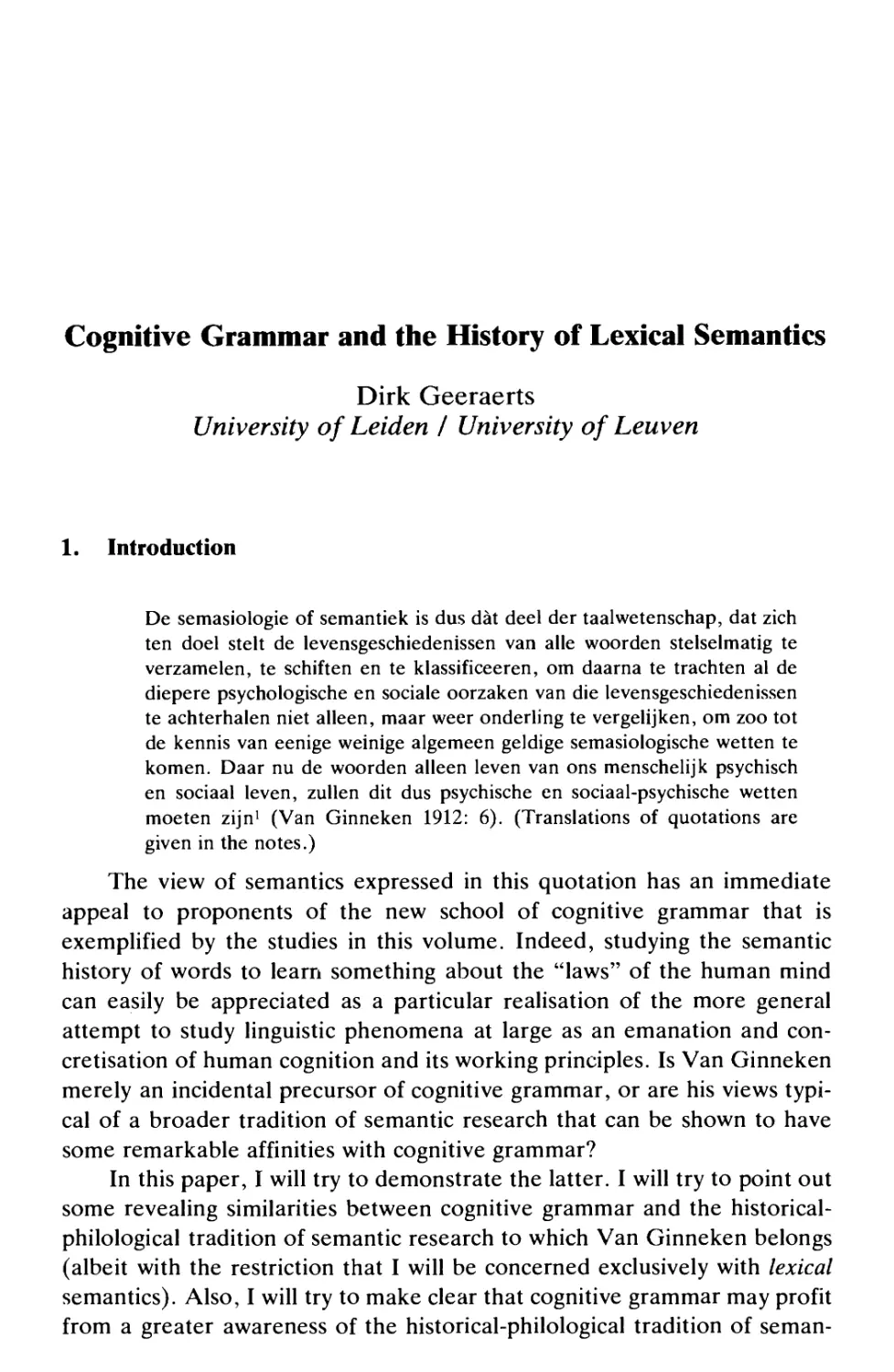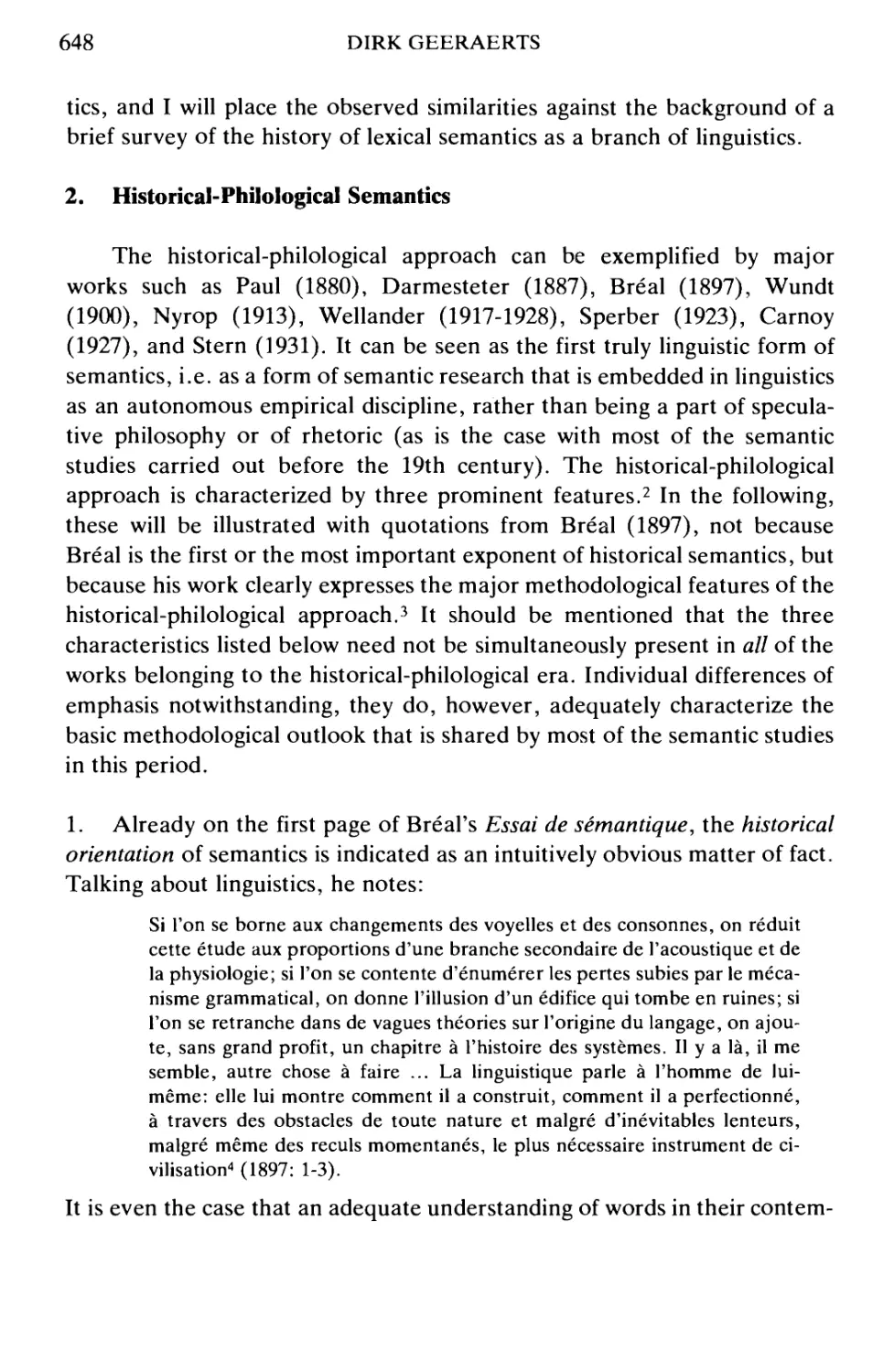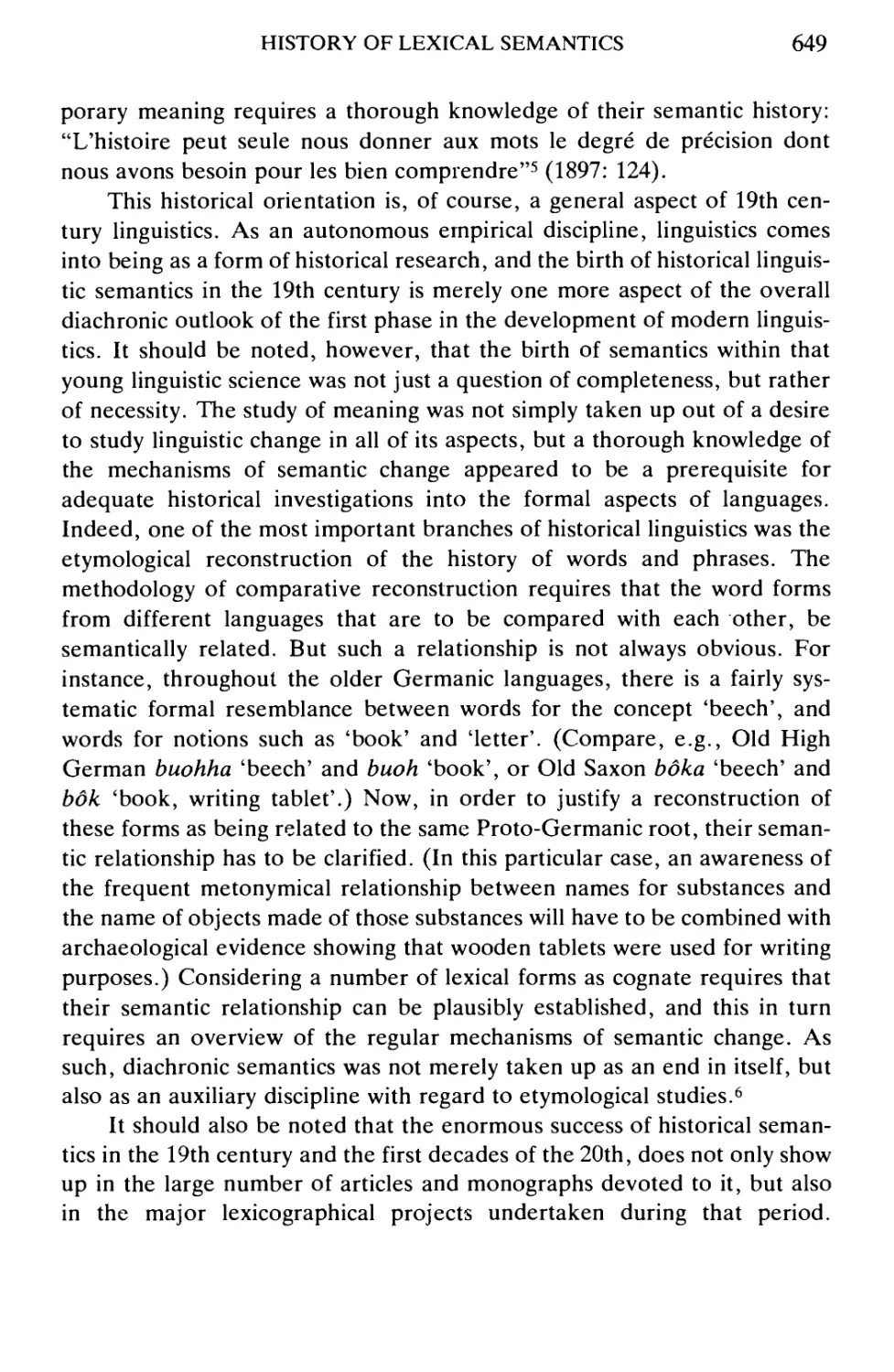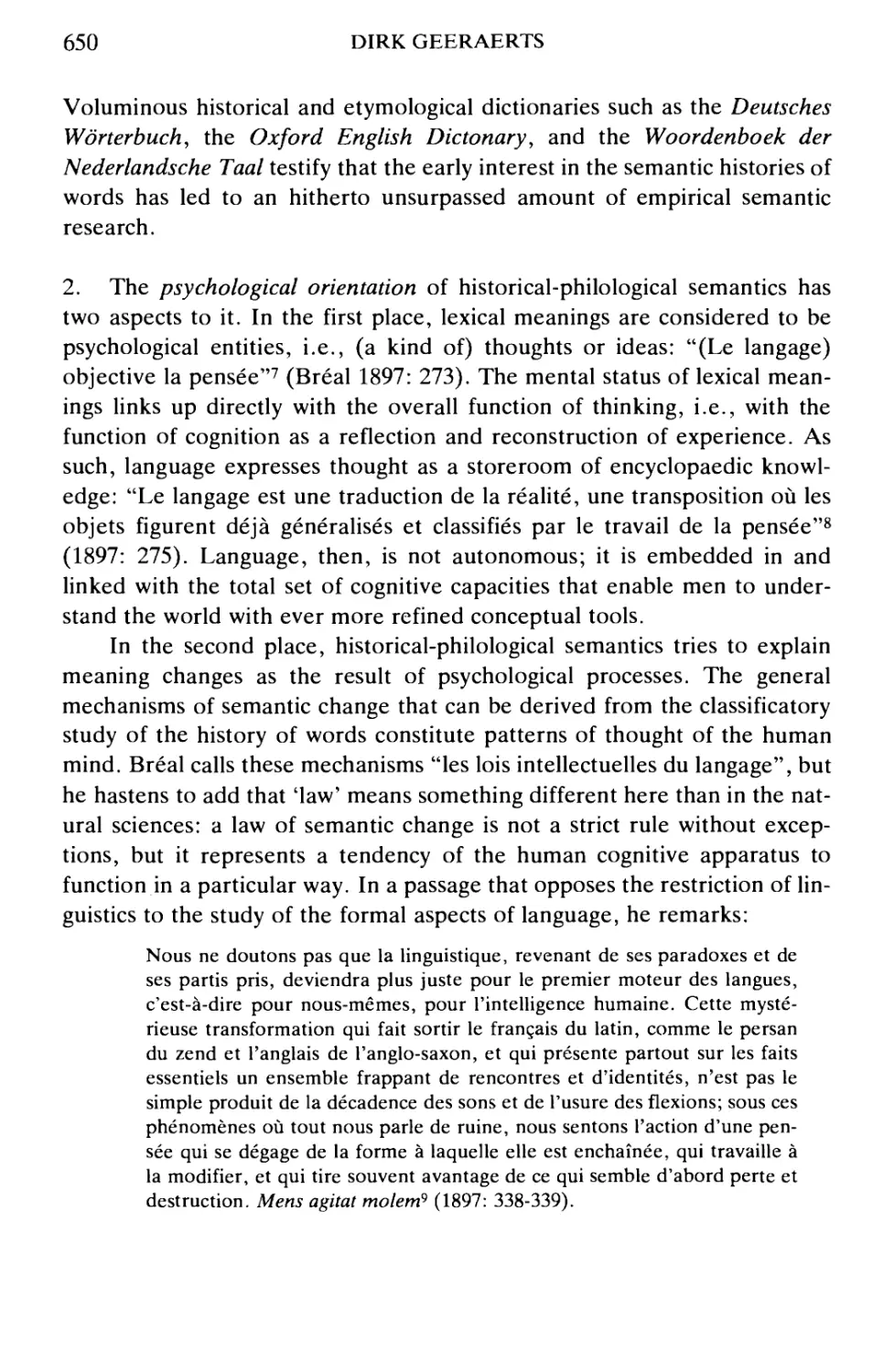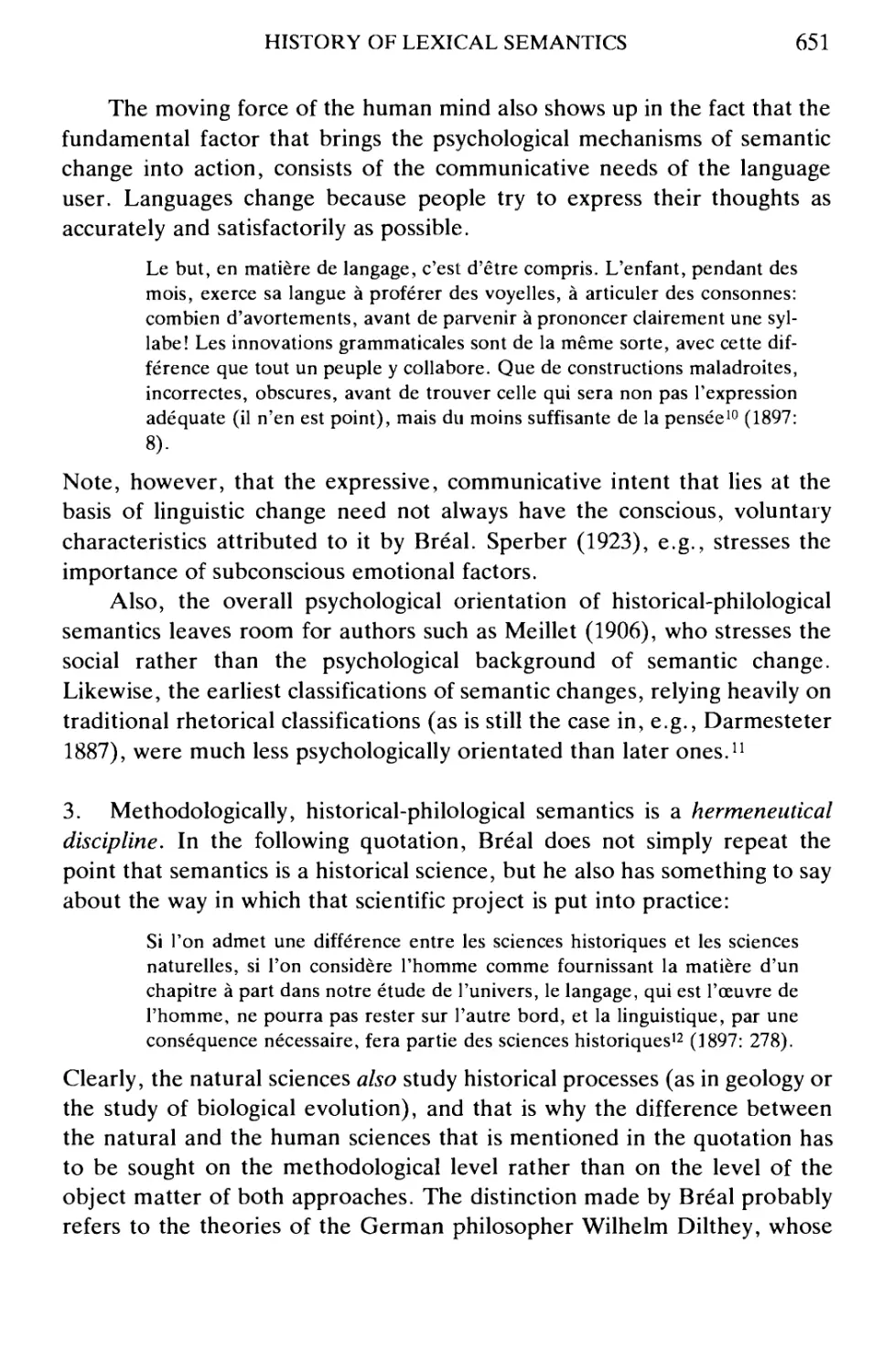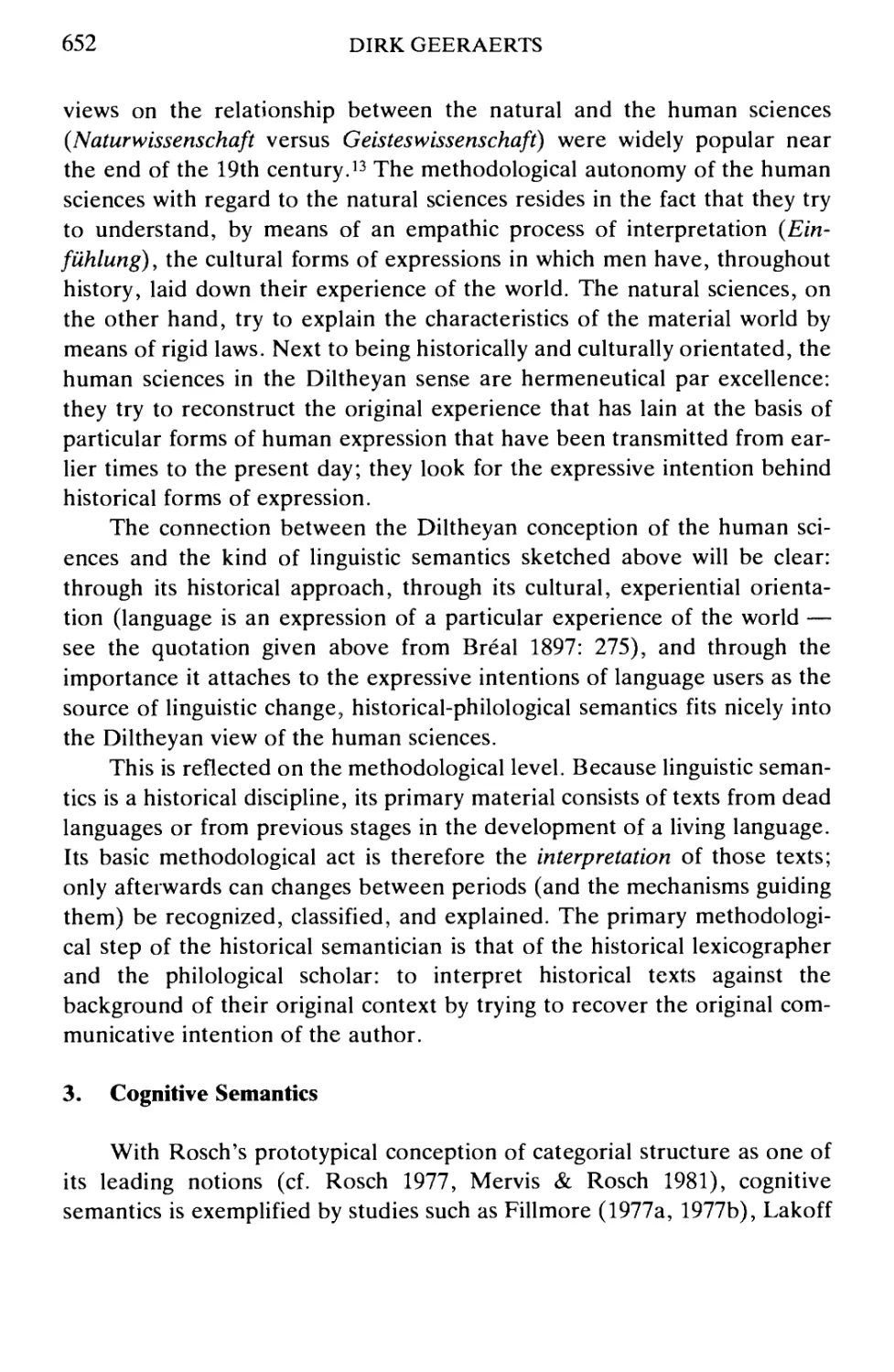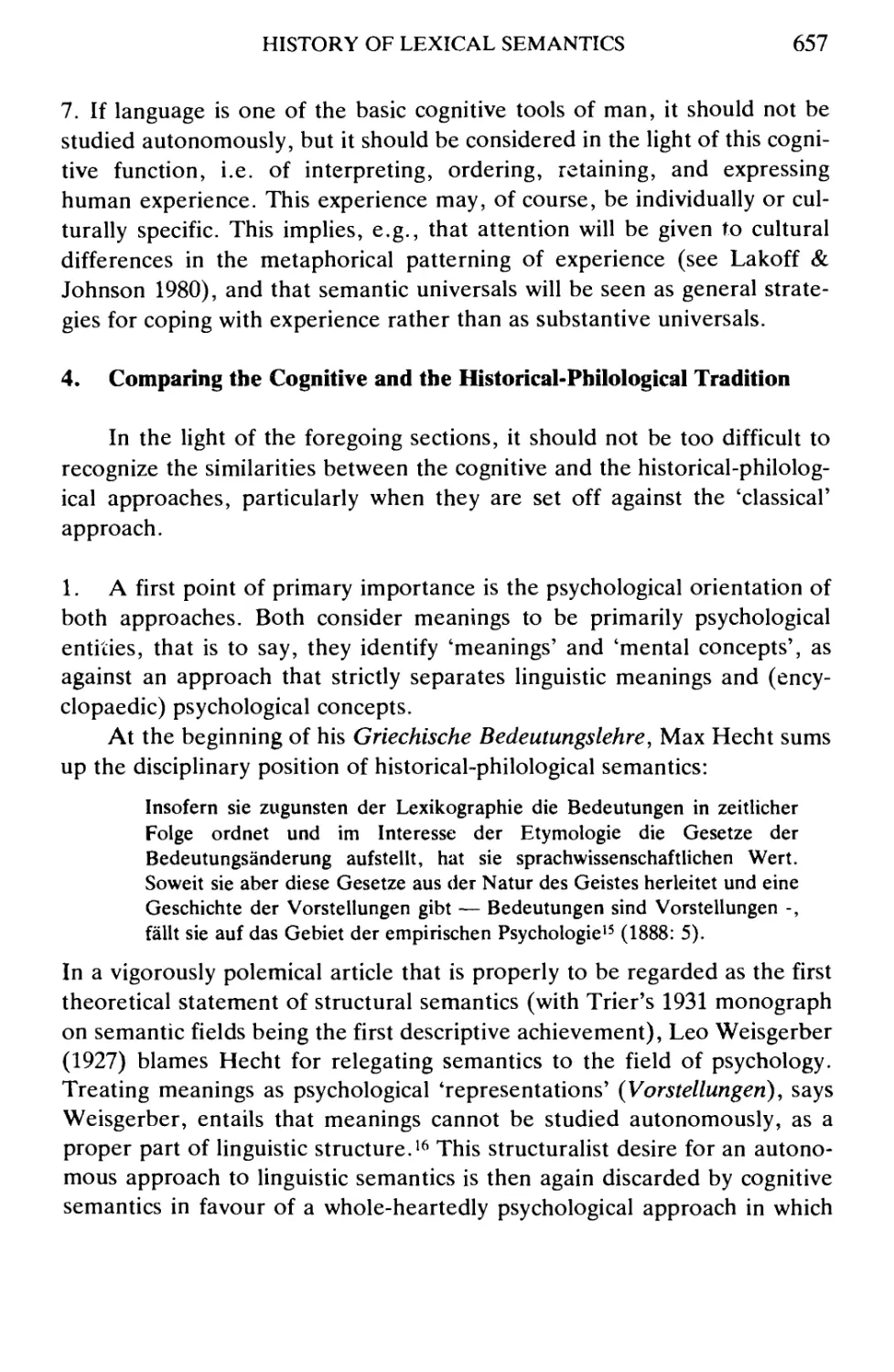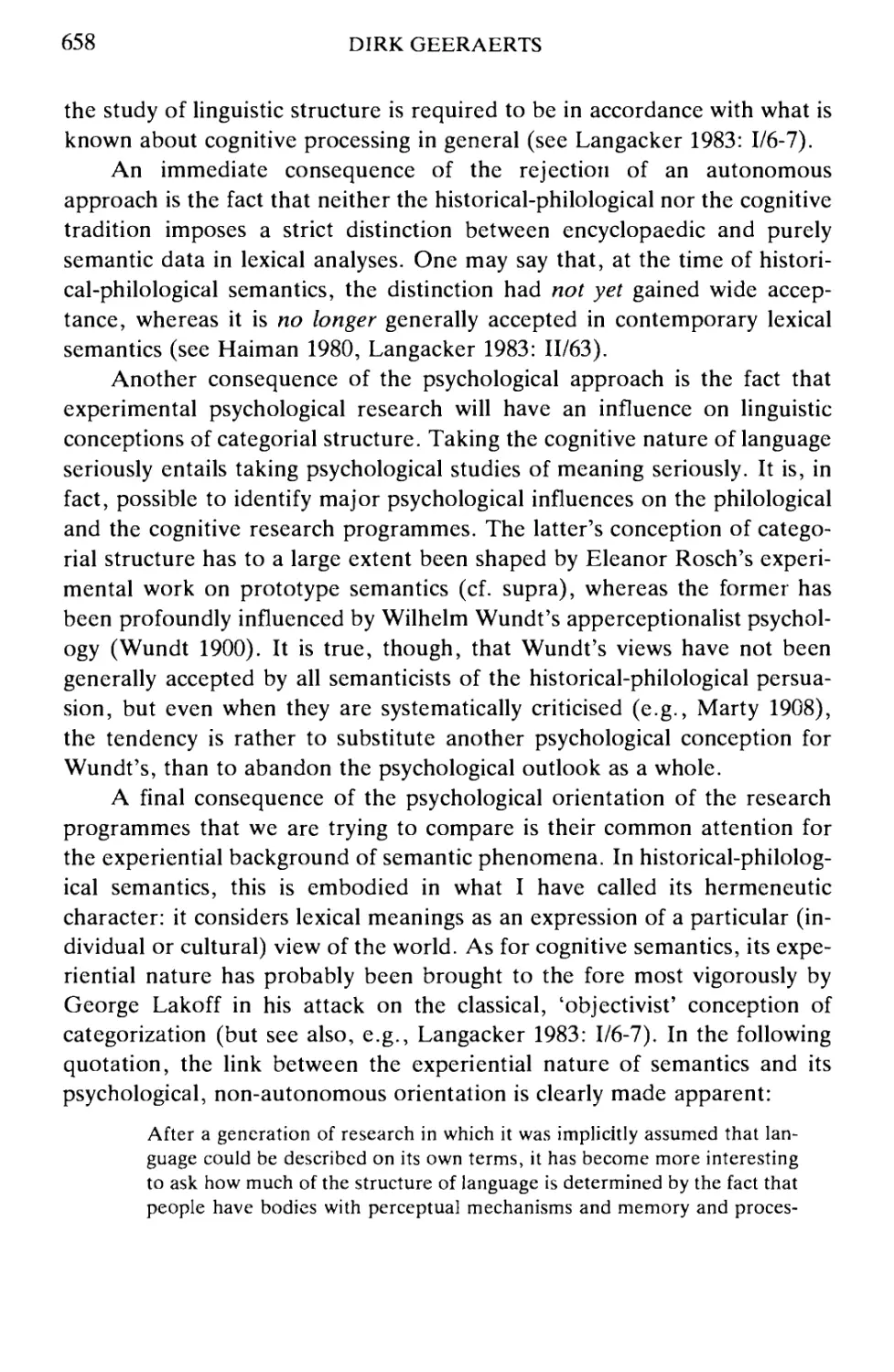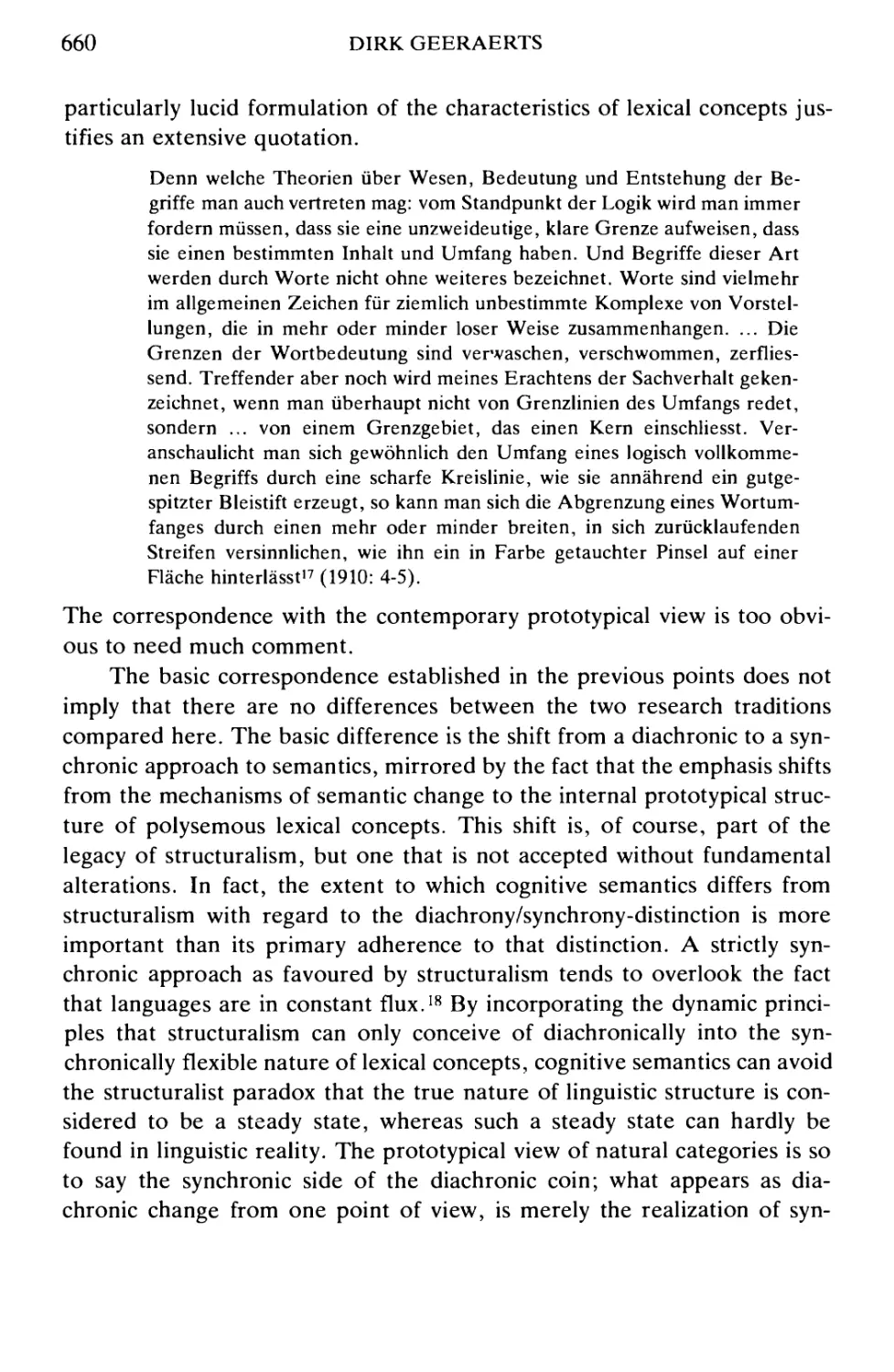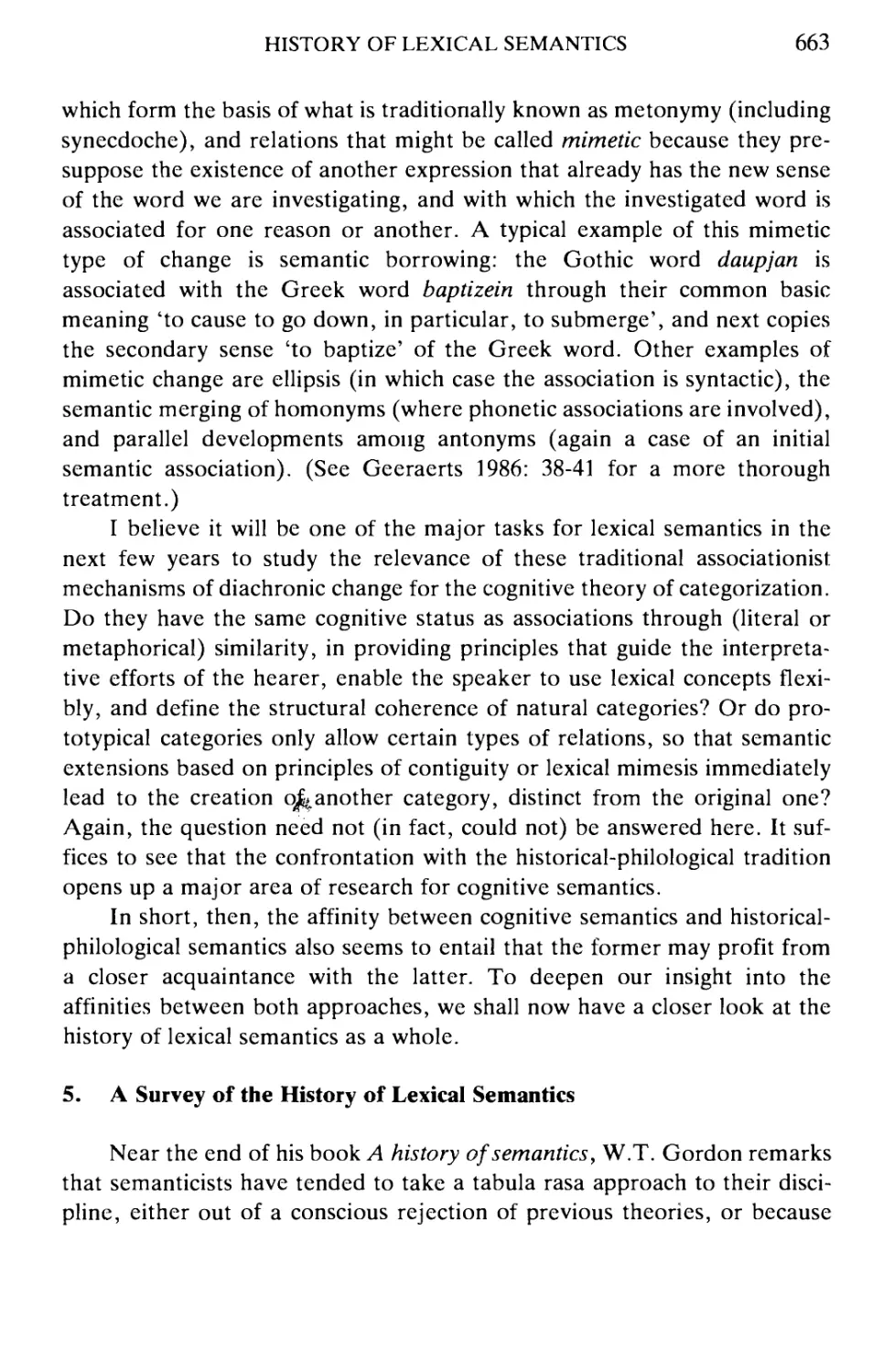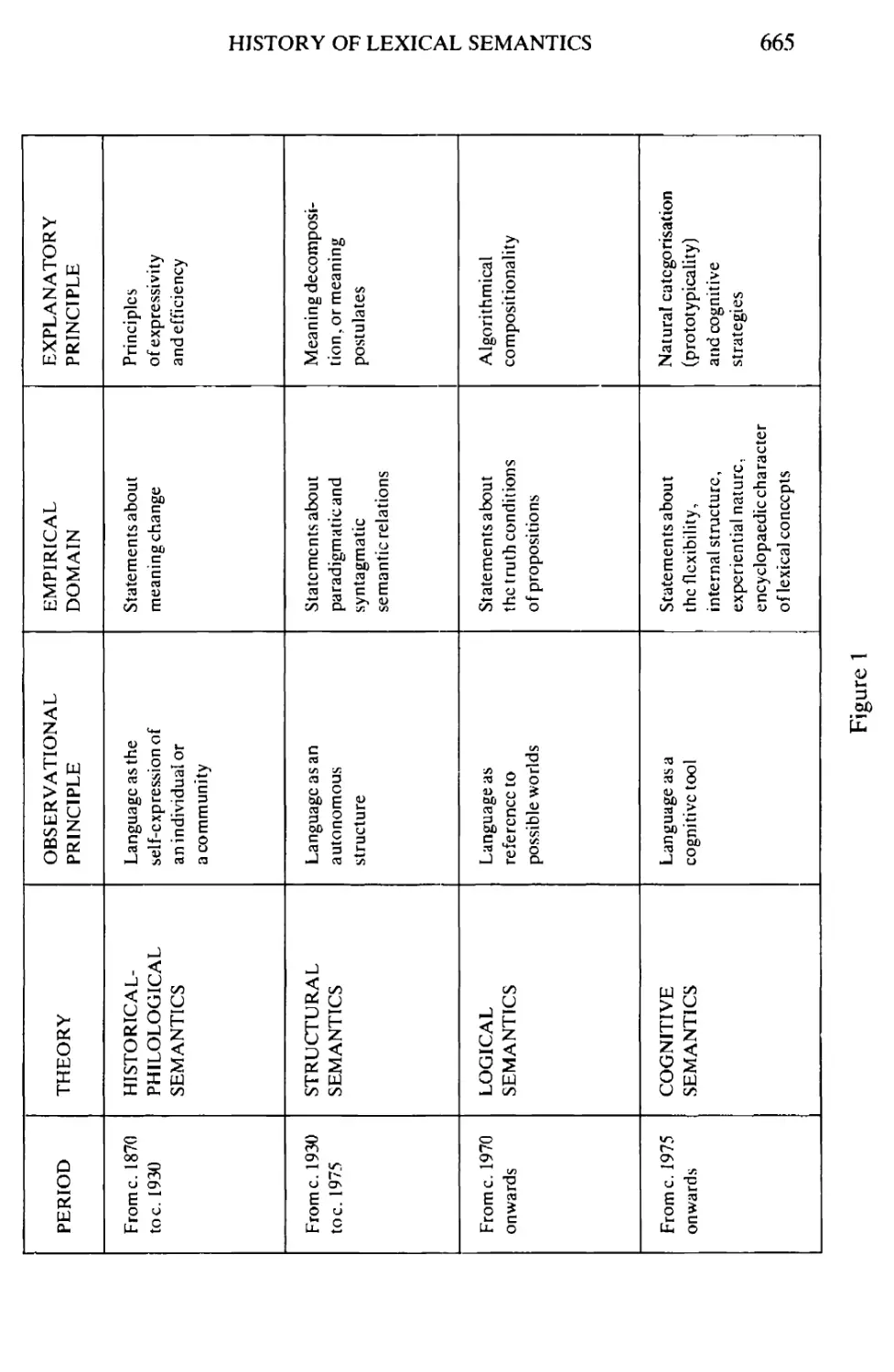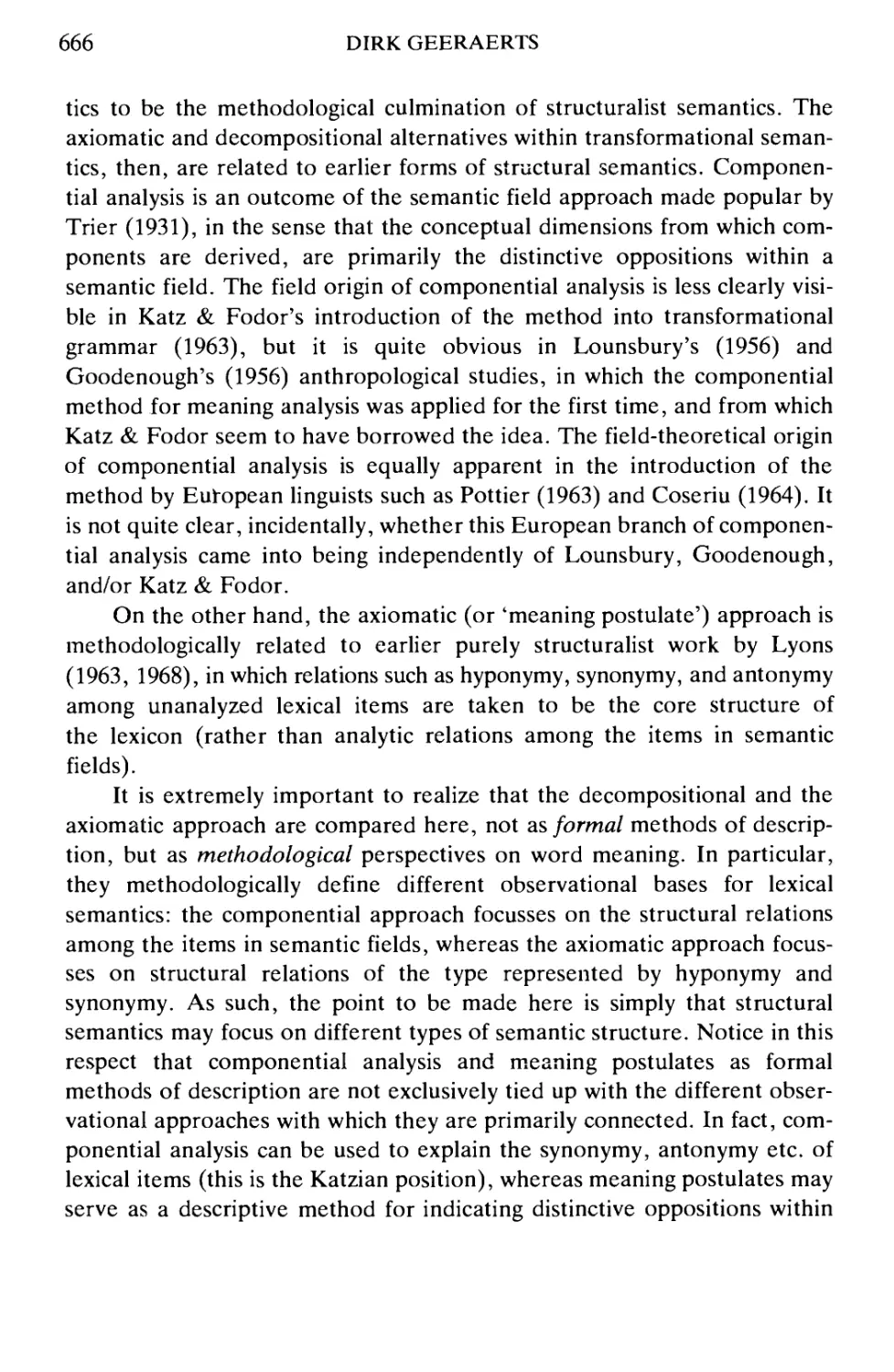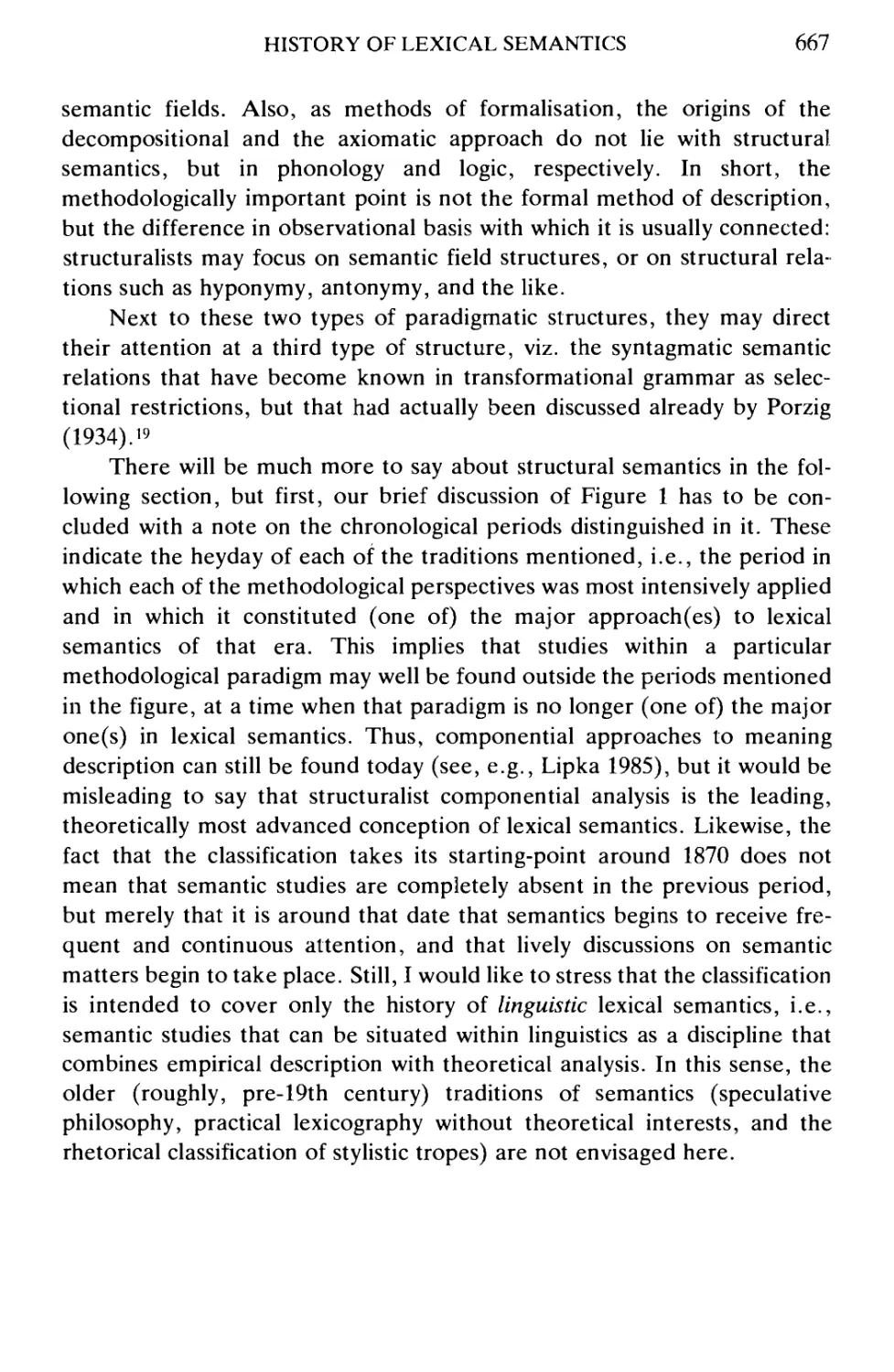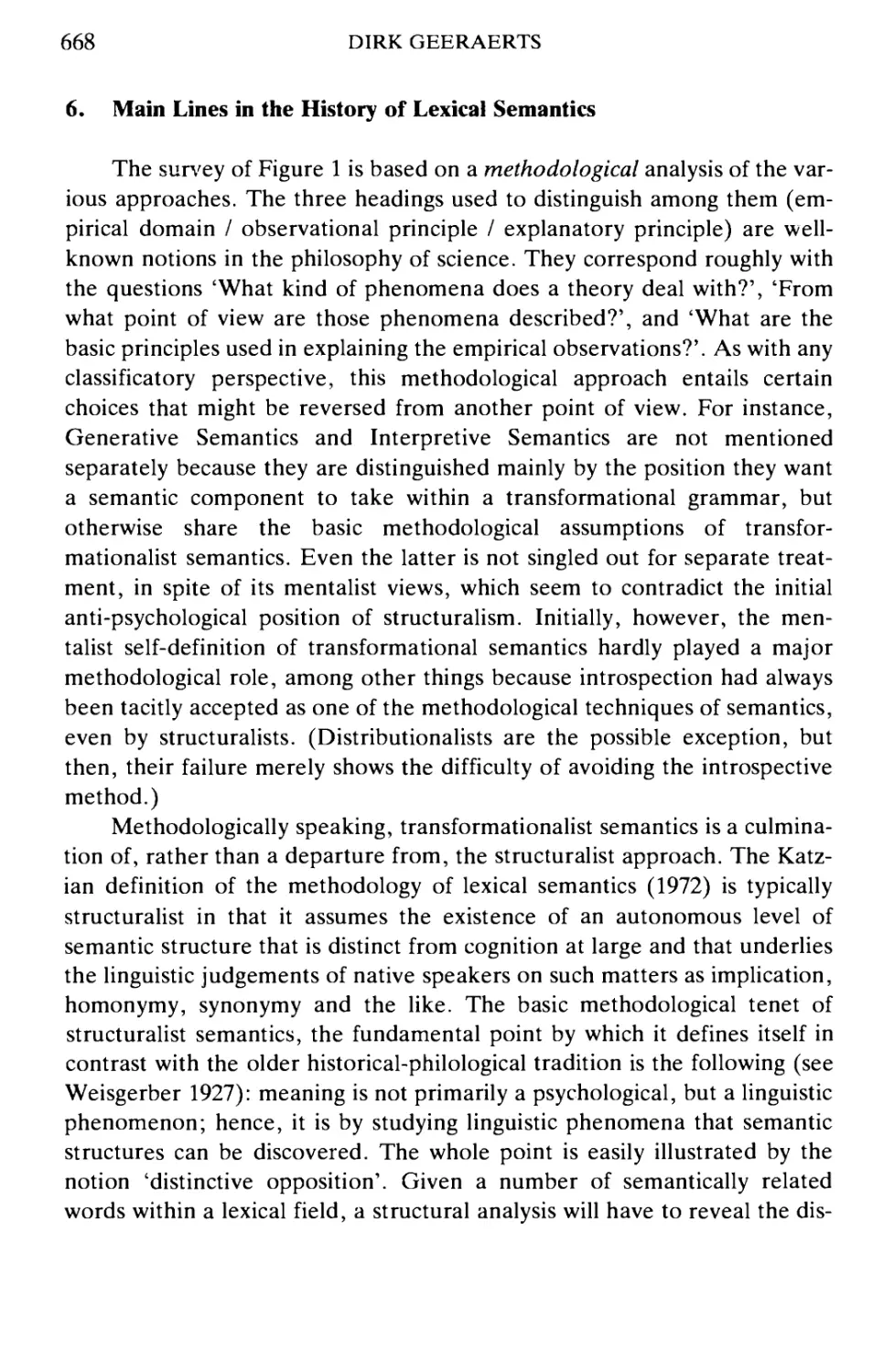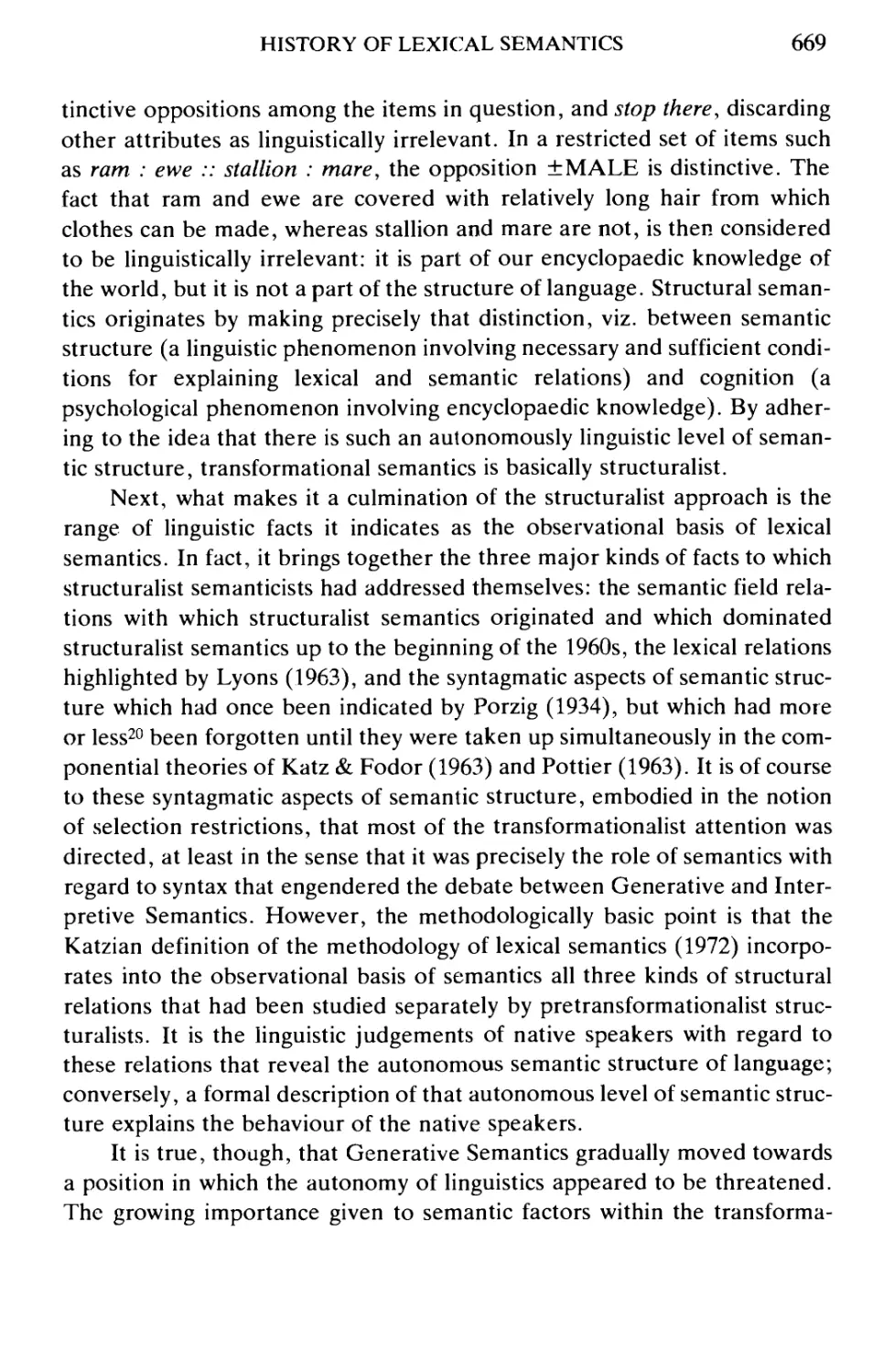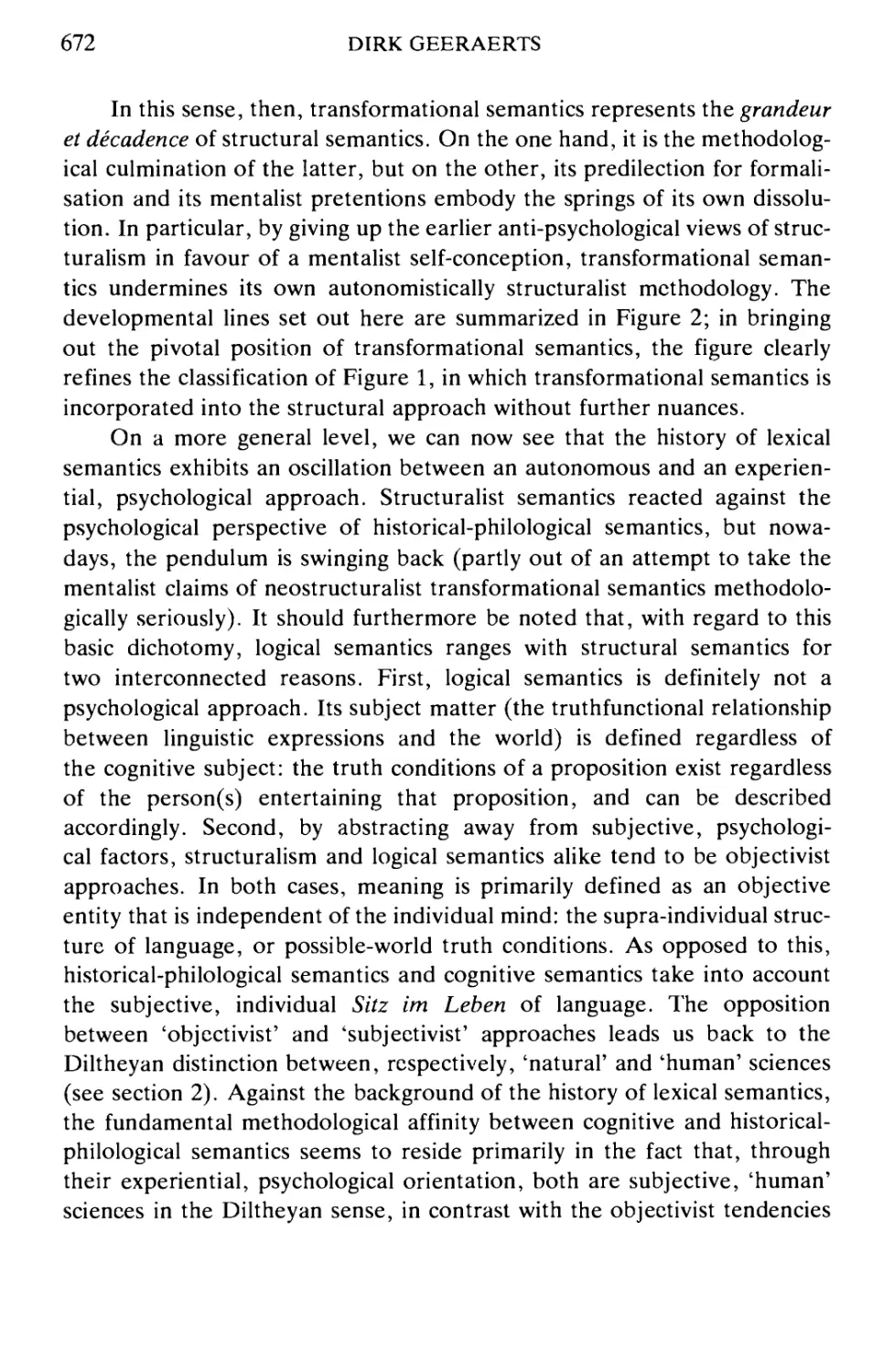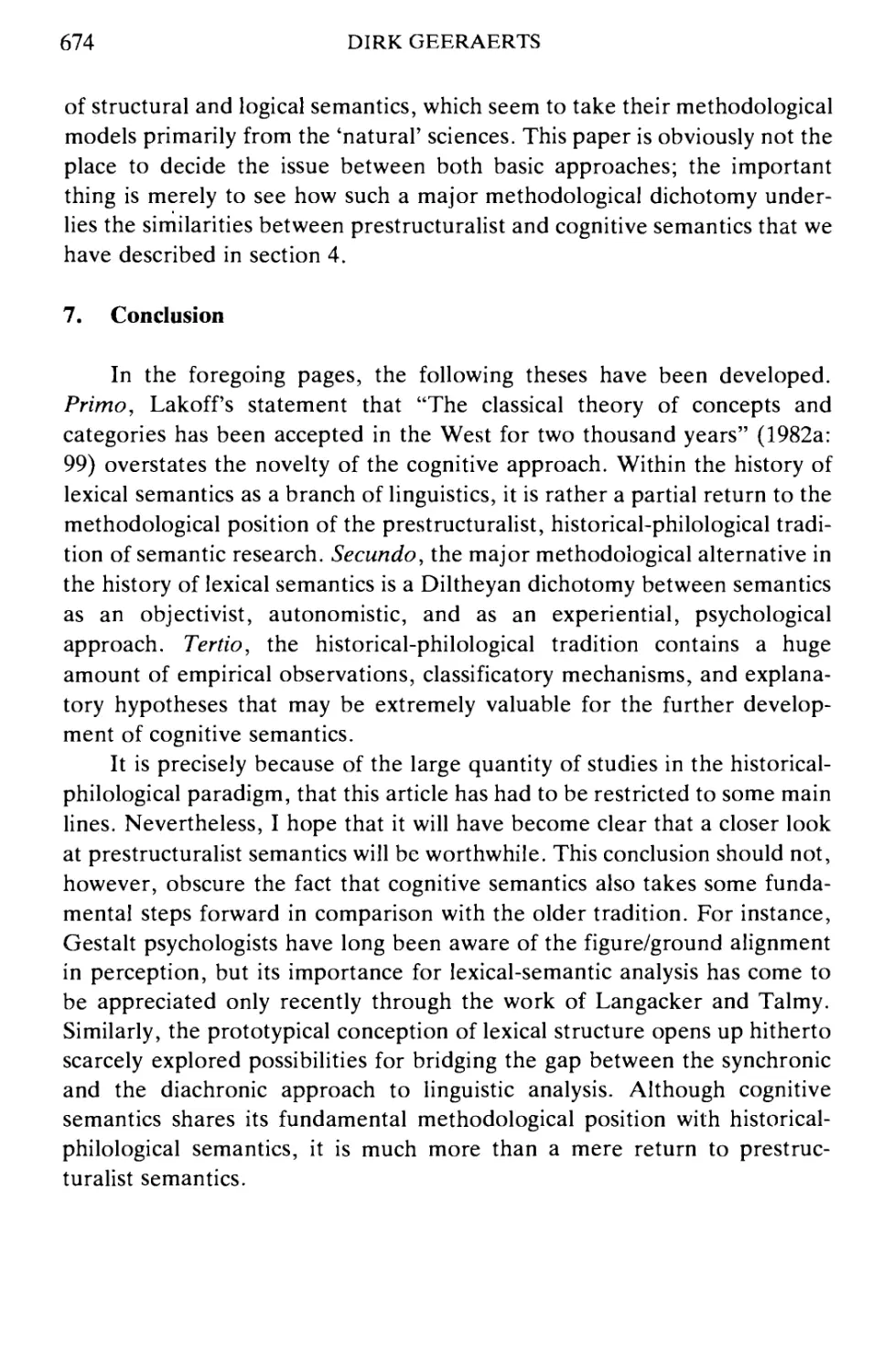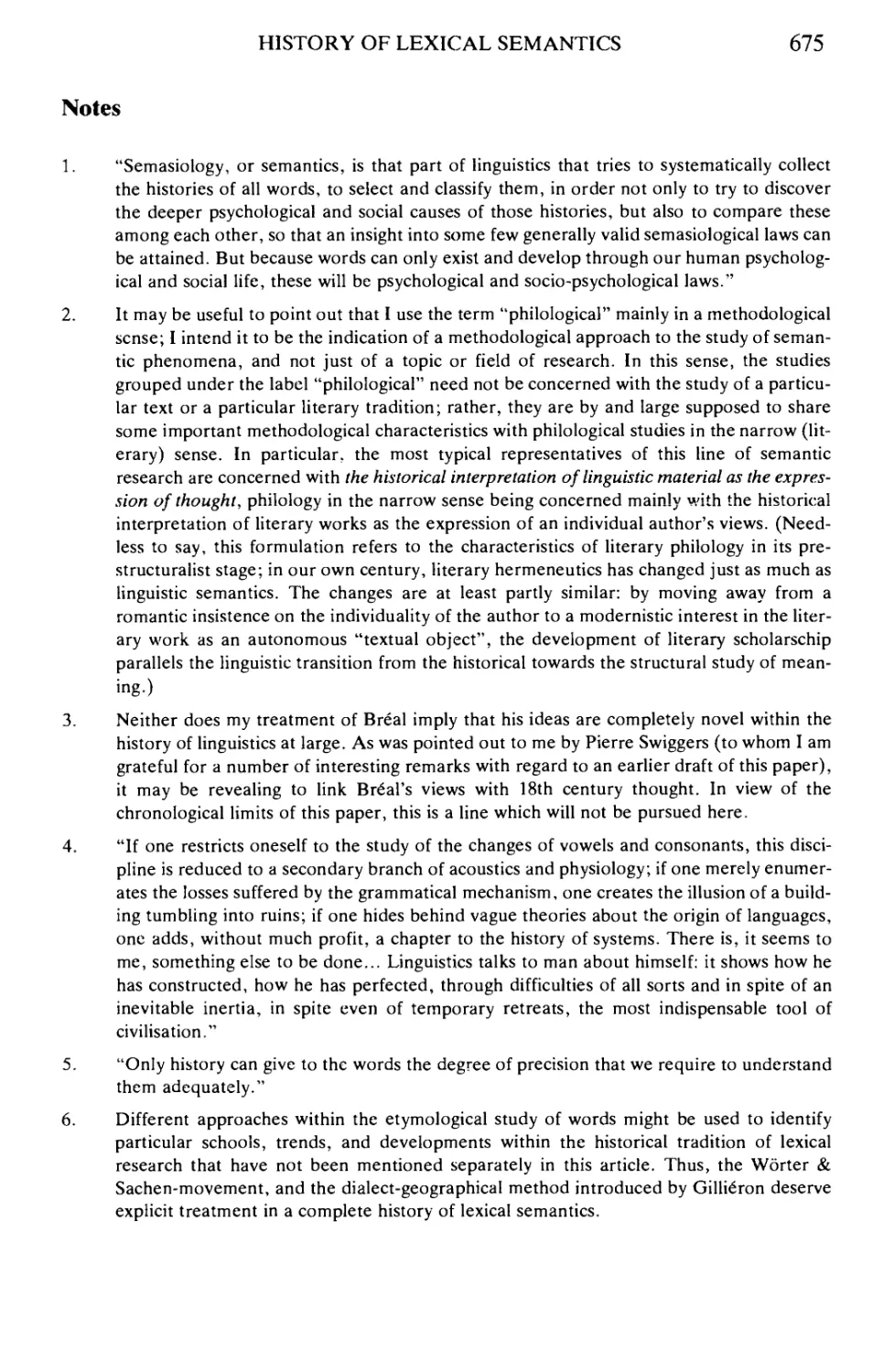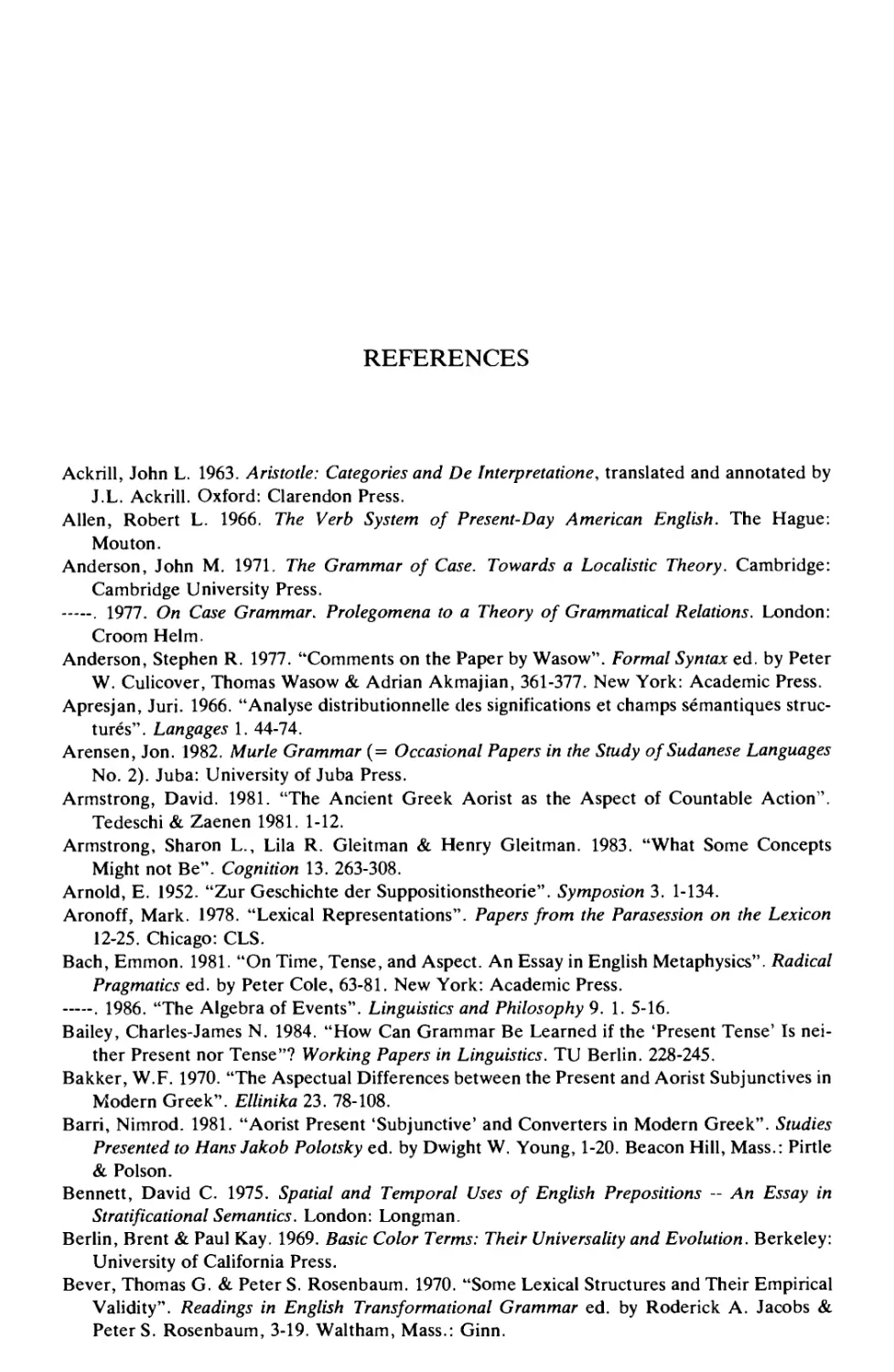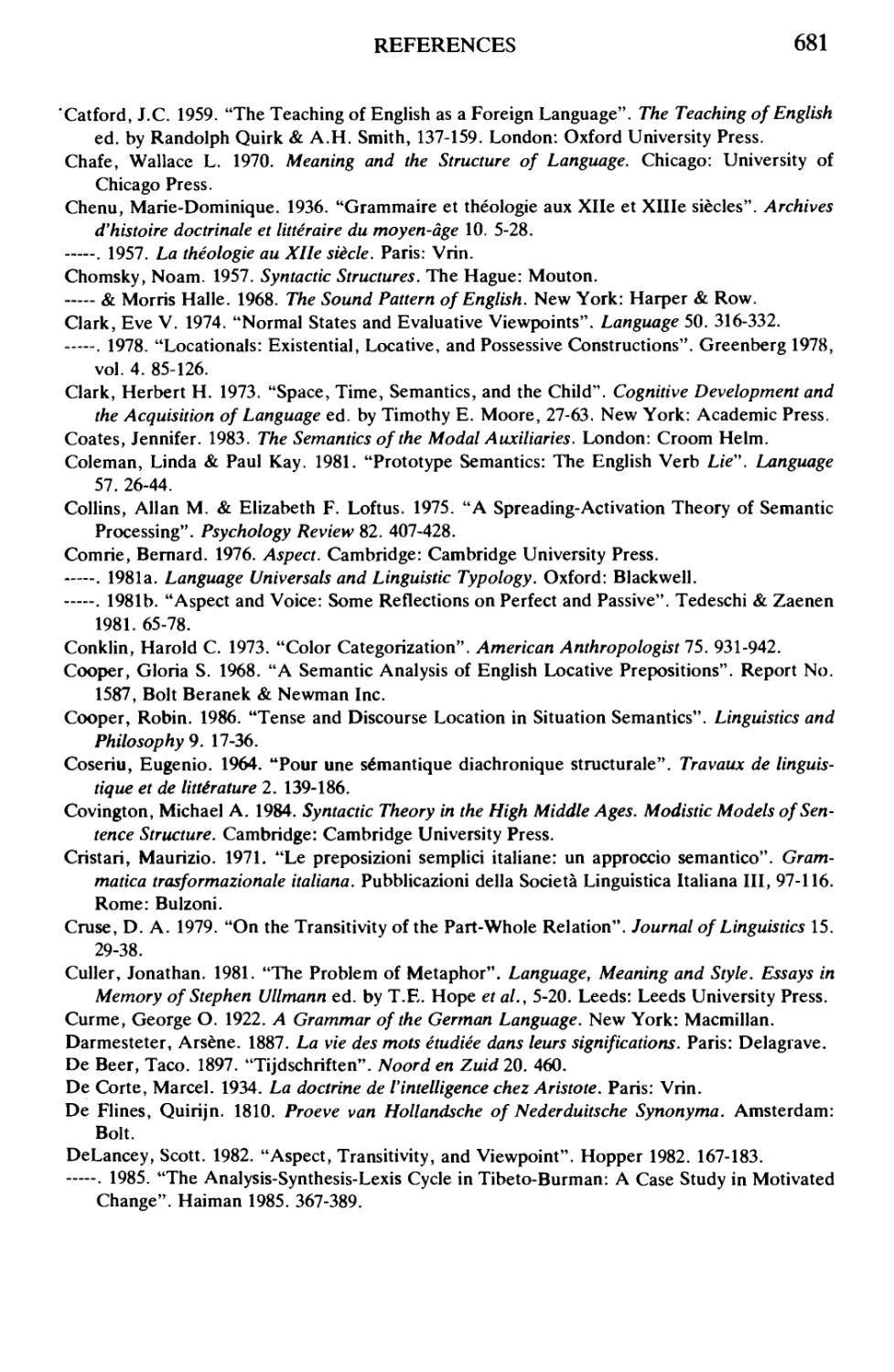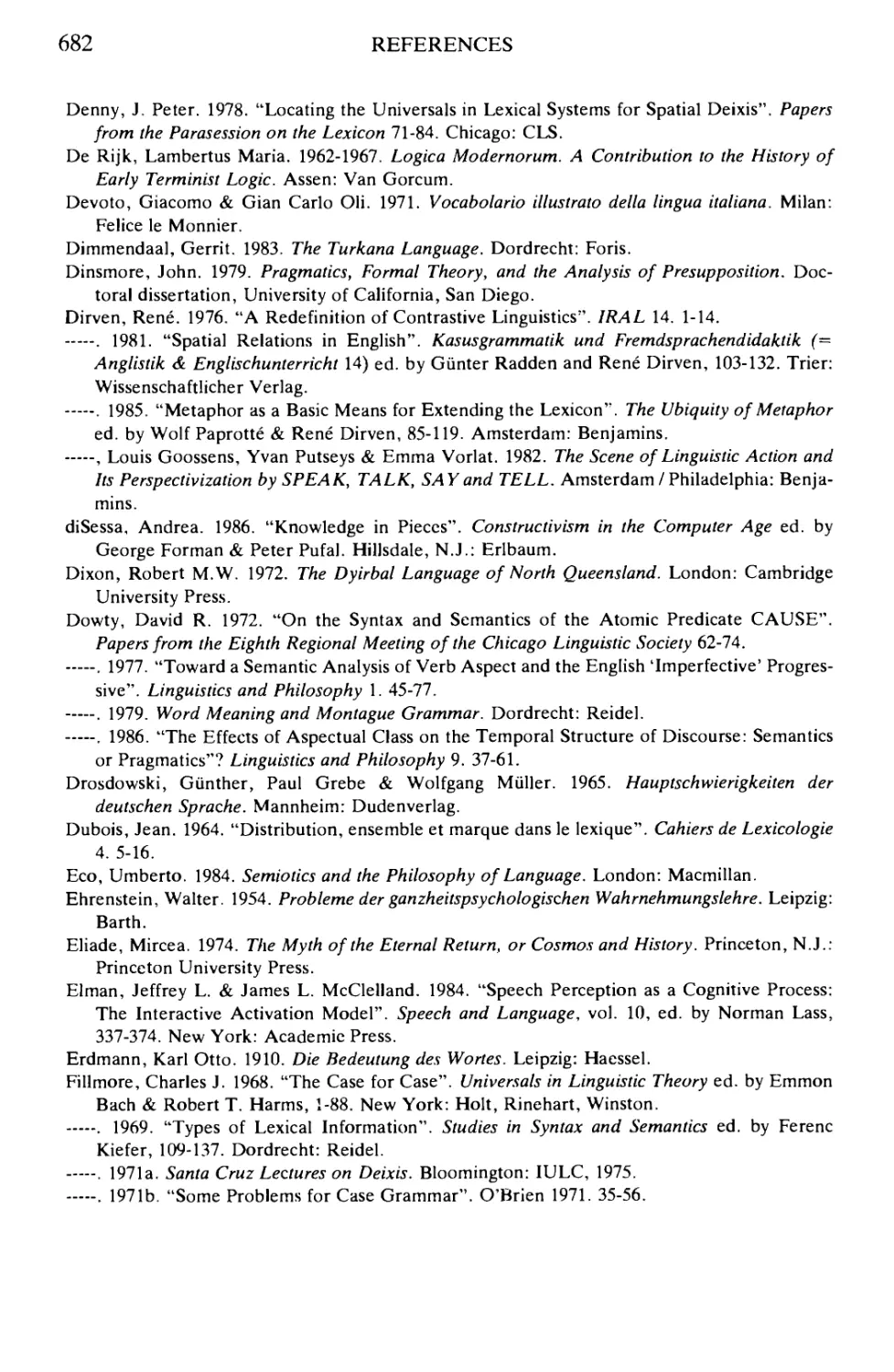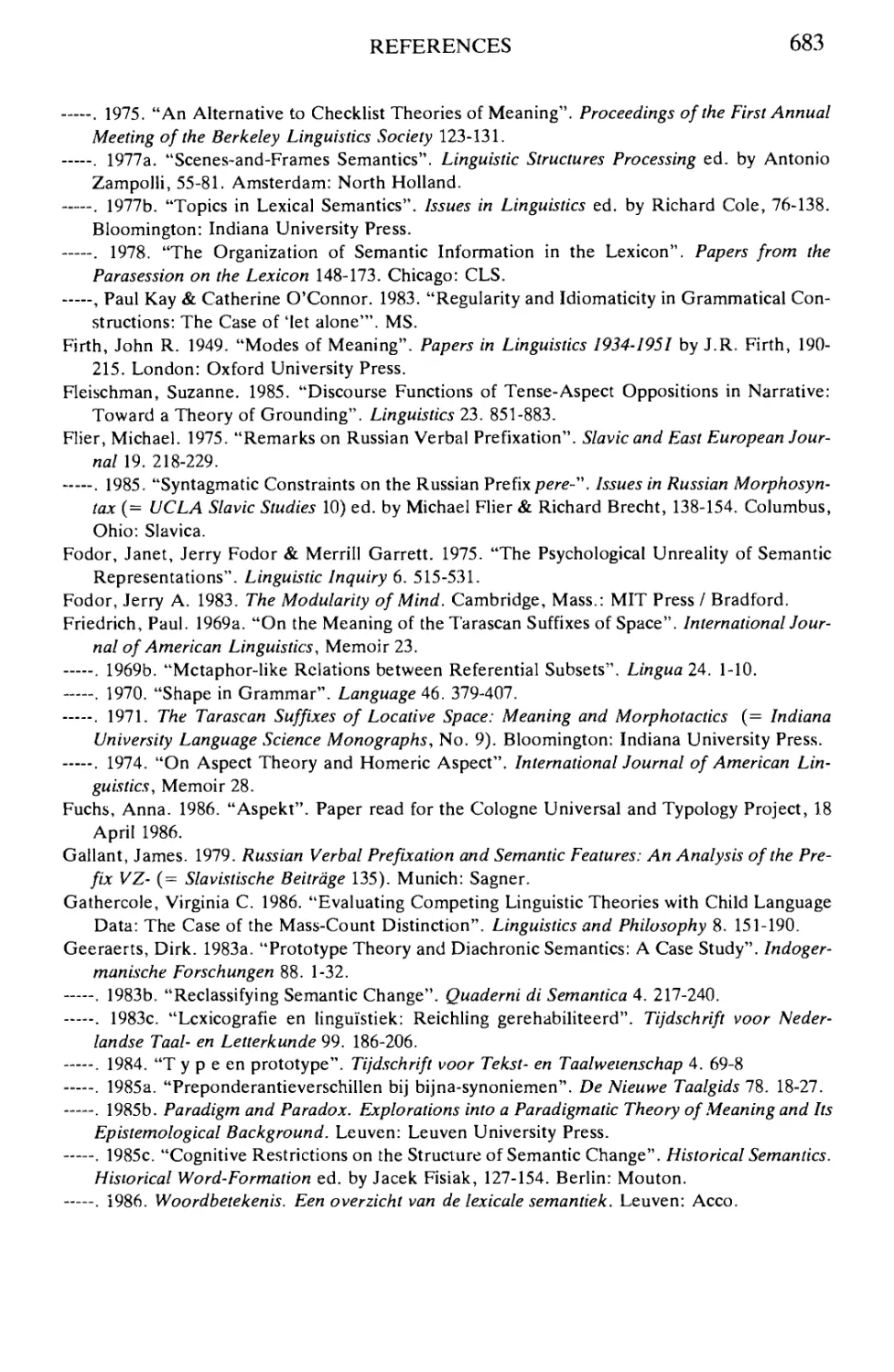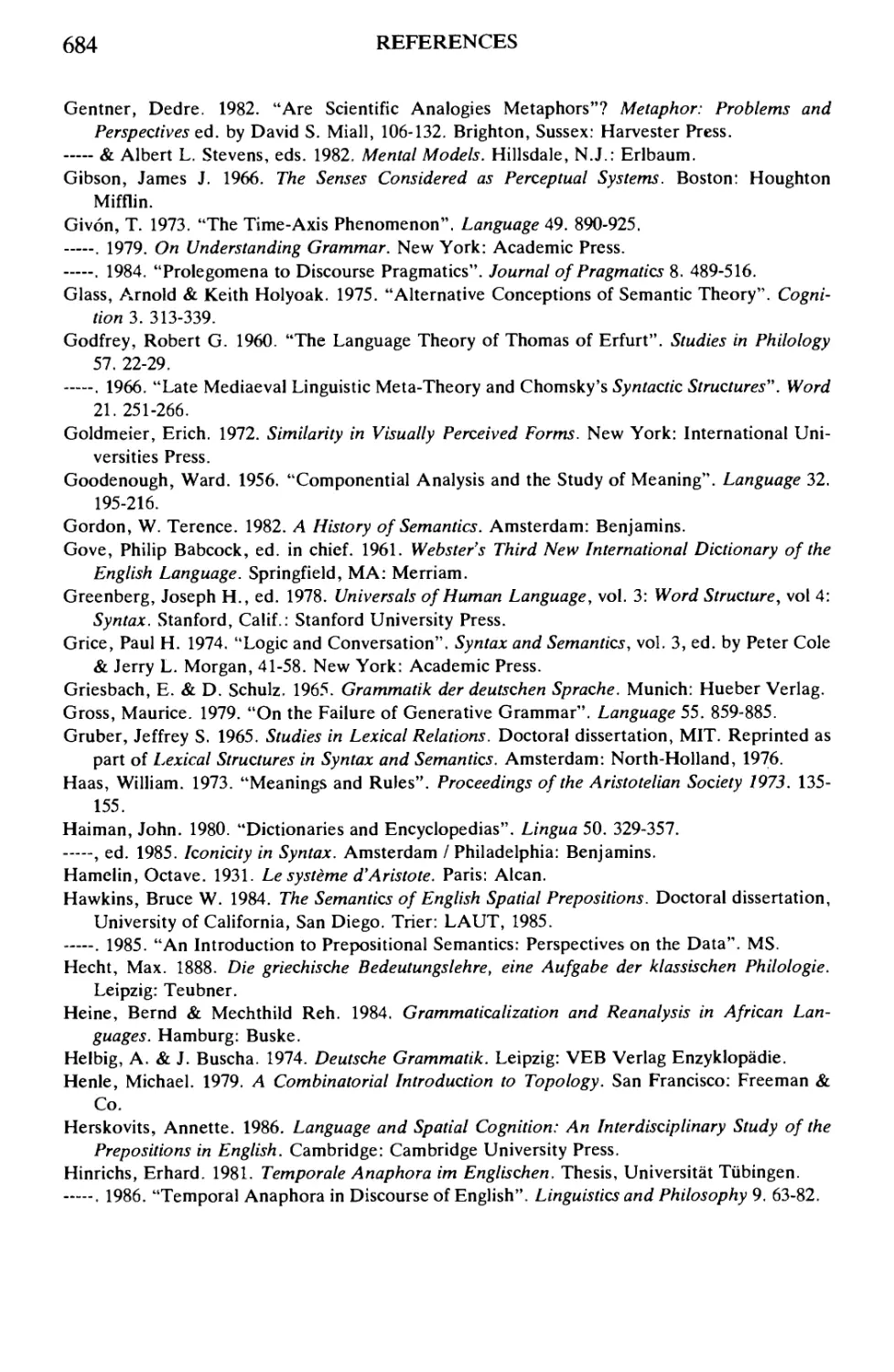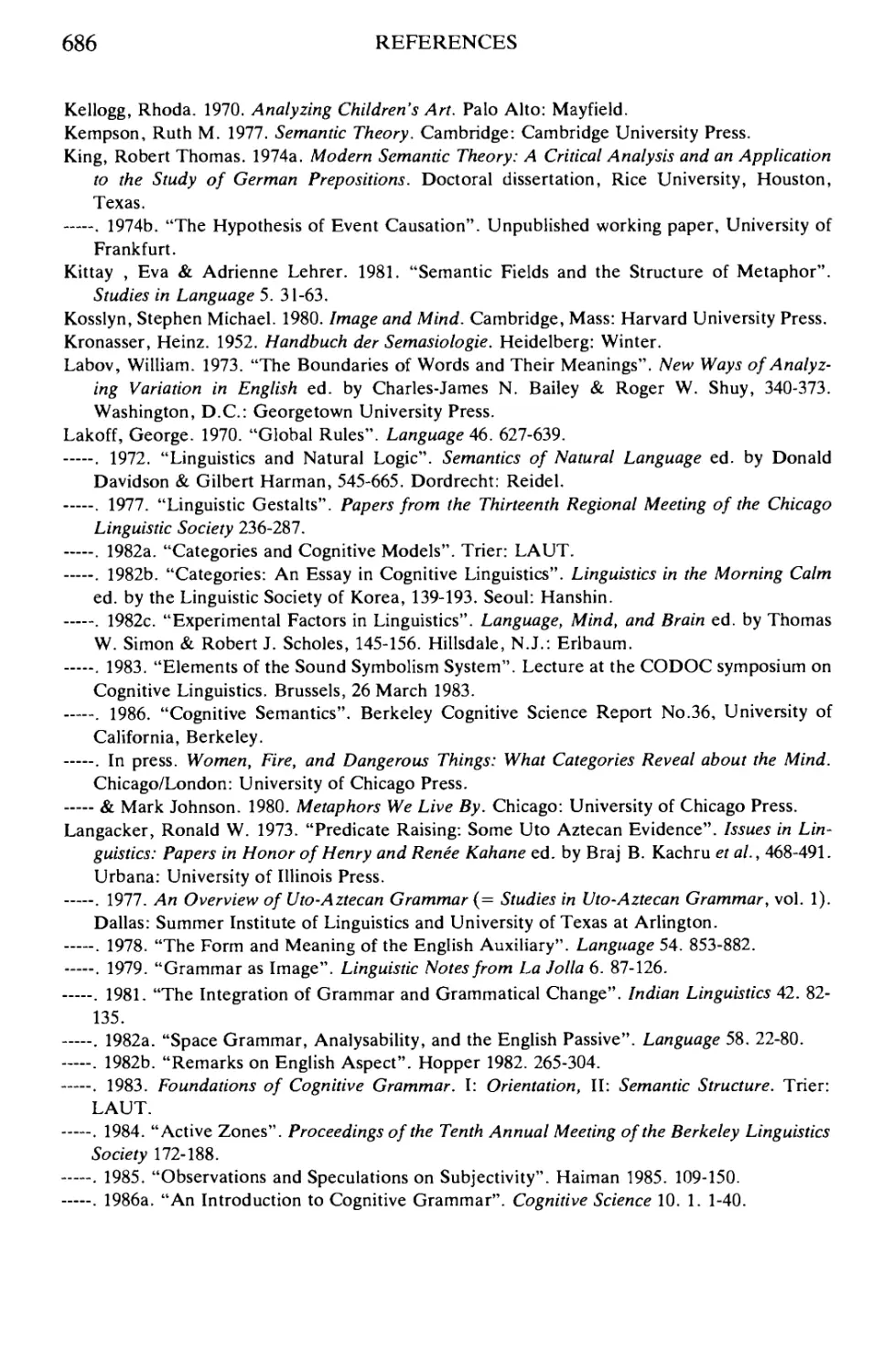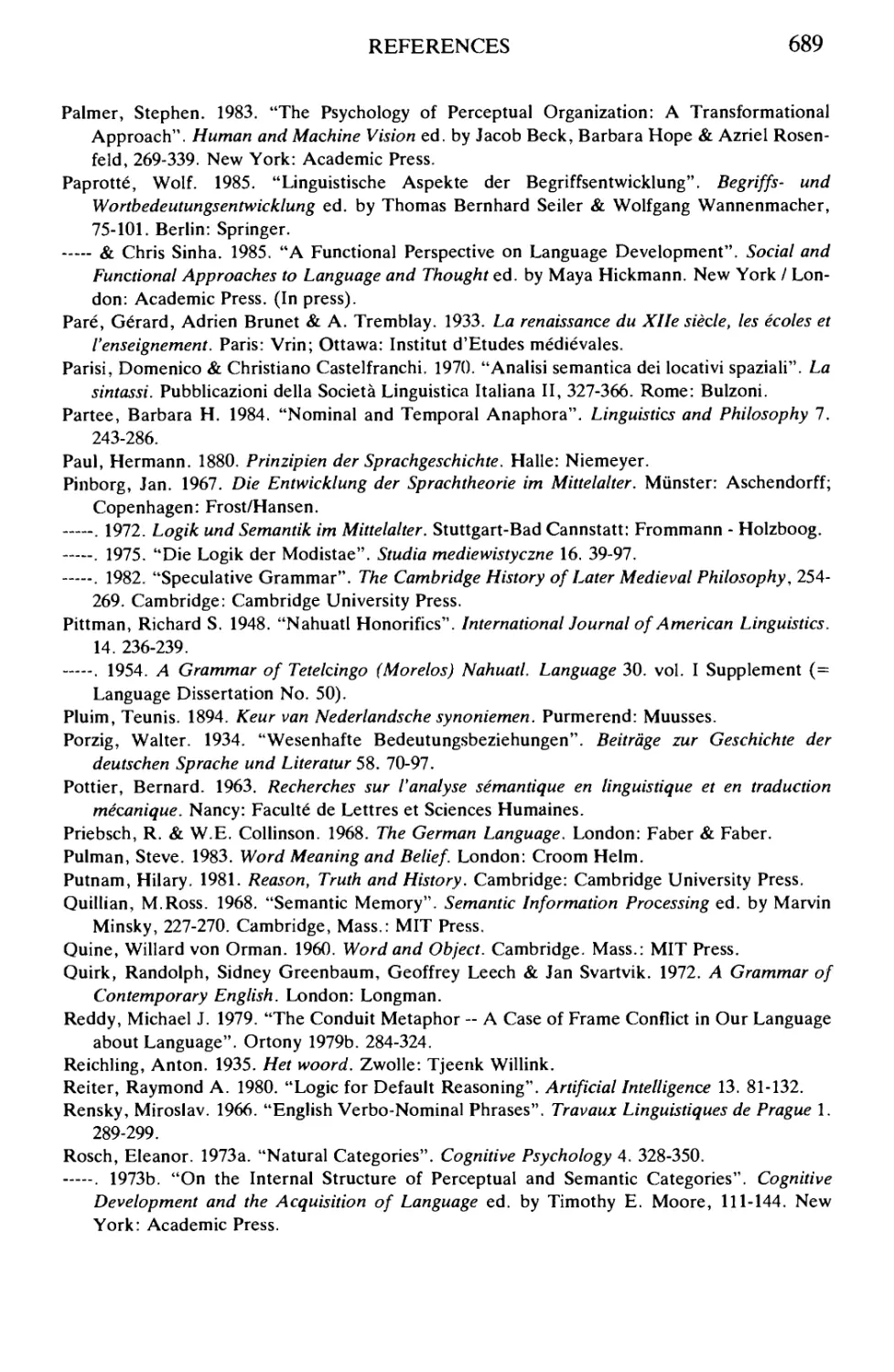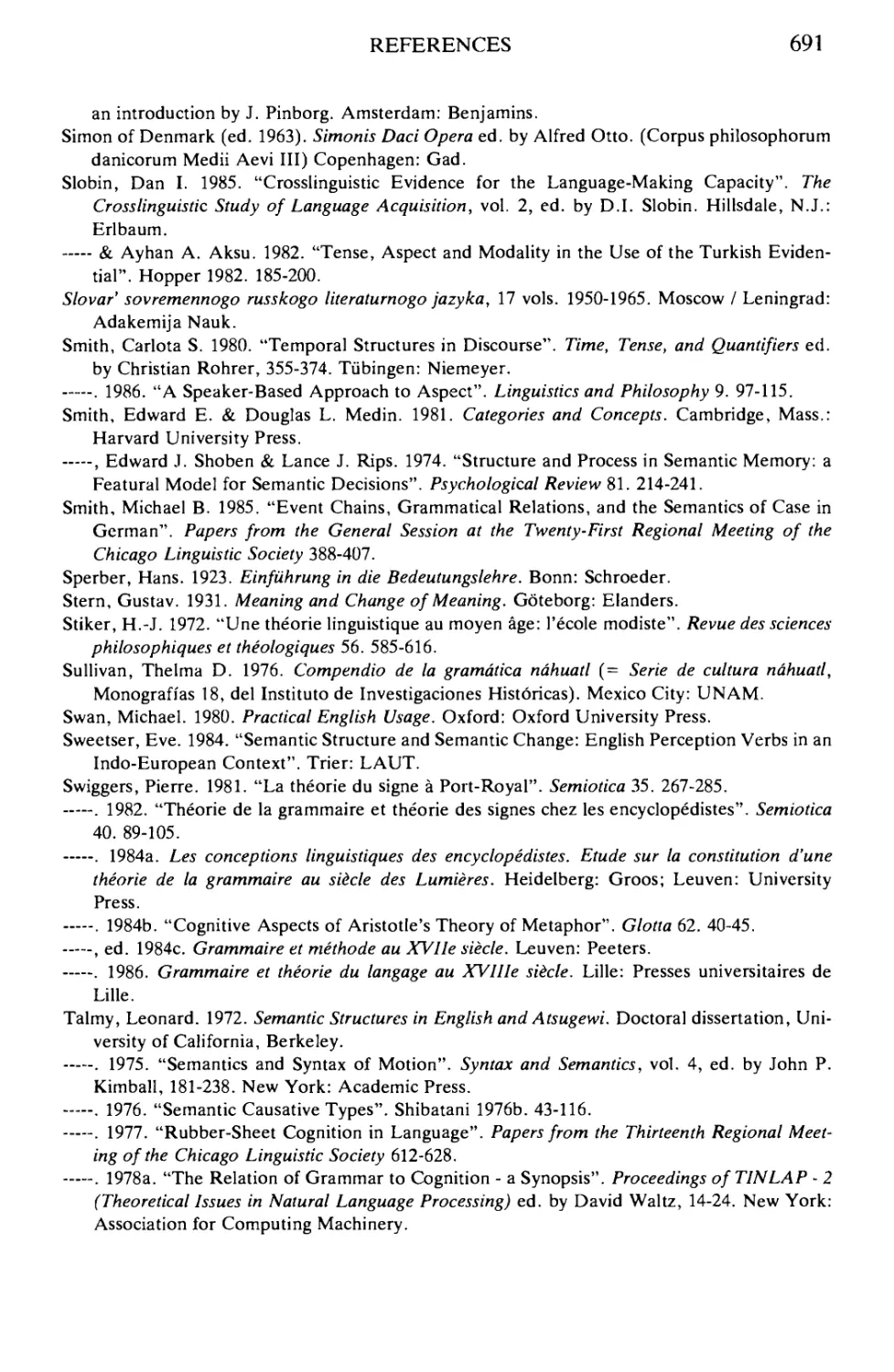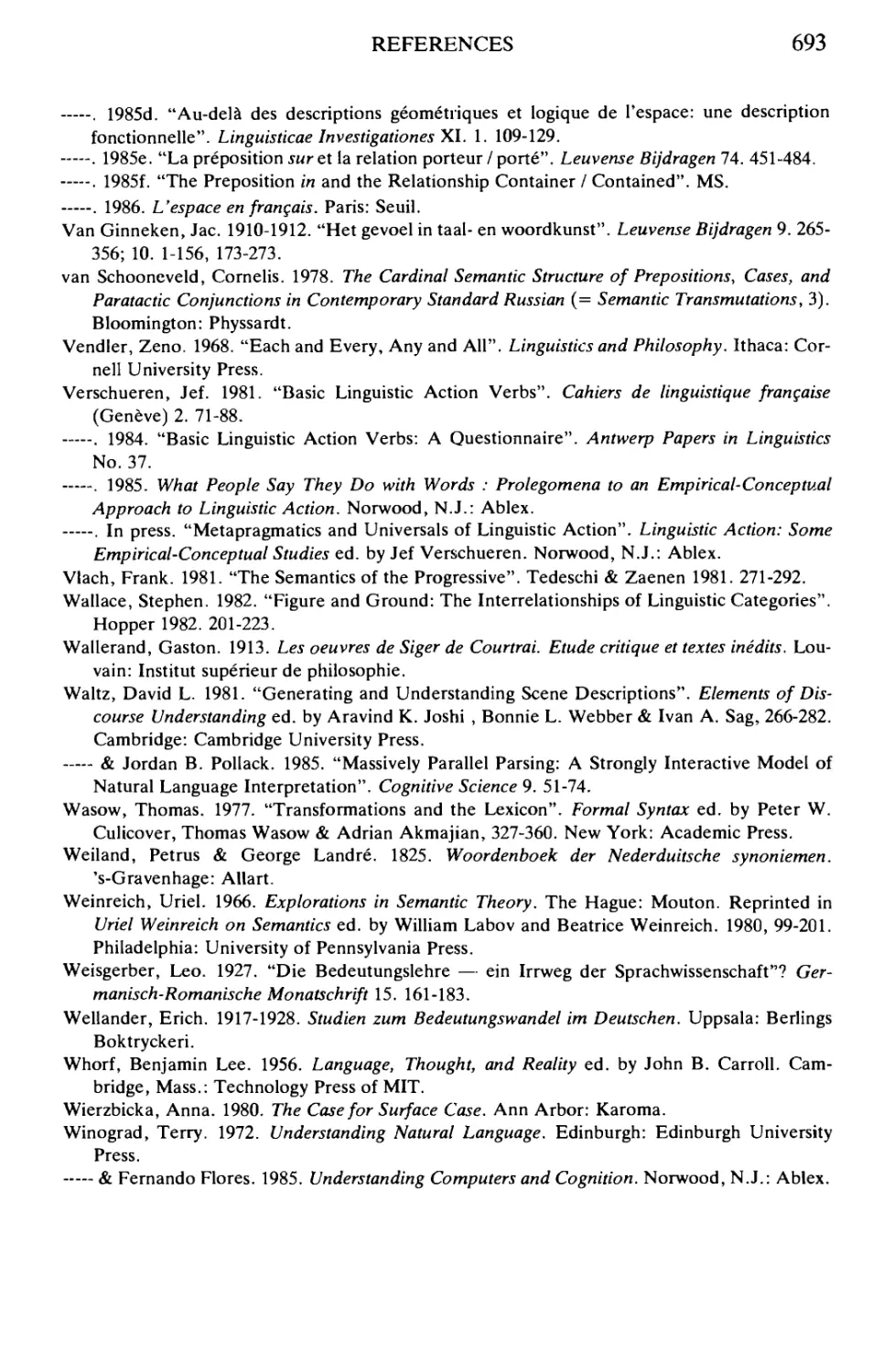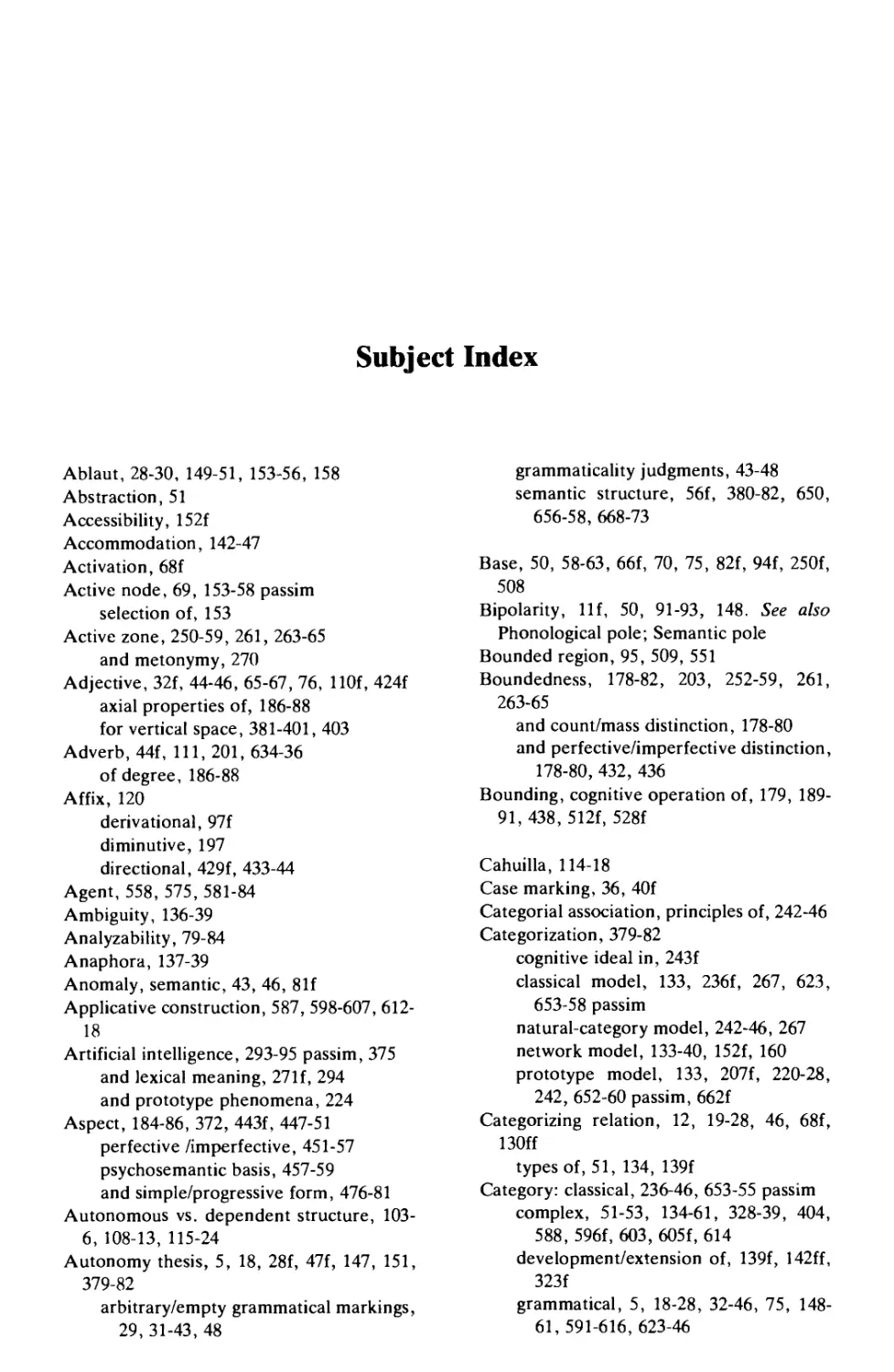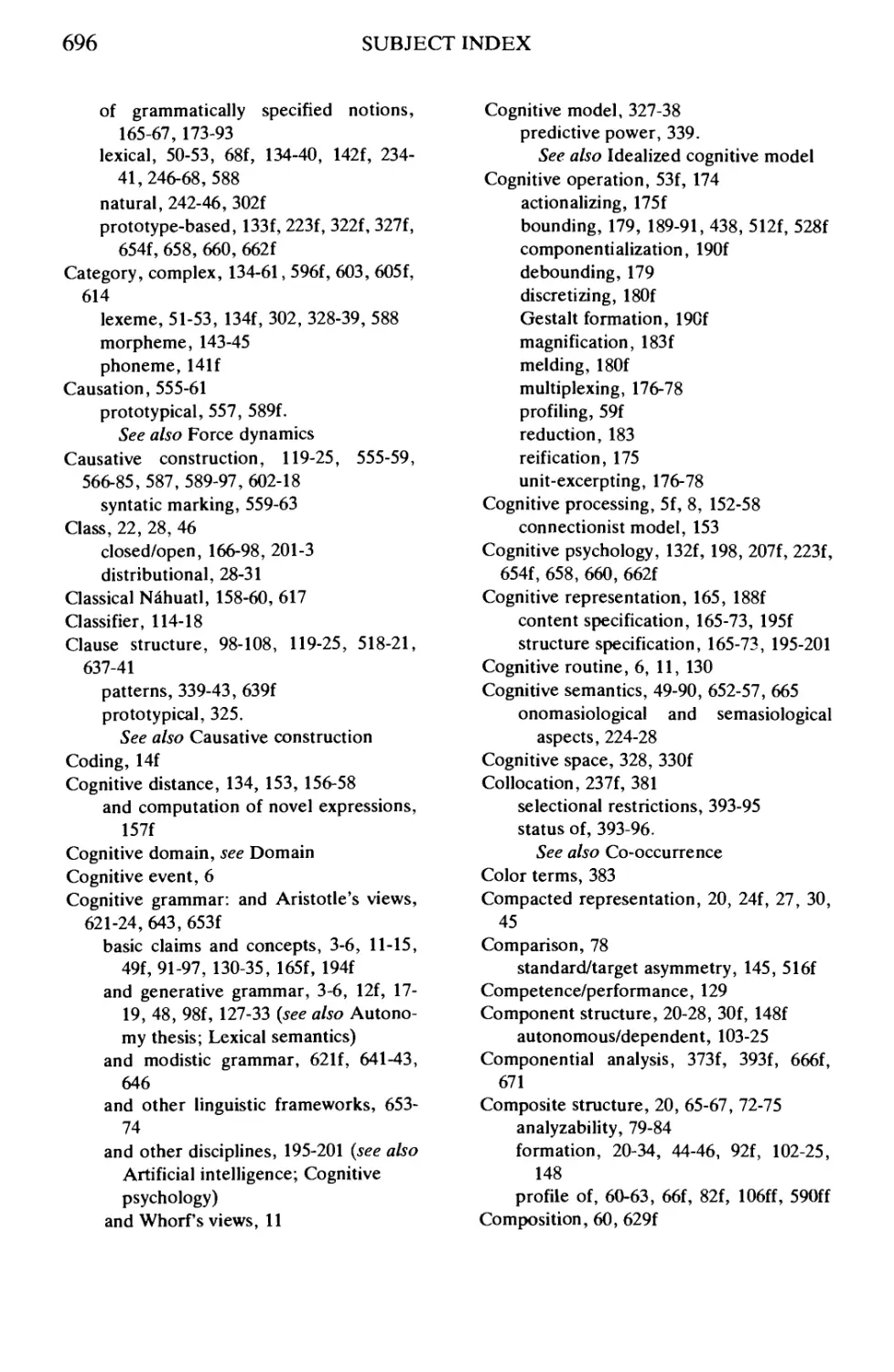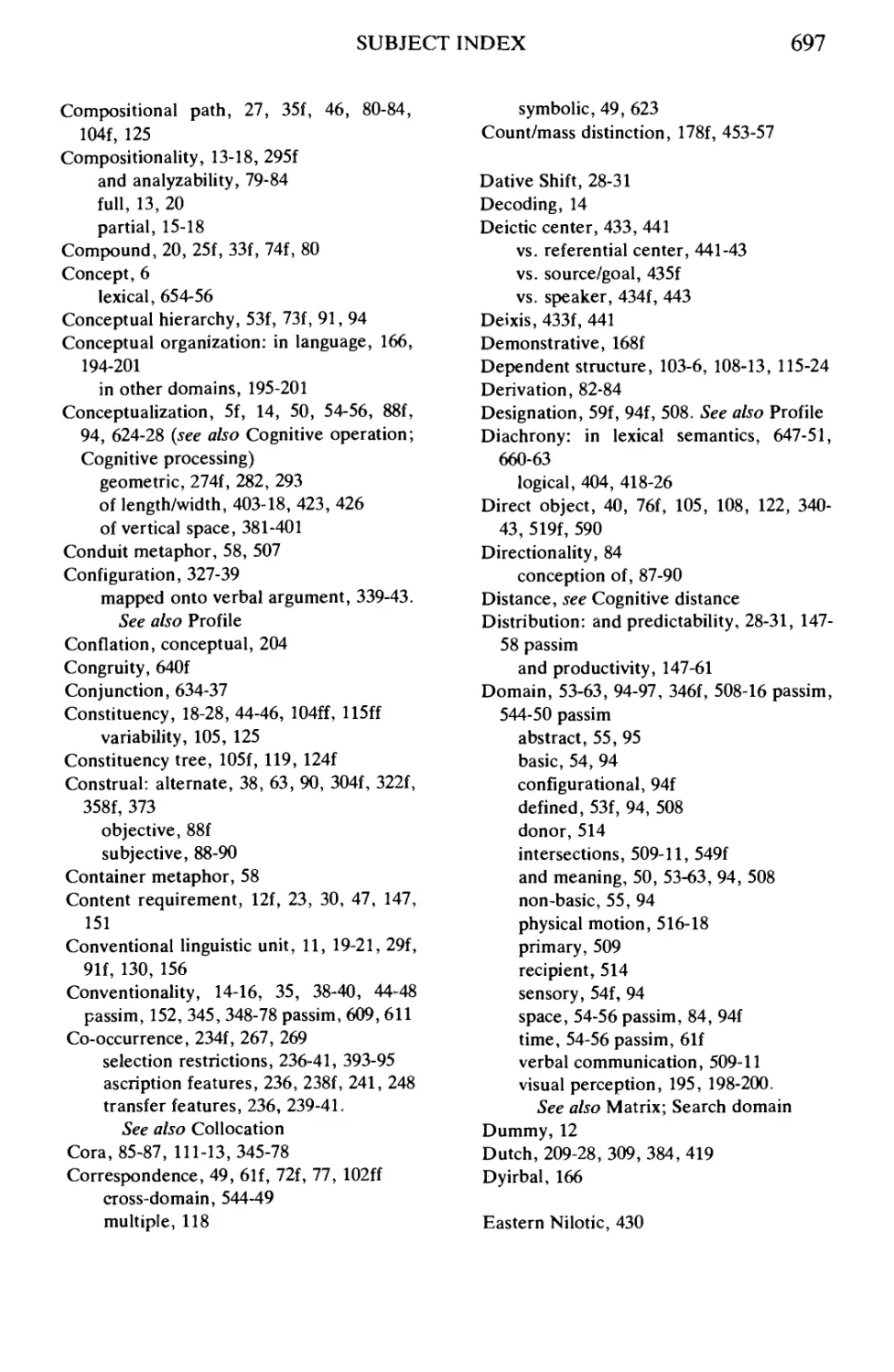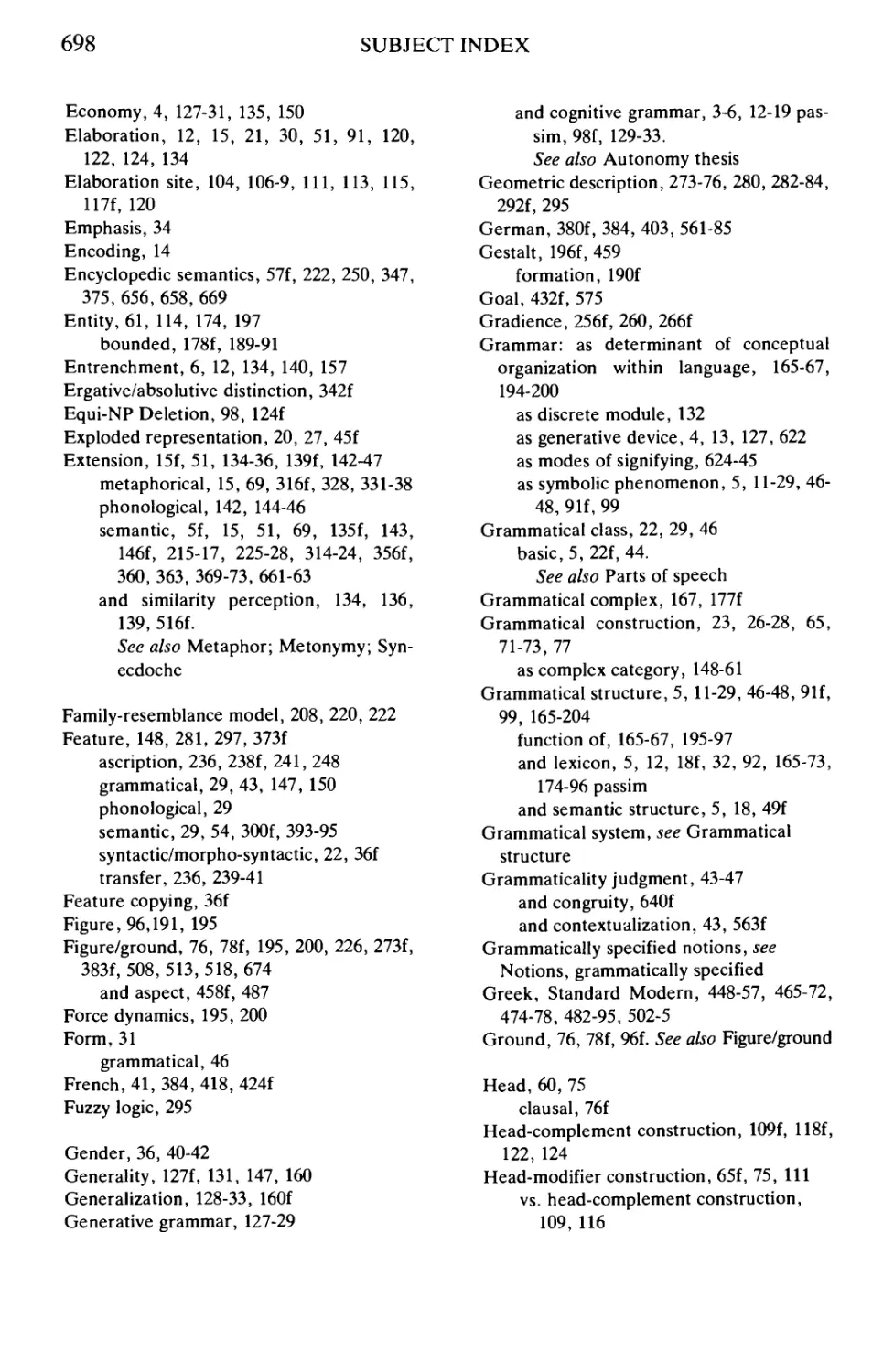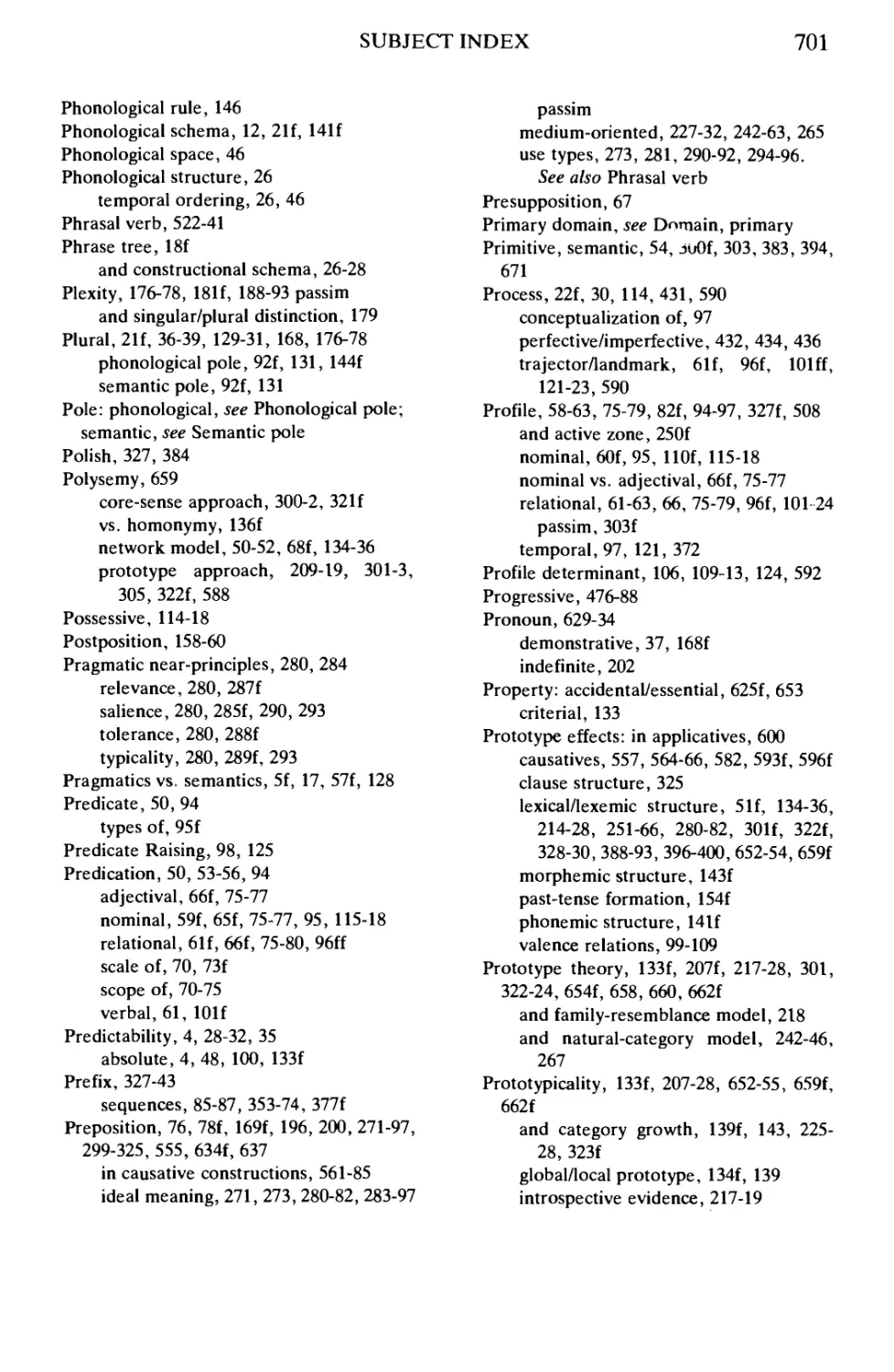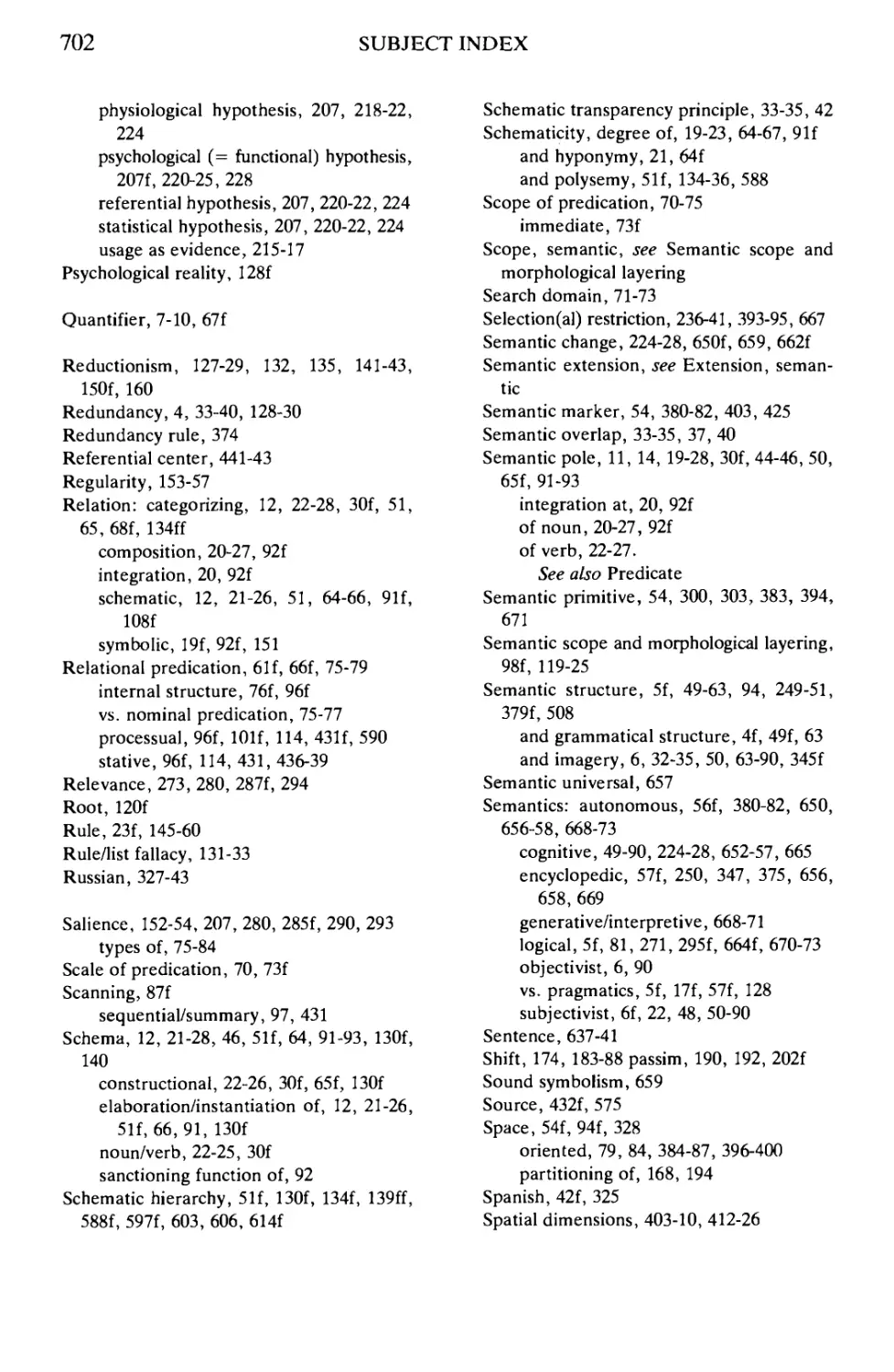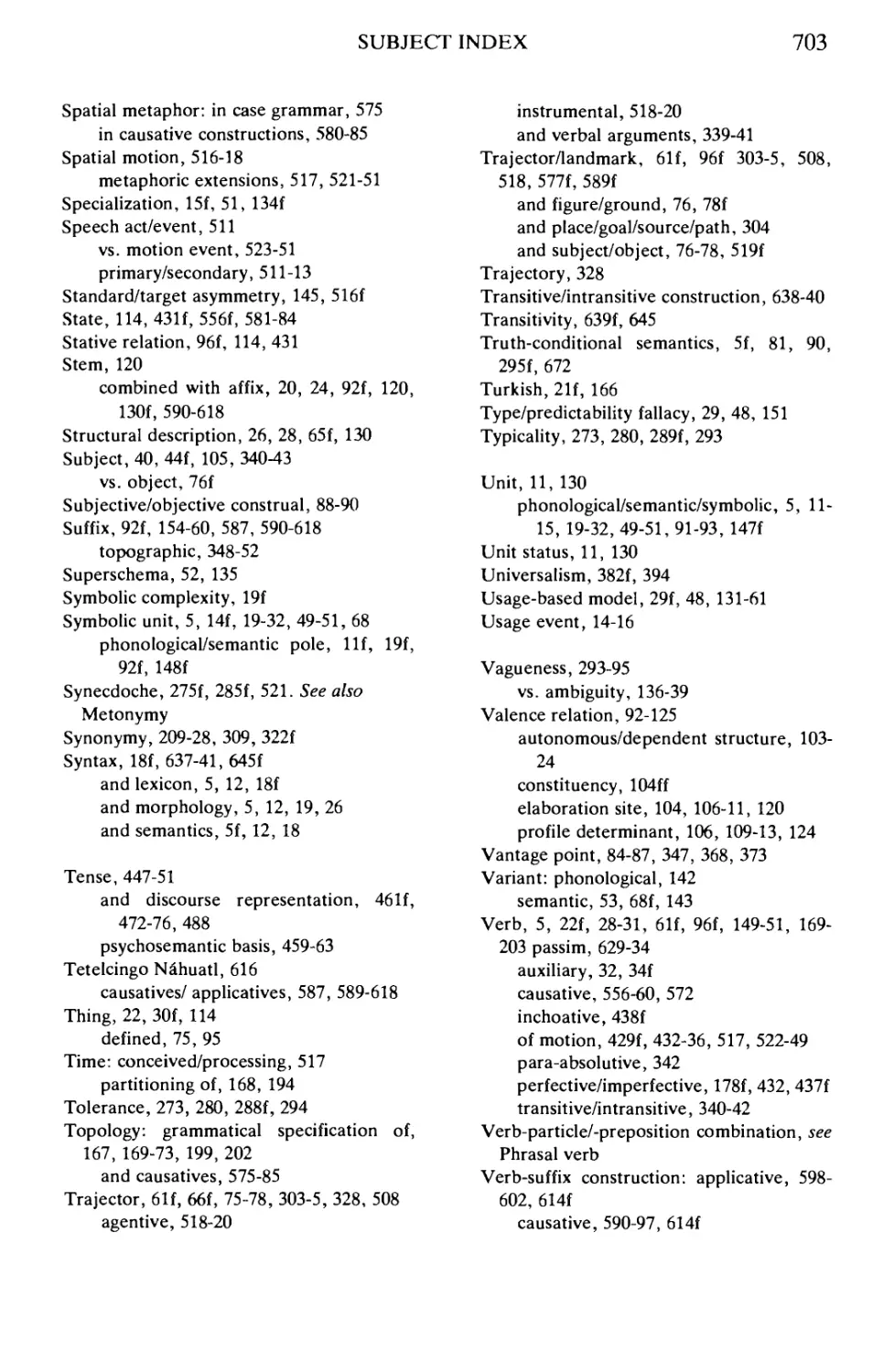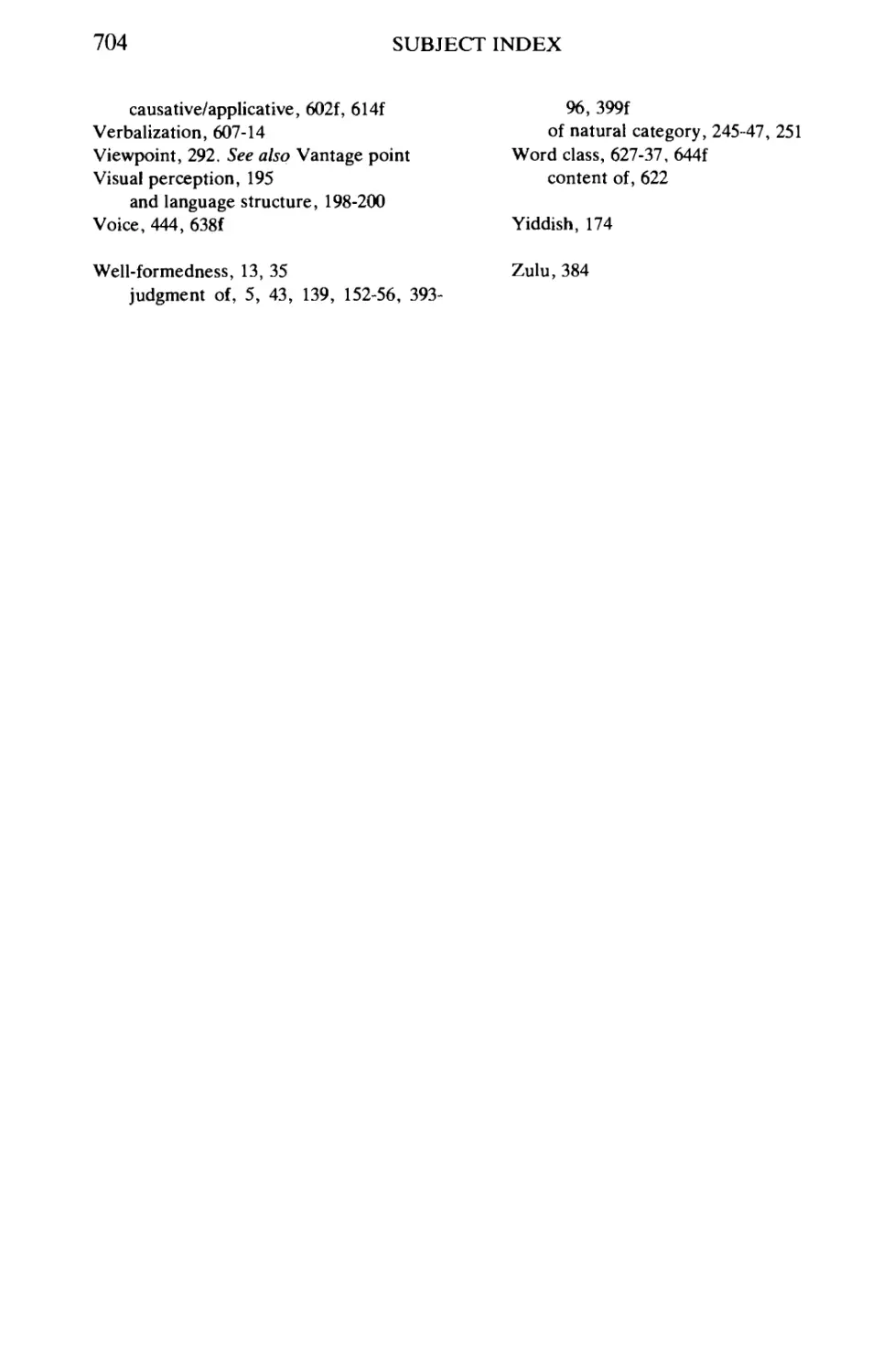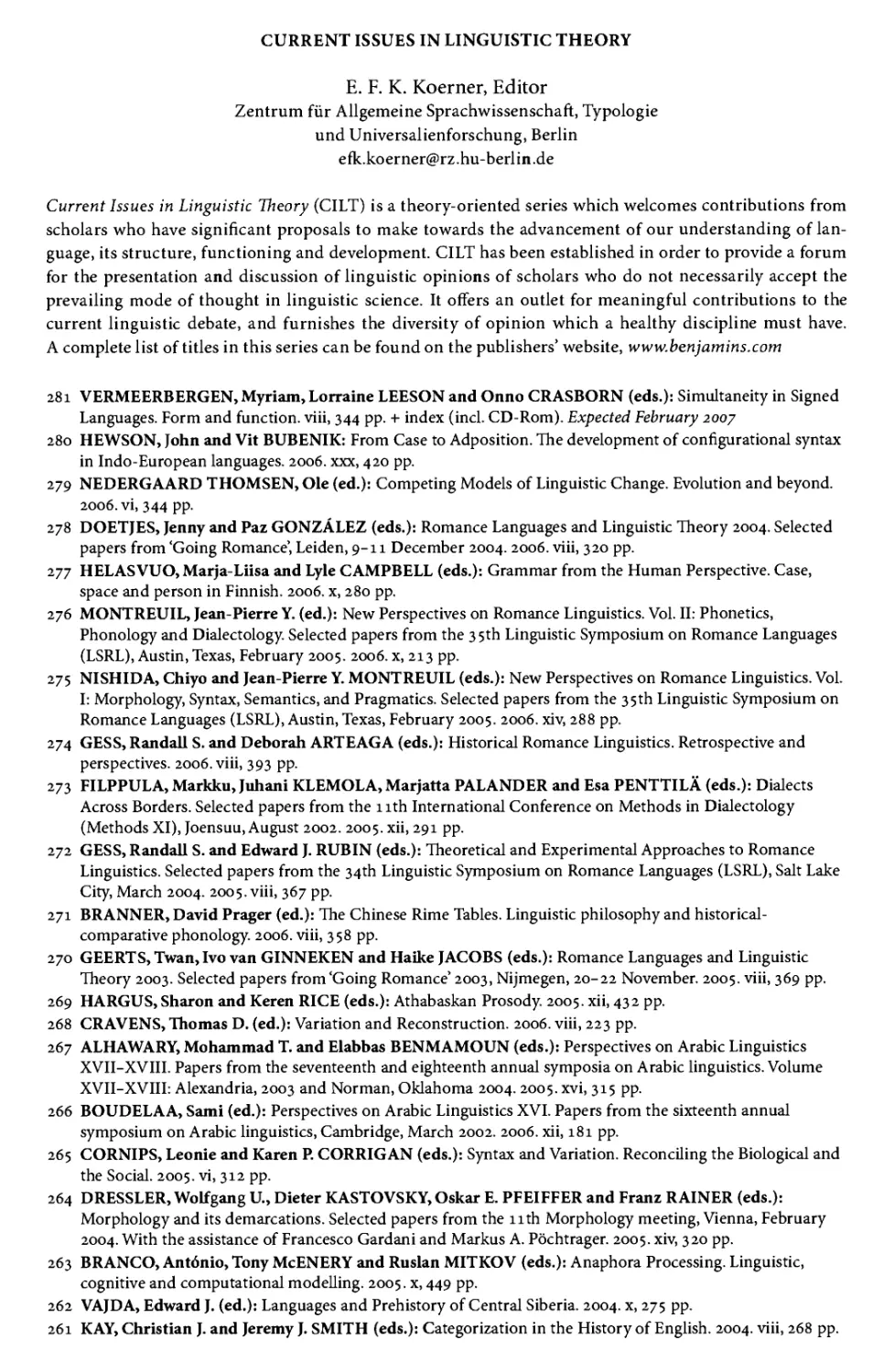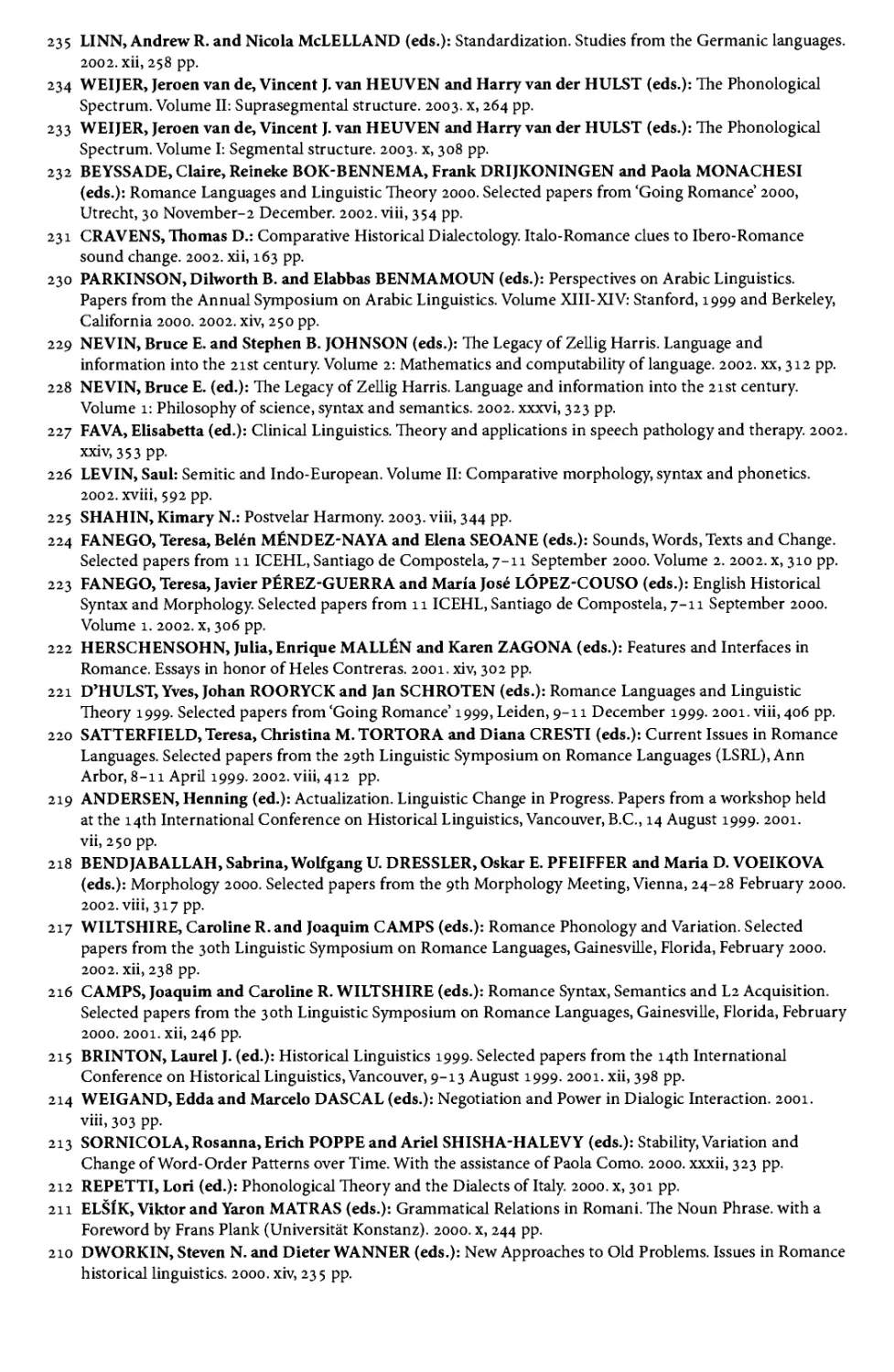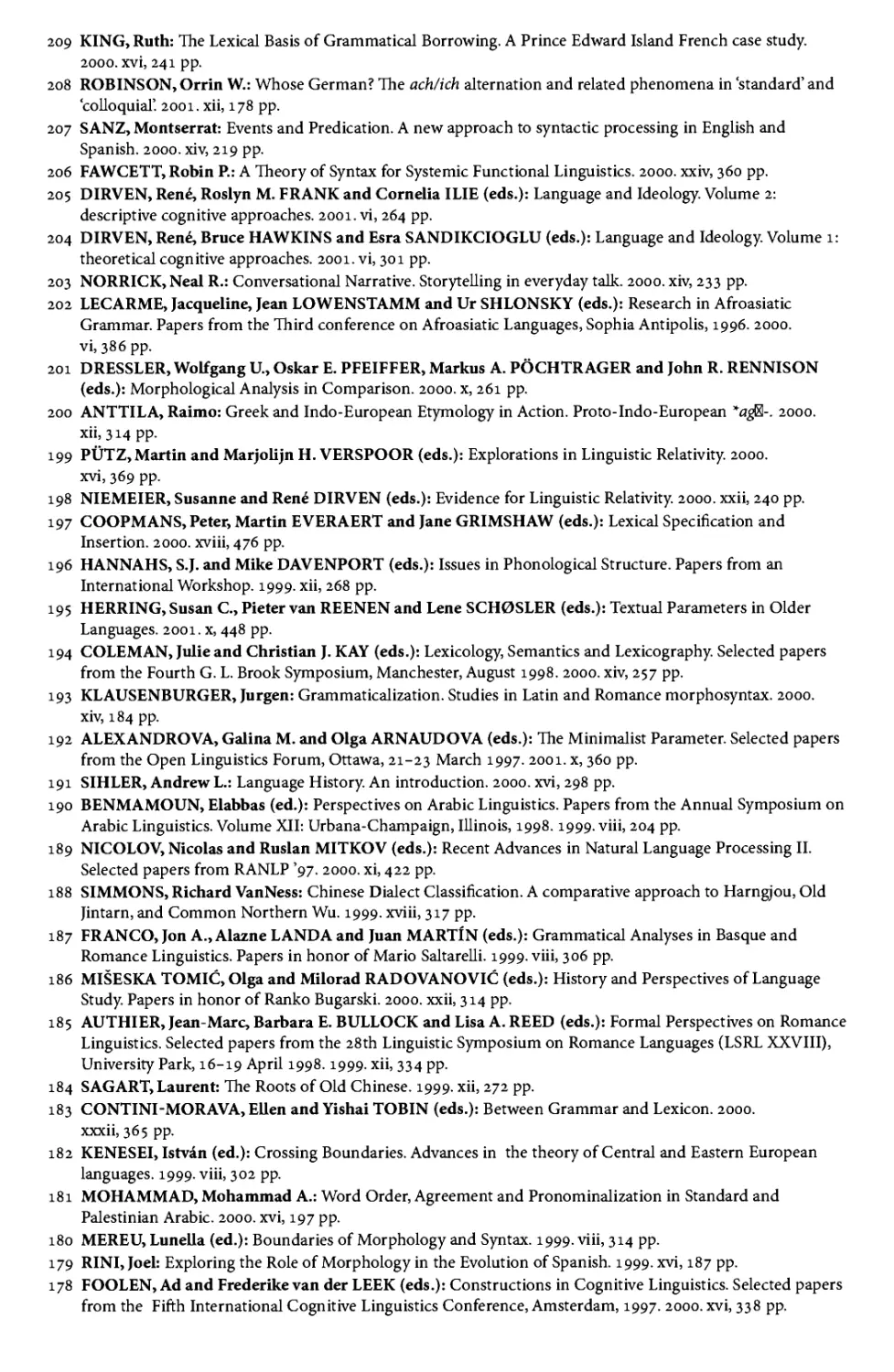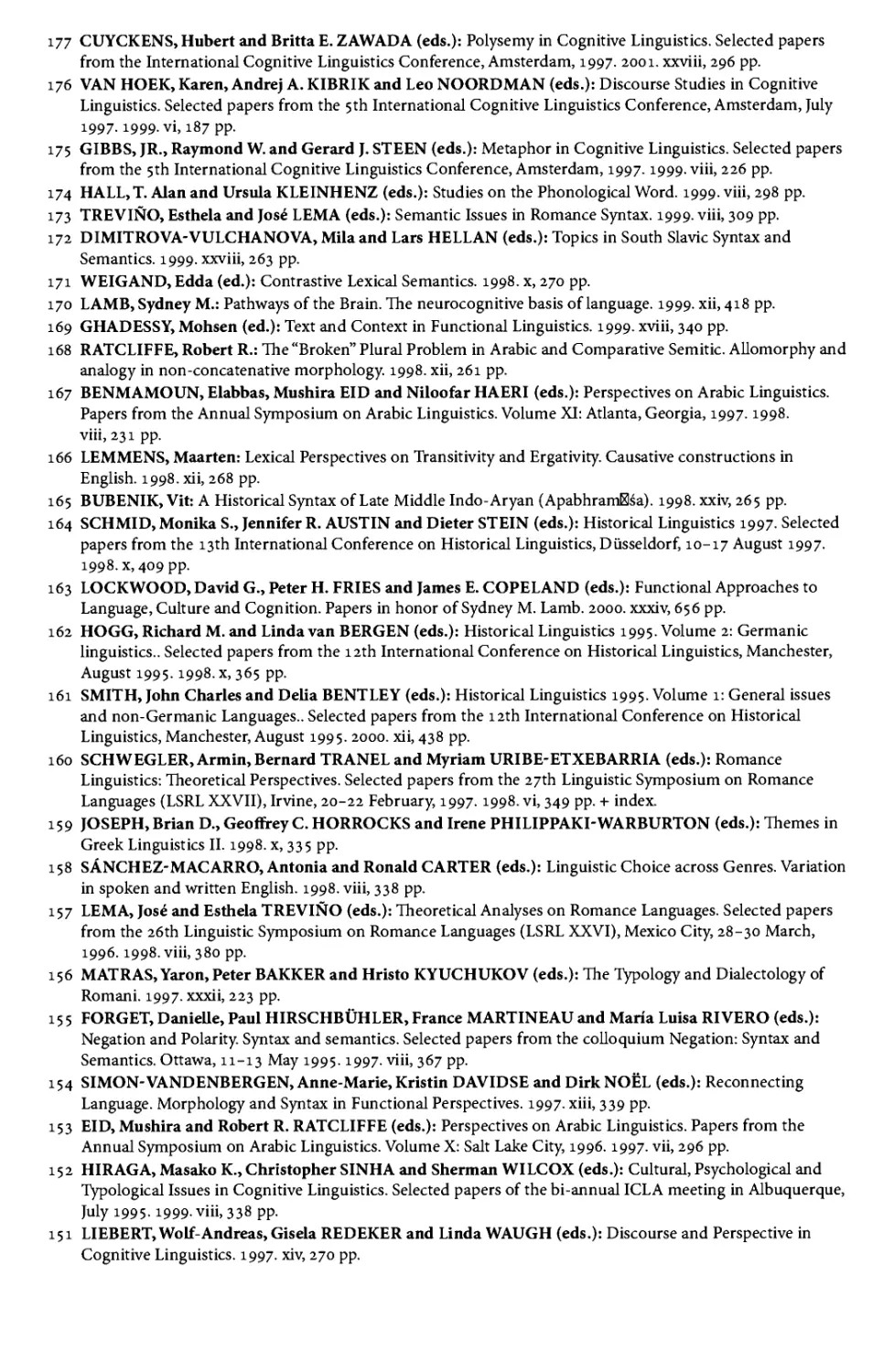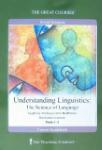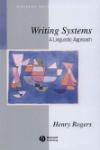Текст
Cur nt Issues in Linguisti Theor o
-L
EDITED BY
Br> n'dj Rud ka- si n
JOH BEN) INS PUBLISHI C CO P NY
TOPICS IN COGNITIVE LINGUISTICS
AMSTERDAM STUDIES IN THE THEORY AND
HISTORY OF LINGUISTIC SCIENCE
General Editor
E.F. KONRAD KOERNER
(University of Ottawa)
Series IV - CURRENT ISSUES IN LINGUISTIC THEORY
Advisory Editorial Board
Henning Andersen (Buffalo, N.Y.); Raimo Anttila (Los Angeles)
Thomas V. Gamkrelidze (Tbilisi); Hans-Heinrich Lieb (Berlin)
J. Peter Maher (Chicago); Ernst Pulgram (Ann Arbor, Mich.)
E.Wyn Roberts (Vancouver, B.C.); Danny Steinberg (Tokyo)
Volume 50
Brygida Rudzka-Ostyn (ed.)
TOPICS IN COGNITIVE LINGUISTICS
TOPICS IN
COGNITIVE LINGUISTICS
Edited by
BRYGIDA RUDZKA-OSTYN
University of Leuven
JOHN BENJAMINS PUBLISHING COMPANY
AMSTERDAM/PHILADELPHIA
1988
Library of Congress Cataloging-in-Publication Data
Topics in cognitive linguistics / edited by Brygida Rudzka-Ostyn
p. cm. — (Amsterdam studies in the theory and history of linguistic science.
Series IV, Current issues in linguistic theory, ISSN 0304-0763; v. 50)
Bibliography: p.
Includes index.
1. Cognitive grammar. I. Rudzka-Ostyn, Brygida. II. Series.
P165.T65 1988
415--de 19 87-37495
ISBN 90 272 3544 9 (alk. paper) CIP
© Copyright 1988 - All rights reserved
No part of this book may be reproduced in any form, by print, photoprint, microfilm, or
any other means, without written permission of the copyright holders. Please direct all
enquiries to the publishers.
To the memory of my mother
Contents
Preface ix
I. Toward a Coherent and Comprehensive Linguistic Theory
An Overview of Cognitive Grammar
Ronald W. Langacker
A View of Linguistic Semantics
Ronald W. Langacker
The Nature of Grammatical Valence
Ronald W. Langacker
A Usage-Based Model
Ronald W. Langacker
II. Aspects of a Multifaceted Research Program
The Relation of Grammar to Cognition
Leonard Talmy
Where Does Prototypicality Come From?
Dirk Geeraerts
The Natural Category MEDIUM: An Alternative to Selection
Restrictions and Similar Constructs 231
Bruce W. Hawkins
Spatial Expressions and the Plasticity of Meaning 271
Annette Herskovits
Contrasting Prepositional Categories: English and Italian 299
John R. Taylor
The Mapping of Elements of Cognitive Space onto Grammatical
Relations: An Example from Russian Verbal Prefixation 327
Laura A. Janda
3
49
91
127
165
207
Vlll
CONTENTS
Conventionalization of Cora Locationals 345
Eugene H. Casad
The Conceptualisation of Vertical Space in English: The Case of Tall 379
Rene Dirven and John R. Taylor
Length, Width, and Potential Passing 403
Claude Vandeloise
On Bounding in Ik 429
Fritz Serzisko
A Discourse Perspective on Tense and Aspect in Standard Modern
Greek and English 447
Wolf Paprotte
Semantic Extensions into the Domain of Verbal Communication 507
Brygida Rudzka-Ostyn
Spatial Metaphor in German Causative Constructions 555
Robert Thomas King
Nahuatl Causative/Applicatives in Cognitive Grammar 587
David Tuggy
III. A Historical Perspective
Grammatical Categories and Human Conceptualization:
Aristotle and the Modistae 621
Pierre Swiggers
Cognitive Grammar and the History of Lexical Semantics 647
Dirk Geeraerts
References 679
Subject Index 695
Preface
Recent years have witnessed a growing interest in cognitive linguistics,
a framework aiming at an adequate account of the relationship between
language and cognition and as such involving human psychology,
interpersonal relations, culture, and a host of other domains. Our purpose has been
to present the theoretical premises of this framework and to explore its
descriptive and explanatory potential with respect to a wide range of
language phenomena. In pursuing this goal, we have frequently relied on
corpus analyses, intensive field work, and other means of empirical
verification. Crossing the boundaries of particular languages or language families
has lent additional support to the findings emerging from our research.
If one had to name a key notion of cognitive grammar, one would
certainly point to the dependence of linguistic structure on conceptualization
as well as the conceptualized perspective. Within this framework,
meanings are defined relative to conceptual domains, particular linguistic choices
are often found to hinge upon the vantage point from which a given
situation is viewed, and category boundaries are seen as fluctuating and
dependent on, among other things, the conceptualized experience or purpose.
This relativism extends to the very structure of the framework. The reader
will soon discover that not all contributors to the volume draw the same
distinctions.Neither do they use identical descriptive tools. Their choice and
nature vary with the purpose as well as perspective adopted.
This inherent flexibility renders the framework exceptionally receptive
to findings in other disciplines. Only some of the current interdisciplinary
crossovers could be signalled here; but they suffice to show the enormous
potential of cognitive grammar in capturing various facets of language. As
language is such a complex phenomenon, it can be adequately described
only when approached from different angles. By relativizing its own
methodology, cognitive linguistics can accommodate these different angles
readily and naturally.
X
PREFACE
To place cognitive grammar against a broader background, we have
explored some earlier linguistic theories. While adding another dimension
to our research, this exploration has unveiled interesting links between
present and past attempts at grasping the relation of language to cognition.
The project has materialized thanks to the help of several people. I am
indebted to Rene Dirven who came up with the idea and suggested to me
the role of editor. The conferences organized by him, first at the University
of Trier and now in Duisburg, have allowed many of us to come together
and discuss topics of common interest; and for this wonderful forum we
remain grateful.
As editor, I wish to thank the authors for their contributions, but also
for their good humor and the spirit of cooperation. Much of the present
volume is the fruit of an intensive exchange of ideas and materials, and also
numerous revisions. In this context, a special word of thanks is due to
Rene Dirven, Dirk Geeraerts, Bruce Hawkins and Pierre Swiggers, all of
whom offered to act as referees on several occasions. To Peter Kelly, I owe
a particular debt of gratitude for sharing with me his native-speaker
intuition.
Finally, I must record my great appreciation for my husband's
encouragement and help at all stages of the project.
Brygida Rudzka-Ostyn
PARTI
TOWARD A COHERENT AND
COMPREHENSIVE LINGUISTIC THEORY
An Overview of Cognitive Grammar
Ronald W. Langacker
University of California, San Diego
Orientation
Cognitive grammar (formerly "space grammar") is a theory of
linguistic structure that I have been developing and articulating since 1976.
Though neither finished nor formalized, it has achieved a substantial
measure of internal coherence and is being applied to an expanding array of
languages and grammatical phenomena (see Langacker 1981, 1982a , 1984,
1985, in press; Casad 1982a; Casad and Langacker 1985; Hawkins 1984;
Lindner 1981, 1982; Smith 1985; Tuggy 1981; Vandeloise 1984, 1985a).
These efforts have been prompted by the feeling tha* established theories
fail to come to grips in any sensible way with the real problems of language
structure, as they are based on interlocking sets of concepts, attitudes, and
assumptions that misconstrue the nature of linguistic phenomena and thus
actually hinder our understanding of them. It is therefore necessary to start
anew and erect a theory on very different conceptual foundations.
Cognitive grammar thus diverges quite radically from the mainstream
of contemporary linguistic theory, particularly as represented in the
generative tradition. The differences are not confined to matters of detail, but
reach to the level of philosophy and organizing assumptions. I will
succinctly sketch these differences as they pertain to the nature of linguistic
investigation, the nature of a linguistic system, the nature of grammatical
structure, and the nature of meaning. My presentation of the "orthodox"
position is admittedly a caricature; I state it without the necessary
qualifications for sake of brevity, and also to underscore the substantially different
spirit of the two approaches.
® Ronald W. Langacker
4
RONALD W. LANGACKER
With respect to the nature of linguistic investigation, orthodox theory
holds that language (or at least grammar) is describable as an algorithmic
system. Linguistics is thus a formal science akin to logic and certain
branches of mathematics (e.g. automata theory). Of paramount importance
is the construction of an all-embracing linguistic theory incorporating
explanatory principles; ongoing description is considered most valuable
when formulated in terms of current theory and directed towards the
testing and refinement of its predictions. Discrete categories and absolute
principles are sought, on the grounds that a theory should be maximally
restrictive and make the strongest possible claims. Moreover, economy is a prime
concern in formulating the grammar of a language: redundancy of
statement implies the loss of significant generalizations.
The cognitive grammar "heresy" sees biology as providing a better
metaphor for linguistic research than the formal sciences. While certain
aspects of language may be discrete and "algebraic", in general a language
is more accurately likened to a biological organism; our expectations
concerning the nature of revealing analysis and viable description must be
adjusted accordingly. For instance, absolute predictability is normally an
unrealistic expectation for natural language: much is a matter of degree,
and the role of convention is substantial. Considerations of economy must
cede priority to psychological accuracy; redundancy is plausibly expected in
the cognitive representation of linguistic structure, and does not in principle
conflict with the capturing of significant generalizations. Further, linguistic
theory should emerge organically from a solid descriptive foundation.
Preoccupation with theory may be deleterious if premature, for it stifles the
investigation of non-conforming phenomena and prevents them from being
understood in their own terms.
In the orthodox view, the grammar of a language consists of a number
of distinct "components". The grammar is conceived as a "generative"
device which provides a fully explicit enumeration of "all and only the
grammatical sentences" of the language. The linguistic system is
self-contained, and hence describable without essential reference to broader
cognitive concerns. Language may represent a separate "module" of
psychological structure.
Cognitive grammar views the linguistic system in a very different
fashion. It assumes that language evokes other cognitive systems and must be
described as an integral facet of overall psychological organization. The
grammar of a language is non-generative and non-constructive, for the
AN OVERVIEW OF COGNITIVE GRAMMAR
5
expressions of a language do not constitute a well-defined, algorithmically-
computable set. The grammar of a language simply provides its speakers
with an inventory of symbolic resources — using these resources to
construct and evaluate appropriate expressions is something that speakers do
(not grammars) by virtue of their general categorizing and problem-solving
abilities. Only semantic, phonological, and symbolic units are posited, and
the division of symbolic units into separate components is considered
arbitrary.
Orthodox theory treats grammar (and syntax in particular) as an
independent level or dimension of linguistic structure. Grammar (or at least
syntax) is considered distinct from both lexicon and semantics, and describe
able as an autonomous system. The independence of grammatical structure
is argued by claiming that grammatical categories are based on formal
rather than semantic properties. Speakers are capable of ignoring meaning
and making discrete well-formedness judgments based on grammatical
structure alone.
By contrast, cognitive grammar claims that grammar is intrinsically
symbolic, having no independent existence apart from semantic and
phonological structure. Grammar is describable by means of symbolic units
alone, with lexicon, morphology, and syntax forming a continuum of
symbolic structures. Basic grammatical categories (e.g. noun and verb) are
semantically definable, and the unpredictable membership of other classes
(those defined by occurrence in particular morphological or syntactic
constructions) does not itself establish the independence of grammatical
structure. Well-formedness judgments are often matters of degree, and reflect
the subtle interplay of semantic and contextual factors.
Finally, it is commonplace to reject a "conceptual" or "ideational"
theory of meaning as being untenable for the scientific investigation of
language. It is assumed instead that the meanings of linguistic expressions are
describable in terms of truth conditions, and that some type of formal logic
is appropriate for natural language. It is held that a principled distinction
can be made between semantics and pragmatics (or between linguistic and
extralinguistic knowledge), that semantic structure is fully compositional,
and that such phenomena as metaphor and semantic extension lie outside
the scope of linguistic description.
In the cognitive grammar heresy, meaning is equated with
conceptualization (interpreted quite broadly), to be explicated in terms of cognitive
processing. Formal logic is held to be inadequate for the description of
6
RONALD W. LANGACKER
semantic structure, which is subjective in nature and incorporates
conventional "imagery" — defined as alternate ways of construing or mentally
portraying a conceived situation. Linguistic semantics is properly considered
encyclopedic in scope: the distinction between semantics and pragmatics is
arbitrary. Semantic structure is only partially compositional, and
phenomena like metaphor and semantic extension are central to the proper
analysis of lexicon and grammar.
Meaning and Semantic Structure
An "objectivist" view of meaning has long been predominant in
semantic theory. Rigorous analysis, it is maintained, cannot be based on
anything so mysterious and inaccessible as "concepts" or "ideas"; instead,
the meaning of an expression is equated with the set of conditions under
which it is true, and some type of formal logic is deemed appropriate for the
description of natural language semantics. Without denying its
accomplishments, I believe the objectivist program to be inherently limited and
misguided in fundamental respects: standard objections to the ideational view
are spurious, and a formal semantics based on truth conditions is attainable
only by arbitrarily excluding from its domain numerous aspects of meaning
that are of critical linguistic significance (cf. Chafe 1970: 73-75; Langacker
in press: Part II; Hudson 1984).
Cognitive grammar explicitly equates meaning with
"conceptualization" (or "mental experience"), this term being interpreted quite broadly.
It is meant to include not just fixed concepts, but also novel conceptions
and experiences, even as they occur. It includes not just abstract,
"intellectual" conceptions, but also such phenomena as sensory, emotive, and
kinesthetic sensations. It further embraces a person's awareness of the
physical, social, and linguistic context of speech events. There is nothing
inherently mysterious about conceptualization: it is simply cognitive
processing (neurological activity). Entertaining a particular conceptualization, or
having a certain mental experience, resides in the occurrence of some
complex "cognitive event" (reducing ultimately to the coordinated firing of
neurons). An established concept is simply a "cognitive routine", i.e. a
cognitive event (or event type) sufficiently well "entrenched" to be elicited as
an integral whole.
Cognitive grammar embraces a "subjectivist" view of meaning. The
semantic value of an expression does not reside solely in the inherent prop-
AN OVERVIEW OF COGNITIVE GRAMMAR
7
erties of the entity or situation it describes, but crucially involves as well the
way we choose to think about this entity or situation and mentally portray
it. Expressions that are true under the same conditions, or which have the
same reference or extension, often contrast in meaning nonetheless by
virtue of representing alternate ways of mentally construing the same
objective circumstances. I would argue, for example, that each pair of sentences
in (1) embodies a semantic contrast that a viable linguistic analysis cannot
ignore:
(1) (a) This is a triangle.
(a') This is a three-sided polygon.
(b) The glass is half-empty.
(b>) The glass is half-full.
(c) This roof slopes upward,
(c') This roof slopes downward.
(d) Louise resembles Rebecca,
(d') Rebecca resembles Louise.
(e) Russia invaded Afghanistan.
(e') Afghanistan was invaded by Russia.
(f) I mailed a package to Bill.
(f) I mailed Bill a package.
I use the term "imagery" to indicate our ability to mentally construe a
conceived situation in alternate ways (hence the term does not refer
specifically or exclusively to sensory or visual imagery (cf. Kosslyn 1980; Block
1981)). A pivotal claim of cognitive grammar is that linguistic expressions
and grammatical constructions embody conventional imagery, which
constitutes an essential aspect of their semantic value. In choosing a particular
expression or construction, a speaker construes the conceived situation in a
certain way, i.e. he selects one particular image (from a range of
alternatives) to structure its conceptual content for expressive purposes. Despite
the objective equivalence of the sentence pairs in (1), the members of each
are semantically distinct because they impose contrasting images on the
conceived situation.
At this point, I will confine my discussion of imagery to a single
example, namely the semantic contrasts distinguishing the universal quantifiers
of English. It is intuitively obvious that the sentences in (2) have subtly
different meanings despite their truth-functional equivalence:
8
RONALD W. LANGACKER
(2) (a) All cats are playful.
(b) Any cat is playful.
(c) Every cat is playful.
(d) Each cat is playful.
These sentences share the conceptual content of a property (playfulness)
being attributed to all the members of a class (the set of cats). They
nevertheless employ distinct images with respect to how one "reaches" or
"mentally accesses" the class members for this purpose. An informal sketch
of the contrasts is attempted in Fig. 1, where circles indicate class members,
a box represents the class as a whole, and heavy lines enclose the entity
designated by the quantifier. All refers to the class collectively, as an
undifferentiated mass, and makes a blanket attribution of the property to its
members. The other three quantifiers each refer to a single, arbitrary class
member, but this member is conceived as being selected in such a fashion
that the property attributed to it is similarly attributed to all the other
members. The image conveyed by any is one of random selection: if one chooses
a member at random, it will invariably display the property in question.
Every and each are alike (and contrast with all) in attributing the property
to the full set of class members on an individual (rather than a collective)
basis. The difference between them is that each further suggests that the
members are examined sequentially — one at a time — for this purpose.
(a)
ALL
ANY
l-ooo-l
c) EVERY
|-o t
1 j
??'"
1 ♦
1
1
1
1
1
1
(d) EACH
|-o <
f J
1
1
1
* 1
1
1
??•■■
1 A
i
I
1
1
1
1
Figure 1
This analysis is at best preliminary and suggestive, but the putative
imagic contrasts account for a variety of otherwise puzzling phenomena.
First, they explicate the clear differences in meaning among the sentences
in (3) (first cited by George Lakoff):
(3) (a) Tonight you can see any star in the Milky Way.
(b) Tonight you can see every star in the Milky Way.
(c) Tonight you can see each star in the Milky Way.
AN OVERVIEW OF COGNITIVE GRAMMAR
9
Speakers readily agree that (3)(a) describes the ability to see a single star:
if a particular star is in the Milky Way, tonight you can see it, whichever
one you choose to look at. In (3)(b), the stars of the Milky Way are viewed
simultaneously, but nevertheless stand out as individuals. This
individuation is even stronger in (3)(c), which evokes the image of the viewer shifting
his gaze across the sky, looking first at one star, then at another, and so on.
The analysis further explains the grammatical behavior of the
quantifiers, for instance the ability of any, every, and each (but not all) to occur
with a singular count noun or the pro form one:
(4) (a) any star
(b) every star
(c) each star
(d) * all star
(5) (a) any one of those stars
(b) every one of those stars
(c) each one of those stars
(d) * all one of those stars
Moreover, because they specify individual attribution of the property to
multiple class members, every and each construe the class with a greater
degree of individuation than either all (which views the class collectively) or
any (which specifically invokes only a single, randomly selected member);
the former two quantifiers specifically highlight the status of the class as an
aggregate of distinct individuals. It is natural, then, that mass nouns
(including plurals) should occur with only all and any, since the hallmark of a
mass is internal homogeneity:
(6) (a) all water
(b) any water
(c) * every water
(d) *each water
(7) (a) all cats
(b) any cats
(c) * every cats
(d) * each cats
The analysis also explains the judgments in (8) and (9).
(8) (a) He examined each one in turn,
(b) He examined every one in turn.
10
RONALD W. LANGACKER
(c) ?He examined all in turn.
(d) *He examined any one in turn.
(9) (a) All cats have something in common.
(b) ?Every cat has something in common.
(c) *?Each cat has something in common.
(d) * Any cat has something in common.
In turn specifies tliat the examination described in (8) affects class members
individually and sequentially. This is fully compatible with each and every
(and reinforces something suggested by the former). Sentence (8)(c) is a bit
peculiar, since the collective construal imposed by all is at cross-purposes
with the individuating force of the adverbial, i.e. there is a certain amount
of tension between the images evoked by different components of the
expression. In (8)(d) this conflict in imagery is even more pronounced,
since any specifically picks out only a single member of the class for
attribution of the property, while in turn implies the participation of multiple
individuals. The semantic effect of have something in common runs counter to
that of in turn, for the notion of commonality requires the simultaneous
conception of class members. The well-formedness judgments in (9) are
thus essentially the inverse of those in (8). The collective character of all
renders (9)(a) unproblematic, while the individuation suggested by every
and each accounts for the relative infelicity of (9)(b) and (c), greater (as
expected) in the case of each. However the sentence with any is once again
the least acceptable, and for the same reason as before: only a single class
member is specifically selected (at random) for attribution of the property,
but have something in common (like in turn) implies access to multiple
members.
The notion of sequential examination may further account for the fact
that each is non-generic, i.e. a sentence like (2)(d) is only used with respect
to some restricted subset of class members identifiable from the context
(not the set of cats as a whole). The reason, perhaps, is that sequential
examination is not easily conceived as providing mental access to all
members of an open-ended, indefinitely expandable class.
This is one example of how the lexical and grammatical resources of a
language embody conventional imagery, which is an inherent and essential
aspect of their semantic value. Two expressions may be functionally
equivalent and serve as approximate paraphrases or translations of one another,
and yet be semantically distinct by virtue of the contrasting images they
AN OVERVIEW OF COGNITIVE GRAMMAR
11
incorporate. The imagery is conventional because the symbolic elements
available to speakers are language-specific and differ unpredictably —
languages simply say things in different ways, even when comparable thoughts
are expressed, as exemplified by the sentences in (10).
(10) (a) I'm cold.
(b) Pai froid.
(c) Mir ist kalt.
In this respect the cognitive grammar view of linguistic semantics is
Whorfian or relativistic. However it is not Whorfian in the sense that this imagery
is taken as imposing powerful or even significant constraints on how or
what we are able to think. I take its influence to be fairly superficial, a
matter of how we package our thoughts for expressive purposes. We shift from
image to image with great facility, even within the confines of a single
sentence, and freely create new ones when those suggested by linguistic
convention do not satisfy our needs.
The Nature of a Grammar
The grammar of a language is characterized as a "structured inventory
of conventional linguistic units". By "unit", I mean a thoroughly mastered
structure (i.e. a cognitive routine). A unit may be highly complex
internally, yet it is simple in the sense of constituting a prepackaged assembly
that speakers can employ in essentially automatic fashion, without
attending to the details of its composition. Examples of units include a lexical
item, an established concept, or the ability to articulate a particular sound
or sound sequence. The units comprising a grammar represent a speaker's
grasp of linguistic convention. I do not limit the term "conventional" to
structures that are arbitrary, unmotivated, or unpredictable: linguistic
structures form a gradation with respect to their degree of motivation, and
no coherence or special status attaches to the subclass of structures that are
fully motivated or to those that are fully arbitrary; speakers operate with
the entire spectrum of structures as an integrated system. Finally, this
inventory of conventional units is "structured" in the sense that some units
function as components (subroutines) of others.
Only three basic types of units are posited: semantic, phonological,
and symbolic. Symbolic units are "bipolar", consisting in the symbolic
relationship between a semantic unit (its "semantic pole") and a phonolog-
12
RONALD W. LANGACKER
ical unit (its "phonological pole"). I claim that lexicon, morphology, and
syntax form a continuum of symbolic structures divided only arbitrarily into
separate components of the grammar. Symbolic units are by no means a
homogeneous class — they vary greatly along certain parameters (e.g.
specificity, complexity, entrenchment, productivity, regularity) — but the
types grade into one another, and do not fall naturally into discrete, non-
overlapping blocks. Grammar (i.e. morphology and syntax) is
accommodated solely by means of symbolic units. The intrinsically symbolic
character of grammatical structure represents a fundamental claim whose import
and viability will be examined in the remainder of this paper.
Treating grammar as symbolic in nature (and not a separate level or
autonomous facet of linguistic structure) enables us to adopt the highly
restrictive "content requirement", which holds that no units are allowed in
the grammar of a language apart from (i) semantic, phonological, and
symbolic units that occur overtly; (ii) "schemas" for the structures in (i); and
(iii) "categorizing relationships" involving the structures in (i) and (ii). For
example, the phonological sequence [tip] occurs overtly, so it is permitted
by (i). The syllable canon [CVC] is "schematic" for [tip] and numerous
other phonological units (i.e. it is fully compatible with their specifications
but characterized with a lesser degree of specificity), so (ii) allows its
inclusion in the grammar. Permitted by (iii) is the categorizing relationship
between the phonological schema [CVC] and a specific sequence like [tip]
that "instantiates" or "elaborates" this schema. I will indicate this
relationship in the following way: [[CVC] —> [tip]], where a solid arrow stands for
the judgment that one structure is schematic for another, and square
brackets enclose a structure with the status of a unit. Hence the categorizing
relationship [[CVC] —> [tip]] is a complex unit containing the simpler units
[CVC] and [tip] as substructures. The schema [CVC] defines a phonological
category, and [[CVC] —> [tip]] characterizes [tip] as an instance of this
category.
The effect of the content requirement is to rule out many sorts of
arbitrary descriptive devices routinely employed in other frameworks. For
example, it rules out the use of "dummies" having neither semantic nor
phonological content, invoked solely to drive the machinery of formal
syntax. Also proscribed is any appeal to arbitrary diacritics or contentless
features (more about this later). It further precludes the derivation of an overt
structure from a hypothetical underlying structure of radically different
character (e.g. the derivation of a passive from an underlying active). There
AN OVERVIEW OF COGNITIVE GRAMMAR
13
is a real sense in which the content requirement is far more constraining
than the conditions, principles, and restrictions which continue to
proliferate (and often evaporate) in the theoretical literature. If valid, it will help
immeasurably to ensure the naturalness of linguistic descriptions.
In describing the grammar of a language as an "inventory'' of
conventional units, I refer to my conception of a grammar as being non-generative
and non-constructive. Specifically rejected is the notion that a grammar can
be regarded as an algorithmic device serving to generate (or give as output)
"all and only the grammatical sentences of a language", at least if the
description of a sentence is taken as including a full semantic
representation. The reason for this rejection is that the full set of expressions is
neither well-defined nor algorithmically computable unless one imposes
arbitrary restrictions on the scope of linguistic description and makes gratuitous
(and seemingly erroneous) assumptions about the nature of language.
Treating the grammar as a generative, constructive device requires (i) the
assumption that well-formedness is absolute, not a matter of degree; (ii) the
exclusion of contextual meaning from the scope of semantic description;
(iii) the omission of metaphor and figurative language from the coverage of
a grammar; (iv) the supposition that semantic structure is fully
compositional; and (v) the claim that a motivated distinction can be made between
semantics and pragmatics (or between linguistic and "extra-linguistic"
knowledge). These positions are commonly taken, but not because the facts
of language use cry out for their adoption. Rather, they are adopted
primarily for methodological reasons, there being no other way to make
language appear to be a self-contained, algorithmically-describable system.
I will simply comment that the convenience to the theorist of positing a self-
contained formal system does not constitute a valid argument for its factual
correctness. I opt for a cognitively and linguistically realistic conception of
language over one that achieves formal neatness at the expense of
drastically distorting and impoverishing its subject matter.
Hence the grammar of a language is not conceived as a generative or
algorithmic device, nor does it construct any expressions or give them as
outputs — it is simply an inventory of symbolic resources. It is up to the
language user to exploit these resources, and doing so is a matter of problem-
solving activity involving categorizing judgments. The results of these
operations draw upon the full body of a speaker's knowledge and cognitive
ability, and are thus not algorithmically computable by any limited,
self-contained system.
14
RONALD W. LANGACKER
The basic scheme is sketched in Fig. 2(a). The language user brings
many kinds of knowledge and abilities to bear on the task of constructing
and understanding a linguistic expression; these include the conventional
symbolic units provided by the grammar, general knowledge, knowledge of
the immediate context, communicative objectives, esthetic judgments, and
so on. Both the speaker and the addressee face the "coding" problem:
given the resources at their disposal, they must successfully accommodate a
"usage event". The semantic pole of the usage event is identified as the
detailed conceptualization that constitutes the expression's full contextual
value, i.e. how it is actually understood in context. The phonological pole
of the usage event is the actual vocalization employed to symbolize this
conception, in all its phonetic detail. Roughly, the speaker starts from the
conceptualization and must arrive at the proper vocalization, while the
addressee proceeds in the opposite direction (encoding vs. decoding). However
both of them, by employing the varied resources at hand, must deal with
the full, bipolar usage event for its occurrence to amount to a meaningful
symbolic experience. Doing so necessarily involves categorization and
problem-solving more generally.
(a)
symbolic units (G)
general knowledge
knowledge of context
communicative objectives
esthetic judgment
etc.
CODING
problem-solving
categorization
RESOURCES
USAGE EVENT
(o)
other
symbolic j_
units L^kh
(inactive)
SU
GRAMMAR
^r^
)~
(COMPOSITIONAL VALUE)
Figure 2
I USAGE \
' **1 EVENT I
ACTUAL
CONTEXTUAL
VALUE
One facet of this coding operation, namely the relation between the
grammar and the usage event, is diagrammed in Fig. 2(b). In arriving at the
usage event, and evaluating it with respect to linguistic convention, the
AN OVERVIEW OF COGNITIVE GRAMMAR
15
speaker or addressee must select a particular array of symbolic units (SU)
and activate them for this purpose; I take it that the cognitive reality of
linguistic units (and their activation in language use) is self-evident and uncon-
troversial. Moreover, since the usage event is identified as the utterance
itself and how it is actually understood in context, it is obviously real — by
definition the usage event does in fact occur. The only facet of Fig. 2(b)
whose status is uncertain is the intervening structure, representing the
"compositional value" of the expression, i.e. the value that could, in
principle, be obtained by algorithmic computation based solely on the
conventional values of the symbolic units employed. It is not unlikely that the
language user computes this compositional value as one step in the coding
process leading to the full usage event. Whether he does so consistently or only
on certain occasions is something we presently have no way of knowing.
What is, however, clear is that the usage event is not in general
equivalent to the compositional value. It is virtually always more specific than
anything strictly predictable from established symbolic units, and thus
represents an elaboration or "specialization" of the compositional value; or
else it conflicts in some way with the compositional value and thus
constitutes an "extension" from it. This departure of the usage event from the
hypothetical compositional value, whether by elaboration or by extension,
reflects the contribution to the coding process of extra-grammatical
resources deployed by the language user.
An example of extension is a novel metaphor, e.g. the use of cabbage
harvester to designate a guillotine. The compositional semantic value of this
expression is roughly 'something that harvests cabbage'; its actual,
contextual semantic value is 'guillotine'; the comparison of these two values,
serving to register their points of similarity and conflict (and thus responsible
for the expression being perceived as metaphoric), is a type of categorizing
judgment; and the symbolic units activated in the coding process include
the lexical items cabbage and harvester, as well as the schematic symbolic
unit representing the relevant pattern of compound formation.
As an example of specialization, suppose I show you a new gadget,
used to sharpen chalk, and refer to it as a chalk sharpener. The
compositional value of this expression is simply 'something that sharpens chalk', but
in context — where you actually see the gadget — your understanding of
this novel expression is far more detailed: you see that it is a mechanical
device, and not a person; you note its approximate size; you may observe
how it operates; and so on. All of this constitutes the expression's contex-
16
RONALD W. LANGACKER
tual semantic value, the semantic pole of the usage event. As is typically the
case, the compositional value substantially "underspecifies" this contextual
value, i.e. the former is schematic for the latter in the categorizing
relationship between the two.
Suppose, now, that the gadget I have shown you becomes widely used,
and that the term chalk sharpener establishes itself as the conventional term
for this type of object. The conventional semantic value of this lexical item
now includes many of those specifications that represented
non-compositional facets of its contextual value when the expression first occurred.
(This is precisely what happened with pencil sharpener, which means not
just 'something that sharpens pencils', but is further understood as
indicating a particular sort of mechanical device.) The implication of this type of
development ought to be apparent: since the non-compositional aspects of
an expression's meaning are part of its contextual value (i.e. how it is
actually understood) the very first time it occurs, and further become part of its
conventional value when it is established as a unit in the grammar, it is
pointless (indeed misguided) to arbitrarily exclude these facets of its
meaning from the domain of linguistic semantics. Moreover, conventionalization
is a matter of degree; there is no particular threshold at which
non-compositional specifications suddenly undergo a change in status from being extra-
linguistic to being conventional and hence linguistic. The process is gradual,
and is initiated when the expression is first employed.
This discrepancy between compositional and contextual value is not
limited to short expressions of the sort that conventionalize as lexical items;
it is characteristic of novel sentences as well. Far more is contributed to the
understanding of a sentence by context and general knowledge (and far less
by compositional principles) than is normally acknowledged. For instance,
(1 l)(a) would generally be interpreted in the fashion of Fig. 3(a), but given
the appropriate context it could easily be used and understood for any of
the situations in 3(b)-(g) and indefinitely many others.
(11) (a) The ball is under the table.
(b) He is barely keeping his head above the water.
While (ll)(b) evokes the conception of somebody struggling to keep afloat
while swimming, this conception cannot be derived by regular
compositional principles from the conventional meanings of its component lexical
items; in another context, the sentence could be understood in a radically
different way. (Imagine a race over the ocean by helicopter, where the con-
AN OVERVIEW OF COGNITIVE GRAMMAR
17
testants must transport a severed head, suspended by a rope from the
helicopter, from the starting line to the finish; a contestant is disqualified if
the head he is carrying ever dips below the water's surface.) An
expression's compositional value owes nothing to context, so in cases like these it
must be sufficiently abstract (schematic) to be compatible with all the
countless contextual interpretations the expression might receive — and
that is very abstract indeed. Thus, if semantics is restricted to what is
algorithmically computable from linguistic units, the resulting semantic
representations will be so limited and impoverished relative to how expressions
are actually understood that we would hardly recognize them as reasonable
approximations to their meanings. The domain of semantic analysis can
certainly be defined in this way, but one must then question whether its
content, so delimited, is independently coherent or worthy of serious interest.
Figure 3
In short, the dictum that linguistic semantics is fully compositional does
not rest on empirical observation, but is rather a matter of a priori
definition by theorists who wish to consider language as a self-contained formal
system. Semantic structure is rendered compositional simply by defining
non-compositional aspects of meaning as belonging to pragmatics or extra-
linguistic knowledge. The position of cognitive grammar is that this
distinction is arbitrary, and that semantics is only partially compositional. There
are indeed patterns of composition, and these are described at the semantic
pole of the conventional units representing grammatical constructions.
18
RONALD W. LANGACKER
However, the meaning of a complex expression (whatever its degree of
conventionalization) is recognized as a distinct entity not in general
algorithmically derivable from the meanings of its parts. Its compositional
value (assuming for sake of discussion the coherence of this notion) need
not always be separately computed, and if it is, this computation is only one
step in arriving at how the expression is actually understood.
Grammar as a Symbolic Phenomenon
The "autonomy" of grammar (and of syntax in particular) is a
fundamental tenet of contemporary theoretical orthodoxy (cf. Newmeyer 1983).
Grammar (or at least syntax) supposedly constitutes an independent level
or dimension of linguistic structure, describable as an autonomous
"component" within the linguistic system. The remainder of this paper addresses
the autonomy issue and argues for the viability of a radical alternative:
grammar is inherently symbolic, and therefore distinct from neither lexicon
nor semantics.
In view of the pivotal nature of this issue, it is surprising how little
attention has been devoted to clarifying precisely what it means for
grammatical structure to be autonomous, or to specifying what form a
conceivable alternative might take. For our purposes here, I will understand the
autonomy thesis as including the following points: (i) Grammatical
description requires the postulation of tree-like structures which represent an
independent facet of linguistic organization; commonly assumed are phrase
trees such as Fig. 4, which specify constituency, linear ordering, and
category membership (the latter through node labels), (ii) Lexical items are
"inserted" into such trees, which themselves have neither semantic nor
phonological content; rules of semantic and phonological interpretation
apply to the content provided by the inserted lexical items, and take
grammatical tree structure into account, but these trees per se are not semantic
or phonological objects, (iii) Being susceptible to neither semantic nor
phonological characterization, a distinct set of grammatical categories must
be posited; the class memberships of a lexical item are specified by syntactic
features (or some comparable diacritic device).
AN OVERVIEW OF COGNITIVE GRAMMAR
19
Figure 4
The proposed alternative does not employ phrase trees and rejects
points (i)-(iii). It claims that grammar (both morphology and syntax) is
describable using only symbolic elements, each of which has both a
semantic and a phonological pole. The symbolic units characterizing grammatical
structure form a continuum with lexicon: while they differ from typical
lexical items with respect to such factors as complexity and abstractness, the
differences are only a matter of degree, and lexical items themselves range
widely along these parameters. I will therefore begin my presentation of the
alternative view with a brief discussion of lexical units.
Lexical items vary greatly in their internal complexity. We are
concerned here in particular with "symbolic complexity", i.e. whether an item
decomposes into smaller symbolic units. Those which do not, and are
consequently minimal from the symbolic standpoint, are known as
"morphemes". Examples are given in Fig. 5(a), which illustrates the notations I
will use here for symbolic units: the semantic pole is shown at the top, its
content indicated by capital letters (thus SHARP abbreviates the meaning
of sharp); the phonological pole is shown at the bottom (orthographic
representations suffice for present purposes); the line between the two poles
stands for their symbolic relationship; and the box enclosing them indicates
that the symbolic structure as a whole has the status of a conventional unit.
20
RONALD W. LANGACKER
(a)
SHARP!
sharp]
IPENCII
pencil
J
en!
-en]
|er
|-er
ft)
SHARP-EN
sharp-en
/
SHARP
sharp
x
EN
-en
composite
structure
component
structures
(c)
"exploded" format
[[SHARP
Jsharp
-en)
"compacted"
format
(d)
| [SHARP
|| sharp
~en~|
-en|
er]
-erl
(e)
PENCIL^
pencil]
SHARP
[sharp
EN
-enl
ER
-er
Figure 5
The majority of lexical units are morphemically complex, as illustrated
for sharpen in Fig. 5(b). I will speak of the constituent morphemes,
[SHARP/sharp] and [EN/-en], as "component structures". The structure at
the top in 5(b), what I call the ''composite structure", represents the
semantic and phonological value of the expression as an integral whole. I do not
assume full compositionality for either the semantic or the phonological
pole, so the composite structure need not be strictly computable from its
components; possible discrepancies between the compositional value and
the actual composite structure are not our immediate concern, however. To
the extent that an expression does approach full compositionality, the
composite structure reflects the "integration", at each pole, of the contents of
the two component structures. Thus [SHARP-EN], the composite semantic
structure, reflects the integration of [SHARP] and [EN], while the
composite phonological structure [sharp-en] results from the integration of [sharp]
and [-en]. Fig. 5(b) depicts the complex expression in an "exploded"
format, showing the composite structure separately from its components. The
"compacted" representation of 5(c) is adopted for convenience as an
abbreviatory notational variant: it implies both component and composite
structures, even though this latter is not shown individually. There is of
course no intrinsic limit on the symbolic complexity of lexical items, since a
composite structure may function as one component of a larger expression
at a higher level of organization. Fig. 5(d) diagrams the integration of
sharpen and -er to form the derived noun sharpener. Sharpener in turn combines
with pencil to form the compound pencil sharpener, as seen in 5(e). All of
these expressions are conventional units of English.
AN OVERVIEW OF COGNITIVE GRAMMAR
21
Lexical units also vary greatly along the parameter of schematicity, i.e.
they are characterized at differing levels of precision and detail. This is
most obvious at the semantic pole. The semantic pole of bird, for instance,
is schematic for that of sparrow, the categorizing unit [[BIRD] -»
[SPARROW]] indicates that the specifications of [SPARROW] achieve a finer
grain (or higher resolution) than those of [BIRD], and represents the
conventional judgment that sparrows instantiate the bird category. There is
similarly a relationship of schematicity between two basic senses of cat, that
which indicates any feline, and that which contrasts with kitten and
indicates an adult feline in particular. The grammar of English thus includes the
categorizing unit shown in Fig. 6(a): the conventional symbolic structure
[FELINE/cat] is schematic with respect to the equally conventional
symbolic unit [ADULT FELINE/cat]. Note that the locus of elaboration is
confined to the semantic pole (the two symbolic units are identical at the
phonological pole).
(a)
FELINE
cat
ADULT
FELINE
cat
PL"
| -lar
" PL
-ler J
Figure 6
Variation along the parameter of schematicity is also observable for
lexical units at the phonological pole. Depending on vowel harmony, for
instance, the Turkish plural morpheme appears as either -lar or -ler, hence
[PL/-lar] and [PL/-ler] are symbolic units that occur overtly. Presumably
speakers capture the obvious generalization by extracting a schema to
represent the commonality of these two expressions; this schema can be given
as [PL/-lAr], where A is schematic for a and e (i.e. it is characterized simply
as a non-high, unrounded vowel). The grammar of Turkish thus includes
the units and categorizing relationships shown in Fig. 6(b). To
accommodate the special root structure of Arabic, we can posit phonologically
schematic symbolic units such as [WRITE/...k...t...b...], where '...' indi-
22
RONALD W. LANGACKER
cates the possible occurrence of a vowel (but does not specify its quality).
We see, then, that lexical units manifest varying degrees of schematic-
ity at either the semantic or the phonological pole. Some symbolic units are
schematic at both poles, e.g. Turkish [PLAlAr] ([PL] designates a set of
entities belonging to the same category, but this category is identified only
schematically). I suggest that schematicity, at one or both poles, is precisely
what characterizes those symbolic units responsible for grammatical
structure. Though a gradation can be observed, essential grammatical units are
highly schematic at both poles. Moreover, the greater the schematicity of a
symbolic unit, the more likely it is to fall within the traditionally-recognized
realm of grammar (as opposed to lexicon).
In Part II of Langacker in press, I try to demonstrate that a subjectivist
view of meaning which properly accommodates conventional imagery
makes possible a descriptively adequate and revealing semantic
characterization of basic grammatical classes (e.g. noun, verb, adjective); reasonably
precise definitions are offered that are grounded in plausible assumptions
about cognitive processing. Here I will simply assume that such descriptions
are possible in principle, and show where this assumption takes us.
If nouns, verbs, and other basic categories are susceptible to notional
definition, we may posit a schematic symbolic unit serving to characterize
each class: there will be a "noun schema" expressing the commonality of all
nouns, a "verb schema" defining the class of verbs, and so on. Such
schemas are maximally schematic at each pole. Phonologically, we can say
little more about nouns or verbs as a class than that they have "some
phonological content"; I use [X] and [Y] to indicate these highly schematic
phonological structures in Fig. 7(a)-(b). At the semantic pole, I claim that
every noun designates a "thing", while every verb designates a "process";
note that "thing" and "process" are technical terms whose import is highly
abstract (the class of "things", for instance, is not restricted to physical
objects). The membership of a lexical unit in one of these categories is
represented in the grammar not by any diacritic or syntactic feature, but rather
by a categorizing unit. The unit depicted in Fig. 7(c) specifies that pencil
instantiates the noun schema, and is therefore a member of the class that
this schema defines. Similarly, the categorizing unit in 7(d) indicates that
write is a verb by virtue of bearing an elaborative relationship to the verb
schema.
AN OVERVIEW OF COGNITIVE GRAMMAR
23
(a)
(b)
[THING]
I X 1
[PROCESS
1 Y
noun (c)
s chema
] verb
1 s chema
1 THING]
1 x 1
, * ,
PENCIL
[pencilj
1 (d)
[PROCESS
1 Y 1
f
IwriteI
|write)1
Figure 7
We see, then, that this framework accommodates basic grammatical
categories and category membership within the restrictive confines of the
content requirement: nothing has been invoked other than specific
symbolic units (e.g. pencil), schematic symbolic units (e.g. the noun schema),
and categorizing relationships between the two. What about grammatical
rules and constructions? These are not distinguished in cognitive grammar,
but are treated instead as alternate ways of regarding the same entities,
namely symbolic units that are both schematic and complex (in the sense of
having smaller symbolic units as components). I refer to these entities as
"constructional schemas".
Fig. 8(a) represents the constructional schema for deverbal nominali-
zations in -er {talker, swimmer, complainer, painter, mixer, opener, and so
on). Despite the abbreviatory notations, this structure is a complex
symbolic unit in which component structures are integrated to form a composite
structure at both the semantic and the phonological pole. One component
structure is the verb schema; semantically it designates a process of
unspecified character, while phonologically its content is maximally
schematic. The other component structure is the morpheme -er, which is
specific phonologically but semantically abstract (it designates a "thing"
identified only by the role it plays in a schematic process). The composite
structure (not separately shown in the compacted format of 8(a)) can be
abbreviated as follows: [PROCESS-ER/Y-er]. Semantically, it designates a
thing, and the process in which it plays a specified role is equated with that
designated by the schematic verb stem [PROCESS/Y]. Phonologically, it
specifies the suffixation of -er to the content provided by the stem.
24
RONALD W. LANGACKER
(a)
(b)
: (process)
T Y J
ER
|-er
llTALK
Htalk
er~|
-er]
constructional
schema
instantiation
of schema
[PROCESS
1 Y
1
ER j
-er) 1
i 4 &
Italk]
Italkl
ER 1 j
-er j 1
categorizing
relationship
(structural
description)
Figure 8
In short, the constructional schema is exactly parallel in formation and
internal structure to any of its instantiations, such as talker, diagrammed in
Fig. 8(b); the only difference is that the schematic verb stem in the former
is replaced in the latter by the more elaborate content of talk. The
constructional schema can therefore be regarded as a symbolically-complex
expression, albeit one that is too abstract semantically to be very useful for
communicative purposes, and too abstract phonologically to actually be
pronounced or perceived. Instead it serves a classificatory function, defining
and characterizing a morphological construction by representing the
commonality of its varied instantiations. The relationship between the schema
and a specific instantiating expression resides in a categorizing unit of the
sort depicted in Fig. 8(c). The global categorization, indicated by arrow T,
amounts to a relationship of schematicity: talker elaborates the abstract
specifications of the schema, but is fully compatible with them, and thus
instantiates the morphological pattern the schema describes. This global
categorization can be resolved into local categorizations between particular
substructures. Arrow 42' indicates that talk is categorized as a verb and
elaborates the schematic stem within the constructional schema. The
morpheme -er occurs in both the schema and the specific expressions that
instantiate it; the double-headed solid arrow, labeled '3', marks this
relationship of identity.
A symbolically-complex expression can of course be incorporated as
one component of an expression that is more complex still. A derived verb
like sharpen can therefore function as the stem in the morphological pattern
just described, resulting in sharpener, this noun in turn combines with
pencil in the compound pencil sharpener, whose organization is sketched at the
bottom in Fig. 9(a). In the same fashion, one constructional schema is
capable of being incorporated as a component of a larger schema describing
AN OVERVIEW OF COGNITIVE GRAMMAR
25
expressions of greater complexity. At the top in Fig. 9(a), we see the
higher-order constructional schema responsible for expressions like pencil
sharpener, mountain climber, lawn mower, taxi driver, flamethrower, etc.
One of its components is the constructional schema for nominalizations
with -er, as represented in Fig. 8(a); the other component is the noun
schema (cf. Fig. 7(a)). Phonologically, the higher-order schema specifies
the juxtaposition of the two stems to form a compound: [X Y-er]. Semanti-
cally, it specifies that the "thing" symbolized by [X] is equated with the
object of the process symbolized by [Y]. The global categorizing
relationship between this constructional schema and a specific compound like
pencil sharpener reflects local categorizing relationships at different levels of
organization. In Fig. 9(a), arrow '1' again indicates that the overall
relationship is elaborative (i.e. pencil sharpener conforms to the specifications of
the schema but is characterized in finer detail). At a lower hierarchical
level, arrows '2' and '3' show that pencil and sharpener qualify respectively
as instantiations of the noun schema and of the morphological pattern
previously considered. Finally, at the lowest hierarchical level, relationship '3'
is resolved into the local categorizations '4' (which classes sharpen as a
verb) and '5' (an identity relation).
(a)
(THING!
| X |
2
I \
(process
1 Y
~i~.
f
[PENCIL
1 [pencil
ER II
-er II
—i i
k \
I
T
JSHARI
1 JEN ]
(sharp [
-en]
r3
I—»
5
If
, f
"ER
-er|
(t)
THING
CHALK
chalk
PROCESS]
ER
-er|
flSHARP]
1 [sharp)
|EN]!
|-en|
Figure 9
Grammar, I claim, is nothing more than patterns for successively
combining symbolic expressions to form expressions of progressively greater
complexity. These patterns take the form of constructional schemas, some
of which incorporate others as components. Constructional schemas have
multiple functions in this model. First, they capture generalizations by
representing the commonality observed in the formation of specific
instantiating expressions. Second, they provide the basis for categorizing relation-
26
RONALD W. LANGACKER
ships which show the status of specific expressions with respect to structures
and patterns of greater generality. An expression's "structural description"
is simply the set of categorizing relationships in which it participates; for
instance, the structural description of pencil sharpener includes the
categorizing relationships depicted in Fig. 9(a) (together with others not
shown). Finally, a constructional schema serves as a template for the
computation of novel instantiating expressions. Consider a previous example,
namely the coinage of chalk sharpener to designate a previously unfamiliar
gadget. Symbolic resources available to the speaker include the units and
categorizations indicated in Fig. 9(b): the lexical units chalk and sharpen,
their respective categorizations as a noun and a verb, and the constructional
schema representing a compounding pattern. To compute an appropriate
compound, the speaker need only co-activate these structures, i.e. carry out
the elaborative operations relating chalk to the noun schema, and sharpen
to the verb schema, in the setting of the schema for the construction. Of
course, the composite semantic structure obtained in this way will only
approximate the expression's actual, contextually-determined value.
To conclude this section, let us once more consider phrase trees like
Fig. 4, which specify linear ordering, constituency, and constituent types. It
may now be apparent that all three sorts of information are also provided in
the proposed alternative, which posits only symbolic units for the
description of grammatical structure. Linear ordering (actually, temporal
ordering) is simply one dimension of phonological structure. A symbolic
structure — whether simple or complex, specific or schematic — specifies the
temporal sequencing of its phonological components as an inherent part of
the characterization of its phonological pole. Thus sharp, sharpen,
sharpener, and pencil sharpener all specify, as part of their internal phonological
structure, the temporal ordering of their segments, syllables, morphemes,
and stems; the same is true of the schemas which these expressions
instantiate, except that the phonological elements in question are partially
schematic (e.g. the constructional schema of Fig. 8(a) specifies, in its
composite structure, that -er follows the schematically-characterized verb
stem). Syntax and morphology are not sharply distinct in this regard. The
difference between them reduces to whether the construction involves
multiple words at the phonological pole, or parts of a single word (compounds
are thus a borderline case).
Constituency is not a separate facet of linguistic structure, but merely
reflects the order in which symbolic structures are successively combined in
AN OVERVIEW OF COGNITIVE GRAMMAR
27
the formation of a complex expression. We may speak of a "compositional
path" leading from individual morphemes, through intermediate-level
composite structures, to the highest-level composite structure representing the
value of a complex expression overall. The compositional path remains
implicit in "compacted" diagrams like Fig. 9(a), which fail to separately
depict composite structures, but is immediately apparent when these are
converted into the equivalent '"exploded" format, as illustrated in Fig. 10.
On the left in Fig. 10 is the compositional path of pencil sharpener;
intermediate-level composite structures show that sharpen and sharpener are
constituents (in addition to the individual morphemes and the expression as
a whole). On the right in Fig. 10 is the compositional path of the
constructional schema that pencil sharpener instantiates.
PENCIL-SHARP-EN-ER
pencil sharp-en-er
1
THING-PROCESS-ER1
X Y-er
PENCIL
1 pencil
\ 2
THING]
X
SHARP-EN-ER
sharp-en-er
1SHARP-EN
[sharp-en
^ k
PROCESS
Y ]
SHARP
sharp
enI
-en
Figure 10
These are not phrase trees, but simply ordered assemblies of symbolic
units. They differ from phrase trees in several ways. First, every node is a
symbolic structure incorporating both semantic and phonological content
28
RONALD W. LANGACKER
(and nothing else). Second, these structures are not linearly ordered: each
node specifies temporal ordering internally at the phonological pole, but
the nodes are not temporally ordered with respect to one another. A third
difference is the absence of node labels specifying the grammatical class of
constituents. Class membership is specified not by labels or features, but
rather by categorizing relationships, each reflecting the assessment that a
structure instantiates a particular schema. In the case of grammatical
structure, the categorizing schemas are symbolic, with actual semantic and
phonological content (though often this content is abstract, even to the
point of being essentially vacuous). Collectively, these categorizing
judgments constitute the expression's structural description.
Distribution and Predictability
Cognitive grammar posits only symbolic units for the description of
grammatical structure. Having examined the general character of such
analysis, we turn now to specific phenomena that are often taken as
demonstrating the autonomy of grammar.
One class of arguments pertains to the impossibility of predicting the
membership of "distributional classes", i.e. classes defined on the basis of
morphological or syntactic behavior. For example, there is no way to
predict, on either semantic or phonological grounds, precisely which English
verbs form their past tense by ablauting / to a (i.e. [1] to [ae]); this pattern is
possible only with a small set of verb stems (sit, swim, begin, ring, sing,
etc.) that are neither coherent semantically nor unique phonologically. Nor
is it possible, apparently, to predict the exact membership of the class of
verbs occurring in the so-called "dative shift" construction. While the
construction favors verbs of transfer that are monosyllabic (e.g. give, send,
mail, ship, and buy, but not transfer, communicate, purchase, or propose),
certain pairs of verbs that appear quite comparable both semantically and
phonologically exhibit contrasting behavior:
(12) (a) I told the same thing to Bill,
(a') I told Bill the same thing,
(b) I said the same thing to Bill.
(b') * I said Bill the same thing.
(13) (a) I peeled a banana for Bill,
(a') I peeled Bill a banana.
AN OVERVIEW OF COGNITIVE GRAMMAR
29
(b) I cored an apple for Bill,
(b') *I cored Bill an apple.
Much more can be said about this issue, but let us assume the worst,
namely that the class of dative-shift verbs is unpredictable and must
somehow be listed in the grammar.
In providing such information, linguists generally resort to some type
of diacritic or grammatical feature. For example, sit might be marked by a
diacritic indicating its membership in the class of verbs (e.g. "Class 2B")
that ablaut / to a to mark the past tense. Or, in addition to semantic and
phonological features, give might be attributed a syntactic rule feature such
as [4- Dative Shift], which specifies its ability to undergo the dative shift
rule. Whatever device is used, the marking is assumed to have neither
semantic nor phonological content, since the class it identifies is not
uniquely predictable on the basis of either form or meaning. The autonomy
of grammar is commonly assumed to follow as an inescapable consequence:
since grammatical behavior forces one to posit a distinct set of specifically
"grammatical" classes and descriptive constructs, grammar must constitute
an independent domain of linguistic organization.
This argument is fallacious, for it confuses two issues that can in
principle be distinguished: (i) what kinds of structures there are; and (ii) the
predictability of their behavior. I call this the "type/predictability fallacy". It is
not logically incoherent to maintain that only symbolic units are required
for the description of grammatical structure, even though one cannot
always predict, in absolute terms, precisely which symbolic units occur in a
given construction. Some type of marking or listing is required to provide
this information, but there is no a priori reason to believe that a contentless
feature or diacritic is the proper device for this purpose. Indeed, little
cognitive plausibility attaches to the claim that speakers possess any direct
analog of empty markers like [Class 2B] or [4- Dative Shift] in their mental
representation of linguistic structure.
It is possible to furnish the requisite distributional information without
resorting to anything other than symbolic units. To say that a particular
verb, e.g. sit, marks its past tense by ablauting / to a is equivalent to saying
that sat is a conventional unit of English. Similarly, to say that a particular
verb, e.g. give, occurs in the dative shift construction is equivalent to saying
that the schema describing this construction is instantiated by subschema
having give as its verbal element. I have argued elsewhere (Langacker
1982a, in press) for a "usage-based" model of linguistic structure, wherein
30
RONALD W. LANGACKER
both schemas and their instantiations are included in the grammar of a
language, provided that they have the status of conventional units. Schemas
capture generalizations by representing patterns observable across
expressions. Unit instantiations of constructional schemas (both specific
expressions and subschemas at varying levels of abstraction) describe the actual
implementation of these generalizations by specifying their conventional
range of application.
The specification that sit marks its past tense by ablauting / to a is thus
accommodated by including in the grammar of English the symbolic
structures sketched in Fig. 11(a). At the top in 11(a) is the constructional schema
describing the ablaut pattern in general terms. There are two component
structures. The first is the verb stem, characterized semantically only as
designating a process; its phonological pole is also schematic, specifying
only the inclusion of /. The other component structure is the appropriate
past-tense allomorph; its semantic pole is given as [PAST], and its
phonological pole as [i —> a] (i.e. past tense is symbolized by an ablauting
operation applied to the stem). The compacted format is used, so the
resulting composite structure, namely [PROCESS-PAST/...a...], is not
separately shown. Instantiating this constructional schema is the structure
at the bottom in 11(a), which is nothing other than the lexical unit sat. This
complex expression is naturally parallel in organization to the schema it
instantiates. The two component structures are [SIT/sit], which elaborates
the schematic verb stem, and the past-tense allomorph [PAST/i --> a], which
also occurs in the constructional schema. Though not shown separately, the
composite structure [SIT-PAST/sat] instantiates that of the schema. Other
past-tense verbs that follow this pattern are also included in the grammar as
conventional units, each of them combining with the constructional schema
in a categorizing unit analogous to 11(a). Both the morphological pattern
itself and its lexical extension are thereby specified using only the apparatus
permitted by the content requirement.
:| (process
1 Y
1
THING
X
' ♦ ;
[GIVE
[give
- ■■ |
"THING 1 j I
z l||
I' ■ j
THING
X
L- -J
J. .-.
THING111
Z |
Figure 11
l| PROCESS
...i...
1
PAST it
i--»*a|| 1
* ;
1 x" r
[SIT
sit
f
PAST |||
1—a||
AN OVERVIEW OF COGNITIVE GRAMMAR
31
Fig. 11(b) sketches the categorizing unit identifying give as a verb that
occurs in the dative shift construction. At the top in 11(b) is a simplified
representation of the constructional schema. There are three component
structures, the verb schema and two instances of the noun schema (one
would actually have to indicate that these are full noun phrases). At the
semantic pole, the composite structure (not separately shown) specifies that
the "things" designated by the noun phrases participate in a possessive
relationship that results from the verbal process; its phonological pole
specifies that the noun phrases are directly contiguous and follow the verb.
At the bottom in 11(b) is a subschema representing the generalization that
give appears in this construction. It is precisely parallel to the schema,
except that the specific content of give replaces that of the verb schema at
both the component- and composite-structure levels. Similar categorizing
units are posited for other dative-shift verbs.
There is much more that needs to be said about distribution,
predictability, and the related issue of economy in linguistic descriptions, but this is
not the place to pursue the matter. Our present concern is merely to
observe that inability to predict the exact membership of distributional
classes does not, in principle, establish the autonomy of grammar (as earlier
defined). I have outlined a strategy for providing the necessary information
using only symbolic units. Moreover, only constructs and descriptive
devices needed for independent reasons arc employed.
Arbitrary Grammatical Markings
The autonomy of grammar is commonly asserted on the grounds that
languages impose arbitrary requirements on the form of permissible
expressions. The validity of such an argument depends on how the pivotal notions
are understood, in particular the notions "form" and "autonomy". My own
definition of what it means for grammar to be autonomous was presented
earlier; the alternative I propose relics solely on symbolic units for the
description of grammatical structure. From this perspective, the only
sensible definition of "form" equates it with the phonological pole of linguistic
units and expressions — specifically rejected are phrase trees like Fig. 4,
which supposedly represent an independent level or dimension of
"grammatical form". Linear ordering is simply one dimension of phonological
space, and we have seen how the symbolic alternative accommodates both
constituency and category membership.
32
RONALD W. LANGACKER
Obviously, languages do impose requirements on the form of
expressions. Most of these requirements have to be learned, as they are not
strictly predictable from any independent factor; in this sense they are
arbitrary (or at least conventional). That itself does not distinguish
grammar from lexicon — after all, a lexical item such as [APPLE/apple] can be
regarded as imposing the arbitrary formal requirement that the notion
[APPLE] be symbolized by [apple]. Nor does it demonstrate that
grammatical structure involves anything other than symbolic units. Consider the
formal restriction that a simple adjective in English must precede rather than
follow the noun it modifies, as in ripe apple. Although this formal
relationship is essentially arbitrary, we must certainly recognize its symbolic
import: the fact that [ripe] directly precedes [apple] along the temporal axis
is precisely what symbolizes the fact that the property designated by [RIPE]
is attributed to the "thing" designated by [APPLE]. The regularity of this
relationship is captured by positing a constructional schema having a
schematic adjective and a schematic noun for its component structures; the
schema's phonological pole specifies the temporal contiguity and ordering
of the adjective and noun, while its semantic pole specifies the fact and
nature of their semantic integration. The formal restriction is therefore
simply the phonological pole of a particular type of symbolic unit.
Discussions of the autonomy issue generally cite the existence of
"empty" markers, which appear to serve purely grammatical purposes
without making any semantic contribution. Frequent examples are the auxiliary
verbs be and do; certain subordinators; prepositions that are governed by a
particular verb or construction (especially when no alternative choice is
permitted); markings induced by agreement; and also the markers for case,
gender, and similar categories. We cannot examine all these matters in
detail (previous works on cognitive grammar describe the semantic value of
numerous "grammatical" elements). I will nevertheless argue that they are
not intrinsically problematic for the symbolic conception of grammatical
structure.
We may certainly concede the existence of markings that do not
substantially affect the information content of the expressions in which they
appear. However, there is much more to meaning than information content
(or truth conditions): equally important is imagery, i.e. how that content is
structured or construed for communicative purposes. Given a linguistically
appropriate view of meaning, one that accommodates conventional
imagery, grammatical markers like those noted above can in fact be considered
AN OVERVIEW OF COGNITIVE GRAMMAR
33
meaningful. The nature and degree of their semantic contribution varies —
as a limiting case, it may be essentially vacuous; but this extreme should be
regarded as the endpoint of a continuous scale, and not as criterial or
prototypical for grammatical elements.
Let us begin by considering certain factors that are sometimes taken as
indicating that a grammatical marker is meaningless. These include: (i)
being redundant; (ii) being obligatory; (iii) serving a specifiable
grammatical function; and (iv) being language-specific. Granted various concepts
and assumptions of the present framework, none of these factors implies
the meaninglessness of a grammatical element.
A redundant element may be meaningless from the standpoint of
information theory, but that is only a minor concern of linguistic semantics. For
natural language, it is important that we distinguish clearly between two
notions that are certainly not equivalent, namely "meaningfulness" and
"non-overlapping meaning". There is always some semantic overlap
between two component structures that combine to form a composite
expression; it is precisely because the component structures overlap in some
fashion that they can be integrated to form a coherent composite
conceptualization. In ripe apple, for instance, ripe specifies the maturity of fruit
and its readiness for consumption, and hence introduces the notion of fruit
schematically, while apple subsumes and elaborates this schematic notion
by characterizing a particular type of fruit. Since all complex expressions
involve semantic redundancy of this sort, the meaning of one component
cannot be determined just by subtracting the meaning of its companion
from that of the expression as a whole — the meanings of the component
structures are not strictly complementary, so each must be described in its
own terms.
As a limiting case, one component structure is properly considered
meaningful even if its semantic content is fully subsumed by that of the
other, and therefore contributes nothing to the composite semantic
structure that would not be available from the second element alone. This can be
exemplified by a compound like oak tree or puppy dog. The content of tree
is fully subsumed by that of oak, and the content of dog by puppy, but no
one would argue that tree and dog are semantically empty morphemes.
Semantic overlap is inherent to grammatical constructions, cases like oak
tree and puppy dog being special only in that the region of overlap happens
to exhaust the content of one component. Expressions like oak tree
illustrate what I call the "schematic transparency principle": when combined, a
34
RONALD W. LANGACKER
schema and its instantiation merge to form a composite conceptualization
equivalent to the instantiation. Since [TREE] is schematic for [OAK], the
content of the former being fully subsumed by that of the latter, the
composite notion obtained by merging their specifications is identical to the
instantiation [OAK]. But while tree adds nothing to the information content
of oak tree, it does make a semantic contribution from the standpoint of
imagery: explicit mention of the superordinate category tree makes the
membership of oaks in this category somewhat more salient in the
expression oak tree than it is in the simple expression oak.
With this in mind, consider the auxiliary verb do and the contrast
between pairs of sentences like (14):
(14) (a) My cousin smokes.
(b) My cousin does smoke.
I analyze the auxiliary do as designating a maximally schematic process, i.e.
it is a true verb that conforms to the specifications of the verb schema (Fig.
7(b)) and in fact is identical to that schema at the semantic pole. Semanti-
cally, do is therefore schematic for smoke, as it is for any other verb. From
the schematic transparency principle, it follows that the composite structure
of do smoke is equivalent to that of smoke alone, i.e. do contributes
nothing to the information content of the complex expression. One can
understand why many linguists have concluded that do is semantically
empty, but I have tried to show that this conclusion does not really follow.
The redundancy of do in composition with a specific verb does not preclude
its analysis as a symbolic unit with actual (though schematic) semantic
content. Moreover, this content helps explain the semantic contrast of sentence
pairs such as (14). Like that between oak and oak tree, the contrast between
smoke and do smoke pertains to imagery rather than information content,
and resides in the added salience accorded a superordinate category (the
[PROCESS] category in this case) by virtue of explicit symbolization. In
conjunction with emphatic stress, the occurrence of do + V (rather than V
alone) underscores the notion of a process and thus lends a nuance of
"emphasis1' or "assertion" to the verbal expression.
Hence the semantic redundancy of a grammatical marker (from the
standpoint of information content) is compatible in principle with its being
both meaningful and describable as a symbolic unit. We can also coherently
assert the meaningfulness of a grammatical marker that is obligatory, is
chosen to the exclusion of other alternatives, and serves a specifiable gram-
AN OVERVIEW OF COGNITIVE GRAMMAR
35
matical function. The auxiliary verb do is once again a convenient example.
If (14)(a) is negated, questioned, used as a tag, or rendered elliptic, do
occurs in addition to smoke or in lieu of it:
(15) (a) My cousin does not smoke.
(b) Does my cousin smoke?
(c) My cousin smokes, doesn't she?
(d) She does.
Do is generally attributed a specific grammatical function in these
constructions: it carries the markings of tense and subject-agreement, which would
otherwise be "stranded". However, nothing inherently prevents a
meaningful element from being conventionally adopted to play a particular
grammatical role, and elements with highly schematic content would seem to be
ideally suited for this purpose. (By the same token, subordinators like
since, because, while, although, etc. indicate the beginning of a subordinate
clause and thus have a specific grammatical function, but they are clearly
meaningful.) The schematicity of do with respect to the class of verbs
explains its semantic "transparency" in the constructions of (15)(a) and (b),
and also its ability to function as a verbal "pro form" in those of (c) and (d).
What about the fact that do is obligatory in these constructions and
fully predictable (i.e. no other verb can take its place)? Only granted a
strict information-theoretic definition of meaning does this imply that do is
meaningless; there is no such implication when meaning is related instead
to conceptualization and conventional imagery, and semantic overlap is
recognized as an inherent feature of grammatical constructions. A
constructional schema indicates the conventionality (well-formedness) of
expressions conforming to its specifications. Should such a schema mention a
particular symbolic element (e.g. do) as one of its component structures, the
expressions it sanctions are limited to those that incorporate the element in
question. The absence of sanctioned alternatives does not prevent this
element from having a semantic pole with actual content, regardless of how
schematic this content might be, or how redundant it might be with respect
to the other component. One facet of conventional imagery resides in the
compositional path through which the composite structure of a complex
expression is progressively assembled, and even redundant elements
contribute in this regard, as we have seen.
Finally, consider the fact that grammatical markings vary from
language to language — not just their form, but also their inventory and dis-
36
RONALD W. LANGACKER
tribution. This fails to establish that such markings are meaningless or non-
symbolic. It merely indicates, in the realm of grammatical constructions,
what is already evident from the study of lexicon: languages make different
inventories of symbolic resources available to their speakers, who
consequently say comparable things in different ways. To convey roughly the
same content, the speakers of two languages may be forced, by the
constructional schemas at their disposal, to employ expressions that differ in
such factors as how precisely they specify some parameter (e.g. definite-
ness, number, gender), the amount of redundancy they incorporate, or the
nature of the compositional path through which they arrive at the
composite semantic structure. In short, semantic structure is not universal when
imagery is properly taken into account, so the non-identity of grammatical
markings across languages does not itself demonstrate their semantic
irrelevance.
I conclude, then, that the factors considered above do not establish the
meaninglessness of grammatical markers, as they are commonly assumed to
do. With this background, we can now examine some specific phenomena
that are almost invariably cited in support of the autonomy thesis:
agreement, number, case, and gender. I must limit myself to sketching the
general strategy for dealing with them in the context of cognitive grammar.
Let us start with subject-verb agreement in English, as illustrated in
(16):
(16) (a) The kitten is playful.
(b) *The kitten are playful.
(c) *The kittens is playful.
(d) The kittens are playful.
Standard analyses attribute no semantic value to the person and number
distinctions marked on the verb. Instead, some mechanism is invoked (e.g.
a transformational rule) that copies the person and number features of the
subject noun phrase onto the verb, where they are eventually spelled out
morphologically. Being mechanically induced by morphosyntactic
processes, verb agreement does nothing more than duplicate information
provided elsewhere in the sentence, and is therefore semantically empty even
if the person and number categories are considered semantic.
We will confine our attention to number, and assume for the moment
that the number category, as marked on nominal expressions, is indeed
semantic. There are cogent reasons for questioning the validity of the fea-
AN OVERVIEW OF COGNITIVE GRAMMAR
37
ture-copying analysis; though it can doubtless be made to work, its
implementation is far less straightforward than is generally recognized (cf.
Morgan 1972), and it offers no real insight into the phenomenon. Let us
consider just one type of problem, namely instances where the same subject
nominal occurs with either a singular or a plural verb:
(17) (a) The faculty agrees,
(b) The faculty agree.
(18) (a) Drinking and singing is fun.
(b) Drinking and singing are fun.
(19) (a) The team is playing hard,
(b) The team are playing hard.
In the case of (17), one might argue that faculty can be valued either ' + ' or
' — ' for the feature [PLURAL]. Some corroboration is seemingly found in
the fact that only the singular demonstratives (this, that) can substitute for
the definite article in (17)(a), and only the plural demonstratives (these,
those) in (17)(b). For (18), one might similarly propose that nominals
formed by conjunction with and are sometimes free to take either feature
value (it would not, however, be easy to specify just when that is possible).
This type of analysis will not work for (19) in any event, since team is clearly
singular in both examples (note this team, *these team, teams).
More, then, appears to be going on than is suggested by a mechanical
feature-copying analysis. How can these phenomena be dealt with in
cognitive grammar, which posits only symbolic units for the description of
grammatical structure? The central claim is that number-marking on the verb is
independently meaningful. A plural verb contrasts semantically with the
corresponding singular verb by portraying its subject as exhibiting a greater
measure of individuation among its subparts. Often this specification is
redundant, as in (16)(d); because a plural noun like kittens designates a
mass consisting of indefinitely many distinct instances of the type of entity
designated by the stem, substantial individuation is implied by the
morphology of the subject nominal itself. However, since "meaningfulness" is not
the same as "non-overlapping meaning", such redundancy does not affect
the viability of the analysis. Moreover, the deviance of sentences like
(16)(b) and (c) is attributable to the semantic incompatibility of separate
specifications concerning the same conceived entity: either the verb
attributes substantial individuation to this entity while the subject nominal does
not, or conversely.
38
RONALD W. LANGACKER
Number marking on the verb is neither redundant nor contradictory
with respect to the subject nominal when the entity designated by the latter
lends itself to alternate construals implying different degrees of
individuation. In (17), it is the number of the verb that indicates whether the faculty
is construed holistically as a unified body, or whether its status as a
collection of individuals is given greater weight; accordingly, (17)(a) conveys the
notion that the faculty, as a unitary formal entity, agrees with some
externally-generated proposal, while (17)(b) portrays the faculty agreeing as
individuals, perhaps with one another. Similarly, the choice between is and
are in (18) signals whether drinking and singing are being construed as two
facets of a single complex activity, or as two essentially separate activities,
each of which is fun individually. As for (19), it is clear that team is
inherently ambivalent, implying distinct individuals who nevertheless
subordinate themselves to cooperative endeavor toward a common goal. No
particular importance attaches to the fact that the choice between (19)(a) and
(b) is in large measure dialectally determined (American vs. British). For
one thing, individual speakers may well be familiar with both patterns, and
use them to make a semantic distinction (this is coming to be true of my
own speech). But what if speakers have no option, so that one pattern or
the other must be employed (strictly according to dialect), even though
either construal is conceptually quite natural? This merely reflects the
conventionality of the imagery embodied by the symbolic resources of a
language: out of all the ways of construing a given type of situation, certain
possibilities become conventionally established (i.e. represented in the
grammar by symbolic units) to the exclusion of others. Like languages,
dialects often diverge in this regard. I would argue, then, that the dialectal
difference between (19)(a) and (b) is also a subtle difference in meaning —
speakers of the two dialects conventionally employ slightly different images
to construe the situation for expressive purposes.
An argument sometimes advanced for the autonomy of grammar
maintains that "semantic number" and "grammatical number" must be
distinguished, with grammatical rules sensitive only to the latter (cf. Hudson
1976: 6). For instance, nouns like binoculars, scissors, pants, glasses, tongs,
tweezers, pliers, shorts, and trousers are said to be semantically singular, but
they show the agreement pattern of plurals:
(20) (a) These binoculars are powerful.
(b) *This binoculars is powerful.
AN OVERVIEW OF COGNITIVE GRAMMAR
39
The problem with this argument is that it fails to acknowledge either the
phenomenon of imagery or its conventional character. Why are binoculars,
scissors, pants, etc. considered semantically singular? Presumably because
each designates a discrete physical object, not a mass consisting of separate
discrete objects all of the same type. Yet it is surely no accident that these
nouns in particular act as plurals; a prominent feature of each designated
object is that it consists of two more-or-less identical parts that have no
separate function or identity — they occur only as complementary halves of the
object in question. Consequently, our conception of these objects embraces
both unity and duality, either of which might be highlighted by the
conventional units of a given language. Anything which emphasizes one facet of a
complex notion at the expense of another counts as imagery. Since
alternatives are conceivable, the imagery is conventional, i.e. speakers must learn
the proper way of expressing these notions. Our inability to predict what
pattern a language might use does not entail that the choice has no semantic
basis.
To summarize, the patterns illustrated in (16) (for "regular" nouns like
kitten) and (20) (for nouns like binoculars) are fixed and obligatory, involve
a certain amount of redundancy, and could not be predicted if one did not
happen to know them. In the present framework, we can nevertheless
coherently maintain that the number indications of the subject nominal and
the verb represent separate semantic specifications and are independently
meaningful; their contributions are sometimes consistent, sometimes
incompatible, and sometimes complementary. Plural marking on the verb
attributes a certain measure of individuation to the subparts of the entity
designated by the subject nominal; the nature and the degree of
individuation implied require further study — most likely they vary depending on the
inherent properties of the subject. The plural marking that occurs on nouns
is also variable in its precise semantic import, and is not necessarily
identical in value to that which co-occurs on verbs. Prototypically, plural
inflection indicates a mass consisting of indefinitely many instances of the type of
discrete object designated by the noun stem. From this basic sense of the
plural morpheme, extended senses develop to accommodate the semantic
peculiarities of special types of nouns. I thus identify the final -s of nouns
like binoculars as the plural morpheme, even though the remainder docs
not always occur individually (this is unproblematic in cognitive grammar
— see ch. 12 of Langacker in press); presumably it indicates the inherent
duality of the object designated by the overall expression.
40
RONALD W. LANGACKER
Like number, the categories of case and gender are often subject to
"agreement", i.e. the case or gender of a particular entity is often marked
in more than one place. It should now be evident that the redundancy,
obligatoriness, and language-specific character of such markings do not per
se demonstrate the autonomy of grammar. The pivotal question is whether
a marker for case or gender can be attributed some kind of semantic value
and treated as a symbolic unit. If so, the phenomena can be analyzed along
the general lines suggested above for number agreement. Each occurrence
of such a marker constitutes a separate semantic specification. Whether for
functional reasons or out of sheer perversity, languages sometimes demand
multiple specifications pertaining to the same entity, despite their full
semantic overlap. Conventional agreement patterns are represented in the
grammar of a language by constructional schemas which incorporate only
symbolic units. These schemas embody conventional imagery. They subtly
influence the meaning of the complex expressions they sanction, both by
specifying the inclusion of the case or gender markings (however tenuous or
abstract their semantic content may be), and also by dictating a particular
compositional path for arriving at the ultimate composite structures.
We must now address the issue of whether the categories of case and
gender are in fact to be considered meaningful. My comments on case will
be very brief and general, as this topic has only begun to be investigated in
the context of cognitive grammar (cf. Smith 1985). We may distinguish
between nominative and accusative case on the one hand, and "oblique"
cases on the other. Basically, the question of whether markings for
nominative and accusative case are meaningful reduces to the question of whether
the grammatical relations "subject" and "direct object" have a semantic
basis. I claim that they do — the characterization pertains to the relative
prominence of relational participants (prominence being an important
dimension of imagery) — but discussion and justification of this claim are
beyond the scope of this paper (see Part II of Langacker in press). The
assertion that oblique cases like dative, genitive, instrumental, ablative,
etc. make a semantic contribution is perhaps less controversial. I suggest
that they always have a semantic value of some sort, though it may be
redundant or even vacuous on occasion. It is important that the basic
question of their meaningfulness be distinguished from two subsidiary issues
that do not bear on it directly. First is the issue of whether a given case has
a single meaning in all its uses; I neither claim nor expect that it does.
Lexical items in common use almost invariably have a family of distinct but
AN OVERVIEW OF COGNITIVE GRAMMAR
41
interrelated senses, and it is reasonable to assume (as I did earlier for plural
markings) that the same is generally true of the more abstract symbolic
units regarded as grammatical markers. Having a multiplicity of
interrelated meanings is not equivalent to being meaningless. The second issue
concerns the grammatical function of case markings, and the fact that a
verb, preposition, or construction often governs a particular case. I have
already argued that such considerations do not establish that the element in
question is semantically empty. Meaningful elements can perfectly well
serve specifiable grammatical functions, even when no alternatives are
permitted.
As with number, a distinction is commonly drawn between
"grammatical gender'1 and "semantic" or "natural gender". It is recognized that
gender-like categories tend to be semantically motivated for a substantial range
of vocabulary (e.g. le filslla fille, le chat/la chatte, etc.), but even within that
range there may be exceptions (la sentinelle), and outside that range the
category membership of a noun is basically arbitrary (le fromagella viande,
le crayon/la plume). While the arbitrariness of gender-like classes is
sometimes overstated, the basic facts arc clear enough. It would be foolish to
maintain that every French noun taking le or la does so because it is
semantically 'masculine' or 'feminine' (using these terms in their normal sense).
Nor can one plausibly argue that the gender categorizations of nouns are
strictly predictable from their meanings in all cases. Many scholars have
taken such facts as demonstrating the autonomy of grammar and
grammatical classes.
Nevertheless, the data is readily accommodated in a model that posits
only symbolic units for the description of grammatical structure. Recall, to
begin with, that a meaningful element need not have precisely the same
meaning in all its uses — both lexical and grammatical morphemes typically
display a network of distinct but interrelated senses (cf. Lindner 1981, 1982;
Hawkins 1984; Casad and Langacker 1985). We can therefore attribute to a
gender morpheme such highly specific semantic content as 'masculine' or
'feminine' in many of its occurrences, notably with the vast majority of
animate nouns, without thereby committing ourselves to the claim that it
retains this content in all its occurrences. Indeed, with inanimates its
semantic value may well be highly schematic and contribute very little to
the meaning of the composite expression. But schematic conceptions are
meanings nonetheless, and markers with schematic content are properly
analyzed as symbolic units.
42
RONALD W. LANG ACKER
Consider the noun endings -o and -a of Spanish. With animate nouns,
they generally indicate 'masculine' and 'feminine' respectively; hence perro
'male dog' vs. perra 'female dog', muchacho 4boy' vs. muchacha 'girl', etc.
The complex symbolic units representing the two forms for 'dog' are
sketched in Fig. 12(a)-(b); note that each component morpheme
contributes something substantial to the composite semantic value. How, then,
do we analyze such nouns as palo 'stick' and mesa 'table', which have no
natural gender but function grammatically as masculine and feminine
parallel to perro and perra?
1 1 DOG
i perr
masculine]]
-o 1 j
Fdog"
11 perr
FEMINII^Ej]
-a I]
(stick
1 pal
ihingI j
-o 11
1] TABLE
1 mes
THINGM
-a
Figure 12
A possible analysis is given in Fig. 12(c)-(d). Let us assume that
speakers segment -o and -a as gender markers. What semantic value do they
attribute to these seemingly empty morphemes? Possibly their content,
necessarily schematic with inanimate stems, is simply to be identified as
[THING], the semantic pole of the noun schema (just as the content of the
auxiliary verb do is the same as [PROCESS], the semantic pole of the verb
schema). The content of the ending is then fully subsumed by the stem,
since [THING] is schematic for both [STICK] and [TABLE] (and any other
noun). By the schematic transparency principle, the composite structures
[STICK-THING] and [TABLE-THING] are equivalent to the respective
component structures [STICK] and [TABLE]; this would account for why
the ending appears to be meaningless. Still, only symbolic units are
employed in the description. Presumably a speaker of Spanish masters all
the conventional units depicted in Fig. 12. Those in 12(a) and (b) indicate
that the stem for 'dog' occurs with either ending to specify its "natural"
gender. Those in (c) and (d) specify that 'stick' and 'table' take -o and -a
respectively, though all the essential content is provided by the stem. The
categorization of these nouns as grammatically "masculine" or "feminine"
AN OVERVIEW OF COGNITIVE GRAMMAR
43
is represented by these units themselves — separate diacritics or
grammatical features are not required.
Grammatically Judgments
Since the earliest days of generative grammar, linguists have supported
the autonomy thesis by asserting that speakers are capable of judging the
grammatical well-formedness of sentences out of context and without
regard for their meaning (cf. Chomsky 1957). Thus (21)(a) is accepted as
grammatical despite its semantic anomaly, while (21)(b) is judged ill-
formed.
(21) (a) Colorless green ideas sleep furiously,
(b) * Green furiously ideas colorless sleep.
The same point is often made with Jabberwocky, where sentences are
recognized as grammatical even when nonsense forms are used for the stems,
so that only the "grammatical morphemes" are familiar.
Let me state at the outset that the treatment of so-called "grammatical-
ity judgments" in the generative tradition has been little short of
scandalous, with respect to conceptual confusion in discussing the issue, the
absence of any firm empirical basis for assessing grammaticality, and the
dependence of sweeping theoretical claims on judgments that are in fact
quite fragile and variable. We have no reason whatever to believe that
natural-language well-formedness judgments resemble the prototype
suggested by automata theory, where a mechanical procedure yields a
discrete decision of "grammatical" or "ungrammatical" simply by scanning a
string of vocabulary symbols devoid of content. The natural-language
judgments reflected in the generative literature by asterisks and comparable
notations are often not discrete (hence the presence vs. the absence of an
asterisk is not sufficiently delicate to represent them), and almost invariably
take semantic considerations into account in one way or another (regardless
of whether they are recognized as such). These assessments are also quite
sensitive to contextual factors. We should seriously consider Dinsmore's
suggestion (1979) that sentences are always construed relative to some
context, and that a "normal" context is implicitly invoked for supposedly aeon-
textual judgments.
Still, there is a legitimate difference between (21)(a) and (b) that has to
be accounted for. What do such examples actually demonstrate? First, they
44
RONALD W. LANGACKER
show that languages impose restrictions on the form of permissible
expressions, restrictions that refer in some manner to grammatical classes (e.g. N,
V, ADJ, ADV, NP). Second, they show that speakers are capable of
assigning words to such categories even when their meanings, integrated
according to the usual compositional patterns, fail to yield a coherent
composite semantic structure. These observations do not, however, establish
the autonomy of grammar (as earlier defined). We saw previously that the
symbolic alternative accommodates both formal restrictions and
membership in grammatical classes. At least in principle, a description employing
only symbolic units is sufficient to handle the phenomenon.
We have been assuming that basic grammatical categories are
susceptible to notional characterization, and are represented in the grammar by
highly schematic symbolic units (cf. Fig. 7). Constructions, i.e.
conventional patterns for assembling symbolically complex expressions, are
similarly described by schemas for such expressions. A constructional schema
incorporates symbolic units as component structures and specifies how they
integrate to form a composite structure (Figs. 8-11): at the semantic pole, it
represents a pattern of semantic composition; at the phonological pole, it
determines (among other things) the temporal sequencing of the
component elements. The judgments in (21) thus reflect the availability in English
of constructional schemas that permit the assembly of certain [ADJ ADJ N
V ADV] sequences, and the unavailability of schemas that would sanction
the construction of comparable sequences with the temporal ordering [ADJ
ADV N ADJ V]. The former requires at least three constructional
schemas: one permitting nominals of the form [ADJ ADJ N]; a second for
the modifying relationship [V ADV]; and a third allowing the integration of
the resulting composite structures at a higher level of organization. (This
third schema actually allows the integration of a subject and a predicate
regardless of their internal composition. For sake of discussion, let us
assume — quite plausibly — the existence of a subschema that takes as
components a subject nominal and a predicate with [ADJ ADJ N] and [V
ADV] in particular as their respective internal structures.)
The requisite constructional schemas (in compacted format) are
sketched at the top in Fig. 13(a). The schema describing the relevant type
of nominal expressions has for component structures two instances of the
adjective schema and one of the noun schema. The second constructional
schema takes the verb schema and the adverb schema as component
structures. The third constructional schema incorporates the first two as its com-
AN OVERVIEW OF COGNITIVE GRAMMAR
45
ponents, and specifies their integration at a higher level of constituency.
This entire complex structure (which contains only symbolic units) allows
the computation of an open-ended class of instantiating expressions that are
coherent at both the semantic and the phonological pole (e.g. Tired young
boys sleep soundly). Of course, nothing guarantees that a speaker (or
linguist) will always employ the symbolic resources at his disposal with
semantic coherence as his ultimate objective. It is quite possible to choose lexical
items which conform to local specifications of the overall schema on an
individual basis, slot by slot, but which cannot be successfully integrated in
the manner that the schema requires.
(a)
1 ADJECTIVAL
RELATION
1 x
1
ADJECTIVAL
RELATION
Y
'
ICOLORIESS]
[colorless]
1
thing]
Z 1
'
GREEK
green
<
PROCESS
1 W
f
IDEAS
ideas]
ADVERBIAL11
RELATION
u HI
f
1 sleep!
[sleep]
f
[FURIOUSLY 1
[furiously)
(b)
colorless green ideas sleep furiously
COLORLESS
colorless
GREEN,
green
IDEAS]
ideas]
? 1
sleep furiously]
/
SLEEP
sleep
/
\
FURIOUSLY'
furiously
Figure 13
Suppose, then, that the lexical units colorless, green, ideas, sleep, and
furiously are selected to instantiate the lowest-level schemas, as indicated in
Fig. 13(a). What happens when these units are integrated, level by level, in
accordance with the specifications of the constructional schemas? The
46
RONALD W. LANGACKER
result is sketched (using the exploded format) in Fig. 13(b). At the
phonological pole, this computation yields precisely the sequence Colorless
green ideas sleep furiously, henee our judgment that (21)(a) is formally
correct. The outcome is quite different at the semantic pole, however. When
one attempts to integrate the component semantic structures in the fashion
specified by the constructional schemas, a coherent composite structure
fails to emerge at any level of organization (this is because the lexical units
selected attribute conflicting properties to entities that the schemas
stipulate as being identical). An analysis employing only symbolic units is
therefore capable of accounting for the fact that (21)(a) is semantically
anomalous despite its formal correctness. It also accounts for the difference
between (21)(a) and (21)(b) — in addition to its semantic anomaly, the
latter violates the formal specifications of the constructional schemas with
respect to temporal sequencing, and could not be computed from any other
available schemas.
The issue, then, is not the existence of ''grammatical patterns" and
''formal restrictions11, nor the possibility of an expression being recognized
as conforming to the latter despite its semantic incoherence. Rather the
issue is whether the representation of those patterns and restrictions
requires anything other than symbolic units. Proponents of the autonomy
thesis answer in the affirmative: in addition to meaning and phonological
shape, they posit a separate dimension of "grammatical form1', whose
primary ingredients are linear ordering, constituency, and labeling for
membership in grammatical categories (cf. Fig. 4). The symbolic alternative does
not deny the validity of these factors, but interprets them in a very different
way. Linear ordering is simply temporal ordering, one dimension of
phonological space. Constituency is a very general notion, amounting to
nothing more than the order in which simpler structures are progressively
assembled into larger ones; grammatical constituency thus reduces to the
path of composition followed in the assembly of complex symbolic
structures. Grammatical classes are defined by schematic symbolic units, and
class membership is specified by categorizing relationships holding between
schemas and their instantiations. The various elements of "grammatical
form11 are recognized, therefore, but they do not constitute a separate, self-
contained, or individually coherent structural domain — they are viewed
instead as integral facets of symbolic structures and their interconnections.
Languages provide for the symbolization of ideas by observable
sequences of sounds. Wc must therefore acknowledge in some fashion the
AN OVERVIEW OF COGNITIVE GRAMMAR
47
reality of meanings, sounds, and the symbolic associations between them.
The status of a distinct and autonomous domain of "grammar" is on the
face of it less secure, for it is hard to envisage a realm of "grammatical
content" analogous to semantic and phonological content. Undeniably, there
are conventional patterns for the assembly of complex symbolic expressions
out of simpler ones, and "grammar" is the obvious term for referring to
them. But the reality of "grammar", so defined, does not itself establish the
character of the elements that specify these patterns. In particular, it leaves
open the possibility that these elements are themselves symbolic in nature,
schematic units which embody the commonality of well-formed symbolic
expressions and serve as templates for the computation of novel
instantiations. What could be more natural and straightforward? If workable, this
approach affords a coherent and integrated view of the various facets of
linguistic organization, and permits the adoption of the highly restrictive
content requirement. I consider it a curious anomaly in the history of our
discipline that this natural conception must be explained and defended, while
the autonomy thesis — with all its unnaturalness and conceptual obfusca-
tion — commands widespread and often unquestioning allegiance.
Conclusion
Certain ways of viewing linguistic structure have become so standard
and deeply ingrained in recent years that scholars tend to accept their
validity as self-evident and to discount the potential viability of radical
alternatives. My basic objective has been to outline a very different conception of
linguistic organization, and to show what things look like when viewed in
this perspective. I do not pretend to have demonstrated the incorrectness of
currently predominant theories, or to have proved the non-autonomy of
grammatical structure. I have nevertheless considered various phenomena
commonly cited as supporting the autonomy thesis, and mapped out
strategies for attacking them within the type of model proposed. I have also
suggested the coherence, the naturalness, and even the restrictiveness of
the descriptive framework. To be sure, this overview resembles grammar
itself in being neither autonomous nor self-contained. It is schematic in its
description of critical notions, such as imagery, categorization,
constructions, the semantic definition of basic grammatical classes, and the usage-
based approach. For elaboration and justification, I must refer the reader
to other works on cognitive grammar.
48
RONALD W. LANGACKER
I have emphasized two fundamental issues that underlie virtually every
question of linguistic theory and determine how we talk and think about
language structure: the nature of meaning, and the putative autonomy of
grammatical structure. I have tried to indicate that these two issues are
inextricably linked. Only with an impoverished, objectivist conception of
meaning and linguistic semantics do the standard arguments for the
autonomy thesis have any force. Given a more inclusive and linguistically
appropriate conception of semantic structure, one which treats meaning as
a subjective phenomenon and accommodates conventional imagery, these
arguments are seen as invalid. For example, a subjectivist semantics makes
possible a notional characterization of basic grammatical categories; the
supposed impossibility of notional definitions is a major pillar supporting
the edifice of autonomous grammar.
Another major theme has been the inappropriateness of relying on
absolute predictability as criterial for determining the nature of linguistic
structure and organization. I have noted the prevalence of the
type/predictability fallacy, which confuses the two distinct issues of (i) what kinds of
structures there are, and (ii) the predictability of their behavior. A usage-
based model, which accommodates the full complexity of linguistic
knowledge by incorporating in a grammar both schematic structures and unit
instantiations at various levels of abstractness, accounts for distribution
without resorting to structures that violate the content requirement (which
allows only semantic, phonological, and symbolic units). It is commonly
assumed that the autonomy of grammar is established unless one can
demonstrate that every peculiarity of grammatical structure and behavior is
strictly predictable from independent factors (cf. Newmeyer 1983: ch. 1);
under this assumption, grammar is non-autonomous only if we can "get it
for free" as automatic consequences of something else. A severely
reductionist program of this sort is doomed to failure; the grammatical patterns
of a language are in large measure conventional and have to be specifically
learned (regardless of their degree of naturalness and functional
motivation). However, the conventionality of grammatical structure does not per
se prove that it is autonomous in the sense of constituting a separate level
or dimension of linguistic organization demanding special, purely
"grammatical" classes and elements. I have shown that conventional patterns,
including arbitrary restrictions on the form of expressions, are in principle
describable using only symbolic units for the representation of grammatical
structure.
A View of Linguistic Semantics
Ronald W. Langacker
University of California, San Diego
The Nature of Meaning
A language enables its speakers to effect an open-ended set of
symbolic correspondences between meanings and phonological sequences. The
set is open-ended because speakers learn not only a vast (though limited)
inventory of conventional symbolic expressions, but also an array of
patterns for successively combining simpler expressions into expressions of
ever greater complexity. These patterns constitute the grammatical
structure of the language. The theory of "cognitive grammar" (Langacker in
press) is founded on the claim that grammatical structure itself is inherently
symbolic, i.e. it is fully describable by means of symbolic elements, each
with both semantic and phonological content (though this content may be
quite abstract). On this view, grammatical analysis and semantic analysis
are indissociable: a description of grammatical structure that makes no
reference to meaning is ultimately no more revealing than a dictionary
providing only a list of undefined forms. As a basis for grammatical analysis,
consequently, this theory must offer at least a programmatic account of
meaning and semantic structure.
Our initial discussion will focus on five basic claims about the nature of
linguistic meaning. These are summarized in (1).
(1) Thesis A: Meaning reduces to conceptualization (mental
experience).
Thesis B: A frequently-used expression typically displays a
network of interrelated senses.
® Ronald W. Langacker
50
RONALD W. LANGACKER
Thesis C: Semantic structures are characterized relative to
"cognitive domains".
Thesis D: A semantic structure derives its value through the
imposition of a "profile" (designatum) on a "base".
Thesis E: Semantic structures incorporate conventional
"imagery", i.e. they construe a situation in a particular
fashion.
We will consider these claims in the order listed, the later ones requiring
more extensive discussion. While all of them are in some measure
controversial, I am more concerned with articulating a coherent view than with
arguing against alternatives or reviewing the history of pertinent issues.
With Thesis A, I embrace a form of the "conceptual" or "ideational"
theory of meaning that semantic theorists so commonly feel obliged to
challenge (e.g. Lyons 1977: 1/113; Kempson 1977: 15-20; Palmer 1981: 24-29).
Conceptualization is ultimately to be explicated in terms of cognitive
processing; there is nothing inherently mysterious about its basic character, nor
is cognition beyond the realm of scientific inquiry. I speak of
"conceptualization" in order to emphasize the "subjective" nature of linguistic meaning.
I understand the term in a maximally inclusive way with respect to the
domain of mental experience: it subsumes both established concepts and
novel conceptions; includes sensory, emotive, and kinesthetic sensations;
and extends to our awareness of the physical, social, and linguistic context.
Semantic structure is therefore treated as a special case of conceptual
structure (as it is in Jackendoff 1983, which otherwise shows virtually no
resemblance to the present framework in its view of meaning and
grammar). Linguistic expressions (including the symbolic units of lexicon and
grammar) are "bipolar", each having a "semantic pole" and a
"phonological pole"; a "semantic structure" is thus definable as a conceptualization
conforming to linguistic convention that functions as the semantic pole of
an expression. I will also refer to semantic structures as "predications", and
to the semantic pole of a morpheme (regardless of type) as a "predicate".
Hence all predicates qualify as predications, but the predications
corresponding to symbolically-complex expressions are not predicates. An
important feature of cognitive-grammar semantics is that predications of all sizes
are characterized by means of a single array of descriptive constructs.
Thesis B simply recognizes that polysemy is the norm for lexical units,
and must therefore be accommodated by linguistic theory as a natural,
A VIEW OF LINGUISTIC SEMANTICS
51
unproblematic phenomenon. I propose a network model, where each node
in the network represents one established sense of the lexical item, and
each arc connecting two nodes indicates the nature of their association.
Nodes are associated via "categorizing relationships", of which there are
two basic types: relationships of "schematicity" (indicated by solid arrows)
and of "extension" (marked by dashed arrows). The notation [[A] —> [B]]
says that [A] is "schematic" relative to [B], which constitutes an
"elaboration" or "instantiation" of [A]; [B] is consistent with [A], but [BJ's
specifications are more detailed and achieve a finer "grain" than [A]'s (hence the
relationship is one of semantic "specialization", or its inverse,
"abstraction"). By contrast, semantic extension implies some conflict in value; in
the relationship [[A] -~> [B]], certain specifications of the basic sense [A]
must be suspended or modified to arrive at the extended sense [B].
These notions are illustrated in Fig. 1, which shows a fragment of the
network describing the conventional meanings of the English noun ring.
The concept 'circular entity' is schematic relative to 'circular mark' and
'circular object'; the latter is in turn schematic relative to 'circular piece of
jewelry', which is further elaborated by conceptions representing jewelry
worn on different parts of the body. The term ring is also applied to an
arena used in boxing, wrestling, or bullfighting; the sense 'arena'
constitutes an extension relative to 'circular object' or 'circular entity' because it
does not incorporate the specification of circularity (boxing and wrestling
rings are typically rectangular). It is certainly not assumed that all these
nodes and categorizing relationships are equal in status. The nodes vary
greatly in their degree of entrenchment or cognitive salience, some being
far more readily activated than others. In the case of ring, for instance, the
sense 'circular piece of jewelry worn around finger' is presumably the
category "prototype", and is likely to be activated in preference to others in a
neutral context. Moreover, categorizing relationships vary not only in their
cognitive salience, but also in their "distance" (i.e. the extent to which [A]
must be extended or elaborated to yield [B]).
52 RONALD W. LANGACKER
[CIRCULAR ENTITY \- ~_ _ ___
~ ^ "" ""M ARENA I
CIRCULAR MARK] [CIRCULAR OBJECTK
CIRCULAR PIECE OF JEWELRYl
CIRCULAR PIECE OF JEWELRY
WORN AROUND FINGER
CIRCULAR PIECE OF JEWELRY
WORN THRU NOSE
Figure 1
This network, when fully articulated, represents the conventional
usage of the lexical item, i.e. the range of conceptions for which it is
normally employed. The precise form of the network may vary across
speakers, depending on their experience and the categorizing judgments they
happen to have made, but this will hardly be a problem for communication
provided that enough nodes are shared. Also, we have no immediate way
of knowing the degree of "delicacy" that speakers achieve in their mastery
of conventional usage (i.e. how far "downward" they articulate the network
into progressively more specialized applications), nor the degree of
schematization (how far "upward" they build the network through
successive levels of abstraction). But the specific details are less important than
the appreciation that some type of network must in fact be posited: any
attempt to reduce the meaning of a lexical item to a single node will in
general prove unworkable. The obvious candidates for such reduction are the
category prototype and the highest-level schema, corresponding
respectively to the primary sense and the most abstract sense. However, we
cannot presume that every lexical category has a clearly identifiable prototype,
nor that speakers invariably extract a "superschema" having all other nodes
in the network as elaborations (none is shown in Fig. 1); often the necessary
abstractness of an all-subsuming superschema would leave it essentially
void of content. Furthermore, even if a prototype or superschema were
always available, it would afford no basis for predicting precisely which
array of extensions and elaborations — out of all those that are conceivable
and semantically plausible — happen to be conventionally established in
the language. The conventional usage of a lexical item must be learned, as
A VIEW OF LINGUISTIC SEMANTICS
53
it is not strictly predictable.
A speaker's knowledge of the conventional meaning of a lexical unit
therefore embraces the entire network, and must be characterized as such.
Each node in such a network represents a distinct predication, and together
with the phonological pole it defines a distinct "semantic variant" of the
lexical item. Nevertheless, since polysemy is not our immediate concern, the
remainder of our discussion will focus on individual nodes. What is
necessary to characterize a lexical item (or some novel expression) when it is
understood in one particular way?
Cognitive Domains
According to Thesis C, linguistic predications are characterized
relative to "cognitive domains". The basic observation is that certain
conceptions presuppose and thus incorporate others, which provide the necessary
basis for their emergence and characterization. For instance, the notion
hypotenuse presupposes the conception of a right triangle, being incoherent
without it; it thus incorporates this conception as a necessary part of its own
characterization, i.e. as a cognitive domain. Similarly, the notion corner
kick presupposes, as one of its domains, a considerable body of knowledge
pertaining to the rules and objectives of football.
We can therefore reasonably posit hierarchies of conceptual
complexity, where a concept at one hierarchical level derives through various
cognitive operations performed on concepts at lower levels, as sketched in Fig. 2.
These operations, indicated by double arrows, include the coordination of
lower-level concepts (i.e. the integration of their contents), and also
adjustments pertaining to profiling and other dimensions of imagery, as discussed
in later sections. For example, by coordinating multiple instances of the
notions line segment and angle, we obtain the conception triangle. That,
together with the concept of perpendicularity, yields the notion right
triangle, which functions as a cognitive domain for hypotenuse. This latter
notion is in turn a potential domain for such higher-order conceptions as
midpoint of the hypotenuse, and so on indefinitely.
54
RONALD W. LANGACKER
w
A
B
y
C
increasing complexity-
Figure 2
The central claim is that a conceptualization occupying any level in
such a hierarchy can function as a cognitive domain for the characterization
of a linguistic predication. In Fig. 2, for instance, [A] is depicted as a
complex notion serving as the domain for predication [B], obtained by
performing an operation on [A] and coordinating it with additional content.
However, since a predication is itself a conceptualization, [B] can itself be
invoked as the cognitive domain for predication [C], derived by further
operations. The import of this claim is that the starting point for the
semantic analysis of a given expression is an integrated conceptualization which
may have any degree of internal complexity. Obvious though it may seem,
this type of account differs significantly from certain others that are
commonly assumed. First, it contrasts with the view that the meaning of an
expression is directly describable in terms of a fixed vocabulary of semantic
primitives; a cognitive domain need not be primitive, nor is there any fixed,
limited set of them. Second, it rejects the idea that an expression's meaning
is represented as a bundle of semantic markers or features; a cognitive
domain is an integrated conceptualization in its own right, not a feature
bundle.
What occupies the lowest level in hierarchies of conceptual
complexity? I do not necessarily posit conceptual primitives, being essentially
neutral as to their existence. It is however necessary to assume some inborn
capacity for mental experience, i.e. a set of cognitively irreducible
representational spaces or fields of conceptual potential; I refer to these as
"basic domains". Among these basic domains are the experience of time
and the ability to conceptualize configurations in 2- and 3-dimensional
space. There are basic domains associated with the various senses: color
space (i.e. a range of possible color sensations), the ability to perceive a
A VIEW OF LINGUISTIC SEMANTICS
55
particular range of pitches, domains defining possible sensations of taste
and smell, and so on. Moreover, special domains are doubtless required for
emotive and kinesthetic sensations. I offer no specific inventory of basic
domains — the important point is simply that certain types of mental
experience are cognitively irreducible. Presumably we begin constructing
our mental universe out of experience registered in basic domains, arriving
at ever higher levels of conceptual organization by means of innately
specified cognitive operations.
Some linguistic predications may be characterized directly with respect
to basic domains; possible examples are red (color space), hot
(temperature), line (2-dimensional space), and before (time). However most
predications presuppose domains representing higher levels of conceptual
organization. For instance, the conception of a right triangle, the domain
for hypotenuse, is non-basic (or "abstract") because it is reducible to more
fundamental notions; the fact that a right triangle occupies 2-dimensional
space (and thus incorporates this basic domain) does not obviate its
conceptual (hence non-basic) status. Similarly, the noun tip presupposes the
conception of an elongated (generally thin) object, an elbow is characterized in
part by its position within the overall configuration of the human arm, April
invokes for its definition the complex notion of a cycle of months
exhaustively dividing a year, the verb castle presupposes substantial knowledge of
the rules and strategies of chess, and so forth. There is obviously no fixed or
universal set of cognitive domains. Any facet of our mental experience or
conceptual world can be appropriated to function in this capacity.
In principle, then, to describe a predication exhaustively one would
have to furnish complete descriptions of the cognitive domains it
presupposes. This would in turn require characterizations of the more
fundamental conceptions that each domain itself presupposes, and so on, until finally
one reached the level of basic domains. One would also need to
characterize the various operations and abilities by means of which these
hierarchies of conceptual complexity are constructed during the course of
cognitive development. In short, a complete and definitive account of semantic
structure would require an essentially full description of developmental
cognition and the conceptual hierarchies it produces!
This is obviously not a practical short-term goal. In practice we must
do the best we can with partial and provisional accounts, describing
relevant domains to the best of our ability in whatever degree of detail is
minimally necessary for particular purposes. It is important, though, to realize
56
RONALD W. LANGACKER
what a cognitively accurate description of semantic structure would actually
require were it attainable. There is no point in deceiving ourselves by
maintaining the gratuitous belief that meaning can be understood without a
comparable understanding of cognitive processing and the conceptual
hierarchies and knowledge systems to which it gives rise. Semantic structure is not
a separate or autonomous "module" of psychological organization that can
be pulled out and studied in isolation from the full, rich fabric of our mental
experience. Viewing semantic structure as a self-contained, algorithmically
describable component of the linguistic system is theoretically convenient,
but it necessarily impoverishes and distorts the subject matter in drastic
ways.
Another consideration leading to a similar conclusion pertains to the
number of cognitive domains presupposed by a given predication. The full
set of domains required for a predications's description will be called its
"matrix". The matrix is said to be "complex" if it consists of more than one
domain, as it typically does. Even with basic domains, one easily finds
examples where a single domain is not sufficient. For instance, a beep is a
sound of short duration that to some extent approximates a pure tone; a
characterization of this notion therefore presupposes the basic domains of
both time and pitch. A flash is a brief, intense, and possibly diffuse light
sensation; the description of this noun consequently refers to time, color
space (particularly the brightness dimension), and the extensionality of the
visual field.
For predications invoking non-basic domains, the matrix is often quite
large, and sometimes open-ended. The complex matrix of knife is sketched
in Fig. 3. One specification of this predicate is a characterization of the
typical shape of a knife (or a family of typical shapes), presupposing the basic
domain of space. Another salient specification is the role a knife plays as an
instrument of cutting; the conception of a canonical episode of cutting
therefore functions as a second, non-basic domain. Other specifications,
each invoking some non-basic domain, pertain to the normal size of a knife;
its weight; the material from which it is made; the inclusion of a knife
(together with a fork and a spoon) in a standard place-setting; the games
played with knives; their cultural associations; the existence of
knife-throwing acts in circuses; the role of knives in the conquest of the American
frontier; and so on indefinitely. What ties these diverse conceptions together is
the participation in each of them of the entity that knife "designates" (see
below).
A VIEW OF LINGUISTIC SEMANTICS
57
SPACE
DOMAIN 1
_j_—
r^n
CUTTING
DOMAIN 2
"-•••...
0 i w
\
H1
SILVERWARE
*••
DOMAIN 3
COMPLEX MATRIX |
KNIFE
Figure 3
A fundamental question of semantic theory arises at this juncture.
Which of the specifications in a complex matrix are part of the conventional
meaning of a linguistic expression, and which ones represent extra-linguistic
knowledge? In fact, can such a distinction be made at all? The standard
view is that it can. Theorists generally assume that the meaning of a word
like knife is not to be equated with a speaker's vast and open-ended
knowledge of the objects in question, but rather with some restricted portion of
this overall body of knowledge; the linguistic description of a term's
conventional value more closely resembles an entry in a dictionary than an
entry in an encyclopedia. A definite division is therefore presumed possible
between linguistic and extra-linguistic knowledge (or between "semantics"
and "pragmatics"). The problem with this view is that the facts of language
offer little basis for accepting its validity. Haiman (1980) has surveyed the
obvious rationales that might be invoked for drawing the line between the
linguistic and extra-linguistic knowledge associated with a term, and found
them all to be inadequate. In truth, the existence of a clear-cut boundary
has been assumed on methodological (not factual) grounds: only under this
assumption can semantic structure (and more generally, linguistic
structure) be described as a self-contained system amenable to algorithmic
formal treatment. Theoretical convenience does not, however, constitute
empirical evidence. I see no a priori reason to accept the reality of the
semantics/pragmatics dichotomy.
Instead, I adopt an "encyclopedic" conception of linguistic semantics.
I posit no specific boundary between our linguistic and non-linguistic
knowledge of the entity designated by a term, such that all those
specifications on one side of the boundary clearly fall within the purview of seman-
58
RONALD W. LANGACKER
tics, while all those on the other side are safely relegated to pragmatics. Far
more realistic, I believe, is to posit a gradation of "centrality" in the
specifications constituting our encyclopedic knowledge of an entity: some
domains and specifications are obviously more salient and linguistically
important than others, and in practice we will focus our attention primarily
on these, but the imposition of any precise or rigid boundary is considered
arbitrary. A number of factors contribute to a specification's degree of
centrality, among them whether the specified property is inherent or
contingent, whether it is generic or specific, whether it is peculiar to the entity
in question or shared by many others, and so on (for fuller discussion, see
Langacker in press: ch. 4). At the level of cognitive processing, centrality
can be explicated as the likelihood that a particular specification will be
activated on a given occasion when a term is used.
The prevalence of the "dictionary" view of linguistic semantics is
attributable in part to the ubiquitous "container metaphor", which
permeates our thought about language and is reflected in how we talk about it
(cf. Reddy 1979). This metaphor portrays lexical items as "containers" for
an abstract substance called "meaning"; speakers exchange meanings by
sending strings of such containers back and forth. Any actual container has
a definite and limited volume, so the metaphor encourages us to think of a
lexical item as having some restricted set of semantic specifications — we in
fact have some initial difficulty in conceptualizing the meaning of a term as
extending indefinitely. We must not allow the formulation of linguistic
theory to be dictated by a metaphor of dubious validity. As an alternative
to the container metaphor, we can profitably regard a lexical item as
providing "access" to knowledge systems of open-ended, encyclopedic
proportions. Speakers do not send meanings to one another (all they transmit, in
fact, is sound waves). Rather, their detection of a lexical item in the speech
stream enables them to activate selected portions of the knowledge base
they already possess; communication is possible to the extent that the
knowledge systems of different speakers are comparable, but it is never
perfect, since these systems are never fully identical.
Profile and Base
Thesis D holds that the imposition of a "profile" on a "base" is crucial
to the value of every linguistic predication. The base for a predication is
nothing more than its matrix, i.e. the set of operative domains (or more
A VIEW OF LINGUISTIC SEMANTICS
59
precisely, those portions of such domains which the predication actually
invokes and requires). Some facet of the base is invariably raised to a
distinctive level of prominence, and serves (intuitively speaking) as its focal
point; this substructure is the predication's profile. I do not know whether
profiling reduces to any independently attested psychological phenomenon.
Factors that suggest themselves as possibly being relevant include figure/
ground organization, focus of attention, and level of activation, but the
simple identification of profiling with any such notion is problematic. Whatever
its cognitive basis turns out to be, profiling is essential and fundamental to
linguistic semantics.
I will further describe the profile as comprising those portions of the
base which the predication "designates". (Designation, then, is not to be
understood as the relation between a linguistic expression and the "world",
but rather one that holds between an overall conceptualization and certain
of its subparts.) For instance, the conception of a right triangle functions as
the base for hypotenuse, whose profile (or "designatum") is one of the
constituent line segments, as illustrated in Fig. 4(a). When predications are
diagrammed, the profiled entity is depicted with heavy lines to indicate the
special prominence that distinguishes it from the remainder of the base.
(a) (b) (c)
HYPOTENUSE
Figure 4
Profiling is one of the cognitive operations responsible for the growth
of hierarchies of conceptual complexity (cf. Fig. 2): a predication
presupposes and incorporates its base, from which it derives a distinct, higher-
order conception through the imposition of a particular profile. An
expression's meaning does not, then, reside in either the base or the profile alone.
Both facets of a predication are crucial to its value, which reflects the
elevation of some particular part of the base to a special level of prominence and
60
RONALD W. LANGACKER
functional significance. For instance, if we suppress the profiling of
hypotenuse, as in Fig. 4(b), what results is no longer the conception of a
hypotenuse, but simply that of a right triangle; if we suppress the unprofiled
portions of the base, as in Fig. 4(c), there is no basis for identifying the
remaining line segment as being a hypotenuse, which exists only in the
context of a right triangle. The base of a predication can thus be thought of as
the "frame" needed to establish the character and identity of the intended
designatum: a person qualifies as a cousin only when linked to another
individual through a series of kinship connections; a span of idle time
constitutes an intermission only if it interrupts some type of performance; and
only the extremity of an elongated object can be recognized as a tip.
All expressions, regardless of complexity, are characterized semanti-
cally by the imposition of a profile on a base. A pattern of grammatical
composition must specify, at its semantic pole, precisely which entity (out
of those contributed by the component expressions) is selected as the
profile of the composite expressions it derives. What is traditionally known as
the "head" of a given construction is simply that component from which the
composite expression inherits its profile (and hence its grammatical
categorization). For example, consider the nominal expressions in (2),
assuming that each of them invokes for its base the conceived situation
sketched in Fig. 5.
(2) (a) the lamp above the table
(b) the table below the lamp
(c) the leg of the table below the lamp
(d) the light from the lamp above the table
Figs. 5(a)-(d) represent the composite values of (2)(a)-(d) respectively.
These expressions contrast semantically, but not by virtue of any
differences in their conceptual content — we have assumed a common base,
incorporating the conception of a lamp (hence light), a table (hence legs),
and the locative relationship between the two. The semantic contrasts are
attributable primarily to the imposition of alternate profiles on this base;
starting from the same basic conception, each expression selects a different
substructure as the one it designates. It is readily observed that the entity
designated by the expression as a whole is in each case the same one that is
profiled by the head noun. The compositional pattern permitting a noun to
be modified by a prepositional phrase describes the integration of their
contents to form a coherent composite conception, and further specifies that
A VIEW OF LINGUISTIC SEMANTICS
61
the composite-structure profile is the same entity that is designated by the
noun.
(c)
r
W
s
Figure 5
The expressions just considered have all been nominal in character,
but the notion of profiling (designation) is also considered applicable to
relational predications (including verbs, adverbs, adjectives, prepositions,
and others). A relational predication profiles the "interconnections" among
conceived entities, where an "entity" can be either a "thing" or some other
relation; interconnections can be thought of as cognitive operations
assessing the relative position of entities within a domain. For exemplification,
let us compare the meanings of go, away, and gone, as reflected in (3):
(3) (a) You've been here long enough — please go now.
(b) California is very far away.
(c) By the time I arrived, she was already gone.
All these words are polysemous, but we will in each case confine our
attention to the single sense illustrated.
As a verb, go designates a "process", i.e. a series of relational
configurations followed sequentially through conceived time. Time is therefore
one domain in its matrix, as indicated by the arrow in Fig. 6(a), and space
is another. The diagram shows explicitly only four component "states" —
including the initial and final states — out of the continuous series that the
process comprises. There are two major participants, represented diagram-
matically by circles. I refer to one of them as the "trajector" (tr), and to the
other as the "landmark" (/m). The dotted lines signify "correspondence";
they indicate that the trajector is the same from one state to the next, as is
the landmark. The heavy, dashed lines connecting the trajector and
landmark within each state represent the profiled interconnections responsible
for the relational character of the predication, i.e. the cognitive operations
that register the position of the trajector within the domain relative to that
62
RONALD W. LANGACKER
of the landmark. The initial state finds the trajector in the landmark's
"neighborhood", given as an ellipse. The trajector's position changes from
state to state with the passage of time, and in the final state it lies outside
the neighborhood of the landmark.
(a) GO Cb) AWAY (c) GONE
Figure 6
Away is not a verb, and time is not an active domain for the semantic
variant under examination. In (3)(b), away profiles a single spatial
configuration, diagrammed in Fig. 6(b). Observe that this configuration is the
same one that constitutes the final state in the profile of go: it situates the
trajector outside the vicinity of the landmark. Hence the process designated
by go results in a locative relationship appropriately described by away.
However, we see from examples like (3)(b) that this relationship need not
be construed as coming about by any motion of the trajector (presumably
California is stationary for the time period under consideration).
What about gone? An examination of Fig. 6(c) reveals that it differs
from both go and away, but resembles each of them in a certain respect.
Gone matches away in profiling a single locative relationship in which the
trajector is outside the neighborhood of the landmark. These two
predications differ, however, in their base: for the relevant sense of away, the base
is simply some portion of the spatial domain, but the base for gone is
precisely the process profiled by go. That is, something is properly described as
being gone only if its position results from an instance of the process of
going, hence the conception of this process constitutes its base. Go and
gone are therefore identical in their basic conceptual content — they differ
in the profile imposed on this content. This difference in profiling is the
semantic contribution of the past participial predication (which itself has
several semantic variants — see Langacker 1982a). The participial
morpheme takes a schematically-characterized process as its base, and profiles
A VIEW OF LINGUISTIC SEMANTICS
63
only the final state of this process. The participial construction identifies the
schematic base of the participial morpheme with the specific process
profiled by the verb stem, but specifies that the profile of the former prevails at
the composite-structure level (i.e. the participial morpheme is the "head" in
this construction). In short, the effect of the participial inflection, at the
semantic pole, is to convert a process like go into a non-processual relation
that profiles only the final state of that process.
Imagery
The remainder of this paper deals with Thesis E. It claims that
semantic structures incorporate conventional "imagery", where that term is
understood in a special technical sense. By imagery, I do not refer to visual
imagery or sensory imagery more generally, as studied by Kosslyn (1980),
Shepard (1978), and others (though I believe this phenomenon to be both
cognitively and semantically significant). I refer instead to our amazing
mental ability to "structure" or "construe" a conceived situation in many
alternate ways. In view of its obvious significance, it is surprising that this
ability has received so little systematic attention. I would argue, in fact, that
imagery is crucial to a revealing account of either semantic or grammatical
structure, and provides the necessary foundation for a subjectivist theory of
meaning.
For the description of lexical and grammatical structure, cognitive
grammar posits only symbolic units, each attributed some measure of
conceptual "content". This content, moreover, is structured in a particular
fashion, i.e. the unit incorporates conventional imagery, which contributes
to its semantic value. Because of imagery, two expressions that have the
same content, or describe the same objective situation, may nevertheless
have different meanings; recall, for example, that go and gone have the
same content (cf. Fig. 6), but differ semantically due to profiling. The
lexical and grammatical resources of a language are therefore not semantically
neutral — inherent to their nature is the structuring of conceptual content
for symbolic purposes. I should emphasize that the distinction between
content and imagery is drawn in part for expository convenience, and should
not be thought of as a strict dichotomy. These two facets of meaning grade
into one another and may well be indissociable: every conception reflects
some particular construal of its content, if only by the selection of default-
case options.
64
RONALD W. LANGACKER
Linguistic semantics must therefore accommodate conventional
imagery in a natural and integral manner. Imagery cannot be treated as an
afterthought — its various dimensions are intrinsic to the conceptualization
process, and a linguistic predication, by its very formation, assumes particular
values along these parameters. Some important dimensions of imagery are
catalogued in (4); they will be discussed in the order listed:
(4) (a) level of specificity
(b) background assumptions and expectations
(c) secondary activation
(d) scale and scope of predication
(e) relative salience of substructures
(f) perspective
Some of these dimensions are further divisible into factors requiring
separate consideration. No substantive claim is intended by either the groupings
or the sequencing.
The first dimension of imagery pertains to the degree of precision and
detail with which an entity is characterized. Here the indissociability of
imagery from content is quite apparent: in an obvious sense, a schematic
notion has less content than one spelled out with finer "grain" or greater
"resolution". Level of specificity has already been noted as one parameter
of lexical polysemy; certain conventional senses of a lexical item are
commonly schematic (or conversely, specialized) relative to others (cf. Fig. 1).
The same type of relationship often holds between distinct lexical items, in
which case it is common to speak of "hyponymy" or "taxonomic
hierarchies". We thus find ordered series of terms like those in (5)(a)-(b), where
the solid arrows indicate relationships of schematicity.
(5) (a) move -> locomote -» run —» sprint
(b) animal —» reptile —» snake —> rattlesnake —» sidewinder
(c) long —> over 6 feet long —> about 6-1/2 feet long —>
precisely 6 feet 7 inches long
I also consider each expression in (5)(c) to be schematic for the one
that follows: a schema introduces certain domains (a scale of length in this
case), and specifies a relatively broad range of possible values within those
domains; its instantiations confine the permitted values to narrower ranges
(and may themselves introduce further domains). We see from this example
that level of specificity, like all the other dimensions of imagery, is
applicable to novel expressions of any degree of complexity, not just lexical items.
A VIEW OF LINGUISTIC SEMANTICS
65
Whenever a speaker constructs a sentence, he necessarily opts to portray
the conceived situation with a certain degree of specificity. For example, he
might use any of the sentences in (6) to describe the same event:
(6) (a) I saw an animal and moved on.
(b) I saw a long snake and ran away.
(c) I saw a rattlesnake about 6-1/2 feet long and sprinted to
safety.
While the last sentence is certainly the most dramatic, a speaker more
concerned with preserving a reputation for fearlessness might well prefer the
greater schematicity of (6)(a).
Relationships of schematicity also play a significant role in grammatical
constructions. A construction is a pattern for integrating two or more
"component" structures to form a "composite" structure. Patterns of this sort are
described in cognitive grammar by means of "constructional schemas":
complex symbolic structures that are fully parallel in formation to
instantiating expressions, but characterized at a level of schematicity that
neutralizes their differences. As the embodiment of a structural regularity, a
constructional schema can be regarded as a template for the computation of
novel instantiating expressions, which are obtained by elaborating its
schematic components. For example, the structure on the left in Fig. 7
sketches the semantic pole of the constructional schema describing the
integration of a modifying adjective with a head noun (in a full description,
relations between the component and composite structures would similarly
be given'for the phonological pole — in the case of English, they specify
that the adjective immediately precedes the noun). A specific expression
such as long snake is judged well-formed by virtue of instantiating the
schema, and the categorizing relationship between the two constitutes the
expression's "structural description".
66
RONALD W. LANGACKER
CONSTRUCTIONAL INSTANTIATING
SCHEMA EXPRESSION
ADJ-N
u-~©
_y\
lm tr
; ADJ
—^
O
N
LONG-SNAKE
1 I
/\
LONG
—^-
fj]t
SNAKE 1
Figure 7
In a typical construction, schematicity also figures in the syntagmatic
relationship between the two component structures. Consider the
constructional schema of Fig. 7. The nominal predication profiles a "thing",
indicated by a circle. The adjectival predication is relational, profiling the
interconnections between its trajector, also a "thing", and some kind of
landmark. Every construction hinges on correspondences established between
subparts of the component structures; in this ADJ + N construction, the
pivotal correspondence holds between the trajector of the adjective and the
thing profiled by the noun. The dotted correspondence line thus identifies
the adjectival trajector with the nominal profile, but the adjectival
predication generally characterizes this entity only schematically, while the noun is
far more specific about its properties; this additional information is labeled
'X' in the diagram. There is consequently a relationship of schematicity
between the trajector of ADJ and the profile of N, as indicated by the solid
arrow. The composite structure, shown at the top, retains the profiling of
the noun, but to its characterization of the profiled entity is added — as
part of the base — the participation of this entity in the relation designated
by the adjective.
In the particular case of long snake, the adjectival predication has for
its domain the conception of a length scale. The relational interconnections
A VIEW OF LINGUISTIC SEMANTICS
67
specify that the trajector, when aligned with this scale, extends into the
region that lies beyond the neighborhood of the norm (n) for its category; this
region constitutes the relational landmark. Long characterizes its trajector
quite schematically. This schematic trajector is placed in correspondence
with the specific "thing" designated by snake, which provides much fuller
information about the correspondent, i.e. the noun elaborates the
schematic trajector of the adjective. The resulting composite structure profiles the
snake, but incorporates in its base the information furnished by the
adjective concerning its length. Observe that the instantiating expression is
precisely parallel to the constructional schema in the structures it incorporates
and the relationships among them. In particular, the component and
composite structures of long snake elaborate their respective schematic
counterparts, and the integration of long and snake follows the pattern represented
in the schema.
The second dimension of imagery, construal relative to different
background assumptions and expectations, will not be discussed in any
detail. It subsumes a variety of phenomena, including the familiar contrast
between (7)(a) and (b):
(7) (a) The glass is half-empty,
(b) The glass is half-full.
These sentences are true under the same objective circumstances, but
certainly they differ in meaning (cf. Tuggy 1980). Though I will not consider it
here, presupposition certainly falls under the rubric of background
assumptions. The same is true of discourse phenomena, such as the topic-comment
asymmetry, the given-new distinction, and the occurrence in English of
contrastive (or unreduced) stress on those elements considered informative
or otherwise noteworthy:
(8) (a) He likes LIVER.
(b) He LIKES liver.
(c) HE likes liver.
The base of a predication can also be regarded as the background for
viewing its profile. Recall that away and gone profile the same relational
configuration, but construe it against different bases.
One additional example is the semantic contrast between few and a
few. The sentences in (9) could perfectly well be used to describe the same
situation (let us suppose that precisely three friends are involved in each
case), but they clearly differ semantically.
68
RONALD W. LANGACKER
(9) (a) He has few friends in high places,
(b) He has a few friends in high places.
On intuitive grounds, one is inclined to say that few is somehow negative,
while a few is basically positive. This is corroborated by the data in (10);
only few provides the negative context required by any:
(10) (a) Few people have any friends in high places,
(b) * A few people have any friends in high places.
I suggest that few specifies the negative departure of a quantity from an
implicit norm or expectation; for instance, (9)(a) indicates that the number
of friends is less than a well-connected person ought to have. By contrast, a
few carries no special assumptions, and simply specifies that the quantity
departs somewhat from the baseline of zero.
The next dimension of imagery, secondary activation, pertains to the
network model of complex categories, as illustrated in Fig. 1. The network
model has general applicability, and is employed for such disparate classes
as the alternate senses of a lexical item, the allophones of a phoneme, and
the family of complex structures — including schemas, subschemas, and
instantiating expressions — representing the conventional range of a
grammatical construction (cf. Langacker in press: ch. 10). The network
describing a complex category consists of a set of structures (nodes) connected by
categorizing relationships. The structures may have any degree of internal
complexity (e.g. an entire constructional schema might function as a single
node). In the case of lexical polysemy, our prime concern here, the nodes
comprising a network are symbolic units, which are distinct at the semantic
pole but identical at the phonological pole (note that only the semantic pole
is depicted in Fig. 1). Each node thus constitutes a semantic variant of the
lexical item.
For the most part, only one semantic variant is directly relevant when
a speaker employs a particular lexical item in a specific context. Suppose a
term is needed to describe the arena for a boxing match. In this context, the
symbolic unit [ARENA/ring] is far more relevant than [CIRCULAR
MARK/ring], [CIRCULAR OBJECT/ring], or even the prototype
[CIRCULAR PIECE OF JEWELRY WORN AROUND FINGER/ring],
despite its peripheral status in the ring category. The variant [ARENA/
ring] is the one that the speaker activates when he decides to use the term:
he matches its semantic specifications against his conception of the entity to
be described, and accepts the term as appropriate if this categorizing judg-
A VIEW OF LINGUISTIC SEMANTICS
69
ment reveals these notions to be sufficiently compatible. The node invoked
in this fashion for primary categorization of the target conception will be
called the network's "active node". Clearly, different nodes serve this
function on different occasions.
We can reasonably assume that activation tends to spread across
associated cognitive structures (cf. Collins and Loftus 1975). Hence the
primary activation of a network's active node tends to elicit the secondary
activation of other nodes linked to it by categorizing relationships. While
the active node determines the basic applicability of a term, the additional
nodes activated secondarily contribute their own nuances and thereby
enrich the semantic value that the term acquires on a particular occasion of
its use. Let us assume, for example, that [ARENA/ring] is categorized as a
semantic extension from the more basic variant [CIRCULAR OBJECT/
ring]. In this case, the primary activation of the extended variant in
describing a boxing arena is likely to evoke the secondary activation of the basic
variant. The subsidiary activation of [CIRCULAR OBJECT/ring]
reinforces and thus renders more salient the notion of an enclosure completely
surrounding the locus of activity. There is no such effect when the term
arena is used instead, since [ARENA/arena] is not directly linked by any
categorizing relationship to [CIRCULAR OBJECT/ring] and does not
elicit its secondary activation.
Metaphorical expressions are simply more extreme instances of
semantic extension. For instance, the conventional usage of pig to designate a
glutton implies the semantic variant [GLUTTON/pig], which is categorized
as an extension from the basic variant [PIG/pig] and evokes its secondary
activation. The same phenomenon is observable with morphemically
complex expressions, e.g. established idioms like spill the beans or take the bull
by the horns. When these expressions are used idiomatically, the extended
or "figurative" sense functions as the active node — it represents the actual
notion to be conveyed — while the basic or "literal" sense is activated
secondarily. This two-level semantic representation accounts for the special
quality of metaphorical expressions, but the enhancement of meaning by
the activation of subsidiary nodes is present to some degree in virtually
every expression. The metaphorical use of novel expressions has the same
fundamental character, the only difference being that the extended variant
and categorizing judgment have not yet achieved the status of conventional
units.
70
RONALD W. LANGACKER
Scale and Scope of Predication
The "scale" of a predication is roughly analogous to the scale of a map.
Many predications presuppose for this parameter a value that falls within a
certain range. For example, a body of land completely surrounded by water
is called an island, but this term would not normally be used for a handful
of mud in the middle of a puddle — it is only applicable to situations on a
larger scale. In similar fashion, the term continent is applied to land masses
on the scale of Australia, Europe, and North America, but hardly to
Ireland, Tahiti, or Luxembourg. The contrast between bay and cove is also
one of scale: whereas either might refer to precisely the same land/water
configuration, cove is limited to small-scale configurations, for which bay is
marginal. Scale of predication is important even for relational expressions
like near and close, which may assume essentially any value along this
parameter. An expression of the form A is near B or A is close to B is
equally appropriate for galaxies, nations, objects in a room, and atoms in a
molecule, indicating in each instance that A lies in the neighborhood of B.
But what constitutes a neighborhood? The absolute distances involved vary
enormously from one example to the next. Obviously, the neighborhood
conception must be characterized in terms of relative distances assessed
with respect to relationships on a particular scale.
The "scope" of a predication is its coverage in relevant domains, i.e.
how much is included in the conception that functions as its base. Every
predication has some implicit scope, though it need not be precisely
delimited or cognitively salient. Consider the land/water configuration depicted
in Fig. 8, where the outer box and the dashed lines indicate alternate scopes
of predication. Scope (a) is sufficient to identify the land mass as an island,
but (c) and (d) are not; to qualify as an island, a land mass must be
completely surrounded by water, and neither (c) nor (d) is inclusive enough to
provide this information. What about scope (b), which contains only the
land together with a narrow strip of water all around its periphery?
Interestingly, we could not properly identify the land as an island with only this
much coverage; it is possible, for instance, that the strip of water is a moat
protecting a castle, but it is not conventional to speak of the land inside a
moat as an island. The water surrounding an island must have a certain
expanse — it must extend outward from the island a substantial distance (at
least on most sides). Though the scope of predication is not sharply
delimited, it must at least be large enough to reveal this expanse. As another
A VIEW OF LINGUISTIC SEMANTICS
71
example, consider the lexeme peninsula. In this case we find that scopes (a)
and (c) suffice, while (b) and (d) are inadequate for different reasons. The
insufficiency of scope (b) is similar to that observed for island: a certain
minimal expanse is required for the body of water into which a peninsula
projects. Scope (d) fails because the finger of land constituting a peninsula
must be fairly small relative to the overall land mass of which it is a part;
scopes (a) and (c) are sufficient to establish the relative sizes, but (d) is not.
Figure 8
The scope construct has substantial grammatical significance (cf. Casad
and Langacker 1985). For one thing, the scope of a predication can be
referred to explicitly in the characterization of a grammatical construction.
Consider the "nested locative" construction illustrated in (11).
(11) (a) The rake is in the yard by the back fence near the gate,
(b) The camera is upstairs in the bedroom in the large closet
on the top shelf underneath the quilt.
Each sentence contains a series of locative expressions, which collectively
describe the location of the entity designated by the subject. Under the
relevant interpretation, each successive locative in the series narrows the
"search" for this entity, confining it to a region that is properly included in
the region singled out by the locative that immediately precedes. Following
Hawkins (1984), I will use the term "search domain" to indicate the region
72
RONALD W. LANGACKER
to which a locative predication confines its trajector (subject).
Fig. 9 diagrams the syntagmatic relations connecting the three locatives
of (ll)(a). Each locative has a scope of predication, and within that scope
it specifies the position of the trajector relative to a landmark. It is
mandatory in this construction that the trajector be the same for all the locatives in
the sequence; the identity of the trajector from one predication to the next
is indicated by dotted correspondence lines. Cross-hatching is used to mark
the search domain: each locative tells us that the trajector is somewhere
within this area. The first one, in the yard, confines the trajector to the
interior of its landmark (namely, the yard). The other two landmarks, by
the back fence and near the gate, are "neighborhood" predications; each
situates the trajector in the vicinity of the landmark identified by its
prepositional object.
, s<
locative 1
0997777791
:ope 1
1m
locative 2
V/////4W//'*''
scope 2
locative 3
wht^im '
scope ^§W
Figure 9
The "nested" character of these locative specifications derives from a
second set of correspondences, marked by the two lower dotted lines. They
specify that the search domain of one locative constitutes the scope of
predication for the next. Hence the interior of the yard, the search domain of
the first locative, functions as the scope of predication for the second, i.e.
only the interior of the yard is considered for purposes of identifying the
back fence in question and assessing the proximity relationship. The
neighborhood of the back fence is the search domain of the second locative,
and consequently the scope of predication for the third: the gate to which
the trajector is proximate must be part of the back fence in particular, not
some other fence outside this scope (observe that the gate may well be con-
textually unique — as signaled by the definite article — only with respect to
scope 3). The composite structure that results from integrating these
locatives in the specified manner finds the trajector located simultaneously in
all three nested search domains, each calculated with respect to a different
landmark. We see from this example that highly abstract and cognitively
A VIEW OF LINGUISTIC SEMANTICS
73
non-salient constructs, notably scope of predication and search domain, are
capable of participating in correspondences that are pivotal to a
grammatical construction.
When scopes of predication are nested in this fashion, and an entity of
concern is simultaneously located in all of them, I will refer to the
innermost scope (i.e. the most restricted one) as the "immediate" scope of
predication. With respect to (ll)(a) and Fig. 9, the locative relationship near the
gate has scope 3 as its immediate scope of predication; scope 3 figures
directly in the computation of this proximity relation. By contrast, scopes 2
and 1 figure only indirectly in the characterization of near the gate: they
provide the initial basis for identifying scope 3, hence scope 3 mediates their
role in the predication. This nesting of scopes (with special status accorded
the immediate scope) not only arises through syntagmatic combination, but
is observable as well in the relationships among distinct expressions. This
phenomenon is nicely illustrated by English body-part terms.
It is important not to confuse the hierarchical part/whole relationships
of a complex entity with the conceptual hierarchy that corresponds to it —
the former pertains to the structure of the entity itself, and the latter to the
structure of our conceptualizations. Thus the fact that arms, legs, head, and
torso are parts of the human body does not entail that the concepts arm,
leg, head, and torso are conceptual "parts" out of which the higher-order
concept body is assembled. Indeed, it is more plausible to assume precisely
the opposite: a crucial specification of the concept arm is the position of the
designated entity within the overall configuration of the human body, hence
the notion arm presupposes and incorporates the notion body, rather than
the converse. In the relevant hierarchy of conceptual complexity, body is
arguably more fundamental than arm, leg, etc., and functions as a
conceptual component of these higher-order notions. I therefore assume that a
rough gestalt representing the overall shape of the human body constitutes
one domain in the matrix for such predicates as arm, leg, head, and torso,
which profile particular substructures within this base. To be sure, the
matrices for these terms contain many other domains, pertaining to substance,
function, and so on, but these can be ignored for present purposes.
The notion body is thus analyzed as the base and scope of predication
for the higher-order concepts arm, leg, etc. Continuing along the
conceptual hierarchy, each of these concepts functions in turn as the scope of
predication for the characterization of additional terms (defined on a smaller
scale) designating their subparts; the conception of an arm, for instance, is
74
RONALD W. LANGACKER
the base for describing such higher-order notions as elbow, forearm, and
hand. The conception of a hand then provides the scope of predication for
palm, thumb, and finger, with finger giving rise to such small-scale notions
as knuckle, fingertip, and fingernail. The conceptual hierarchy is therefore
defined by nested scopes of predication. For knuckle, the sequence is body
> arm > hand > finger, with finger the innermost layer, i.e. the immediate
scope. It is intuitively obvious that knuckle is characterized directly with
reference to the conception of a finger, and progressively more indirectly
with respect to notions farther away along the hierarchy. It is not that these
more distant notions are totally irrelevant — after all, finger presupposes
hand, which presupposes arm, and so forth; all these notions are within the
scope of predication, broadly construed. Clearly, though, finger is the most
prominent within knuckle, and provides the immediate basis for its
characterization.
These constructs have linguistic consequences, one of which is
illustrated in (12):
(12) (a) A finger has 3 knuckles and 1 nail.
(b) ?? An arm has 14 knuckles and 5 nails.
(c) ??? A body has 56 knuckles and 20 nails.
In sentences with have that describe part/whole relationships, there are
differences in felicity that reflect the putative conceptual hierarchy (cf. Bever
and Rosenbaum 1970; Cruse 1979). Specifically, such a sentence is most
felicitous when the subject provides the immediate scope of predication for
the object, and declines in felicity (other things being equal) as the distance
between them along the hierarchy increases. Compounds designating body
parts are subject to a similar restriction:
(13) (a) fingertip; fingernail; toenail; eyelash; eyelid
(b) *bodytip; *armnail; *footnail; *headlash; *facelid
The terms in (13)(a) are the conventional English expressions for the body
parts in question. Note that the first member of the compound is in each
instance the immediate scope of predication for the second (in the case of
eyelash and eyelid, eye must be interpreted as designating the entire eye
region, not the eyeball in particular). The compounds in (13)(b) are to be
construed as designating the same body parts as their respective
counterparts in (13)(a). In (13)(b), however, the first member of the compound is
not the immediate scope of predication for the second, but is farther
removed along the appropriate conceptual hierarchy. Not only are these
A VIEW OF LINGUISTIC SEMANTICS
75
compounds non-conventional, but they seem strikingly unnatural — if new
terms were needed for these body parts, the ones in (13)(b) would hardly
suggest themselves as suitable candidates. While it is conceivable that
languages might occasionally conventionalize such expressions, I would expect
them to be relatively infrequent.
Relative Salience of Substructures
Unfortunately, the claim that a particular element is "salient" or
"prominent" relative to others is much easier to make than to verify. We
have no way at present to measure objectively the relative salience of the
various facets of a conceptualization. However, detection by direct and
objective means is hardly a realistic criterion for the adoption of linguistic
constructs, and theorists seldom hold themselves to this standard (note the
abstract, indirect basis for positing such entities as traces and zero pro
forms in government-binding theory). In contrast to many theoretical
constructs, the idea that varying levels of prominence distinguish the subparts
of linguistic structures is both cognitively plausible and intuitively natural.
Still, the notion of salience is overly vague if left unexplicated, being
applicable to numerous linguistic phenomena of diverse character. To render the
notion somewhat more precise and substantive, we can attempt to
distinguish particular types of linguistic salience, and to examine as best we can
their basis and structural significance.
Just three types of prominence will be considered, the first of which —
profiling — has already been discussed. As the "focal point" within a
predication, the profile (i.e. the substructure that is designated) is prominent
relative to the remainder of the base. A predication's profile determines its
basic grammatical category: a nominal expression profiles a "thing"
(defined abstractly as a "region in some domain"), while such classes as verbs,
adjectives, and adverbs profile different sorts of relations. In a complex
expression, that component which contributes its profile to the expression
as a whole can be identified as the "head". Snake is thus the head in the
nominal expression long snake, since the composite structure designates the
reptile, not the relationship of length (cf. Fig. 7).
A second type of salience pertains to relational predications. With few
if any exceptions, relational predications manifest a subtle asymmetry in
how they portray their participants: one participant is always singled out for
special prominence — this is the one that I have labeled the "trajector" in
76
RONALD W. LANGACKER
previous diagrams (Figs. 6 and 7). Though I will not pursue the issue here
in any detail, there is some basis for supposing that the special status of the
trajector is a matter of figure/ground organization (cf. Langacker in press:
ch. 6); if so, a trajector can be characterized as uthe figure within a
relational profile". I use the term "landmark" for salient participants other than
the trajector. If there are multiple landmarks, the most prominent among
them is called the "primary landmark". The terms trajector and landmark
are inspired by prototypical predications of motion and physical activity
(e.g. go, run, hit), where the trajector is the mover and the landmark serves
as a point of reference for specifying its path. Observe, however, that the
definition of these constructs refers only to relative prominence.
The trajector/landmark asymmetry underlies the subject/object
distinction, but they are not equivalent. The terms "subject" and "object" are
generally reserved for overt nominals (i.e. noun phrases) that have a
particular role in clause-level organization. The trajector/landmark asymmetry
differs in several respects. First, it pertains to a relational predication's
internal structure; substructures are identified as trajector and landmark
regardless of whether these participants are spelled out overtly by
accompanying expressions. In Fig. 7, for example, the adjectival predicate long
has both a trajector and a landmark — respectively, a thing and a region
along the length scale — even though only the former is capable of being
elaborated by an accompanying noun. Second, the trajector/landmark
asymmetry is observable at any level of organization, not just the clause
level. With minor exceptions (e.g. prepositional objects), only verbs are
traditionally regarded as having subjects and objects; yet verbs, adjectives,
adverbs, and prepositions are all attributed trajectors and landmarks,
regardless of whether they function as clausal heads. Third, only nominal
expressions are normally considered to be subjects or objects, but the
trajector or the landmark of a relational predication can itself be a relation.
In fact, having a relational trajector is what distinguishes adverbs from
adjectives.
We may summarize as follows. Relational predications profile
interconnections among conceived entities, some of these entities being
recognized as central "participants". One aspect of conventional imagery is the
level of prominence accorded the various participants in the construal of a
relationship: one participant, termed the trajector, achieves the greatest
prominence by virtue of being selected as the figure within the relational
profile; to some extent, the remaining participants (landmarks) can them-
A VIEW OF LINGUISTIC SEMANTICS
77
selves be ranked for salience. These participants, with their differing
degrees of prominence, characterize the internal structure of a relational
predication, regardless of type or level of grammatical organization. Often
a relational predication occurs with another expression in a grammatical
construction serving to render one of its participants overt; specifically, the
relational participant is placed in correspondence with the profile of the
accompanying expression, and is typically elaborated by this expression
(e.g. the schematic trajector of long in Fig. 7 corresponds to the profile of
snake, which elaborates this trajector). If the relational predication
happens to be a clausal head, and the elaborating expression a nominal, the
latter is traditionally recognized as a subject or direct object. A subject is thus
characterized in this framework as a nominal expression that corresponds to
the trajector of a clausal head, and a direct object as one that corresponds
to its (primary) landmark.
What could be the conceptual basis for the trajector/landmark
asymmetry? If we seek a schematic definition of trajectors, i.e. one that is
applicable to all relational predications at all levels of organization, we obviously
cannot focus on such notions as "agent", "controller", and "topic", which
are commonly proposed for the characterization of prototypical clausal
subjects. A universally valid definition must be sufficiently abstract and flexible
to accommodate sentence pairs like (14)-(16):
(14) (a) The painting is above the light switch,
(b) The light switch is below the painting.
(15) (a) A trumpet resembles a cornet,
(b) A cornet resembles a trumpet.
(16) (a) Iraq invaded Iran.
(b) Iran was invaded by Iraq.
All three pairs display a semantic contrast that I attribute to the choice of
trajector within the clausal head (this trajector being elaborated by the
subject nominal), yet there is no action in (14) or (15) (hence no agent or
controller), while in (16) the trajector is the agent in one instance and the
patient in the other. In fact, we observe the trajector/landmark asymmetry
even with verbs, like resemble, that designate a symmetrical relationship. It
appears, then, that the trajector/landmark asymmetry is essentially
independent of a predication's content, i.e. the choice of trajector is not strictly
predictable on that basis. Nor does the trajector/landmark asymmetry
reduce to discourse notions such as "topic", for it is observable even in the
78
RONALD W. LANGACKER
semantic contrast between pairs of words such as above and below,
considered in isolation and out of context.
For several reasons, defining a trajector as the figure within a
relational profile is reasonable as a working hypothesis. First, the importance
of figure/ground organization as a cognitive phenomenon is well established
(see Talmy 1978b and Wallace 1982 for discussion of its linguistic
applicability). Also, the variability and independence from content observable in
the choice of relational trajector is mirrored by our ability to make
alternate selections of figure within a given scene. Moreover, figure/ground
organization affords a plausible analysis of problematic examples like (14)-
(16). It nicely explicates the semantic contrast observable in (14), if we
assimilate the notion "landmark" or "reference point" to the more inclusive
notion "ground". Specifically, in (14)(a) the light switch is construed as a
point of reference (landmark) for locating the painting, while the converse
is true in (14)(b). Though the sentences in (15) pertain to more abstract
relationships, the semantic contrast is precisely parallel: (15)(a) takes a
cornet as the standard of comparison (abstract reference point), and evaluates
a trumpet with respect to this standard; (15)(b) reverses these roles. For
situations involving motion or other activity, the mover or the actor is most
naturally selected as the figure; linguistically, the same entity represents the
unmarked choice for trajector and subject, as seen in (16)(a). Marked
constructions allowing some other participant as trajector and subject, such as
the passive in (16)(b), can then be explicated as instances of figure/ground
reversal.
Finally, there is a notable cross-linguistic tendency for the participant
most readily selected as figure on perceptual grounds to represent as well
the unmarked choice of trajector in a relational predication. This is true not
only for action sentences, but also for expressions like above and below that
describe static configurations. Intuitively, it is evident that above is in some
sense the unmarked (or "positive") member of the pair; in similar fashion,
over and in front of are unmarked relative to under and in back of,
respectively. In each instance, the unmarked member is the one whose trajector
would normally be the most salient perceptually: something is more easily
perceived and selected as figure within the scene when it is above, over, or
in front of something else than when it is below, under, or in back of it.
A VIEW OF LINGUISTIC SEMANTICS
79
(a) (b)
i
V
E
K
T
1 O"
i
i
i
o
[ HORIZ
ABOVE BELOW
Figure 10
Such pairs also demonstrate that linguistic semantics cannot be based
on content alone. Everyone agrees, for instance, that above and below are
semantically distinct, yet they appear to have the same content — even the
same profiling — as sketched in Fig. 10. The domain is oriented space, i.e.
space organized into the horizontal and vertical dimensions. Each
predication profiles the interconnections between two entities in this domain,
which are differentially located along the vertical axis. Where, then, does
the semantic contrast lie? It can only lie with the choice of trajector,
identified as the upper entity in the case of above, and the lower one for below.
Apart from the figure/ground organization imposed on the relational
profile, the two predications are basically identical.
The last type of salience to be considered is a concomitant of "analyza-
bility". A complex expression is "analyzable" to the extent that speakers
are cognizant of the contributions of component morphemes to the value of
the composite whole. Analyzability need not take the form of conscious
awareness (though it often does); it is sufficient that the component
structures are activated at some level of processing when the composite structure
is constructed or manipulated. Novel expressions are necessarily analyza-
ble, but once a complex expression has the status of a familiar unit, it is
conceivable that a speaker might activate its composite structure
independently from its components. Intuitively, fixed expressions show a gradation
of analyzability. Speakers definitely recognize the contribution of complain
to complainer, but the presence of compute in computer lies at the margins
of awareness, and propel may not be perceived at all in propeller.
1
i V
E
K
T
Otr
1
1
1
0lm i
[ HORIZ
80
RONALD W. LANGACKER
The analyzability of an expression affects its semantic value. I would
argue, for example, that pork contrasts semantically with pig meat, father
with male parent, gravel with pebbles, and oak with oak tree, even if we
ignore any differences in connotation or information content that might
distinguish the members of each pair. Specifically, I suggest that analyzability
augments the salience of the semantic elements profiled by the component
structures. If we assume for sake of discussion that pork and pig meat have
precisely the same composite structure, they nonetheless differ in meaning
because the latter expression provides individual symbolization to the
conceptual components pig and meat, thereby rendering these notions more
salient within the composite whole than they would otherwise be. As a
derived plural, pebbles highlights the fact that the designated mass consists
of multiple instances of the category pebble, whereas the monomorphemic
gravel conveys comparable information about its constituency but fails to
emphasize it in any way. The semantic effect of analyzability becomes more
pronounced as the paraphrases become more elaborate. Thus triangle is
quite different in meaning from three-sided polygon despite their identical
extensions: the latter expression calls explicit attention to a factor
remaining latent in the former, namely the membership of the designated entity in
a larger class of geometrical figures. And few would want to claim that sink
has precisely the same semantic value as passively descend through a
medium under the force of gravity (even assuming the accuracy of the
paraphrase).
If the semantic import of analyzability is acknowledged, how is it to be
accommodated? We need only recognize that the meaning of a complex
expression does not reside in the composite structure alone, despite its
privileged status; also included, as a subsidiary aspect of an expression's
meaning, is the compositional path through which the composite structure
is progressively assembled. Suppose, for example, that an expression has
the composite semantic structure [XYZ], where X, Y, and Z are distinct
(though possibly overlapping) facets of this conception. There are many
potential compositional paths for arriving at [XYZ], some of which are
diagrammed in Fig. 11; each path represents a slightly different meaning,
despite the identity of content at the composite-structure level. The path in
11(a) corresponds to a monomorphemic expression, in which the entire
structure [XYZ] is symbolized as an unanalyzed whole by the phonological
sequence [w]. The paths in (b) and (c) correspond to bimorphemic
expressions, where [X] is individually symbolized in one instance, and [Z] in the
A VIEW OF LINGUISTIC SEMANTICS
81
other. All three facets of the composite structure are separately symbolized
in (d), which represents a trimorphemic expression with internal
constituency. Because they have the same composite structure, the four
expressions schematized in Fig. 11 are paraphrases in the sense of conveying the
same content and designating the same entity. Yet they contrast
semantically, their overall semantic values incorporating the following sets of
structures: (a) [XYZ]; (b) [X], [YZ], [XYZ]; (c) [XY], [Z], [XYZ]; (d) [X], [Y],
[Z],[YZ],[XYZ].
(a)
XYZ1
00
(c)
XYZ
wz
XY] [Z]
~w"j |zj
Figure 11
(d)
"XYZj
xyz
|xj
[yzI
I
rYjfzi
LElEj
An expression's composite structure is thus construed against the
background provided by its path of assembly; its meaning embraces the
entire, hierarchically-organized set of component structures through which
the speaker arrives at the composite conception. Although this is quite an
elaborate definition of meaning, there are specific advantages to adopting
it. For one thing, it resolves a classic problem of truth-conditional semantics
that arises in regard to semantic anomaly. Because an anomalous sentence
has no truth conditions, all such sentences are semantically equivalent. The
sentences in (17) are thus treated as synonymous:
(17) (a) * Existence spanked a yellow aroma,
(b) * Colorless green ideas sleep furiously.
Barring special interpretations of the component lexemes, such sentences
are certainly incoherent, but speakers do not readily accept either their
meaninglessness or their semantic identity. Furthermore, sentences like
(18) are semantically well-formed (and certainly non-equivalent), despite
their incorporation of an anomalous constituent:
82
RONALD W. LANGACKER
(18) (a) It is nonsensical to speak of a yellow aroma.
(b) It is nonsensical to speak of colorless green ideas.
This is problematic for traditional compositional semantics, since the
anomaly of a constituent prevents the emergence of well-formed semantic
representations at higher levels of composition.
These problems essentially disappear with a conceptualist view of
meaning acknowledging the semantic contribution of compositional paths.
A phrase like yellow aroma is indeed anomalous; when the two words are
combined in accordance with the proper constructional schema, conflicting
properties are attributed to corresponding entities that the schema specifies
as being the same (cf. Fig. 7), hence a coherent composite
conceptualization fails to emerge. However, an inconsistent conceptualization is still a
conceptualization, and the expression does have a compositional path
(incorporating the meanings of the individual words) even if it terminates in a
composite structure that is empty or incoherent. Moreover, yellow aroma
and colorless green ideas contrast semantically because their compositional
paths incorporate semantically distinct components. The coherence of
sentences like (18) can also be explained when meaning is identified with
conceptualization. Some conceptions refer to other conceptions as
substructures, and nothing prevents a defective conception from being referred to
in this way. If an anomalous conception occurs in conjunction with a
predication like nonsensical, which specifically comments on such anomaly, the
overall conception achieves a certain coherence. Sentences that predicate
the anomaly of a specific notion such as yellow aroma need not themselves
be any more anomalous than words, like nonsensical, which refer
schematically to an anomalous conception as part of their internal structure.
Defining an expression's meaning as including its entire compositional
path at the semantic pole has the further advantage of accounting for the
otherwise inexplicable semantic contrast between certain pairs of
expressions. Consider the words unrecover and reuncover, which feel a bit
awkward but nonetheless conform to established derivational patterns.
Speakers agree that they are semantically distinct: roughly, unrecover means
'undo the act of recovering', while reuncover means 'repeat the act of
uncovering'. (Note that recover is to be interpreted as 'cover again', not 'get
back'.) Yet the two expressions, at the composite structure level, have
precisely the same base, and profile the same substructure within this base.
The semantic distinction cannot be explained unless their compositional
paths are included as part of their meanings.
A VIEW OF LINGUISTIC SEMANTICS
83
>
(I)
> 1
(II)
1 >
(III)
(iv) ;
?R0FII£D EVENT
BASE
Figure 12
The base for each word comprises a sequence of four events, labeled I-
IV in Fig. 12. The first event consists in the placement of a cover on some
object, and the second, in its removal; events III and IV repeat the cycle.
Events I-IV must all be included in the base because they provide the
minimal context required for the proper identification of the profile (event IV).
To be in a position to unrecover something, i.e. to undo the act of
recovering it, one must already have recovered it; this implies an original act of
covering (I), a second act of covering (III), and some intervening event (II)
permitting the covering to be repeated. Unrecover thus evokes the entire
sequence of events in Fig. 12, though it profiles only the last. What about
reuncover? To reuncover something, one must first uncover it (II) and then
repeat this act (IV), and under normal circumstances each act of
uncovering requires a previous act of covering to undo (I and III). Hence reuncover
also presupposes the entire sequence of events, and designates only the
last.
Consequently, the semantic contrast between unrecover and reuncover
cannot be attributed to either their base or their profile at the composite
structure level. But obviously, they arrive at this complex conception
through different compositional paths. Each path begins with the root
cover, whose content is limited to the first event, and terminates with the
composite structure, whose content includes the full sequence; let us
therefore represent these structures as [I] and [I-II-III-IV], respectively. The
difference between the two paths lies in the intermediate-level structure
resulting from the initial derivational process. In the case of unrecover, this
intermediate structure corresponds to the derived stem recover, with the
content [I-II-III]. For reuncover, on the other hand, the intermediate
structure corresponds to the stem uncover, whose content is simply [I-II].
Distinct sets of structures thus constitute the compositional paths of the two
84
RONALD W. LANGACKER
expressions. Leaving aside the meanings of the individual derivational
morphemes, the path consists of [I], [I-II-III], [I-II-III-IV] for unrecover, and
[I], [III], [I-II-III-IV] for reuncover.
Perspective
The final dimension of imagery, perspective, subsumes a number of
more specific factors: orientation, vantage point, directionality, and how
subjectively or objectively an entity is construed. All these factors imply a
viewer, or more abstractly, a conceptualizer whose construal of the
conceived situation can be thought of as roughly analogous to a perceptual
relationship (cf. Langacker 1985). As a default-case option, the viewer (or
conceptualizer) is identified with the speaker (and secondarily, the
addressee).
The notion of orientation is largely self-evident, so I will say little
about it. Certain predications, most obviously those involving left and right,
crucially presuppose a particular orientation on the scene being described.
Thus, if V is the viewer in Fig. 13, and the arrow indicates the direction in
which he is looking, he would describe X as being to the left in the context
of 13(a), but to the right in 13(b). Many predications rely on a canonical
orientation that is independent of the viewer's immediate circumstances.
For instance, the domain of oriented space — space organized into the
horizontal and vertical dimensions — reflects the typical orientation of human
observers in relation to the surface of the earth. This domain is invoked for
predications like above and below (cf. Fig. 10), whereby one entity can be
characterized consistently as being above or below another whether the
viewer observes the scene while upright, standing on his head, or lying on his
side.
(c)
i
i
1
0 !
Figure 13
The notion of vantage point is similarly straightforward. Clearly, the
use of left and right in Fig. 13 is dependent on the viewer's vantage point as
A VIEW OF LINGUISTIC SEMANTICS
85
well as his orientation. Noteworthy here is the phenomenon of "mental
transfer" (Vandeloise 1984), i.e. a speaker's ability to mentally assume a
vantage point other than his actual one for purposes of calculating a
particular relationship. For example, from his actual vantage point the viewer
in Fig. 13(c) would describe X as being to the left of Y, but he could also,
by assuming Y's vantage point and orientation, say that X is to the right of
Y. The same phenomenon is well known from sentence pairs like (19),
either of which might be uttered by a speaker in San Diego talking on the
phone to somebody in Chicago:
(19) (a) I will go to Chicago tomorrow,
(b) I will come to Chicago tomorrow.
In (19)(a), the speaker describes the envisaged motion from his own
vantage point, whereas in (19)(b) he adopts for this purpose the vantage point
of the addressee.
In some languages, the notion of vantage point is of greater systematic
importance than it appears to be in English. A case in point is Cora, a Uto-
Aztecan language of Mexico (cf. Casad 1982a; Casad and Langacker 1985).
Cora has an elaborate system of locative particles and verb prefixes, some
combination of which occurs in virtually every sentence, and vantage point
is often essential to their characterization. A particularly striking example is
provided by the sentences in (20), both of which refer to a dog:
(20) (a) u-h-k*-tya-pu'u
inside-vertical-short-middle-planted
'Its tail is cut short.'
(b) a-h-ki-tya-pu'u
outside-vertical-short-middle-planted
'Its tail is cut short.'
Despite the identical English translations, these sentences are semantically
distinct, and reflect the vantage point of the speaker: the first would be
spoken by someone viewing the dog directly from behind, and the second when
the dog is viewed from the side. The way in which the speaker's position is
indicated proves both interesting and instructive.
The locative elements in (20) are the contrasting prefix combinations
u-h- and a-h-. They belong to a larger set of combinations describing
topographic relationships, which are often extended to characterize relationships
in non-topographic domains. In its basic topographic sense, -h- locates
86
RONALD W. LANGACKER
some entity in the face of a slope (as opposed to the foot or the head of a
slope); by extension, it locates an entity on any vertical surface. The
prefixes u- and a- are ubiquitous, and form a contrastive pair with a
considerable array of specific senses. The glosses 'inside' and 'outside' reflect their
prototypical values. In topographic expressions, these glosses are still
accurate, but must be construed relative to a very special domain. This domain
involves the conception of a viewer (generally the speaker) standing at the
foot of a slope and looking straight up the face of the slope toward the top.
With respect to this abstract domain, we can define an entity describable as
the "line-of-sight region": this region includes a relatively narrow corridor
that runs along the viewer's line of sight up to the crest of the slope (and
also subsumes the viewer's immediate surroundings on all sides). It is this
subjectively-determined line-of-sight region that is pivotal to the
topographic value of u- vs. a-, which are relational predications taking this region
as their landmark. Specifically, u- indicates that the trajector falls 'inside'
the line-of-sight region, and a-, that it is located 'outside' this region. The
basic topographic values of u-h- and a-h- are consequently 'inside the line of
sight in the face of a slope' and 'outside the line of sight (i.e. off to the side)
in the face of a slope', respectively.
Figure 14
A VIEW OF LINGUISTIC SEMANTICS
87
By extension, these prefix combinations apply to non-topographic
domains, where they pertain to any sort of vertical surface. In (20), the
vertical surface in question is some facet of a dog's torso, which is represented
as a block in Fig. 14. Fig. 14(a) corresponds to (20)(a), in which the dog is
viewed from behind. The trajector of the prefix combination is a relation,
namely that of the tail being short; the use of u- indicates that this trajector
falls within the viewer's line of sight extending upwards along a vertical
surface. Because a Cora knows where a dog's tail is attached, he can therefore
determine that the viewer is examining the dog from the rear. In (20)(b), on
the other hand, the viewer is examining the dog from the side, as sketched
in Fig. 14(b). The occurrence of a- indicates that the trajector (i.e. the tail
configuration) lies outside the line-of-sight region on a vertical surface,
hence the viewer cannot be examining the dog end-on. He must instead be
looking at it from the side.
Let us turn now to directionality, the penultimate factor listed under
the heading of perspective. The main observation I wish to make is that the
relevance of this notion is not limited, as one might expect, to sentences
describing physical or even abstract motion. Directionality is common even
in sentences describing static configurations of indefinite duration, as we
see from (21):
(21) (a) The roof slopes upward at a steep angle,
(a') The roof slopes downward at a steep angle.
(b) The road widens just outside the town,
(b') The road narrows just outside the town.
(c) The hill gently rises from the bank of the river,
(c') The hill gently falls to the bank of the river.
(d) The line from point A to point B is straight,
(d') The line from point B to point A is straight.
The sentences in each pair are semantically distinct despite their
applicability to precisely the same objective situations. Moreover, it is intuitively
clear that the meaning contrast hinges on directionality. But if nothing is
conceived as moving, how does this sense of directionality arise?
Evidently, it reflects the manner in which the conceptualizer (notably
the speaker) construes the conceived situation: at some level of processing,
the conceptualizer mentally "scans through" the static scene in a particular
direction. Hence the feeling of directionality does not reflect the contents
88
RONALD W. LANGACKER
of the conceptualization, but rather how it is mentally accessed; ultimately,
it stems from the sequencing of cognitive events. As it stands, of course,
this proposal is quite vague. A substantive analysis will have to provide a
broadly-grounded body of descriptive constructs allowing the origin of the
intuitively-perceived directionality to be made explicit in a motivated way
(some preliminary proposals are made in chs. 3 and 4 of Langacker in
press). Still, directionality must be recognized as an important facet of
imagery, however dimly we understand the underlying mechanisms.
The last factor subsumed under perspective pertains to how
subjectively or objectively an entity is construed. In this context, the terms
"subjective", "objective", and their derivatives must be understood in a
particular sense (I am not presently referring to the general claim that meaning is
a subjective phenomenon). The construal of an entity is said to be purely
"subjective" when it functions solely as the conceptualizer, and not at all as
an object of conceptualization. Conversely, the construal of an entity is
purely "objective" when it functions solely as the object of
conceptualization and is fully distinct from the conceptualizer. The only pure case of a
subjectively-construed entity is consequently the conceptualizer himself
when he is totally absorbed in the conception of some other entity, to the
extent of losing all awareness of himself and even of his own role in the
conceptualization process. Whether the construal of any entity is ever purely
subjective or purely objective is immaterial — subjectivity is a matter of
degree, and the pure cases are primarily invoked as reference points on
what is probably a continuous scale.
These notions are subtle and perhaps elusive, but their ultimate
importance for semantic and grammatical structure is hard to overstate (see
Langacker 1985 for extensive discussion). By way of brief illustration, let us
consider their application to the problem of directionality. Sentence (22)(a)
is a typical description of physical motion: the entity designated by the
subject moves along the spatial path specified by the locative phrases.
(22) (a) A boy walked across the field, through the woods, and
over the hill,
(b) There was a fire last night across the river, through the
canyon, and over the mountain.
Though a comparable series of locatives appears in (22)(b), there need be
no motion involved; the speaker may simply be indicating where the fire
occurred, with no thought of anybody going there. The noteworthy feature
A VIEW OF LINGUISTIC SEMANTICS
89
of (22)(b) is that the locative sequence is identical in form to one that
describes an extended spatial path, yet its function is evidently to identify a
single, point-like location.
I analyze the locative series in both sentences as describing an
extended spatial path — what differs is not the path, but the nature of the
movement that follows it. The movement in (22)(a) is concrete and
objectively construed: the mover is an entity (the boy) fully distinct from the con-
ceptualizer (the speaker), as is the spatial path itself; the motion is concrete
in that the mover physically occupies the successive points that constitute
the path. By contrast, the movement in (22)(b) is abstract and subjectively
construed. The path itself is only partially objective, for it extends from the
speaker to the location of the fire, and is thus not fully distinct from the
speaker. It is the speaker who moves along this path, but this motion is
conceptual rather than physical; it consists in the speaker successively
activating his conception of the ordered points or segments that the path
comprises. Starting from his own position, the speaker mentally constructs a
progressively more elaborate path conception whose endpoint, upon
completion, is identified with the location of the fire. Why is this motion
subjective? Because the speaker is not concerned with his own movement along
the path — indeed, he does not think of himself as moving at all. Only from
the external perspective of the analyst is the speaker construed objectively
as following a path. From his own perspective, the speaker is simply
conceiving and expressing the location of the previous night's fire. The motion,
in other words, is not itself the object of conception, but rather an inherent
facet of the conceptualization process. It lies much closer to the subjective
than to the objective end of the scale, since it represents activity by the con-
ceptualizer in his role as such.
A similar analysis is proposed for the sentences in (21). Each of them
describes a complex spatial configuration, and we can reasonably suppose
that a speaker builds up to this complex conception by successively and
cumulatively activating various facets of it. The order in which he does so
(at some stage or level within the overall processing activity) determines the
perceived directionality of the corresponding expression. In the case of
(21)(d), for instance, the speaker starts with point A, and progressively
builds up the conception of a line extending away from it, until the
conception so arrived at includes point B as its terminus; in (21)(d'), he proceeds
in the opposite direction. Once more, the speaker can be characterized as
moving mentally along the directed path, but this motion is both abstract
90
RONALD W. LANGACKER
and subjectively construed: what the sentences actually describe and
designate is the locative configuration, not the speaker's construal of it.
Conclusion
The ideational view of meaning is looked on with little favor by
mainstream semantic theory. I contend, however, that the heavy emphasis
in current theory on truth conditions and rigorous formalization stems from
a priori methodological considerations, not from any evidence that a self-
contained, objectivist semantics is optimal or even appropriate for natural
language. I have outlined a subjectivist approach to semantics that, while
admittedly programmatic, nevertheless goes considerably beyond the
simple, essentially vacuous assertion that the meaning of a word is a concept
(of undefined character). For an ideational account to be substantive, one
must actually describe the internal structure of the concepts at issue in an
explicit, descriptively adequate manner. I have attempted to catalog some
of the factors that such an account must accommodate. In particular,
linguistic semantics cannot confine itself to the information content of
expressions; our capacity for imagery — the ability to construe a conceived
situation in alternate ways — is a fundamental aspect of meaning that is indissoc-
iable from conceptual content. The view of meaning that emerges from
these considerations is complex and elaborate. The phenomena we have
examined will severely test the adequacy of any comprehensive model of
cognitive processing.
The Nature of Grammatical Valence
Ronald W. Langacker
University of California, San Diego
Preliminary Notions
Cognitive grammar seeks to characterize a speaker's grasp of
established linguistic convention. This knowledge is assumed to take the form of
a "structured inventory of conventional linguistic units", where a "unit" is a
structural complex that the speaker has fully mastered. Only three basic
types of units are posited: "semantic", "phonological", and "symbolic".
Symbolic units are "bipolar", with a semantic unit at one pole in symbolic
correspondence to a phonological unit at the other. The inventory of
conventional units is "structured" in that some units function as components of
others. The vowel [e], for instance, is one component of the phonological
unit [[b]-[£]-[djl, which is in turn a component of the symbolic unit [[BED]/
[[b]-[e]-[d]]],andsoon.
Three facets of the model must be explicated in slightly greater detail:
schematicity, grammatical structure, and semantic structure. "Schematic-
ity" is the relation between superordinate and subordinate nodes in a
taxonomic hierarchy. For example, the concept [TREE] is schematic
relative to more highly elaborated concepts such as [OAK] and [PINE];
superordinate to phonological units like [a] and [i] we can posit the
schematic phonological unit [VOWEL]. A schema is said to be "elaborated" by the
structures subordinate to it, called its "instantiations", and this elaborative
relation is indicated by a solid arrow, e.g. [TREE] —> [OAK]. Relatively
speaking, a schema specifies a notion only in gross terms, while its
instantiations specify it in finer detail — it is like the difference between a graph of
the stock market plotted on a coarse grid, showing only general trends from
Ronald W. Langacker
92
RONALD W. LANGACKER
month to month, and a graph plotted on a fine grid, showing day-to-day
fluctuations with greater precision. The conventional units of a grammar
include both schemas and their instantiations. Schemas have a categorizing
function and also a sanctioning function in the creation of novel
expressions. Relations of schematicity also play a role in grammatical valence,
which will be our basic concern here.
Cognitive grammar does not posit special morphological or syntactic
units. Grammatical structure, both morphology and syntax, is claimed to be
symbolic in nature, forming a continuum with lexicon. It is therefore
accommodated by symbolic units, each consisting of a semantic and a
phonological pole. Grammatical patterns, or "rules", are represented in the
form of schematic symbolic units, parallel in structure to the specific
expressions that instantiate these patterns. These schematic units capture
generalizations by representing the commonality of instantiating
expressions, and also function as templates that a speaker can employ in
constructing and evaluating novel expressions.
For a concrete example, consider the plural noun beds. What must we
say to fully describe this complex structure? First we must characterize the
two component morphemes, each a symbolic unit with a semantic and a
phonological pole. The second task is to specify precisely how the two
morphemes combine — this is the problem of grammatical valence. For now I
simply observe that the combination is bipolar and symbolic. It is bipolar in
the sense that we must state not only how the phonological units [bed] and
[-z] integrate to form the composite phonological structure [bed-z], but also
how the semantic units [BED] and [PL] integrate to form the composite
semantic unit [BED-PL]. Moreover, the phonological integration
symbolizes the semantic integration: the fact that the plurality designated by
[-z] pertains to [BED] in particular (rather than some other nominal
concept) is conveyed specifically by the fact that [-z] suffixes to [bed] rather
than some other stem. In short, the semantic relation between the meaning
components [BED] and [PL] is symbolized by a specific relation (one of
suffixation) between their respective phonological representations.
THE NATURE OF GRAMMATICAL VALENCE
93
SEMANTIC POLE ! PHONOLOGICAL POLE
Figure 1
Fig. 1 summarizes these relations of symbolization and integration. It
shows an integrative relation between the semantic units [BED] and [PL],
to yield the composite semantic structure [BED-PL], and also between the
phonological units [bed] and [-z] to yield the composite phonological
structure [bed-z]. It shows symbolic relations between [BED] and [bed],
between [PL] and [-z], and between the modes of integration of [BED] and
[PL] at the semantic pole and of [bed] and [-z] at the phonological pole. The
composite structures [BED-PL] and [bed-z] stand in a symbolic relationship
derivative of the ones linking their components and the integration of these
components.
This may strike one as an overly complicated way to describe a simple
case of suffixation, but in actuality it is not. I have only made explicit
reference to all the facets of structure and organization that go into a stem-affix
combination, since these facets must ultimately be described in full detail
rather than being taken for granted, as they normally are. An account of
each of the structures and relations in Fig. 1 is the minimum required for an
adequate description of a simple instance of grammatical valence between
two morphemes. Fig. 1 of course represents a specific instance of the
general pattern of plural formation with [-z]. The pattern itself — the cognitive
grammar equivalent of a morphological or derivational rule — is simply a
schematic version of Fig. 1, where the specifications of bed are replaced by
those of the count-noun schema. The schema for the morphological
construction coexists, in a speaker's cognitive representation of the linguistic
system, with those of its instantiations that have been mastered as estab-
94
RONALD W. LANGACKER
lished units.
Semantic structure is viewed in cognitive grammar as
"conventionalized conceptual structure", i.e. the form our conceptualizations must
assume for ready linguistic expression given the symbolic conventions and
resources of the language. A semantic structure is a conceptualization that
functions as the semantic pole of a linguistic expression, either fixed or
novel. I refer to any such structure as a "predication", and to the semantic
pole of a single morpheme as a "predicate".
A predication is characterized relative to one or more cognitive
"domains", collectively referred to as its "matrix". Some are "basic domains",
i.e. primitive fields of representation not reducible to other, more
fundamental conceptions; examples of basic domains include space, time, color,
taste, emotive domains, etc. Most domains are reducible and hence non-
basic: they are related to basic domains through conceptualization or some
conceptual hierarchy. Random examples include our conception of the
human face; knowing how to skin a rabbit; the calendrical cycle; the notion
that objects or events can be ranked on a scale with respect to some
property; and so on indefinitely. Any integrated conception or knowledge
system can function as a domain for the characterization of a linguistic
predication.
Non-basic domains are structured hierarchically, in the sense that
simpler conceptions can be coordinated or transformed to create more
complex, higher-order conceptions, which can in turn combine to form still
more complex conceptions, and so on. A given predication must be
characterized at an appropriate level in such hierarchies of complexity. It would
be pointless, for example, to try to define the geometrical notion [ARC]
directly in the basic domain of two-dimensional space, since an arc exists
only by virtue of its status as a segment of a circle. [ARC] is thus superordi-
nate to [CIRCLE] in the hierarchy of conceptual complexity, and we must
approach its characterization in two steps. First, [CIRCLE] can be defined
as a configuration in the basic spatial domain. Then, since [CIRCLE] is a
coherent concept, it can serve as the cognitive domain for the
characterization of derivative notions like [ARC].
It is claimed that a predication always derives its value through the
imposition of a "profile" on a "base". The base for a predication is its
domain (or matrix), or some relevant subportion thereof. The profile is that
portion of the base which the expression "designates". It is thus the focal
THE NATURE OF GRAMMATICAL VALENCE
95
point within the predication, and the special prominence it receives makes
it a kind of figure with respect to the ground provided by the remainder of
the base. Neither the base nor the profile is sufficient in itself to define a
predication, which consists precisely in the relation between the two.
Without the base, the profile cannot be identified; without the profile, the base
makes no designation.
These notions are illustrated for [CIRCLE] and [ARC] in Fig. 2.
Heavy lines are used for profiled entities. The base for [CIRCLE], in 2(a),
is the basic domain of two-dimensional space. The profile for this predicate,
what the predicate designates, is a configuration in this domain. As a
conceptualization, [CIRCLE] can then serve as base for the characterization of
expressions like [ARC], sketched in 2(b). Observe that the conception of a
circle is part of the predicate [ARC]; this configuration constitutes the base
of [ARC] but is not profiled, though precisely the same configuration
functions as the profile in 2(a).
CIRCLE
ARC
Figure 2
Predicates fall into several basic types determined with respect to the
nature of their profile. A "nominal" predication designates a "thing",
defined as a region in some domain; this is a bounded region in the case of
count nouns. Both circle and arc are count nouns, since they designate
lines, a special type of bounded region in space. Yellow (as a noun, the
name of a color) designates a bounded region in the color domain, defined
primarily by its location along the hue dimension. More abstractly, a
paragraph s a bounded region in a written passage, Tuesday profiles a bounded
region in the cycle of days constituting a week, and octave designates a
bounded region on a musical scale. Physical objects, as bounded entities in
three-dimensional space, are prototypical members of the "thing" category,
96
RONALD W. LANGACKER
but nevertheless represent a special case in the spectrum of possibilities
defined by its schematic characterization.
A "relational" predication profiles the "interconnections" among two
or more conceived entities; we can think of interconnections as cognitive
operations assessing the relative position of these entities within a domain.
Typically a relational predication profiles the interconnections between two
things, as illustrated by [IN] in Fig. 3(a). (Observe the notational device of
using circles to indicate things.) However, one or more of the relational
participants may themselves be relational in character. [FAST], for
example, locates a process in a particular region along a scale of rapidity. The
conception of such a scale constitutes a non-basic domain, and [FAST]
situates a process in that region of the scale which lies beyond the
neighborhood of the norm (n) in a positive direction. In every relational predication,
one of the profiled participants is singled out as the "trajector" (tr),
characterized as the figure within the relational profile; other salient participants
■(c)
LEAVE
Figure 3
FAST
i
w
T '
(®)
tr
TIME
tr
P
^^in
THE NATURE OF GRAMMATICAL VALENCE 97
are referred to as "landmarks" (Im). As the terms suggest, the landmark
entity can be thought of as a point of reference for specifying the location of
the trajector.
The relations in 3(a) and (b) are "stative", i.e. each is conceptualized
as a static configuration in its domain, scanned as a simultaneously
available whole. A "process" is more complex and involves the tracking of a
conceived situation through time. It can be regarded as a continuous series
of states occupying a continuous series of points in time and scanned
sequentially; a process is thus seen as unfolding through time, and the span
of time through which it is tracked is referred to as its "temporal profile".
Essential facets of the processual predicate [LEAVE] are sketched in Fig.
3(c). The matrix for this predicate coordinates the basic domains of time
and space; the heavy-line portion of the time arrow indicates the temporal
profile of the process.
The Problem
We will further explore the cognitive grammar framework by
examining its treatment of valence and grammatical constructions. Exemplification
will be drawn from various American Indian languages of the Uto-Aztecan
family (see Langacker 1977 for a survey). A common feature of these
languages, and of languages generally, is the formation of complex verbs
through the layering of "verb-like" derivational affixes. The Luiseno data in
(1) is not untypical (the tense suffix -q indicates present or recent past).
(1) (a) noo rjee-q
I leave-TNS
T am leaving.'
(b) noo rjee-vicu-q
I leave-want-TNS
T want to leave.'
(c) noo poy rjee-ni-q
I him leave-make-TNS
T made him leave/
(d) noo poy rjee-vicu-ni-q
I him leave-want-make-TNS
T made him want to leave.'
98
RONALD W. LANGACKER
(e) noo poy rjee-ni-vicu-q
I him leave-make-want-TNS
'I want to make him leave.'
(f) noo poy rjee-vicu-ni-vicu-q
I him leave-want-make-want-TNS
'I want to make him want to leave.'
Perhaps the most intriguing aspect of such constructions is the tendency for
morphological layering to correlate with "semantic scope", so that an inner
layer of structure is semantically "in the scope of" the affix constituting the
layer immediately external to it.
One approach to this phenomenon was afforded by the theory of
generative semantics, as illustrated in Fig. 4(a). Scope was explicated in
terms of subordination in underlying structure; the surface complex verb
was derived by repeated application of rules such as Predicate Raising and
Equi-NP Deletion (cf. Langacker 1973). In retrospect, several objections
can be raised to this type of analysis. One pertains to the adequacy of the
posited underlying structures as representations of meaning. Another is the
absence of theory-independent motivation for deriving the root and
derivational affixes from clauses embedded to NP. Finally, the whole notion of
deriving the surface form from a radically different underlying structure is
rather suspect.
(a)
UNDERLYING
STRUCTURE
s
LEAVE
SURFACE
STRUCTURE
(RULES)
M
HIM V TNS
/\
V MAKE
V WANT
I
LEAVE
Figure 4
TNS
MAKE
/ \
I WANT
\
LEAVE
HE
THE NATURE OF GRAMMATICAL VALENCE 99
Another alternative, which avoids at least one of the objections cited
above, is to posit dependency trees like that in Fig. 4(b). Such trees
accommodate predicate-argument relationships without the arbitrary appeal to
syntactic embedding under NP-nodes. However, they do not themselves
address the matter of morphological layering; special provisions are
required to provide for the grouping of predicates into words. I will argue,
moreover, that predicate-argument representations of this kind are
crucially inexplicit even with respect to pivotal semantic relationships.
In the remainder of this paper, I approach the correlation between
semantic scope and morphological layering from a broader perspective on
the nature of grammatical valence. I provide a preliminary but reasonably
explicit account of how morphemes combine, and of the relation their
forms and meanings bear to those of the composite whole. It is suggested
that predicate-argument structures like Fig. 4(b) represent only a special
(though prototypical) case in the spectrum of possible grammatical and
semantic relationships. The correlation between semantic scope and
morphological layering receives a natural explication in a theory that treats
grammatical structure as an inherently symbolic phenomenon.
Grammatical Valence: Canonical Instances
Grammar is the combination of symbolic structures to form
progressively more complex symbolic expressions. This combination is bipolar,
with the integration of semantic structures standing in a symbolic relation to
the integration of their corresponding phonological structures. Our main
concern at present is the nature of this integration at the semantic pole.
What precisely is the character of the semantic integration that forms a
composite semantic structure from two or more component predications?
I emphasize at the start that I am not concerned with trying to predict
the valence of a morpheme on the basis of its internal semantic structure. In
fact, I do not think it is possible to predict valence in absolute terms. There
is no reason to suppose, lor instance, that the semantic pole of Luiseno rjee
is substantially different in any crucial respect from that of English leave,
yet rjee is consistently intransitive, while leave optionally bears a valence
relation to a nominal complement (this very optionality establishes the
point):
100
RONALD W. LANGACKER
(2) (a) The man left.
(b) The man left the building.
Instead of absolute predictability, we must settle for predictability of a
weaker sort, one more generally appropriate for language: the semantic
structure of a morpheme defines its valence potential and determines how
readily it lends itself to certain kinds of valence relations exploiting that
potential, but whether and how this potential will actually be realized is in
some measure a function of linguistic convention.
Our concern here, though, is with the nature of the valence ties (at the
semantic pole) between two structures that do in fact combine in
accordance with the conventions of the language. We will start with prototypical
valence relations, turning subsequently to cases which deviate from the
prototype in various ways.
Consider the following Hopi sentence:
(3) taaqa moosa-t tiwa
man cat-ACC see/find
The man found the cat.'
(I simplify matters by ignoring the accusative inflection on 'cat' as well as
definiteness and tense/aspect.) In standard predicate-argument terms, the
Hopi verb tiwa is a canonical two-place predicate, for it designates a
relation between two salient entities, a searcher/perceiver and the object
sought/perceived. Fig. 5 is a typical predicate-argument dependency tree
representation for the lexical morphemes of (3), showing the valence
relations between [FIND] and its arguments [MAN] and [CAT].
FIND
/ \
MAN CAT
Figure 5
Though Fig. 5 is perfectly acceptable as a first approximation, it is
undeniably inexplicit on many crucial points. For one thing, nothing of
substance is indicated about the internal structure of any of the three
predicates. Second, nothing explicitly shows that [MAN] and [CAT] have
different roles with respect to [FIND], or what these roles are. Third, how
[MAN] and [CAT] connect to [FIND], and what permits this combination
THE NATURE OF GRAMMATICAL VALENCE 101
in the first place, are left unspecified. Finally, there is no direct
characterization of the composite semantic structure that results from integrating the
three components.
The cognitive grammar account of grammatical valence can be
regarded as an attempt to be explicit on all these points, i.e. to explicate the
valid intuitions (pertaining to prototypical valence relations) that lie behind
the widespread acceptance of some version of predicate-argument
structure. We can begin with a characterization of the internal structure of the
predicates, most crucially [FIND]. The matrix for this predicate is complex,
involving not only the domain of physical space but also non-basic domains
pertaining to perception and cognition, including the knowledge that
perceiving individuals, at a given time, have perceptual access to a limited area
and make perceptual contact only with objects located within this field. I
have conflated these different domains in Fig. 6, which oversimplifies
matters but is sufficient for present purposes.
FIND
Figure 6
[FIND] traces through time the evolution of a situation involving
several entities. Two of these entities, both physical objects, are included in
the relational profile as central participants: the trajector, corresponding to
the searcher, functions as the figure within this profile; the object sought
and found functions as the primary landmark. Less salient in this
conception is a third entity, namely the perceptual field of the trajector, which I
have given as an ellipse. The base of [FIND] includes a search process of
indefinite duration. Only the final stages of that process are actually desig-
102
RONALD W. LANGACKER
nated by the predicate and hence profiled, namely the transition into the
situation where the landmark is located in the trajector's visual field. The
dotted "correspondence" lines in Fig. 6 indicate that the trajector is
identical for all the component states, as is the landmark.
I treat [MAN] and [CAT] in much lesser detail, using only a mnemonic
sketch representing their shape specifications in diagrams below. For our
purposes, the relevant observation is that they designate prototypical
things, bounded objects in physical space. Their full description also
includes characterizations with respect to other domains (e.g. specifications
of size, color, canonical activities, and so on).
Let us now consider the valence relations in Fig. 5. A valence relation
between two predications is possible just in case these predications overlap,
in the sense that some substructure within one corresponds to a
substructure within the other and is construed as identical to it. The dotted
correspondence lines in Fig. 7 therefore specify that the trajector of [FIND] is
construed as being identical to the object profiled by [MAN], and that the
landmark of [FIND] is construed as being identical to the profile of [CAT].
Establishing these correspondences is what permits [FIND] to combine
with [MAN] and [CAT] in a grammatical valence relation. The lines of
correspondence can also be thought of as the integration of the component
predications, i.e. as instructions for fitting these predications together to
form a coherent composite structure. In Fig. 7, they specify that the
specifications of [MAN] are to be superimposed on those of the trajector of
[FIND], and the specifications of [CAT] on those of the landmark of
MAN
4JCAI
FIND (simplified)
Figure 7
THE NATURE OF GRAMMATICAL VALENCE 103
[FIND]. [MAN] and [CAT] thus bear different relations to [FIND], since
their profiles correspond to different substructures within it.
I claim that all valence relations are based on correspondences
between subparts of the component structures. This is in fact the only
constant factor in valence relations. However, there is considerably more that
needs to be said about canonical relations like those in Fig. 5 if we want to
be fully explicit about their nature.
For example, what is the nature of the asymmetry between [FIND] on
the one hand and [MAN] and [CAT] on the other that leads us to put
[FIND] on top in the dependency tree and the others on the bottom? What
leads us to say, in predicate-argument terms, that [FIND] is the predicate,
and [MAN] and [CAT] the arguments, rather than the converse? It would
appear that this asymmetry is connected with the relational character of
[FIND]. [FIND] introduces and organizes a scene in which salient
participants interact in a specified way. [MAN] and [CAT] designate individual
objects, and while it is part of our knowledge of these objects that they
participate in relations with other objects, these external relationships are
neither salient nor profiled within these predicates. [FIND] thus makes salient
reference to two objects as part of its own internal structure — these
objects function as the trajector and landmark within its relational profile
— while neither [MAN] nor [CAT] profiles an external relation.
I speak of [FIND] as being "conceptually dependent", while [MAN]
and [CAT] are "conceptually autonomous", with respect to the
correspondences in Fig. 7. [FIND] is conceptually dependent because it presupposes,
as an inherent part of its own internal structure, the two things participating
in the correspondences; [MAN] and [CAT] are conceptually autonomous
because they do not similarly presuppose a salient external relationship.
One cannot conceptualize the [FIND] relationship without conceptualizing
the two things functioning as trajector and landmark of that relation (even
if they are conceived only in the vaguest terms, say as blobs), but it is
perfectly possible to conceptualize a man or a cat without mentally setting it in
a relation with some external object. I would emphasize that conceptual
autonomy and dependence are ultimately matters of degree, but in
canonical instances of grammatical valence there is a fairly clear asymmetry
between the dependent and autonomous predications along these lines.
The dependent structure can be equated with the predicate, in predicate-
argument terms, and the autonomous structures with its arguments. (Recall
that in the terminology of cognitive grammar, either the dependent or the
104
RONALD W. LANGACKER
autonomous structure can be a predicate — a predicate is defined as the
semantic pole of a single morpheme.)
Though [FIND] introduces two relational participants that correspond
to the profiles of the autonomous predicates, there is obviously a difference
in the degree to which the corresponding entities are specified by the
relational and nominal predications. [FIND] characterizes its trajector and
landmark only in schematic terms — the former only as a thing capable of
searching and perceiving, the latter only as a thing capable of being found
— while [MAN] and [CAT] specify the corresponding objects in far greater
detail. Hence there is a relation of schematicity between each profiled
participant of [FIND] and the autonomous predicate whose profile
corresponds to it. We can say that the dependent predicate organizes the scene,
setting up a relation between schematically specified objects, and that the
autonomous predicates fit into this scene and elaborate particular
substructures within it. These substructures can be called "elaboration sites" (e-
sites); they are cross-hatched in Fig. 8 for ease of identification. The arrow
leading from an e-site in the dependent predicate to the corresponding
autonomous predicate thus stands for a relationship of schematicity, as
before.
MAN
4L|cai
FIND (simplified)
Figure 8
Two further aspects of canonical valence relations must be considered.
The first is "constituency", which is treated here not as a separate
dimension of linguistic organization, but merely as reflecting the order in which
simpler symbolic structures successively combine to form progressively
more complex ones. We may speak of a "compositional path" leading from
THE NATURE OF GRAMMATICAL VALENCE 105
individual morphemes, through intermediate composite structures at
various levels of complexity, to the final composite structure representing the
overall semantic and phonological value of the entire expression. Typically
constituency is binary: at any particular level of organization, two
component structures integrate to form a composite structure, which may in turn
function as one of two component structures at the next higher level of
organization, and so on. It is important to observe that constituency per se
is not employed in this framework for the characterization of basic
grammatical relations. For example, the subject and direct object of a clause are
not defined with respect to a particular constituent-structure configuration
— instead the subject is defined as a nominal whose profile corresponds to
the trajector of the clausal head, and the direct object as one whose profile
corresponds to its primary landmark (cf. Fig. 8), regardless of the order in
which these components are assembled. Different compositional paths
(orders of assembly) often lead to the same overall composite structure, with
no effect on our ability to characterize grammatical relations. Inherent to
this account of grammatical valence, consequently, is the potential for
constituency to be fluid and variable. The alternate constituency groupings
suggested by phonological considerations (e.g. intonation breaks, different
phonological phrasings) generally prove workable for the semantic pole as
well.
Fig. 9 shows the most likely constituency grouping for the example
under discussion. At the lower level of constituency, [FIND] and [CAT] are
integrated to form the composite structure (FIND-CAT). The schematicity
arrow indicates that [FIND] is the dependent structure, and [CAT] the
autonomous one; more specifically, [CAT] elaborates the landmark of
[FIND]. (Observe that the structure which I identify as conceptually
dependent, in the sense described previously, is often not the same structure that
is considered dependent in the sense of dependency-grammar
representations.) At the higher level of constituency, [MAN] is integrated with the
composite structure (FIND-CAT) to form the higher-order composite
structure (FIND-CAT-MAN). At this second level, (FIND-CAT) is
dependent, and the autonomous structure [MAN] elaborates its trajector. Note
that rectangles and square brackets are employed to indicate that the
enclosed structure presumably constitutes a unit (i.e. a fully mastered
configuration) for a typical speaker; closed curves and parentheses are
employed for novel structures. Thus, while all the individual predicates in
Fig. 9 are obviously established units, the intermediate-level composite
106
RONALD W. LANGACKER
structure (FIND-CAT) may well be novel, as is the overall composite
structure (FIND-CAT-MAN).
(FIND-GAT-MAN)
(FIND-CAT > -[MAN]
[find} *{cat]
Figure 9
The underscores in Fig. 9 relate to the final aspect of canonical valence
relations. Consider the lower level of constituency. [FIND], a process
predicate, integrates with [CAT], which profiles a thing. What, then, will be the
profile of the composite structure (FIND-CAT)? Will it designate a thing or
a process? Clearly moosat tiwa 'found the cat' designates a process, not a
thing; it is the core of a clause, and a clause by definition is processual in
nature. However there is no inherent reason why the composite structure
would have to inherit the profile of the conceptually dependent component
rather than the conceptually autonomous one — the choice must be
specified as part of each grammatical construction. In a canonical valence
relation, therefore, one of the component structures must be singled out as
the "profile determinant", which means that its profile prevails in
determining the character of the composite structure. The underscores in Fig. 9
mark the profile determinants. (FIND-CAT) is thus a process, for it
inherits the processual profile of [FIND]. Similarly, at the second level of
constituency (FIND-CAT) is marked as the profile determinant, so the
composite structure for the entire expression is also processual, and (3)
taaqa moosat tiwa The man found the cat' qualifies as a clause.
Fig. 9 of course abbreviates the semantic structures at each level. Fig.
10 is a somewhat more adequate representation, depicting the internal
organization of these structures within the limits of the notations introduced
(obviously it is still quite informal). By now Fig. 10 should be largely self-
explanatory. At the lower level of constituency, [CAT] elaborates the
landmark of [FIND], which serves as elaboration site and corresponds to the
profile of [CAT]. [FIND] is the profile determinant — indicated by using
heavy lines for the box surrounding it. The novel composite structure
(FIND-CAT) is formed by superimposing the specifications of [CAT] on
THE NATURE OF GRAMMATICAL VALENCE
107
FIND-CAT-MAN
lm
Tit.
4—4 *
TIME
w a 4
TIME
Figure 10
108
RONALD W. LANGACKER
the schematic landmark within [FIND], while retaining the processual
profile of the latter. (FIND-CAT) is thus a process with unspecified trajector.
This trajector is elaborated at the second level of constituency, where it is
put in correspondence with the profile of [MAN]. Since (FIND-CAT) is the
profile determinant, the novel composite structure (FIND-CAT-MAN) is a
process whose trajector receives the specifications of [MAN].
It should be apparent that the same composite structure would be
obtained if the component structures were amalgamated in another order,
i.e. if the constituency grouping were different. For instance, if [MAN] first
elaborated the trajector of [FIND], the intermediate-level composite
structure (FIND-MAN) would constitute a processual predication with a specific
trajector and a schematic landmark. This landmark could then be
elaborated by [CAT] at the second level of constituency, with the resulting
overall composite structure being no different from the one shown in Fig. 10.
Regardless of the order of composition, taaqa 'man' would be identified as
the clausal subject, since it elaborates the trajector of tiwa 'find' (whose
processual profile is inherited by the clause as a whole); and moosat would
be identified as the direct object, for it elaborates the primary landmark. It
is reasonable to suppose that speakers do in fact employ this alternate
constituency in sentences displaying object topicalization, as illustrated in (4).
(4) moosat-t taaqa tiwa
cat-ACC man see/find
The cat the man found.'
Non-Canonical Valence Relations
The essential aspects of a canonical valence relation are summarized in
Fig. 11. It is a binary relation between two predications, one of which is
conceptually autonomous and the other dependent. The dependent
structure is relational and includes within its profile an entity, specifically a
thing, which corresponds to the profile of the autonomous structure. This
entity, only schematically specified within the dependent structure itself,
functions as an elaboration site; this e-site bears a relation of schematicity
to the autonomous structure, which serves to specify it in finer detail.
Finally, the dependent structure is the profile determinant and hence
imposes its relational profile on the composite structure.
THE NATURE OF GRAMMATICAL VALENCE
109
DEPENDENT AUTONOMOUS
STRUCTURE STRUCTURE
o
ash
e-site
Figure 11
This is the basic type of valence relation generally assumed in
predicate-argument accounts of semantics, but among the cluster of properties
defining it, only the existence of a correspondence between substructures of
the components appears to be a universal property of grammatical valence
relations. In this section we explore some of the ways in which such
relations commonly deviate from the prototype.
When there is a clear asymmetry between two predications along the
lines of conceptual autonomy/dependence, it is natural for the dependent
structure to function as profile determinant, as it canonically does. This is
quite consonant with its function of organizing a scene, of establishing
relations among schematically specified entities; the autonomous structure
simply fits into this scene and elaborates one of these entities. Choosing the
autonomous structure as profile determinant in such a situation amounts to
a kind of skewing, where one component is intrinsically suited to play a
scene-structuring role, but where the perspective of the other component is
adopted by the composite structure.
This skewing is the basis for the cognitive-grammar characterization of
the head-modifier relation. We speak of such a relation when there is a
clear asymmetry between a conceptually autonomous and a conceptually
dependent predication, and where the autonomous structure functions as
profile determinant: the autonomous component is then the "head", while
the dependent component is the "modifier". In the canonical alignment of
Fig. 11, by contrast, where the dependent component functions as profile
determinant, we speak instead of a "head-complement" relation.
Consider the Hopi expressions in (5).
o
110
RONALD W. LANGACKER
(5) (a) taaqa wiipa
man tall
'The man is tall.'
(b) wipa-taqa
tall-man
'tall man'
Sentence (5)(a) is clausal, hence relational in character, and here we would
normally speak of a subject-predicate relation between taaqa and wiipa,
referring to taaqa as a complement of wiipa. On the other hand, (5)(b) is
nominal in character, and in this case it is customary to speak of a head-
modifier relation. Yet in both instances [MAN] is autonomous and
elaborates the trajector of the dependent [TALL], as seen in Fig. 12(a). [TALL]
profiles a relation between an object and an abstract scale of comparison.
This scale pertains to the vertical extension of elongated objects when they
assume their canonical vertical orientation. [TALL] specifies that the upper
extreme of the trajector, with respect to this orientation, falls in the
landmark region of the scale's positive end, i.e. that portion beyond the
neighborhood of the norm (n).
TALL
MAN (IS) TALL
TALL MAN
Figure 12
THE NATURE OF GRAMMATICAL VALENCE
111
The relationship depicted in 12(a) is valid for both (5)(a) and (5)(b),
yet these expressions are quite different in meaning. They differ precisely in
that (5)(a) is relational, while (5)(b) profiles a thing and is therefore
nominal. Hence the composite semantic structure in (5)(a) inherits the relational
profile of [TALL], and that of (5)(b) the nominal profile of [MAN]. These
respective composite structures are sketched in 12(b) and (c). Observe that
in each instance a predication of tallness is made with respect to the man —
the only difference lies in whether that relation is profiled (designated) by
the overall expression, or whether it is merely part of the base.
The difference between an adjectival and an adverbial modifier is
simply that the latter has a relation rather than a thing for its trajector and e-
site. Consider the expression run fast. [FAST] was diagrammed in Fig.
3(b). Its trajector is a process rather than a thing. This schematic process is
elaborated by [RUN] in a way precisely parallel to the way in which [MAN]
elaborates the trajector of [TALL] in tall man. [RUN] is clearly the profile
determinant in run fast, since this expression designates a type of running,
not a type of rapidity — the composite structure is quite analogous to Fig.
12(c). Observe that the notion "adverb" receives a very simple
characterization in this framework: an adverb is a modifier whose head profiles a
relation (as opposed to a thing).
We have now seen two ways in which valence relations can depart from
the prototype: the autonomous structure may function as profile
determinant, and the e-site within the dependent structure may be a relation rather
than a thing. Additional kinds of departure from the prototype can be
illustrated by a series of composite locative particles in Cora, based on data and
analysis provided by Eugene Casad (1982a; Casad and Langacker 1985).
The particular locative particles in question are specialized for
topographical relations in mountainous terrain. Representative examples are
given in (6)(a)-(b).
(6) (a) yuu 'right here at the foot of the slope'
(b) mah 'away up there to the side in the face of the slope'
(c) y 'proximal'; m 'medial'; 0 'distal'
(d) u inside'; a 'outside'
(e) : 'foot of slope'; h 'face of slope'; n 'top of slope'
These particles prove to be essentially regular combinations of three
morphemes each. The alternatives for each morpheme position are given in
(6)(c)-(e).
112
RONALD W. LANGACKER
The semantic structure of mah 'away up there to the side in the face of
the slope' is sketched in Fig. 13. The first component, m 'medial', marks
distance from the speaker (S). The proximal range, indicated by a small,
light circle, essentially encompasses the area within the speaker's physical
reach. The medial range, functioning here as a salient landmark and shown
in heavy outline as a major relational participant, basically includes the
area within the speaker's visual field. The medial predication is thus a sta-
tive relation which locates the trajector within the medial range but outside
the proximal area.
Figure 13
The general contrast in Cora between u 'inside' and a 'outside' assumes
specialized values in particular contexts. The specific versions of u and a
relevant here are defined relative to a domain which finds the speaker
THE NATURE OF GRAMMATICAL VALENCE 113
standing at the foot of a slope and looking straight up the face of this slope.
The slope (including the foot, face, and top) is represented by a rectangle in
the middle diagram at the bottom in Fig. 13. The landmark area for u and
a is defined as the area along the speaker's line of sight as he looks up the
slope from this canonical position. Note that this landmark region extends
along the face of the slope only to the skyline, since the speaker's line of
sight from the foot of the slope cannot curve to take in the region on top.
The morphemes u and a designate stative locative relations, situating the
trajector either inside or outside the landmark region along the speaker's
canonical line of sight; a 'outside' is of course shown in Fig. 13.
Finally, h indicates that the trajector is located in the face of the slope,
as opposed to the foot or the top. Its representation in Fig. 13 should be
self-explanatory, as should be the lines of integration connecting the three
component predicates. It is an obligatory specification of this construction
that the trajectors of the three predicates correspond. The speaker is
obviously the same in the first two components, and the slope is the same in the
second two. The three predicates are therefore tightly integrated by
correspondences connecting shared substructures.
The composite structure is obtained simply by superimposing
corresponding entities. The result is a complex locative relationship in which the
trajector is simultaneously located with respect to three parameters and
thtee landmarks, one contributed by each component predicate. Taken
together these add up to a fairly precise specification that can be glossed as
in (6)(b).
This construction departs from prototypical valence relations in three
ways. First, the construction is not binary. There is no apparent reason to
break the three-morpheme sequence down into two levels of constituency;
the three specifications are essentially coordinate. Second, there is no
obvious sense in which any of the components is conceptually dependent
relative to the others, hence there is no e-site. Finally, there is no basis for
singling out any of the three component predicates as profile determinant. The
composite expression mah does not designate any of the three component
locative relations in particular, but rather the complex locative relation
defined by coordinating the locative specifications along the three
parameters. Because there is no profile determinant, nor any asymmetry in terms of
conceptual autonomy/dependence, none of the component structures can
be identified as a head, complement, or modifier with respect to the others.
114
RONALD W. LANGACKER
Further Departures from Canonical Valence Relations
For subsequent examples, I will adopt the abbreviatory notations given
in Fig. 14. A line between two entities indicates that they participate in a
stative relation, which may be characterized in either schematic or specific
terms. Only one component state is shown explicitly in the abbreviation for
a process, but it should be understood that there is one such state for every
point in its temporal profile, represented by the heavy-line portion of the
time arrow. The trajector of a process appears always to be a thing, as the
abbreviations suggest.
G □
P
rj
?
thing entity specified schematic specified schematic
(thing or stative stative process process
relation) relation relation
Figure 14
Additional types of departures from canonical valence relations can be
illustrated by the Cahuilla data in (7) (from Seiler 1977: 300f).
(7) (a) ne-'as kiyul
my-pet fish
'my fish'
(a') ne-'as tamawet
my-pet mockingbird
'my mockingbird'
(b) ne-wes-'a navet
my-plant-NR cactus
'my cactus'
(b') ne-wes-'a sandiya
my-plant-NR watermelon
'my watermelon'
This is a type of noun-classifier construction frequently found in Uto-Azte-
can possessive expressions. Instead of going directly on the possessed noun,
THE NATURE OF GRAMMATICAL VALENCE 115
the possessor prefix attaches to a more schematic noun, or classifier, to
which the possessed noun stands in a sort of appositive relation. Cahuilla
has a whole series of classifiers, only two of which are exemplified here.
The classifier 'as is used for pets and other domesticated animals, and wes-
'a, a nominalization of the verb stem wes 'plant', is used for crop plants
sown in a row.
The semantic structure of (7)(a) is sketched in Fig. 15. At the lower
level of constituency, [MY] functions as a modifier of [PET]. I assume that
[MY] profiles a schematically-characterized stative relation, whose
landmark is identified with the speaker; it simply indicates that the trajector
interacts with the speaker in some unspecified way. [PET] is a relational
noun: it profiles a thing, identified schematically as some kind of animal
(AN), but also makes salient internal reference to another individual, who
participates in an unprofiled relationship of ownership with the designated
animal, and thus functions as a type of landmark (reference point) within
this nominal predication. The valence relation between [MY] and [PET]
involves two correspondences. First, the schematic trajector of [MY] is put
in correspondence with the profile of [PET], and is elaborated by the latter
predication. A second correspondence associates the landmarks of the two
component predications — more precisely, the schematic relationship
profiled by [MY] is equated with the ownership relation in the base of [FETj.
Since [PET] is the profile determinant (head) in this construction, the
composite structure [MY-PET] is nominal rather than relational: it profiles an
animal whose characterization is schematic apart from the specification that
it is owned by the speaker.
Consider now the second level of constituency, where ne-'as 'my pet'
combines with kiyul 'fish'. The profile of [FISH] corresponds to the
schematically-characterized profile of [MY-PET], which is substantially
elaborated by the former predication. The profile of [MY-PET] therefore
functions as an e-site, and [MY-PET] can be regarded as conceptually
dependent with respect to [FISH]. The composite structure (MY-PET-
FISH), which designates a fish owned by the speaker, is surrounded by a
closed curve rather than a box to indicate its presumed status as a novel
expression (rather than a fixed unit).
This latter valence relation is noteworthy in two respects. For one
thing, both component predications are nominal: [MY-PET] is dependent
in the sense of being elaborated by [FISH] rather than conversely (cf. Fig.
11), but neither component structure is a relational predication. The lack of
116
RONALD W. LANGACKER
MY-PET-FISH
Figure 15
a relational element is problematic in standard predicate-argument
accounts of semantic structure (where predicates are considered n-place
relations), but it poses no problems whatever in the present framework,
where valence relations depend crucially only on the existence of
correspondences between substructures of the component predications. The
second noteworthy feature of this construction is that neither component
structure can be singled out as the profile determinant. We saw this situation
previously in the Cora example, but here the reason is different: since the
two component structures profile corresponding entities, the same
composite structure would result regardless of which one we identified as the
profile determinant. Because there is no clear-cut profile determinant, we lack
the basis for positing either a head-modifier or a head-complement relation;
the construction is basically appositional.
As a final example, Fig. 16 sketches the semantic structure of ne-wes-'a
'my plant', the classifier portion of (7)(b). At the lower level of
constituency, the nominalizer -'a combines with the verb stem wes 'plant'.
THE NATURE OF GRAMMATICAL VALENCE
117
[PLANT] is a process predicate, represented with the abbreviatory notation
introduced in Fig. 14. The nominalizing predication [NR] characterizes a
thing by virtue of the role it plays in a process. The base of [NR] is thus
analyzed as a schematic process, and its profile is identified as the landmark
of this base process. In the valence relation between [PLANT] and [NR],
the entire schematic process constituting the base of [NR] functions as e-
site; the specific process profiled by [PLANT] is put in correspondence with
the base process of [NR], so that [PLANT] spells out in specific terms the
process with respect to which the profile of the nominalization is charac-
MY-PLANT-NR
Figure 16
118
RONALD W. LANGACKER
terized. [NR] is both dependent (being elaborated by the other component)
and the profile determinant, so we must speak of a complement (rather
than a head-modifier) relation. The composite structure [PLANT-NR]
designates a thing identified as the landmark of the process of planting.
The integration of [PLANT] and [NR] illustrates two further
departures from the canonical valence relation schematized in Fig. 11. For the
first time in our examples the e-site is neither the profile nor a subpart of
the profile — rather it is a process in the base. Second, the e-site is not a
proper substructure within the dependent predicate, but is in fact
exhaustive of this predicate (apart from its profile specification). It is of course not
unexpected, as a limiting case, that the substructure functioning as e-site
might coincide with the whole.
At the second level of constituency, the trajector of [MY] corresponds
to the profile of [PLANT-NR], being parallel to Fig. 15 in this regard. A
second correspondence associates the landmark of [MY] (the speaker) with
the trajector of the process constituting the base of [PLANT-NR]; the
interaction which [MY] predicates between its trajector and landmark is
thus equated with the process of planting, and the speaker is identified with
the trajector of this unprofiled process. [PLANT-NR] is conceptually
autonomous relative to [MY] and also the profile determinant, so the two
participate in a head-modifier relationship. The composite structure [MY-
PLANT-NR] is a nominal predication which designates the landmark of the
process of planting, whose trajector is the speaker. The resulting expression
ne-wes-'a 'my plant/what I planted' is then capable of combining with an
appositional noun like navet 'cactus' at a higher level of organization, as in
our previous example.
We may now summarize the various ways in which a grammatical
valence relation can depart from the prototype. A valence relation need not be
binary, and it is not necessary that there be a clear asymmetry between an
autonomous and a dependent structure. If there is such an asymmetry, the
dependent structure need not be relational, and its e-site does not have to
be a thing included in the profile: it can be a relation rather than a thing,
and it can be an unprofiled facet of the base (or even subsume the base).
Either the autonomous or the dependent structure can function as profile
determinant, and in some instances the components contribute equally to
the profile of the composite structure. Finally, a valence relation often
involves multiple correspondences. The existence of at least one
correspondence is perhaps the only invariant feature of valence relations.
THE NATURE OF GRAMMATICAL VALENCE
119
Scope and Morphological Layering
We can now return to the problem posed earlier, namely the tendency
for morphological layering to correlate with semantic scope, as illustrated
by the Luiseno sentences in (1). The present conception of grammatical
valence allows a straightforward account of the correlation and the expressions
which display it. Let us focus on (l)(d), repeated here as (8).
(8) noo poy rjee-vicu-ni-q
I him leave-want-make-TNS
T made him want to leave.'
Limiting our attention for the moment to the verb, its constituency tree is
given in Fig. 17.
(LEAVE-WANT-MAKE-TNS)
(LEAVE-WANT-MAKE )-* -[TNS]
[ LEAVE-WANT}-- -{MAKE]
[ LEAVE}-* -[WANT]
Figure 17
Two factors combine to account for the correlation between
morphological layering and semantic scope. First, at each level in the
constituency hierarchy at the semantic pole, the conceptually dependent structure
is also the profile determinant (hence we are dealing with head-complement
rather than head-modifier relations). This is the canonical alignment, and it
constitutes what was recognized as "semantic scope" in the generative
semantic framework. At the lowest level, for instance, [LEAVE]
elaborates the landmark of [WANT], hence [WANT] is dependent; [WANT] is
also the profile determinant, since qee-vidu 'want to leave' is a kind of
wanting, not a kind of leaving. Thus [WANT] imposes its profile on the
composite structure, overriding the profile of [LEAVE], which serves to elaborate
a substructure of [WANT]. This is the type of relationship people have in
mind when they say that [LEAVE] is "in the semantic scope of" [WANT].
The second factor pertains to integration at the phonological pole,
120
RONALD W. LANGACKER
which we have largely ignored until now. The notions of autonomy and
dependence are equally important at the phonological pole in valence
relations as at the semantic pole. In the case of word structure, they amount to
the distinction between "root" or "stem" on the one hand, and "affix1' on
the other. An affix is morphologically dependent in the sense that it is
characterized in part by its position relative to a root or stem, and thus
makes inherent reference to a schematically-specified root or stem as part
of its own internal structure. This schematic stem within each affix serves as
e-site in a valence relation and is elaborated by a specified stem. A root or
stem is autonomous in the sense that it makes no salient internal reference
to another phonological entity relative to which it is positioned.
f rjeevicuniq j
Figure 18
The phonological pole of tjee-vicu-ni-q 'made want to leave' is sketched
in Fig. 18. At each successive level in the hierarchy, an affix (dependent)
combines with a root or stem (autonomous) to form a higher-order stem or
word (also autonomous). Observe, moreover, that at each level the
autonomous semantic structure is symbolized by the autonomous phonological
structure, and the dependent semantic structure by the dependent
phonological structure. There is consequently a kind of "harmony"
between the alignment of autonomous and dependent structures at the two
poles, a perfectly natural phenomenon reminiscent of numerous other types
of "harmonization" observable between different facets of linguistic
organization (note, for instance, the tendency for linear ordering to correlate with
the sequencing of events). It is hardly surprising that this parallel alignment
of autonomy/dependence at the two poles represents a strong universal
tendency (though exceptions can be found). When it also happens that the
THE NATURE OF GRAMMATICAL VALENCE
121
dependent semantic structure functions as the profile determinant (this too
being the canonical situation), we obtain the usual correlation between
morphological layering and semantic scope. As we work from the root
outwards, each successive morphological increment symbolizes the
introduction of a semantic predication which has the previously-constructed
predication "in its scope" (i.e. they participate in a head-complement
relationship).
Let us conclude by examining in specific detail how the complex verb
rjee-vicu-ni-q 'made want to leave' is assembled at the semantic pole. We
must first consider the semantic poles of the component morphemes.
[LEAVE] was diagrammed previously in Fig. 3(c). The other three
predicates are sketched in Fig. 19. Each profiles a process, i.e. a series of
relational configurations distributed through conceived time. Only a single
configuration is explicitly represented in each diagram, which must
nevertheless be interpreted as indicating the evolution of the profiled relationship
throughout the temporal profile (marked by the heavy-line portion of the
time arrow).
Cb) MAKE (c)
(a)
1m
WANT
1 •
I :
i ^
TNS
•
ii • |
raj
speech
event
Figure 19
The trajector of -vicu 'want' is a schematically-characterized thing, and
its landmark is a schematic process. I have used a broken-line arrow to
indicate the desire held by the trajector with respect to the landmark. Luiseno
-vicu differs from English want in that its trajector is obligatorily equated
with the trajector of the landmark process; hence the correspondence line
connecting the two trajectors in Fig. 19(a).
122
RONALD W. LANGACKER
The causative predicate -ni 'make' is diagrammed in 19(b). The trajec-
tor is again a thing, but there are two salient landmarks, one nominal and
the other relational. The relational landmark is the process induced by the
overall trajector; the causative relationship between this trajector and the
landmark process is represented by the double arrow. The nominal
landmark is the same entity that functions as the trajector of the landmark
process. [MAKE], in other words, is one of many predicates that has the
potential for taking two non-subject complements, one of them a direct
object nominal and the other a relational complement having the direct
object as one of its participants. (Cf. throw in He threw the clothes into the
closet — the clothes is construed as both the direct object of throw and the
subject (trajector) vis-a-vis the relational complement into the closet.)
Lastly, the tense morpheme -q marks present or recent-past time (and
also indicates that the subject is singular). In combination with -ni 'make',
it receives the recent-past construal, as indicated in Fig. 19(c). For reasons
beyond the scope of this paper (see Langacker 1985), it is analyzed as
profiling a schematic process, specified in the base as situated prior to the time
of speaking (but in temporal proximity to the speech event).
The full constituency tree for the semantic pole of nee-vicu-ni-q 'made
want to leave' is provided in Fig. 20, which assumes that nee-vicu represents
a familiar combination and has the status of a unit, while nee-vicu-ni and
nee-vicu-ni-q constitute novel expressions. Observe that the three
predicates described in Fig. 19 all function as profile determinants, each at its
own level of constituency. Moreover, each is conceptually dependent at its
own level of organization, for it contains a salient substructure that is
elaborated by the stem it combines with. Each suffix is therefore semantically a
head, and the stem it attaches to is a complement to that head.
At the first level of organization, the specific process profiled by
[LEAVE] elaborates the schematic process serving as the landmark of
[WANT], yielding the composite structure [LEAVE-WANT]. Recall that
[WANT], as part of its internal structure, establishes a correspondence
between its overall trajector and the trajector of the schematic process
functioning as its landmark. As a result, when the specifications of
[LEAVE] are superimposed on those of the processual landmark of
[WANT] to derive the composite structure [LEAVE-WANT], the overall
trajector of this composite predication is equated with that of the leaving,
i.e. what the trajector wants is for himself to leave (rather than some other
individual). The correspondence line internal to [WANT] therefore
THE NATURE OF GRAMMATICAL VALENCE
123
IZAVE-'WANT-MAKE- TNS
31
ltn
lmi
jL_1
@:&.'.o
Figure 20
124
RONALD W. LANGACKER
accomplishes what generative grammarians formerly achieved by their
transformation of Equi-NP Deletion. No derivation from a hypothetical
deep structure is required in this framework.
At the second level of organization, [LEAVE-WANT] elaborates the
relational landmark of [MAKE] to form the composite structure (LEAVE-
WANT-MAKE). This structure predicates a causal relationship between
the overall trajector and the process of desiring to leave. At the third level,
finally, the process (LEAVE-WANT-MAKE) elaborates the schematic
process profiled by the tense predication, so that the composite structure
(LEAVE-WANT-MAKE-TNS) situates just prior to the time of speaking
the profiled process of one individual causing another to want to leave.
Observe that both individuals are characterized only schematically at this
level of organization.
The complex structure rjee-vicu-ni-q 'made want to leave' is
categorized as a verb because its composite structure designates a process.
As with any other verb, it is eligible to participate in further valence
relations serving to elaborate the schematic things functioning as its trajector
and landmark. The probable constituency tree for these further levels of
composition is presented in Fig. 21 (it is exactly analogous to Fig. 9,
specifying the integration of subject and direct object nominals with a simple verb
of Hopi). At the first level of organization, [HIM] (i.e. a third-person
singular pronoun) elaborates the nominal landmark of (LEAVE-WANT-
MAKE-TNS); since the latter predication is the profile determinant, the
composite structure (HIM-LEAVE-WANT-MAKE-TNS) designates a
process, one equivalent to the composite structure of Fig. 20 except that its
landmark is now more specific. At the second level of organization, the
schematic trajector of (HIM-LEAVE-WANT-MAKE-TNS) is elaborated
by [I]. Again we have a complement relation (i.e. the processual
predication is the head), so the final composite structure (I-HIM-LEAVE-WANT-
MAKE-TNS) also profiles a process, as does any finite clause.
(1-HIM-IiEAVE-WANT-MAKE-TIB)
[IH <HIM-UAVE-WANT-MAKE-TNS )
[HIMh* (LEAVE-WANT-MAKE-TNS)
Figure 21
THE NATURE OF GRAMMATICAL VALENCE
125
Observe that the postulated constituency of this sentence, as reflected
in Figs. 17 and 21, is perfectly compatible with the one suggested by
phonological and morphological considerations. [I] and [HIM] are added
only after the entire complex verb has been assembled, as reflected by their
status as separate words: noo poy yee-vicu-ni-q. Nevertheless, the
correspondences which figure in the various valence relations (and those internal
to certain predications) properly establish the speaker as the trajector of
the causative relationship, and the third person singular individual as the
trajector with respect to both the wanting and the leaving. All of this is
accomplished without deriving the sentence from a hypothetical underlying
structure posited solely to accommodate its supposed predicate-argument
configuration (cf. Fig. 4(b)), and without special rules like Predicate
Raising and Equi-NP Deletion (Fig. 4(a)).
As a general matter, this framework promises to reconcile semantic
and grammatical constituency with the constituency one is led to posit on
phonological grounds. Basic grammatical relations are not defined with
respect to specific constituent-structure configurations, but rather through
correspondences and the trajector/landmark alignment internal to every
relational predication. The same correspondences, and hence the same
grammatical relations, can be established through alternate compositional
paths leading to the same overall composite structure. This is why the
conventions of a language often permit alternate word orders or phonological
phrasings for otherwise equivalent expressions. Correspondences are
essential to grammatical valence relations, but constituent structure is to some
degree incidental and variable.
A Usage-Based Model
Ronald W. Langacker
University of California, San Diego
Introduction
The generative tradition has strongly emphasized the importance of
"generality" in linguistic description. The quest for generality is of course
fundamental to the scientific enterprise; we may certainly accept its validity
for linguistics. It is not necessarily obvious, however, how this abstract
methodological imperative is best adapted and applied to the problems of
our discipline, with its own distinctive subject matter. Generative theorists
have applied it to linguistics in a specific manner that has had a powerful
impact on their conception of linguistic theory and description. I believe
their interpretation to be inappropriate for natural language, and its
influence to have been a continuing source of difficulty in dealing with linguistic
phenomena.
Summarized in (1) are three basic tenets of classic generative theory.
(1) (a) Economy:
A grammar should account for the widest possible array of
data with the fewest possible statements.
(b) Generativity:
A grammar is a set of statements specifying in full and
explicit detail how expressions are constructed; it gives a
well-defined set of expressions as "output".
(c) Reductionism:
If the rules of a grammar fully describe the composition of
a particular structure, that structure is not itself
individually listed in the grammar.
© Ronald W. Langacker
128
RONALD W. LANGACKER
The economy principle holds that the shortest grammar is the best
grammar, other things being equal; redundancy is therefore to be avoided. The
generativity principle construes the grammar of a language as a
self-contained algorithmic device, consisting primarily of rules for constructing
well-formed expressions. The third principle follows from the other two: if
a grammar is a set of rules for constructing expressions, and contains the
fewest statements possible, then any expression constructed by these rules
must itself be omitted from the grammar. Separately listing an expression
computable by general rules would be redundant (and redundancy is evil).
Though initially this seems quite reasonable, in practice it has had
some unfortunate consequences. One result is that virtually all research
activity has been dedicated to searching for general rules and universal
principles. Now obviously, the search for generalizations is a prime
objective — the question I raise is one of balance, and whether the
generalizations rest on adequate empirical foundations. It is apparent, for example,
that generative grammarians have never dealt seriously with lexicon in its
own terms. Nor do they often attempt, after stating a rule in general
fashion, to document the actual extent of its applicability and the various
factors that influence its felicity (cf. Gross 1979). The abstract systems of rules
and principles constructed by theorists seldom emerge organically from the
sensitive, fine-grained description of fully representative data (hence their
mortality rate is high and their lifetime often tragically short). In brief, all
the glory attaches to general principles and abstract theory; careful
attention to the minutiae of language data is left for those without the insight and
imagination to be good theorists.
These practical consequences are clearly a matter of judgment, and we
will pursue them no further. More significant is the issue of whether the
general methodological imperative of generality is appropriately
implemented in linguistics by the positions in (1). One can argue, for
instance, that generativity is purchased only at the price of arbitrary
assumptions and a priori boundaries that exclude from the description
substantial portions of the phenomenon that is putatively being described (a
case in point is the distinction between "semantics" and "pragmatics" — cf.
Haiman 1980; Langacker in press: ch. 4). One can also suggest that
economy and reductionism, as defined in (1), are of dubious validity in any
framework that makes a serious claim of psychological reality (cf.
Langacker 1982a). We will focus on this latter point.
The assumptions in (1) constitute a "minimalist" conception of Unguis-
A USAGE-BASED MODEL
129
tic knowledge; the grammar of a language is reduced to the smallest
possible set of statements, with all redundancy avoided. It is also a "top-down"
conception emphasizing computation: anything which follows from general
statements is omitted from the grammar, on the assumption that it is
computed rather than being represented individually. However, we have no a
priori reason to believe that the cognitive representation of a language
conforms to this conception. It is plausible, psychologically, to suppose that
speakers represent linguistic structures in different ways, with considerable
redundancy built in. It is also reasonable to assume that many structures are
learned as established units even when they also follow from general
principles — the computability of a structure does not in principle preclude its
learnability and inclusion as a distinct element in the cognitive
representation of the linguistic system. The generative grammarian might reply that
such considerations belong to the theory of performance, not a theory of
competence. But at best the competence/performance distinction is unclear
and problematic; as things stand, to invoke it in this manner is essentially
vacuous. In actual practice, the effect of this distinction has been to insulate
the framework from any possible attack based on its obvious psychological
implausibility.
If claims of psychological reality are taken seriously, questions of
economy assume the status of empirical issues, as opposed to
methodological ones. Is it in fact true that a speaker arrives at any kind of redundancy-
free representation of linguistic structure? Do speakers in fact avoid
learning specific structures as separate units if they happen to conform to general
rules? A description of linguistic ability that answers these questions
negatively cannot legitimately be attacked on the grounds that the description
fails to achieve maximum simplicity: the question of simplicity only arises
for two descriptions of the same range of data, but the issue at stake is
precisely that of determining what the relevant data is (i.e. what are the
cognitive structures that we are trying to model?). One could just as well omit
phonology from the grammar on the grounds that a grammar without a
phonological component is simpler than a grammar with one.
For a specific example, consider such expressions as dogs, trees, toes,
pins, bells, walls, and eyes, which instantiate a regular pattern of plural-
noun formation. Clearly, a regular rule of plural formation can be given for
English, and these expressions conform to the rule. According to the
principle of reductionism, incorporating this rule in the grammar of English
precludes the listing of individual plural forms like dogs, trees, toes, etc. The
130
RONALD W. LANGACKER
rules allow their computation from the noun stems, hence their inclusion in
the grammar would be redundant.
The goal of cognitive grammar is to characterize those psychological
structures that constitute a speaker's linguistic ability, i.e. his grasp of
established linguistic convention. This notion inspires an alternate
approach to forms like dogs, trees, toes, etc. A typical speaker uses
frequently-occurring expressions like these on countless occasions; at least
some of them must attain the status of "units" (i.e. familiar, thoroughly
mastered structures — cognitive routines). In fact, the pattern itself can
only be learned through the observation of instantiating expressions, some
of which most likely become units before the pattern is extracted; it is
implausible to suppose that these plural forms suddenly lose their status as
familiar units when the rule is acquired, and must henceforth be computed
from scratch.
An alternative conception is sketched in Fig. 1. The grammar of a
language is defined as a "structured inventory of conventional linguistic units".
Specific expressions are included in this inventory provided that they have
the status of units — a reasonable assumption for dogs, trees, etc. Also
included in the grammar are "schemas" extracted to represent the
commonality observed in specific expressions (both units and non-units). The
schema corresponding to a grammatical pattern can be regarded as a
template for the construction of instantiating expressions. Hence the
schema for nouns like dogs, trees, etc. is a complex structure whose internal
organization is exactly parallel to these plural forms, except that a
schematic noun stem (given as [THING/X]) occurs in lieu of a specific noun stem.
The schema therefore captures the pertinent generalization, and its
categorization of instantiating expressions constitutes their "structural
description". The coexistence in the grammar of the schema and
instantiations affords the speaker alternate ways of accessing a complex but regular
expression with unit status: it can simply be activated directly, or else the
speaker can employ the schema to compute it. Moreover, the schema is
available for the computation of novel instantiations (e.g. quagmires)', if
such an expression is frequently employed, it may very well become
established as a unit and thus be incorporated per se in the grammar. The
specific array of instantiations having the status of units doubtless varies
from speaker to speaker (and changes with experience for an individual
speaker), but this is not considered problematic.
A USAGE-BASED MODEL
131
GRAMMAR
SCHEMA
THING
[dog]
|dog|
[PPl
l-s 1
[TREE
|jtree
PLjl
-s J
FIXED EXPRESSIONS
NOVEL
EXPRESSION
Figure 1
Generative grammarians have normally resisted the idea that regular
expressions should be listed in a grammar, on the presumption that listing
entails a failure to capture significant generalizations. I refer to this attitude
as the "rule/list fallacy". It is fallacious because it tacitly presupposes only
two options: rules vs. lists. But nothing in principle prevents a third option,
namely positing both rules (i.e. schemas) and lists, as shown in Fig. 1. By
their very nature, schemas embody generalizations. The implicit
assumption that rules and lists are mutually exclusive merely reflects the generative
conception of economy, as described in (1), whose appropriateness for
natural language is precisely what is at issue.
In describing cognitive grammar as a "usage-based" model of language
structure, I have in mind the "maximalist", "non-reductive", and "bottom-
up" character of the general approach (as compared to the minimalist,
reductive, and top-down spirit of the generative tradition). The full import
of this description will gradually become apparent. For now, let us briefly
examine the basic thrust of each term.
The minimalist spirit of generative theory reflects an archetypal
conception of the linguistic system as a self-contained and well-behaved set of
general rules; though nobody believes that a language consists solely of
general rules, this archetype strongly influences virtually every aspect of
generative theory and descriptive practice. By contrast, the maximalist
conception views the linguistic system as a massive, highly redundant inventory
of conventional units. These units run the gamut from full generality to
complete idiosyncrasy, and no special significance attaches to any distinc-
132
RONALD W. LANGACKER
tions one might draw along this scale. Valid generalizations are sought and
captured (represented in the grammar by schematic units), but fully general
statements are probably a distinct minority: rather than being prototypical
for language, exceptionless rules are special, atypical cases. Moreover, the
maximalist outlook leads one to anticipate a gradation between linguistic
and extra-linguistic knowledge (cf. Langacker in press: ch. 2); while it does
not deny the possibility of innate structures specific to language, neither
linguistic ability nor the grammar of a particular language is conceived as a
discrete "module" with well-defined boundaries (pace Fodor 1983).
Cognitive grammar is non-reductive by virtue of recognizing both rules
or patterns and the individual knowledge of specific structures that conform
to them. A schema and its instantiations represent different facets of
linguistic knowledge, and if they have the status of units, both are included in
the grammar of a language. One advantage of this approach is its ability to
accommodate, with no special apparatus, instances where a fixed
expression is more detailed and elaborate than the structure that a rule or schema
would allow one to compute (e.g. an eraser is a particular type of object
with specific properties, not just 'something that erases'). The grammar is
not conceived as a constructive device giving expressions as "output'1, but
simply as providing a speaker with an inventory of symbolic resources that
he — the speaker — can employ for the construction of novel expressions,
using all the information and abilities at his disposal. As one such resource,
the schema describing a pattern of composition is not itself responsible for
actually constructing an expression. Instead it serves a categorizing
function: it furnishes the minimal specifications an expression must observe to
be categorized as a valid instantiation of the pattern it embodies. An
expression may satisfy these specifications, and thus be judged compatible
with the schema, even if its characterization is more precise and fully
articulated than anything predictable just from the schema and the component
morphemes.
Finally, the model is said to take a "bottom-up" (rather than a top-
down) approach. What this amounts to is a redistribution of emphasis:
instead of being almost solely concerned with general rules and principles,
we must also give substantial weight to their arrays of conventional
instantiations, investigating the actual extension of the patterns in question and the
factors that influence it. Furthermore, since patterns are abstracted from
specific instances, we need to investigate the schematization process. We
know, for example, that speakers learn and manipulate specific expres-
A USAGE-BASED MODEL
133
sions; but we do not know, in any direct way, precisely what degree of
schematization they achieve, i.e. how abstract and general the rules are that
they manage to extract from more specific structures. I suspect that
speakers differ somewhat in this regard, and do not invariably arrive at the
highest-level schemas that the data would support. In any event, the
omnipotence of high-level generalizations is not a matter of a priori necessity.
Though regularities are obviously noted and employed in the computation
of novel expressions, it is quite conceivable that low-level schemas are more
important for this purpose than highly-abstract schemas representing the
broadest generalizations possible. If high-level schemas are extracted, they
may be of only secondary significance, serving more of an organizing
function than an active computational one.
The Network Conception
Critical to the formulation of a usage-based theory is a coherent view
of linguistic categorization. A particular model of categorization, the "crite-
rial attribute" model, has generally been accepted without serious question
in the Western intellectual tradition. More recently, the "prototype" model
has been advanced as an alternative with greater claims to cognitive
plausibility. My own proposal, the "network" model, represents a synthesis of
prototype theory and categorization based on schemas. (For general
discussion, see Lakoff 1982b, in press; Langacker in press: chs. 10-11.)
In a strict formulation of the criterial attribute model, a category is
defined by a fixed set of properties or features. These attributes are
necessary and sufficient conditions for category membership, affording absolute
predictability in this regard: if an entity possesses all the criterial properties,
it is a member of the class; otherwise it is not. Class membership is
consequently an all-or-nothing affair; there are no degrees of membership, nor
does a category display any significant internal structure.
The prototype model was pioneered by Eleanor Rosch, and has been
presented and supported in numerous publications (e.g. Rosch 1973b,
1975, 1977, 1978). In this model, a category is defined with reference to a
prototype, i.e. a schematized representation of typical instances. Entities
that conform to this prototype are accepted unproblematically as "central"
members of the class. Non-conforming members may nevertheless be
assimilated to the category as "peripheral" members provided that they are
judged as being similar to the prototype in certain respects. A class is struc-
134
RONALD W. LANGACKER
tured internally by virtue of its organization into central and peripheral
members; moreover, class membership is a matter of degree, reflecting the
distance of a member from the prototype. Because there is no specific
checklist of criterial features, membership in a category is not subject to
absolute predictability (indeed, there need be no significant features that
are shared by all class members). Whether an entity qualifies depends on
the judgment of the categorizer, and his tolerance in accepting members
that diverge from the prototype. There is no fixed limit on how far
something can depart from the prototype and still be assimilated to the class, if
the categorizer is perceptive or clever enough to find some point of
resemblance to typical instances.
The model I have adopted for cognitive grammar incorporates the
prototype model as a special case. The members of a category are analyzed as
nodes in a network, linked to one another by various sorts of "categorizing
relationships". One kind of categorizing relationship is "extension" from a
prototype, which may either be a "local" prototype or the "global"
prototype for the category as a whole. The notion of extension, symbolized by
a dashed arrow, implies some conflict in specifications between the basic
and extended values; hence [A] > [B] indicates that [B] is incompatible
with [A] in some respect, but is nevertheless categorized by [A]. A second
kind of categorizing relationship holds between a "schema" and a structure
that "elaborates" or "instantiates" the schema. Symbolized by a solid
arrow, e.g. [A] —> [B], the relationship amounts to one of specialization:
[B] conforms to the specifications of [A], but is characterized with finer
precision and detail. (Note that a schema is not viewed as a set of features or
criterial attributes — it is an integrated structure whose internal
organization is parallel to that of its instantiations.) A third kind of categorizing
relationship, [A] <— > [B], amounts to a perception of mutual similarity;
it differs from extension only by lacking directionality. For any type of
categorizing relationship, we can speak of the "distance" between [A] and
[B], i.e. how much modification or elaboration of [A] is required to arrive
at [B]. Beyond this, the nodes and categorizing relationships comprising the
network vary greatly in their cognitive salience and degree of
entrenchment.
The network model is conveniently illustrated by the alternate senses
of a polysemous lexical item. A fragment of the network required for the
English verb run is presented in Fig. 2. With heavy lines (to indicate special
cognitive salience) I have singled out the global category prototype, namely
A USAGE-BASED MODEL
135
the conception of rapid bipedal human locomotion; this is presumably the
meaning that is acquired first, and also the one most likely to be activated
in a neutral context. We cannot be certain how far "upward" a speaker
extends this network through the process of abstraction (schematization),
and in particular, whether he extracts a "superschema" having all other
nodes as direct or indirect instantiations. Nor do we know how far
"downward" a speaker articulates the network into progressively more specialized
notions. Speakers may very well differ in these respects, and also in the
specific set of categorizing relationships they establish between nodes. But
although the precise configuration of the network is variable and even
indeterminate, the need to postulate some type of network is seemingly beyond
dispute: the meanings of a commonly-used lexical item define a "complex
category", i.e. one that is not reducible to a single structure (node).
[""rapid ""j
]_MOTIONj
RAPID
n-LEGGED \
LOCOMOTION!
COMPETITIVE
POLITICAL
ACTIVITY
(candidate)
s
RAPID
[MECHANICAL
MOTION
s*r\ (engine)
RAPID
FLUID
MOTION I
(vater)
S
RAPID
2-LEGGED
[LOCOMOTION
(person)
\
RAPID
k-LEGGED
[LOCOMOTION
(animal)
\
COMPETITIVE
2-LEGGED
LOCOMOTION
(race)
RAPID
k-LEGGED
[LOCOMOTION
(dog)
RAPID
k-LEGGED
LOCOMOTION
(horse)
Figure 2
A strict reductionist approach would seek maximum economy by
positing only a single structure to represent the meaning of a lexical category.
However, if our goal is to properly characterize a speaker's knowledge of
linguistic convention, any such account is unworkable. From neither the
category prototype alone, nor from an all-subsuming superschema (should
there be one), is it possible to predict the exact array of extended or
136
RONALD W. LANGACKER
specialized values conventionally associated with a lexeme (out of all those
values that are cognitively plausible). A speaker must learn specifically, for
instance, that run is predicated of people, animals, engines, water, hosiery,
noses, and candidates for political office; the conventions of English might
well be different. Equally deficient is the atomistic approach of treating the
individual senses as distinct and unrelated lexical items. The claim of
massive homonymy implied by such an analysis is simply unwarranted — it is
not by accident, but rather by virtue of intuitively-evident semantic
relationships, that the meanings are symbolized by the same form. A
network representation provides all the necessary information: an inventory of
senses describing the expression's conventional range of usage; the
relationships these senses bear to one another; schemas expressing the
generalizations supported by a given range of values; and specifications of distance
and cognitive salience.
Some classic problems of lexical analysis are readily addressed in terms
of the network model, namely the distinction between "polysemy" and
"homonymy", and that between "ambiguity" and "vagueness". The first
distinction hinges on whether the various senses associated with a given
form are semantically related. In the network model, semantic relatedness
is a matter of degree, so polysemy vs. homonymy does not reduce to a
simple dichotomy. Two senses may be related directly, by a categorizing
relationship, or else indirectly, through a chain of such relationships. Direct
relationships range continuously along the distance parameter (e.g. the
'rapid 4-legged locomotion' sense of run lies closer to the prototype 'rapid
2-legged locomotion' than does 'rapid mechanical motion'); moreover,
relationships at a particular distance may differ in salience (consider the
gradual "fading" of conventional metaphors). Since speakers are very adept
at perceiving semantic relationships, and since comparison is encouraged by
common symbolization, it is seldom safe to assume that no connection
whatever is established between the alternate senses associated with a form.
Even a tenuous relationship, dimly perceived, is still a relationship, and
though certain phenomena may presuppose a close or salient connection
(so that, for instance, Tom and his dog are both running is more felicitous
than Tom and the water are both running), there is no basis for positing a
specific cut-off point along the scale of semantic relatedness where
polysemy abruptly stops and homonymy begins. Homonymy is better
analyzed as the endpoint along the cline of relatedness — it is the limiting
or degenerate case of polysemy, where the only relationship between two
A USAGE-BASED MODEL
137
senses consists in their common phonological realization. Hence the actual
descriptive problem is not to distinguish between homonymy and polysemy,
but rather to characterize semantic networks as fully and accurately as
possible.
Whereas the issue of polysemy pertains to whether two or more senses
are semantically related, the distinction between "ambiguity" and
"vagueness" depends on whether multiple senses should be posited in the first
place. A commonly-employed test concerns the number of interpretations
supported by sentences like those in (2):
(2) (a) Tom has an uncle, and Bill does too.
(b) Tom has two ears, and Bill does too.
A possible interpretation of (2)(a) is that Tom has a maternal uncle (i.e. a
mother's brother) while Bill's uncle is paternal (a father's brother), or
conversely; the anaphoric relationship between clauses does not require that
the two uncles be of the same type. By contrast, (2)(b) cannot easily be
construed as meaning that Tom has two organs of hearing, while Bill has
two cobs of corn — both clauses must be interpreted as referring to the
same type of ear. From such observations, it is normally concluded that
uncle displays vagueness rather than ambiguity: it has the single meaning
'parent's brother' (unspecified for the gender of the linking relative) rather
than the two distinct senses 'mother's brother' and 'father's brother'. On
the other hand, ear is ambiguous, with anaphora sensitive to the difference
between the two meanings.
David Tuggy (1981) has argued that the felicity of interpretations
involving a mixture of types is often a matter of degree. Thus (3)(a) seems
peculiar if Tom is an artist doing a portrait while Bill is putting a new coat
of paint on a fence, but the sentence is much less infelicitous if Tom is
painting a massive mural instead.
(3) (a) Tom is painting, and Bill is too.
(b) Tom is talking, and Bill is too.
(c) Tom is writing, and Bill is too.
If Tom is giving a formal lecture, and Bill is outside in the corridor chatting
with a friend, (3)(b) is less than perfect, but much better than (2)(b) under
the mixture-of-type interpretation; the same is true of (3)(c) if Tom is a
novelist at work while Bill is simply writing a letter to his mother.
Moreover, while (4)(a) is marginal (unless the bacon has burst into flames), the
same mixture-of-type interpretation seems relatively natural in (4)(b).
138
RONALD W. LANGACKER
(4) (a) ?The fire is burning, and the bacon is too.
(b) Well, the fire is still burning. Oh my god! The bacon is
too!
Examples like these can be multiplied indefinitely, and suggest the
inadequacy of a fully discrete analysis that posits either a single vague sense or two
distinct senses.
Tuggy further suggests a promising way of handling these graded
phenomena in a usage-based approach employing the network model. It is
assumed, first, that schemas and instantiations may coexist in the grammar
as different facets of a speaker's linguistic knowledge (cf. Fig. 2). Thus, if
the semantic network for uncle contains the schematic node [PARENT'S
BROTHER], this does not preclude its also containing the instantiations
[MOTHER'S BROTHER] and [FATHER'S BROTHER]. Moreover, the
units of a grammar differ in their cognitive salience, which correlates with
the likelihood of their activation. For seemingly clear instances of
vagueness, we can hypothesize that the schema is quite salient relative to its
instantiations; the reverse is postulated for clear-cut instances of ambiguity.
This type of analysis is illustrated in Fig. 3, where the supposed difference
in salience is indicated by the use of heavy-line vs. broken-line boxes.
Because the gender of linking relatives is not a significant factor in English
kinship terminology, it is plausible to assume that [PARENT'S
BROTHER] is more salient in the network for uncle than either of its
instantiations. For those speakers who associate the two senses of ear, a
schema may well be extracted to represent their perceived commonality.
However, this schema must be quite abstract (since the similarity is so
tenuous), and would seem to be of little cognitive or communicative utility, so
its salience is presumably quite low.
(a) -uncle ■^^■^■m fa) ear
(PARENT'S |
BROTHER |
rMOESFs1^ .JfaSSts] I EARi L J m2
j^BPOTFffiRJ L5?2™??J |(body part)| |{ear of corn)]
Figure 3
?art)| |(
Let us assume that the felicity of anaphoric expressions like those in (2)
depends on the same semantic structure being activated in the construal of
A USAGE-BASED MODEL
139
each clause. In the case of uncle, the large disparity in cognitive salience
ensures that [PARENT'S BROTHER] is virtually always activated in
preference to its instantiations; hence the common construal of uncle in the
two clauses renders (2)(a) felicitous. By contrast, the specific senses of ear
are far more likely to be activated than their schema, with the consequence
that the felicity of (2)(b) varies depending on whether the same sense is
activated for both clauses. For relatively clear examples like these, the
network analysis is roughly equivalent to one that simply posits a single sense
for vague expressions and two senses for ambiguous expressions. Its
advantages are more apparent for examples of intermediate status, like those in
(3) and (4). For these we need only assume that the specific and schematic
senses have sufficient cognitive salience to compete for activation. Talk, for
instance, has a specific value pertaining to formal oral presentations,
another relating to informal conversation, and a schematic sense which
abstracts away from the social context and focuses on the verbal activity per
se. The felicity of a sentence like (3)(b) depends on which of these
structures prevails when it is constructed or interpreted on a particular occasion.
If Tom is giving a lecture and Bill is chatting with a friend, (3)(b) can
nevertheless be judged felicitous when one is concerned primarily with the
activity itself, so that the schema is activated for the construal of both
clauses. When, instead, the emphasis lies on the social aspects of the two
events, the specific values are activated in lieu of the schema; this
difference in the construal of talk in the two clauses renders (3)(b) problematic
(its degree of deviance reflecting the cognitive distance between the two
senses). In principle, then, the fluidity of well-formedness judgments for
sentences like (3)-(4) can be explicated in terms of a network whose
elements range along a continuous scale of salience and ease of activation.
Let us conclude this initial discussion with some brief remarks on the
growth and development of networks. There is an intimate connection
between the "outward" growth of a network through extension, on the one
hand, and its "upward" growth through schematization, on the other. The
process of extension occurs because a speaker perceives some similarity
between the basic value (i.e. the local or global prototype) and the
extended value. This similarity-perception represents the commonality of
the basic and extended values, so it constitutes a schema having the two for
instantiations, as depicted in Fig. 4(a). The similarity perception per se
need not be cognitively salient or achieve the status of a unit — it may be
only a fleeting occurrence. Still, a category's outward extension from the
140
RONALD W. LANGACKER
prototype should tend to be accompanied by a certain amount of upward
growth, as schemas are extracted to generalize over a more diverse array of
category members.
(a) [SCHEMA}
[PROTOTYPE]- -^EXTENSION)
In fact, the growth of a network from the category prototype probably
involves a variety of phenomena, as depicted abstractly in Fig. 4(b). Likely
sorts of development include at least the following: (i) extension, with or
without the implied schema achieving unit status (compare the extensions
[A] > [B] and [B] > [G]); (ii) the "downward" articulation of a
category as finer distinctions are made (e.g. the differentiation of [A] into [D],
[E], and [F]); (iii) the extraction and interpolation of subschemas for nodes
already present (note [H]); (iv) the incorporation of additional categorizing
relationships, as direct comparisons happen to be made between indirectly-
associated nodes (observe [C] —> [G]); and (v) adjustments in the
entrenchment and salience of elements, as determined by the vicissitudes of
usage and experience.
General Applicability
The semantic pole of a polysemous lexical item has served thus far as
our prime example of a complex category, i.e. one whose characterization
cannot be reduced to any single structure. I have proposed that a complex
category be described as a network, where nodes with varying degrees of
cognitive salience are connected by categorizing relationships. The network
model subsumes the prototype model as a special case, and further
accommodates taxonomic relationships based on schematization; it offers an
A USAGE-BASED MODEL
141
integrated account of these modes of categorization, and holds considerable
promise of empirical adequacy. I now suggest that the utility of these
notions extends beyond the realm of lexical polysemy: linguistic categories
are in general complex, and networks are required for their proper
description. Clearly, the network model conforms to the maximalist,
non-reductive, and bottom-up spirit of the usage-based approach. In fact, it is by
adopting this model of categorization that cognitive grammar achieves and
implements its usage-based character.
For a non-lexical example, consider the analysis of a phoneme as a
complex category. Let us suppose that the phoneme /a/ (in a particular
language) occurs only in the syllables /a/, /pa/, /ta/, and /ka/. Each preceding
consonant induces some phonetic modification of /a/, however minor it
might be. This phoneme consequently has at least four allophones, namely
[a], [pa], [la], and [ka] (where [pa] is the allophone induced by /p/, and so
on). The allophone [a], which stands alone as a syllable, is plausibly
regarded as the "basic allophone" and equated with the category prototype;
the others then function as context-induced extensions from this prototype,
as diagrammed in Fig. 5. Moreover, speakers may well extract a schema to
represent the commonality of the various allophones. Shown as [xa] in the
diagram, the schema is neutral as to whether and how the basic vocalism of
[a] is modified by a preceding consonant.
Figure 5
The network model therefore reconciles two classic views on the
nature of a phoneme: that which analyzes a phoneme as a set of allophones;
and that which treats it as a unitary but necessarily abstract entity (i.e. a
schema). The non-reductionist character of the analysis also accords with
142
RONALD W. LANGACKER
traditional phonemic descriptions, which provide a list of allophones for
each phoneme, and state the environments that condition each "derived" or
"non-basic'1 allophone. The necessity for a non-reductionist account is
readily apparent in this domain, since a speaker's phonetic ability does not
reside in any single structure. A speaker who fully controls the phonetics of
his language is able to pronounce not only the basic allophone, but also the
full array of derived allophones, properly distributed. Each implies an
articulatory (also an auditory) routine that a speaker masters as part of his
internal representation of the linguistic system. These units are properly
included in the grammar of a language, for they constitute one facet of a
speaker's grasp of linguistic convention.
The inventory of conventional units comprising the grammar of a
language is "structured", in the sense that some units function as components
of others. Often, in fact, a unit owes its specific character to a more
inclusive structure in which it occurs, and is therefore confined to this structure
(at least initially). For instance, the notation of Fig. 5 should not be
interpreted as implying that [pa], [la], and [ka] are free-standing units that can
occur independently; they occur only in the context of the respective
syllabic units [[p][pa]], [[t][ta]], and [[k][ka]], since the preceding consonant
induces their distinguishing phonetic properties. The categorizing
relationship [a] ---> [pa] of Fig. 5 is thus more adequately represented in Fig. 6(a),
which shows the extended variant in the environment that determines and
supports it.
(a) [Tf (b)
[a]
|m!J
0
Figure 6
DOG RUN'
The process of "accommodation", whereby a structure is adjusted to
make it compatible with its context, is obviously a major factor in the
evolution of complex categories. In this maximalist and non-reductive
framework, a variant arising through accommodation is recognized as a
distinct entity, a separate node in the network describing the category,
regardless of how fully or automatically the context determines its specific
properties. Let us suppose, for instance, that run is first learned with reference to
A USAGE-BASED MODEL
143
the canonical, upright, 2-legged locomotion of humans. Hence the semantic
pole of this verb is limited initially to a single value, [RUN] (which serves as
the prototype of the fully-articulated category that eventually develops).
What if the learner now observes the rapid locomotion of a dog? He may
himself decide to use the verb run to describe this activity, or he may hear
someone else describe it in this fashion. In either event, this usage implies
and induces a sense that diverges from the prototype in readily-observable
respects: the actor is canine rather than human, it uses four legs rather than
two, and so on. When predicated of a dog, run thus accommodates to its
subject through the semantic extension [RUN] > [RUN'], as sketched
in Fig. 6(b). The accommodation is easily made, and essentially predictable
from the specifications of the subject, but the extended value [RUN'] is
nonetheless distinct from [RUN] and takes its place in the network
constituting the semantic pole of the lexical item.
In similar fashion, I would posit numerous semantic variants of eat,
accommodated to the nature of the food consumed and the specific activity
required for its consumption. To be sure, I have no way of knowing just
how finely articulated this category is, and it is doubtful that the lowest-
level variants have any substantial measure of cognitive salience. It is
nevertheless a conventional fact of English usage — not something a
speaker must decide anew on each occasion — that eat is employed for such
diverse activities as the consumption of meat, bananas, peanuts, and soup.
There are standard objections to this analysis; they pertain to the
proliferation of meanings, the mixture of pragmatic and semantic considerations,
and the failure to extract a unifying generalization. However, all these
objections reflect the minimalist, reductive bias of contemporary semantic
theory, which is precisely what is at issue, and have little force from the
standpoint of cognitive grammar. In particular, the postulation of specific
variants does not prevent us from expressing the unifying generalization by
means of a coexisting schema, which may very well have greater salience.
Like its semantic pole, the phonological pole of a lexical item is a
complex category revealingly described as a network. Even an expression not
generally thought of as having multiple allomorphs can nevertheless assume
a variety of specific values (some of which may establish themselves as
units) depending on such factors as tempo and prosody. The applicability of
the network model is of course more obvious for expressions that do show
allomorphic variation. Consider the noun leaf, whose phonological pole is
diagrammed in Fig. 7(a). The basic allomorph, [lif], functions as the cate-
144
RONALD W. LANGACKER
gory prototype (it possibly subsumes more specific variants, as just noted).
Since the plural is leaves, we must also recognize the allomorph [liv]
(occurring only in the context of the plural construction), which constitutes an
extension from the basic allomorph; representing the commonality of [lif]
and [liv] is the schema [liF] (where [F] neutralizes the voicing contrast of [f]
and [v] — i.e. it is equivalent to an "archiphoneme"). Though Fig. 7(a)
depicts only the phonological pole, observe that the context for [liv]
requires bipolar characterization: the suffix triggering the phonological
extension must be the plural morpheme [PL/z] in particular, and not the
possessive.
(a)
uf|
IM---J5tvUz1
E3~-fPl
Figure 7
5karf[ iU)skarvl [z]
The voicing of final [f] in the plural is of course not limited to leaf.
Numerous other nouns display the same alternation, e.g. hoof/hooves, life/
lives, elf/elves, knife/knives, scarf/scarves, shelf/shelves, wife/wives, loaf/
loaves. Although the.pattern is not productive (consider///es, reefs, puffs,
etc.), it does constitute a regularity that speakers may incorporate as part of
their cognitive representation of the linguistic system. In the present
framework, regularities are expressed by schemas. It is assumed that any
configuration of structures — even a categorizing relationship — is
potentially subject to schematization, should the proper circumstances arise.
Here the conditions for schematization are indeed met: we find a series of
nouns, all conforming to the schematic characterization [...f], which
undergo parallel modifications in the context of the plural construction.
The phonological network for each of these nouns includes a categorizing
relationship between the basic allomorph ending in [f] and a secondary
A USAGE-BASED MODEL
145
allomorph ending in [v], this latter occurring only in combination with the
plural morpheme; thus, alongside [lif] —» [liv] we find [nayf] >
[nayv], [skarf] ——» [skarv], etc. A schema can be extracted to represent
the commonality of these categorizations, as shown in Fig. 7(b). Though
abstract, this schema is itself a categorizing relationship of phonological
extension, like any of its instantiations. Also like its instantiations, it
contains a specification of the conditioning environment: the extended variant
[...v] occurs only with [PL/z] (again, the semantic pole is not shown).
The schema depicted in Fig. 7(b) is the cognitive-grammar equivalent
of a morphophonemic rule. It expresses a systematic relationship between
the basic form of a noun and the special form it assumes in a particular
morphological context. However, the asymmetry implied by the direction of the
arrow, in either [...f] > [-v] °r its instantiations, is not interpreted
derivationally, i.e. as the relationship between an "underlying" and a
"surface" representation. It is interpreted instead as the asymmetry inherent to
comparison and categorization: [...f] is the standard of comparison
(category prototype), while [...v] is the target of comparison (a peripheral
member assimilated to the category through resemblance to the prototype).
Apart from the type of structures that figure in the categorization, there is
no fundamental difference between [...f] > [...v] (or [lif] — —» [liv],
etc.) and the semantic extension of a lexical item.
The general applicability of the network model is starting to become
apparent. With a limited set of constructs, this model offers a unified
account of many facets of linguistic organization that are normally
approached using very different techniques and descriptive devices. What
distinguishes the various domains of linguistic structure is not the
prevalence of complex categories requiring networks for their description, but
rather the types of structures that function as nodes in these networks. In
the case of a phoneme, these structures are single phonological segments
(allophones and the schemas extracted from them). For a morpheme, the
network at the semantic pole has individual senses as nodes, whereas
allomorphs serve as nodes at the phonological pole. The network model is
also adopted for the description of rules and their conventional
instantiations, in which case the individual nodes of the network have a complex
internal structure. In Fig. 1, which depicts a combinatory rule (one pattern
of plural-noun formation), the nodes include a schema and various
instantiations; each node incorporates two symbolic units as component structures,
together with the composite structure (not separately shown) resulting from
146
RONALD W. LANGACKER
their integration. The morphophonemic rule of Fig. 7(b) is also modeled as
a network; it is a different type of rule because the nodes comprising this
network have a different type of internal structure: rather than a
combinatory relationship between symbolic units, each node consists in a
categorizing relationship between two phonological sequences (allomorphs).
The rule of Fig. 7(b) is considered morphophonemic because it
depends on a morphological context. The phonological extension [...f]
— -> [...v] is limited to the plural-noun construction, which therefore
figures in the characterization of each node. What if a pattern of phonological
extension is not restricted to any particular morphological environment? In
that case, no such environment is specified in the schema or its
instantiations, and we recognize the rule as being purely phonological. For example,
in words like kitten, button, sentence, etc., where [t] precedes the syllabic
nasal [n], the [t] is commonly replaced by a glottal stop. Hence each word
has two phonological variants linked by a categorizing relationship, e.g.
[kitn] — —> [ki^n]. From some array of specific categorizations of this sort,
a schema is extracted to capture the regularity, as shown in Fig. 8. This
particular schema (unlike the previous one) is sufficiently salient or accessible
to be readily invoked for the computation of novel instantiations. When
activated in the context of a specific structure containing [tn], the schematic
extension [...tn...] > [...?n...] yields a variant having [,?n] in its stead;
even nonsense words are likely to be pronounced in this fashion.
[kxtnl Jki^ri
]...tn...
*-
1
l...'n...|
1 '
r
IbAtn
[■-
H
"bA^nl
s£ntns—
s£n9ns
Figure 8
A phonological rule is therefore analyzed in cognitive grammar as a
pattern of phonological extension. Phonological and semantic extension are
viewed as being directly analogous, with any differences between them
attributable to inherent properties of the semantic and phonological
domains. I will pursue their parallelism only to the point of noting that
semantic extension is also subject to schematization and often follows con-
A USAGE-BASED MODEL
147
ventional patterns. One such pattern, illustrated in (5), involves extending
the term for an animal to indicate a person who resembles that animal in
certain respects.
(5) (a) He's a pig.
(b) You're a rat.
(c) That lawyer is a real fox.
Pig, rat, and fox are among the numerous animal names conventionally
employed in this fashion; thus the semantic network associated withp/g, for
example, incorporates the categorizing relationship [PIG] —»
[PIGLIKE PERSON]. Specific relationships of this sort give rise to the schema
[ANIMAL] > [ANIMAL-LIKE PERSON], which is freely used for the
computation of novel instantiations. When I call somebody an ostrich, a
fennec, or even a veritable brontosaurus, I am thereby conforming to the
conventions of English, even if these particular terms have never before
been applied to people.
Distribution
Questions of distribution and productivity figure prominently in
contemporary linguistic theory. Many theoretical constructs have at one time
or another been invoked to deal with these matters (e.g. diacritics, rule
features, major vs. minor rules, disjunctive ordering). Moreover, they are
often cited in support of particular analyses and claims concerning the
organization of linguistic systems. For example, it is not always possible to
predict, on the basis of purely semantic or phonological properties,
precisely which lexical items are eligible to undergo a given rule; this absence
of absolute predictability is commonly taken as establishing the autonomy
of grammar and the need for special, "grammatical" features and classes. It
is also sometimes assumed that full generality is criterial for syntactic rules;
any rule displaying only partial productivity is assigned to some other
component of the grammar (e.g. lexicon or morphology).
Cognitive grammar's approach to these issues reflects its emphasis on
naturalness, conceptual unification, and austerity in the adoption of
theoretical constructs. The highly restrictive "content requirement" allows
only three types of units in the grammar of a language: (i) semantic,
phonological, and symbolic units that occur overtly; (ii) schemas for such
structures; and (iii) categorizing relationships. A separate domain of speci-
148
RONALD W. LANGACKER
fically "grammatical" structure is thereby precluded, as are any descriptive
elements (e.g. features or diacritics) devoid of both semantic and
phonological content. A unified treatment is proposed for lexicon, morphology, and
syntax: all are described by means of symbolic units exclusively; these
traditionally-recognized areas form a gradation of symbolic structures divided
only arbitrarily into distinct "components". To assume that productivity is
coextensive with a particular structural domain, or delimits a coherent, self-
contained body of phenomena, is at best gratuitous.
We must now consider how such a theory is capable of handling the
problems of variable productivity and non-predictable distribution.
Granted that certain rules are applicable only to a limited class of
structures, and granted further that the membership in this class is not always
predictable on semantic or phonological grounds, how does one specify the
proper restrictions? As we will see, the answer lies in the usage-based
character of the framework, together with the network model of complex
categories.
Linguistic expressions are symbolic, each residing in the relationship
between a semantic and a phonological "pole". Grammar consists of
patterns for combining simpler symbolic expressions to form progressively
larger ones. In cognitive grammar, these patterns (i.e. grammatical rules)
are analyzed as schematized expressions — they are themselves complex
symbolic structures, parallel in formation to the expressions they
schematize, but characterized at a level of abstraction that neutralizes the
differences among them. These combinatory patterns are equivalent to
grammatical constructions, so we can refer to the schemas describing them
as "constructional schemas". Each specifies the way in which two or more
"component" structures are integrated, at the semantic and phonological
poles, to form a bipolar "composite" structure. Constructional schemas
capture generalizations, and serve as templates for the assembly of novel
expressions.
I have already argued that constructional schemas coexist in the
grammar of a language with those of their instantiations that have the status of
units (cf. Fig. 1). These instantiations need not be limited to specific
expressions — we can also posit subschemas at various levels of abstraction,
corresponding to subpatterns discernible in the data. In fact, these structures
form a network, as they are linked to one another through relationships of
schematicity, and possibly through other types of categorization as well. A
grammatical construction can therefore be regarded as a complex category:
A USAGE-BASED MODEL
149
it does not reside in any single structure, but rather in a family of structures
connected by categorizing relationships. Internally, each node of this
network is quite complex, comprising an entire constructional schema or
subschema, or else a specific composite expression.
These notions are illustrated in Fig. 9, which sketches the network
corresponding to one pattern of past-tense marking in English. The maximal
generalization is captured by the topmost schema, which says, in effect,
that a verb stem containing [1] may form its past tense by ablauting this
vowel to [<e]. In this abbreviatory notation, only the two component
structures are explicitly indicated: [PROCESS/... 1...] is the verb stem, and
[PAST/...1... — -> ...ae...] is the appropriate allomorph of the past-tense
morpheme; a more complete representation would also show the nature of
their integration at the two poles, and the composite structure that results
(in this case [PROCESS-PAST/...ae...]). The two immediate instantiations
of this schema are subschemas representing special cases of the general
pattern, that in which the stem vowel [1] is followed by [t], and that in which it
is followed by a nasal ([N]); note that the component structures
[PROCESS/... it] and [PROCESS/...iN] elaborate the stem of the higher-level
schema (the added detail is also reflected in the past-tense morpheme,
which makes internal reference to the stem in specifying the ablaut
pattern). Instantiating the first of these subschemas are the specific verb forms
sat and spat, complex structures that I have rendered orthographically to
simplify the diagram. The second subschema is instantiated by the specific
verbs swam and began, and also by a lower-level subschema which
identifies the nasal consonant of the stem as the velar nasal in particular. This
subpattern in turn has two special cases (each with a number of
instantiating expressions) that differ in whether the nasal is final or followed by [k].
The analysis is complicated, but I would argue for its cognitive and
linguistic plausibility. It is certainly reasonable to suppose that forms like sat,
swam, began, rang, sank, etc. are learned by speakers as familiar units
(some, of course, are more frequent and deeply entrenched than others).
All significant generalizations are captured, both the global generalization
expressed by the topmost schema, and also the more limited generalizations
reflecting the prevalence of certain types of stems as participants in this
morphological construction. Whether speakers extract all available
generalizations is an open question, but there is no particular reason to
suppose that they proceed directly from specific forms to the highest-level
schemas supported by the data, or that a category, should it develop in this
150
RONALD W. LANGACKER
(PROCESS
PAST [
II PROCESS
1 ...It
PAST 1
.. .It--*-.. .aet]
sat
spat
A
I PROCESS
[...IN...
PAST I1
...X^.-j-^-^
.aeN...[
j PROCESS
l"-*9-"l
PAST 1
.. .Itj. .♦--»-.. .aeij.. .1
swam
"began
1 PROCESS
1 -:-*3 ,
PAST ||
...ip--^. ..aer)|
PROCESS
.irfa
PAST
.xrjk--*-.. .aerjk
Figure 9
manner, necessarily fails to undergo subsequent differentiation through the
emergence of subschemas.
A network like Fig. 9 brings out clearly the maximalist, non-reductive,
and bottom-up nature of a usage-based approach. Revealing its maximalist
character is the incorporation of structures representing all levels of
generality, from specific forms to an all-subsuming schema. The analysis is non-
reductive because it posits as units both schemas and specific expressions
computable from those schemas. Its bottom-up orientation is reflected in
the emphasis on low-level structures that provide the basis for higher-level
schematization. By contrast, linguists are more accustomed to a minimalist,
reductionist, top-down approach that achieves greater economy by
including in the grammar only a rule equivalent to the topmost schema.
Either type of approach must somehow specify precisely which verbs
participate in this construction, since most stems containing [i] form their
past tense in some other manner. A minimalist analysis would typically
mark the proper verb stems with some kind of diacritic (e.g. a rule feature,
or an indication of class membership), and condition the application of the
ablaut rule on the presence of this marking. Because the diacritic has no
A USAGE-BASED MODEL
151
intrinsic semantic or phonological content, it is considered a "grammatical"
construct; and because the set of verbs in question is not semantically or
phonologically predictable, it is taken as constituting a grammatical
(specifically, a morphological) class. This apparent need to posit purely
grammatical entities is then invoked as an argument for the autonomy of
grammatical structure.
Diacritics are rendered unnecessary by the maximalist analysis of Fig.
9. For example, the information that sing follows the [...1... > ...ae...]
ablaut pattern is provided directly, by (i) the inclusion of sang among the
conventional units of the grammar, and (ii) its categorization by the
schemas that define the pattern. Observe that the analysis obeys the
content requirement, as it employs only symbolic units (both specific and
schematic) and categorizing relationships. Though we can perfectly well
speak of a grammatical (or morphological) construction, it is fully
characterized in terms of symbolic relations between semantic and phonological
structures — there is nothing that represents a separate domain,
autonomous vis-a-vis semantics, of purely "grammatical" structure. Nor is the
existence of an independent set of grammatical entities established by the
impossibility of predicting the participating verb stems on semantic or
phonological grounds. To assume so is to embrace the "type/predictability
fallacy", i.e. the failure to distinguish between two issues that are in
principle distinct: the types of structures that occur, and the predictability of their
behavior.
We can now observe that the apparent argument cited above for the
autonomy of grammar is in reality simply an artifact of the minimalist
approach to grammatical description. If specific forms that instantiate a
pattern are excluded from the grammar by the thesis of reductionism, they
must be "constructed" by application of the relevant rule. If the lexical
items that undergo this rule are limited to an arbitrary class, they must
somehow be marked to undergo it. And since the requisite marking has no
intrinsic semantic or phonological content, it must represent some other
realm or dimension of linguistic organization. We have seen, however, that
symbolic units are capable of furnishing the requisite distributional
information provided that we take a maximalist, non-reductionist approach
allowing schemas and instantiations to coexist in the grammar of a
language.
In this usage-based framework, grammatical constructions are
analyzed as complex categories. A speaker's conventional knowledge of a
152
RONALD W. LANGACKER
construction is not limited to a single, abstract rule or schema standing in
isolation — it further embraces his knowledge of how the rule is
"implemented" with respect to more specific structures. By its very nature, a
high-level schema is compatible with a broad and structurally-diverse array
of potential instantiations. Typically, however, conventional usage carves
out for exploitation only limited regions within this field of structural
possibilities. A full linguistic description must identify these regions, i.e. it
must characterize the construction's conventional domain, as articulated by
a hierarchy of lower-level structures. Providing this information are
subschemas and expressions with the status of units: they specify the actual
array of subcases and specific instances that support and give rise to the
high-level generalization.
In the network for a grammatical construction, the individual nodes
and categorizing relationships presumably differ in their cognitive salience
and likelihood of activation, as they do in any complex category. There is
no reason to assume that the highest-level schema is necessarily the most
salient, or even that an all-subsuming schema is always extracted (indeed,
the abstractness of a high-level schema is probably inimical to its
prominence). For the network of Fig. 9, we can plausibly suppose that the
highest-level schema is less readily activated (has a lesser degree of prominence)
than specific forms like sat, swam, began, rang, sank, etc.; this would imply
that such forms are generally accessed as units (as opposed to being
computed from the stems by means of the schema). The opposite is no doubt
true for other constructions: greater salience attaches to schemas (though
not necessarily those at the highest levels), and relatively few instantiating
expressions have the status of units; computation must therefore
predominate. At least in principle, it is possible for behavioral evidence to be
brought to bear on such matters — cognitive salience and accessibility are
neither inherently mysterious nor beyond the reach of empirical inquiry.
This notion of accessibility is crucial to a usage-based account of
distribution and productivity. The general problem can be formulated as
follows: granted that a construction is a complex category, and properly
represented as a network, how is this network invoked for the assembly (or
evaluation) of a particular instantiating expression? We cannot assume that
access to the network is random, or that all nodes are simultaneously and
equally activated for this purpose — the resulting chaos would afford no
basis for clear judgments of well-formedness or the assignment of structural
descriptions. Instead, I suggest a working hypothesis that is basically com-
A USAGE-BASED MODEL
153
patible with a "connectionist" or "interactive-activation*' model of cognitive
processing (cf. Elman and McClelland 1984; Rumelhart and Zipser 1985;
Waltz and Pollack 1985). This two-part proposal is formulated in (6).
(6) (a) Uniqueness:
When an expression is assessed relative to a
grammatical construction, a single node (from the network
representing the construction) is activated for its
categorization; if this "active node" is schematic for the
expression, the latter is judged well-formed (conventional).
(b) Selection:
The likelihood that a given node will be chosen as the
active node for categorizing a target expression
correlates positively with its degree of entrenchment and
cognitive salience, and negatively with its "distance"
from the target (i.e. how far the target diverges from it
by elaboration or extension).
The thrust of (6)(a) is that an expression's well-formedness depends on how
it is structurally construed (i.e. what it is taken as being an instance of), and
that a single "episode" of categorization (structural description) construes it
in a particular way. Some factors that influence the choice of categorizing
structure (active node) are suggested in (6)(b); they are matters of degree,
and possibly antagonistic.
Let us consider these matters with reference to Fig. 10, which
represents the overall past-tense verb construction of English. At the semantic
pole, both the topmost schema and all the subschemas specify the
integration of [PROCESS] and [PAST] to form the composite structure
[PROCESS-PAST] (not individually shown). However, at the phonological pole
the topmost schema is so abstract that it is almost contentless; essentially, it
characterizes the stem and inflection only as having "some phonological
value". The reason for this extreme schematicity is that the various patterns
of past-tense formation have very little in common phonologically. Schemas
corresponding to four of these patterns are shown in the diagram. At the
left is the subschema for the ablaut pattern [...i... > ...ae...]; this is the
same structure that functions as the highest-level node in Fig. 9 (in this way
the entire network of Fig. 9 fits into the more inclusive network of Fig. 10).
The second subschema corresponds to the "regular" pattern of past-tense
formation. At the phonological pole of the past-tense morpheme, [-D]
154
RONALD W. LANGACKER
stands for a schematized suffix having [-d], [-t], and [-3d] as instantiations
(i.e. it specifies an alveolar stop and is neutral as to the presence of a
preceding schwa). The three subcases of the regular pattern are represented by
lower-level subschemas, which incorporate specific suffixes and specify the
phonological characteristics of the stems they attach to; elaborating each
low-level subschema is some array of instantiating expressions having unit
status. The third and fourth major subschemas describe respectively the
ablaut pattern of brought, caught, fought, sought, taught, etc., and the zero
pattern of verbs like cut, hit, slit, bet, spread, and bid.
Also represented in Fig. 10 are rough hypotheses concerning the
cognitive salience of the individual nodes. Among the schemas, the structures
corresponding to the regular pattern are attributed the greatest
prominence, as indicated by the heavy-line boxes; they can be regarded as the
category prototype. Most of the specific expressions learned as units
presumably have substantial salience as well. The schemas describing minor
patterns are analyzed as having a lesser degree of prominence, while the
topmost schema — considering the vacuity of its phonological pole — may
well be the least prominent of all. Such differences in salience (likelihood of
activation) are the device employed in this framework to implement the
distinction between productive and non-productive patterns (or between
major and minor rules). Since prominence is a relative matter and varies
continuously, we should expect in general to find a gradation between the
two types instead of a strict dichotomy.
The contrast may nevertheless be quite pronounced in particular
instances; a pattern that is distinctly more prominent than any potential
competitor will almost invariably be selected for the construction and
evaluation of novel expressions. The "regular" pattern of English past-tense
formation is so identified precisely because it has this type of advantage.
Consider a speaker who needs the past-tense form of flit, but happens not to
have learned it as a unit. He must therefore select one of the schemas in the
network for the past-tense construction to employ as the active node (basis
for categorization) in assessing possible alternatives. Though all four
patterns in Fig. 10 are potentially applicable, he will almost certainly choose
the regular pattern by virtue of its distinctive prominence. Within the
regular pattern, moreover, the subschema [[PROCESS/...T]-[PAST/-9d]] will
be chosen in preference to [[PROCESS/...C]-[PAST/-t]] on the basis of
distance: the former characterizes the stem with greater specificity (alveolar
stop vs. voiceless consonant) and hence is ''closer" to the stem (namely flit)
jlffiOCESS
i| ...
PAST
• ••_]
1 PROCESS
.. .1. . .
PAST I
... I.. . - -»-. . . ae. . . 1
1 PROCESS
1 ...T
past n1
...T--—. ..t|i
ll PROCESS
|| ...T
PASTll
-?a ||
>
G
>
O
m
03
>
m
D
o
D
Figure 10
156
RONALD W. LANGACKER
of potential target expressions. With [[PROCESS/...T]-[PAST/-sd]]
selected as the active node, the target flitted is judged well-formed; it is fully
compatible with the active node's schematic specifications. Other target
expressions, e.g. flat, flaught, and flit, conflict with these specifications and
are consequently judged ill-formed, despite being computable from other
schemas. Given the selection of [[PROCESS/...T]-[PAST/-ad]] as the
active node, their deviance is predicted by (6)(a), the uniqueness
hypothesis.
The situation is quite different for specific expressions that are
mastered as units, e.g. sat, taught, and hit. As units, they are themselves part of
the network representing conventional knowledge of the past-tense
construction, making them eligible for selection as the active node representing
this construction. Suppose, for instance, that a speaker wishes to express
the past tense of hit. If the past-tense expression hit has any substantial
cognitive salience (which it must, as a frequently-occurring form), the distance
factor virtually assures its being chosen as active node: its distance from the
target (i.e. the desired past-tense form of hit) is essentially zero. Only hit
itself is compatible with this categorizing unit — alternative expressions
such as hitted, haught, and hat are deviant as the past-tense of hit, though
computable via established schemas. In short, specific expressions with the
status of conventional units sanction themselves (or occurrences of
themselves) as being conventional, and thereby preempt the process of selecting
an active node.
Though the selection process is described only vaguely at best in
(6)(b), its general import can now be appreciated. The well-formedness
(conventionality) of an expression is not absolute: it depends on what unit
the expression is construed as instantiating, and on its compatibility with
that unit (as evaluated by a categorizing judgment). The selection of a
categorizing unit hinges on the dynamic interplay of factors that are
frequently antagonistic. If specificity is held constant, the determining factor is
entrenchment or cognitive salience; given a range of options, one of them
may establish itself as the "regular" choice (the default-case option).
Holding salience constant, the determining factor is cognitive "distance", i.e. the
extent to which the categorizing unit (active node) must be elaborated or
extended to "reach" the target. The tendency for specific structures to
prevail over patterns of greater generality has been noted in a variety of
theoretical frameworks; examples include disjunctive rule ordering
(Chomsky and Halle 1968), proper-inclusion precedence (Sanders 1974),
A USAGE-BASED MODEL
157
and Hudson's priority-to-the-instance principle (1984). In the present
framework, this tendency is naturally accommodated as one facet of a
broader theoretical perspective emphasizing a non-reductive, bottom-up,
usage-based account of language structure. Adopting this general
orientation enables one to countenance with equanimity a far-reaching implication
of (6)(b): for the most part, specific structures and low-level schemas are
more significant than high-level schemas expressing the most inclusive
generalizations. Even certain linguists who would resist this implication
have, in formulating the precedence principles cited above, at least partially
acknowledged its empirical force.
This conception gives rise to certain empirical predictions. One
pertains to "irregular" forms, i.e. those that are idiosyncratic or follow a minor
pattern: the more salient and deeply entrenched they are (as reflected in
frequency of occurrence), the more resistant they should be to regulariza-
tion. This correlation is in fact so firmly established that documentation
would be otiose — let us focus instead on the basis for predicting it.
Consider the past participle of drive. The regular pattern predicts drived, which
a speaker immediately recognizes as being incorrect. The proper form,
driven, exemplifies a minor pattern of little cognitive salience, but the form
itself occurs frequently and constitutes a well-entrenched, easily accessible
unit of English. If we attribute comparable salience to the unit driven and
the schema describing the regular pattern of past-participle formation, the
far greater specificity of the former determines its selection as active node
whenever the past participle of drive is required. Driven thus sanctions
itself as the correct expression, but drived is judged ill-formed (despite its
regularity) when measured against this standard. By contrast, the verb
thrive is relatively infrequent, and a typical speaker hardly ever has
occasion to use its past-participial form. Those who use thriven must know it as
a unit, but its status as such is only marginal; its rarity ensures its lack of
prominence. Consequently, neither this unit nor the schema representing
the regular pattern has an overwhelming advantage in the competition for
selection as active node: the former is more specific, but the latter is far
more salient. Hence the schema may well be selected, and if so, an
occurrence of thrived will slip by unnoticed and be accepted as well-formed
(which is quite unlikely in the case of drived).
A second prediction is that lower-level schemas should predominate in
the computation of novel expressions. This prediction is based on the
distance factor: because they are "closer" than high-level generalizations to
158
RONALD W. LANGACKER
the target expression, lower-level schemas should in general be selected as
the basis for computation (active node). For illustration, let us return to the
past-tense schemas of Fig. 9, and consider the relative likelihood of
innovative past-tense forms involving the ablaut of [i] to [ae]. Though brought is
well-entrenched as the past tense of bring, the sporadic occurrence of brang
is at least conceivable (it is attested dialectally and in child language). We
can explain this with reference to the low-level schema [[PROCESS/...ig]-
[PAST/...IQ ——> ...aerj]] of Fig. 9, extracted to represent the commonality
of rang, sang, and sprang; not nearly so salient as the schemas for the
regular pattern, it is nevertheless quite specific concerning the phonological
shape of the verb stem, and thus stands a decent chance of being activated
to compute the past-tense form of another stem meeting its specifications.
Similarly, shat is sometimes encountered as a jocular or euphemistic past-
tense form, and is computed from the low-level schema that expresses the
commonality of sat and spat. On the other hand, the innovative past-tense
forms san (for sin) and hass (for hiss) are unattested, uninterpretable, and
inconceivable. Observe that the lowest-level schemas available for the
computation of these forms are in fact quite abstract. San (if it occurred) would
invoke the schema [[PROCESS/...iN...]-[PAST/...iN... > ...aeN...]],
which identifies the consonant following the ablauted vowel only as a nasal
(not a specific segment), and is further neutral as to whether or not this
consonant is stem-final. Hass would be computable only from the topmost
schema in Fig. 9, which is maximally schematic concerning the environment
of the ablauted vowel.
To make the same point in another way, consider the topmost schema
in Fig. 10, which represents the maximal generalization concerning past-
tense verbs in English. We have already noted that this schema is
essentially vacuous at the phonological pole, because the various patterns of
past-tense formation have virtually nothing in common. If this high-level
schema were the one to be invoked for the computation or evaluation of
novel expressions, it would have the effect of allowing any kind of stem to
be marked for past tense in any way whatever — a maximally schematic
characterization of the construction imposes no significant constraints on its
possible instantiations. The actual work is obviously done by lower-level
schemas.
A final example should reinforce and further clarify this notion.
Postpositional endings in Classical Nahuatl vary in the type of noun stems to
which they attach. Certain postpositions, among them -ko 'in' and -tew
A USAGE-BASED MODEL
159
'like', attach only to lexical nouns (e.g. siwaa-tew 'like a woman1). Others,
including -waan 'with' and -pampa 'because of, occur only with pronouns
(e.g. no-waan 'with me'). A third class of postpositions, exemplified by
-pan 'on' and -caalan 'among', suffix to nouns of either sort (e.g. to-caalan
'among us', kwaw-caalan 'among the trees'). Each of these distributional
possibilities implies a low-level constructional subschema, depicted in
abbreviated form along the bottom row in Fig. 11. For instance, the box at
the lower left in this diagram stands for the constructional subschema
expressing the generalization that -ko occurs on lexical nouns; the box at
the lower right similarly expresses the generalization that -pampa combines
with pronouns. Note that -pan and -caalan figure in two such subschemas
each, one for each type of noun.
N -caalan N -vaan N -parcpa
pro pro pro * *^
Figure 11
From these low-level schemas, certain broader generalizations can be
extracted. Since -ko, -tew, -pan, -caalan, and others occur on lexical nouns,
a speaker could extract the intermediate-level subschema shown on the left
in Fig. 11; it specifies the existence of a compositional pattern whereby
postpositions suffix to lexical nouns. Similarly, the intermediate-level
subschema on the right in Fig. 11, specifying the attachment of postpositions to
pronouns, is supported by the occurrence on pronouns of -pan, -caalan,
-waan, -pampa, etc. Moreover, since postpositions occur on both lexical
nouns and pronouns, there are grounds for extracting the higher-level
schema depicted at the top, which specifies that postpositions suffix to
nouns. Each schema expresses the commonality of its immediate
instantiations. It is clear, however, that only the lowest-level schemas could be
invoked for the computation of novel expressions — it is only at this level
that the distributional restrictions are apparent. If the topmost schema were
160
RONALD W. LANGACKER
activated for this purpose, it would sanction the occurrence of any
postposition with either type of noun. The intermediate-level schemas would fare
no better, for they specify the occurrence of any postposition with either a
lexical noun or a pronoun.
Conclusion
Accepting the general principles of scientific inquiry does not itself
resolve the more specific but nonetheless crucial issue of how these
principles are appropriately applied to the problems of a particular discipline at a
given stage of its development. I have argued, both on methodological and
on empirical grounds, that the principle of generality has received in
linguistics a commonly accepted interpretation that is in fact not appropriate
to its subject matter. Current doctrine favors a minimalist account of
linguistic knowledge, described in accordance with a complex array of
theoretical apparatus featuring specialized devices for the various "components" of
the linguistic system. By contrast, cognitive grammar pursues a maximalist
account of linguistic knowledge, and tends toward austerity in the adoption
of theoretical constructs; it seeks a unified treatment of the various facets of
linguistic structure, attributing their differences to the content of the
domains in question rather than the basic constructs invoked to handle
them.
Prominent among these constructs are those comprised by the network
model of complex categories. The network model affords an integrated
account of categorization for the varied domains of linguistic structure. It
accommodates not only those phenomena generally thought of as involving
categorization, but also the nearest cognitive-grammar analogs of rules,
derivations, and structural descriptions. It is further responsible for the
usage-based character of the framework; by tolerating the coexistence in a
single network of specific expressions and schemas at varying levels of
abstraction, it implements the maximalist, non-reductive, bottom-up
orientation of the usage-based approach.
Problems of distribution and productivity are addressed by treating
grammatical constructions as complex categories. A single, high-level
generalization does not exhaust a speaker's conventional knowledge of a
construction. A full description must also specify how this generalization is
articulated through the supporting hierarchy of subpatterns and specific
expressions. In this maximalist account, the structures that occur in a given
A USAGE-BASED MODEL
161
construction are identified without the use of diacritics or other arbitrary
devices. Moreover, specific expressions and low-level schemas are seen to
be at least as important as higher-level schemas capturing the broadest
generalizations. We have no assurance that speakers invariably arrive at
high-level schemas, whose abstractness may render them essentially useless
for the computation and evaluation of novel expressions; there is reason to
think that lower-level schemas figure more prominently in this role. A
major advantage of the usage-based conception is its ability to
accommodate structures at this level of organization without the loss of valid
generalizations.
PART II
ASPECTS OF A
MULTIFACETED RESEARCH PROGRAM
The Relation of Grammar to Cognition1
Leonard Talmy
University of California, Berkeley
0. Introduction
A fundamental design feature of language is that it has two subsystems
which can be designated as the grammatical and the lexical (as these are
characterized below). Why is there this universal bifurcation when, in
principle, a language could be conceived having only a single system, the
lexical? The explanation in this paper is that the two subsystems have distinct
semantic functions, ones that are indispensable and complementary. To
develop this account further, we must first note that we take a sentence (or
other portion of discourse) to evoke in the listener a particular kind of
experiential complex, here to be termed a "cognitive representation" or
"CR".2 Now, the grammatical and lexical subsystems in a sentence seem
generally to specify different portions of a CR. Together, the grammatical
elements of a sentence determine the majority of the structure of the CR,
while the lexical elements together contribute the majority of its content.
Lexical elements do incorporate some of the same structural indications
that grammatical elements express, but when the two are in association or
in conflict within a sentence, it is generally always the grammatical
elements' specifications of structure that are determinative.3 The grammatical
specifications in a sentence, thus, provide a conceptual framework or,
imagistically, a skeletal structure or scaffolding, for the conceptual material
that is lexically specified.
More generally, across the spectrum of languages, the grammatical
elements that are encountered, taken together, specify a crucial set of
concepts. This set is highly restricted: only certain concepts appear in it, and
® Leonard Talmy
166
LEONARD TALMY
not others, as seen below. The purport of the present paper is that this set
of grammatically specified notions collectively constitutes the fundamental
conceptual structuring system of language. That is, this cross-linguistically
select set of grammatically specified concepts provides the basic schematic
framework for conceptual organization within the cognitive domain of
language.
Thus, grammar, broadly conceived, is the determinant of conceptual
structure within one cognitive domain, language, and as such is the main
object of this paper's study. But such a study directly opens out into a
broader investigation across other cognitive domains, such as visual
perception and reasoning, as discussed at the end of the paper. That is, the greater
issue, toward which the present study ultimately aims, is the general
character of conceptual structure in human cognition.
The present investigation into the semantics of grammar is of a scope
that follows in a progression from previous types of study. These have
mostly been either an in-depth semantic analysis of a selected grammatical
element (or class of elements) of particular interest within a language, e.g.,
the Turkish evidential suffix -mi$ (Slobin & Aksu 1982); or an exposition
of the meanings and functions of all the grammatical elements of a single
language, say, as in a grammar of Dyirbal (Dixon 1972); or a
cross-linguistic typology of the different kinds of grammatical devices used for a single
semantic function, say, to indicate the interrogative (Ultan 1978). Some
previous work has also treated broader issues of grammatical meaning
(Sapir 1921, Boas 1938, Whorf 1956, Jakobson 1971). But the present study
is perhaps the first to address grammatical expression in language at the
superordinate level, with the aim of determining the semantic and cognitive
properties and functions of this structural component of language as a
whole.4
The terms "grammatical" and "lexical" as employed here require some
immediate elaboration. The distinction between the two is made formally
— i.e., without reference to meaning — on the basis of the traditional
linguistic distinction between "open-class" and "closed-class". A class of
morphemes is considered open if it is quite large and readily augmentable
relative to other classes. A class is considered closed if it is relatively small and
fixed in membership. We can identify the particular classes belonging to
these two types. The open classes of elements — i.e., the lexical classes —
are the roots of nouns, verbs, and adjectives.5 Everything else is closed-
class — and is here considered to be, quite generally, "grammatical".
Among the overt elements of this type are such bound forms as inflections
THE RELATION OF GRAMMAR TO COGNITION 167
and derivations, such free forms as determiners, prepositions,
conjunctions, and particles, and perhaps also such suprasegmental forms as
intonation patterns. Included among abstract, or implicit, closed-class forms are
grammatical categories and grammatical relations, word order, and perhaps
also paradigms and "zero" forms. Additionally here are regular
combinations of simpler closed-class forms, tending to have a unified or integrated
semantic function — what are below called "grammatical complexes",
including grammatical constructions and syntactic structures.6
The issues presented in this introduction are treated below in three
sections. Section 1 examines the notions specified by a heuristic sampling of
grammatical elements, outlines the kinds of constraints on such notions,
proposes a property held in common by such notions but largely absent
from excluded notions, and contrasts such grammatically specified notions
with ones that are lexically specified. Section 2 presents a number of
categories in which grammatically specified notions are seen to pattern, as
well as broader conceptual systems in which these categories in turn
participate, ending with the identification of four comprehensive "imaging
systems". This section, further, examines the interactions of grammatical
specifications with lexical specifications within categories and the nesting of
such interactions across categories, as well as the cognitive processes that
accompany these interactions. And Section 3 presents an explanation of the
function of grammatical specification, as well as possibilities of its relations
to other cognitive systems.
1. The Nature of Grammatically Specified Notions
In this section we examine a small sampling of grammatical forms for
the particular component notions that they specify. The sample will give a
heuristic indication of the kinds of notions that get grammatically specified
as well as of the kinds of notions that possibly never do. By contrast, it will
be seen that the excluded kinds can be readily specified by lexical elements.
A particular property will be seen to run through most of the grammatical
notions. To indicate this property at the outset, it is preponderantly the
case that grammatical specifications of structure are relativistic or
topologylike, and exclude the absolute or the metrically Euclidean. Finally, a
systematic difference is shown between the characteristics of grammatically
specified notions and of lexically specified ones.
We begin with a simple demonstration that the concepts specified by
grammatical forms are constrained in two ways: as to their categories and as
168
LEONARD TALMY
to the membership of these categories. Many languages have inflections on
the noun that specify the "number" of the object referred to by the noun,
for example its 'singularity* or 'plurality', like the English -0 and -s. By
contrast, no languages appear to have inflections that specify the "color" of the
object referred to by a noun, e.g., its 'redness' or 'blueness'. Here, single
quotes enclose "notions", while double quotes enclose categories of
notions. The "number" category can be specified grammatically and in that
form is readily seen to play a structuring role in a CR.7 The "color"
category is perhaps never found specified by grammatical elements, though it is
readily found specified by lexical elements, e.g., English red and blue.
Further, though, even within a conceptual category acceptable for
grammatical expression, there are great constraints on the particular notions that
can be specified. Thus, "number" notions that are expressed grammatically
include little more than 'singular', 'dual', 'trial', 'plural', and 'paucal'. They
apparently never include, say, 'even', 'odd', 'dozen', or 'numerable',
whereas such notions, again, can be specified lexically, as shown by the
words just used.
Given such constraints on grammatically specifiable notions, we can
seek properties that hold in common for included notions but need not
apply to excluded notions. In this regard, consider a deictic like the English
this or that as in This/That chair is broken. A closed-class element of this
type specifies the location of an indicated object as being, in effect, on the
speaker-side or the non-speaker-side of a conceptual partition drawn
through space (or time or other qualitative dimension). This integral
specification can be analyzed as containing the component notions enclosed
by quotes in (1):
(1) (a,b) a 'partition' that divides a space into 'regions'/'sides'
(c-e) the 'locatedness' (a particular relation) of a 'point' (or
object idealizable as a point) 'within' a region
(f,g) (a side that is the) 'same as' or 'different from'
(h,i) a 'currently indicated' object and a 'currently
communicating' entity
Notions that might at first be ascribed to such deictics, such as of distance
or perhaps size, prove not to apply, on the evidence of sentence-pairs like
(2):
(2) a. This speck is smaller than that speck,
b. This planet is smaller than that planet.
THE RELATION OF GRAMMAR TO COGNITION 169
The scenes referred to by (2a) and (b) differ greatly, involving tiny objects
millimeters apart or huge objects parsecs apart. But the sentences differ
only lexically, not grammatically. Hence, the scenes' differences as to the
magnitude of size or distance must arise from the lexical elements, they
cannot be traced to the deictics (or other grammatical elements) in the
sentences. Thus, the notions specified by a this or a that are abstracted away
from any particularities of magnitude and so, to this extent, are genuinely
topological. Their specification of a conceptual partition remains constant,
but this partition's distance can — by the characterization of topology as
"rubber-sheet geometry" — be "stretched" indefinitely without challenge
to any semantic constraints of the deictics. This finding about deictics alerts
us to noticing whether any grammatical elements make specifications about
magnitude. A spot check through English and various other languages
suggests that — while there are grammatical specifications for relative
magnitude8 — there are possibly never any for absolute or quantified
magnitude, whether of size, distance, or other parameters. We can
provisionally conclude that the referents of grammatical elements have the
topological property of being "magnitude-neutral".
For another case, consider the type of adposition that specifies, for a
moving object, certain characteristics of path and of reference-point or
-frame. An example of this type is English through as used, for instance, in
/ walked through the woods. In this usage, through specifies, broadly,
'motion along a line that is within a medium'. The component notions
contained here include those in (3):
(3) (a) 'motion'
(b-e) which can be understood as 'one-to-one correspondences'
between 'adjacent' points of 'space' and adjacent points of
'time'
(f) motion that describes a 'line' (i.e., a 'linear extent')
(g) the locatedness of a line within a 'medium'
(h,i) a medium, i.e., a region of three-dimensional space set
apart by the locatedness within it of 'material' that is in a
'pattern of distribution' with properties and a range of
variation still to be determined
It can be first observed, from a sentence-pair like (4), that the concept
specified by through is indifferent to particulars of shape or contour in the
linear path described by the moving object. This is evident here because, as
before, the two sentences differ only lexically, not grammatically — they
170
LEONARD TALMY
both use through while referring to different path contours. Another cross-
linguistic spot check of closed-class elements suggests that they largely have
this further topological property of being "shape-neutral".
(4) a. I zig-zagged through the woods,
b. I circled through the woods.
With a sentence pair like (5), it can be further determined that the 'rate' of
motion is not specified by through, a finding that also appears quite general
among grammatical elements. And (6) shows that through, again like
grammatical elements generally, excludes specification of the 'kind of material'
involved — here, comprising the "medium" — and of the 'sensorimotor
characteristics' attendant on executing the action involved — as, here,
those attendant on wading in liquid vs. weaving amidst obstacles. Thus, it
can be further held that grammatical elements are generally rate-neutral,
material-neutral, and sense/motor-neutral.
(5) (a/b) I crept / dashed through the woods.
(6) (a/b) I walked through the water / woods.
In the aim of ascertaining any properties common to grammatically
specified notions, the notions examined above are gathered together in (7).
For heuristic purposes, the notions are provisionally divided into two
groups on the basis of their relation to topology. In group (a) are combined
the notions that properly belong to the specific mathematical system of
topology and, with them, the intuitively comparable notions that might
belong to a language-based system of topology — one that perhaps could
serve as the model for the construction of a new topology-like mathematical
system.9 In group (b) are the notions that fall outside any usual conception
of topological properties. The number of notions in the first group is
fourteen, while the second has six — an indication of a preponderant propensity
for grammatical elements to specify quasi-topological notions. The ratio in
this direction is in fact improved if we consider that even several notions in
group (b) — the bottom three — resemble topological ones in the sense of
involving relativistic relationships between quantities rather than absolutely
fixed quantities.
THE RELATION OF GRAMMAR TO COGNITION
171
(7) some notions found to be specified by grammatical elements
a. topological
point
linear extent
locatedness
within
region
side
partition
or topology-like
singularity
plurality
same
different
"adjacency'
' of points
one-to-one correspondence
pattern of distribution
b. non-top ological
material
space
time
motion
medium
entity currently
indicated/communicating
In the complementary aim of ascertaining any properties excluded
from grammatical specification, the categories of notions found above not
to be specified by the elements investigated are listed in (8). Rather than
topological, topology-like, or relativistic, these notions involve Euclidean-
geometric concepts — e.g., fixed distance, size, contour, and angle — as
well as quantified measure, and various particularities of a quantity: in sum,
characteristics that are absolute or fixed.
(8) some categories of notions seemingly rarely or never
specified by grammatical elements
absolute/quantified magnitude kind of material
(of distance, size, etc.) sensorimotor characteristics
shape/contour of line color
rate
The provisional conclusion to be drawn from these findings is that, if
grammatical specifications generally correspond to (linguistic-) cognitive
structuring, then the nature of that structure is largely relativistic or topological
rather than absolute or Euclidean.
This preponderant requirement for conceptual neutralities among
closed-class elements is in sharp contrast with the referential freedom of
lexical items, which can express not only structural abstractions but also
wide-ranging specificities. For example, specificity as to magnitude is seen
in nouns like inch and mile; as to shape, in nouns like circle, adjectives like
square, and verbs like ricochet; as to rate, in verbs like dawdle and hurry, in
material, in a noun and verb like iron and bleed; as to sensorimotor
characteristics in watch and wade; and, of course, as to color by such adjectives as
red and blue.
To elaborate further the contrast between the grammatical and the
lexical type of specification, consider the full complement of both element-
172
LEONARD TALMY
types in a single whole sentence, viz., that selected in (9):
(9) A rustler lassoed the steers.
We first list the grammatical elements present in the sentence and the
notions that they specify in (10):
(10)
a.
-ed
b. the
d. -s
e. a...-0
f. the grammatical category
of "verb" for lasso
g/h. the grammatical category
of "noun" for rustler/steer
i/j. the grammatical relations
of "subject"/"object" for
rustler/steer
k. active voice
1. intonation, word order,
pattern of auxiliaries
'occurring at a time before that of
the present communication'
'has ready identifiability for the
addressee'
'not before in discussion or
otherwise readily identifiable for the
addressee'
'multiple instantiation of object'
'unitary instantiation of object'
'event character'
'entity character'
'agent'/'patient' (among the
possibilities)
'point-of-view at the agent'
'the speaker "knows" the situation
to be true and asserts it'
The lexical items in the sentence have specifications that can be
characterized as in (11):
(11) a complex of concepts involving:
a. rustler: a person, property ownership, illegality, mode of
activity
b. steer: object of particular appearance, physical makeup, etc.
relation to animal kingdom
castration
institution of breeding for human consumption
c. lasso: certain objects (a body and a lasso) in particular
configurations
THE RELATION OF GRAMMAR TO COGNITION
173
certain movement sequences
accompanying cognitive intending, directing,
monitoring, etc.
In surveying the two lists, we can see these differences emerge: The
grammatical elements are more numerous, and their specifications seem
more spare and simpler, and more structural in function. Together, their
specifications seem to establish the main delineations of the scene
organization and communicative setting of the CR evoked by the sentence. The
lexical elements are fewer in number, but their specifications are greater in
quantity and complexity, and function more to contribute content than
structure. The lexical specifications are greater in three ways: compared to
a grammatical specification, each has a) more total information, b) greater
intricacy of information, and c) more different types of information
together. Taken together, their specifications comprise most of the
conceptual content of the CR scene that is evoked by the sentence.
These grammatical-lexical differences can be set into further relief by
in turn varying each element-type while keeping the other constant. Thus,
varying only the grammatical elements of (9), as is done in (12), seems to
alter the scene organization and discourse properties of the referent event
but to leave its basic contents intact:
(12) Will the rustlers lasso a steer?
By contrast, varying only (9)'s lexical elements, as in (13), shifts us to a new
scene altogether, and yet the basic breakup of the scene and of its
communicative setting seems to remain the same:
(13) A machine stamped the envelopes.
2. Categories of Grammatically Specified Notions
The preceding sampling of grammatical elements has yielded a set of
notions helpful toward discovering common semantic properties. But the
set has been small and unstructured. With a broader and more systematic
investigation, patterns of organization among the notions become evident.
Grammatically specified notions can be seen to pattern in categories, and
the categories, in turn, in integrated systems, as presented below. And
within these notional patterns can be seen certain regularities of function
and process. These patterns and regularities constitute principal features of
174
LEONARD TALMY
conceptual organization in language.
Several such features are brought forward below. One feature is an
extensive homology between the representation of space and that of time.
The first category, "dimension", includes this space-time homology, and
largely crosscuts the remaining categories. These categories will, in the
majority, apply to both space and time, and parallel examples from each
dimension will be presented side by side.
Another feature is that, of the member notions of any category
represented in a language, often each notion will be incorporated in at least
some lexical items. Correlatively, the language will often contain
grammatical forms that interact with each lexicalization type in a way that yields the
expression of another notion of the category. Each such type of interaction
can be regarded as a type of cognitive operation that converts the indication
of one notion to that of another within the same category. A corollary
feature is that a language with grammatical forms for converting from notion
A to notion B frequently has forms as well for conversion in the reverse
direction — that is, it can also trigger the reverse cognitive operation.10
Some of the grammatical forms in a language function specifically to
perform a particular conversion operation. Others simply make structural
specifications that can come into conflict with the specification of a
neighboring lexical item. In such cases, the basic pattern is that the
grammatical form's specification always takes precedence, and triggers a kind of
operation, a "shift", in the lexical item's referent that brings it into
accord.11
As a note on methodology in what follows, efforts were made to
determine categories on the basis of particular grammatical meanings
encountered, rather than to posit the categories as part of an a priori schema which
then sought corroborative examples. In the research leading to this paper,
grammatical forms were sampled from a range of languages, but an effort
has been made to take most of the exemplification from English.
2.1 Dimension
The category of "dimension" has two principal member notions,
'space' and 'time'. The kind of entity that exists in space is — in respectively
continuous or discrete form — 'matter' or 'objects'. The kind of entity
existing in time is, correspondingly, 'action' or 'events' — terms here used
neutrally as to whether the entity is static or changing. These notions thus
relate as in (14):12
THE RELATION OF GRAMMAR TO COGNITION
175
(14) dimension
space:
time:
continuous
matter
action
discrete
objects
events
Homologies between the linguistic structuring of space and of time will
be indicated in the categories that follow. But here we can indicate
operations of conversion between these two main members of the dimension
category. Thus, a verb root that lexicalizes expression of an event or of action
as a temporal quantity can be associated with grammatical forms, including
nominalizations, that signal a cognitive operation of "reification". By the
semantic effect of this operation, the referent becomes conceptualized as an
object or a mass, one that can participate in many of the same activities
(such as being given or gotten) as a physical quantity, as well as in many of
the corresponding syntactic constructions (including pluralization and
modification: ...gave me two quick calls), as exemplified in (15). (A way of
representing the grammatical complexes involved here and in the next
operation is presented in connection with the following category.)
(15) an event: reified as an object:
John called me. John gave me a call.
I was called by John. I got a call from John.
action: reified as mass:
John helped me. John gave me some help.
I was helped by John. I got some help from John.
The reverse conversion also occurs. A noun referring to an object or mass
can be associated with grammatical forms, including verb-forming
derivations, that signal a cognitive operation of "actionalizing". By this operation,
the physical referent is melded together with some of the activity in which
it participates, with the semantic effect that much of the referent's tangible
concrete character is backgrounded, subordinated to a conceptualization in
terms of a process of occurrence, as illustrated in (16):
(16) object(s)/mass: actionalized as:
Hail(stones) came in through It hailed in through
the window the window.
176
LEONARD TALMY
Ice is forming over the windshield. It is icing up over
the windshield.
I removed the pit from the cherry. I pitted the cherry.
2.2 Plexity
The category here to be termed "plexity" is a quantity's state of
articulation into equivalent elements. Where the quantity consists of only one
such element, it is "uniplex", and where it consists of more than one, it is
"multiplex". When the quantity involved is matter, plexity is, of course,
equivalent to the traditional linguistic category of "number" with its
component notions "singular" and "plural". But the present notions are intended
to capture the generalization from matter over to action, which the
traditional notions do not do.13
Specifications as to plexity are made by both lexical items and
grammatical elements, and there is interplay between the two when they are
both in association. Example English lexical items that basically specify a
uniplex referent are — for matter and action, respectively — bird and (to)
sigh. They can occur with grammatical elements that themselves specify a
uniplexity, like those italicized in (17a) (many languages have here a more
regular, overt system of markers than English). But they can also occur
with grammatical elements that specify a multiplexity, as in (17b). In this
association, such elements can be thought to trigger a particular cognitive
operation, one of "multiplexing". By this operation, an original solo
referent is, in effect, copied onto various points of space or time.
(17) matter action
a. uniplex A bird flew in. He sighed (once).
b. multiplex Birds flew in. He kept sighing.
The reverse of the preceding pattern is also found in language. First,
there are lexical items that intrinsically specify a multiplexity. English
examples are furniture or timber (i.e., 'standing trees') for matter and
breathe for action, as used in (18a). And, too, there are grammatical forms
able to appear in association with these, as in (18b), that signal an operation
the reverse of multiplexing — one that can be called "unit-excerpting". By
this operation, a single instance of the specified equivalent units is taken
and set in the foreground of attention.
THE RELATION OF GRAMMAR TO COGNITION
177
(18) matter
action
a. multiplex Furniture overturned in the earthquake.
She breathed without pain.
b. uniplex A piece 0/furniture overturned in the earthquake.
She took a breath / breathed in without pain.
The English grammatical forms seen above that signaled multiplexing s
and keep Ang— consisted solely of explicit morphemes. The forms that
signal unit-excerpting differ in that they also include abstract elements:
particular grammatical categories that require the insertion of one out of a
certain set of lexical items, as represented in (19c,d). The forms can,
moreover, contain two or more independent elements. These forms are here
considered to be "grammatical complexes", comparable to other
grammatical constructions or indeed to lexical complexes (collocations): they
combine distinct elements within a structural whole serving a single overall
semantic function. Actually, by one analysis, all grammatical forms are
complexes, merely ranked along a cline of elaborateness. Under this
analysis, a grammatical form includes not only any explicit and generic
elements, but also the semantic and syntactic category memberships of its
input and output forms, as represented throughout (19). Thus, the English
multiplexing forms, in (19a,b), are merely at the simpler end of a
continuum:
(19)
»
r
[ In + s
upx
N
mpx
e.g., bird: birds
(b)
keep + [ ]v + -ing
upx
V
mpx
e.g., sigh: keep sighing
178
LEONARD TALMY
(c)
Nunilo/ + [_]N
N
J UpX
e.g., furniture: a piece of furniture
(d)
Vdummv. + [[ ]v +DERIV]N
mpx upx
upx
e.g., breathe: take a breath
(<n
+ PTC
V
upx
e.g., breathe: breathe in
Support is lent to the thesis that a more elaborate grammatical complex can
have a semantic unity by the existence, within the same or another
language, of a simpler form with the same semantic function. As an example of
just this circumstance, the English unit-excerpting complex for nouns,
which is rather elaborate, is paralleled in function by a simple suffix in
Yiddish, either - " / or - " ele (otherwise indicating diminutives), as illustrated
in (20):
(20) zamd'sand': zemdl'grain of sand'
groz 'grass': grezl 'blade of grass'
shney 'snow': shneyele 'snowflake'
2.3 State of Boundedness
When a quantity is specified as "unbounded", it is conceived as
continuing on indefinitely with no necessary characteristic of finiteness intrinsic
to it. When a quantity is specified as "bounded", it is conceived to be
demarcated as an individuated unit entity. In application to nouns, these
notions largely correspond to the traditional linguistic distinction between
"mass" and "count", and in application to verbs they can correspond to
THE RELATION OF GRAMMAR TO COGNITION 179
"imperfective" and "perfective", among other terms (the closeness of these
correspondences varies with different usages of the traditional terms).
However, as with plexity, the concepts designated by the new terms are
intended to capture the commonality between the space and time
dimensions and to generalize over their usually separate analyses.
Among English examples of lexical items, water and (to) sleep basically
specify unbounded quantities, whereas sea and (to) dress basically specify
bounded ones. These specifications are demonstrated by the fact that these
words are, respectively, unacceptable and acceptable in construction with
the grammatical complex "in NP _ . ", which itself specifies bounded-
° r extent-of-time ' r
ness, as seen in (21):
(21) matter
action
a. unbounded *We flew over water in 1 hr.
*She slept in 8 hrs.
b. bounded We flew over a sea in 1 hr.
She dressed in 8 mins.
As with plexity, there exist grammatical elements that can, in
construction with a lexical item, shift its basic specification for state of boundedness
to the opposite value. Those acting in this way on an unbounded-type
lexical item, in effect, trigger a cognitive operation of "bounding", or "portion-
excerpting". By this operation, a portion of the specified unbounded
quantity is demarcated and placed in the foreground of attention. Examples of
such grammatical elements in English are shown in (22).
The reverse of the preceding pattern also exists. The English nouns
shrub and panel each refer intrinsically to a bounded entity. But the
grammatical elements -ery and -ing can be added to them, yielding shrubbery
and paneling, forms which now refer to unbounded quantities. In effect, the
grammatical elements have triggered a cognitive operation of "debound-
ing" whereby the quantity formerly within bounds is now conceptualized in
a form with indefinite extension. In English, however, such elements are
not productive; they cannot, for example, be used with sea to yield the
meaning 'pelagic water', nor with (a) tear to yield 'lachrymal fluid'.14
180
LEONARD TALMY
(22)
matter:
N-
uantity °f + I Jn
bounded-quantity
e. g., water: body of water
action:
[ 'Vunbd + f°T Nextent-of-time
e.g., sleep: sleep for an hour
unbd
IN
bd
'bd
2.4 State of Dividedness
The category of "state of dividedness" refers to a quantity's internal
segmentation. A quantity is "discrete" (or "particulate") if it is
conceptualized as having breaks, or interruptions, through its composition.
Otherwise, the quantity is conceptualized as "continuous".15
Both lexical and grammatical elements are sensitive, in their
specifications, to the distinctions of this category. But there appear to be no
grammatical elements that solely specify discreteness or continuity for a
quantity, nor any that signal an operation for reversing a quantity's lexically
specified state of dividedness. If forms of the latter type existed, we can
describe how they would behave. A grammatical form for a continuous-
type lexical item would signal an operation of "discretizing", whereby the
originally continuous referent would become conceptualized as a
particulate aggregation. Conversely, a grammatical form for a discrete-type lexical
item would trigger an operation of "melding", whereby the separate
elements of the original referent would be conceptualized as having fused
together into a continuum.
Although such grammatical forms seem lacking, there do exist certain
indirect or inexplicit mechanisms for these operations. Thus, the continuity
specified by the noun water can be reconceptualized as discrete with the
locution particles of, as in: Water I Particles of water filled the vessel.
However, the grammatical complex used here does not directly specify this shift
but, like the complexes in Sections 2.5 and 2.13, comprises a several-stage
sequence of other cognitive operations. In the reverse direction, there
THE RELATION OF GRAMMAR TO COGNITION 181
appears to be a general conceptual tendency for a basically discrete-type
referent of a lexical root to undergo at least some degree of spontaneous
melding, without the addition of any explicit grammatical forms. Thus,
foliage, timber, and furniture, as contrasted with leaves, trees, and pieces of
furniture, tend to evoke referents with a degree of blurring and fusion
across their component elements.
Because the category of dividedness has limited realization by itself,
further treatment of it will be deferred until the next section, where it can
be seen in interaction with the other categories.
2.5 The Disposition of a Quantity: A System of Categories
The preceding four categories of attributes — dimension, plexity,
boundedness, and dividedness — all pertain to a quantity simultaneously
and, taken together, can be considered to constitute a system of attributes
that may be termed a quantity's "disposition". The intersections of these
categories form an array that can be schematized as in (23).
(23) discrete continuous
• • * • * ^::£ip:£::iii:JL unbounded
A' B' " "l:"
multiplex
bounded
uniplex
+ the distinction between matter and action,
which crosscuts all of the above16
182
LEONARD TALMY
Each intersection of attributes indicated here is specified by various lexical
items (although one, a bounded multiplexity for action, is quite minimally
represented in English). An example or two (most seen earlier) is given for
each intersection in (24):17
(24) A': timber/furniture B': water
(to) breathe (to) sleep
A: (a) family B: (a) sea/panel
(to) molt (to) empty
(The bird molted.) (The tank emptied.)
a: (a) bird
(to) sigh
Now if the particular contentful referent for which one chooses a
lexical item happens to be wedded, by that lexical item, to an unwanted set of
structural specifications, there generally are grammatical means available
for converting this to a desired set. Such means range in directness from
specifying the single relevant operation to involving a circuitous sequence
of operations (cf. Section 2.13 on "nesting"). A number of starting- and
ending-points for such conversions, and the means for accomplishing them,
are indicated in (25):
(25) A'—»A a stand of timber B' —»B a body of water
breathe for an hour sleep for an hour
A'—»a a piece of furniture —
take a breath / breathe in
A—»a a member of a family —
?molt a single feather
A—»A' members of a family B—»B' paneling
(A-»a-»A#)
molt and molt empty and empty
a—»A' trees
keep sighing
a—»A a stand of trees —
(a-»A'-»A)
sigh for a while
THE RELATION OF GRAMMAR TO COGNITION 183
2.6 Degree of Extension
Implicit in the vertical dimension of the schematic arrangement in (23)
is a further category that can be called "degree of extension". This category
has three principal member notions, terms for which are given in (26)
together with schematic representations of the notions for the linear case.
Lexical items referring to either matter or action may be taken to
incorporate specifications as to their referent's basic degree of extension, and three
examples of these for the linear spatial case are also shown in (26):18
(26) point bounded extent unbounded extent
• • • • •
speck ladder river
Now a lexical referent that is perhaps most basically conceived as of
one particular degree of extension can, by various grammatical
specifications that induce a shift, be reconceptualized as of some other degree of
extension. For a first example, consider the event referent of climb a
ladder, which seems basically of bounded linear extent in the temporal
dimension, as is in fact manifested in (27) in conjunction with the grammatical
element "m + NP , . ":
extent-of-time
(27) She climbed up the fire-ladder in 5 minutes.
With a different accompanying grammatical form, like the "at + NP .
tjmc" in (28), (as well as different contextual specifications), the event
referent of the preceding can be shifted toward a conceptual schematization as
a point of time — i.e., as being point-durational:
(28) Moving along on the training course,
she climbed the fire-ladder at exactly midday.
This shift in the cognized extension of the event can be thought to
involve a cognitive operation of "reduction" or, alternatively, "adoption of
a long-range perspective". This shift can also go in the other direction. The
event referent can be conceptually schematized as an unbounded extent by
the effect of grammatical forms like "keep -ing'\ "-er and -ef\ and "as +
S", as in (29):
(29) She kept climbing higher and higher up the fire-ladder as we
watched.
Here there would seem to have taken place a cognitive operation of "mag-
184
LEONARD TALMY
nification", or "adoption of a close-up perspective". By this operation, a
perspective point is established from which the existence of any exterior
bounds falls outside of view and attention — or, at most, is asymptotically
approachable.
The preceding event referent was continuous, but a discrete case can
exhibit the same shifts in extension. One such case, perhaps to be
considered as most basically of bounded extent, is shown with that degree of
extension in (30a). But the referent can also be idealized as a point, as in
(30b) (clearly, the cows would not all have died at the same moment, and
yet the spread of their death times is conceptually collapsed into such a
single moment). Or, the referent can be schematized as an unbounded
extent, as in (30c):
(30) a. The cows all died in a month.
b. When the cows all died, we sold our farm.
c. The cows kept dying (and dying) until they were all gone.
The alternative schematizations of extension just seen as specifiable for
an event referent are generally also available for an object referent. Thus,
e.g., the referent of (a) box can be specified for idealization as a point or as
a bounded extent (of area or volume). Some grammatical elements making
such specifications are illustrated in (31). Also set forth here are the
homologies between these and the event-specific elements:
(31) point The box is 20 feet away from
the wall.
I read the book 20 years ago.
bounded extent The box is 2 feet across.
I read the book in 2 hours.
(point within) bounded extent The ball is in the box.
She left while I read the
letter.
2.7 Pattern of Distribution
The pattern of distribution of matter through space or of action
through time is a further category of notions that can be both grammatically
and lexically specified.19 For action through time — the only dimension we
will be looking at here — this category together with the preceding one
largely constitute the traditional category of "aspect".
THE RELATION OF GRAMMAR TO COGNITION 185
Several of the main patterns of distribution for action through time are
shown schematically in (32) (the dots here, which represent situatedness in
complementary states, should really be adjacent, but they are sketched
apart with a connecting line to show the crossing of state-interfaces). Also
shown are illustrative English verbs, both non-agentive and agentive, that
incorporate these patterns.
(32) one-way one-way full-cycle multiplex steady-state gradient
non-resettable resettable
die fall flash breathe sleep widen (intrans)
kill drop hit beat carry widen (trans)
One can determine that these verbs incorporate the specifications indicated
by noting the grammatical forms with which they can and cannot occur (or,
to put the latter case in our terms: ...grammatical forms toward whose
specifications they will not [readily] shift). A full demonstration is not in
order here, but a few examples show the principle: The resettable type of a
one-way event is distinguished from the non-resettable type by its
compatibility with iterative expressions, as in: He fell 3 times; the non-resettable
type cannot occur here: *He died 3 times. This same one-way form is
distinguished from a full-cycle form by its ability to appear in sentences like: He
fell and then got up, which the latter cannot do: *The beacon flashed and
then went off. A gradient type can appear with adverbs of augmentation, as
in The river progressively widened, unlike a steady-state type: * She
progressively slept. And so on.
Grammatical elements can, of course, also specify differing patterns of
temporal distribution, and the present form of diagramming can readily
reveal some of their distinctions. Thus, the closed-class elements back and
again, singly and in combination, can indicate versions of full-cycle, sesqui-
cycle, and double-cycle patterns, as shown in (33):
186 LEONARD TALMY
(33) one-way full-cycle sesqui-cycle double-cycle
go to sleep go back to sleep go to sleep again go back to sleep again
Now consider the circumstance where a verb of one distribution type
appears with grammatical forms of another type. The resultant seems
invariably to be that the verb shifts its specifications into conformity with those
of the grammatical forms. For an example we again take die, whose basic
specifications can be adjudged as point-durational one-way non-resettable
— schematizable, now more precisely, as: % . This verb is used with its
basic specifications in a sentence like (34a). But in a sentence like (34b), the
grammatical form "be + -ing" induces a shift. In effect, the infinitesimal
interval between the two states involved for die — viz., 'aliveness' and
'deadness' — is spread out, with the creation thereby of an extent-dura-
tional gradient. This is the shift in the distribution pattern's structural type.
But concomitantly, a shift in the basic contentful referent is engendered.
Instead of 'dying', the new gradient refers to 'moribundity'. The distinction
becomes clear in noting that, as the conception is structured linguistically,
one can have been dying without having died, and, correlatively, one can
have died without having been dying.20
(34) a. He died as she looked on.
b. He was (slowly) dying as she looked on.
2.8 Axiality.
The adjectives in a pair like well/sick behave contrarily when in
association with grammatical forms specifying degree like slightly and almost, as
seen in (35a), and they select for different readings of temporal forms like
"in + NPcxtcnt_of_time"> as seen in (35b). In this, perhaps surprisingly, they
parallel the behavior of certain kinds of expressions that specify spatial
relations, e.g., at the border I past the border:
(35)
a- He\ sliphtlv / S'Ck ' PaSt thC b°rder- \
He s slightly | *weU / *at the bordei, j
awake
asleep
THE RELATION OF GRAMMAR TO COGNITION 187
TT , , f well / at the border. )
He s almost < 0 . . . 0 , . , >
( ysick / ?past the border. J
b. He got well / to the border in 5 days. — i.e., progressively in the
course of
He got sick / past the border in 5 days. — i.e., first after the
elapse of
This behavior can be accounted for by positing that such adjectives, in
referring to a more generic notional parameter, such as that of 'health', are
not simply "opposites" but, rather, presuppose a schematic axis that is
structured and directed in a particular way. Each adjective, then, labels a
different portion of that axis. The adjectives here seem in particular to
presuppose a directed line bounded at one end; well refers to the end-point
while sick refers to the remainder of the line, correlating greater magnitude
with greater distance along the line. These are the "axial properties", or
"axiality", of the lexical items, i.e., the specific relations each has to a
particular conceptual axis and to other lexical items with referents along the
same axis. It is the lexicalization of such axiality that can align adjectives
with expressions of spatial relation. Grammatical forms like the ones just
above also have axial properties, and these can function in consonance with
those of a lexical item, as in the acceptable cases of (35), now schematized
as to axiality in (36):
(36) past the at the
border border
is slightly sick / past the border
is almost well / to the border
got well / to the border in 5 days
got sick / past the border at dawn (after
5 days)
sick well
188
LEONARD TALMY
In other cases, though, the axiality of a grammatical form can conflict with
that of a lexical item and, accordingly, can cause the latter to shift. Thus,
sick in (37) — now associated with grammatical forms that refer to an end-
point — shifts from its basic "directed shaft" type of axiality, and indeed
from its reference to an axis of 'health'; it now specifies the end-point of an
axis pertaining to 'feeling physically bad'.
(37) (After exposure to the virus, he felt worse and worse and)
he was almost sick at one point. / he finally got sick in 3
days.21
2.9 Perspectival Mode
As seen earlier, a particular event, whether static or changing, can
have a pattern of distribution through time that is perhaps most basically
associated with or intrinsic to it in its own right. But, in addition, language
has the means for specifying an independent schema as to how one is to
attend to the event. This schema includes the location and deployment of
the perspective point one adopts from which to regard the event and the
distribution of one's attention over the event. This category of
specifications, here called the "perspectival mode", can either conform with or
diverge from the event's own basic pattern of distribution. Two principal
members of the category are characterized in (38):
(38) the assuming of:
a. a steady-state long-range perspective point with global
scope of attention
b. a moving close-up perspective point with local scope of
attention
For illustration, consider first an example with a basically steady-state
referent, viz., objects in location. The (38a) type of perspectival mode —
the one more congruent with such a referent — is invoked in (39a), multiply
specified there by the set of grammatical forms shown underlined, namely,
plural forms, an adverbial expression of spatial dispersion, and the locative
preposition in. But these can be replaced by grammatical forms coding for
the (38b) perspectival mode — as in (39b) with singular forms, an adverbial
expression of temporal dispersion, and the motion preposition through.
Thereby, the evoked CR is converted to one where one's perspective and
attention or one's own projected location shifts in turn from object to
object. In effect, a steady-state multiplexity of objects has been converted
THE RELATION OF GRAMMAR TO COGNITION 189
to a sequential multiplexity of events consisting of conceptualized
encounters with the objects.
(39) a. There are houses at various points in the valley.
b. There is a house every now and then through the valley.
For representing certain static spatial configurations, the
moving-perspective mode, though non-congruent in character, is greatly favored over the
steady-state mode. Thus, the ready colloquial formulation of (40b) for
moving-perspective is matched in the global steady-state mode of (40a) only by
a stilted scientific style:
(40) a. The wells' depths form a gradient
that correlates with their locations on the road.
b. The wells get deeper the further down the road they are.
The reverse of the preceding circumstances also exists. That is, a
sequential multiplexity of events, an example of which is represented in
(41a) with the more congruent moving-perspective mode, can also become
the object of a fixed global viewing, as represented in (41b).
Metaphorically, the effect here is as if the vertical time line is tilted up into present-
moment horizontality for integrated or summational assessment.
(41) a. I took an aspirin time after time during / in the course of
the last hour.
b. I have taken a number of aspirins in the last hour.22
2.10 Level of Synthesis
The category to be considered now pertains to bounded quantities, like
those schematized in the A/B row in (23). One form of locution already
seen to specify such quantities is the particular type of "NP of NP"
construction illustrated in (42a). Here the second NP specifies the identity of
the quantity involved, itself conceptualized as without intrinsic bounds,
while the first NP specifies the bounding, or "portion-excerpting"', per se of
the quantity. Moreover, in addition to such a pure operation of bounding,
the first NP can further specify the particular form or configuration that the
excerpted portion has, as in (42b):23
(42) a. a set of trees a body of water
b. a cluster of trees a puddle/drop of water
The two NPs here can be seen as coding for two different "levels of
synthesis". Describing this for the internally discrete case, e.g., a cluster of trees,
190
LEONARD TALMY
we can say that the second NP specifies an unsynthesized multiplexity of
independent elements, while the first NP specifies a particular Gestalt
synthesized out of that multiplexity.
Furthermore, language can mark an additional cognitive distinction
here. Either level of synthesis can be placed in the foreground of attention
while the other level is placed in the background. One grammatical device
for marking this is the placement of the foregrounded NP at the head of the
larger nominal construction (in English, placing it first), as shown in (43a).
With the use of this device, moreover, predications can be made that
pertain solely to one level of synthesis or the other, as seen in (43b):
(43) a. the cluster of trees / the trees in the cluster
b. That cluster of trees is small.
The trees in that cluster are small.
There are certain forms, furthermore, whose referents are keyed to
applying to only one or the other level of synthesis. Thus, together (toward each
other) tends to correlate with multiple objects at large, while in upon -self
tends to correlate with a composite formed therefrom, as seen in (44):
(44) The bricks in the pyramid came crashing together / *in upon
themselves.
The pyramid of bricks came crashing in upon itself / together.
The preceding phenomena have involved the shift of attention from a
multiplexity to a Gestalt that it can constitute, a process that can be called
"Gestalt formation". Also encountered in language are means for
specifying the reverse: shifting attention from a Gestalt to components seen as
constituting it, in a process of "componentializing". This procedure can
take place when the starting lexical item specifies an entity taken to be
already at the more synthetic level, as is the case with iceberg in (45a). By
grammatical devices like those in (45b), such an entity can be analytically
converted from conception as a coherent whole to one of component parts
and their interrelations. Again we encounter a surface form — in two —
that correlates with only one level of synthesis and not the other:
(45) a. The iceberg broke in two.
b. The two halves of the iceberg broke apart (*in two).
The two levels of synthesis with the two directions of conceptual shift
applicable to them define four notional types, as indicated in (46). The term
THE RELATION OF GRAMMAR TO COGNITION 191
Figure is used here as described in Talmy (1978b, 1983).
(46) example type operation
cluster of trees: "composite Figure" 1
trees: "multiple Figures" I
_Gestaltjf orm ation _
iceberg: "meta-Figure" I
two halves of iceberg: "component Figures" T
componentialization
2.11 Level of Exemplarity
A further cognitive distinction can be specified for a multiplexity of
objects- This distinction does not affect the basic reference to all the
members of the multiplexity, but addresses how attention is directed and
distributed within that multiplexity. Either the/w// complement of the
multiplexity is in the foreground of attention, with perhaps individual items here and
there singled out in the background of attention. Or a single exemplar out
of the multiplexity is placed in the foreground of attention, with the
remaining items more dimly conceived in the background of attention. This
distinction as to "level of exemplarity" is specified by grammatical devices in
perhaps most languages. But English stands out in the extensiveness of its
specifications: there are different pairs of grammatical forms that mark the
distinction for a number of different types of multiplexity. A rather full list
of these pairs is indicated in (47), with examples showing first the
full-complement form and then the counterpart exemplar form:
(47) a. Oysters have siphons / a siphon.
An oyster has siphons / a siphon.24
b. All oysters have siphons / a siphon.
Every oyster has siphons / a siphon.
c. All the members raised their hand(s).
Each member raised his hand(s).25
d. Many members raised their hand(s).
Many a member raised his hand(s).
e. Some members here and there raised their hand(s).
A member here and there raised his hand(s).
192
LEONARD TALMY
f. Members one after another raised their hand(s).
One member after another raised his hand(s).
g. Hardly any members raised their hand(s).
Hardly a member raised his hand(s).
h. No members raised their hand(s).
No member (Not a member) raised his hand(s).
i. She held a gun in both hands.
She held a gun in either hand.26
2.12 Other Categories and Processes
A number of further notional categories and cognitive processes can be
discerned in language, but there is opportunity here to present briefly only
two additional examples:
Scene-Division Properties. A lexical item can have particular "scene-
division properties", that is, a principal breakup of its referent into parts
and participants. For example, the referent of the English verb serve breaks
up into an activity, an item served, and a social dyad involving the two roles
of 'host' and 'guest' — this last being its particular "personation" type
(Talmy 1985a) — as illustrated in (48a). But grammatical forms can also
have scene-division properties. Thus, a subject-plus-reflexive-object
complex has a single-role specification. When such a grammatical form occurs
with a dyadic verb like serve, it triggers an operation of
"monad-formation": the verb's referent shifts to one with monadic personation, as in
(48b). In this shifted state, its referent is equivalent to that of an
intrinsically monadic expression, like that in (48c):27
(48) a. The host served me some dessert from the kitchen.
b. I served myself some dessert from the kitchen.
c. I went and got some dessert from the kitchen.
Associated Attributes. Lexical expressions like apartment and hotel
room, in addition to their basic denotations, may be taken to have
"associated attributes" — here, respectively, those of 'permanent residence'
and 'temporary lodging.' Such attributes may mesh or conflict with the
specifications of another element in the same sentence. The attributes of
the above two nominals mesh and conflict respectively, e.g., with the
closed-class directional adverb home, which specifies a permanent residence.
In the case of conflict, as in (49b), a cognitive process operates on the lexical
item to leave its essential characteristics intact but replace its associated
THE RELATION OF GRAMMAR TO COGNITION 193
attributes with the closed-class element's specifications:
(49) a. He drove home to his apartment,
b. He drove home to his hotel room.
2.13 Nesting: An Interaction of Categories
A number of what can be considered "meta-properties" govern the
behavior of categories of grammatical notions, in general and with respect
to one another. One of these, the capacity for nesting, already illustrated in
Section 2.5, can be readily presented here: The operations and shifts
described throughout Section 2 need not take place singly. The output of
one can serve as the input to another, thereby building up hierarchical
levels of embedding. While there are a number of interesting examples of
this for different types of matter and action, we will go directly to
illustrating one of the longer cases in (50):
(50) a. The beacon flashed (as I glanced over).
b. The beacon kept flashing.
c. The beacon flashed 5 times in a row.
d. The beacon kept flashing 5 times at a stretch.
e. The beacon flashed 5 times at a stretch for 3 hours.
In (50a), the lexical verb flash appears with its basic structural specification
as a point-durational full-cycle uniplex event. This undergoes the operation
of multiplexing, to yield the unbounded multiplexity in (50b). This then
undergoes bounding in (50c). This bounded multiplexity then first goes
through the operation of reduction to become schematized as a new
pointlike uniplex quantity, and this is in turn multiplexed, yielding (50d). This
new unbounded multiplexity is finally then bounded in (50e). The nesting
of structural specifications in this last stage can be represented
schematically as in (51):
(51) [( )-( ) ( )-( )]
Quite analogous to this temporal nesting, except for the lack of specific
numerals, is the spatial example in (52):
(52) a. A duck landed on the pond.
b. Ducks landed on the pond.
c. A flock of ducks landed on the pond.
d. Flocks of ducks landed on the pond.
e. A group of flocks of ducks landed on the pond.
194
LEONARD TALMY
2.14 Four Imaging Systems
Most of the preceding categories of grammatically specified notions,
together with categories not discussed here, group together under four
much broader conceptual systems, ones that can be understood as principal
"imaging systems" of language. These are great complexes in language that
organize the structuring and the "viewing" of conceptual material. The four
systems outlined here (there are additional ones) are relatively independent
of each other in content, with each adding a distinct conceptual parameter
to those of the others, but their contributions can be coordinated and
linked, at times by individual grammatical forms.
The first imaging system is "structural schematization". This system
comprises all the forms of conceptual delineation that can be ascribed to a
quantity, or to the pattern in which two or more quantities are interrelated,
whether in space or time or some other conceptual dimension. A number of
the categories of notions presented above are part of this system. After
"dimension", all the categories pertaining to the disposition of a quantity and
its generalizations belong here, in particular, the categories of plexity, state
of boundedness, state of dividedness, degree of extension, pattern of
distribution, and axiality. Belonging here, too, are the category of
scene-division properties and that of the "partitioning" of space or time that is
specified by such deictics as this and that, described in Section 1. A further
major component of this imaging system is the spatial or temporal
"geometric" schematization, including the topology-like kind, that is specified
especially by the adpositional systems of languages. This was only touched on
here in Section l's discussion of the English preposition through, but it is an
extensive domain, one treated at length in such works as Bennett (1975),
Gruber (1965), Jackendoff (1977), Langacker (1986a), Talmy (1975, 1982,
1983), Herskovits (1986).
The second imaging system is the "deployment of perspective". Given
a structurally schematized scene, this system pertains to how one places
one's "mental eyes" to look out upon that scene, including the location, the
distance away, and the movement pattern of this conceptual perspective
point. Belonging to this system from the discussion above is the category of
perspectival mode, with its options of a steady-state or a moving
perspective point. Also here is the category of degree of extension, when its
alternatives are interpreted as "adopting a long-range vs. a close-up
perspective".
The third imaging system is "distribution of attention". Given a
THE RELATION OF GRAMMAR TO COGNITION 195
schematized scene and a vantage from which to regard it, this system
pertains to the allocation of attention that one can direct differentially over the
aspects of the scene. Belonging here from the discussion above are the
categories of level of synthesis and level of exemplarity, as well as the
component of the perspectival mode category that involves global vs. local
scope of attention. In addition, a major category, not treated here,
comprises the obligatory "Figure/Ground" distinctions that language imposes
on a referent scene. Here, within a scene, there is ascribed to one element
the status of "Figure", with its attentional primacy, and to another element
the status of "Ground", with its function in the background of attention as
a reference object for the localizing of the Figure (Talmy 1978b, 1978c,
1983). Additionally in this imaging system are such grammatically marked
discourse concepts as focus, topic, comment, given and new.
The fourth imaging system, not treated here at all, is "force dynamics",
which, given a structured scene, involves the forces that the elements of the
scene exert on each other. Comprehended here are the notions of force
exerted by one quantity on another, as well as notions of resistance to such
force, the overcoming of such resistance, blockage to the exertion of force,
and the removal of such blockage. The system of force dynamics includes
the traditional linguistic concepts of the "causative", but is a generalization
over those concepts (Talmy 1976, 1985b).
3. Further Cognitive Connections
Grammatically specified structuring appears to correspond, in certain
of its functions and characteristics, to the structuring in other cognitive
domains, such as that of visual perception, compared below, or those of
inference and memory. In particular, perhaps the principal overarching
function of the structuring common across cognitive domains is that of
providing conceptual coherence, that is, acting as a means for integrating and
unifying a body of otherwise disparate conceptual material. In language
and, as suggested below, in vision, this fundamental function has three
main global forms of realization: coherence across a conceptual inventory,
coherence within a scene, and coherence through time.
Across the inventory of notions available for expression within any one
language, grammatical specifications bring coherence principally by
constituting a classification of the vast variety of conceived and perceived
material. They gather different portions of the material together into subdivi-
196
LEONARD TALMY
sions distinct from each other. By this, any particular currently cognized
element is associated with its implicit "subdivision-mates". An illustrative
case here are the twenty-plus motion-related prepositions in English, such
as through and into, which together subdivide the conceptual domain of
'paths considered with respect to reference-objects'. This domain covers a
great and varied range, but any particular "path" generally falls within the
purview of one or another preposition, associated there with other "paths".
To a certain extent, such associations can be regarded as arbitrary or
idiosyncratic. Thus, as seen earlier, classed together by through are such
dissimilar cases as a straightforward liquid-parting course (walking through
water) and a zig-zag obstacle-avoiding course (walking through woods).
The question arises why such distinctions should be effaced by the
grammatical system, while they are observed by the lexical and other cognitive
systems. Why are grammatical elements — say, such prepositions — not a
large and open class marking indefinitely many distinctions? One may
speculate that the cognitive function of such classification lies in unifying
contentful material within a single conceptual system and in rendering it
manipulable — i.e., amenable to transmission, storage, and processing —
and that its absence would render content an intractable agglomeration.
Providing coherence within a cognized scene was the function of
grammatical structuring that was originally indicated in the Introduction. There
it was put forward that the grammatical elements of any particular sentence
together specify the structure of the cognitive representation evoked by that
sentence. Their specifications act as a scaffolding or framework across
which contentful material can, in effect, be splayed or draped. It can be
posited that such structuring is necessary for a disparate quantity of
contentful material to be able to cohere in any sensible way and hence to be
amenable to simultaneous cognizing as a Gestalt. That is, without such
structuring, not only does the inventory of concepts available for expression
in a language become less coherent, but also any selection of such concepts
concurrently juxtaposed by a sentence would tend to be only a collection of
elements, rather than elements assembled so as to convey an integrated
idea or thought complex.
In the course of discourse, a great welter of notions are expressed in
rapid succession, posing the potential problem of an unconnected sequence
of ideational elements. But grammatically specified structuring is a
principal contributor to the conceptual coherence through time that is requisite
here. Through such structuring, a cognitive continuity is maintained
THE RELATION OF GRAMMAR TO COGNITION 197
through this flux and a coherent Gestalt is summated over time. A language
can have a great stock of closed-class elements participating in this
function, for example, such English forms as "yes, but", moreover, nevertheless,
besides, instead, also. Such forms direct the illocutionary flow, specify the
"logical tissue" of the discourse, and limn out its rhetorical framework.
That is, these grammatical forms establish a structure that extends over a
span of time, and thus provides a conceptual level with temporal constancy
amidst more fleeting aspects of content.
The preceding three global forms of grammatically specified
structuring apply over the scope of any single language but, as indicated in the
Introduction, a fourth form must also be recognized that holds for language
in general. While each language has to some extent a different set of
grammatical specifications, there is great commonality across languages, so one
can posit that each set is drawn from an innate inventory of concepts
available for serving a structuring function in language.
Further, though, a qualifying property of this inventory can be
adduced. It can be observed that grammatically specified concepts range
cross-linguistically from ones that are of extremely widespread (perhaps
universal) occurrence and of broad application within a language, down to
ones appearing in a scant few languages with minimal application. Thus,
the innate inventory of available structuring notions that is posited here
seems to be graduated as to significance for the language faculty (cf. the
tabular listing of grammatical notions in Talmy (1985a: 126ff)). For
example, the notions 'entity' and 'occurrence' as expressed by the grammatical
categories "noun" and "verb" are of great application and probably
universal distribution, the notional category "number" seems of roughly middle
standing in the ranking, while notions like 'in the morning' and 'in the
evening' are expressed inflectionally on the verb in just a few languages.
Notably, compared to spatio-temporal structuring, the notional
category of "affect" is rather low in the graduated inventory of concepts that
language draws on for structuring purposes, a fact that is significant
considering its importance in other cognitive domains (cf. the other cross-domain
differences noted below). The affect category does have scattered
representation, for example 'affection' expressed by diminutive affixes, 'scorn' by
pejoratives, 'concern' by a conjunction like lest, and 'hurt' by the "adver-
sive" construction (as in the English: My flowers all died on me.). But
seemingly no language has a system of closed-class forms marking major
affect distinctions in the way that, say, the modal system in English specifies
198
LEONARD TALMY
distinctions of force opposition (Talmy 1985b). Such an affect system can
easily be imagined, however. Consider a parent addressing a child in
danger near an open window. Grammatical systems readily allow the
parent to refer to the spatial structure in this situational complex — Get
away from the window! — leaving the affectual component to be inferred.
But there is no closed-class form comparable to a modal, one that we could
represent as "FEAR", as in FEAR the window!, that would allow the
parent to refer to the affectual component of the complex and leave the
spatial component to be inferred. Comparably, to a child near a freshly
painted wall and about to harm it, a parent would likely again express the
spatial structure — Get away from the wall! — leaving the affect to be
inferred. There is no closed-class affect form for iike, be nice to1, which we
could represent as "FAVOR", that the parent could use instead — FAVOR
the wall! — thereby leaving the spatial component for inference.
Parallels can now be drawn between the structuring system operating
in language and that in visual perception (cf. Jackendoff in press).2*. The
principal function of structure to provide coherence appears common
across the two cognitive domains, and the three global forms of such
coherence just outlined for language correspond to comparable forms in the
operation of vision.
First, as proposed in cognitive psychology, the perception of any
particular object is mediated by its association with related objects in a schema
for that object type, and the set of such schemas constitutes a classificatory
system (Neisser 1967). This posited functioning of visual perception thus
parallels the classificatory function of linguistic structure across a language's
conceptual inventory.
Second, there is a parallel between the linguistic coherence within a
referent scene and the visual coherence within a perceptual scene. The
welter of optical sensations registered at any one moment from some whole
visual scene is rendered coherent by the perception of structural delineations
running through it. For example, one looking at, say, the interior of a
restaurant from one corner of the room does not see simply a pastiche of
color daubs and curves but, rather, perceives a structured whole that
includes the framework of the room, the spatial pattern of tables and
people, and the individuated tables and people themselves. And seeing a
person in some posture involves perceiving a structural framework in the
human figure, as Marr (1982) describes this in his treatment of the "3-D
model" in visual perception. Children's line drawings of scenes and stick-
THE RELATION OF GRAMMAR TO COGNITION 199
figure sketches of people, animals, and objects (Kellogg 1970) demonstrate
our early capacity to abstract structure from visual scenes and scene parts.
Third, one can observe a parallel between the coherence through time
in linguistic discourse and that in visual perception. If the viewer in the
illustrative restaurant now walks through the room, the patterns in which
visual stimuli and the perception of structure change give rise in turn to the
perception of a coherent continuity of path and view occurring within an
overall "scene-structure constancy".
It is reasonable to assume that, in addition to these language-vision
parallels in global structuring, a number of particular structuring devices
match across the two domains. Perhaps most of the grammatically specified
conceptual categories treated in this paper — including, for example, state
of boundedness and level of exemplarity — correspond to structuring
factors in visual perception. Further, the first three of the broader linguistic
systems for conceptual organization, the "imaging systems" outlined in
Section 2.14, seem also to correspond to broader systems of visual organization.
One can adduce still further parallels between language and vision as
to the properties of their structuring. The topology-like character of
grammatical specifications may have some parallel in the character of the
perceived delineations of a scene, or internal structure of a figure, or plan of a
path to be followed through obstacles. Such perceptions of structure seem
in certain respects to abstract away from Euclidean particularities of exact
magnitude, shape, or angle, and more to involve qualitative or approximate
spatial relationships. As a further parallel, the capacity of grammatical
specifications to nest, one within another, and form embedded structuring
seems to correspond to embedded structuring within a visual scene. The
restaurant scene above was described in terms of an overall framework that
embedded a spatial pattern, itself consisting of individuated objects. Marr's
(1982) analysis of an object like the human figure then continues the
embedding, with perceived structurings of the body ranked from its overall
linearity, to its stick-figure-like limb structure, and further to its
articulations of these components.
Whereas the preceding has outlined a set of parallels between language
and vision, significantly, each of these two cognitive domains has prominent
structuring devices that play little or no role in the other domain. Thus, in
visual perception, three major parameters that structure (parts of) a scene
are bilateral symmetry (moving or static), rotation, and dilation (expansion
or contraction) (Gibson 1966, Palmer 1983) and, if color can be treated as
200
LEONARD TALMY
structural, it is a fourth. In language, by contrast, grammatical specification
of symmetry is minimal, perhaps limited entirely to the notion 'reciprocal'.
Closed-class indication of rotation is limited in English to the prepositions
and verb particles around and over, and is barely augmented in other
languages. Dilation is grammatically expressed in English by the verb particles
in and out when referring to radial motion (spread out I shrink in) and,
again, such notions are not greatly more elaborated in other languages.
And color, of course, was this paper's original example of a conceptual
category not grammatically specified.
In the other direction, there are several prominent linguistic categories
of seemingly little structural function in visual perception. Examples are
"status of reality", as expressed, e.g., by inflections for mood, "status of
knowledge", as expressed by evidentials, and "comparison of alternatives",
as expressed by a category of particles that includes instead, only, and also.
Further possible examples are "relative temporal location", as expressed by
tense markings, "degree", as expressed by adjective inflections and
modifiers (e.g., English -er, -est, almost, too), and "force dynamics", as
expressed by modals (Talmy 1985b).
While language may not share these conceptual structuring categories
with visual perception, it may well do so with other cognitive domains.
Thus, its closed-class category "status of knowledge", which distinguishes
such notions as 'known as fact', 'inferred', 'deduced', and 'considered
probable' is very likely related to a set of basic parameters in our reasoning
faculty. And, significantly, certain conceptual categories in language have a
structuring apparently similar to that of conceptual models that form part of
our broader faculty for conceptualization, in particular, our naive or folk
models ("mental models" — cf. Gentner & Stevens 1982, Lakoff in press)
as well as models in early science. For example, Talmy (1985b)
demonstrates that the way in which language structures its concepts of
causation and force interactions greatly parallels the conceptual structuring of
naive physics and medieval physics (cf. diSessa 1986), while all three of
these forms differ conceptually in a similar way from modern physics.
Generalizing from all these findings, the possibility is that there is a
fundamental core to conceptual structure that is common across cognitive
domains — a core that thus epitomizes the nature of conceptual structure
for human cognition — but that each domain has features of structuring,
and perhaps also functions for structuring, that are not shared by others.
Determining the overall and particular character of conceptual structure is
THE RELATION OF GRAMMAR TO COGNITION 201
the aim of the research advanced in the present study, one requiring a
cooperative venture among the cognitive disciplines.
Notes
1. This paper is a moderately revised and fully rewritten version of Talmy (1978a). Since
1978, the amount of additional material on the present subject, both descriptive and
theoretical, has grown to be quite extensive. The present version incorporates a certain
amount of this new material, as well as bibliographic updating, but the remainder will be
reserved for an entirely new paper at a later date.
2. The word "evoke" is used because the relationship is not direct. The CR is an emergent,
compounded by various cognitive processes out of the referential meanings of the
sentence elements, understanding of the present situation, general knowledge, etc.
Our term "cognitive representation" is similar in purport to Fillmore's (1975)
"scene" but is chosen over that more specifically visual term. The linguistically evoked
complex can include much from other sense modalities (notably somesthetic/kinesthetic
and auditory) as well as abstract conceptual aspects. More recently, Lakoff's (in press)
notion of an "idealized cognitive model", or ICM, points toward a comparable mental
entity.
3. For their part, grammatical elements are generally more unalloyed in their indication of
structure. They can express more contentful concepts, but this is largely limited. An
example of it is in English upon as used in We marched/rode/sailed/rushed upon them
[e.g., the enemy]., where upon incorporates the notion of 'attack', seemingly equivalent
to the paraphrase 'into attack upon'.
4. More recently, research on different aspects of this broader scope has included work by
Jackendoff (1983), Bybee (1985), Slobin (1985), Morrow (1986), and Langacker (in
press).
5. Not included are regular adverbs, which seem in all languages to be derived from the
three open classes just mentioned, rather than to comprise in their own right an open
class of specifically adverbial roots. Of possible inclusion as a type of open class are the
systems of idcophones, or "expressive forms" found, for example, in a number of Asian
and African languages. Also includable, at a level above that of basic elements, are
"lexical complexes" (collocations) like English kick the bucket or have it in for.
6. More accurately, rather than a dichotomy between an open and a closed type of class,
there appears to be a cline. A class can range from having quite few members, like that
of number inflection in English, to having very many, like that of noun roots in English,
and the class's properties may correspondingly range from relatively more grammatical to
more lexical. There exist some mid-sized classes — e.g., the several score individual
classifiers of Chinese, or the three dozen or so instrumental prefixes in the polysynthetic verb
of Atsugewi (Talmy 1972. 1985a) — that appear to have properties part grammatical and
part lexical in character.
7. One can note, for example, the effect on one's cognitive representation in considering
first the sentence 1 looked at the dog and then / looked at the dogs. The addition of the
grammatical element -5 has a major effect on the delineational breakup of — to put it vis-
LEONARD TALMY
ually — the scene before the mind's eye.
For example, augmentative and diminutive elements, insofar as they refer to actual size,
seem to specify size relatively greater or lesser than the norm for the particular object
indicated. And closed-class elements specifying distance — like English just or way, as in
just/way up there — specify notions of 'near1 and 'far1 that are relative to the referent
situation.
The properties of the specifically linguistic form of topology require determination. In
this regard, consider the English preposition in, which in one main usage specifies a plane
so curved as to define a volume of space. The referent of this morpheme, as in
mathematical topology, is magnitude-neutral: in the thimble I volcano; and it is shape-neutral: in the
well I trench. But in addition, its referent is closure-neutral, i.e., indifferent to whether
the curved plane leaves an opening or is wholly closed: in the bowl I ball. And it is
discontinuity-neutral, i.e., indifferent to whether the curved plane is solid or gapped: in the bell-
jar I birdcage. These last two properties would form a proper part of language's
topological system, whereas they are strictly excluded from mathematical topology.
In many cases, a language favors only one such direction, having much lexicalization with
notion A and simple grammatical means for reaching notion B, but in the reverse
direction having only little lexicalization and complex grammatical forms. Languages differ
typologically in the directions they favor. This issue will not be taken up here, but is
treated at length in Talmy (1985a).
Shifts are actually one member of a set of "reconciliation processes" — including blends,
juxtapositions, schema-juggling, and blockage — that can be triggered by the association
of a grammatical and a lexical form with incompatible structural specifications. In the
non-shift processes, the grammatical specification does not take precedence over the
lexical one, but plays an equal role with it. Of all these processes, this paper treats mostly
shifts, but an additional number are discussed in Talmy (1977).
In addition to space and time, language represents other conceptual dimensions that also
belong to the present category. For an example, recall from Section 1 that this and that
specify a partition drawn through space — and can do so through time as well — and
indicate that a referent entity is on the same or the other side of the partition as the speaker.
Now consider the English pronouns you and they in their indefinite usage (akin to
German man or French on). These also specify a partition, but one drawn through "identifi-
cational space", understood as a new conceptual dimension. They indicate, respectively,
that 'the average person1 is or is not identified with the speaker in some relevant respect,
i.e., is on the same or the other side of the identificational partition as the speaker. Thus,
a person who smokes that is visiting a new neighborhood can ask a passer-by about the
purchase of cigarettes with you, but about the sale of cigarettes with they:
(i) Where can you buy cigarettes around here?
Where do they sell cigarettes around here?
But a person looking for a location to open a tobacco shop would ask a business
consultant in the neighborhood about purchases and sales with the reverse assignment of you
and they:
(ii) Where can you sell cigarettes around here?
Where do they buy cigarettes around here?
It is true that there are the traditional terms "semelfactive11 and "iterative" referring,
respectively, to one and more than one instantiation of an event. But there is no real
THE RELATION OF GRAMMAR TO COGNITION 203
equivalent to number: "aspect" includes too much else about the temporal structure of
action. And in any case, none of the traditional terms refers generically to both the
dimensions.
M. The mechanism actually resorted to in many such cases, including that of tear, is the use
of the plural, as in:
(i) Tears flowed through that channel in Hades.
There seems to be a sequence of cognitive operations here in getting from a bounded to
an unbounded quantity. Speculatively, the bounded quantity is first treated as a uniplex
entity, it is then multiplexed, the resultant entities are conceived as spatially juxtaposed,
and their boundaries are lastly effaced, thereby creating an unbounded continuum.
15. The present category may be prone to confusion with the preceding one. Contributory
here is the normal meaning range of continuous, which as easily covers 'boundlessness' as
it does 'internal seamlessness'. However, the two categories can vary independently.
Thus, in the preceding section, the lexical examples given for unboundedness, water and
sleep, happened also to be internally continuous; but the same demonstration of
unboundedness could have been made with internally discrete examples like timber and breathe.
In general, unbounded forms share many properties, whether continuous or discrete.
Thus, mass nouns and plural count nouns, both unbounded, share many syntactic
characteristics not shared by singular count nouns, e.g.:
(i) a / every — book / *ink / *books;
(ii) all / a lot of / more / some [unstressed] / 0 [generic] — ink / books / *book;
0 ['progressively more'] (e.g., The machine consumed ink I books I * book for an
hour.)
16. For schematizing action along the one-dimensional time axis, an adaptation of the two-
dimensional A', B\ A, and B diagrams would be necessary — and can be readily
visualized.
17. The lexical types for several of these intersections, it should be noted, do have traditional
terms. Thus, nominal forms of the a, A or A', and B' types, respectively, have been
called count nouns, collective nouns, and mass nouns. And verbal forms of the a and B'
types, respectively, have been called punctual and durative verbs. The matrix presented
here augments, systematizes, and generalizes the traditional notions.
18. This category can be considered a generalization over the earlier category of "state of
boundedness" by the inclusion of the "uniplexity" notion. It can in turn itself be
generalized — becoming the category "pattern of extension" — by the further inclusion of
such notions as a quantity bounded at one end but unbounded at the other (see Talmy
1983).
19. This category clearly patterns with the preceding five within a single system of notions,
one that would be an expansion or generalization over "disposition of a quantity".
20. Our main purpose here is to note the shift in structural distribution type. The shift in
content will doubtless prove part of a larger pattern as well, but this is not yet worked out.
21. The category of axiality can be seen as an extension of the preceding category, pattern of
distribution. The two categories address temporal stasis or change, involving both spatial
relations (e.g., fall there, past the border here) and qualitative states (e.g., die/flash,
awake/asleep there, sick/well here). But where the preceding category focused on discrete
states, the present category elaborates the notion of a scalar quantity functioning in con-
LEONARD TALMY
junction with a discrete state. Due to their structural character, these two categories
pattern together with all the categories after "dimension" as part of a single broad conceptual
system of "structural schematization", described below in Section 2.14, and are thereby
distinguished from the categories described next, which belong to different conceptual
systems.
The use of the perfect here points to a principal function of perfect forms in general: They
can indicate the temporal counterpart of matter located within a bounded extent of space,
of the type seen in (i). That is, a sentence containing the perfect, as in (ii), suggests a
paraphrase like that in (hi), which is homologous with (i):
(i) There were 5 aspirins on the table.
(ii) I have taken 5 aspirins in the last hour.
(iii) There were 5 aspirin-takings in the last hour.
(In support of this interpretation, as pointed out to me by Peyton Todd, the perfect seems
always to involve a temporal span bounded at both ends.)
All three notions here — (a) identity of a quantity, (b) portion-excerpting from that
quantity, (c) configuration of that portion — can be respectively represented by three distinct
NPs together in a construction, as in:
(i) a clustering (c) of a set (b) of trees (a).
Many lexical items conflate the specification of two or all of these notions at once. Thus,
conflating (c) and (b) is a cluster 'a clustering configuration of a set' and a drop 'a small
globular form of an amount [of a liquid]'. A lexical item conflating all three notions is a
tear 'drop of lachrymal fluid'. (See Talmy (1985a) for a general treatment of
"conflation").
For the plural form oysters, the plural form siphons is ambiguous as to whether there are
one or more siphons per oyster. All the other combinations unambiguously indicate the
number of siphons per oyster. Thus, the exemplar form is always unambiguous in this
regard — one of its advantages over the full-complement form. This same arrangement
holds through the list.
The difference between each and every arising in this analysis can now be added to those
observed elsewhere (e.g., Vendler 1968). Each is the exemplar counterpart of the full-
complement expression all the, but not of all without the. Thus, *Each oyster has a siphon
cannot function as a generic assertion. Every is not as unilaterally aligned in this way, but
does serve more naturally as the counterpart of all without the.
One more pair can be added to this list by adjoining two complementary unpaired forms
from two different languages. The English form some, as in some friends of mine, is a full-
complement form requiring the plural and has no exemplar counterpart in the singular.
The corresponding Italian form qualche, as in qualche amico mio, requires the singular
and lacks a plural counterpart.
Though the grammatical complex in (48b) is determinative in setting the role-number as
monadic, a trace of the verb's original scene-division type does remain. In the CR, the
metaphoric suggestion of a dyad is blended in, as if both 'host' and 'guest' are together
present in the "I", perhaps as separate subparts of the single person. For this reason,
(48b) is not the complete semantic equal of (48c). Such blending is, beside shifting,
another major process of reconciliation between incompatible specifications, referred to
in note 11.
THE RELATION OF GRAMMAR TO COGNITION
205
28. Clearly, the language-related faculty of the brain evolved to its present character in the
presence of other already existing cognitive domains, including that of vision, and no
doubt developed in interaction with their mechanisms of functioning, perhaps incorporat
ing some of these.
Where Does Prototypicality Come From?
Dirk Geeraerts
University of Leiden/University of Leuven
1. Hypotheses about the Sources of Prototypicality
Prototype theory is as it were part of the prototypical core of the
cognitive paradigm in semantics, particularly in lexical semantics. I think it is safe
to say that it is by now quite obvious that gradience and salience are among
the linguistically relevant aspects of semantic structure. One need only
recall the early experimental work by Rosch (1973b) and Labov (1973) to
appreciate the importance of graduality and vagueness for the adequate
description of word meaning. But what about explanatory adequacy? Can
we move beyond the descriptive level and explain why prototypicality exists
at all? There are at least four different hypotheses that have been proposed
to explain prototypical phenomena. Each of these hypotheses has been
formulated (or at least hinted at) by Eleanor Rosch herself; this is an
indication that the hypotheses might well be complementary rather than mutually
contradictory. I will call these four hypotheses the physiological, the
referential, the statistical, and the psychological one. Let us have a look at them.
The physiological hypothesis says that prototypicality is the result of
the physiological structure of the perceptual apparatus (Rosch 1973b). This
hypothesis has been formulated with regard to the prototypicality effects in
the domain of colour terms (the first major field in which prototypicality
phenomena have been observed). Particular colours are thought to be focal
because the human eye is more sensitive to certain light frequencies than to
others. The scope of the physiological explanation is probably fairly
limited; it may only be applicable to concepts immediately referring to
perceptual phenomena, or at least to bodily experiences that have a distinct
physiological basis. Since this is most likely not the majority of cases,
additional hypotheses will have to be invoked to explain the prototypical struc-
208
DIRK GEERAERTS
ture of concepts that have no immediate physiological basis.
The referential hypothesis states that prototypicality results from the
fact that some instances of a category share more attributes with other
instances of the category than certain peripheral members of the category
(or share attributes with more other instances than these peripheral cases).
The peripheral applications of a category share attributes with relatively
few other cases, or share only a relatively small number of attributes with
other, more central members of the category. This is the family
resemblance model of prototypicality (Rosch & Mervis 1975); in
psychological terms, it states that the prototypical instances of a category maximize
cue validity. I have dubbed this view 'referential' because it considers
prototypicality to be an automatic consequence of the structure of the range of
application of a concept. Once you know what objects, events etc. a
concept can refer to, you can compute differences in salience by comparing the
number of shared attributes among those things. One might even say that
prototypicality is a secondary phenomenon: it is a side-effect of the mutual
attribute relations among the instances in the referential range of
application of the concept.
Statistical explanations of prototypicality state that the most frequently
experienced member of a category is the prototype. At least, this is the
simple form of the frequency model. It can also be combined with the family
resemblance model; the weight of an attribute within a concept is then not
only determined by its role within the family of applications constituting the
category, but also by the relative frequency with which it is experienced
(Rosch 1975).
The psychological hypothesis is a functional one. It states that it is cog-
nitively advantageous to maximize the conceptual richness of each category
through the incorporation of closely related nuances into a single concept
because this makes the conceptual system more economic. Because of the
maximal conceptual density of each category, the most information can be
provided with the least cognitive effort (Rosch 1977).
In what follows, I would like to show that the functional explanation of
prototypicality is more general than the other ones because it can explain
cases of prototypicality that are counterexamples to the other models. I will
elaborate the psychological hypothesis by indicating some more functional
sources of prototypicality; I will try to make clear that prototypicality is the
outcome of some deep-seated principles of cognitive functioning.
WHERE DOES PROTOTYPICALITY COME FROM? 209
2. A Case Study in Synonymies
Dutch has a pair of synonyms vernielen and vernietigen, which both
roughly mean "to destroy". Though they exhibit some degree of phonetic
similarity, their origin is quite diverse. Vernielen is the older form. It is
already to be found in Middle Dutch, and it is formed by means of the
common verb-forming prefix ver- and the adjective niel, only a few examples of
which survive, but which probably meant "down to the ground". Etymolog-
ically, then, vernielen means "to throw down to the ground, to tear down".
Vernietigen, on the other hand, makes its first appearance in the 16th
century; it is formed by means of the same prefix ver- and the adjective nietig,
which is itself a derivation from the negation particle niet (English not) and
the suffix -ig (which corresponds with English -y). Vernietigen gradually
replaces a third form vernieten, which is a straightforward derivation from
niet with ver-, and which is extinct by the end of the 17th century.
Vernietigen literally means "to annihilate, to bring to naught".
The best way to study both words is to turn to the Woordenboek der
Nederlandsche Taal (hence WNT), the major dictionary of Dutch that
covers the period from 1500 up to 1920 and that, by the way, is still
uncompleted after about a century of editorial work. This dictionary is being
compiled on the basis of a huge corpus of quotations; there are as yet no equally
representative corpora for contemporary Dutch, so that it is rather more
difficult to get an adequate picture of 20th-century usage than it is to study
the semantic history of the vocabulary of Dutch. For the purpose of this
paper, this is not very important: it suffices to pick out one synchronic
period and to see how both words relate to each other in that period. For a
number of practical reasons (among others the amount of available
material), I will concentrate on the 19th century, stretching the temporal borders
of that period with approximately one decade at each end. In this way, a
period from 120 to 130 years can be considered, ranging from roughly 1790
to 1910. In the light of the history of culture, this seems quite justified; we
more or less envisage the cultural period from the French revolution up to
the First World War: the 19th century in the broadest sense.
To get a good picture of the development of vernietigen and vernielen,
it would be necessary to present and discuss the entire articles that I have
compiled for the WNT, and the complete set of quotations on which they
are based. For obvious lack of space, I will only give illustrative quotations;
translations of the quotations are given in the Appendix. The set of quota-
210
DFRK GEERAERTS
tions in the table shows that vernielen and vernietigen can be used
indiscriminately with the same range of application. Each numbered pair of
quotations gives examples of one particular kind of usage. These examples
should be studied from two points of view. On the one hand, the question
has to be asked whether vernielen and vernietigen exhibit any syntagmatic
differences, i.e. differences in their collocational properties. On the other
hand, the question arises whether they are paradigmatically different, i.e.
whether they exhibit purely conceptual differences. (More details on the
analysis of both verbs can be found in Geeraerts 1985a.)
Syntagmatically, we not only see that both words can be used by the
same author in the same context without noticeable differences (as in (1),
(2), (8) and (9)), but also that the range of application of each word can be
divided into three identical major groups, which can moreover be
subdivided along parallel lines. There is a set of applications in which the words
are used with regard to concrete, material objects (1, 2, 3); a set in which
they are used with regard to abstract objects (4, 5), and a set in which they
are used with regard to persons (6, 7, 8, 9). Within the first set, frequently
occurring applications relate to buildings (1), other human artifacts (2), and
natural objects, in particular plants and crops (3). With regard to the
abstract applications, we can distinguish between the annihilation of the
existence of certain abstract objects as such (4), and applications in which
the realisation or fulfillment of certain abstract notions that contain an
aspect of expectation or intention with regard to the future is prevented
(5). With regard to persons, (6) expresses their death as such; (7) and (8)
indicate how someone's bodily or mental health, respectively, are
undermined. (9) expresses how armies are beaten; this application is half-way
between the abstract group (the armies cease to exist as functional entities),
and the personal group (individual soldiers are killed). The existence of
analogous subdivisions within each of the major groups shows that the
syntagmatic equivalence of vernielen and vernietigen is not a coincidence, but
that it is an essential part of their relationship.
Furthermore, the examples also show that there is a paradigmatic,
strictly conceptual equivalence between both: they do not only have the
same collocational properties, but they also seem to express the same
concepts in the same contexts. (The distinction between syntagmatic and
paradigmatic meaning is used here for purposes of analysis only; it does not
imply any particular view with regard to the theoretical relation between
Table 1
i With regard to
1 concrete things
To demolish
buildings or parts
thereof
To destroy other
human artifacts
To destroy
natural objects
(D
(2)
(3)
VERNIELEN
Dat huis was...cvenmin als de naburige
tegen de verwoestendc veeten dier tijd
bestand. Reeds onder den zoon en
opvolgcr des stichtcrs werd hct ... tot
den grond toe vernield (Veegens,
Hist. Stud. 2, 282, 1869).
Er gaat dan stroom op den daarvoor
gevormden zijwcg over, waarbij
genoeg warmtc ontwikkcld wordt om
de draadwindingen in zecr korten tijd
te vernielen (Van Cappclle, Elcctr.
214, 1908).
Hoevcel het wild vernielt wordt door
een Engelschman zeer gocd uitecnge-
zet bij gelcgenheid van een aanval
op de beschcrming die het wild aldaar
...gcnict(V61ksvlijt 1872, 175).
VERMETIGEN
Allcen zijn de vroegcre kruisvensters
door vensterramen van nieuweren trant
vervangen en hebben de vrijhcidsmanncn '
van 1795...hct wapen des stichters in den
voorgevel met ruwc hand vernietigd
(Veegens, Hist. Stud. 1, 125, 1864).
Zonder dcze voorzorg zou het draadjc
door dc enorme hittc van den glocidraad
vernietigd worden (Van Cappclle, Elcctr.
295, 1908). |
Bij het vernietigen van dc onkruiden door
het bewerken dient op hunne voortplan- i
ting en ontwikkcling tc worden gclct
(Reinders, Landb. 1, 309, 1892).
Table 1 - continued
to
I—^
to
With regard to
abstract things
With regard to
persons
To annihilate
existing situations,
characteristics etc.
To prevent the
execution of plans,
hopes, intentions etc.
To kill people, to take
someone's life
(4)
(5)
(6)
Wei wat hamer ! Wordt door zulke
sentimentele zotternyen niet al de
inwendige kragt vernield ? (Wolff en
Deken, Blank. 3, 220, 1789).
De bergstroom in zijn grammen loop
Verscheurt zijn zoom, verdrinkt de
dalen: Alzoo vernielt Gij 's Menschen
hoop! (Ten Kate, Job 53, 1865).
Mij gendenkt ook nog dat Nicolaas
Gaal...mij placht te verhalen...dat
de oude man om deze ontstolen eer
zich zoo ontstelde en vergramde, dat
het ook scheen of hij dezen
dief wel had willen vernielen
(Fruin, Geschr. 1, 1974, 1888).
Stel mij niet zoo hoog, zei ze onthutst, ik
zou daaraan niet beantwoorden; ik zou
uw ideaal vernietigen (Vosmaer, Amaz.
175, 1880).
Zy is dan, van kindsbeen af, opgevoed
on mynheer Daniel's echtgenote te
worden, en nu is die hoop van een geheel
leven vernietigd ! (Conscience, Kwael d.
T. 2, 65, 1859). Dit toeval vernietigde ons
geheele plan (Haafner, Ceilon 103,
1810).
Intusschen heeft de Godin de Natuur
besloten nu voor altijd de Drijvende
Eilanden en al hun inwoners te
vernietigen (Quack, Soc. 1, 246, 1875).
Table 1 - continued
With regard to
persons —
continued
To undermine
someone's physical
health
To undermine
someone's
psychological
well-being
To defeat groups of
armed men, or armies
(7)
(8)
(9)
De beroerte, die haar zwakke '
levenskrachten in een half uur tijds
vernielde, had reeds in het eerste
oogenblik hare spraak verlamd (Beets,
CO. 206, 1840).
Dc vrouwen, Lus, zijn zonen, a( de
anderen blcven stom, vern'teld van
ontsteltenis, op hun stoelen genagcld
(Buyssc, Neef Perscyn 45, 1893).
De uitslag van den stryd was ditmael
hem niet gunstig: geheel zyn leger
werd vernield of uiteen geslagen
(Conscience, Gesch. v. Belgie 110, 1845).
Hy moet rusten. Zulke driften vernietigen
het sterkste gestel (Wolff en Deken,
Leev. 1,290, 1784).
Toen.-.antwoordde zij langzaam met een
doffe stem, als vernietigd door haar
eigene woorden: "Ja, indien het nog
mogelijk is" (Buysse, Mea Culpa 68,
1896).
Het gansch leger der Turken was
i vernietigd ! (Conscience, Gesch. v.
1 Belgie 352, 1845).
3
X
w
w
a
o
O
H
o
>
r
n
o
2
w
O
2
214
DIRK GEERAERTS
both aspects of lexical meaning and particularly with regard to the question
whether selectional restrictions are always an automatic consequence of a
concept's paradigmatic characteristics.) As a preliminary step, notice that
the concept "to destroy" does not only appear as the notion "to annihilate
the existence of someone or something, to cause someone or something to
disappear out of existence", but that it also exhibits the weaker nuance "to
undermine someone or something with regard to some aspect of his
existence" (without a complete destruction or a complete removal out of
existence being implied). The distinction can easily be discovered within the
personal group of applications. In (6), a person is killed, taken out of
existence, while in (8) (and most likely also in the second quotation from (7))
someone's existence is undermined from one point of view or another, but
not entirely annihilated. Likewise, we can see that within the abstract
group, (4) signifies the suppression ofihe existence of some abstract things
as such, whereas in (5), plans, hopes, and expectations are undermined
with regard to their realisation and fulfillment: the plan as such is not
removed (at least not to begin with), but it is reduced to ineffectiveness and
futility. In short, both vernielen and vernietigen express the notions of
complete destruction and partial damage, that is to say, the complete removal
out of existence of something or someone, and the less drastic undermining
in some respect, of the existence of people or objects. According to the syn-
tagmatic context, these notions receive further specifications. For instance,
with regard to persons, complete destruction means killing, but with regard
to concrete things, destruction signifies material demolition, and so on.
(For the sake of completeness it should be added that the equivalence of
vernielen and vernietigen is less straightforward in present-day Dutch than it
is in 19th-century Dutch. Some of the quotations discussed here are now
felt to be rather awkward; in particular, it would be difficult to use vernielen
with regard to persons.)
On the basis of the foregoing observations, one might be tempted to
conclude that the semantic structure of vernielen and vernietigen in 19th-
century Dutch is completely identical: both syntagmatically and paradig-
matically, they have the same range of application. However, a number of
facts testify that both words have different prototypical structures, i.e., that
they have different conceptual centres. There are two sets of facts to be
considered: corpus-based facts relating to the way in which both words are
used in our corpus of quotations, and introspective facts relating to the way
in which the words are perceived by the speakers of the language. In gen-
WHERE DOES PROTOTYPICALITY COME FROM? 215
eral, consideration of these facts will lead to the conclusion that the abstract
applications are central within the structure of vernietigen, and that the
material applications are central in the cases of vernielen. As such, each
verb has a different semantic structure in spite of the fact that the elements
of these structures appear to be the same.
3. Usage as Evidence for Prototypicality
Five observations support the prototypical hypothesis. In the first
place, the abstract group of applications is quantitatively more prominent
within the structure of vernietigen than the material set of applications,
while the reverse is true of vernielen, in which the material group is the
most frequently occurring one. In both cases, the major group is
represented by approximately three times the quotations of the less central
group.
In the second place, the differences in centrality show up in the fact
that the prominent applications exhibit specifications and particular
nuances that they do not have when they are peripheral within the structure
of the lexical item. Thus, the material group of vernielen contains a
metonymical extension of the application with regard to plants and crops,
towards an application in which the fields and gardens where these plants
and crops grow appear as the direct object of the verb. Likewise, the
application with regard to buildings receives a figurative extension towards an
application with regard to an allegorical "wall" that separates two people.
These extensions are probably not impossible within the concrete set of
applications of vernietigen, but the fact that they do not appear there is
statistically interesting: it indicates that the concrete application is more
productive in the case of vernielen than in the case of vernietigen.
Conversely, the abstract group has nuances and additional specifications in the
case of vernietigen that are lacking in the same group with vernielen,
although it is quite easy to imagine that they would in fact occur there. For
example, vernietigen has a fairly large set of applications in which social
movements, institutions, activities and so on are abolished, one quotation
in which it is said that railway transport destroys distances (obviously,
distances do not disappear as such, they are only functionally overcome), and
one quotation in which a philosopher is said to destroy the soul (again, the
soul is not destroyed as such, but the idea that the soul exists is metonymi-
cally abolished by the philosopher in question). None of these extensions of
216
DIRK GEERAERTS
the abstract use of the concept "to destroy" can be found in the case of
vernielen, which is indicative of the fact that the abstract use is less prominent
in the latter verb than in the semantic structure of vernietigen.
In the third place, the salience of the material kind of usage can be
derived indirectly from the nominalisations of both verbs. Both vernietiging
and vernieling have the verbal sense "the fact, the act or the process of
destroying or being destroyed", but only vernieling exhibits the metonymi-
cal extension towards the concept expressing the result of that process or
that act, i.e., the concrete damage that issues from it. (In the latter case,
the word is typically used in the plural: vernielingen more or less equals the
notion "damage".)
In the fourth place, the internal structure of the set of personal
applications reflects the differences in prototypical structure between both verbs.
To begin with, notice that the personal group contains concrete as well as
abstract applications; to kill someone is clearly more concrete than to
undermine someone's psychological well-being or his social position. If we
then have a look at the mutual relationship between the abstract and the
concrete subgroups of the application with regard to persons, we find that
the abstract subgroup is proportionally dominant in the case of vernietigen,
whereas the reverse is true in the case of vernielen. Also, we find that
extensions of the concrete subgroup of the personal application with regard
to other living beings than people or with regard to personifications, are not
as strongly present in the case of vernietigen than in the case of vernielen. (It
should be added that these observations have to be considered with more
care than the previously mentioned points, since there is a general tendency
throughout the centuries covered by the WTVr-material, to remove the
personal application from the structure of vernielen. There are relatively less
personal applications in the structure of 19th-century vernielen than in the
structure of either 19th-century vernietigen or 16th-century vernielen; as has
already been mentioned, it is even more difficult to use vernielen with
regard to persons in present-day Dutch. In any case, the 19th-century
material does seem to show that the material subgroup of the personal
application of vernielen is more resistant to the tendency in question than the
abstract subgroup, as can be predicted from our centrality hypothesis.)
Finally, the importance of prototypicality can be derived from the fact
that different nuances play a central role within the core of each concept,
whereas those nuances are not particularly important within the
corresponding group in the other concept. Thus, the destruction of buildings and
WHERE DOES PROTOTYPICALITY COME FROM? 217
other human constructions is prominent within the material use of
vernielen, but is only rarely present within the material group of vernietigen.
Within the structure vernielen as a whole, demolishing buildings is the
single most frequently represented kind of usage, but within the structure
of vernietigen, it is merely one among many equally important nuances of
the material set of applications. In the same way, the central, abstract
group within the structure of vernietigen is itself centred round applications
relating to the dissolution, the cancellation, the annulment of agreements,
commitments, engagements, obligations, permissions, rights, and so on,
and of the laws, orders, contracts etc. in which they are contained and
through which they come into existence. Whereas vernielen only rarely
exhibits this kind of usage, it is the most frequently occurring sense within
the abstract group of vernietigen as well as within that word as a whole.
In general, these facts of linguistic usage clearly favour the hypothesis
that the abstract applications of the concept "to destroy" are prototypical
within the structure of vernietigen, whereas the concrete applications are
prominent in the case of vernielen. Taking into account that each central
group is itself concentrated round a dominant kind of usage, it seems
plausible to say that the latter is the prototypical sense for each of the verbs in
question. It should furthermore be noted that these prototypical
phenomena seem to be connected with the etymology of the words. On the
one hand, the abstract prototype of vernietigen may well be connected with
the abstract character of the words niet "not", and nietig "null and void,
insignificant", on which it is based. Moreover, the common phrase nietig
verklaren "to declare something to be null and void, dissolve, annul
something" corresponds pretty closely with the central notion within the abstract
group of vernietigen. On the other hand, the centrality of the application
with regard to buildings in the structure of vernielen seems to correspond
with the etymological meaning "to tear down, to throw to the ground" that
we reconstructed above as the original meaning of the verb.
4. Introspective Evidence of Prototypicality
Before we can deal with the introspective evidence in favour of the
prototypicality hypothesis, two preliminary questions have to be answered.
In the first place, how trustworthy is the introspective methodology? The
paradoxical fact of the matter is that it is exactly the unreliability of
introspection that makes it interesting for our purposes. If introspection were
218
DIRK GEERAERTS
able to yield a completely adequate picture of the facts of linguistic usage
(which is doubtful), it would simply reduplicate the results reached in the
previous paragraphs on the basis of a direct examination of linguistic usage.
But given the presupposition that introspection yields only a partial insight
into the semantic structure of the words that are investigated, we can also
presuppose that it will be exactly the prototypical kinds of usage of those
words, that reach the introspective consciousness of the language user. We
can use the results of the introspective method as support for the
prototypical hypothesis if we presuppose that prototypical kinds of usage (precisely
because they are more salient than other applications) will more easily pass
the threshold of conscious attention. Given this presupposition, the
introspective judgements of native speakers may shed light on the question which
kinds of usage are predominant within a certain concept.
In the second place, how can the introspective method be used with
regard to historical material? There are no 19th-century speakers of Dutch
around to be asked what they think is the meaning of particular words, so
how are we going to get introspective judgements at all? The fact is that we
do have information on how the 19th-century speakers of Dutch perceived
the near-synonyms that we are investigating, viz. in the form of synonym
dictionaries. Synonym dictionaries (at least the older ones) are notoriously
unreliable as descriptions of actual patterns of usage; most of the time, the
compilers of synonym dictionaries rationalise away the actual identity of
words by imposing distinctions that cannot be discovered in the actual facts
of usage. However, these rationalisations need not always have proceeded
out of the blue: it seems quite plausible that they were guided by the
introspective judgements of the compilers. So, if we like to know something of
the introspective insights of the 19th-century speakers of Dutch, we can
have a look at the synonym dictionaries of that time to see whether the
distinctions they make between vernielen and vernietigen (however inadequate
as a picture of the complete set of possible kinds of usage) do indeed reflect
the differences in prototypical structure of both words.
And indeed, the 19th-century synonym dictionaries of Dutch do
distinguish between vernielen and vernietigen along lines that fit into our
hypothesis. On the one hand, there are those that draw the line syntagmat-
ically, such as Weiland & Landre (1825), who state that vernielen can only
be used with regard to "lighamelijke dingen" (material things), whereas
vernietigen is more widely used, in particular also with regard to
"menschelijke instellingen" (human institutions). De Beer (1897) expresses
WHERE DOES PROTOTYPICALITY COME FROM? 219
an analogous point of view. On the other hand, there are those that
describe the distinction along paradigmatic lines, so that there would be an
actual notional difference between the verbs in question, rather than
merely a distinction in selectional restrictions. Whereas vernietigen is
defined as "to bring to naught, to annihilate", vernielen is defined as "to
damage, to smash to pieces, to tear down". In this sense, vernietigen implies
a complete annihilation whereas there may be some pieces left of the
original object in the case of vernielen. It is easy to see that this paradigmatic
point of view, which can be found among others in Pluim (1894), is
connected with the previous, syntagmatic one: it is precisely because vernielen
relates to material things that the notion of remaining debris comes to the
fore. Likewise, a complete annihilation (in which the original objects
disappear completely) is less likely in the material world of concrete objects, so
that the restriction of vernietigen to abstract objects will tend to be related
to the notion of complete annihilation. This is in fact done by Weiland &
Landre (1825), though not all proponents of the paradigmatic distinction
adhere to the syntagmatic distinction. For instance, De Flines (1810)
mentions that vernietigen can in fact be used with regard to material objects, but
that there is a difference with vernielen in the degree of damage achieved.
By and large, these views faithfully reflect the insight into the
prototypes of vernielen and vernietigen that we have gained by considering the
actual facts of linguistic usage. Syntagmatically, it is recognised that the
material context is more important for vernielen, whereas abstract objects
are predominant in the case of vernietigen. Paradigmatically, this is
reflected by the fact that vernielen carries overtones of material destruction
and damage (think of the relationship between the prototypical usage of
vernielen with regard to buildings, and the definitions of that word that
bring to the fore the act of smashing and demolishing things), whereas
vernietigen calls forth the idea of complete annihilation (as it were, wiping
something off the face of the earth). As such, the stubborn efforts of the
compilers of synonym dictionaries to find semantic differences among near-
synonyms seem to be not entirely gratuitous. To the extent that they try to
capture the characteristics of the most salient kinds of usage of both lexical
concepts, they strenghten our own hypothesis about the differences in
prototypical structure among the verbs.
220
DIRK GEERAERTS
5. The Functional Explanation of Prototypicality
There are a number of interesting conclusions to be derived from the
above analysis of the near-synonyms vernielen and vernietigen. First,
prototypicality is an interesting new point of view in the study of synonyms. It
is traditionally well-known in lexical semantics that there are relatively few
true synonyms in natural languages, and the ways in which near-synonyms
differ can be very diverse. Our discussion of vernielen and vernietigen shows
that there is one more factor to be added to the list of differentiating
factors: near-synonyms may be distinct with regard to the prototypical
structure imposed on an otherwise identical range of application. Once again,
the importance of prototype theory for the traditional concerns of lexical
semantics becomes apparent (cf. Geeraerts 1983a, 1983b, 1984, 1985b);
prototype theory opens up new perspectives in the study of synonyms.
Secondly, there are some indications that introspective judgements in
lexical semantics relate to the prototypically salient instances of concepts
rather than to the full range of actual usage possibilities. If this can be
confirmed by additional comparisons between introspective perceptions of
lexical meanings and actual usage patterns, more will be known about the
value of both methodologies (introspective and corpus-based) in lexical
semantics. Also, if we maintain the classical view of modern linguistics that
it is one of the goals of linguistic theory to account for the introspective
judgements of native speakers, and if these judgements appear to be
influenced by prototypical phenomena, yet one more reason presents itself for
incorporating prototype theory into lexical semantics.
Thirdly, the fact that vernielen and vernietigen have the same
conceptual and collocational range of application, and yet differ with regard to the
core and the periphery of their categorial structure, indicates that there are
at least some cases of prototypicality that cannot be explained by means of
the referential model. Vernielen and vernietigen refer to the same set of acts
and processes; as such, the differences in their prototypical structure cannot
be the automatic consequence of their referential range, as is implied by the
family resemblance hypothesis. In addition, the physiological and the
statistical explanation will not be of much avail either. There is no particular
organ or mechanism for the perception of processes of destruction, and
even if there were, we would still need two different physiological structures
to explain the distinction between both verbs, which is beyond all intuitive
plausibility. The statistical explanation is inapplicable for the same reason
WHERE DOES PROTOTYPICALITY COME FROM? 221
as the referential hypothesis: since the range of application of both verbs is
the same, the frequency of occurrence of the processes referred to is the
same for both verbs. That is to say, the frequency with which the
demolishing of buildings occurs in reality, relative to the frequency with which, say,
agreements are cancelled in reality, has exactly the same effect on both
verbs, since these refer to the same objective reality. Because they denote
the same things in reality, the structure of reality (either with regard to the
frequency of occurrence of its elements, or with regard to the mutual
resemblances among those elements) cannot be invoked to explain the
distinction in semantic structure between vernielen and vernietigen.
In short, we can reject all materialistic explanations of the
prototypicality effects observed in the verbs under consideration. Indeed, the
physiological, the referential, and the statistical hypotheses have this in
common: that they try to explain prototypicality on the basis of
materialistic data, either the material structure of the human perceptual apparatus, or
the material characteristics (statistical or otherwise) of the referential range
of the concepts involved. Given that we have to reject these materialistic
hypotheses, we can provisionally choose, by elimination, for the
psychological, functional explanation of prototypicality. To support this choice, I
would like to make clear that the functional hypothesis has some additional
advantages, besides the fact that it avoids the problem of the materialistic
hypotheses. First, however, three remarks have to be made.
To begin with, it might be claimed that a statistical explanation of the
prototypicality effects in vernielen and vernietigen can indeed be given, if
we take into account, e.g., that the material sense occurs much more
frequently with vernielen than with vernietigen, or that the abstract
specification of the notion "to destroy" is statistically much more prominent in the
latter verb than in the former. However, the frequencies that are
mentioned here are linguistic frequencies, not referential frequencies, i.e., they
are frequencies of occurrence of words, not of the things those words refer
to. Because the frequency at stake here is linguistic rather than referential,
it can hardly be invoked to explain prototypicality; as an aspect of linguistic
usage, it is one of the things we have to explain, not one of the things that
are themselves part of the explanation. We can use linguistic frequencies to
determine what instances of a concept are prototypical (that is what we did
in section 3), but explaining prototypicality on the basis of linguistic
frequency is putting the cart before the horse. Some kinds of usage are not
prototypical because they are more frequent; they are more frequent
222
DIRK GEERAERTS
because they are prototypical. The apple is not a prototypical fruit because
we talk more about apples than about mangoes, but because we experience
apples more often than we encounter mangoes (and this fact, in turn, may
be the reason why we talk more about apples). Frequency of linguistic
occurrence may be a heuristic tool in the pinpointing of prototypes, but it is
not the source of prototypicality as meant in the statistical hypothesis.
The second remark has to do with the fact that criticism with regard to
the referential, family resemblance model of prototypicality has already
been formulated elsewhere. This has been the case in the work of Pulman
(1983) and — in more stringent fashion — in the well-known article by
Armstrong et al. (1983). They argue that gradience can be observed in
concepts with rigid boundaries (their examples relate to natural numbers), so
that family resemblances cannot be invoked to explain the differences in
salience among numbers. There are two reasons, however, why their
argumentation is less relevant than they assume. First of all, they more or
less equate prototype theory and the family resemblance model of the
sources of prototypicality, whereas it is quite clear that the family
resemblance model is merely one of a number of hypotheses concerning the
sources of prototypicality: ruling out one hypothesis does not mean that
one can ignore the others. And also, I do not think that Armstrong et al.
are successful in presenting a counter-example to the family resemblance
model. Even if a concept has rigidly defining characteristics, family
resemblances may exist among the non-defining characteristics of the
instances of that category. Since cognitive semantics is basically
encyclopaedist in its approach, these non-defining, "encyclopaedic" attributes
should be incorporated into the computation of degrees of shared
attributes. As Lakoff (1982a) has shown, such encyclopaedic, experiental
factors do indeed occur with regard to numbers, and they can be used to
explain the prototypicality ratings found by Armstrong et al.
My third remark is this: my criticism of the materialistic hypotheses
should not be overgeneralised. The fact that they do not work in the case of
vernielen and vernietigen clearly does not imply that they do not work in any
case, but merely makes clear that next to the physiological, the referential,
and the statistical model, there will have to be at least one other source of
prototypicality.
Let us now come back to the functional model of prototypicality and
try to elaborate it. Remember that the psychological hypothesis involves
requirements that the cognitive system is to comply with if it is to function
WHERE DOES PROTOTYPICALITY COME FROM? 223
efficiently: prototypicality exists because it is cognitively advantageous. As
we have seen, Rosch has specified this functional advantage in terms of the
economical effect of informational density; prototypical categories enable
one to reach the most information with the least cognitive effort. This
functional line of reasoning can be supplemented with some additional (and
perhaps even more fundamental) functional reasons for having prototypical
categories. We can base the discussion on one of the fundamental insights
of cognitive psychology, viz. that cognition should combine structural
stability with flexible adaptability. On the one hand, cognition should have a
tendency towards structural stability: the categorial system can only work
efficiently if it can maintain its overall organisation for some time, if it does
not change fundamentally any time new information has to be
incorporated. At the same time, however, it should be flexible enough to be easily
adaptable to changing circumstances. To prevent it from becoming chaotic,
it should have a built-in tendency towards structural stability, but this
stability should not become rigidity, lest the system stops being able to adapt
itself to new and unforeseen circumstances.
This necessity of flexibility is one of the aspects of lexical semantics
that was recognized by the prestructuralist tradition of historical semantics,
but that has been more or less lost in the meantime, as a result of the
structuralist attention for fixed synchronic structures. Be that as it may, it will be
clear that prototypically organised categories are particularly well suited to
fulfil the double demand for flexible adaptability and structural stability. On
the one hand, the fact that slightly deviant nuances can be developed within
a particular category indicates that categories have the dynamic ability to
cope with changing conditions and changing expressive needs. On the other
hand, the same fact (that marginally deviant concepts can be incorporated
into existing categories as peripheral instances of the latter) proves that
these categories have a tendency to maintain themselves as holistic entities,
thus maintaining the overall structure of the categorial system. Prototypical
categories maintain themselves by adapting themselves to changing
circumstances and new expressive needs; at the same time, they function as
expectational patterns with regard to reality: new facts are interpreted in
terms of information that is already at the disposal of the individual. The
flexibility of the cognitive system does not only show up in the fact that it
can adapt itself to new experiences, but this flexibility is supplemented with
the fact that existing categories have a formative influence with regard to
experience; new experiences are fitted into the expectational patterns pro-
224
DIRK GEERAERTS
vided by the existing categorial system.
Along these lines, prototypicality appears to be the outcome of some
fundamental, deep-seated principles of cognitive functioning. The form of
the conceptual system appears to be determined by a set of basic functional
requirements, and prototypically structured concepts admirably meet these
requirements. If this is correct, the same basic principles should also have a
role to play in other cognitive disciplines. That is to say, if prototypicality is
an emanation of some basic characteristics of all cognition, we should be
able to find analogies of the prototypical idea in other fields of cognitive
science, next to lexical semantics. I have tried to prove at length elsewhere
(1985b) that this is in fact the case: the importance of interpretative
schemata mediating between experience and existing knowledge is an idea
that can be traced in a number of cognitive disciplines. It is very much
apparent in Artificial Intelligence (Minsky's frame notion); it can be found
in cognitive psychology, particularly in the work of Bruner, and to some
extent in that of Piaget; it can be related to some of the views of the early,
Husserlian phenomenological movement in philosophical epistemology;
and it has some important similarities with the paradigmatic conception of
scientific enquiry inaugurated by Thomas Kuhn.
These are exciting parallels because they suggest that the functional,
psychological hypothesis concerning the sources of prototypicality can at
the same time be the basis for a truly integrated cognitive science in which
the insights of linguistics, Artificial Intelligence, cognitive psychology,
philosophical epistemology, and the philosophy of science can be brought
together under a common denominator. In this respect, the functional
model of prototypicality, even if it does not rule out the possible
importance of the physiological, the referential, or the statistical explanation,
does seem to be more general than the latter, not just because it is based on
fundamental principles of cognition, but also because similar views have
been put forward in other branches of cognitive science.
6. Onomasiological and Semasiological Aspects of Cognitive Semantics
Unfortunately, the optimistic perspective of the previous paragraph
does not solve everything. To round off the discussion, I would like to show
that a complete explanation of all questions to be raised with regard to ver-
nielen and vernietigen is far from available. The picture we have
reconstructed so far looks like this: apparently, the linguistic community at some
WHERE DOES PROTOTYPICALITY COME FROM? 225
point in its development finds it convenient to have two distinct categories
for the concepts of material and abstract destruction. Thus, a pair of
etymologically distinct words becomes available, originally vernielen and
vernieten, later on vernielen and vernietigen', their compound character
ensures that one of them signifies material destruction, the other abstract
annihilation. Gradually, the flexibility that is inherent in all human
categorisation extends these concepts beyond their etymological usage; as a
result, they have the same range of application in the 19th century.
But now consider the original situation in which these flexible
extensions have hardly begun taking place. Is it then not irrational to use
vernielen to express abstract annihilation, when you already have vernietigen
or vernielen to do so? The question can be put in terms of global and local
efficiency. As we have argued, the global efficiency of the conceptual
system commands its flexible, prototypical organisation. But there is, in the
case of vernielen and vernietigen, also a local efficiency principle that says
that it is uneconomic to have two terms expressing the same things. We are
then forced to ask: why does not the local efficiency principle stop the
application of the global principle? Why is not the prototypical extension of
vernielen towards abstract forms of destruction checked or prevented by the
consideration that you already have a lexical category expressing abstract
destruction? There is yet another way of formulating the problem:
prototype-based flexibility is necessary because of the expressive needs of the
speaker: he may want to express concepts for which no specific term is
available. But why then would he use these flexible mechanisms of
semantic extension if such a specific term is indeed available?
One kind of answer might simply be that the global principle is
stronger than the local principle; the global principle simply supersedes the
local principle to the extent that local inefficiencies are created. We are
then saying that the global principle is so general that its strength overrules
the local principle, and that it applies even where it is not strictly necessary.
Still, this does not tell us why the local principle is weaker than the global
principle. Also, it is rather awkward to explain a mechanism that is unfunc-
tionally overproductive on the basis of functional considerations. Couldn't
we therefore find a more rational explanation of the flexible extensions?
The way out, as far as I can see, is to take into account other kinds of
expressivity than the purely conceptual one. Using vernielen to express a
concept that is commonly expressed by vernietigen may be conceptually
superfluous, but that does not mean that doing so may not serve particular
226
DIRK GEERAERTS
expressive purposes. On the level of the linguistic form, for example, it may
be quite functional to use another word than the usual one. The varieties of
such a formally expressive synonymy are well-known in traditional lexical
semantics; near-synonyms may exhibit connotational and emotional
differences (as in euphemisms), stylistic differences (as in popular words versus
poetic terms), or sociolinguistic differences (as in learned words versus
common words). Perhaps we can even say that speakers have an urge for
stylistic variation as such, even if the formal variants do not carry specific
overtones; variation may well be governed by a straightforward desire to
avoid monotony, to create new ways of expressing oneself, to experiment
with unexpected innovations as a way of stressing one's own individuality.
Moreover, it may well be that the importance of metaphor in natural
language is determined precisely by its stylistic expressivity; metaphorical
expressions would then be created primarily to add expressive weight to the
message one wants to convey. (See the contribution of B. Rudzka-Ostyn to
this volume.)
It is quite plausible, then, that factors such as these have governed the
extension of vernielen and vernietigen beyond their original meanings and
into each other's etymological range of application. For instance, using
vernielen to express a process of abstract cancellation may have been
stylistically particularly expressive, because the process of material destruction
normally denoted by vernielen carried overtones of physical violence that
were less marked in the case of vernietigen. The extended use of vernielen
would then have been a case of metaphorical hyperbole. It is, however,
very difficult to pinpoint exactly which form of expressivity is the relevant
one with regard to the two verbs that we are concerned with here; our
historical material for the earliest (Middle Dutch) history of vernielen and
vernielen, for instance, is very hard to interpret with regard to such questions.
Still, some clear cases may in fact be found. For instance, the first quotation
of (5) in Table 1 clearly carries more overtones of violence, force, and
intensity than the second quotation in that pair of examples. (This is mainly
made apparent by the presence of a simile, marked by alzoo.) This suggests
that the verbs highlight slightly different aspects of the situation described,
or rather, represent the situation from different points of view (determined
by the prototypical core of each verb). (In Langacker's terminology, the
distinction between the two verbs, when used with regard to the same
process, might then be characterized as a figure/ground-distinction: vernielen
takes the violent process as figure, and vernietigen the destructive result.)
WHERE DOES PROTOTYPICALITY COME FROM? 227
This is not an altogether implausible hypothesis, but it is unfortunately hard
to confirm for the simple reason that the historical texts used here do not
give us enough clues to discern such subtle differences in stylistic or
emotional overtones.
On the whole, then, what can we conclude from our discussion of this
additional problem? On the one hand, it inspires caution with regard to our
attempts to explain prototypical phenomena: the linguistic materials at our
disposal do not always allow completely satisfactory answers with regard to
the questions at stake to be formulated. On the other hand (and this is, I
think, the more important conclusion), the discussion suggests that
prototype formation may be influenced by other factors than purely conceptual
ones. Stretching the meaning of a lexical item may be motivated by the
desire to use another form than the one that is usual to express the idea in
question; stylistic, sociolinguistic, connotational expressivity rather than
purely conceptual needs may determine the flexible use of a category. In
such a case, the conceptual coherence of the prototypically structured
category (i.e., the fact that the new, peripheral kinds of usage have to be
accessible from the prototypical core) constitutes a limit to the desire for formal
variation: you can use a particular lexical item to express an idea that is
usually signified by another word, but only on the condition that the idea in
question is part of the prototypical potentialities of that lexical item.
Basically, you stretch an item's meaning to express something conceptually
new, but you can also stretch it to express something conceptually old in a
formally new way. This is a very important suggestion, because it implies a
warning against a tendency that is a natural characteristic of cognitive
semantics: the tendency, in fact, to look for purely cognitive or conceptual
explanations of the facts one encounters. Taking the cognitive,
experiential, encyclopaedic nature of linguistic signs seriously should not imply
looking only for strictly conceptual explanations. Language is not just content:
it is also form, and its formal side has an expressivity of its own, which does
seem to create lexical configurations that can hardly be explained if we only
take into account the conceptual expressivity of language.
In the traditional terms of lexical semantics, this means that the
explanation of prototypicality should not restrict itself to the semasiological
perspective (in which each category is considered on its own), but that the
onomasiological point of view (in which it is studied how several items may
express similar or identical concepts) should be taken into account as well.
Conceptual expressivity is basically a factor connected with the semasiolog-
228
DIRK GEERAERTS
ical explanation of prototypicality, whereas the onomasiological influences
on prototype formation seem to refer to other kinds of expressivity, as was
suggested by our study of vernielen and vernietigen. The incorporation of
the onomasiological approach does not mean that cognitive semantics
moves away from the functional perspective advocated in the previous
section; non-conceptual expressivity is just as much a functional principle as
purely conceptual expressivity and cognitive efficiency. Rather, the
incorporation of onomasiology implies that cognitive semantics moves much
closer to the rich tradition of lexical semantics, in which onomasiological
mechanisms and configurations have been thoroughly studied (see
Geeraerts 1986: ch. 1). Such a link with traditional approaches can only
strengthen the linguistic attractiveness of cognitive semantics.
To summarise: I have tried to argue, on the basis of a case study
involving the Dutch near-synonyms vernielen and vernietigen, that the
functional point of view is the most encompassing, most promising one for
studying prototype formation, though it should not be restricted to purely
conceptual expressivity and efficiency, but should also take into account the
kinds of functional mechanisms that have traditionally been studied by the
onomasiological approach to lexical semantics. The fact, however, that
prototypicality may come from a number of diverse sources, also implies that
an adequate explanation of conceptual structures will not be easy.
Appendix. A translation of the quotations.
The references given in the table follow the standard abbreviations used in the WNT. Full
references can be found in: C. Kruijskamp & A. Persijn, Bronnenlijst WNT, met aanvullingen (1943-
1966; Den Haag: Nijhoff, Leiden: Sijthoff).
(1) Like the neighbouring one, this house was not able to stand up against the destructive
quarrels of the age. Already under the son of the founder, it was demolished down to the
ground. — Only, the earlier cross-windows have beeen replaced by windows in a newer
style, and in 1795, the freedom fighters demolished the founder's arms in the facade with
their rough hands.
(2) Electric current is then transferred to the diversion that has been construed to that end,
in which case enough warmth is produced to destroy the coils of the wire in a very short
time. — Without this precaution, the wire would be destroyed by the enormous heat of
the filament.
(3) How much is destroyed by game is aptly expressed by a certain Englishman on the
occasion of an attack on the protection these animals enjoy in his country. — During the
destruction of weeds by cultivating the land, one should bear in mind their reproduction
and development.
WHERE DOES PROTOTYPICALITY COME FROM? 229
(4) By golly! Does not such sentimental foolishness destroy all our inner strength? — Do not
put me on a pedestal, she said disconcertedly, I would not live up to that; I would destroy
your ideal.
(5) The mountain stream in its angry course rends its banks, drowns the valleys: thus, Thou
destroyest the hope of Man! — She has been raised from childhood to become Master
Daniel's wife, and now this hope of a lifetime has been annihilated! — This coincidence
annihilated our entire plan.
(6) I still remember that Nicolas Gaal was fond of telling me that the old man used to get so
angry and upset about this stolen honour, that it seemed that he would have liked to kill
that thief. — Meanwhile, the goddess Nature has decided to destroy the inhabitants of the
Floating Islands once and for all.
(7) The stroke that destroyed her weak life force in half an hour, had from the first moment
paralysed her speech. — He has to take a rest. Such passions undermine the strongest
constitution.
(8) The women, Lus, his sons, all the others remained silent, destroyed by disconcertedness,
nailed to their chairs. — Then she answered slowly, in a dull voice, as if struck down by
her own words: "Yes, if it is still possible".
(9) This time, the result of the battle was not favourable to him: his entire army was
destroyed or dispersed. — The entire army of the Turks was destroyed!
The Natural Category MEDIUM:
An Alternative to Selection Restrictions
and Similar Constructs
Bruce W. Hawkins
Illinois State University
1. The Problem*
The prepositions italicized in (1) form a natural class in English on the
basis of certain shared semantic content.1 I call this shared content
[medium].
(1) a. John is in the room.
b. John is out of the room.
c. John ran into the room.
d. John ran out o/the room.
e. John ran through the room.
f. John scattered papers throughout/all through the room.
This paper investigates the semantic phenomenon I am calling [medium] by
examining structures involving the prepositions in (1) primarily but not
exclusively in their respective spatial senses.2 The purpose of this investigation
is to provide an explicit and accurate characterization of [medium].
The approach that I will take in confronting this descriptive problem is
a rather unconventional one. The conventional approach to investigating
the content common to members of a semantic natural class such as (1) is to
examine contrasts across natural classes formed on a similar basis. Analysis
of [medium], for instance, would involve investigating how the prepositions
in (1) systematically contrast with those in (2) and (3).
(2) a. John is on the white carpet3.
b. John is off the white carpet3.
c. John ran onto the white carpet3.
232
BRUCE W. HAWKINS
d. John ran off the white carpet3.
e. John ran across the white carpet3.
f. John scattered papers all across the white carpeta.
(3) a. John is at the front doora.
b. John is away from the front doora.
c. John ran to the front doora.
d. John ran from the front doora.
e. John ran (to his car) via the front doora.
I have rejected this conventional approach precisely because most, if not
all, previous attempts to characterize the semantic phenomenon I am
calling [medium] have adopted it and all have failed to meet the test of
descriptive adequacy.
The accounts given by Bennett (1975) and myself (Hawkins 1984), for
example, fail the test of explicitness. Borrowing a definition from WIIP, I
characterized [medium] as a condition, atmosphere, or environment in
which something may function or flourish. This definition is much too
vague. It suggests that [medium] has some significant featural and
functional properties but completely fails to specify what those properties might
be. Bennett, however, is even less explicit. Appealing to the term [interior]4
rather than [medium], Bennett (op.cit.: 4) assumes that the term is self-
explanatory and, therefore, requires no explicit definition. Consequently,
we are free to interpret Bennett's descriptive construct in any way we
choose. The result of inexplicitness in each case is that the descriptive
construct cannot be subjected to a meaningful test of accuracy. This is simply
unacceptable.
Leech (1969), on the other hand, offers a definition which does pass
the test of explicitness. To account for the semantic content common to the
prepositions in (1), Leech proposes the descriptive construct [3dime] which
he characterizes as 'two/three dimensional'. While the disjunctive nature of
this characterization appears at first to be a significant problem, it actually
is not. It will be shown in section 2 that Leech's disjunctive characterization
of [3dime] is an informal description of its effect rather than a formal
definition of its content. Within the descriptive system Leech adopts, the formal
definition can easily be stated non-disjunctively. The problem with Leech's
account is that, despite its considerable intuitive appeal5, it ultimately fails
the test of accuracy. Let us examine this accuracy problem briefly. In doing
so, we can gain useful insight into the complexity of the descriptive task at
hand.
THE NATURAL CATEGORY MEDIUM
233
Leech cites evidence like that in (4) and (5) in support of his
characterization of [3dime]. He observes that the structures italicized in (4) refer to
three-dimensional locations (or volumes) while those italicized in (5) refer
to two-dimensional locations (or areas).
(4) a. Mother never let Father smoke in the house.
b. He figured he could scratch as efficiently in an airplane...
c. He remembered trudging up the ramp from the smelter of
Track 24 into the oven of Grand Central Station.
d. An orange-black butterfly danced in the air.
(5) a. They were out in the field ...
b. He was also a Soviet KGB agent and had been specially
selected and trained in Russia.
c. I decided to stroll in the park.
d. He walked in the garden.
Structures like those in (6), however, pose a significant problem for
Leech's characterization. These structures clearly demonstrate that the
one-dimensionality characteristic of line and circle must also be
accommodated by any definition of the phenomenon which I call [medium] and
Leech calls [3dime].
(6) a. The road in front of the house ran due north through that
line where the last glacier had melted.
b. Graham watched three pelicans fly in a line.
c. He started to crawl in a circle.
The structures in (7) are also problematic.
(7) a. Jethro placed a cutting, eye upward, in the spot hollowed
out for it.
b. Gurney stood in the same spot.
c. I did not go through an immigration checkpoint...
If one attempts to assign a dimensionality value in these structures, it very
likely would be the admittedly abstract property of zero-dimensionality (of
which the geometric abstraction POINT is probably the most 'concrete'
example). In such a case, the problem with the structures in (7) would be
similar to that in (6). On the other hand, if one opts not to assign a
dimensionality value to the structures in (7), then they pose basically the same
problem as the structures in (8).
234
BRUCE W. HAWKINS
(8) a. Do you keep this pearl in a safe place?
b. You have got to be in a position of strength.
These structures seem to ascribe no dimensionality to the locations
identified. How can such non-dimensional items be reconciled in a set of items
characterized as 'two/three dimensional1? We will see in section 2 that
Leech has an ingenious solution to this problem. However, Leech's solution
ultimately proves to be unworkable because it still cannot avoid the
problem posed by the well-formedness of structures like those in (6).
Finally, the structures in (9) and (10) introduce an entirely different set
of problems.
(9) a. He cried out in the dark for water.
b. Kino stared into the dimness of the little office.
c. They cross the coast of Honshu in full daylight.
(10) a. She was a dark, elegant, alert girl in black.
b. They dress in dark blue or gray.
c. a woman in yellow seated at the table.
In these structures, language of a more figurative nature is used to describe
relations which are essentially spatial. Can such figurative language,
whether used to describe relations as concrete as those in (9) and (10) or
relations of a more abstract nature, be reconciled with a description like
'two/three dimensional' which was originally intended to account only for
the literal use of language? And if so, how?
We have seen that the conventional approach to investigating
[medium] (or [interior] or [3dime]) has failed in three separate attempts to
yield a satisfactory characterization of the phenomenon. This failure is due
precisely to the fact that [medium] cannot be understood completely or
characterized adequately simply by examining semantic relations within
and across natural classes of prepositions; [medium] is more than just a
semantic feature common to the prepositions in (1). As we have just seen,
the test of accuracy for any account of [medium] inevitably involves
checking the account against the content of nominals which occur naturally as
objects/landmarks of the prepositions in (1). What makes this test a valid
one is that there is a significant lexical category in the grammar of English
consisting of nominals which acceptably co-occur with the prepositions in
(1) as object/landmark of those prepositions. It is this set of nominals,
referred to herein as the category MEDIUM, which will be the central
object of investigation in our quest herein for an adequate characterization
THE NATURAL CATEGORY MEDIUM
235
of [medium].
To understand the utility of this alternate approach to the task of
defining [medium], it is necessary to recognize that there is a significant
grammatical relation between [medium] and MEDIUM. In effect, [medium] is a
set of conditions for acceptable co-occurrence with the prepositions in (1)
as object/landmark and the category MEDIUM is the set of items which
meet those conditions. In other words, [medium] is some sort of
abbreviated representation of the category MEDIUM. Thus, an explicit
definition of [medium] requires an explicit account of the principles by
which nominals become associated with the category MEDIUM. My
alternate approach, therefore, involves close examination of the structure of the
category MEDIUM. The goal is to give the most explicit and accurate
account possible of the structure of this category. Only by reaching this goal
will it be possible to provide an explicit and accurate definition of
[medium].
The basic argument that I will be making is that attempts to provide an
explicit finite definition of [medium] have failed not because investigators
have overlooked or misinterpreted crucial data but because the
phenomenon itself is not susceptible of such a definition. Any quest for a finite
definition of [medium] involves implicit assumption of the classical model of
category structure. That is, it is assumed that the structure of the category
MEDIUM can be characterized on the basis of a finite set of defining
features, i.e. conditions which are individually necessary and jointly sufficient
for membership in the category. I contend that any attempt to provide a
finite definition of [medium] is doomed to failure precisely because this
assumption is a mistaken one. Consequently, I will propose an alternate
model of categorial association to account for the structure of MEDIUM.
2. Co-occurrence and Categorization
This redefinition of the descriptive task at hand forces us to confront
some significant theoretical issues. In recognizing that [medium] is
essentially a set of conditions for acceptable co-occurrence with the prepositions
in (1), we come face-to-face with the question of what form such
co-occurrence conditions must take in a linguistic theory. In seeking to characterize
the descriptive construct [medium] by investigating the lexical category
MEDIUM, we find ourselves confronting the fundamental issue of
categorization, a central theoretical issue throughout the cognitive sciences.
236
BRUCE W. HAWKINS
2.1 Classical Category Structure and Co-occurrence Conditions
The specific purpose of this section is to demonstrate that in suggesting
that the classical model of category structure is inapplicable in the case of
MEDIUM, we are in effect rejecting three distinct proposals for dealing
with co-occurrence conditions in a linguistic theory. Following a brief
summary of the significant characteristics of a classical category, we will analyze
the co-occurrence mechanisms embodied in the selection restrictions of the
Katz-Fodor-Postal semantic theory, the ascription features proposed in
Leech (1969), and the transfer features proposed in Weinreich (1966). It
will be shown that, despite their differences, all three proposals embrace
the classical model of category structure.
As mentioned earlier, the structure of a classical category is
characterized by a set of conditions for membership in the category. Each
individual condition is necessary and the set as a collective whole is sufficient
for category membership. In the standard application of this model, these
defining features actually perform two complementary functions — an
associative function and an exclusionary function. Any item which exhibits the
defining features of some category can, indeed must be associated with that
category. This is the associative function. The exclusionary function is
exactly the opposite; any item which does not exhibit the defining features
of a category must be constrained from association with that category. As a
direct result of these complementary functions, any set of defining features
determines not one, but two complementary categories — one composed of
items that qualify for association with the defined category, the other of
items constrained from such association.
This standard application of the model predicts that the boundary
between categories is always a very clear one. Any given item either
exhibits all of the defining features of some category or it does not.
Consequently, that item will qualify for membership either in the associated
category or its complement, the excluded category, but not both.
Furthermore, it is predicted that all members of the associated category have
significant features in common, those being the conditions for association. No
such prediction is made in the case of the excluded category, however, since
it is defined by an elsewhere condition. That is, the only factor necessarily
shared by all members of the excluded category is the failure to meet the
criteria for categorial association. As a result, diversity is characteristic of
the excluded category. In contrast, the associated category is characterized
by equivalence. Although diversity exists within this group, categorial
THE NATURAL CATEGORY MEDIUM
237
association has the effect of highlighting equivalence and essentially
filtering out diversity. Consequently, any given member of the associated
category is as representative of the category as any other member. There are no
degrees of membership within the associated category.6
2.1.1 Selection Restrictions
Among the proposed types of co-occurrence conditions, selection
restrictions represent the standard application of the classical model of
category structure. This is evident in the definition given in (11).
(11) Each reading in the dictionary entry for a lexical item must contain a
selection restriction, i.e., a formally expressed necessary and sufficient condition
for that reading to combine with others. Thus, the selection restriction
attached to a reading determines the combinations with readings of other
lexical items into which that reading can enter when a projection rule is
applied (Katz and Postal 1964:15).7
Selection restrictions effectively divide the set of possible collocations
with a particular lexical item into two complementary categories, those that
are semantically well-formed, and those that are not. To be associated with
that category of items which enter into a semantically well-formed
collocation with some item A which bears a selection restriction, item B must
exhibit the content of the selection restriction borne by item A.
Consequently, all members of the associated category share this significant
semantic content. For the purpose of comparison with the other types of
cooccurrence conditions, it is useful to recognize that selection restrictions
have the characteristics summarized in (12).
(12) a. Selection restrictions have both associative and
exclusionary functions.
b. The associative function is explicit. That is, membership in
the associated category is characterized on the basis of
explicit necessary and sufficient conditions.
c. The exclusionary function is not explicit. That is, the
excluded category is defined simply by an elsewhere
condition.
238
BRUCE W. HAWKINS
2.1.2 Ascription Features
The fundamental problem with selection restrictions that led both
Leech and Weinreich to propose alternatives is that they are too restrictive.
That is, their associative function is so narrowly defined that selection
restrictions often predict that certain naturally occurring collocations
should be semantically ill-formed when, in fact, they are perfectly
acceptable. Leech outlines his solution to this problem in (13).
(13) A solution to the problem of "weakened" selection restrictions is to state
them by means of ASCRIPTION FEATURES which do not actually form
part of the componential content of the adjacent terminal cluster, but rather
are matched against its content, such that co-occurrence with a
systematically contrasting component is marked as a violation (Leech 1969:66).
Like selection restrictions, Leech's ascription features have both an
associative and an exclusionary function. In the case of ascription features,
however, it is the exclusionary function that is explicit, not the associative
function. This is reflected in Leech's statement that it is not necessary for
items associated with the well-formed-collocation category to exhibit the
content of the ascription feature. Instead, items excluded from the well-
formed-collocation category must exhibit content which systematically
contrasts with that of the ascription feature. The effect is to turn the associated
category into one defined by the elsewhere condition. Consequently, we
could expect that certain members of this category would have nothing in
common. In this way, Leech succeeds in proposing co-occurrence
conditions with an associative function less narrowly defined than that of
selection restrictions. Notice, however, that lie accomplishes this task while still
adhering strictly to the classical model of category structure. He has simply
applied that model in a way different from its standard application.
This analysis of ascription features reveals why Leech's disjunctive
characterization of the descriptive construct [3dime] is not really
problematic. This construct is one of only three members of a taxonomic system of
dimensionality posited by Leech. Given in (14) is Leech's characterization
of this system.
(14) 'dimensionality'
[ldime] 'at - no dimension relevant'
[2dime] 'on - one/two dimensional'
[3dime] 'in - two/three dimensional'
Class of system:multiple taxonomic (op.cit.:\6l)
THE NATURAL CATEGORY MEDIUM
239
The constructs introduced in (14) are proposed by Leech as ascription
features characteristic of certain sets of English prepositions. The disjunctive
characterization of [3dime] (as well as that of [2dime]) is not really a
definition of its content, but rather an informal statement of its associative
function. From the definition in (13), it follows that a precise definition of
[3dime] must stipulate the semantic content that systematically contrasts
with [3dime]. Given Leech's three-part system of dimensionality, it would
conceivably be possible to define [3dime] non-disjunctively as 'contrasts
with [ldime]\
Leech's solution is valid only as long as he can maintain a three-part
dimensionality system. Within a four-part system of dimensionality,
[3dime] cannot be defined non-disjunctively and still have the associative
function Leech intended. In section 3 I will argue that, in fact, a four-part
system is required to account adequately for the semantics of English
spatial prepositions. That being the case, not only does [3dime] have the
descriptive problems discussed in section 1, but it also becomes
inappropriate for the purpose of defining a classical category. Multiple conditions for
category membership must be conjunctive rather than disjunctive.
2.1.3 Transfer Features
Like Leech, Weinreich proposes a co-occurrence mechanism with an
associative function more broadly defined than that of selection
restrictions. Weinreich's approach to this problem, however, is quite different
from that of Leech.
(15) The [proposal] is to adopt a more powerful conception of the semantic
interpretation process, in which features of selection restriction of a word Z
would be transferred into the path of another word, W, when it is
constructed with Z (Weinreich 1966:114).
In clarification, Weinreich draws an explicit contrast between the respective
functions of selection restrictions and transfer features.
(16) The transfer features of the present theory correspond, it seems, to
Chomsky's selectional features; the difference lies in the fact that whereas
Chomsky's grammar merely ascertains whether the selectional features of
the verb correspond to the inherent features of the nouns in its environment
(and, in the negative case, discards the incongruous expressions), our
theory functions more actively, by transferring the feature from the verb to
the nouns (ibid.\\4\).
240
BRUCE W. HAWKINS
Weinreich's proposal deviates from the classical model of category
structure in two ways. First, transfer features, in and of themselves, have no
exclusionary function. Second, while the transferring process described in
(15) and (16) constitutes the associative function, it is an associative
function different from that of either selection restrictions or ascription
features. Note that the content of the item receiving the transfer feature is
irrelevant. By virtue of the collocational juxtaposition of Z and W, the
transfer of features from Z to W would take place under any of the
circumstances described in (17).
(17) a. W exhibits the content of the transfer feature even before
the transfer takes place.
b. W exhibits neither the content of the transfer feature nor
contrasting content before the transfer takes place.
c. W exhibits content contrasting with that of the transfer
feature before (and after) the transfer takes place.
In the case of selection restrictions, acceptable collocation would be
possible only under the circumstances in (17a). Ascription features, on the other
hand, would allow collocation also under the conditions in (17b). Only in
the case of transfer features could collocation also take place under the
circumstances in (17c).
While Weinreich ascribes no exclusionary function to transfer features
themselves, his grammar does include a mechanism which performs this
function. He refers to it as the evaluator. Once a transfer of features occurs,
that collocation becomes subject to review by the evaluator. The evaluator
determines the degree of deviance between the feature transferred to W
and the inherent semantic features of W. If the resulting deviance quotient
is below some criterion, the evaluator marks the collocation acceptable. If
the deviance surpasses the criterion, however, the collocation is disallowed.
Unfortunately, Weinreich provides no further details on this mechanism.
Consequently, we are left to wonder what the acceptability criterion is in
any given instance and how it is established.
Although transfer features represent a significant departure from the
standard application of the classical model of category structure,
Weinreich's proposal respects the central tenet of the model — the claim that all
items associated to a given category share the defining features of that
category. Notice that while items to be associated with a given category via
transfer features need not have any significant features in common, all
THE NATURAL CATEGORY MEDIUM
241
items that have been associated to the category share the content of the
transfer feature. Thus, transfer features are like selection restrictions in
predicting that all members of a category like MEDIUM have common
content. Ascription features, on the other hand, make no such prediction.
In predicting significant diversity within such a category, however, transfer
features are more like ascription features than selection restrictions. In this
regard, note that in the case of a collocation which took place under the
circumstances described in (17a), Weinreich's evaluator would assign a
deviance quotient of zero. The deviance quotient of a collocation resulting
from a situation like (17b) would be greater than zero but still lower than
that assigned in the case of (17c).
2.2 Toward a Viable Theory of Categorization in the Lexicon
Although selection restrictions and ascription features differ in how
they apply the classical model of category structure, both adhere quite
strictly to that model. Despite significant deviations from the classical
model, Weinreich's transfer features represent a modification of the model
rather than an outright rejection of it. If, as I claim, attempts to provide an
adequate definition of [medium] (or notational variants thereof) have failed
precisely because the structure of the lexical category MEDIUM does not
conform to the classical model, then we have no choice but to reject these
theoretical constructs in dealing with the facts of co-occurrence with the
prepositions in (1) and to propose an alternate model of category structure
by which these facts can be accounted for. I must point out, however, that,
in confronting this task, I do not assume that the inability to characterize
MEDIUM as a classical category entails outright rejection of the classical
model itself. Indeed, I accept without the slightest reservation that,
alongside categories like MEDIUM which do not exhibit classical category
structure, there are some lexical categories which do exhibit such structure.
The fact that the classical model is inapplicable in the former case does not
mean that it should not be applied in the latter case. The challenge, then, is
to propose a theory of categorization which predicts that the classical model
will be applied whenever possible but which also provides a viable
alternative model of category structure which can be appealed to whenever the
classical model appears to be inapplicable.
The classical model assumes that a category is, in some sense, bounded
and, therefore, characterizable by a finite set of necessary and sufficient
conditions.8 Upon rejecting this assumption in any particular case, the task
242
BRUCE W. HAWKINS
becomes to propose a model of category structure which can account for
the facts of categorial association but which also allows for indeterminate
categorial boundaries. At present, the most widely recognized alternative
to the classical model is that proposed by Rosch (cf. Rosch 1973b, 1978),
commonly referred to as the prototype model. However, Rosch's model is
not the only alternative that has been proposed. Indeed, Smith and Medin
(1981) discuss no less than four distinct alternatives. Other alternatives
have been outlined by Langackcr (cf. Langackcr 1982a, in press) and
Jackendoff (1983) and still another will be proposed here. All of these
alternative models (including that to be proposed herein) attempt to account for
the facts of categorial association on the basis of central tendencies within a
category rather than defining features.tJ Consequently, I will refer to this as
the central tendencies approach to categorization. Any particular model of
category structure arising from the central tendencies approach will be
referred to as a natural category.10
In attempting to develop a model of natural category structure which
can be reconciled with the classical model in a coherent theory of human
categorization, I find it useful to appeal to the principles of categorization
proposed by Rosch (1978). However, I have taken the liberty of
extrapolating from and supplementing Rosch's principles in certain ways (that Rosch
might not agree with). As a result, the natural category model that I will
propose differs somewhat from Rosch's prototype model. The principle
that provides the foundation for both models (and, for that matter,
probably every model of category structure) is the PRINCIPLE OF
COGNITIVE ECONOMY, which is stated in (18).
(18) The task of category systems is to provide maximum information with the
least cognitive effort (op.cit.: 28).
There is a significant corollary to this principle. Rosch's characterization of
the corollary is given in (19).
(19) Cognitive economy dictates that categories tend to be viewed as being as
separate from each other and as clear-cut as possible (ibid.:35).
This corollary, which I will refer to as the PRINCIPLE OF
MAXIMAL DISTINCTIVENESS, is of fundamental importance in
demonstrating that a category which conforms to the classical model meets the
demands of cognitive economy more effectively than one that does not. If
we make the reasonable assumption that the principle of cognitive economy
governs hypothesis-testing, which lies at the heart of the human learning
THE NATURAL CATEGORY MEDIUM
243
process, then we must conclude that the goal of hypothesis-testing in the
case of human categorization is to discover a single, GLOBAL
ASSOCIATIVE PRINCIPLE for any category. In other words, a category which can
be characterized adequately by a global associative principle serves
cognitive economy more effectively than a category which can be characterized
only by some disjunctive set of non-global associative principles. The
necessary and sufficient conditions which characterize a classical category
constitute a global associative principle; these conditions are a conjunctive set
which predict all and only the members of the given category. The
distinctiveness of classical categories is not just maximal, it is optimal because it is
absolute.
As it stands, then, the present theory of categorization predicts that
the classical model of category structure constitutes the cognitive ideal and,
therefore, will be applied whenever it can be applied. The classical model
would be sufficient only if the goal of hypothesis-testing is always achieved.
However, it seems considerably more realistic to assume that the goal of
hypothesis-testing is not always achieved. Failures to achieve the goal could
occur either because of human fallibility or because there really is no global
associative principle for some given category. In either case, we must
conclude that human beings can and do operate with categories defined in
some way other than by a global associative principle. Consequently, an
adequate theory of human categorization must provide some sort of default
mechanism for dealing with these problematic cases.
To determine what this default mechanism must be like, we turn once
again to the fundamental principles of categorization. The principle of
cognitive economy dictates that the cognitive ideal must be applied whenever it
can be applied. The same principle also dictates that when the cognitive
ideal cannot be applied, we must approximate the ideal as closely as
possible. The principle of maximal distinctiveness dictates that classical category
structure constitutes the cognitive ideal (in categorization). What is
necessary at this point, then, is to recognize what the principle of maximal
distinctiveness dictates when the cognitive ideal is not achievable. To that end,
it is useful to recognize that, as it applies to a classical category, the
principle of maximal distinctiveness can be restated as in (20).
(20) a. The global associative principle for a given classical
category must predict all members of that category,
b. The global associative principle for a given classical
category must predict only the members of that category. That
244
BRUCE W. HAWKINS
is, the global associative principle of one classical category
must not apply to members of any other category.
I will refer to (20a) as the ABSOLUTE INCLUSIVENESS CONDITION
and to (20b) as the ABSOLUTE EXCLUSIVENESS CONDITION.
Obviously, the associative and exclusionary functions of the classical category
model are direct reflexes of these two conditions.
I propose that when the absolute distinctiveness of classical categories
is unachievable, the principle of maximal distinctiveness still involves inclu-
siveness and exclusiveness conditions similar to those in (20), but they are
not absolute. I suggest that these conditions apply only to a special central
portion of the category and, therefore, any category which does not
conform to the classical model must have such a categorial center. The
necessary restatement of the principle of maximal distinctiveness is given in (21).
(21) a. CENTRALITY CONDITION:
Any category which does not conform to the classical
model must have center-periphery structure. The
categorial center will be defined by a single, CENTRAL
ASSOCIATIVE PRINCIPLE.
b. CENTER INCLUSIVENESS CONDITION:
Category membership must be concentrated as much as
possible in the categorial center. That is, the central
associative principle for a given category must predict as many
members of that category as possible.
c. CENTER EXCLUSIVENESS CONDITION:
The center of one category must be as distinct as possible
from the center of any neighboring category. That is, the
central associative principle of one category must apply to
as few central members of other categories as possible.
The centrality condition dictates the center-periphery structure
common to all natural category models. The other two conditions draw an
important parallel between the center of a natural category and the entirety
of a classical category. Taken together, the center inclusive condition and
center exclusiveness condition dictate that the closer the center of a natural
category conies to exhausting the membership of that category and to
meeting the absolute conditions in (20), the more effectively that natural
category serves cognitive economy. In this regard, a classical category can be
THE NATURAL CATEGORY MEDIUM
245
seen as the limiting case in which the center of the category actually
exhausts the category and meets those absolute conditions.
In effect, the three conditions in (21) constitute conditions on the well-
formedness of any category which is characterized by a set of non-global
associative principles rather than by a global associative principle.
However, of the three, only the centrality condition is an absolute condition on
well-formedness. That is, it dictates that the only acceptable alternative to
a classical category is a category which exhibits center-periphery structure;
any other structure would be ill-formed. The other two conditions are
relative. That is, what they establish is not a criterion for distinguishing
categories that are well-formed from categories that are ill-formed. Instead,
they establish a metric for evaluating how closely a given natural category
approximates classical category structure.11
The fundamental claim of any natural category model is that the items
which constitute the categorial center are generally more representative of
the category than are items in the periphery of the category. In the present
natural category model, this results from a fundamental difference between
the one (and only) non-global associative principle which defines the
categorial center and the other non-global associative principles which
collectively define the periphery. The special status of the categorial center is
directly attributable to the fact that a central associative principle is
INDEPENDENT. That is, a central associative principle is always of the general
form in (22).
(22) If item 1 exhibits property(ies) [x], item 1 is associated to
category X.
The global associative principle of a classical category is also independent,
which may explain the parallel drawn earlier between the center of a
natural category and the entirety of a classical category. Adequate
characterization of any particular independent associative principle, be it central or
global, requires nothing more than specifying the category and the
particular property(ies) which are criterial for association to that category.
In contrast with the independent status of central and global
associative principles, the non-global associative principles which define the
periphery of a natural category are DEPENDENT. A dependent
associative principle must be of the general form in (23).
(23) Given some item 1 whose association to category X is
independently motivated and some other item 2 whose association to cat-
246
BRUCE W. HAWKINS
egory X is not already established, item 2 can be associated to
category X if item 1 exhibits property(ies) [y] and item 2 also
exhibits property(ies) [y].12The former item will be referred to as
the SPONSOR and the latter item as the CANDIDATE.
Properties such as [x] in (22) and [y] in (23) will be referred to as criterial
properties.
Adequate characterization of any particular dependent associative
principle must demonstrate (i) that the association of the sponsor to the
particular category is accounted for on the basis of some principle for which
there is independent motivation and (ii) that there exists between the
sponsor and the candidate some perceivable relation of identity.
Notice that the present theory places a severe constraint on what can
sanction categorial association. It stipulates that all categorial associations
result from perception of a significant relation of identity. This is as true of
a natural category as it is of a classical category. All items associated to a
category by an independent associative principle share the criterial property
specified by the particular principle. All instances of association to a natural
category on the basis of a dependent associative principle result from
perception of a relation of identity between some item (or set of items) already
associated with the category and some other item (or set of items) not
already associated.
3. The Natural Category MEDIUM
I propose that the concrete property of three-dimensional extension
(henceforth [3-d]) is criterial for association to the categorial center of
MEDIUM. For the moment, the central associative principle for
MEDIUM will be stated informally as follows: any nominal with a semantic
structure exhibiting prominently the property [3-d] is associated to
MEDIUM. Listed in (24) is a representative sampling of nominals which
co-occur naturally with the prepositions in (1) and which qualify for
association with MEDIUM on the basis of this explicit criterion of
dimensionality.
(24) ambulance, anteroom, apartment, arm, armchair, ballroom,
barroom, basement, bathroom, bomb bay, beams, bedroom,
chamber, classroom, clump, compartment, courtroom, dam,
darkroom, diaphragm, dormitory, embers, environment, fragments,
THE NATURAL CATEGORY MEDIUM
247
glass, gymnasium, infirmary, lamb chops, limousine, machine,
mailbox, market, masses, maze, meat, mire, missile, mist, mole,
monastery, mouth, mouthful, mugs, musicbox, omelette, palm,
pram, pyramid, rectum, room, sanatorium, smokehouse,
smuggler, stateroom, stomach, storeroom, submarine, supermarket,
swamp, temple, tumblers, washroom, woman, wood, workroom
In the theory of categorization proposed in the preceding section,
assessing the well-formedness of a natural category involves determining
the inclusiveness of its center relative to that of its periphery and the exclu-
siveness of its center relative to the centers of neighboring categories. With
respect to the center inclusiveness condition, I can offer no compelling
evidence for (or against) the well-formedness of MEDIUM with its center
defined by the criterial property [3-d]. I will report that this criterial
property accounts for roughly 60% of the data in my corpus, but this does not
constitute much of an argument. The evidence that is needed to make a
strong case requires carefully controlled statistical measures which I am in
no position to perform at the present time. These measures would include,
at least, determining the relative numerosity within MEDIUM and
frequency within MEDIUM of items associated to the category by [3-d] and
items associated to it by some other property.
Statistical measures are not necessary to assess the well-formedness of
MEDIUM with respect to the center exclusiveness condition. What is
necessary is to determine how distinct [3-d] is from the criterial property of
the central (or global) associative principle of any category neighboring
MEDIUM. Consequently, it is first necessary to recognize which categories
are in the neighborhood of MEDIUM. For this purpose, let us return to the
contrasting sets of prepositions in (1), (2), and (3). Recall that the
conventional approach to investigating [medium] involves examining how the
prepositions in (1) contrast with those in (2) and (3). This approach implicitly
recognizes that within each of the latter two natural classes of prepositions
there is some shared semantic content comparable to [medium]. Let us call
the content common to the prepositions in (2) [surface] and that common to
the prepositions in (3) [node]. Just as [medium] has been reanalyzed as the
conditions for association with the lexical category MEDIUM, i.e. the set
of nominals which acceptably co-occur with the prepositions in (1) as the
object/landmark, [surface] and [node] can be similarly reanalyzed. Thus,
corresponding to [surface], there is a lexical category SURFACE composed
of those English nominals which acceptably co-occur with the prepositions
248
BRUCE W. HAWKINS
in (2) as the object/landmark. Similarly, corresponding to [node], there is a
lexical category NODE composed of nominals which acceptably co-occur
with the prepositions in (3) as the object/landmark.
SURFACE and NODE are two of the categories neighboring
MEDIUM. At least at the level of semantic description, [medium],
[surface], and [node] are notational variants of Leech's ascription features
[3dime], [2dime], and [ldime] respectively. From this, it follows that Leech
would claim that SURFACE and NODE are the only categories
neighboring MEDIUM. Otherwise, Leech's taxonomic system of dimensionality
would have more than three members. However, only by ignoring data like
those in (25) can Leech maintain this three-part dimensionality system.
(25) a. You'll find John along the road somewhere3.
b. John ran along the road*.
c. John scattered papers all along the road*.
These data are often overlooked in studies focusing on the contrast sets
in (1), (2), and (3), probably because there are significant gaps in this set.
Notice that there are no structures in (25) comparable to (lb), (lc), and
(Id). Nonetheless, (25a) is comparable to (la) in basically the same way
that (2a) and (3a) are, while (25b) is comparable to (le), (2e) and (3e) and
(25c) is comparable to (If) and (2f). On the basis of these contrasts, I
propose that the set of nominals which acceptably occur as the object/landmark
of the preposition along must also be considered among the categories
neighboring MEDIUM. Let us call this lexical category CHANNEL.
I have not gathered extensive data on the categories SURFACE,
CHANNEL, and NODE. Consequently, I cannot be as confident in
proposing central associative principles for these categories as I am in proposing
[3-d] as the central associative principle of MEDIUM. Nonetheless, my
earlier research on prepositional semantics (which led to the proposal of the
descriptive constructs [surface], [channel], and [node]) suggests that it is
quite reasonable to hypothesize that the central associative principle in each
of those categories is also a strict criterion of dimensionality. Thus, I
propose that the central associative principle of SURFACE is two-dimensional
extension and that of CHANNEL is one-dimensional extension. As Leech
suggests, members of the category NODE are not internally analyzed with
respect to dimensionality. This has the effect of filtering out any
dimensional characteristics they might otherwise exhibit. Thus, I suggest that the
central associative principle of NODE can be characterized accurately as
zero-dimensional extension.
THE NATURAL CATEGORY MEDIUM
249
Note that this analysis allows us to account quite nicely for the failure
of the natural class in (3) to exhibit a structure comparable to those in (If),
(2f), and (25c). The relationship in each of these examples can be
characterized as one of co-extensiveness. Obviously, such a relationship can exist
only when there is some significant dimensional extension. Consequently,
co-extensiveness can involve a three-dimensional MEDIUM as in (If), a
two-dimensional SURFACE as in (2f), or a one-dimensional CHANNEL
as in (25c). Co-extensiveness cannot occur in the absence of dimensional
extension, which is precisely the environment provided by a
zero-dimensional NODE. I conclude, therefore, that the explicit dimensionality
criteria — [3-d], [2-d], [1-d], and [0-d] — are plausible hypotheses for the
central associative principles of the four neighboring categories —
MEDIUM, SURFACE, CHANNEL, and NODE, respectively.
These four central associative principles are optimal with respect to the
center exclusiveness condition. That is, if a certain item qualifies for
association to MEDIUM by [3-d], it cannot also qualify for association to
SURFACE by [2-d], to CHANNEL by [1-d] or to NODE by [0-d]. It is
important to note, however, that the item in question is not simply an unanalyzed
nominal or the unanalyzed semantic structure of a nominal. If either of
these were the relevant item, the examples in (26) would constitute a clear
violation of center exclusiveness, hence a counterexample to my claim.
(26) a. The dog is sitting in the boxa.
b. The dog is sitting on the boxa.
A nominal becomes associated to a category like MEDIUM or
SURFACE precisely because some specific portion of that nominal's semantic
structure is identical to the criterial property of one of the associative
principles that define the category. One portion of a nominal's semantic
structure may qualify that nominal for association to one category while a
different portion of that semantic structure qualifies the same nominal for
association to a different category. This is the case in (26); the three-dimensional
interior of the box qualifies box for membership in the categorial center of
MEDIUM while any one of the two-dimensional sides of the box qualifies
box for membership in the categorial center of SURFACE.
At this point, it becomes apparent that adequate discussion of the
category MEDIUM requires descriptions of individual semantic structures at
least precise and explicit enough to reveal what portion of a given semantic
structure is relevant in a given case of association to MEDIUM. To meet
this requirement, I will appeal to three fundamental concepts from cogni-
250
BRUCE W. HAWKINS
tive grammar — profile, base, and active zone.
The profile/base distinction lies at the heart of the cognitive grammar
system of semantic description. Proponents of cognitive grammar admit the
obvious but still controversial fact that semantic structures are inherently
and inextricably tied to human knowledge, which is encyclopedic and
includes both accurate and erroneous information about the real world as
well as conjectures, beliefs and simple flights of fancy. Any given semantic
structure is essentially a particular portion of this encyclopedic human
knowledge highlighted in a certain way against the background of
knowledge directly or indirectly related to it. That portion of human knowledge
highlighted in a particular semantic structure is the profile. The knowledge
which constitutes the background against which the profile is highlighted is
the base. The most salient aspect of any semantic structure is its profile, but
the informative effect of the profile lies in its relationship to the particular
base against which it is profiled.13
For purposes of illustration, consider the respective semantic
structures of classroom and bedroom. There are obvious differences between the
two structures, but their respective profiles are virtually identical. Each
profile involves a three-dimensional space enclosed by six quadrilateral
sides, each of which meets four other sides at right angles. The important
differences between the two structures lie in their respective bases.
Prominent in the base of classroom is its association to a school, students and
teachers, and such things as desks, chalkboards, and books. The base of
bedroom, on the other hand, includes such information as its association to
a residence, a rather small number of occupants with some familial or
quasi-familial relationship to one another, and such things as beds, closets
and/or armaries, and dressers. In structures like those in (27), classroom
and bedroom qualify for association to MEDIUM by virture of the fact that
the enclosed spaces in their respective profiles exhibit the criterial property
[3-d].
(27) a. He had walked out of the classroom.
b. He went into the bedroom.
The profile of box is quite similar to those of classroom and bedroom.
As in (27a) and (27b), it is the three-dimensionality of the enclosed space in
that profile that qualifies box for association to MEDIUM in (26a). In
(26b), on the other hand, it is a particular portion of the material enclosing
that space that exhibits two-dimensionality, thereby qualifying box for
THE NATURAL CATEGORY MEDIUM
251
association to SURFACE. The significance of this contrast is that it
demonstrates that a nominal's association to categories like MEDIUM and
SURFACE is determined not by its profile per se, but by an even more
specific portion of its semantic structure. That particular portion of a
nominal's semantic structure which qualifies the nominal for association to a col-
locationally-defined lexical category like MEDIUM is identified in
cognitive grammar as the active zone.14
Active zones and profiles are very similar semantic phenomena in that
both involve highlighting a particular portion of encyclopedic human
knowledge for specifically linguistic purposes. The two phenomena must
not be confused, however. The profile/base semantic structure of a nominal
exists whether that nominal is encountered in a particular linguistic context
or in isolation. However, there can be no active zone within the semantic
structure of a nominal unless that nominal enters into a collocational
relation with some other lexical item. In certain collocational relations, the
nominal's profile will indeed constitute the active zone. In other instances,
like (26a) and (26b), the active zone is only a portion of the nominal's
profile. In still other instances, the active zone is not part of the nominal's
profile at all, but rather part of its base. We will see a number of such examples
later.
Returning to the issue of the well-formedness of MEDIUM, a violation
of the center exclusiveness condition occurs only when the exact same
active zone within a particular nominal's semantic structure qualifies for
association to MEDIUM by [3-d] and to one of the categories neighboring
MEDIUM by the criterial dimensionality property defining the categorial
center of that neighboring category. The examples in (26) do not constitute
a violation because the collocational relations in (26a) and (26b) involve
different active zones within the semantic structure of box.
3.1 The Categorial Center of MEDIUM
For reasons that will become apparent later, the semantic structure
which qualifies a nominal for association to the categorial center of
MEDIUM (i.e. the relevant active zone) must be in that nominal's
semantic profile. The central associative principle of MEDIUM can now be stated
formally.
(28) MEDIUM: central associative principle
If some active zone within the semantic profile of an English
252
BRUCE W. HAWKINS
nominal exhibits the property [3-d], that nominal is associated to
the category MEDIUM.
This associative principle independently defines the categorial center
of MEDIUM. This categorial center is not an amorphous mass of nominals
all exhibiting the criterial property [3-d] somewhere in their respective
semantic profiles. It is, instead, structured into subcategories each of which
is defined by some property (or combination of properties) other than [3-
d]. Any such property, though not criterial within the categorial center of
MEDIUM, is still significant within the category itself because it may
become criterial in the categorial periphery. The concrete property of
boundedness is a perfect example. As we will see later, boundedness is
criterial in many cases of peripheral association to MEDIUM. At this
point, however, we are interested only in the role boundedness plays in the
categorial center. To that end, consider the examples in (29) and (30).
(29) a. when you're in the cabinet...
b. The attendant vaulted into the car.
c. I live in a house over there.
d. I went off to meet a man in a hotel room.
(30) a. Two planes crashed in the air.
b. The very small children rolled in the dust.
c. He walked uphill in the mire.
d. He took a small oyster and threw it in the water.
Each of the nominals italicized in (29) and (30) is associated to
MEDIUM on the basis of the central associative principle. All of these
nominals are significantly similar in that their respective profiles have a
particular active zone which exhibits the criterial property [3-d]. There is,
however, an obvious contrast across the two sets. This contrast is attributable
precisely to the property of boundedness. Each of the nominals italicized
in (29) corresponds to a discrete object, semantically identifiable as such by
the existence of a complete external boundary in the semantic profile of the
nominal. This boundary is not the active zone for association to the
categorial center of MEDIUM, but it has the effect of making that active zone a
bounded three-dimensional space. Each of the nominals in (30), on the
other hand, corresponds to continuous masses with no external boundary in
the semantic profile. These are instances in which the nominal's profile
itself (not a portion thereof) constitutes the active zone that associates the
THE NATURAL CATEGORY MEDIUM
253
particular nominal to MEDIUM.
Among the central members of MEDIUM that exhibit a complete
external boundary in their profile, there is another significant distinction to
be made. It is apparent in the contrast between the nominals italicized in
(29) and those italicized in (31).
(31) a. They were cutting steel rods into bullets.
b. too much crushed pineapple in the carrot cake
c. He chomped into an apple.
The nominals in both groups profile three-dimensional objects with
complete external boundaries. The contrast is a matter of internal
consistency. The discrete objects profiled by the nominals in (29) can be
characterized as shells or frames with a solid external boundary circumscribing a
three-dimensional interior with a consistency quite different from that of
the boundary. The nominals in (31), on the other hand, profile solid chunks
of material with little or no contrast in consistency between the external
boundary and the material it circumscribes.
The presence or absence of a significant contrast in consistency
between external boundary and interior has an interesting effect on the
relationship between a nominal's profile and the active zone that qualifies it
for association to the categorial center of MEDIUM. When there is no
contrast, as in (31), the profile and the active zone coincide. However, when
there is a significant contrast, only a portion of the profile constitutes the
active zone. So far, we have seen only cases in which the active zone
includes the three-dimensional bounded interior but excludes the solid
boundary. There are, however, instances in which the situation is reversed.
That is, the active zone can include the solid boundary and exclude the
three-dimensional space it circumscribes. This raises the possibility that two
distinct active zones within the semantic profile of a given nominal might
both qualify that nominal for association to the categorial center of
MEDIUM. The examples in (32) clearly demonstrate that such instances
actually do occur naturally.
(32) a. She lets the fire die in the stove.
b. the cracks in the stove.
In both examples, stove profiles the same discrete, three-dimensional
object. In (32a), stove is interpreted in the same way as the nominals in
(29), with its active zone including the three-dimensional bounded space
254
BRUCE W. HAWKINS
and excluding the solid material which constitutes the external boundary of
that space. Notice that the fire in this situation is located in the empty space
not in the solid material circumscribing it. In (32b), on the other hand, we
are concerned only with that solid chunk of material constituting the
external boundary. The fact that it circumscribes some empty space is irrelevant
to the relation between the cracks and the stove. In this instance, then, the
active zone of stove includes the solid external boundary and excludes the
space it circumscribes.
To this point, all of the examples of boundedness we have been
considering involve a boundary that is complete. There are, however, many nom-
inals which gain association to the categorial center of MEDIUM by virtue
of a three-dimensional-space active zone which is only partially bounded.
Listed in (33) are just a few of the nominals in my corpus which exhibit this
property of partial boundedness.
(33) arms, ashtray, basin, bathtub, bed, bowl, cave, chair, corner,
groove, gutter, hand, inkwell, mug, nostril, pocket, seat, sink,
teeth, tray, wastebasket, well
The range of data in (34) illustrates a significant point concerning the
virtual criteriality of boundedness in certain cases of association to
MEDIUM by the central associative principle.
(34) a. a flower in a vase
b. I picked the bottle full of gin off the floor and poured
some into a glass.
c. She put four lumps in the cup and stirred vigorously.
d. She put four drops of the fluid in a petri disha.
e. She placed Mary Jane's drink securely in its coaster.
Each of these nominals profiles a vessel open at the top. The active zone
which qualifies each nominal for association to MEDIUM is a
three-dimensional space bounded by the closed bottom and vertical wall of the vessel
but unbounded at the top.15 The gradation from (34a) to (34e) is a matter
of decreasing length and salience of the vertical wall separating the open
upper extreme from the closed bottom. For our present purpose, the
significant example is that in (34e). When confronted with this particular
example, one native speaker of English (not myself!) noted that the preposition
in is appropriate only if the coaster has a perceivable 'lip'. This lip is
obviously the vertical wall mentioned earlier. Without such a lip, the
appropriate preposition would be on. We can conclude, therefore, that, in this
THE NATURAL CATEGORY MEDIUM
255
instance, the vertical boundary (lip) is actually criterial for perception of a
partially-bounded, three-dimensional-space active zone in the semantic
profile of coaster.
3.2 The Categorial Periphery of MEDIUM
We have now laid sufficient foundation to account for a large number
of peripheral associations to MEDIUM. Let us consider first a significant
example discussed by Bennett.
(35) The men were standing in a circle.
Bennett observes that this structure is ambiguous. In one reading, the men
are so aligned as to form a circular figure. We will return to this particular
reading a little later. Right now, we are interested in that reading of (35) in
which the men are standing together in some area circumscribed by a
circular line. In this reading, the active zone in the semantic structure of circle
involves the concrete property [2-d] (as reflected in the locution 'area
circumscribed by a circular line'.) Thus, the association of circle to MEDIUM
in this particular instance must be accounted for on some basis other than
the central associative principle.
The solution to this problem is self-evident. Although this instance of
circle contrasts in dimensionality with central members of MEDIUM, it
shares with many of those central members the property of boundedness.
Thus, I propose that such instances of peripheral association to MEDIUM
can be accounted for naturally and realistically on the basis of a dependent
associative principle in which these central members of MEDIUM are the
sponsors and boundedness is the criterial property.
(36) MEDIUM: dependent associative principle 1 (DAP 1)
Given the existence of nominals which exhibit the property
[boundedness] in an active zone qualifying such nominals for
association to MEDIUM by the central associative principle, any
other nominal which exhibits [boundedness] in its semantic
profile can be associated to (the categorial periphery of) MEDIUM.
This principle plays a crucial role in accounting for nearly half of the
data in my corpus not obviously associated to MEDIUM on the basis of the
central associative principle. In few of these cases, however, is the violation
of the criterion of [3-d] as clear as in the case of circle. Consider, for
example, the data in (37).
256
BRUCE W. HAWKINS
(37) a. Kaz could see the first snowflakes of winter through the
cracks between boards on the roof.
b. He stood in the doorway.
c. paintings in great gilded and ochre frames
d. the cartridges in the loops of his tunic front
e. He stared straight out through the porthole.
In each case, one could conceivably argue that the relevant active zone
does involve the property [3-d], thereby qualifying the nominal for
association to MEDIUM by the central associative principle. It is significant,
however, that no such argument could be made in the case of circle. Thus, these
data do not provide the basis for an argument against the dependent
associative principle in (36). It is also significant that no such argument is
necessary for those data already accounted for by the central associative
principle. The point is that while [3-d] is perceived clearly in some semantic
structures and [2-d] is perceived clearly in others, there are structures like the
active zones in (37) which may be perceived as involving either [3-d] or [2-
d]. What this suggests is that violation of the central associative principle is
not a simple question of yes or no, but a matter of degree. Bounded active
zones which clearly exhibit [2-d] are closer to the categorial center of
MEDIUM than are those which clearly exhibit [1-d] or [0-d] but not as
close to that center as those in (37) which can be perceived as either [2-d] or
[3-d]. We saw a similar gradience phenomenon in the discussion of the data
in (34). In both cases, as the criteriality of [3-d] begins to fade, that of
[boundedness] becomes more important.
From this, it seems reasonable to hypothesize a causal relation
between the existence of a dependent associative principle such as (36) and
gradience within a category. That is, a continuum of category membership
will result from the interaction of a dependent associative principle and the
principle (central or dependent) which accounts for the categorial
association of the sponsor in that dependent principle. The prediction is that
wherever there is such an intersection of associative principles, gradience
will be found. The sponsor constitutes the extreme of the gradience
continuum closest to the categorial center, hereinafter referred to as the central
extreme of the continuum. The principle associating that sponsor to the
category determines the parameter of variance within that continuum while
the associative principle dependent upon that sponsor determines the
parameter of constancy within the continuum. The gradience continuum
that includes circle and the data in (37) involves boundedness as the con-
THE NATURAL CATEGORY MEDIUM
257
stant and dimensionality as the variable. The gradience in (34) is from a
continuum which involves the same constant but a more complex variable
resulting from the interrelation of dimensionality and completeness of
boundary.
The DAP 1 continuum (in which dimensionality alone is the variable)
figures quite prominently in the structure of MEDIUM. At one extreme of
this particular continuum we find nominals like those in (29) and (31), in
which the active zone is three dimensional and completely bounded in all
dimensions. A discrete step away from this central extreme is the instance
of circle we have been discussing. The active zone in that case is two
dimensional and completely bounded in both dimensions. The active zones
associated to MEDIUM in (37) are situated somewhere between circle and
the central extreme. Those active zones can be interpreted either two- or
three-dimensionally, but they are completely bounded only in two
dimensions. On the other side of circle we find examples like those in (38), in
which the active zones are probably interpreted as being two-dimensional
but are completely bounded only in one dimension.
(38) a. Madeleine genuflected in the aisle.
b. In the driveway Ron was racing the motor of the
Volkswagen.
c. The soldier had shouted at two tiny figures far ahead in the
road.
d. a small dry mustached man in the front row
e. He has his driver tagging along out in the street.
Finally we reach the non-central extreme of this continuum at which we
find examples like spot in (39). The semantic structure associated to
MEDIUM in this case is of questionable dimensionality, but completely
bounded nonetheless.
(39) a. Jethro placed a cutting, eye upward, in the spot hollowed
out for it.
b. Gurney stood in the same spot.
Among the peripheral associations to MEDIUM in this particular
continuum, those between circle and the central extreme are easily the most
prevalent. Foremost among these are geographical and geopolitical areas
with well-defined complete boundaries in two dimensions. Given in (40) is
a representative sampling of these very common but nonetheless peripheral
instances of MEDIUM.
258
BRUCE W. HAWKINS
(40) America, camp, city, clearing, country, field, garden, Harlem,
Los Alamos, Hiroshima, Germany, Montreal, St. Mary Mead,
VietNam, Birmingham, West Palm Beach, Baltimore, Bermuda,
Cambridge, Camden Town, Columbus, East Germany, Joplin,
Larchmont, Ludeyville, Marin County, Massachusetts, Mexico,
Michigan, Minneapolis, Missouri, Mobile, Moscow, Mount
Vernon, New Mexico, Northumberland, Oklahoma, park, state,
town, Vermont, village, West Germany
Each of the nominals in (40) profiles a configuration with well-defined
complete boundaries in two dimensions. What makes it possible to identify
these configurations as geographical or geopolitical areas is that they are
profiled against a base in which knowledge of the heavenly body Earth
figures prominently. With this description in mind, consider the examples in
(41).
(41) a. He doubted that there were such wooded hills or winding
creeks in the cornbelt of the north.
b. the $2 billion doomsday machine sitting in the desert
c. It had repercussions, naturally, in every Negro ghetto.
d. The car curved around into the small hills.
e. Negro soldiers received their military training in the South.
Like the nominals in (40), those italicized in (41) arc recognizable as
geographical or geopolitical areas. However, the respective active zones
of the nominals in (41) do not exhibit well-defined external boundaries.
Consequently, the association of these particular nominals to MEDIUM
cannot be accounted for on the basis of DAP 1. Instead, I suggest that they
can be accounted for most naturally with a dependent associative principle
in which the nominals in (40) constitute the sponsor and the criterial
property is profiling relative to a base in which knowledge of Earth figures
prominently.
(42) MEDIUM: dependent associative principle 2 (DAP 2)
Given the existence of nominals which exhibit [profiling relative
to Earth as a base] and which qualify for association to
MEDIUM by DAP 1, any other nominal which exhibits
[profiling relative to Earth as a base] can be associated to (the catego-
rial periphery of) MEDIUM.
In essentially the same part of the DAP 1 continuum as the nominals in
(40), we find nominals like those italicized in (43), which involve discrete,
THE NATURAL CATEGORY MEDIUM
259
observable parts of the human body.
(43) a. He pushed the palms of his hands into his eyes.
b. Sugar Ray landed a clean left jab in the mouth*.
Notice that there is a distinct difference in terms of association to
MEDIUM between the instances of eye and mouth in (43) and (44).
(44) a. There was trust as well as inquiry in his clear, hazel eyes.
b. The classic ways to smuggle things are in the mouth, ...
The association of the relevant active zones in (44) to MEDIUM can be
accounted for on the basis of the central associative principle. Those in
(43), on the other hand, are probably best accounted for on the basis of
DAP 1. It is significant that each of the nominals italicized in (43) profiles
a configuration with well-defined boundaries in two dimensions against a
base in which knowledge of the human body figures prominently. With this
description in mind, consider the examples in (45).
(45) a. He kicked me viciously in the chest.
b. That didn't keep him from trying to kick me in the groin.
c. Get a little broadside and shoot him in the neck.
d. Then, he reared back and let me have it in the stomach*.
The contrast between the nominals italicized in (43) and (45) is directly
analogous to that between the relevant nominals in (40) and (41). In this
instance, the association to MEDIUM of the nominals in (43) can be
accounted for by DAP 1, but the nominals in (45) must be associated to
MEDIUM by a dependent associative principle similar to DAP 2.
(46) MEDIUM: dependent associative principle 3 (DAP 3)
Given the existence of nominals which exhibit [profiling relative
to the human body as a base] and which qualify for association to
MEDIUM by DAP 1, any other nominal which exhibits
[profiling relative to the human body as a base] can be associated to
(the categorial periphery of) MEDIUM.
DAP 2 and DAP 3 raise two important points, one concerning the
nature of the criterial properties in those principles and the other
concerning the categorial association of the sponsors in each case. With regard to
the former, recall that the present model of category structure assumes that
all instances of categorial association are based on perception of some
relation of identity. The criterial property of any given associative principle
represents the specific identity relation upon which some set of categorial
260
BRUCE W. HAWKINS
associations is based. In this respect, it is significant that the respective
criterial properties of DAP 2 and DAP 3 are quite similar to one another in
nature and considerably different in nature from the criterial properties of
the central associative principle and DAP 1. What this indicates is that the
identity relations which sanction categorial association fall into certain
general classes. The identity relations represented by the criterial properties of
the central associative principle and DAP 1 are both featural in nature.
Those represented by the criterial properties of DAP 2 and DAP 3, on the
other hand, are quite different. Indeed, they are rather complex, involving
both identity of a non-featural, holistic property (unanalyzed profile) and a
significant relation of contextual identity (profiled relative to some specific
domain of human knowledge in the base).
With respect to the sponsors in DAP 2 and DAP 3, notice that their
association to MEDIUM is accounted for not by the central associative
principle but by a dependent principle, DAP 1. This forces us to recognize
the possibility of peripheral members of the category gaining association by
virtue of identity to members associated to the category by some principle
other than the central associative principle. In this way, the present model
of natural category structure provides another means of accounting for
gradience in category structure. Nominals like those in (40) and (43), which
are associated to MEDIUM on the basis of DAP 1, are less representative
of the category than nominals associated to it by the central associative
principle but more representative than nominals associated to it by DAP 2
or DAP 3.
None of the associative principles proposed earlier can account for the
association to MEDIUM of the nominals in (47), (48) and (49).
(47) a. She was a dark, elegant, alert girl in black.
b. They dress in dark blue or gray.
c. a woman in yellow seated at the table
(48) a. a girl in sleazy saiin
b. I floated away in a white organdy.
(49) a trim little girl in pink plaid
It is necessary, then, to propose yet another associative principle. The
nature of the criterial property of that principle is probably difficult to
recognize but the identity of the sponsor should be obvious. If it is not, the
paraphrases in (47'), (48') and (49') make it obvious.
THE NATURAL CATEGORY MEDIUM
261
(47') a. She was a dark, elegant, alert girl in a black dress.
b. They dress in dark blue or gray suits.
c. a woman in a yellow dress seated at the table
(48') a. a girl in a s/eaz)> satin dress
b. I floated away in a white organdy dress.
(49') a trim little girl in a pink plaid suit
The sponsors are nominals which profile articles of clothing. Any
article of clothing constitutes a boundary which circumscribes a space canoni-
cally occupied by the wearer. This space, which must be three-dimensional
if it is to be occupied by a human being, is the active zone which qualifies
nominals like those in (50) for association to MEDIUM by the central
associative principle.
(50) uniform, suit, shirt, coat, pants, jacket, boots, dress, hat, sandals,
slacks, sweater, blouse, jeans, socks, bathrobe, Bermudas,
bloomers, bonnet, britches, cap, diapers, dungarees, glasses,
glove, gown, kilt, kimono, knickers, overcoat, shawl, shoes,
shorts, skirt, slippers, tuxedo, undershirt, wig, apron, cloak
As in the case of the nominals in (34), the boundary circumscribing the
active zone in each of these nominals is incomplete. Very few articles of
clothing constitute a complete boundary; most have significant openings from
which protrude portions of the body which either remain uncovered (e.g.
head and hands) or are covered by some other article of clothing (e.g. feet).
To understand the criterial property in the dependent principle
associating the nominals in (47), (48) and (49) to MEDIUM, it is necessary
to understand first the nature of any semantic structure identifiable as
clothing. Identifying anything as an article of clothing necessitates profiling
some structure against a base crucially involving knowledge of the human
body as well as of the social and/or physical requirement that the body be
covered in certain environments. In canonical instances, the structure
profiled is the item of clothing itself while global properties of clothing, such as
color, material or pattern remain in the base. However, the examples in
(47), (48) and (49) illustrate that one or more of those global properties
may actually be brought into the profile in place of the item of clothing
itself, and the resulting profile/base structure is still identifiable as some
(perhaps generic) article of clothing.16 As in DAP 2 and DAP 3, then, the
significant identity relation that unites (47), (48) and (49) with (50), thereby
sanctioning association to MEDIUM, is contextual in nature.17
262
BRUCE W. HAWKINS
(51) MEDIUM: dependent associative principle 4 (DAP 4)
Given that nominals referring specifically to articles of clothing
qualify for association to MEDIUM by the central associative
principle and that those nominals involve [profiling against a
base involving the human body and the social and/or physical
requirement that it be covered in certain environments], any
other nominal which refers to clothing by virtue of [profiling
against a base involving the human body and the social and/or
physical requirement that it be covered in certain environments]
can be associated to (the categorial periphery of) MEDIUM.
Now consider the examples in (52) through (59).
(52) a. He cried out in the dark for water.
b. Kino stared into the dimness of the little office.
c. They cross the coast of Honshu in full daylight.
(53) I sat down in the sun to dry.
(54) a. its head under her waist out of the cold
b. those who wished to sit in the coolness of a spring night
c. The two were gossiping happily in the warmth of the
morning.
(55) a. He did his best thinking in the scent of oil vapors.
b. I was enveloped in a peculiar mixture of a pungent and
fragrant smell.
(56) They had accustomed themselves to living in silence.
(57) a. He stood for an hour in the icy afternoon.
b. The bomb was gone. Ferebee looked up from his sight and
watched it fall through the morning.
c. Misao stumbled out into the day.
(58) a. I rolled out of range.
b. I poured another slug of the gin and held it out of his
reach.
c. There wasn't a fighter or a puff of flak in sight.
(59) a. His friend Bonnard generally played the fool in public.
b. I signed it thus in the presence of his lieutenants.
c. You can read anything you care to, on your own time and
in privacy.
THE NATURAL CATEGORY MEDIUM
263
The dependent principle by which the nominals italicized in these
examples are associated to MEDIUM involves a contextual identity relation
similar to that in DAP 4. The sponsors in this case are central members of
MEDIUM which profile either bounded or unbounded three-dimensional
spaces. Thus, among the sponsors are nominals like room, atmosphere and
environment. The profiles of these nominals include no information
concerning the conditions that exist in the profiled space. However, among the
information included in the base are the facts that the space will be
illuminated in some way, it will have a certain temperature, it may be filled with
a particular odor or sound, it will be experienced at a certain time of day,
and it may or may not be occupied by certain individuals or groups.
The nominals italicized in (52) through (59) have the semantic effect
of raising one or more of these environmental conditions into the profile
and relegating to the base the particular three-dimensional space in which
the condition exists. This feature of the base is the criterial property in
DAP 5.
(60) MEDIUM: dependent associative principle 5 (DAP 5)
Given that nominals profiling a [three-dimensional space] qualify
for association to MEDIUM by the central associative principle,
any nominal which profiles an environmental condition against a
base involving a [three-dimensional space] can be associated to
(the categorial periphery of) MEDIUM.
Notice that if the central associative principle had not been restricted to
information in the profile, DAP 5 would be unnecessary because the
nominals in (52) through (59) exhibit the criterial property [3-d] in their base.
However, my native intuitions tell me that these nominals are not as
representative of MEDIUM as nominals with a [3-d] active zone in profile. For
this reason, the restriction on the central associative principle seems
necessary.
Let us conclude this discussion of the categorial periphery of
MEDIUM by returning to the reading of (35) in which the men are so
aligned as to form a circular figure. In this reading, the active zone
associated to MEDIUM is the solid, circular boundary formed by the men,
not the empty space circumscribed by that boundary. In accounting for
categorial association in this instance, it might be possible to argue that the
configuration of bodies is three-dimensional, thereby qualifying for
association by the central associative principle. On the other hand, the boundary
of a circle is generally considered to be linear, i.e. one-dimensional. In that
264
BRUCE W. HAWKINS
case, this example would require a dependent associative principle. When
faced with such a situation, it is wise not to rush out and search for
arguments on one side or the other. In effect, such a pursuit amounts to an
attempt to argue away questionable judgments. A central lesson of this
discussion of natural category structure is that such judgments are valuable
pieces of evidence in and of themselves. When confronting such evidence,
it is wisest to consider the possibility that the questionable judgment arises
because the data in question are located near but not at the central extreme
of some gradience continuum not already recognized. What we should be
looking for, then, are sets of data on either side of those evoking the
questionable judgment. If there is a continuum to be found, we will find data on
one side which qualify unquestionably for association by the central
associative principle and data on the other side which must be associated to the
category in some other way. The principle which accounts for these
associations will be revealed by the factor common to all the data in this particular
continuum.
With this discussion in mind, we return to the data and find examples
like those in (61).
(61) a. He was curiously clever at all kinds of things that couldn't
be the slightest use ... cutting a banana or some such thing
into a dancing doll.
b. sandstone which had been weathered into a sort of bal-
coney
c. the hair in a bun
d. the straight hair screwed up into a knob
e. bodies heaped in great piles
f. The men were gathering in groups to talk.
Each of the nominals italicized in (61) profiles a three-dimensional object
referred to earlier as a solid chunk because its interior is of the same solid
consistency as its external boundary. This profile constitutes the active zone
which qualifies the nominal for association to MEDIUM by the central
associative principle. Nominals like these constitute the sponsor in the
dependent principle by which the relevant reading of circle in (35) is
associated to MEDIUM. To recognize what the criterial property is,
consider the example in (62).
(62) He could see the little image of the consecrated candle reflect in
the soft surface of the pearl.
THE NATURAL CATEGORY MEDIUM
265
In this instance, surface profiles a solid chunk of material that is two-
dimensional rather than three-dimensional. It is this two-dimensional
chunk that is the active zone associated to MEDIUM by some dependent
principle. The external boundary in the profile of circle can be interpreted
as a one-dimensional solid chunk and qualify for association to MEDIUM
by the same dependent principle. This is true also of the linear
configurations profiled by each of the nominals italicized in (63).
(63) a. He started to crawl in a circle.
b. She began to move around the floor in graceful circles.
c. She whirled in a half-circle.
d. Graham watched three pelicans fly in line.
e. Lesser men in perfect lines strode along with guns.
It becomes apparent at this point that these data do not require a new
dependent principle; they can be accounted for naturally and realistically by
DAP 1, the criterial property of which is boundedness.
I have reserved consideration of these data for the end of this
discussion of MEDIUM for an important reason: they draw attention to abstract
dimensions of the category. In this respect, notice that the relations
depicted in (61), (63) and relevant reading of (35) essentially elaborate
upon the relation X IN THE FORM OF Y. This leads to the realization
that there is a significant functional identity uniting certain nominals
associated to MEDIUM. Many such nominals, especially those which
profile a chunk (be it one-, two- or three-dimensional), share the property of
being able to function as Y in some elaboration of X IN THE FORM OF
Y.
Consider now the data in (64), (65) and (66).
(64) a. her brown hair rolled in flat invisible-pinned curls
b. Their hair stood in spikes.
c. two long poles that ended in wisps
(65) a. Part of the far shore disappeared into a shimmer.
b. The deer watch, the mule ears alert; in silhouette they look
like giant hares.
c. The name in sparkling lights was Bella's.
d. The name Enola Gay survives in faded black paint.
(66) a. She spoke in a forlorn, pleading note.
b. Your voice will remain in a monotone.
c. "DANGER" signs in English and Spanish
266
BRUCE W. HAWKINS
d. a 16x16 shack known in Army argot as a "hutment"
e. That the employer called the tune may be seen in the stark
terms of my salary.
f. Chani saw the sadness in Jessica s expression.
g. Her lip curled in a sneer.
All of these examples involve a relation quite similar to X IN THE FORM
OF Y. The instantiations of this relation in (64) and (65) are almost as
concrete as in the examples in (61) and (63). The relations in (66), however,
are considerably more abstract.
With respect to the association to MEDIUM of the nominals
italicized in (66), I suggest that the necessary dependent principle involves a
criterial property which captures the functional identity that has been
pointed out. I am not presently in a position to formulate this principle. For
our present purposes, however, the important point is not how the principle
would be formulated but the fact that it introduces into MEDIUM a gradi-
ence continuum which reaches into the domain of metaphor. I could
present other examples of MEDIUM reaching into this abstract domain in
other ways but I will refrain from doing so. It was not my original intention
to confront the issue of metaphor in this paper and, consequently, I haven't
enough relevant data to do so productively. Nonetheless, the examples that
have been presented are sufficient to demonstrate that no account of
MEDIUM can be complete without confronting metaphorical associations
to the category. However, given that one of the leading approaches to
dealing with metaphorical relations depends crucially on the concept of
similarity (cf. Paivio 1979 and Ortony 1979a), I suggest that metaphorical
associations to MEDIUM can be accounted for in exactly the same way as any
other peripheral association to the category, i.e. by means of a dependent
associative principle. Empirical verification of this hypothesis is an
interesting problem which can be confronted in some other forum.
4. Conclusions and Inconclusions
This examination of the category MEDIUM has led to the proposal of
six reasonably explicit associative principles, one central and five
dependent. Given that we have not confronted the issue of metaphor, thereby
leaving a significant portion of the category unexamined, it is natural to
wonder what has been accomplished. I suggest that we have accomplished
a great deal indeed. With respect to the original descriptive problem of
THE NATURAL CATEGORY MEDIUM
267
defining the semantic phenomenon I call [medium], this examination of the
category MEDIUM clearly reveals the source of the difficulties
encountered by those linguists who have tried to give an accurate, explicit, and
concise definition of [medium] (or notational variants thereof). In this
regard, we appear to have two options. Either we conclude that [medium]
is to be equated with the sum total of principles that account for
associations to MEDIUM or that [medium] can be equated with the central
associative principle with the understanding that other principles are involved.
If we choose the first option, our characterization of [medium] could be
accurate and explicit, but not concise. On the other hand, if we choose the
second option, our characterization of [medium] is explicit and concise, but
only because it is incomplete. I will leave the judgment of which of these
options is preferable to those better informed than I concerning the facts of
mental representations.18
With respect to the theoretical issues of categorization and
co-occurrence, we have developed an explicit, principled model of natural category
structure which can account not only for the facts of categorial association,
but also for the related phenomena of centrality, gradience and
indeterminate boundaries. Furthermore, we have laid the foundations of a theory of
categorization in which this model can be reconciled with the classical
model of category structure. Such a theory is necessary if all lexical
categories are to be dealt with in a manner that is true both to the observed
facts and to the fundamental principle of cognitive economy.
Before closing, it is necessary to point out a pair of issues that need to
be confronted in any follow-up examination of MEDIUM. The first
concerns the composition of MEDIUM. The present investigation has been
strictly data-driven. Throughout the discussion, I have assumed that
cooccurrence with any of the prepositions in (1) is evidence that a nominal is
associated to the category MEDIUM but there is a significant problem with
this assumption. If a given nominal is truly a member of MEDIUM,
shouldn't it co-occur with all of the prepositions in (1)? This points out the
need to take a conceptually-driven, data-based approach in any further
examination of MEDIUM. Such an examination might well reveal that
MEDIUM is actually the intersection of six slightly different collocational-
defined categories which we can call MEDIUM. , MEDIUM ,,
° m9 out of7
MEDIUM , MEDIUM p> MEDIUM, „ and MEDIUM, u . If
into7 out of7 through7 throughout
this turns out to be the case, then it would seem necessary to examine
closely both how and why these categories differ.
268
BRUCE W. HAWKINS
The second issue concerns the matter of constraints on a model of
natural category structure. The model that has been proposed here places
inclusiveness and exclusiveness conditions on the categorial center, but no
conditions whatsoever on the categorial periphery. With respect to the
inclusiveness of the periphery, might there be some limitation on the
number of dependent associative principles in a given category or on the
nature of the items that can serve as a sponsor of a dependent principle or
on how far from the categorial center a given gradience continuum may
reach? With respect to exclusiveness, we should expect the peripheries of
two neighboring categories to intersect, but might there be a constraint on
how much they can intersect? Furthermore, might there be some constraint
on how much the periphery of one category can encroach on the center of
a neighboring category. The category MEDIUM provides a perfect
environment for confronting this particular question since many nominals
exhibit an active zone which qualifies for association to MEDIUM by DAP
1 and to SURFACE by its central associative principle. As in the case of
metaphor, these theoretical questions and the methodological question in
the preceding paragraph are matters to be taken up in another forum.
Notes
* I am grateful to the following people for their insightful comments on an earlier version
of this paper: Dirk Geeraerts, Noriko Kawasaki, Brygida Rudzka-Ostyn, Pierre Swig-
gers, John Taylor, and Claude Vandeloisc. I owe a special debt of gratitude to my
colleague Kevin R. Gregg. This paper benefitted greatly from lengthy discussions we have
had at various points in the development and subsequent presentation of the analysis. Of
course, any remaining shortcomings are strictly the responsibility of the author.
1. This observation is based on native-speaker intuitions, primarily but not exclusively my
own. I assume that the observation is not a controversial one since various investigators
of English prepositional semantics have reported similar observations. Quirk et al. (1972)
recognize exactly the same natural class as that presented in (1). Others have recognized
basically the same class but have omitted (not excluded) one or two of its members.
Leech (1969) and Dirven (1981), for instance, both omit throughout while Catford (1959)
omits both through and throughout.
2. The present analysis is drawn primarily from a corpus of roughly 3300 instances of the
prepositions in (1). These data were collected from recent novels, short stories, and
magazine news features. Most, but not all of the authors whose works were scoured for
data are (or were) American. (I wish to express my gratitude to Toshiya Matsuo and
Kyoko Fukuda for their assistance in gathering these data.) As much as possible, the data
presented herein will be examples that actually appeared in print. In a number of
instances, this investigator has found it useful to supplement this corpus with examples
which were not found in the works surveyed. This, in fact, is true of the examples in (1).
THE NATURAL CATEGORY MEDIUM
269
For the remainder of the paper, all such artificial evidence will be identified explicitly as
such. The superscript a (for artificial) at the end of any example indicates that that
particular example was created by this investigator (a native speaker of English) specifically
for the purpose of this discussion. To insure that the investigator had not conveniently
altered his own native intuitions for the purposes of a nice analysis, at least one other
native speaker of English was consulted for judgments on each piece of artificial
evidence.
3. Webster's Third New International Dictionary, p. 1403.
4. Technically, Bennett does not recognize a semantic natural class composed of the
prepositions in (1). The semantic content I am calling [medium] is captured by Bennett in two
supposedly distinct semantic components — [interior] and [exterior]. The former is
attributed to in, into, and through, the latter to out of. (Like Leech (1969) and Dirven (1981),
Bennett does not consider the spatial sense of throughout.) It is intuitively obvious,
however, that there is a close semantic relationship between these two components. Indeed,
Bennett implicitly recognizes it in defining [exterior] as the converse of [interior]
(Bennett 1975:78). Cooper (1968) demonstrates that [exterior] is, in fact, superfluous. It can
be characterized quite nicely as separation from [interior]
in: location(x, interior(y))
out of: separation(x, interior(y))
Elsewhere (Hawkins 1984 and 1985) I have given detailed discussions of the reasons for
favoring Cooper's analysis over Bennett's.
5. Dirven (1981) appears to have arrived independently at precisely the same
characterization as Leech while Quirk et al. (1972) and Lyons (1977) seem simply to have adopted
Leech's proposal.
6. However, it has been demonstrated that the classical model of category structure can
easily be modified to allow for degrees of membership within the associated category. Cf.
Zadeh (1965) and Smith and Medin (1981).
7. Cf. also Katz and Fodor (1963:191-2).
8. Although still widely accepted, this assumption has been subject to increasing criticism in
recent years, most notably in the work of Rosch. Given the context of the present
discussion, it is worth noting that studies in lexical semantics have played a major role in
maintaining the challenge. Significant examples include Labov (1973), Kay and McDaniel
(1978), Coleman and Kay (1981), Lindner (1981), Brugman (1981, 1984) and Coates
(1983).
9. This paper is not the first to suggest that the facts of linguistic co-occurrence are best
accounted for on the basis of strong tendencies rather than inviolable rules. As revealed
in the passage that follows, this very point is the central thesis of Haas (1973).
This is not to state a rule; it is to state what happens 'as a rule':which
implies that there is no rule about it. We are here concerned with
something akin to probability-statements; though, since we have to rely on
judgments of acceptability and comparative normality rather than on
statistical measures, we might refer to habits and tendencies, rather than
probabilities. That norm, then, which has been mis-stated as a rule, is in
fact a tendency certain verbs have towards co-occurring with 'animate'
subject-nouns. It is this tendency that accounts for the metaphorical
flavour of contravening sentences {pp. cit.: 146).
270
BRUCE W. HAWKINS
10. For an extensive overview of the significance of natural category structure in linguistic
theory, see Lakoff (1982b).
11. These relative well-formedness conditions appear to have an effect quite similar to
Jackendoffs preference rules. Cf. Jackendoff (1983:128-158).
12. It should be obvious that this characterization was inspired by Wittgenstein's notion of
family resemblances among certain sets of members of a given category. JLangacker's
notions of partial schematicity and partial sanction also provide significant insights into
virtually the same phenomenon.
13. For a more in-depth discussion of profile and base, cf. Langacker in press.
14. Langackcr (1984) presents a detailed discussion of the active-zone phenomenon and its
grammatical significance in English.
15. Vandeloisc (I985f) suggests that in cases such as those in (33) and (34), the perceiving
being actually closes the incomplete boundary. Furthermore, he suggests that this
perceptual closure is necessary for associating open containers in the same category as closed
containers. I suggest that this is a case of putting the cart before the horse. That is, if Van-
dcloise's initial suggestion is correct and the perceptual closure actually occurs, it is a
result of categorial association, not a prerequisite for it. Categorial associations are made
strictly on the basis of identity. It is as a result of categorization that features of
dissimilarity can be ignored such that unlike items (open vs. closed boundary) can be treated as
being alike (container).
16. Given this characterization, it becomes apparent that these examples illustrate the
phenomenon identified in cognitive grammar as conventional imagery, which refers to the
human cognitive ability to structure a given portion of knowledge in a number of different
ways.
17. The semantic relationship uniting the nominals in (47), (48), (49) and (50) is commonly
identified as metonymy. This appears to create a conflict with the present analysis, since
metonymy is defined as involving the relation of contiguity (cf. Ullmann 1962), which has
traditionally been in opposition to the relation of identity or similarity (cf. Hume 1748).
Contiguity is seen as involving some external relationship while similarity/identity
involves an internal relationship. The profile/base distinction allows us to reconcile the
problem by characterizing similarity/identity as internal to the semantic profile and
contiguity as alternate profiling relative to the same base. Given this characterization,
contiguity and contextual identity become virtually synonymous.
18. Rosch (1978:40) suggests a preference for the second option.
Spatial Expressions and the Plasticity of Meaning
Annette Herskovits
Wellesley College
1. Introduction*
The problem of lexical meaning is the skeleton in the closet of both
artificial intelligence and logical semantics. The lexical representations used
in artificial intelligence rarely even approximate speakers' uses, and in a
majority of cases it is impossible to provide — as logical semantics requires
— necessary and sufficient conditions to define word meanings. Often,
pragmatics is called upon to explain the discrepancies between meaning as
produced by the theory and actual use, but this pragmatics is mostly
uncharted. And those semanticists who pay attention to the complexities of
word meaning, and have made many subtle observations about word use,
have failed to tie them all together into a theory that explains composition
or entailment.
In this article, I will propose an analysis of spatial prepositions that
respects the intricacy and seeming capriciousness of their behavior, and yet
accounts for the meaning of complex locative expressions, and for their use
in context. This analysis will be based on a prototype — a better term
would be "ideal" — meaning for the prepositions. This ideal is only part of
the information needed in the lexical entry and deviations from the ideal
will be precisely described. Prototypicality makes possible an account of
polysemy; it also underlies some pragmatic processes of "allowance," or
"tolerance."
I will call "locative expression" any spatial expression involving a
preposition, its object, and whatever the prepositional phrase modifies (noun,
clause, etc.), such as:
the spider on the wall
Jenny is at the playground.
272
ANNETTE HERSKOVITS
He is washing the dishes in the sink.
Whether one approaches these expressions from the perspective of
linguistics or artificial intelligence, two fundamental questions present
themselves: (a) Given a locative expression used in a particular situation, can
one predict what it conveys, how it will be interpreted — that is, provided
it has been used appropriately? If not, can one explain the inappropriate-
ness? (b) Given a situation with two spatial objects, can one predict the
locative expression(s) that can be used truly and appropriately to describe
their spatial relation?
At first sight, the problem appears relatively straightforward. We
picture the world as made up of objects, each with a well-defined shape and
position in space at a given time. Nouns denote the objects. Prepositions
are assumed to denote simple spatial relations between two objects
("containment," "support," "contiguity," etc.), or sometimes among three
objects (e.g., between). The meaning of a locative expression (say a
copulative expression, such as The mouse is in the hole) is a proposition
predicating the relation denoted by the preposition of the objects referred to by the
noun-phrases.
So, for instance, the meaning of in might be:1
In(X,Y) iff Included (Part(X),Y)
(X is in Y if and only if a part of X is spatially included in Y). For on, at
least two meanings are needed, one for three-dimensional examples, like
the book on the desk:
On^Y) iff Contiguous(X,Y) and Support(Y,X)
and one for two-dimensional examples like the house on the lake:
On2(X,Y) iff Contiguous(X,Boundary(Y))
Then, given The mouse is in the hole, one can apply a simple
compositional rule: insert symbols denoting the referents of the noun-phrases as
arguments of the relation defining the meaning of in above. This yields:
ln(Mouse,Hole) iff Included (Part(Mouse),Hole)
which is the relation that holds true in the situation described by The mouse
is in the hole. That formula is "the meaning" of the sentence.
But this "simple-relations model" is inadequate.2 Such simple relations
together with the compositional rule yield wrong or insufficient predictions
about the set of situations (intensionally the situation type) described by the
SPATIAL EXPRESSIONS AND THE PLASTICITY OF MEANING 273
locative expression. Current pragmatics gives us no clues on how to bridge
the gap; and to dispose of the problem by labeling the uses not predicted by
the model "idiomatic'1 often sounds like obfuscation — it fails to account
for speakers' frequent intuitions that such uses are motivated.
This article will have two main purposes: first, to present evidence of
the rather unexpected unruliness of locatives; second, to propose a model
of their meaning and use that accounts for the empirical data, and allows
for the surprising plasticity of meaning. Here is a first sketch of this model:
1. The prepositional category as a whole is organized around a focal
relation, the ideal meaning. The whole set of uses of the preposition can
then be subcategorized into use types (corresponding roughly to different
senses), each manifesting the ideal meaning, but usually after some
transformation.
2. A level of "geometric conceptualization" mediates between our
naive representation of the physical world and the application of locative
terms; prepositional meaning applies in effect to schematic images
(geometric descriptions) matched onto the objects.
3. A number of contextual factors bear on the choice and
interpretation of a locative expression: relevance, salience, tolerance, and typicality.
There are pragmatic principles relating to these that explain many
characteristics of the situation of use.
One question will recur as this model takes shape: which aspects of the
meaning of locative expressions are arbitrary, and which are motivated? A
precise account of the respective scopes of arbitrariness and motivation will
eventually emerge, and each will find its proper place.
The article will conclude with a precise description of the difficulties
involved in building computer models for spatial expressions and suggest
consequences of the analysis proposed for semantic theory.
2. Insufficiencies of the "Simple-Relations Model"
Before introducing my own proposal, I will present some of the
shortcomings of the simple-relations model.
2.1. Figure and Ground
Consider a simple locative expression:
James is near the lemon tree.
274
ANNETTE HERSKOVITS
I will call James the subject, and the lemon tree the object of the locative
expression. Although many prepositions have converses (above/below,
behind/in front of), and some are symmetric (near), the two possible
assignments of the roles of subject and object are not equivalent (Talmy 1978b),
a fact that the simple-relations model does not predict. Compare:
The house is behind the church.
The church is in front of the house.
Prototypically, the speaker intends to inform the addressee of the location
of the located object (or "Figure;" referred to in the subject position of the
locative expression); and the addressee either knows the location of the
reference object (or "Ground;" referred to in the object position of the
locative expression) or could easily discover it. Because of this, typically the
reference object will be large and fixed with respect to the located object.
Pairs of objects which greatly violate these conditions are unacceptable,
even if the choice of reference object is perfectly rational in the current
context:
* Mary's house is near the bicycle.3
* The cognac bottle is the one under the cap.
are not acceptable, even if the addressee knows where I parked the bicycle,
or if there were several similar bottles, and only the cognac bottle had a
cap. One must say instead:
Mary's house is near where the bicycle is.
The cognac bottle is the one with the cap on it.
In the first example, a fixed reference entity, i.e., a "place," is substituted
for the typically very mobile bicycle. In the second, a periphrase is
constructed using with (which is not basically locative, and does not demand a
fixed and/or salient reference object).
2.2. Geometric Conceptualization
The simple relations do not in any case apply to the objects
themselves, but rather to parts of space, to geometric images matched onto the
objects, to what I call geometric descriptions of the objects. And even with
the same preposition, different geometric descriptions may be applicable.
For instance, in the water in the vase, the water is actually in the "volume of
containment" of the vase, corresponding to the cross-hatched region in
Figure 1(a). But in the crack in the vase (Figure 1(b)), the crack is in the "nor-
SPATIAL EXPRESSIONS AND THE PLASTICITY OF MEANING 275
mal volume'' of the vase, that is, the volume the vase would occupy if it
were uncracked (to talk about a hole in some object is implicitly to refer to
a "normal" volume, the volume before the hole was there). Finally, in the
bird in the tree (Figure 1(c)), the bird is in the interior of the outline of a
part of the tree.
(a) (b) (c)
Figure 1
In the simplest case, the applicable geometric description is the space
occupied by the object, which I call the place, or canonical description, of
the object. This is the case with the located object in all the examples
above.
Another important type of geometric description involves viewing or
conceptualizing an object as a point, a line, a surface, or a strip — in other
words as some simple geometric figure. So in:
the village on the road to London
the village is viewed as a point, and the road as a line. Or in:
The top of the cloud cover is at 3000 feet.
the top of the cloud cover is viewed as a horizontal plane, by some process
of approximation.
Another non-trivial geometric description is illustrated by
the crack in the surface
where the surface is conceptualized as some very thin three-dimensional
lamina, not as an actual two-dimensional surface without thickness.
2.3, Synecdoche
The geometric descriptions considered so far correspond to a level of
geometric conceptualization that mediates between language and
perceptual representations or mental images of scenes. But other kinds of trans-
276
ANNETTE HERSKOVITS
fers to geometric descriptions arise from more classical types of
metonymies, in particular synecdoche, where the whole stands for a part.
Thus, in Figure 2, only the base of the house is above the base of the
building; house and building are used as metonymic substitutes for their bases.
the house above the building
Figure 2
Or consider the use of under. In:
the key under the rug
the key is under the bottom surface of the rug. But in:
One could see shiny white carp under the water.
Ants dig burrows under the sand.
carp and burrows are under the top surface of water and sand, respectively.
In other words, the water and the sand stand for their top surface.
2.4. Divergence from the Simple Relations
Another shortcoming of the simple-relations model is that the simple
relations are often not true, not even of the geometric descriptions. So, for
example, the pear in Figure 3(a) is in the bowl, although it is not in the
interior of the bowl. In Figure 3(b), "Ulysses" is on the desk, although it is
not contiguous with the desk, and is only indirectly supported by it. And in
Figure 3(c), A is to the right of B although it is not in the cross-hatched
the pear in the bowl "Ulysses" on the desk A is to the right of B
(a) (b) (c)
Figure 3
SPATIAL EXPRESSIONS AND THE PLASTICITY OF MEANING 277
area, where it should be according to the most plausible simple-relation
meaning for to the right (if told Put the chair to the right of the desk, I would
be expected to place the chair so).
Or take at to mean:
At(X/Y) iff Coincides(X,Y) (where X and Y are points)
as in:
The center of the circle is at the intersection of the axes.
But in:
Mary is at the gate.
Mary and the gate are not coincident; they are only very close together. So
there is an admissible tolerance for deviation from the simple relations.
In all these examples, the shift from the simple relation can be
conceived of as gradual, measurable by some distance or angle, with perhaps a
threshold beyond which it is inappropriate to use the preposition. But the
shift cannot always be conceived of in this way. So in:
the wrinkles on his forehead
a wrinkle is not an object contiguous with and supported by the forehead,
but it appears to be, and this resemblance does motivate the use of on.
Thus one would not say:
*the ruts on the road
because the depth of the surface accident here prevents one from seeing a
resemblance with a situation of contiguity and support. Where the surface
accident is deep, in is required, expressing the relation of a gap to the
"interrupted" object:
the deep wrinkles in his forehead
the ruts in the road
Or consider:
the apple on the branch
the medal on a chain
The relation centrally expressed here is one of attachment. But, most often,
attachment co-occurs with contiguity and support; this would ordinarily be
the case in the scenes described by these examples. That attachment is
implied, however, is shown by the fact that the first example would be
appropriate if the branch were on the ground and the apple supported by
278
ANNETTE HERSKOVITS
the ground instead of the branch. We see that, although the meaning
expressed is not the simple relation defining on, it is closely connected to
that simple relation.
So the simple-relation meaning is sometimes, one could say, "almost
true," and sometimes shifted to another, though closely related meaning.
This suggests a prototypical meaning structure for the prepositions.
2.5. Added Constraints
There are sometimes added constraints; that is, the relation implied by
a certain use is more specific than the simple relation. So, in:
the man at the desk
man and desk are very close to each other, but also we assume the man is
working at his desk, or at least is in a position to do so. If he were doing
somersaults on top of his desk, he would not be at his desk.
No doubt, in this example as in some that follow, the deviation from
the simple-relations model could be described as exceptional and the
expressions themselves as idiomatic. Yet, we do perceive that the choice of
preposition is motivated, that is, related to other uses of the same
preposition.
2.6. Unexplained Context Dependencies
In:
The gas station is at the freeway.
the gas station is at the intersection of the freeway with a crosspath to be
determined by context. Ordinarily, speaker and addressee would be on that
path.
In Figure 4(a), one could say that A is to the right of X. But if an object
B were introduced as in Figure 4(b), then, in many contexts, only B is to the
B [3—s
A is to the right of X B is to the right of X
(a) (b)
Figure 4
SPATIAL EXPRESSIONS AND THE PLASTICITY OF MEANING 279
right of X (in some contexts, one might say A and B are to the right of X,
but the building to the right of X would be identified as B, and The school
is to the right of X would not leave the addressee wondering whether the
school is A or B). So the use of the expression A is to the right of X depends
upon the presence of objects in the environment other than A and X.
Consider also:
Jim is at the supermarket.
The appropriateness of this sentence does not depend solely on Jim's
position with respect to the supermarket, because if both speaker and addressee
are in the supermarket the sentence is inappropriate — one would then be
likely to say instead:
Jim is in the supermarket.
2.7. Unexplained Restrictions
Finally, there are restrictions that cannot be explained in terms of the
simple-relations model. For example, one cannot say:
* Draw a line in the blackboard^.
* The table is in the lawn.4
although lawn and blackboard are areas in which something could in
principle be included. But one can say:
Draw a line in the marginl
The table is in the garden.
Or take Figure 5. One would not ordinarily say
""thepotato in the bowl
* the bulb under the socket
to describe these scenes, although, according to the simple-relations
meaning of the prepositions, both phrases should be true.
the potato under the bowl the bulb in the socket
(a) (b)
Figure 5
280
ANNETTE HERSKOVITS
* * *
In conclusion, the simple relations together with the compositional rule
do not constitute an adequate model, as they fail to predict the uses of a
great many expressions.
3. Meaning and Use of Spatial Prepositions
Locative expressions show systematicity in two respects:
1. Each preposition has an ideal meaning, a kind of prototype,
manifested in every use of the preposition; such an ideal meaning, or some
transformation of it, applies to schematizations (geometric descriptions) of
the objects.
2. There are a number of pragmatic "near-principles" involving
salience, relevance, tolerance, and typicality that explain certain prepositional
choices and metonymies.
Outside these patterns of motivation, one finds idiosyncratic aspects of
meaning which must somehow be specified in the lexicon as properties of
the preposition. The set of use types will collect the necessary information.
Detailed descriptions of these elements follow.
3.1. Ideal Meanings
It is no coincidence that most linguists have proposed the same simple
spatial relations as meanings of the prepositions. These simple relations
indeed play an important role, but as something akin to prototypes, not as
truth-conditional meanings. I prefer the term "ideal meaning" to
"prototype," first because there is little agreement about the nature of
prototypes; second, because at least for natural kinds, prototypes appear to be
rather concrete: they correspond to some "best" instance and function as a
central model to shape the category. But in the case of prepositions, what
seems to shape the category is a very abstract relation. For instance, the
topological relation of inclusion, whatever the dimensionality, size, or kind
of the reference object, shapes the whole category of uses of in — not the
best example of use of in (generally described by informants as
"containment in a medium-size box").
The idea of an ideal meaning is that it is manifested in all uses of the
preposition, although shifted or distorted in various ways. The whole
prepositional category is structured by resemblance to an ideal relation; the
SPATIAL EXPRESSIONS AND THE PLASTICITY OF MEANING 281
spatial relation fulfilled in any given use of the preposition is distinctly
derived from that ideal relation (it may be identical to it). So, given a
locative expression:
"NPl Preposition NP2"
if NPl refers to Ol and NP2 refers to 02, then a relation like the following
will hold:
[T(IM)](G1(01), G2(02))
Gl and G2 are the geometric descriptions applying respectively to Ol and
02, IM is the ideal meaning of the preposition, and T is a transformation
applying to the ideal meaning (possibly the identity), yielding a new
relation [T(IM)]. (When the ideal meaning is a three-place relation, we get an
equivalent three-argument relation.)
I call such a formula the geometric scene representation. I will give
below several specific examples of such representations; they appropriately
capture the meaning of an expression, evaluated in terms of truth in the
world, but one should be aware that the 'T(IM)" and "Gl" and "G2" are
frequently fuzzy.
Transformations applying to the ideal meaning are of two kinds: (a)
shifts to another relation — let us call these "sense shifts" (these will give
rise to different "use types"); (b) gradual shifts such that the ideal meaning,
or sometimes the ideal meaning tranformed by a sense shift, is "almost
true;" these will be called "tolerance shifts."
No general principle regulates sense shifts, but the derivation from the
ideal meaning is usually quite transparent. Consider for instance:
The chest of drawers is on the left wall.
the pear on the branch
the wrinkles on his forehead
In the first example, the support condition is dropped from the ideal
meaning of on, which involves contiguity and support. In the second example, on
means attachment which most often co-occurs with contiguity and support.
And in the third, the transformed ideal meaning is related to the ideal
meaning by a complex process involving resemblance in appearance. Thus,
in the case of the prototypical structure of prepositional categories,
resemblance with the prototype involves more complex processes than the
sharing of features.5
As an example of geometric scene representation, take The chest of
282
ANNETTE HERSKOVITS
drawers is on the left wall. It can be represented as:
Contiguous^ (Place(Chest),OuterSurface(Place(LeftWall)))
where Contiguous is a predicate derived from the ideal meaning of on in
two steps. First we get the predicate Contiguous by dropping the support
condition from the conjunction of contiguity and support that defines on.
Second, we allow some tolerance; the subscript M" in Contiguous indicates
that contiguity need be only approximately true — if a tapestry were
hanging between the wall and the chest, the chest would still be on the left wall.
The composite predicates applying to the two objects Chest and LeftWall
yield the geometric descriptions relevant to this example (in this and other
examples, I use, for perspicuity, variable and predicate names that are full
words or even phrases).
In summary, the category denoted by a preposition is shaped by an
ideal meaning, which is subjected to transformations: some represent
conventional extensions of the range of use of the ideal meaning; others
represent allowances for graded deviations from either the ideal meaning or from
those conventional extensions. But the arguments of such ideal meanings,
or shifted ideal meanings, are not simply the referents of the subject and
object noun-phrases; they are the geometric descriptions.
3.2. Geometric Descriptions
Geometric descriptions are parts of space associated with the objects
by ordinary synecdoche, or by processes of geometric conceptualization.
The functions that relate an object to the relevant geometric descriptions
are geometric description functions.
In some cases, the applicable geometric description is the space
occupied by the object, its "place." I mean by "object" anything that could
be referred to in a locative expression; this will include a whole range of
spatial entities besides ordinary solid objects (e.g., parts, holes,
geographical entities, etc.). The definition of a place will thus often require a method
for representing vagueness, as with:
He stopped at the curve in the road.
The child hid in the folds of her skirt.
Beyond the canonical geometric description function, I have come
upon 21 elementary geometric description functions occurring in the uses of
the various prepositions (Table 1).
SPATIAL EXPRESSIONS AND THE PLASTICITY OF MEANING 283
Table 1
Elementary geometric description functions
(1)
(2)
parts:
- three-dimensional part
- edge
- base
- oriented total outer surface
- oriented free top surface
- top surface
- lowest surface
- underside
idealizations:
- approximation to a point
- approximation to a line
- approximation to a surface
- approximation to a strip
(3)
(4)
(5)
(6)
good forms:
- shape
- outline
adjacent volumes:
- interior
- volume/area associated with
a vertex
- lamina associated with a surface
axes:
- main axis
- associated frame of reference
projections:
- projection on plane at infinity
- projection on ground
The list should cover all the more common occurrences. These functions
map a certain part of space (a geometric construct) onto another; the
canonical function, say Place, applies first to the spatial entity, mapping it
onto the space it occupies at the time at which the locative expression
applies. Several "elementary" functions can then apply in succession, their
composition yielding the relevant geometric description. Several examples
follow.
Consider
the path along the ocean
Assume the ideal meaning of along to be: for two lines to be parallel and
"very" close to each other or coincident. Note that the path could vary in
height following the edge of a cliff. So the phrase indicates that the
projection onto an horizontal plane at sea level of a line approximating the path
is parallel and close to a line approximating the edge of the ocean:6
AlongA (HProj(LineApprox(Place(Path))),
LineApprox(Edge(Place(Ocean))))
The subscript 4\4" on the ideal meaning allows for parallelism to be only
approximate. HProj is the function projecting onto sea level. LineApprox is
one of the functions that map a geometric construct onto some idealization
284
ANNETTE HERSKOVITS
of it.
Functions that map a geometric construct onto some associated "good
form," obtained by filling out irregularities ("normal shape" and "outline")
implement the Gestalt principle of "closure" or "good form." Thus:
The bird is in the bush.
can be represented as follows:
Included(Part(Place(Bird)),
Interior(Outline(VisiblePart(Place(Bush)))))
Finally, consider:
The North Star is to the left of the mountain peak.
In this use of to the left, there is an implicit observer. A frame of reference
is mapped onto that observer. Peak and star are viewed as points. To the
left is true of the projections on the horizon (a line in the plane of view) of
the apparent positions of star and peak in the plane of view (that is, the
positions of their projections on the plane at infinity).
ToTheLeft {HorizonProj{InfinProj{Place{NorthStar))),
PtApprox(InfinProj(Place(Peak)),
RefFrame{Place{Observer)))
3.3. Pragmatic Near-Principles
Are there principles that can be used to predict the applicable
geometric descriptions and the acceptable shifts from the ideal meaning? Or are
these a matter of convention? One can ask a similar question about all the
apparent irregularities described in Section 2. Can all or any of these
phenomena be explained by inferences from world knowledge,
conversational principles, or other pragmatic principles yet to be formulated?
I believe that the place to look for principles, for regular behavior, is at
some fundamental properties, principally salience, relevance, typicality,
and tolerance. But although one can discern some systematicity, it is
actually very hard to formulate rigorous principles and find rigorous inferential
paths from them; I will thus speak of "near-principles." These
near-principles are not predictive; they embody necessary but not sufficient conditions
for the appropriateness of a certain use, and are formulated in terms of
factors for which we lack a formal account. Yet these near-principles,
somewhat in the manner of Grice's conversational maxims (1974), reveal some
of the forces that shape language use.
SPATIAL EXPRESSIONS AND THE PLASTICITY OF MEANING 285
(a) Salience
Salience explains the direction of metonymic shifts. Here is a near-
principle that motivates certain synecdoche:
"One can use a noun which basically denotes a whole object to
refer to a part of it that is typically salient."
To illustrate, in:
a waiting line at the counter
a functionally salient part of the line, its head, should be substituted for the
line itself; the phrase is appropriate only if the head of the line, and not any
other part, is very close to the counter. In:
the cat under the table
table stands for the table top, a functionally salient part of the table.
This near-principle has a corollary:
"One can use a noun-phrase denoting an object to refer to a part
of it that is typically visible."
So, in:
There is a rabbit under the bush.
the rabbit is not under the whole bush, which would be under the roots.
A second corollary is:
"The geometric description applicable may be the base of the
object (i.e., its area of contact with the ground plane)."
This would account for:
the house above the building
in Figure 2.
Also, whenever we describe an object as being "in an area," only the
base of the object is in the area. For instance, one would describe Figure
6(a) by:
The block is in the circle.
although, in fact, only the lowest surface of the block is within the area of
the circle. This has come to be so natural to us that it is hard to think that
it involves any special process such as metonymy. Yet, if we consider the
analogous situation in two dimensions, a similar metonymy does not
pertain. One could not say, in Figure 6(b):
286 ANNETTE HERSKOVITS
* The rectangle is in the line.
(a) (b)
Figure 6
One cannot say:
* Mary was standing in the edge of the cliff.
* The town is in the border.
although one can express inclusion in a line, as in:
a notch in the edge
Typically, knowing where an object is located involves knowing on which
part of the earth's surface that object sits; the location of the base is what
matters.
Two other near-principles authorize metonymies on the basis of
salience:
"The geometric description applicable may be the projection of
the object on the plane at infinity."
In other words, one can locate according to appearance rather than fact, as
in:
The North Star is to the left of the mountain peak.
This near-principle relates to salience, since appearance is a salient aspect
of one's experience of objects.
Another near-principle is:
"The geometric description applicable may be the projection of
the object on the ground plane."
The caption attached to Figure 7 is appropriate, although the painting is
actually higher than the chair. Horizontal coordinates stand out in our
experience of objects, because we are normally bound to the ground, and
we move on it to approach objects. So one often ignores altitude when
using prepositions like to the right, in front of, etc.
SPATIAL EXPRESSIONS AND THE PLASTICITY OF MEANING 287
E5I
—n—
The painting is to the right of the chair
Figure 7
(b) Relevance
Relevance has to do with communicative goals, with what the speaker
wishes to express or imply in the present context, while salience refers to
the foregrounding of objects or object parts that arises in our interactions
with and perception of our environment.
Take for instance something in a container, like milk in a bowl. The
body of milk is contiguous with, and supported by the bowl; yet one cannot
use on, one must use in to describe its relation to the bowl:
*the milk on the bowl
To account for this restriction, one could posit a hierarchy among
prepositions, such that when both in and on apply, the expression of containment
— therefore in — has priority. This would reflect the perceptual salience of
containment. But in Figure 8, on is appropriate, although there is
containment.
the oil in/on the pan the dust in/on the bowl
(a) (b)
Figure 8
Relevance helps explain these examples. One uses in or on according
to whether containment or contact is most relevant. If one is most
concerned with contact and its consequences, such as whether the surface of
the pan is oiled, or the surface of the bowl is soiled, then one will use on. If
one is more concerned with containment and its consequences — such as,
the milk can be carried around, etc. — then one will use in. Usually, with
milk in a bowl, there is no reason to focus on contact, which is why the use
of on sounds very odd.
288
ANNETTE HERSKOVITS
Another example of the role of relevance is provided by the bulb and
socket in Figure 5(b). Both in and under are strictly speaking true in this
case. But generally concern is with the objects' function — one wants to
know if the bulb will work, and this can be inferred from in, but not from
under, as in is associated with the bulb functioning. Therefore, under
sounds odd, though not impossible — precisely in contexts where bulb
function is not the topic, for instance: Place bulb and socket assembly in
such a way that the bulb is under the socket.
Similarly, the potato in Figure 5(a) is under, not in the bowl, because
in is typically associated with the bowl functioning as a container. If it is
important for the addressee to know that the bowl is not in a position to
function as a container (if function is most relevant), then one must not use
a preposition that will mislead the addressee into assuming that it does.
(c) Tolerance
There is a certain tolerance for deviation from the truth of the ideal
meaning or the sense-shifted ideal meaning. I am concerned here with
gradual deviations measurable in terms of an angle or a distance. For
example, I want to ask: how far apart can two objects be so that one can still say
that one is at the other? How close to the gate must Mary be, for the
sentence Mary is at the gate to be true? How close to the right axis of object X
(given some observer) must object A be, for A is directly to the right of X
to be true? How does the required accuracy vary with different kinds of
objects, say houses on a block, chess pieces on a board, or silverware on the
table?
First, there is a basic indeterminacy stemming from the nature of the
objects. Consider:
Put the napkin directly to the right of the plate!
How precisely can one define the right axis of a plate? That axis would
normally be parallel to the edge of the table, and that edge cannot be defined
with more than a certain accuracy, given the surface texture of any physical
object.
Another source of indeterminacy is perception, and the degree to
which two positions can be distinguished. For instance, the truth of:
The white horse is at the finish line.
depends on the means available to tell how close a horse is to a finish line.
But primarily, tolerance depends on what the speaker deems to mat-
SPATIAL EXPRESSIONS AND THE PLASTICITY OF MEANING 289
ter, on relevance. So, for instance, with chess-pieces on a board, if the
game is what matters, then the grid of the board defines the relevant
precision. If I say:
The Knight is directly to the right of the Queen.
the allowed distance from the right axis that preserves truth is defined by
the size of the squares.
Possibly, given (a) some physical description of the objects, (b) some
account of perceivable differences in location, (c) a theory of relevance and
(d) a representation of the speaker's purposes in discourse, one could, at
least in some cases, predict what distance or angular deviation is tolerable
in various contexts. But often, the tolerance reflects an accumulation of
practices, of interactions with the objects, making prediction impossible. In
our constant intercourse with the objects in our world we have integrated
into our knowledge strategies that allow us to count or discount some fact
according to context; what those strategies are is still very much a mystery.
Yet tolerance is one direction in which the search for systematicity could
proceed.
One phenomenon related to tolerance does show some clear
systematicity. If two objects, A and B, are placed in relation to a reference object
in such a way that the ideal meaning of a preposition is truer of A than of
B, then one can use that preposition to discriminate A from B — so that the
locative phrase will be assumed true of A but not of B. I will give two
examples of this "shifting contrast" near-principle.
Consider again the use of to the right in Figures 4(a) and 4(b). One
would say that A is to the right of X in 4(a), but if B is placed as in 4(b),
then the ideal meaning applies better to B than to A, and, in many
contexts, only B is to the right of X; to the right can be used to discriminate A
from B.
Consider also the pear and bowl of Figure 3(a). One would ordinarily
say The pear is in the bowl, but a photographer might say:
Move the pear so that it is in the bowl!
The ideal meaning of in applies better to the apples than to the pear; one
can use in to contrast their location, although most often that contrast will
be ignored.
(d) Typicality
It is quite difficult to enunciate even near-principles in this area, but it
290
ANNETTE HERSKOVITS
is easy to see how pervasive the influence of typicality is. Its role in
motivating pragmatic inferences has been widely studied in artificial intelligence,
but it has rarely been observed that typicality also motivates metonymies
and certain linguistic choices.
As an example of a pragmatic inference, consider
The fountain is behind the city hall.
One will assume that the fountain is close to the city hall, in fact that it is
next to the city hall, meaning that no other salient architectural object is
between the city hall and the fountain. This "nextness condition" is not part
of the meaning of behind, because in:
The treasure is buried 600 feet in a straight line behind you.
no such proximity should be assumed. Still, we find it most useful to relate
objects by means of behind when they are close together for several
reasons: the direction defined by behind is otherwise difficult to evaluate,
and it is generally more rational to choose a reference object close to the
object one wishes to locate. So, most typically, objects will be close
together. As a consequence, "nextness'' is the default case, the inference
one should draw, unless one has evidence to the contrary.
As for metonymies, the first salience near-principle made an explicit
reference to typicality: metonymies are allowed on the basis of typical
properties of the objects — which part is typically salient, typically visible, etc.
The corollary stating that one can use a term referring to a whole object
while strictly speaking locating its base also depends on typicality.
Typically, objects sit somewhere on the ground, and we focus on the location of
their base.
We have also seen how typicality restricts the assignments of the roles
of Figure and Ground.
Note that the characteristics whose typical value we need to consider
are not only physical characteristics. Thus, the typical use of, and
intercourse with, an object play a role in allowing for metonymies. In fact, one
must even consider typical characteristics of the act of locating as well: the
fact that reference objects are usually close to the located object, the fact
that the location of the base of an object is generally what matters, and the
fact that certain kinds of objects are not normally used as references for
other kinds.
SPATIAL EXPRESSIONS AND THE PLASTICITY OF MEANING 291
3.4. Use Types
The pragmatic near-principles could be part of a pragmatics that
complements the simple-relations model. But this would still leave many
phenomena unaccounted for.
For instance, there is no way to predict that one cannot say:
* the cat in the lawn
or that it is possible to use in with the following kinds of geometric
descriptions: the volume of containment, the normal volume, and the outline.
There is no explanation for the fact that at can be used indexically, as in The
gas station is at the freeway.
Consider also:
Jim is at his desk.
The implication that Jim is using his desk might seem obtainable as a
pragmatic inference: if Jim is at his desk, then he is very close to his desk, and
he is very probably using it. But since
Jim is byI {just next to) his desk.
do not give rise to the same implication, there is an element of
conventionality involved in this use of at.
Similarly, the kinds of divergence from the ideal meaning that I have
called sense-shifts are not deducible from the ideal meaning and pragmatic
information about the objects.
So all such conventional facts of use will have to be somehow specified
in the lexicon, as characteristics of additional senses of the preposition or of
idiomatic forms. The kind of lexical representation I suggest, the use type,
will preserve the relation of the various uses of the preposition to its ideal
meaning. It will also be a uniform representation, one that does not
distinguish between senses and idioms. A use type will be a phrase pattern
centered around a preposition, together with the interpretation, or meaning,
associated with the pattern. Most often, the phrase pattern is simply a
preposition with selection restrictions for the subject and object of the
preposition, but sometimes it involves a specific word as object of the preposition.
So there will be a use type:
"Person 'at' Artifact"
with the interpretation that the person is using the artifact, for examples
such as Jim is at his desk and the man at the stove. But there will also be a
use type:
292
ANNETTE HERSKOVITS
"Spatial Entity 'at sea"'
where the very word sea must occur as object of the preposition, for
examples like The Titanic will never be at sea again. As a last example of use
type, consider
"Object 'on' a large vehicle"
for phrases like the man on the bus. The vehicle must be large since *the
man on the taxi is not acceptable. The interpretation of the use type
specifies that the vehicle must be in the course of travel, since ?* The family
lives on a converted bus is odd.
I see use types as complex entities, more elaborate than senses as
linguists usually conceive of them. One might specify in a use type a whole
range of elements of meaning, anything that holds true for any phrase
generated by the use type pattern, including conditions on the context and
conditions that might ordinarily be called pragmatic. For example, consider
Jean is at the park.
Jean is in the park.
Although they may denote identical positions with respect to the park, they
would not be used in the same context. The preposition at is: (a) preferred
if the speaker's knowledge is indirect; (b) unacceptable if speaker and
hearer are in the park; (c) unacceptable if the speaker wishes to contrast
inside and outside of the park. These conditions follow (loosely speaking)
from taking a remote viewpoint on the situation. This viewpoint condition
should be included in the relevant use type.
The idea that one's linguistic competence consists of a repertory of
syntactic patterns, each associated with its own partially idiosyncratic semantic
interpretation and pragmatic information, with "regular" cases just patterns
among others, runs counter to traditional linguistic theory. But recent work
by Fillmore, Kay, and O'Connor (1983) on "minor" grammatical
constructions (e.g., expressions involving let alone, as in He never made first
lieutenant, let alone general) supports this view.7
4. Discussion
Implicit in most computational approaches to the problem of locatives
is the following belief: given a description of a scene, or an environment, in
terms of the shape and location of the objects it contains (the canonical
description), one could generate appropriate locative constructions, using
SPATIAL EXPRESSIONS AND THE PLASTICITY OF MEANING 293
more or less complex spatial relations as meanings of the prepositions. But
in fact, the spatial objects we relate are mental constructions, geometric
conceptualizations. These geometric images are neither contained in, nor
directly inferable from, the canonical description. Certainly, the selections,
approximations and idealizations that give rise to the geometric
descriptions are not strictly linguistic: they are inherent in our spatial knowledge,
implicit in the way we move in the world among and toward objects, in the
way we interact with the objects; they also certainly play a role in
perception (Herskovits 1986). Geometric conceptualization introduces ambiguity
(with the same preposition, several geometric descriptions are frequently
possible), vagueness (e.g., in Mary is at the gate, the points in the
conceptualized space corresponding to Mary and the gate are very imprecisely
defined), and occasional context dependency (e.g., for what size of box and
what locative purpose is it appropriate to "see" the box as a point, as
required by The box is six feet from the wall).
Then, various contextual factors play a role in determining an
appropriate locative expression, requiring the representation and use of
knowledge beyond that contained in the canonical description. For instance,
salience interacts with typicality to determine the direction of metonymic
shifts; to predict such shifts, one needs to know which part of an object is
foregrounded for someone who uses the object, and more generally
interacts with it, in a typical manner. But the corresponding metonymies do
not apply in all contexts; for instance, it is not always the case that the top
surface of a large body of water is salient, so that one can say It is under the
water of an object that is in the water. Most people do not accept *Fish
swim under the water, because in the associated mental image, the surface
of the water is completely out of focus. In One could see shiny white carp
under the water however, the phrase One could see brings that surface into
focus. A formal characterization of such distinctions is of course very
difficult.
Typicality also allows for some pragmatic inferences. Drawing
inferences based on typical rather than necessary conditions is one central
problem of artificial intelligence. Research on this problem proceeds in two
main directions: the development of default logics (e.g., Reiter 1980); and
the search for models of memory such that appropriate inferences fall out
of general processes of manipulation of memory structures (e.g., Quillian
1968; Minsky 1980; Schank 1980). Neither approach has so far yielded
results approximating human performance.
Note that it is not enough to represent the typical properties of object
294
ANNETTE HERSKOVITS
categories, even including information about how we normally interact with
the objects. We found several cases where typical characteristics of the act
of locating played a role in determining certain metonymies, inferences,
and linguistic choices.
Relevance explains certain prepositional choices, and in conjunction
with tolerance allows certain relational approximations. Relevance requires
us to take into account what matters, to whom, and in what circumstances.
Underlying any communication, there is a network of concerns shared by
speaker and addressee, which they need not make explicit. This becomes
apparent when one imagines contexts in which concerns are changed. This
dependence on underlying concerns is generally overlooked in artificial
intelligence work; only situations based on the most typical concerns are
considered. It is, in fact, not clear how it is possible to make an explicit
representation of all relevant concerns.
The relational approximations allowed by the interplay of tolerance
and relevance require a spatial knowledge beyond the canonical description
of a scene (and one which is not explicit in the meaning of the
prepositions). For example, with Mary is at the gate, defining the space within
which Mary must be for the sentence to be true requires specific knowledge
about the positions and distances involved in arriving at and waiting at a
gate. As with the geometric conceptualizations of objects, such relational
approximations are implicit, grounded in our physical involvement in the
world.
Although I have offered a general description of the information use
types should contain, their actual representation presents many difficult
problems. For instance, a use type should specify the way
context-dependent parameters are computed, but such specification is in fact no simple
matter. Take The Knight is to the right of the Queen: the relevant right axis
would not normally be that of the Queen herself (except in Through the
Looking Glass), but an axis defined by the chess board and one of the two
players' positions; this follows from the fact that, in that context, the game
is what matters. Here again relevance plays an important role, and one
must appeal to the shared concerns of speaker and addressee. No simple
predetermined function of the context can be used to assign a value to the
variable right axis.
Vagueness also makes the representation of use types problematic.
What counts as a large vehicle in expressions of the type John is on the bus/
boat/subway/....? More than size is involved. For instance most speakers
SPATIAL EXPRESSIONS AND THE PLASTICITY OF MEANING 295
accept I came on the jitney, though jitneys may be no bigger than a taxi; but
the fact that the jitney is public transport like a bus reduces the size
threshold. Vagueness often involves not simply a zone of uncertainty on a
single scale, but depends on many interacting parameters.
Finally, comprehension and production would involve respectively
matching a situation with a given use type, and the converse, matching a
use type with a given situation. The necessary matching processes would
actually be very complex, beyond our present expertise.8
In summary, language is thoroughly context-dependent and pervaded
with vagueness. We rely on implicit shared beliefs and concerns for
communication to a degree which has not been sufficiently recognized in
artificial intelligence. Pronouns and other indexicals represent only the most
conspicuous cases; a closer look reveals a wealth of hidden context
dependencies. To characterize precisely the functions of context involved is most
difficult. In fact, it may be impossible to define a fixed set of parameters
upon which the literal meaning of a given utterance must depend. Possibly,
for any such set of parameters, one can come up with a context such that a
parameter outside the set matters. This is the kind of argument that Searle
makes in "Literal meaning" (1979). Another way to express the same thing
is to say that every utterance takes its meaning from a background of
assumptions and beliefs that cannot all be made explicit. Winograd and
Flores (1985) express a similar idea.
As for vagueness, it remains without satisfactory formal treatment.
Zadeh's "fuzzy logic" (1974) is not the answer; the problem is not simply
that of allowing degrees of truth, but of understanding how we integrate the
interplay of many vaguely-defined parameters into some definite utterance.
It is not clear that this can be solved by making explicit the set of relevant
parameters, and attaching an appropriate weight to each, because, in
effect, it is not clear that a list of such parameters and weights can be
specified.
Naturally, such problems spell trouble for logical semantics as well.
From a linguistic point of view, the central question is that of deriving the
truth-conditions of a locative sentence, given lexical representations of the
component morphemes, a syntactic description of the sentence, and the
context. I have shown that a specification of those truth-conditions would
consist of a relational formula, with a shifted ideal meaning applying to
geometric descriptions — not to the referents of the subject and object of
the preposition themselves. Conventional facts of use (captured by the use
296
ANNETTE HERSKOVITS
types) as well as pragmatic principles determine these shifts and reference
transfers. Clearly, if the principle of compositionality (i.e., the meaning of
an expression is a function of the meaning of its parts and of their mode of
combination) applies here, it will not do so in a direct and simple way, as it
does with the simple-relations model.
Two elements, the ideal meaning and a use type, are candidates for
entering into the combination process; but clearly only the use type fully
defines the contribution of the preposition to the truth-conditions. Plausibly
then, a theory could be devised that maintained compositionality and
accounted formally for the way a use type combines with the meanings of
the other lexical items in the sentence so as to produce those
truth-conditions. Such a theory would have to cope with: (a) pragmatically controlled
shifts of relational meaning and reference transfers — concealed indexical-
ity is surprisingly widespread, and, moreover, it is difficult, maybe even
fundamentally impossible, to fully specify the parameters controlling the
values that the indexical variables take in particular contexts; (b) the
complex interplay of motivation and convention — in other words, the lack of
a clear division of spatial expressions into idiomatic and regular ones; (c)
vagueness. No present theory deals with these basic facts of language.
A somewhat impressionistic, but revealing, view of language would be
as follows. Word meanings are defined in an ideal world — a world of lines,
points, surfaces, definite relations of inclusion, contact, intersection, etc.
But our need to describe, to communicate facts efficiently about a complex
and imperfect world, forces us to bend and stretch the concepts. This
bending and stretching, however, is not to be done at the speaker's whim; while
it may not be all the result of "linguistic rules" proper, it is certainly
constrained to preserve mutual comprehension, so our references to objects
and facts are, usually, successful. Only with such a view of language can we
make sense of all the apparent irregularities a careful look at any semantic
domain reveals. We can then proceed to rigorously describe the ways in
which ideal conceptual objects are distorted by their immersion in a
linguistic and situational context.
Notes
This paper is a condensed version of a paper published in Cognitive Science, vol. 9.
The original version was written while the author was a post-doctoral fellow in the
Sloan Foundation Cognitive Science Program at the University of California at Berkeley.
SPATIAL EXPRESSIONS AND THE PLASTICITY OF MEANING 297
Thanks go to Barbara Grosz, Paul Kay, Ageliki Nicolopoulou, Martha Palmer, Eleanor
Rosch, Ivan Sag, Elizabeth Traugott, Robert Wilensky, and Terry Winograd who helped
at various stages of the research and writing. Thanks also go to Kris Holmes and Rene
Yung for the drawings.
1. The representations that follow are adapted from Cooper (1968) and Miller and Johnson-
Laird (1976).
2. The simple-relations model underlies most work on locatives within the computational
paradigm (Cooper 1968, Winograd 1972, Miller & Johnson-Laird 1976, Boggess 1979,
Waltz 1981). Boggess takes into account an additional level of complexity, namely the
role that a few perceptual features of the objects play in determining the interpretation of
locative expressions, but, as we will see, this is insufficient. In linguistics, early work on
locatives came mostly from structuralists (Leech 1969, Bennett 1975). Although they do
not require meaning to express the sentence truth-conditions, but only to account for
intralinguistic relationships, their representations resemble the propositions just
described. Implicit in Fillmore (1971a) and Talmy (1975) is a view of spatial prepositions
as expressing simple relations between physical objects. The work of Brugman (1981),
Lindner (1981), Talmy (1983), and Vandeloise (1984), is more concordant with the views
expressed here, but it gives neither a precise account of the relation of locative
expressions to the real world of physical objects, nor of the respective roles of motivation and
convention.
3. The symbol "*"* signifies syntactic, semantic, or pragmatic ill-formedness. This example is
adapted from Talmy (1978b).
4. This example is adapted from Fillmore (1971 a).
5. In effect, it is unlikely that features are generally adequate for expressing resemblance.
Goldmcier (1972) shows that it is not the case in perception; it would be unlikely to be the
case with conceptual structure.
6. In all such representations, I will use the name of the preposition itself as the ideal
meaning of the preposition, except for at, on, and in, for which the following ideal meanings
are proposed:
in: spatial inclusion
on: contiguity and support (for three dimensional objects)
contiguity (for one- or two-dimensional reference objects)
at: coincidence of two points
7. Fillmore, Kay, and O'Connor (1983) find that a large part of a speaker's competence
consists of such "peripheral" constructions; given that the machinery required to handle
these would be powerful enough to handle the regular structures, they suggest a uniform
treatment for both.
8. For a detailed description of what building computer models of comprehension and
production would imply, see Herskovits (1986).
Contrasting Prepositional Categories: English and Italian
John R. Taylor
University of the Witwatersrand
0. Introduction
This paper summarises the results of a contrastive study of a small set
of prepositions in English and Italian.1 The prepositions examined are those
which — alongside other uses — designate the higher location of one entity
with respect to another, i.e. English on, over and above, and their
approximate Italian equivalents su, sopra and al di sopra (di). The study was
undertaken against the background of recent treatments of prepositions within
the Cognitive Grammar paradigm (e.g. Hawkins 1984, Vandeloise 1984),
and benefited greatly from Brugman's pioneering monograph on over
(1981). It was hypothesised at the outset that the only partial overlap
between the uses of the prepositions in English and Italian, far from being
unsystematic, is in fact the consequence of different categorisations of
spatial relationships in the two languages.
This working hypothesis contrasts strikingly with the traditional view
of prepositions. It is well known that prepositional usage varies enormously
from language to language, even between historically closely related
languages, to the never-ending frustration of foreign language learners and
their teachers. Prepositions thus present contrastive analysis — especially a
pedagogically oriented contrastive analysis — with a particularly urgent
challenge. This challenge does not appear to have been taken up. If we turn
to an authoritative survey of contrastive analysis, such as Carl James
(1980), we find only the most sporadic reference to prepositions. The
reason for this lack of interest may be inferred from the treatment given to
prepositions in most pedagogical and reference grammars. In these works,
prepositional usage is generally presented as something essentially arbitrary
and idiomatic, something, in other words, that "just has to be learnt".2 To
300
JOHN R. TAYLOR
quote from one reference grammar of English: "There are not many rules
to help you choose correctly (...) so you have to learn each expression
separately" (Swan 1980: 483). With few exceptions, mainstream theoretical
linguistics, with its overriding concern with syntax, has not paid much
attention to prepositions, either, and no doubt for the same reason:
prepositional usage, along with other "idiosyncratic''' phenomena, have been
relegated to the lexicon, where they cease to be of interest to the syntactician.
One consequence of Brugman's analysis of over, and of similar works,
such as Lindner's (1981) study of out and up, is that it is now more difficult
to dismiss prepositional usage as arbitrary and unsystematic. The fact
remains, however, that prepositional usage does vary, in an at first sight
unpredictable manner, from language to language. If we wish to argue that
prepositional usage is systematic, we will find it salutary to approach the
issue cross-linguistically.
1. Prepositions and Polysemy
The problem with prepositions, as already hinted, is that a particular
preposition is likely to be used in a very wide range of different contexts,
and in a variety of different senses; furthermore, its distribution is unlikely
to match the distribution of any one preposition (or other language form) in
another language. Prepositions, in other words, are highly polysemous, and
their polysemy is language specific. Polysemy, as Langacker (this volume)
notes, must be regarded as the normal state of affairs in lexical semantics.
Langacker also observes that the more frequently used a lexical item, the
more senses it is likely to possess. Prepositions, being items of extremely
high frequency, are thus likely to display an unusually high degree of
polysemy. Any analysis of prepositional usage therefore hinges on how one
is to deal with polysemy.
Polysemy is the association of distinct, though in some way related
meanings to a single phonological form. The point at issue is: how are these
various meanings related? Two main approaches can be distinguished. The
first is the "core sense" approach (see Hawkins 1984: 180ff. for a detailed
discussion of this approach, and reasons for rejecting it). Faced with an
array of the different senses of a particular lexical item, the analyst attempts
to abstract from them some semantic content which is common to each.
Very often, this semantic core has been represented in terms of a matrix of
putatively universal semantic primitives (i.e. semantic features which are
CONTRASTING PREPOSITIONAL CATEGORIES 301
not further analysable into other features). These semantic features specify
the necessary and sufficient conditions for the appropriate use of the lexical
item. Faced with such highly polysemous items as prepositions, the core
sense approach breaks down, for failure to meet one (or both) of two
conditions. Firstly, the approach demands that the core meaning of an item is
sufficiently general such that all the uses of the item are accounted for; at
the same time, the core meaning must be sufficiently specific so as to
uniquely distinguish the item from all others. To give an example. After
examining several occurrences of over one might propose the core meaning
"at a higher location than, but not in contact with", i.e. [ +vertical],
[—contact].3 But neither verticality nor contact are at issue in a sentence like He
lives over the river. This, and many other uses, must now be listed as
"idiomatic", "arbitrary", "unsystematic", etc. (cf. the pedagogical
treatment of prepositions mentioned in the Introduction). The other problem is
that the same core sense, i.e. [+vertical] , [—contact] would presumably be
required for above. How then can one explain the only partial overlap in
the distribution of the two words? Difficulties are magnified as one
increases the range of languages under discussion. Sopra is distributed
differently from either over or above, but, once again, the same core sense
seems to be indicated.
The alternative to the core sense approach is the "meaning chain"
analysis developed by Brugman (1981) and Lakoff (1982a: 72ff). (See also
Hawkins, this volume.) For each preposition, we recognise a central, or
prototypical sense. The prototypical sense, rather than being highly
general, may well profile a very specific configuration.4 Polysemy comes about
when the preposition is used in a sense which is closely related to, but
distinct from, the prototypical instance. For example: a condition which is
essential to the prototype might not be met; a feature which is optional to
the prototype now assumes central importance, or vice versa; or some
additional feature might be required. By the same process, this derived meaning
may in turn give rise to a further extension, and so on. The various senses
of the word thus radiate out from the central prototype, like the spokes of
a wheel. Senses at the periphery might well have little in common, either
with each other, or with the central sense; they are merely related by virtue
of the intervening members of the meaning chain. Figure 1 illustrates a
meaning chain analysis, and contrasts it with a core sense approach:
302
JOHN R. TAYLOR
(a)
core
sense
(b)
® ©
<§>
© © ©
Q) Q>
®
®
®
<z)—©—®
® ©
Figure 1: The "core sense" and the "meaning chain" approaches to
polysemy. In (a) the core sense fully sanctions each attested use of
an item, (b) reproduces Lakoff s (1982a: 82) representation of the
structure of over. The prototypical senses are enclosed in the box.
In this instance, one can expect meaning 12 to have virtually
nothing in common with meaning 16.
The related senses of a lexical item together constitute what Lakoff
calls a "natural category" (Lakoff 1982a). Contrasting the distributions of
roughly equivalent lexical items in different languages (or, for that matter,
in the same language) thus involves contrasting the internal structures and
extensions of categories. Categories might fail to overlap because of
CONTRASTING PREPOSITIONAL CATEGORIES 303
(i) differences in the central, prototypical sense; and
(ii) differences in nature and extent of the meaning chains which
radiate out from the central sense.
We shall see in section 3 that these factors can account in a highly
systematic manner for the non-equivalence of the prepositions under discussion.
This fact, in turn, provides additional empirical support for the validity of a
prototype approach to polysemy.
2. The Nature of Prepositional Meaning
It is a truism that one can only compare like with like; any attempt to
compare two entities presupposes a tertium comparationis, a constant
against which differences and similarities can be identified. A contrastive
language study thus inevitably raises the question of universals.
Generativists propose that the lexical items of each language select from a
universal, presumably innate set of semantic primitives (cf. Dirven &
Taylor, this volume); these form a natural point of departure for comparing
semantic structures in different languages. Cognitive Grammar takes no
such strong position on universality. Linguistic expressions associate a
phonological form with a semantic structure, i.e. with a conventionalised
conceptualisation. There is every reason to expect that different languages
will embody different, perhaps even highly idiosyncratic construals of
certain conceived states of affairs (Langacker 1983: 1/56). But if semantic
structures themselves are likely to be language specific, the
conceptualisation processes which give rise to these structures might well be universal. Of
particular relevance in this connection is the distinction between figure and
ground, and the notion of a relational profile.
The confines of this paper require us to restrict our attention largely to
the spatial uses of the prepositions. In their spatial use, prepositions serve
to locate one entity (the Trajector, or TR) with reference to another entity
(the Landmark, or LM) within three-dimensional space. Prepositions, in
other words, profile a relation between two entities against a base of
physical space. Of course, prepositions are not the only linguistic units which can
perform this function. Spatial relations can also be profiled by means of
adverbs, case markers, verbs, etc.
Prepositions in English and Italian specify the TR-LM relation in
various ways. In section 3 we shall refer to various aspects of the TR-LM
relation that are relevant for an adequate description of the prepositions under
304
JOHN R. TAYLOR
discussion. Let us here briefly survey some of the kinds of things that may
need to be taken into account. The following points are to be taken as a sort
of heuristic check list; in describing any particular prepositional sense, not
all of these parameters need be relevant:
(i) the nature of the LM, i.e. its shape, size, dimensionality, texture,
etc. Very important for some English and Italian prepositions is
whether the LM is construed as a bounded area or enclosure, or
as an unbounded line of surface
(ii) the nature of the TR, also in comparison with the LM. For
example, it might be a requirement that the TR is smaller, or larger
than the LM
(iii) contact. Is the TR in contact with the LM? If not, the distance
between them might be important
(iv) the orientation of the TR with respect ot the LM. Is the TR in
the horizontal plane of the LM? Orientation can also refer to
other TR-LM configurations, such as total or partial enclosure,
interlocation, etc.
(v) static vs. dynamic relation. If the TR-LM relation is a static one
(i.e. it is instantiated at some point in time), the preposition
designates the Place of the TR. The relation may also be
dynamic. A dynamic relation is instantiated over some stretch of
time, i.e. the TR moves with respect to the LM. Three kinds of
dynamic relation can be distinguished: Goal, Source and Path.
These are, in fact, elaborations of the more basic Place relation.
Goal focuses on a Place which is the end-point of the TR's
movement; Source focuses on the initial point; while Path specifies a
Place which defines the trajectory traced by the TR. Path
prepositions are likely to be particularly numerous, since the
prepositions might specify either all or some part of the trajectory, or
might specify a trajectory of a particular shape, e.g. circular,
rectilinear, arc-like etc.
(vi) the role of an observer. Some prepositions might be strongly
deictic. Others might make reference to perceptually prominent
aspects of an entity, or require that both TR and LM be in the
perceptual field of an imaginary observer. Also, it should be
emphasised that the various aspects listed under (i) to (v) do not
necessarily have to do with objectively verifiable features of a
situation, but rather with how that situation is construed. For
CONTRASTING PREPOSITIONAL CATEGORIES
305
example, one and the same entity might be construed either as a
surface or as an enclosure. An example is the contrast in English
between on the field and in the field.
Finally, it must be pointed out that no check list for the components of
prepositional meaning is likely to be exhaustive. Given the conventional,
language-specific nature of conceptualisations, one must always keep open
the possibility that a particular usage may profile some highly idiosyncratic
aspect of a TR-LM relation.
3. The Prepositions
In the limited space available, it would be impossible to undertake a
comprehensive account of the three English and the three Italian
prepositions. I will therefore restrict my attention to some of their major senses,
concentrating on the similarities and differences between the languages,
and attempting to account for the latter in terms of different structurings of
prepositional categories.
Let us begin with English on. (1) gives a sample of the range of senses
of this preposition:
(1) (a) The book is on the table
(b) The picture hangs on the wall
(c) There's a fly on the ceiling
(d) Don't write on the wall
(e) Sign your name on the dotted line
(f) There's a snail on the bottom of the bucket
(g) He put shoes on his feet
(h) She has a ring on her finger
On may designate either Place, e.g. (a), or Goal, e.g. (g). The LM may be
a surface (a), a line (e), or even a point; container LM's, however, are
ruled out. Furthermore, the TR makes contact with the LM. Having said
this, we have exhausted what is common to the eight uses illustrated in (1).
Have we thus identified the "core sense" of on? The answer must be no,
since we have failed to distinguish on from other prepositions which
designate a Place/Goal relation of contact with a line or surface, such as
underneath, against, etc. (1), in fact, provides compelling evidence for a
prototype approach. In addition to contact, on can profile a number of other
aspects of the TR-LM relation. These include:
306
JOHN R. TAYLOR
(i) The TR is spatially superior to the LM; i.e. the LM is the upper
surface/edge of the profiled entity
(ii) The LM is the perceptually most salient surface (which may or
may not be the upper surface) of the profiled entity
(iii) The LM supports the TR
(iv) The TR is smaller than the LM, such that the LM can be
perceived as the background to the TR.
Each of these features is present in some, but not all uses of on (Table 1).
No particular combination of features is necessary for the appropriate use
of on, although certain combinations sanction specific instances. In other
words, we need to regard the sentences in (1) as instantiations of eight
different, though closely related senses. Note that all the features listed above
are present in (a). There is thus good reason to regard this sentence as an
example of prototypical on. (Note also the ambiguity of (f). The bottom of
a bucket has two surfaces, an "inside" surface and an "outside" one. Which
is the more prominent? It depends on whether one views the bucket from
the inside or the outside. The snail could be in contact with either.)
Italian su may be used in a roughly equivalent range of senses. (Note
that (T) (f) is ambiguous in the same way as the English sentence.) There
is, though, one instance of non-equivalence: (h).
(1') (a) // libro sta sul tavolo
(b) // quadro sta sulla parete
(c) C'e una mosca sul soffitto
(d) Non scrivere sul muro
(e) Metta la firma sulla linea punteggiata
(f) Ce una lumaca sul fondo del secchio
(g) Si e messo le scarpe sui piedi
(h) Porta un anello *sul dito lal dito
How can we account for the acceptability of su in (g), but not in (h)? The
relevant difference seems to be that whereas a shoe can cover a foot (g), a
ring does not cover a finger. Notice that the LM's in (g) and (h) are a little
different from the LM's in the first six sentences. In the latter, the LM is
one specific surface or edge of the profiled entity, while in (g) and (h) the
LM is the total surface. In other words, su displays disjunctive sets of
senses. In one set, the TR is in contact with the perceptually most
prominent (in the prototypical case, the upper) surface/edge of the profiled
entity; in this case, the TR is usually smaller than the LM. In the other
CONTRASTING PREPOSITIONAL CATEGORIES
307
book on the table
picture on the wall
fly on the ceiling
write on the wall
sign on the line
snail on the bottom
of the bucket
shoes on his feet
ring on her finger
TR smaller than LM,
LM is background to TR
+
+
+
+
-
+
-
+
LM supports TR
+
+
7
-
-
+
+
+
LM is perceptually most
prominent surface/edge
of entity
+
+
+
7
+
+
n.a.
n.a.
TR superior to LM
+
-
-
-
+
+/-
-
-
Contact between TR and LM
+
+
+
+
+
+
+
+
Table 1: Some uses of on and their meaning components, (n.a. means that
the component is not applicable to the sense.)
308
JOHN R. TAYLOR
sense, the LM is the total surface, and the TR must be at least as large as
the LM. We shall see later that the sense "TR covers LM" represents one
important meaning extension of su.
On, as we have seen, requires that there is contact between the TR and
LM; also, in the prototypical instance, the TR is superior to the LM. If the
TR is superior to the LM, but there is no contact, English uses over or
above. Italian sopra and al di sopra are similar:
(?) The lamp hangs over the table/above the table
La lampada pende sopra il tavololal di sopra del tavolo
We have seen that Italian su is roughly equivalent to English on. Are we
now entitled to claim that sopra/al di sopra are equivalent to over/above?
Not at all. Su (unlike on) may be used even in the absence of contact
between TR and LM; the TR, though, must be superior to the LM:
(3) La lampada pende sul tavolo
The lamp hangs *on the table
Conversely, sopra (but not al di sopra) may be used even if there is contact;
in this case, again, the TR must be superior to the LM:
(4) (a) Appoggio la mano sopra il mio braccio
He put his hand on Cover) my arm
(b) Si costrui la casa mattone sopra mattone
He built the house brick on Cover) brick
An immediate problem now is how to distinguish between su and
sopra. In point of fact, the two words are in very many cases
interchangeable, as noted in Zingarelli's Vocabolario delta lingua italiana (1970) under
the entry for su. Both may frequently be used for a TR which is superior to
a LM-, whether or not there is contact between them. (If the TR is not
superior to the LM, as in many of the examples in (1), then sopra may not
be used.) The two sentences just cited in (4), for example, are acceptable
with su:
(4') (a) Appoggio la mano sul mio braccio
(b) Si costrui la casa mattone su mattone
Some more examples of the interchangeability of the two words:
(5) (a) Mise il libro sulla scrivanialsopra la scrivania
He put the book on Cover) the writing desk
(b) Siediti su quella sedialsopra quella sedia
Sit on Cover) that chair
CONTRASTING PREPOSITIONAL CATEGORIES 309
(c) Giurd sul Vangelolsopra il Vangelo
He swore on Cover) the Bible
The interchangeability of linguistic units is a very common
phenomenon; we shall have occasion to mention other instances in the course of this
discussion. Interchangeability, however, does not necessarily mean that the
units are perfect synonyms. I would like to suggest that su and sopra do
differ with regard to the relations they profile. The profiled relations,
however, are such that they may well be applicable to the same real-world
configurations of entities. A similar case is discussed by Geeraerts (this volume)
in connection with the apparent interchangeability of vernielen and vernieti-
gen in nineteenth-century Dutch. Geeraerts argues that the prototypical
senses of the two verbs, while different, likewise permit a rather similar
distribution of the two items.
One hint of a difference in meaning between su and sopra is given by
the different frequencies of occurrence of the two words. Su is one of the
highest frequency words in Italian. In a corpus of 500 000 words (Bortolini
et al. 1972) its rank position was 28, and the number of occurrences 2159.
Sopra had a rank position of 428, and the number of occurrences was only
111.5 This suggests that sopra is profiling some very specific aspect of a
scene, while with su the focus is more blurred. With sopra, it is the superior
location of the TR which dominates; this may (but need not) involve lack of
contact with the LM. What about sul We have already drawn attention to
disjunction in the senses of su. One set of senses, shown in (l')(a) - (0>
requires contact with the LM; the TR, however, need not be superior to the
LM, although in the prototypical instance it is. The second set profiles a
covering relation; here, verticality is not at issue. Now, we have a third
disjunctive set. The superior location of the TR now becomes the vital feature,
and the requirement of contact with the LM is dropped. In this third set of
senses, another meaning component seems to be coming to the fore, one
already foreshadowed in a sentence like (l')(b). There, the LM could be
perceived as the background to the TR. In the absence of contact between
the TR and the LM, an important condition for the use of su is the
"perceptual unity" of the TR and the LM. Both TR and LM must be in the field of
vision of a potential observer (this point has been made by Parisi & Castel-
franchi 1970). As an illustration, consider a phrase discussed by Cristari
(1971): una casa sul mare "a house on the sea". The referent of una casa sul
mare need not be in contact with the sea, or even be at sea level. (The
expression thus has a wider reference than the English gloss.6) What is
310
JOHN R. TAYLOR
important, according to Cristari, is that a potential observer (e.g. someone
approaching the land from the sea) can perceive both the house and the
sea, and the relation between them. Una casa sul mare thus contrasts with
una casa al mare "a house by the sea1', where the perceptual unity of house
and sea is not a requirement. The house, for example, might not be visible
from the sea because of an intervening line of trees or sand dunes.
Nonetheless, una casa sul mare could actually be further from the sea, both
on the horizontal and vertical axes, than una casa al mare. Una casa sul
mare also contrasts with una casa sopra il mare. This latter expression
profiles the superior location of the house to sea; an appropriate English gloss
might be "a house overlooking the sea".
It is the perceptual unity of TR and LM that accounts for the
acceptability of (3):
(3) La lampada pende sul tavolo
"The lamp hangs over the table"
Here, lamp and table are in the field of vision of an observer. In the
unlikely event of one wishing to describe a situation in which the table is on
the first floor of a building, and the lamp was hanging vertically upwards
from it, but on the second floor of the building, then one could not say that
the lamp was hanging sul tavolo. (Neither could one say, in English, that
the lamp was hanging over the table.)This relationship could, however, be
expressed by sopra, or, better, by al di sopra. This does not mean that with
reference to the normal alignment of lamps and tables, su in (3) is not also
replaceable by sopra and al di sopra. The fact that sopra and al di sopra
highlight the higher vertical location of the TR does, however, exclude
their use in (l')(b): // quadro sta sulla parete 'The picture hangs on the
wall" — unless, of course, one wished to describe the odd situation of a
picture hanging above, but not supported by, a wall.
In spite, then, of their interchangeability in some contexts, the
different (though sometimes compatible) relations profiled by su and sopra can
give rise to very clear semantic contrasts. Let us consider a more complex
example. (6)(a) and (b) could (but need not) encode the same intention,
i.e. the desire to reach the top of the tower:
(6) (a) Voglio salire sulla torre
"I want to climb on (i.e. up) the tower"
(b) Voglio salire sopra la torre
"I want to climb onto (the top of) the tower"
CONTRASTING PREPOSITIONAL CATEGORIES 311
Su, in (a), is ambiguous. It could be a preposition of Place, i.e. it designates
the location of the climbing. Salire profiles an upward movement, and
nothing excludes that this movement will continue till the top of the tower
is reached. Alternatively, su designates the Goal of the climbing, i.e. the
top-most point of the tower. In (b), sopra is likewise a Goal preposition,
and, perhaps even more strongly than su brings the upper surface of the
tower into profile. There is a similar difference in emphasis if a Source
relation is expressed:
(7) (a) Si gettd dalla torre
"He threw himself from the tower"
(b) Si gettd da sopra la torre
"He threw himself from the top of the tower"
The expression salire sulla torre reminds us that su can also be used in
Italian as an adverb, with a meaning roughly equivalent to the English up.
(Diachronically, the adverb is older than the preposition.) While this paper
is concerned principally with prepositions, it is of interest to note that sopra
also occurs as an adverb, and again the two words are sometimes
interchangeable:
(8) Vieni su! Vieni sopra!
"Come up!" (e.g. upstairs)
Su, though, is not always replaceable by sopra:
(9) (a) / bambini vengono su/ *sopra bene
"The children are growing up well"
(b) I prezzi vanno su/ * sopra
"Prices are going up"
The reason seems to be that in (8) there is a LM located at a superior point
on an implied three-dimensional entity (e.g. a staircase) of finite vertical
extent, while in (9) the LM is simply the vertical dimension as such, either
spatial as in (a), or metaphorical as in (b). As an adverb, sopra seems to
require that there are concrete entities in its profile, entities which have
upper surfaces, parts which are higher than others, etc.
How does al di sopra fit into the Italian prepositional system? As
hinted in the discussion of (3), al di sopra profiles a relation of superiority,
with no contact between the TR and LM. One could go further and state
that al di sopra emphasises the separateness of the TR from the LM. This
aspect emerges very clearly in metaphorical uses. English, in comparable
instances, has above (not over) or beyond:
312
JOHN R. TAYLOR
(10) (a) La discussione era al di sopra della mia comprensione
"The discussion was above my comprehension", i.e.
"The discussion was above me/beyond me"
(b) Vive al di sopra dei suoi mezzi
"He lives above/beyond his means"
(c) Un cittadino al di sopra di ogni sospetto
"A citizen above/beyond all suspicion"
Let us summarise so far. We have been able to characterise some
important senses (or clusters of senses) for on, su, sopra and al di sopra.
Leaving out much vitally important detail, we can say that
(a) on requires contact between TR and LM. In the prototypical
instance, the LM is the upper surface of a profiled entity
(b) su has three major groups of senses: (i) there is contact between
the TR and the LM, similar to on\ (ii) the TR is superior to the
LM, with or without contact; and (iii) the TR covers the LM
(c) sopra very strongly highlights the superior location of the TR,
with or without contact to the LM
(d) al di sopra emphasises the separation of the TR from the LM; the
TR must be superior to the LM.
Note that the relations profiled by su, sopra and al di sopra could well be
compatible with certain real-world configurations of entities, resulting in
the apparent interchangeability of the prepositions in some contexts.
Wc now turn to the two English prepositions that we have not yet
adequately discussed: above and over. In some cases, these prepositions,
too, appear interchangeable, as in the English sentences in (2). Another
example:
(11) (a) He lives over me
(b) He lives above me
Over and above, at least in their prototypical senses, profile the higher
location of the TR with respect to the LM, as well as the absence of contact
between the TR and the LM. Some native speaker informants detect no
difference in meaning between the sentences in (11) and the English sentences
in (2). In this connection, it is of interest to note that Hawkins (1984: 367,
380) gives identical schemata for above and for one of the senses of over. I
would like to suggest, however, that there is a difference — or at least that
there is a potential difference. Whereas above merely designates that the
TR is at a higher level than the LM, over can carry a number of more
CONTRASTING PREPOSITIONAL CATEGORIES 313
specific meaning nuances. Some senses of over have exploited and
magnified these nuances, resulting in a weakening, even in the obliteration of
the components of the central meaning "superior to, not in contact with".
Above, on the other hand, comes to profile not just the absence of contact
between a higher TR and the LM, but the separateness of the TR form the
LM, as in the English glosses in (10). In other words, as we move away
from the central meanings of the prepositions, over and above diverge more
and more. Over is perhaps the most complex preposition in English (Lakoff
1982a: 72). The various meaning chains which radiate out from its central
meaning have been intensively studied by Brugman (1981). Here, we need
give a selective account only, concentrating on how our analysis differs
from Brugman's, and making the necessary comparisons with Italian.
What are the meaning nuances present in (ll)(a) but not in (ll)(b)?
He lives over me seems to imply that the other person is not just living on a
higher floor than me, but that he lives directly vertical to me (cf. Dirven
1981: 116). Also, the distance between us is not likely to be very great.
Note the unacceptability of over in (12):
(12) He lives ten floors above (*over) me
(There is though an alternative explanation for the occurrence of above in
(12). See below.) I am more likely to be disturbed by noise from people
living over me than from people living above me. In other words, with over
the TR is capable of "affecting" the LM.
A similar kind of difference is present in the English sentences in (2).
The lamp hangs above the table merely locates the lamp with respect to the
table. Over, in the same context, implies in addition a functional relation.
By virtue of its position, the lamp is also able to "affect" the table, i.e. it
can illuminate it. Imagine a writing table fitted with an adjustable reading
lamp. I want the position of the lamp to be adjusted so that the working
surface of the table is fully illuminated, i.e. is fully under the "influence" of
the lamp. In such circumstances, I am likely to say sentence (13), using
over, but not above:
(13) Move the lamp down over (*above) the table
Italian, in equivalent circumstances, permits both su and sopra, but not al
di sopra (13'). The exclusion of above and al di sopra is in keeping with the
earlier observation — see the discussion of (10) — that these prepositions
profile the separateness of the TR and the LM, i.e. the absence of any kind
of "influence" between the two entities.
314
JOHN R. TAYLOR
(13') Abbassa la lampada sul tavololsopra il tavolol
*al di sopra del tavolo
(Needless to say, the acceptability judgements given for (13) only apply to
the sentences in the described context. If above the tablelal di sopra del
tavolo are understood as reduced relative clauses, e.g. Lower the lamp
(which is) above the table, then above and al di sopra are acceptable.)
It is the meaning nuance "TR affects LM" that permits over to be used
in the extended sense "TR covers LM"; covering is but a special instance of
"affecting". This is a meaning extension which has important implications
for a theory of polysemy, since a covering relation involves the suspension
of a meaning component essential to the central sense, i.e. lack of contact
between TR and LM. A covering relation may also involve the suspension
of the other component of the prototype, i.e. the superior location of the
LM. In other words, it is no longer possible to specify the necessary and
sufficient conditions for the use, both of the central sense, and of the
extended sense. In regarding "TR covers LM" as an extension of "TR
affects LM", our analysis differs from Brugman's. Lakoffs summary of
Brugman — see Figure 1 in Lakoff (1982a: 82) — presents (15) as an
extension of (14), i.e. the two-dimensional TR in (14) becomes
three-dimensional in (15). But the required extension of (14) is surely not (15), but
something like (16). We still have to explain how an essential component of
the prototype — i.e. [-contact] — ceases to be of importance.
(14) The powerline stretches over my yard
(15) She spread the tablecloth over the table
(16) The rain clouds hung over the city
Consistent with our discussion of (13) and (13'), it comes as no surprise
that both su and sopra can be used, like over, in the sense of covering. (We
have already met this meaning extension of su. See the discussion of (l')(g)
and (l')(h).) Predictably, neither above nor al di sopra, which profile the
separateness of TR and LM, permit this extension. In the case of over and
sopra it is no longer necessary that the TR is spatially higher than the LM,
nor, in the case of over, is contact between the TR and the LM excluded:
(17) (a) He put his hands over Con) his face
i.e. "He covered his face with his hands"
Si mise le mani sopra il viso/sul viso
(b) He wore a pullover over (*on) his shirt
Portava una maglietta sopra la camicialsulla camicia
CONTRASTING PREPOSITIONAL CATEGORIES 315
For a covering relation to be effected, it is of course necessary that the
covering entity has a surface equal in area to, or exceeding the area of the
covered surface. The sentences in (18) merely describe a relation of
contact, similar to that in (4)(a). A hand — note the singular noun in (18) as
opposed to the plural in (17)(a) — is not large enough to cover a head.
Consequently, over is impossible.
(18) He put his hand on Cover) his head i.e. "He made contact
between the surface of his hand and the surface of his head"
Si mise la mano sulla testa/sopra la testa
While both over and sopra can encode a covering relation, it seems
that the English preposition has developed this sense to a greater degree
than the Italian preposition. This is suggested by certain instances of non-
correspondence between over and sopra. In distinguishing su and sopra we
mentioned that sopra highlights very strongly the spatial superiority of the
TR. Sopra seems to retain sufficient of this component of its central sense
to prevent its use in cases where a downward movement or downward
extension of the TR is profiled. There is no problem with (19). The TR not
only covers the LM, the TR also moves in an upward direction:
(19) Si tiro i calzini fin sopra le ginocchia*
He pulled his socks up over his knees
But in (20) (a) there is a downward movement of the TR, and in (20)(b) a
downward extension of the TR. Here, sopra is much more problematic. It
is as if there were a clash between the described state of affairs and a still
active component of the central sense.
(20) (a) Si abbassd il cappello sugli occhil* sopra gli occi
He pulled his cap down over his eyes
(b) // vestito le arriva sotto il ginocchio/* sopra il ginocchio
Her dress comes down over her knee
Su, which has no such strong component of verticality, is used in (20)(a),
while (20)(b) prefers the converse of sopra, i.e. sotto "under", "below". Of
course, both sopra and over occur in (21), where the component of spatial
superiority again comes to the fore:
(21) Si tiro il vestito fin sopra il ginocchio
She lifted her dress up over her knee
Before proceeding to discuss another meaning chain radiating out from
prototypical over, it might be mentioned that the correspondences noted
316
JOHN R. TAYLOR
between over, sopra and su also exist in metaphorical expressions. Let us
briefly examine one metaphorisation of the meaning component "TR
affects LM". Both English and Italian conceptualise status in society in
terms of verticality. A person of superior status is above those of lower
status; in Italian he is al di sopra degli altri. Here, above and al di sopra
merely designate position in hierarchy. But a person of superior status
normally also has the power to influence and control those beneath him. Since
spatial over can imply that the TR affects the LM, it comes as no surprise
that relations of power and control can be expressed with over. A person
with power exerts this power over {"above) others. Consistent with what
has been said of Italian prepositions — see (13') — we expect both su and
sopra to express a power relation. This is in fact the case: regnare sulsopra
"reign over", trionfare sul sopra "triumph over". Some more examples
(note that English permits only over in these cases):
(22) (a) Non ha nessun potere su di melsopra di me9
He has no power over me
(b) Ha un grande ascendente sul ministro/sopra il ministro
He has considerable influence over the minister
The power of the TR over the LM may express itself in a relation of threat
or aggression. Italian again permits both su and sopra; English, in
comparable cases, has only over:
(23) (a) La minaccia pende sul suo capolsopra il su capo
The threat hangs over his head
(b) Ha un vantaggio sul nemicolsopra il nemico
He has an advantage over the enemy
We started this discussion of over by noting some contexts in which
over and above were interchangeable. We suggested that over possessed
certain meaning components not shared by above. These made possible the
meaning extensions "TR covers LM" and "TR controls LM". Su and sopra
displayed similar extensions. Let us now examine another potential
difference between over and above. Over possesses a potential meaning
component which permits the development of a very extensive meaning chain.
This time, none of the Italian prepositions under discussion share a similar
development.
On one reading, the following sentences are virtually synonymous:
(24) (a) The plane flew over the Atlantic
(b) The plane flew above the Atlantic
CONTRASTING PREPOSITIONAL CATEGORIES 317
The expressions over the Atlantic and above the Atlantic designate a
bounded region perpendicular to the Atlantic, within which the plane's
flight is located. The synonymy imposes itself more strongly if the verb is in
the progressive aspect. The progressive (the plane was flying) profiles the
continuation over a period of time of the Place relation encoded by the
preposition. All three Italian prepositions may be used in an equivalent sense:
(25) (a) Vaereo void sulV Atlantico
(b) Vaereo void sopra VAtlantico
(c) Vaereo void al di sopra dell'Atlantico
The verb in (25) is in the punctual past tense. Consistent with the temporal
extension of a static Place relation, the imperfect (volava) might be
preferable.
On another reading, the sentences in (24) are not synonymous, (a),
unlike (b), could mean that the plane crossed the Atlantic. The expression
over the Atlantic designates a bounded region which the plane entered, flew
through, and then left. What about the Italian equivalents of (24)?
Informants agree that al di sopra, like above, can only designate the Place of the
plane's flight. There is some uncertainty as to whether su and sopra can
convey the notion of crossing. One informant preferred to express the
plane's crossing of the Atlantic by means of a verb prefix rather than a
preposition, i.e. the crossing of the Atlantic is construed as a temporally
dynamic process, rather than as a spatially dynamic relation:
(26) Vaereo sor void V Atlantico
(The prefix sor- is used in a few other instances to designate the crossing of
a LM, e.g. II fiume ha sormontato gli argini "The river has risen over, i.e.
burst its banks".) (26), however, also permits the insertion of su: Vaereo
sorvold sulV Atlantico. While one dictionary (Devoto & Oli 1971) defines
sorvolare as "attraversare in volo", i.e. "cross in flignt", another (Zingarelli
1970) gives the gloss "volare sopra", i.e. "fly over". Furthermore, sopra
and su can both be used with passare:
(27) Le truppe passarono (il fiume) sopra il ponte/sul ponte
"The troops passed, i.e. crossed (the river) over the bridge"
This use has a metaphorical extension similar to English: passare sopra una
cosa "pass over, i.e. ignore something".
Do these examples demonstrate that sopra and su possess the meaning
component "TR crosses LM"? I think not. The notion of crossing seems to
be contained in the verb [sorvolare, passare), the preposition merely desig-
318
JOHN R. TAYLOR
nating the Place of the crossing. Over is quite different. Over has acquired
the sense "TR crosses LM", and has become a full-fledged Path
preposition. The semantic extension has gone even further. Over not only
designates a Path (28), but also the end-point of the Path (29):
(28) He walked over the road
(29) He lives over the hill
The Italian equivalents of these sentences make use of the Path preposition
attraverso "across" (or the verb attraversare "to cross"), or, in the case of
(29), the Place/Goal preposition oltre "beyond, at/to the other side of":
(28') Attraverso la strada
(29') Abita oltre la collina
In this connection, it is of interest to observe that whereas the
sentences in (30) are roughly equivalent, those in (31) definitely are not:
(30) (a) He jumped on the wall
(b) Saltd sul muro
(31) (a) He jumped over the wall
(b) Saltd sopra il muro
The Italian sentences are rather similar to those in (7). In (30), sul muro
(and on the wall) designate the Goal of the TR's movement, i.e. a part of
the wall which could (but which need not) be its upper surface.
Alternatively, su and on could be Place prepositions, i.e. sul murolon the wall
designate the part of the wall on which the jumping takes place. This
interpretation emerges more clearly in the English sentence He jumped up
and down the wall. In Italian, the use of the imperfect would similarly
favour this reading: Saltava sul muro. (31)(b) is very similar to (30)(b),
except that the Place/Goal designated by sopra il muro is obligatorily the
upper surface of the wall. (English can capture a similar restriction with
regard to the Goal relation by means of the preposition onto: He jumped
onto the wall.) (31)(a) is quite different. Here, over is a Path preposition.
The LM is an obstacle which the TR passes by means of an ascending-
descending movement. Italian construes this situation differently, by
focussing rather on the end-point of the TR's movement: Saltd oltre il muro "He
jumped beyond, to the other side of the wall". Alternatively, the scene
could be construed as a process: Saltd il muro, a possibility which also exists
in English (He jumped the wall).
Over as a Path preposition is the starting point for a further meaning
chain which, predictably enough, finds no correspondence in the distribu-
CONTRASTING PREPOSITIONAL CATEGORIES 319
tion of any of the Italian prepositions under discussion. A TR which goes
over a vertical obstacle, as in (31)(a), traces a curved, arc-like trajectory.
Over thus comes to designate movement along a circular, semi-circular or
curved path, as in the following sentences:
(32) The vase fell over
(33) He turned over in bed
(34) Turn over the page
In these examples, over is of course an adverb, not a preposition. Its sense,
though, is clearly an extension of the preposition as used in (31)(a). Italian
encodes these processes through verbs, rather than verbs plus adverb:
(32') // vaso si rovescid
(33') Si rigird nel letto
(34') Volta la pagina
English and Italian, then, as a consequence of the different semantic
structures that are available in the two languages, may well construe the
same objective state of affairs in rather different ways. Consider the
following two sentences:
(35) (a) He pushed her over the balcony
(b) La spinse giu dal balcone
(35)(a), designates a curved trajectory of a rather special shape. There is an
optional initial portion, during which the TR traces a short, upward
movement, followed by a more extended movement downwards and away from
the Agent. Italian does not focus on the configuration of the movement,
but on its Source {dal balcone "from the balcony") and its direction (giu
"down").
It may be noted that in some of its uses that we have considered, e.g.
(29), over is strongly deictic, i.e. it implies the other side of the LM from
the vantage point of an observer. This deictic component comes to the fore
in expressions like the following:
(36) The book's over here
(37) Look over there
where over denotes the end-point of an imaginary, horizontal path
originating from the addressee. Needless to say, su, sopra and al di sopra cannot be
used in a comparable deictic sense. It is worth noting, however, that the
German cognate of over — uber — has developed a range of Path, Place
and deictic uses very similar to English over, uber die Strafie gehen "walk
320
JOHN R. TAYLOR
over the street", fiber der Strafie wohnen "live over the street", hieriiber
"over here", etc. In fact, German has gone even further than English in the
semantic extension of tiber, and uses tiber as a Path preposition
corresponding to English via, past:
(38) Ich fahre nach Hamburg uber Bremen
"I'm going to Hamburg via Bremen"
Let us conclude this comparison of English and Italian prepositions by
considering their use with measurements of vertical distance and with scales
of verticality. Possibly as a consequence of the various meaning nuances
attaching to over, English usee above if merely the verticality of the TR to
the LM is being profiled, cf. (11) (b). If the extent of vertical distance
between the TR and the LM is at issue, the use of over is excluded:
(39) The village is 1000 metres above (*over) sea level
(This is the alternative explanation, alluded to earlier, for the unacceptabil-
ity of over in (12).) There is the same restriction if vertical distance is
measured from some arbitrary reference level in a more abstract domain:
(40) The temperature is 50 degrees above (""over) zero
Above is also used to locate a higher (or, more abstractly, an earlier)
portion of a written (or spoken) text:
(41) The above-mentioned (*over-mentioned) examples
In comparable instances, Italian has no such restrictions. (39) can be
expressed with su, sopra or al di sopra (although su is perhaps more usual).
(40), however, prefers sopra; a possible reason for the exclusion of su will
be mentioned later:
(39') // paese si trova a 1000 metri sul livello del mare/sopra
il livello del mare/al di sopra del livello del mare
(40') La temperatura e 50 gradi sopra zero/*su zerolal di sopra dello
zero
(41') Gli esempi succitati/sopraccitati
If the LM is an arbitrary reference level, English, as we have seen, uses
above. On the other hand, if the LM is a certain critical value, which is
exceeded, over must be used:
(42) (a) It cost over (*above) a million pounds
(b) A man over (*above) sixty years old
CONTRASTING PREPOSITIONAL CATEGORIES 321
The profiled value, while exceeding the critical value, is still fairly close to
it. If something costs two million pounds, one would not say it costs over
one million. This calls to mind our earlier claim — see the discussion of (11)
— that with over the TR, though not in contact with the LM, is nevertheless
likely to be close to it. Above has no implications of proximity; in (39) and
(40) the distance from the reference level might be very considerable.
For the sense "exceeding a critical value" Italian uses sopra:
(42') (a) Costava sopra un millione
(b) Un uomo sopra i sessant'anni
Here, sopra is not replaceable by su. Su denotes "approximate value": Un
uomo sui sessant'anni "a man of around sixty". This is perhaps why su is
impossible in (40'); su zero (or sullo zero) would be equivalent to "around
zero". The adverb su, though, can be used in a sense rather close to (42), as
in uomini di sessant'anni in su "men of sixty upwards", i.e. "men of sixty
and over". Note that on is of very limited use in connection with values on
a scale: *a man on sixty is impossible. We can, though, say a man just on
sixty, where we refer to the precise (not the approximate, as in Italian)
value. It is tempting to relate these contrasting senses with the central
meanings of the prepositions. On requires contact between the TR and the
LM, and so naturally encodes precise position on a scale. Su is relatively
indifferent to contact, so comes to mean "approximate position". With
sopra, as always, it is the higher location of the TR that dominates.
4. Conclusions
This necessarily brief and selective account of English and Italian
prepositions has hopefully gone some way to convincing the sceptical reader of
the systematicity of prepositional usage.10 The frustrations of the foreign
learner are due, not so much to the "idiomaticity" of prepositions as such,
but rather to the language-specific manner in which prepositional categories
are structured. This structuring of categories makes no appeal to "core
senses". It would be fruitless to try to account for prepositional usage in
terms of a core sense which (a) is present in each occurrence, i.e. it fully
sanctions each occurrence, and which (b) uniquely distinguishes that
preposition from every other lexical item in the language. Over, of course,
provides the "classical" refutation of the core sense approach. While it might
be feasible to identify a core sense for above and al di sopra — prepositions
which display a relatively restricted range of uses — the core sense
322
JOHN R. TAYLOR
approach manifestly fails with other prepositions, e.g. su and sopra, if only
because these prepositions have uses in which some presumably "essential"
meaning component is absent. Thus, one would presumably posit "TR is
higher than LM" as a component of the core sense of sopra; how, then,
does one account for (17)?
Prototype theory offers itself as a viable alternative to the core sense
approach to polysemy. Indeed, the necessity of some such theory to a study
of prepositional semantics has been amply demonstrated by Brugman
(1981) and others. My aim in this paper was not so much to argue for a
prototype approach — I take the need for a prototype approach for granted —
but rather to demonstrate its relevance to a cross-language comparison. In
what ways, then, has a prototype approach thrown light on the sometimes
very different distributions of similar lexical items in different languages?
In section 1 it was suggested that characteristics of the prototype itself
may be in part responsible for the particular distribution of a preposition. A
comparison of over and sopra is instructive in this respect. In many ways,
over and sopra are very similar. Both can designate the same kind of spatial
relation (2), both can have the meaning component "TR affects LM" (13),
and both undergo the meaning extension "TR covers LM" (17). There are,
though, cases in which a covering relation is encodable by over, but not by
sopra (20). This lack of correspondence can be explained if we posit "TR is
vertical to LM" as a very strong component of prototypical sopra. The
requirement that the TR is vertical to the LM can indeed be relaxed, as in
(17), but only if there is no clash between the notion of higher location and
the profiling of a downward movement or downward extension, as in (20).
Elsewhere in our discussion, e.g. when distinguishing sopra from su, we
have found it necessary to refer to the very high salience of this component
of sopra.(See also note 7.)
The very specific "image" associated with sopra (and indeed with other
prepositions) means that instances of perfect synonymy (and of perfect
translation equivalence) are probably exceedingly rare. Throughout this
paper, we have drawn attention to the fact that even though two
prepositions might be interchangeable in a certain context, it does not necessarily
follow that they encode identical construals of a particular state of affairs;
rather, the prepositions profile relations which, though different, are
nevertheless compatible with the real-world situation. A nice example is
provided by the sentences in (2): The lamp hangs above the table and the
lamp hangs over the table. The different "images" encoded by the two pre-
CONTRASTING PREPOSITIONAL CATEGORIES 323
positions are no longer compatible with a slightly different real-world
situation, as shown by the unacceptability of *Move the lamp down above the
table (13). As argued in section 3, it is the different images associated with
over and above that permit the different extensions of the two words. The
meanings "TR covers LM" and "TR controls LM" capitalise on the
meaning component "TR affects LM" of over, while above comes to highlight the
absence of interaction between the TR and the LM.
Meaning extensions of the type alluded to can be represented
schematically as follows. A polysemous lexical item has a central meaning A.
Meaning B develops from A, and meaning C develops from B:
A > B > C
The development of meaning C is obviously dependent on the prior
existence of meaning B. Suppose a lexical item in another language also has a
central meaning A (or one very close to it). If this item also has a meaning
equivalent to C, we predict that it will have meaning B. Conversely, if
meaning B is not attested, then meaning C will be absent.11
This very simple model accounts for the parallel development of the
meanings "TR covers LM" and "TR controls LM" in over, sopra and su.
This semantic extension is dependent on the prior existence of the meaning
"TR affects LM". But we also encountered a meaning chain for over which
had no counterpart in Italian. The explanation is that none of the Italian
prepositions has undergone a generalised extension to "TR crosses LM" —
a precondition for extension along the lines of over. In other words, the
lack of equivalence between English and Italian, as shown in (28), (29) and
(31) to (34), far from being random, reflects a systematic difference in the
structuring of prepositional categories.
If the meaning chain approach can account very elegantly for the
different distributions of semantically rather similar lexical items, both within
the same language and across different languages, it does nevertheless raise
a number of unresolved issues. The most pressing is: Why is it that certain
items develop sometimes quite extensive meaning chains, while other,
apparently similar items, undergo extension in a different direction, or
perhaps do not undergo extension at all? A related point concerns
constraints. If meanings can be chained on the basis of similarity between
contiguous members, then in the absence of constraints anything can ultimately
be associated with anything else.
Lakoff (1982a: 17) has suggested that the extension of a category might
be influenced by the existence of neighbouring or contrasting categories.
324
JOHN R. TAYLOR
Certainly, it is tempting to regard the existence of above and on in English
— the first profiling verticality without contact, the second verticality with
contact — as a factor which facilitates the extension of over away from the
domain of spatial verticality. Although we have no diachronic data to
support this view, one might speculate along similar lines that the semantic
extension of sopra created a "gap" that was filled by the formation of the
prepositional phrase al di sopra. However, the Italian data that we have
examined suggests that lexical categories do not necessarily interact in this
way. Both su and sopra are interchangeable in a wide range of contexts,
and the fact that sopra can mean "TR covers LM" does not prevent su from
developing in the same way. Neither — to return to English — does the
existence of the prepositions across and beyond prevent over from
encroaching on their semantic space.
But perhaps the desire to constrain meaning chains is misguided. Lan-
gacker writes that "all manner of entities will be assimilated to a category if
a person can find any plausible rationale for construing them as extensions
from prototypical members" (1983: 1/13). While the development of a
meaning chain is certainly motivated, it does not follow that it is predictable.
We should therefore expect different languages to categorise human
experience in sometimes highly idiosyncratic ways. We have already seen in (35)
how the same objective situation may be conceptualised very differently in
two languages.
Notes
1. I am indebted to Rene Dirven, Bruce Hawkins, Mario Leonardi-Lollis and Brygida
Rudzka-Ostyn for comments on an earlier draft of this paper. Inaccuracies and
infelicities, of course, are my own.
2. A noteworthy exception is Dirven (1981). See also the forthcoming Learner's Grammar
of English, edited by R. Dirven.
3. This is essentially the procedure adopted by Bennett (1975), who extracts the core sense
[locative superior) for over.
4. Langacker is very explicit on this point:
There is nothing in (prototype theory) which intrinsically encourages one
to seek the shortest possible list of criterial properties that will correctly
pick out all and only the members of a class. Instead it encourages the
fullest possible characterization of prototypical instances. (Langacker 1983: 1/
13)
5. The data for sopra necessarily also include those for al di sopra. The real frequency of the
CONTRASTING PREPOSITIONAL CATEGORIES 325
simple preposition sopra is thus likely to be lower.
If one arrived at a hotel which had been described in a publicity brochure as being "on the
sea", and found that one had to make a steep 200 metre descent to get to the beach, one
would certainly have cause for complaint. Italian sul mare does not necessarily indicate
such close proximity.
In metaphorical expressions, su and sopra are again often interchangeable, as in (22) and
(23). Sometimes, though, semantic contrasts are possible. Thus, piangere su and piangere
sopra both correspond to English "mourn, weep over1'. Sopra, however, strongly suggests
the spatial verticality of the mourner, e.g. with respect to a loved one (i)(a). If the LM is
abstract, this spatial orientation is not possible, and su is preferred (b):
(i) (a) Piangeva sopra il pardre morto
"He wept over (the body of) his dead father1'
(b) Piangeva sulle sue sventure
"He bemoaned his misfortunes"
Fin "till" in this sentence, and in (21), is optional. It highlights the Goal relation
expressed by sopra.
Note the obligatory occurrence of di in su di me, sopra di me. Most Italian prepositions
(exceptions include a "to", da "from", di "of" and per "for") require the insertion of a
second preposition, usually di, before a pronoun object. Thus verso la casa "towards the
house" but verso di noi "towards us".
This obligatory marking of a pronoun object by means of a preposition recalls a similar
phenomenon in Spanish, where a [+human], [+definite] Direct Object must be preceded
by the preposition a: El director busca el carro "The manager is looking for the car" but
El director busca al empleado "The director is looking for the employee". Comrie (1981a:
120ff.) explains this phenomenon in terms of prototypical clause structure. In a
prototypical transitive sentence, the Subject is a [+human] Agent, the Direct Object a [—human]
Patient. The Object is usually also New Information, and Indefinite. A Direct Object
which is [+human] and [+definite] (and therefore probably also Given) diverges
considerably from the prototype, and thus favours explicit case marking. A similar kind of
explanation may be offered in connection with Italian prepositions. The LM in a locative
expression is prototypically immobile, [-human], and specified by a full, definite NP. A
pronoun, especially a personal pronoun, is an untypical LM, and so requires special
marking.
A more comprehensive discussion would have to deal with the wide range of abstract and
metaphorical uses of the prepositions, as well as with over- and sopra- as noun and verb
prefixes.
At this point, an observation on the distinction between "spatial" and
"metaphorical" uses is perhaps in order. In this paper, I proposed to limit my attention to spatial
uses. On some occasions, however, it was found advisable to make reference to
metaphorical extensions. (22) and (23) seem particularly apt for elucidating the meaning
component "TR affects LM" claimed to characterise over, sopra and su in (13) and (13').
But the meaning component "TR affects LM" is itself somewhat "abstract", not to say
metaphorical. In other words, a clean distinction between literal and metaphorical uses
might not always be desirable, or even possible. As Langacker (1983: 1/1-2) remarks,
language is essentially figurative in nature, and attempts to separate the figurative from the
literal, and to treat the figurative as subsidiary to the literal, are bound to lead to an
impoverished description.
326
JOHN R. TAYLOR
11. This is, of course, an idealised representation. Meaning B could become obsolete, leaving
meaning C stranded.
The Mapping of Elements of
Cognitive Space onto Grammatical Relations:
An Example from Russian Verbal Prefixation
Laura A. Janda
University of Rochester
0.0 Introduction
This paper demonstrates the use of a cognitive model to describe the
semantics of Russian verbal prefixes, as applied to the prefix pere-. The
cognitive model provides a valid description not only of the semantic
contributions of the prefix, but of the syntactic relationships between the
resulting verb and its arguments as well. Thus, as will be shown below, a
single set of basic concepts can be used in descriptions on both the semantic
and syntactic levels.
0.1 The Role of the Prefix and How It Is Captioned
The role of the Russian verbal prefix is comparable to that of a
director; it establishes a setting, gives a general plot to the action and casts
arguments of the verb in specific roles. The prefix is an organizer which
processes the "raw materials" of the semantics of the verb and its relationship to
its arguments. This semantic contribution of the prefix to a sentence is
captioned in terms of configurations, which are roughly equivalent to the
profiles used by Langacker (1983; see also Lindner 1981 and Brugman 1981 in
which English up and out, and over, respectively, are described in terms of
cognitive models and Rudzka-Ostyn 1983 which uses cognitive models to
compare the semantics of Dutch uit and Polish wy). One of the
configurations associated with a prefix usually serves as an Idealized Cognitive
Model (ICM, see Lakoff 1982b) or prototype of the prefix and therefore as
the central member of the network of related configurations which describe
328
LAURA A. JANDA
the prefix as a whole.
The use of a network of configurations captures both the diversity of
instantiations of a prefix and their semantic unity. Previous descriptions of
Russian verbal prefixes (specific examples of which are given below) have
been based on a set-theory model of organization in which diversity and
unity are diametrically opposed. Traditionally, lists of seemingly unrelated
meanings have been ascribed to prefixes (promoting diversity at the
expense of unity; see Slovar' 1950-65 and Boguslawski 1963), whereas in
the structuralist school each prefix was given a single vague designation
(stressing unity at the expense of diversity; see van Schooneveld 1978,
Gallant 1979 and Flier 1975). The cognitive model does not restrict the salience
of either of these aspects of prefixal semantics.
In the present cognitive model configurations are drawn in what might
be termed "cognitive space". This is not necessarily three-dimensional
space as it is understood by physicists, but rather our mental perception of
it, and may have one, two, or three dimensions. Prototypically a
configuration consists of a landmark (labeled LM, sometimes called a domain), and
a trajector (TR) which moves in relation to it. The trajectory (TRy) is a
profile of this movement, usually with respect to time (cf. the use of
trajectories in the profiles in Langacker 1983). First the semantic role of these
elements will be examined briefly and then their relevance to the syntax of
the prefixed verb and its arguments will be discussed.
The landmark and trajector may take a limited range of different
shapes and relative sizes and, like the cognitive space in which they are
drawn, can refer to many things other than physical objects. The landmark
can refer to space, time, an act, or a state, and the trajector likewise may be
an actual or abstract object.
Like pere-, any other Russian prefix has several configurations, each of
which may have several applications, or submeanings. Usually at least one
such submeaning will be spatial and the rest will be metaphorical extensions
of that submeaning, created by varying the referents of the landmark and
the trajector. Of the configurations associated with a given prefix, one
typically emerges as the central or prototypical configuration, to which all
others are related by means of a series of links. These links represent the
minor transformations by which the configurations differ from one another
and comprise a small, closed set. All of the links associated with pere- can
be found in the structure of other prefixes as well (for more on inter-config-
urational linkage and the limitations on its typology, see Janda 1986), which
COGNITIVE SPACE AND GRAMMATICAL RELATIONS 329
Configu rati on 7
<bend>
LM = TRy
Configuration 6
cover >
Configuration 9
<mix>
LM mass -> count
Configuration 8
<turn>
TR = part of LM
LM2-D->3-D
[
r^
'/ /
L" [
V_y
\r
1
Configu rat ion
<d1vision>
ILM 1
A
►TR
TR0-D->2-D
Configuration 5
<thorough>
Configuration 3
<interchange)
TR1 _
LM
rTP2
Reduplication of TR
LM 1-D -» 2-D
Configuration 1
<trensfer> <duration>
Configuration 2
superior ity><excess>
4-
LM
-^•TR
iQuantificationof LM
i
TR
LM
Figure 1
330
LAURA A. JANDA
indicates that these links are neither random nor arbitrarily concocted.
Links exhibit transformations of quantification (i.e., distinctions in
dimensionality, conception of configurational elements as count versus mass
objects) and identification (of parts or wholes of elements with each other).
1.0 The pere-Network
Figure 1 contains the network of configurations associated with the
prefix pere-, which is by far the most versatile of the Russian verbal prefixes
and which performs about the same function as the English verb particle
over in approximately two-thirds of its submeanings. The submeanings
captioned by each configuration are given in brackets. These bracketed terms
are intended only as convenient labels for the submeanings and should not
be construed as semantic features. A brief characterization of the linking
transformation (described in more detail in the text below) appears
between neighboring configurations. Configuration one serves as the ICM
of pere-'s semantic network, from which all other configurations in this
network trace their origin, as indicated by the arrows in Figure 1.
1.1 Configuration 1
Configuration-1
<transfer> <duration>
H—s—**TR
Figure 2
The prototype of this network is numbered one. In this
one-dimensional configuration, which is associated with the submeanings <transfer>
and <duration>, the trajector traverses the length of the landmark, a
stretch of unidimensional cognitive space which may refer to distance, an
object, or time.
1.1.1 <Transfer>
Cognitive space indexes a distance between two points of reference in
COGNITIVE SPACE AND GRAMMATICAL RELATIONS 331
either a spatial or a non-spatial domain. The trajector is transported across
the intervening distance and arrives at the terminal boundary of the
landmark. In concrete instantiations the landmark refers to a physical distance.
An example of a metaphorical extension of this submeaning involves the
social domain of loyalty, in which individuals can be "transferred" to a new
leader or firm without being physically transported. In the examples the
letters (A) and (B) refer to relationships between the verbal arguments and
configurational elements. These relationships will be discussed in section
three.
(1) Ona prikazala pereletet'(A) na druguju ploscadku.
She ordered pere-fly-infin to other square
"She ordered me to fly to another airfield."
Also:
perenesti (A) cemodan v druguju komnatu
per e-c&rry-mim suitcase in other room
"transfer (by carrying) the suitcase to another room"
peredat'(A) sol/operu
pere-give-infin salt/opera
"pass the salt/broadcast an opera"
perejti (B) ulicu
pere-walk-infin street
"cross the street"
1.1.2 <Duration>
Here, cognitive space refers to time and therefore the landmark is a
period of time during which the trajector pursues a given activity and the
trajectory represents its progress through time. The activity usually involves
waiting or killing time in some way.
(2) Oni otpolzli v storonu, ctoby perezdaf(B) obstrel.
They crawled-off in side to pere-wait-infin firing.
"They crawled off to one side to wait for the firing to finish."
Also:
perezimovaf (A)
pere-winter-infin
"spend the winter"
332
LAURA A. JANDA
perekurit' (B)
/?ere-smoke-infin
"smoke during a break"
pereboiet' lixoradku (B)
pere-\\\\r\. fever
"get over a fever"
1.2 Configuration 2
Configuration 2
<superiority><excess>
1
TR
r
LM
Figure 3
In this configuration the landmark is quantified and the movement of
the trajector is measured against it. To signal the scalar function of the
landmark in this configuration it appears with a vertical orientation. There
are three submeanings associated with this configuration: <superiority>,
<excess>, and <redo>. Of these submeanings, only <superiority> makes
occasional reference to the spatial domain, and in most instances the
landmark is a performance.
1.2.1 < Superio rity >
In this meaning the landmark is a given performance of an activity
which serves as a quantitative scale against which the activity of the
trajector is measured. The trajector crosses the endpoint of the landmark and
therefore exceeds the performance referenced by the landmark.
COGNITIVE SPACE AND GRAMMATICAL RELATIONS 333
(3) Kto kogo perepet (B) ?
Who who pere-drink-3rd sg
"Who will outdrink whom?"
Also:
perekricaf (B)
pere-shout-infin
"outshout"
perexitrit' (B)
pere-cunning-infin
"outsmart"
1.2.2 <Excess>
As in <superiority>, the landmark refers to a prescribed performance,
but in this case it is an ideal or canonical performance. By overstepping the
endpoint of the landmark the trajector produces a performance which is
evaluated as excessive.
(4) Dobrynin toze peresidel (A) v Vasingtone.
Dobrynin also pere-sit-past-masc sg in Washington.
"Dobrynin has also been sitting around too long in Washington."
Also:
peresolit' (A)
pere-sa\t-\nf'm
"oversalt"
perestarat'sja (A)
pere-try-infin-reflex
"try too hard"
1.2.3 <Redo>
The landmark here again refers to an act, which is this time specified as
previously completed. The trajector retraces the path of the action, in many
instances making repairs or corrections along the way.
(5) My ne rasslysali ego imja,
We not hear-distinctly his name
"We did not catch his name..."
334
LAURA A. JANDA
Also:
no peresprasivat' (B) bylo neudobno.
but /?ere-ask-imperf-infin was awkward
.. but it would have been awkward to ask again"
peredumat' (B)
/?ere-think-infin
"rethink"
perestroit' (B)
/?ere-build-infin
"restructure"
1.3 Configuration 3, <Interchange>
Configuration 3
<1nterchange>
Figure 4
Configurations one and two are the semantic center of gravity for the
entire network and are therefore laden with a number of submeanings. The
remaining configurations are less central and have only one submeaning
each. Configuration three, which captions the submeaning <interchange>
can be produced by reduplicating the trajectory in configuration one. Thus
the verbal action is volleyed back and forth across the landmark.
(6) V vetrennom sume perelaivalis' (A) sobaki.
In windy noise /?ere-bark-past-pl-reflex dogs
"In the roar of the wind the dogs barked at each other."
Also:
perepisat'sja (A)
/?ere-write-infin-reflex
"correspond"
COGNITIVE SPACE AND GRAMMATICAL RELATIONS
335
1.4 Configuration 4, <Division>
Configuration 4
<division>
Figure 5
Here the landmark of configuration one is extended to two
dimensions, and it is therefore bisected by the one-dimensional trajector. This
action divides the landmark into two pieces. The landmark may be either a
physical object or may refer to an "object" in another, non-spatial domain,
as in perebif "interrupt (a conversation)."
(7) Peresekaem (B) liniju fronta.
pere-cut-lst pi line front
"We cut across the front line."
Also:
peregruzit' (B)
pere-gnaw-infin
"gnaw in two"
pererubif (B)
pere-chop-infin
"chop in two"
1.5 Configuration 5, <Thorough>
Configuration 5
<thorough>
Figure 6
336
LAURA A. JANDA
This confguration is derived from configuration four by extending the
dimensionality of the trajector. The trajector becomes a two-dimensional
object1 which spreads over the landmark, covering it. The landmark refers
to some object, all of which is subjected to the action of the trajector.
(8) Katja vdrug upala i peremazalas' (A).
Katja suddenly fell and pere-smear-past-fem/sg-reflex
"Katja suddenly fell and got herself completely dirty."
Also:
perezjabnut' (A)
pere-chill-infin
"get chilled through"
peretrusif (A)
pere-coward-infin
"become altogether cowardly"
1.6 Configuration 6, <Over>
Configuration 6
<over>
Figure 7
A further extension in the dimensionality of the landmark in
configuration four produces the solid, three-dimensional landmark of configuration
six. The trajector is no longer locked in a plane of two dimensions and can
now reach the other side of the landmark by hopping over it rather than
cutting through it. In a degenerate version the landmark may be no more
than a line, as in perestupit' granicu "cross the border," which, however,
still retains the vertical dimension in the trajectory.
(9) Samoletu ne udajetsja pereskocif (B) gornuju grjadu.
Airplane not manage pere-jump-infin mountain ridge
"The plane will not be able to leap over the mountain ridge."
Also:
COGNITIVE SPACE AND GRAMMATICAL RELATIONS 337
perestupit' (B)
/?ere-step-infin
"step over"
perelezt' (B)
pere-climb-infin
"climb over"
1.7 Configuration 7, <Bend>
Configuration 7
<bend>
Figure 8
Configuration seven is arrived at by integrating features of both
landmark and trajector in a single entity. The product of this identification of
the landmark with the trajector produces a three-dimensional solid which
approximates the curve of the trajectory in configuration six, i.e. a bent
object. This configuration and the two which follow it are rather limited in
terms of the number of verbs which are associated with each of them, and
indeed they are peripheral in pere-'s cognitive network.
(10) Koska peregibaet (A) spinu / zmuritsja.
cat pere-bend-3rd sg back and squints
"The cat hunches up its back and squints."
1.8 Configuration 8, <Turn>
Configuration 8
<turn>
Figure 9
338
LAURA A. JANDA
Configuration six serves as the source for this configuration as well.
One end of the landmark traces the path of the trajector, causing the
landmark to flip over. Although the landmark is usually a physical object, it
may reference "objects" in non-spatial domains, as in u nego zizn per ever-
nulas' "his life has been turned upside-down."
(11) U-2 zacepilsja kolesami za provoda
U-2 caught wheels behind wires
"The wheels of the U-2 got caught on the wires..."
.../ perevernulsja (A).
and pere-turn-past-masc sg-reflex
"...and flipped over."
1.9 Configuration 9, <Mix>
Figure 10
<Mix> can be conceived of as a degenerate version of the preceding
configuration. In the transformation between configurations six and seven
the solid landmark is decomposed into a group of objects. Thus when the
edge of the landmark traces the trajectory the result is a shuffling of the
landmark's composite parts.
(12) Koren'ja i luk peremesivajut (A) i podzarivajut.
spices and onion pere-m\x-?>xd pi and saute
"Spices and onion are mixed together and sauteed."
2.0 The Cognitive Model in Semantic Description: A Summary
The preceding section has presented an example of the application of a
cognitive model to semantic description. Despite the semantic diversity of
the prefix pere-, all of its meanings were integrated into a single coherent
network, which illustrates the relationships that hold the category together.
A traditional treatment (using set theory and/or semantic features) of such
Configuration 9
<m1x>
COGNITIVE SPACE AND GRAMMATICAL RELATIONS 339
a rich semantic category would be unable to capture its underlying unity
since the main focus of such a description is the identification of divisions
rather than relationships. A structuralist description would conversely
attempt to assign a single vague characterization to the entire category,
suppressing the very real distinctions which exist within the category. Without
the cognitive model, semantic diversity cannot be reconciled with
underlying unity and the result is inevitably a list of unrelated meanings, giving the
impression that pere- (or any other semantically complex lexical item) is
merely a haphazard group of homonyms.
The position of a configuration in the network is also relevant.
Configurations which are central to the network index submeanings which are
semantically central to the prefix and which are more frequently used than
those which appear on the periphery of the network and which are indeed
peripheral, such as pere- <bend>, <turn>, and <mix>. The network thus
offers a scale of centrality and typicality of submeanings.
In addition to providing an elegant description of the semantics of the
prefix pere-, the cognitive model is endowed with a certain amount of
predictive power. Each submeaning is associated with certain semantic groups
of verbs. Thus, given a prefix and a verb, one can predict what submeaning
will occur. For example, verbs denoting longitudinal transportation are
associated with pere- <transfer>, verbs denoting transportation having a
vertical component are associated with <over>, verbs used in cooking are
associated with <excess>, and verbs of cutting and breaking are associated
with <division>. In theory (once all of the prefixes have been subjected to
this description) one could likewise select the proper prefix to produce the
desired submeaning with a given verb. Such prediction can also be made
available with a traditional semantic description, although to a more limited
extent, since the relationships between the submeanings and between the
verb and prefix are not as clear as they are in the cognitive model.
3.0 Mapping the Cognitive Configuration onto the Verbal Arguments
An important by-product of the use of the cognitive model in the
semantic description of prefixes is that it also reveals a system of
relationships between the prefixed verb and its arguments. The verbal arguments
are assigned the roles of trajector and landmark2 according to two specific
patterns, outlined below. (Throughout the text above the letters (A) and
(B) have been used to identify which pattern is represented by each of the
340
LAURA A. JANDA
examples.)
Pattern A:
TR = intrans subj or DO
LM = distance to terminus specified in PP or indirectly
Pattern B:
TR = trans subj
LM - DO
To elaborate, according to pattern A, which is the dominant pattern, the
role of trajector will be played by the subject of the sentence when the verb
is intransitive, or by the direct object when the verb is transitive. The
opposite endpoint of the landmark in this case will be identified in a
prepositional phrase or specified by the context. In some cases the identification of
the landmark is included in the verb itself, as in a number of the <dura-
tion> verbs e.g., perezimovat' (pere-winter — "spend the winter"),
perenocevat' {pere-n\g\\\ — "spend the night"). Pattern B assigns the role of
trajector to the subject of a transitive verb, and that of landmark to its
direct object.
To illustrate how the configurational elements are mapped onto verbal
arguments, I will review some of the examples given in the text above
(which here appear in abbreviated form).
(la) Ja perelecu (A) na druguju ploscadku.
"I will fly to another airfield."
The subject of the intransitive verb acts as the trajector and the terminus of
the landmark is specified in the prepositional phrase.
(12a) My peremesivaem (A) koren'ja.
"We mix spices."
This example also illustrates pattern A, but in this case the verb is transitive
and it is therefore the direct object which fills the role of trajector. The
trajector in this configuration is defined as part of the landmark, thus the
landmark is indirectly identified as the remaining spices.
(7a) My peresekaem (B) liniju fronta.
"We cut across the front line."
Again the verb is transitive, but this is an instance of pattern B, in which the
subject, we, is the trajector and the direct object, the front line, is the
landmark.
COGNITIVE SPACE AND GRAMMATICAL RELATIONS 341
In a survey of all the submeanings of four prefixes (see Janda 1986) it
was found that all examples of verbs conform to one of these patterns, of
which pattern A is the most common, and that the patterns appear in
complementary distribution. Most submeanings are specific to a single pattern,
and in those instances where both patterns appear in a submeaning,
transitive verbs were found to use pattern B and intransitive verbs were found to
use pattern A. Of pere-'s submeanings, five conform to pattern A (<excess>,
<bend>, <interchange>, <turn> and <mix>), four conform to pattern B
(<superiority>, <redo>, <division>, <over>) and three of the sub-
meanings use both patterns, the distribution of which is determined by
whether the verb is transitive or intransitive (<transfer>, <duration> and
<thorough>).
Intransitive verbs are restricted to pattern A, in which their subjects
act as trajectors. This is reasonable, since in a statement made with an
intransitive verb only the subject is capable of any movement, be it literal
or metaphorical. Transitive verbs, however, conform to either pattern A or
B, and the role of trajector is played by the direct object or the subject,
respectively. The trajector is the active, moving part of the configuration
and likewise indexes the most active and salient argument of the verb (there
are examples of transitive verbs with which both the subject and the object
follow the motion described by the trajectory, cf. perenesti cemodan cited in
1.1.1 above; in such cases the object is the trajector, since it is the patient).
Thus the selection of pattern A suggests that the subject is inactive and that
the direct object is active, whereas the converse is true for pattern B. This
distinction between active and inactive subjects implies that there are subtle
distinctions to be made in the seemingly unified categories of subject and
direct object. Furthermore, since entire submeanings select a single pattern
for their transitive verbs, it seems that the distinction between pattern A
and pattern B for transitive verbs is made on semantic grounds. Thus,
distinctions made between salient, active subjects and inactive ones arise from
differences in the semantic freight of verbs. This confirms Langacker's
(1983) observation that there are varying degrees of subjectivity, and that
distinctions are made between what he has termed the "optimal viewing
arrangement," which parallels pattern A, in which the object is more
involved in the action, and the "egocentric viewing arrangement," parallel
to pattern B, in which the subject is more prominent.
Since in pattern A direct objects are equated with subjects of
intransitive verbs (i.e., both are identified as the trajector in the configuration),
342
LAURA A. JANDA
transitive pattern A verbs will henceforth be identified as "para-absolu-
tive," as opposed to pattern B verbs which will be labeled
"non-absolutive." This terminology has been adopted because pattern A assigns
equivalent roles to subjects of intransitive verbs and direct objects, reminiscent of
the case distinction made in ergative-absolutive languages (although
Russian is a nominative-accusative language, this does not preclude the
existence of ergative-absolutive distinctions in the language, cf. Comrie (1981a:
104-108) who cites languages which use both distinctions and states that "it
is misleading to classify a language as being either ergative or not").
Significantly, verbs which conform to pattern B have often undergone trans-
itivization as a by-product of prefixation, probably due to the close
relationship between the subject of the newly-transitivized verb and the verbal
action. Below is a list of para-absolutive and non-absolutive verbs prefixed
by pere-, in which transitivized verbs are marked with an asterisk.
Para-absolutives: Non-absolutives:
peredavaf *perepit'
pere-give-infin pere-drink-infin
"convey" "outdrink"
peregruzit' peresit'
pere-load-infin pere-sew-infin
"overburden" "resew"
perekinuf *pereskoc'it'
pere-throw-infin pere-jump-infin
"toss over" "jump over"
Although pit' "drink" can, of course, be used transitively, it is the
intransitive use which is selected by the prefix and transitivized, i.e. while it is
possible to say On perepil gostej "He outdrank the guests", it is certainly not
possible to say *On pil gostej "*He drank the guests". The transitivization
of verbs through prefixation in Russian has a parallel in the use of verb
particles in English: the simplex verb laugh, for example, is intransitive, but
can be transitivized by the addition of the particle out, as in When John
presented his new theory, his colleagues laughed him out of the room.
As mentioned above, the terms "non-absolutive" and
"para-absolutive" were chosen because Russian makes distinctions similar to those made
in ergative languages. In ergative languages the focus is on identifying the
patient of the verb, which results in a distinction between patient (and
therefore salient) and non-patient subjects. Russian verbal prefixes also
COGNITIVE SPACE AND GRAMMATICAL RELATIONS 343
select patients (as trajectors) and distinguish them from non-patients. Thus
although no ergative distinction is morphologically encoded in Russian, it is
nevertheless present and in turn reveals that the grammatical relations of
subject and object may be complex rather than primitive concepts, and that
ergative-absolutive distinctions may be more universal than case typology
indicates. The fact that such conclusions can be drawn from a study of pre -
fixal meaning points to a dynamic interaction between semantics and
syntax, two levels of linguistic study which were integrated in the present
cognitive model.
Notes
1. The referent of the trajector may be three-dimensional, but since its thickness is
irrelevant, it is construed as two-dimensional.
2. The terms "trajector" and 'landmark1' signify the concepts used by Talmy, rather than
the more abstract trajectors and landmarks characteristic of Langacker's work.
Conventionalization of Cora Locationals
Eugene H. Casad
Summer Institute of Linguistics
1.0 Introduction
Locational and directional notions are frequently elaborated to a
surprising degree by many of the world's languages.1 A close examination of
the ways a given language employs spatial terms often uncovers a plethora
of peculiarities and puzzles. The usages of spatials often seems inconsistent
and arbitrary.
In this paper I show that many of the usages of the locational-direc-
tional system of Cora, a language of Mexico, are based on broad perceptual
and cognitive principles.2 In part, these usages are determined by linguistic
conventionalization.
By conventionalization, I mean the way in which speakers of a
language have collectively arrived at a concensus on how to express thoughts
and symbolize them in the grammatical structure of their language.
Conventionalization operates at all levels of awareness and language use. Thus,
for Langacker, semantic structure is the conventional expression of
conceptual structure. Syntax and morphology are the conventional symbolization
of semantic structure (1983: 1/6, llOff.). The data discussed in this paper
show such conventionalizations at work at several different levels of
analysis in Cora grammar.
My analysis is based on the theory of Cognitive Grammar exemplified
by Langacker (1979, 1982a, and 1983). This theory sees no intrinsic
difference between general human cognitive abilities and more specific linguistic
ones (1982a:7). A primary purpose of this paper is to thus examine the
various cognitive and perceptual abilities that appear to partially determine the
conventionality of the Cora spatials. Visual imagery is seen to be an
important, but by no means exclusive, determinant of the usages of the topog-
346
EUGENE H. CASAD
raphic adverbs that I discuss in section 2.0, as well as many of the usages of
verbal prefixes and stems that I discuss in later sections of this paper. This
correlates well with the recent work of Kosslyn (1980) and Shepard (1978)
on the nature of the mental image and the capacities that people have for
manipulating them. Kosslyn (1980) has demonstrated the viability of visual
imagery as a testable cognitive construct as has Shepard (1978). Miller and
Johnson-Laird have suggested quite plausibly that visual imagery can
provide valuable support to logical reasoning (1976:241). In no case do these
researchers imply or state that visual imagery plays the predominant role in
language use, but rather they grant it a viable status in this aspect of human
endeavor (Kosslyn 1980:456). The data in this paper suggest an analogous
role for it.
Various usages of Cora spatials are explainable in terms of
transformations that people perform on mental images. A set of distinct points, for
example, can become assimilated to an entire configuration. On the other
hand, a speaker can fade out a portion of a mental image and focus on the
portion that remains in his field of awareness. Thus, Cora speakers at some
point began to ignore the intrinsic vertical orientation in the meaning of the
prefix sequence antyi- "up at the highest point of" and extended that
meaning to "at the tip of any elongated entity".
Cognitive Grammar views semantic structure as conceptual structures
that have been shaped in particular ways common to a culture so that
speakers can express their thoughts linguistically with a reasonable
expectation of success (Langacker 1983:11/1). Meaning is therefore central to
linguistic analysis and description.
In this paper I show clearly two facets of meaning pinpointed by
Cognitive Grammar that are crucial for providing an adequate characterization of
the usages of Cora locationals. For one, there is no direct link between a
given usage and the objective scene that it describes. Rather, the same
objective scene can be viewed in several different ways, with various
aspects of that scene overlooked or included for particular communicative
purposes (ibid.:ll/15). Shepard (1978) shows that this is a general cognitive
ability.
In addition, the characterization of a concept usually requires
reference to more than one conceptual domain. Thus, to characterize the
individual meanings of the Cora topographic adverbs, I have had to speak of
conceptual complexes that relate the speaker to (1) a distance domain, (2)
a boundary domain, (3) the land gradient, (4) the domain of the hill and (5)
CONVENTIONALIZATION OF CORA LOCATIONALS 347
the domain of the river.
In short, Cognitive Grammar takes an encyclopedic view of meaning,
rather than a narrowly defined dictionary meaning (Langacker 1983:11/63).3
The meaning of linguistic expressions is context defined and includes all
aspects of the information that are relevant to describing particular
conceived situations (ibid.: 11/65). As the analyses discussed in this paper show,
it is often necessary to specify what the speaker's vantage point is from
which he views a scene (cf. Casad and Langacker 1985:281). In other
instances, it is necessary to specify the particular aspects of the scene that
the speaker selects for discussion or to indicate the relative degree of detail
the speaker brings to the description of that scene (Langacker 1983:11/23).
Often, particular usages can most readily be explained in terms of their
representing extensions from prototypical usages.4 Finally, perceived
similarities in shape figure prominently in certain extensions of Cora locationals.
With the preceeding considerations in mind, I now turn to an
examination of the data, selected from an almost bewildering array of spatials.5 The
various morphological sets of Cora locationals appear to be fully productive
on several accounts. Simple morphological units combine with others to
form more complex ones. For example, a set of slope-oriented locative
particles, themselves complex morphologically, combine in various ways with a
set of topographical suffixes to derive a set of sixty-three topographic
adverbs. This derived set constitutes a complex, but highly flexible system
for mapping out relative positions within the domain of the lay of the land
(Casad 1982a: 135-215).
Cora also has a set of seventeen prefixes of location and direction.
These attach to verbs either as a single prefix or in strings of two or three
prefixes. The prefixes and combinations specify schematically the spatial
framework within which a process unfolds or a state exists (ibid.:221).
The prefixes of location combine with one another in numerous
overlapping sets. There are at least sixty-seven prefix combinations, each of
which can occur with an indeterminate number of verb, adjective or noun
stems. Most verb stems can take one or more prefix combinations; some
stems occur with up to thirty such combinations. Each distinct prefix
combination leads to a semantically distinct global meaning for the prefix
combination + verb stem sequence (Casad 1982b).
There are limits, however, on all this seeming productivity. Sometimes
the morphological sets are defective; i.e. not all the possible combinations
occur. In such cases, a form that is conventionally restricted in one way car-
348
EUGENE H. CASAD
ries over into another context in which the use of a different morpheme
would seem appropriate. In other cases, distinct verbs can be used to
describe analogous situations. However, the prefix combination used with
one stem is not used with the other. Sometimes the nature of the stem itself
determines which prefix sequence will occur. Linguistic conventionalization
thus results in the nonpredictability of both the prefix sequence and the
stem. Finally, the non-prototypical extension of the meaning of a prefix
sequence may carry over into novel situations.
In the rest of this paper, I present examples of both the locative
particles and the prefix sequences to illustrate each of these limitations on the
productivity of Cora locationals.
2.0 Conventional Morphology
The morphological sets of slope-oriented locative particles and
topographic suffixes provide a clear example of how the conventionalization of
linguistic forms limits the extent to which members of one morphological
set can combine with those of another.
There are five morphological sets of slope-oriented particles. As (1)
shows, each set consists of three members. They are all morphemically
complex, having a three-fold left-to-right organization. This organization
reflects distance, boundary, and slope predications, respectively. The
canonical interpretation of the distance predication is as follows: Proximal
distance, marked by y, corresponds to the speaker's position. Medial
distance, marked by m, corresponds to the addressee's position, whereas
distal, unmarked, signals a location distinct from either the speaker's or
addressee's. The boundary orientation places an entity either inside of a
bounded area or outside of it. The inside location is marked by w, and the
outside location is marked by a. The slope orientation is symbolized in one
of three ways: "foot of the slope" is marked by a long u or a vowel; "in the
face of the slope" is marked by syllable-final h; and "head of the slope" is
marked by syllable-final n.
(1) Foot of Slope In Slope Head of Slope
Inside Outside Inside Outside Outside
here y-u-u y-a-a y-u-h y-a-h y-a-n
there m-u-u m-a-a m-u-h m-a-h m-a-n
off there u-u a-a u-h a-h a-n
Table 1
CONVENTIONALIZATION OF CORA LOCATIONALS 349
As can be seen in (1), the slope-oriented locative particles are further
organized into paired "inside-outside" morphological sets. The "head of the
slope" is the exception; it contains only a single "outside" series. There are
no "inside" forms *yun, *mun or *un. Instead, "head of the slope"
locations are conventionally construed as involving an external perspective. In
the canonical situation, shown in Figure 1, the speaker as viewer(S) is at the
foot of the slope; his line of sight extends from his own position and follows
the vertical axis of the slope, ending at the horizon. As a natural restriction
it does not curve around to cover the head of the slope (Casad 1982a: 101).
This restricted view point area is shown imposed on a generalized slope
base in Figure 1. This base is the necessary context that defines the distinct
gradient areas as well as the line of sight bounded area.
Figure 1. Slope as Base for Line of Sight.
The slope-oriented particles of (1) combine with the set of six
topographic suffixes of (2). This yields a set of sixty-three topographic adverbs
that specify the location of an entity somewhere within the broad lay of the
land.
(2) (a) (b)
-tye "downstream" -ki "downhill"
-tyapwa "upstream" -tyi(vi) "uphill"
-ta(va)n "cross stream" -ka'i(wa) "over hill"
Table 2
The topographic suffixes take as their points of reference the flow of a
river and the gradient of the land surface. Both of these concepts
presuppose a context in which the speaker as viewer also figures as a reference
point.
There are salient restrictions on which slope-oriented particles can
350
EUGENE H. CASAD
combine with particular topographic suffixes. These restrictions are
summarized in (3). The slope-oriented categories occur down the left side of
Table 3, whereas the topographic suffixes appear along the top. The
combination of a particle and a suffix is indicated by an A" in a cell of Table 3. An
asterisk, then, indicates that a given particle does not combine with the
suffix shown at the top of a column. Two nearly full rows of asterisks highlight
the absence of a "head"-"inside" parameter as well as the absence of the
basic yu and ya series forms of the locative particle in most categories.6
Every instance of an X in Table 3 represents a set of three topographic
adverbs built on a combination of a particle and a suffix. Each asterisk
represents a possible, but non-occurring combination. All non-occurrences,
except for those with simple u and a, are based on perceptual factors
relevant to the lay of the land.
(3) -t*e -ki -tyi -t*apwa -tan -ka'i
ya
yu
yaa
yuu
yah
yuh
yan
yun
(-slope)
(foot)
(face)
(head)
*
*
X
X
X
*
X
*
*
*
X
X
X
*
X
*
*
*
*
*
X
X
X
*
*
*
*
*
X
X
X
*
X
X
*
*
X
*
X
*
*
*
*
*
X
X
X
*
Table 3
The morpheme uh, whether it is used as a free particle or as a locative
prefix sequence, typically designates movement along a vertical path that
takes its departure from a horizontal base. When applied to the lay of the
land, it designates positions uphill from the speaker. Thus uh is semanti-
cally incompatible with -tye "downstream" and -ki "downhill". Both of the
areas these two suffixes designate tend to be below the speaker's location.
On the other hand, aa "off out in the flat" and uu "there in an enclosed area
of the flat" refer to locations below the speaker's level while the contour of
the land implied by -tyi "uphill", -tyapwa "upstream" and -ka'i "over the
hill" is generally upward going and is above the speaker's canonical viewing
position. Thus the meanings of aa and uu are semantically incompatible
with these three suffixes.
The notion of slope gradient is only loosely connected with the mean-
CONVENTIONALIZATION OF CORA LOCATIONALS 351
ing of the -ta(va)n adverbs. This is partly because -ta(va)n simply relates
two polar points. This allows -ta(va)n to occur with the short-voweled basic
u and a particles. This also at least partly accounts for why there are no
-ta(va)n adverbs built on uu, aa or uh. The upper profile of the banks of a
river is often prominent enough that the land on the other side is perceived
as an "on top" location. This perception of the scene is apparently
contradictory to the meaning that speakers would attach to a potential form
*uhtavan. The latter form, were it to be interpretable at all, would have to
designate a path that leads upward from some unseen place off on the far
side of the river. In short, uh seems to contribute overly specific and
irrelevant information to what is needed to characterize -ta(va)n locations. The
specialized meanings of u and a, when they combine with -ta(va)n reinforce
the idea that an "upwards going" path is irrelevant to the meaning of
-ta(va)n. Thus, in many cases, utavan locations are outside the speaker's
field of vision, whereas atavan locations are visually accessible to the
speaker (Casad 1982a: 163). This is depicted diagrammatically in Figure 2.
The canonical viewing position(CV) is at one side of a solid line which
represents a barrier that delimits the viewer's field of vision. The dotted arrows
are a shorthand representation of the extent covered by the observer's
visual field. The area on the viewer's side of the line is therefore an a area,
whereas that on the far side of the line away from the viewer is an u area.
/u/
Figure 2. "Inside" and "Outside" with -tavan.
The non-occurrence of uu and aa with -ta(va)n can be accounted for in
similar terms. Essentially, the non-occurrence of uu-, aa-, and uh- is
motivated by both perceptual and morphological considerations and is thus
multiply motivated.
The relative positions of the speaker and his topographical reference
points are summarized in Figure 3, 'The Topographic Base'. This pictorial
representation attempts to highlight the perceptual factors mentioned
above that relate to the lay of the land.
352 EUGENE H. CASAD
Figure 3. The Topographic Base.
Key to Figure 3
-tye: downriver from the Speaker. -tyi(vi): uphill from the Speaker.
-tyapwa\ upriver from the Speaker. ki: downhill from the Speaker.
-tavan: across the river from the Speaker. -ka'i(wa): over the hill from the Speaker.
The conventionalization of "head of the slope" locations as necessarily
external areas carries over into various situations where one might
otherwise expect an internal *un form. For example, uh, ah and an all combine
with the suffix -ka'i "over the hill" to indicate distinct locations at or behind
the horizon or hill. Essentially, locations at the side of a hill, where one's
range of perception ends, are ahka'i locations (external), whereas those
directly behind the hill are uhka'i (internal) ones. Obviously, there can be
additional knolls and ridges with "on top" locations of their own that are
hidden by the mass of the hill the speaker sees. This potentially allows for
an "up on top over behind the hill" location to be construed as an inside
one, e.g., *unka'i. However, the potential for forming a topographic
adverb is limited to the morphological sets of locative particles that actually
do combine with the topographic suffixes. Since the "head of the slope"
locative particles conventionally exclude "interior" forms, the potential for
"interior" forms of "head of the slope-over the hill" topographic adverbs is
also automatically precluded; i.e., the conventionalization of the an series
of locative particles carries over into all of its combinations with other mor-
CONVENTIONALIZATION OF CORA LOCATIONALS 353
phemes, as is indicated in Table 3.
3.0 Choice of Verbal Prefixes
Conventionalization also results in cases in which one might expect a
particular prefix sequence to occur with a given stem for describing an
event that takes place in a particular domain. This expectation would be
based on the observed use of that prefix sequence with another stem that
describes an analogous event that takes place in that domain. I illustrate
this from the domains of the tree, a burning candle, things falling to the
ground, the human body, astronomy, and time.
3.1 The Tree Trunk
The prefix sequence aiitya- "in the middle of a surface" conventionally
designates the trunk of a tree. (Other parts of the tree are designated by
other prefix sequences.) Examples (3) (a and b) illustrate this typical use of
aiitya-P
(3) (a) a- ii-ty a-uh-tutah i kiye
outside-path-middle-REFL-curve ART tree
"The tree trunk curves back upon itself".
(b) kiye nu a-ii-ty aa-tu} a
pole I outside-path-middle-hit
"I struck a pole (with my machete)".
In (3)(b) the speaker asserts that he struck the side of an old rotten log
with a machete. One might expect that were he to go on to say that he cut
it in two, using the stem veihce, he would use (4)(a). It turns out, however,
that he actually would use the form given in (4)(b), which employs the
prefix sequence antyi "up at the highest point".
(4) (a) nya-r-a-'i-tya-veihca-kaya
I-it-outside-path-middle-cut-PERF
*"I cut the log in two",
(b) nya-ra-'an-tyi-veihcha-ka'a
I-it-top-up-cut-PERF
"I cut the log in two".
The use of antyi- "up at the highest point" may be rather surprising
since the speaker seems to be in the same position with respect to the log
regardless of whether he is simply chopping at it or is chopping it in two.
354
EUGENE H. CASAD
However, notice that the meaning of (4)(a) is starred, but the form itself is
not. (4)(a) is a perfectly well-formed Cora word; it simply means either "I
split the log right down the middle" or "I struck the log along its side". The
conventional meaning of nyara'ityaveihdaka'a, then, in part, forces the
selection of an unexpected prefix in referring to the chopping of the log
across its axis. Other factors also influence the choice of antyi- in this
situation. For example, one other prefix sequence, anta- "on top-across", seems
appropriate to use for the situation we are describing. Sentence (5) shows
that anta- can designate the cross-section of the stem by which an orange
attaches to a tree.
(5) ra-'an-ta-huura-ka'a i maraanka
it-top-across-pick-PERF ART orange
"He picked the orange".
However, there is a rather distinct perceptual difference between the
result of plucking an orange and the chopping of a log in two: the plucking
frequently leaves a clean break straight across the stem, whereas the
chopping usually leaves a fairly pointed configuration at the end of the log. This
is especially true if the log is somewhat large and must be turned over so
that the woodsman can chop at it from all sides. The result of this cutting is
thus a prominent fresh-cut area approximately conical in shape. This makes
it natural to use a non-vertically-oriented version of antyi- in the situation
being described.
3.2 All Burned Up
A burning candle is typically placed vertically with the zone of burning
located at its highest point. It is natural to view the tip of the candle as
being analogous to the tip of a standing tree, the ridge of a gabled roof, or
the top of a mountain peak. The prefix sequence antyi- "up at the highest
point" is used to designate all these locations, as examples (6)(a - c) show.
(6) (a) an-tyi-nyeeri-'i i cVi hapwa
top-up-visible-STAT ART house on
"It is all lit up there at the top of the house".
(b) an-tyi-tyee an-na in hapwa
top-up-long top-SG hill on
"It's a long way up to the top of the hill".
(c) na-'an-tyi-raa i kiye hece
I-top-up-go:PERF ART tree in
"I climbed to the top of the tree".
CONVENTIONALIZATION OF CORA LOCATIONALS 355
However, as (7)(a and b) together show, antyitaasin is not the
appropriate form for speaking of the prototypical position of a burning candle;
instead, the appropriate form includes the prefix sequence uka-
"downwards through the interior".
(7) (a) an-tyi'-taa-sin i kantiira
top-up-burn-DUR ART candle
"*The candle is burning" (oriented vertically),
(b) u-ka-taa-sin i kantiira
inside-down-burn-DUR ART candle
"The candle is burning".
Although a candle is typically positioned vertically, and the flame is
situated at its uppermost point, Cora speakers conventionally select two
other aspects of that scene as the basis for their assertion that the candle is
burning. In the first place, the burning originates at the candle wick, which
is in the middle of the body of the candle and parallels its vertical axis.
Secondly, it proceeds downward along its vertical extension. Thus the
appropriate prefix sequence is u-ka~ "inside-downwards", as in (7)(b).
The choice of appropriate locative prefixes may also depend on non-
prototypical extensions of the basic meanings of these prefix sequences. In
turn, such extensions carry over into novel situations. As noted above,
antyi- typically refers to the upper extremities of vertically-oriented entities
such as houses, steeples, hills, trees, and flagpoles. The notion of verticality
may fade out of the picture completely and allow antyi- to apply to
prominent projections of any sort, such as the tip of a pencil, the fingertips, the
tines of a fork, or the front end of a vehicle, as in (8)(a - d).8 This extension
of antyi- to horizontally-oriented projections leads to the acceptability of
(7)(a), but gives it a distinct meaning. Whereas antyitaasin does not refer to
a candle in its normal standing position, as the gloss of (7)(a) suggests
above, it does refer to a burning candle lying on its side.
(8) (a) an-tyi'-pityi i laapi
top-up-pointed ART pencil
"The pencil is pointed".
(b) na-'an-Pi-suhca'arii y-en nya-sitye hece
I-top-up-split open here-top my-finger at
"The end of my finger is split open".
(c) an-tyi-pityi-hmee i tenidoori
top-up-pointed-COLL ART fork
"The fork has several points on it".
356
EUGENE H. CASAD
(d) mwa''an-ty-uh-tu'a i kaarru
they-top-up-REFL-hit ART auto
"The cars collided head on".
To complicate the matter somewhat, prefix sequences other than antyi-
would also seem to be plausible candidates for applying to this situation.
For example, both a-uu- "distal-that way" and wa-ta- "extensive-straight
ahead" designate essentially horizontally oriented paths, among other
things. Either auutaasin or watataasin seem more appropriate than antyi- for
talking about the burning candle lying on its side. However, auutaasin is
conventionally taken to designate burning that occurs off on the horizon.
On the other hand, watataasin appears to be a nonce form.9 The choice of
antyitaasin, then, is likely to be perceptually based: when a candle tips over,
the wax at its tip melts and forms a pool into which sooner or later the wick
falls and the flame goes out. Usually this is confined wholly to the area
relatively close to the candle tip.
Figure 4 illustrates diagrammatically the path that the semantic
extension of antyi- takes in acquiring the meaning "at the tip of an elongated
object". The prototypical meaning of antyi- "at the highest point of" is seen
in 4(a). The base includes a schematic verticality scale composed of a
horizontal baseline and an arrow directed vertically upwards. The triangle
represents the mass of a vertically oriented body. The horizontal broken line
marks the indefinitely defined boundary between the upper and lower
halves of the entity under consideration. Finally, the precise antyi- location
is indicated by the boldface circle at the apex of the triangle.
The fading out of aspects of the image associated with prototypical
instances of antyi- is shown in Figure 4(b). Broken lines are used for the
verticality scale and the bottom half of the vertically oriented entity. The final
stage of the extension is represented by an elongated horizontal mass
which has a pronounced narrowing to a point at one end. No notion of
verticality whatsoever is present in this version of antyi~. Instead, the entire
narrowed area is construed as the appropriate antyi- location.
Both antyitaasin, and nyara'ityaveihcaka'a (Sec. 3.1) thus show how the
conventionalization of linguistic forms leads to an unexpected, but not
arbitrary, choice of locative prefixes in situations that are seemingly
analogous to some other one.
CONVENTIONALIZATION OF CORA LOCATIONALS 357
(a) (b)
A-
(c)
UL
.-.,->
Figure 4. Extensions of antyi~.
3.3 Down to the Ground
One might expect that things falling to the ground would tend to be
viewed the same way. Thus, (9)(a and b) show that snow and discrete
objects follow downward paths which are designated by the prefix sequence
aha- "downward to an external surface".
(9) (a) m-a-ka-h-vice mi nieve
they-outside-down-slope-fall ART snow
"The snow is falling",
(b) a-kaa-vaci i tyetye hece
outside-down-fall ART rock from
"It fell to the ground from off the rock wall".
From this, one might predict that the downward path of a discrete
object falling into a fire on the ground would also be conventionally
symbolized by aka-, possibly even by the same form that occurs in (9)(b). Yet
(10)(a - c) show that such is not the case. Rather, the prefix sequences ana
"off at the periphery", and wa- "Extensive(EXT)" occur with vaci "to fall".
The difference is that the path relevant to anaavaci is a horizontal one, i.e.,
the wind pushes a piece of paper along the ground until it crosses the edge
of the burning area. On the other hand, a vertically oriented downward
path is part of the situation described by wavaci (10c). The selection of wa-
over aka- may be linked to the use of the medial form of the locative
particle. In particular, the speaker's view comprehends simultaneously both the
starting point and the end of the path of the falling entity. The duration of
the fall is quite short, making it natural for the speaker to characterize the
entire situation wholistically.
358 EUGENE H. CASAD
(10) (a) *a-kda-vaci i tdih hece
outside-down-fall ART fire to
"*It fell into the fire".
(b) a-nda-vaci i tdih hece
outside-perimeter-fall ART fire to
"It fell into the fire".
(c) m-an pu wa-vdci i tdih hece
MED-top SUBJ EXT-fall ART fire in
"It fell into the fire from right up there on top".
To summarize, in one pair of situations that seem analogous to one
another, the same verb stem and postpositional phrase is used for the
sentences that refer to the scene being described. However, the appropriate
form appears with unexpected prefix sequences in two of the sentences.
Linguistic conventionalization is behind all this: notice that the
conventionalization that rules out the use of a particular morpheme or morpheme
sequence does not in itself determine what the appropriate choice will be.
A slightly different scene will bring an additional factor to an already
complex picture.
Here I consider the scene in which someone forcibly propels an object
to the ground. As (ll)(a and b) show, aka- does not even figure in either
sentence.
(11) (a) ti'iki dya-'a-rd-hraii aihna i takwaci
CNJ there it-outside-face-throw DEM ART ball
"And then he threw his ball to the ground".
(b) ti'i niiu i kin tyi-ra-'a-vd'a-tu'a
CNJ QUOT SEQ with DISTR-it-outside-covering-hit
aihna i pa'ari'i i ru-takwdci kime'e
DEM ART child ART REFL-ball with
"And then that boy struck the ground good and hard with
his ball".
(ll)(a and b) both relate to the same scene. They are taken from the
same text and refer to the same person and the same ball. In this case,
neither choice of prefix sequence used with one verb stem forces the particular
selection made for the other one. As Langacker points out, people can
construe particular scenes in various ways (1983:11/15). The freedom to choose
which details of a scene to discuss, the ways in which particular components
of the scene can be characterized and the kinds of relationships that hold
CONVENTIONALIZATION OF CORA LOCATIONALS 359
between the components of a given scene all interact to determine the
appropriate prefix choice (cf. Casad and Langacker 1985:280).
Thus, in (ll)(a), the path that the ball follows is conceived to originate
at the boy's location and to follow the natural direction that he faces as he
propells the ball away from his own position. This interpretation is
substantiated by the meaning of raii "to cast away". The object nominal aihna i
takwaci "that ball", in (ll)(a), highlights the ball, whereas ara- designates
both the origin of the ball's path and its directionality based on the boy's
natural motion. The use of ara- in (ll)(a) is similar to the use of ra- to
designate the notion "downstream"; i.e., ra- "downstream" indicates the
natural direction of the flow of water (Casad 1982a:307).
The verb stem tu'a "to hit" refers saliently to contact between a pair of
entities. The contact point is construed as occurring within an upper,
visually accessible surface. Typical surfaces that are treated as both upper and
visually accessible include the ground, a table top, a ceiling, the top of one's
head, and even the location of a layer of clouds in the sky. To express the
notion of squashing something with one's foot, for example, one would say
"nyara'ave'ecF. Thus, avaa- is selected as the appropriate sequence (Casad
1982a:296). The instrumental phrase of (ll)(b) highlights the point of
contact between the ball and the ground at the end of the ball's path. To close,
these prefix sequences highlight the two most salient points of a directed
path (cf. Miller and Johnson-Laird 1976:405).
The contrast in the mental imagery lying behind these two usages is
striking when viewed pictorially. In both cases they reflect extensions from
prototypical variants. For both, the base for defining the relationships that
they designate is a three dimensional solid. For ra-, this solid has one of its
vertical surfaces profiled in boldface. This surface is construed as its "face".
The bottom surface of the solid is extended outwards from the foot of the
highlighted surface to give the base a front and back orientation. This is
shown in Figure 5(a). The "face" can be construed as the point of origin for
either a line of sight or a path along which something physically moves. The
former is depicted in Figure 5(b), whereas the latter is depicted in 5(c). For
ease in presentation, I represent the "face" of the base solid as a single
vertical line in both 5(b) and 5(c). The only difference between the two is that
in 5(b) the line of sight is indicated by a broken arrow, but in 5(c) the path
for motion is indicated by a solid one. Both versions of ra- are compatible
with the meaning oiya'arahrai. The semantic contribution of the verb stem,
then, is partially to superimpose the notion of a real path on a scene that
360
EUGENE H. CASAD
also includes a virtual path,
(a)
(b)
(c)
^ hh
Figure 5. Varieties of ra-.
For va'a-, the horizontal top surface of its base is profiled, and the
vantage point(VP) from which the whole is perceived is overtly indicated
(Figure 6(a)). The use of va'a- in tyira'ava'atu'a represents a fading out of the
vertical extensiveness of the base and a fading out of the boundedness of its
horizontal upper surface (Figure 6(b)). Thus, va'a- comes to designate any
flat surface whatsoever. The semantic role of the verb stem -tu'a9 then, is to
bring a downward path into contact with that flat surface, as seen in Figure
6(c).
(a)
(b)
A^7
Figure 6. Extensions of va'a-.
CONVENTIONALIZATION OF CORA LOCATIONALS 361
3.4 Bottles, Sticks and Pots
Another glimpse of the freedom to structure a scene is afforded by
observing a bottle cap that is cross-threaded onto its container. Grounds for
using a phrase employing antyi- appears to be garnered by noticing the use
of anfi- with the stem -kuuna "to open" in (12)(a). Nevertheless, as (12)(b)
suggests, antyi- does not figure in describing the cross-threaded dilemma.
(12) (a) pa-ra-'an-tyi'-kuuna i limeeta
you-it-top-up-open ART bottle
"Open the bottle".
(b) *cere'e pit an-tyi-yeihsi limeeta hapwa
oblique SUBJ top-up-sit bottle on
*"The cap is cross-threaded onto the bottle".
(c) cere'e pu u-ty a-muuku'u
oblique SUBJ inside-middle-hat
"The cap is cross-threaded onto the bottle".
The appropriate phrase, given in (12)(c), shows again that Cora
speakers can ignore the objective position of an entity at the uppermost part of
the entity that it is attached to. Furthermore, they view the bottle cap not
as having the shape of a stopper (itu'upuari), but rather as having that of a
"hat" (muuku'uci). Because of this, the prefix sequence is determined from
the way a hat is placed on one's head. Essentially, the human head fits
within the crown of the hat (an "inside" location). The crown itself is
situated within the horizontal expanse of the brim of the hat (an "in-the-
middle" location). In short, once the bottle cap is viewed as being a "hat",
then the fit of the bottle into the cap is viewed as being analogous to the
way the human head fits into a broad-brimmed hat.10 The choice of stem,
therefore, determines what the prefix sequence shall be.
Shape specifications partly determine prefix selection in describing a
stick that is placed horizontally crosswise at the top of a pot or bucket. As
(13)(a and b) show, the prefix sequence wata- is commonly employed to
indicate the horizontal crossing of a bounded area. In (13)(a), the bounded
area is delimited by the opposite walls of a room, whereas in (13)(b) the
space between two poles laid parallel to one another on the ground
determines this. These two situations are represented diagrammatically in
Figures 7(a) and 7(b).
362
EUGENE H. CASAD
(13) (a) alaampi hece ti m-an wa-ta-vi
cable on SUBR MED-top EXT-straight-hang
"on that wire, which is stretched from side to side right up
overhead"
(b) tya-taa-sin i kiye ti m-an
middle-burn-DUR ART pole SUBR MED-top
wa-ta-kaa
EXT-straight-lay:SG
"The pole that is laid flat across on top of the other two is
burning".
The area marked off by the rim of a pot is clearly a bounded area. In
addition, the pot in use is normally set upright so that the area
circumscribed by its rim is roughly horizontal. Thus it would seem reasonable
to use the word wataka'a "it is laid flat across it" to talk about the stick
placed across the top of the pot,as in Figure 7(c).
(b)
Figure 7. wata- vs. anka-
The similarity between the situations depicted by 7(b) and 7(c) is clear.
Yet (14) shows that the proper sequence in 7(c) is anka- "going downwards
from the top". The stem -ka'a "to lay stretched out" is still appropriate.
(14) siicira'a i kiye ti m-an an-kaa-kaa
straight ART pole SUBR MED-top top-down-lay:SG
CONVENTIONALIZATION OF CORA LOCATIONALS 363
i saari hapwa
ART pot on
"The pole which is laid flat across the top of the pot is long and
straight".
The use of an- "on top" in (14) is straightforward; the overall position
of the stick is at the top of the pot. Since the stick is laid out horizontally
across the rim of the pot, the use of ka- "down" seems anomalous. It turns
out that the sequence anka- has a conventionalized usage with respect to
the human body that helps unravel this puzzle. In the domain of the human
body, anka- designates the mouth, as in (15).
(15) na-'an-kaa-tu'a y-en nye-ty mye-e
me-top-down-hit here-top my-mouth-in
"He hit me right here in the mouth".
The use of anka- to designate the mouth seems to be based on the
perceptual salience of the mouth, the normal standing position of the human
creature, and the downward path followed by objects being placed in the
mouth. With these factors in mind, the transfer of the notion "mouth" to
entities like cooking pots is fairly transparent (cf. Friedrich 1971:33-35).
Note also that the salience of the "mouth" of the pot overrides the objective
horizontal extension of the stick. In short, (15) can just as well be glossed
"The stick laying across the mouth of the pot is long and slender."
3.5 On the Edge of Things
Alternate perspectives are also evident from the way two different
prefix sequences apply to the edge of cutting instruments. As (16)(a and b)
show, both anta- "straight along the top" and aiira'a- "back and forth along
a path" designate location along the cutting edge of a knife or machete
blade.
(16) (a) an-ta-nyetyi i nawaa
top-straight-dull ART knife
"The knife is dull",
(b) a-ii-rci a-tunye i cun
outside-path-corner-doubled ART machete
"The machete blade is all knicked up".
In (16)(a), dullness is viewed as extending uniformly along the cutting
edge of the knife. The "on topness" of this edge possibly comes from the
364
EUGENE H. CASAD
typical way one turns a knife cutting edge upwards in order to gauge its
sharpness manually. The distinct straightness of the knife edge all along the
length of the blade is sufficient grounds for selecting ta-.
On the other hand, the knicks in the machete blade are probably not
equally distributed all along the machete's cutting edge, but are rather
probably unequal in size and irregularly distributed along that edge. They
may well be more densely congregated along one particular region of it,
however. Both anta- and ail- appear to designate identical paths along an
instrument's cutting edge; however, anta- apparently summarizes the entire
unbroken path (Figure 8(a)), whereas ail- is more schematic in this regard;
i.e., aii- can designate either an entire path or a single point along it. The
prefix raa-, for its role, designates subsidiary "back and forth" or "side to
side" paths that run at right angles to the cutting edge, as in Figure 8(b).
(a) (b)
.& •$&
Figure 8. Two Views of an Edge.
The semantic role of the individual verb stems is to make explicit what
the contrast is all about. Thus, "dullness" extends more or less uniformly
throughout a normally incise configuration, whereas "doubling-up" refers
to a more well-defined and restricted configuration. In short, another
aspect of the conventionalization of locative prefix uses is the freedom to
see the essentially same configuration from two different perspectives (cf.
Shepard 1978:130).
Cora terminology for sharpening work tools reinforces this latter point.
As one might expect, the prefix sequence anta- "straight along the top" is
appropriate for talking about sharpening a knife. In this situation, the stem
mumite'e is employed (17)(a). It seems plausible to think that the Cora
would talk about sharpening machetes in the same terms as they use to
discuss the sharpening of knives. Although both anta- and mumitee are
appropriate to the task, that is not the whole story. The prefix ka- can turn up on
a different stem -ce, which means "to move" (17)(b).
CONVENTIONALIZATION OF CORA LOCATIONALS 365
(17) (a) r^a-ra-'an-ta-miimi-te-'e i nawaa
I-it-top-straight-RDP-edge-CAUS-APPLIC ART knife
"I am sharpening the knife",
(b) ny-au-ce'e nye-£im kaa-ce
I-LOC BASE-CONT my-machete down-move
"I'm still sharpening my machete".
The explanation for this is not a syntactic one at all. Instead, it is
bound up in the features that people focus on in the conceptual scene. In
(17)(a), the speaker's attention is placed on the shape of the knife blade
itself, as in Figure 8(a). In (17)(b), on the other hand, the speaker's focus
is placed on the interaction of the machete blade and the moistened
grinding stone surface across whose flat surface he moves the machete. The
directional ka-y therefore, refers to the area of contact between the
machete blade and the grinding stone.11
3.6 High in the Sky
Predicting the Cora phrase that describes a ring around the sun or
moon has its pitfalls also. There are at least four prefix sequences that can
be roughly glossed "going all the way around". The first is kura'a- "around-
corner". In (18) it places a set of origin points along a virtual path that
circles the speaker's location, which is the simultaneous goal point of all the
paths implied by the verb stem -kih "to leave, to go".
(18) ma-ku-rtia-kih-si
they-around-corner-leave-PAST:DISTR
"They came from all directions".12
In (19), the prefix sequence an-ku-ra'a- "top-around- corner"
designates a path cut all the way around a tree trunk.
(19) ra-yan-ku-reye-ve\ca-hraa
it-top-around-corner-cut-PAST
"He chopped a ring around the girth of the tree".
In (20), the prefix sequence ah-ku-raya- "slope-around-corner" traces a
path that starts at the speaker's side of a hill and goes past the edge of the
hill to a distal point out of sight.
(20) a-h-ku-rcCa-raa ah-kcCi in hece
outside-slope-around-corner-go slope-overhill hill at
"He went off over the edge of the hill".
366
EUGENE H. CASAD
As (21) shows, both a-na- "outside-at periphery" and a-ta- "outside-
straight" bear some relation to a path that follows the edge of a bounded
area.
(21) a-na= 'a-ta-ye'i vi'ira'a-ta'a
outside-perimeter=outside-straight-walk field-in
"He was walking around the edge of the corn patch".
By itself, ata- can designate a path that goes clear around the edge of a
bounded area. (22) illustrates the use of ata- to designate the location of a
row of nails that hold the rubber soles and leather insole together on a pair
of sandals.
(22) a-td-ta-taii-wa mi klaavu
outside-straight-RDP-nail-PASS ART nail
"The nails are nailed down in a row running all along the edge
(of a sandal)".
Finally, a nominal form tutah can be prefixed by ata-. The combination
is conventionally taken to mean that someone has a ring around his head,
for example, a paper crown from a fast food establishment, as in (23).
(23) a-ta-tutah miiu-raan hece
outside-straight-ring head-his at
"There is a ring around his head".
The examples above, then, suggest that any of the forms such as
kura'atutah, ankura'atutah, ahkura'atutah, {l)ana atatutah or anaatutah
might be appropriate for describing a ring around the sun. As (24) shows,
however, none of the above prefix sequences nor the nominal tutah are
used in this way. Instead, the proper verb stem is -vi "to hang, to be strung
out", the locative prefix sequence is ata-, and the proper nominal is the
subject noun kuusai "halo, rainbow".
(24) ii pwa,a kuusai a-ta-vih-ka
SUBR COND halo outside-across-hang-HAB
* sika hece
ART sun at
"If there is a halo (ring) around the sun..."
The choice of locative prefixes in this case is only partly determined by
overt perceptual factors. The nominal kuusai is the personification of a
mythological entity to the Coras and the conceived spatial relationships are
at least partly based on the Coras' view of ritual space in both the earthly
CONVENTIONALIZATION OF CORA LOCATIONALS 367
and heavenly spheres.13 The ring around the sun or moon, for instance, is
mirrored in the ritual by the counterclockwise path the dancers follow
around a fire in the middle of the dance area.
3.7 Comparative Anatomy
The locative prefix sequences also have conventionally established
meanings when they designate areas on the human body. Taken together,
they form a mapping of the entire body area that is both exhaustive and
discrete. Crucially, these locative prefix sequences are not homophonous with
or even remotely related phonologically to the nominal forms that serve as
names of the body parts. In fact, the relative mappings provided by both
locative prefixes and body part nominals are not congruent.14
By saying that the prefix sequences have conventionally established
meanings in the domain of the human body, I intend to convey two notions.
First, adjective and verb stems that refer to states and events localized at a
particular body part area are typically marked by the same prefix sequence.
Second, these typical usages are shared by at least most of the members of
Cora society. It turns out, however, that the typical prefix marking is not
invariant. In the following paragraphs, I examine two cases of
non-prototypical marking. These relate to the prefixes that designate the midriff
and the feet.
3.7.1 On Midriffs
The prefix sequence a-uu-(ta-) "outside-that way-(straight)" can be
glossed "going off horizontally from edge to edge" (Casad 1982a:315). In
the domain of the human body, auu(ta)- takes on the meaning "at the
midriff", as well as "going clear around a joint" (ibw/.:388).15 (25)(a and b)
illustrate the use of auu(ta)- as it applies to the midsection.16
(25) (a) a-uu-pi-pua
outside-that way-RDP-skinny
"He is skinny at the waistline",
(b) n-a-'u-ta-n-tu'uny i-ty e-'e-sin
I-out-away-straight-REFL-pants-CAUS-APP-DUR
"I'm going to put on my pants".
The expressions that refer to a male's ample abdomen do not employ
auu(ta)-. One involves the incorporated noun huka "stomach", the other
368
EUGENE H. CASAD
makes use of saye "entrails". In both cases, (26)(a and b), the speaker
selects the prefix sequence ana- "at the periphery" for conveying a meaning
functionally equivalent to English "he has a pot-belly".
(26) (a) a-nd-huka
outside-perimeter-stomach
"He is pot-bellied",
(b) a-nd-saye
outside-perimeter-entrails
"He really has a gut on him".
The choice of ana- in (26)(a and b) is partly forced by the fact that the
form auutahuka already exists. It is conventionally construed as meaning
"she is pregnant". A rather more salacious version auutapu'uta "she is all
puffed up in the middle" reinforces the association of auuta- with
pregnancy.
Although the conventional meaning of auutahuka forces some other
prefix choice for conveying the notion "pot-bellied", that does not of itself
determine what the particular choice will be. In this case, anahuka is
probably partly motivated by the potential the speaker has for shifting his
perspective or vantage point for viewing a scene (cf. Miller and Johnson-
Laird on the salience of one's vantage point, 1976:228). ana- typically marks
position at the perimeter of a bounded area or at the front of it. Since a
person's stomach is at his frontside, a particularly salient stomach
configuration is easily construed as being out in front of him. The selection of ana- is
thus also seen to be multiply motivated.
3.7.2 On Feet
Two prefix sequences typically designate areas on the foot. The more
general one is ana- "outside-at the periphery". It designates the top of the
foot (and hand) and the lower leg below the knee, as in (27a). The other
one is a-h-ta- "outside-slope-straight", which designates the sole of the foot,
as in (27b).
(27) (a) ru-mwayati mu a-na-tapV-iwah-me-n
REFL-pure they outside-perimeter-tie-PASS-PERIP-PRTC
wa-ka'akai
EXT-sandal
"To a man, they all go around wearing sandals with ties
anchored at three places".
CONVENTIONALIZATION OF CORA LOCATIONALS 369
(b) heiwa pit a'ih pwa'a a-h-ta-'in
lots SUBJ DEM bad outside-slope-straight-smear
i ru-iika hece ainyi dpi pii
ART REFL-foot on since papaya SUBJ
a-ve'e-ci ti petyi
outside-covering-squash SUBR rotten
"The bottom of his foot is all mucky because he stepped
on a rotten papaya".
Examples to corroborate this distinction between the top and bottom
of the foot are fairly common. Apparent counterexamples are not difficult
to find either, as (28)(a and b) demonstrate.
(28) (a) hayi-tye yauh-mwa'a pit na-'a-na-waa
ant-PL son-PL SUBJ me-outside-perimeter-rub
i nye-capwaace-ye i nyi-taata
ART my-sole of foot ART my-father
"My father rubbed ant larvae on my feet",
(b) u-'u-tya-haa-ni nii'u ru-iika hece
NARR-inside-middle-swell-FUT QUOT REFL-foot at
"He says that his foot is going to swell up".
(28b) presents a third prefix sequence, utya- "inside-middle", that also
designates a location in the foot area. This includes at least part of the
lower leg. The role of u is to pinpoint the interior of the leg as the source of
swelling. On the other hand, tya- pins it to a perceptible surface. Finally, the
phrase ruiika designates all of the foot and lower leg.17
(28a) actually does follow the pattern. The rubbing is specifically
located on the top of the feet. Thus, capwari encompasses both the top and
sole of the foot, and ana- and ahta- divide up the area capwari designates.
3.8 A Trip into Time
Cora, like many other languages, takes elements with spatial meanings
and extends their usages into the temporal domain.18 These elements
include both prefix sequences and adjective stems. The examples in (29)
give the prefix sequence auu-, the stem -tyee "spatially extended" and -titfi
"physically elongated" in their strictly spatial usages.
(29) (a) a a-uu-tyee a-h-ka'i
there distal-that way-long outside-siope-overhill
"It's a long way off to the horizon".
370 EUGENE H. CASAD
(b) kih pu tyee i kantiira
little SUBJ long ART candle
"The candle is short and stubby", [lit. "it is a little bit
short".]
(c) eekan pu titi'i i kauhna-ri
lots SUBJ elongated ART rope
"The rope is really long".
The prefix sequence auu- is also used to express the notion of time
going along, which is clear from (30). This use of auu- represents a path of
extension from a strictly spatial meaning of "all over a flat surface" to "all
along a horizontal path in space" to "throughout a period of time". In its
meaning "all over a flat surface", auu- overlaps with wa- "Extensive"
(Figure 9(a)). It has come to designate many surfaces that are elongated along
one dimension (Figure 9(b)). Thus, an implicit path orientation has become
associated with many of its usages. This notion of path has become salient
enough to the meaning of auu- that it is now used to measure distance, as
sentence 29(a) shows. This path version of auu- is given in Figure 9(c). The
final extension of auu-, then, is its extension into the domain of time,
illustrated by (30).
(a) A m (b) y ■
Figure 9. Extensions of auu-.
(30) da pu'u i-(y)-a-uu-ma-'a-ka
there SUBJiPAUS NARR-DIST-that way-go-IMPERF-PRTC
ami sika
five day
"And so, just as the five day limit was approaching..."
CONVENTIONALIZATION OF CORA LOCATIONALS 371
The temporal usages of -tyee and titi'i do not employ auu-. Instead they
are derived by combining with a'- "area".19
(31) (a) *aacii a-uu-ty ee-vi-i...
somewhat distal-that way-long-PRTC
* "a little while later..."
(b) ctatii aya-tyee-vVi...
somewhat area-long-PRTC
"a little while later ..."
(c) aacii-nyi a'a-tih-tii i avion ti
QNT-Q area-RDP-elongated ART plane SUBR
wa-me-'en
EXT-go-PRTC
"How long does the plane take to get there"?
Probably the temporal use of a'a- with these stems indicates a
conceptual differentiation from the view that motivates the temporal use of auu- in
(30). One plausible account correlates with the observation that the notion
of a path is particularly salient to the meaning of auu~, whereas the notion
of a localized area is more salient to the meaning of a'-. The localized
meaning of a'a- is illustrated in (32)(a and b).
(32) (a) a'aZii-nyi u aya-tyee-r-e
QNT-Q there area-long-CAUS-APPLlC
"How long is he going to stay there"?
(b) ka-nit iy=ee-tyee-r-e
NEG-I here=area-long-CAUS-APPLIC
"I'm not going to stay here a long time".
The semantic representation of a'- takes as its base a region of space I
call the distance domain. It is calibrated three ways with respect to the
speaker. At the speaker's position, entities are marked as being proximal to
the speaker, whereas entities that may be in eyeshot of the speaker or are
otherwise particularly within the scope of his attention are marked as being
at a medial distance from him. Entities completely removed from his
purveyance are treated as distal to his position. The distal category is also the
unmarked one. For this reason it is particularly appropriate to the
representation of a'-, given below in Figure 10.
372
EUGENE H. CASAD
Figure 10. a'-.
I suggest,then, that auu- represents an imperfective view of the passing
of time, whereas a'- represents a perfective view. In Comrie's terms, these
two prefixes signal a semantic aspectual contrast, a temporal distinction
marked lexically, rather than morphologically (Comrie 1976:7).
The connection between time and aspect is, of course, easy to see.
Situations, events, and processes are all embedded in the matrix of time, even
minimal, momentary ones. Aspect, then, turns out to present a view of
"situation-internal" time (ibid.:5). It can be characterized as different ways of
looking at the internal structure of a situation. This internal structure has
distinct phases. In particular, it has beginning, middle, and end points, any
of which can be singled out for linguistic purposes. In addition, it is possible
to refer to a situation in its totality without making reference to any of the
phases of the evolution of that situation (ibid.: 18-20).
All of this is highly reminiscent of the notion of the directed path
schema, discussed in both Miller and Johnson-Laird (1976) and Casad
(1982a). The temporal path followed by a situation throughout its
development is precisely such a path, albeit an abstract one extended from the
domain of physical space into the aspectual domain. Considerations such as
these led Langacker to include a temporal profile as part of his general
characterization of processes (Langacker 1978:861-2; 1982a:48). The use of
this basic conceptual schema in the area of aspect is a prime example of the
human creature's ability to make abstractions, symbolize them for purposes
of linguistic expression and weave them intricately into grammatical
structure.
To close, Comrie also notes that the notions of perfectivity and imper-
fectivity do not represent the objective reality about a scene since that
scene can be viewed by the same speaker, both perfectively and imperfec-
tively, without contradicting himself (1976:4). Examples (29)-(32) show,
therefore, both the conceptual ability to transfer a concept from one
domain into another, and the ability to view a highly abstract concept in
more than one way.
CONVENTIONALIZATION OF CORA LOCATIONALS 373
4.0 Conclusion
In this paper I have examined various cases in which Cora locationals
show unexpected uses in particular contexts. I have tried to show that there
are broadly based principles which limit the productivity of these
locationals.
Linguistic conventionalization is at work at various levels of analysis.
That it is not restricted to just a single area of Cora grammar can be taken
as an argument for Langacker's claim that all of grammar is symbolic in
nature and that there is no real autonomy between the lexicon, morphology
and syntax (1983:1/6,14).
A complex of perceptual and cognitively based abilities partly underlie
the usages I have cited here. For one, speakers have the freedom of choice
to structure a scene in various ways. They can choose to include certain
aspects of a scene to the exclusion of other aspects of it. They can fade out
aspects of the prototypical orientation on a scene so that noncanonical
interpretations arise or at least more schematic versions can be utilized.
They can perceive the shape of an entity and use that as the basis for
comparing and categorizing the shape of something else.
Data cited in this paper also show that speakers of human language can
perform highly abstract conceptual transformations such as that of inferring
from a set of points to a coherent configuration or that of taking an abstract
configuration from one domain and extending its use to the semantics of
linguistic elements used to refer to something else in another domain.
Finally, we have seen that previously established meanings may, at least
partially, force the choice of prefix sequence that occurs with a given stem.
The type of analysis that I have presented in this study diverges sharply
from most present day approaches to semantic description. A possible
alternative analysis would begin by entering each locative prefix plus stem
combination into the lexicon as unanalyzable wholes. This would be done
simply because so much unpredictability resides in the usages and meanings
of these words (cf. Wasow 1977:330). Each entry would then be given a
semantic characterization, stated in terms of finite sets of componential
features that are assumed to have universal validity. Many of the factors that I
have discussed in this paper, such as the speaker's vantage point, would be
relegated to the area of pragmatics and would not even be a part of the
lexical representation. Relations between individual lexical entries would be
indicated through lexical redundancy rules.
374
EUGENE H. CASAD
It is easy to see that such an alternative analysis would not allow a
unified treatment of the data this paper contains. To begin, the individual
components in a set of features used in a lexical entry are typically treated
as discrete members of an unordered set. In our view, however, each
feature is taken as a shorthand label for a conceptual complex of some kind; all
the conceptual complexes that the feature bundle represents are then
integrated in specific ways to yield a composite, coherent semantic whole
(Langacker 1983:1/16).
The alternative assumption that the locative prefix plus stem
combinations are unanalyzable wholes runs into numerous problems of its own.
Such an analysis would be plausible only for the most highly lexicalized
locative prefix plus stem combinations of the language. The unitary analysis
would overlook the fact that Cora speakers can focus on the analyzability of
these prefix combinations and can even form puns based on them. It would
also fail to point out systematic similarities in the meanings of words
involving a given locative prefix sequence and systematic contrasts between the
meanings of pairs of words built up from distinct prefix combinations.
Although certain idiosyncrasies can be accounted for by the use of
lexical redundancy rules, many of them cannot, simply because of the way the
rules are formalized and because of the interpretation that is given to them.
Thus, Wasow puts a "local" constraint on them, restricting them to only
those noun phrases that bear particular grammatical relations to a given
verb (1977:330). Notice that redundancy rules as Wasow formulates them
are, apparently, not allowed to refer to the individual locative prefixes that
I discuss in this paper. Anderson's reformulation of the structural
conditions under which lexical redundancy rules can operate seems more
promising. However, to even reformulate them so that they could refer to the
locative prefixes would require us to drop the unitary analysis.
The use of redundancy rules, however reformulated, would still not
take into account one of the most central facets of this study, i.e., the
particular factors that motivate the semantic extensions that I have
documented here. At best, redundancy rules note that lexical entry X.
shares a stretch of morphemic material with entry X.. This is basically
construed as an accidental occurrence, a construal we find less than satisfying
(cf. Aronoff 1978:14). I conclude that a model of grammar that
characterizes the semantic structure of lexical items as unordered bundles of
features, with redundancy rules relating the lexical items in question, is
inadequate for characterizing the central and pervasive phenomenon of
CONVENTIONALIZATION OF CORA LOCATIONALS 375
semantic extension.
Although I have employed a minimum of formal apparatus in
presenting my analyses of Cora data, it is worth mentioning that there is no
intrinsic incompatibility between holding to an encyclopedic view of meaning and
making a formal description of language. A case in point concerns the work
of Roger Schank and his associates involved in research into artificial
intelligence. In a stimulating paper titled "Identification of Conceptualizations
Underlying Natural Language", Schank attempts to construct a model of a
human sentence parser (1973:189). For Schank, the human parser examines
the content of both his syntactic structures and his conceptualizations and
goes on to make expectations at both the levels of syntax and meaning. The
parser's set of expectations is partly based on the use of context to
determine events, specify who is involved in those events, guess what the result
of the event will be and select a proper response to it all. Other
expectations that Schank cites are the assumed purpose of a conversation and the
parser's world view of the unfolding situation. Finally, the parser carries
with himself an entire set of cultural norms (1973:189-90). In short, several
of Schank's "expectations" fit in well with an encyclopedic view of
meaning; such information can also be characterized in a rigorous manner.
To close, the Cognitive analysis of Cora data shows that the
non-predictability of locative markings and the conventionality of their usages
entails no claim that they are meaningless and must be entered into the
lexicon as single units. Instead, the choice to view meaning as encyclopedic in
its scope has allowed me to treat in a unified manner what would otherwise
seem to be a contradictory puzzle. There are broad perceptual and
cognitive principles behind these complicated usages. The conventionality of
locative usages in Cora simply means that speakers of Cora must learn how
things are said and learn to exploit the richness of their semantic reservoir
for saying comparable things.
Notes
1. For some of the studies made on locational systems, see Friedrich (1970), Denny (1978)
and Casad (1982a). Clark (1978), Traugott (1978) and Brown (1982) all present
typological studies based on data from numerous languages.
2. Cora pertains to the southern group of Uto-Aztecan languages. It is spoken in the state
of Nayarit, Mexico by approximately 15,000 people. The data in this study were collected
376
EUGENE H. CASAD
from various speakers who live in the village of Jesus Maria, municipio of El Nayar while
I have been engaged in a field program under the auspices of the Summer Institute of
Linguistics. The period of research covers the years from 1971 to the present. I would like to
express my gratitude to the Cora speakers who have been my teachers in much more than
just language learning. This paper was first given at the Friends of Uto-Aztecan Working
Conference held at the University of California at San Diego, June 28-29, 1984.
Discussions with Doris Bartholomew, Bruce Hollenbach, and David Tuggy, as well as
comments by Ron Langacker and Brygida Rudzka-Ostyn have been very helpful in bringing
this paper to its present form.
3. For a theoretical treatment of this distinction, see Haiman (1980).
4. Rosch and others have shown clearly the role that prototypical instances serve in the ways
that people categorize objects (Rosch 1975).
5. The multiplicity of spatial forms in Cora reflects a number of influences, both linguistic
and nonlinguistic. For one, the Coras have, for hundreds of years, lived in rugged,
mountainous terrain. Thus, characteristics of the lay of the land, e.g. hills and rivers and plains,
have taken on special salience in their awareness of landmarks by which to calculate their
position, while travelling, for instance. It is interesting to note that the Tarahumara and
Guarijio, who live in the Sierra Madre Occidental of Chihuahua state in Mexico, have
also developed a set of topographic adverbs, whereas the Yaqui, who live on the coastal
plain of Sonora, apparently never did develop such a morphological system.
In addition, the Cora share an inheritance from Uto-Aztecan. Thus, many
Uto-Aztecan languages are characterized by rather elaborate deictic systems that relate the speaker
in various ways to some other entity. Hopi, Papago, Luiseno and Northern Paiute all
have spatially oriented deictic systems of substantial complexity. Huichol shares a locative
prefix system with Cora, albeit the Cora system appears to be the more elaborate of the
two.
Western Mexico itself seems to have been a cultural area in which the groups living
there placed special emphasis on spatial concepts. Thus Cora and Huichol reflect much of
the same kind of complexity as has been so delightfully described by Friedrich for Taras-
can, another language of western Mexico.
Finally, the multiplicity of locationals in Cora suggests strongly that the notion "Lo-
cation(LOC)" is not a semantic primitive, but rather, is a label for a broad range of
conceptual complexes.
6. The morphological conventionalization of the locative particles accounts for the absence
of CV particles with the topographic suffixes. Topographic adverbs require that the
particle be overtly marked for three categories.
7. The following abbreviations are used in this paper.
APPLIC:
ART:
CAUS:
CNJ:
COLL:
COND:
DEM:
DISTR:
DUR:
EXT:
Applicative
Article
Causative
Conjunction
Collective
Conditional
Demonstrative
Distributive
Durative
Extensive
NARR:
NEG:
PASS:
PAST:
PAUS:
PERF:
PERIP:
PL:
PRTC:
QNT:
Narrative
Negative
Passive
Past
Pausal
Perfective
Peripatetic
Plural
Participle
Quantifier
CONVENTIONALIZATION OF CORA LOCATIONALS 377
FUT:
HAB:
IMPERF:
LOC:
BASE:
MED:
Future
Habitual
Imperfective
Locative
Base
Medial
QUOT:
RDP:
REFL:
STAT:
SUBJ:
SUBR:
Quotative
Reduplication
Reflexive
Stative
Subjunctive
Subordinator
8. This metaphor of the fading out of some aspect of a mental image is adapted from
Kosslyn (1980:141).
9. Suppose the burning were to affect a string of banners hanging on a wire stretched from
one side of a room to the other. Rather than use the expected *watataasiny we find that
watyataasin is chosen. Apparently, the semantics of ~taa "to burn" are incompatible with
those of wata-. Coras also can speak of a string of lightbulbs hanging from a wire
stretched out horizontally. Once again, however, *watataasin is inappropriate. Instead,
they use the form a'ataatimee "the lights strung out along the wire are all burning
brightly". I found it necessary to select another verb stem in order to associate wata- with
the process of illumination. For describing the effects of a neon light that runs
horizontally across a wall, a Cora speaker can use (i), in which wata- is used with -taca "to
illuminate brightly" and a?a- occurs in a relative clause with -taa "to burn".
(i) m-an pit wa-ta-taca mi taih ti
MED-top SUBJ EXT-straight-shine ART light SUBR
d'a-taa mi fooko hece ti situra
area-burn ART light bulb at SUBR straight
"The light which is burning up there all along the neon bulb is brightly lighting
the room".
10. This perspective also ignores completely the lateral turning associated with securing the
lid onto the bottle.
11. In contexts such as this, "down" comes to mean "to impinge upon from the outside"
(Casad 1982a:281).
12. This example illustrates another conceptual ability of the speaker. The suffix -Si applies to
each individual subject entity who followed a distinct path from a distal point to a
common goal. The role of kura'a- is to assimilate a set of points to a full configuration (cf.
Miller and Johnson-Laird 1976:53-54).
13. Eliade observes that earthly rituals are often patterned on archetypes of phenomena
believed to occur in the heavenly sphere (1974:21).
14. Thus the Cora system is highly reminiscent of the Tarascan system described by Friedrich
(1969a, 1969b, 1970, 1971).
15. This second meaning of auuta- is based on a perceived geometrical shape associated with
each of the body appendages.
16. Both the uu of (25a) and the 'u of (25b) represent the same morpheme. A glottal stop is
inserted between the two locatives when a subject prefix is added to the verb word. The
insertion of the glottal stop is accompanied by a shortening of the prefix vowel.
17. Since all of the examples in 3.7.2 originate with the same Cora speaker, I think that
dialect differences do not in any way affect these data.
18. For a particularly spectacular example of this in Hopi, see Malotki (1983).
378
EUGENE H. CASAD
19. The morpheme that I gloss here "area" has the same shape as the locative prefix a'-,
which I gloss variously as "away, distal". It also has the same shape as the plural posture
verb form a a- "to lay flat, be located in a general area". I think it probably arises from
the posture verb stem, but is falling together in the verb structure of Cora with the prefix
a'-, which may come from a different historical source.
The Conceptualisation of Vertical Space in English:
The Case of Tall
Rene Dirven
University of Duisburg
John R. Taylor
University of the Witwatersrand
Introduction
One of the basic assumptions of Chomskyan linguistics has been that
language constitutes an autonomous cognitive domain. Although language
is seen as an essential component of the mind, even as the key to its
understanding, no direct link is postulated between linguistic categorisation
processes and other cognitive processes of categorisation. In this respect,
Chomsky is maintaining that fundamental split between linguistic
knowledge and encyclopaedic knowledge first postulated by Bloomfield (1933:
139ff.). One of Chomsky's main achievements was to have located this
autonomous linguistic functioning at the cognitive level, without, however,
permitting any direct channel to exist between linguistic and other faculties
of the human mind. The issue can be represented schematically as follows.
Given that language and conceptualisation are domains of human
cognition, what relationship exists between mental concepts and the meanings of
linguistic forms?
(i)
Cognition
Language
Conceptual system
Form
Meaning
Concepts
??'
What link exists
between concepts
and meaning?
380
RENE DIRVEN AND JOHN R. TAYLOR
The question posed in (1) has been taken up by Manfred Bierwisch in
two recent papers (Bierwisch 1984, 1985). Bierwisch rejects a view of
language as a means of directly linking phonetic substance to conceptual
structure; on this view, the meaning of a linguistic form would itself have the
status of a conceptual structure. Instead, semantic structure is viewed as an
'interface' between the linguistic system and conceptual knowledge.
Bierwisch represents the two viewpoints as follows. In (2)(a) — the viewpoint
adopted by Bierwisch — semantic structure is independent of
conceptualisation, while in (2)(b) semantic structures constitute a component of the
conceptual system.
(2) (a)
FS
(b)
L
FS
C
L = a natural language
FS = semantic form
C = conceptual knowledge
In a much earlier paper (Bierwisch 1967), Bierwisch had already
espoused the Chomskyan divorce of linguistic from other conceptual
processes. In this paper, Bierwisch undertakes an analysis of German
adjectives, including those denoting spatial relations. He states that
a semantic analysis of a lexical item is finished only if it leads to a
combination of basic elements, that are true candidates for the universal set of
semantic markers (op.cit.: 35).
Bierwisch is at pains to stress that semantic markers are formal linguistic
entities, which are not necessarily amenable to "a simple interpretation
in terms of physics, geometry, biology and so on" (ibid.: 34). While the
structuring of these semantic markers in a lexical item "may be dependent
on the apperceptive structure", they must be viewed as "part of the innate
capacity for language learning". Otherwise, Bierwisch asks, how can we
explain that a child can acquire the semantic structure of his language
"before learning even the smallest bit of physics, geometry, and so on" (ibid.:
35)?
CONCEPTUALISATION OF VERTICAL SPACE IN ENGLISH 381
The tensions inherent in this approach come to the fore in the
discussion of the collocational possibilities of hoch "high, tall" and lang "long"
(Bierwisch 1967). Both adjectives may be predicated of nouns like Wagen
"car, cart" and Stange "pole"; with Wagen the adjectives pick out different
properties of the referent, while with Stange they refer to one and the same
property. Only hoch, however, may be predicated of Turm "tower", and
only lang of Zigarette "cigarette". According to Bierwisch, these examples
show that in the case of Wagen the contrast between 'height' and 'length'
must be inherent in the noun, while with Stange the contrast is induced by
the adjectives. Turm and Zigarette, on the other hand, show that the
"semantic structure of the adjectives [...] is tied up in a rather complicated way
with the structure of the modified nouns" (op.cit.: 14). That is to say, in
order to account for the collocational restrictions of Turm and Zigarette
Bierwisch must attribute semantic markers to the nouns, such that there is
congruity between noun and modifying adjective.
While Bierwisch concedes that the universal set of semantic markers
may be dependent on the human apperceptive apparatus, at no point in his
analysis does he allow apperception to interfere in the process whereby
adjectives are combined with nouns. Linguistic categorisation is kept
distinct from conceptual categorisation. Consequently, the possibility that
linguistic and conceptual categorisation are dependent on the same cognitive
processes, or that they might ultimately be one and the same process, is
totally excluded.
In his 1967 paper, then, Bierwisch is arguing that the collocational
restrictions of hoch and lang are a consequence of the semantic structure of
the adjectives and of the nouns which they may (or may not) modify. There
is, however, an alternative explanation. Surely, it is our everyday
experience of cars, poles, towers and cigarettes, and the way we conceptualise
these objects, rather than some abstract properties of the nouns which
denote these objects, which guides us in our use of language. A car has at
least two environmentally important dimensions, length and height. A pole
has two possible positions: it may be lying on the ground, in which case we
would describe it as long; in its canonical erect position, it becomes tall or
high. Towers, by their very nature, are upright structures, and are
described in terms of height, while cigarettes are thought of as lying down,
and are described in terms of length. If we cannot speak of a *hohe
Zigarette "*high cigarette", this is simply because we see no purpose in
categorising cigarettes as vertically standing objects. Even if we were to
382
RENE DIRVEN AND JOHN R. TAYLOR
take a long cigarette and stand it upright on its end, we would still describe
it as long. Conversely, as Herbert Clark (1973: 44) has pointed out, a tall
person lying on the beach is still tall, not long, since we do think of human
beings as upright entities. Even a person's shadow, though it typically falls
on a horizontal surface, can be described as tall, since it reflects the tallness
of a human body:
(3) "Who is he, the voice chanted, who stands here in the morning
sun? Who is he with so tall a shadow beside him?"1
In the above paragraph, we have referred to Clark's (1973) study of the
semantics of space. In many respects, Clark's approach is diametrically
opposed to that of Bierwisch. Clark sees no need for innate semantic
markers. Rather, according to Clark, innate perceptual mechanisms, operating
within an environment common to all human beings, confer a certain
universality and naturalness to the processes of human categorisation.
Bierwisch invokes innate semantic markers in order to account for the (to him)
paradoxical fact that a language user can acquire a category like "vertical
extension upwards from the earth's surface" without having the least
knowledge of physics and geometry. Clark points out that we all exist on a
(for most practical purposes) flat world; we and the objects around us are
subject to the force of gravity, which operates perpendicular to the earth's
surface; and we have a natural upright posture. These facts, accessible to all
human beings from a very early age, lead naturally to the emergence of the
cognitive-linguistic category "vertical extension".
In the present paper, we reject the Chomskyan notion of an
autonomous linguistic structure. Linguistic structures, we believe, are cognitively,
and ultimately, perceptually based. Linguistic categorisation, in other
words, is merely an aspect of human categorisation in general. What are the
implications of this approach for the question of universalism in language?
The hypothesised innateness and universality of perceptual processes does
not lead necessarily to universalism of semantic (i.e. linguistic) categories.
The point has been stressed by cognitive linguistics, who are reviving and
developing the notion of linguistic relativity of the tradition of Humboldt,
Sapir, Whorf, Weisgerber and others. Hawkins (1984: 42) sums up the
claims of cognitive linguistics — especially as developed by Langacker
(1983:I/3ff.) —as follows:
(i) Semantic structures are characterised as conceptual structures that
have become conventionalised for purposes of linguistic symbolisation
CONCEPTUALISATION OF VERTICAL SPACE IN ENGLISH 383
(ii) Given the conventional nature of semantic structure, it follows that
while conceptual structures may (or may not) be universal, semantic
structures definitely are not.
Universalism, then, if it exists, is to be found at the perceptual, cognitive
level, not at the linguistic, semantic level. A fundamental contribution in
this respect is Berlin & Kay's (1969) study of colour terminology in 98
languages. Berlin & Kay found that if a language has only two colour terms
(no language has only one), these will be 'black' and 'white'. If it has a third
term, this is always 'red'. The fourth term is either 'green' or 'yellow', the
fifth term being the other member of the pair 'green' and 'yellow'. The sixth
term is 'blue'; the seventh is 'brown'; while the next four select randomly
from 'pink', 'purple', 'grey' and 'orange'. These facts suggest that the
human mind is not so much selecting from a universal set of innate colour
categories, but is following a 'universal path' in dividing up, categorising
and labelling the colour spectrum.
Berlin & Kay's study has been criticised on methodological grounds,
e.g. for its undue reliance on second-hand reports of colour terminology,
and for the use of bilingual informants (see the reviews by McNeill 1972 and
Conklin 1973). Nevertheless, we believe that their basic insight could
provide a valuable paradigm for future linguistic research. It might turn out
that different languages also follow a 'universal path' in making ever finer
and more subtle distinctions in the domain of vertical space. In this paper,
our aims are more modest. We restrict our attention largely to the four
basic level2 adjectives for the vertical dimension in English: high, tall, low,
and short, focusing especially on the case of tall. What is interesting about
the English system is the existence of not one, but two positive polarity
terms: high and tall. This sets English apart from all other languages with
which we are familiar. Indeed, we would be extremly surprised to find a
language which made exactly the same distinction as English in this respect.
We hope that our analysis will show that it would be barely feasible to claim
that in differentiating tall and high English is selecting from a putatively
universal set of semantic primitives. But if the products of categorisation
processes (i.e. the categories themselves), as well as the components of
these categories (i.e. semantic features), are hardly likely to be universal,
human strategies for categorisation might well be. One likely candidate
here is Langacker's (1983) distinction between figure and ground. When
perceiving and categorising the world around him, a human observer
highlights certain aspects of the scene, while other aspects become the context
384
REN£ DIRVEN AND JOHN R. TAYLOR
for the prominent aspects. Certainly, the notions of figure and ground
provide a valuable heuristic device for discovering the meanings of such closely
related items as high and tall.
2. English Adjectives Denoting Vertical Space
2.1. General Characteristics
As a first approach, let us consider the distribution of high, tall, low
and short in English, and contrast these adjectives with similar predicates in
other languages.
In English, buildings can be tall, high and low, but not short; people
can be tall or short, never high or low (at least, not with reference to their
stature); the ceiling of a room can be high or low, but hardly tall, and
certainly not short. We can summarize this as follows:
(4) [+ polarity] [- polarity]
high tall short low
buildings + + +
people + +
ceiling + +
Like English, a number of other languages are reluctant to describe the
stature of a person with the same words as are used to describe the height
of an inanimate object, i.e. these languages reject equivalents of *high
man, *low man (cf. Dirven 1976). In German, people are never hoch
"high" and niedrig "low", but grofi "big" and klein "small". Dutch groot
and klein are used in a similar way, although Dutch can also nickname
someone een lange "a long one, i.e. a tall person". (In English, too, a long,
thin person is marginally acceptable3.) French is like Dutch and German, in
that people are grand and petit, not haut and bas. Note that while these
languages reject equivalents of *high man, they do not have a second adjective
exclusively for the vertical dimension. Other languages make no distinction
between the height of a person and the height of an object. Italian alto and
basso, Polish wysoki and niski, and Hebrew gavoha and namux can be used
for both. Zulu, on the other hand, has no adjectives reserved exclusively
for the vertical dimension. The adjectival stems -de and -fishane merely
pick out the most prominent dimension of an entity, whether in the vertical
or horizontal plane. Thus -de, which can be applied equally well to people
and things, translates English tall, high, long, and even deep, while -fishane
CONCEPTUALISATION OF VERTICAL SPACE IN ENGLISH 385
translates low and short.
English is unusual, not only in having a second positive polarity term
for the vertical dimension, namely tall, but also in its use of short. Short is
given in (4) as the converse of tall. The word has two meanings: "of little
height" and "of little length". The former gloss applies to short people, the
latter to short grass. Strictly speaking, short grass contrasts with long grass
rather than tall grass (cf. short hair : long/*tall hair). In fact, it is doubtful
whether tall as applied to non-human entities has a true antonym, and small
(a term which, like short, is borrowed from another spatial domain) serves
as a general substitute. The converse of tall tree is small tree, rather than
*short tree. These various converse relationships are shown in (5). It is to be
noted that whereas in German, for example, there is a simple one-to-one
relationship betwen antonyms, the English adjectives form a much more
complex network.
(5) German: groG hoch
klein niedrig
English: long taj[ high (large)
short low (small)
2.2 High and Low
Teller (1969: 203) has pointed out that in their spatial uses, both high
and low are polysemous. Both items can refer, either to vertical extent, or
to vertical position. A high window could be a window of great vertical
extent (high^), or a window (of whatever size) situated a great distance
from the ground or floor (high2). Similarly, a low window is ambiguous
between a window (irrespective of its location) of small vertical extent
(low ), or a window located close to ground or floor level (low2).
All uses of high and low imply some reference to a norm. A high
window is one whose vertical extent exceeds the norm, or whose vertical
location is above the norm. Low implies that the upward extension of an entity
fails to reach the norm, or that an entity is located lower than the norm:
386
RENE DIRVEN AND JOHN R. TAYLOR
(6) (a)
NORM -h-
highj
ZERO |
LINE
(extensional) (positional)
A lowx dress is a dress with a low2 neckline; the upward extension of the
dress fails to meet some expected norm. A low dress thus contrasts with a
long dress. A long dress is one with a low2 hemline, i.e. the lower limit of its
vertical extent falls below some expected norm.
With both highx and lowv vertical extent is measured from the base of
the entity itself. Very often, the base of the entity corresponds with ground
(or floor) level, as in high/low mountain, high/low building, high/low
doorway, but this need not be the case (e.g. high window, high church-spire).
Also, a constituent part of an entity can be characterised as high{ or low{.
We can speak of a man with a high forehead, or a chair with a high back.
Here, we say nothing about the overall size of the man or the chair, we only
refer to the greater than expected vertical extent of a constituent part,
namely the forehead and the back. Note that a chair with a high back is not
necessarily a high chair. A high chair is one with a high2 seat; we say
nothing about the dimensions of the back.
Positional high2 and low2 likewise often imply reference to ground or
floor level, as in high ceiling, low clouds. But the 'zero point', or 'origin',
with reference to which an entity is located in vertical space, may be given
by some more specific domain. Thus, high cheekbones are located high
within the domain of the human face; high shoulders are high within the
domain of the human torso; a high waistline and a low neckline are high and
low with reference to an article of clothing; a high shelf is high with respect
to, e.g., a bookcase, etc. Sometimes, it is the base of the entity itself which
is raised with respect to the norm. Thus, a high table could be a table with
long legs (cf. high chair); more normally, a high table is one of normal
(b)
high2
NORM
low.
,t
lOWj
__\ ZERO
^LINE
CONCEPTUALISATION OF VERTICAL SPACE IN ENGLISH 387
dimensions which has been elevated by being placed on a raised platform.
The same interpretation would be given to high altar.
2.3 Tall
In their non-metaphorical uses, high and low always designate either
vertical extent, or location in vertical space. Whatever subtleties attach to
the use of these two words, their meanings are still relatively clear-cut. The
only restriction is that in their extensional sense, the words may not be
applied to certain animate creatures, especially human beings. In rejecting
*high/*low man, English is like some other Western European languages.
Unlike these languages, English has a special lexical item for designating
the greater than average height of a human being, namely tall. At first
blush, we would wish to represent the meaning of tall in the same way as
highv cf. (6)(a), i.e. a tall entity is one whose vertical extent, as measured
from the base of the entity itself, exceeds some norm. Yet, as we have seen
(cf. (4)), tall and highl are distributed differently in English. It is not just
that tall and high are in complementary distribution, i.e. that tall is used just
in those cases where high may not be used; many entities may be described
equally felicitously (or, as the case may be, perhaps not so felicitously) as
both tall and high, usually with subtle semantic distinctions.
Coming to grips with the meaning of tall has been the most challenging
aspect of our study of the basic level adjectives of vertical space in English.
For this reason, the remainder of this paper will be devoted mainly to a
detailed study of this one lexical item. On the basis of de Saussure's dictum
that language is "un systeme ou tout se tient", it is to be anticipated that a
proper understanding of tall will enable us to better define the meaning of
highv and to account for the otherwise puzzling restriction on the use of
highY and low1 with human beings.
3. Collocational Preferences of Tall
Let us first examine the collocational preferences of tall. What kinds of
entities are most typically described as tall? With what kinds of entities is
the use of tall possible, though infrequent? And when is the use of tall
excluded? Data from the Birmingham University corpus of 7.3 million
English words, which Professor Sinclair has kindly made available to us,
confirm that tall is used overwhelmingly for the description of people,
especially adult or adolescent males. The kinds of entities to which the 373
388
RENfi DIRVEN AND JOHN R. TAYLOR
Table 1: The kinds of entities to which the 373 tokens of tall in the Birmingham
University Corpus of English refer.
Kind of entity
people
trees
plants
buildings
poles, columns, etc.
animals
pile, mound, etc.
birds
miscellaneous
metaphorical uses
unclear cases1
Number of instances
219
33
26
24
18
6
6
2
27
6
6
Percentage
58.7%
8.8
7.0
6.4
4.8
1.6
1.6
0.5
7.2
1.6
1.6
1) In these cases, the computer print-out contains insufficient text to determine the
entity to which tall refers.
tokens of tall in the corpus are applied, are listed in Table 1. Apart from
people, tall is applied most readily to trees, and to certain kinds of plant
(especially grass). Buildings, and artefacts of a certain shape (i.e. poles,
posts, pylons, columns etc.), constitute further sub-groups. It is of interest
to note that the group labelled 'miscellaneous' in Table 1 consists entirely of
man-made artefacts, including such disparate items as hat, fence, gate, axe,
canvas, typewriter, trumpet, candle, figurine, etc. It comes as something of
a surprise to find that all non-metaphorical4 uses of tall in the corpus refer
either to living things (people, trees, plants, etc.), or to man-made
artefacts; there is not a single instance of tall applying to natural
phenomena.5 We return later in this section to this rather unexpected
collocational constraint.
To obtain further information on the range of entities that may be
described as tall, acceptability judgements were elicited from 40 English-
mother-tongue students at the University of the Witwatersrand. Subjects
were given a questionnaire which listed 67 nouns, each qualified by
attributive tall. The questionnaire asked: "How acceptable do you find the
following expressions?" Responses were given on a seven-point scale: 1 = very
good, 2 = good, 3 = less good, 4 = doubtful, 5 = bad, 6 = very bad, 7 =
extremely bad. Mean acceptability ratings are listed in Table 2.
CONCEPTUALISATION OF VERTICAL SPACE IN ENGLISH 389
Table 2: Acceptability ratings of collocations with tall.
B
A
D
V
E
R
Y
B
A
D
E
X
T
R
E
M
40.
41.
42.
43.
44.
45.
46.
47.
48.
49.
50.
51.
52.
53.
54.
55.
56.
57.
58.
59.
60.
61.
L 62.
Y 63.
64.
B 65.
A 66.
D 67.
tall dome
tall shadow
tall wall
tall wardrobe
tall door
tall bridge
tall chair
tall bird
tall seedling
tall mountain
tall box
tall house
tall precipice
tall infant
tall bungalow
tall baby
tall dog
tall window
tall cavernous room
tall pint
tall stalactite
tall ceiling
tall table
tall cave
tall room
tall hill
tall cloud
tall hair
4.22
4.25
4.39
4.39
4.52
4.55
4.56
4.83
4.83
4.86
4.86
4.87
4.88
4.99
5.05
5.07
5.12
5.25
5.52
5.53
5.78
5.93
6.04
6.09
6.25
6.37
6.40
6.94
G
O
O
D
L
E
S
s
G
O
O
D
D
O
U
B
T
F
U
L
1.
2.
3.
4.
5.
6.
7.
8.
9.
10.
11.
12.
13.
14.
15.
16.
17.
18.
19.
20.
21.
22.
23.
24.
25.
26.
27.
28.
29.
30.
31.
32.
33.
34.
35.
36.
37.
38.
39.
tall person
tall boy
tall girl
tall fir-tree
tall cypress
tall child
tall tree
tall pine-tree
tall poplar
tall building
tall oak-tree
tall beanstalk
tall reeds
tall elm-tree
tall pillar
tall lamp-post
tall jacaranda
tall apple-tree
tall spire
tall glass
tall willow
tall grass
tall plant
tall block of flats
tall tower
tall telegraph pole
tall grain silo
tall factory chimney
tall electricity pylon
tall stalagmite
tall mealies
tall church
tall book-case
tall skyscraper
tall ostrich
tall cocktail-glass
tall TV aerial
tall pinnacle
tall pyramid
1.05
1.17
1.22
1.40
1.65
1.65
1.66
1.68
1.71
1.83
1.90
1.92
1.97
1.98
2.00
2.02
2.12
2.18
2.28
2.29
2.39
2.41
2.41
2.44
2.47
2.53
2.58
2.58
2.76
2.80
3.05
3.10
3.17
3.22
3.23
3.26
3.32
3.39
3.97
390
RENE DIRVEN AND JOHN R. TAYLOR
The two sets of data — those from the corpus and those from the
questionnaire — both present a fairly consistent picture. Tall, like highv refers
to vertical extent; examples of vertical position (e.g. *tall ceiling) are either
not attested, or are judged very bad. There are, though, some constraints
on tall which do not apply to high. The entities whose vertical extent is
qualified by tall are seen as solid, three-dimensional structures. Whereas we
can speak of a high cave and a high room, *tall cave and *tall room6 are
judged very bad. The reason is that in these two cases, the vertical
dimension is occupied by empty space, not by some solid, vertically-rising object.
The overall shape of the entity is also important. Tall seems to apply
preferentially to slender objects, whose verticality is the most striking feature of
their appearance. Adult humans, certain kinds of tree, grass, poles, pylons,
and certain buildings optimally fullfil this requirement. Thus, babies and
infants do not qualify for tallness. In the case of trees we find an interesting
grading of preferences (see Table 2). First, poplars and cypresses are tall
trees par excellence; trees of a 'fatter' shape, such as oaks, elms, jacarandas,
apple-trees and willows (in that order), are judged to be slightly less
typically tall. Certain kinds of plant, especially reeds, grass and mealies (i.e.
maize, defined by Collins Dictionary as a "tall, annual grass") are also
natural candidates for tallness. Animals, on the other hand, are not usually
described as tall. A doberman is a big dog, not a tall dog, since the front-to-
back dimension is at least as prominent as the bottom-to-top dimension.
The giraffe is, perhaps, an exception. Collins describes it as "the tallest
mammal", thus focussing, not on the animal's overall size, but on the long
extended neck. Similarly, one might conceivably describe the ostrich as a
tall bird.7 With regard to buildings, the salience of the vertical dimension
again seems to be of prime importance. Tall block of flats, with a rating of
2.44, is judged better than tall pyramid (3.97) and tall dome (4.22), since in
these latter cases the prominence of the horizontal dimension counteracts
the overall impression of verticality.
Tall, then, profiles the vertical dimension as the most prominent aspect
of the total appearance of a three-dimensional entity. It is perhaps not too
fanciful to trace the notion of prominence to the etymology of the word.
Over the past 500 years, tall has undergone a remarkable sense shift.
According to the OED, older and now obsolete senses included "quick,
prompt, active" and "good at arms, valiant", while the meaning
"grandiloquent, highflown" was current from the 17th to the 19th century.8
Although the word is now used almost exclusively to refer to vertical space,
CONCEPTUALISATION OF VERTICAL SPACE IN ENGLISH 391
we can unify past and present meanings in terms of a shift of prominence
from the psychological to the spatial domain. Very probably, it is the
component of vertical prominence which prevents the use of tall with very small
entities. To some extent, tallness is a relative attribute, and implies a
comparison with other, similar-sized entities. A tall man is taller than average,
yet in absolute terms he is shorter than a tall tree, which in turn is smaller
than a tall skyscraper. Even so, we can scarcely talk of a *tall seedling,9
while *tall hair10 is quite impossible.
Tall entities have a number of other things in common, in addition to
those already mentioned. We have pointed out that the Birmingham corpus
contains no instances of tall applying to natural phenomena; tall applies
exclusively to living things, and to human artefacts. These are entities
whose vertically is in a sense 'extendible'; the entities have reached their
stature through a process of natural growth, or through a process of
construction. Their vertical stature is not 'given' by nature. We can
characterise this component of tall as 'dynamic'. High, in contrast, seems to
describe in a much more neutral, 'static' fashion the extent of vertically.
There is thus a subtle, though real, difference between a tall building and a
high building. A tall building is a prominent structure which is seen to tower
up over other, similar structures. When looking down over a city from a
plane which is about to land, one would be more likely to comment on the
tall buildings than on the high buildings. It is the absence of dynamic,
prominent vertically which seems to be at issue in some of the more doubtful
collocations on the questionnaire. Consider articles of furniture. While it is
possible to speak of a tall bookcase, or a tall wardrobe, these are not typical
instances; acceptability ratings were 3.17 and 4.39 respectively. A tall chair
(4.56) is even more marginal, while *tall table (6.04) is completely ruled
out. Likewise, receptacles like cups and mugs, bottles and buckets do not
normally qualify for tallness, although a glass (e.g. a cocktail glass) might
do so.11
Although the corpus contains no instances of tall applying to natural
phenomena, the questionnaire shows that such collocations are possible in
English. Interestingly, the collocations are acceptable just in those cases
where it is possible to regard a natural phenomenon as a dynamic,
upwardly-rising structure. An obvious instance is tall stalagmite, with an
impressively high acceptability rating of 2.80. Stalagmites have the
appropriate slender shape. Furthermore, they do, in a sense, 'grow', albeit very
slowly. Tall stalagmites, which rise upward from ground level, contrast
392
REN£ DIRVEN AND JOHN R. TAYLOR
strikingly with the barely acceptable * tall stalactite (5.78), which protrudes
downwards. Although tall mountain is not a typical collocation
(acceptability rating: 4.86), one could imagine a tall mountain (though not a *tall hill)
as a prominent physical mass towering upward from a flat plain. R.L.
Stevenson even speaks of tall precipices. The following quotation is from a
passage in which Edinburgh is personified as a figure sitting on the top of a
rock:
(7) "From her tall precipices and terraced gardens, she looks far and
wide on the sea".12
There is a further, very important characteristic of tall entities. Tall
entities are seen as whole structures, physically discontinuous with the
background against which they are viewed. Tall buildings, for instance, are
typically silhouetted against the sky. As already pointed out, it is possible to
speak of a tall bookcase. Again, a bookcase can be viewed against the
background of the wall in front of which it is standing. But it is difficult to
imagine a *tall door, or a *tall doorway, even though the frontal dimensions
of the door might be identical to those of the bookcase. The reason is that
a door is an integral part of a larger structure (i.e. a wall); it is physically
continuous with the wall, and cannot be viewed against a distinct
background. Tall, then, unlike high, cannot describe a component part of a
larger structure. We cannot speak of a man with a * tall forehead, or a chair
with *tall legs. Sometimes, however, a component part can be seen as a
complete entity in its own right, especially if located at the upper extremity
of a larger structure. Examples are tall hat, tall head-dress, tall heads(of
flowers), all attested in the Birmingham corpus. Another example comes
from Iris Murdoch. Even though our informants gave a very low
acceptability rating to tall window (5.25), a window can be seen as a complete
structure in itself:
(8) "The room was full of yellow light, and the three tall windows
were wide open on to the garden".13
In brief, tall profiles an entity in its entirety, as a Gestalt. In spite of the
'dynamism' implied by the word, it is significant that tall cannot combine
with rise, a predicate which profiles upward movement on the vertical axis.
*A tall-rising building and *The building rises tall into the sky are
impossible. While it is possible to say The boy grew tall (where tall denotes the end-
point of the growth process), we cannot speak of a * tall-growing boy (where
growing focuses on the growth process itself).
CONCEPTUALISATION OF VERTICAL SPACE IN ENGLISH 393
It should now be clear why people are obligatorily described as tall,
never as high. By the very nature of their animateness and their potential
mobility, human beings constitute a supreme example of entities which are
discontinuous with their environment. We see ourselves as freely-moving
Gestalts, dominating the landscape in virtue of our upright posture. The
anthropocentrism of our perceptions makes us reluctant to see ourselves
merely as objects in the landscape.
4. The Status of Collocation
Section 3 has been a detailed study of the collocational possibilities of
the adjective tall. We have not only examined the frequency with which tall
combines with other lexical items, we have also attempted to isolate the
features of those entities which are preferentially described as tall. What,
though, is the theoretical status of collocation? In stating the collocational
range of tall, have we exhaustively defined the meaning of the item? Or
should we rather regard collocational range as symptomatic of the concept
TALLNESS, a concept which we still have to elucidate?
The term 'collocation' is associated mainly with the British linguists
Firth and Halliday. It is defined by Lyons (1977: 612) as the "tendency [of
lexical items] to co-occur in texts". For Firth (1949), the meaning of a
lexical item is indeed definable in part in terms of its collocations. The fact that
tall regularly co-occurs with man, less frequently with bookcase, and not at
all with hair, in itself constitutes part of the meaning of tall. Firth's
approach neatly captures the fact that word combinations are not simply
'acceptable' or 'unacceptable'; rather, the fit of a word with another is a
matter of 'more typical' and 'less typical', a limiting case being zero
cooccurrence. Firth's approach, however, fails to explain why certain
combinations are less typical. If asked why one cannot say *tall hair, a Firthian
would probably reply "Because tall does not collocate with hair" — which,
of course, explains nothing.
An explanation for collocational possibilities is proposed within the
Chomskyan paradigm, namely in terms of selectional restrictions. A lexical
item is decomposed into semantic features (cf. Bierwisch's semantic
markers). The lexical entry may also specify selectional restrictions, i.e. the
semantic features which must obligatorily be present in lexical items which
the item modifies. Thus, one of the semantic features of both tall and high{
would be [+vertical extent], and a selectional feature would be [+vertical
394
RENE DIRVEN AND JOHN R. TAYLOR
dimension]. The discussion in section 3 has shown that, in order to
adequately account for the distributional difference between tall and high
the semantic and selectional features, especiallly of tall, would have to be
considerably more complex. The selectional features of tall, for instance,
would have to include [vertical dimension is many times greater than the
other dimensions], [the entity is viewed as a Gestalt], [the entity can be
silhouetted against a background], to name but a few. Some of the
selectional features would be optional, such as [vertical dimension is a result of
natural growth]. These features look very different from the 'semantic
primitives' that have usually been postulated in componential analysis, like
[human], [animate], etc. It seems that, once we move away from simplistic
data of the type John admires sincerity and *Sincerity admires John, and try
to account for the subtleties of real language use, it becomes increasingly
unlikely that word meaning can be adequately defined in terms of semantic
primitives which are not subject to further decomposition. This, in turn,
strikes a blow at the very heart of Chomskyan linguistics, namely the innate-
ness and the universal hypotheses. If semantic features turn out to be cogni-
tively quite complex, and possibly have to be defined afresh for each
language, how can they be learnt by the child, given the supposedly
autonomous nature of the human linguistic faculty?
These problems disappear within the cognitive grammar framework.
The selectional features that we have suggested are aspects of the figure-
ground relationship profiled by tall. They have to do with the manner in
which the world is perceived, and their apparent complexity — almost, one
might say, their provincialism — can be explained quite naturally in terms
of modes of visual perception. Far from being unlearnable, the features are
readily accessible to any normal-sighted human being. But there is another,
more fundamental way in which the cognitive approach differs from the
Chomskyan (and also from the Firthian). According to Langacker (1982a:
75),
selectional restrictions are semantic, and amount to nothing more than
compatibility in the specifications of corresponding entities that are
superimposed in syntagmatic combinations to form a composite whole.
Within the generative paradigm, selectional restrictions have to do with
properties of lexical items; Langacker claims that combinatorial
possibilities are a matter of semantic (i.e. conventionalised cognitive)
structures. Recall the earlier discussion of *hohe Zigarette. We claimed that the
expression is unacceptable, not because of any properties of the lexical
CONCEPTUALISATION OF VERTICAL SPACE IN ENGLISH 395
items hoch and Zigarette, but because of our everyday experience with (and
hence our conceptualisation of) cigarettes. Similarly, we do not talk of *tall
hair, not because of features of the lexical items tall and hair, but because
of the incompatibility of the concepts TALL and HAIR. Collocation is a
matter of fitting the figure-ground relationship symbolised by tall to the
concept HAIR. To the extent that the fit is congruous, the combination will
be judged meaningful, and therefore acceptable; otherwise it will be
rejected.
This approach to collocation throws light on an issue which up to now
we have by-passed. Both the corpus and the questionnaire showed that tall
combines preferentially with a certain range of nouns, e.g. person, tree,
grass, pole, etc. Other combinations, like tall window, tall wardrobe etc.,
are attested less frequently, and were judged by informants as less
acceptable. But what do we mean by saying that a collocation is 'less acceptable'?
(Note that the classical Chomskyan paradigm does not allow degrees of
acceptability — either the selectional features match or they don't. The
Firthian approach, however, does better on this score.) Is tall window really
less acceptable, i.e. less good English, than tall man? On the basis of her
use of tall window in (8) would we wish to impute to Iris Murdoch an
imperfect command of the English language? Surely not. With the exception
perhaps of the items at the bottom of the scale, Table 2 does not really rank
expressions in terms of their grammaticality, but in terms of the goodness of
fit between the concepts symbolised by the nouns and the concept of
TALLNESS. Because TALLNESS and WINDOW are not optimally
compatible, it does not follow that tall window is 'bad English'. Eleanor Rosch's
work on concept categorisation is relevant here (see Rosch 1977). Subjects
are unanimous that a robin is a better example of a bird than is an ostrich.
The concept ROBIN optimally coincides with the concept BIRD, the
concept OSTRICH fits less well. Yet an ostrich is just as much a bird as is a
robin; only a robin is a prototypical bird. Similarly, the concepts MAN,
TREE, etc. fit the concept TALLNESS better than do WINDOW arid
BOOKCASE — but windows and bookcases can still be tall. To put it
another way: to understand (i.e. to conceptualise) what is meant by tall
window and tall bookcase, one has to perform more cognitive work than in
understanding tall man and tall tree. Hence the lower frequency of these
expressions, and the lower acceptability ratings given to them.
The 'cognitive' approach to collocation is of particular relevance in an
evaluation of informant judgements. We have found that if informants are
396
RENE DIRVEN AND JOHN R. TAYLOR
asked in an interview situation "Is it possible to say a tall X in English?",
their responses are often quite unlike the clear-cut intuitions which the
Chomskyan paradigm predicts. Instead, their replies are frequently vague,
hesitant, and highly variable. The informant perhaps realises that the
collocation is an unusual one; not being able to recall having heard it before, he
replies "No, that's not English". On the other hand, he might realise that
with a little cognitive work on his part the expression does make sense, so
he replies "I guess it's OK". Conflicting responses like this present the
linguist with a serious methodological problem. They show the need to give
serious thought to the theoretical status of acceptability judgements. They
also underline the need for data obtained by alternative procedures.
Corpus-based data are, of course, a valuable antidote to intuitional
judgements. In the following section, we describe a questionnaire which, we
believe, represents a considerable innovation in this regard, in that it
purposely refrains from asking for acceptability judgements.
5. The Concept of TALLNESS
If frequency of occurrence and acceptability ratings of collocations are
reflexes of the speaker's representation of the concept TALLNESS, what
then is this representation? We have investigated this matter using a
technique similar to that initiated by Rosch, i.e. we searched for 'good' and
'bad' examples of a category. Our investigation represents a major
extension of Rosch's procedure, in two respects:
(i) Rosch investigated categories designated by nouns, whereas we
operated with a more abstract category, one designated by an
adjective, i.e. tall
(ii) Rosch required subjects to make a judgement as to whether a
given entity, e.g. a robin, was a good or bad instance of a
category, e.g. BIRD. We required subjects to judge how well the
category TALLNESS applied to a given noun.
50 students from the University of Birmingham participated in the
investigation. They were given the following instructions:
"We can all think of objects that we would readily call 'tall'. But
some would be better examples of 'tallness' and others less good
or even bad examples. How do you think 'tall' applies to the
following examples?"
CONCEPTUALISATION OF VERTICAL SPACE IN ENGLISH 397
Answer sheets listed 65 nominals in alphabetical order, and judgements
were made using the same 7-point scale of the previous investigation. Mean
ratings, in descending order of goodness, are given in Table 3.
Table 3: TALLNESS scalarity. Mean judgements of how well the concept
TALLNESS applies to the listed entities.
G
0
0
D
L
E
S
s
G
0
0
D
1.
2.
3.
4.
5.
6.
7.
8.
9.
10.
11.
12.
13.
14.
15.
16.
17.
18.
19.
20.
21.
22.
23.
24.
25.
26.
27.
28.
29.
30.
31.
32.
33.
a sky-scraper
the Eiffel Tower
the Empire State
Building
a block of flats
a spire
a telegraph pole
a tower
a pylon
a fir tree
an elm
a tree
a beanstalk
a building
an oak tree
a poplar
a pyramid
a lamp-post
a cypress
people
St. Peter's in Rome
a mountain
a boy
St. Paul's Cathedral
reeds
a church
pinnacles
a TV aerial
an ostrich
a willow
a cocktail glass
the Golden Gate
Bridge
a pillar
stalagmites
1.42
1.56
1.60
1.64
1.83
1.87
1.94
1.98
2.07
2.09
2.13
2.17
2.28
2.29
2.30
2.32
2.33
2.49
2.61
2.62
2.66
2.70
2.82
2.87
2.96
3.14
3.18
3.24
3.28
3.28
3.36
3.37
3.40
D
O
U
B
T
F
U
L
B
A
D
V
E
R
Y
E
X
T
R.
34.
35.
36.
37.
38.
39.
40.
41.
42.
43.
44.
45.
46.
47.
48.
49.
50.
51.
52.
53.
54.
55.
56.
57.
58.
B 59.
A 60.
D 61.
62.
63.
B 64.
A 65.
D
a silo
a book-case
a house
plants
a child
a bridge
a dog
a person's shadow
a dome
a wardrobe
a glass
a door
a ceiling
a wall
grass
a hill
maize
a cavernous room
a room
a box
a chair
a cloud
stalactites
a pint
a table
a seedling
an infant
a bungalow
a cave
a bird
hair
a baby
3.42
3.42
3.51
3.53
3.54
3.63
3.78
3.79
3.81
3.89
3.98
4.03
4.07
4.08
4.20
4.21
4.23
4.51
4.64
4.66
4.67
4.96
4.98
4.99
5.03
5.17
5.18
5.26
5.32
5.81
6.13
6.24
398
RENE DIRVEN AND JOHN R. TAYLOR
Superficially, this and the previous questionnaire were very similar.
There is, though, a vital difference. The first questionnaire had explicitly
asked for acceptability (i.e. linguistic) judgements; here, we requested
judgements concerning the goodness of fit between the nominal categories
and the category TALLNESS. No doubt, some of the Birmingham students
may have approached the task by assessing the linguistic acceptability of an
adjective-plus-noun combination. While some nominals were indeed given
very similar rank positions in the two investigations, there are some very
striking differences. Note, for example, the very different rankings given to
person!people, pyramid, mountain and skyscraper. This suggests that the
two groups of subjects were in fact performing different tasks.
The first group of entities (1-8) in Table 3, those which were judged to
be very good to good instances of TALLNESS, are all artefacts. They all
exemplify extreme prominence of the vertical dimension. However, the
first four items {a skycraper, the Eiffel Tower, the Empire State Building, a
block of flats) combine extreme vertical prominence with an overall
impression of massiveness and bulk, whereas in the next four items {a spire, a
telegraph pole, a tower, a pylon) only the component of vertical prominence
seems to be of importance. These two (partially overlapping) senses can be
summarised as follows:
(9) . tal\ tall2
T extreme prominence of
I vertical dimension;
I massive, bulky;
strikingly high in
L the environment
Does this finding indicate that we need perhaps to recognise, not one, but
two prototypical representations of TALLNESS? The data discussed in
section 3 would appear to belie this suggestion; in section 3 we stressed the
association of vertical prominence with slenderness (i.e. tall2) rather than
with bulkiness (tallx). Nevertheless, a closer examination of some of the
responses to the first questionnaire does suggest that some of our
respondents, at least, may have been operating with tally Consider the
distribution of the 40 ratings given to the collocation tall mountain:
(10) rating 12 3 4 5 6 7
No. of 0 2 10 8 2 8 10
subjects
extreme prominence of "I
the most salient, i.e. I
vertical dimension; I
thin, slender J
14
CONCEPTUALISATION OF VERTICAL SPACE IN ENGLISH 399
The responses are distributed bi-modally. Those subjects who responded
with 6 and 7 (i.e. 'very bad' to 'extremely bad') presumably had the
representation tall2 (i.e. vertical prominence and slenderness). Those whose
responses clustered around 3 (i.e. 'less good') may have had a
representation of TALLNESS which permitted the notion of bulkiness (tall^.
To return to Table 3. The two senses of tall which we have posited are
present, albeit in slightly attenuated form, in the next group of items (from
9, a fir tree to 25, a church), i.e. those entities that fall within the judgement
scale 'good' to 'less good'. It is here that we find most tree names. In
contrast with Table 2, the more 'bulky' trees (i.e. elm and oak: tallj are rated
slightly higher than the more 'slender' ones (poplar and cypress: tall2).
Amongst this second group of items, however, we seem to be witnessing a
blurring of the two senses given in (9). Whereas tall^ (prototypical
application: skyscraper) profiles the extreme prominence of the vertical dimension
in combination with an overall impression of massiveness, and tall2
(prototypical application: spire) profiles vertical prominence and slenderness,
with many of the items in this second group both vertical and horizontal
prominence seem to be more in balance. This is the case with pyramid, St.
Peter's, St. Paul's and church.
With one or two exceptions (people, boy, reeds, beanstalk), all the items
that were rated between 'very good' and 'less good' instances of
TALLNESS are large-sized entities. Again with one or two exceptions (e.g. the
Golden Gate Bridge), this feature is absent from the entities rated
'doubtful' and worse. This suggests that in its most typical uses, tall is associated
with some absolute notion of impressive largeness. In fact, a cursory glance
at Table 3 might lead to the conclusion that subjects had merely ranked the
65 items in terms of their decreasing size. This conclusion would be false, in
that strict ranking according to size is interrupted by several misplaced
items. Interesting examples are ostrich (28) and cocktail glass (30). These
relatively small-sized entities cluster together with much larger objects, like
church, pinnacle, willow-tree and the Golden Gate Bridge. An ostrich is a
tall instance of the category bird (63), which itself is a very bad example of
TALLNESS. Likewise, a cocktail-glass is a tall instance of the category
glass (44), which comes at the limit of 'bad' examples. In other words,
alongside the feature of absolute largeness, the notion of relative largeness
seems to be of relevance in some instances. There are several other
examples in the data. Beanstalk (12) and reeds (24) perhaps owe their high
ratings to the fact that they constitute tall instances of the category plant
(37).15 Again, St. Peters (20) is rated better than church (25), and the Gol-
400
RENE DIRVEN AND JOHN R. TAYLOR
den Gate Bridge (31) better than bridge (39). We see that an adjective can
sometimes be predicated more readily of a specific exemplar, or of a more
specific sub-category, than of the general category.
The ratings given to human beings —people (19) and boy (22) — also
break up ranking according to actual size. Here subjects were probably
operating, not with absolute or relative size, but with a conventionalised
standard. While people and boy are good examples of TALLNESS, child
(38) is less good to doubtful, infant (66) is bad, and baby (65) very bad. In
other words, the standard of TALLNESS for human beings is given by
adults and adolescents. Young children fall below this standard, and
TALLNESS cannot be predicated of them.
There is insufficient space in this paper to discuss in detail the less good
and bad examples of TALLNESS. One thing does, however, call for
comment, namely the discrepancies between the ranking of some of the entities
in Table 3 and the acceptability judgements in Table 2. Is it not
contradictory to say that grass is a 'doubtful' example of TALLNESS, while the
collocation tall grass is given a 'good' acceptability rating? Skyscrapers are very
good instances of TALLNESS, yet tall skyscraper has an acceptability
rating between 'doubtful' and 'bad'. Subjects were practically unanimous in
giving tall person an acceptability rating 'very good', yet in Table 3 people
occupies position 19, with a rating between 'good' and 'less good'.
The discrepancies are a result of the different tasks the two groups of
of subjects were required to perform. In the first investigation subjects
judged the acceptability of a noun modified by attributive tall, e.g. tall
grass. The other group were judging on the basis of a predication. They
were asked to what extent tall applied to a particular entity, or category of
entities, e.g. they had to judge to what extent grass is in fact tall. In terms
of the prototypical representation of TALLNESS which this investigation
has brought to light — i.e. extreme prominence of the vertical dimension
optionally combined with an overall impression of massiveness — then
grass is indeed not a particularly good instance of TALLNESS. This does
not exclude the possibility that particular instances of grass, e.g. grass
which exceeds the height of an adult, cannot be appropriately described as
tall. Similarly, people, as a category, are not optimal instances of
TALLNESS. Yet tall can, and in the corpus the majority of attested tokens of the
word do, refer to human beings of more than average height — no doubt
because, with our typical anthropocentrism, we regard tall human beings as
particular good instances of entities which tower above their immediate
CONCEPTUALISATION OF VERTICAL SPACE IN ENGLISH 401
environment. Skyscraper is another interesting example. As a category,
skyscrapers are optimal instances of TALLNESS. For this very reason, we
do not normally talk of tall skyscrapers. Since skyscrapers are, in their very
essence, tall, it is redundant to attribute TALLNESS to any particular
example of the category.16
Notes
1. Laurence van der Post, The Heart of the Hunter, Harmondsworth: Penguin Books, 1965:
89.
2. We therefore exclude from consideration adjectives like lofty, lanky, elevated etc. The
term 'basic level' stems from Berlin & Kay (1969), and was refined by Verschueren
(1981).
3. The Birmingham University Corpus attests the collocation of long and tall: long tall
Brenda. There is also an instance of long men.
4. Non-spatial uses of tall in the corpus {tall order, tall tale, tall story) are very few, whereas
metaphorical uses of high are numerous.
5. In one or two cases (e.g. tall earth mound) it is perhaps arguable whether the entity is
man-made or not.
6. The corpus contains the expression two tall classrooms. Here, the entities can be seen
from the outside, as solid, three-dimensional structures.
7. The kinds of birds and animals described in the corpus as tall include bear, elephant,
heron and water-sprite.
8. The expressions tall order, tall tale, tall story and tall talk should perhaps be regarded as
relics of this earlier sense, rather than as metaphorisations of spatial tall.
9. Tall is, of course, appropriate in sentences like Transplant the seedlings when they are two
inches tall. This is due to the more general phenomenon whereby an unmarked, positive
polarity term occurs in quantifying expressions.
10. Even though *tall hair is quite impossible, the expression a tall growth of hair exists.
11. The surprisingly high rating given to tall glass (2.29) may be due to association with the
expression a tall drink. Both collocations occur in the corpus: a tall cool drink, two tall
glasses.
12. Edmund Gosse, ed., The Works of Robert Louis Stevenson. Vol. I: Edinburgh:
Picturesque Notes, London, 1906: 289f.
13. Iris Murdoch, The Sandcastle, Harmondsworth: Penguin Books, 1957: 25.
14. These specifications of the meanings of tall are not to be seen as the 'feature bundles' of
the Chomskyan paradigm, but merely as convenient paraphrases of the complex senses of
the lexical item.
15. The high rating given to beanstalk may be due to association with the expression as tall as
a beanstalk, colloquially used to describe a tall, thin person.
RENE DIRVEN AND JOHN R. TAYLOR
We wish to thank a number of people who helped us during the course of this
investigation: Brygida Rudzka-Ostyn (Leuven) for her inspiring comments on earlier drafts of this
paper; Dirk Geeraerts (Leuven) for very insightful suggestions; John Sinclair
(Birmingham) for providing the data from the Birmingham Computer Corpus; Malcolm Coul-
thard (Birmingham) and his co-workers for their friendly assistance with the
investigations; the students and staff from Birmingham and Johannesburg who participated in the
investigation and Andreas Kocks (L.A.U.D., Duisburg University) who processed the
text on computer.
Length, Width, and Potential Passing
Claude Vandeloise
University of Antwerp
1. Introduction
Mathematical concepts, because they are independent of the context of
enunciation, have often been considered the more desirable metalanguage
to describe spatial terms.1 In his description of German adjectives of
dimension, Bierwisch (1967) distinguishes length and width by their sizes and
perpendicularity only: while the former is a primary, maximum non-vertical
dimension, the latter is judged to be secondary. Length and width, then,
are inherent to the shape of the entity described and characterized by the
innate semantic markers [±Maximum] and [±Second]. It is important for
the verisimilitude of the innateness hypothesis that the semantic markers
should not be dependent on contingent factors and should be independent
as far as possible of our experience of the world. The above markers fulfil
this requirement.
In contrast, I contend that space is categorized in human cognition and
in language on the basis of a varying number of factors, of which the actual
shape of entities is only one. A careful scrutiny of the distribution of the
length/width pair shows that the usage of these words depends also on
factors such as the motion of the object, its function, the orientation of the
speaker and, ultimately, the passing of the object by or through another
element defined by the context. Bierwisch overlooks these factors, and in
consequence describes only a limited set of usages of length and width.2
This paper, part of a larger study on the description of space and
movement (Vandeloise 1985b), begins with an examination of the distribution of
length and width. Four aspects of the dimensions referred to by these items
are described by separate usage rules, specifying the directions along which
they are evaluated. The first rule concerns linear objects and paths whose
404
CLAUDE VANDELOISE
length is evaluated along the actual shape (§ 2.1). The second (§ 2.2)
applies to mobile entities. Length and width can also depend on the
speaker's position (§ 2.3). According to the fourth usage rule (§ 2.4), the
length/width are the greatest/smallest non-vertical dimensions of an entity.
Bierwisch's description applies solely to this metric aspect.3 Speakers are
usually not aware of the complexity of the distribution of length and width.
This feeling of uniformity may be explained synchronically by the
relationships (pragmatic bridges) connecting the four aspects of these dimensions (§
3.1). Length and width, then, are complex categories (Langacker in press:
ch. 10) described by schematic networks. The four usage rules of these
dimensions categorize relationships at a rather specific level of schematiza-
tion. At a more abstract level, a highest schema involving the potential
passing of the described object through or by a second entity delineated by the
context of speech (§ 3.2) subsumes the three first usage rules. The metric
usage rule, however, resists this generalization. Thus, the global highest
level schema cannot be found to characterize all the usages of length/width.
Neither is there a set of usages of these words functioning as a
category-prototype, i.e. "that is substantially more salient than any other and functions
as the apparent basis of more extensions" (Langacker ibid.).
Diachronically, one may wonder how a symbolic connection has been
established between the phonological poles of the length/width pair and
their complex semantic poles. In this paper (§ 4) I will develop a system of
logical diachrony in which, as a postulate, a complex category must be the
result of a development from a simple category which I call impulsion.4
Even if, hypothetically, there are impulsions for each lexical category, this
device is only of interest for general linguistics when its development
toward the present complex category is systematic and can be established
on a synchronic basis. From my experience (Vandeloise 1984, 1985b) this
usually seems to be the case for spatial terms. Concerning the length/width
dimensions, I endeavour to demonstrate in (§ 4) that a logical diachronic
development from the highest schema subsuming the three first usage rules
to the fourth metric rule is more plausible than the reverse.
2. The Distribution of Length and Width
I will deal with four aspects of the dimensions referred to by these
words. First, I will describe their more characteristic usages and propose
usage rules governing them. Next, I will present the constraints operating
LENGTH, WIDTH, AND POTENTIAL PASSING
405
on these usage rules.
2.1 The Length and Width of Linear Objects and Paths
Truly linear objects have no width. The evaluation of their length
departs dramatically from the length and the other dimensions of
multidimensional objects. Indeed, whereas these dimensions are always
evaluated along straight directions fixed by their usage rules, the length of
linear objects is evaluated on the basis of their actual shape. Thus, the
length of the thread in Figure 1 and of the worm in Figure 2 is a distance
going from A to B, following the curves of the former object and the waves
of the latter:
Figure 1 Figure 2
Roads and paths share an important property of linear objects: their
length is evaluated along their actual shape. Some rigid linear objects,
however, constitute an exception to this rule. Indeed, the length of the poker in
Figure 3 is evaluated along its projection on a straight line. The shape of the
object cannot explain this exception. Even though the thread beside it
has exactly the same shape as the rigid poker, its length is evaluated along
its actual shape. I will propose an explanation for this exception in section
Figure 3
In turn pipes are rigid objects whose length is calculated along their
actual shape. Thus, the length of the pipe in Figure 4 takes into account
its different sections. The same holds true for the pipes of the old stoves
in former school buildings. This discrepancy can be explained because pipes
are paths in some way. The only difference between them and roads is that,
instead of carrying living beings and their vehicles, they transport gases or
liquids.
406
CLAUDE VANDELOISE
A
LB
Figure 4
In contrast to linear objects, paths have a width, evaluated along a
direction perpendicular to their length. Rule L(ength) governs the use of
length for both linear objects and paths. Rule W(idth)1 only applies to
paths.
LjAVj.- The length/width of a linear entity or of a path is its extent
evaluated along its actual shape/a direction perpendicular to its
actual shape.5
By extent, I mean the greatest distance between two points of the object.
2.2 The Length and Width of Mobile Entities
The length and width of mobile entities are evaluated respectively
along directions parallel and perpendicular to their direction of movement.
This is the case, for instance, with the car in Figure 5:
Figure 5
Movement introduces a specific way of evaluating the length of
multidimensional entities. Thus, the concept of length cannot be applied to
either the immobile square or the immobile cube in Figures 6 and 7. The
mobile square kite and the rolling cube in the same figures, in contrast,
even though they have the same shapes as these objects, have a length and
a width. Like the length of cars, these are evaluated according to rule L2/
W2:
LENGTH, WIDTH, AND POTENTIAL PASSING 407
fer
w
^-
Figure 6 Figure 7
L2/W2: The length/width of a mobile entity is its extent evaluated
along a direction parallel/perpendicular to its direction of
movement.
Note that the length and the width of the kite and the rolling cube can only
be justified by movement and do not coincide with the edges of these
objects.
It is worth noting that, for aerodynamic reasons, mobile objects are
usually longer along the direction parallel to their movement than along
their perpendicular direction. Therefore, their length is usually greater than
their width, in comformity with Bierwisch's analysis. For functional
reasons, however, some objects need a certain resistance to their
movement. This is the case with razor blades, ploughs and rollers. The width of
these objects is their greatest horizontal dimension. According to Bier-
wisch, they can only be treated as unaccountable exceptions.
Git^
W
-■ ^
Figure 9
Movement has an influence on linear entities as well. Indeed, if a
flexible linear object moves without modifying its shape like the sea-worm in
Figure 10, its length is no longer evaluated along its actual shape but along
a parallel to its movement, in keeping with rule L2.
Figure 10
408 CLAUDE VANDELOISE
2.3 The Length and Width of Immobile Multidimensional Entities
For many speakers, the length and the width of a relatively
symmetrical entity may depend on their position relative to the object. Thus, for the
priest in Figure 11, the length of the house may correspond to its width for
the president and vice versa.6
A
~B J n L
Figure 11
The length/width of the house, then, is the dimension evaluated along a
parallel/perpendicular direction to the general orientation7 of the priest or
the president. These usages are governed by rule L3/W3:
L3/W3: The length/width of an immobile multidimensional entity
is its extent along a direction parallel/perpendicular to the
speaker's general orientation.
Zubin and Choi (1984) note the same phenomenon for a relatively
symmetrical table. Definition W holds true for the greatest horizontal dimension
of a couch, usually perpendicular to the general orientation of the speaker.
This point, noted by Clark (1973), constitutes another unaccountable
exception to Bierwisch's analysis.
2.4 Metric Definition of Length/Width
There is a last type of usage of length/width independent of the
movement of the object and of the speaker's position. These usages are governed
by rule L4/W4:
L/W4: The length/width of an entity is its greatest/smallest non-
vertical extent.
According to rule L4/W4, side AB of the razor blade in Figure 8
becomes its length whereas side BC is called its width. For the house in
Figure 11, the dimensions attributed by rule L4/W4 coincide with the
dimensions used by the priest.
Rule L4/W4 is preferred to the other usage rules for length/width in
geometry because it is independent of the movement of the object and of
the speaker's position; it therefore has the objective character required by
LENGTH, WIDTH, AND POTENTIAL PASSING 409
this science. The power of mathematics over its former pupils might explain
why the metric definition of the length/width dimensions often prevails
when speakers are asked for an explicit judgement on the meaning of
length/width. Note, however, that the objective character of usage rule LJ
W4 only holds true for geometric forms like rectangles, parallelograms, etc.
Here, the directions along which length/width are evaluated are clear
enough. With actual objects, however, many directions can compete for the
evaluation of length/width and rule L4/W4 must be elaborated (cf. § 4). It is
worth noting that this choice is always made between the directions defined
by rule L2AW2 (the parallel/perpendicular dimension to movement) and rule
L3/W3 (the general/lateral orientation of the speaker). It should not be
surprising, then, if these latter rules prevail in our knowledge of length/width.
2.5 Constraints
I will now turn to the main constraints bearing upon the length/width
of objects.
Three types of objects cannot have length:
a) Some objects such as windows and doors whose height is the greatest
dimension: Objects with vertical surfaces do not have length if they are
usually in front of the speaker and if their height is their greatest dimension.
Characteristic objects in this category are normal windows and doors. *The
length of a window and *the length of a door, indeed, are normally
unacceptable. Picture frames belong to this category as well, whenever their
height is their greatest dimension.
^L^T L'W
Figure 12 Figure 13
Thus, the picture in Figure 12 has no length. In contrast, since the
greatest dimension of the picture frame in Figure 13 is horizontal, it can be
called either its length (rule L4) or its width (rule W3).
b) Objects with a length that would be smaller than their width or equal to it:
Rules L2 and L3 sometimes assign to an object a length that is smaller than
410
CLAUDE VANDELOISE
the width attributed by rules W2 and W . This is the case with the razor
blade in Figure 8 and with the house in Figure 11, described from the
priest's point of view. In both cases, application of rules W2 and W3 to the
smallest side is blocked. If the speaker wants to qualify two horizontal sides
of this type of object simultaneously, he will use the metric set of rules LJ
W4 instead. The greatest side of the razor blade or the house, then, will be
called its length.
Usage of length is blocked as well when this dimension is equal to
width. This is the case with squares and cubes, hence *the length of a square
or *the length of a cube. Only width can be used in these cases. For mobile
objects, however, equality of length and width is possible, as is evidenced
by the square kite in Figure 6 and by the mobile cube in Figure 7. It remains
impossible, though, to speak of *the length of a ball, even if it is moving.
c) Objects without a significant extension along the direction of length: If
context does not provide an appropriate scale of measurement it would be
odd to speak of Ithe length of a flea. This third constraint is not specific to
length only. It holds true for the other dimensions as well. For example, it
is usually impossible to speak of *the width of a hair and, generally, of the
width of a linear object. A scientific inquiry in a laboratory, however, might
make speaking of the width of a hair more appropriate.
So far we have looked at objects without length. The first two
constraints bearing upon length do not concern width. In particular, even
though a square or cube has no length, each of its edges can be called its
width. It is nevertheless difficult to speak of Ithe width of a ball, except if it
has to enter a narrow pipe. Apart from this restriction, it always seems to
be possible to speak of an object's width, provided that constraint c is met,
i.e. that the object has a significant extension along the direction
corresponding to width.
3. Synchronic Interpretation of the Distribution of Length and Width
In section 2, four usage rules were needed to describe words usually
believed to be monosemic by speakers. How can we reconcile this feeling of
uniformity with the diversity of the facts? In this section, I will present
pragmatic bridges linking these different aspects of length/width. Next, I will
propose a highest schema subsuming the three first usage rules presented in
section 2. Synchronically, these connections suffice to explain the sense of
uniformity given by the length/width pair.
LENGTH, WIDTH, AND POTENTIAL PASSING 411
3.1. Pragmatic Bridges between the Usages of Length/Width
Pragmatic bridges are particular categorizing judgements involving our
knowledge of the world beyond simple formal similarity or direct
proximity. Neither of these connections stands, for instance, between the usages of
behind in sentences 1 and 2:
<C^S I -T 1 1 UrW
Figure 14
(1) The rabbit is behind (the president)
(2) The cat is behind (the wall)
However, the application of behind to both the rabbit and the cat is not
arbitrary since (Vandeloise 1984), for different reasons pertaining to our
view of the world, both animals are inaccessible to perception. Here,
inaccessibility to perception, is the pragmatic bridge connecting these usages of
behind. Different pragmatic bridges between different aspects of length and
width will be examined in this subsection.
(a) Pragmatic bridge between rules Lj/Wj and L2/W2: The movement
implied by roads allows an easy transition between these rules. The length
of a straight path (L{) and the length of a mobile object running along it
(L2) are evaluated along the same direction. A similar connection holds
true for winding paths as well, at least for a sober driver obeying traffic
rules. The length of the vehicle, here, is parallel to a tangent to the path in
each point of its trajectory, as illustrated in Figure 15.
L
Figure 15
(b) Pragmatic bridge between rules L /W2 and L4AV4: This bridge has
already been touched upon. It is based on the aerodynamic character of
moving objects. Indeed, an object offers less resistance to air if its longer
412
CLAUDE VANDELOISE
dimension (its length according to L4) is parallel to movement (the
direction along which the length is evaluated according to L2). Exceptions like
razor blades and ploughs are, indeed, necessary. The purpose, here, is to
get the maximum resistance to the beard or to the earth. Width, in such
cases, is greater than length.
(c) Pragmatic bridge between rules L2AV2 and L3/W3: This pragmatic
bridge involves a potential passing between the described object through or
by a second element delineated by the context of speech. Because this
bridge leads directly to a higher schema subsuming rules Lj/Wj, L2/W2 and
L3/W3,1 will elaborate on it in the next subsection.
3.2 Length/Width and Potential Passing
The importance of both relative movement and potential meeting to
lexical categories has already been established for the French prepositions
avant/apres (Vandeloise 1984, 1985c, 1986). Depending on which element
of the relative movement is conceptualized as mobile (and on which
element is taken as the immobile reference point), two different types of
usages of these prepositions are obtained. The length of mobile entities is
directly connected to these spatial relations since their length is, roughly,
the distance between their avant (front part) and their arriere (rear part).
The role of relative movement in the description of the length of mobile
entities, then, is obvious. The potential passing rather than the potential
meeting is the salient feature involved in the justification of the usages of
length, as will be seen below. This concept also plays a unifying role
between:
(1) Linear objects and paths
(2) Mobile and immobile multidimensional entities.
3.2.1. A Connection between Linear Objects and Paths
According to rule L /Wj, the length of both linear objects and paths, in
contrast with all the other objects, is evaluated along their actual shape. In
this section, I will look for an explanation of this similarity. In the same
way, I will try to account for the exceptions to rule L1/W]. But first, let me
recall the categories of entities useful for the discussion. In the first place,
the movement of a linear object can be either independent, as for instance
in the case of a worm, or dependent, as in the case of a thread. Among non-
LENGTH, WIDTH, AND POTENTIAL PASSING
413
self-moving linear objects, the length of flexible ones is calculated along
their actual shape whereas the length of rigid ones, being an exception to
rule L /W , is calculated along their projection on a straight line. Finally,
self-moving objects can move relative to themselves, like common worms,
or be immobile relative to themselves, like sea-worms. Sea-worms
constitute an exception to rule L{ since their length is evaluated along a straight
line. All these points will prove useful in the following discussion. I
summarize them in the tree below:
entities
paths
mobile relative
to itself
common worm
immobile
relative to itself
sea-worm
L.
non-self-moving
flexible
rigid
thread
poker
L.
"1 "i "i ^i
In this section, I will explore what all these categories have in common.
A. Perceptual hypothesis: In contrast to the evaluation of volumes, the
length of paths and most linear entities is evaluated along their actual
shape, even if this is not a straight line. Indeed, whereas volumes can be
scanned along several directions, linear objects can only be scanned along
their actual shape. Therefore, no conventional direction has to be imposed
on them: their length is equated to the only way in which they can be
scanned. Similarly, the length of a road is evaluated along the easiest way of
going along it. Consequently, it is very tempting to establish a pragmatic
bridge between roads and linear objects along the following lines: while
roads are paths imposed on mules and donkeys, linear objects impose paths
414
CLAUDE VANDELOISE
on the line of vision. The lengths of both categories are evaluated along the
easiest way of going entirely through them, either on foot or with the eyes.
This pragmatic bridge therefore is, at least for linear entities, perceptually
based. Still, this solution cannot provide a complete explanation of the
distribution of linear entities. It cannot for one thing explain the discrepancy
between the length of the thread and the poker. While the easiest way of
scanning the flexible thread and the rigid poker of Figure 3 is the same,
their lengths differ. Moreover, although no scanning of the thread is
possible in the case of the reels of Figure 16, the speaker is able to decide which
thread is longer. Scanning, then, is not a necessary condition for speaking
of length, and other connections have to be found between paths and linear
objects.
S 7 \ /
Figure 16
B. Functional hypothesis: What enables the speaker to decide which
thread is longer in Figure 16 is the knowledge he has of the function of
reels. Depending on the purpose of the speaker, the threads in Figure 17
and 18 can be assigned different lengths:
B B
Figure 17 Figure 18
If the tailor plans to sew with a simple thread as in Figure 17, the length of
the thread is AC. But if he needs a double thread, its length will rather be
AB. In the same way, if the rope in Figure 18 is intended to tie a prisoner
to a tree, its length is AC. But suppose that it is a rope in a hangman's
hand, then, its length is AB. From this example, one might conclude that
there is not a univocal relation between a multipurpose object and its length
but rather that there is a univocal relation between its length and its differ-
LENGTH, WIDTH, AND POTENTIAL PASSING 415
ent functions. Much in the same way, the length of a pocket-knife varies
according to whether it is closed in one's pocket or open in a tin of sardines.
Coming back to the poker and the thread in Figure 3, then, one notes
that their length is determined by an evaluation of their most likely
function. Whereas the thread will probably be sewn into a piece of cloth, the
poker is used for the purpose of stoking a fire. The first operation implies
an extension of the thread, and consequently, its length is evaluated along
its entire shape. With the poker, the housekeeper is interested rather in
getting at the coal without burning her fingers. The length of the poker, its
projection on a straight line, tells her exactly the poker's reach and at what
point she has to be cautious.
The functional nature of length allows us to give an explanation of the
discrepancies between flexible and rigid objects. After acquiring the habit
of calculating the length of flexible objects along their actual shape and the
length of rigid ones along their projection on a straight line, the length of
these objects can be evaluated, even if their function is unknown.
Through their function, then, movement is involved in the contrast
between the lengths of flexible and rigid linear objects. As will be seen
below, relative movement and potential passing can also explain the
similarity between the lengths of linear objects and paths and the discrepancy
between the lengths of self-moving entities mobile or immobile with respect
to themselves.
C. A connection based on relative movement and potential passing: In
the perceptual hypothesis, the line of sight is moving through the linear
object in the same way as a moving element going along a path. In this
section, I will consider linear objects and paths as, respectively, the mobile and
the immobile element of a potential passing. The extent of passive/active
passing is the distance between the first and the last contact (or maximal
proximity) of one point of the mobile/immobile entity with an immobile/
mobile element.8
Even if they are provisionally immobile, most linear objects can be
viewed as potentially moving along a fixed trajectory because of the
anticipation of their function. Thus, whereas the length of the thread or the
poker is the extent of their complete passing through a piece of cloth or
through a stove, the length of a path is the extent of the complete passing
by a mobile element. Width, the dimension perpendicular to the direction
of passing, is proportional to the easiness of the passing.
416
CLAUDE VANDELOISE
The discrepancies between the modes of evaluating the lengths of
flexible and rigid linear objects on the one hand, and those of self-moving
entities mobile or immobile relative to themselves on the other hand, can
be explained by different ways of passing. When going along a path, a
mobile element passes successively each point of the path. Therefore, the
length of paths is always evaluated along their actual shape. A point of an
immobile landmark, in contrast, can be passed by the points of a mobile
trajector successively, simultaneously or in a mixed way. Flexible linear
objects as well as creeping animals pass the point in the successive manner.
Therefore, as in the case of paths, their length is evaluated along their
actual shape. Simultaneous passing is illustrated by a vertical object moving
on a horizontal plane, much in the same way as human beings walking.
These entities do not have a length.
Rigid linear objects like pokers and self-moving entities immobile
relative to themselves illustrate the intermediate case. As illustrated in Figures
19 and 20, when several of their points simultaneously pass the immobile
landmark, they only count for one point. In other words, all these points
are projected on the direction of movement and their length is evaluated
along a straight line.
ft (T?
Figure 19 Figure 20
Similarities between paths and linear entities as well as dissimilarities
between different types of linear objects have now been explained by
different ways of potential passing. In brief, the length of paths is related to a
passive passing (in which the path is passed) whereas the length of linear
objects is related to an active passing (in which the linear object passes).
Amongst linear entities, rigid objects and self-moving elements immobile
relative to themselves are related to a mixed passing, successive in some
parts, simultaneous in other parts.
The potential passing subsumes the perceptual hypothesis (passing of
LENGTH, WIDTH, AND POTENTIAL PASSING 417
the eye-sight along the object) and the functional hypothesis. The function
of the object prevails over scanning in the choice of its length. The potential
passing, as will be seen, also allows us to make a connection between the
length of mobile and immobile multidimensional objects.
3.2.2 Pragmatic Bridge between Mobile and Immobile Multidimensional
Entities
In the case of mobile multidimensional objects (Figure 21), the
immobile landmark relative to which the passing is evaluated is usually the
speaker. The length of this type of object behaves in the same way as that
of self-moving linear objects immobile relative to themselves. In each case,
all the points in a plane perpendicular to the direction of movement pass
the speaker simultaneously. The length of immobile multidimensional
objects, on the other hand, is evaluated relative to a potential movement of
the speaker (conceptualized as a point) passing them (Figure 22). He does
not pass through them, as is the case for paths, but rather beside them, at a
close distance along a straight line.
~4 . ^_
movement of the object potential movement of the speaker
Figure 21 Figure 22
The concept involved in rule L3/W3, i.e. general orientation, is a family
resemblance concept whose features are the direction of movement, the
line of sight, the frontal direction, etc. Amongst these features, the first,
namely the direction of movement, proves to be essential. A pragmatic
bridge between rules L2AV2 and L3/W3 hinges on this feature: whereas rule
L2/W2 implies a potential passing of the speaker by the object, rule L3AV3
involves a potential passing of the object by the speaker. While for both
rules length is estimated along the direction of potential passing, width is
estimated along a perpendicular to this direction. Rule LAV, then,
subsumes rules Lj/W,, L/W2 and L3/W3:
LAV: The length/width of an entity is its extent along a direction
parallel/perpendicular to its direction of potential passing
(through, beside or by an object suggested by the context of
speech).
418
CLAUDE VANDELOISE
In sum, pragmatic bridges have been established between usage rules
Lj/W, and L/W2, L2/W2 and L/W4 and L/W3. Synchronically, this
complex network of relationships is fairly representative of what speakers feel
length/width have in common.
4. Interpretation of Length/Width in Logical Diachrony
The command of the network representing a word can be explained as
resulting from memorizing lists of its usages and schemas expressing what
they have in common at different levels of schematicity (Langacker in
press). However, a symbolic association cannot occur simultaneously
between the word's phonological pole and all the nodes characterizing its
semantic pole. The first access to the semantic pole of a word, either in
historical time or in personal acquisition, must occur with a simple portion of
this network. Let us dub this portion historical impulsion of the lexical
category in the first case and personal impulsion in the latter. In the
development of many words, either in historical time or in personal acquisition,
impulsions lose their prominence. They are, in these cases, of little interest
for a general theory of the lexicon.
Starting from the supposition that a systematic evolution from the
impulsion of a word toward its present distribution is not a rule in the
lexicon, my inquiry into one of its most basic domains, i.e. spatial terms, led
me to the conclusion (Vandeloise 1984) that a predictable and systematic
development of the distribution of these terms is not only likely but that,
moreover, some vestiges in their usage leave traces of their evolution. For
instance, I took advantage of some constraints on the French preposition
sous (under), usually judged to be arbitrary, to explain its development
(Vandeloise 1985c) on the basis of its impulsion, i.e. the relationship
bearer/burden. Such an impulsion, labelled logical impulsion, is a node in a
semantic network, such that synchronic evidence shows that a development
from this node to the other nodes of the network is more likely than other
developments. This developmental approach must explain, as far as
possible, some seemingly arbitrary aspects of the distribution of spatial terms
and most notably their selection restrictions.
In a systematically evolving language, logical impulsions should
parallel historical impulsions. However, since many accidental changes occur in
historical time, discrepancies between both types of impulsion are likely to
emerge. Historical linguistics and language acquisition, though, can be
LENGTH, WIDTH, AND POTENTIAL PASSING 419
very helpful when no synchronic argument allows a choice between two
putative developments. Geeraerts (1983a) pushes as far as possible, I
believe, the contribution of historical linguistics in his exemplary study of
the Dutch verb vergrijpen. When there is a common group of personal
impulsions for the same word, language acquisition can also provide
important clues. Such "common group" is not the rule but occurs often, I feel,
with spatial terms.
The evolution of the distribution of a word is not completely
determined by its impulsion. There are a number of options open and different
languages can make different choices (Vandeloise 1985d). Thus, the logical
evolution of a word is not completely predictable from its impulsion. Even
with the present distribution of a given word, when the language under
study has made all its choices, several alternatives often offer themselves
when one tries to explain the diachronic evolution of a word with
synchronic arguments. Several models for the organization of its usage rules
can then be proposed. They often rely on cognitive postulates that cannot
be completely evaluated in a partial study. Information about a larger
number of words in a larger number of languages is required for this task.
In this section, I will present two guesses for the logical development of
the length/width dimension depending on whether the following cognitive
postulate is accepted:
Postulate: The direction along which a dimension is evaluated is only
established at the time of (or a short time before) the linguistic acquisition
of this dimension.
With this postulate at hand, I can propose a complete logical
development of the length/width dimension. This task cannot be completely
achieved without this postulate. At any event, however, there is synchronic
evidence indicating that the functional and subjective rules L/Wj, L2AV2
and L3AV3 precede the objective rule L4/W4.
(A) In the first model for the development of the distribution of length
and width, usage rule Lj/Wj will be chosen for impulsion. It develops
successively toward rules L2/W2 and L3/W3 and next to rule L4/W4. This choice
is based on the following line of argument:
(1) Rules L2/W2, L3/W3 and L/W4 elaborate rule L/Wr
(2) Rule L/W, elaborates rules LjW, and L/W,.
v/ 4 4 2233
If one admits that an elaboration is posterior in logical diachrony to the rule
420
CLAUDE VANDELOISE
it elaborates, the following model can be proposed for the distribution of
length/width.
L/W,
L2/W2~ ~L3/W3
4 4
As there is no elaboration between rules L2/W2 and L3/W3, they are
placed at the same level. Note, however, that whereas an actual movement
is involved in the former rule, this movement is usually potential in the
latter. In many cases, actual movement takes precedence over potential
movement and it might be the case for rule L2/W2 over rule L3/W3.
I will attempt now to justify the elaborations upon which this
development is based.
First elaboration: The length of paths/linear entities is the extent between
their first and their last point in a complete passing of an element
designated by the context of speech. Less abstractly, recall that the length of
these entities is evaluated along their actual shape when the passing of their
points is successive. Their constitution does not allow different trajectories,
either for the vehicles passing through the path in a normal way, for the
passing of a linear object exerting its function in a landmark or for the line
of sight scanning a linear object. Therefore, it is not necessary to fix a
direction along which the extension of these dimensions will be calculated.
Volumes, in contrast, can be scanned along many directions.
Therefore, the three later rules of length and width must state explicitly along
which direction the extension of these dimensions will be evaluated. In
sum:
- rule Lj/Wj has to specify an extent
- rules L2AV2, L3/W3 and L4/W4 not only specify an extent but a
direction as well.
In this sense, the latter three rules are more complex than the first and
elaborate it.
Second elaboration: Rules L2/W2 and L3AV3 explicitly choose the directions
parallel or perpendicular to the movement of the object and the directions
LENGTH, WIDTH, AND POTENTIAL PASSING 421
parallel or perpendicular to the speaker's general orientation respectively.
Even though the choice of a direction does not appear in rule L /W
explicitly, it plays an implicit role in this usage rule. Indeed, if it were
applied to the square in Figure 23 carelessly, the length of the square would
be AB (the greatest straight distance between two points of the squares
edges). This holds true under the condition that length has to be calculated
along a straight line. Things would be even worse without this condition.
Rule L4/W4, in this case, would choose the greatest curve joining two points
of the edges of the square. Length and width, of course, are not evaluated
in such a fancy way.
Figure 23
For regular geometric figures, rule L4/W4 normally makes a
comparison between the edges of the figure. But in the case of actual objects, this
rule chooses between the directions imposed by L2/W2 and L /W . Thus,
rule L /W is established upon information provided by these two latter
rules and elaborates them.
(B) The argumentation on which the above elaborations are based
would however lose its force if the child at a prelinguistic stage were aware
of the directions along which non-vertical dimensions are evaluated.
Suppose, for example, that the direction of potential passing with an object and
its perpendicular constitute a very pervasive way of orienting objects at a
very early stage. Long before knowing the meaning of length and width, the
child would then be aware of these directions. Since their acquisition does
not need a further effort when learning the names of dimensions, the
elaboration proposed in (A) no longer holds true. In this case, the first
attempt of a child who already knows the directions under discussion when
he speaks about dimensions might be aimed at the dimension that has the
maximum extent along any of these directions.
Even if the above arguments are open to doubt, there remain two
pieces of evidence showing that the development of length/width goes
from rule LAV to rule L4/W4 rather than the reverse. This process, then,
witnesses an evolution from an egocentric and functional conception
422
CLAUDE VANDELOISE
of language toward a more objective one separated from the speaker's
location and independent of the object's usage.
(i) The pragmatic bridge between rules L2 and L4 works better, I feel,
from L2 to L4 (model A) than from L4 to L2. This pragmatic bridge states
that, for aerodynamic reasons, the extent of mobile entities along a
direction parallel to their usual movement is almost always larger than their
extent along a direction perpendicular to this movement.
In Figure 24, the extension of mobile objects is represented by set A
and the extension of the objects of which length is the larger non-vertical
dimension by set B. The mobile objects of C (the objects of which width is
the larger non-vertical dimension) like razor blades are very rare. Set C,
therefore, is much smaller than sets A and B.
Figure 24
The pragmatic bridge between rules L2 and L4 is established by the
objects of A n B. If it goes from A (rule L2) to B (rule L ), the objects of
C are irrelevant exceptions in the original set A. They do not contribute to
the pragmatic bridge and can be neglected. What happens now if the
pragmatic bridge goes from B to A? The application from L4/W4 to A n B is
obvious. But how can the exceptions in C be explained? Has rule L2/W2
only been established for their sake? How and why did these exceptions to
rule L4/W4 develop this sudden application of the width to the largest non-
vertical dimension? By the arbitrariness of language? Such a conclusion can
only be reached after the failure of all attempts to justify set C. As far as the
width of a razor blade is concerned, I am given the choice between an
arbitrary usage of this dimension (L4/W4 —> L2/W2) and a justified one (L2/W2 —>
L4/W4). All other things being equal, I will choose the second solution.
(ii) There is a more imperative reason to prefer a development from
LAV (and the rules it subsumes) to L4/W4 to the opposite. Even if the above
postulate proves to be wrong, in an actual situation of discourse the extent
of all the dimensions of an object is not always known to the speaker. What
happens then if he has to name a non-vertical dimension of an object with-
LENGTH, WIDTH, AND POTENTIAL PASSING 423
out knowing the other dimension? Will he abstain from naming it as long as
he is not provided with the indispensable piece of information? Such a
situation often occurs when facing the buildings in a street. Do you feel unable
to speak of the length or the width of these houses without entering them to
evaluate their second non-vertical dimension?9 I do not believe you do. If
nobody has ever been confronted with such a dilemma, this means, I feel,
that rule L4/W4 does not predominate in the use of length and width.
Naming a non-vertical dimension of an entity of which one sees only one side is
a very common strategy.
A last example will show that, even if the extent of both non-vertical
dimensions of an object is available, naming an object along one dimension
prevails over naming it along two dimensions. According to rule Wv the
speaker will certainly name the side of the table in front of him width. If
asked afterwards to name the smaller side of the table he will be puzzled.
Indeed, rule L4 exerts a selection restriction over rule L It prevents the
speaker from naming the smaller non-vertical side of the table length. A
common strategy with containers (or container-like) objects is to name this
dimension depth (Vandeloise 1979). For the table in Figure 25, the only
way for the speaker to name its two non-vertical edges will be to take a step
backward. He has to rename the larger side of the table length according to
rule L4, in this way keeping width available for the smaller side of the table.
Rule L4/W4, thus, eventually comes to the speaker's mind. Note, however,
that it is only triggered by more complex situations, when two non-vertical
dimensions have to be simultaneously named.
AB = Width 3
Length 4
BC = Width 4
J§L
Figure 25
Thus, even if the postulate proposed at the beginning of this section is
not accepted, a development from L/W to L4AV4 seems more likely than the
reverse.
If this development is accepted, one aspect of the distribution of length
and width calls for explanation. Although L2 and L3 precede L4 in logical
424
CLAUDE VANDELOISE
diachrony, this latter rule imposes constraints on the other ones. The
purpose of these constraints, however, might be to preserve regularities
previously observed in rules Lj and Lr Remember that length in these rules is
almost always the largest non-vertical dimension. Furthermore, the
constraints operate only in the complex case where the speaker describes the
object along two non-vertical dimensions. Thus, this might be a
retrospective effect of rule L4 on rules L2 and L3 at a more elaborate stage of
description of the object involving two dimensions. A putative model of diachronic
logical evolution is represented in the following diagram:
Li/Wi
5. Discrepancies between Logical and Historical Time. Evidence from
French
Besides its spatial usages, the French adjective large (wide) can
designate a generous man, as in sentence 3:
(3) Le president est un homme large
"The president is a generous man"
Historically, the spatial and the "generous" meanings of large have
different sources, the Latin adjectives latus and largus, respectively. Suppose that
an inquiry in logical diachrony overlooks this information (as well as some
synchronic clues such as the contrast between les largesses d'un homme
large and *les largeurs d'un homme large). It might try to relate all the
usages of large to the same impulsion and ... succeed! Indeed, connections
between the spatial meaning of large and its "generous" meaning are easy
enough to find. For example, a wide table bears more food than a narrow
one; generous men in paintings always have un large sourire and open their
LENGTH, WIDTH, AND POTENTIAL PASSING 425
arms largement on a huge belly. A pragmatic bridge between both types of
usage, then, might be readily postulated.
Should this discrepancy between the logical and the historical
evolution of large be used as an argument against logical diachrony? I do not
think so. The aim of logical diachrony is to describe the systematic evolution
of the distributions of words, its independence of historical time is thus not
surprising. In fact, historical evolution does not only depend on systematic
factors but on accidental ones as well. Therefore, historical and logical
diachrony can differ.
In the case of the two versions of large, what logical diachrony predicts
is that because they are connected, an extension of the spatial usages
of large to its generous meaning is likely. Therefore, one or several
languages in the world might rely on these connections to extend the
distribution of this word. Whether or not this development will actually occur is
beyond the grasp of logical diachrony. The case of large in French is even
more vexing. There, the predicted development does occur but not for the
reasons alleged. As a matter of fact, the use of the same adjective for
spatial and "generous" meanings is due to a phonological fusion.
Note, however, that even if a semantic derivation of the "generous"
usage of large from its spatial usages were historically wrong, it does not
mean that semantic resemblance has not played a potential role in the
evolution of this word. If semantic connection between the usages of latus
and largus had been impossible, resistance to their phonological fusion
might have been strong enough to prevent their fusion. Thus, the logical
derivation predicted by logical diachrony is not completely without
foundation.
6. Conclusion
The metric definition of length/width does not stand up to an
exhaustive analysis of the distribution of these dimensions. Their complete
description establishes the decisive interference of a functional factor, the
potential passing, with their distribution. This concept, whose different
aspects are slowly and progressively acquired, cannot be said to be innate,
as Bierwisch claimed for semantic markers like [±Maximum] and
[± Second].
For heuristic purposes, I pushed the justification of the usages of length
and width as far as possible, notably by establishing their logical diachrony
426
CLAUDE VANDELOISE
on synchronic and cognitive considerations. This attempt certainly involves
the risk of looking for justification where there is only accident and
arbitrariness. A developmental approach to lexical categories, on the other
hand, might allow an explanation of their formation when there is neither a
prototypical node in the network nor a global highest schema subsuming
them. Impulsions, then, might be a third device illuminating the structure
of complex categories.
Notes
1. I dealt with longueur and largeur (length/width) for the first time in 1979, at the
University of Paris VIII. I was advised at that time by D. Carter and G. Fauconnier. This paper
was next presented at the Katholieke Universiteit Leuven in April 1985. I would like to
thank all the participants at this lecture and most particularly H. Cuykens, M. Dominici,
O. Leys, C. Plantin, and B. Rudzka-Ostyn. I am also indebted to R. Dirven and B.
Rudzka-Ostyn for reading through a first version of this paper.
2. For other criticism of Bierwisch (1967), see Dirven and Taylor (this volume), Vandeloise
(1979, 1984, 1986) and Zubin and Choi (1984).
3. The third and fourth usage rules correspond roughly to the orientation and gestural
imaging systems of the length/width in the terminology of Zubin and Choi. The relationship of
length/width with movement is not noted by these authors.
4. Impulsion should be understood here as a technical term, the exact meaning of which will
hopefully become clearer as my research proceeds.
5. This formulation is short-hand for:
L : The length of a linear entity or of a path is its extent evaluated along its actual
shape.
W : The width cf a linear entity or of a path is its extent evaluated along its actual
shape.
As it has been explained above, rule W only applies to paths.
6. A common strategy in describing a house is to call its front width and its internal
dimension depth, as in Figure 26. Many people, especially when walking along a house, also
speak of its length. Zubin and Choi note that out of 100 respondents requested to
compare houses A and B below, 38 answered that A was longer, 12 were unsure, and 50
preferred wider.
cL
T3
width
street
/
A
/
B
Figure 26
LENGTH, WIDTH, AND POTENTIAL PASSING 427
7. General orientation (Vandeloise 1984) is a family resemblance concept (Wittgenstein
1953) whose principal features are the line of sight, the direction of movement, and the
frontal direction, characterized by the anatomical features of the human body. The
features of lateral orientation include the lateral direction parallel to the line of the shoulders
and a direction perpendicular to general orientation.
8. Even though both elements of a passing can be mobile, its linguistic representation
construes this event in such a way that one element of the passing is taken as an immobile
point of reference.
9. Cf. note 6.
On Bounding in Ik
Fritz Serzisko
University of Cologne
1. Introduction
In his discussion of the semantics of the English verbs come and go
Fillmore states that:
Sometimes we find, in descriptions of exotic languages, grammatical
categories associated with, say, directional affixes of some sort, that are
named 'Toward Speaker' or 'Away from Speaker'.(1971a:54)
It is these 'directional affixes of some sort' that will be discussed in this paper.
We will use as an example the 'exotic' language Ik.1
Directionals or 'directives' are quite common in African languages and
throughout the languages of the world (see e.g. DeLancey 1982 and 1985 for
a description of directives in Tibeto-Burman). As indicated by the quotation
from Fillmore, the semantics of these directional affixes is commonly
described as identical to the semantics of the motion verbs come and go and
the transfer verbs bring and take, for which Fillmore gives the following
characterization:
Go and take indicate motion toward a location which is distinct from the
speaker's location at coding time. (1971a:55)
Come and bring indicate motion toward the location of either the speaker or
the addressee at either coding time or reference time, or toward the location
of the home base of either the speaker or the hearer at reference time.
(ibid.:6l)
The following examples from Ik show that the category 'directional' is to a
large extent a functional equivalent of come and go:
(I)2 Nat-eta naa ima. "The boy came running."
run-YEN PAST boy (towards speaker)
430
FRITZ SERZISKO
Nat-uKota naa ima. "The boy ran away."
run-AND PAST boy (away from speaker)
Furthermore, both directionals and come and go can be used in non-spatial
expressions, in which case come and go refer to a change of state rather than
to physical motion. (For a detailed description of this and other types of
idiomatic usages of come/go see Clark 1974.)
(2) He went out of his mind. He came round very slowly.
The motor went dead. The motor came alive again.
(op. cit.:320)
That directional affixes can be used exactly in the same way is
demonstrated in the following examples taken from some Eastern Nilotic
languages.3
(3) MOTION VERBS STATIVE VERBS
KAR abON-un "to come back" a-jok-un "to become very good"
abON-Or "to go back" ajok-ar "to become good"
MAA a-suj-u "to follow hither" a-rok-u "to become black"
a-suj-aa "to follow thither"
TUR a-dOk-uni "to climb up towards S" a-bob-o-uni "to become sweet"
a-dOk-ari "to climb up away from S" a-poti-ori "to become heavy"
ATE a-pet-un "to kick towards S" a-la-Un "to become clean"
a-pet-Or "to kick away from S" a-kwangi-ar "to become white"
The occurrence of directionals in non-spatial expressions is usually
explained in terms of metaphorical linkage. Thus e.g. Otaala (1981:54)
states that: "The reading 'to become' is, at a more abstract level, connected
with 'come' in the active verbs. The notion 'becoming' involves an
involuntary motion from one state to another."
But this statement provides no explanation of the exact link between
'becoming' and the spatial 'coming'. The setting up of a spatial metaphor
requires a characterization of both the source and target domain as well as a
description of the mapping between them (see Langacker 1986b:8).
Moreover, in languages where directionality is expressed by means of verbal
affixes the situation is different from that of English where we still have two
lexical elements with independent lexical meaning which can be used
metaphorically. In the languages under investigation here, the difference in
directionality is expressed by grammatical elements which cannot occur
independently.
This is not to say that they may not have developed originally from verbs
for 'come' and 'go', as DeLancey (1985) has shown for Tibeto-Burman Ian-
ON BOUNDING IN IK
431
guages. Also in Heine and Reh (1984) numerous examples are given for the
development of these verbs into grammatical elements. In this paper,
however, we will not investigate the diachronic origin of the directional affixes.
We will concentrate on the present-day situation and try to give a unified
functional description of directionals which accounts for both their spatial
and non-spatial usage.
As already mentioned, the language described in this paper is Ik, a
member of the Kuliak language family, spoken by about 3000 speakers in
north-eastern Uganda. Ik is a predominantly VSO language with a dominant
Determinans - Determiner word order. It has suffixal case marking and a
highly developed verbal derivational system. In addition to causative,
habitual, passive and intentional derivational suffixes, there are two affixes -
-uKot and -et - which serve the function of directionals.
2. Change, Boundedness and Directionality
Langacker (1986b) makes a distinction between stative relations, which
consist of "only one state"(p.4) and complex relations, which are to be
represented as "a sequence of states"(ifc/d.). Complex relations can further be
divided according to whether they are scanned summarily, i.e. whether they
are construed "atemporally and accessed as a simultaneously available
whole"(1985:lll), or sequentially, whereby "the process is seen as
unfolding through time stage by stage" (ibid.). Given these distinctions, verbs can
be analyzed as
profiling a process, where a process implies the sequential scanning of a
complex relation whose component states are taken as being distributed
through time. (1986b:6)
An ordered sequence of states can be schematically characterized as in
formula (Fl), where r stands for a stative relation, t for conceived time, T for
processing time and C for the conceptualizer.
L c
>
C J
{ibid.-.l)
432
FRITZ SERZISKO
In this paper, I will use a simplified formalization in which a simple line
represents the development in time and the states are abbreviated as S.
(F2)
t, S>S>S>S t
1 n
Within the class of verbs two basic subclasses have to be distinguished
"depending on whether they profile a perfective or an imperfective process''
(Langacker 1986b: 7), the difference being that
In a perfective, the component states constitute a bounded series, and
generally they involve some change through time.... By contrast,
imperfectives are not specifically bounded, and all the component states are
construed as being identical, (ibid.; my emphasis)
The important notion here is 'boundedness', already introduced by Talmy
(1978a). Imperfectives are unbounded, and they do not indicate a change of
state. Using our simplified formula we may represent this by
(F3)
Perfectives are bounded, and there are at least two states A and B, where
A =/= B. We represent this by:
(F4)
A B
s, > s, > s
1 2 n
2.1. Directionals with Motion Verbs
Motion verbs can be of two types: (a) those where the trajector, i.e.
the moving entity, is the actor; e.g. 'come', 'run', 'swim', and (b) transfer
verbs, where the trajector is the undergoer; e.g. 'buy', 'give', 'throw' etc.
We exclude here transfer verbs of the type 'to carry' which entail a
movement of both actor and undergoer.
Langacker regards motion verbs as denoting a "special sort of
perfective process" (1986b:8), which implies that he restricts himself to 'bounded
motion'
that can be characterized as having a starting point and an ending point, an
origin and a destination — what I have been calling Source and
Goal.(Fillmore 1971a:52)
The process is considered as 'special' because "each component state
ON BOUNDING IN IK
433
specifies the relation between the mover and his immediate location"
(Langacker 1986b:8). Moreover, as DeLancey observes,
any linguistic report of a motional event will be made at a specific location,
and the motion will be either in the direction of or not in the direction of
that location. Thus deixis for motion verbs ... is an integral part, not of the
event itself, but of any linguistic coding of the event. (1985: 380; my
emphasis)
The 'specific location' is not necessarily identical with the location of
the speaker but can also be "somehow associated with either the central
character of the narrative or a chosen reference point" (Fillmore 1971a:67).
Following Fillmore we will use here the term DEICTIC CENTER (DC).
Deixis with motion verbs can then be described as the relation between the
location of the trajector and the DC, where SOURCE and GOAL as the
location of the trajector at the initial or final stage of the process are of
special importance. We will assume that in any description of a process of
'bounded motion' the DC is related to either source or goal, from which it
follows that an indication of deixis also implies an indication of 'bounded-
ness'.
In Ik, deixis is expressed by the verbal affixes -uKot for 'motion away',
which corresponds to 'go', and -et for 'motion towards', which corresponds
to 'come'. In the following, the terms Andative (AND) for -uKot and Ven-
itive (VEN) for -et are used as labels for the morphological category.
Before we come to describe the use of these affixes, however, it should
be pointed out that in Ik, as in most of the languages which have the verbal
category 'directional', the verbs for 'come' and 'go' are not derived forms
but are distinct lexical items.
(4)4 na kono odo-we ats-uo loNotoma aw-e
when one day-GEN come-3s enemy home-GOA
nts-ie
3s-GEN
"And one day there came an enemy to his house."
(5) Kay-oo koto loNotoma
go-3s then enemy
"Then the enemy went."
These verbs never occur with either an AND or a VEN affix, which
indicates that a specification for deixis is part of the conceptual structure of
these verbs, i.e., they are inherently bounded.
434
FRITZ SERZISKO
The use of the directional affixes with other verbs of movement is
demonstrated in the following examples:
(6) bot-et-ia nyomotoka gwar-iao nda Nat-et-oni
jump-VEN-ls car top-SOU and run-VEN-INF
"I jumped off the car and came running."
(7) na louk-wa en-ie roBa ats-at-ie
when hyena-ACC see-SBJ people come-3p-SBJ
Nat-uKot-uo
run-AND-3s
"When the hyena saw that people were coming it ran away."
The verb Nates "to run" is neutral with respect to deixis, i.e., it is
unbounded. It denotes, in its unmarked form, an imperfective process. If it
is used, as in Ex.(6) and (7), to denote a perfective process, deixis has to be
specified by means of the directional affixes. The verb forms Natetoni and
NatuKotuo can therefore be regarded as being externally bounded.5
It should be noted that in the verb form botetia in Ex.(6) the VEN affix
-et, which indicates 'motion towards', is used with a 1st person subject. This
is additional evidence for our claim that speaker is not necessarily identical
with the DC.
Transfer verbs, unlike motion verbs, are always internally bounded,
but they can also be either inherently specified for deixis or neutral, the
term 'deixis* being used in a very broad sense. An example of a deictically
neutral verb is dzwigwes "to trade" from which we derive (a) the source-
oriented form dzigwesuKot "to sell", or (b) the goal-oriented form dzig-
wetes "to buy".
Examples of transfer verbs with inherently specified deixis are ma-es
"to give" (source-oriented) and kanes "to take" (goal-oriented). They differ
from motion verbs, however, in so far as they can occur with directional
affixes, as will be seen in the following.
(8) ma-ida-ka
give-2s-PRF
"You have given it(to him)."
me-et-ida-ka
give-VEN-2s-PRF
"You have given it(to me)."
(9) maa-ka I maa-Kota-ka
give-PRF/ give-AND-PRF
"He has given it(to someone)."
ON BOUNDING IN IK
435
me-eta-ka
give-VEN-PRF
uHe has given it(to me)."
A source-oriented verb like maes "to give" entails the notion 'away', and
therefore the use of the AND-affix does not add anything to the meaning of
the verb. It may optionally be used to express a certain emphasis. The use
of the other directional affix, however, introduces a notion not already
expressed by the verb. In (8) and (9) the VEN is the only indication that the
speaker is the goal of the action. This seems to argue for a direct relation
DEICTIC CENTER = SPEAKER, if not explicitly stated otherwise. The
following examples, however, show that such a relation can only be contex-
tually determined and does not follow automatically.
(10) me-et-ia lotoba bi-ke
give-VEN-ls tobacco 2s-GOA
"I gave you tobacco."
maa-Kot-ia rag na bien-e
give-AND-ls bull DET 2s-GOA
"I gave this bull to you."
In Ex.(10), where speaker and actor are identical, both directional affixes
can be used. This implies that DEICTIC CENTER =£ SPEAKER. The
meaning difference between these two expressions can only be determined
if we take the whole context into consideration. This, however, would be
beyond the scope of this paper.
The following examples show that the goal-oriented verb kanes "to
take" can also be used with opposing directionality.
(11) kan-et-ia lotob.
take-VEN-ls tobacco
"I took a cigarette for me."
kan-uKot-ia lotob
take-AND-ls cigarette
"I took a cigarette (and went)."
Again, the use of the VEN corresponds to the goal-orientation of the verb
'take' and does not add anything to the meaning of the expression. The use
of the AND affix, however, adds some additional information, in this case,
the movement of the speaker AWAY from the place where the action took
place. This example may also show that the actual interpretation of the
directional forms is highly dependent on the context.
436
FRITZ SERZISKO
To summarize: We have investigated motion verbs which denote a
'perfective process of bounded motion'. Deixis is an integral part of the
linguistic report of such a process, where the DEICTIC CENTER may be
related either to the source or to the goal of the motion described.
If the DC is related to source then we receive the notion of 'motion
away'; if it is related to the goal, the resultant notion is 'motion towards'.
Verbs can be inherently specified for deixis in which case they have been
characterized as either source- or goal-oriented. If they are deictically
neutral they can be externally specified by means of the directional particles
AND and YEN. Schematically we can represent this by
(F5) A
AND DC = motion away
VEN
source-oriented
Ka-es "to go"
ma-es "to give"
NatuKotes "to run away"
dzigwesuKot "to sell"
B
DC = motion towards
goal-oriented
ats-es "to come"
kan-es "to take"
Natetes "to run towards"
dzigwetes "to buy"
The function of the directional affixes AND and VEN can then be
described as 'relating the DC to a boundary' which in the case of an imper-
fective verb like Nates is functionally equivalent to 'setting a boundary' or
simply bounding. This, however, is primarily a static notion. The
traditionally ascribed dynamic interpretations 'motion away/towards' result from the
combination of AND and VEN with motion verbs but are not an intrinsic
part of their meaning.
2.2 Directionals with Stative Verbs
There is no category of adjectives in Ik. Qualities are expressed by
what we call here stative verbs. This is basically a semantic classification. So
far we have no grammatical criterion to determine whether a verb is stative
or not, as in English where stative verbs do not normally occur in the
progressive form. The predicative and adnominal use of stative verbs is shown
in the following examples:
(12) TSagwa ema
raw meat
"The meat is raw."
ON BOUNDING IN IK
437
nta beD-i-i ema na TSagwa
NEG want-ls-NEG meat REL raw
"I don't like raw meat."
(13) weena nyomotokaa
fast car
"The car runs fast."
hona nyomotokaa na weena
drive car REL fast
"He's driving a fast car."
The static situations represented by stative verbs can be conceived of
"as existing, rather than happening, and as being homogeneous, continuous
and unchanging throughout [their] duration"(Lyons 1977:11/483). They can
therefore be related to unbounded, i.e., imperfective processes, where Sx =
S r Schematically we represent this by (F6).
(F6)
Stative verbs can be bounded to indicate that a static situation is
terminated. The formal means by which this bounding in Ik is expressed are the
directional affixes, as the following examples show.
(14) yoda nyokopo-ika
full cup-PL
"The cups are full."
yod-aak-eta nyokopo-ika
full-PL-VEN cup-PL
"The cups are becoming full."
(15) bara ida
sour milk
"The milk is sour."
bar-uKota ida
sour-AND milk
"The milk became sour."
(14) and (15) show that both AND and VEN can be used to derive
inchoative6 verbs from stative verbs, i.e. we derive a perfective from an
imperfective verb by indicating what has been called deixis with relation to motion
438
FRITZ SERZISKO
verbs. With perfective verbs the function of directionals was described as
'relating the DC to a boundary', with imperfectives as 'bounding'. This
interpretation is supported now by the usage of directionals with imperfec-
tive stative verbs. It seems that directionals in Ik are what Talmy (1978a: 17)
described as:
grammatical elements suitable for co-occurrence with unbounded-type
lexical items which therewith, in effect, trigger a cognitive operation of
"bounding". By this operation, a portion of the specified unbounded
quantity is demarcated and placed in the foreground of attention.
The question of 'foregrounding' will be discussed in section 2.3., here
we will restrict ourselves to the process of 'bounding'. Schematically we can
represent this process by simply marking a point on the timeline whereby
we derive (F6)' from (F6):
(F6)' A
SI>S = S1 = S0 = S
-1 12 n
This schema should be interpreted as a continuous series of states S _ >
S j which leads to a point A representing the state S from when on any
subsequent state Sx+1 is identical to Sx. In a less formal manner we can say
that the bounding of a stative verb implies that the speaker conceptualizes
the state as having a starting point with the preceding period becoming part
of the base, but not of the profile.
The description given here for inchoative verbs can be compared with
the one given by Langacker for the participle broken as in a broken cup or
this cup is broken:
The base for these stative relations is a process predication such as break,
which designates a continuous series of states distributed through time ....
The stative participle derived from it, however, designates only the final
state in the overall process. The evolution of a situation through time is
thus a prominent facet of the meaning of the participle, but it is confined
to the base and left unprofiled. (Langacker 1983:11/128)
The main difference between participles and inchoatives lies in the fact that
the former are derived from process verbs and profile the notion of final
state while the latter are derived from stative verbs and profile the notion of
initial state.
ON BOUNDING IN IK
439
(F7) process state
S
X
break > broken
S
X
. become full < full
In the following section we will show that in Ik both stativization and
dynaminization are expressed by the same means. The question arises how
the notion of DEICTIC CENTER, which is bound to the distinction
between AND and VEN, can be applied to the descriptions of stative
verbs. This will be discussed in section 3.
2.3 Directionals with Other Verbs
Directionals not only occur with motion and stative verbs but they
occur with practically all verb-classes. The only exceptions known so far are
the already mentioned verbs for 'come' and 'go'. Directionals even appear
to be the most productive verbal affixes in the language, since there are
hardly any sentences in a text which do not contain at least one such affix.
But while the usage with both motion and stative verbs seems to be rather
systematic, with other verbs the function of AND and VEN is more difficult
to determine. This is partly due to their discourse related function, as was
already seen in the discussion of examples (9) and (10).
In some cases it may also be due to the fact that directional affixes have
become lexicalized, e.g.:
(16) tam-es "to think"
tam-et-es "to remember"
Apart from these rather rare lexicalized cases, however, we have found the
following regularities:
1. The already described deictic usage with motion verbs.
2. The inchoative function, whereby inchoatives are derived from stative
verbs.
3. A passive-like function, comparable to the 'foregrounding' of the
Patient. This is mainly found with effective verbs. In some cases a
distinction between the inchoative meaning and the passive is difficult to
make due to the lack of clear defining criteria for stative verbs. Two
alternative interpretations are possible: The AND-form either means:
"X has become V-ed" (change of state) or "X has been V-ed" (pas-
440
FRITZ SERZISKO
sive). Further research into the nature of verb classes in Ik is needed.
The following complex sentence may serve as an example of this
passive-like function:
(17) a nts-uo iDits-an-e say-aa Jik
PART 3s-COP beat-an-SBJ some-ACC even
iDits-uKota be saa rob-e tumedo
beat-AND PAST some people-GEN there
"And some of them were beaten there also/some people were
beaten there."
In this example neither deixis nor change-of-state is involved. The
profiled scene is identical in both cases, but there is a grammatical
difference. In the first case, which could be explicitly paraphrased as: "It is
that (they/he/someone) beat some there", the Patient saa-yaa is overtly
marked as such by the ACC form. This implies that there is an Agent,
expressed in this predication by the impersonal pronoun an. In the
second case, no subject is marked in the verb and the object remains
unmarked. Since case marking in Ik would be a topic of its own, it may
suffice to say that absence of ACC marking does not necessarily imply
that promotion, i.e. a change of grammatical relation, took place. All
we can say is that the only participant in the sentence is the Patient and
that the passive translation, given by my informant, seems to be
justified. The overall impression is that this construction is used to put
some emphasis on the fact that the Patient was affected by the action.
We can regard this as a foregrounding of the Patient.
4. A resultative function, where directionals are used to emphasize the
result or the completion of an action.
(18) nKaKot-uo feta tiriebpiri bul-uKot-uo kiJ
eat-AND-3s sun completely empty-AND-3s land
"It was eaten by the sun ; the land was finished."
The translation in this example is also passive, but there is a syntactic
difference. In (17) above, the only participant expressed overtly in the sentence
was the Patient, in (18) it is the Agent. The meaning of nKaK-uKot may
best be paraphrased as "eaten up", as in the following example:
(19) wet-uKota cue
drink-AND water
"The water is completely drunk/is finished."
ON BOUNDING IN IK
441
Observe that 'resultativity' and 'emphasis on Patient' are related notions.
They both have to do with the final state of the action or process, i.e. with
its boundary.
All the apparently quite divergent uses of directional particles can now
be explained along the same lines. They all are instances of bounding; in
those cases where the verbs denote a perfective process, i.e. where they are
inherently bounded, bounding means 'reference to a boundary' while with
imperfective verbs, bounding means 'introducing, setting up a boundary'.
3. Deictic Center with Other than Motion Verbs
So far we have shown that directionals are used to indicate bounding.
What remains is the question: How does the difference in directionality
come in? To answer that question we must take another look at the deictic
function of directionals.
With regard to motion verbs deixis actually involves two points: (1) the
Deictic Center, i.e. the point where the observer/speaker actually is or
which has been chosen as the vantage point from which the motion is
decribed and (2) the Referential Center, i.e. the place where the moving
entity (the trajector) is at time t . In an abstract construal of a motional
event we can identify the RC with the starting point (Source) since the
minimal requirement for movement is to leave the initial state.
The difference in deixis results from the relation between RC and DC.
If the scene is observed from the Source, then RC = DC, and in this case
the notion 'away from' is evoked. If the scene is described from the end-
point, the Goal, i.e. if RC =£ DC then the motion is seen/described as
'towards'. Schematically we represent this as follows:
(F8) A B
motion away RC=DC
motion toward RC =£ DC
If we apply this to stative verbs we encounter a problem insofar as with
inchoative verbs only one boundary is involved. This boundary, in turn, can
be regarded as either Source or Goal depending on the viewpoint of the
conceptualizer. This may be demonstrated in the following examples, which
are not made-up sentences but taken from texts.
442
FRITZ SERZISKO
(20) buDam-et-es-uo kUa
dark-VEN-INT-3s land
"The world was getting dark."
(21) budam-uKota kUa nci-e
dark-AND world Is-GOA
"The world is completely dark to me."
The semantic difference between these two sentences becomes clear if one
considers the larger context in which these expressions occur. In (20) the
speaker is talking about the process of 'becoming dark': light is fading away
but it is still not dark. In (21) the state of darkness has already been
reached.
Given that all points in an imperfective process are identical, we can
reduce the state expressed by budam 'to be dark' to the point S , from
which point on the expression It is dark is true. This point is taken as RC.
The placement of the Deictic Center depends on whether the speaker
conceives this state as (a) not yet achieved, in this case RC =£ DC, or (b) as
already achieved, i.e. RC = DC. This difference in viewpoint is expressed
by the use of the appropriate directional affix. In the first case the VEN
affix indicates that the state has not yet come about; in the second case, the
AND indicates that the state has been achieved and that it now holds.
Schematically we can represent the two situations as follows:
(F9) S = budam
-(20) DC =£ RC
= (21) RC = DC
The difference in viewpoint expressed by the AND and VEN affixes in
Ik is thus reduced to the question of identity or non-identity of RC and DC,
which corresponds to what Clark found out about the idiomatic use of come
and go in English evaluative statements. She says that "Movement toward
is related to presence at the deictic center, while movement away is related
to absence from the deictic center" (1974:331). The Deictic Center in this
case is the 'normal state', and in an expression like He went mad the normal
state is considered to be the starting point of the given process (i.e. RC =
DC). By contrast, in the sentence He came down (from a 'high') the starting
point of the process, i.e. the Referential Center, is different from the
normal state (i.e. RC =£ DC). The following schema demonstrates that identity
or non-identity of RC and DC can account for such cases as well.
ON BOUNDING IN IK
443
(F10) go mad
RC = DC ^
come down from a high
RC ^DC
4. Summary and Perspective
Directionals are traditionally defined as denoting 'Motion Towards/
Away from Speaker'. We have argued that (i) the reference to Speaker
should be substituted by reference to a Deictic Center which, if not expli-
citely defined otherwise, may be identical with Speaker; (ii) Motion is not
an integral part of the conceptual structure of directionals, it only occurs in
combination with motion verbs. The deictic meaning expressed by
directionals is primarily a static one. They denote the correlation between the
Deictic Center, ideally the Speaker, and the Referential Center, which is
identified with the starting point of a state or process, and the difference in
'deixis' results from either identity or non-identity of DC and RC.
The function of directionals has been described as indicating bounding,
i.e. an operation by which an unbounded process is demarcated. Lexical
items, in our discussion of predicates, may be inherently bounded. In this
case bounding implies 'reference to a boundary'; if the predicate is
inherently unbounded it implies 'setting a boundary'.
The discussion of the use of directionals with other than motion or sta-
tive verbs has shown that their usage may be described within at least three
different domains of traditional grammar.
1. Deixis: This is the domain to which directionals traditionally belong.
2. Aspect: 'Resultative', 'Completion' belong to the domain of Aspect or
Aktionsart rather than to Deixis, but as Fuchs (1986) has quite
convincingly shown, aspect may be related in a direct manner to deixis.
Rudzka-Ostyn, in her description of Slavic aspects, comes to the
conclusion that "perfectivity is basically a matter of bounding"
(1986:48). Compare also the following statement from Hopper &
Thompson:
An action viewed from its endpoinl, i.e. a telic action, is more effectively
transferred to a patient than one not provided with such an endpoint.
(1980:252)
444
FRITZ SERZISKO
A development of directionals into aspect markers during a process
of grammaticalization would therefore not be unexpected.
3. Voice: The correlation between directionality and aspect has already
been shown by DeLancey, but he has also pointed out that "there is
a semantic parallel between the structure of aspectual and voice
distinctions" (DeLancey 1982:168), involving a category which he calls
viewpoint.
Both aspect, especially telicity, and voice are directly related to the degree
of "effectiveness with which an action takes place" (Hopper & Thompson
1980:251), i.e. transitivity, and in some languages directionals tend to
become a marker of transitivity. They may be used to 'attract' the patient or
an otherwise affected participant to the predicate. This seems to have
happened in Murle, although our data is rather sparse, where directionals have
developed into transitivizers. "When the directional suffix is used on the
verb, then there is no location suffix on the location word. If the location
marker is used on the noun, then there is no directional marker on the
verb" (Arensen 1982:79).
Further research is needed to determine more fully the function of the
directionals in Ik. The different verb classes have to be defined and the
correlation between directionals and case marking more satisfactorily
investigated.
Notes
1. The data presented here were collected during a field trip in 1985. The research was
sponsored by the Deutsche Forschungsgemeinschaft to which I want to express my gratitude.
I would also wish to thank the members of the Cologne Institute for African Studies for
valuable comments. My special thanks go to Brygida Rudzka-Ostyn for her comments
and constructive criticism.
2. The transcription used here is a preliminary one. The phonology and especially the
question of tonology need further investigation. The following conventions and abbreviations
have been used:
AND = Andative(Itive) GOA = Goal REL = Relative
ACC = Accusative INT = Intentional s/p = sing./plural
COLL = Collective LOC = Locative SBJ = Subjunctive
COP = Copulative PL = Plural SOU = Source
GEN = Genitive PRF = Perfect VEN = Venitive(Ventive)
CAPITAL CONSONANTS CAPITAL VOWELS Raised Vowels
= Ejectives = Open vowels = silent vowels
ON BOUNDING IN IK
445
3. KAR = Karamojong, see Mantovani (1985)
MAA = Maasai, see Tucker & Mpaayei (1955)
TUR = Turkana, see Dimmendaal (1983)
ATE = Ateso, see Otaala (1981)
4. Most of the examples given here are taken from texts and the translation is the one given
by the informant. I did not change these translations, which may account for some
akwardness.
5. For the distinction between internal and external bounding, see also Rudzka-Ostyn 1986.
6. We use 'inchoative' here in a restricted sense referring only to constructions of the type
"to become X".
A Discourse Perspective on Tense and Aspect in
Standard Modern Greek and English
Wolf Paprotte
University of Miinster
0. Introduction*
This paper offers only a partial explanation of the Tense - Aspect -
Mood - Voice system of English and Standard Modern Greek (SMG).
Mood and voice are not analysed although language-specific,
hierarchical orderings of the grammatical categories of the verb point to the
interdependence of these categories. The spatial metaphor of the time line and
its mathematical explication1 will not be accepted as the basic semantic
structure underlying tense and aspect. As Schnelle (1981a) notes, a tense
semantics ought to be superseded by psychologically relevant semantic
notions. This is due to the fact that the form and the structure of a language
and its grammar are constrained by basic operational and organisational
principles of the human perceptual apparatus and the cognitive system.
Thus, while avoiding the mathematical explanation of time, a link to
underlying perceptual factors and their conceptual reflexes is sought: 'Temporal
concepts relevant to the semantics of tense are only acceptable insofar as
their representation is specified in terms of the organisation of mind"
(Schnelle 1980:332).2
In the majority of recent studies, tense and aspect are considered as
sentential operators. Not many researchers have looked into the discourse
function of aspect and tense, although traditional stylistic rules such as con-
secutio temporum, and requirements on temporal anaphoric relations
should have pointed to the necessity of analysing the discourse function of
these categories. An attempt is made to draw a line joining the
© Wolf Paprotte
448
WOLF PAPROTTE
psychosemantic bases of tense and aspect to their functions in discourse as
factors promoting coherence. The evolving picture is necessarily
incomplete and in need of a more finely grained analysis; however, it is such that
it will easily accommodate the complexities of Mood and Voice as
categories interacting with Tense and Aspect.
1. Tense and Aspect in SMG: Establishing the Relevant Categories
SMG verbs are morphologically marked for the aspectual distinction
between perfective and imperfective.3 SMG verbs have two stems, the so
called present stem (imperfective), used in the derivation of imperfective
past and non-past verb forms of the active and passive voice, and the aorist
stem (perfective) from which derive past and non-past perfective forms of
the active voice and the singular perfective imperative of the passive voice.
The different moods of SMG are also aspectually distinguished.
Morphologically, aspect is the overriding verbal category of SMG, a category
which is generally not subject to category shifting.4 Tense, however, may be
shifted. The range of uses of the SMG imperfective present is as varied as
the English simple present (cf. Mackridge 1985: 103). Mirambel (1942)
notes that SMG aorist (perfective past) forms can be used to refer to non-
past events while the corresponding paratatikos forms (imperfective past)
cannot be used in such a manner; cf. xatdtaxfkx (perf.past) "I understand";
te^eicooa (perf. past) rr| Soi^eid "I now stop my work"; versus te^ei-
cova (impf. past) tr] Soutaid "1 am about to stop my work"; Jieivaoa
(perf. past), "I am hungry". The aspectual qualification clearly overrides
the shiftable temporal marker. For this and further reasons, Mirambel
(1942: 38) concludes "on ne peut concevoir en grec un temps qui serait
exprime en dehors de l'aspect" and suggests an ordering of the categories of
the SMG verb in terms of an Aspect > Voice > Mood > Tense scale. For
English, the scale Tense > Mood > Voice > Aspect is implicit in many
descriptions (e.g. Givon 1984 : 295; cf. the traditional "Aux" rewrite rule in
generative grammar). Tense and aspect in SMG and English thus have
reciprocal values on the scale of verbal categories.
Traditional grammars of SMG treat forms such as va x™Jir|Ott), va
Jiidaco "I should hit"; "that I catch" (perfective stem plus non-past, indicate
active ending) as aorist subjunctive. As a consequence, the SMG verb
paradigm is defective in these descriptions and lacks a perfective present
tense form (cf. Tzermias 1969). The rationale behind the aorist subjunctive
A DISCOURSE PERSPECTIVE ON TENSE AND ASPECT 449
draws on a curious constraint. Such forms are restricted to occur in
subordinate clauses and are always preceded by one of a small list of preparticles,
"converters"5 like av, otav, ojtoiog, aqpou etc. However, SMG perfective
and imperfective future forms are also preceded by a tense and mood
formant (fta). A more consistent interpretation (Barri 1981) would therefore
treat va as a modal particle signaling "subjunctivity" and consider the
remaining verb form as a perfective, indicative, present tense. There is thus
an exact interpretive parallel between future fta + present indicative form
(either perfective or imperfective) and volitive, deliberative, potential va +
present indicative form (either perfective or imperfective). The limited
distribution of the perfective present, indicative forms (xTimr|aa), judaca) in
subordinate clauses depends on co-occurring converters like va, \ir\, av etc.
With this neat reanalysis of the SMG verb paradigm, all tenses, moods and
voices are either perfectively or imperfectively marked.
There is a further complication that is difficult to solve: do we deal in
SMG with an aspectual triad of imperfective, perfective and perfect? The
SMG perfect has been variously considered as a tense, an aspect or a mixed
category: an aspectually marked complex tense or an aspect with temporal
implications (Armstrong 1981, Comrie 1981b). Comrie (1976) and Mack-
ridge (1985: 116), who define aspects as ways of representing the internal
temporal constitution of an event-situation, say of a perfect that it is "an
aspect in a rather different sense from the other aspects" (Comrie 1976:52).
It is said to express a relation between two time-points; its aspectual
meaning is given as "continuing relevance", "prior being the case of a situation",
"persisting existence of a situation", and "temporal closeness, recentness".
This analysis has the serious drawback of inconsistent criteria in the
definition of aspect: perfect is defined with respect to external time-points,
perfective and imperfective are defined relative to the internal temporal
contour of an event. However, Comrie might argue for a mixed category
and his argument may be strengthened by considerations of form: the
standard form of the SMG perfective consists of a tense marked form of exo) "1
have" and the perfective participle as perfect formant. 'Exoa has no
perfective stem and could therefore be considered as a pure imperfective and the
perfective participle as the perfect formant. The question now is: Will the
conjoined aspects neutralize each other and in fact force a reinterpretation
of the designated event in terms of relating it to external time points, or will
the meaning of the perfect simply be a merger of two prototypical aspectual
meanings?
450
WOLF PAPROTTfi
Mackridge (1985) assumes a meaning merger (p. 118) but his discussion
of the grammatical meanings involved again makes use of the notion of
external time points (p. 116). His decision for assuming perfect to be an
aspect and for attempting the merged meanings approach may be supported
by the fact that perfect forms can be replaced by perfective forms only; the
converse is not true (Tzermias 1969: 139; Mackridge 1985: 118). Taken
together, these points suggest that the assumption of a third aspect,
"perfect", possibly as a subcategory of the perfective, is more consistent with
the facts of SMG than treating it as a tense or a mixed category.
Furthermore, the use of perfect forms seems restricted to "perfective" (Aktionsart)
verbs in more modern terminology, to activity, accomplishment and
achievement predication types, as Comrie noted (1976: 62).
Friedrich (1974), in his masterful and perspicacious study of Homeric
aspect, describes perfect as an aspectual category signifying "a state of the
subject resulting from a realization of the process referred to by the verb"
(p.16), and suggests renaming it "consequent" (p.17). The feature
REALIZATION, which in his taxonomy distinguishes aorist and perfect, turns out
to be a complex feature that combines tense, (perfect forms inherently
imply that some event was completed in the past or at least begun in the
past and leads up to the present through an extended series of acts),
viewpoint aspect (completion), Aktionsart or situation type (state), and voice
(intransitivity). Because of these differences between perfect and the basic
aspects, the perfect is called a mixed aspectual category (p. 19). However,
on semantic and typological considerations, Friedrich groups it with the
aorist rather than with the imperfective. His analysis also holds for the
SMG perfect which is a semantically multidimensional category intersecting
tense, voice, situation type and aspect. Furthermore, although the perfect
seems to neutralize the perfective-imperfective distinction, it is relatively
close to the perfective in that it never denotes progressive or iterative
event-situations. Its strong resultative component presupposes temporal
characteristics of an anterior onset of action but signals consequent aspect.
I feel therefore justified in considering the perfect to be one of three SMG
aspects.
SMG tense categories: From a morphological perspective, past and
present tense forms share similar inflectional processes but are
distinguished by contrasting sets of endings and the presence/absence of an
augment. Forms marked for modality and futurity contrast with past and
present tense forms in their periphrastic construction; they depend on the pre-
A DISCOURSE PERSPECTIVE ON TENSE AND ASPECT 451
sence of semimorphological formatives fta, va. This morphological fact
supports Lyons' discussion of futurity as a modal notion (subjunctivity of
likelihood, of possibility) rather than a treatment of future as a deictic tense
(1977 : 688). The argument is based on an empiristic epistemology and as
such is impeccable; however, epistemological implications are also carried
by past and present tense, so that a legitimate and sound case can also be
made for future as a tense. To simplify and shorten matters here, I opt for
the traditional classification of future as a tense.6
2. The Semantics of Perfective and Imperfective
Verbs belonging to one of the well known predication types: activity,
state, achievement, and accomplishment predications, have or can have
perfective and imperfective forms in SMG:
(1) paint the nativity (activity):
^(OYQdcpi^e (impf. past) ttvv yevvTjoT] xov Xqioxov
J;a)YQd<piae (perf. past) ttvv yevvx\or\ xov Xqioxov
(2) love her husband (state):
ayajtouae (impf. past) xov avbQa xr\c,
aydmjae (perf. past) xov dv6Qa xtjc;
(3) reach the summit (achievement):
ecpftave (impf. past) arnv xoQu<pr|
ecpftaae (perf.past) ottiv xoQu<pr|
(4) play a Mozart sonata (accomplishment):
ejtai^e (impf. past) ^iia aovdxa xov Mozart
ejtai^e (perf. past) ^iia aovdxa xou Mozart
Neither the Aktionsart potential of SMG lexical verbs (e.g. swim vs.
die) nor the predication type of the verb, its arguments and other syntactic
constituents will determine the morphologically marked choice of aspect.
Notice for example the activity-accomplishment conversion brought about
by the prepositional phrase in (5)
(5) (a) John walked, (activity)
(b) John walked to the station, (accomplishment)
(Dowty's example, 1986:39). Yet both sentences could occur with either of
the SMG aspects. The speaker's choice of perfective, imperfective and
perfect seems to be the main factor determining the aspectual class of a
sentence. Thus, in (6)
452
WOLF PAPROTrf:
(6) Exeivr) \iaq ^ayeiQeue, cpoovxi^e xa £coa, cpouovi^e r\ enXeve xa
Qov%a \ia<; axo taxyxd&i.
(all verbs impf.past).
"She cooked for us, looked after the animals, baked or washed
our clothes far down in the valley."
all four predications are marked for intrinsic duration and homogeneity;
even washed our clothes, which would appear a clear case of an
accomplishment like build a house, acquires an iterative or an habitual status of a
repeated activity. Only with a perfectivity marking would predicates such as
(pQOVxiae xa £coa or en\vve xa Qov%a become inhomogeneous
accomplishments.
In Standard Modern Greek, the choice of aspect also forces state-
achievement and state-accomplishment transitions. Dominate, love, want,
hate generally count as state predications. Perfectively used, they become
achievements, respectively accomplishments:
(7) (a) Ajio jiai&i xov Fiawr) xov ayajiouaa. (impf.past)
"Ever since childhood, I (have) loved John."
(b) Tov ridvvri xov aydjiriaa (perf.past) \i6Xiq xov ei&a.
"I loved John the moment I saw him."
(c) Ajio xo 1680 ni/Qi xo 1820 o xouoxixog axo^og xuoiao-
Xouae (impf.past) xo Aiyio.
'The Turkish fleet dominated the Aegeian Sea from 1680
to 1820."
(d) Tr] oxiy\ir\ jiou xi)QidQXT)ae (perf.past) xo \iioo, otax 6Xa
XaOrjxav (perf.past).
"The moment hate (started to) dominate, everything was
spoilt."
Figuratively speaking, perfectivity transforms an event-situation into a
contour-enveloped, bounded figure unless the Aktionsart potential of the
predication already displays this contour; so that as a rule, state and activity
predicates will become accomplishments or achievements if used in the
perfective aspect. Perfective use of accomplishments and achievements does
not change the predication type but functions as an explicit signal for it.
In general, the imperfective aspect transforms accomplishments into
activities or states while states and activities remain unaffected, cf. (8):
(8) (a) ;Oxav r\\iovv hixqoc; (impf. past) ave(3atva xa axa^ojidxia
xadrmeoivd.
"As a child, I ascended these stairs daily."
(accomplishment)
A DISCOURSE PERSPECTIVE ON TENSE AND ASPECT 453
(b) O r\kioq fiaoikevEi (impf. non-past) Suxixct.
"The sun sets in the West." (state)
But note (9):
(9) (a) *H JteiQCt yrvnovoe (impf.past) xa xujiaxa.
"The stone hit the waves." (achievement)
(b) Mexti xy]v exQY]^Y], Jtexoec; yrvnovoav xa xtijiaxa (imp.
past) yia oaoec;.
"After the explosion, stones hit the waves for hours."
Achievement-state transitions brought about by the imperfective
aspect present some difficulties. If the designated event-situation is per-
formable only once as in 9(a), the perfective is obligatory unless a (contex-
tually induced) reinterpretation of the verb is possible. The punctuality of a
single act as in hit the wave, combined with a definite, singular subject also
seems to demand a perfective verb form. On the other hand, pluralized
arguments of the verb, an adverbial of indefinite frequency count or
duration (e.g. for hours) as in (9b), will oblige the speaker to use the
imperfective; the achievement predicate will be transposed into an activity (or
process).
The examples of (9) show that there are limiting factors for the
freedom of the SMG speaker to choose a viewpoint aspect: in the case of
achievement predications, the possibility of choosing the imperfective is
partly dependent on the availability of a contextual reinterpretation of the
actual characteristics of the situation denoted. In a default interpretation
achievements will demand the perfective aspect. However, contextual
information which cancels default assumptions will render examples such as
9(b) natural.
It has been observed that perfective forms co-occur with adverbials
denoting a point in time and adverbials of cardinal count. Sentences
containing perfective verbs will readily admit insertion of such adverbials.
Imperfectives on the other hand co-occur with adverbials of indefinite
frequency count or duration7 or such adverbs can be inserted into sentences
with imperfective verbs (ll).8 (Mourelatos 1981; Armstrong 1981; Mack-
ridge 1985). Many scholars have noted the close parallel between the
mass-count distinction and the distinctions between perfective and
imperfective aspect, and between state and activity predications on the one hand,
and event (achievements and accomplishments) predications on the other
(Allen 1966; Armstrong 1981; Mourelatos 1981; Bach 1986). These
parallels are assumed on two grounds:
454
WOLF PAPROTTE
1. characteristics of mass and count nouns are shared by state and
event predications;
2. identical underlying cognitive mechanisms (packaging and grinding)
hold for nominal as well as for verbal expressions.
Ad 1: Let me assume that aspectual distinctions, predication types and
the distinction between count and mass nouns are based on a general,
human cognitive capacity of conceptualizing entities and event-situations as
individuals or as stuffs/masses. Count terms, specify individuation and
divide their references (Quine 1960:91); they also include an inherent
determination of what "counts" as a single instance, and what counts as
another instance. Due to this inherent individuation of count terms, the
sum of a number of individuals is a plural set. Cumulative reference does
not hold: the single individuals do not add up to another individual.
Similarly, events (achievements and accomplishments) and perfectively marked
verbs divide their reference. Mourelatos (1981), therefore, suggests a
nominalization test for event predications in English.
(10) (a) Vesuvius erupted three times. < > There were three
eruptions of Vesuvius.
(b) Mary capsized the boat. < > There was a capsizing of
the boat by Mary.
In the transcription equivalents, the occurrences are either counted or
governed by expressions or terms that presuppose that the occurrences are
identifiable and countable (Mourelatos 1981: 204). Count - quantifiability is
thus used as a simple and abstract criterion for distinguishing predication
categories: all and only event predications allow for count quantified
transcriptions. Unfortunately, this nominalization test does not work for SMG.
Nominalizations are not possible. However the co-occurrence restriction of
perfective verb forms with cardinal count adverbials may be a substitute for
the Mourelatos test.
Mass terms refer cumulatively. It is true of a mass term X that any sum
of parts which are X is also X (Quine 1960: 91). This rests on the hypothesis
of homogeneous reference: from the point of view of linguistic use, mass
terms are not supposed to have minimal parts. Water simply divides into
water; (up to a certain point of division; cf. Gathercole's discussion of the
Minimum Parts Hypothesis, 1986). Mass terms thus have no inherent
determination as to what counts as a single instance. Mass terms provide only a
means of measuring for amounts of that stuff.
A DISCOURSE PERSPECTIVE ON TENSE AND ASPECT 455
Transposed to the realm of event-situations, Mourelatos' results fit
well into this picture. In the case of state and activity predications, the
transcriptions lack the indefinite article in the nominalization equivalents.
They are mass quantified in that they resemble existence statements of the
type There is snow on the roof, or There is bauxite in these mountains, and
can be modified by adverbials such as little, much, enough etc. In English,
state/activity predications are typically transcribed with deverbative nouns:
John hates liars, (state predication) < > There is hate by John of liars.
(Mourelatos 1981: 206 f.)
The strong co-occurrence restrictions of SMG perfective and imper-
fective forms and adverbials can therefore be explained by analysing SMG
perfective forms as count-quantified event predications and imperfectives
as mass-quantified state or activity predications. Consequently, perfective
SMG aspect may be said to mark situations as occurrences of individuated
events and to denote countable action. Imperfectives, on the other hand
predicate of event-situations that they behave analogously to nouns
denoting stuffs. Whereas adverbs of cardinal count may be assumed restricted in
occurrence to perfectives because aorist forms are by themselves countable
events, indefinite frequency count or duration adverbials qualify imperfec-
tive predications in an analogous manner as amount expressions qualify
non-count nouns.
The widely accepted general definition of aspect "as a way of
conceiving the passage of action" (Friedrich 1974:2) as well as more specific
definitions such as aspect "deals with the temporal values inherent in the activity
or state itself" (Jakobson, quoted in Friedrich 1974:2) will also allow the
mass-count distinction to be translated into defining criteria which make
use of the notion of the truth of a sentence with respect to temporal
intervals (cf. Dowty 1986:42).
For an explication of the perfective, I agree with Dowty in not
distinguishing accomplishments and achievements because at least for SMG this
distinction does not play an important role. The temporal extent of
accomplishments vis a vis "punctual" achievements is not, as Dowty points
out, a clear-cut criterion and furthermore relates to characteristics of the
real world situation rather than to the aspectual marking. On similar
grounds, states and activities ought to be grouped together in SMG. Such a
regrouping will reflect the clear parallel between indivisibility and divided
reference in the realm of count-entities and additivity of mass entities: No
proper part of a man is a man; and no proper part of building-a-house is a
456
WOLF PAPROTT£
building a house. The addition of some water to water is water (but the
addition of a horse to a horse is two horses); and "the fusion of two
runnings is a running but no two dyings are a dying" (Bach 1986:10).
Ad 2: It has frequently been observed that any mass and count noun
can be used as a count, respectively mass noun, (11)
(11) (a) Eivai koXv outoxivtito y^a ta hecpxd tou.
"That's a lot of car for the money."
(b) H Bauaoia eivai cprmia^ievr) Yia TlS TcoXkeg ^ijujoec; tr)c;.
"Bavaria is famous for its many beers."
The processes enabling speakers to switch back and forth between the
categories have been dubbed grinding and packaging (Bach 1986:10). The
SMG verbal system can be said to employ aspects as morphological
markers which signal packaging or grinding of event-situations. On the basis of
the evidence for predication type transpositions and nominal category
switches, we may assume that packaging and grinding are universal
processes spanning the word-class differences between verbs and nouns. A
minimal assumption about the conceptual consequences of these processes is
that the concepts are prototypically structured and allow for degrees of
countability or degrees of "massiness". A bag of apples may thus seem to be
more count and less mass than a bag of flour; knocking at the door more
count than running a mile.
While packaging and grinding account for the fact that verbs and nom-
inals can be switched from their most natural category to another including
non-standard uses of aspectual grinding (cf. Smith 1986), the assumed pro-
totypicality characteristics may explain the difference between rather
stable, central, category membership of predications and a continuum of cases
mainly induced by the other constituents of the sentence: thus notice as an
achievement will not normally indicate duration. / noticed it for a while may
at best be interpreted as iterative (Carlson 1981:35f.). But Some time
passed before all were noticing the recurrent blips, sounds much more
acceptable and has all the characteristics of an activity predication.
Packaging and grinding can now be used to explain how an SMG
speaker can talk about an event situation from more than one viewpoint
and choose (almost freely) between different perspectives.9 The conceptual
consequences of these processes, I suggest, are ICMs (idealized cognitive
models, G. Lakoff s term) that represent highly abstract characteristics of
mass or count quantification which are superimposed on the lexical "mod-
A DISCOURSE PERSPECTIVE ON TENSE AND ASPECT 457
els" of the predicate, its arguments, adverbials etc. thus producing pro-
totypicality effects; that is, some event-situations will be easier to grind
than others which normally resist the process. Achievements are a case in
point: it is difficult to grind them by using the imperfective aspect.
Conceptual representations of event-situations are neither limited to proposi-
tional structures nor to primitive semantic atoms; they include perceptual
information (e.g. imagery), procedural notions, episodic facts etc. Recent
attempts at providing an imagery based analysis of aspect (Langacker
1982b; Jessen 1974) therefore demand special attention. I also assume that
concepts may be made to vary as to depth and level of specificity, i.e. as to
complexity or informational load on a given occasion of use. For further
assumptions about characteristics of concepts cf. Paprotte (1985).
3.1 The Psychosemantic Basis of Aspect
Sentential aspect presents an event-situation as being either mass-
quantified or as countable. Situation type (Aktionsart) contributes little in
SMG towards specifying the possible aspectual perspective a speaker
chooses. In that sense, aspect is not an extralinguistic category which is
reflected in language, similar to natural gender, number, size or shape.
Rather, it results from cognitive acts of a speaker and is what has been
called the viewpoint aspect. That is, the speaker chooses an aspectual
perspective and determines an event-situation as either mass or count quantified.
When looking for human information processing analogues of aspect,
the mechanisms postulated should be general enough to explain both
sentential aspect and the discourse functions of aspect. Schnelle (1980;
198la,b) was one of the first scholars to explain tense and aspect
phenomenologically and relative to the human information processing
system. Although I agree with his approach, I wish to depart from his results
in two points: I retain tense as a deictic category and consider aspect a
predicate of event-situations; and I base aspect on a different mechanism from
that assumed to be the basis of tense. The qualitative distinctions which
aspects may predicate of event situations are countability (divided
reference, partitivity) and "massiness" (cumulative reference, additivity),
reducible to underlying perceptual and cognitive factors. Traditional terminology
may lead the way: note that the perfective aspect has also been called
bounded and the imperfective unbounded. Greek grammarians talk about
the synoptic value of the aorist; it serves to "package" an event situation
and to present it as a form that is viewed as a whole, as a totality. The
458
WOLF PAPROTTE
imperfective aspect on the other hand presents an event-situation as
homogeneous stuff that extends but begins and ends only by implication.
To explain this difference I draw on a parallel between aspect and the
well-known figure-ground distinction. When a figure (in the sense of an
intuitive notion of "recognizable form") is drawn inside a frame, it specifies
a bounded bit of space inside that frame as positive, and sets it against the
unbounded, complementary shape that is its negative space, the "ground"
or "background" to that figure. From an information processing point of
view, the figure-ground distinction plays a major role in explaining how bits
of information can be selected and focused upon and processed. As there is
always more information available, more to know, to see and to hear than
is necessary, the significance of informational stimuli is (in part at least)
determined by the figure-ground distinction. Some parts of the perceptual
field stand out as the figure; others recede to form the ground.
Informational figures also form units, have borders, and cohere. They are
differentiated from and located against a ground. Portions of the figure are treated
perceptually as belonging to the same object; portions of the ground appear
to be independent; but, as Ehrenstein (1954) points out, figure and ground
unite functionally into a coherent whole. Three factors interact in
determining what becomes a figure, what is thus found more salient and important to
a human user:
(1) higher level control and intentional monitoring;
(2) design principles of the primary perceptual system; and
(3) characteristics of the stimuli,
such as changes in the visual field (movement) or changes in the stimulating
energy potentials and higher levels of energy (bright light, loud sounds,
strong odours). Ehrenstein cites such factors as form, colour, extension/size
and Gestalt regularity affecting the relative strength of figures (1954: 304
ff.); similar acoustic factors affecting auditive figures have been found.
What will become a focussed figure also depends on higher level
control and monitor factors. Neisser (1976) points out that a perceiver allocates
attention (or selects) on the basis of anticipatory schemata and active
exploration of the informational input. Schemata thus act as format specifying
kinds of information that are to be interpreted coherently. They also act as
plans for finding out about perceptual situations in order to fill in the
schema; information that does not fit a schema goes unused due to the
inherently selective nature of perception. Neisser, therefore, takes attention
and perception as identical, directed, goal oriented activities: We choose
A DISCOURSE PERSPECTIVE ON TENSE AND ASPECT 459
what we see, hear and understand by anticipating the structured
information the stimuli will provide. One important kind of structuring is achieved
by the figure-ground specification in two ways. First, stimuli that are marked
with respect to their salience, relevance and coherence are figures which fill
in or alter the schema. Figures have informational significance. Secondly,
figures are structured as informational Gestalt, that is, a figure is
individuated and discrete and remains categorially stable over time. In that
sense, foregrounding and packaging are the same. Countability (possibly
also definiteness) results, therefore, from figure characteristics, but will not
sufficiently explain the psychosemantic basis of aspect unless the salience
function of figures within anticipatory schemata10 is recognised. Aspect, I
assume, not only increases the probability of noticing relevant
event-situations but directs the integration of anticipated event-figures into the
discourse schema (discourse representation) of the hearer. Aspect may,
therefore, be seen as a strategic discourse control and planning mechanism —
rather than as a sentential countability indicator — that shapes
event-situations as conceptual figures.
To sum up: Aktionsart or predication type is a concept that is relatively
insignificant in the explanation of SMG aspectual distinctions.
Co-occurrence restrictions between types of adverbials and aspectually marked
predications point to the count-mass distinction as the conceptual basis for
aspect: perfective forms can be explained as count-quantified
event-situations which a speaker portrays as bounded, discrete, event-situation
individuals which will not divide into individuals of the same kind; imperfective
forms, on the other hand, are mass-quantified event-situations portrayed by
a speaker as unbounded, homogeneous event-"stuff" which divides into
parts that are of the same "stuff. Two cognitive processes, packaging and
grinding, are assumed to account for these aspectual differences as well as
for the mass-count distinction of nominals. Packaging and grinding rest on
processes that effect the perceptual and conceptual figure-ground
distinction and effect salience, relevance and coherence markings.
3.2 Tense and Its Psychosemantic Basis
Let me assume that tense is a deictic category which grammaticalizes
relationships that primarily hold between an extralinguistic anchor, the
moment or period of speech, which is identical to the deictic now (Reichen-
bach's speech time), and the verbally represented event-situation (Reichen-
bach's event time). In the canonical, default situation, the moment of
460
WOLF PAPROTTE
speech coincides with the experiental now of the speaker and hearer. But
note, this now may range from a point in time to a time period of almost
arbitrary size: now may denote this minute of writing, or the time taken to
finish this paper, or the century we live in etc. It is also possible to impose
an explicit metric onto this now by using appropriate temporal adverbials.
It is 12:29 p.m., September 19, 1986 and I am writing down this sentence.
Generally, however, the notion of time with respect to which now can be
explained is not that of a metrically ordered time line. Imagine rather the
following comparison to hold between an everyday notion of time and now,
the moment of speech or writing. A broad stream of time with varying
speeds of flux carries downstream a wooden board which can vary in size
and which has fuzzy edges. This board can be likened to speech time and it
carries downstream with it the speaker (and the hearer). Let the size of
board be determined by the extent necessary for the performance of an act
or a series of acts that cohere, for example producing a discourse. Due to
the linear characteristics of the articulatory channel — (a speaker cannot
produce two simultaneous utterances) — and due to the movement of the
board, utterances will by default be successively ordered even if no overt
markers of the sequence of utterances are given. They will also be
understood as denoting successively ordered acts if, in my simplified example,
they denote only what can be seen along the banks of the river at the
moment of utterance. A tense marker will suffice to indicate whether or not
the speaker talks about the board he is presently travelling on, or about
other boards further upstream or downstream.
'The problem posed by time in narration is that of explaining why e.g.
the events described ... are understood as occurring in sequence" (Ner-
bonne 1986:83). In fact, this problem is easily explained, at least in my
simplified scenario, by an Iconicity Principle that describes the default case:
Iconicity Principle (IP): Utterances that follow each other in discourse
denote successive event-situations, unless otherwise marked. (Cf.
Dowty's Temporal Discourse Interpretation Principle, 1986:45.)
The functioning of the IP is obvious in (12)
(12) (a) Peter married Ann. Ann had a baby,
(b) Ann had a baby. Peter married Ann.
Let me assume that tense markers simply serve to locate the discourse
events relative to a "board" further upstream or downstream to the one
A DISCOURSE PERSPECTIVE ON TENSE AND ASPECT 461
presently occupied by the participants in the discourse. Ideally, there would
be three such tense markers which consistently signal one type of board.
'Present' would mark the discourse events denoting event-situations
occurring simultaneously with the board occupied by speaker and hearer
(NOW); 'past' will mark discourse events that denote event-situations
occurring simultaneously with a board that had previously been occupied
(NOT NOW AND GIVEN); and 'future' will mark discourse events that
denote event-situations occurring relative to a board that is not yet
occupied (NOT NOW AND NOT GIVEN) but which may be assumed to be
accessible. Unfortunately the functions of natural language tense markers,
especially of present tense are much more complex.
Tense markers thus seem to specify what Reichenbach called event
time, in other words the time of those event-situations an utterance
purports to denote. Reducing them to sentence operators will lead into Ner-
bonne's problem of how to establish the correct succession of denoted
event-situations. However, this problem is easily solved by the IP. Only the
question of how to determine the temporal location of the discourse topic
frame (Paprotte & Sinha 1985) is still open. The notion is related to Kamp's
and Hinrichs' discourse representation structure (cf. Hinrichs 1981; Partee
1984; henceforth I use the term discourse representation (DR)). I shall
assume, that besides their function as sentence operators, tense markers
redundantly mark the temporal location of the discourse as a whole while
the IP by default takes care of the correct succession of discourse events
inscribed in the DR. A change of tense markers will then either indicate a
relocation of the DR relative to speech time, or will locally invalidate the
IP. That is to say, a change of tense markers will set a temporal location for
a discourse event which either serves locally as a reference point from
which another discourse event is viewed, or it introduces a reference point
from which to view the following — and sometimes even the preceding —
discourse as a whole. I believe that Reichenbach's notion of reference time
will allow this kind of reinterpretation. In my simplified account, tense
markers will situate the discourse representation (DR) relative to the moment
of speech. A resetting of the time location of the discourse can be achieved
by a change of tense markers. Regardless of the temporal location of the
discourse representation, the IP holds. That is, each inscription of an
utterance in the discourse topic frame by default marks the denoted
event-situation as successive to the one previously inscribed — unless otherwise
indicated. (The use of a complex tense marker (present perfect, past-perfect)
462
WOLF PAPROTT£
may be a language specific means of indicating that the Iconicity Principle
does not apply locally.) I shall look at a psycho-semantic argument for the
above analysis of tense before arguing that by far the most important
morphological means of validating or invalidating the IP is aspect.
In the search for an appropriate "psychosemantic" basis of tense,
linguists have turned to Husserl's phenomenological analysis (Schnelle 1980,
1981a) or have at least looked at its feasibility (Schopf 1984). In a cursory
reinterpretation of Schnelle's work, we may consider TIME a high order
concept resulting from cognitive manipulations over basic pre-concepts
such as 'nowness' and 'becoming' which refer to the perceptual intake and
retention of real world stimuli. The use of tense markers can then be based
on the commonplace experience that an impression of a present event is
superseded by another event which occurs now, comes into being and thus
becomes perceptually accessible. 'Nowness' and 'becoming' are the
elements basic to temporal deixis insofar as they themselves are organisational
features of the experiential system. They are not linked to the spatial
metaphor of time, the time line, but concern the intake of an original,
momentary NOW, a field of event-stimuli into Very Short Term or Short
Term Memory, its retention for a limited time, (possibly in the form of a series
of increasingly weaker retentions as suggested by Husserl), its upgrading, and
its eventual supersedure. Impressions and the sequence of decaying
retentions which have been superseded may be stored away for some longer
time, a fact basic to the notion of no-longer-now and the higher order
concept of PAST. It is certain that the information that is stored away for some
longer duration undergoes a transformation which will be the more
substantial the longer the period of storage. A reactivation of stored stimuli
ensures the difference between a presently given stimulus or field of stimuli
and one that is "no-longer-now" but again representationally given. In a
way, it is a condition on no-longer-now that VSTM be completely cleared
and its content entered into STM or LTM before reactivation. Different
durations of storage could be used as a gradient for the amount of pastness.
The relation holding between present and future (not now and not
given) is analogous to the relation holding between past and present. Many
acts of everyday reasoning, believing and assuming, rest on default
assumptions that kinds of event-situations will be in the future what they are now,
will be predictably changed or will predictably occur as a consequence of a
present state of affairs. In that way, what is to be behaves as what is now,
when this now developed from a previous state of affairs.
A DISCOURSE PERSPECTIVE ON TENSE AND ASPECT 463
In distinguishing these three notions of 'now and given' (PRESENT),
'not now and given' (PAST), and 'not now and not given' (FUTURE) the
question of which data or stimuli are taken in, retained, stored or expected
has little import. Higher level judgements of relevance of data, of
perceptual selection, and shaping of stimuli for further processing are related to
the psychosemantic basis of aspect. Tense, at all events, is taken to have as
its psychosemantic basis the analogue processes of information intake,
retention and supersedure in a cognitive and perceptual apparatus rather
than the time line and its mathematical explication.
3.3 The Iconicity Principle, Aspect and Tense
I have argued that packaging and grinding, or viewed from a slightly
different perspective, foregrounding and backgrounding, are at the basis of
aspect. I have also proposed that a speaker of SMG can choose a viewpoint
aspect (perfective, imperfective, and perfect) almost regardless of the
predication type (Aktionsart) of the verb and its satellites. But what makes a
speaker choose perfective rather than imperfective aspect, and which
consequences will result for the IP from the aspectual packaging or grinding of
a discourse event? Secondly, if foregrounding of an event in discourse also
affects the information structure of a discourse representation, what
consequences of aspectual marking will be felt both in the informational and the
temporal structure of a discourse?
The IP entails that inscriptions of utterances into a discourse
representation preserve the order of the production sequence in the succession of
designated event-situations. No problem ought to arise for a sequence of
perfectively marked predications in that these, in any case, appear as
discrete, bounded, individualized, "packaged" events. Temporal overlap
between successively inscribed discourse events will be excluded,
- unless a hyponymy relation holds between successive predications
that marks a succeeding event as a subevent of its predecessor; and
- unless pragmatic considerations and common sense reasoning
indicate simultaneity of events; or
- unless adverbials explicitly call for a simultaneity interpretation or
any other reordering.
In a sequence of a perfective and an imperfective event-situation, in
the simplified default case, successivity will not hold. When an imperfective
predication is asserted in a discourse, it is asserted as an event-mass, as tern-
464
WOLF PAPROTT£
porally grated, ground and unbounded; potentially co-occurring adverbials
will neither set a countability restraint nor exclude that the imperfective
event situation has lasted prior to its position in the sequence of events and
will continue to last past its present position. Imperfectives will therefore
both appear as simultaneous to, or overlapping with count-quantified per-
fectives as well as in general overlapping with each other.
Temporal orientation adverbials, however, can be used to cancel
default assumptions and effect a successivity ordering. In pure sequences of
imperfective event-situations the IP seems to interact in a more complex
way with the aspectual marking unless the sequence of denoted states can
be interpreted as a causal chain of states where the underlying principle
effecting the changes of states is left implicit. An imperfective state
predication followed by an imperfectively marked activity, accomplishment or
achievement will also mark simultaneity; an imperfective sequence of
activities or achievements / accomplishments may mark locally successive,
non-overlapping event-situations, for example in the context of habitual
actions performed by one and the same agent (B. Rudzka-Ostyn, personal
communication). A sequence of imperfectively marked state predications
will indicate simultaneity. But note that even such a succession of
imperfective event-situations is marked as overriding the IP vis-a-vis preceding or
following perfective event-situations. It seems then that the IP will in
general induce a successivity interpretation for sequences of perfectively
marked event-situations, and for a subset of imperfective event sequences,
but will be overridden by the occurrence of a switch of aspectual markers.
The first discourse function of aspect, therefore, can be said to be refining
the mechanism of the IP and spelling out successivity or simultaneity of
events in the succession of utterances.
Although temporal reference and aspectual predication have the
sentence/clause as their basic unit, multi-propositional discourse imposes
conditions that affect their role in the thematic structure and the textual
coherence of a discourse representation. I assume that the concepts of tense and
aspect embrace functional notions which relate to the topic comment
articulation, i.e. to the provision of familiar anchors for the chain of sequenced
events (the function of tense) as well as the foregrounding or
backgrounding of events in terms of salience and relevance (the second discourse
function of aspect). In the subjective construal and plan of a discourse
representation, a perfective aspect marker obtains its value from predicating figure
characteristics of an event situation, and from according the event a high
A DISCOURSE PERSPECTIVE ON TENSE AND ASPECT 465
level of prominence against a background of imperfectives. Perfectives thus
signpost "landmark" events for their inscription as salient and relevant,
foregrounded discourse events and their arguments (discourse entities) into
a DR. As many researchers have noted, perfectively marked events in a
narrative will sketch the story or plot line; imperfectives mark supportive,
descriptive material that temporally overlaps with the foregrounded
discourse events occurring immediately prior to or following the
imperfectives, or material that provides general background information,
introductory stage setting, locale, etc.
To sum up: The effects of packaging or focussing (high identifiability,
Gestalt characteristics) will jointly spell out countability and discreteness.
Together with the IP, this ensures that perfectively marked discourse events
are understood to occur as bounded event individuals, in succession, and to
be those parts of the discourse's informational structure which are salient
and relevant and ensure textual coherence. Imperfectives as backgrounded
discourse events present stage setting or descriptive filler material. These
hypotheses will be tested and discussed with respect to a small textual basis.
4.1 Packaging and Grinding with a Discourse Purpose in a Narrative
The text (Appendix 1) "To ndaxa tt]c; Yicxyiac;" is a simple narrative
about a Greek family awaiting the return of their father, a captain, for the
Easter celebration. It is told by the captain's granddaughter who recounts a
story she was told by her grandmother and deals with an episode of the
grandmother' s youth.
The sentences of the text are numbered (1-133); simple and complex
sentences with perfective main verbs occur in the left-hand column; simple
and complex sentences with imperfective main verbs in the right-hand
column; complex sentences with perfective main verb and imperfective
subordinate clause, or complex sentences with imperfective main verb and
perfective dependent verb are marked with a double + + . Sentences with tense
shifts are marked by a double asterisk. Finally, sentences with direct speech
will be treated as complex sentences but will not be analysed.
A first look shows that the aspectual distinctions are evenly distributed
across paragraphs. However, in the main, aspectual distinctions are
patterned: there are several blocks of text with only or mainly imperfective
verbs (cf. 4-11; 23-33; 42-54; 67-74; 84-89; 93-99); several mainly or purely
perfective text passages such as 12-22; 34-41; 55-66; 87-92; 100-133; and
mixed passages such as 75-89. Compare now the resumes of some aspectu-
466
WOLF PAPROTTE
ally pure passages:
(A) Imperfective verbs (4-11): My father was a captain. We had our
own boats. Often he was absent from the house for months. At that time,
he had been absent for a long time.
(B) Perfective verbs (12,13,22,24): Father wrote to mother that he
would come for Easter. The days of the Easter week passed. He had not
come. Marigo took me with her to light some candles in Agio Nikola. That
hour, a terrible storm began.
(C) Imperfective verbs (20, 23-33): For days the weather had been
bad. (The storm) pushed us and pulled at our skirts. Marigo held on to my
hand. From the small path, we saw the sea beat against the shore. Marigo
murmured prayers all the way for those at sea. The weather worsened and
we could not see ahead. She grasped me more firmly and pulled me along.
I cried, afraid of the weather; she said blessings for those who were away.
(D) Perfective verbs (39-41; 69; 81; 90-92; 100-133): A boat (had)
capsized close to the harbour. The good weather restored mother' s hopes. We
went to the cave to watch father arrive. The happy noises of the Easter
celebration filled the air. The noise died down. We relapsed into silence.
We went back home. Madame, why is the light switched on? We opened
the front door. He took us into his strong arms.
(A) and (C) present descriptive, stage setting material, narrative
sidelines and commentary. The imperfective verbs thus appear to mark
subordinate events which are backgrounded to the main story line. Within the
narrative, the imperfective aspect has an "epic" function of providing
background information "atmospheric" material, descriptive details of
scenery and natural phenomena that function as narrative ornament. The
imperfective passages of this narrative would, if given by themselves,
require extensive inferencing and bridging assumptions but would still not
enable the reader to know what happened. All information relevant and
necessary to the plot is contained in the perfectively marked sentences of
(A) and (D). I therefore accord a "dramatic" function to the perfective
verbs in the narrative; perfective aspect marks focused plot line events
which move the action forward in the narrated sequence of events (cf.
Talmy 1978b; Hopper 1979b).
It was proposed that these two functions which support or override the
Iconicity Principle are consequences of their mass or count quantification.
It is a task of the reader or listener to set up a discourse representation on
A DISCOURSE PERSPECTIVE ON TENSE AND ASPECT 467
the evidence of what is said or written. By the Iconicity Principle, each
incoming sentence will be inscribed into the DR later than the previous one
and the denoted event-situations will be taken as occurring successively.
However, a perfectively marked discourse event (my "landmarks" on the
cognitive map of a discourse representation) with its count-quantification
characteristics denotes an event-individual that is not divisible into parts
that are of the same kind. Adding another event-individual of the same
kind will give a plural set of this kind of events. In other words, if such an
individual is asserted to obtain in a particular position of the sequence of
events inscribed into the DR, it is asserted only for this particular position.
Perfectives will thus enforce the Iconicity Principle by implicating that the
preceding and following position are not taken up by the same event
individual. Thus compare the sequentiality holding between (12), (13); (16),
(18); (19), (21); (81), (82), (83), (87); (90), (92);. However, there is not
always a relation of temporal succession between successive perfectives:
(21) ... a strong wind began to blow ... (22) He found us up on the
mountain; or (100) The bell could be heard; (101) The sound filled the air; (102)
It frightened and overwhelmed us; (103) We were made to get up, hearing
the commotion in the village. (104) Joy filled the air. I suggest that these
examples are cases of temporal anaphora: semantically and pragmatically,
relations between (100), (101); (102), (103); and also (21), (22); spell out
the same event-situation; it is elucidated by an assertion of an obvious
consequence (101); it is expanded by a definite specification (22); or simply
repeated by a new lexical label (103). These cases thus seem to work like
nominal anaphora: The man ... he .... that drunkard in the corner ... the
fooL As to perfectives, cases of this kind seem to be the only exception to
the working of the Iconicity Principle.
Figuratively speaking, the IP and perfective verbs mark salient events
that can only hold one position in the sequence of events told; this position
is marked as "one landmark further down the road" with respect to the
previous one, the currently-last event on the 'plot line'. "One further down
the road" corresponds closely to a temporal relation of strict precedence
holding between each successive discourse event as hypothesized in Partee
(1984).
The order of discourse events beginning with the landmark (12) He
wrote to my mother finally culminates in (129) He took us into his strong
arms. Perfective verbs here locate each main event relative to the preceding
and succeeding one. Imperfectively marked verbs do not necessarily locate
468
WOLF PAPROTrf-
discourse events but mostly specify temporal simultaneity of states and
processes (or activities) that hold while main events happen, or that overlap
with the whole narrative (cf. (4), (7)). Thus, sentence (20) specifies a
weather condition which is only redefined in (52) and which overlaps with
or remains simultaneous to a series of events of the plot line. Figuratively,
the imperfective aspect marks "districts" or "regions", even plots detours
around landmarks. Again, the reasons for the "epic" discourse function of
imperfectives follow from their mass-quantification characteristics: they
mark referentially distributed event-material, any proper part of which is of
the same material and any fusion of its parts will yield the same kind of
event-material. Any imperfective that occurs in a sequence of discourse
inscriptions can be said to occupy a temporal position that extends beyond
the preceding and the following event. This follows from the fact that every
imperfective can be thought of as being a proper part of a mass-quantified
event which, without changing its material set-up extends by implication
further than the currently asserted event-part. Imperfectives thus endure
beyond the contextually fixed position in the sequence of events; they
overlap and mark temporal simultaneity (cf. Dowty 1986:49).
If we look at some aspectual switches across sentences, the above ideas
are in the main corroborated:
(111) Bv$ioTf\xa\x£ (perf.) jidXi otr] oloojit), oto oxoxabi.
"We relapsed again into silence in the darkness."
(112) HOLtdCafie (impf.) rn ftakaooa.
"We looked at the sea."
(116) Yla\ie (impf.), euie (perf.) r] uriteoa.
"Let's go, Mother said."
(117) Me Jirjoe (perf.) djio to %eqi.
"She took me by the hand."
(118) H Magi/yob ecpeyye (impf.) \ie to cpavdoi.
"Marigo shone the flashlight."
(128) Meoa arnv toajie^aoia fuxgjieoL^eve (impf.) o Jiateoac;.
"In our dining room, father was waiting."
(129) Mag dQJia!;e (perf.) ota bvvaxa xov \xjzQ&xoa xca \xaq cpiXouae
(impf.).
"He held us in his strong arms and kissed us."
Also here, the perfectives mark focused discourse events as single,
individual, bounded landmarks which occur in succession (cf. 116, 117). The
A DISCOURSE PERSPECTIVE ON TENSE AND ASPECT 469
imperfectives denote for the most part activities of temporal extent which
are simultaneous to the preceding (or the following) event, even to series of
events: Marigo's shining the flashlight temporally extends over the narrated
time that starts with (116) and lasts for all of the walk from the cave to the
house; note that three events are mentioned which occur within this span of
narrated time: the child says something; the child starts to cry; the mother
keeps her silence. These are perfectively marked and occur against the
background of Marigo shining the flash light while the three persons walk
along the mountain path. The imperfective here guides the reader's
imaginative reconstruction of a walk at night, at one point of which the
mother does not answer her daughter. (128) and (129) do not show
temporal overlap between successive sentences. (128) indicates a state that had
been enduring for some time; (128) is a case of backwardly established
simultaneity. Again, the full import of aspectual usage becomes accessible
only in a consideration of a whole series of narrative events.
4.2 SMG Aspect in Complex Sentences
There are two competing explanations of intrasentential aspect
switching (1) temporal coincidence (Seiler 1952; Bakker 1970); (2) scope and
scenario (Newton 1979). Seiler (1952) and Bakker (1970) assume that the
choice of imperfective aspect in subordinate clauses indicates temporal
coincidence of the verbal actions denoted by matrix and subordinate verb.
Perfective aspect in the subordinate verb serves to indicate lack of temporal
coincidence.
Sentences in which va-subordinates have no temporal relation to the
matrix verb present some problems to this otherwise interesting
explanation. Clear cases in point are matrix modals with either perfective or
imperfective subordinates, epistemic modality matrix verbs like believe, want, or
main verbs like stop, begin which may have imperfective subordinates but
exclude temporal coincidence on semantic grounds. The concept of
temporal coincidence may, therefore, better be seen as limited to the discourse
functions of aspect in SMG.
Newton (1979) assumes that the perfective-imperfective distinction
reflects differences of the logical forms of sentences. His basic notion is that
of time as 'occasion' (t), as a discrete temporal 'entity' devoid of the sortal
characteristics which Mourelatos attributes to his events. 'Occasion' is
sharply distinguished from the tense logic moments of time along a linearly
ordered infinite axis governed by the axioms of denseness and continuity. It
470
WOLF PAPROTTE
amounts to natural language equivalents such as SMG cpood; French fois\
German Mai; as in ein Mai, zwei Mai; etc. It is a variable ranging over the
'times' situations occur. A universally quantified list of occasions which
specify antecedent conditions for the occurrence or realization of event
situations denoted by a verbal predication (consequent) is called a scenario
expression with the following logical form:
(13) V t (p at t d q at t)
('It is the case that, at all times, if p is true then q is also true').
The basic rule given by Newton for scenario structures that are
overtly11 mapped onto surface structures in SMG, is that both antecedent and
consequent are assigned imperfective aspect (14):
(14) Kofre cpooa kov \xz pXejtei/epXejie (impf.) \xz Pql^el/^i'ePql^e
(impf.).
"Everytime he sees/saw me, he insults/insulted me."
Scenario structures successfully explain a large class of expressions whose
matrix (often modal) verb can be aspectually marked independently of the
complement.12 That is, modalized sentences containing rate expressions are
seen aspectually marked according to scope relations within their
equivalent logical forms: universally quantified propositional and modal terms will
surface as imperfective verbal forms; whenever a modal operator is outside
the scenario structure, a perfective will surface. Modal operator
expressions, 'Modal p at t' (M*p) yield three kinds of scenario expressions (15):
predicted aspects of p, q:
(15) (a) MVt(ptDqt) impf. p; impf. q
(b) V t (M p d q) Perf- Pi impf. q
(c) VT(ptDMtq) impf. p; perf. q
As most elegant explanations, this one is beset with some problems, too.
The main one, as Newton also points out, is that many such sentences are
ambiguous between a wide and a narrow scope modal interpretation. The
latter requires a perfective subordinate verb. The factors which impose a
wide or narrow scope reading depend on the semantic characteristics of
the modal: e.g. njtood): deontic reading: "have standing permission to";
and physical ability reading "have permanent ability to" denote durable,
temporally undistributed states of wide scope modality; in its weak epis-
temic reading "it may be the case that" it refers to a transient, temporally
distributed state, accordingly takes a narrow scope modality interpretation,
A DISCOURSE PERSPECTIVE ON TENSE AND ASPECT 471
and demands perfective subordinates. The semantic reading of the modal
is, however, affected by the speaker's representation of real world event
characteristics of the complement and by contextually imposed pragmatic
factors; the pragmatics of event situations will here determine aspectual
restrictions.
Another set of problems arises in cases of "antecedent incorporation"
(cf. Newton 1979: 155 ff.). Typical cases involve surface NP objects which
are seen to originate in LF antecedents but are mapped onto surface
consequents. The suggested logical forms and their antecedents are given
predicates that either originate in frame- or script-like knowledge structures
denoted by the nouns or have to be recovered from representations of the
linguistic and non-linguistic context. In either case, encyclopaedic and
pragmatic knowledge is used to resolve aspect assignment. But this clearly runs
counter to Newton's explanatory scheme which intends to have aspect
determined at the level of logical form. Furthermore, circularity arises
whenever recourse to a surface reading of a sentence is necessary to
determine which LF is to be chosen as a correct description. In these cases, LF
will not determine aspectual choice but will itself be determined by
considerations of the import of the aspects chosen. We may, therefore, take
Newton's results as post hoc explications which account for no more than can be
accounted for by the heuristics of adverbial co-occurrence restrictions.
However, as we are equally justified in claiming that the semantics of
aspectually marked predications imposes selectional restrictions on the kind
of temporal adverbials that can be used, the problem of aspectual choice in
complex sentences is still unsolved.
To sum up: I have suggested that aspects in SMG have the discourse
function of packaging or grinding. These functions can be viewed in terms
of an analogy between a discourse representation and a cognitive map.
Aspect marking serves the function of guiding textual exploration by setting
up foregrounded discourse events against a background of discourse states
and processes. Vis-a-vis preceding or following perfectives, the background
has been conceptually ground; it is mass-quantified and non-countable.
Foregrounded events are packaged and countable. They serve as textual
landmarks. The sequence of foregrounded discourse events can normally
not be changed without changing the represented sequence of the denoted
course of events. As a result of the linearity characteristics of speech, of the
Iconicity Principle and of prototypical characteristics of perfectives,
foregrounded events are represented one after the other; as a consequence, a
472
WOLF PAPROTTE
text will spell out a path from each "landmark" to the next. Imperfective
aspect locally invalidates the Iconicity Principle due to its prototypical par-
titivity characteristics; it marks regions surrounding landmarks or charts
routes into the district surrounding a landmark. Backgrounded clauses are
thus like detours taken for exploratory reasons. They allow for temporal
displacement, are non-sequential and simultaneous to main foregrounded
discourse events and thus have an "epic" function. Sequentiality constraints
follow from the characteristics of text production and reception but not
from perfective aspect. For that reason it is not necessary to define aspects
relative to the temporal characteristics of predication types. At best, aspect
supports or overrides the Iconicity Principle which by default parallels the
sequence of denoted events with the sequence of their production and
inscription into a discourse representation. The salience of perfectively
marked discourse events as individuated event figures contributes to their
relevance to the plot and to coherence relations between the foregrounded
events. Relevance to the plot is likened to "importance for plot
development" (Fleischman 1985), whereas coherence relations may be linked to the
traditional idea of "unity of plot". If these two notions are said to make up
the salience of perfectively marked discourse events, an element of newness
and unpredictability may be said to adhere to the characteristics of
foregrounded events (Fleischman 1985).
4.3 Tense and Discourse Representations
"Discourse representation" must be a dynamic notion. Due to the
constant upgrading of information in a DR, a cohesive thematic structure of
anaphorically chained discourse referents and the coherence of
informational structure given with the sequence of discourse events must be
achieved and maintained with each new utterance. Theoretically tense may
have two functions in the maintenance of informational coherence:
(1) the deictic function of locating a whole DR relative to the moment
of speech;
(2) the function of temporally ordering and relating discourse
referents and events within the temporally situated DR.
This latter function has been discussed as temporal anaphora by Partee
(1984); Dowty (1986) tries to account for it in terms of an interaction of a
discourse principle and the predication type of a sentence.
Ad (1): With respect to the SMG text (Appendix 1), temporal deixis is
A DISCOURSE PERSPECTIVE ON TENSE AND ASPECT 473
the result of a complex process of relating the DR "Grandmother' s Easter"
to the moment of reading, i.e. of embedding it into increasingly deeper
layers of pastness, cf. (16); ( < 'precedes' ; ^ 'included in')
(16) (a) I am now sitting here reading a story (rt);
(b) The writer wrote the story prior to my reading it = rt ;
where rt2 < rtQ
(c) The story was told to the writer when she was a child =
rt2;
where rt2 < rtj < rtQ;
(d) The events happened to the (writer's) grandmother when
she was a child = rt ;
where rt3 < rt2 < rt] < rtQ;
(e) The events happened one Easter week in the
grandmother' s childhood = rt-
4'
where rt, ^ rt, < rt, < rt, < rtn
4 3 2 10
Common sense reasoning establishes the temporal location of each
current DR with respect to another DR with a temporal index of being
prior to or of temporally including the current one. A chain of such embed-
dings eventually situates the whole discourse with respect to rt . Lexical and
grammatical markers, tensed verbs, adverbials, and nouns like childhood,
Easterweek in combination with encyclopedic knowledge provide notions of
relative extension and overlap of rt and rt and provide a temporal frame
for the series of narrated discourse events that begins with (12) "He wrote
to my mother." The deictic function of tense thus serves to locate a DR
with respect to the moment of speech or understanding of utterances. It
appears that the notion of time underlying this reasoning is not one of time
points that are linearly ordered. Rather, time is taken to be some kind of
mass out of which portions can be measured such as a lifetime, a childhood,
an Easterweek. These simply spell out a mass inclusion relation (cf. Bach
1986:7). Tense markers locate these portions with respect to the reader's
perceptual actuality of 'now'. I shall assume that a succession of tokens of
one sentential tense operator redundantly marks the temporal location of
the discourse representation relative to rtQ.
Ad (2): If a hearer were only interested in establishing the temporal
relation obtaining between utterance tokens, the order of mention and the
order of their inscription would automatically spell out precedence/succes-
sivity relations. However, his focus certainly is on establishing the temporal
474
WOLF PAPROTTE
ordering among the denoted events. The Iconicity Principle provides only
one mechanism for establishing temporal order by default: whereas a
speaker's utterances have to occur in succession, denoted event situations
can also occur simultaneously, or in partial overlap; furthermore, an actual
course of events may verbally be represented in a different order (cf. a
hysteron proteron: "Ihr Mann ist tot und laBt Sie griiBen..). If aspect, as I
assume, asserts countability and thereby implies temporal succession,
partial overlap or simultaneity, what is the function of tense markers with
respect to the discourse internal order of events? A look at tense switches
will provide a first answer.
1. A switching of past into present tense as in (3) Nat, fiQfre
(perf.past) akXa axou va Seic; (perf. pres.) Jtcbc; fiQfre (perf. past) "Yes, he
came but listen to see how he came (back)" forces a change in the temporal
index of the current discourse represention from rt4 to rt The reader is
moved into a period of time later than the course of events during the Easter
week, i.e. to the time when the grandmother narrates to her grandchild.
In (8) and (9), the imperfective present fru^ia^ai and the perfective future
fta ^exocaca take the rt4 index forward to rt3; from there the future tense
points to an unspecified period between rt and rt Thus, tense markers not
only set a DR's temporal index, they also effect a resetting of this index.
2. A DR internal change in the sequence of discourse events or a
temporal relocation of one event (or series of events) relative to another is
effected by past-pastperfect switches, cf. sentences (35), (39); (44), (55);
(69). However, a switch from past to pastperfect does not always serve this
function: cf. (34) and (35): 'Oxav cpxaaa^ie (perf. past) arr|V exxXriaia, Sev
P^ejta^e (impf.past) Jtia xrj ftaXaaaa. (35) Mia |3aoia xaxaxvia xrjv et/B
axeJt&aei (perfect past) "When we stopped at the church we did no longer
see the sea." (35) "A heavy fog had covered it." Here, aspect competes
with tense; the pastperfect indicates a state that lasted and still lasts as a
cause for the imperfective. Thus, causal process, and simultaneity of states
are signalled by this particular tense switch.
3. Frequent present to past switches in direct speech do not indicate
temporal relocation and updating. They simply mark the difference
between quoted parts of direct speech and the rest of the narrative.
4. Frequent tense switches occur in complex clauses, mainly va-com-
plements, which contain a present tense while the matrix verb is past. Thus
(1) xofrtaa^e (perf.past) va xov jteoi^Evou^ie (impf.pres.); "we sat down to
wait for him;" (7) Exava^e (impf.past) ^if|vec; va xov Soii^e (perf.pres.) "we
A DISCOURSE PERSPECTIVE ON TENSE AND ASPECT 475
spent months to see him again;" cf. also (11); (36) xrjv axovya\ie (impf.
past) [xovo va uxyuyKQi^ei (impf. pres.) ajto xaxoa "We only heard it roar
from below." (39) Bi%av Set (perfect past) eva xaixi va Jieovaei. (impf.
pres.). "They had seen a boat perish."; cf. also (37); (38); (72), (86), (91),
(94), (105), (119) ..dQXiaa (perf. past) va xtaxta) (impf. pres.) "I began to
cry." All these cases involve "scenario expressions" in which the relation of
the two verbs in terms of aspectual marking is of foremost interest. Aspect
not only neutralizes the semantic influence of the tense marker; in the
above constructions va + imperfective past would signal a modal past of an
action that has not taken and is not taking place (Mackeridge 1985:277).
The present tense forms thus do not refer temporally but serve to exclude a
modal interpretation and call for pragmatic considerations to disambiguate
temporal location. The English infinitival complements as translation
equivalents behave similarly.
5. An aspectual contrast is implied by the tense switch between ei%e /
r|iav and eivai in (48) and (49); note that exo) and ei|Kxi have no
morphological aspect marking so that context and tense switching will here take
care of necessary aspectual implications.
6. Tense switches from past to future also relocate the position of a
discourse event in the series of events cf. (62). Whereas past to pastperfect
switches put the pastperfect event into the position prior to the position of
the past tense one, events marked for future generally allow for other
events to have occurred in positions following the past discourse event. In
both cases, only events that are mentioned will occur in between
pastperfect and past or past and future. If nothing is mentioned, the events may be
viewed as having occurred in succession.
One consequence of these sparse remarks is the finding that present
tense in SMG only rarely deictically refers to the moment of speech (rt ).
While pointing to a time ("context of evaluation") at which discourse events
happen, the index of a DR may be set by present tense markers as anterior
to rtQ, as rt() and as posterior to rt . Similarly, discourse internal tense
shifting by present tense markers may effect complex relocations of discourse
events in the course of the denoted events. Pragmatic considerations and
common sense reasoning will in all cases be necessary to help dissolve
temporal ambiguities and decide whether the DR has been given a new index
or whether local reorderings of discourse events have been achieved.
To sum up: It has been argued that the grammatical category of tense
involves the indexical, shifting relation of the representation of narrative
476
WOLF PAPROTTE
events to the temporal and spatial coordinates of the speech event (rt0).
Tense will indicate anteriority, simultaneity or posteriority of the narrated
events relative to rt . I assume that each discourse representation is
temporally indexed; consistent tense marking yields the default assumption that
the temporal index of DR remains constant. For many reasons, single
discourse events or parts of a DR need to be temporally relocated; this is
achieved by tense shifting. While the succession of the same tense markers
redundantly marks the temporal location of DR as unchanged, tense
shifting may indicate a reindexing of a DR (e.g. in the form of embedding it in
another DR) or provide new "reference points" (in the sense of Reichen-
bach) by signalling that a denoted event must be reordered against the
sequence of mention. In particular, the SMG present tense is a
multifunctional marker which is often neutralized by an overriding aspect.
4.4 Aspectual Distinctions of English: Simple Tense versus Progressive
Aspect
In a serious cross linguistic sense, aspect belongs to the set of universal
grammatical categories. This does not mean to say that an aspectual
Gesamtbedeutung or core meaning could be posited to hold for English as
well as for SMG. Not even the discourse function of English progressives
need be the same as that of SMG imperfectives. Also, the relation of
English aspectual distinctions to the indexical function of tense might vary from
that of SMG. These are the points which will be discussed in the rest of the
paper.
The morphological difference between English and SMG is quickly
summarized. (1) English progressive aspect is morphologically signalled by
a combination of the -ing participle, and tense and voice marked forms of
the auxiliary be; SMG marks the perfective verb stem. (2) SMG verbal
themes which are marked for aspect correspond to English verbs being
marked for tense distinctions. This indicates different positions of the
grammatical categories on the scale. Note, for example, that whereas SMG
mood (subjunctive and imperative) is marked for aspect, English
imperatives are not so marked. Secondly, whereas SMG mood is not marked for
tense distinctions, tense distinguishes voice, mood, and aspect in English.
SMG aspect, therefore, has a higher rank on the scale than SMG tense; in
English tense is the category with widest distribution (cf. Mirambel 1942),
that is finite verb forms in English are generally marked for tense. SMG
finite verb forms are marked for aspect. It seems natural then that predica-
A DISCOURSE PERSPECTIVE ON TENSE AND ASPECT 477
tion types play a prominent fole in the simple tenses of English. If only
progressive forms are overtly marked for aspect, the so-called simple tenses
must be considered as either not marked for aspect at all, as implying an
aspectual marking by zero morphemes, or else, as carrying the aspectual
distinctions implied by the predication types of the verbs. It is this latter
position that seems to fit the facts better.
English provides elaborate examples of how predication type
characteristics of a verb are determined by spatial, temporal or other quantitative
features of adverbial phrases, by transitivity, by definiteness, specifications
of subjects and direct objects, and other factors (cf. Friedrich 1974; Schopf
1984; Dowty 1986). Predication type transpositions are achieved by
adjuncts in the VP and by the arguments of the verb. For example, activity
verbs of movement like run, walk will be converted into accomplishments
by a PP or NP specifying quantity or extent:
(17) John ran. (activity)
John ran a mile, (accomplishment)
John walked to the station, (accomplishment)
John ran for some time, (activity)
He played a Bach concerto, (accomplishment)
He played Bach concertos, (activity)
He played a Bach concerto for hours, (activity)
The "accusativus effectivus" in He wrote a poem will also change an activity
write into an accomplishment (Friedrich 1974: 5). Similarly, the
collaboration of Aktionsart characteristics with an indirect object and with number
and definiteness marking will result in a change of a verb's predication
type.13 In the absence of a morphologically marked aspect, the predication
type of a sentence will be the only aspectual meaning component.
There are roughly two consequences for the discourse internal
sequencing of events brought about by the simple past tense in English
when the tense marker indexes the DR as past: In the case of state and
activity predications, the Iconicity Principle will be overriden by the
predication-type characteristics of states and activities. That is,
mass-quantified state and activity predications of simple tense sentences will denote
discourse events which may overlap with the preceding, the following or
with both discourse events. This point is born out by Dowty's findings. He
notes that denoted states are normally assumed to extend before and after
their asserted position in the sequence of discourse events except when
478
WOLF PAPROTTE
pragmatic reasons indicate the contrary (1986:51). Just as with states, the
overlap of activities with surrounding discourse events is determined by
pragmatic considerations of the length of a specific kind of activity.
Only accomplishment and achievement predications in the simple
tenses of English share characteristics of the perfective aspect. They have
"undistributed reference", they are indivisible in that no proper subpart of
either an achievement or an accomplishment is of the same kind. It is
therefore only achievements and accomplishments which will naturally support
the Iconicity Principle and will denote a sequence of events that
corresponds to the order of mention. There will of course be exceptions as in the
case of SMG perfectives: repeated mention of the same event in successive
utterances as well as anaphoric backchaining via verbal synonym and
mention of "subevents" of a superordinate verb will not push forward the
sequence of discourse events. In view of these findings, Smith's hypothesis
that the simple tenses of English have a prototypical central meaning close
to the traditional notion of perfectivity ("simple aspect presents a situation
in its entirety" 1986:103) and that this meaning is interpreted differently for
each predication type, does not seem convincing. It rather appears to be the
case that the simple tenses of English are unmarked for view-point aspect
and only show the Aktionsart distinctions inherent in the predications. I
claim, therefore, that there is no equivalent of SMG perfective aspect in
English. At the best, a family resemblance between the perfective aspect
and English achievements and accomplishments as predication types can be
found. Although it does not make for a nice binary distinction, English
appears to have only one viewpoint aspect, the progressive.
A quick look at the simple present may corroborate this claim. The
function of the simple present as a tense has been questioned to the point of
considering it as the mood of "diminished reality" (Bailey 1984). Generic
uses of the simple present, its use as historic present and in place of future
forms, point to the fact that the simple present is not a straightforward
tense in the same way as the past is. However, as long as there is an
appreciably strong connection between the use of a present tense form and the
"now" of the moment of speech, I suggest following its traditional
categorization as a tense; the strong and complex interrelations of present tense,
mood, and Aktionsart are not to be denied. Let me note that in cases of a
"true present" Cjust now at the moment of speech'), state predications tend
to occur in the simple present whereas activities, accomplishments and
achievements will preferably take the progressive aspect to denote absolute
A DISCOURSE PERSPECTIVE ON TENSE AND ASPECT 479
nowness of the event. In fact, putting state verbs into the progressive
present will in most cases effect a state-activity transposition plus an altered
reading of the verb, thus cf. (18),(19):
(18) (a) John loves Mary.
(b) I like this job.
(c) We know the answer.
(d) We care for your patient.
(e) Amy resembles her uncle.
(f) That cake looks done.
(19) (a) John is loving Mary.
(b) I'm liking this job.
(c) We are knowing the answer.
(d) We are caring for your patient.
(e) Amy is resembling her uncle.
(f) That cake is looking done.
Smith (1986), some of whose examples I used, points out that even in the
non-standard uses that are fairly frequent in spoken language, the
progressive suggests an activity, a temporariness, and, I would add, an actuality
component that is characteristic of events rather than states (cf. Bach
(1981) who remarks that (unconventional) progressives of state verbs
denote "temporally limited manifestations (or realizations)" p. 78). The
present tense stative predications seem to work well because of their
distributed temporal reference: Their mass-quantification characteristics
coincide with the loose connection of the present tense with the moment of
speech. A present tense form which may denote past, present and future
events thus parallels the "distributed reference" characteristics of a state
predication which will overlap with prior and succeeding discourse events.
If this hypothesis can be supported by further facts, it, too, would call into
question the position that simple tenses of English are marked for perfectiv-
ity. It would rather support the view that only the predication type
characteristics play a role in the simple tenses. As the present tense is only loosely
connected to rt , both the implied interpretation of 'routine' of such
utterances as (20)
(20) (a) The bus leaves at twenty past the hour.
(b) He goes to work at 8:30.
(c) I buy my shirts at Harrod's.
480
WOLF PAPROTTfi
and the gradual shading into the generic present in cases of stative and
dispositional predications as in (21)
(21) (a) This plastic preserves its flexibility.
(b) This factory makes watches.
(c) Sea water tastes salty.
(d) Water boils at 100° at sea level.
will speak against the view that the simple tenses are inherently marked for
perfectivity and show a strong interaction between this prototypical
idealized aspectual model and the verbal Aktionsarten, as is assumed by
Smith (1986). Note finally that the so-called historic present shows a
preference for achievement and accomplishment predications while activities are
preferably presented in the past progressive (for an intended actuality
component). Thus (22)
(22) A strong wind was blowing. The cable snaps.
John doesn't even blink and he says to me...
In this example, the temporal index of the discourse representation is kept
unchanged due to pragmatic and contextual considerations. In fact the
stativity marking of was blowing implies that the following discourse events
overlap with it. However, the past transposition frees an accomplishment or
achievement of the temporal/modal implications of present: "of unlimited
or timeless validity and relevance to rt " and allows the predication types to
figure prominently as aspectual markers.
Smith (1986) points out that achievements and accomplishments will
not allow conjoining their sentences with phrases such as and still does so
which will work for states and cancel the conversational implication of
completion. Thus (23a) is definitely better than (23b,c) if a habitual reading is
excluded:
(23) (a) John loved Mary and for all I know still does so.
(b) *John walked to the station and still does so.
(c) *John walked a mile and may still do so.
The conjunctions of (23b,c) seem strange because the added phrase cancels
a packaging characteristic of accomplishments and achievements: non-
additivity. The fusion of two packaged, individuated accomplishments will
yield two exemplars not one; the added phrase suggests an activity or a
portion of a process. The unacceptability is thus a result of fusing an
individuated event with an event - stuff. But why should the conjunction not
work in the case of activities, as Smith suggests (p. 103)?
A DISCOURSE PERSPECTIVE ON TENSE AND ASPECT 481
(24) (a) *He played a Bach concerto for hours and still does so.
(b) *He played Bach concertos for hours and still does so.
(c) * John ran for some time and still does so.
(d) When I saw her, Lily strolled along the beach and
probably, she still does so.
In the above examples, the unacceptability effect is due to the adverbials
which denote limited duration whereas the conjoined phrase implies
continuation of the activity. In the absence of such adverbials, activities can be
conjoined with and still does so. Smith's conjunction test thus provides no
criterion distinguishing states and activities. It will not explain why the
progressive does not comfortably occur with state predications but allows
activities. We may also note the puzzling treatment of the progressive as a
stative operator (Vlach 1981; Dowty 1986). Both states and activities are
mass - quantified. Why should the progressive attribute to an activity what
is already inherent in its predication type? The difference between states
and activities must therefore be sought somewhere else. Activities are
generally processes predicated of animate agents who have to spend energy to
keep the process going. A concept of 'animate agent' will contain the
notion that only a limited amount of energy is available to each agent and
that in many cases he can intentionally allocate the available energy. It may
then well be that the difference between states and activities rests on the
fact that activities imply processes that start and can continue
homogeneously only up to the point when the agents have spent their energy and the
activity has to end; it can obviously be intentionally terminated. The notion
of state does not carry a similar notion of termination. On this assumption,
activities can be regarded as virtual event figures that can be ground.
States, on the other hand, display various degrees of inertia, that is they
continue to endure unless something or someone brings them to an end in
order to effect a change of state. Thus if The pyramid is on the small yellow
block, occurs in a discourse, the denoted state must be assumed to obtain
unless it is mentioned that the pyramid was removed from the block. An
activity can be presupposed to come to an end even without an expressly
mentioned interference by an agent. The use of the progressive with
activities may thus be said to override the presupposition of termination by
asserting local "stativity", that is by asserting continuation of the activity
relative to adjacent discourse events and availability of energy (for a similar
position cf. Bach 1981).
482
WOLF PAPROTTE
4.5 Progressives and Imperfectives
It seems clear that the simple tenses of English cannot be equated with
SMG perfective aspect. Meaning components that correspond to the
perfective aspect result from an interaction between the morphologically
unmarked simple tense and predication type characteristics of
accomplishments and achievements. As I showed with respect to the present tense,
there are frequent and normal uses of these predication types which cannot
be subsumed under perfectivity. In this they resemble the so-called gnomic
aorist (cf. Friedrich 1974).
In English, state predications do not comfortably occur with the
progressive. The relative frequency of "non-standard aspectual choices"
(Smith 1986:98) such as
(25) (a) I am understanding more about aspect each day.
(b) Amy is really resembling her uncle.
points to the fact that there is a difference of meaning between the
aspectual meaning of a state predication-type and the progressive aspect which,
however small it may be, a speaker may choose to signal even at the
expense of violating a grammatical restriction. Being non-standard choices,
they also signal a basic equivalence of statives and progressives (Dowty
1977; 1986; Smith 1986; Mourelatos 1981; Vlach 1981). This equivalence
rests on the fact that both state predications and progressives pass the tests
for mass-quantification: If someone is V-ing, then it is true that any part of
this V-ing is also V-ing; and adding a portion of V-ing to another portion of
V-ing is also V-ing. Similarly, if a state S is said to endure, then any
moment of S's enduring is also S. The part-whole relation of
mass-quantified states and progressives is thus different from the part-whole relation
that is typical of count-quantified accomplishments and achievements.14 In
this respect the progressive aspect will turn sentences into stative sentences.
It is on a par with the SMG imperfective but also on a par with simple tense
state predications. Note the parallels in the interaction with point adver-
bials denoting the moment of speech: states and progressives seem to
denote an extended "temporal frame encompassing something else" (Jes-
persen 1961:180).
(26) Max was here when I arrived.
(26) will be true if Max had been there for some time before the arrival of
the speaker and stayed there at least up to the arrival of the speaker.
Similarly (27):
A DISCOURSE PERSPECTIVE ON TENSE AND ASPECT 483
(27) Max was writing when I entered.
will be true if Max was writing prior to the moment of utterance and
continues to write even after the moment of utterance (cf. Vlach 1981:273; Jes-
persen 1961:180). I will, therefore, assume this to be the one meaning
component of the progressive aspect. It denotes a discourse event which
temporally extends around the moment of speech and therefore overlaps with
both preceding and following events in the sequence of denoted events.
However, the non-standard uses also point to a difference between a
state predication and a progressive form. It seems that whereas a state
predication will only allow the pragmatic inference of temporal extent and
overlap, the progressive is a means of explicitly asserting it. Historical
precursors of the progressive be on/at V-ing (where V-ing was a gerundive NP)
already had a metaphorical reading for the preposition that can be rendered
as 'be in the process of V-ing' (cf. Jespersen 1961:178). This would mean,
that anyone engaged in such a process of V-ing is neither at an initial point
of beginning nor at an endpoint of terminating the process but somewhere
in the middle of this process. I believe that the "actuality" component
attributed to the progressive is due to this interpretation: the progressive
denotes a process that is witnessed as actually obtaining and continuing. As
Vlach (1981) points out, a progressive achievement denotes the final
portion of the activity that completes the achievement (1981:289). A
progressive activity or accomplishment on the other hand, denotes an interval
before which the activity or accomplishment already endured and which has
not yet finished to last. No progressive denotes the initial point or interval
of an event-situation whereas states do allow an inceptive interpretation.
(Dowty 1986:56) makes this difference the defining one, and it fits well the
above picture.
In view of these short remarks on the progressive it may be assumed
that the SMG imperfective corresponds to the progressive and to the
subgroup of simple tense state predications. Both will allow the denoted events
to overlap with surrounding discourse events so that the Iconicity Principle
will be invalidated by progressives (and state predications) in roughly the
same way as by the SMG imperfective. The difference between SMG
imperfective and the progressives lies in the progressives actuality
interpretation which also distinguishes progressives from simple tensed state
predications. A look at an English text and its Greek translation (cf. Appendix
2) will serve to refine the present picture.
484
WOLF PAPROTTE
4.6 Packaging and Grinding in an English Text and Its SMG Translation
In this short survey, it has been shown that the simple tenses of English
while serving the deictic function of tense are aspectually marked by their
predication types. Only the progressive functions as a viewpoint aspect in
the sense of SMG imperfectives: it can be said to grind count-quantified
accomplishments and achievements. In its application to (already stative)
activities we find its special semantic import in denoting some intermediate
intervals of an ongoing mass-quantified process and in asserting actual
continuation. This discussion thus assumes that the semantic properties of a)
verbs, adverbials, and definite or indefinite nouns (the predication type)
and b) the viewpoint aspect progressive ultimately determine the aspectual
properties of English sentences. Sentences are made to function in a
discourse and speakers have the possibility of choosing between alternative
verbal presentations of event-situations. Non-standard uses are just one
example, progressive "grinding" of events a second, English verbo-nominal
phrases a third, e.g.(28).15
(28) He laughed. He was laughing. He gave a laugh.
He drinks. He is drinking. He took a drink.
She flies. She is flying. She is in flight.
These and further linguistic means enable the speaker to encode idealized,
prototypical models of aspect which function in structuring a sequence of
discourse events in terms of their temporal succession, overlap,
simultaneity and relocation in the series. In this respect SMG perfective and
imperfective aspects serve the same function as the variety of linguistic
means which signal in English aspectual distinctions.
As an English text that was also available in a SMG translation, I chose
Milne's Winnie-the-Pooh (Appendix 2). The quoted passages are given in
the original version and their translation equivalents.
Two chapter introducing paragraphs provide good examples of the
general discourse function of the progressive (cf. Appendix 2, (1), (2)). It
sets the stage,' and describes the background for the highlighted discourse
events. The plot is never forwarded by a progressive sentence. The
foregrounded, plot advancing discourse events are simple tensed
accomplishment predications. The Greek equivalents of these progressives are
imperfectives. Where subordinate perfectives seem to disturb this equivalence,
they are clearly bound to an iterative reading by the imperfective main
verb; the subordinate perfective seems to be due to the real-world, punc-
A DISCOURSE PERSPECTIVE ON TENSE AND ASPECT 485
tual achievement-characteristics of the event-situations. Progressives and
imperfectives present in the linear order of mention a number of discourse
states which hold simultaneously, or else overlap for some part of the time
(cf.(l) "the streams were tinkling, ...the cuckoo was trying over his voice
.."). The Iconicity Principle clearly does not hold in these cases.
In paragraph-internal use, the progressives function as local
backgrounding devices. That is, the states or processes they denote are
made to appear as overlapping with surrounding discourse events.
Temporal clauses (When ..; as ...: while ...) also demonstrate these local cases
of temporal overlap; (cf. Appendix 2, (3) - (10)). The SMG equivalents of
these examples show a more complex patterning. He was getting rather tired
by this time (4) is translated by pastperfect + va-complement with an
imperfective verb; the temporal reference point is thus relocated prior to
the current discourse event while the imperfective signals continuity of
persisting state. In (5), the deception which we are practising is rendered by an
imperfective main verb, (Jorifrouoec; plus va - complement with a perfective
deceive. So the single act, synoptic sense of the perfective acquires an
iterative reading. In (6), (7), (9), (10), however, there is the straightforward
predicted equivalence between imperfective and progressive, and
perfective and simple past. (8) again indicates the enormous range of alternatives
a speaker has for marking aspectual distinctions: / have just been thinking is
rendered as to^a |a,6Xtg oxeqprr|xa. The adverbials xcoga "just now"; \i6Xic,
"hardly" together, signal something like "this present single act is hardly
complete". Thus even a perfective in combination with an adverbial can be
used to approach the actuality, "in-the-process-of" quality of the
progressive.
But things are by no means as clear-cut as the above examples make
them seem. For one, English simple tenses serve both the "dramatic"
foregrounding and the "epic" stage-setting function. In (11), the plot advancing
series of discourse events is given by simple tense forms, He put in, he
corked, he leant out and he threw. In (12) on the other hand, simple tense
forms are also used to convey background information; that is only the
simple tensed state predications are so used. The SMG translation (11) reflects
this difference but also marks other points. Three imperfective tokens of
[jjiOQOiJoe denote temporally unbounded (physical) ability; the English
modal can ambiguously also allows for this interpretation. The imperfective
aspect in jictQaxoXoufroiJoe ajio^axQTJVOxav, v6|j,i£e indicates the temporal
distribution of the corresponding activities, whereas xaxd^aPe (perf.past)
486
WOLF PAPROTT£
precisely conveys the single act implications of a sudden insight. Similarly in
(13): the activity walk up and down is translated by an imperfective which
is also syntactically marked as the temporal background to the English
accomplishment sing the song. The discourse function of foregrounded
event and predication characteristics of count-quantification here converge
in a perfective translation form.
As a rule then, simple tense forms that are count-quantified in English
due to their predication types, and that denote successive events in the
sequence of discourse events, have perfective SMG equivalents. The per-
fectives as well as the corresponding English forms thus seem to signal a
temporally interpretable conjunction 'and then'. (14) and (15) support this
finding. (15) also gives a nice example of co-occurrence restrictions of an
indefinite frequency adverbial (xtide Tqitti) with the imperfective.
5. Conclusion
In this paper I have reduced the complex interrelations of tense,
aspect, voice and mood in the notional space of the SMG and English
verbal system to an outline of the interdependence of tense and aspect in their
discourse functions. The explanations given will obviously need to be
revised. In particular, the strong links between tense and mood and aspect
and transitivity call for further investigation.
Tense and aspect are traditionally treated as representing two different
points of departure in our experience of time. In my argument for a
psychosemantic basis of tense and aspect, two points have emerged:
1) In grammatical explanations of tenses the notion of the time-line
and of time as an ordered series of time points or intervals ought to be
supplanted by the phenomenological notion of time as flux of perceptual
intake in the here-and-now (present), and as stored and reactivated intake
that is now-and-given-but-not-here (past). The main discourse function of
tense is that of locating a discourse representation with respect to the here-
and-now of the moment of speech. An Iconicity Principle accounts for the
sequentiality of sentences in a discourse (of inscriptions into the DR).
Tense switching may effect relocations of the DR, e.g. embedding it into
another DR with a different temporal index. Only present perfect and past-
perfect (providing they are categorized as tense rather than aspect) seem to
call for a local relocation of individual discourse events in the series of
inscribed events.
A DISCOURSE PERSPECTIVE ON TENSE AND ASPECT 487
2) Aspect is traditionally seen as a way of representing the internal
temporal contour of an event-situation, e.g. the notion of perfectivity is
linked to the notion of boundedness of time intervals. In my paper, this
appears as a consequence of the psychosemantic basis of aspect. The figure-
ground distinction and the related mechanisms of "packaging" and
"grinding" adequately explain the difference between mass- and
count-quantification of predication types and the perfective and imperfective aspect. While
predication types denote characteristics of event-situations, aspect denotes
a speaker's perspective, an idealized cognitive model (with prototypicality
effects), which at least in SMG can be superimposed upon any predication
type. Both predication types and aspects can be distinguished according to
whether they meet the criteria of partitivity and additivity.
I suggested that not only the semantics of count- or mass-quantified
predication will determine the choice of aspect but that this choice is
strongly influenced by discourse considerations. Every discourse is also
structured in terms of foreground and background. Foregrounded, focussed
discourse events which rest on the idealized cognitive model of a count-
quantified, individuated event-figure, have meaning characteristics which
do not disturb the Iconicity Principle. Only insofar as the Iconicity Principle
is linked to the problem of temporal ordering and sequentiality of discourse
events (things happening inside a DR), will aspectual marking be
implicated in the representation of the internal temporal contour of events.
Presenting discourse events as mass-quantified will by implication denote
temporal characteristics of discourse events that override the Iconicity Principle
and force a reordering of discourse events in the series of inscriptions into
DR. The interesting consequence of linking predication types and aspect
only by implicature to characteristics of the internal temporal composition
of event situations is the following: with the same degree of justification,
spatial characteristics of predication types and aspect can be seen as implied
by their idealized cognitive models. Although it is generally regarded as a
universal that utterances are marked for their temporal characteristics in
terms of tense and aspect (the latter minimally as predication type/Aktions-
art and maximally as morphologically signalled aspect), their spatial
characteristics are completely neglected. The proposed treatment of aspect
is open to linking spatial characteristics by implication to the idealized
cognitive models; that is treating temporal and spatial characteristics in the
same manner. I thus account for the fact that in our presuppositional
knowledge whatever happens takes time, but whatever happens also hap-
488
WOLF PAPROTT£
pens somewhere. Basing, as I did, aspect on a mechanism of human
information processing (countability marking due to focussing) will correctly
explain the problem of sequential inscription of sentences into a discourse
representation if the Iconicitiy Principle is also assumed as valid. 'The
internal-temporal-contour' reading of aspect will result from an interpretive
exploitation of presuppositions and implicatures; spatial characteristics of
aspect will equally follow from an exploitation of the geometric analogues
of focussing and backgrounding.
Drawing on a psychosemantic basis for tense and aspect simply and
naturally also explains informational structures in discourse which are
larger than the single proposition. The "epic" or "dramatic" effects of
aspect contribute to informational coherence and relevance patterning via
informational chunking. Tense anchors or locates a discourse
representation. It therefore makes sense to regard tense and aspect as abstract
categories or categorization schemata that figure prominently in the
communicative contract between the participants of an interaction:
"Mark stuff versus sorts (on the propositional level) and inclusion or
exclusion in the relevant salient, foregrounded information (on the
discourse level) by choices of aspectual categories. Use tense markers to
provide for a deictic location of the discourse representation."
Let's say that redundant tense markers will serve to indicate unity of time
while aspectual marking will point to unity of action.
Finally, an important contrastive finding of this article is that SMG
perfective aspect is roughly equivalent to simple tensed accomplishment
and achievement predications in English while SMG imperfective roughly
equals progressives and simple tensed state and activity predications.
Furthermore the synoptic, single act view expressed by SMG perfectives does not
inhere in English accomplishments and achievements. The parallel between
these categories rests on both participating in the prototypical idealized
model of count-quantified event figures. Similarly, the English progressives
with their meaning component of 'being in the process of are close to SMG
imperfectives only in participating in the idealized prototype of a mass-
quantified, backgrounded state. The actuality component of the English
progressive is not given for the SMG imperfective. Where English lacks in
an overt marking for perfectivity, the predication types of simple tense
sentences will imply aspectual categorization. It is not surprising then that
tense and aspect in both languages figure differently on the scale of verbal
categories.
A DISCOURSE PERSPECTIVE ON TENSE AND ASPECT 489
Appendix 1: AijxiTaa neiQaxr]. "To ndaxa trie; YiaYidg."
1. Perfective main verbs 2. Imperfective main verbs
(1) ++*-*--Kot—KadioauE (perf. past)
va tov TtepLu£vouue (impf. pres.)
Uta vuxia oav xnv aTtoiHvn, uovd-
X.eq, TtapaKaXcivTaQ xn ddXaaaa va
uaQ tov £ava<p£pEL (perf. pres.).
(2) Kau fads (perf. past) y lo-y ud;
(3)++** Nat, fipdE (perf. past)
aAAd dxou (impf. imp.) va 6elq
(perf. pres.) ttgjq fipdE (perf.
past): (4) 0 Ttax£paQ uou nxav (impf. past)
KarcExdviOQ.
(5) Elxclue (impf. pastlkaikia 6i*d
uas hl 6\o xagi6EUE (impf. past).
(6) Epx6xav (impf. past) tt6xe tt6xe,
Rat y^Ul^e (impf. past) xo otclxl uaQ
UE xo uEYdXo kopul xou, ua.g y^Ul^e
(impf. past)uE xa xd6ua xou, Kai £a~
vdcpEUYE (impf. past).
(7)++** EvtdvauE (impf. past) u^veq va
tov 6o6ue (perf. pres.).
(8)** Eyoi auxd u6A.us xa duuduai (impf.
pres.).
(9)** AAAd xnv anoiKvri LOiopia
6e da xnv gExdau) (perf. fut.),
hl Evtax6 xpovia va TtEpdaouv
(perf. pres.) a>t6ua. (10) t6xe eXeltie (impf. past) au6
>taup6.
(11)++** Mn'vEQ elxAue (impf. past)va
xov 6ol>ue (perf. pres.).
(12)++ 'EypcuJje (perf. past) axnv
unx£pa uou 6tl da fpx.6xav (impf.
cond. past) yia xo ndaxa nau 6pL-
oe (perf. past) vtai xnv nu£pa.
(13)** n^paaE (perf. past)6ua)Q
tcov Ba'Cwv, n MEYdXn AEux£pa, n
Tptxn, n TExdpxn, vti o Ttax£pag
6ev elxe <paveu (perfect past) .
(14)++** MnxEpouXa, da fpdEi (perf.
fut.) o Ttaxipas; xnv pcoxouaa (impf. past).
(15)++ 9a 'pdEL, da 'pdEL (perf. fut.),
uou 'A.EYE (impf. past) ue 3E3aL6xnxa.
(16) Kai TtoxE da fpdEu (perf.
fut.);
(17)++**0kou Hai va 'vat (impf.
pres.), £cpxaaE (perf. past).
(18) 'HpdE (perf. past) nau n
MEYdXn riEun:xn.
(19)++** 'YaxEpa an6 to ueonue-
PL, n MaptYco ue TtripE (perf.past)
va TtduE (perf. pres.)v' avd^ouuE
(perf. pres.) xa KavinAia axov
'Aylo NL>t6A.a - £va EVtviXncrdviL uou
1 xav (imof. past) \\ir\\a oio 13ouv6,
oe Eva yhpeup Ttdvoj an6 xn ddXaaaa.
490
WOLF PAPROTT£
1. Perfective main verbs
2. Imperfective main verbs
(21)++ AAAd exeivh thv wpa dpxt-
ae (perf. past) svac 6uvaT0c a£pas
nou ar'ixuvE (impf. past) xai tlq
TtETpec otTtO xduu.
(2 2) Mas Pp^xe (perf. past) rcdvu
qto 3ouv6.
(20) And nipEQ fjiav (impf. past)
xaLpdc xaAaauevoe.
(34)++ 'Oxav (pTdaaue (perf. past)
axnv ExxXnaud, 6e 3^-ETtaue (impf.
past) nia xn OdXaaaa.
(35)*Mia ftapid xaxaxvid thv elxe
axETtdaEu ( perfect past).
(23) Mac Tpa$ouoe(impf.past), uac
EQEpvE (impf. past) ia cpouaTavia uaC/
uac QTpd3covE (impf. past) .
(24) H MapuYci ue wpaiouae (impf. past)
acpix^d and to x.£Pi- xau npoxwpouaaue
(impf. past).
(25)** And to \\>T)\6 uovondTi 3A.ETtauE ~
(impf. past) xdxo) ir\ OdXaaaa va x"tu-
nuETai (impf. pres.)
(26) H MapLYcS OXo 4jlOupl£e (impf. past) :
(27)** 'Ayue NixOXa uou, wpa xaA.rj yia
xelvouc nou fvai (impf. pres.) oth
OdXaaaa.
(28) Ma o xaipOc xeipotepeue (impf. past
(29)++** Ae pXeuaue (impf. past) til a
UTipoaTa uac xau 6ev gepaue (impf. past)
nou va Ttpoxwp^aouue (perf. pres.).
(30)++**KoupdYio,eXeye (impf. past) n
MapLYci, va rcdue (perf. pres.) v'avd-
4jouue (perf. pres.) ra xavTrjA.ia.
(31)** 0 TtaTEpas aou Ta£u6EUEi, (impf.
pres.).
(3 2) Kai uou 'acpLYYE (impf. past) tilo
noXu to x^Pi/ hcxi ue Tpa3ouaE (impf.
past) qto 6pduo, ttou 6ev tov 3^-£n;auE
(impf. past) nua.
(33) Eycj ExXauYa. (impf. past) tpouoly-
uevn and to xaxd tou aspa, xat xeuvh
6A.0 eXeye (impf. past) npoaEux^S Yici
xelvous nou EA.Eunav (impf. past).
(37) 'YoTEpa and u)pE£ Yupuaaue
(perf. past) oto otcutu.
(36)** Tnv axouYQ-ue (impf. past) udvo
va uouYHpuCei' (impf .pres.) and xdxco.
(38) 'OXos o xdauos rjTav (impf.
oto Ttd6i, xaTa) oto yia\6.
past)
(39)++** ELxav 6el (perfect past)
Eva xal'xt va TtEpvdEU (impf. pres.)
y.e'aa axnv Tpixuiaia, \±e ia navid tou
tiou xovTEuavE (impf. past) va axia-
touv (perf. pres.) an' to cpoua-
xwua.
A DISCOURSE PERSPECTIVE ON TENSE AND ASPECT 491
1. Perfective main verbs
2. Imperfective main verbs
(40)++** To eC6dv (perf. past) va
TTEpvdei (impf. pres.) aav aaxparcri,
viuvnYHUEvo art6 xov vtaip6, wai va
xdvexaL (impf. pres.) uee axnv ouiX.-
(41)** nepaae (perf. past)noA.u vtovxd
an' xo XuudvL uac. X«*>PLC va unopEaEL
(perf. pr»s.)va utieu (pert. pres.).
(42)
'AA.A.OU A.EyavE (impf. past) ttcoq
past) xo 6lk6 uac., hl 6l\-
(44) Eviel paOid tiou elxe XO-Oel
(perfect past) xo kgllki...
(45) Me TifipE (perf. past) moll yu-
pilaauE (perf. past) oxo otiltl.
T^xav (impf.
A.OL dAAo.
(43) H untEpa uou, ue xa ua-A.A.ud tiou
xns xa 'oepve (impf. past) o aEpag,
UE xa udxia xpouaYU^va, vtouxaCE (impf.
past) avt6ua. au£A.nxn xn OdXaaaa.
(47)++ Aev nxav (impf. past) xo
6uvt6 uac., uou eltie (perf. past).
(55)+ + ** To ' xclv YvcopuOEu
(perfect past) vtai 6ev gEpavE (impf.
past) av da fx.E ocjOel (perfect
cond. past).
(57) 'Oxav yupLOE (perf. past)
au.6 xnv EvivtA-ncTLd, n Mapuyci) xn pci-
xnoE (perf. past):
(58) KupCa, da 3d^ouue (perf.
fut.-) x' auYd;
(59)** Kau Y^axL va unv xa pdi^Eic.
(perf. pres.); ^EcjxiviaE (perf.
past) n unTEpa uou aav TpeA.fi.
(60) H MapLY^ xddnvtE (perf. past)
xpouo-YUEvri.
(46)++** Exa udxLa xnc TioA.Euouaa
(impf. past) va 6La3aau (perf. pres.)
xnv an6cpaan •
(48)** Aux6 e£x.e (impf. past) u^YdXa
Tiavid" xo 6i\i6 \iclq 6ev Eivai (impf.
pres.) exol.
(49)** Aux6 fixav (impf. past) £evo,
oute xou x^plou uac. 6ev eLvai(impf. pres)
(50)++** 0 6e6c. va xo (puA.d~ei (perf.
pres.) ,'eA.eye (impf. past) n MapLYu
vtA-aiYOvxac.
(51) To MEYdA.o Edppaxo xo tipul nxav
(impf-. past) XApd Geou.
(52) H OdXaaaa vtaxaYdXavn t YO-A-fivia,
garcA.cov6xav (impf. past) u^poaxd uclq
vtdxco arc6 xov fiA.uo tiou eAxxutie (impf.
past).
(53) Ma 6e cpauv6xav (impf. past)
XLTIOXE, OUXE XCuTlll, OUXE Tiav I .
(54)++ 'OXoc o vt6auog eA.eye (impf.
past) Hue. xo ua'iui tiou TiEpaaE (perf.
past) fixav (impf. past) xo 6lm6 \lolq.
(56) H unTEpa upu 6ev eA.eye (impf.
past) xurcoxa vti 6Xo e\til£e (impf.
past).
492
WOLF PAPROTT£
1. Perfective main verbs 2. Imperfective main verbs
(61)++** nou EioaL, rcou ELaai(impf.
pres.) (pd)vaSe (perf. past) n unxe-
pa uou Aypua.
(62)** To 3pd6u Oa kdvouuE (perf.
fut. on contextual grounds) Avdaxa-
on ue xov acpevxn, x' dkouaEC, (perf.
past).
(63)** F.xnv Avdoxaon Oa 'vat (impf.
fut.) e6u.
(64) 8a fpOei (perf. fut.) an6vliE a>c
xn vuxxa.
(65) 6a 'pOel, Oa 'pOel (perf. fut).
(66) Nai, Oa "'pdei (perf / fut.) .
(67)++** H 6uoxuX.Lauevn i*|OeA.e (impf.
past) vol &E3oLL(ioEL (perf .pres) rcpcoxa
xov Eaux6 xnc kl uaxEpa Eudc,, ticoc
aux6 rcou <po3oxav (impf. past) 6ev
n"xav (impf. past) aXfiOELa.
(68) 'Ox.l, 6ev urcopo6aE (impf. past)
vol ■ xav (impf. past) aXnOuvo.
(69)** 0 KaXoe Kaip6e elx.e £a)vxa-
ve'JyiEL (perfect past) xn un.xepa uou.
(70) '6\t\ xnv nuepa n.xav (impf. past)
XOLpouuEvn.
(71)++ Mae E3E3aucovE (impf. past)
6xl kdrtou nxav (impf. past) o rcaxe-
pas, kdnou apYorc6pnaE (perf. past)
UE xov Kaip6.
(72)++** Kai Oa 'pxoxav (impf. cond.
pres.) coc, xo 3pd6u, Yua vol \lt\ u^G
acpriaEL (perf. ores.) uovax.EC, xo ndoxa.
(73)++**n,Oa 'pOel (perf. fut.), eXe-
YE (impf. past) eyco xov ^epco (impf.
pres.)KaXd.
(74)++** Kai yeuloe (perf. past)rtdA.L
xo otilxl uols an6 EA.ru6a, Kai koixd-
£au£ (impf. past) oXoEva arc6 xo 6coua,
arc6 xa rcapdOupa, xn OdXaooa, 3e3aLEC.
6xl Oa 6ouue (perf. fut.) xa rcavLd
uag, 6xl Of akouaouuE (perf. fut.)XLg
ciXiivEQ xou Tiaxepa.
(75)++ To Kak6 nou 6\oq o k6ouoc,
eXeye (impf. past) 6xl ndOauE (perf.
DastJELxe axauax^OEL (perfect past)
£Ew and xnv n6pxa u^Cr 6ev uae ei"x.e
au6ua cxyyC'Eel (perfect past) .
(76) AAAd n uepa tiepvouge (impf. past)
KaL n unxepa YLvdxav (impf. past) 6\o
KaL tiuo aiconnXn..
(77)++**'Oxav dpxiOE (perf. past)
va vuxxcovEi (impf. pres.), ue nn.pE
(perf. past) arco xo xepu KaL xpa3n-
EauE (perf. past) eEco an6 xo xupi6.
(78) To anuXL uas n.xav (impf. past)
axnv dkpn dkpn, Kovxd axn OdXaaoa.
A DISCOURSE PERSPECTIVE ON TENSE AND ASPECT 493
1. Perfective main verbs
2. Irnperfective main verbs
(79) rUo nspa &px.lCcxv (impf. past)
to. 0pdx.La, xau oto teA.oq fiTav (impf.
past) £vcxq TxeXcopLOS xdftoe.
(80) Ewel ipXertee (impf. past) 6ko
to tc£A.o.yo£' axn pCCa tou fiTav (impf.
past) u^a ueYciA.ri cmriA.ud YEudTn an6
cpuxia £spd.
(81) MTifiKaue (perf. past) \i£oa
axn cmnA-Ld xau xadtaauE(perf.past)
(82)** Atx6 6co da 6ouue (perf.
fut.)' tov TtaTepouA.n nou da ' pdEL
(perf. fut.), uou eitie (perf. past)
n unTspa.
(83) KadiaauE (perf. past) xovxd
xovTd axa £spd (puvtia.
(84) BA-snauE (impf. past) 6kr] tti dd-
Xaaaa uTipoaTd uct£» u£ rcspa nou ylv6-
xav (impf. past) £va ue to oupav6.
(85) Ae cpaiv6Tav (impf. past) TLTtoTa,
OUTE TiavdXL OUTE TIOUA.1.
(86)++** KoixdCauE (impf. past) ewel,
Xcopie va ULXdue (impf. pres.) cocmou
vuxTuae (perf. past) xaA.d.
(86) ++** 'HOeXe (impf . past) va ue rcd-
Pel (perf. pres.).
(89)++** Eycj xXauYovxae TtapaxaAouaa
(impf. past) tti unTspa va u1 acp^aei
(perf. pres .) va ueivu (perf. pres.)
exel uo-Cl xns.
(90)** H UHTEpa, x^PLS va Ouuuaei
(perf. pres), eotelXe (perf. past)
xn MapLYco va (pspEi (perf. pres.)
ULa xou(3spTa au.6 to otiltl.
(91)** Ki auxi8!, x^P^S va. ulXt^oel
(perf. pres.) £(J)uye (perf. past).
(92)'Oxav YupLoe (perf. past) ue
xnv xouftspTa, p.E TuA.L^avE (perf.
past) \i£oa xau xadiaauE (perf.
past) XL OL TpELQ EXEL.
(37) 'Hpds (perf. past)xai n Ma-
piY^ UE to (pavdpL.
(93) AvduEaa axr| unTEpa xaL axn MapiYto,
6e ULA-ouaa (impf. past) xat 6e adA.Eua
(impf. past).
(94)**Aev ^Epco (impf. pres.) n6aE£ ojpeq
UEivauE (perf. past)exel.
(95) Aev xoiuououva (inpf. past) oute
fiuouva (impf. past) EurtVLa.
(96)'AxouYa (impf. past)xnv xap6id uou
nou xtutiouoe (impf. past)xaL xnv avau-
vot8) Tnc un^Epae.
494
WOLF PAPROTTE
1. Perfective main verbs 2. Imperfective main verbs
(97) 'AHOuya (impf. past) rn OdAaaaa tiou
un:auv63Ya.uve (impf. past) n"auxa axis
KOUcpdA.es Tcov ftpdxcov, xdxco and xa n66ua
uasx aav va avdnvee (impf. past)xu avxf\
Tiepuuevovxas ua£u ue uag.
(93) Kouxa£a (impf. past) xo auoxd6u xns
OdXaaaag, tiou 6ev <pauv6xav (impf. past)
xaveva (pug, xau gacpvLxd vou^Ca. ( impf.
past) tlcjoq TioXXd (pcoxdxoa TiXeave (impf.
past) \iioa, ncog epxovxav (impf. past)
npoc; eudg, Ticog T*ixav (impf. past) uau xo
HaiML ua>g* dxouya. (impf. past) xn cpcovT1!
xou uaxepa nou (pcivaCe (impf. past)
axoug vauxeg.
(99) Ma uaxepa 6\a xdvovxav (impf. past)
hl 6\a xa cpcixa r^xav (impf. past) xf ao-
xpa axov oupav6.
(100) Sacpvixd, n xauTidva axoua-
xnne (perf. past).
(101) 0 n"xoe xnc, xapouuevoc, ye-
uuae (perf. past) xov aepa.
(102) Mae xpoua.Ee (perf. past)
xau uag auvenT^pe (perf. past).
(103) SeTLexaxx^xaue (perf. past)
axouyovxae xn <paaapia an6 xo x^puo.
(104) Mia xa-pd Y^ULCJe (perf. past)
xov aepa.
(105)++** 0 Xpuax6g avaaxaCvexau
(impf. pres.)eurte (perf. past) n
Map UYci hl exave (impf. past) xo
axaupo xne«
(106) ++**EuA.OYnu£vog va 'vau (impf.
pres.) eune (perf. past)n unxepa"
uou.
(107) Anouaaue (perf. past)Yia tloAAt1!
cipa xug xaundves, xn xa-pd xne Avda-
xaane.
(108) nepau nuaaxe (impf. past) ornv
exxXncad ue xov rcaxepa, ue xig Xaurcd-
6eg u^g avauueveg.
(109) Ku uaxepa eueva ue Tinyefperf.
past) axnv aYxaA.Ld xou axo anuxu.
(110) Eiyd auyd enaiH (perf. past)
n cpaaapCa and xo xupud.
(111) BuOuax^xaue (perf. past) TtaXu
axn oiunr\, axo axoxd6u.
(112) KoixdCaue (impf. past) xn OdXaaaa.
(113) Kupia, eiTte (perf. past)
aiyd n MapLyti, Tidue (perf. pres.)
ma axo ortuxL.
(114) Hepdaave (perf. past) xa ueod-
vuxxa.
A DISCOURSE PERSPECTIVE ON TENSE AND ASPECT 495
1. Perfective main verbs 2. Imperfective main verbs
(115)** 0 acpevTnc. Sa 'p&el (perf.
fut.) oio onLiL uoXlc, ep&Eu(perf.
fut.)*6e &a 'pdei (perf. fut". )e6u.
(116)** ndue (perf. pres.) eltie
(perf. past) n un"cepo..
(117) Me unpE (perf. past) and to
X.EPL.
(118) H Mapuyu ecpEYYE (impf. past) ue
to cpavdpu .
(119)++**Aev i*ipdE (perf .past) o na-
Tepac,, etna (perf. past) Eyco hu dp-
X.uoa (perf. past) va xXaLu (impf.
pres.) .
(120) H untEpa oute uCXn°"e (perf.
past), oav va un u' dvtouaE (perf.
past).
(121) ©TdoauE (perf. past) xovTd
OTO OTILTL.
(122) ++** 'Kupia, to (po)C elvoll (impf.
pres.) avauuEvo, eltie (perf. past)
n Mapuyco ^acpvuaauevn.
(123)** Eyco to 'x.a a3naEL (perfect
past).
(124) H uriTEpa uou 6e uUnoe (perf.
past) rcdXi viaddXou.
(125) Kupia, ttgoq dva^E (perf. past)
to (pcos;
(126) 'Avol£e (perf. past) tpeuov-
Tac. Tnv e^corcopTa.
(127) H uriTEpa rcpoxcopouoE (impf. past)
oav va unv >taTa\d0auvE (impf. past).
(128) MEaa oinv TpartECapCa \iolq tiepC-
UEve (impf. past) o naTEpac..
(129)++ Mac dpna^E (perf. past)
OTa fiuvaid rou urcpdToa xau ua-C <PL~
Xouoe (impf. past).
(130)++ H uriTEPOL uiaoTiEdauEvri ExXaLye
(impf. past) a.Tnv aynaXid tou, EHXauye
(impf. past)£Tau orccoc, tiote 6ev Tnv
gavaEioa (perf. past).
(131) To vtal'vtu uas elxe pouXidEeu
(perfect past), \ia o naTEpac elx.e
ocoOeu (perfect past) kou eixe yu-
pCoel(perfect past) and Tn x^oa
ue Ta n66ua.
(132)++ Elxe yuploel (perfect past)
6ucos, hu auT6 EcpTave (impf. past)
OE UO-G-
(133) Kai ndvaue (perf. past on
contextual grounds) ndoxa u^Cl, oticjq
to ' x.e tteu (perfext past) n un"c£pa.
496
WOLF PAPROTTfi
Appendix 2
Excerpts from:
A.A. Milne, Winnie-the-Pooh. New York: Dell (1979)
A.A. MiAv, H-romvv'u-o-no'iHp. Adryva 1982: Obvooeac..
Translated by Paulina Pampouthi
(1) One day when the sun had come back over the Forest, bringing with it
the scent of May, and all the streams of the Forest were tinkling happily to
find themselves their own pretty shape again, and the little pools lay
dreaming of the life they had seen and the big things they had done, and in the
warmth and quiet of the Forest the cuckoo was trying over his voice
carefully and listening to see if he liked it, and wood-pigeons were complaining
gently to themselves in their lazy comfortable way that it was the other
fellow's fault, but it didn't matter very much; on such a day as this Christopher
Robin whistled in a special way he had, and Owl came flying out of the
Hundred Acre Wood to see what was wanted.
p. 147
MIA MEPA,6tclv ma 6 f\XiOQ zlyjz gavayuPLoei am' Oean tou ndvco an'to
Aaoog^pvovTae ua£i tou tt)v euo6id tou Mdn,xi 6Aa tol pudxia tou
Adaouc yXouyAduxi£cxv euTUxiou£va nou gava3pfixav ndXi to oyopcpo oxn-
ua TOU£/>a ol XiuvouXee 6veipeuovTav tt) &ori nou eixav x&vei^xai uee
otti Seoraoid xcu tV)v fiouxia toG Adooue,6 xoOxoc 6ovtLpa£e npoaexTiKd
rn cpwvri tou kl ohouye vd 6ei dv toG apeae i,xai Td dYPionepiarepa na-
panoviovTouoav euyevivta orov eauT6 tou£,u£ t6v tzurzXimo xai dveTo
tootio tioO ouvndi£ouv,>a eAeYav tuoq xdnoLoe a*Ao£ <piAapdHO£ cpTaiei,
pa 6ev TieipdCei noa noAu,vud TeTOia u^pa Aoinov adv xi axsrt\,b Kpt-_
orocpep Poutilv ocpupige u'evav £161x6 tootio nou f\^zpzrMi r\ Kouxouftd-
Yia node TteTcovTac dno t6 'Ehcltooto STpeupa toG Adaoue vd 6ei tl tt\v
ndeAav.
A DISCOURSE PERSPECTIVE ON TENSE AND ASPECT 497
(2) Edward Bear, known to his friends as Winnie-the-Pooh, or Pooh for
short, was walking through the forest one day, humming proudly to
himself. He had made up a little hum that very morning, as he was doing his
Stoutness Exercises in front of the glass: Tra-la-la, tra-la-la as he stretched
up as high as he could go, and the Tra-la-la, tra-la-oh, helpMa, as he tried
to reach his toes. After breakfast he had said it over and over to himself
until he had learnt if off by heart, and now he was humming it right
through, properly.
Well, he was humming this hum to himself, and walking along gaily,
wondering what everybody else was doing, and what it felt like, being
somebody else, when suddenly he came to a sandy bank, and in the bank
was a large hole.
p. 22 and 24
O APKOYAOE "Evtouopvt,yvcjJOt6c otouq cpiAouc tou odv TVrouLWU-6-TIoup,
n TToup ylcx ouvTOULa,TLepnaToC3oe uid uepa oro AdaoQ TpoYou&tfVTac. uoup-
uoupLcrrd ot6v eauTO tou.Me wavidpi.Etxe cpTidgei eva tpolyoooioto uoup-
uoupioua npcoL npcoi moO&jq £xave unpoord ot6v hoOp&ptti ttiv 'AvTpeiajuevri
ruuvcxoTLKn tou: Tpd Ad Ad,Tpd Ad Ad,uoupuoupi£e moOcdg TevT0Jv6Tav 6ao
til6 tioAaj UTtopoOoe,KaL ueTd: Tpd, Ad Ad, Tpd Ad-6x 6xox-Ad,Mo8o[>s npo-
anaSoGoe vd cpTooei okuPovtoc. tlq uutcq tgjv tio6igjv TOu.MeTd t6 npoYeu-
pa t6 *xe tlel ndAi xai ndAi otov eauTO tou uexpi nou t6 eixe dnoom-
3iaei,xai Tapa to vioupuoupi£e 6Aoaarjra,6ncjL>s enpene.
To uoupuoupiCe Aoinov otov eauTO tou xai nepTrarouoe xapouuevoe *l
avapcoTLOTav tl vd 'xavav apaYe oi aAAoi,xai odv tl Od 'uoia£e auxo
nou Qd 'voicoQe dv titov xdnoioc oAAoc.,6tov gacpvixd ecpTaae ae uid au-
uouoepn 6xSri xcxl ornv 6xSti olutti urapxe U^d ueYdAn Tpuna.
(3) One day when he was out walking, he came to an open place in the
middle of the forest, and in the middle of this place was a large oak-tree,
and, from the top of the tree, there came a loud buzzing-noise. Winnie-the-
Pooh sat down at the foot of the tree, put his head between his paws and
began to think.
p. 5
498
WOLF PAPROTTE
Mid u£pa,vta8c&£ Sxave tov Tiepinaro tou,£(ptooe: a1 £va ££<jzjOto orri u£-
oti toO Adaoug xai ani picrrj tou i^cpcoTOu fiTocv uid ueydVn (3eAavi6id,
wa£ An1 t/)v HOpucpT*) xne 6xouY6Tav £va 6uvar6 (3ouiopa.
'H-rouLWu-6-noup KdOioe cml pi£a tou 6£vtoou ,dxouuTtrpe: to xecpd-
Ai dvdueaa otlq unpooriv^c; tou narouoec; kl apxioe vd aK&pTeTai.
(4) He was getting rather tired by this time, so that is why he sang a
Complaining Song. He was nearly there now, and if he just stood on that branch
... Crack!
p. 8
ECxe dpxioei vd xoupd£eTai,Yi' olut6 *ucli TpayouSouoe clut6 t6 xd-
mug napccnovidpiHO TpaYOu6i.BpiaKOTav oua)C xovTd tgpcc,hi dv orexo-
tclv Alyo a' £xeivo to xAafii...
KpaTQ!
(5) "I wish you would bring it out here, and walk up and down with it, and
look up at me every now and then, and say Tut-tut, it looks like rain.' I
think, if you did that, it would help the deception which we are practising
on these bees."
p. 15 f.
Med 'deAa,dv unopouoee vd vf) cp£pei£ £63, vd xfiv xpaTd£,vd TiepnaTde
ndvco xdTa),xaL xdfte tooo vd koltoq \\x\Xa xai vd Xee:"Te T£,Oappa) mug
da 3pe£ein.Noui&o nLog dv to graves auT6,0d u£ 3orido0oee vd geyeAd-
oco auTee tlq \ie\iodsq" .
(6) One fine winter's day when Piglet was brushing away the snow in front
of his house, he happened to look up, and there was Winnie-the-Pooh.
Pooh was walking round and round in a circle, thinking of something else,
and when Piglet called to him, he just went on walking.
p. 35 f.
Mid ouopcpn xeLucovidTixri u£pcx, xadd)£ 6 UiyyiXzT xa3dpi£e
to xi6vi tlou eixe xAeioei Tnv tioptcx tou oultlou tou,
ef'Tuxe vd onxcioei to xecpdAi xai vd 6ei Tn-rouivvu-T6v-
noucp. 'O Iloucp, uepTiaTOuoe yupco yupco, xdvovTCXc; kukXouq
hcli xdTL aAAo oxecpTOTav, ylolti l5tcxv t6v cpcovaF;e o UiyyiXex,
auToe ££axoAou3rioe vd TiepnaTdei.
A DISCOURSE PERSPECTIVE ON TENSE AND ASPECT 499
(7) The bees were still buzzing as suspiciously as ever. Some of them,
indeed, left their nest and flew all round the cloud as it began the second
verse of this song ...
p. 17
Ot u£Aiooe£ 3oul£ov duoua,t6 l6lo xaxurioTiTa.Mepixec ud\Lora,&pr|-
oav ttj cpcjiUd touq xl dipxiaav vd Tiexouv yixxo drc' to ouwecpdKL,xaQcjL)c;
exeUvo dpxiCe vd Tpayouoa if\ Seuxepri orpocpn tou tpoyou6lo0 tou.
(8) "I have just been thinking, and I have come to a very important
decision. These are the wrong sort of bees,"
p.17
"Itipa uoAlc, ox&pmxa xl §3YaAa £va noAu £voLacp£pov ouun^paoua.
Autec, £63 eivai AdSoe etooc \iiXiaosQ".
(9) One day, when Christopher Robin and Winnie-the-Pooh and Piglet
were all talking together, Christopher Robin finished the mouthful he was
eating and said carelessly: "I saw a Heffalump to-day, Piglet."
"What was it doing?" asked Piglet.
"Just lumping along," said Christopher Robin.
"I don't think it saw me."
p. 56
MIA MEPA,xo&0£ 6 Kpiorocpep Poutilv xaL* f)-rouLVVU-6-IIoup xcll 6 IIlyhAet
xou(3evtlcCclv 6Aol paCt,6 KpLorocpep Poutilv t^Aelcooe \ii ttjv unouxLd nou
expcaye xcu sine dveueAa: "Etoa anuepa evav ecpdXevTa".
"Tl exave;" pdrrnae 6 TIiyhAzt.
"EdAeue frapLd xca xeuTi^ALxa" eine 6 KpLorocpep Poutilv. "Ae voul&o
na)Q atJTOg u£ el&e".
(10) "That's what we're looking for," said Christopher Robin. They went
back to the others. Piglet was lying on his back, sleeping peacefully. Roo
was washing his face and paws in the stream, while Kanga explained to
everybody proudly that this was the first time he had ever washed his face
himself, and Owl was telling Kanga <ut Interesting Anecdote full of long
words like Encyclopaedia and Rhododendron to which Kanga wasn't
listening.
p.!22f.
500
WOLF PAPROTTE
"Auto etvoa nou ilxxxvouue" elm 6 Kptlorocpep Poutilv.
rupLOCiv tiloca),otouq 5AAouq/0 UiyyiXeTffjca-O^XLevoQ dvdoxeAa,KOLy6TCCV
eCpnvLxa.To P6 eTiAeve if] uouoouoa xax tlq naTOuaeQ tou oto pudxL,
Lvti r\ Kdyxou £&iYOuae a' oAoug uepTVixxva, ttio£ rJTav n upcoTn cpopd rtou
TiAevoTav u6vo tou,xl evco r\ Kouxou3dyLa 6LriYOTav ottiv Kdyxou £va *Ev-
6Lacp£pov 'Av£x6oto 6X0 uaxpLec, Ae£e:LC,,6Tia)s 'EYxuxAoTxa.L6e:La xax TTl-
xpooatpvri/Tiou r\ Kdyxou 6ev to axouye.
(11) Then he put the paper in the bottle, and he corked the bottle up as
tightly as he could, and he leant out of his window as far as he could lean
without falling in, and he threw the bottle as far as he could throw-splash!-
and in a little while it bobbed up again on the water; and he watched it
floating slowly away in the distance, until his eyes ached with looking, and
sometimes he thought it was the bottle, and sometimes he thought it was
just a ripple on the water which he was following, and then suddenly he
knew that he would never see it again and that he had done all that he could
do to save himself.
MeTd z&xke to xoptl u£oa ottiv unouxdAa,TT| (touPuoae 600 tilo ocpLXTa uno-
pouae ue t6 cpeAAOjEoxujje e&o arto t6 -napdOupo 000 tilo tioAu unopouae xu~
pLQ vd TieaeLfXaL tt)v ti£tcl£e: ooo tilo paxpLd,u'nopouae - TtAdTC,! -E£ Xiyo
f] uTiouxdAa cpdvnxe nd?iL navcd or6 vepo.Kl £ue:lve: tn£i xaC ttiv napaxoAou-
Oouae ttdu dTtoviaKpuvoTav TiAeovTac, 6pYd,u£xPL tiovj tov Tioveonv Ta paTLa
an'to xoLTayua.KaC ttote: voul£e: txcjc (3A£ti£l tt)v utiouxoAo. xatl tiote: ttloq
f^Tav uovo £va xupcrudxL oto vzpd clut6 rtou napaxoAoudouae.KaL ueTd,xa-
TaAa&e: iacpvLxd ttios 6£ Od ttiv £avd3Aeue ttotg xcll ttio£ elxe xdveL 6,tl
UTiopouae yid vd CTjoScl.
(12) The Piglet lived in a very grand house in the middle of a beech-tree,
and the beech-tree was in the middle of the forest, and the Piglet lived in
the middle of the house. Next to his house was a piece of broken board
which had: "TRESPASSERS W" on it. When Christopher Robin asked the
Piglet what it meant, he said it was his grandfather's name, and had been in
the family for a long time. Christopher Robin said you couldn't be called
Trespassers W, and Piglet said yes, you could, because his grandfather was,
and it was short for Trespassers Will, which was short of Trespassers Wil-
A DISCOURSE PERSPECTIVE ON TENSE AND ASPECT 501
Ham. And his grandfather had had two names in case he lost one —
Trespassers after an uncle, and William after Trespassers.
"I've got two names," said Christopher Robin carelessly.
p. .34
0 IHFKAET £oOae o1 £va noXu yEYaXdnperto on it i,an*i u£on Uioq 6£i&q xai
t\ 6£i& 0plok6tgcv ott*i u£oti toO Adoouc hi 6 THiyhXzt Bploh6tov ani yean
toO onltloO tou.AitiAo. ax6 on it i Tou,urcopxe uui anaou^vri Tayrt£Aa nou
gYPOOJG nduo TTiQ 0 ITAPABATHS TI.
wOtov 6 Kpiorocpep P6univ pcoxnoe t6v niYxXeT tl orfljaive auT6,ToO
dnavxrioe ncoc flxav tou nannou tou T'ovoya xai t6 elxav £66 nau noXu
xaip6 an\v oixoY^veia. *0 Kpiorocpep P6umv eJjte,TT£OQ 6£ Od unopoOoe xa-
veie vd Xiyexai 0 ITAPABATHS TI,hi 6 niYxXeT 3e&aioxre TT£0Q,vai,3d
unopoOoe, dipou 6 nannouQ tou Xcyotov gtol,6 napa^dxTiQ Ti,nou ^tov t6 x&i-
6euTix6 tou 6v6yaro£ *0 riapcx^dTTiQ Tiy65eoe.Elxe 6u6 6voyaTa 6 ttocttrouq
tou/Y id TTiv nepCnTCjan tiou 6d 'xave t6 Eva -I!apa3dTTiQ Xgy6tov yuxci
gtol XeY6TOv Evae Ogloq TOu,xai Tiy69eoQ XeY^xav Y^aTi Xgy6tov napa-
0dTTlQ.
"Ki ty& £x& 6u6 6v6yaTa" elne 6 Kpiorocpep P6yjtiv,dv£y£;\a.
(13) So, while you walked up and down and wondered if it would rain,
Winnie-the-Pooh sang this song:
p. 17
Ki eTOi,xa8cjj£ eou nepncnroOoeQ ndvto xdTa) hi d\x3pUTid>oouv y£Ya\&pcdva
dv 3d Bp^geL^-rouLWU-^TIoucp TpaYouSrpe auT6 t6 TpaYou6i:
(14) Eeyore, the old grey Donkey, stood by the side of the stream, and
looked at himself in the water.
"Pathetic," he said. "That's what it is. Pathetic."
He turned and walked slowly down the stream for twenty yards, splashed
across it, and walked slowly back on the other side. Then he looked at
himself in the water again.
p. 72
502
WOLF PAPROTTE
0 AXBAX,6 yxpiZpQ Yepo-Ydi&3pO£,cn:EH6Tav ornv 6x$n tou puaxiou xai
KOLxa^e tti cpaxod tou uee end vepo;
"Euyklvtitlko Trp&Yua" erne."Nd tl Ervcu:EuYHivnTiH6n.
rupioe mC Tiepndrnoe 6pYd 6ttoAou8cjJVTa£ t6 pudxi.Kauid eiHoaapid
ViETpa til6 >c&tcd, Tt£paoe &Tt£vavTi TLAaTooupL£ovTaQ/xaL REpnonxioE naAi
apYd/MdvovTae t6v C6lo &p6\sd,otAv 6XXr\ &x&r\.
"Erie i to. oxdb9r)Ke Hai gavaxoiTaEe: Tt\ cpdToa tou pie aro vepo.
(15) So Kanga and Roo stayed in the Forest. And every Tuesday Roo
spent the day with his great friend Rabbit, and every Tuesday Kanga spent
the day with her great friend Pooh, teaching him to jump, and every
Tuesday Piglet spent the day with his great friend Christopher Robin. So they
were all happy again.
p. 109
*H K&yxou Mat t6 P6 Aoinov^ueivav end Adooe.Kai xd&e TpiTr^Td P6,
Tiepvouae tt*i y^pa. tou kovtol aro vzydXo <piAo tou t6v KouveAo/xaC xd&e
TpLTTl/T^ KdY^OU UEPVOUOE TTl U^PO. TT|£ KOVTd OTO U^YO^O (pCAo TT|£ TOV
no&p,ixb9aivovTdc tov vd my&a mou ndtSe: TpiTTi 6 UiynXsT nepvouae tti
Vi£pa tou KOVTd ar6v Kpiarocpep Popjtiv.Ki etoi,6Aoi fiTav ndAi eutuxl-
OU^VOL-
Notes
* I would like to thank Vicky Alexandridis for comments and suggestions on a previous
draft as well as for meticulous proofreading of the Greek examples. I am also indebted to
Wendy Bonk for suggested improvements of my English and to Brygida Rudzka-Ostyn
who pointed to necessary clarifications.
1. The metaphor of the time line is explicated in terms of the set of positive and negative
real numbers and axioms of denseness, continuity, discreteness etc. Even in discourse
oriented studies such as Partee (1984), Hinrichs (1981; 1986) tense and aspect are
ultimately reduced to designating sequences of temporal points and intervals.
2. I share Schnelle's conviction "that ... the meanings of linguistic utterances are not
determined unless with respect to the parameters of mental organisation" (Schnelle 1980:322).
For a similar point of view see also Chafe, W.L. (1973) "Language and Memory."
Language 49.261-28.
3. There are only a few exceptions to the obligatory marking of aspectual distinctions on the
SMG verb. Unfortunately, these present some difficulties for a neat analysis: The
auxiliary have and some of the most frequent verbs are aspectually defective. Without
perfective stem:
A DISCOURSE PERSPECTIVE ON TENSE AND ASPECT 503
eium "I am"; exco "I have"; £eqcd "I know"; Jieoiuivco "I wait, await, expect"; xdvco "I
make"; jiqejiei "it is necessary"; jiqoxeitcii "it is a question of"; avrpuo "I belong";
XQCDotcicd "I owe".
Without imperfective or imperfective generally not used: xQr)\Lat\£,oi "I serve as";
aJioxoiuieum "I fall asleep"; biayiyvwoKW "diagnose"; (cf. Mackridge 1985:103 f.).
These forms could be treated as aspectually neutral, as always marking the
morphologically signalled aspect thus simply being defective forms, or as aspectually ambiguous such
that context (adverbs, complements etc.) and the verb's Aktionsart potential collaborate
to disambiguate the intended aspect on each occasion of use. Substitution tests strongly
support the latter view, thus in
xca xdvau.e (impf.past) fldaxa u.a£i, ojicdc; to 'xe jiei (perf. past) r\ \it\teqcl.
the morphologically imperfective form xdvau£ can be substituted only by perfectives, e.g.
by yioQiaoa\i£.
4. The only exception to the rule that aspect can not be shifted are cases of the gnomic
aorist: the use of a perfective form to express general truths, beliefs, sayings, and
proverbs (cf. A.A. Ttaoitavo-u. 1946. NeoeUrjvtxi] £vvra£t£. Adrjva^. Vol. A. 272 f.).
We can also consider the large class of SMG deponentia a case of voice shift. Thus,
strictly speaking, neither SMG tense, nor aspect, nor voice has a stable and invariant
meaning .
5. "Converters": a class of verbal, semimorphological preparticles causing transposition of
the whole clause into a subordinate clause (Barri 1981).
6. The categories and their interdependence as discussed in the text are summed up in the
following table:
MOOD
ASPECT
\
6
c
W5 •»->
e g
imperfective
active/passive
present
past
future
present
past
present
perfective
VOICE
active/passive
present
past
future
present
past
present
perfect
active/passive
present
past
future
present
past
future
W/////A
7. Combinations of these classes of adverbials are possible: coordinate cardinal count and
point of time adverbials co-occur with the perfective. In combination with an indefinite
frequency count adverbial, a point of time or a cardinal count adverbial is included in the
scope of the indefinite frequency count or duration adverbial as in daily at six o'clock,
every day at noon; the imperfective is therefore obligatory as in Kdfre pica jidco va
ijjamacD oxic, e£i. "Every day at six, I go out to shop." Furthermore cardinal count or
WOLF PAPROTT£
point of time adverbials may be understood as being elliptically included in the scope of
an indefinite frequency count adverbial, or contextual considerations may induce such an
interpretation: (:iav6a) Epxoiav otic, e§i. "He (always) came at six." = "He used to
come at six."
The perfect allows either class of adverbs but may not co-occur with adverbials denoting
intervals or periods of time prior to the moment of speech such as xiic, "yesterday";
jipoxieg "the day before yesterday"; xr\v jiepaou-EVT] Kupiaxr) "last Sunday"; etc. This
observation points towards a treatment of perfect as a tense rather than as an aspect of
SMG. However, the fact that in most cases perfect forms may be substituted by perfective
ones suggests a treatment of perfect as an aspect.
There is an interesting analogue of "packaging" in traditional grammars of SMG. The
Aorist is considered a "synoptic" tense: "The aorist differs from paratatikos in the
following way, although the paratatikos signifies an action which belongs to the past, it presents
it in its development, that is, as not yet complete; the aorist presents the same action
synoptically in its totality, that is to say as already complete." (A.A. T^api^avou. 1946.
NeoeIIy\vixy\ 2ijvxa|ig. Vol. A . 271; 177; transl. W.P.)
"Vorwegnahme eines potentiellen Figurinhalts" (Ehrenstein 1954 : 322).
Newton (1979) uses "scenario" to deal with expressions denoting multiple events of the
form 'Every time p, then q' where the antecedent is either overtly marked in the surface
structure as in Whenever he sees me, he insults me. or implicit in always, never, and non-
conventional quantifiers such as rarely, often, usually, e.g. John always drinks coffee, can
be translated as 'Whenever John drinks anything at all, he drinks coffee.'
As imperfectives suggest an unlimited series (of repetitions) of acts or events, while the
perfectives signal single acts, the aspectual distinction is treated as on a par with the
distinction between every (perf.) and any (imperf.).
In modal contexts any may be taken to represent the universal quantifier with wide scope,
while every and all indicate narrow scope in relation to the modal. Take now
You can come to me on every Saturday and we shall speak Greek.
POSS V t (it is Saturday at t d you come at t)
You can come to me on any Saturday and we shall speak Greek.
V t (it is Saturday at t d POSS at t (you come)).
In the first case, the universal quantifier has narrow scope and yields a typical scenario
expression in which antecedent and consequent verb forms are associated with a
universally bound t and therefore imperfective. In the second case, the universal quantifier has
the wide scope associated with any and the modal buffers the consequent from the
quantifier. Hence, the perfective aspect in SMG obtains whenever the complement does not
contain a universally bound t.
The predication type of a sentence is therefore conjunctively signalled by 1) adverbial
adjuncts; 2) transitivity; 3) definiteness of the verb's arguments, all or some of which
serve to override 4) the underlying Aktionsart characteristics of the verb. Dowty (1986 :
44) gives a set of examples which nicely demonstrate a verbs's aspectual flexibility and the
interrelation between these parameters:
(a) John noticed the rare seashell on the beach, (achievement)
(b) John noticed rare seashells on the beach, (activity)
(c) Tourists noticed the rare seashell/rare seashells on the beach, (activity)
A DISCOURSE PERSPECTIVE ON TENSE AND ASPECT 505
14. In terms of an interval semantics the test for mass-quantification can be captured by
Dowty's rule (1986 : 44)
"(PROG y) (i.e. the progressive form of y) is true at I if there is an interval I'
properly containing I such that y is true at I'."
Dowty mentions also that the English progressive should be given a modal interpretation
that involves only some of the possible intervals containing I (lack of the strict subinterval
property). A reason for this resides in progressive sentences which are not true at the
moment of utterance: Vlach 1981 gives the following example: someone walks into a
theatre, points to an empty seat and asks Is anyone sitting here? For the intended interval
I'(length of the performance) the utterance is true while false for I (moment of
utterance). Note that the lack of the strict subinterval property also holds for simple presents
in a generic, routine or habitual reading (Doctor, this tooth hurts, (but no actual pain);
My car makes a strange noise, (but no noise can be heard when the mechanic tries out the
car). Pragmatic bridging assumptions will take care of possible misinterpretations.
15. This pattern works for a large class of verbs, e.g. give a: chuckle, smile, cackle, giggle,
squeak, howl, bark, cry, snort, sigh, gulp, cough, look, glare, kick, shudder, nod etc.
2. take a: drink, look, breath, stride, pull, gulp, draught, dip, peep, prowl, glance, puff,
cut, guess, turn, notice, leave, departure, offense etc.
Thus, general purpose verbs such as give, take, make, have, be, do, get, put will combine
with nouns of actions to form truly event - quantified predications (Rensky 1966).
Semantic Extensions into the Domain
of Verbal Communication
Brygida Rudzka-Ostyn
University of Leuven
1. Introduction
In his (1979) study of the conduit metaphor, Reddy finds English, as a
metalanguage, "its own worst enemy" (p.286) in that it biases thought
processes towards conceptual frames that are both misleading and blinding.
Under the influence of one such frame, linguistic units are viewed as
containers for ideas. Under the influence of another, language is
conceptualized as pipelines conducting thoughts and feelings from speaker to
hearer (p.290-291). Both frames manifest themselves in a broad range of
expressions commonly used to refer to language and language use.
From Reddy's vantage point, the biasing effect of these expressions on
their users appears as an obstacle to successful communication and cultural
growth. One wonders, however, what in the first place gave rise to the frames
which the expressions instantiate. Why should speakers of English
conceptualize communicative acts in terms of physical motion and view language
units as concrete objects? Can this phenomenon be related to other, more
general, cognitive processes? And if so, how? Further questions concern
the expressions themselves, in particular their internal structure. What
motivates the choice of particular items as components of given composite
expressions? The underlying conceptual frames cannot be said to play a
determining role here since the acceptance of these very frames has led to
different choices in other languages.
The purpose of this paper is to suggest answers to these and related
questions. The discussion will be based on several hundred sentences
compiled from novels, magazines, and dictionaries, or elicited from native
speakers. Excluded from the corpus are expressions related to written com-
508
BRYGIDA RUDZKA-OSTYN
munication or to the products of speech and writing; rather, the focus here
is on the act of verbal exchange as such, and then only on its oral
manifestation. Regarding the linguistic categories treated, the center of attention
remains throughout the verbal predicate and its accompanying particles and
prepositional phrases, but obviously all of the verb's arguments are
regularly taken into account.1
2. Underlying Concepts and Assumptions
The approach to sense extensions advanced here assumes primarily the
framework developed by Langacker. It relies on the claim that semantic
structure equals conventionalized conceptual structure and the meaning of
an expression can be defined only with respect to some domain.
Concerning the latter, it is assumed that "any knowledge system or conceptual
complex — regardless of its size and scope — is capable of serving as a domain"
(Langacker 1984: 173).
This approach to meaning is determined by essential features of human
conceptualization, one of which is figure/ground alignment (cf. Langacker
1983; Talmy 1978b). We perceive and recognize entities by contrasting
them with others. These other entities function as ground against which the
former stand out. In a similar manner the figure/ground contrast manifests
itself on the level of designation. According to Langacker,
The semantic value of a linguistic expression ... derive(s) from the
imposition of a profile on a base. The base (or scope of predication) consists of
those facets of pertinent domains that are directly relevant to the
expression's characterization, hence necessarily accessed when the expression is
used. The profile for an expression is a substructure which the expression
designates, making it maximally prominent within the base (1985: 110).
In view of our subsequent discussion, it should be stressed that the
figure/ground contrast may operate also within a profile. For example, the
verb enter includes in its profile an entity, the landmark, which serves as a
ground element for locating another entity, the trajector. Such complex
profiles are characteristic of relational categories, whether verbs,
adjectives, adverbs, prepositions, or verbal particles.2 Members of all these
categories designate relations holding between two or more entities in some
domain. This is what puts them in marked contrast with nouns.
Nouns are claimed to designate "things," where a thing is "a region
in some domain;" in the case of count nouns, the region is said to be
SEMANTIC EXTENSIONS INTO VERBAL COMMUNICATION 509
"bounded" (Langacker, this volume).3 Whether the domain relates to
perceptually accessible objects or to abstractions, man appears to have the
ability to discern in it different parts and recognize the boundaries that
mark or preserve their identity. In other words, he is able to recognize not
only the concept of a house as a bounded area, but also notions such as
[ATOM], [CENTURY], [DUTY] or [THOUGHT]. Even in the case of a
homogeneous unbounded mass, his cognitive apparatus allows him to
conceptualize it in terms of bounded portions. Many language devices bear, in
fact, witness to such compartmentalizations. Very revealing in this respect
is Talmy's discussion of various quantifying expressions (this volume).
In addition to the notion of bounded region, another concept
introduced by Langacker will prove useful, namely that of primary domain
(1983: II/B). A primary domain is one that is necessarily activated by the
meaning of a given lexical item. For instance, in the case of the verb/7y, the
domain of motion through physical space must be activated whereas in the
case of think the primary domain is that of mental processes. A primary
domain is often a cluster of different domains, some of which form an
integral part of it, while others are of peripheral importance. We will identify the
former as central component domains. To give an example, the verb peddle
evokes the domain of trade as its primary domain, with physical movement
being one of its central component domains. Needless to add,
characterizing the meaning of an item in relation to its primary domain may pose
formidable problems. For one thing, it presupposes a clear picture of the
structure of the given domain, and such a picture is often beyond one's reach.
Matters are already complicated when the primary domain is space, but
even more problems emerge when this domain results from an interplay of
several domains, some quite inaccessible to precise description. The field of
verbal communication is such a domain.
3. Verbal Communication: Its Multi-Level Components and Its Donor
Domains
In visual terms, verbal communication can be located at the
intersection of many quite disparate domains. As Figure 1 illustrates, one of the
relevant domains involves concept formation, another one pertains to
perceptual processes, and still another concerns cultural and social conventions.
510
BRYGIDA RUDZKA-OSTYN
^V
$r
^
.^
>.
w
lo-Ps
7
7
^
/
-e&*
>
'^N
w
\
\
Figure 1
SEMANTIC EXTENSIONS INTO VERBAL COMMUNICATION 511
Clearly, Figure 1 not only oversimplifies matters, but, to a certain extent,
also distorts them. Given the fact that sound waves travel through physical
space, the circle representing the spatial domain could cross that of
acoustics. Moreover, arguments might be adduced in favor of treating time as an
all-embracing domain and thus in favor of including the remaining domain-
circles in the time circle. It should also be pointed out that each of the
domains has its own complex structure comprising a variety of elements.
The domain of acoustics, for example, includes the dimensions of volume,
pitch, and duration. In turn, the domain of social conventions embraces a
whole gamut of scales and norms interacting with various behavioral
patterns. Obviously, not all of the domains mentioned are activated by every
verb of speaking. While beseech automatically invokes the speaker's
emotional state, aswer or say has no direct link with the emotive domain.
Depending also on the context, the same verb may activate a different set
of domains. Compare in this respect the use of say in He said the play was
boring and Say "aa," please.
The subtle interplay of domains becomes accessible only through
concrete acts of communication, and any attempt at describing the semantics of
a verb of speaking (VS) must take into account the relevant components of
such acts. In recent years, they have received a great deal of attention as a
result of which increasingly refined models of speech events have been
proposed.4 For the purpose of our discussion, we will adopt a very simple
model, partially based on Verschueren (1984). It can be presented
schematically as in Figure 2.
Important here is the distinction between a primary speech situation
and that of a reporter5 for a speaker can use language not only to express
his own ideas but also to report someone else's speech act. In so doing he
can include information about who said what to whom, when it was said,
and how. In other words, any element of the situation in which the original
speech act took place may be the input to his report. The report itself is also
part of some situation6 which must be distinguished from the original one,
otherwise there is the risk of attributing to the primary utterance features
which properly belong to the reporter's speech act.7
Our knowledge of different situations in which a man can find himself
serves here as a domain against which a speech event can be characterized
as unique and distinct from e.g. a game of chess, a concert, a swim, or a fox
hunt. In turn, our knowledge of different speech events allows us to sub-
classify them into inquiries, orders, requests, threats, or promises. This
512
BRYGIDA RUDZKA-OSTYN
PRIMARY SPEECH SITUATION
interpersonal -
relations
speaker
beliefs
intentions
utterance
channel
\ I propositional
I I fcontent
-hearer
beliefs
intentions
-V
\ I linguistic form
\ » j manner of presentation
/
'■■}
\
\
/
/
\
\
\
/
\
4
speaker ^
(reporter) channel
beliefs
intentions
utterance
(report)
-^hearer
beliefs
intentions
interpersonal,
relations
SECONDARY SPEECH SITUATION
Figure 2
knowledge functions as a domain wherein the different subclasses can be
identified or bounded. Similarly, our knowledge of inquiries can become a
domain for a further characterization of their subtypes. In each case a
bigger knowledge structure is invoked to characterize, i.e. set off or bound,
one of its segments. Subject to such cognitive bounding are whole speech
situations as well as any of their elements. An utterance can be set off
against a whole class of utterances as a bounded region and so can any of its
components, whether on the propositional or acoustic level. A word, an
SEMANTIC EXTENSIONS INTO VERBAL COMMUNICATION 513
idea, a sound can all be isolated as self-contained entities within
appropriate domains. As is obvious, this is just another manifestation of the already
mentioned figure/ground alignment. And the nature of the ground does not
matter. The ground may be more concrete and measurable or quite
abstract. What really matters is our ability to set off conceptually entities
against other entities. It is this ability that will be constantly invoked in our
discussion of metaphoric processes in the domain of speech acts.
To come back to the distinction between primary and secondary
speech situations, the secondary speaker can focus on any component of
the primary speech act in his report. As the interrupted lines in Figure 2 are
meant to suggest, he may focus on the primary speaker's attitude vis-a-vis
the addressee or the message, on his manner of speaking, on the proposi-
tional content of what was said, or on the impact of the utterance on the
primary addressee. The reporter may also decide to reveal his own point of
view as well as his emotional attitude towards any component of the
reported situation. Depending on what he intends to highlight or hide, he
can choose between direct or indirect enunciation, between neutral
category labels and emotionally charged expressions, between literal and
figurative language. In addition, there is a whole gamut of specific lexical
items to choose from, each of them activating different domains or different
portions of some domain. Since our concern here is with figurative
expressions, we will now take a brief look at the domains that these expressions
activate. The domain most frequently evoked will be examined more
carefully in the next section.
A great number of figurative expressions framing speech acts contain
verbs or combinations of verbs and particles/prepositional phrases whose
primary or central component domain involves space or, more precisely,
spatial motion. The present corpus of 700 sentences8 furnishes 374 such
examples, only 7 of which denote stative locative relations. Spatial elements
may also enter the domain of speech acts by means of prepositional phrases
or particles alone. Examples (l)-(3) illustrate the different possibilities.
(1) He broke the news that she had died.
(2) "Well, I don't care," the chaplain flung back with undiminished
zeal. (C-22: 458)
(3) He told the office boy off for making so many careless mistakes.
(ADE: 906)
In all three cases, the spatial domain can be considered the source of
514
BRYGIDA RUDZKA-OSTYN
transfers into speech acts. Following Kittay and Lehrer (1981), we will call
this and any other source of semantic extensions donor domain and the
target of such extensions recipient domain.
In addition to space, there are other domains that extend into verbal
communication. One of them involves various subdomains which can be
subsumed under the general term of acoustics.
(4) She leant towards me and hissed: "What a dreadful hat Mr. Tom-
kins is wearing!"
(5) "Next?" barked Milo's deputy mayor officiously. (C-22: 242)
(6) ... Mondale began harping on Reagan's competence to lead ...
(TM, N 5, 1984: 10)
(7) "Ha! Assassino!" she hooted, and raced joyously across the room
... (C-22: 405)
(8) The officer rasped out an order. (DPV: 485)
The domains of acoustics and space frequently interact when they
extend into speech acts. The interaction is brought on either by a spatial
particle or preposition (cf.(6)&(8)), or a verb denoting discharge of some
substance:
(9) Come on, cough it up, we know you're guilty. (DPV: 110)
(10) "You're not 11 points down," he erupted, "you're over 20 points
down." (NW, N/D, 1984: 86)
Another domain which emerges from the database as a source of
transfer is that of cognition. Verbs such as muse, reflect, speculate or reason are
used in place of true VSs, as in:
(11) "How old is Sapphire, I wonder?" mused the senator, creating a
welcome diversion. (C&M: 61)
(12) "I'm probably just as good an atheist as you are," she speculated
boastfully. (C-22: 183)
(13) "Your country doesn't need your help any more," Yossarian
reasoned without antagonism. (C-22: 454)
Finally, the domains of perception, emotion, temperature, cooking,
torture, and a few others (sometimes in conjunction with the spatial
domain) can give rise to semantic extensions:
(14) "At least we found out what he dreams about," Dunbar observed
wryly. (C-22: 133)
SEMANTIC EXTENSIONS INTO VERBAL COMMUNICATION 515
(15) "Then I really do have to fly the fifty missions, don't I?" he
grieved. (C-22:60)
(16) ... they accompanied him ... grilling him with possible debate
questions ... (TM, 0 29, 1984: 9)
The following table summarizes the survey of the corpus:
o
ining 1
> perta
verb
SPACE + MOTION
exclusively or
partially
ACOUSTICS
COGNITION
OTHER DOMAINS
VERBAL
COMMUNICATION
total
without particle or
prepositional
phrase
ISIlllllSli
32
13
2
96
with particle or
prepositional
phrase
^?:-::'::'::::^:^:^:-:^:^:^:'::?:^:-,.:^
Hill
^Ki^P
liii!ilfi?9iil!lll
604
together
374
84
14
12
216
700
%of
total
number
53
12
2
1.7
30.8
Altogether as many as 653 constructions (see the shaded boxes), i.e. 93%
of all the data, refer to the spatial domain, either via the verb or the
particle/prepositional phrase, or both. Moreover, 98% of the 374 verbs
grounded in space denote motion, not static relationships. In this context,
one may indeed wonder why reports of speech acts draw so heavily on
spatial motion and not on other domains. What is it that makes the area such
an interesting donor domain?
The rest of the paper will center around this question. We will focus on
the 367 examples that are related to physical movement through the verb or
516
BRYGIDA RUDZKA-OSTYN
both the verb and the accompanying particle/prepositional phrase. Prior to
discussing them, we will take a closer look at the nature of motion events.
As a first step, let us consider the relationship between our perception of
physical motion and acts of comparison.
4. Spatial Motion
4.1. Spatial Motion and Acts of Comparison
It has long been observed that a metaphoric sense extension rests on a
similarity comparison. According to Gentner (1982), such a comparison
may involve either object attributes or inter-object relationships. In the
latter case, the objects themselves may be quite dissimilar. This is also true of
comparisons linking speech acts with motion events. The participants in
these events as evoked by the present data are invariably
three-dimensional, concrete objects. Their counterparts in the domain of
communication are opinions expressed, themes and topics, attitudes, and various states
in which the primary speaker or hearer may find himself. In other words,
the donor domain provides us with concepts related to concrete objects
whereas the recipient domain, notwithstanding the fact that speech-act
participants are as concrete as can be, offers mainly abstractions for the
comparisons drawn. But the relationships holding between the concrete objects
may be perceived as similar to those obtaining between abstract entities,
and here another problem arises: what exactly warrants the perception of
similarity? This brings us to Langacker's study of acts of comparison and
our conceptualization of motion (1983 II).
An act of comparison involves, as Langacker observes, a standard, a
target, and an evaluation of the target with respect to the standard. The
standard and the target are asymmetrically related, that is a familiar or
simply prior event serves as a standard for evaluating an unfamiliar or later
event, not the other way around. The evaluation does not necessarily have
to concern the events in their entirety but may be limited to one particular
aspect. Moreover, acts of comparison may themselves be compared, thus
participating in higher-order comparisons (op.cit.: 5).
Acts of comparison are critically involved in how we perceive and
conceptualize spatial movement. Assuming that our conceptualization of some
entity e] at location 1. and time tk constitutes cognitive event (1) and the
conceptualization of entity e] at 1. + 1 and tk + { constitutes event (2),
registering the change in time and location will result in a higher-order event. This
SEMANTIC EXTENSIONS INTO VERBAL COMMUNICATION 517
event will be an act of comparison, with event (1) serving as standard and
event (2) — as target. In case more events of the same nature follow, event
(2) will be the standard of comparison for event (3), and so on, giving rise
to a whole "chain of transitions" (op.cit.: 76) as in:
(1)>(2)>(3) ...
where > symbolizes the operation of evaluation.
In its essence, spatial motion is then nothing else than a series of
consecutive changes in the relationship of location holding between a given
object and its domain. Such changes are captured via acts of comparison of
the kind discussed above, and commonly expressed by verbs of movement.
An examination of the spatial meanings of these verbs and their extended
senses, as e.g. in This milk is about to go sour (op.cit.: 77), has led Lang-
acker to an important claim, namely that spatial motion is only a special
case of a very general and much more abstract phenomenon, which he calls
"abstract motion" (idem). Both spatial and abstract motion involve changes
in the chain of interactions between the given entity and its domain. The
following formula characterizes this common base:
nm/r0]tl > [NrJt Il>[Hr2]t 1 >
L c Jt() L c Jtj L c Jt2
(op.cit.: 79)
(t ,t t ... = consecutive points in conceived time
T T,T...= consecutive points in "processing time," i.e. the time
needed for the conceptualization of a given event
C = conceptualizer)
If m is the moving object, the relationship fm/rj specifies ra's location
within the domain of space; if it is the milk, fm/rj indicates the milk's
"locus" in the domain of taste, i.e. "a particular taste sensation
potentially induced in someone sampling it" (idem.).
This general concept of motion provides already a partial answer to the
question of why so many verbs of movement and spatial particles are used
in the domain of communication. Both movement through physical space
and speaking concern events ordered in time. The conceptualization of
both relies on a chain of comparison events registering change. Since a
moving object manifests changes between consecutive events in a more
tangible manner than other entities interacting with their proper domains, spa-
518
BRYGIDA RUDZKA-OSTYN
tial motion should be a particularly apt representation for whatever
undergoes or accompanies transition.9 Before, however, the details of the linkage
between spatial movement and speaking are discussed, it may be useful to
examine briefly the components of motion events and their linguistic
expression.
4.2. The Components of Motion Events and Their Linguistic Expression
At a very schematic level, the structure of motion events is quite
simple. Among the components that come to the foreground are the moving
object, its trajectory, and the entity with respect to which the trajectory is
assessed. The moving object emerges as the figure against the rest of the
scene, i.e. the ground. As physical motion often constitutes part of a
causative event, the entity which sets another in motion becomes also a relevant
component. This component assumes the status of figure vis-a-vis the
motion event, the latter being now relegated to the position of ground.
Motion and causation may, of course, merge into one event, and then the
figure is the entity that both causes and executes motion. In the situation
illustrated by, e.g., John went home, John is such a figure. Finally, an agent
that brings about a motion event may do so by means of another entity.
Although of an instrumental nature, this entity also seems to be
conceptualized as figure vis-a-vis the event.10
When discussing motion predicates, we will use the term trajector (tr)
to refer to the entity that merely executes movement and agentive trajector
(ag tr) to identify the one that also, or only, causes it. The entity that is used
by another to cause motion will be called instrumental trajector (instr tr).
Regarding the ground, we will use the term primary landmark or just
landmark (lm) to refer to its most salient constituent. In the case of a motion
event per se, the entity against which the moving object's successive
locations are evaluated is such a constituent. In the case of a motion event
becoming part of a causative event, the moving object emerges as the most
important element of the ground, against which the causative relationship is
assessed.
The next problem that interests us here is how the trajector/landmark
distinction relates to clause structure. In keeping with Langacker's claim
(1979, 1983, and this volume) that within every profiled relationship one
entity is selected as figure against some relevant ground, this distinction can
be said to pertain as much to the clause level as to the level of prepositional
SEMANTIC EXTENSIONS INTO VERBAL COMMUNICATION 519
phrases or that of adjectival or adverbial modifiers. At the clause level,
Langacker equates what he identifies as trajector and primary landmark
with what have traditionally been specified as clausal subject and direct
object.
While following this lead, we will add information on the causative,
non-causative, or instrumental role of the entity functioning as trajector.
Sentences (a)-(g) illustrate several manifestations of such roles, all relevant
to the discussion of metaphoric transfers. Note that interrupted arrows are
here used to indicate covert, non-lexicalized elements.
ag tr <—j I > lm
(a) John flung a stone at the boys.
tr< 1' >lm
ag tr< 1 I >lm
(b) John threw it out. 0
tr<—' L_-^lm
ag tr <-i . ->lm
(c) He spat 0 at them.
tr*—'I >lm
ag tr« 1 | >lm
(d) Finally the baby spat the button out.
tr< " I
lm< I
ag tv<—j |—> lm
(e) John hit Andrew with a stick.
' -I I Mnstrtr
ag tr« 1 r > lm
(f) Why are they running? 0
tr< 1 |—»lm
(g) A brick hit me.
In (a)-(g), the agentive trajector or just trajector, for lack of the former,
coincides with the clausal subject whereas the direct object assumes the role
of landmark at the clause level. Whenever another relational predication
combines with the finite verb, this landmark may emerge as trajector within
the profile of that predication. And if this verb designates movement, the
520
BRYGIDA RUDZKA-OSTYN
dynamic element permeates the whole composite structure. Compare at
this point examples (a)-(d). In isolation, the preposition at, for instance,
profiles a static relationship highlighting close proximity or contact between
two entities, one of which assumes the status of figure. However, when
combined with a motion verb, at loses its static character and becomes a
means of marking, among other things, the figure's path vis-a-vis some
landmark. Similar dynamization affects out and any other particle or
preposition. While in (a) the landmark of at is the entity designated by the boys, in
(b) the landmark of out remains covert (hence 0), and as such is assumed
to be any location within the reach of the agentive trajector.11 This lack of
overt expression does not thus mean that the landmark is absent from our
conceptualization of the scene; it simply means that it is either too obvious
or rrot worth bothering about. Covert entities are nevertheless interesting
because of their role in metaphoric transfers (see next section). To pass
now to example (c), the situation here is somewhat different. The
prototypical sense of spit includes the concept of sending saliva out of one's mouth, so
no overt reference to this substance is necessary and, as a result, no clausal
landmark (direct object) appears in (c). But when, as in (d), spit is used in
the more general sense of "send out of one's mouth," the clausal landmark
needs to be marked overtly. As in the previous cases, this landmark
assumes the role of trajector within the relation profiled by out. At the level
of this relation, the landmark constitutes part of the agentive trajector.
Synecdoche is at work here since it was not the whole baby but only its
mouth where the button was located. The use of with in (e) introduces an
instrumental trajector. Unlike out or at, with seems to profile a relationship
whose landmark always coincides with the clausal landmark, and the nature
of the linkage between the instrumental trajector and its landmark is
specified by the finite verb. Still different construals are expressed in (f) and
(g), a phenomenon which is again tied up with what the speaker considers
relevant and worth mentioning in the given context. As the focus in (f) is on
the purpose of an agent's activity, and not on the ground element — which
in all probability is known — only the agentive trajector is lexicalized and
the landmark remains covert. In the situation conveyed by (g), the motion
event has been dissociated from any causal factors, and as a consequence
the trajector can assume the role of clausal subject.
Brief as they are, these observations reveal that in its very essence
clause structure reduces to one or more figure/ground relationships. It is
worth noting that the approach adopted allows us to describe not only each
SEMANTIC EXTENSIONS INTO VERBAL COMMUNICATION 521
of the relationships in isolation but also the way they interact with one
another. As examples (a)-(d) make clear, the profile of the verbal predicate
"supplies" the trajector for the profile of the particle/preposition whereas
the latter makes explicit, among other things, this trajector's path. In a
word, the two types of profile complement each other in their linkage to the
structure of motion events. A closer look at the meanings of the lexical
items brought together in (a)-(g) indicates that this structure lends itself to
a number of different instantiations. In fact, any component of a motion
event can be elaborated against a whole range of domains and dimensions,
often intersecting. Such elaborations hold an enormous potential for
metaphoric transfers. The next section will be devoted to probing this
potential.
5. Extensions of Spatial Motion
5.1. Metaphor vs. Metonymy
Underlying the present analysis is the notion of metaphor as a way of
understanding one concept in terms of another. Following Lakoff and
Johnson (1980), we assume that metaphor is de facto a specific conceptual
principle. By metonymy we will understand any association based on
contiguity,12 with contiguity covering the relationships holding between objects
and their locations, producers and products (e.g. speakers and their
utterances), causes and effects, etc., but also between parts and wholes as well
as wholes and parts. Metonymy will thus include what has traditionally
been identified as "synecdoche."13
It is important to distinguish between metaphor and metonymy as
conceptual principles and the linguistic expressions that instantiate them. In
this paper, the terms metaphor and metonymy will be used to refer to both
the principles and their instantiations; it is hoped, however, that context
will make the distinction clear.
As pointed out by several students of metonymy and metaphor,14 the
former involves conceptualizations confined to one and the same domain
or, more precisely, to entities that become part of a higher-order domain by
virtue of appearing together. Metaphor, on the contrary, involves crossing
domain boundaries. An essential element of its mechanism is the
establishment of correspondences between two or more domains. To see how this
can be done, we will first examine metaphoric expressions containing verbs
of movement accompanied by particles or prepositional phrases, hence-
522
BRYGIDA RUDZKA-OSTYN
forth called "phrasal verbs."
5.2. Phrasal Verbs
The expressions assembled can be subclassified along different lines
depending on whether the meaning of the verb or that of the
particle/preposition becomes the main criterion. In each case several intersecting
groupings emerge; it appears, however, that a more economical
classification is the one that starts with particles and prepositions. Given the fact that
their profiles overlap in many respects, particles and prepositions will be
discussed jointly.15 We will confine ourselves only to those properties of the
profiled elements that are directly involved in the metaphoric mappings
demonstrated by the database.16
It has been observed that most English prepositions can be categorized
according to the type of landmark they profile. Hawkins (1984) identifies
the types as MEDIUM, SURFACE, CHANNEL, and
INDETERMINATE. An insightful discussion of MEDIUM is presented in Hawkins (this
volume). We will extend this categorization to include particles but use the
term point to refer to INDETERMINATE landmarks as it seems to
capture better the basis for some metaphoric transfers.
In the case of MEDIUM, Hawkins (this volume) finds
"three-dimensional extension" essential for association to the center of this category.
With regard to the more peripheral associations to MEDIUM, the state of
boundedness is found to be a criterial concept. In the case of the categories
SURFACE, CHANNEL, and POINT (= NODE in Hawkins, this
volume), Hawkins proposes "two-dimensional," "one-dimensional" and
"zero-dimensional extension" as their respective central associative
principles (idem). It will soon become apparent that often aspects other than the
landmark's dimensionality are at the base of metaphoric transfers into
speech acts. In the discussion that follows, the properties of the given
landmark that do not participate in cross-domain correspondences will be
disregarded.
5.2.1. Including a MEDIUM Landmark
Over one-third of all the particles and prepositions accompanying
verbs of movement furnished by the database code a landmark that can be
associated to MEDIUM. These are primarily out, into and m, and to a
much lesser degree through. While in the case of the former the landmark
SEMANTIC EXTENSIONS INTO VERBAL COMMUNICATION 523
manifests itself usually as some sort of enclosure or container, through
seems to highlight in the role of landmark an entity that surrounds the
trajector from different sides and as such can hamper its movement.
Combinations with out commonly give rise to the following extensions
into the domain of speech acts:
(1) She was so shocked that she could hardly bring out a word.
(DPV: 53)
(2) At last the prisoner faltered out his story. (DPV: 179)
(3) In spite of his fear, he jerked out his request. (DPV: 308)
(4) Mary flung out a curt remark and left.
Since the mouth is a container almost par excellence, the landmark
associated with out provides here a bridge between the spatial domain and
verbal communication. But, as is often the case, this bridge becomes
accessible only indirectly, via the agentive trajectors. At the clause level the
agentive trajectors (subjects) of (l)-(4) correspond to the primary speakers;
however, at the level of the relationships profiled by out, they assume — by
metonymy — the role of landmarks. In addition to selecting a particular
type of landmark, the profile of out also specifies the changing orientation
of the trajector with respect to the landmark. Prototypically, the trajector's
path begins inside the landmark and terminates outside its boundaries. And
again an analogy with speech events shows up. Observe that whatever is to
be communicated changes its relation vis-a-vis the speaker by the mere fact
of being uttered; physical motion and speaking can thus be correlated in a
straightforward manner. Likewise, correspondences can be drawn between
a particular speech unit, i.e. the utterance, and the spatial trajector of out,
i.e. the moving object. Such correspondences are established in almost 80%
of all the phrasal verbs with out provided by the corpus.
While the particle out introduces into the communicative domain a
particular trajector/landmark orientation, the verbs themselves bring in
several parameters which are directly relevant to descriptions of speech acts
in that they allow the reporter to focus on the manner in which the primary
utterance is produced. It has been signalled in section 4.2 that any
component of a motion event can be characterized against a whole array of
domains or dimensions and thus become an object of different acts of
comparison. For example, physical motion per se is commonly classified along
scales pertaining to the effort required to set an object in motion, the speed
of movement, its continuity, or the force exerted on the moving object. As
524
BRYGIDA RUDZKA-OSTYN
is obvious, mode of execution or, simply, manner is an important
dimension in the perception of not only physical movement but also speaking.
This being the case, attributes of motion can be ascribed to the way in
which a speaker delivers his utterance. By analogy with the agent that
controls the movement of an object by throwing, pushing or pulling it in a
certain way, the speaker is conceptualized as determining the 'flow' of his
words. To return to examples (l)-(4), if he hesitates, falter will provide the
right descriptive features, if he speaks with difficulty, alternating bursts and
pauses, jerk will be appropriate, and if he is quick and impulsive, fling can
be used.
As both physical motion and speaking require time, the transfer of
manner attributes from the former to the latter is greatly facilitated by
temporal correspondences. Another common ground that provides a bridge
across these domains is the purpose that they may serve. Speech acts, like
motion events, are often means of indicating emotional states of the
participants. For instance, aggression and anger commonly find an outlet in
sudden, forceful movements. In a verbal exchange, the same attitudes can be
expressed through acoustic elements, e.g. by raising one's voice, or the
choice of particular lexical items. Correspondences may therefore be
established between the latter and a violent, forceful movement. The use of fling
in (4) above provides an illustration. For other examples, see the subsection
on at.
Sometimes it is not the nature of the movement as such that
determines transfers into the domain of speech, but the value judgment
associated with the given motion event. It will become apparent on several
occasions that value judgments are important factors in motivating as well
as constraining cross-domain mappings. Consider, for instance, the case of
spitting and vomiting. In our part of the world, both activities are
negatively charged, and, when verbs denoting them come to replace verbs of
speaking, it is required that in the recipient domain these verbs combine
with objects that also carry negative value judgments. While the
collocations exemplified in (5)-(6) are perfectly legitimate, those given in (7)-(8)
are not, unless the context is very much out of the ordinary. In any event,
it is significant that the corpus does not provide examples like (7)-(8).
(5) "Pig!" she spat out at him viciously... (C-22: 162)
(6) There he stands, vomiting out lie after lie. (DPV: 704)
?(7) spit out
?(8) vomit out
\ compliments, endearments, words of admiration
SEMANTIC EXTENSIONS INTO VERBAL COMMUNICATION 525
Regarding the question of why a reporter should use all these
metaphors, observe that they offer a descriptive potential that an ordinary
VS does not have. Assuming that in the case of (6) the reporter chose the
verb tell, he could practically focus only on the content of the primary
utterance; by choosing vomit he can not only label what was said but also convey
the primary speaker's attitude as well as his own disgust at it. In short, by
using a metaphoric expression he can both describe and judge, and since
the description draws on another, more concrete, domain, the image
created also gains in concreteness.
Although less apparent so far, equally important is the semantic
contribution of out. We have already pointed out that this particle profiles a
very specific trajector-landmark orientation: at the initial stage the trajector
is enclosed in the landmark, and leaving this landmark necessarily involves
crossing its boundaries, actual or potential. The boundaries themselves can
be viewed as an obstacle or something very useful, something that prevents
an undesirable spread or spill of the enclosed trajector. The various
assessments of a physical boundary may carry over to the domain of
communication, allowing us to look at speaking as an act requiring a special effort or
as an undesirable or painful transgression of the bounds of fear, politeness,
discretion, or diplomacy. Compare in this respect examples (l)-(3) with (9)-
(10) below:
(9) Jane let out where she had hidden her father's birthday present.
(DPV: 354)
(10) I didn't mean to tell you his name, it just slipped out. (DPV: 582)
As already mentioned, the notion of a boundary is here reinforced via
references, albeit indirect, to the most conspicuous speech organ. If,
however, man has the ability to conceive of all countable things, whether
concrete or abstract, as bounded areas in their proper domain, then we should
expect any entity that makes up the domain of verbal communication to be
conceptualized as some sort of container. The database suggests that this
indeed is the case. The boundaries evoked by the particle out may refer not
only to the speaker's mouth but also to periods of silence, speech as such,
or any state in which the speaker may find himself. (Very similar
observations are made in Lindner (1981: ch. 2); cf. also Lakoff & Johnson (1980:
ch. 16).) The remaining 20% of the phrasal verbs with out express such
abstract boundaries. For instance in (11) below, it is the speaker that is said
to have come out, not his words, and as a result the notion of container
526
BRYGIDA RUDZKA-OSTYN
evoked by out can be associated with the state of silence which he broke
when voicing his opinion.17
(11) The speaker came out in support of the government.
Other associations appear to be at work in the following example taken
from Newsweek's coverage of the 1984 presidential election:
(12) He was best off, as one argued, ladling out the oatmeal — his
mythic America of fluttering flags, mom's apple pie and the
squirrel tail hanging from the rear-view mirror. (NW, N/D, 1984:
88)
The spatial landmark here is some big food container and the trajector is
the oatmeal. As the trajectors profiled by out almost invariably correspond
to the speaker's utterance, the oatmeal can be easily related to what the
President said, and the kitchen utensil (the instrumental trajector) evoked
by the verb ladle to the linguistic expressions he used. The fact that this
utensil is not a coffee-spoon but a ladle undoubtedly helps capture the gusto
with which the addresses were given. By presenting them in terms of food
distribution, the reporter creates a humorous effect bordering on the
grotesque. In turn, the symbolic specifications of the "oatmeal's"
components allow him to render in a very succinct way the mixture of grandiose
patriotic aspirations, homeliness, and sentimentality expressed in some of
the President's speeches. It is thanks to these different semantic transfers
that the reporter can combine a vivid description with an element of humor
and criticism — and all this in one sentence.
This example also shows how important the nature of the trajector is.
When the trajector is some amorphous stuff able to form a homogeneous
flow, it can be correlated with utterances where continuity or monotony
comes tc the foreground. A case in point is (13):
(13) He poured out his tale of misfortunes. (AED: 663)
Pour typically profiles a trajector that is inherently unbounded and can thus
form a continuous stream, easily to be correlated with a tale, a type of
narrative stressing duration and thematic uniformity. Observe that the analogy
would immediately break down if tale in (13) were replaced with word or
another item denoting a short unit of speech.
While phrasal verbs with out are used to refer primarily to the speaker
and conditions related to him, verbs which combine with the preposition
into focus on the hearer, his or a third party's position, or the verbal
SEMANTIC EXTENSIONS INTO VERBAL COMMUNICATION 527
exchange as such. Why this should be so is determined by the meaning of
into and the very structure of speech acts. The spatial configuration profiled
by into is the reverse of the one coded by out: the trajector does not leave
but enters the landmark. The landmark itself, however, is once more a
container, at least in the most typical cases. Since the hearer is the recipient
and not the originator of the utterance, and the most salient hearing organ
is a container, the use of into is fully justified. But also our ability to
conceptualize the hearer and any of his parts as a bounded region in some
domain comes into play. If his cognitive apparatus can be viewed as a
bounded area in the domain of cognition, then whatever is to reach this
apparatus becomes analogous to a concrete object entering a real
container. Such an analogy is drawn in examples (14)-(15):
(14) That teacher is wasting his efforts trying to hammer useless facts
into such children. (DPV: 272)
(15) Parents often try to drill into their children how much they owe
them. (DPV: 151)
The choice of verbs denoting forceful, repetitive motion is not
accidental either. We have already observed that translating physical force into
communicative terms involves an intensity scale which may operate on the
phonic level or the expressive power of the words chosen. It may also
operate on various rhetorical devices, repetition being one of them. In the cases
under consideration, all three factors might be at work. Again, ordinary
VSs like teach, tell or instruct do not allow the reporter to convey also the
manner in which the teaching was done. Moreover, the fact that the
landmark profiled by hammer and drill is an object with a hard surface, difficult
to penetrate, enables the reporter to focus on the hearer's reduced recep-
tiveness to what is being said. These and similar metaphors pertain
primarily to the context of teaching, a domain in which the difficulty of imparting
knowledge is felt most acutely.
Whereas in examples (14)-(15), the trajector profiled by into can be
correlated with the primary speaker's utterance, the situation changes when
the verb of movement is intransitive, as in (16):
(16) The director laid into Bob for not working hard enough.
Here the director corresponds to the trajector of into and Bob to the
landmark, at least overtly. Underlying this metaphor is a metonymy by which
Bob's name comes to denote his autonomous state, his sense of integrity
and self-respect. Analogously to other entities, this sense of autonomy is
528
BRYGIDA RUDZKA-OSTYN
conceptualized as a bounded area. And where there are boundaries, there
is also the possibility of transgression. In this particular instance, a parallel
can be drawn between transgressing the boundaries of one's autonomy or
integrity and an act of scolding. But why scolding and not, for example,
praising? When compared with other speech acts, scolding normally implies
that the speaker is more powerful than the hearer and thus enjoys the right
of imposing his interpretation of facts on the hearer. Scolding, like invading
someone's territory, is an act of imposition, and this is what appears to
motivate the metaphoric extension in (16). Another motivating factor is, of
course, the affinity between speech and physical motion as pointed out on
earlier occasions.
The same mechanism can be at work when the landmark whose
boundaries are violated is not the hearer but any third party. In (17) below, the
landmark of into corresponds to the government whose members need not
be actually present at the given session.
(17) The opposition speaker made a lively speech, lashing into the
government for its recent inaction. (DPV: 334)
The focus of the reporter's attention may, moreover, be on the effect of
the primary speaker's utterance. Any emotional or intellectual state created
by this effect can also be conceptualized as a bounded area — e.g. in the
domain of emotional/intellectual experiences — and thus be dissociated
from the experiencing subject. Example (18) is a good illustration; the
crowd corresponds here to the trajector profiled by into whereas the state
of excitement brought about by the words uttered functions as the
landmark.
(18) The speaker soon whipped the crowd into a fever of excitement.
(DPV: 717)
About one-third of the combinations with into perspectivize on the
hearer or a third party and on conditions related to them. The remaining
two-thirds center on the verbal exchange between the speech participants.
This exchange is then viewed as an integral whole bounded in time, i.e. set
off from periods of silence, which a fortiori also emerge as bounded
entities. Hence, beginning to speak or interrupting an ongoing flow of
conversation presents itself quite naturally as a transgression of boundaries.
Here are just two of the many examples found:
(19) She sat silently, tossing the odd word into the conversation from
time to time. (DPV: 683)
SEMANTIC EXTENSIONS INTO VERBAL COMMUNICATION 529
(20) Mary again broke/barged into the conversation.
Similar mechanisms seem to govern the use of in when accompanied by
a motion verb, as in:
(21) "What about the parades?" Colonel Scheisskopf broke in. (C-22:
330)
(22) "But I was there!" Jane burst in. (DPV: 60)
(23) Can I bung in a word yet? (DPV: 59)
Characteristically, the landmark of in, unlike that of into, is not lexicalized,
which seems to relate to what Langacker (1985) identifies as a subjective
construal. The role of particles in promoting this type of construal certainly
deserves further attention. Another area worth examining is the kind of
enunciation allowed by the given construal. At this point we can only note
that phrasal verbs with in, but not into, combine freely with direct speech
(see (21) and (22)).
To return to the different uses of into, the database further
demonstrates that not only the verbal exchange as a whole but also any of
its elements or aspects can be perceived as a bounded region, bounded by
its acoustic or graphic form, by its internal logic or theme, or by its
conformity to various linguistic and other conventions. Good examples are
provided in (24)-(29).
(24) There's no need to go into details yet; just give me the general
idea. (DPV: 250)
(25) As usual, he retreated into circular arguments.
(26) ... he wandered instead into a random line-item defense of his
record. (NW, N/D, 1984: 90)
(27) The speaker really waded into the government's lack of action on
housing, didn't he! (DPV: 705)
(28) He dropped!fell into a country form of speech when talking to his
mother on the telephone. (DPV: 155/170)
(29) Once the English course was over, they all lapsed into their
native languages.
Again, the choice of a particular motion verb permits stressing the
mode of speaking or the attitude of the hearer/reporter. A number of
correspondences are established between the parameters operating in the donor
and recipient domains. These correlations are in their turn evaluated along
a scale of desirability/undesirability, politeness/impoliteness and the like.
530
BRYGIDA RUDZKA-OSTYN
To go back to examples (17)-(22), lashing, whipping, barging, flinging,
breaking, or bursting all involve the use of force, which can be correlated
with a high degree of eagernes or determination on the part of the speaker
as well as abruptness of speech. Moreover, breaking and bursting imply
damage, not respecting the form which bounds a given object. Now,
interrupting the flow of conversation also involves a violation of its boundaries,
so an analogy with physical damage is easily established. Whether material
or not, an act of violation is often perceived as something undesirable. This
element of undesirability is another common ground that facilitates some of
the extensions discussed above.
It is interesting to note the different means that English exploits to
indicate negative value judgments. One of them is undoubtedly a
downward trajectory, as associated with the verbs fall, drop, and lapse. Why this
should be so becomes clear when we examine the prepositional objects of
examples (28)-(29). In many cultures non-standard variants of a language
are stigmatized forms of expression. The same low degree of esteem is
frequently accorded to the native languages of minority groups or participants
in a foreign-language course. The reporter who uttered (28)-(29) can
express this low esteem by presenting the primary speakers' shift from one
language (variant) to another as downward movement. Although for some
English speakers it is the ease of execution that is primarily associated with
the downward trajectory in (28) and (29) (Peter Kelly, p.c), many agree
that in this context downward motion may express disapproval, however
attenuated and camouflaged. The importance of a downward trajectory in
making negative value judgments will become even more evident when
verbs combining with the particle down are discussed.
Passing now to the preposition through, we notice that in the few
examples provided by the database, its landmark corresponds invariably
to the primary speaker's utterance, as in:
(30) ... the Reverend Frank Barber raced through the grace ... (C &
M: 3)
(31) The politician floundered through his speech, making mistakes ...
(DPV: 198)
(32) Reagan stumbled through a first question on ... (NW, N/D, 1984:
93)
Within the domain of space, the landmark profiled by through is not so
much a container-object as some sort of bounded substance or area which
SEMANTIC EXTENSIONS INTO VERBAL COMMUNICATION 531
the trajector is supposed to traverse, usually from end to end or side to
side. The verbs combining with through make of course their own semantic
contribution and may highlight different aspects of the concepts associated
with this preposition. The use of race brings out the agentive trajector's
desire to reach the opposite end of the landmark and stresses the speed of
motion, which the reporter of (30) related graciously to the Reverend's
manner of praying. The choice of flounder or stumble focuses more on the
landmark as an obstacle hampering motion. The spatial sense of flounder,
for instance, evokes a scene in which the agentive trajector's progress is
hindered by the resistance of the landmark, usually deep snow or mud.
Difficulty and impediment emerge as the main characteristics of this motion
event. But these are also attributes applicable to speech acts, e.g. in
situations when the speaker cannot find the right word or simply does not know
what to say. The linguistic units or information that he is unable to retrieve
assume then the function of a landmark impeding his communicative
fluency. As in the previous cases, the choice of a motion verb plus an
appropriate preposition allows the reporter to render such complex events
in a very economical way.
5.2.2. Including a SURFACE Landmark
The next most common grouping of phrasal verbs, which accounts for
22% of all the relevant data, involves particles and prepositions whose
spatial landmark is a surface. Of these the most frequently used is on. In the
overriding majority of cases, the landmark coded by on corresponds to the
communicative flow or to any specific element of the subject matter raised
as well as any point of view expressed. In the remaining instances, the
landmark corresponds to the hearer (see (37)).
(33) Mondale got stuck on the budget issue. (NW, N/D, 1984: 90)
(34) ... the other side was banging hard on the age issue ... (NW, N/
D, 1984: 92)
(35) "I give a great deal of it to Dunbar," Yossarian went on. (C-22:
63)
(36) She rambled on for hours.
(37) Mother landed/jumped on Bob for being rude to Mrs. Tomkins.
In typical situations, the trajector profiled by on comes into direct
contact with the landmark, either by moving along its surface or by being
532
BRYGIDA RUDZKA-OSTYN
placed on top of the landmark. If the surface poses too much resistance to
the moving object, all activity ceases. So an analogy can be drawn between
such a landmark and an issue which is too difficult for the speaker to handle
and which thus prevents further communication. A good example can be
found in (33). As in so many other cases, attributes of physical motion are
transferred to speech. While the use of bang in (34) brings out its repetitive
and forceful character, the choice of ramble in (36) allows the reporter to
characterize the speaker's performance as incoherent and without a clear
purpose.
The landmarks profiled by on in (35) and (36) remain covert, and as
such can be related to the subject matter, i.e. the ground "covered" in a
speaking activity. Like a moving object which covers more and more
surface, continued speech "covers" successively more time and subject matter.
This analogy explains why on can be used to mark mere continuation of
speech.
By combining on with land/jump, as in (37), one can create yet another
image and highlight the top location of the trajector vis-a-vis its landmark.
Since the landmark corresponds here to the hearer, it is easy to
conceptualize him as an object of some act of imposition or suppression. English
links such conceptualization with acts of scolding.
Another SURFACE particle that participates in interesting
metaphoric extensions is off. Unlike on, it stresses trajector-landmark
detachment and often profiles trajectors that constitute part of the given
landmark (cf. cut off a branch, chop off the head). When extended into the
domain of speaking, these trajectors/landmarks correlate primarily with the
utterance or its parts. The part that precedes another is normally viewed as
the landmark from which the latter, i.e. the trajector, gets detached. The
landmark may also correspond to the entire, potential utterance as
intended by the speaker, and then the trajector becomes that part which the
speaker managed to produce before being interrupted. The act of
interrupting an utterance is thus conceptualized as analogous to physical detachment
of a part from a whole. Consider in this respect the following examples:
(38) And he tossed off one stinging statistic: the 21.5% prime interest
rate in the U.S. under the Carter Administration. (TM, 0 29,
1984: 7)
(39) But the quarrel ran inconclusively on until Mondale cut it off.
(NW, N/D, 1984: 86)
SEMANTIC EXTENSIONS INTO VERBAL COMMUNICATION 533
(40) You're wandering off the point again, so please keep to the
subject. (DPV: 710)
(41) Reagan smiled ... when Moderator Edwin Newman chopped him
off... (TM, 0 29, 1984:7)
In (38), the trajector of off corresponds to the stinging statistic whereas the
landmark relates to whatever the speaker (here President Reagan) said
earlier. And as the spatial trajector of toss is usually a light object, the choice
of this particular verb may also imply some casualness, if not downright
'Schadenfreude', on the part of the President when he was bringing this
statistic to his opponent's attention. In (39), the extended landmark is the
quarrel as it could have developed and the trajector is what was actually
said before Mondale's intervention. Different correspondences obtain in
(40) where the point expressed serves as landmark and the speaker's actual
statements correlate with the trajector. By metonymy, the role of this
trajector is overtly assigned to the speaker himself. A similar metonymic
conflation takes place in (41) between Reagan and his utterance.
It might be interesting at this point to compare briefly off with in/into
(hence in(to)). Both can be used to mark speech interruption, but each
brings a different element into focus. While off emphasizes trajector-land-
mark detachment, in(to) typically stresses a relationship of inclusion.
Moreover, as off can code trajectors which constitute part of their landmarks, it
allows us to relate particular utterances to the ongoing flow of conversation
as a whole and to highlight the disruption of that flow. In the situations
reported in (39) and (41), one speaker says something in order to prevent
another one from continuing. This is not the case when in(to) is used.
Unlike off] in(to) normally extends to contexts where a speaker intends to
add something to the ongoing verbal exchange. As examples (19)-(23)
indicate, the focus is on his desire to voice his opinion and not to stop the
exchange.
Apart from on and off, over is another SURFACE predicate that
occurs not infrequently in reports of speech acts. One version of this
predicate codes vertically oriented landmarks and trajectories leading from one
side of the landmarks to the other (as in e.g. climb over a wall). Because
such landmarks can be seen as obstacles to the moving object, they are
commonly extended to ideas or forms of expression which pose difficulty
for the speaker. Appropriate illustrations are provided in (42) and (43).
(42) John's stumbling over every other word got on my nerves.
534
BRYGIDA RUDZKA-OSTYN
(43) The speaker answered most questions well, except one that he
tripped over because he didn't have the necessary facts. (DPV:
691)
Some uses of over disregard the vertical position of the landmark and
highlight the fact that the trajectory spans locations on opposite sides of the
landmark, whatever its orientation vis-a-vis the moving object. Given our
ability to conceptualize any piece of discourse as a bounded area, the
opposite sides of the landmark can easily be associated with the beginning
and the end of that piece. Such an association is at work in (44).
(44) The police asked the woman to go over her story once more.
5.2.3. Including a POINT Landmark
Nearly 21% of the phrasal verbs under discussion include a particle/
preposition whose landmark is some point rather than a dimensional entity.
One of the most common of the prepositions used is at. Its landmark can
correspond to the hearer, a third party, or anything that causes discontent
or controversy. The following illustrations are quite representative:
(45) ... Glenn and Mondale were throwing words like "baloney" and
"gobbledygook" at one another ... (NW, N/D, 1984: 36)
(46) Mondale flung the magic words "social security" at him ... (NW,
N/D, 1984: 90)
(47) The committee kept firing questions at her.
(48) They hurled insults at him.
(49) Mondale hammered at Reagan as the first President since
Hoover not to have met with a Soviet leader. (TM, N 12, 1984:
26)
(50) Reagan ... lashed out at the "evil empire" ... (TM, N 12, 1984:
26)
By focusing on a point rather than a surface or boundaries, the
preposition at is particularly well suited to refer to situations in which the
landmark becomes a target, i.e. the end-point of the trajectory followed by a
moving object, usually an opponent or his weapons. Once an analogy
between objects in motion and utterances has been established, it is easy to
correlate physical targets with entities subjected to criticism, reprimand or
questions. Such correlations have in fact given rise to (45)-(50). As
elsewhere, the reference to the utterance itself may be explicit (as in (45)-
SEMANTIC EXTENSIONS INTO VERBAL COMMUNICATION 535
(48)) or implicit ((49)-(50)), and the attributes of motion like suddenness
and violence may be correlated with forceful speech.
Another preposition commonly used to refer to speech acts is to.
Unlike at, however, in some contexts it seems to lose its metaphoric ring. A
possible explanation of this impression may be the fact that at often profiles
a landmark which is just an object to be used, hit, or destroyed, and not so
much a recipient or partner. Quite revealing in this respect is the following
example:
(51) I like her because she talks to you and not at you.
By contrast with at, to either neutrally points to some goal or connotes a
recipient-landmark. Since speech acts include directionality and the notion
of goal as their inherent components, to is expected to appear in this
domain, particularly when the goal coincides with the hearer. As a result,
the metaphoric load in (52) is felt to depend on the verb drift but hardly on
to.
(52) ... word drifted back to Caddell from the Mondale tour that
Reilly was calling him crazy ... (NW, N/D, 1984: 84)
The impression changes, however, when the landmark profiled by to
corresponds to the utterance or some of its parts, as in:
(53) ... he returned to the subject a half-dozen times ... (NW, N/D,
1984: 90)
(54) Please come to the point.
In both cases, spatial proximity between the trajector and landmark is
evoked to express thematic linkage between one item of information and
another. The trajector actually corresponds to a portion of the speaker's
utterance but by metonymy becomes associated with the speaker himself.
While at and to profile trajector-landmark proximity or contact, away
expresses their separation. It is like out in that its landmark corresponds in
most cases to the speaker, and the correspondence is established by
metonymy. Yet unlike out, away does not emphasize the container-like
nature of the landmark but rather its role as the initial, and often proper,
location for the trajector. The latter usually corresponds to an element of
the utterance. Focus on the initial, or proper, location of the trajector
allows the reporter to use away in contexts where the beginning of speech
is to be marked (see (55)), or where the utterance constitutes an
undesirable disclosure of information (56) or an act of articulatory carelessness (57).
536
BRYGIDA RUDZKA-OSTYN
(55) Fire away, we're all listening. (DPV: 189)
(56) The thieves promised each other not to give away (to the police)
where the jewels were hidden. (DPV: 233)
(57) You chucked away that last line. (DPV: 78)
Among the factors relevant to cross-domain extensions is also the
shape of the trajectory. When the trajectory is winding or circular and thus
requires more time and effort to cover than a straight one, reference to it
may imply the trajector's difficulty in reaching the landmark-destination.
This difficulty can be correlated with the difficulty a speaker experiences in
expressing himself. Combinations with around provide interesting
illustrations. Here is one of them:
(58) Your question seems to have unnerved the speaker; he's been
floundering around ever since you spoke. (DPV: 198)
Focus on the speaker's poor performance is here additionally reinforced by
combining around with flounder. Combinations with other verbs may bring
out very different aspects of the given speech act. In the context of kick, as
in:
(59) The committee kicked your suggestion around for over an hour
before deciding that they could not accept it. (DPV: 321)
the trajector's path is conceptualized as curving with respect to several
agentive trajectors functioning also as presupposed landmarks. By being
kicked the trajector constantly changes its orientation vis-a-vis these
landmarks and exposes different parts of its surface to view. In accordance with
the structure of speech acts, the spatial landmarks can be related to the
members of the committee and the trajector to the suggestion. This being
the case, the different parts of the trajector may be correlated with the
different aspects of the suggestion considered by the committee. Such many-
sided considerations take time, which in turn explains the co-occurrence of
around with adverbials stressing duration.
5.2.4. Including a CHANNEL Landmark
Over 10% of the verbs of motion provided by the database combine
with up and down. For these two particles the basic domain is vertically
oriented space. In his discussion of their prepositional counterparts,
Hawkins (1984: 165ff.) identifies the landmarks profiled by them as
CHANNEL. The trajector's path coincides in each case with the CHANNEL and
SEMANTIC EXTENSIONS INTO VERBAL COMMUNICATION 537
the vertical axis with which the CHANNEL is in correspondence. While the
path profiled by up points to the positive pole of this axis, the one profiled
by down points to the negative pole. The latter is equated with the source
of gravity (op.cit.: 149). As Hawkins further observes, "oriented physical
space is necessarily oriented relative to something in physical space"
(op.cit.: 142), and polarity, whether positive or negative, can be defined
also relative to this thing. In other words, the vertical axis can be divided
into an upward and downward part only relative to some entity or location
which serves as a point of reference.
As the phenomenon of polarization manifests itself not only in physical
space but also in many other domains, including that of verbal
communication, it certainly merits closer scrutiny.. In fact, we can see spatial
polarization as a special case of much more general and abstract antinomic
relationships. It is special in that it is the most concrete, most perceptible,
expression of polarization. Thanks to this perceptibility, it can be used to
represent all sorts of abstract antinomies. Once spatial polarization along the
vertical axis is correlated with polarization along an abstract scale,
correspondences can be established between different portions of the axis and
that scale. Furthermore, the location or entity relative to which upward or
downward movement is measured can be correlated with any norm with
respect to which one calculates increase or decrease in value.
Before we see how such correlations affect speech acts, another look at
the spatial meanings of the particles up and down is in order (see Lindner
(1981) for insightful discussion).18 It appears that the CHANNEL landmark
is also part of their profiles, just as in the case of the corresponding
prepositions. For lack of lexicalization, this landmark can in fact be identified with
the vertical axis. But there is also a secondary landmark which may
correspond either to one of the end-points of the axis or to any location along the
axis that is higher/lower than a given point of reference. When these
particles co-occur with destination-oriented verbs like come or bring, it is the
end-points that seem to be invoked and put in correspondence with the
location of the speaker or hearer. In appropriate contexts, come down/up
and bring it down/up express trajectories that terminate not just anywhere
but at the place or level where the speaker/hearer finds himself at a given
moment (Fillmore 1971a). Likewise, when the particles combine with verbs
like go, take, or get, the trajectory evoked terminates at the location of
some goal, whatever it may be. These facts, as we will see, have some
interesting consequences for meaning extension.
Beginning with down, we notice that its trajectors correlate with the
538
BRYGIDA RUDZKA-OSTYN
utterance and, by metonymy, with the hearer or the speaker. The points of
reference relative to which transitions are calculated correlate either with
the speaker's initial position in argument or the hearer's location' along the
respectability scale. In both cases metonymy is at work. Consider as
examples the following:
(60) He put Mary down in front of her students.
(61) John quickly climbed down when he heard her arguments.
The analogy operating here involves two scales, one of them being the
vertical axis along which the location of the given trajectors is assessed. The
other pertains, at least in (60), to interpersonal relations, more specifically
the importance the speaker is willing to attribute to the hearer and the
appreciation or respect he is ready to show. As a low degree of respect
shown is considered something negative, correspondences with a low
location in oriented space are easily established. To take a closer look at (60),
the trajector profiled by down overtly corresponds to Mary but by
metonymy to Mary's worth and respectability. By reproaching her or
making curt remarks, the speaker lowers the degree of respect she would like to
enjoy. Expressions like brush/dust sb down (DPV: 56/157), cut sb down
(DPV: 119) and others provided by the database carry similar derogatory
overtones. In each case the person corresponding to the trajector
undergoes some form of degradation, whether on the emotional or intellectual
level. The latter may take place when he realizes the superiority of
someone else's argumentative power and as a result gives in and abandons his
position. Example (61) is relevant here.
In both (60) and (61), an act of depreciation is put in correspondence
with downward movement. A downward trajectory may lose somewhat its
negative connotations when its end-point is part of the conceptualized
scene. Such conceptualization is often activated by destination-oriented
verbs and further reinforced by overt mention of the trajector's terminal
landmark, e.g. via a nominal combined with the preposition to. In (62) and
(63) below, the expressions specifics and main topic of interest code such a
landmark.
(62) His talk on Government-Binding Theory became clearer when
he came down to specifics.
(63) He finally got down to the main topic of interest.
Like down, up brings into the conceptualization of speech events
polarity scales. However, contrary to what might be expected, the connota-
SEMANTIC EXTENSIONS JNTO VERBAL COMMUNICATION 539
tions are not always positive.
Over half of the relevant examples with up correlate the trajector with
the utterance. The next most common correlations involve the hearer, and,
by metonymy, his state. The landmarks, primary or secondary, remain
covert. When up combines with destination-oriented verbs, usually no
value judgments are expressed. Up simply indicates that the trajector
(corresponding here to the utterance) has reached or is meant to reach the
secondary landmark, corresponding in turn to the hearer and, by
metonymy, to his awareness and receptivity. Notice that the latter need not
be overtly mentioned. Since under normal circumstances the hearer is the
receiver of the utterance, he is the only candidate with whom the
trajectory's terminus can be correlated. By remaining covert, the terminus points
not to any potential hearer but to the one that is directly involved in the
speech act. Once again, lack of overt mention serves the purpose of
subjective alignment. In view of this, the reporter can use up to focus on contexts
where the given utterance is presented to the hearer for consideration.
Sentences (64)-(66) exemplify such contexts.
(64) Ailes ... had brought the whole thing up. (NW, N/D, 1984: 93)
(65) Your question came up at the meeting. (DPV: 98)
(66) I'll ask the next speaker to take up your suggestion. (DPV: 657)
The information brought to the level of the hearer's awareness may be
damaging, unpleasant or embarrassing, and in this case the terminus of the
trajectory profiled by up acquires negative overtones. It becomes
associated with a level at which not just any information but undesirable
information is accessed. These associations are often reinforced by the
meaning of the accompanying verb. For instance, in (67) below, the direct
object of drag usually refers to a heavy thing, a thing that resists being
moved easily. By correlating it with the content of the utterance, the latter
can be presented as something that is not easy to disclose and as such would
normally not be revealed.
(67) They always drag up his war past.
In the cases discussed above, the trajector profiled by up corresponds
invariably to the primary utterance. It can also correspond to the hearer,
and then up helps convey the effect the utterance had on him. For instance,
when combined with the verb whip, it expresses a high level of excitement
and enthusiasm (see (68)) and as such can be positively charged; in
conjunction with chew, however, it reinforces the destructive aspect of the
540
BRYGIDA RUDZKA-OSTYN
words uttered and qualifies the speech event as an act of scolding (69).
(68) The speaker soon whipped the crowd up until they were ready to
march. (DPV: 718)
(69) The director chewed Jim up for being late again. (DPV: 76)
This divergence stems from the different relations that up can bear to
vertically oriented space. As pointed out at the beginning of this section, up can
refer either to any location that is higher than a given point of reference or
to the end-point of a vertical trajectory which can originate far below the
point of reference. This referential ambivalence can be extended to other
domains and correlate with either a greater or a limiting value along a given
scale. In the domain of emotional experiences like those evoked in (68), up
is available as a marker of hightened intensity. In the domain of destructive
processes, it offers a means for expressing arrival at the point where
destruction is effected. This means is used in (69), albeit to a peculiar end.
Since the speech act is here reduced to a low-level physical activity and the
destructive effect is clearly exaggerated, the metaphor allows the reporter
to present the whole event with a degree of flippancy — and all this in a
very condensed way.
A similar condensation of attitudes and images can be found in most of
the metaphors discussed. In (68), the meaning of whip brings a sense of
force and energy into the description of the speaker's performance plus an
image of a particular instrument with which his words can be associated.
Such instrumental trajectors are quite common in extensions into speech
acts. However, while in (68) and, earlier, in (12, 14, 15, 18 and 49) the
instrumental trajectors are part of the profile of the verb, in the majority of
cases it is the preposition with that codes them. The next section will
present a few examples.
5.2.5. Including an Agentive Co-Trajector or an Instrumental Trajector
One version of the preposition with resembles to in highlighting the
presence of the hearer. However, in the case of to, the hearer corresponds
merely to a landmark whereas with reinforces his role as agentive co-trajec-
tor and companion in a speech event. For instance, in the situation
described in (70), the delegate corresponds to the landmark as recipient of
Jane's words, but as contributor to the conversation he rises to the status of
agentive trajector.
SEMANTIC EXTENSIONS INTO VERBAL COMMUNICATION 541
(70) Although the delegate was in a hurry, Jane managed to exchange
a few words with him.
It should be noted here that the version of with which stresses
companionship rarely combines with verbs of motion. In 95% of the examples
found, it is the instrumental sense of with that comes to the foreground.
Ideas, facts, lies, words of praise, or questions are conceptualized as
instruments which the speaker uses with respect to the landmark, often
correlated with the hearer. The choice of a particular verb enables the reporter
to emphasize different aspects of this use. For instance, in (71) the image of
repeated blows evoked by pummel allows him to bring out the intensity and
harshness of Stockman's preparatory sessions.
(71) ... Stockman ... pummeled him with facts, figures and
accusations to a point where the president lost his patience ... (NW, N/
D, 1984: 88)
Sometimes it is not the hearer that emerges as landmark but the
utterance. In this case, particular expressions or ideas are conceptualized as
noteworthy details added to the given piece of discourse to enhance its
value, aesthetic or cognitive. Consider in this respect:
(72) The politician's speech was interlarded with informal expressions
that he hoped would attract the ordinary voter. (DPV: 304)
(73) The witness embellished her story with dramatic episodes.
Because the instrumental trajectors elaborated by interlard and embellish are
distinct from the physical landmarks they are meant to enrich or adorn, they
are readily extended into speech situations in which a contrast between the
speaker's utterance as a whole and its parts is to be stressed. Focus on the
contrast allows the reporter to question the desirability or truth-value of the
added parts. Like an ornament that makes a physical landmark different
from what it was originally, the dramatic episodes referred to in (73)
introduce additional elements into what presumably happened and as such can
be regarded as untrue. Again, borrowing a verb related to the physical
domain allows the reporter not only to report but also to pass value
judgments, however mild and disguised. As elsewhere, such borrowings depend
critically on our recognition of the similitude between physical and more
abstract manifestations of change as well as our ability to conceptualize
entities as parts of larger wholes and to dissociate mentally the parts from
the wholes.
542
BRYGIDA RUDZKA-OSTYN
5.3. Non-Phrasal Verbs
When not accompanied by particles or prepositional phrases, verbs of
movement focus mainly on the speaker-utterance relationship. One of the
very few examples that make overt reference to the hearer is (74).
(74) McPherson also lambasted Ethiopian President Mengistu Haile
Mariam. (TM, N 12, 1984: 21)
As in many previous cases, an analogy is here drawn between administering
blows and expressing criticism, part of the common ground being the agen-
tive trajector's intention to hurt or destroy the landmark. Again, the verb
lambast has the advantage over many literal expressions in that it highlights
the manner in which the speaker presented his criticism.
Manner of speech is invariably brought to the foreground when the
verb denotes discharge of a solid, liquid, or compressed air, as in (75)-(76):
(75) ... John Glenn accused Mondale of spouting "the same vague
gobbledygook of nothing" ... (TM, N 12, 1984: 26)
(76) "That dirty goddam midget-assed, apple-cheeked, goggle-eyed,
undersized, buck-toothed, grinning, crazy sonofabitchinbas-
tard!" Yossarian sputtered. (C-22: 156)
The trajector, i.e. what is discharged, corresponds in each case to the
utterance. The speakers (Mondale and Yossarian) can in turn be correlated with
the landmarks, i.e. the objects that contain the trajectors. In the context of
speech events, these landmarks acquire also the role of agents causing the
events and as such are elevated to the status of agentive trajectors.19
Notwithstanding the same pattern of correspondences, in each of the two cases
a very different image emerges. Regarding the scene described in (75), as
spouting typically involves force, shooting out jets of liquid, often upwards,
it lends itself to being associated with a manner of speech that highlights
noticeability. English exploits this association in contexts where pomposity
and excess of rhetoric characterize the speaker's utterance. In the case of
sputtering, as in (76), it is not a forceful stream that catches the eye but
little drops and particles spat or thrown out in an explosive manner. Such an
image fits a situation when the speaker is excited or angered, and as a
consequence his utterance is more of a staccato than a continuous flow of
words. This staccato quality comes out admirably in (76). Indeed, each of
Yossarian's invectives can be correlated with a little particle released in an
act of sputtering.
Still different aspects of manner of speech are focused on in (77)-(78),
SEMANTIC EXTENSIONS INTO VERBAL COMMUNICATION 543
and again some particular feature of the given motion event motivates the
transfer into communicative acts.
(77) Snapped Mondale: "Well that's what a President is supposed to
know." (TM, 0 29, 1984: 7)
(78) He didn't mince his words.
In (77), this crucial feature is the suddenness and sharpness of the breaking
or snatching involved, whereas in (78) it is the rendering of the minced
objects as more palatable, more refined. Lack of such refinement correlates
straightforwardly with bluntness of speech.
To pass to other types of mappings, observe that motion events may
combine to form higher-level events with several trajectors interacting and
assuming new roles. For instance, in an act of evading an agentive trajector
tries to get out of the way of another moving entity which stands out as
trajector within its own motion event but assumes the role of landmark
visa-vis the agent that tries to avoid it. Like other languages, English exploits
this interaction to highlight the way one speaker responds to the utterane of
another. A good example is (79):
(79) John evaded most of the questions raised by the chairman.
Once we correlate John with the agentive trajector profiled by evade, the
questions asked must be correlated with the trajector-landmark that the
agent tries not to confront. And since evading typically implies reliance on
some stratagem, further correspondences can be drawn with the speaker's
attempt not to answer the questions fully or honestly. As elsewhere, the
choice of a motion verb makes it possible to capture much more than any
single VS can express.
We have already observed that cross-domain transfers allow for
stylistic variations, either in the direction of down-to-earth ordinariness or in the
opposite direction, towards the more formal and elevated. Example (79)
may again serve as an illustration. In English, questions can be "asked," but
they can also be "put," "shot," or "raised." The verb raise profiles an
upward trajectory which, as pointed out in section 5.2.4, can be associated
with the speaker's conscious attempt to reach the level of the hearer's
awareness. This association seems to add to raise a formal ring that the
other verbs do not have. The style becomes even more formal when the
borrowings from the domain of spatial motion involve verbs of Latin origin.
Drawing on another domain and another language allows the reporter to
depict more ritualized relationships. It is interesting to note that in the sav-
544
BRYGIDA RUDZKA-OSTYN
age and unconventional world of Catch-22, utterances are "spat out," but in
the context of, for example, formal debates or lectures, they are
"delivered." Likewise, proposals are "dismissed" and arguments are "advanced."
For lack of space, many details of the stylistic load of metaphoric
expressions have had to be disregarded. It is clear, however, that cross-domain
borrowings enable the reporter to adapt his language to the vagaries of the
speaker-hearer relationship or, more precisely, to his perception of this
relationship.
5.4. Major Patterns of Cross-Domain Correspondences
We started to investigate the database by staking out areas of overlap
in the structure of motion events and speech acts. It soon became evident
that the distinct roles played by the speaker and the hearer in verbal
communication together with the inherent linearity of speech parallel the
relationships holding between a moving object, its landmark and the agent
causing the motion. On the basis of these parallelisms, components of
speech acts can be put in correspondence with those of motion events. We
have examined such linkages as they are coded by particular groupings of
phrasal and non-phrasal verbs. Upon closer scrutiny, it turns out that the
groupings intersect in giving rise to several patterns of correspondences,
each focusing on a different aspect of the speech act.
When the focus is on the speaker as originator of the utterance, only
predicates that profile trajector-landmark separation can be used. The
trajector corresponds then to the utterance whereas the landmark can be
related, by metonymy, to the speaker's mouth or his state of being the
source, the 'locus' of the information imparted. Among the items that
admit such correlations are verbs combined with the particles out or away,
and non-phrasal verbs like belch, spout, erupt, or sputter. The ensuing
pattern of correspondences can be represented as in Figure 3. MV stands here
for a motion verb, and the interrupted lines indicate covert components of
the given motion/speech events. To keep the representations as concise as
possible, elements of conceptual structure are lumped together with
linguistic units. As the identity of the spatial instantiations of agtr, tr and Im does
not seem to pose major problems, references to them will be omitted from
the remaining figures.
Predicates stressing trajector-landmark separation can also be used
when the reporter intends to emphasize the isolation of one part of the
utterance from the rest, whether actually produced or potential. As Figure 4
SEMANTIC EXTENSIONS INTO VERBAL COMMUNICATION 545
agent causing
motion
location within or near
agent or in a container
related to agent
T
lm<
moving object
agtr<
1
(a) speaker MV
speaker's mouth
and/or his state of
silence, knowledge, etc.
t
1
out/away
->tr
H>lm
i
utterance
-*tr
agent causing/
affecting motion
starting point of motion
t
(semi-)agtr
i
(b) speaker
speaker's mouth
and/or state
t
llTK
belch/erupt
spout/sputter, etc.
Figure 3
moving
object
r
►tr1
>lm
i
utterance
t
► tr
shows, the isolated part corresponds in such cases to the trajector and
whatever precedes or is supposed to follow this part, to be identified here as
"communicative flow," assumes the function of landmark (cf. he tossed off
546
BRYGIDA RUDZKA-OSTYN
one stinging statistic). Characteristically, the landmark remains covert, but
see example (40) above.
agtr<-
speaker
MV
-»lm
utterance
T
tr «
off communicative flow
T
->lm
L_
Figure 4
When predicates expressing trajector-landmark contact or proximity
are used, a shift in perspectivization takes place. First of all, the hearer is
brought into the picture. The utterance's impact on him as well as his
position vis-a-vis the speaker may come to the foreground. The same possibility
holds for any entity that qualifies as the goal of the given communicative act
and as such can constitute the topic, the subject matter of the utterance.
And when the speaker's role is highlighted, he is no longer conceptualized
as the orginator or possessor of what he says. Rather, emphasis falls on
what he does with a communicative unit or on how it affects him.
This shift in perspectivization manifests itself in the case of such
disparate items as lambast, pummel + with, bombard + with, and a whole range
of verbs taking at, into, or on, all of which allow the reporter to focus on the
hearer. Depending on the meaning of the particular item, different aspects
of the hearer's role will be stressed. The constant element in his role
appears to be his association with the landmark of a motion event. As the
preceding sections abundantly illustrate, this landmark can also be
correlated with any third party or any thing — including the utterance itself —
that may become an object of the speaker's attention or a target of his
verbal attacks. Whether the speaker "bombards the hearer with questions" or
"interlards his utterance with informal expressions" the pattern underlying
the correspondences drawn is the same. Consider in this respect Figure 5.20
Regarding the hearer, he may be conceptualized not only as a passive
recipient of the utterance but also as an entity undergoing changes. These
changes usually affect his opinion or mood and are brought about by the
speaker's persuasive power, manipulative skill, enthusiasm, and the like. In
this case, the hearer is invariably accorded the status of trajector as well, his
SEMANTIC EXTENSIONS INTO VERBAL COMMUNICATION 547
agtr<—
i
(a) speaker
MV
-^Im
4
utterance at/into
tr<-
hearer/
another entity
t
-Mm
agtr< 1
i I
(b) speaker MV
tr^-
intolonl
out + at
hearer/
another entity
t
»lm
agtr< 1 1 > lm
4 II 4
(c) speaker pummel/ hearer/ with
bombard/ another entity
embellish, etc.
utterance
-»instr.tr
agtr^-
i
(d) speaker
lambast, etc.
Figure 5
—»lm
4
hearer/another entity
new state of mind or heart assuming the role of landmark. Figure 6
summarizes just two of the emerging correspondence patterns.
In the case of 6(b), observe that the extent to which combinations with
up or down emphasize trajector-landmark separation or contact depends
very much on context and one's vantage point. For instance, in the situation
described by example (68) above, the hearers' (tr) reaching the desired
level of enthusiasm (lm) appears to receive much more attention than their
'separation' from their initial emotional state. Conversely, in (60) it is
Mary's forced 'detachment' from her state of respectability that seems to be
548
BRYGIDA RUDZKA-OSTYN
agtr<
I
(a) speaker MV
-H>lm
i
hearer
tr«-
into a given state
(e.g. enthusiasm)
t
>\m
agtr<
I
(b) speaker MV
->lm
i
hearer
T
tr<
up
a given state
T
Figure 6
more important than her arrival at another state. But in the context evoked
by John, come down, John's reaching the goal, i.e. the place where the
speaker is at the moment, is what matters.
Predicates highlighting the relationship of contact or spatial proximity
hold also a great potential for reports intended to capture many subtleties
of the speaker's handling of language and thought as well as his interaction
with other speech participants. Such reports usually exploit the
correspondences that may be established between the spatial landmark related to the
given predicate and an idea, linguistic expression, style, question posed by
another participant, type of discourse, theme, or topic. When the status of
landmark is accorded to the verbal exchange between several participants,
the relationship of contact will involve different utterances. Relevant here
are the patterns presented in 7(b), (c), and (d).
agtr< 1
1 I
(a) speaker MV
through/over/
into/to
tr<-
utterance/
its component/
associated element
t
»lm
SEMANTIC EXTENSIONS INTO VERBAL COMMUNICATION 549
(b)
(c)
agtr* 1
1
1
speaker MV
agtr<
i
speaker MV
>im
i
utterance
tr^
II
> Irr
> in
^
I
utterance
tr< '
into
in
1
1
L
another's
utterance
T
^ i
> im
another's
utterance
t
>lm
agtix 1
I I
(d) speaker MV
tr<-
in
I
another's
utterance
T
>lm
Figure 7
The above figures present only the more common patters of
correspondences that involve the domains of space, spatial motion and speaking.
Notwithstanding their limited scope, they demonstrate beyond dispute the
important role played by the relationships of spatial detachment or
attachment and proximity in establishing these correspondences.
5.5. Domain Intersections
The groupings of metaphoric expressions examined also cross one
another with respect to the nature of the verbs' primary domains. For some
of these verbs, the primary domain is just movement through physical
space. For others, however, the primary domain lies somewhere at the
intersection of spatial motion and another domain, e.g. acoustics. In many
instances, what emerges as primary domain goes beyond mere physical
motion, though motion constitutes its integral part. As the database
demonstrates, among such more complex domains that commonly extend
550
BRYGIDA RUDZKA-OSTYN
into speech acts are the domains of
(a) food preparation (evoked e.g. by verbs like mince, hash,
interlard)
(b) feeding and food distribution (ladle, spoon-feed)
(c) cleaning (brush, dust)
(d) weaving (interlace)
(e) decoration (embellish, garnish)
(f) physiological processes (vomit, belch, chew)
(g) labor (hammer, drill)
(h) trade (peddle)
(i) war and fighting (retreat, shoot, fire).
Several of them intersect further with the domains of human purposes,
moral judgments, aesthetics, or various social and cultural conventions.
Since the latter also interact with the domain of communication (see Figure
1), additional bridges between motion events and speech acts are readily
established. One can say "additional" because there is always one element
that links spatial movement, no matter what its manifestation, with
speaking. This element is the change in the relationship that one entity bears
towards another.
6. Conclusion
It has become evident in the course of the discussion that the numerous
extensions from the domain of physical movement into speech acts are
intrinsically linked with the way man conceptualizes the universe. They
follow naturally from his ability to isolate parts from a whole and to recognize
what they have or do not have in common and how they interact. This very
ability enables him to juxtapose entities within, as well as beyond, a
particular whole and thus make comparisons of an increasingly higher order.
In effect, anything can be related to anything else. But, in the case of
metaphor, such comparisons are not unconstrained. On the contrary, as we
have demonstrated, cross-domain comparisons are constrained by the
structure of both the donor and the recipient. And they are highly
motivated. Extensions into speech acts draw so frequently on spatial movement
because the latter empitomizes change in the most concrete and also most
diversified way. Any component of a motion event offers a whole range of
standards for acts of comparison. Since these standards often invoke scales
SEMANTIC EXTENSIONS INTO VERBAL COMMUNICATION 551
and dimensions that are also applicable to speech acts, there is a common
ground that further motivates the comparisons drawn.
Regarding the diversity of motion events, the movement itself can be
fast or slow, smooth or jerky, light or violent, single or repeated, and each
of these parameters correlates with a different aspect of speaking. Also the
shape and direction of the moving object's path hold an interesting
potential for metaphoric transfers. No less important are the properties of both
trajector and landmark. In the case of the former, it makes all the difference
whether it is solid or liquid, light or heavy, a tool or an ornament while in
the case of the latter, the fact that it is a container, a surface, or just a point
may be relevant.
As the database demonstrates, the two most commonly invoked
landmark categories are MEDIUM (33%) and SURFACE (22%), which again
seems to point to the importance of the notion of a bounded region in
conceptualization. Readers familiar with the literature on verbal particles and
prepositions will have noticed that many properties characterizing the given
landmarks do not affect transfers into the domain of speaking. As students
of metaphor have repeatedly observed (see e.g. Kittay and Lehrer (1981)),
domain boundaries function like grids or filters that let through only
elements relevant to the internal organization of the recipient domain.
By examining the conceptual structure of particular spatial predicates
we tried to identify the factors that facilitate and thus motivate their
reference to speech events. We have also observed that this very structure
determines the collocational properties of the predicates examined. There is an
obvious dependency relationship between the meaning of the given verbal/
phrasal expression and the type of enunciation allowed (cf. ex. 13, 21, 75,
76). Some of the predicates allow both direct and indirect speech, others
combine mainly with category labels (lexicalized by e.g. word, issue, lie),
still others prefer parentheticals. This problem certainly deserves further,
systematic study. Another problem that has been mentioned at different
stages but has not been explored is the role of covert elements in forging
metonymic links.
Many other areas remain unexplored. What has become clear,
however, is that borrowings from domains grounded in physical motion offer
the reporter an extremely powerful means of expression. They allow him to
focus on different speech-act components simultaneously. They allow him
to evoke vivid images, to pass value judgments, to create humorous and
other effects, and to vary his style.
552
BRYG1DA RUDZKA-OSTYN
From Reddy's perspective, English, as a metalanguage, may indeed be
"its own worst enemy." However, from the point of view adopted in this
paper, it is its own best friend.
Notes
1. I wish to thank Louis Goossens, Peter Kelly, Paul Pauwels, Yvan Putseys, Anne-Marie
Vandenbergen, and Johan Vanparys for their valuable comments on an earlier version of
this paper.
2. See Langacker (1983 II) for an extensive discussion and illustrations.
3. See also Langacker (1983: II/C).
4. Cf. Dirven et al. (1982), Leech (1980), and Verschueren (1984), (1985), (in press).
5. The distinction comes from Leech's study of metalanguage included in his (1980)
collection. Note the modifications in terminology.
6. Throughout this paper, reference to the secondary speech situation will be indicated by
the use of the terms reporter and secondary. Without the modifier secondary, the terms
speaker, utterance, and hearer/addressee will always refer to the primary speech situation.
The expressions speech act, speech event, and communicative act will be used
interchangeably.
Likewise, domain of (verbal) communication, domain of speech acts/events, and (domain
of) speaking will be used to express the same concept.
7. The different relationships holding between the two situations and their impact on some
linguistic choices are discussed in my (1982) paper "The Verb Ask and the Scene of
Linguistic Communication." University of Leuven. MS.
Figure 2 illustrates only one possible relationship, presumably the most typical one.
8. The following abbreviations will be used to refer to the sources:
ADE = Hornby, A.S. 1974. Oxford Advanced Learner's Dictionary of Current
English. London: Oxford University Press.
C-22 = Heller, Joseph. 1968. Catch-22. New York: Dell.
C & M = McCarthy, Mary. 1979. Cannibals and Missionaries. New York: Harcourt
Brace Jovanovich.
DPV = Courtney, Rosemary. 1983. Longman Dictionary of Phrasal Verbs. Harlow:
Longman.
NW = Newsweek ( O = October, N = November, etc.
TM = Time Magazine I No date is provided in the case of the November/
I December(N/D) special issue of Newsweek covering the
^ 1984 presidential election.
WEB = Gove, Philip B., ed. 1971. Webster's Third New International Dictionary of
the English Language. Unabridged. Springfield, Mass.: Merriam.
Lack of specifications means that the examples were provided by native informants.
9. That this indeed is the case is demonstrated not only by the present database but also by
SEMANTIC EXTENSIONS INTO VERBAL COMMUNICATION 553
the numerous uses of verbs of movement to indicate the passage of time, emotional
experiences, weather conditions, oscillations in temperature, cognitive and biological
processes, and many other phenemena.
Langacker (1986b) also points to the linkage in the conceptualization of change and
motion. I discovered this after I had completed my own investigation into the topic.
10. See Talmy (1975) and (1985a) for a much fuller and somewhat different treatment of
motion events and their linguistic manifestations. One important difference involves
Figure and Ground. In this paper, they are accorded a higher degree of relativity, also with
respect to the mobile/static distinction.
11. This case appears to be another manifestation of what Langacker (1985) subsumes under
'subjective construal.'
12. See Ullmann (1962) for a discussion and numerous illustrations.
13. Arguments for such an inclusion are presented in Eco (1985: 114-117).
14. Cf. Lakoff & Johnson (1980) or Ullmann (1962).
Ullmann also recognizes the intimate relationship between metaphor and metonymy and
the difficulty of separating the two tropes. In this context, see also Culler (1981) and Eco
(1985).
15. The differences and similarities between these two categories are discussed at length in
Lindner (1981). It appears, however, that the main distinction between particles and
prepositions lies in the kind of construal they promote. As I see it, a particle is used when a
subjective viewing arrangement in the sense of Langacker (1985) is desired, whereas a
preposition occurs when an objective construal is preferred, and it may well be that some
of the differences noted by Lindner and others are a consequence of this basic distinction.
16. For an in-depth description of the semantic structure of particular particles and
prepositions see Brugman (1981), Hawkins (1984), Herskovits (1986), and Lindner (1981).
17. This interpretation is also compatible with the scene described in example (50) in the
subsection on at. Given the fact that lash can function as a transitive or intransitie verb, the
landmark of out can correspond equally well to the speaker's mouth as to the barriers of
silence.
18. Despite some similarities of thought, the observations presented in this section were
made independently of Lindner's study.
19. A very similar conflation of roles has been observed in (5)-(6), but while in (5)-(6) it is
due to the presence of a particle, here it stems from the semantic structure of the verbs.
In certain contexts, the landmarks of these verbs can be construed not only as the trajec-
tors' initial locations but also as semi-initiators of the trajectors' movement. For
discussion of this class of verbs, and a slightly different interpretation, see Talmy (1985a: 96ff).
20. Observe that in 5(b) the speaker overtly assumes the role of agentive trajector and trajec-
tor. However, in accordance with the structure of speech acts, the role of trajector is
covertly assigned to the speaker's words. Similar metonymy is at work in 5(d) and many
other cases for that matter. A full description of the correspondences drawn in 5(d) will
certainly include a covert instrumental trajector to be correlated with the speaker's
words.
Spatial Metaphor in German Causative Constructions
Robert Thomas King
University of Frankfurt
1. Introduction
Localist approaches to semantics are not new (cf. Anderson 1971,
1977), but they have recently received considerable support from research
in cognitive linguistics (cf. Lakoff 1982a, Langacker 1982a, 1983, etc.). In
particular, it has been argued that even the non-locative usages of certain
prepositions and particles are grounded in spatial metaphor (Lakoff and
Johnson 1980, Lindner 1981, Brugman 1981). Among other things, I will
attempt in this paper to show that the German prepositions von, mit, and
durch have spatial interpretations even when they are used to mark agents,
instruments, or causes, respectively. I will indeed argue in favor of a
cognitive interpretation of agentivity, instrumentality, and causativity in terms of
spatial relations. To do so, it will first be necessary to establish a clear
definition of the term "causative construction" which will provide an
unequivocal basis for distinguishing causatives from non-causatives.
2. Causative vs. Non-causative
The semantic distinction between causative and non-causative
constructions can best be expressed in terms of entailment relations. A
construction is defined in this paper as "causative" if and only if the proposition
containing it entails the following propositions:
(a) There is an event er
(b) There is an event er
(c) Event e1 precedes event e2.
(d) Event e2 presupposes event er
556
ROBERT THOMAS KING
If any one of these propositions is false, the expression containing the
construction is not considered causative. Propositions (a) and (b) are both
necessary if a reasonable distinction is to be made between causative
expressions and descriptions of physical events in general. An expression is
regarded as causative in this paper only if two distinct events (a cause and
its effect) are semantically entailed. If only one event is described in a
linguistic expression, the expression should not be called causative, even if the
event involves physical causation. Propositions (c) and (d) reflect the
metaphysical aspects of causation. Although not all cases of physical
causation are described in language by causative constructions, a causative
construction cannot be truthfully asserted if there is no causal relation between
the two events. Proposition (d) perhaps requires some explanation: it does
not imply that event e2 would never have occurred in the absence of event
e ; rather, it means that event e2 would not have occurred when it did if
event cl had not occurred. If I know that an electrically operated door
opens automatically every hour on the hour and I push on it precisely when
it begins to open automatically, it cannot be truthfully asserted that I have
opened it. This definition of "causative construction" in terms of entailment
relations captures the essence of the hypothesis of event causation (McCaw-
ley 1971a, 1972, Fillmore 1971b, Dowty 1972, King 1974a,b, Shibatani
1976a).
The sentence
(1) John killed Harry
is a now-classical example of a causative expression; it entails two events,
namely that John did something to Harry, and that as a result Harry
changed from the state of being alive to the state of being dead. However,
(2) John hit Harry
is not a causative. It certainly entails that John did something to Harry,
since it entails itself, but it does not entail that Harry underwent a change
of state, although Harry is certainly affected by John's action.
It is important here to define what is meant by "state" and "change of
state". A state is a condition which is regarded by the speaker as not
changing over a certain period of time; a state can be expressed linguistically in
English as a combination of the non-progressive form of the copula to be
and a predicate adjective. (I do not consider the term "state" here to refer
to continuous actions; see McCawley 1976.) For instance,
SPATIAL METAPHOR IN GERMAN CAUSATIVE 557
(3) Harry is dead
is a state-description. Every lexical causative in English (or German) is
semantically related to a predicate adjective construction describing the
resultant state. The adjective may be morphologically distinct from the
causative verb, as with dead and kill; it may be morphologically similar to
the causative, or even identical, as with open (the adjective) and open (the
transitive verb); or it may be the past participle of the causative verb, as
with broken and break. Notice that
(4) The window was broken
has two possible interpretations: one is a state-description and the other is
a passive construction. (Cf. Langacker 1982a: 59ff.) However, the sentence
(5) Harry was hit
can only be a passive construction. There is no adjective describing a state
which a person is in as a result of being hit. One might object to this
analysis by saying that (2) does indeed entail that Harry underwent a
change of state: namely, from the "state" of "not having been hit by John"
to the "state" of "having been hit by John"; this objection, however,
confuses state-descriptions with histories, and is untenable.
3. Prototypical Causation
Lakoff (1977: 244, 1982a: 47) argues that prototype theory provides a
better characterization of the causative vs. non-causative distinction than is
offered by the classical approach discussed in the last section. Prototype
theory is based on natural categorization (cf. Rosch 1973a) and
interactional properties. According to Lakoff, prototypical causation is direct
manipulation, and it characteristically involves "an agent that does
something", "a patient that undergoes a change to a new state", "a transfer of
energy from the agent to the patient", and "some instrument" used by the
agent (Lakoff 1982a: 47). Most of the examples of causative expressions
discussed in this paper fit Lakoff s characterization of prototypical
causation. In general, we can say that lexical causatives are used if the agent and
the patient interact immediately and directly, whereas periphrastic
causatives are preferred when no direct interaction is described. Lakoff and
Johnson (1980: 131) argue that this is a consequence of the cognitive
metaphor "closeness is strength of effect": a lexical causative subsumes
558
ROBERT THOMAS KING
both the agent's action and the patient's change of state in one word; this is
possible only if the two events are immediately connected. If the cause and
the effect are only indirectly connected, they must be described by different
lexical items. Also, expressions denoting the agent and the patient must be
more syntactically "distant" in the surface structure than is the case with
direct causation.
4. Events, Agents, Patients, and Instruments
Prototype theory complements the semantic entailment analysis of
causative constructions by providing it with a cognitive basis. The prototype
for event e is an action by an agent. Although non-agentive processes can
constitute causes, as in
(6) John was killed by a falling rock
most typical examples of causative constructions involve agents. An agent is
an entity which is considered capable of initiating and carrying out an action
without being under the direct control of some other entity. Although
agents are "typically animate", natural forces, as in
(7) The wind blew the door open
and even machines which follow an operational program may be
linguistically called agents.
In the most common examples of causatives event e2 is a change of
state of a patient, which may be animate or inanimate. A patient may be
affected by the action of an agent without however undergoing a definite
change of state if the change is not entailed by the description of the event.
In the sentence
(8) John kicked the door
the door is certainly affected in some way (physically contacted by John's
foot) but we cannot conclude that it has undergone a definite change of
state. It may be open, dented, or knocked off its hinges, but (8) entails
none of these. If the resultant state is to be indicated, it must be overtly
expressed, making the construction causative, as in
(9) John kicked the door open
If event e is an action by an agent, the use of an instrument is usually
implied even if it is not explicitly mentioned. An instrument is usually a
SPATIAL METAPHOR IN GERMAN CAUSATIVE 559
physical object, and is always under the control of an agent, even if the
agent is not overtly mentioned. In the sentence
(10) The key opened the door
the key is assumed to be used by an agent. If the key were not controlled by
an agent, the sentence would seem strange indeed. Since an instrument is
controlled by an agent, it must also accompany the agent. Hence it is no
accident that the preposition marking an instrument is the same in many
languages as the preposition used to mark accompaniment. For Lakoff and
Johnson (1980: 134) this is an example of "metaphorical coherence in
grammar" and reflects the metaphor "an instrument is a companion."
5. Foregrounding and Syntactic Marking
Most examples of causative constructions in this paper involve five
"participants":
1) The causing event e1? which is usually an action;
2) The caused event e , which is usually a change of state;
3) The agent of event e:;
4) The patient of event e2;
5) The instrument controlled by the agent.
These may be foregrounded in various ways; in (1), the agent, the patient,
and the change of state of the latter are overtly expressed. An action event
is entailed, but its exact nature is left open; that is, we do not know what
John did to Harry in order to kill him. No instrument is mentioned, but the
use of some instrument (if only John's bare hands) is necessary if a physical
change of state like forcible death is to be effected. Most cases of simple
lexical causatives are like (1). The exact nature of the causing event can be
specified by adding a gerundive phrase:
(11) John killed Harry by stabbing him to death
The instrument can be indicated by adding a phrase like "with a knife" to
either (1) or (11). The content of (11) can also be expressed by asserting the
action and the resultant state:
(12) John stabbed Harry to death
Without the resultant state, (12) would describe only an action and would
therefore not be a causative. In a passive construction, only the patient and
560
ROBERT THOMAS KING
the change of state need overtly be expressed, although an unspecified
action is entailed:
(13) Harry was killed
If the causation is indirect, the change of state of the patient may be
indicated in the main clause and the causing event in a gerundive clause:
(14) Harry died as a result of being poisoned (by John)
Occasionally, the causing event is expressed in a subordinate clause,
although this form is a bit awkward in English:
(15) Harry died as a result of the fact that John had poisoned him
The causing event may also be expressed by a nominalization:
(16) Harry died in the explosion
Here, the word explosion can best be regarded as a nominalization of the
event description "something exploded." Thus, if the causing event is
overtly described, it may be expressed in the main clause of the sentence, in a
subordinate clause, as a verbal noun (a gerund), or as a nominalization.
The syntactic marking of the five participants in a causative expression
is achieved in English through the use of word order and prepositional
phrases. In an active sentence, the agent is the grammatical subject, the
patient is the direct object, and the instrument, if overtly expressed,
appears as the object of the preposition with. In a passive sentence, the
patient is the subject, and the agent, if overtly expressed, occurs as the
object of by. If an instrument but no agent is overtly expressed, the
instrument is the subject in an active sentence, but still the object of with in a
passive sentence. (The hierarchy of case markings is discussed in detail in
Fillmore 1968). If the causing event is expressed by a verbal noun or a
nominalization, the syntactic marking in English varies. If the causation is
intentional, the causing event is expressed as the object of by, as in (11).
But if the causation is unintentional, another preposition must be used, as
Talmy (1976: 86) points out. In general, the use of by + personal agent
implies an intentional result, which, in the case of causation, implies an
intentional action. An unintentional action, like sneezing, cannot have an
intentional result. Hence, the sentence
(17) John blew the papers off his desk by sneezing at them
can have only the somewhat implausible interpretation that John can
sneeze at will.
SPATIAL METAPHOR IN GERMAN CAUSATIVE 561
The preposition through can be used to indicate mediating events or
causes which lead to a final result, although this usage is relatively
uncommon in modern English:
(18) John became ill through negligence
The case marking of agents, patients, and instruments in English does
not provide us with syntactic evidence for distinguishing causative
constructions like (1) from non-causative transitives like (2), even in their passive
forms. Furthermore, intentional causing events are marked in the same way
as personal or natural agents (with by in the passive). The primary syntactic
evidence in English for the semantic distinction discussed in Section 2 of
this paper is the predicate adjective argument. Since it would be desirable
to have a set of syntactic criteria for the causative/non-causative distinction
which would agree with the semantic criteria discussed above, I turned to
German, which seems to present clearer syntactic evidence than English.
6. Pedagogic Grammars vs. Actual Usage
Pedagogic grammars of German are often incomplete and even
misleading in their descriptions of the syntactic marking of agents, instruments,
and causes in passive sentences. For instance, Lohnes and Strothmann
(1968: 603-604) state that:
If a personal agent is mentioned, von is used:
(19) Jerusalem wurde von den Romern zerstort
"Jerusalem was destroyed by the Romans"
Mit is used for the instrument "handled" by a personal agent:
(20) Abel wurde von Kain mit einem Stein erschlagen
"Abel was slain by Cain with a rock"
Abstract causes, impersonal causes, and impersonal means of destruction
are introduced by durch:
(21) Sie wurden durch ein neues Gesetz gezwungen, das Land zu ver-
lassen
"They were forced by a new law to leave the country"
(22) Lissabon wurde durch ein Erdbeben zerstort
"Lisbon was destroyed by an earthquake"
562
ROBERT THOMAS KING
(23) Dresden wurde durch Bomben zerstort
"Dresden was destroyed by bombs"
(My numbering)
It is also argued that two binary distinctions are involved, between von and
durch on the one hand, and between durch and mit on the other. Schmitz
(1962: 10) asserts that "beim Passiv nennt von den Urheber und durch die
Ursache" ("in the passive, von names the initiator and durch the cause")
and that the "medial" use of durch must be distinguished from the
"instrumental" use of mit. That is, personal agents are marked by von, causing
events by durch, intermediaries by durch, and instruments by mit. For
Schmitz, an intermediary can be a person, as in
(24) Ich schicke Ihnen das Buch durch meinen Boten
"I'll send you the book by my messenger"
(25) Ich habe sie durch meinen Freund kennengelernt
"I met her through my friend"
or an abstract concept, as in
(26) Durch Zufall habe ich erfahren, dafl ...
"Coincidentally, I have learned that ..."
(27) Durch Beharrlichkeit kommt man ans Ziel
"One reaches one's goals through perseverance"
Other authorities on German grammar reach the same conclusions (cf.
Curme 1922, Griesbach and Schulz 1965, etc.) In general, the combinations
durch + personal agent and durch + instrument are either not at all
mentioned, or are explicitly proscribed (Drosdowski, Grebe, and Muller 1965:
473).
That the above description has little in common with normal usage is
readily evident upon perusal of German newspapers, magazines, books,
etc., or after conversations with native speakers. The combination durch +
personal agent occurs fairly often, as in
(28) Die Verhandlung wurde durch den Richter abgebrochen
"The hearing was broken off by the judge"
(29) Er wurde durch seinen Lehrer aufgehalten
"He was delayed by his teacher"
(30) Seine Mobel wurden durch den Gerichtsvollzieher gepfandet
"His furniture was impounded by the sheriff"
SPATIAL METAPHOR IN GERMAN CAUSATIVE 563
The combination durch + instrument is also not infrequent:
(31) Er wurde durch dieses Medikament geheilt
"He was healed with this medicine"
(32) Sein Gesicht war durch die Maske verdeckt
"His face was hidden by the mask"
(33) Er wurde durch den Strang hingerichtet
"He was executed by hanging" (lit. "by the rope")
When asked about the inconsistencies between the prescriptive grammars
and actual usage, several native speakers expressed the opinion that both
von and durch could be used with personal agents with no difference of
meaning, and that the situation was the same with durch and mit applied to
instruments. This is also the opinion of some modern grammarians (Helbig
and Buscha 1974). To help clarify the matter, I decided to conduct a survey
of actual usage.
7. A Survey of Prepositional Usage in German Causative Constructions
Over the past several years, I have conducted an extensive survey of
causative constructions in German. Part of the survey is concerned with the
prepositional marking of the participants in a causative construction. The
original goals of the study were to determine the facts of actual usage (as
opposed to the sometimes biased opinions of grammarians) and to find
syntactic correlates for the semantic definition of causative in terms of
entailment relations. As a side effect, I have discovered that the data are quite
amenable to an analysis in terms of prototype theory and spatial metaphor.
The data presented in this paper are a representative selection from
the analysis of over 50 questionnaires and approximately 30 interviews with
native speakers of German. About three-fourths of the informants come
from an academic background, both students and colleagues of mine at the
University of Frankfurt. The remainder is made up of people from outside
the university environment. All of the informants speak standard German
(Hochdeutsch).
In the survey on prepositional usage, I was more interested in contex-
tualization processes than in mere acceptability judgments. In general, I
hold that a binary distinction between acceptable and unacceptable (or
even "grammatical" and "ungrammatical") strings is untenable in
describing linguistic behavior. Rather, acceptability should be considered a graded
564
ROBERT THOMAS KING
concept, based primarily on difficulty of contextualization. Of course, gross
violations of syntax may make a string of words virtually incomprehensible
and therefore unacceptable, but many examples of unacceptable utterances
in the linguistic literature are not necessarily ungrammatical; it may require
considerable effort, however, to contextualize them. This applies primarily
to cases of semantic anomaly.
The gradedness of acceptability was borne out in my data: whereas
some sample sentences were readily accepted by almost every informant
and some sentences were uniformly rejected, many sentences fell
somewhere in between. Often, a sentence would be initially rejected by an
informant only to be later accepted after the informant had exercised some
effort in contextualizing it. Based on this observation, I constructed several
questionnaires which permitted graded judgments and comments. I asked
the informants to classify the sample sentences as
(A) immediately acceptable with little effort of contextualization;
(B) acceptable after some effort of contextualization;
(C) unacceptable even after considerable effort of contextualization.
For sentences which fell under (B), I asked my informants to describe the
contexts which would be required to make the sentence acceptable. Also, if
two sentences which differed in only one preposition were both judged as
immediately acceptable, I asked the informants to explain the difference in
meaning, if any, between the two sentences.
The data discussed in this paper come primarily from a questionnaire
and several interviews devoted to a contrastive analysis of von, mit, and
durch. The informants were presented with twenty-five sentence triples.
The sentences in each triple were identical except for the preposition {von,
mit, or durch) marking the agent, instrument, or cause. As indicated in the
last paragraph, I requested graded acceptability judgments and comments
on each sentence.
8. Prototype Combinations
Of the nine possible combinations (von + agent, von + instrument,
von + cause, mit + agent, mit + instrument, mit + cause, durch + agent,
durch + instrument, and durch + cause), three were almost universally
accepted (von + agent, mit + instrument, and durch + cause):
SPATIAL METAPHOR IN GERMAN CAUSATIVE 565
(34) Casar wurde von Brutus getotet
"Caesar was killed by Brutus"
(35) Casar wurde mit einem Dolch getotet
"Caesar was killed with a dagger"
(36) Casar wurde durch einen Dolchstofi getotet
"Caesar was killed by means of a dagger-thrust"
(Dolchstofi can be regarded as a nominalization of "jemand stofit jemand
mit einem Dolch"; it is thus an event description.)
Sentences (34) and (35) were accepted by all my informants without
hesitation. Sentence (36) was classified as completely acceptable by 89% of
my informants; the remainder said it required some contextualization, but
was certainly possible. No one rejected it outright. The other sample
sentences with these combinations were graded as totally acceptable by 90-
100% of the informants. Interestingly, no distinction whatever was
discernible between personal agents and natural agents; both of the following
sentences were immediately accepted by 100% of the informants:
(37) Das Fenster wurde vom Wind zugeschlagen
"The window was slammed shut by the wind"
(38) Lissabon wurde 1755 von einem Erdbeben zerstort
"Lisbon was destroyed by an earthquake in 1755"
The variants with mit were rejected totally by over 95% of the informants.
Perhaps this fact will finally lay to rest the recurrent suggestion (since
Fillmore 1968) to treat natural forces as instruments. There is no evidence
for it in the syntax of English or German. While the combination durch den
Wind met with mixed results (one-third of the informants found it totally
acceptable, about half accepted it after some contextualization, and the
remainder rejected it outright), the combination durch ein Erdbeben was
immediately accepted by everyone. This can be explained by pointing out
that Wind is not a nominalization in German, but Erdbeben "die Erde
bebt" is. Thus, the word Erdbeben can be understood in two ways: as a
natural agent (a force) and as an event (a process). Another example of such a
"dual role" is provided by the word Essen:
(39) Von ubermafiigem Essen wird man dick
"You get fat from too much food"
566
ROBERT THOMAS KING
(40) Dutch ubermafliges Essen wird man dick
"You get fat from eating too much"
Sentence (39) was totally accepted by over 90% and sentence (40) by 100%
of the informants. In sentence (39) the word Essen refers to food, too much
of which can be the source of excess body fat; in sentence (40) Essen refers
to the action of eating, and is thus a causing event in becoming overweight.
The universal acceptability of the combinations von + agent, mit +
instrument, and durch + cause should come as no surprise, since these are
precisely the combinations sanctioned by the pedagogic grammars. They
can even be considered prototypes in terms of which the acceptability
ratings of the other combinations can be evaluated. That is, the informants
attempt to interpret the object of von as an agent, the object of mit as an
instrument, and the object of durch as a cause.
9. Rare or Difficult Combinations
Of the nine possible combinations discussed in the last section, three
were widely rejected: von + instrument, von + cause, and mit + agent. To
the extent that they were accepted, massive efforts at contextualization
were necessary, or the meaning of the original was changed. For instance,
the combination mit + person was often reinterpreted in the sense of
accompaniment; the sentence
(41) Cdsar wurde mit Brutus getotet
"Caesar was killed with Brutus"
was said by some informants to mean that Caesar and Brutus were killed
together, at the same time (a historical falsity). The interpretation of
Brutus as a physical instrument used in Caesar's murder was offered only
by students who had studied case grammar with me. The sentence
(42) Der Verbrecher wurde mit der Polizei beobachtet
"The criminal was observed with the police"
was interpreted by over two-thirds of the informants to mean that the
criminal and the police were acting together and were being observed by
someone else. The combination mit + natural force was totally rejected by over
90% of the informants. Those that accepted sentences like
(43) Das Fenster wurde mit dem Wind zugeschlagen
"The window was slammed shut with the wind"
SPATIAL METAPHOR IN GERMAN CAUSATIVE 567
or
(44) Lissabon wurde 1755 mit einem Erdbeben zerstort
"Lisbon was destroyed with an earthquake in 1755"
said that it committed them to a belief in either weather control or a
(malevolent) Supreme Being. Fire, however, can evidently be considered
both as a natural force and as a controlled object:
(45) Karthago wurde von Feuer zerstort
"Carthage was destroyed by fire"
was accepted, with contextualization, by slightly over half the informants;
and
(46) Karthago wurde mit Feuer zerstort
"Carthage was destroyed with fire"
was also accepted by over half the informants under the interpretation that
the fire was intentionally laid (presumably by the Romans). The variant
with durch, treating fire as a process or an impersonal cause, was
immediately accepted by every informant.
The combination von + physical object was totally rejected by over
80% of the informants if the physical object was something (like a dagger)
normally under the control of an agent:
(47) Casar wurde von einem Dolch getotet
"Caesar was killed by a dagger"
The contextualizations offered for this sentence (by those who were
marginally willing to accept it) all involved a dagger under the control not of an
agent but of a natural force; they tried to imagine a situation in which the
dagger had fallen off a high shelf and happened to land point-down in
Caesar's back. This latter interpretation is conditioned by the fact that
(48) Hans wurde von einem Stein erschlagen
"Hans was killed by a (falling) rock"
is perfectly acceptable under the interpretation that the stone had fallen
from natural causes, or had accidentally been kicked loose (in mountain
climbing).
Finally, the combination von + causing event was rejected totally by
over 95% of the informants. Evidently, it is virtually impossible to contex-
tualize an event as an agent. All but one of my informants said that the
following sentence was, quite simply, grammatically incorrect:
568
ROBERT THOMAS KING
(49) * Die Demonstration wurde vom Eingreifen der Polizei aufgelost
"The demonstration was broken up by the intervention of the
police"
10. Non-prototypical Combinations
The remaining combinations (mit + cause, durch + agent, and durch
+ instrument) were widely accepted, in spite of the fact that they are non-
prototypical and would be rejected by prescriptive grammarians. The first
combination can be explained as a reinterpretation. Instead of being seen
as a cause, the event phrase which is the object of mit in the sentence
(50) Die Demonstration wurde mit dem Eingreifen der Polizei
aufgelost
"The demonstration was broken up with the intervention of the
police"
was interpreted by most of the informants not as a cause, but as a
contemporaneous event; that is, the demonstration dissolved just as the police
began to intervene, so that the intervention by the police could not be seen
as the cause.
The most intriguing combinations are durch + agent and durch +
instrument. They were both immediately accepted by over half of the
informants, and more than a third accepted them after some effort at contex-
tualization. Only about 10% rejected them outright. Furthermore, unlike
the combinations discussed in the last section, no reinterpretation of case
roles proved necessary. The object of durch in
(51) Casar wurde durch Brutus getotet
"Caesar was killed (through) Brutus"
was interpreted as a personal agent, and the object of durch in
(52) Casar wurde durch einen Dolch getotet
"Caesar was killed (through) a dagger"
was interpreted as an instrument. Although many informants professed to
see no difference in meaning between (34) and (51) or between (35) and
(52), more than half of them, when pressed for a contextualization, offered
something like the following explanation. Brutus in sentence (51) is indeed
an agent who acts to kill Caesar, but he is not seen as the primary agent.
Rather, Brutus functions as an intermediary agent who carries out someone
SPATIAL METAPHOR IN GERMAN CAUSATIVE 569
else's instructions. He is thus under the control of another and is really the
indirect means by which the murder is performed. The direct responsibility
of Brutus in sentence (51) is reduced, as is shown by the fact that the
sentence
(53) Cdsar wurde durch Brutus ermordet
"Caesar was murdered (through) Brutus"
has a much lower acceptability rating, since it implies strong intentionality
on the part of Brutus.
Other examples are perhaps clearer. Since the police can be regarded
either as personal agents acting under their own control or as the extended
arm of state authority, both of the following sentences should have roughly
the same acceptability rating, and indeed they do:
(54) Die Demonstration wurde von der Polizei aufgelost
"The demonstration was dissolved by the police"
(55) Die Demonstration wurde durch die Polizei aufgelost
"The demonstration was dissolved by means of the police"
The sentences differ in meaning, however; in (54) the initiative is seen as
coming from the police themselves, whereas in (55) they receive their
orders from higher authority.
The difference between von + agent and durch + agent is not just one
of authority and responsibility, but also of control and volition. In the
sentence
(56) Der Abschluji des Verfahrens wurde vom Richter hinausgezogert
"The conclusion of the trial was delayed by the judge"
the authority of the judge to influence the proceedings (both effectively and
intentionally) is emphasized; in
(57) Der Abschlufi des Verfahrens wurde durch den Richter
hinausgezogert
"The conclusion of the trial was delayed because of the judge"
the emphasis is on the cause of the delay; the judge is no longer necessarily
an agent in an action, but a factor, perhaps among others, delaying the
trial. The distinction becomes clearer if we replace "the judge" by "new
witnesses":
570
ROBERT THOMAS KING
(58) Der Abschlufi des Verfahrens wurde von neuen Zeugen
hinausgezogert
"The conclusion of the trial was delayed by new witnesses"
(59) Der Abschlufi des Verfahrens wurde durch neue Zeugen
hinausgezogert
"The conclusion of the trial was delayed because of new
witnesses"
Sentence (58) implies that the new witnesses were actively involved in
slowing down the trial, normally a prerogative of the prosecution or the
defense. In sentence (59) the new witnesses are the reason why the trial was
delayed, although they may not have intended it at all or been in any way
actively involved. For example, the defense attorney may have been
actively trying to delay the conclusion of the trial by calling new witnesses.
The sense of durch 4- agent is thus actually durch 4- cause, and the
meaning of (56) is more precisely described as
(60) Der Abschlufi des Verfahrens wurde durch das Eingreifen des
Richters hinausgezogert
"The conclusion of the trial was delayed because of the judge's
intervention"
and (59) is better expressed as
(61) Der Abschlufi des Verfahrens wurde durch die Vernehmung neuer
Zeugen hinausgezogert
"The conclusion of the trial was delayed because of the
interrogation of new witnesses"
That is, the object of durch may not be the agent of the action, but the
patient instead. Whenever the phrase durch 4- person is used, it should be
understood as a reduced form for durch 4- cause, where the personal object
of durch functions as a participant in the causing event. In (53) the
emphasis is on the action of killing Caesar and not on Brutus' agentivity,
and in (55) the emphasis in on the action of the police and not on their
ultimate responsibility.
The combination durch 4- instrument lends itself to a similar analysis.
The sentence
(62) Casar wurde durch einen Dolch getotet
"Caesar was killed on a dagger"
SPATIAL METAPHOR IN GERMAN CAUSATIVE 571
describes a causing event in which the dagger is involved, but the emphasis
is not on its instrumentality. In (35) the dagger must be controlled by an
agent, but in (62) this is not the case. To describe a situation in which
Caesar stumbles and accidentally falls on his dagger, thereby killing
himself, my informants stated that only (62) is possible.
The combinations durch + agent and durch + instrument are the rule
in a special class of "weak" causative constructions in German in which the
change of state of the patient is strongly foregrounded:
(63) Hans starb durch Peter
"Hans died because of Peter"
(64) Hans starb durch seine eigene Hand
"Hans died by his own hand"
(65) Hans starb durch eine Kugel
"Hans died from (being struck by) a bullet"
When asked to explain the meaning of these sentences, my informants said
that (63) implies that Hans died as a result of some perhaps inadvertent
action of Peter's; they rejected
(66) Hans wurde von Peter getotet
"Hans was killed by Peter"
as a possible paraphrase. In (64) the responsibility of Hans for his own
death is de-emphasized through the reference to his hand (an instrument),
and in (65) the bullet almost seems to embody an impersonal force. The
prepositions von and mit were rejected by all of my informants for these
sentences.
Although the combinations durch f agent and durch + instrument are
relatively common in German (in spite of their dislike by traditional
grammarians), their interpretation presents difficulties since they do not seem to
constitute clear cases of agentivity or instrumentality. The problem lies
perhaps in the attempt to define unambiguous categories of agent and
instrument. Prototype theory provides the means of analyzing and grading
categories by comparing their members to some ideal set of features, and it
is applicable here. If we assume that the primary (non-concrete) function of
durch in passive sentences is to indicate causes, then this is most clearly
expressed when the object of durch is a clause, a verbal noun, or a
nominalization, and these constructions are universally accepted by native
speakers of German. The combination durch + cause can therefore be con-
572
ROBERT THOMAS KING
sidered a prototype. When native speakers are asked to produce an
example of the use of durch in this sense, they are most likely to combine it with
a verbal noun or a nominalization. It is no accident that precisely these
constructions occur as examples in the grammars. When the object of durch is
a personal agent or an instrument, however, the prototype no longer
directly applies, but it can serve as a guide for interpretation. I propose to
treat such cases as reduced representations of causing events.
11. Causatives vs. Non-causative Transitives
If the primary non-concrete function of durch is to mark causes, then it
should not be expected to appear in the passive forms of non-causative
constructions. To test this assumption, I included in the survey a number of
causative and non-causative transitive verb phrases. The semantic criterion
for causativity was the definition in Section 2 of this paper: if the
proposition expressed in a sentence failed the entailment test, I considered the
construction non-causative. For purposes of conciseness, I restricted the
sample sentences to descriptions of simple actions involving agents, patients,
and instruments. In the case of causatives the caused event was a change of
state of the patient.
German lends itself particularly well to such an analysis, since it has
several pairs of transitive verbs which clearly show the above semantic
distinction: one verb of each pair describes an act of physical violence directed
by an agent against a patient where no change of state of the patient can be
inferred; the second verb of each pair, which is derived from the first by
prefixation, adds the information that the patient died as a result of the
violent interaction. Some of these pairs are listed below:
Non-causatives
schlagen
"hit", "strike", "beat"
drucken
"press"
wiirgen
"choke"
schieften
"shoot"
stechen
"stab"
Causatives
erschlagen
"beat to death"
erdriicken
"crush to death'
erwurgen
"strangle"
erschieften
"shoot to death
erstechen
"stab to death"
SPATIAL METAPHOR IN GERMAN CAUSATIVE 573
(The verbs schiefien and stechen are not used if the direct object refers to a
human patient.)
I tested the acceptability of the combinations von 4- agent, durch +
agent, mit 4- instrument, and durch 4- instrument with the pair schlagenl
erschlagen. (In a preliminary survey, I determined that no consistent
divergences in data could be observed for the other verb pairs.) There was
no difference between causatives and non-causatives in the relative
acceptability of the von and mit combinations:
(67) Hans wurde von Peter geschlagen
"Hans was struck by Peter"
(68) Hans wurde mit einem Stock geschlagen
"Hans was beaten with a stick"
(69) Hans wurde von Peter erschlagen
"Hans was beaten to death by Peter"
(70) Hans wurde mit einem Stock erschlagen
"Hans was beaten to death with a stick"
These sentences were considered immediately acceptable by all
informants. The evidence is similar to English: there is no difference between
causatives and non-causatives in the marking of agents and instruments.
Whereas the acceptability rating of the durch phrases in the causative
constructions was comparable to that discussed in the last section, their
acceptability rating in the non-causatives was essentially nil. The sentences
(71) Hans wurde durch Peter erschlagen
"Hans was beaten to death (by, because of?) Peter"
and
(72) Hans wurde durch einen Stock erschlagen
"Hans was struck to death by a stick"
were rated as immediately acceptable by over half the informants and
acceptable after contextualization by a third; 10% rejected (71) and 15%
rejected (72). But the sentences
(73) ?Hans wurde durch Peter geschlagen
and
(74) ?Hans wurde durch einen Stock geschlagen
were regarded as totally unacceptable by over 95% of the informants. Only
two informants out of 54 considered these sentences normally acceptable,
574
ROBERT THOMAS KING
and only two or three were willing to try to contextualize them. The results
for the other verbs were the same; there was almost 100% correlation
between the acceptability of durch phrases and causativity defined on
semantic grounds.
As a control, I "causativized" the non-causatives by adding an
adjective describing the resultant state of the patient (see Section 2):
(75) Hans wurde durch Peter bewufitlos geschlagen
"Hans was beaten senseless by Peter"
(76) Hans wurde durch einen Stock bewufitlos geschlagen
"Hans was beaten senseless with a stick"
The acceptability ratings of (75) and (76) were similar to those of (71) and
(72). I also tested non-causative transitive verbs which do not have a
causative counterpart:
(77) Der Jager wurde von seinem Hund gebissen
"The hunter was bitten by his dog"
(78) ?Der Jager wurde durch seinen Hund gebissen
Sentence (77) was marked immediately acceptable by all my informants,
and over 95% totally rejected (78). The results were similar with the
experiential verb sehen "see":
(79) Hans wurde gestern von Maria im Park gesehen
"Hans was seen by Maria in the park yesterday"
(80) ?Hans wurde gestern durch Maria im Park gesehen
"Hans was seen through Maria in the park yesterday"
Sentence (79) was rated immediately acceptable by all but one of my
informants, indicating that there is no distinction in German between agent and
experiencer marking (as in English). Sentence (80) was rejected by 95% of
my informants; purely experiential verbs cannot be causatives. Three of my
informants said that (80) was totally acceptable: they said it meant that
Hans was seen through Maria's arms or legs by someone else. This was
clearly due to the interpretation of durch in a more concrete locative sense.
The semantic distinction between causatives and non-causatives on the
basis of entailment relations thus has a direct syntactic correspondence in
German: cooccurrence with the non-concrete sense of durch. If a
construction describes both an action by an agent and a resultant change of state of
a patient, the combinations durch + agent and durch + instrument are
SPATIAL METAPHOR IN GERMAN CAUSATIVE 575
widely accepted by native speakers. If, on the other hand, the construction
describes only an action directed against a patient, the combinations with
durch are almost universally rejected.
12. Spatial Metaphor in Case Grammar
The prepositions used in German to mark agents, instruments, and
causes also have locative senses, and until fairly recently no one considered
that the "concrete" and "non-concrete" uses of these prepositions might
have a common cognitive basis (but see Mackenzie 1977). In my
dissertation (King 1974a) I specifically differentiated between the locative and non-
locative uses. I treated the locative prepositions as logical predicates in a
locative case relation with their objects and I considered the non-locative
uses to be surface markings of underlying cases. But the participant roles in
a causative construction have a natural locative interpretation, and this has
been brought out in several works on case grammar (see esp. Anderson
1971, 1977, Nilsen 1972, 1973, King 1974b):
The agent is the source of the action which is directed against the
patient as its goal.
Although Source and Goal as case roles were originally intended (Fillmore
1969: 116) to mark physical locations from or to which an object moved,
they were soon extended to cover metaphorical "locations": Fillmore
(1971b) describes Goal as "the end result of some action or change"; it thus
absorbs the earlier Factitive. Most importantly, the analysis of causatives
was revised by Fillmore to accommodate the events involved. The causing
event was assigned the case role Instrument and the caused event was
regarded as Goal. Feature analyses of cases (Anderson 1971, 1977, Nilsen
1972) have argued for treating source and goal as features which can be
assigned to particular case roles. (Anderson uses slightly different
terminology.) For example, Nilsen (1972: 34-37) suggests that Agent be assigned the
features [+Controller, + Cause, + Source] and Patient the features
[+Effect, + Goal].
13. A Localist Basis for von, mit, and durch
The case relation Source is marked in German in two different ways.
The essential locative use of the preposition von "from" is to indicate
576
ROBERT THOMAS KING
motion away from a point or away from a surface; it contrasts with aus
"from, out of", which is used to describe a change of location from the
inside of an object or container to the outside:
(81) Er stand vom Tisch auf
"He stood up from the table"
(82) Er kam aus dem Haus
"He came out of the house"
Von can be used only if the previous location could be indicated by an "at"
(touching), auf "on", or bei "at" (proximity). If the previous location was
described as in something, only aus may be used to describe the change of
location. This distinction is much stricter than that between from and out of
in English:
(83) Er kam aus dem Wohnzimmer
"He came from the living room"
is a normally acceptable sentence in German, but
(84) ?Er kam vom Wohnzimmer
is extremely difficult to contextualize, since it seems impossible to be at a
room without being in it. (Vom is a contraction of von dem, "from the".)
Von is, of course, also used to mark agents. Unless we consider this to
be a remarkable coincidence, the most reasonable assumption would be
that these two uses of von have a common cognitive basis, namely in the
localist account of agentivity. The other "non-locative" uses of von can
similarly be shown to have a localist basis. In (39), the food is seen as the
source of the excess weight, and in
(85) Hans is mude von der Arbeit
"Hans is tired from work"
the work is the source of Hans' exhaustion. (This and the following three
examples are taken from Schmitz 1962: 38-42.) The qualitative sense, as in
(86) ein Buck von 500 Seiten
"a book of 500 pages"
has the interpretation that the material (the pages) provides the source of
the object as a whole (the book). One of the most common uses of von in
modern German is as an alternative for the genitive case, which has fallen
into disuse in the spoken language:
SPATIAL METAPHOR IN GERMAN CAUSATIVE 577
(87) das Haus von Herrn Mutter
"Mr. Muller's house"
The localist interpretation is apparent if we regard possession as a figurative
force which emanates from the possessor and envelops his possessions; the
cognitive prototype for possession is holding something. (Compare the
etymology of English o/in Onions et ah 1966: 624.)
The locative use of mit "with" is to express accompaniment. This is a
closer relation than mere physical nearness; it implies that two or more
individuals or entities undergo the same change of state or carry out the
same action together:
(88) Ich freue mich mit Ihnen
"I am happy for (lit. with) you"
(89) Kommen Sie mit mir?
"Are you coming with me?"
Fillmore (1968: 81-83) relates the "comitative" construction with the
preposition with to the coordinate conjunction of noun phrases, proposing the
same underlying structure for both constructions, but the three sentences
(90) Hans ging mit Maria spazieren
"Hans went for a walk with Maria"
(91) Maria ging mit Hans spazieren
"Maria went for a walk with Hans"
(92) Hans und Maria gingen gemeinsam spazieren
"Hans and Maria went for a walk together"
differ in meaning in a manner that goes beyond differences of topicaliza-
tion. Although both Hans and Maria "walk" in the sentences above, only in
(92) are they equal "walkers"; in (90) Maria is the principal walker, and is
accompanied by Hans; in (91) the relationship is reversed. (Cf. the
discussion of "landmark" and "trajector" in Langacker 1982a and 1983.)
Similarly, in (88) the person addressed is the primary rejoicer, and the speaker
joins in. Semantically, we may say that the person or entity which is the
referent of the noun phrase object of mit or with is "closer" to the state or
event described than the person or entity which is referred to by the subject
of the sentence. Thus mit and with do not describe symmetrical relations in
grammatical or semantic structure.
The commonality of the notions of accompaniment and instrumentality
578
ROBERT THOMAS KING
has long been recognized. In discussing proto-Germanic, Priebsch and Col-
linson (1968: 91) state that
The so-called instrumental case appears to have been primarily a comita-
tive or social case, indicating someone or something in connection or
association with another person or object. From this arises the notion of
co-operation and hence instrumentality.
(See also Nilsen 1973.) Lakoff and Johnson (1980: 134-135) argue that it is
no accident that the same preposition is used in English to mark
accompaniment and instrumentality, since this is merely a reflection of the metaphor
(discussed earlier) that "an instrument is a companion." English and
German are "coherent" with this metaphor, which reflects the "logic" of the
languages. Lakoff and Johnson, however, base their argument on
personification of instruments (giving them names), and on coordinate structures
with agents and instruments:
(93) Sleezo the Magician and his Magic Harmonica will be performing
tonight at the Rialto
But coordinate structures and with- (or mit-) constructions are semantically
distinct, so Lakoff s and Johnson's examples cannot help us much. Instead,
we should look at the semantic properties of with- (or mit-) constructions
which express accompaniment and compare them with those which express
instrumentality. In the former, the referent of the noun phrase object of
with or mit has the following properties:
(a) it is located in the same physical or cognitive space as another
entity which functions as an agent, patient, experiencer, etc.;
(b) it is involved in the same state, process, or action as the other
entity;
(c) it is semantically "closer" to the state, process, or event than the
other entity is (in the terminology of Langacker 1983, etc., it is
the "landmark", and the other entity is the "trajector");
(d) it may not be exchanged with the other entity without affecting
the truth value of the expression in cognitive terms.
An instrument has the following semantic properties:
(a') it is located in the same physical or cognitive space as an agent;
(b') it is involved in the same activity as an agent;
(c') it is semantically "closer" to the activity than the agent is,
because it is the means by which the agent affects the patient or
causes a change of state of the patient;
SPATIAL METAPHOR IN GERMAN CAUSATIVE 579
(d') it may not be exchanged with the agent without affecting the
truth value of the expression;
(e') it is controlled by the agent.
Since the relation of instrumentality includes all of the properties of the
relation of with- (or mit-) accompaniment, we can conclude that the class
of instruments is a subclass of the class of companions. The only
difference between an instrument and other companions is that an instrument is
under the control of an agent. Notice that we have reached the same
conclusions as Lakoff and Johnson, but on the basis of a comparison of
semantic properties and not on the basis of arguments from personification or
coordinate structures, which can be applied only to a few examples of
instruments.
The locative sense of durch "bezeichnet eine Bewegung durch einen
Raum oder Korper von einem Ende zum andern" ("describes a motion
through a space or body from one end to the other" — Schmitz 1962: 9). It
may be thought of as describing a "three-state journey" (Mackenzie 1977)
from one location (the source) via an intermediate location (referred to by
the object of durch) to a third location (the goal). The object of durch must
refer to an extended space or substance. It cannot be a dimensionless point.
The motion must begin and end outside the space or substance. The space
or substance must be entered, traversed, and exited. If any of these
conditions fail, the preposition durch cannot be used in its locative meaning. The
locative use of durch is thus identical with the locative use of its English
cognate through. In English and German, the prepositions used to indicate
moments or periods of time almost all have locative as well as temporal
senses (possible exceptions are seit, since, and for). This usage reflects the
metaphorical conception of time as space; we even speak of a "Zeitpunkt"
or a "point in time." A change of state is a transition from an initial state at
time tj to a final state at time t2, where time tj is earlier than time t2. If time
is viewed as a kind of space, then a change of state may be conceptualized
as a journey from the initial state (the source) to the final state (the goal).
If the change of state is mediated or caused by another state or by an event,
the cause is expressed in German as the object of durch (see Section 6):
(94) Hans hat sein Vermogen durch Betrug erworben
"Hans gained his fortune through fraud"
In his initial state at time t , Hans has no fortune; in his final state at time
t2, he has a fortune. In the time period intermediate between t2 and t2, he
580
ROBERT THOMAS KING
practices fraud. This period may be regarded as an intermediate "location"
in time on the journey from the initial to the final state. In this use of durch,
the object of the preposition is most commonly a verbal noun or a nominali-
zation, one of the prototype combinations of Section 8. If the object of
durch denotes a person or a physical object, it represents an event involving
the person or object (see Section 10):
(95) Hans hat Peter durch einen gemeinsamen Freund kennengelernt
"Hans met Peter through a common friend"
Hans "goes" from the initial state at time t2 of "not knowing Peter" to the
final state at time t2 of "knowing Peter"; the intermediary is the common
friend, or more precisely, the act of the friend introducing Peter to Hans,
which takes place at a time between \x and tr
The medial and causal uses of durch can be given a localist
interpretation if we postulate that events be regarded as periods of time
(metaphorically, spaces), within which agents may act, instruments may be used, and
patients may be affected. A causative expression describes two events, e:
and e . Event e2 is typically a transition from an initial state at time
"location" tj to a final state at time "location" t2. Event ea takes place in the time
interval ("space") between \x and tr If the change of state involved in event
e2 is caused by event e1? then e2 is a necessary intermediary. It is not
possible to reach the final state "location" from the initial state "location"
without "going through" the intermediate event "space", at least at this
juncture of time. For example, in the sentence
(96) Der Stein wurde durch die Einwirkung des Eises gesprengt
"The stone was split by the force of the ice"
the initial state is that the stone is whole; in "moving" through time, it is
affected by the expansion of the ice (the causing event); through this event
space, it reaches the final state of being split. In the localist account of
causation, the patient "journeys" from an initial state "location" to a final state
"location" through an event space in which it is acted upon by an agent or
force. A similar analysis can be applied to all example sentences in this
paper which contain causative constructions with durch.
14. A Cognitive-Spatial Account of German Causative Constructions
The localist interpretation of the "non-concrete" uses of German
prepositions makes it possible to propose a theoretical account of causative
SPATIAL METAPHOR IN GERMAN CAUSATIVE 581
constructions in terms of cognitive-spatial metaphor. This approach offers
many advantages over previous treatments in that it provides a common
basis for the explanation of what have previously been considered disparate
phenomena. It further shows how semantic analysis in terms of entailment
relations can be consistent with results from prototype theory.
Most of the examples in this paper have dealt with fairly simple
constructions involving agents, patients, and instruments. An agent performs
an action directed against a patient by means of an instrument; in the case
of a causative construction, the patient undergoes a resultant change of
state. The action is the causing event (e^; the change of state is the caused
event (e2). The evidence from prepositional usage in German supports the
following interpretation in terms of spatial metaphor:
1) An event is an extended space;
2) An agent is a point source of energy within an event-space;
3) An action is an event-space within which an agent produces
energy;
4) A patient is the goal of the energy emanating from an agent;
5) An instrument is a conduit for the energy transfer;
6) A state is a location in space at which a patient is situated;
7) A change of state of a patient is an event-space within which the
patient moves from an initial state-location st to a final state-
location s2;
8) In a causative construction, event-space e2 is topologically
disconnected; the only path from state-location s1 to state-location
s2 is via event space er
In cognitive-spatial terms, an agent can be regarded as a point source of
energy within the extended space of an event. The energy emanates from
the agent, which, however, has no internal structure. Thus the preposition
used in German to mark agentivity in passive constructions is the same as
the preposition used to mark point or surface sources of movement. The
action of the agent is a production of energy; if a patient is mentioned, the
energy is transferred from the agent to the patient. A transfer of energy,
however, requires a medium; something must carry it. This function is
borne by the instrument, which is under the control of the agent: it receives
energy from the agent and transmits it to the patient. Therefore the
instrument is "closer" semantically to the event than the agent, because the
instrument "contacts" both the agent and the patient. The patient is the
582
ROBERT THOMAS KING
energy goal; it absorbs the energy emanating from the agent and being
carried by the instrument. In a causative expression the patient undergoes a
change of state as a result of the agent's action. The change of state of the
patient can cognitively be regarded as "movement" from one state location
to another state location. The change of state is an event space which
contains both the initial and the final state-locations of the patient. If the
change of state is caused by another event (an action), then the only way to
get from the initial state-location Sj to the final state-location s2 is through
the event space of the action. In the terminology of topology, we can say
that event space e2 is disconnected (Henle 1979: 30); no point of the subset
which contains the initial state-location s: is near any point of the subset
which contains the final state-location sr The two subsets are separated by
event space el9 and the only connected path from s} to s2 must traverse er
(See Figure 1.)
Event space e
Path of patient I S2
undergoing a y\
change of state ^/ x^
Event space e2 ^^_ _^^
(disconnected)
Figure 1: The topological space of a causative construction
The cognitive model described in the last paragraph provides a
framework for understanding the data which I have collected on German
causative constructions (see Sections 8-11). The prototype combinations
are those which correspond most closely to the cognitive model. Agent
marking with von is consistent with regarding agents as sources. Marking
instruments with mit is consistent with the treatment of instruments as
controlled companions. Marking causing events with durch is consistent with
regarding events as extended spaces through which final states may be
reached. The rare or difficult combinations are those which do not at all fit
the cognitive model. Since instruments only carry energy, they cannot be
sources; thus they do not occur as objects of von, except when they are
under the control of impersonal forces such as gravity. The combination
SPATIAL METAPHOR IN GERMAN CAUSATIVE 583
which was most thoroughly rejected in my surveys was von + event. If
events are regarded as extended spaces, it is clear that von would be
ungrammatical; for a space to be regarded as a source, the correct
preposition would have to be aus. Such combinations do occur:
(97) Aus Verzweiflung sprang er von der Briicke
"Out of desperation he jumped from the bridge"
Here the state of desperation constitutes a space from which the motive for
the suicide comes. The combination mit + person was almost always
interpreted in the sense of accompaniment. This is consistent with the
interpretation of instruments as controlled companions; a person is usually not
regarded as a possible conduit of energy but as either a source or a goal of
an energy transfer. Thus the feature of control by an agent (e') does not
apply. But the other four features of instrumentality are identical with the
specification of accompaniment. In other words, an object of mit which is
not regarded as controlled by an agent is interpreted as a companion.
The non-prototypical combinations which were widely accepted
provide some of the strongest evidence for the cognitive-spatial account of
causativity. The combination mit + event was partly accepted in some cases
and almost totally rejected in others. When accepted, it was interpreted not
as causation but as contemporality. But contemporality of events is
equivalent to companionship: two events which occur in the same time period
without influencing or controlling one another can metaphorically be called
temporal companions. In cases in which contemporality was difficult to
imagine, the informants rejected the combination. The most interesting
non-prototypical combinations were durch + agent and durch +
instrument. These were invariably interpreted as reduced representations of
events, almost as a kind of abbreviated language. Normally, it would be
considered impossible to go through an agent, since agents are point
sources of energy. But in the combinations durch + agent, the agents were
not regarded as the original energy source, but rather as intermediaries. In
this respect they serve as secondary sources of energy, and thus do not have
the same degree of responsibility as a primary agent. A secondary agent has
some of the energy-carrying attributes of an instrument, but it is not a
companion of the primary agent, who is not present in the description of the
causing event. In the combination durch + instrument, the instrument is
not primarily under the control of an agent, but is instead the carrier of
some impersonal force. Since there is no agent expressed, the instrument
584
ROBERT THOMAS KING
cannot be a companion, and so the preposition mit is impossible.
In Section 10 I established that the acceptability of durch combinations
in passive constructions correlated almost exactly with the semantic
definition of causative: the combinations with durch were widely accepted in
causative constructions but almost totally rejected in non-causatives. This
correlation also has an explanation in terms of cognitive-spatial metaphor.
If a construction describes only an autonomous event with no resultant
change of state of a patient, then only one event space is set up; no other
state locations are mentioned. Since no other states are described, they
cannot be reached through the event space. Since the event space is not
traversed from one state location on one side of it to another state location
on the other side of it, the preposition durch cannot be used. Furthermore,
the participants remain in one event space. They do not enter or leave it.
Notice that in the case of a change of state the patient moves from an initial
state location, enters the event space of the action, traverses it, and exits it
in order to reach the final state location. (See Figure 1.) But consider
sentences (67) and (73). The event which is described is the action of Peter
striking Hans; there is no other event involving Peter through which he
strikes Hans; only one event is described. Since the participants are all
enclosed within the one event space, the preposition durch cannot be used.
The space is not exited by the patient. (See Figure 2.)
Figure 2: The topological space of an action with no resultant change of
state
15. Conclusion
The study of prepositional usage in German causative constructions
has led to several insights into the metaphorical interpretation of semantic
relations. The fact that locative prepositions are used to mark relations such
SPATIAL METAPHOR IN GERMAN CAUSATIVE 585
as agentivity, instrumentality, and causativity in German is seen not as a
coincidence, but as a reflection of an underlying semantic and cognitive
unity: agents are sources, patients are goals, instruments are conduits, and
events are spaces. Semantics is topology.
Nahuatl Causative/Applicatives in Cognitive Grammar
David Tuggy
Summer Institute of Linguistics
0. Introduction
A striking feature of Aztecan morpho-syntax is the use of verbal
suffixes which function both as causatives and as applicatives.1 In the causative
constructions a subject causes a direct object to do the process designated
by the verb stem; in the applicatives a subject does the process designated
by the verb stem to (or for, or from, or against, etc.) a direct object. These
suffixes also form transitive verbs from nouns, adjectives, and
postpositions. Tetelcingo Nahuatl (henceforth TN)2 has seven such suffixes; in each
case the suffix has a constant phonological shape and constant
morphological properties such as position-class in the verb, conditioning of
stem-formation rules, and pattern of tense formation, which make it desirable to
treat it as one suffix in spite of its different functions and meanings.
An important theoretical problem such data raise is this: can causatives
and applicatives and the verbalizations associated with these suffixes be
analyzed in a way that shows their relatedness, accounting for the great,
repeated overlap, or not? Many current theories of syntax do not allow for
this: they would lead us to posit a cluster of accidentally homophonous
suffixes which are quite separate from each other in terms of their meanings (if
in fact they have any) and of their syntactic behavior. Langacker's
Cognitive Grammar model (CG — see papers and references in this volume),
however, makes possible an analysis which shows close relationships among
all these usages, presenting the suffixes in question as integrated (though
complex) units rather than arbitrary collections of accidentally
homophonous forms.
In this paper I present a CG analysis of representative usages of these
suffixes, describing the usages in some detail, and setting forth schematic
588
DAVID TUGGY
structures which embody the generalizations obtaining among them and
show their relatedness.
1. Preliminaries
1.1 Schematic Hierarchies
(motor) RUN
(animate thing) RUN
(cyclic limb motion
causing rapid linear
motion)
Participate in flowing
Z^x
Be linearly Flow Be channel for flow
Z^TS^^X
(river)
RUN
(road)
RUN
(water)
RUN
(faucet)
RUN
(nose)
RUN
Figure 1: Schematic Hierarchy for run.
Lexical items typically have a semantic structure like that in Figure 1,
with a core or prototypical meaning or set of meanings, and with related
meanings corresponding to different usages. In CG all these meanings are
linked to each other by relationships of schematicity, where a schematic
concept covers the same semantic territory as its elaboration or
instantiation, but in less detail. Thus in Figure 1 the prototypical meaning of run is
the notion of a human running; also very salient is the notion of an animal
running; and the two are subsumed under a schema which neutralizes the
distinctions between them. (Schematicity is symbolized by an arrow from
the schematic concept to its elaboration; the degree of prototypicality by
the width of the line forming the box around the concept's representation.)
The schema neutralizing animal and human running is a sub-case of
schemas involving cyclic motion and (rapid) linear motion; under the one it
is sister to such notions as that of an engine running, and under the other to
such as those of a river or road running. And so forth: even one's nose run-
nAhuatl causative/applicatives
589
ning is not unrelated or unrelatable.
Such structures, are, of course, language specific, and essentially
unpredictable. This does not mean, however, that they are arbitrary. There
is not a strict dichotomy between the arbitrary and the predictable: rather
there is a continuum. The absolutely predictable and the totally arbitrary
are its theoretical endpoints, but most of language lies somewhere in
between, exhibiting varying degrees of unsurprisingness or reasonableness
without attaining the inevitability of the truly predictable.
Under CG, this same type of structure is expected of morphological
and syntactic units. The causative/applicative suffixes will bear a range of
meanings corresponding to different usages and related in a schematic
hierarchy similar to that in Figure 1, meanings not predictably, but reasonably
related. With such an analysis we can certainly distinguish among those
meanings, but we can also see them all as related, and the suffix as a single,
though complex, unit.
1.2 Causation
Causation is a notion crucial to our discussion, so we must deal briefly
with the vexed question of its nature. I assume that, like many other
complex concepts, it consists in the coincidence in prototypical cases of a
number of characteristics, many or perhaps any of which may be violated or
instantiated less than fully in non-prototypical cases.3
In the cases we will be discussing, the following two characteristics
always hold true; they may be considered definitional for causation:
(i) Causation is a relation uniting two relations rather than just two
Things.4 Often some Thing in one or other of the component relations is so
prominent that, if we factor out all elements below a certain level of
salience, it will seem to enter directly into the causal relation. But if we lower
the threshold of salience, it will be seen that some relation in which that
Thing is involved is what actually does the causing or is caused. These
relations we will for convenience call Relation A and Relation B.
(ii) The probability of Relation A contributes to that of Relation B; to
the extent that A happens or is likely to happen, so does B happen or so is
B likely to happen.
Two other characteristics that virtually always hold are the following:
(iii) The trajector (i.e. the most prominent Thing, the Thing which will
correspond to an external subject if there is one) of Relation A is also
590
DAVID TUGGY
trajector of the causal relation as a whole. This trajector we call the causer,
(iv) The trajector of Relation B is the primary landmark of the causal
relation (i.e. it occupies the position of secondary prominence, and will
correspond to an external direct object.)
There are also a number of other characteristics that are true of the
prototypical cases (and the majority even of the non-prototypical cases).
Among them are (v) Relations A and B are both processes; (vi) A precedes
B temporally; (vii) as a further development on the theme of (ii), A is both
necessary and sufficient for B; (viii) the landmark of the causal relation (i.e.
the trajector of relation B) is passive or resistant to the actualization of B;
(ix) the trajector of the causal relation (and of A) is a sentient being who
wills the actualization of B; (x) A involves physical action; and so forth.
One final characteristic is (xi): the causal relation itself is construed as
a process. This of course is not universal: English because and so construe
a causal relation non-processually; however it is true for all the causative/
applicative cases we will be discussing.
A
1 time
^caus
B 1
1
Figure 2: Causation
The causal relation will be represented diagrammatically as in Figure 2,
by a two-headed arrow marked "caus";5 it will always exhibit characteristics
(i), (ii), and (xi), and (with the exception of Figures 14 and 22) (iii) and
(iv); the other characteristics will usually (but may not always) be
manifested.
Causatives
(i)
ni-miki
I-die
"I die"
ni-k-mik-tiya
I-him-die. perf-caus
"I kill him"
NAHUATL CAUSATIVE/APPLICATIVES
591
A typical TN causative usage is given in (l):6 The stem mik-tiya means
"kill someone". The following facts should be reflected in our analysis of it:
(a) mik is a (perfective) verb stem designating a process of dying. The rest
of the meaning of mik-tiya can be presumed to be -tiya's contribution, (b)
mik-tiya designates a process in which a causer, prototypically a person,
causes another entity, again prototypically a person, to undergo the process
of dying (designated by mik). (c) The causer is the trajector of mik-tiya: he
will be identified with the subject that is expected to combine with the stem,
and (d) the person who undergoes the process of dying is the landmark, and
will be identified with the expected direct object.
We deduce, then, the following semantic structure for tiya: it
designates a process (i.e., it is a verbal element) in which one relation causes
another. The trajector of the causing relation (A) is trajector of -tiya as
well, and the trajector of the caused relation (B) is its primary landmark.
(These are characteristics (i) to (iv) of section 1.2.) When -tiya and mik are
combined, the process designated by mik is identified with Relation B.
Thus the trajector of mik automatically corresponds to the primary land-
Figure 3: mik-tiya
592
DAVID TUGGY
mark of -tiya. In this way the nature of the caused relation is explicated: it
is one of dying. The nature of Relation A is left unspecified; we do not
know exactly what the causer does to cause the landmark to die. Finally,
the specifications of -tiya take precedence over those of mik in the
composite structure: mik-tiya designates the same causal relation as tiya, with the
nature of Relation B elaborated; it does not designate the process of dying
profiled in mik. In CG terms, then, -tiya is the "profile determinant" in the
structure. All these claims are represented diagrammatically in Figure 3.7
One aspect of mik-tiya that we have not discussed is the fact that it
itself is a transitive verb stem. That is: (a) there exists a schematic direct-
ob]ect-mik-tiya construction, in which some Thing elaborates the primary
landmark of mik-tiya, and (b) mik-tiya is so closely associated with that
construction that activating mik-tiya automatically activates the construction.
Figure 4: Subject-Object-m//c-frya Construction
nAhuatl causative/applicatives
593
This creates the strong expectation that the construction will in fact be
used, i.e. that mik-tiya will occur in construction with a direct object
elaborating its primary landmark. This direct-object-mik-tiya construction
is diagrammed in the circled portion of Figure 4. This construction in turn
(like all other TN verb stems) is closely tied to a subject-verb stem
construction (Figure 4), in which some Thing elaborates its trajector, so that a
subject is also strongly expected. These expectations I have represented in
Figure 3 and subsequent diagrams by cross-hatching the representation of the
entities (the trajector and landmark) which are expected to be elaborated;
this is to be understood as an abbreviation for claiming that the stems do
not exist independently of constructions analagous to those in Figure 4.
Specific structures such as ni-k-mik-tiya "I kill him" ((1)), in which the
elaborations have in fact taken place, are sanctioned by those schemas.
mik-tiya as we have represented it in Figure 3 is a rather schematic
version of that stem; there exist various instantiating structures which specify
more details of the killing process. In what is probably the prototypical
version an episode of shooting causes the death. This presumably comes from
an established instantiation of mik, in which shooting is specified as the
cause of the designated episode of dying. (Positing such an instantiation is
@™ O- O •••••
Semantic /
Space /
/ Phonological
Figure 5: mik-tiya-with-a-gun (Prototypical Construal)
594
DAVID TUGGY
equivalent to claiming that it is common knowledge that one of the things
that may cause death is getting shot.) This non-profiled shooting episode is
then put in correspondence with Relation A in -tiya, explicating the nature
of that relation. This structure, which directly instantiates that of Figure 3,
is diagrammed in Figure 5.
There are many other verb stem-tiya constructions in TN which
parallel mik-tiya, differing in that some other process is designated by the verb
stem and thus identified as the caused Relation B in the composite
structure. Some examples are given in (2) below.8
(2) ni-pdki ni-k-pdk-tiya
I-rej oice I-him-rej oice. perf-caus
"I am happy" "I make him happy"
ni-nesi ni-k-nes-tiya
I-appear I-it-appear.perf-caus
"I appear" "I find/discover it"
ni-md-kisa ni-k-ma-kis-tiya
I-hand-emerge I-him-hand-emerge.perf-caus
"I escape" "I rescue him"
ni-koci ni-k-koci-tiya
I-sleep I-him-sleep-caus
"I sleep" "I put him to sleep"
wiksi ni-k-wiksi-tiya
cook I-it-cook-caus
"it cooks" "I cook it"
For each of these stems diagrams parallel to Figures 3-4 could be
drawn, embodying analyses directly analogous to that given for mik-tiya.
The composite stems often bear semantic specifications which are not (or
not as strongly) associated with either the component verb stem or with
-tiya. For instance, the prototypical version of kocl-tiya specifies the means
of causing sleep (rocking in a hammock-cradle, perhaps singing a lullaby),
much as the prototypical version of mik-tiya (Figure 5) specified shooting as
the means of causing death. Similarly, nes-tiya (appear-caus) specifies that
the causer must be among those to whom the landmark appears; the stem
means "discover" or "find", but not "show" or "demonstrate". This is, of
course, what CG leads us to expect: complex concepts are not just the
product of their components, but typically contain meaning of their own.
NAHUATL CAUSATIVE/APPLICATIVES
595
The generalization subsuming all these structures is a schematic
structure with the following characteristics: (a) A verb stem (i.e. a symbolic
structure designating a process) precedes -tiya phonologically. (b) -tiya
profiles a process in which one relation (Relation A) causes another relation
(B) to obtain. The causer (i.e. the trajector of Relation A) is trajector of
-tiya as a whole, and the trajector of Relation B is primary landmark, (c)
The verb stem is integrated with -tiya by being identified with Relation B,
the caused relation. Thus the trajector of Relation B (the primary landmark
of -tiya) is identified with the trajector of the verb stem, (d) -tiya is profile
determinant. An automatic consequence is that the stem-tiya construction
is processual (i.e. verbal), designating the same process of causation that
-tiya designates, (e) The stenw/ya construction is transitive. These
specifications are diagrammed in Figure 6, the Causative Verb-tiya construction.
Semantic
Space
/ Phonological
/ Space
Figure 6: Causative Vevb-tiya Construction
(3) ni-k-ihta
I-it-see
"I see it"
ni-k-ihti-tiya
I-him-see-caus
"I show him (s.t.)"
596
DAVID TUGGY
ni-k-mati ni-k-mac-tiya
I-it-know I-him-know.perf-caus
"I know it" "I teach him (s.t.)"
ni-k-mati-s-tiya
I-him-know-fut-caus
"I announce (s.t.) to him"
ni-k-il-namiki-tiya
I-him-memory-meet-caus
"I remind him (of s.o.)"
In (1) and (2) -tiya attaches to intransitive verb stems: it also may
attach to transitive stems, as the examples in (3) illustrate. When it does so,
the stem-tiya construction is not transitive with respect to the same
landmark the stem expected an object for (the Thing seen in ihta, the Thing
known in mati, and the Thing remembered in il-namiki.)9 This is a natural
(though not inevitable) result of the stems' use in a stem-riya construction:
-tiya is profile determinant, and its specifications (which do not include
transitivity with respect to the landmark of its Relation B) take precedence
over those of the stem.
ni-k-il-namiki
I-him-memory-meet
"I remember him"
(4) ni-mewa
I-arise
"I arise"
ni-k-mewi-liya
I-him-arise-caus
"I raise him"
Xa$ilini
ring
"it (bell) rings"
ni-Xaka-ti
I-man-inchoative
"I am born"
ni-k-Xa^ilini-liya
I-it-ring-caus
"I ring it (bell)"
ni-k-Xaka-ti-liya
I-him-man-inchoative-caus
"I give birth to him"
-tiya is not the only causative suffix in TN: in (4) are given forms with
-liya, and similar lists could be given for -Itiya, -wiya, -(i)ya, -owa, and -a:
For each stem structures similar to those diagrammed in Figures 3 and 4
would be posited, and for each suffix a structure like that of Figure 6,
differing only in the phonological shape of the suffix.
We can express the commonality of all these causative structures by
the highly schematic structure of Figure 7, the CG analogue of a rule of
causative formation. This structure has as direct instantiations Figure 6 and
the parallel structures for the other suffixes; among these -tiya and -Itiya are
prototypical, as they are far and away the most common (and apparently
NAHUATL CAUSATIVE/APPLICATIVES
597
the only productive) structures. These relationships are represented in
Figure 8: note the resemblance of this structure to that posited for English run
in Figure 1.
/
/
Figure 7: Causative Verb-suffix Construction
Figure 8: Schematic Hierarchy of Causative Verb-Suffix Constructions
598
DAVID TUGGY
3. Applicatives
(5) ni-tesi ni-k-tesi-liya
I-grind.corn I-her-grind.corn-applic
"I grind corn" "I grind corn for her"
(5) is a typical applicative usage of -liya. The stem tesi alone means
"grind corn" (it is intransitive), and tesi-liya means "grind corn for s.o.".
tesi designates a process in which the trajector (usually a woman) grinds
prepared corn (ne$-tamal-i), which results in someone (usually herself)
possessing a quantity of dough (tes-ki) for tortillas or tamales or whatever. This
resultant possession is not part of the profile: only the grinding episode is
actually designated by the stem.
This possessive relation I have termed "resultant"; I could as well have
said it is caused by the episode of grinding. It fulfills all the characteristics
we have given for causation except (viii)--the possessor of the tes-ki is not
usually resistant to coming to possess it.
In tesi-liya the same episode of grinding is included in the profile, and
the person doing the grinding is still retained as trajector of the composite
stem, but the profile is expanded to include the causing of possession. The
person who comes to possess the tes-ki functions as primary landmark, in
accordance with characteristic (iv), and the stem is transitive with respect to
it.
If, as we did with -tiya in mik-tiya, we assign to the suffix all the
semantic material that is not contained in the stem, we deduce the following
structure for -liya: it designates a process in which a Relation A causes a
Relation B. The trajector of A is overall trajector, and the trajector of B is
overall primary landmark. (These are, of course, exactly the same specifications
we posited for -tiya.) When -liya is combined with tesi, the process
designated by tesi is identified not with the caused Relation B, but with the
causing Relation A. Thus the trajectors of tesi and tesi-liya automatically
correspond to each other, and the nature of the causing relation is explicated: it
is one of grinding corn. The non-profiled caused relation of possession in
tesi is put in correspondence with Relation B, explicating the nature of that
relation, just as the non-profiled causing relation of shooting was put in
correspondence with Relation A in Figure 5. Finally, -liya (again paralleling
-tiya) is profile determinant for the composite structure. These
specifications are diagrammed in Figure 9.
NAHUATL CAUSATIVE/APPLICATIVES
599
1 lime r
1 litnc
CilUS*' ".
—> ►
Semantic
Space
/ Phonological
/ Space
Figure 9: tesi-liya
There are many other examples of stems with -liya which can be
analyzed in a manner directly parallel to that used for tesi-liya. Some of
them are given in (6).
(6) ni-k-sipewa
I-it-peel
"I peel it"
ni-#ah#i
I-shout
"I shout"
ni-k-kdwa
I-it-leave
"I leave it"
ni-k-kiS-tiya
I-it-emerge-caus
"I take it out"
ni-ka-pafka
I-unspec-squeeze
"I milk"
ni-k-sipewi-liya
I-him-peel-applic
"I peel him (a fruit)"
ni-k-^ah^i-liya
I-him-shout-applic
"I shout to him"
ni-k-kdwi-liya
I-him-leave-applic
"I leave him (s.t.)"
ni-k-kiS'ti-liya
I-it-emerge-caus-applic
"I take (s.t.) out of it"
ni-k-Aa-pdtfki-liya
I-it-unspec-squeeze-applic
"I milk it (cow/goat)"
600
DAVID TUGGY
ni-Aa-temowa ni-k-ka-temowi-liya
I-unspec-search I-him-unspec-search-applic
"I search (for s.t.)" "I frisk him"
In some of the examples in (6) the stem to which -liya is added is
transitive; just as with the examples in (3), and for the same reasons, the object
with respect to which the stem is transitive is no longer the primary
landmark in the composite stem; rather it is displaced by the trajector of
Relation B. Note also that the nature of the caused Relation B varies from case
to case: sometimes it is possession, sometimes it is loss, sometimes it is
benefit, sometimes detriment, the choice depending, to some extent, on
what resultant relation is prominent in the semantics of the stem with which
-liya combines. About all that is common to all the cases is that the primary
landmark is somehow affected (i.e. some relation involving that landmark
is caused) by the process designated by the stem.10
To capture the generalization uniting all these forms, we posit a
structure like that of Figure 9, but with the semantic and phonological details of
the stem despecified. This structure, diagrammed in Figure 10,
characterizes the prototypical usage (and thus the prototypical meaning) of -liya.
/
/
Figure 10: Applicative Verb-liya Construction
nAhuatl causative/applicatives
601
(7) ni-kTlka
I-sing
"I sing"
ni-k-toka
I-it-bury
"I plant it*'
ni-k-Xapowa
I-it-open
"I open it"
ni-Xa-poh-polowa
I-unspec-rdp-lose
"I erase (things)"
ni-k-kwika-tiya
I-him-sing-applic
"I sing to him"
ni-k-toki-ltiya
I-it-bury-applic
"I plant it for him"
ni-k-Xapo-lwiya
I-him-open-applic
"I open it for him"
ni-k-Xa-poh-pol-wiya
I-him-unspec-rdp-lose-applic
"I forgive him"
-liya is not the only applicative suffix in TN, however, -tiya is
occasionally (though rarely) used in the same way, and certain other suffixes are
quite common with this usage. Some examples are given in (7). To the
extent that such applicative usage is established with any of these suffixes,
it will have a structure like that in Figure 10 associated with it. And a
i.
A
timer
time _
caus
B
mtXM
^^^
^^P
►
Figure 11: Applicative Verb-Suffix Construction
602
DAVID TUGGY
schema at the same level of abstraction as the Causative Verb-Suffix
structure of Figure 7 will capture the generalization uniting all these Applicative
Verb-Suffix structures. This schema is diagrammed in Figure 11.
4. The Causative/Applicative Schema
The Causative and Applicative Verb-Suffix constructions (Figures 7
and 11) have a great deal in common. In both cases the suffix profiles a
causation process, with the trajector of Relation A as overall trajector, and the
trajector of B as primary landmark. The suffix rather than the stem is
profile determinant. The composite structure is transitive, i.e. it carries with it
the expectation that the landmark (as well as the trajector) will be
elaborated syntagmatically. The difference between the two constructions is
whether the stem is identified with the causing Relation A (with the natural
consequence that its trajector corresponds to that of the suffix and thus to
the trajector of the composite structure), or with the caused Relation B
(with the result that its trajector corresponds to the landmark of the suffix
and therefore of the composite structure).
Figure 12: Causative/Applicative Verb-Suffix Construction
NAHUATL CAUSATIVE/APPLICATIVES
603
Figure 12 represents the schema which embodies the commonality of
these two structures. The ease with which this schema can be extracted is a
very important result; we have here a direct and powerful expression of the
close relationship of causatives to applicatives.
Figure 12 represents the generalization uniting all the causative/
applicative suffix usages. Instantiating it are schemas for each of the
suffixes that function both as causatives and applicatives, like Figure 12 but
with the phonological shape of the suffix specified. Thus there is a Causa-
tive/Applicative-//ya construction, which has as its prototypical instantiation
the Applicative-//^^ construction (Figure 10) and as a less salient
instantiation the Causative-//ya construction. Similarly the Causative/Applicative-
tiya schema will generalize over the prototypical Causative-f/ya
construction (Figure 6) and the less strongly entrenched Applicative-f/ya
construction. A schematic hierarchy exhibiting some of these relationships is given
in Figure 13.
Figure 13: Schematic Hierarchy of
Causative/Applicative Verb-Suffix Constructions
604
DAVID TUGGY
5. Cases Intermediate between Causatives and Applicatives
The relationship between causatives and applicatives is seen to be even
closer when certain intermediate cases are considered. We here will
examine two types of such cases:11 the "because-of" cases, and cases where
a structure can reasonably be analyzed as either a causative or an
applicative or as both at once.
5.1 "Because-of' Constructions
The "because-of" cases include such forms as ni-k-we$ki-liya (I-him-
laugh-applic?) "I laugh at him" or ni-k-coki-tiya (I-him-cry-applic?) "I
mourn him". To the extent that in laughing at someone or mourning him
one intends that person to hear, these stems could be viewed as applicatives
of the communication variety (parallel to e.g. ni-k-$ah$i-liya "I shout to
him" in (6) or ni-k-kwika-tiya "I sing to him" in (7)), with perhaps a twinge
of the malefactive idea in the first case. However, I would claim that at
least equally important, if not primary, is the idea of laughing or crying
because of the person laughed at or mourned.12
"Because of" is essentially the same notion as "cause", but with the
trajector and landmark flipped: i.e. "X because Y" is almost identical in
meaning to "Y cause X". We can, then, represent the structure of a
"because of" suffix by the familiar causation schema, but instead of the
trajector of Relation A being overall trajector it is the landmark, and the
trajector of B is overall trajector.13 The process designated by the stem (crying or
laughing) is identified with the caused Relation B (i.e. it is construed as
caused by something else). As in the case of m/A>frya-with-a-gun (Figure 5),
the particular stem involved will include non-profiled (background)
information about what is likely to cause its occurrence: people in the TN
culture cry when someone dies, and they laugh when someone looks, does
something, or says something, ridiculous. Such information is identified
with the causing Relation A (again after the manner of Figure 5), and the
resultant composite structure has some relation pertaining to a landmark
(his death, or his ridiculousness) causing a process of crying or laughing to
occur, with the trajector of that process being overall trajector. This
analysis for coki-tiya is diagrammed in Figure 14.
NAHUATL CAUSATIVE/APPLICATIVES 605
/
Figure 14: cokl-tiya
The structure of Figure 14 shares with causatives (Figure 7 and its
instantiations) the identification of the stem with the caused Relation B
rather than the causing Relation A. With applicatives (Figure 11 and its
sub-cases) it shares the identification of the stem with the relation whose
trajector is overall trajector. Thus, like causatives, the process designated
by the verb stem is construed as caused; like applicatives, the trajector of
the verb stem is trajector of the overall structure as well. These insights can
be captured by including in our schematic hierarchy the network
diagrammed in Figure 15.
606
DAVID TUGGY
Causative Verb-tiya |
(Figure 6)
Figure 15: Schematic Hierarchy for Causative, "Because-of", and Applicative
5.2 Multiple and Mixed Construals
In certain cases, a causing action is essentially of the same type as the
action it causes. Whenever this is the case, a causative of the action can also
be construed as an applicative. To take an English example, when you
befriend someone, are you making him your friend, or are you being his
friend? In German be-atmen (be-breathe) "give artificial respiration mouth-
to-mouth", do you breathe for (or to) the other person, or do you cause
him to breathe? Some TN stems can be viewed in this ambivalent way as
well. We analyzed mac-tiya "teach" as a causative (know-caus). Yet when
you consider what the nature of the causing Relation A is, a salient
component of it is the teacher's knowledge. To that extent an analysis is
reasonable where mat "know" is identified with Relation A rather than, or as well
as, with B.
A very interesting form in this light is ni-k-asi-tiya (I-it-arrive-caus?/
applic?) "I arrive with it". Here we have again the familiar A-causing-B
structure, but with both the causing action and the caused action being
arrivals. Thus the stem elaborates Relation A (I arrive), and also Relation B (it
arrives), with Relation B still separate from Relation A (it is a different
instance of arrival, with a different trajector) and caused by it.
Interestingly, Characteristic (vi) of Section 1.2 is violated: the causing process
coincides with rather than precedes the caused process. This construal is dia-
nAhuatl causative/applicatives
607
grammed in Figure 16; it should be clear that it is an instantiation of both
Causative and Applicative Verb-Suffix constructions (Figures 6, 7, and 11),
further underscoring their close relatedness.
/
/
Figure 16: asi-tiya
6. Verbalizing Usages
-tiya and -liya and the other causative/applicative suffixes are often
suffixed to non-verbal stems, converting them into transitive verbs. Space
prohibits more than a quick overview of a few typical constructions. Yet it will
be clear that these are closely related to the causatives and applicatives we
have been examining: it is anything but arbitrary that the same suffixes
serve both usages.
608
DAVID TUGGY
6.1. Verbalizations of Stative Relations
(8) weyi ni-k-weyi-liya
big I-it-big-caus
"big" "I enlarge it"
pi#o-ti-k ni-k-pi#o-ti-liya
pig-adj-adj I-it-pig-adj-caus
"ugly, dangerous" "I uglify it"
se-sel-ik ni-k-tla-se-sel-tiya
rdp-soft-adj I-him-unspec-rdp-soft-caus
"(very) calm, mild soft" "I pacify him"
In (8) are several verbalizations of adjectives. CG considers adjectives,
adverbs, and adpositions to be stative, or non-processual, relations. Thus,
for instance, the adjective weyi "big" profiles a static "in" relation between
the furthest extension of a trajector along some relevant dimension(s), and
the region beyond the norm for that/those dimension(s). The composite
stem weyi-liya, however, is processual rather than stative: it profiles our
familiar process of causation, with the caused relation specified to be one of
bigness.14
As the diagram in Figure 17 makes clear, this could be a subcase of the
Causative Verb-Suffix construction (Figure 7), except that the stem is a
stative rather than a processual relation. We would posit, then, a Causative
Stative-Relation-Suffix structure, like Figure 7 but without the profiled
time arrow in the semantic specification of the stem. This would of course
be joined with Figure 7 under a still higher schema stating only that the
stem profiles a relation but not specifying whether it is processual or stative.
Applicative-type verbalizations are rare, for complex reasons
(probably having to do with the difficulty of perceiving non-processual relations as
causing things to happen), but they do exist.15 ni-k-tikawi-liya (I-it-strong-
applic) means "I light into it (a job), work hard(er) at it". The job (the
overall landmark) is not caused to be strong; rather the trajector is (or
waxes) strong, which affects how the job gets done.
ni-k-dikdwi-liya should be compared with ni-k-cikdw-a, in which the
same stem is verbalized by the suffix -a. ni-k-cikdw-a has two meanings: one
is a causative "I strengthen/toughen it"; the other is an applicative "I get
tough with him, I resist him". This latter construal is very similar to that of
ni-k-cikdwi-liya, but it differs in the nature of the landmark (a person rather
than a job) and what the effect is on the landmark (frustration of intentions
NAHUATL CAUSATIVE/APPLICATIVES
609
Scale
of
5£k|
Semantic /
Space /
/ Phonological
f Space
weyi — liya
Figure 17: weyi-liya
rather than being accomplished). Both are reasonable usages for an
applicative verbalization of the concept "strong"; neither is strictly
predictable: they are meanings associated by convention with the composite
structures rather than with the components.
(9) n-is-pa(n) ni-k-is-pan-tiya
my-eye-on I-it-eye-on-caus
"in front of me" "I exhibit, display it"
no-ma-k ni-k-ma-k-tiya
my-hand-loc I-it-hand-loc-caus
"in my power" "I surrender it"
In (9) are two causative verbalizations of postpositions. The complex
postpositions is-pan and md-k are transitive stative relations, expecting as
object a possessive prefix, and as subject a noun or verb phrase. When
verbalized they are construed as caused to occur, and the trajector (the Thing
610
DAVID TUGGY
that is in front of the landmark, or in the landmark's power) is construed as
the primary landmark of the verb. As usual, the trajector of the causing
relation is trajector of the verb as well. The landmark of the postposition is
not a central participant of the verb; it is not transitive with respect to it.
This exactly parallels the causatives of transitive verbs in (3); the only
difference is that those are processual relations and these are stative. We
simply include the examples in (9) as further sub-cases of the Causative Stative-
Relation-Suffix schema.
6.2. Verbalizations of Nouns
(10) pantalo(n)
trousers
"trousers"
Xal-i
earth-abs
"earth, land, dirt"
tokd-yo-X
name-possd-abs
"name"
ndmik-Xi
husband-abs
"husband"
yeydn-Xi
safe-abs
"treasury,safe"
atemi-k
louse-abs
"louse"
ni-k-pantalon-tiya
I-him-trousers-caus
"I betrouser him"
ni-k-Xdl-tiya
I-him-earth-caus
"I endow him with land"
ni-k-Xdl-iya
I-it-earth-caus
"I put it down (on the ground)"
ni-k-tokd-yo-tiya
I-him-name-possd-caus
"I name him"
no-ndmik-tiya
I. refl-husband-caus
"I (woman) get married"
ni-k-yeydn-tiya
I-it-safe-caus
"I put it away safely"
ni-k-atemi-liya
I-him-louse-caus?/applic?
"I de-louse him"
In (10) are given a number of noun verbalizations, all of which may be
plausibly classified as causative. In the semantics of each noun are
backgrounded relations in which it typically figures as landmark: some such
relation is identified with Relation B of -tiya, and the Thing profiled by the
noun stem is identified with the landmark of B (which is a sub-landmark
NAHUATL CAUSATIVE/APPLICATIVES
611
with respect to -tiya as a whole). For instance, an important (though unpro-
filed) specification of pantalon is that the designatum is worn over the legs
and lower trunk of a human. That relation of wearing is, in pantalon-tiya,
construed as caused, with the person causing the wearing taken as trajector,
and the person wearing the trousers as landmark. This construal is
diagrammed in Figure 18.
Figure 18: pantalon-tiya
The other forms can be analyzed similarly. In kal-tiya the relation of
owning land is caused; in kal-iya a different relation of earth to a person is
construed as caused. The difference between the two meanings is a matter
of convention: both are reasonable; neither is strictly predictable. In toka-
yo-tiya the relation is the conventional association of a name with a person,
in ndmik-tiya it is the marriage relation, in yeydn-tiya it is a locative (and
protective) relation; in atemi-liya it is the cessation of a locative (and
detrimental) relation that is caused. (The contrast between e.g. lal-tiya "give
land", and atemi-liya "take away lice", is paralleled by the contrast in
English between be-ribbon and be-head, or between planting and weeding a gar-
612
DAVID TUGGY
den.) All of these construals may be subsumed under a schema which we
can call the Causative Noun-Suffix construction: it is diagrammed in Figure
19. In calling this a causative construction, we are not claiming that the
Thing designated by the noun stem is construed as caused (i.e. caused to
exist), but rather that it functions within the relation (Relation B) which is
caused.
Semantic /
Space .
/ Phonological
' Space
Figure 19: Causative Noun-Suffix
(11) no-mah-pil
my-hand-child
"my finger"
mawi-lis-Xi
respect-noun-abs
"fear, respect"
ni-k-mah-pil-wiya
I-him-hand-child-applic
"I beckon to him
(with my finger)"
ni-k-mawi-liya
I-him-respect-applic
"I fear/respect him"
NAHUATL CAUSATIVE/APPLICATIVES
613
Applicative verbalizations of nouns, like those of adjectives, are not
easy to come by; the examples in (11) are fairly clear, however. In each
case the Thing designated by the noun stem appears to figure more saliently
in the causing relation than in the caused relation. Thus in mah-pil-wiya the
trajector does something with his finger, which causes the landmark to
understand a message that the trajector desires to convey. Similarly in
mawi-liya the trajector feels respect or fear: this results in his treating the
landmark appropriately. Figure 20 gives a schema for such applicative-like
usages.
/ TT77UJ
/ I I I I
/
/
Figure 20: Applicative Noun-Suffix
Actually many causative noun-suffix structures may be construed
under this applicative construal also. For instance, in atemi-liya the louse is
not only the landmark of the caused relation of freedom, it is also the
landmark of the causing relation: the trajector directly manipulates the louse in
order to free the primary landmark of it. Similarly the trousers in pantalon-
tiya figure to some extent in the causing relation as well as the caused: they
614 DAVID TUGGY
typically come to be on the landmark by the trajector directly handling
them in order to put them there. Similarly in the examples in (11), the
finger and the fear may be viewed as fairly important elements in the
relation which is caused: the landmark sees the finger, or senses the respect. It
is thus a matter of degree which of the two analyses is prominent for these
forms, and the close historical and synchronic association of causatives with
applicatives becomes even more understandable.
7. Summary and Conclusion
Figure 21: Schematic Hierarchy of
Causative/Applicative Stem-Suffix Constructions
All of the forms we have examined can be united into one great
schematic network, a portion of which is represented in Figure 21. The
causative and applicative structures are all very closely related semantically
in a structure of the same sort as that uniting the different senses of run in
Figure 1. The topmost schema, which is represented in Figure 22, embodies
the commonality of all the usages, which is as follows: The suffix profiles a
causation process. The stem is somehow integrated with that process: just
how is of course the main parameter along which the usages differ. The
suffix is profile determinant: the stem is fitted into its specifications rather than
nAhuatl causative/applicatives
615
vice versa. The composite structure is transitive, expecting to be used in an
object-stem (and a subject-object-stem) construction. In the vast majority
of cases the trajectors of the two Relations A and B are trajector and
landmark of the suffix, respectively (with "because-of" forms like coki-tiya,
Figure 14, being exceptions.) Beyond that the main split is between cases in
which the stem is associated (primarily) with the caused Relation B (causa-
tives) or the causing Relation A (applicatives). While such differences
clearly exist and are clearly expressed, the whole structure is also clearly
unified.
Figure 22: Causative/Applicative Stem-Suffix
The CG framework has been important to achieving this result. No
other framework I know of offers the flexibility provided by the
interactions of such notions as conventionality, prototypicality, schematicity,
encyclopedic meaning, profile vs. base, internal specification of participants
(e.g. trajector and landmark) as well as their external counterparts (subject
616
DAVID TUGGY
and object), and multiple sanction, which are all crucial to various aspects
of the analysis. Most other theories would either not capture the similarities
or not express the differences nearly as well.16 Under the CG analysis these
suffixes are very natural pieces of human language, and their historical
development and persistence need not be viewed as accidental.
Notes
1. Similar phenomena occur elsewhere, notably in other Uto-Aztecan languages. Langacker
(1977:144 ff.) suggests five proto-forms, three of them ancestral to suffixes discussed
here. Germanic be- (as in English bespatter, be-wail, be-ribbon, German be-enden "cause
to end" and be-kochen "cook for s.o."), Indonesian -kan, and Lushai high to low tone
shift are further examples; Comrie (1981a:177) speaks of the phenomenon as widespread,
and gives Wolof -al as an example.
2. TN is spoken in the town of Tetelcingo and two adjoining colonias, about five miles north
of Cuautla, Morelos, and about sixty miles southwest of Mexico City. Works describing
it include Brewer and Brewer (1962), Pittman (1948, 1954), and Tuggy (1979, 1981).
3. Thus big in the prototypical case involves exceeding the norm for size along all three
spatial dimensions; yet a physically big man could be short, as long as he was much wider and
heavier than normal, or thin, if he was very tall, etc.
4. This concurs with e.g. Dowty (1972:62) "CAUSE invariably takes a sentential subject
rather than an individual", or Shibatani (1976a: 1) and Talmy (1976:53), for whom
causality holds between two Events (i.e. processual relations: cf. my Characteristic (v) below).
5. The following traditional CG diagramming conventions should be mentioned: circles
represent the schema Thing, circles (or boxes) connected by a line represent the schema
Relation. A box enclosing other symbols represents unit status of the enclosed material.
Bold-facing indicates profiling (designation). The label TR identifies the trajector of a
relation; LM identifies the primary landmark; tr and lm indicate sub-trajectors or sub-
landmarks. A bold-faced arrow labelled "time" marks processes. Further conventions will
be noted as they are introduced.
6. The following abbreviations are used in glossing: abs = absolutive; adj = adjectival
ending; applic = applicative; caus = causative; perf = perfective; possd = possessed; rdp =
reduplication; refl = reflexive; s.o. = someone; s.t. = something; unspec = unspecified
object marker. The third person singular non-honorific object marker klki- is glossed
"him", "her", or "it", according as a human, female human, or non-human object is
judged more likely. All TN words are pronounced with penultimate stress. The "long/
short" marking on vowels is phonetically misleading but cross-dialectically helpful. A is a
voiceless lateral tl affricate; the other orthographic symbols should be unproblematic.
7. The following conventions are illustrated in Figures 3 and ff.: semantic space is divided
off from phonological space by a dashed line. Symbolic units are represented by a solid
line connecting a unit in semantic space with one in phonological space. Co-occurring
units are ranged side by side, and the manner of their integration is indicated by dotted
"lines of correspondence", indicating identification of the entities joined. Arrows (as in
NAHUATL CAUSATIVE/APPLICATIVES
617
Figure 1) indicate a relation of schematicity, with the instantiation at the head and the
schema at the tail of the arrow. As explained below, cross-hatching is used to indicate the
expectation that an entity will be elaborated by a syntactically linked symbol: e.g. the
cross-hatched trajector of mik in Figure 3 indicates that mik expects to be constructed
with a subject, and the cross-hatched Relation B of -tiya indicates that -tiya expects to be
put in construction with a stem which elaborates that relation. Composite units are
represented above their components, with lines of correspondence and schematicity arrows
indicating the manner of their integration. Profile determinance is indicated by an arrow
of schematicity from a component to the composite structure, and also (as is traditional)
by boldfacing the box enclosing the component. Relatively elaborate concepts like mik
"die" are represented by crude diagrams hopefully iconic enough to certain visual aspects
of the extremely complex specifications to jog the readers' minds enough for
identification. They are at least as good as writing something like DIE in capital letters; better in
that they permit identification of trajectors and landmarks, which will be important to us.
Stick-men are used to represent Things that are prototypically human.
A succession of dots indicates schematic (unspecified) phonological content. The
integration of the phonological components and their relationship to the composite
phonological structure is indicated only by straight lines; it is in many ways parallel to
semantic integration, but it is not particularly relevant to our concerns and is thus
ignored.
8. Several morphophonological alternations are exemplified in (2), including palatalization
of apical obstruents, "lengthening" of the vowel /, and formation or failure to form a
(truncated) perfective stem for use with -tiya; future examples (e.g. in (3)) will show a
stem-final a changing to /. Most of these changes do not seem to correspond
systematically to any discernible semantic differences, and they may all be ignored for our
purposes.
9. These landmarks may be elaborated by clausal constructions (as can other secondary
landmarks), but there is no strong expectation that they will be: the verbs as they are
given form perfectly acceptable clauses without any such secondary objects.
10. A number of complexities in the applicatives are here glossed over. In particular some
applicatives need not be analyzed as involving extension of the profile to include a
previously non-profiled caused relation, but may be construed as simply switching the primary
landmark status to an otherwise secondary landmark, ni-k-kis-ti-liya "I take (s.t.) out of
it" in (6) above is an example. This and other matters are discussed in Tuggy
(1981:419ff.).
11. There are more: see Tuggy 1981 (e.g. 444 ff.) for discussion.
12. Sullivan (1976:216-217) makes this ("action motivada por alguien") the third meaning of
the Classical Nahuatl applicative; the other two are "action which benefits someone" and
"action which deprives someone".
13. This is of course a non-prototypical construal of causation, violating Characteristics iii
and iv of section 1.2. It is also somewhat natural for these particular cases: causers (and
trajectors generally) are typically volitional, wishing the accomplishment of the process
they cause (Characteristic ix); in these cases, the ridiculed person usually does not, and
the dead person presumably never does, want to be laughed at or cried for. Thus they are
less than prototypical causers, and weaker candidates for trajectorhood.
DAVID TUGGY
The norm, as is nearly universal in such causatives, is equated with the LM's previous
size, weyi-liya does not mean "make it big (absolutely)", or even "make it bigger than the
norm for its type", but "make it bigger than it was."
The pattern appears to hold cross-linguistically. Germanic be- is usually applicative when
used on verbs; with adjectives and nouns it is strongly causative: e.g. be-little, be-foul,
befool, be-doctor.
In Tuggy (1981:472-484) a Relational grammar analysis of some of these data was
presented. Causatives and applicatives had to be produced by very different syntactic
mechanisms (Clause Union and Advancement to Direct Object, respectively); in the one
case the suffix was a predicate meaning "cause"; in the other it was a marker introduced
by the syntax, showing that Advancement had occurred. Many forms (e.g. the "because-
of" forms and most of the verbalized forms) were not produced by the syntax at all, but
were consigned to the lexicon. Instead of there being one suffix -tiya or -liya, embracing
a number of closely related meanings, there were accidentally homophonous suffixes for
the two types, with other accidentally homophonous suffixes for cases relegated to the
lexicon. The theory is undergoing some promising changes since then, but the problem
still remains: causatives and applicatives are, and must be treated as, separate kinds of
syntactic beasts, and there is no explanation for why a language would use the same forms
to code them. The Government-Binding theory, insofar as I understand it, would have
the same problem accounting for such data. Comrie (1981a: 176) sees them as unified in
that they both increase the valence of the verb to which they attach: that is fine as far as
it goes (though some cases change the valence rather than increase it), but it does not
express all the similarities (e.g. the importance of causation to both notions is not
expressed, nor the essential sameness of the composite structure whether the suffix is placed
on a verb, adjective, postposition or noun) nor does it account sufficiently for the
differences.
PART III
A HISTORICAL PERSPECTIVE
Grammatical Categories and Human Conceptualization:
Aristotle and the Modistae
Pierre Swiggers
Belgian National Science Foundation/University of Leuven
0. Introduction
Cognitive linguistics — defined as the study of human language in its
relation to perception and knowledge — has a long-standing tradition, with
three salient pre-XXth century landmarks: Aristotelian hermeneia (the
expression or, better, interpretation of a thought), mediaeval speculative
grammar, and XVIIth and XVIIIth century philosophical grammar (gram-
maire generale or raisonnee). It is interesting to note that each of these
major achievements is coupled with a semiotic theory, the core-logic of
which lies at the basis of a broad scientific program. This is at the same time
an empirical proof of the intrinsic validity of a cognition-based linguistic
theory: its axioms and theorems have a scope extending beyond the
description of language, and the thus realized understanding of language at
the same time helps us to unravel basic processes of human thinking.
The purpose of this paper is to offer an analysis of the two first
mentioned landmarks in the history of cognitive linguistics. Elsewhere I have
dealt with the principles, goals and achievements of XVIIth and XVIIIth
century general grammar.1 The present account of the linguistic theory of
Aristotle and the modistae is intended to show how many affinities there
are between their views and those of modern cognitive linguistics. Apart
from the basic similarities in viewing meaning as conceptualization
restructured in terms of a conventional linguistic system, there are other striking
parallels: with respect to the semantic load of content units in their relation
to the accidentia of things; with respect to the semantic definition of parts of
speech (in this, modistic grammar is much closer to cognitive linguistics
than to generative grammar), and with respect to the view of semantic
622
PIERRE SWIGGERS
information as contained within grammatical patterns. The universalistic
claims of the modistae's grammatical theory should not so much be
compared to those of Chomskyan grammar,2 despite similarities on the surface;
Chomskyan grammar has hardly investigated the content of word classes,
and this was the central concern of the modistae. Moreover, modistic
grammar is not a generative algorithm for the concatenation of formatives, and
for operations on linear sequences, but constitutes an in-depth account of
the hierarchical principles and schemata through which meaning is
embedded in lexical units and their propositional combination. Modistic grammar
also provides an interesting example of how an experientalist cognitive
theory can be erected on an objectivist ontology.3 On the other hand, there
still remain divergences between modistic grammar and modern cognitive
linguistics. Prototypical semantics, for instance, is only implicit in modistic
grammar, but as shown by the recurrent examples given as "models" for
word classes or constructions, it is not entirely absent from modistic theory.
The latter lacks a theory of mental spaces and of imaginative schemata or
processes: for the modistae schematization is nothing but categorization.
Modern cognitive linguistics goes well beyond that, stressing the
importance of various image-schemata (containers, paths, links, part-whole, etc.)
and imaginative processes. This divergence should be seen in the light of an
important difference in heuristic strategy and explanatory teleology
between modistic grammar and modern cognitive linguistics: whereas the
latter purports to explain grammar as a symbolic structure, through the
analysis of discursive patterns and units, modistic grammar deals with
grammatical structures as formal frames conveying conceptual meaning, without
integrating their discursive use. But — as will be shown in the following —
beneath these divergences there remain basic similarities.
1. Language and Cognition: Aristotle's Approach
Aristotle, contrary to Plato's treatment of linguistic utterances in terms
of truth values, approached language from the semiotic point of view:
language is the symbolic expression of psychological states (ta pathemata), and
these concern our relation with the outer world. This relation, which finds
its expression in conventional signs, cannot be understood in isolation from
the set of underlying cognitive principles which articulate human perception
and knowledge.4 Human language, therefore, is situated at the cross-roads
of psychology (the psyche being the receptacle of sensory images), epis-
GRAMMATICAL CATEGORIES AND CONCEPTUALIZATION 623
temology (all perceptions are categorized according to invariant cognitive
principles), and logic (the expression of our mental states is/should be
articulated according to the general formal laws of thought).5 It is important
to stress here that Aristotle provides room for language phenomena which
cannot be studied from the point of view of propositional logic: not every
discursive unit is an assertion, and it makes little sense to analyse prayers in
terms of truth and falsity (Peri Hermeneias 17a3-7).6
Now, language as a symbolic expression of experience hinges on the
possibility of categorization: this categorization is a flexible one in that it
allows the speaker to adapt — e.g. through the use of a past or future tense
— his statement to the flux of reality. It is interesting to note that this
flexibility is marked by the accidentia (tense, mood, case), which characterize
content-terms such as verbs and nouns.7 Both the content-terms and their
accidentia are the symbolic correlates of basic ontic categories. Aristotle
(Topics 1,9) recognizes ten of these: substance, quality, quantity, relation,
place, time, position, state, action and passion (for a detailed treatment,
see Aristotle's Categories). These constitute the fundamental parameters
with respect to which the terms of a proposition can be described. The
proposition itself, as a meaningful combination of terms, must satisfy the
conditions of higher-order predication, and should correspond to one of the
four modes of predicative attribution (i.e. as a definition, or as the
signalling of the accident(s), the species and/or the proprium). Such a theory
presupposes a theory of knowledge, accounting for the possibility of
(universal) categorization. Here, Aristotle claims that there is an in-built
mechanism of universal principles which is, logically and causally, anterior
to the individual acquisition of knowledge.8 In other words, individual
ontogenesis of cognitive contents is based on pre-existing phylogenetic
principles of knowledge (causality, relative order, consequence, etc.). The
function of these principles is to allow human beings to abstract away from
particulars, and to recognize essence as distinct from (forms of) existence.
The latter distinction cannot be arrived at through the body of knowledge
accumulated by the various sciences: it is only through a holistic vision of
reality, in which essence and existence are intrinsically tied up to each
other, that the essence of things can be defined (Metaphysics 1025b 1-18).
624
PIERRE SWIGGERS
2. Mediaeval Speculative Grammar
Aristotle did not elaborate a linguistic theory, and his grammatical
apparatus was not very sophisticated. But it was his merit to have
correlated language with cognition, and to have laid the foundations of the
speculative grammar of the modistae.9 This group of scholars, who
produced an important number of treatises between 1250 and 1350, were
highly indebted to Aristotle's work, made accessible in the Latin
translations of Boethius and William of Moerbeke. Aristotle's work was a crucial
influence together with that exerted by philosophers such as Abelard and
William of Conches. It is thanks to the speculative grammars produced by
the modistae that linguistic categories were seen as corresponding to those
structuring reality and our apprehension of it, both materially and
formally.10 The result of this systematic reflection on grammar was the
elaboration of an impressive theory and metatheory.
The central concept within modistic theory is that of modus
significandi: every linguistic entity has a modus significandi, conferred on it by
the intellect, which in turn is correlated with a modus essendi of the thing
referred to, and with a modus intelligendi of the apprehending subject.
These relationships must be viewed in a dynamic way: first, because each of
the above-mentioned modi can be viewed from the reference point of the
intellective and signifying act,11 and also from that of the act itself (and its
linguistic expression).12 Secondly, there is no strict determination imposed
by the ontic mode: substantial properties can be attributed to actions (cf.
nominalized infinitives), to syncategorematic terms (in metalinguistic
utterances), and they can even be attributed to non-objects (e.g. nothing).
The crucial point then is to understand the role of the intellect in this
semiotic process, going from the material object-in-the-world (or extra
animam) to linguistic forms. With respect to this key problem, the doctrine
of the modistae underwent an important change. According to the first
generation of speculative grammarians, there is a causal, but non-deterministic
chain starting from the object endowed with its properties and going to the
signifying units of language. The object presents itself to the apprehending
intellect, which elaborates a conceptual representation. This process is
made possible through an inherent intellective capacity, the ratio
intelligendi.13 As to the linguistic expression, this also results from the activity of
the intellect, and it consists of meaningful sound stretches (voces sig-
nificativae). It should be noted that within this view the role of the intellect
GRAMMATICAL CATEGORIES AND CONCEPTUALIZATION 625
is more passive than active;14 as a matter of fact, the intellect acts post rem,
and its major role lies in the association of a mode of being and a mode of
signifying, and in abstracting away from particulars.
Nulla res extra realiter loquendo applicabilis est pluribus, sed intellectus
concipit earn ut applicabilem pluribus (...) et sic res intellecta habet
modum intelligendi per modum communis, et ab hoc modo intelligendi
accipitur modus significandi per modum communis (Martin of Denmark:
20-21).
Later generations of modistae — chiefly Siger of Courtrai — insisted on the
active part taken by the intellect. It is the intellect that seizes upon the
properties of the things-in-the-world, and this grasping is achieved by the
modus intelligendi activus.15 As rightly noted by Bursill-Hall (1971: 93),
"the mind apprehends the property, i.e. modus essendi of the thing, and it
is by means of this that the intellect can signify and comprehend the
properties of the thing". The activity of the modus intelligendi activus is pre-gram-
matical in that it extracts significance out of experience without relating it
to content segments on the linguistic level. Next to the modus intelligendi
activus, there is a passive intellective mode, the content matter of which is
the property of the thing:
Modus intelligendi passivus est ipsa proprietas rei, prout ab intellectu
apprehensa (Thomas of Erfurt: 142).
In other words, the passive intellective mode is the property of the thing
insofar as it is intelligible. The active and the passive modes of intellection
are aspects of the same process, and they are formally identical as
manifestations of the ratio intelligendi. Materially, however, they are very different:
the passive mode of intellection is constituted by the property of the thing
(as it is understood by the mind), whereas the active intellective mode is in
substance a property of the intellect.16
We have seen that the ratio intelligendi stands midway between the
modes of being and symbolic expression. The latter level, which brings in
grammaticalization, divides, once again, into an active and a passive mode
of signifying. Whereas the latter refers to the thing (or modus essendi) as it is
signified (hence the material identity of the modus essendi, the modus
intelligendi passivus and the modus significandi passivus), the active mode of
signifying is constitutive of the precise linguistic expression of concepts. The
dimensions of the active mode of signifying are
(1) essential vs. accidental (modes)
(2) absolute vs. respective (modes).
626
PIERRE SWIGGERS
The essential mode can be further subdivided into submodes, such as
general vs. specific, or in a triadic scheme: most general — subaltern — (most)
specific.
The essential mode is designed to express the essence of the pars [= part
of speech, P.S.] in question, while the accidental mode is designed to treat
those attributes of the pars which do not belong to its essence, though they
occur by reason of its essence. The absolute mode refers to features of the
pars which render it discrete from the other partes but without resorting to
comparison with features of another pars. The respective mode deals with
those features of the pars which permit it to operate in significant concord,
both governmental concord and concord of gender, number, case, etc.,
with other partes orationis at a level higher than that of the word-class
(Bursill-Hall 1971: 99-100).
It is important to bear in mind that the modus signijicandi not only ensures
symbolic expression, but that it achieves grammatical functionalization in
three basic respects:
(1) by linking a notional meaning with a linguistic segment
(2) by adding to this segment a formal (grammatical) meaning
(3) by establishing principles of combination between various
segments or, in other words, by rendering the segments morphosyn-
tactically functional.
The views of the modistae on the semiotic process leading to meaningful
speech are summarized in Figure 1.
RATIO 1NTELL1GEND1
modus intelligent activus
- conceptualization
modus significandi activus
grammatical functionalization
THING
(properties)
INTELLECT
WORD
linguistic properties
real level:
modus essendi
(inherent
properties)
primary grammatical semantico-syn-
meaning meaning tactic valence
relational properties:
- intelligibility
(modus intelligendi passivus)
- expressibility/effability
(modus significandi passivus)
Figure 1
GRAMMATICAL CATEGORIES AND CONCEPTUALIZATION 627
The grammarian's preoccupation is with the linguistic level, as it is shaped
by the modus significandi activus. This level is constituted by functionally
marked words, viz. the parts of speech. These result from the combination
of a ratio significandi and a ratio consignificandi, a distinction which
parallels that between ratio intelligendi and ratio cointelligendi. The latter refers
to the apprehension of things and their properties (these are "co-
apprehended" with the things: intellectus intelligit rem cointelligendo eius
proprietates, the intellect understands things while co-intellecting their
properties). The distinction between ratio significandi and ratio consig-
nificandi is of utmost importance because it allows to separate the level of
content units (corresponding to what today we call lexical morphemes), and
that of grammatically functioning words or parts of speech (combinations of
lexical and grammatical morphemes).
As a symbolic expression of an entity, the part of speech signifies a
thing (with its properties), but essentially it is a grammatical unit. As such
the pars orationis consists of three hierarchic components:
(1) linguistic shape (written /vocal materiality); corresponding term:
vox.
(2) significance (primary meaning);17 corresponding term: dictio.
(3) class-meaning and grammatical properties: at this level we have a
fully constituted pars orationis.
This distinction is an important one because the same primary meaning
can be distributed formally over a variety of parts of speech: dolor, doleo,
dolens, dolenter, heu indeed signify the same thing — they have the same
significatum (John of Denmark: 217) — but they are functionally divergent
in that the idea of pain is expressed here, respectively, as a fixed quality
{dolor), as a person-oriented process {doleo "I have pain/I suffer"), as a
process {dolens "suffering"), as a processual circumstance referring to the
cause {dolenter "painfully"), and as a processual circumstance referring to
the affected patient {heu "ow"). And, of course, each of these "gram-
maticalized meanings" has specific possibilities and limitations of syntactic
distribution:
Ce n'est qu'en tant que la chose est associee a telle ou telle propriete, done
qu'elle est signifiee sur tel ou tel mode, que l'entite linguistique, munie
d'un mode de signifier actif, aura une existence pour la grammaire: dans
une construction, on trouve en effet soit souffrance, soit souffrant. Ce fait
est parfois rendu obscur par une imprecision terminologique. Dictio a sou-
vent le sens non technique de "mot", unite linguistique minimale, puisque
628
PIERRE SWIGGERS
Ton dit parfois que la dictio a un mode de signifier et un significat, ce qui
est contradictoire avec la definition stricte que tous les Modistes donnent
de la dictio. D'autre part, pars orationis designe parfois une unite linguis-
tique minimale, done achevee, parce que munie d'un significat et d'un
mode de signifier, parfois une partie du discours, au sens ou nous l'enten-
dons, e'est-a-dire comme categorie grammaticale (ambiguite: blanc est une
partie du discours/le nom est une partie du discours): il y a confusion entre
le niveau linguistique et le niveau metalinguistique. Ceci s'explique par le
fait que les Modistes ne considerent, dans leur etude du fonctionnement
du langage, que les categories grammaticales, en negligeant ies unites lin-
guistiques concretes (Rosier 1983: 57).
So far, we have examined the general implications of the cognitive
viewpoint adopted by the modistae: as we have seen, the pivotal role given
to the ratio intelligendi accounts for the possibility of human language, as a
cognition-based activity relating sound-shape (or its graphic transposition)
to reality, by using symbolic units endowed with referential meaning and
grammatical properties (the latter being intrasystemic, although this is not
pointed out by the modistae, who focus their explanatory account on
Latin). We have to discuss now the more specific embedding of the
cognitive viewpoint, as it pervades the description of morphosyntactic categories.
We have seen that the parts of speech correspond to the combination
of shape, significance, and grammatical meaning. It is precisely the
concrete implementation of the latter that constitutes the various parts of
speech. On this point, the modistae developed a hierarchized theory of
grammatical meanings, as incorporated within words. The fundamental
distinction is that between grammatical meanings focused on the object, and
those focused on the relational nature of the object (its dispositio or cir-
cumstantia). This bipartition accounts for the separation of Noun, Pronoun,
Verb and Participle on the one hand (these parts of speech signify per
modum rei, and can therefore be considered absolute terms), and Adverb,
Interjection, Preposition and Conjunction on the other hand (these relative
terms signify per modum dispositionis rei sive circumstantiae rei).
The parts of speech that signify per modum rei can either express a
state {habitus) or a process (per modum fieri). This distinction corresponds
to the opposition between autonomous nominal terms (nouns and
pronouns), and verbal terms (verbs and participles). Each of these has a
specific mode of signifying.
The noun is the modus ends, expressing a (permanent) state [material
aspect], through a determinate apprehension [formal aspect]. The latter
GRAMMATICAL CATEGORIES AND CONCEPTUALIZATION 629
aspect — which distinguishes the noun from the pronoun — refers to the
property of context-free referentiality of nouns. The ancient grammarians
had opposed nouns and pronouns on the basis of a binary feature: + or —
qualitas. In this view, the noun signifies a particular substance with its qual-
itas (= bundle of descriptive characteristics), whereas the pronoun
expresses only substance. The modistae oppose noun and pronoun with respect to
extensional scope: nouns have fixed (classes of) referents, whereas
pronouns have indeterminate referents. As shifters, pronouns have an open
domain of reference (or first-level suppositio):™ "Pronomen ad omne sup-
positum pertinet, id est, ad omne significatum se extendit".19
Both verb and participle signify per modum rei, and they do so in the
processual mode (in contradistinction with nouns and pronouns). The
difference between verb and participle lies in a binary characteristic defined as
+/- distance. This spatial metaphor used by the modistae refers to the
linear order of the sentence, and to the composition(ality) of its terms. The
verb has a predicative function which can only be explained by an essential
property of this part of speech: its direct "incomposability" with a noun (or
nominal) functioning as the subject term. We have then here two
extremes20 of categorization, the noun and the verb. As these can be
combined at the sentence level, the enunciative uniting presupposes an essential
distance.21 In discourse, the essential incomposability is overriden: at the
level of symbolic expression — which must be considered "indirect" in
contrast to the "direct" level of reality — all the components of a sentence are
relationally construed, whatever the basic composable/non-composable
relationship of their significata. With respect to the verb, this implies the
presence of an accidental mode of signifying, i.e. compositio. Composition
is a relative accidental mode which allows the verb to be predicated of a
subject, and to enter in composition with a substance. It is especially in
Thomas of Erfurt's speculative grammar that the notion of compositio is
elaborated:
Thomas took the unusual step of declaring this accidental feature of
compositio to be a modus communissimus, and there is considerable
justification for placing it at the head of all the accidental modes. Aristotle had
argued that a verb does not itself indicate anything but implies a
copulation, and Thomas argues from this that the copula element is to be found
in every verb; as a result compositio is inherent in every verb, and serves to
link the verb to its suppositum. This is a very important concept, since the
essential mode of the verb declares discreteness of the verb from the
suppositum — Michel de Marbais had indeed argued against discreteness
630
PIERRE SWIGGERS
being considered an essential mode of the verb since it would produce
precisely that situation which compositio had to remedy — to be one of its
most important characteristics. For this reason, Thomas cannot make of
compositio an essential mode since it is in diametric contrast to the
essential mode of separation, and it is equally not a feature of the modus esse of
the verb nor does it constitute a specific type of verb; it is therefore an
accidental mode of the verb, which states the fundamental syntactic
relationship, i.e. of S and P, between the nomen-suppositum and the verbum-
appositum. (...) We find then governmental concord between the
compositio, which is the property of linking the verb to the suppositum, and
the substantival element in the suppositum, and once this relationship has
been stated, the other accidental modes will follow (Bursill-Hall 1971: 218-
219).
In Thomas of Erfurt's definition, compositio is
the accidental mode of signifying of the verb by means of which the verb
consignifies the property of inhering in terms of its being and by means of
which the verb, separate from the subject , is first and principally linked to
the subject (Thomas of Erfurt: 221).
The participle signifies "per modum fieri indistantis". The non-distant
aspect of the participle accounts for its direct composition with substances.
According to Martin of Denmark, the participle has been invented to
signify in the processual mode, in direct combination (i.e. in an endocentric
construction) with the suppositum (or with the nominal nucleus of any
Noun + Participle construction). Thomas of Erfurt, in his attempt to group
the declinable parts of speech with respect to their formal signification,
points out that the modes of distance and non-distance entail (1) adjacency
of the nominal elements (and in this respect, the participle is a nominal
element, although materially its essential mode of signifying is like that of the
verb), and (2) composition in the verb.
Modus autem indistantis a substantia, seu modus uniti substantiae sumitur
ab eadem rei proprietate in participio, a quo sumitur modus adiacentis in
nomine, et compositio in verbo; et haec est proprietas inhaerentis alteri
secundum esse.22
Each of the four parts of speech already dealt with (noun, pronoun,
verb, participle) has a variety of essential and accidental modes of
signifying. As declinable parts of speech, they have two very general essential
modes of signifying: a material one and a formal one. These are
represented in Figure 2.
GRAMMATICAL CATEGORIES AND CONCEPTUALIZATION 631
ESSENTIAL MODES OF SIGNIFYING 1
1 I. MOST GENERAL 1
MATERIAL
FORMAL
noun
modus entis
determinate
apprehension
pronoun
modus entis
indeterminate
apprehension
verb
modus esse/
modus fieri
distance
participle
modus esse/
modus fieri
non-distance
Figure 2
Next to the most general essential modes of signifying, there are the
"subaltern", the "less general" (this category applies only to nouns), and
the "specific" essential modes of signifying.23 These modes serve to account
for (1) subtypes of a particular part of speech, and (2) for a number of
semantico-syntactic features.24 This results in the subdivisions given in
Figures 3 and 4.
In addition to the essential modes of signifying, there are the
accidental modes of signifying. While the former are defined as those "by means of
which the part of speech simply possesses its essence either in accordance
with its class or species", the accidental modes are "what happens to the
part of speech after its essence has been completed and does not naturally
confer essence to the part of speech either in terms of its class or species".25
The accidental modes of signifying account for the morphological
characteristics (the traditional accidentia) of the parts of speech, and they are
further subdivided into absolute and relative (respective) modes, the
former referring to the functioning of terms according to the properties of
the thing, the latter referring to the functioning of terms with respect to
each other. It is interesting to note that in the case of the nominal and
pronominal forms, the absolute accidental modes concern derivational data
(this also holds for the figura of the verb and the participle). Figure 5 offers
a synoptic survey of the accidental modes of signifying of the four
declinable parts of speech.
632
PIERRE SWIGGERS
ESSENTIAL MODES OF SIGNIFYING
NOUN
PRONOUN
II.SUBALTERN
1. mode of the
common
common noun
2. mode of the
proper
proper name
//. SUBALTERN
1. A. Demonstration
of the referent
(1) presence ad
(2) presence ad
B. Relation: obliqi
the referent
///. LESS GENERAL
1. modus per se stantis
substantive
2. modus adjacentis
adjective
in
direct presence
sensum
intellect um
je presence of
anaphoric pronoun
2. A. Primitive
B. Derived
3. A. Adjacent
B. Relative
IV. SPECIFIC
1. 5 subdivisions:
general
specific
patronymic
diminutive
collective
2.
24 subdivisions
4 subdivisions
. SPECIFIC
possessive, demonstrative
Figure 3
GRAMMATICAL CATEGORIES AND CONCEPTUALIZATION 633
ESSENTIAL MODES OF SIGNIFYING
VERB //. SUBALTERN
1. mode of general being
substantive verb to be
2. denominative mode of being
vocative verb
3. mode of specific being
[ adjective verb
PARTICIPLE //. SUBALTERN
1. mode of general being
participle of substantive
verb (ens)
2. denominative mode of being
participle of vocative verb
(vocans/nominans)
3. mode of specific being
participle of adjective verb
///. SPECIFIC
adjective verb
1. with active meaning i
amo |
2. with passive meaning
amor
3. with neuter meaning
sto
4. with both active and
passive meaning
criminor (te) i
criminor (a te)
III. SPECIFIC
1. active (amans)
2. passive (amatus)
3. neuter (stans)
4. common (criminans
+ criminatus)
Figure 4
634
PIERRE SWIGGERS
NOUN
PRONOUN
VERB
PARTICIPLE
ACCIDENTAL MODES OF SIGNIFYING
/. ABSOLUTE
1. primitive
derived nouns
2. simple
compound
surcompound
1. simple
compound
surcompound
1. primitive
derived (inchoative,
frequentative, desiderative, ...)
2. tense
1. simple
compound
surcompound
2. tense
//. RESPECTIVE
1. gender (M/F/N)
2. number (sg/pl)
3. case
4. person26
1. gender
2. number
3. case
4. person
1. composition
2. mood (indicative/imperative/
optative/dubitative/
indefinite)
3. accidental signification27
4. voice (diathesis)
5. person
1. accidental signification
2. voice (diathesis)
3. gender
4. number
5. case
6. person
Figure 5
So far, we have discussed the declinable parts of speech. All of these
signify with respect to the mode of the thing (per modum rei). The other
parts of speech — adverb, preposition, conjunction, and interjection —
signify with respect to the dispositional mode or the circumstance of the thing.
They are further subdivided in a binary way. The first dichotomy is that
between the expression of a circumstance/disposition of a thing which exists
GRAMMATICAL CATEGORIES AND CONCEPTUALIZATION 635
in a processual way, and the expression of a circumstance/disposition of a
thing with indifferent existential status. This corresponds to the distinction
between adverb and interjection on the one hand, and preposition and
conjunction on the other. Each of these is further subdivided according to the
reference-focus
- of its determinate content: thing (adverb) vs. affected subject
(interjection);
- of its linking capacity: action (preposition) vs. extreme terms
(conjunction).
The modistae's description of the indeclinable parts of speech is
summarized in Figure 6.
PER MODUM DISPOSITIONIS/CIRCUMSTANTIAE RE1
thing existing per modum fieri
modus
determinantis
actum
adverb
modus
afficientis
interjection
thing with indefinite existential status
modus
retorquentis
casuale ad
actum
preposition
modus
coniugentis
2 extrema
conjunction
Figure 6
The general essential mode of signifying of the adverb is the mode of
signifying by means of the mode of adjacency, by means of the mode of
being, signifying it simply and determining it in absolute terms; The
general essential mode of signifying of the interjection is the mode of
signifying by means of the mode of determining something, which is the verb or
participle representing states of mind. For since the mind is influenced by
the emotions of pain, joy, fear, and the like, this is expressed by means of
interjections. Hence, the interjection determines the verb or participle,
not in a simple fashion, but in relation to the mind, expressing the state of
the mind; The general essential mode of signifying of the preposition is the
mode of signifying by means of the mode of adjacency to some case form,
linking it and turning it back to the act; The general essential mode of
signifying of the conjunction is the mode of signifying by means of the mode
of joining two polarities. This mode of signifying is derived from the prop-
636
PIERRE SWIGGERS
erty of joining and uniting to be found in things in the outside world.
Therefore the conjunction is a part of speech which signifies by means of
the mode of conjoining two polarities.28
It is clear that all the declinable parts of speech — with the exception
perhaps of the interjection — have an important role in sentence
construction. Interestingly, the participation in sentence construction is defined as
an essential mode of signifying of these parts of speech which depend on the
presence of other constructible terms. As such, these parts of speech are
essentially characterized as signifying in an adjacent way.
As in the case of the declinable parts of speech, the subtypes and
morphological characteristics of the indeclinable words are correlated with
subaltern and specific essential modes of signifying, and with accidental modes
of signifying. These give way to the various classes of adverbs (of place,
quantity, quality, time, modality — all informative or interrogative), of
conjunctions (copulative, disjunctive, causal, consecutive), of prepositions,
and of interjections (of pain, joy, admiration, fear). The accidental modes
of signifying account for the morphological features of adverbs
(comparison; simple — compound; primitive — derived), and conjunctions (simple
— compound; primitive — derived; postposed — preposed). As will be
clear from this description, the subclasses of these parts of speech are
generally defined in contentive terms, and the semantic partitioning is based on
the traditional distinctions (place, quantity, etc.) made by grammarians. A
more interesting categorization is that found within the discussion of
conjunctions. The semantic subtypes of this part of speech are reduced to two
sets, the conjunctions per vim and the conjunctions per ordinem. The
conjunctions per vim are either copulative or disjunctive:
The mode of signifying by means of the mode of relating two polarities by
means of meaning is the mode of signifying, uniting two polarities which
are not interdependent, such as two substantives, or two adjectives, or two
sentences, which have no shared order. This can be divided into two
special essential modes, the first of which is the mode of signifying by means
of the mode of relating two polarities to one another and to any third and
this mode constitutes the copulative conjunctions. The second mode is the
mode of signifying by means of the mode of relating two polarities
together, distinguishing them from a third, and this mode constitutes the
disjunctive conjunctions (Thomas of Erfurt: 259).
The conjunctions per ordinem comprise the causal and consecutive
conjunctions:
GRAMMATICAL CATEGORIES AND CONCEPTUALIZATION 637
The first is the mode of signifying by means of the mode of relating two
polarities derived in order from a preceding part of speech. This mode
constitutes the causal conjunctions which derive from the antecedent, which is
the cause of the consequent, as in: Socrates currit, ergo movetur [Socrates
runs, so he moves]. The second is the mode of signifying by means of the
mode of conjoining two polarities in terms of the relationship which they
derive from the following member, and this mode constitutes the rational
conjunctions; they are properly called rational because they refer rather to
the consequent whose function depends on the antecedent, as when we
say: terra interponitur inter solem et lunam; ergo luna eclipsatur (Thomas of
Erfurt: 261).
The dichotomy between these two sets of conjunctions not only
corresponds to divergent logical operations — combinatory (conjunctive/
disjunctive) and inferential reasoning — but it also corresponds to a divergent
distribution of truth values. As a matter of fact, the conjunctions per vim do
not construe a new, single truth value, but combine two independent truth
values, whereas the conjunctions per ordinem bring about a new truth value
holding for the complex sentence.
Another interesting point in the modistae's description of the parts of
speech concerns the nature of the preposition. The preposition, signifying
in the adjacent mode, is intrinsically connected with a property of things:
that of determination and limitation (coarctatio).29 This view illustrates the
dynamic character of the syntactic relationships construed by indeclinable
parts of speech: there is a clustering of perspectival meanings associated
with particular prepositions, and each of these constitutes a specific
determination of states of affairs, which can be delimitated in various respects.
In the modistic treatises the section on morphology is often followed
by a shorter treatment of syntax, the focus of which is the sentence. A
sentence is a meaningful construction of terms (belonging to specific word
classes); the joining of the "constructibles" is precisely the subject matter of
syntax (or diasynthetica). In general, syntax is divided into four parts: prin-
cipia construendi, constructio, congruitas, and perfection This division
reflects a hierarchized view of the sentence as
(1) a combination of terms
(2) in an appropriate way
(3) to convey a meaningful and complete concept.
In this view, contentive (material) and relational (formal) aspects of
sentence construction come together,31 and each of the four stages corresponds
to an Aristotelian causal principle:
638
PIERRE SWIGGERS
- material (members of the potential construction)
- formal (the construction itself)
- efficient (congruity: concord and government, but also contextual
appropriateness)
- final (the expression of a complete thought).
The basic idea behind this descriptive and terminological apparatus is that
the construction of syntactic units must be regarded as a movement
(motus), by which two constructibles are linked. These two fundamental
constructibles are called dependens and terminans. Their union in the
discursive utterance corresponds to a movement of compounding, which
actualizes the association of a material "dependent" constructive {con-
structibile dependens est in potentia, quia habet se sicut materia) with a term
"achieving" the construction:32
Nam sicut ex materia et forma, quorum unum est in actu, alterum vero in
potentia, fit per se compositum in natura; sic ex ratione dependendi et ter-
minandi fit per se constructio in sermone (Thomas of Erfurt: 280).
This implies that Noun + Verb constructions {Socrates currit "Socrates
runs") will be analysed as terminans + dependens, the verb expressing an
action which can be attributed to any (animate) substance.
This distinction is coupled with another one, viz. that between prin-
cipium and terminus. The principium refers to inherent or immanent
actions (which do not go beyond the causal instance or agent), whereas the
terminus refers to the object in which an action finds its achievement (in the
same way as the house is the terminus of the action of building). This
distinction accounts for the opposition between absolute (intransitive) and
transitive constructions:
Alius est actus qui non transit in materiam aliquam extrinsecam, sed est in
suo agente et non requirit aliquam materiam extrinseca, in quam transeat,
et iste est actus absolutus, ut patet in hoc actu curro\ cursus enim est in cur-
rente; Alius est actus, cuius natura talis est, quod sibi non sufficit agens
nee est in agente suo sicut in subiecto, sed requirit materiam extrinsecam
aliam a suo agente, et talis actus transit in materiam extrinsecam, et talis
est actus transiens ut percutio Socratem, proiicio lapidem (Boethius of
Denmark: 188-189).
In this view, active and passive are complementary perspectival expressions
of the same motus:
II faut noter que, comme le dit le philosophe, Physique V, Taction et la
passion sont un seul mouvement, et ce mouvement, considere sous deux
GRAMMATICAL CATEGORIES AND CONCEPTUALIZATION 639
formes differentes, peut etre dit action et passion. Si on le considere en
relation avec 1'agent, ce mouvement est dit action; si on le considere en
relation avec le patient, ce mouvement est dit passion. De la meme ma-
niere je dis que tout verbe signifie sur le mode du devenir et du mouvement.
II s'en suit que ces verbes peuvent etre dits actifs et passifs selon deux
proprietes differentes. Si Ton considere ces verbes en relation a la
substance agent, ces verbes sont dits actifs, par exemple par moi il est lu. Mais
si Ton considere ces verbes en relation avec la substance patient, alors ces
verbes sont dits passifs, par exemple le livre est lu par moi (Simon de
Dacie: 158). En fait, ce n'est pas reellement la relation a 1'agent ou au
patient qui determine si le verbe est actif ou passif, mais la relation au prin-
cipe de l'acte: si celui-ci est agent, le verbe est dit actif, si celui-ci est
patient, le verbe est dit passif. Ainsi, dans le dernier exemple du texte ci-
dessus, le verbe lire est considere comme en relation avec le livre, le prin-
cipe, qui est patient, et non en relation avec par moi, le terme, qui est
agent. Le principe, nous Tavons dit, est le point de depart de Taction, le
terme son point d'aboutissement. Ces notions ne sont pas confondues avec
celles d'agent et de patient. En effet 1'agent et le patient sont definis une
fois pour toutes, pour une action determined. Ainsi, pour Taction de lire,
Tagent est moi, le patient livre. A partir de la, Tagent comme le patient
peut etre principe ou terme de Taction, rendant les constructions passives
ou actives (Rosier 1983: 185-186).
Now the concepts of transitivity/intransitivity are combined with those of
identity (concord) and government (rection) relations, and this results in a
descriptive framework which comes close to that of Immediate Constituents
analysis. As a matter of fact, the sentence is decomposed into a number of
segments which manifest relationships of concord or government, and this
in a hierarchical way.
The basic relation is that of concord between subject and verbal
predicate, the latter being transitive or intransitive:
(a) Socrates legit librum "Socrates reads a/the book"
(b) Socrates currit "Socrates runs"
In the former case, the verb builds a transitive construction with the
terminus (also patient) librum. The minimal sentence consists of an intransitive
construction, in which the subject term (suppositum) and the verbal
predicate (appositum) agree:
S - concord[Supp. - App.J
For transitive constructions the formula must be expanded:
S - COnCOrd[SupP. - App. (governmentVerb _ Terminus)]
Each of the main segments of a sentence can then build further transitive
640
PIERRE SWIGGERS
and intransitive constructions, as can be seen in the following sentence:
Summa doctrina Tullii rhetoris instruit subtiliter artem rhetoricam
"The great doctrine of Tullius (Cicero) the orator has subtly
instructed the rhetorical art"
1. Intransitive construction: Suppositum - Appositum
(summa) doctrina (Tullii rhetoris) - instruit (subtiliter artem
rhetoricam)
2. Transitive construction within the Appositum: VP - Terminus
instruit - artem (rhetoricam)
3. Intransitive (qualifying) constructions within Suppositum and
Terminus:
summa - doctrina (Tullii rhetoris)
artem - rhetoricam
4. Transitive construction within suppositum (head - determinating
clause)
doctrina - Tullii (rhetoris)
5. Intransitive construction within determinans:
Tullii - rhetoris
6. Intransitive construction within verbal phrase: verb - adverb
instruit - subtiliter (modus instructionis = subtilis)
The importance of this descriptive schema lies in its (1) formal
universality,33 (2) its recursiveness (applying to the various levels of linguistic
description), and (3) its contextual application (relationships are defined with
respect to constructions, and not with respect to word classes). Whatever
construction we find, it can be analysed as (1) transitive or intransitive, and
(2) involving a dependent and a terminating constructible. The
constructions can be defined with regard to actions (percutio Socratem "I hit
Socrates"; Socrates currit "Socrates runs"), or with regard to persons (filius
Socrati "the son of Socrates"; equus albus "white horse"). The grammatical
relationships built by terms with respect to each other correspond to
compatibility relations between their (essential and accidental) modes of
signifying. Sentences fulfilling the conditions of congruity (defining e.g. the
"composition" of verbs with their subjects/specific types of agreement) are
well-formed grammatically, but this does not suffice to make them
"complete" sentences. We can exclude, on the Jbasis of the principles of
congruity, strings such as *cappa albi ("the hat of white"), or *misereor albi ("I
feel pity with white"), since in these strings the terminating constructibles
GRAMMATICAL CATEGORIES AND CONCEPTUALIZATION 641
should signify in the independent mode, and not in the adjacent mode.
Congruity thus defines grammaticality, and not semantic acceptability: a
construction such as cappa categorica ("categorial hat") conforms only to
the principles of congruity. In fact, the problem of semantic acceptability
(or "convenience/non-convenience of significations") is left to the logician:
Sed convenientia vel repugnantia significatorum specialium a grammatico
per se non consideratur sed magis a logico (Thomas of Erfurt: 308).
However, a sentence must be complete, and this involves, in addition
to the presence of a Suppositum - Appositum chain, and the application of
the principles of congruity, a third condition: the "achievement" of all
relationships opened by terms (such asfilius "son of ...") or syntagms (e.g.
clauses (e.g. Si Socrates currit "If Socrates runs, ...").
From this, it is clear that there are three criteria required for the
completion of the sentence. First is the suppositum and appositum, because, since
the complete construction finally ordered by means of the verb may exist
for the expression of the compound concept of the mind, it behooves that,
just as there is a separation between compound concepts of the mind, so
there will be separation in the combination of constructibles. But this
separation can be only between suppositum and appositum, and further, only
the verb can be the appositum since it exists by means of the mode of
separation. Secondly, conformity of all the modes of signifying is required,
just as it is required for any congruous statement. Thirdly, it i: required on
the part of the construction that no dependence should be left incomplete
which might hold it back from its final purpose, which is to express a
compound concept of the mind and to generate perfect sense in the mind of the
hearer (Thomas of Erfurt: 315).34
As noted by the modistae, a complete sentence should generate a
corresponding complete meaning in the mind of the listener, but the generating of
the latter is "not punctual, but has a degree of perfection in terms of plus
and minus" (sed haec perfectio sensus in animo auditoris non est punctualis,
sed habet gradum perfectionis secundum magis et minus, Thomas of Erfurt:
316).
3. Conclusion
In this paper I have attempted to show how grammatical categories
were defined in mediaeval speculative grammar, with respect to both their
structure and their syntactic functioning. The orientation is basically a
cognitive one, and it is cast in a particular framework: that of modes of signifi-
642
PIERRE SWIGGERS
cation, based themselves on modes of intellection. The result is a unified
description of word classes and sentence patterns, specifically in their
formal aspects. The latter focus is typical of modistic grammar (and also, to a
lesser extent, of XVIIth and XVIIIth century rational grammar): the
semantic (or semantic-pragmatic) load of individual sentences is hardly
taken into account as such. This has not so much to do with the medium of
analysis (Latin as the universal language for scientific purposes), or with the
unavailability of analytic tools for the study of language use, let alone ways
of speaking. This focal interest ultimately goes back to the form-oriented
program defined by Aristotle in the Categories, the Peri Hermeneias and
the Topics', the search for grammatical principles is based on how words
function as signs, and not on what they stand for in a particular discursive
context. It is the formal apparatus of language or, better, the organization
of the conventional linguistic system that constitutes the core object of
grammar: "it should be known that expression, insofar as it is expression, is
not considered by the grammarian, but insofar as it is a sign, it is, since
grammar deals with the sign of things, and because the expression is the
most suitable sign among other signs, therefore expression, insofar as it is a
sign, is considered by the grammarian before other signs of things"
(Thomas of Erfurt: 149).35 The great merit of the modistae lies in the
cognitive exploitation of the grammatical "equipment" of language — in fact of
one language, viz. Latin, but the insights are transposable to the other
Indo-European languages — by showing what types of categorization are
implied by word classes, what kind of perspectives (directness -
obliqueness; adjacency, etc.) are signified by subaltern modes of signifying, and
what kind of formal types of meaning are expressed by grammatical
accidents.36
Notes
1. See Swiggers (1981, 1982, 1984a, 1984c, 1986).
2. For a comparison between modistic grammar and Chomskyan grammar see especially
Godfrey (1960, 1966).
3. As a consequence, Lakoffs (1986) strict dichotomy between an objectivist and an
experientalist view of cognition should be relativized: the methodological apparatus of a
particular theory is not strictly determined by the latter's philosophical foundations.
Modistic grammars share with "experientalist cognitive linguistics" the view of syntax as "1.
providing grammatical categories and constructions that are semantically-motivated, 2.
GRAMMATICAL CATEGORIES AND CONCEPTUALIZATION 643
giving the semantic and functional motivations for those categories and constructions, and
3. indicating the relationships among the constructions — relationships based both on
form and on meaning" (Lakoff 1986: 5).
4. On these aspects of Aristotle's theory, see Larkin (1971: 41-43) and Owens (1960); an
extremely useful work is Ackrill's (1963) translation with commentary of the Categories
and the Peri Hermeneias. Aristotle can be read in the English edition of his complete
works (Ross ed. 1910-1928).
5. On this "language of thought" (or "mentalese"), see Nuchelmans (1972).
6. A similar attitude underlies Aristotle's views on metaphor (for an analysis, see Swiggers
1984b). Of course, such a view has wide-ranging implications for epistemologies based on
truth and falsity; for powerful criticisms of these, see Lakoff and Johnson (1980) and
Putnam (1981).
7. In Aristotle's view and that of the modistae, the accidentia (number, gender, person, ...)
are meaningful units, and their inherent meaning has various syntactic consequences.
This is very similar to Langacker's views on the grammatical markers of nominal and
verbal categories (number, gender, case, person, tense, etc.); see esp. Langacker {in press,
and "Overview", this volume).
8. On Aristotle's theory of knowledge (in relation to language), see Ross (1937), Hamelin
(1931), De Corte (1934), and Larkin (1971).
9. On the speculative grammars of the modistae one can read the following syntheses: Bur-
sill-Hall (1963, 1966, 1971), Covington (1984), Pinborg (1967, 1972: 102-126, 1975, 1982),
Rosier (1983). The delimitation 1250-1350 is a rough one: the first full-fledged modistic
product is Martin of Denmark's De modis significandi (ca. 1270), see also Bursill-Hall
(1972: 26-27). In the following the modistic grammars will be referred to on the basis of
published critical editions (see in the bibliography under Martin/Boethius/Simon/John of
Denmark; Siger of Courtrai; Thomas of Erfurt). The texts are mostly cited in the original
Latin (I have often paraphrased the quotations in the portion of the text that precedes or
follows; if not the quotations are translated into English).
10. This coincided with the promotion of grammar within the Artes curriculum: "What is
beyond dispute is that grammar came to hold a position of considerable privilege in the
programme of university studies in the Middle Ages; it achieved this not only because of
its intrinsic importance, but because it became the key to what the mediaeval schoolmen
considered higher forms of learning, i.e. dialectic and theology. The curriculum of the
mediaeval university was built around the Liberal Arts which were divided into the
Trivium and Quadrivium; grammar was the first subject of the Trivium and naturally
assumed the position of pre-requisite to all the Liberal Arts, being the necessary study for
the reading and writing of the "universal" language of learning, i.e. Latin. Thus grammar
came to be studied for its own sake as part of human culture and for the study of classical
authors, particularly of the Latin Bible (Bursill-Hall 1971: 22). On this evolution, see also
Pare-Brunet-Tremblay (1933), Hunt (1941-43, 1950) and Chenu (1936, 1957).
11. See e.g. the definition of Martin of Denmark (p. 8): "modus significandi est proprietas rei
consignificata per vocem" [the mode of signifying is the property of the thing consignified
by the word].
12. See the definition by Siger of Courtrai (p. 90): "modus significandi existens in intellectu
est illud mediante quo vox significat modum essendi circa rem" [the mode of signifying
644
PIERRE SWIGGERS
existing in the intellect is that by which the word signifies the way of being with respect to
the thing].
13. "II nous faut a ce point preciser une distinction importante: c'est l'intellect en tant que
matiere qui a la ratio intelligendi. Cet intellect muni de la potentialite d'intelliger, est bien
distinct de l'intellect qui est 1'agent, tant de l'operation d'intellection que de l'operation
de signification. Cette distinction entre matiere, forme et agent renvoie a la theorie aris-
totelicienne des quatre causes: l'intellect est la cause mate>ielle du concept, de meme que
l'airain est la cause materielle de la statue; la ratio intelligendi est la cause formelle du
concept de meme que le modele de la statue est la cause formelle; l'intellect est, comme
la main qui fait la statue, la cause efficiente du concept; quant a la cause finale qui est,
pour la statue, la production d'une certaine forme esthetique, elle serait, pour le concept,
de produire une intellection" (Rosier 1983: 48).
14. "Potentia passiva per se et sine motore non vadit ad actum. Sed intellectus noster poten-
tia passiva est. Ergo per se non vadit ad actum" (John of Denmark: 238).
15. "Modus intelligendi activus est modus quo intellectus comprehendit modum essendi seu
proprietatem ipsius rei" (Siger of Courtrai: 94).
16. In Thomas of Erfurt's definition of the modus intelligendi activus, the distinction between
this mode and its formal principle, the ratio intelligendi is abandoned: "modus intelligendi
activus est ratio concipiendi, qua mediante, intellectus rei proprietates significat, concipit
vel intelligit" (Thomas of Erfurt: 140). As noted by Rosier (1983: 211 n. 86), "ici ratio et
modus sont a peu pres equivalents: il revient au meme de dire que l'intellect est muni de
la potentialite d'intelliger ou de la propriete d'intelliger. Ratio et modus sont distingues
lorsqu'ils s'appliquent a la meme entite envisagee a deux moments differents. Par exem-
ple, la propriete de la chose est munie de la potentialite (ratio) d'etre signifiee.
L'operation de signification realisee, la propriete de la chose devient partie du discours munie de
la propriete de signifier" (modus).
17. This primary meaning is the conceptual structure associated with (the form of) a given
word.
18. On the theory of suppositio (the relation of a sign to what it stands for), see Arnold
(1952), Boehner (1958), Covington (1984: 113-119), de Rijk (1962-1967), and Pinborg
(1972: 61-65, 129-148, with further references).
19. "A pronoun belongs to every suppositum, i.e. it extends to every significatum" (Thomas
of Erfurt: 198); see also Boethius of Denmark (p. 239) and Martin of Denmark ("per ipsa
[pronomina] nihil determinate apprehenditur", p. 13).
20. "Cum verbum sit alterum extremum in oratione, distans a supposito, et inclinetur ad
suppositum, huius inclinationis principale et communissimum principium, inter ceteros
modos accidentales verbi, est compositio" (Thomas of Erfurt: 220-222).
21. "Omne enim, quod de alio enuntiatur, enuntiatur de eo ut distans" (Boethius of
Denmark: 186, "everything which is enuntiated of another thing, is predicated of it as
being distant from it").
22. "But the mode of non-separability from the substance or the mode of separability from
substance is derived from the same property of the thing in the participle from which the
mode of adjacency in the noun and composition in the verb are derived; this is the
property of inhering to another in terms of its being" (Thomas of Erfurt: 240).
GRAMMATICAL CATEGORIES AND CONCEPTUALIZATION 645
23. These distinctions do not hold for all the modistae; cf. Bursill-Hall (1971: 98-113) and
Rosier (1983: 97).
24. The definition of the parts of speech incorporates the semantic content of the
word-classes, and no strict separation can be made, within the modistae's descriptions, between
formal and semantic aspects of word classes. For a similar view, and for arguments in
favour of a semantically based definition of the parts of speech, see Langacker (in press:
part II, "Overview", this volume).
25. "Modus significandi essentialis est, per quern pars orationis habet simpliciter esse, vel
secundum genus, vel secundum speciem. Modus significandi accidentalis est, qui advenit
parti post eius esse completum, non dans esse simpliciter parti, nee secundum genus, nee
secundum speciem" (Thomas of Erfurt: 148).
26. See especially the treatment of person in the noun by Martin of Denmark, and the
remarks formulated by Rosier (1983: 110-111).
27. On the accidental signification (corresponding to the valency) of the verb, see Thomas of
Erfurt (paragraph 58).
28. Thomas of Erfurt (p. 247, 257, 263, 269).
29. As rightly noted by Thomas of Erfurt, prepositions are not necessarily signs of
transitivity: "Certain verbs require prepositions although they have no transitiveness, either quick
or slow, as when we say: sum in domo. Furthermore, by saying: annulus ex auro, the
noun annulus requires the preposition but it does not, however, have any transitiveness.
Therefore, it can be said that the preposition was in fact invented on behalf of case forms,
not just any, but the accusative and ablative. For, just as it was stated for the noun, that
the accusative is the mode of signifying "whom" (quern), and that is delimitable by means
of a mode "to whom" (ad quern), "in whom" (in quern), "near whom" (prope quern), and
"close to whom" (iuxta quern), and so on; similarly, the ablative is the mode of signifying
by means of the mode "with, from, or by whom" (quo), delimitable by means of a mode
"with, in, without whom" (a quo, in quo, sine quo), and the like" (Thomas of Erfurt:
263).
30. As noted by Bursill-Hall (1971: 288), this type of syntactic theory constitutes an
important change with respect to the work of the predecessors of the modistae (e.g. Peter
Helias, Robert Kilwardby), who conceived their grammars as commentaries on Priscian's
Institutiones grammaticae: "The Modistae, whatever their failings and inability to escape
their environment, did attempt to create something quite new in the form of a syntactic
theory of their own in which we can see the burgeonings of a syntactical theory which
contains features to be found in the analytical procedures of certain modern linguists". For a
careful study of the four parts of modistic syntax, see Covington (1984, with a synoptical
"preview" on pp. 30-40).
31. Both the principia construendi and the constructio have well defined material and formal
aspects: principium materiale (the word) vs. principium formale (the pars orationis) in the
case of the former, and the constructibilia vs. unio constructibilium in the case of the
latter.
32. "Semper duorum constructibilium, quae referuntur ad se invicem, sub forma constructi-
bili sunt duo principia, scilicet principium dependentiae in uno constructibili quo unum
dependet ad alterum, et in alio principium seu ratio termini, ita quod aliquo modo per
rationem exigentiae intelligatur ratio dependentis, quia illud quod dependet exigit aliud
646
PIERRE SWIGGERS
sicut illud quod suam dependentiam terminat; vel per rationem exigentiae intelligitur
ratio terminantis dependentiam" (Martin of Denmark: 88-89).
33. This formal universality corresponds to the bundle of basic principles within cognitive
linguistics: hierarchy (see especially Langacker "Grammatical valence", this volume),
constructional schemata (Langacker in press, "Overview" and "Usage-based model", this
volume), and categorizing relationships (Langacker in press, "Overview", this volume).
The latter notion is more akin to the basic intuitions of the modistae than is the notion of
prototypes (Rosch 1975, 1977, 1978).
34. "Ex his patet, quod tria requiruntur ad perfectionem sermonis. Primum est suppositum et
appositum; quia cum constructio perfecta sit ad exprimendum mentis conceptum com-
positum secundum distantium finaliter ordinata, oportet, quod sicut est distantia inter
conceptus mentis compositos, sic etiam sit distantia in constructibilium unione. Sed haec
distantia solum est inter suppositum et appositum, ex hoc quod solum verbum est
appositum, quod per modum distantis se habet. Secundo, requiritur omnium modorum
significandi conformitas, prout ad congruitatem requiribatur. Tertio, requiritur ex parte
constructionis, quod nulla dependentia sit non terminata, quae retrahat ipsam ab eius
fine, qui est mentis conceptum compositum exprimere, et perfectum sensum in animo
auditoris generare" (Thomas of Erfurt: 314).
35. "Item sciendum est, quod vox, inquantum vox, non consideratur a grammatico, sed
inquantum signum, quia grammatica est de signis rerum; et quia vox est habilissimum sig-
num inter alia signa, ideo vox inquantum signum prius consideratur a grammatico, quam
alia signa rerum" (Thomas of Erfurt: 148).
36. The author is indebted to Brygida Rudzka-Ostyn and Dirk Geeraerts for comments and
suggestions on a first draft of this paper.
Cognitive Grammar and the History of Lexical Semantics
Dirk Geeraerts
University of Leiden I University of Leuven
1. Introduction
De semasiologie of semantiek is dus dat deel der taalwetenschap, dat zich
ten doel stelt de levensgeschiedenissen van alle woorden stelselmatig te
verzamelen, te schiften en te klassificeeren, om daarna te trachten al de
diepere psychologische en sociale oorzaken van die levensgeschiedenissen
te achterhalen niet alleen, maar weer onderling te vergelijken, om zoo tot
de kennis van eenige weinige algemeen geldige semasiologische wetten te
komen. Daar nu de woorden alleen leven van ons menschelijk psychisch
en sociaal leven, zullen dit dus psychische en sociaal-psychische wetten
moeten zijn1 (Van Ginneken 1912: 6). (Translations of quotations are
given in the notes.)
The view of semantics expressed in this quotation has an immediate
appeal to proponents of the new school of cognitive grammar that is
exemplified by the studies in this volume. Indeed, studying the semantic
history of words to learn something about the "laws" of the human mind
can easily be appreciated as a particular realisation of the more general
attempt to study linguistic phenomena at large as an emanation and con-
cretisation of human cognition and its working principles. Is Van Ginneken
merely an incidental precursor of cognitive grammar, or are his views
typical of a broader tradition of semantic research that can be shown to have
some remarkable affinities with cognitive grammar?
In this paper, I will try to demonstrate the latter. I will try to point out
some revealing similarities between cognitive grammar and the historical-
philological tradition of semantic research to which Van Ginneken belongs
(albeit with the restriction that I will be concerned exclusively with lexical
semantics). Also, I will try to make clear that cognitive grammar may profit
from a greater awareness of the historical-philological tradition of seman-
648
DIRK GEERAERTS
tics, and I will place the observed similarities against the background of a
brief survey of the history of lexical semantics as a branch of linguistics.
2. Historical-Philological Semantics
The historical-philological approach can be exemplified by major
works such as Paul (1880), Darmesteter (1887), Breal (1897), Wundt
(1900), Nyrop (1913), Wellander (1917-1928), Sperber (1923), Carnoy
(1927), and Stern (1931). It can be seen as the first truly linguistic form of
semantics, i.e. as a form of semantic research that is embedded in linguistics
as an autonomous empirical discipline, rather than being a part of
speculative philosophy or of rhetoric (as is the case with most of the semantic
studies carried out before the 19th century). The historical-philological
approach is characterized by three prominent features.2 In the following,
these will be illustrated with quotations from Breal (1897), not because
Breal is the first or the most important exponent of historical semantics, but
because his work clearly expresses the major methodological features of the
historical-philological approach.3 It should be mentioned that the three
characteristics listed below need not be simultaneously present in all of the
works belonging to the historical-philological era. Individual differences of
emphasis notwithstanding, they do, however, adequately characterize the
basic methodological outlook that is shared by most of the semantic studies
in this period.
1. Already on the first page of Breal's Essai de semantique, the historical
orientation of semantics is indicated as an intuitively obvious matter of fact.
Talking about linguistics, he notes:
Si Ton se borne aux changements des voyelles et des consonnes, on reduit
cette etude aux proportions d'une branche secondaire de 1'acoustique et de
la physiologie; si Ton se contente d'enumerer les pertes subies par le meca-
nisme grammatical, on donne 1'illusion d'un edifice qui tombe en ruines; si
Ton se retranche dans de vagues theories sur 1'origine du langage, on ajou-
te, sans grand profit, un chapitre a l'histoire des systemes. II y a la, il me
semble, autre chose a faire ... La linguistique parle a 1'homme de lui-
meme: elle lui montre comment il a construit, comment il a perfectionne,
a travers des obstacles de toute nature et malgre d'inevitables lenteurs,
malgre meme des reculs momentanes, le plus necessaire instrument de
civilisation4 (1897: 1-3).
It is even the case that an adequate understanding of words in their contem-
HISTORY OF LEXICAL SEMANTICS
649
porary meaning requires a thorough knowledge of their semantic history:
"L'histoire peut seule nous donner aux mots le degre de precision dont
nous avons besoin pour les bien comprendre"5 (1897: 124).
This historical orientation is, of course, a general aspect of 19th
century linguistics. As an autonomous empirical discipline, linguistics comes
into being as a form of historical research, and the birth of historical
linguistic semantics in the 19th century is merely one more aspect of the overall
diachronic outlook of the first phase in the development of modern
linguistics. It should be noted, however, that the birth of semantics within that
young linguistic science was not just a question of completeness, but rather
of necessity. The study of meaning was not simply taken up out of a desire
to study linguistic change in all of its aspects, but a thorough knowledge of
the mechanisms of semantic change appeared to be a prerequisite for
adequate historical investigations into the formal aspects of languages.
Indeed, one of the most important branches of historical linguistics was the
etymological reconstruction of the history of words and phrases. The
methodology of comparative reconstruction requires that the word forms
from different languages that are to be compared with each other, be
semantically related. But such a relationship is not always obvious. For
instance, throughout the older Germanic languages, there is a fairly
systematic formal resemblance between words for the concept 'beech', and
words for notions such as 'book' and 'letter'. (Compare, e.g., Old High
German buohha 'beech' and buoh 'book', or Old Saxon boka 'beech' and
bok 'book, writing tablet'.) Now, in order to justify a reconstruction of
these forms as being related to the same Proto-Germanic root, their
semantic relationship has to be clarified. (In this particular case, an awareness of
the frequent metonymical relationship between names for substances and
the name of objects made of those substances will have to be combined with
archaeological evidence showing that wooden tablets were used for writing
purposes.) Considering a number of lexical forms as cognate requires that
their semantic relationship can be plausibly established, and this in turn
requires an overview of the regular mechanisms of semantic change. As
such, diachronic semantics was not merely taken up as an end in itself, but
also as an auxiliary discipline with regard to etymological studies.6
It should also be noted that the enormous success of historical
semantics in the 19th century and the first decades of the 20th, does not only show
up in the large number of articles and monographs devoted to it, but also
in the major lexicographical projects undertaken during that period.
650
DIRK GEERAERTS
Voluminous historical and etymological dictionaries such as the Deutsches
Worterbuch, the Oxford English Dictonary, and the Woordenboek der
Nederlandsche Taal testify that the early interest in the semantic histories of
words has led to an hitherto unsurpassed amount of empirical semantic
research.
2. The psychological orientation of historical-philological semantics has
two aspects to it. In the first place, lexical meanings are considered to be
psychological entities, i.e., (a kind of) thoughts or ideas: "(Le langage)
objective la pensee"7 (Breal 1897: 273). The mental status of lexical
meanings links up directly with the overall function of thinking, i.e., with the
function of cognition as a reflection and reconstruction of experience. As
such, language expresses thought as a storeroom of encyclopaedic
knowledge: "Le langage est une traduction de la realite, une transposition ou les
objets figurent deja generalises et classifies par le travail de la pensee"8
(1897: 275). Language, then, is not autonomous; it is embedded in and
linked with the total set of cognitive capacities that enable men to
understand the world with ever more refined conceptual tools.
In the second place, historical-philological semantics tries to explain
meaning changes as the result of psychological processes. The general
mechanisms of semantic change that can be derived from the classificatory
study of the history of words constitute patterns of thought of the human
mind. Breal calls these mechanisms "les lois intellectuelles du langage", but
he hastens to add that 'law' means something different here than in the
natural sciences: a law of semantic change is not a strict rule without
exceptions, but it represents a tendency of the human cognitive apparatus to
function in a particular way. In a passage that opposes the restriction of
linguistics to the study of the formal aspects of language, he remarks:
Nous ne doutons pas que la linguistique, revenant de ses paradoxes et de
ses partis pris, deviendra plus juste pour le premier moteur des langues,
c'est-a-dire pour nous-memes, pour l'intelligence humaine. Cette myste-
rieuse transformation qui fait sortir le frangais du latin, comme le persan
du zend et l'anglais de l'anglo-saxon, et qui presente partout sur les faits
essentiels un ensemble frappant de rencontres et d'identites, n'est pas le
simple produit de la decadence des sons et de l'usure des flexions; sous ces
phenomenes ou tout nous parle de ruine, nous sentons Taction d'une pen-
see qui se degage de la forme a laquelle elle est enchainee, qui travaille a
la modifier, et qui tire souvent avantage de ce qui semble d'abord perte et
destruction. Mens agitat molem9 (1897: 338-339).
HISTORY OF LEXICAL SEMANTICS
651
The moving force of the human mind also shows up in the fact that the
fundamental factor that brings the psychological mechanisms of semantic
change into action, consists of the communicative needs of the language
user. Languages change because people try to express their thoughts as
accurately and satisfactorily as possible.
Le but, en matiere de langage, c'est d'etre compris. L'enfant, pendant des
mois, exerce sa langue a proferer des voyelles, a articuler des consonnes:
combien d'avortements, avant de parvenir a prononcer clairement une syl-
labe! Les innovations grammaticales sont de la meme sorte, avec cette
difference que tout un peuple y collabore. Que de constructions maladroites,
incorrectes, obscures, avant de trouver celle qui sera non pas Texpression
adequate (il n'en est point), mais du moins suffisante de la pensee10 (1897:
8).
Note, however, that the expressive, communicative intent that lies at the
basis of linguistic change need not always have the conscious, voluntary
characteristics attributed to it by Breal. Sperber (1923), e.g., stresses the
importance of subconscious emotional factors.
Also, the overall psychological orientation of historical-philological
semantics leaves room for authors such as Meillet (1906), who stresses the
social rather than the psychological background of semantic change.
Likewise, the earliest classifications of semantic changes, relying heavily on
traditional rhetorical classifications (as is still the case in, e.g., Darmesteter
1887), were much less psychologically orientated than later ones.11
3. Methodologically, historical-philological semantics is a hermeneutical
discipline. In the following quotation, Breal does not simply repeat the
point that semantics is a historical science, but he also has something to say
about the way in which that scientific project is put into practice:
Si Ton admet une difference entre les sciences historiques et les sciences
naturelles, si Ton considere l'homme comme fournissant la matiere d'un
chapitre a part dans notre etude de 1'univers, le langage, qui est l'oeuvre de
l'homme, ne pourra pas rester sur Tautre bord, et la linguistique, par une
consequence necessaire, fera partie des sciences historiques12 (1897: 278).
Clearly, the natural sciences also study historical processes (as in geology or
the study of biological evolution), and that is why the difference between
the natural and the human sciences that is mentioned in the quotation has
to be sought on the methodological level rather than on the level of the
object matter of both approaches. The distinction made by Breal probably
refers to the theories of the German philosopher Wilhelm Dilthey, whose
652
DIRK GEERAERTS
views on the relationship between the natural and the human sciences
(Naturwissenschaft versus Geisteswissenschaft) were widely popular near
the end of the 19th century.13 The methodological autonomy of the human
sciences with regard to the natural sciences resides in the fact that they try
to understand, by means of an empathic process of interpretation (Ein-
fuhlung), the cultural forms of expressions in which men have, throughout
history, laid down their experience of the world. The natural sciences, on
the other hand, try to explain the characteristics of the material world by
means of rigid laws. Next to being historically and culturally orientated, the
human sciences in the Diltheyan sense are hermeneutical par excellence:
they try to reconstruct the original experience that has lain at the basis of
particular forms of human expression that have been transmitted from
earlier times to the present day; they look for the expressive intention behind
historical forms of expression.
The connection between the Diltheyan conception of the human
sciences and the kind of linguistic semantics sketched above will be clear:
through its historical approach, through its cultural, experiential
orientation (language is an expression of a particular experience of the world —
see the quotation given above from Breal 1897: 275), and through the
importance it attaches to the expressive intentions of language users as the
source of linguistic change, historical-philological semantics fits nicely into
the Diltheyan view of the human sciences.
This is reflected on the methodological level. Because linguistic
semantics is a historical discipline, its primary material consists of texts from dead
languages or from previous stages in the development of a living language.
Its basic methodological act is therefore the interpretation of those texts;
only afterwards can changes between periods (and the mechanisms guiding
them) be recognized, classified, and explained. The primary
methodological step of the historical semantician is that of the historical lexicographer
and the philological scholar: to interpret historical texts against the
background of their original context by trying to recover the original
communicative intention of the author.
3. Cognitive Semantics
With Rosch's prototypical conception of categorial structure as one of
its leading notions (cf. Rosch 1977, Mervis & Rosch 1981), cognitive
semantics is exemplified by studies such as Fillmore (1977a, 1977b), Lakoff
HISTORY OF LEXICAL SEMANTICS
653
(1982a, 1982c), Lakoff & Johnson (1980), Langacker (1983), Talmy (1983,
1985b), Coleman & Kay (1981), Lindner (1981), Brugman (1981, 1984),
Hawkins (1984), Sweetser (1984), Vandeloise (1985a), Dirven (1985),
Rudzka-Ostyn (1985), Geeraerts (1983a, 1985a). The characteristics of the
cognitive trend in lexical semantics can be summarized by contrasting it
with a view of categorization that has, implicitly or explicitly, been
fashionable for some decades. This view is sometimes referred to as the classical or
'Aristotelian* view (cf. Rosch 1975, 1983). As far as the history of lexical
semantics is concerned, this is a somewhat misleading terminology. The
purpose of this paper is precisely to show that the 'classical' approach to
lexical structure has not been dominant throughout the whole history of
lexical semantics as a branch of modern linguistics, but is rather typical of
the structuralist period between the older historical-philological era and the
birth of cognitive semantics. As far as Aristotle is concerned, the predicate
'Aristotelian' is justified by the Aristotelian (and scholastic) metaphysical
distinction between accidental and essential attributes, with the latter
constituting the true definition of a concept. One should not forget, however,
that in his poetical and rhetorical treatises, Aristotle also has a lot of
attention for topics such as metaphor, analogy, and the use of concrete examples
or 'paradigms' in rhetoric, that come close to the interests of cognitive
semanticists.
The following list of characteristics gives only a rough overview of
cognitive semantics. I trust that the other papers in this volume will give the
reader an exemplary view of the cognitive approach. I will not try to prove
or defend the theses listed below; I merely present them as a summary of
what seem to be the major tendencies in cognitive semantic research on the
lexical-semantic level, a summary that may serve as an aide-memoire to the
comparison of cognitive semantics with the historical-philological tradition
that will be the subject matter of section 4.
It should be mentioned that there is a lot of variation within cognitive
semantics; the views listed below need not all be held by the specific studies
that can be situated within the cognitive framework. In this respect,
cognitive semantics as a theoretical paradigm corresponds with its own views on
categorization. One of its basic tenets is that lexical concepts are not rigidly
defined by a set of essential attributes shared by all the instances of those
concepts. Likewise, a rigid definition of cognitive semantics, consisting of an
enumeration of attributes shared by all cognitive semantic studies is hard to
give. Notice that this is in keeping with the paradigmatic conception of sci-
654
DIRK GEERAERTS
ence defended by Kuhn, Lakatos et al., which considers scientific research
programmes to be clusters of interconnected theories. (The methodological
consequences of this analogy between the theoretical views of cognitive
semantics and the metatheoretical views of the Kuhnian, paradigmatic
theory of science are explored in Geeraerts 1985b.) What, then, are the
central theses of cognitive semantics?
1. Lexical concepts have vague boundaries, in the sense that they contain
peripheral zones round clear conceptual centres (versus: lexical concepts
are discrete, well-defined entities). — The prototypical view of
categorization implies that categories may have marginal instantiations that do not
conform rigidly to the central cases. This extensional fact is parallelled by
the intensional phenomenon that it may not be possible to define a concept
by means of a set of attributes applicable to all the instances in the
extension of that concept. Intensionally as well as extensionally, then, concepts
may be characterized by the existence of a chiaroscuro-zone, either with
regard to the category membership of instantiations of a category, or with
regard to the definitional status of attributes.
2. Lexical concepts are polysemous clusters of overlapping semantic
nuances (versus: the various senses of a lexical item can always be strictly
separated from each other). —The vagueness that characterizes conceptual
categories as a whole is mirrored by their internal structure. The blurred
edges of lexical concepts as a whole are parallelled by the possible absence
of clear boundaries among the senses that constitute the category as a
whole. The most common expression of this view is the family resemblance
model of categorial structure (Rosch & Mervis 1975).
3. The distinction between analyticity and syntheticity, and that between
essential and accidental attributes cannot be rigidly maintained (versus:
there is a strict distinction between analytical and synthetic statements, and
between essential or accidental attributes). — This is a definitional
consequence of the previous points. There need not be a set of attributes that is
applicable to all the members of a category (and only those), and that
defines the 'essence' of that category (all other attributes being accidental).
Since the Aristotelian distinction between essential and accidental
attributes is parallelled by the Kantian distinction between analytic and
synthetic statements (at least on the lexical level), the dichotomous distinction
HISTORY OF LEXICAL SEMANTICS
655
between the latter cannot be maintained either, although there may be a
gradient pattern of more or less inherent attributes.
4. Lexical concepts may be disjunctively defined (versus: lexical concepts
are necessarily defined conjunctively). — This is again a consequence on
the level of definitions of points 1 and 2. In the classical view, a concept is
defined by a set of essential attributes all of which can be predicated of the
members of the category in question. Within a prototypically organized
category, however, categorial membership may be based on sufficient
similarity rather than identity; some of the allegedly necessary ('essential')
attributes of the central exemplars of the category may appear to be optional at
the periphery. As Labov (1973) has remarked, traditional lexicography
very often uses disjunctive rather than conjunctive definitions, a fact that
clearly indicates the practical importance of disjunctive definitions for
semantic description.
5. Attributes within (or exemplars of) a category may have different
degrees of salience (versus: all attributes within the definition, or exemplars
in the extension of a concept have an equal degree of salience). —
Attributes not shared by all the members of a category (or a majority thereof)
are less important definitionally than attributes that do appear in all or most
of the exemplars of a category. These frequent attributes carry more weight
within the semantic structure of the category. Analogously, some members
of a category carry more weight as better exemplars of the category, in
contrast with the peripheral, less salient exemplars.
6. Lexical concepts function in a flexible and analogical manner (versus:
lexical concepts function in a rigid, algorithmical fashion). —The fact that
category membership can be defined by similarity rather than identity
entails that conceptual categories can be used in an extremely flexible way;
making the criteria for the use of a category less strict enhances the usage
potential of that category. One aspect of this extremely important
characteristic of lexical concepts is discussed in my other contribution to this
volume; there, I try to make clear that the flexibility inherent in prototypical
categories as interpretative schemata with regard to experience, may well
be one of the major functional, psychological reasons for having such a type
of categorial structure. Another point to be mentioned is this: the flexibility
of prototypical concepts bridges the gap between synchrony and diachrony
656
DIRK GEERAERTS
(a moot point in structuralist conceptions of language) by incorporating the
dynamism that is usually considered to be characteristic for a diachronic
conception of language among the synchronic features of lexical concepts.
This is, of course, a point that is of particular interest with regard to the
comparison of historical-philological semantics and cognitive semantics.
7. Lexical concepts have to be studied as a proper part of human
cognition at large (versus: lexical concepts have to be studied as a part of an
autonomous linguistic structure). — What is at stake here is the
fundamentally structuralist claim that the lexicon of a natural language contains a
proper semantic structure that is independent of the broader cognitive
organization of the human mind, and which it is the task of linguistic
semantics to reveal; this implies that semantics is an autonomous
discipline.14 By contrast, cognitive semantics claims that lexical concepts can only
be studied adequately against the background of the human cognitive
capacities at large, and in particular, that there is no specifically linguistic-
semantic organization of knowledge, separate from conceptual memory in
the broadest sense. If there is no autonomous linguistic-semantic memory,
lexical semantic research cannot be done autonomously, but it has to be
conducted in close cooperation with other sciences studying the human
mind. Of these, psychology is obviously the most important one, but there
are others such as Artificial Intelligence, neurophysiology, and cultural
anthropology.
8. There is no distinction between semantic and encyclopaedic knowledge
(versus: the semantic definition of a lexical concept is to be distinguished
from the encyclopaedic data that can be connected with the latter). —This
point is a specification of the former. The distinction between semantic and
encyclopaedic knowledge (which parallels that between essential/analytic
and accidental/synthetic information) is based on the distinction between an
autonomous linguistic conceptual structure on the level where lexical items
are defined, and conceptual memory in the broadest sense. If the latter
distinction is discarded, the former also falls.
9. Semantic studies cannot ignore the experiential and cultural
background of the language user (versus: semantic phenomena should be
studied apart from user- or culture-specific background data). —This is a
further consequence of the non-autonomous approach mentioned in point
HISTORY OF LEXICAL SEMANTICS
657
7. If language is one of the basic cognitive tools of man, it should not be
studied autonomously, but it should be considered in the light of this
cognitive function, i.e. of interpreting, ordering, retaining, and expressing
human experience. This experience may, of course, be individually or
culturally specific. This implies, e.g., that attention will be given to cultural
differences in the metaphorical patterning of experience (see Lakoff &
Johnson 1980), and that semantic universals will be seen as general
strategies for coping with experience rather than as substantive universals.
4. Comparing the Cognitive and the Historical-Philological Tradition
In the light of the foregoing sections, it should not be too difficult to
recognize the similarities between the cognitive and the
historical-philological approaches, particularly when they are set off against the 'classical'
approach.
1. A first point of primary importance is the psychological orientation of
both approaches. Both consider meanings to be primarily psychological
entities, that is to say, they identify 'meanings' and 'mental concepts', as
against an approach that strictly separates linguistic meanings and
(encyclopaedic) psychological concepts.
At the beginning of his Griechische Bedeutungslehre, Max Hecht sums
up the disciplinary position of historical-philological semantics:
Insofern sie zugunsten der Lexikographie die Bedeutungen in zeitlicher
Folge ordnet und im Interesse der Etymologie die Gesetze der
Bedeutungsanderung aufstellt, hat sie sprachwissenschaftlichen Wert.
Soweit sie aber diese Gesetze aus der Natur des Geistes herleitet und eine
Geschichte der Vorstellungen gibt — Bedeutungen sind Vorstellungen -,
fallt sie auf das Gebiet der empirischen Psychologie15 (1888: 5).
In a vigorously polemical article that is properly to be regarded as the first
theoretical statement of structural semantics (with Trier's 1931 monograph
on semantic fields being the first descriptive achievement), Leo Weisgerber
(1927) blames Hecht for relegating semantics to the field of psychology.
Treating meanings as psychological 'representations' {Vorstellungen), says
Weisgerber, entails that meanings cannot be studied autonomously, as a
proper part of linguistic structure.16 This structuralist desire for an
autonomous approach to linguistic semantics is then again discarded by cognitive
semantics in favour of a whole-heartedly psychological approach in which
658
DIRK GEERAERTS
the study of linguistic structure is required to be in accordance with what is
known about cognitive processing in general (see Langacker 1983: 1/6-7).
An immediate consequence of the rejection of an autonomous
approach is the fact that neither the historical-philological nor the cognitive
tradition imposes a strict distinction between encyclopaedic and purely
semantic data in lexical analyses. One may say that, at the time of
historical-philological semantics, the distinction had not yet gained wide
acceptance, whereas it is no longer generally accepted in contemporary lexical
semantics (see Haiman 1980, Langacker 1983: 11/63).
Another consequence of the psychological approach is the fact that
experimental psychological research will have an influence on linguistic
conceptions of categorial structure. Taking the cognitive nature of language
seriously entails taking psychological studies of meaning seriously. It is, in
fact, possible to identify major psychological influences on the philological
and the cognitive research programmes. The latter's conception of
categorial structure has to a large extent been shaped by Eleanor Rosch's
experimental work on prototype semantics (cf. supra), whereas the former has
been profoundly influenced by Wilhelm Wundt's apperceptionalist
psychology (Wundt 1900). It is true, though, that Wundt's views have not been
generally accepted by all semanticists of the historical-philological
persuasion, but even when they are systematically criticised (e.g., Marty 1908),
the tendency is rather to substitute another psychological conception for
Wundt's, than to abandon the psychological outlook as a whole.
A final consequence of the psychological orientation of the research
programmes that we are trying to compare is their common attention for
the experiential background of semantic phenomena. In
historical-philological semantics, this is embodied in what I have called its hermeneutic
character: it considers lexical meanings as an expression of a particular
(individual or cultural) view of the world. As for cognitive semantics, its
experiential nature has probably been brought to the fore most vigorously by
George Lakoff in his attack on the classical, 'objectivist' conception of
categorization (but see also, e.g., Langacker 1983: 1/6-7). In the following
quotation, the link between the experiential nature of semantics and its
psychological, non-autonomous orientation is clearly made apparent:
After a generation of research in which it was implicitly assumed that
language could be described on its own terms, it has become more interesting
to ask how much of the structure of language is determined by the fact that
people have bodies with perceptual mechanisms and memory and proces-
HISTORY OF LEXICAL SEMANTICS
659
sing capabilities and limitations, by the fact that people have to try to make
sense of the world using limited resources, and by the fact that people live
in social groups and have to try to communicate with each other (Lakoff
1982c: 155).
Comparing the importance of experiential factors in historical-philological
and in cognitive semantics, there may be a shift in emphasis from meanings
as the expression of subjective experience to conceptual categories as
interpretative schemata shaping experience, but the basic point is the same:
language is an integral part of the intellectual, emotional, and social life of
human beings, and this is reflected by the nature of linguistic categories. As
such, these cannot be considered apart from the human endeavours to
make sense (literally) of the world.
2. Next to the fundamental correspondence in the methodological
orientation of historical-philological and cognitive semantics, it should also be
mentioned that there is a lot of similarity between both approaches with
regard to their conception of the nature of semantic categories, although
this theoretical similarity is not as complete as the basic methodological
one. One point that is quite clear, is the importance of polysemy for catego-
rial structure. Both approaches tend to conceive of lexical concepts as
polysemous clusters of senses, and to study them accordingly. In particular,
if the main descriptive efforts of historical-philological semanticists are
directed at the classification of semantic changes, this is because the
mechanisms of semantic change are responsible for the polysemy of lexical
items. (One might say: mechanisms of change such as metaphor and
metonymy are the structural links between the various senses of an item.) It
is no surprise, then, that the cognitivists' interest in polysemy leads to a
revival of the research into some of the earlier semanticists7 favourite
topics. This is, of course, most clearly true for the study of metaphor, but
the phenomenon is not restricted to it. (There is, e.g., the rediscovery of
sound symbolism by Lakoff 1983; see Kronasser 1952: 160-168 for an
introduction to the older tradition's treatment of it.)
Furthermore, the notions of vagueness and centrality that figure so
prominently in prototypical semantics are far from absent in historical-
philological theories. They may not receive the same emphasis as in
present-day theories, but they are clearly present in a number of works in the
historical-philological vein. They can be found, e.g., in Paul's influential
classification of semantic changes (1880), and in Erdmann (1910), whose
660
DIRK GEERAERTS
particularly lucid formulation of the characteristics of lexical concepts
justifies an extensive quotation.
Derm welche Theorien iiber Wesen, Bedeutung und Entstehung der Be-
griffe man auch vertreten mag: vom Standpunkt der Logik wird man immer
fordern miissen, dass sie eine unzweideutige, klare Grenze aufweisen, dass
sie einen bestimmten Inhalt und Umfang haben. Und Begriffe dieser Art
werden durch Worte nicht ohne weiteres bezeichnet. Worte sind vielmehr
im allgemeinen Zeichen fur ziemlich unbestimmte Komplexe von Vorstel-
lungen, die in mehr oder minder loser Weise zusammenhangen. ... Die
Grenzen der Wortbedeutung sind vervaschen, verschwommen, zerflies-
send. Treffender aber noch wird meines Erachtens der Sachverhalt geken-
zeichnet, wenn man uberhaupt nicht von Grenzlinien des Umfangs redet,
sondern ... von einem Grenzgebiet, das einen Kern einschliesst. Ver-
anschaulicht man sich gewohnlich den Umfang eines logisch vollkomme-
nen Begriffs durch eine scharfe Kreislinie, wie sie annahrend ein gutge-
spitzter Bleistift erzeugt, so kann man sich die Abgrenzung eines Wortum-
fanges durch einen mehr oder minder breiten, in sich zuriicklaufenden
Streifen versinnlichen, wie ihn ein in Farbe getauchter Pinsel auf einer
Flache hinterlasst^ (1910: 4-5).
The correspondence with the contemporary prototypical view is too
obvious to need much comment.
The basic correspondence established in the previous points does not
imply that there are no differences between the two research traditions
compared here. The basic difference is the shift from a diachronic to a
synchronic approach to semantics, mirrored by the fact that the emphasis shifts
from the mechanisms of semantic change to the internal prototypical
structure of polysemous lexical concepts. This shift is, of course, part of the
legacy of structuralism, but one that is not accepted without fundamental
alterations. In fact, the extent to which cognitive semantics differs from
structuralism with regard to the diachrony/synchrony-distinction is more
important than its primary adherence to that distinction. A strictly
synchronic approach as favoured by structuralism tends to overlook the fact
that languages are in constant flux.18 By incorporating the dynamic
principles that structuralism can only conceive of diachronically into the syn-
chronically flexible nature of lexical concepts, cognitive semantics can avoid
the structuralist paradox that the true nature of linguistic structure is
considered to be a steady state, whereas such a steady state can hardly be
found in linguistic reality. The prototypical view of natural categories is so
to say the synchronic side of the diachronic coin; what appears as
diachronic change from one point of view, is merely the realization of syn-
HISTORY OF LEXICAL SEMANTICS
661
chronically available possibilities from another. In short, flexibility is the
intersection of diachrony and synchrony at the level of lexical structure, and
that is a point of view that may not have been completely absent in
historical-philological semantics, but that still deserved to be emphasized as it is
now done in cognitive semantics.
In this respect, then, cognitive semantics is a fundamental
improvement over the older tradition. But does this relationship also work the other
way around, i.e., can cognitive semantics profit from the historical-
philological tradition? The latter constitutes such a huge body of
observations, classifications, and explanations (indeed, its gigantic proportions may
well be the very cause of its present-day neglect), that it is hard to imagine
that it contains nothing of interest for cognitive semantics. That a
confrontation with historical-philological semantics may be very fruitful is a point I
would like to illustrate on two different levels, first with regard to a very
specific topic of research, and second with regard to a rather more general,
and more fundamental aspect of semantics.
a. Both Van Ginneken (1912) and Sweetser (1984) study the figurative
transfers of (among many others) expressions connected with auditory
experience. Both do so from an essentially cross-linguistic, etymological
point of view, but their perspective is slightly different. Sweetser
concentrates on words for the act of hearing itself, and notices among other things
that verbs for the concept 'to hear' shift towards the notion 'to listen, to
heed', and further to 'to obey'. She also mentions that derived words
coming from 'hear'-roots regularly mean 'tale, report, fame, glory, news'. Van
Ginneken considers attributes for the things we hear, and points out that
auditory characteristics may be transferred, among others, to visual
sensations (loud colours, a loud dress), to tactile sensations (Dutch dovenetel
'dead nettle' from doof, 'deaf'), or to emotions (to quieten someone's fear).
A confrontation of Van Ginneken's and Sweetser's results yields a
particular question for further research: do the patterns of figurative transfers
in both sets of expressions correspond with each other, and if they do not,
what cognitive reason can there be for conceptualizing one set differently
from the other? For instance, if 'loud' is an attribute for things that can be
heard well, and if 'to be heard' shifts towards 'to be famous', is it
reasonable to expect words for the notion ioud' to be applicable to fame or famous
things and persons? Conversely, if attributes for noises are applicable to
non-auditory perceptual sensations, is it also possible to express the notion
662
DIRK GEERAERTS
'to experience a non-auditory perceptual stimulus' with words that
etymologically mean 'to hear'? These questions need not, of course, be
answered here; the important thing is to see how they arise as specific
research hypotheses from a confrontation of parallel studies in cognitive
semantics and in the prestructuralistic tradition of historical semantics.
b. One of the major questions in prototypical semantics concerns the
internal coherence of natural categories. What keeps a prototypically
organized category together, and more particularly, how far can the senses
in a polysemous cluster be apart from each other or from the prototypical
centre before they 'drop out' of the category? The question can be
reformulated in terms of the relations that hold among those senses: what kind of
relations are acceptable? Are they gradable, and if so, to what extent can
they hold? So far, cognitive semantics has answered these questions almost
exclusively in terms of similarity (obviously a gradable notion); think of a
notion such as 'family resemblance', of the statement that prototypically
organized concepts are clusters of overlapping senses (the overlapping
senses are similar to the extent that they have a number of features in
common), and of the cognitivists' interest in metaphor.
Now, it would not be implausible to equate the relations that can hold
among the diverse senses within a natural category, with the mechanisms of
semantic change identified by diachronic semantics. In fact, if the flexibility
of prototypical categories is indeed a phenomenon of the same type as the
semantic changes of old (as I have argued above), the same type of
mechanisms should govern both. The mechanisms that have been studied
by historical-philological semantics as types of diachronic change are then
incorporated into synchronical categories as the mechanisms that underly
their flexibility and that specify the relations between the original senses
and the new ones that arise from the flexible use of the category. These
mechanisms determine and restrict the range of possible extensions of a
concept, given a prototypical centre or an existing cluster of applications.
As such, they are interpretative principles, strategies that help one get from
existing knowledge to new, contextually functional applications of a
concept.
But historical-philological semantics has revealed the existence of
much more mechanisms of change than mere similarity (though the latter is
undoubtedly one of the major types). The associationist principles leading
from existing senses to new ones also comprise relations of contiguity,
HISTORY OF LEXICAL SEMANTICS
663
which form the basis of what is traditionally known as metonymy (including
synecdoche), and relations that might be called mimetic because they
presuppose the existence of another expression that already has the new sense
of the word we are investigating, and with which the investigated word is
associated for one reason or another. A typical example of this mimetic
type of change is semantic borrowing: the Gothic word daupjan is
associated with the Greek word baptizein through their common basic
meaning 'to cause to go down, in particular, to submerge', and next copies
the secondary sense 'to baptize' of the Greek word. Other examples of
mimetic change are ellipsis (in which case the association is syntactic), the
semantic merging of homonyms (where phonetic associations are involved),
and parallel developments among antonyms (again a case of an initial
semantic association). (See Geeraerts 1986: 38-41 for a more thorough
treatment.)
I believe it will be one of the major tasks for lexical semantics in the
next few years to study the relevance of these traditional associationist
mechanisms of diachronic change for the cognitive theory of categorization.
Do they have the same cognitive status as associations through (literal or
metaphorical) similarity, in providing principles that guide the
interpretative efforts of the hearer, enable the speaker to use lexical concepts
flexibly, and define the structural coherence of natural categories? Or do
prototypical categories only allow certain types of relations, so that semantic
extensions based on principles of contiguity or lexical mimesis immediately
lead to the creation oj^another category, distinct from the original one?
Again, the question need not (in fact, could not) be answered here. It
suffices to see that the confrontation with the historical-philological tradition
opens up a major area of research for cognitive semantics.
In short, then, the affinity between cognitive semantics and historical-
philological semantics also seems to entail that the former may profit from
a closer acquaintance with the latter. To deepen our insight into the
affinities between both approaches, we shall now have a closer look at the
history of lexical semantics as a whole.
5. A Survey of the History of Lexical Semantics
Near the end of his book A history of semantics, W.T. Gordon remarks
that semanticists have tended to take a tabula rasa approach to their
discipline, either out of a conscious rejection of previous theories, or because
664
DIRK GEERAERTS
they were simply unaware of the work of their predecessors (1982: 244).
However, Gordon's remark is more indicative of his own failure to identify
major schools and traditions in the history of semantics, than of the actual
absence of such major trends. At least in lexical semantics (and let us not
forget that up to the incorporation of semantic problems in
transformational grammar, semantics had been primarily lexical), it is possible to point
out the existence of a number of global methodological perspectives that
shape the semantic endeavours of a majority of researchers within a
particular period. Figure 1 gives an approximation of what such a
methodological history of lexical semantics might look like. The justification for the
figure can only be dealt with summarily here; a more detailed treatment of the
major historical trends in lexical semantics can be found in Geeraerts
(1986).
Next to the historical-philological and the cognitive approach, the
figure identifies two other basic methodological approaches to lexical
semantics. The logical approach to lexical semantics is clearly a minor tradition.
When it is not primarily a formalisation of descriptive ideas developed
within structuralist semantics (cf. Dowty 1979), its descriptive contribution
to lexical semantics resides mainly in the analysis of lexical items
corresponding with logical operators (such as quantifiers and connectives), and in
the analysis of the syntactic meaning of word classes (the 'types' of
Montague semantics). The proponents of Montagovian semantics (which is the
most sophisticated form of logical semantics) have themselves expressed
serious doubts with regard to the applicability of injensional logic to word
meaning beyond the level of the syntactic meaning of word classes (cf.
Thomason 1974: 48). Regardless of the results achieved by logical
semantics in other domains, its contributions to lexical semantics are as yet too
restricted to consider it a major trend in the history of lexical semantics.
Structuralist semantics is undoubtedly the most diverse of the four
approaches mentioned in the figure. Disregarding the distributionalism of,
among others, Dubois (1964) and Apresjan (1966), which was never very
successful, there are three main approaches to be mentioned within
structuralist semantics. Two of the alternatives are clearly present in the debate
between the proponents of a decompositional and an axiomatic approach to
the formalisation of lexical meaning, such as was held within the
framework of transformational grammar in the course of the 1970s (see, e.g.,
Katz & Nagel 1974 versus Fodor, Fodor & Garrett 1975). For reasons
to be explained in the following section, I consider transformational seman-
PERIOD
Fromc. 1870
toe. 1930
Fromc. 1930
toe. 1975
Fromc. 1970
onwards
Fromc. 1975
onwards
THEORY
HISTORICAL-
PHILOLOGICAL
SEMANTICS
STRUCTURAL
SEMANTICS
LOGICAL
SEMANTICS
COGNITIVE
SEMANTICS
OBSERVATIONAL
PRINCIPLE
Language as the
self-expression of
an individual or
a community
Language as an
autonomous
structure
Language as
reference to
possible worlds
Language as a
cognitive tool
EMPIRICAL
DOMAIN
Statements about
meaning change
Statements about
paradigmaticand
syntagmatic
semantic relations
Statements about
the truth conditions
of propositions
Statements about
the flexibility,
internal structure,
experiential nature,
encyclopaedic character
of lexical concepts
EXPLANATORY
PRINCIPLE
Principles
of expressivity
and efficiency
Meaning
decomposition, or meaning
postulates
Algorithmical
compositionality
Natural categorisation
(prototypicality)
and cognitive
strategies j
Figure 1
666
DIRK GEERAERTS
tics to be the methodological culmination of structuralist semantics. The
axiomatic and decompositional alternatives within transformational
semantics, then, are related to earlier forms of structural semantics. Componen-
tial analysis is an outcome of the semantic field approach made popular by
Trier (1931), in the sense that the conceptual dimensions from which
components are derived, are primarily the distinctive oppositions within a
semantic field. The field origin of componential analysis is less clearly
visible in Katz & Fodor's introduction of the method into transformational
grammar (1963), but it is quite obvious in Lounsbury's (1956) and
Goodenough's (1956) anthropological studies, in which the componential
method for meaning analysis was applied for the first time, and from which
Katz & Fodor seem to have borrowed the idea. The field-theoretical origin
of componential analysis is equally apparent in the introduction of the
method by European linguists such as Pottier (1963) and Coseriu (1964). It
is not quite clear, incidentally, whether this European branch of
componential analysis came into being independently of Lounsbury, Goodenough,
and/or Katz & Fodor.
On the other hand, the axiomatic (or 'meaning postulate') approach is
methodologically related to earlier purely structuralist work by Lyons
(1963, 1968), in which relations such as hyponymy, synonymy, and antonymy
among unanalyzed lexical items are taken to be the core structure of
the lexicon (rather than analytic relations among the items in semantic
fields).
It is extremely important to realize that the decompositional and the
axiomatic approach are compared here, not as formal methods of
description, but as methodological perspectives on word meaning. In particular,
they methodologically define different observational bases for lexical
semantics: the componential approach focusses on the structural relations
among the items in semantic fields, whereas the axiomatic approach
focusses on structural relations of the type represented by hyponymy and
synonymy. As such, the point to be made here is simply that structural
semantics may focus on different types of semantic structure. Notice in this
respect that componential analysis and meaning postulates as formal
methods of description are not exclusively tied up with the different
observational approaches with which they are primarily connected. In fact,
componential analysis can be used to explain the synonymy, antonymy etc. of
lexical items (this is the Katzian position), whereas meaning postulates may
serve as a descriptive method for indicating distinctive oppositions within
HISTORY OF LEXICAL SEMANTICS
667
semantic fields. Also, as methods of formalisation, the origins of the
decompositional and the axiomatic approach do not lie with structural
semantics, but in phonology and logic, respectively. In short, the
methodologically important point is not the formal method of description,
but the difference in observational basis with which it is usually connected:
structuralists may focus on semantic field structures, or on structural
relations such as hyponymy, antonymy, and the like.
Next to these two types of paradigmatic structures, they may direct
their attention at a third type of structure, viz. the syntagmatic semantic
relations that have become known in transformational grammar as selec-
tional restrictions, but that had actually been discussed already by Porzig
(1934)."
There will be much more to say about structural semantics in the
following section, but first, our brief discussion of Figure 1 has to be
concluded with a note on the chronological periods distinguished in it. These
indicate the heyday of each of the traditions mentioned, i.e., the period in
which each of the methodological perspectives was most intensively applied
and in which it constituted (one of) the major approach(es) to lexical
semantics of that era. This implies that studies within a particular
methodological paradigm may well be found outside the periods mentioned
in the figure, at a time when that paradigm is no longer (one of) the major
one(s) in lexical semantics. Thus, componential approaches to meaning
description can still be found today (see, e.g., Lipka 1985), but it would be
misleading to say that structuralist componential analysis is the leading,
theoretically most advanced conception of lexical semantics. Likewise, the
fact that the classification takes its starting-point around 1870 does not
mean that semantic studies are completely absent in the previous period,
but merely that it is around that date that semantics begins to receive
frequent and continuous attention, and that lively discussions on semantic
matters begin to take place. Still, I would like to stress that the classification
is intended to cover only the history of linguistic lexical semantics, i.e.,
semantic studies that can be situated within linguistics as a discipline that
combines empirical description with theoretical analysis. In this sense, the
older (roughly, pre-19th century) traditions of semantics (speculative
philosophy, practical lexicography without theoretical interests, and the
rhetorical classification of stylistic tropes) are not envisaged here.
668
DIRK GEERAERTS
6. Main Lines in the History of Lexical Semantics
The survey of Figure 1 is based on a methodological analysis of the
various approaches. The three headings used to distinguish among them
(empirical domain / observational principle / explanatory principle) are well-
known notions in the philosophy of science. They correspond roughly with
the questions 'What kind of phenomena does a theory deal with?', 'From
what point of view are those phenomena described?', and 'What are the
basic principles used in explaining the empirical observations?*. As with any
classificatory perspective, this methodological approach entails certain
choices that might be reversed from another point of view. For instance,
Generative Semantics and Interpretive Semantics are not mentioned
separately because they are distinguished mainly by the position they want
a semantic component to take within a transformational grammar, but
otherwise share the basic methodological assumptions of
transformationalist semantics. Even the latter is not singled out for separate
treatment, in spite of its mentalist views, which seem to contradict the initial
anti-psychological position of structuralism. Initially, however, the
mentalist self-definition of transformational semantics hardly played a major
methodological role, among other things because introspection had always
been tacitly accepted as one of the methodological techniques of semantics,
even by structuralists. (Distributionalists are the possible exception, but
then, their failure merely shows the difficulty of avoiding the introspective
method.)
Methodologically speaking, transformationalist semantics is a
culmination of, rather than a departure from, the structuralist approach. The Katz-
ian definition of the methodology of lexical semantics (1972) is typically
structuralist in that it assumes the existence of an autonomous level of
semantic structure that is distinct from cognition at large and that underlies
the linguistic judgements of native speakers on such matters as implication,
homonymy, synonymy and the like. The basic methodological tenet of
structuralist semantics, the fundamental point by which it defines itself in
contrast with the older historical-philological tradition is the following (see
Weisgerber 1927): meaning is not primarily a psychological, but a linguistic
phenomenon; hence, it is by studying linguistic phenomena that semantic
structures can be discovered. The whole point is easily illustrated by the
notion 'distinctive opposition'. Given a number of semantically related
words within a lexical field, a structural analysis will have to reveal the dis-
HISTORY OF LEXICAL SEMANTICS
669
tinctive oppositions among the items in question, and stop there, discarding
other attributes as linguistically irrelevant. In a restricted set of items such
as ram : ewe :: stallion : mare, the opposition ±MALE is distinctive. The
fact that ram and ewe are covered with relatively long hair from which
clothes can be made, whereas stallion and mare are not, is then considered
to be linguistically irrelevant: it is part of our encyclopaedic knowledge of
the world, but it is not a part of the structure of language. Structural
semantics originates by making precisely that distinction, viz. between semantic
structure (a linguistic phenomenon involving necessary and sufficient
conditions for explaining lexical and semantic relations) and cognition (a
psychological phenomenon involving encyclopaedic knowledge). By
adhering to the idea that there is such an autonomously linguistic level of
semantic structure, transformational semantics is basically structuralist.
Next, what makes it a culmination of the structuralist approach is the
range of linguistic facts it indicates as the observational basis of lexical
semantics. In fact, it brings together the three major kinds of facts to which
structuralist semanticists had addressed themselves: the semantic field
relations with which structuralist semantics originated and which dominated
structuralist semantics up to the beginning of the 1960s, the lexical relations
highlighted by Lyons (1963), and the syntagmatic aspects of semantic
structure which had once been indicated by Porzig (1934), but which had more
or less20 been forgotten until they were taken up simultaneously in the com-
ponential theories of Katz & Fodor (1963) and Pottier (1963). It is of course
to these syntagmatic aspects of semantic structure, embodied in the notion
of selection restrictions, that most of the transformationalist attention was
directed, at least in the sense that it was precisely the role of semantics with
regard to syntax that engendered the debate between Generative and
Interpretive Semantics. However, the methodologically basic point is that the
Katzian definition of the methodology of lexical semantics (1972)
incorporates into the observational basis of semantics all three kinds of structural
relations that had been studied separately by pretransformationalist
structuralists. It is the linguistic judgements of native speakers with regard to
these relations that reveal the autonomous semantic structure of language;
conversely, a formal description of that autonomous level of semantic
structure explains the behaviour of the native speakers.
It is true, though, that Generative Semantics gradually moved towards
a position in which the autonomy of linguistics appeared to be threatened.
The growing importance given to semantic factors within the transforma-
670
DIRK GEERAERTS
tional framework runs parallel with a move away from the original ideal of
linguistic autonomy (an ideal that is no less paramount in the Chomskyan
conception of grammar than in the structuralist conception of lexical
semantics). One need only recall, e.g., Lakoffs incorporation of pragmatic
considerations in the form of transderivational constraints (1970) to
appreciate the extent to which the Generative Semantics movement slid
away from the autonomistic ideal. To the extent that Generative Semantics
threatened to violate that basic ideal, it is right to say, following Newmeyer
(1980), that Generative Semantics destroyed itself, but only with the
proviso that it destroyed itself as a branch of transformational grammar. It is
remarkable, in fact, that some of the most prominent figures of Cognitive
Grammar (in particular, Lakoff and Langacker) were formerly much closer
to the Generativist than to the Interpretivist approach. As an approach
within the transformational paradigm, Generative Semantics disappeared
because it became incompatible with some of the basic assumptions of
transformational grammar, but the primacy it gave to meaning now
reappears within a new school of thought that has abandoned the autonomistic
creed.
We can see, then, that the transition from transformational to
cognitive semantics does not occur at random, but is determined by substantial
points of debate. Let us therefore have a closer look at the developmental
lines that interconnect the traditions identified in Figure 1. The transition
from the first to the second stage has already been described: in trying to
establish an autonomously linguistic approach to the study of meaning,
structuralist semantics rejected the historical-philological 'confusion' of
encyclopaedic cognition and semantic structure. And of course, the
structuralist primacy of synchronic analysis also favoured abandoning the older,
primarily diachronic approach.
To see how structural semantics gave way to the logical paradigm, it is
once more the incorporation of lexical semantics into transformational
grammar that has to be taken into account. In line with the general
tendency of generative grammar, this incorporation led to an increased interest
in the formalisation of semantic analyses. Justified criticism with regard to
Katz's formalisations (see, e.g., Bierwisch 1969) induced people like
McCawley (1971b) and Lakoff (1972) to take over the more sophisticated
formalisms of predicate logic. When it was recognized that logical and semi-
logical formalisations alike have to be referentially interpreted (see e.g.
Lewis' 1972 well-known sarcasm with regard to the uninterpreted 'Mar-
HISTORY OF LEXICAL SEMANTICS
671
kerese' of earlier transformationalist semanticists), the gradually spreading
interest in logic eventually led to the adoption of the intensional-logical
format of Montague grammar.
The transition from the structuralist to the cognitive paradigm can be
attributed to two factors, one of which has already been mentioned: the
Generative Semanticists' tendency to broaden the empirical scope of
generative grammar contained a movement away from the autonomy
aspired at by Chomskyan linguistics. Next to this, cognitive grammar can be
considered as taking seriously the methodological consequences of the
mentalism proclaimed so vigorously by transformational semantics.
Although (as we have seen) the basic methodological position of
transformational semantics is in line with the autonomistic views of structuralism,
its mentalist pretentions did become methodologically relevant at a
particular point in its development. In fact, the mentalist strand in
transformational semantics became important in the debate between the decomposi-
tional and the axiomatic approach to meaning representation when the
choice between both approaches came to be seen as relying on the
psychological reality of a set of primitive, non-decomposable semantic
features (the basic vocabulary of componential representations). As might be
expected, the discussion about the psychological reality of the set in
question moved away from the transformational framework to a more purely
psychological approach. That is to say, through the appeal to experimental
psychological evidence, the discussion on meaning representation was
taken over by psychologists pure and simple. (See, e.g., the debate
between Glass & Holyoak 1975 and Smith, Shoben & Rips 1974.) But
psychologists obviously do not bother about the ideal of linguistic autonomy:
in their survey of psycholexicology, Smith & Medin (1981) explicitly suggest
that a psychologically adequate representation of linguistically encoded
concepts may have to rely on a complete representation of all the cognitive
capacities of man. In this sense, taking th? psychological implications of the
transformationalist mentalism methodologically seriously carries one away
from the autonomist approach of transformational grammar. This is, of
course, precisely the position taken by cognitive semantics. If semantics (as
grammar in general, according to Chomsky) is indeed a psychological
discipline, linguistic meaning can no longer be studied in isolation from the
other cognitive capacities of man, but it will have to be considered in the
light of its basic psychological function, e.g. as one of the basic cognitive
tools of the human mind.
672
DIRK GEERAERTS
In this sense, then, transformational semantics represents the grandeur
et decadence of structural semantics. On the one hand, it is the
methodological culmination of the latter, but on the other, its predilection for formali-
sation and its mentalist pretentions embody the springs of its own
dissolution. In particular, by giving up the earlier anti-psychological views of
structuralism in favour of a mentalist self-conception, transformational
semantics undermines its own autonomistically structuralist methodology. The
developmental lines set out here are summarized in Figure 2; in bringing
out the pivotal position of transformational semantics, the figure clearly
refines the classification of Figure 1, in which transformational semantics is
incorporated into the structural approach without further nuances.
On a more general level, we can now see that the history of lexical
semantics exhibits an oscillation between an autonomous and an
experiential, psychological approach. Structuralist semantics reacted against the
psychological perspective of historical-philological semantics, but
nowadays, the pendulum is swinging back (partly out of an attempt to take the
mentalist claims of neostructuralist transformational semantics
methodologically seriously). It should furthermore be noted that, with regard to this
basic dichotomy, logical semantics ranges with structural semantics for
two interconnected reasons. First, logical semantics is definitely not a
psychological approach. Its subject matter (the truthfunctional relationship
between linguistic expressions and the world) is defined regardless of
the cognitive subject: the truth conditions of a proposition exist regardless
of the person(s) entertaining that proposition, and can be described
accordingly. Second, by abstracting away from subjective,
psychological factors, structuralism and logical semantics alike tend to be objectivist
approaches. In both cases, meaning is primarily defined as an objective
entity that is independent of the individual mind: the supra-individual
structure of language, or possible-world truth conditions. As opposed to this,
historical-philological semantics and cognitive semantics take into account
the subjective, individual Sitz im Leben of language. The opposition
between 'objectivist' and 'subjeetivist' approaches leads us back to the
Diltheyan distinction between, respectively, 'natural' and 'human' sciences
(see section 2). Against the background of the history of lexical semantics,
the fundamental methodological affinity between cognitive and historical-
philological semantics seems to reside primarily in the fact that, through
their experiential, psychological orientation, both are subjective, 'human'
sciences in the Diltheyan sense, in contrast with the objectivist tendencies
HISTORY OF LEXICAL SEMANTICS
673
HISTORICAL-
PHILOLOGICAL
SEMANTICS
meaning should
be studied from a
synchronic, non-
psychological,
autonomous
point of view
STRUCTURAL SEMANTICS
paradigmatic and syntag-
matic relations reveal
the autonomous semantic
structure of language
TRANSFORMATIONAL SEMANTICS
mentalism
formalisation
a psychologically
adequate study of
meaning requires
a non-autonomistic
approach
a formally
adequate
representation of meaning
requires a model-
theoretic
interpretation \
COGNITIVE
SEMANTICS
LOGICAL
SEMANTICS
Figure 2
674
DIRK GEERAERTS
of structural and logical semantics, which seem to take their methodological
models primarily from the 'natural' sciences. This paper is obviously not the
place to decide the issue between both basic approaches; the important
thing is merely to see how such a major methodological dichotomy
underlies the similarities between prestructuralist and cognitive semantics that we
have described in section 4.
7. Conclusion
In the foregoing pages, the following theses have been developed.
Primo, Lakoffs statement that "The classical theory of concepts and
categories has been accepted in the West for two thousand years" (1982a:
99) overstates the novelty of the cognitive approach. Within the history of
lexical semantics as a branch of linguistics, it is rather a partial return to the
methodological position of the prestructuralist, historical-philological
tradition of semantic research. Secundo, the major methodological alternative in
the history of lexical semantics is a Diltheyan dichotomy between semantics
as an objectivist, autonomistic, and as an experiential, psychological
approach. Tertio, the historical-philological tradition contains a huge
amount of empirical observations, classificatory mechanisms, and
explanatory hypotheses that may be extremely valuable for the further
development of cognitive semantics.
It is precisely because of the large quantity of studies in the historical-
philological paradigm, that this article has had to be restricted to some main
lines. Nevertheless, I hope that it will have become clear that a closer look
at prestructuralist semantics will be worthwhile. This conclusion should not,
however, obscure the fact that cognitive semantics also takes some
fundamental steps forward in comparison with the older tradition. For instance,
Gestalt psychologists have long been aware of the figure/ground alignment
in perception, but its importance for lexical-semantic analysis has come to
be appreciated only recently through the work of Langacker and Talmy.
Similarly, the prototypical conception of lexical structure opens up hitherto
scarcely explored possibilities for bridging the gap between the synchronic
and the diachronic approach to linguistic analysis. Although cognitive
semantics shares its fundamental methodological position with historical-
philological semantics, it is much more than a mere return to
prestructuralist semantics.
HISTORY OF LEXICAL SEMANTICS
675
Notes
1. "Semasiology, or semantics, is that part of linguistics that tries to systematically collect
the histories of all words, to select and classify them, in order not only to try to discover
the deeper psychological and social causes of those histories, but also to compare these
among each other, so that an insight into some few generally valid semasiological laws can
be attained. But because words can only exist and develop through our human
psychological and social life, these will be psychological and socio-psychological laws."
2. It may be useful to point out that I use the term "philological" mainly in a methodological
sense; I intend it to be the indication of a methodological approach to the study of
semantic phenomena, and not just of a topic or field of research. In this sense, the studies
grouped under the label "philological" need not be concerned with the study of a
particular text or a particular literary tradition; rather, they are by and large supposed to share
some important methodological characteristics with philological studies in the narrow
(literary) sense. In particular, the most typical representatives of this line of semantic
research are concerned with the historical interpretation of linguistic material as the
expression of thought, philology in the narrow sense being concerned mainly with the historical
interpretation of literary works as the expression of an individual author's views.
(Needless to say, this formulation refers to the characteristics of literary philology in its pre-
structuralist stage; in our own century, literary hermeneutics has changed just as much as
linguistic semantics. The changes are at least partly similar: by moving away from a
romantic insistence on the individuality of the author to a modernistic interest in the
literary work as an autonomous "textual object", the development of literary scholarschip
parallels the linguistic transition from the historical towards the structural study of
meaning-)
3. Neither does my treatment of Breal imply that his ideas are completely novel within the
history of linguistics at large. As was pointed out to me by Pierre Swiggers (to whom I am
grateful for a number of interesting remarks with regard to an earlier draft of this paper),
it may be revealing to link Br6ars views with 18th century thought. In view of the
chronological limits of this paper, this is a line which will not be pursued here.
4. "If one restricts oneself to the study of the changes of vowels and consonants, this
discipline is reduced to a secondary branch of acoustics and physiology, if one merely
enumerates the losses suffered by the grammatical mechanism, one creates the illusion of a
building tumbling into ruins; if one hides behind vague theories about the origin of languages,
one adds, without much profit, a chapter to the history of systems. There is, it seems to
me, something else to be done... Linguistics talks to man about himself: it shows how he
has constructed, how he has perfected, through difficulties of all sorts and in spite of an
inevitable inertia, in spite even of temporary retreats, the most indispensable tool of
civilisation."
5. "Only history can give to the words the degree of precision that we require to understand
them adequately."
6. Different approaches within the etymological study of words might be used to identify
particular schools, trends, and developments within the historical tradition of lexical
research that have not been mentioned separately in this article. Thus, the Worter &
Sachen-movement, and the dialect-geographical method introduced by Gilli6ron deserve
explicit treatment in a complete history of lexical semantics.
676
DIRK GEERAERTS
7. "Language makes thought objective."
8. "Language is a translation of reality, a transposition in which particular objects only
appear through the intermediary of the generalising and classificatory efforts of thought."
9. "We do not doubt that linguistics, giving up its paradoxical prejudices, will treat more
fairly the primary forces in languages, i.e. ourselves, human intelligence. The mysterious
transformation that makes French grow out of Latin (just as Persian out of Zend, and
English out of Anglo-Saxon), and that everywhere shows a remarkable set of similarities
and parallelisms with regard to its essentials, is not simply the product of the decay of
sounds and the wearing off of endings. Behind these phenomena in which everything
seems to speak of destruction, we feel the active efforts of human thought liberating itself
from the form in which it is constrained, trying to modify it, and very often turning to its
advantage what at first sight appears to be mere loss and decay. Mind moves matter."
10. "The goal, as far as language is concerned, is to be understood. During months, the child
execrcises his tongue to produce vowels, to articulate consonants: how many failures,
before he can clearly pronounce a syllable! On the grammatical level, innovations are of
the same sort, with this difference that an entire people is involved. How many clumsy,
incorrect, obscure constructions, before the one is found that will be, not the perfect
expression of thought (there is none), but at least a sufficient expression of it!"
11. Still, readers who may have doubts as to the pervasiveness of the psychological outlook in
diachronic semantics will find Weisgerber's attack on historical semantics in general and
psychologism in particular (1927) extremely instructive.
12. "If one admits that there is a distinction between the historical and the natural sciences,
that is, if one considers man as being the subject matter of a separate chapter of our study
of the universe, language (which is the product of man), cannot stay on the other side,
and linguistics will inevitably be a branch of the historical sciences."
13. At the same time, Breal's insistence on the fact that linguistics is a human instead of a
natural science, is a reaction against the biological naturalism of Schleicher, according to
which language is an organism evolving independently of man.
14. This formulation explicitly uses the phrase fundamentally structuralist claim instead of
fundamental structuralist claim to account for the fact that the Bloomfieldian,
behaviourist branch of structuralism does not make the claim, but instead discards the
semantic description of linguistic forms from the domain of linguistics. The point is this:
to the extent that structuralists accept the feasibility of a semantic description of
language, they typically posit the existence of an autonomously linguistic, non-encyclopaedic
lexical-semantic structure, but this feasibility is not accepted by all forms of structuralism.
References to structuralist semantics in this paper obviously exclude those structuralists
that do not accept the possibility of a linguistic semantics. (Moreover, it should be kept in
mind that not all semantic studies by linguists that take an overall structuralist approach
need be typically structuralist on the methodological level: see note 20.)
15. "(Semantics) is linguistically valuable to the extent that it chronologically classifies
meanings in the interest of lexicography, and writes down the laws of semantic change in the
interest of etymology. To the extent, however, that it derives these laws from the nature
of the mind and that it writes a history of ideas — meanings are ideas —, it falls within the
realm of empirical psychology."
HISTORY OF LEXICAL SEMANTICS
677
16. There are two additional remarks to be made with regard to Weisgerber's comments on
Hecht. In the first place, 19th century linguists sometimes make a distinction between
Begriff (concept in the most neutral sense) and Vorstellung (concept as a psychological
entity, mental representation). As such, Hecht's use of the term Vorstellung is itself an
indication of his psychological outlook. In the second place, Weisgerber's major
objection against the older tradition of semantics is the following: identifying meaning and
cognition entails that meanings exist and develop independently of language; meanings
(thoughts) have an independent psychological life, and words are simply attached to them
as labels. It may be good to mention that this objection is ill-founded. Identifying
semantic and encyclopaedic knowledge need not imply that language may not help to shape and
support thought, nor does it entail that cognition develops autonomously, without the
help of the symbolical tools provided by language. On the contrary, it is precisely the
acceptance of an intimate connection between language and cognition that makes it
possible to envisage a relationship of reciprocal influence between them. (For an elaboration
of this point, see Geeraerts, 1985b, sections 1.4. and 1.6.)
17. "But whatever theories about the essential nature, the meaning and the origin of concepts
one may adhere to, from the point of view of logic one will always have to require that
they exhibit unambiguous, clear boundaries, that their extent and content are clearly
specified. But words do not simply indicate concepts of that kind. Words in general are
rather signs for fairly unspecific complexes of psychological representations that belong
together more or less loosely.
...The boundaries of word meanings are vague, unclear, indeterminate. The situation is,
I think, even more adequately described if one simply does not talk about the borderline
of the range (of a word), but ... if one talks about a border area that includes a central
area. If one usually represents the range of a logically perfect concept by means of a sharp
borderline, such as is approximately drawn by a well-sharpened pencil, one can represent
the boundary of the content of a word by means of a more or less wide, gradually
narrowing band, such as is produced on a flat surface by a brush that has been dipped into
paint."
18. To avoid misunderstandings: the "synchronic" character of the structural method does
not exclude diachronic studies, but conceives of change as a succession of distinct
synchronic stages. As such, the investigation into synchronic structures is taken to be
methodologically basic with regard to the study of the transition between synchronic
stages. However, such stages are practically very hard to identify, since linguistic systems
change neither en bloc nor abruptly.
19. The structuralist views of Reichling (1935), which come close to the prototypical view
(see Geeraerts 1983c), will not be discussed as they do not belong to 'mainstream'
structuralism.
20. "More or less": the Firthians might be mentioned (with some provisos) as an exception.
REFERENCES
Ackrill, John L. 1963. Aristotle: Categories and De Interpretatione, translated and annotated by
J.L. Ackrill. Oxford: Clarendon Press.
Allen, Robert L. 1966. The Verb System of Present-Day American English. The Hague:
Mouton.
Anderson, John M. 1971. The Grammar of Case. Towards a Localistic Theory. Cambridge:
Cambridge University Press.
1977. On Case Grammar. Prolegomena to a Theory of Grammatical Relations. London:
Croom Helm.
Anderson, Stephen R. 1977. "Comments on the Paper by Wasow". Formal Syntax ed. by Peter
W. Culicover, Thomas Wasow & Adrian Akmajian, 361-377. New York: Academic Press.
Apresjan, Juri. 1966. "Analyse distributionnelle des significations et champs semantiques
structures". Langages 1. 44-74.
Arensen, Jon. 1982. Murle Grammar (= Occasional Papers in the Study of Sudanese Languages
No. 2). Juba: University of Juba Press.
Armstrong, David. 1981. "The Ancient Greek Aorist as the Aspect of Countable Action".
Tedeschi & Zaenen 1981. 1-12.
Armstrong, Sharon L., Lila R. Gleitman & Henry Gleitman. 1983. "What Some Concepts
Might not Be". Cognition 13. 263-308.
Arnold, E. 1952. "Zur Geschichte der Suppositionstheorie". Symposion 3. 1-134.
Aronoff, Mark. 1978. "Lexical Representations". Papers from the Parasession on the Lexicon
12-25. Chicago: CLS.
Bach, Emmon. 1981. "On Time, Tense, and Aspect. An Essay in English Metaphysics". Radical
Pragmatics ed. by Peter Cole, 63-81. New York: Academic Press.
. 1986. "The Algebra of Events". Linguistics and Philosophy 9. 1. 5-16.
Bailey, Charles-James N. 1984. "How Can Grammar Be Learned if the 'Present Tense' Is
neither Present nor Tense"? Working Papers in Linguistics. TU Berlin. 228-245.
Bakker, W.F. 1970. "The Aspectual Differences between the Present and Aorist Subjunctives in
Modern Greek". Ellinika 23. 78-108.
Barri, Nimrod. 1981. "Aorist Present 'Subjunctive' and Converters in Modern Greek". Studies
Presented to Hans Jakob Polotsky ed. by Dwight W. Young, 1-20. Beacon Hill, Mass.: Pirtle
& Poison.
Bennett, David C. 1975. Spatial and Temporal Uses of English Prepositions - An Essay in
Stratificational Semantics. London: Longman.
Berlin, Brent & Paul Kay. 1969. Basic Color Terms: Their Universality and Evolution. Berkeley:
University of California Press.
Bever, Thomas G. & Peter S. Rosenbaum. 1970. "Some Lexical Structures and Their Empirical
Validity". Readings in English Transformational Grammar ed. by Roderick A. Jacobs &
Peter S. Rosenbaum, 3-19. Waltham, Mass.: Ginn.
680
REFERENCES
Bierwisch, Manfred. 1967. "Some Semantic Universals of German Adjectivals". Foundations of
Language 3. 1-36.
. 1969. "On Certain Problems of Semantic Representations". Foundations of Language 5.
153-184.
. 1984. "Dimensionsadjektive: Semantische Struktur und begriffliche Interpretation".
Zeitschrift fiXr Phonetik, Sprachwissenschaft und Kommunikationsforschung 37. 490-512.
1985. "La nature de la forme semantique d'une langue". DRLAV. Revue de Linguistique
33. 5-24.
Block, Ned, ed. 1981. Imagery. Cambridge, Mass.: MIT Press / Bradford.
Bloomfield, Leonard. 1933. Language. New York: Holt, Rinehart, Winston.
Boas, Franz. 1938. "Language". General Anthropology ed. by F.Boas et al., 124-145. Boston:
Heath & Co.
Boehner, Philoteus. 1958. "A Medieval Theory of Supposition". Franciscan Studies 18. 240-289.
Boethius of Denmark (ed. 1969). Modi significandi, sive Quaestiones super Priscianum maiorem
ed. by Jan Pinborg & Harry Roos. (Corpus philosophorum danicorum Medii Aevi IV)
Copenhagen: Gad.
Boggess, Lois C. 1979. Computational Interpretation of English Spatial Prepositions. Doctoral
dissertation, University of Illinois.
Boguslawski, Andrzej. 1963. Prefiksacja czasownika we spolczesnym jezyku rosyjskim.
Wroclaw: Zaklad Narodowy im. Ossolinskich.
Bortolini, U., C.Tagliavini & A. Zampolli. 1972. Lessico difrequenza della lingua italiana con-
temporanea. Milan: Garzanti.
Breal, Michel. 1897. Essai de semantique. Paris: Hachette.
Brewer, Forrest & Jean G. Brewer. 1962. Vocabulario mexicano de Tetelcingo, Morelos (=
Serie de vocabularios indigenas Mariano Silva y Aceves 8.) Mexico City: Instituto Linguistico
de Verano.
Brown, Cecil H. 1982. "Where Do Cardinal Direction Terms Come From"? MS.
Brugman, Claudia M. 1981. Story of OVER. Master's thesis, University of California, Berkeley.
Trier: LAUT, 1983.
1984. "The Very Idea: A Case Study in Polysemy and Cross-Lexical Generalizations".
Papers from the Parasession on Lexical Semantics 21-38. Chicago: CLS.
Bursill-Hall, Geoffrey Lesley. 1963. "Mediaeval Grammatical Theories". Canadian Journal of
Linguistics 9. 39-54.
1966. "Aspects of Modistic Grammar". Georgetown University Monograph Series on
Languages and Linguistics 19. 133-148.
1971. Speculative Grammars of the Middle Ages: The Doctrine of Partes Orationis of the
Modistae. The Hague: Mouton.
1912. Thomas of Erfurt: Grammatica speculativa. An edition with translation and
commentary by G.L. Bursill-Hall. London: Longman.
Bybee, Joan L. 1985. Morphology: A Study of the Relation between Meaning and Form.
Amsterdam: Benjamins.
Carlson, Lauri. 1981. "Aspect and Quantification". Tedeschi & Zaenen 1981. 31-63.
Carnoy, Albert. 1927. La science du mot: traite de semantique. Leuven: Universitas.
Casad, Eugene H. 1982a. Cora Locationals and Structured Imagery. Doctoral dissertation,
University of California, San Diego.
1982b. "Cora Images". MS.
& Ronald W. Langacker. 1985. "'Inside' and 'Outside' in Cora Grammar". International
Journal of American Linguistics 51. 247-281.
REFERENCES
681
Catford, J.C. 1959. "The Teaching of English as a Foreign Language". The Teaching of English
ed. by Randolph Quirk & A.H. Smith, 137-159. London: Oxford University Press.
Chafe, Wallace L. 1970. Meaning and the Structure of Language. Chicago: University of
Chicago Press.
Chenu, Marie-Dominique. 1936. "Grammaire et theologie aux Xlle et Xllle siecles". Archives
d'histoire doctrinale et litter aire du moy en-age 10. 5-28.
. 1957. La theologie au Xlle siecle. Paris: Vrin.
Chomsky, Noam. 1957. Syntactic Structures. The Hague: Mouton.
& Morris Halle. 1968. The Sound Pattern of English. New York: Harper & Row.
Clark, Eve V. 1974. "Normal States and Evaluative Viewpoints". Language 50. 316-332.
1978. "Locationals: Existential, Locative, and Possessive Constructions". Greenberg 1978,
vol. 4. 85-126.
Clark, Herbert H. 1973. "Space, Time, Semantics, and the Child". Cognitive Development and
the Acquisition of Language ed. by Timothy E. Moore, 27-63. New York: Academic Press.
Coates, Jennifer. 1983. The Semantics of the Modal Auxiliaries. London: Croom Helm.
Coleman, Linda & Paul Kay. 1981. "Prototype Semantics: The English Verb Lie". Language
57. 26-44.
Collins, Allan M. & Elizabeth F. Loftus. 1975. "A Spreading-Activation Theory of Semantic
Processing". Psychology Review 82. 407-428.
Comrie, Bernard. 1976. Aspect. Cambridge: Cambridge University Press.
1981a. Language Universals and Linguistic Typology. Oxford: Black well.
1981b. "Aspect and Voice: Some Reflections on Perfect and Passive". Tedeschi & Zaenen
1981. 65-78.
Conklin, Harold C. 1973. "Color Categorization". American Anthropologist 75. 931-942.
Cooper, Gloria S. 1968. "A Semantic Analysis of English Locative Prepositions". Report No.
1587, Bolt Beranek & Newman Inc.
Cooper, Robin. 1986. "Tense and Discourse Location in Situation Semantics". Linguistics and
Philosophy 9. 17-36.
Coseriu, Eugenic 1964. "Pour une s6mantique diachronique structurale". Travaux de linguis-
tique et de literature 2. 139-186.
Covington, Michael A. 1984. Syntactic Theory in the High Middle Ages. Modistic Models of
Sentence Structure. Cambridge: Cambridge University Press.
Cristari, Maurizio. 1971. "Le preposizioni semplici italiane: un approccio semantico". Gram-
matica trasformazionale italiana. Pubblicazioni della Societa Linguistica Italiana III, 97-116.
Rome: Bulzoni.
Cruse, D. A. 1979. "On the Transitivity of the Part-Whole Relation". Journal of Linguistics 15.
29-38.
Culler, Jonathan. 1981. "The Problem of Metaphor". Language, Meaning and Style. Essays in
Memory of Stephen Vllmann ed. by T.E. Hope et al., 5-20. Leeds: Leeds University Press.
Curme, George O. 1922. A Grammar of the German Language. New York: Macmillan.
Darmesteter, Arsene. 1887. La vie des mots etudiee dans leurs significations. Paris: Delagrave.
De Beer, Taco. 1897. "Tijdschriften". Noord en Zuid 20. 460.
De Corte, Marcel. 1934. La doctrine de Vintelligence chez Aristote. Paris: Vrin.
De Flines, Quirijn. 1810. Proeve van Hollandsche of Nederduitsche Synonyma. Amsterdam:
Bolt.
DeLancey, Scott. 1982. "Aspect, Transitivity, and Viewpoint". Hopper 1982. 167-183.
1985. "The Analysis-Synthesis-Lexis Cycle in Tibeto-Burman: A Case Study in Motivated
Change". Haiman 1985. 367-389.
682
REFERENCES
Denny, J. Peter. 1978. "Locating the Universals in Lexical Systems for Spatial Deixis". Papers
from the Parasession on the Lexicon 71-84. Chicago: CLS.
De Rijk, Lambertus Maria. 1962-1967. Logica Modernorum. A Contribution to the History of
Early Terminist Logic. Assen: Van Gorcum.
Devoto, Giacomo & Gian Carlo OH. 1971. Vocabolario illustrato della lingua italiana. Milan:
Felice le Monnier.
Dimmendaal, Gerrit. 1983. The Turkana Language. Dordrecht: Foris.
Dinsmore, John. 1979. Pragmatics, Formal Theory, and the Analysis of Presupposition.
Doctoral dissertation, University of California, San Diego.
Dirven, Rene. 1976. "A Redefinition of Contrastive Linguistics". IRAL 14. 1-14.
1981. "Spatial Relations in English". Kasusgrammatik und Fremdsprachendidaktik (—
Anglistik &. Englischunterricht 14) ed. by Giinter Radden and Rene Dirven, 103-132. Trier:
Wissenschaftlicher Verlag.
1985. "Metaphor as a Basic Means for Extending the Lexicon". The Ubiquity of Metaphor
ed. by Wolf Paprotte & Rene Dirven, 85-119. Amsterdam: Benjamins.
, Louis Goossens, Yvan Putseys & Emma Vorlat. 1982. The Scene of Linguistic Action and
Its Perspectivization by SPEAK, TALK, SAY and TELL. Amsterdam / Philadelphia:
Benjamins.
diSessa, Andrea. 1986. "Knowledge in Pieces". Constructivism in the Computer Age ed. by
George Forman & Peter Pufal. Hillsdale, N.J.: Erlbaum.
Dixon, Robert M.W. 1972. The Dyirbal Language of North Queensland. London: Cambridge
University Press.
Dowty, David R. 1972. "On the Syntax and Semantics of the Atomic Predicate CAUSE".
Papers from the Eighth Regional Meeting of the Chicago Linguistic Society 62-14.
1977. "Toward a Semantic Analysis of Verb Aspect and the English Tmperfective'
Progressive". Linguistics and Philosophy 1. 45-77.
. 1979. Word Meaning and Montague Grammar. Dordrecht: Reidel.
1986. "The Effects of Aspectual Class on the Temporal Structure of Discourse: Semantics
or Pragmatics"? Linguistics and Philosophy 9. 37-61.
Drosdowski, Giinther, Paul Grebe & Wolfgang Miiller. 1965. Hauptschwierigkeiten der
deutschen Sprache. Mannheim: Dudenverlag.
Dubois, Jean. 1964. "Distribution, ensemble et marque dans le lexique". Cahiers de Lexicologie
4. 5-16.
Eco, Umberto. 1984. Semiotics and the Philosophy of Language. London: Macmillan.
Ehrenstein, Walter. 1954. Probleme der ganzheitspsychologischen Wahrnehmungslehre. Leipzig:
Barth.
Eliade, Mircea. 1974. The Myth of the Eternal Return, or Cosmos and History. Princeton, N.J.:
Princeton University Press.
Elman, Jeffrey L. & James L. McClelland. 1984. "Speech Perception as a Cognitive Process:
The Interactive Activation Model". Speech and Language, vol. 10, ed. by Norman Lass,
337-374. New York: Academic Press.
Erdmann, Karl Otto. 1910. Die Bedeutung des Wortes. Leipzig: Haessel.
Fillmore, Charles J. 1968. "The Case for Case". Universals in Linguistic Theory ed. by Emmon
Bach & Robert T. Harms, 1-88. New York: Holt, Rinehart, Winston.
1969. "Types of Lexical Information". Studies in Syntax and Semantics ed. by Ferenc
Kiefer, 109-137. Dordrecht: Reidel.
1971a. Santa Cruz Lectures on Deixis. Bloomington: IULC, 1975.
1971b. "Some Problems for Case Grammar". O'Brien 1971. 35-56.
REFERENCES
683
1975. "An Alternative to Checklist Theories of Meaning". Proceedings of the First Annual
Meeting of the Berkeley Linguistics Society 123-131.
1977a. "Scenes-and-Frames Semantics". Linguistic Structures Processing ed. by Antonio
Zampolli, 55-81. Amsterdam: North Holland.
. 1977b. "Topics in Lexical Semantics". Issues in Linguistics ed. by Richard Cole, 76-138.
Bloomington: Indiana University Press.
. 1978. "The Organization of Semantic Information in the Lexicon". Papers from the
Parasession on the Lexicon 148-173. Chicago: CLS.
, Paul Kay & Catherine O'Connor. 1983. "Regularity and Idiomaticity in Grammatical
Constructions: The Case of 'let alone'". MS.
Firth, John R. 1949. "Modes of Meaning". Papers in Linguistics 1934-1951 by J.R. Firth, 190-
215. London: Oxford University Press.
Fleischman, Suzanne. 1985. "Discourse Functions of Tense-Aspect Oppositions in Narrative:
Toward a Theory of Grounding". Linguistics 23. 851-883.
Flier, Michael. 1975. "Remarks on Russian Verbal Prefixation". Slavic and East European
Journal 19. 218-229.
1985. "Syntagmatic Constraints on the Russian Prefix pere-\ Issues in Russian Morphosyn-
tax (= UCLA Slavic Studies 10) ed. by Michael Flier & Richard Brecht, 138-154. Columbus,
Ohio: Slavica.
Fodor, Janet, Jerry Fodor & Merrill Garrett. 1975. "The Psychological Unreality of Semantic
Representations". Linguistic Inquiry 6. 515-531.
Fodor, Jerry A. 1983. The Modularity of Mind. Cambridge, Mass.: MIT Press / Bradford.
Friedrich, Paul. 1969a. "On the Meaning of the Tarascan Suffixes of Space". International
Journal of American Linguistics, Memoir 23.
1969b. "Metaphor-like Relations between Referential Subsets". LingualA. 1-10.
. 1970. "Shape in Grammar". Language 46. 379-407.
1971. The Tarascan Suffixes of Locative Space: Meaning and Morphotactics (= Indiana
University Language Science Monographs, No. 9). Bloomington: Indiana University Press.
1974. "On Aspect Theory and Homeric Aspect". International Journal of American
Linguistics, Memoir 28.
Fuchs, Anna. 1986. "Aspekt". Paper read for the Cologne Universal and Typology Project, 18
April 1986.
Gallant, James. 1979. Russian Verbal Prefixation and Semantic Features: An Analysis of the
Prefix VZ- (= Slavistische Beitrage 135). Munich: Sagner.
Gathercole, Virginia C. 1986. "Evaluating Competing Linguistic Theories with Child Language
Data: The Case of the Mass-Count Distinction". Linguistics and Philosophy 8. 151-190.
Geeraerts, Dirk. 1983a. "Prototype Theory and Diachronic Semantics: A Case Study". Indoger-
manische Forschungen 88. 1-32.
1983b. "Reclassifying Semantic Change". Quaderni di Semantica 4. 217-240.
1983c. "Lcxicografie en Iingui'stiek: Reichling gerehabiliteerd". Tijdschrift voor Neder-
landse Taal- en Letterkunde 99. 186-206.
1984. "Type en prototype". Tijdschrift voor Tekst- en Taalweienschap 4. 69-8
1985a. "Preponderantieverschillen bij bijna-synoniemen". De Nieuwe Taalgids 78. 18-27.
. 1985b. Paradigm and Paradox. Explorations into a Paradigmatic Theory of Meaning and Its
Epistemological Background. Leuven: Leuven University Press.
. 1985c. "Cognitive Restrictions on the Structure of Semantic Change". Historical Semantics.
Historical Word-Formation ed. by Jacek Fisiak, 127-154. Berlin: Mouton.
. 1986. Woordbetekenis. Een overzicht van de lexicale semantiek. Leuven: Acco.
684
REFERENCES
Gentner, Dedre. 1982. "Are Scientific Analogies Metaphors"? Metaphor: Problems and
Perspectives ed. by David S. Miall, 106-132. Brighton, Sussex: Harvester Press.
& Albert L. Stevens, eds. 1982. Mental Models. Hillsdale, N.J.: Erlbaum.
Gibson, James J. 1966. The Senses Considered as Perceptual Systems. Boston: Houghton
Mifflin.
Givon, T. 1973. "The Time-Axis Phenomenon". Language 49. 890-925.
. 1979. On Understanding Grammar. New York: Academic Press.
. 1984. "Prolegomena to Discourse Pragmatics". Journal of Pragmatics 8. 489-516.
Glass, Arnold & Keith Holyoak. 1975. "Alternative Conceptions of Semantic Theory".
Cognition 3. 313-339.
Godfrey, Robert G. 1960. "The Language Theory of Thomas of Erfurt". Studies in Philology
57. 22-29.
1966. "Late Mediaeval Linguistic Meta-Theory and Chomsky's Syntactic Structures'*. Word
21. 251-266.
Goldmeier, Erich. 1972. Similarity in Visually Perceived Forms. New York: International
Universities Press.
Goodenough, Ward. 1956. "Componential Analysis and the Study of Meaning". Language 32.
195-216.
Gordon, W. Terence. 1982. A History of Semantics. Amsterdam: Benjamins.
Gove, Philip Babcock, ed. in chief. 1961. Webster's Third New International Dictionary of the
English Language. Springfield, MA: Merriam.
Greenberg, Joseph H., ed. 1978. Universals of Human Language, vol. 3: Word Structure, vol 4:
Syntax. Stanford, Calif.: Stanford University Press.
Grice, Paul H. 1974. "Logic and Conversation". Syntax and Semantics, vol. 3, ed. by Peter Cole
& Jerry L. Morgan, 41-58. New York: Academic Press.
Griesbach, E. & D. Schulz. 1965. Grammatik der deutschen Sprache. Munich: Hueber Verlag.
Gross, Maurice. 1979. "On the Failure of Generative Grammar". Language 55. 859-885.
Gruber, Jeffrey S. 1965. Studies in Lexical Relations. Doctoral dissertation, MIT. Reprinted as
part of Lexical Structures in Syntax and Semantics. Amsterdam: North-Holland, 1976.
Haas, William. 1973. "Meanings and Rules". Proceedings of the Aristotelian Society 1973. 135-
155.
Haiman, John. 1980. "Dictionaries and Encyclopedias". Lingua 50. 329-357.
, ed. 1985. Iconicity in Syntax. Amsterdam /Philadelphia: Benjamins.
Hamelin, Octave. 1931. Le systeme d'Aristote. Paris: Alcan.
Hawkins, Bruce W. 1984. The Semantics of English Spatial Prepositions. Doctoral dissertation,
University of California, San Diego. Trier: LAUT, 1985.
. 1985. "An Introduction to Prepositional Semantics: Perspectives on the Data". MS.
Hecht, Max. 1888. Die griechische Bedeutungslehre, eine Aufgabe der klassischen Philologie.
Leipzig: Teubner.
Heine, Bernd & Mechthild Reh. 1984. Grammaticalization and Reanalysis in African
Languages. Hamburg: Buske.
Helbig, A. & J. Buscha. 1974. Deutsche Grammatik. Leipzig: VEB Verlag Enzyklopadie.
Henle, Michael. 1979. A Combinatorial Introduction to Topology. San Francisco: Freeman &
Co.
Herskovits, Annette. 1986. Language and Spatial Cognition: An Interdisciplinary Study of the
Prepositions in English. Cambridge: Cambridge University Press.
Hinrichs, Erhard. 1981. Temporale Anaphora im Englischen. Thesis, Universitat Tubingen.
1986. "Temporal Anaphora in Discourse of English". Linguistics and Philosophy 9. 63-82.
REFERENCES
685
Hopper, Paul J. 1979a. "Aspect and Foregrounding in Discourse". Discourse and Syntax. Syntax
and Semantics, vol. 12, ed. by T. Givon, 213-241. New York: Academic Press.
1979b. "Some Observations on the Typology of Focus and Aspect in Narrative Language".
Studies in Language 3. 37-64.
, ed. 1982. Tense - Aspect: Between Semantics and Pragmatics. Amsterdam / Philadelphia:
Benjamins.
& Sandra A. Thompson. 1980. "Transitivity in Grammar and Discourse". Language 56.
251-299.
Hudson, Richard A. 1976. Arguments for a hi on-Transformational Grammar. Chicago:
University of Chicago Press.
1984. Word Grammar. Oxford: Blackwell.
Hume, David. 1748. "An Enquiry Concerning Human Understanding". The English
Philosophers from Bacon to Mill ed. by Edwin A. Burtt. 1939, 585-689. New York: Modern
Library.
Hunt, Richard W. 1941-1943. "Studies on Priscian in the Eleventh and Twelfth Centuries (I)".
Mediaeval and Renaissance Studies 1-2. 194-231. (Repr. Hunt 1980: 1-38.)
1950. "Studies on Priscian in the Eleventh and Twelfth Centuries (II)". Mediaeval and
Renaissance Studies 2. 1-56. (Repr. Hunt 1980: 39-94.)
. 1980. The History of Grammar in the Middle Ages: Collected Papers ed. by G.L. Bursill-
Hall. Amsterdam: Benjamins.
Isacenko, Alexander. 1960. Grammatiteski] stroj russkogo jazyka v sopostavlenii s slovackim,
pt. 2: Morfologija. Bratislava: Slovenska Academia Vied.
Jackendoff, Ray. 1977. "Toward a Cognitively Viable Semantics". Georgetown University
Round Table on Languages and Linguistics ed. by Clea Rameh, 59-80. Washington, D.C.:
Georgetown Unversity Press.
. 1983. Semantics and Cognition. Cambridge, Mass.: MIT Press.
In press. Consciousness and the Computational Mind. Cambridge, Mass.: Bradford / MIT
Press.
Jakobson, Roman. 1971. "Boas' View of Grammatical Meaning". Selected Writings of Roman
Jakobson, vol. 2, 489-496. The Hague: Mouton.
James, Carl. 1980. Contrastive Analysis. London: Longman.
Janda, Laura A. 1985. "The Meaning of Russian Verbal Prefixes: Semantics and Grammar".
The Scope of Slavic Aspect (= UCLA Slavic Studies 12) 26-40. Columbus, Ohio: Slavica.
-—. 1986. A Semantic Analysis of the Russian Verbal Prefixes ZA-, PERE-, DO-, and OT- (=
Slavistische Beitrdge, Band 192). Munich: Sagner.
Jespersen, Otto. 1961. A Modern English Grammar on Historical Principles. London /
Copenhagen: Allen & Unwin / Munksgaard.
Jessen, Marilyn E. 1974. A Semantic Study of Spatial and Temporal Expressions in English.
Doctoral dissertation, University of Edinburgh.
John of Denmark (ed. 1955). Johannis Daci Opera ed. by Alfred Otto. (Corpus Philosophorum
Danicorum Medii Aevi I /1-21) Copenhagen: Gad.
Katz, Jerrold. 1972. Semantic Theory. New York: Harper & Row.
& Jerry A. Fodor. 1963. "The Structure of a Semantic Theory". Language 39. 170-210.
& Richard Nagel. 1974. "Meaning Postulates and Semantic Theory". Foundations of
Language 11. 311-340.
& Paul M. Postal. 1964. An Integrated Theory of Linguistic Descriptions. Cambridge: MIT
Press.
Kay, Paul & Chad K. McDaniel. 1978. "The Linguistic Significance of the Meanings of Basic
Color Terms". Language 54. 610-646.
686
REFERENCES
Kellogg, Rhoda. 1970. Analyzing Children's Art. Palo Alto: Mayfield.
Kempson, Ruth M. 1977. Semantic Theory. Cambridge: Cambridge University Press.
King, Robert Thomas. 1974a. Modern Semantic Theory: A Critical Analysis and an Application
to the Study of German Prepositions. Doctoral dissertation, Rice University, Houston,
Texas.
. 1974b. "The Hypothesis of Event Causation". Unpublished working paper, University of
Frankfurt.
Kittay , Eva & Adrienne Lehrer. 1981. "Semantic Fields and the Structure of Metaphor".
Studies in Language 5. 31-63.
Kosslyn, Stephen Michael. 1980. Image and Mind. Cambridge, Mass: Harvard University Press.
Kronasser, Heinz. 1952. Handbuch der Semasiologie. Heidelberg: Winter.
Labov, William. 1973. "The Boundaries of Words and Their Meanings". New Ways of
Analyzing Variation in English ed. by Charles-James N. Bailey & Roger W. Shuy, 340-373.
Washington, D.C.: Georgetown University Press.
Lakoff, George. 1970. "Global Rules". Language 46. 627-639.
1972. "Linguistics and Natural Logic". Semantics of Natural Language ed. by Donald
Davidson & Gilbert Harman, 545-665. Dordrecht: Reidel.
1977. "Linguistic Gestalts". Papers from (he Thirteenth Regional Meeting of the Chicago
Linguistic Society 236-287.
. 1982a. "Categories and Cognitive Models". Trier: LAUT.
1982b. "Categories: An Essay in Cognitive Linguistics". Linguistics in the Morning Calm
ed. by the Linguistic Society of Korea, 139-193. Seoul: Hanshin.
1982c. "Experimental Factors in Linguistics". Language, Mind, and Brain ed. by Thomas
W. Simon & Robert J. Scholes, 145-156. Hillsdale, N.J.: Erlbaum.
1983. "Elements of the Sound Symbolism System". Lecture at the CODOC symposium on
Cognitive Linguistics. Brussels, 26 March 1983.
1986. "Cognitive Semantics". Berkeley Cognitive Science Report No.36, University of
California, Berkeley.
. In press. Women, Fire, and Dangerous Things: What Categories Reveal about the Mind.
Chicago/London: University of Chicago Press.
& Mark Johnson. 1980. Metaphors We Live By. Chicago: University of Chicago Press.
Langacker, Ronald W. 1973. "Predicate Raising: Some Uto Aztecan Evidence". Issues in
Linguistics: Papers in Honor of Henry and Renee Kahane ed. by Braj B. Kachru et al., 468-491.
Urbana: University of Illinois Press.
. 1977. An Overview of Uto-Aztecan Grammar (= Studies in Uto-Aztecan Grammar, vol. 1).
Dallas: Summer Institute of Linguistics and University of Texas at Arlington.
1978. "The Form and Meaning of the English Auxiliary". Language 54. 853-882.
. 1979. "Grammar as Image". Linguistic Notes from La Jolla 6. 87-126.
1981. "The Integration of Grammar and Grammatical Change". Indian Linguistics 42. 82-
135.
1982a. "Space Grammar, Analysability, and the English Passive". Language 58. 22-80.
-----. 1982b. "Remarks on English Aspect". Hopper 1982. 265-304.
1983. Foundations of Cognitive Grammar. I: Orientation, II: Semantic Structure. Trier:
LAUT.
1984. "Active Zones". Proceedings of the Tenth Annual Meeting of the Berkeley Linguistics
Society 172-188.
1985. "Observations and Speculations on Subjectivity". Haiman 1985. 109-150.
. 1986a. "An Introduction to Cognitive Grammar". Cognitive Science 10. 1. 1-40.
REFERENCES
687
1986b. "Abstract Motion". To appear in Proceedings of the Twelfth Annual Meeting of the
Berkeley Linguistics Society.
In press. Foundations of Cognitive Grammar. Vol. 1: Theoretical Prerequisites. Stanford,
Calif.: Stanford University Press.
Larkin, Miriam Thercse. 1971. Language in the Philosophy of Aristotle. The Hague / Paris:
Mouton.
Leech, Geoffrey N. 1969. Towards a Semantic Description of English. Bloomington: Indiana
University Press.
1980. Explorations in Semantics and Pragmatics. Amsterdam: Benjamins.
Lewis, David. 1972. "General Semantics". Semantics of Natural Language ed. by Donald
Davidson & Gilbert Harman, 169-218. Dordrecht: Reidel.
Lindner, Susan J. 1981. A Lexico-Semantic Analysis of English Verb-Particle Constructions with
UP and OUT. Doctoral dissertation, University of California, San Diego. Trier: LAUT,
1983.
1982. "What Goes Up Doesn't Necessarily Come Down: The Ins and Outs of Opposites".
Papers from the Eighteenth Regional Meeting of the Chicago Linguistic Society 305-323.
Lipka, Leonhard. 1985. "Inferential Features in Historical Semantics". Historical Semantics.
Historical Word-Formation ed. by Jacek Fisiak, 339-354. Berlin: Mouton.
Lohnes, Walter F. W. & Friedrich W. Strothmann. 1968. German: A Structural Approach. New
York: Norton & Co.
Lounsbury, Floyd. 1956. "A Semantic Analysis of Pawnee Kinship Usage". Language 32. 158-
194.
Lyons, John. 1963. Structural Semantics. Oxford: Blackwcll.
1968. Introduction to Theoretical Linguistics. Cambridge: Cambridge University Press.
1977. Semantics, vol. 1 & 2. Cambridge: Cambridge University Press.
Mackenzie, J. Lachlan. 1977. "The Marking of Agents and Instruments in Contemporary
Standard German". Work in Progress No. 10. Edinburgh: Department of Linguistics, University
of Edinburgh.
Mackridge, Peter. 1985. The Modern Greek Language. A Descriptive Analysis of Standard
Modern Greek. Oxford: Oxford University Press.
Malotki, Ekkehart. 1983. Hopi Time: A Linguistic Analysis of the Temporal Concepts in the
Hopi Language. Berlin: Mouton.
Mantovani, Fr. Mario V.F. 1985. A New Karamojong Grammar. Moroto: Nadiket Seminary.
Marr, David. 1982. Vision. San Francisco: Freeman & Co.
Martin of Denmark (ed. 1961). Martini Daci Opera ed. by Harry Roos. (Corpus philosophorum
danicorum Medii Aevi II) Copenhagen: Gad.
Marty, Anton. 1908. Untersuchungen zur Grundlegung der allgemeinen Grammatik und
Sprachphilosophie. Halle: Niemeyer.
McCawley, James D. 1971a. "Prelexical Syntax". O'Brien 1971. 19-33.
1971b. "Where Do NP's Come From"? Semantics ed. by Danny D. Steinberg & Leon A.
Jakobovits, 217-231. Cambridge: Cambridge University Press.
1972. "Syntactic and Logical Arguments for Semantic Structures". Bloomington, Indiana:
IULC.
1976. "Remarks on What Can Cause What". Shibatani 1976b. 117-129.
McNeil, N.B. 1972. "Colour and Colour Terminology". Journal of Linguistics 8. 21-33.
Meillet, Antoine. 1906. "Comment les mots changent de sens". Annee sociologique 9. 1-38.
Mervis, Carolyn B. & Eleanor Rosch. 1981. "Categorization of Natural Objects". Annual
Review of Psychology 32. 89-115.
688
REFERENCES
Miller, George A. & Philip N. Johnson-Laird. 1976. Language and Perception. Cambridge,
Mass.: Harvard University Press.
Minsky, Marvin. 1980. "K-Lines: A Theory of Memory". Cognitive Science 4. 117-133.
Mirambel, Andre. 1942. "De l'emploi de l'aoriste en grec moderne". Transactions of the
Philological Society 43. 15-39.
. 1956. "Subordination et temps en grec moderne". Bulletin de la Societe de Linguistique de
Paris 52. 219-253.
Morgan, Jerry L. 1972. "Verb Agreement as a Rule of English". Papers from the Eighth
Regional Meeting of the Chicago Linguistic Society 278-286.
Morrow, Daniel. 1986. "Grammatical Morphemes and Conceptual Structure in Discourse
Processing". Cognitive Science 10.4. 423-455.
Mourelatos, Alexander P.D. 1981. "Events, Processes, and States". Tedeschi & Zaenen 1981.
191-212.
Neisser, Ulric. 1967. Cognitive Psychology. New York: Meredith.
1976. Cognition and Reality. Principles and Implications of Cognitive Psychology. San
Francisco: Freeman.
Nerbonne, John. 1986. "Reference Time and Time in Narration". Linguistics and Philosophy 9.
83-95.
Newmeyer, Frederick J. 1975. English Aspectual Verbs. The Hague/Paris: Mouton.
1980. Linguistic Theory in America. New York: Academic Press.
1983. Grammatical Theory : Its Limits and Its Possibilities. Chicago: University of Chicago
Press.
Newton, Brian. 1979. "Scenarios, Modality, and Verbal Aspect in Modern Greek". Language
55. 139-167.
& Ioannis Veloudis. 1980a. "Necessity, Obligation and Modern Greek Verbal Aspect".
Lingua 50. 25-43.
& Ioannis Veloudis. 1980b. "Intention, Destination and Greek Verbal Aspect". Lingua 52.
269-284.
Nilsen, Don L.F. 1972. Toward a Semantic Specification of Deep Case. The Hague: Mouton.
1973. The Instrumental Case in English. Syntactic and Semantic Considerations. The
Hague: Mouton.
Nuchelmans, Gabriel. 1972. "Het mentaals. De opvattingen van het denken als vorm van spre-
ken in de antieke en middeleeuwse taaltheorie". Leuvense Bijdragen 61. 295-309.
Nyrop, Kristoffer. 1913. Grammaire historique de la langue francaise IV. Semantique. Kopenha-
gen: Gyldendalske Boghandel.
O'Brien, Richard J., ed. 1971. Georgetown University Series on Languages and Linguistics,
Monograph 24. Washington, D.C.: Georgetown University Press.
Onions, C.T., et al. 1966. The Oxford Dictionary of English Etymology. Oxford: Clarendon
Press.
Ortony, Andrew. 1979a. "The Role of Similarity in Similes and Metaphors". Ortony 1979b. 187-
201.
, ed. 1979b. Metaphor and Thought. Cambridge: Cambridge University Press.
Otaala, Laura A. 1981. Phonological and Semantic Aspects of Ateso Derivational Verbal
Morphology. Doctoral dissertation, University of Nairobi.
Owens, Joseph. 1960. "Aristotle on Categories". Review of Metaphysics 14. 73-90.
Paivio, Allan. 1979. "Psychological Processes in the Comprehension of Metaphor". Ortony
1979b. 151-171.
Palmer, F.R. 1981. Semantics. 2nd. ed. Cambridge: Cambridge University Press.
REFERENCES
689
Palmer, Stephen. 1983. "The Psychology of Perceptual Organization: A Transformational
Approach". Human and Machine Vision ed. by Jacob Beck, Barbara Hope & Azriel Rosen-
feld, 269-339. New York: Academic Press.
Paprotte, Wolf. 1985. "Linguistische Aspekte der Begriffsentwicklung". Begriffs- und
Wortbedeutungsentwicklung ed. by Thomas Bernhard Seiler & Wolfgang Wannenmacher,
75-101. Berlin: Springer.
& Chris Sinha. 1985. "A Functional Perspective on Language Development". Social and
Functional Approaches to Language and Thought ed. by Maya Hickmann. New York /
London: Academic Press. (In press).
Pare, Gerard, Adrien Brunet & A. Tremblay. 1933. La renaissance du Xlle siecle, les ecoles et
I'enseignement. Paris: Vrin; Ottawa: Institut d'Etudes medievales.
Parisi, Domenico & Christiano Castelfranchi. 1970. "Analisi semantica dei locativi spaziali". La
sintassi. Pubblicazioni della Societa Linguistica Italiana II, 327-366. Rome: Bulzoni.
Partee, Barbara H. 1984. "Nominal and Temporal Anaphora". Linguistics and Philosophy 7.
243-286.
Paul, Hermann. 1880. Prinzipien der Sprachgeschichte. Halle: Niemeyer.
Pinborg, Jan. 1967. Die Entwicklung der Sprachtheorie im Mittelalter. Munster: Aschendorff;
Copenhagen: Frost/Hansen.
. 1972. Logik und Semantik im Mittelalter. Stuttgart-Bad Cannstatt: Frommann - Holzboog.
1975. "Die Logik der Modistae". Studia mediewistyczne 16. 39-97.
1982. "Speculative Grammar". The Cambridge History of Later Medieval Philosophy, 254-
269. Cambridge: Cambridge University Press.
Pittman, Richard S. 1948. "NahuatI Honorifics". International Journal of American Linguistics.
14. 236-239.
1954. A Grammar of Tetelcingo (Morelos) NahuatI. Language 30. vol. I Supplement (=
Language Dissertation No. 50).
Pluim, Teunis. 1894. Keur van Nederlandsche synoniemen. Purmerend: Muusses.
Porzig, Walter. 1934. "Wesenhafte Bedeutungsbeziehungen". Beitrdge zur Geschichte der
deutschen Sprache und Literatur 58. 70-97.
Pottier, Bernard. 1963. Recherches sur Vanalyse semantique en linguistique et en traduction
mecanique. Nancy: Faculte de Lettres et Sciences Humaines.
Priebsch, R. & W.E. Collinson. 1968. The German Language. London: Faber & Faber.
Pulman, Steve. 1983. Word Meaning and Belief London: Croom Helm.
Putnam, Hilary. 1981. Reason, Truth and History. Cambridge: Cambridge University Press.
Quillian, M.Ross. 1968. "Semantic Memory". Semantic Information Processing ed. by Marvin
Minsky, 227-270. Cambridge, Mass.: MIT Press.
Quine, Willard von Orman. 1960. Word and Object. Cambridge. Mass.: MIT Press.
Quirk, Randolph, Sidney Greenbaum, Geoffrey Leech & Jan Svartvik. 1972. A Grammar of
Contemporary English. London: Longman.
Reddy, Michael J. 1979. "The Conduit Metaphor - A Case of Frame Conflict in Our Language
about Language". Ortony 1979b. 284-324.
Reichling, Anton. 1935. Het woord. Zwolle: Tjeenk Willink.
Reiter, Raymond A. 1980. "Logic for Default Reasoning". Artificial Intelligence 13. 81-132.
Rensky, Miroslav. 1966. "English Verbo-Nominal Phrases". Travaux Linguistiques de Prague 1.
289-299.
Rosch, Eleanor. 1973a. "Natural Categories". Cognitive Psychology 4. 328-350.
1973b. "On the Internal Structure of Perceptual and Semantic Categories". Cognitive
Development and the Acquisition of Language ed. by Timothy E. Moore, 111-144. New
York: Academic Press.
690
REFERENCES
. 1975. "Cognitive Representations of Semantic Categories". Journal of Experimental
Psychology: General 104. 192-233.
. 1977. "Human Categorization". Studies in Cross-Cultural Psychology, vol. 1, ed. by Neil
Warren, 1-49. New York: Academic Press.
. 1978. "Principles of Categorization". Cognition and Categorization ed. by Eleanor Rosch &
Barbara B. Lloyd, 27-48. Hillsdale, N.J.: Erlbaum.
& Carolyn B. Mervis. 1975. "Family Resemblances". Cognitive Psychology 7. 573-605.
Rosier, Irene. 1983. La grammaire speculative des modistes. Lille: Presses universitaires de Lille.
Ross, William David, ed. 1910-1928. The Works of Aristotle. Oxford: Clarendon Press.
. 1937. Aristotle. 3rd ed. London: Methuen & Co.
Rudzka-Ostyn, Brygida. 1983. "Cognitive Grammar and the Structure of Dutch UIT and Polish
WY". Trier: LAUT.
. 1985. "Metaphoric Processes in Word Formation. The Case of Prefixed Verbs". The
Ubiquity of Metaphor ed. by Wolf Paprotte & Rene Dirven, 209-241. Amsterdam:
Benjamins.
. 1986. "The Semantics of Perfective and Imperfective Expressions". Proceedings of the
Third April Conference of University Teachers of English. Cracow 1984 ed. by Teresa Baluk-
Ulewiczowa & Maria Korosadowicz, 31-50. Cracow: Jagiellonian University Press.
Rumelhart, David E. & David Zipser. 1985. "Feature Discovery by Competitive Learning".
Cognitive Science 9. 75-112.
Sanders, Gerald A. 1974. "Precedence Relations in Language". Foundations of Language 11.
361-400.
Sapir, Edward. 1921. Language. New York: Harcourt, Brace & Company.
Schank, Roger C. 1973. "Identification of Conceptualizations Underlying Natural Language".
Computer Models of Thought and Language ed. by Roger C. Schank & Kenneth Mark
Colby, 187-247. San Francisco: Freeman & Co.
. 1980. "Language and Memory". Cognitive Science 4. 243-284.
Schmitz, Werner. 1962. Der Gebrauch der deutschen Prapositionen. Munich: Hueber Verlag.
Schnelle, Helmut. 1980. "Pre-Tense". Time, Tense and Quantifiers ed. by Christian Rohrer,
329-354. Tubingen: Niemeyer.
. 1981a. "Phenomenological Analysis of Language and Its Application to Time and Tense".
Possibilities and Limitations of Pragmatics ed. by Herman Parret, Marina Sbisa & Jef Ver-
schueren, 631-655. Amsterdam: Benjamins.
. 1981b. "Introspection and the Description of Language Use". A Festschrift for the Native
Speaker ed. by Florian Coulmas, 105-126. The Hague: Mouton.
Schopf, Alfred, ed. 1974. Der englische Aspekt. Darmstadt: Wiss. Buchgesellschaft.
. 1984. Das Verzeitungssystem des Englischen und seine Textfunktion. Tubingen: Niemeyer.
Searle, John R. 1979. "Literal Meaning". Expression and Meaning. Cambridge: Cambridge
University Press.
Seiler, Hansjakob. 1952. L'aspect et le temps dans le verbe neo-grec. Paris: Societe d'Editions
'les Belles Lettres'.
. 1977. Cahuilla Grammar. Banning, Calif.: Malki Museum Press.
Shepard, Roger N. 1978. "The Mental Image". American Psychologist 33. 125-137.
Shibatani, Masayoshi. 1976a. "The Grammar of Causative Constructions: A Conspectus".
Shibatani 1976b. 1-40.
, ed. 1976b. The Grammar of Causative Constructions ( = Syntax and Semantics, 6). New
York: Academic Press.
Siger of Courtrai (ed. 1977). Sigerus de Cortraco: Summa modorum significandi. Sophismata.
New edition based on G. Wallerand's editio prima, with critical notes, an index of terms and
REFERENCES
691
an introduction by J. Pinborg. Amsterdam: Benjamins.
Simon of Denmark (ed. 1963). Simonis Daci Opera ed. by Alfred Otto. (Corpus philosophorum
danicorum Medii Aevi III) Copenhagen: Gad.
Slobin, Dan I. 1985. "Crosslinguistic Evidence for the Language-Making Capacity". The
Crosslinguistic Study of Language Acquisition, vol. 2, ed. by D.I. Slobin. Hillsdale, N.J.:
Erlbaum.
& Ayhan A. Aksu. 1982. "Tense, Aspect and Modality in the Use of the Turkish
Evidential". Hopper 1982. 185-200.
Slovar' sovremennogo russkogo literaturnogo jazyka, 17 vols. 1950-1965. Moscow / Leningrad:
Adakemija Nauk.
Smith, Carlota S. 1980. "Temporal Structures in Discourse". Time, Tense, and Quantifiers ed.
by Christian Rohrer, 355-374. Tubingen: Niemeyer.
. 1986. "A Speaker-Based Approach to Aspect". Linguistics and Philosophy 9. 97-115.
Smith, Edward E. & Douglas L. Medin. 1981. Categories and Concepts. Cambridge, Mass.:
Harvard University Press.
, Edward J. Shoben & Lance J. Rips. 1974. "Structure and Process in Semantic Memory: a
Featural Model for Semantic Decisions". Psychological Review 81. 214-241.
Smith, Michael B. 1985. "Event Chains, Grammatical Relations, and the Semantics of Case in
German". Papers from the General Session at the Twenty-First Regional Meeting of the
Chicago Linguistic Society 388-407.
Sperber, Hans. 1923. Einfuhrung in die Bedeutungslehre. Bonn: Schroeder.
Stern, Gustav. 1931. Meaning and Change of Meaning. Goteborg: Elanders.
Stiker, H.-J. 1972. "Une theorie linguistique au moyen age: 1'ecole modiste". Revue des sciences
philosophiques et theologiques 56. 585-616.
Sullivan, Thelma D. 1976. Compendio de la gramdtica ndhuatl (= Serie de cultura ndhuatl,
Monografias 18, del Instituto de Investigaciones Historicas). Mexico City: UNAM.
Swan, Michael. 1980. Practical English Usage. Oxford: Oxford University Press.
Sweetser, Eve. 1984. "Semantic Structure and Semantic Change: English Perception Verbs in an
Indo-European Context". Trier: LAUT.
Swiggers, Pierre. 1981. "La theorie du signe a Port-Royal". Semiotica 35. 267-285.
. 1982. "Theorie de la grammaire et theorie des signes chez les encyclopedistes". Semiotica
40. 89-105.
. 1984a. Les conceptions linguistiques des encyclopedistes. Etude sur la constitution d'une
theorie de la grammaire au siecle des Lumieres. Heidelberg: Groos; Leuven: University
Press.
1984b. "Cognitive Aspects of Aristotle's Theory of Metaphor". Glotta 62. 40-45.
, ed. 1984c. Grammaire et methode au XVlle siecle. Leuven: Peeters.
. 1986. Grammaire et theorie du langage au XVIIIe siecle. Lille: Presses universitaires de
Lille.
Talmy, Leonard. 1972. Semantic Structures in English and Atsugewi. Doctoral dissertation,
University of California, Berkeley.
1975. "Semantics and Syntax of Motion". Syntax and Semantics, vol. 4, ed. by John P.
Kimball, 181-238. New York: Academic Press.
1976. "Semantic Causative Types". Shibatani 1976b. 43-116.
1977. "Rubber-Sheet Cognition in Language". Papers from the Thirteenth Regional
Meeting of the Chicago Linguistic Society 612-628.
1978a. "The Relation of Grammar to Cognition - a Synopsis". Proceedings of TIN LAP - 2
(Theoretical Issues in Natural Language Processing) ed. by David Waltz, 14-24. New York:
Association for Computing Machinery.
692
REFERENCES
1978b. "Figure and Ground in Complex Sentences". Greenberg 1978, vol. 4. 625-649.
1978c. "Relations between Subordination and Coordination". Greenberg 1978, vol. 4. 487-
513.
1982. "Borrowing Semantic Space: Yiddish Verb Prefixes between Germanic and Slavic".
Proceedings of the Eighth Annual Meeting of the Berkeley Linguistics Society 231-250.
1983. "How Language Structures Space". Spatial Orientation: Theory, Research, and
Application ed. by Herbert Pick & Linda Acredolo, 225-282. New York: Plenum Press.
. 1985a. "Lexicalization Patterns: Semantic Structure in Lexical Forms". Language
Typology and Syntactic Description, vol. 3: Grammatical Categories and the Lexicon ed. by
Timothy Shopen, 57-149. Cambridge: Cambridge University Press.
1985b. "Force Dynamics in Language and Thought". Papers from the Parasession on
Causatives and Agentivity at the Twenty-First Regional Meeting of the Chicago Linguistic
Society 293-337.
Tedeschi, Philip J. & Annie Zaenen, eds. 1981. Tense and Aspect (= Syntax and Semantics 14).
New York: Academic Press.
Teller, Paul. 1969. "Some Discussion and Extension of Manfred Bierwisch's Work on German
Adjectivals". Foundations of Language 5. 185-217.
Thomas of Erfurt (ed. 1972). Grammatica speculativa of Thomas of Erfurt. An edition with
translation and commentary by G.L. Bursill-Hall. London: Longman.
Thomason, Richmond. 1974. Formal Philosophy. Selected Papers of Richard Montague. New
Haven: Yale University Press.
Traugott, Elizabeth Closs. 1978. "On the Expression of Spatio-Temporal Relations in
Language". Greenberg 1978, vol. 3. 369-400.
Trier, Jost. 1931. Der deutsche Wortschatz im Sinnbezirk des Verstandes. Heidelberg: Winter.
Tucker, Archibald N. & J. Tompo Ole Mpaayei. 1955. A Maasai Grammar. London:
Longmans, Green & Co.
Tuggy, David. 1979. "Tetelcingo Nahuatl". Studies in Uto-Aztecan Grammar, vol. 2: Modern
Aztec Grammatical Sketches, ed. by Ronald W. Langacker, 1-140. Arlington, TX:
University of Texas at Arlington and Summer Institute of Linguistics.
. 1980. "jEthical Dative and Possessor Omission Si, Possessor Ascension No!" Work Papers
of the Summer Institute of Linguistics, University of North Dakota 24. 97-141.
. 1981. The Transitivity-Related Morphology of Tetelcingo Nahuatl: An Exploration in Space
Grammar. Doctoral dissertation, University of California, San Diego.
Tzermias, Pavlos. 1969. Neugriechische Grammatik. Bern/Miinchen: Francke.
Ullmann, Stephen. 1962. Semantics. An Introduction to the Science of Meaning. Oxford:
Blackwell.
Ultan, Russell. 1978. "Some General Characteristics of Interrogative Systems". Greenberg
1978, vol. 4. 211-248.
Vandeloise, Claude. 1979. Les termes de dimension enfrancais. Memoire de Maitrise, Univer-
site de Paris VIII.
. 1984. Description of Space in French. Doctoral dissertation, University of California, San
Diego. Duisburg: LAUDT, 1985.
1985a. "La preposition dans et la relation contenant / contenu". Leuvense Bijdragen 74.
193-208.
1985b. La representation linguistique de Vespace et du mouvement. These de doctorat,
Ecole des Hautes Etudes en Sciences Sociales de Paris.
. 1985c. "Les prepositions avant I apres et la rencontre potentielle". Recherches Linguis-
tiques\3. 110-129.
REFERENCES
693
1985d. "Au-dela des descriptions geom6triques et Iogique de I'espace: une description
fonctionnelle". Linguisticae Investigations XI. 1. 109-129.
1985e. "La preposition suret la relation porteur/porte". Leuvense Bijdragen 74. 451-484.
1985f. "The Preposition in and the Relationship Container / Contained". MS.
. 1986. Vespace en francais. Paris: Seuil.
Van Ginneken, Jac. 1910-1912. "Het gevoel in taal- en woordkunst". Leuvense Bijdragen 9. 265-
356; 10. 1-156, 173-273.
van Schooneveld, Cornelis. 1978. The Cardinal Semantic Structure of Prepositions, Cases, and
Paratactic Conjunctions in Contemporary Standard Russian (= Semantic Transmutations, 3).
Bloomington: Physsardt.
Vendler, Zeno. 1968. "Each and Every, Any and All". Linguistics and Philosophy. Ithaca:
Cornell University Press.
Verschueren, Jef. 1981. "Basic Linguistic Action Verbs". Cahiers de linguistique francaise
(Geneve) 2. 71-88.
1984. "Basic Linguistic Action Verbs: A Questionnaire". Antwerp Papers in Linguistics
No. 37.
. 1985. What People Say They Do with Words : Prolegomena to an Empirical-Conceptual
Approach to Linguistic Action. Norwood, N.J.: Ablex.
In press. "Metapragmatics and Universals of Linguistic Action". Linguistic Action: Some
Empirical-Conceptual Studies ed. by Jef Verschueren. Norwood, N.J.: Ablex.
Vlach, Frank. 1981. "The Semantics of the Progressive". Tedeschi & Zaenen 1981. 271-292.
Wallace, Stephen. 1982. "Figure and Ground: The Interrelationships of Linguistic Categories".
Hopper 1982. 201-223.
Wallerand, Gaston. 1913. Les oeuvres de Siger de Courtrai. Etude critique et textes inedits. Lou-
vain: Institut superieurde philosophic
Waltz, David L. 1981. "Generating and Understanding Scene Descriptions". Elements of
Discourse Understanding ed. by Aravind K. Joshi , Bonnie L. Webber & Ivan A. Sag, 266-282.
Cambridge: Cambridge University Press.
& Jordan B. Pollack. 1985. "Massively Parallel Parsing: A Strongly Interactive Model of
Natural Language Interpretation". Cognitive Science 9. 51-74.
Wasow, Thomas. 1977. "Transformations and the Lexicon". Formal Syntax ed. by Peter W.
Culicover, Thomas Wasow & Adrian Akmajian, 327-360. New York: Academic Press.
Weiland, Petrus & George Landre. 1825. Woordenboek der Nederduitsche synoniemen.
's-Gravenhage: Allart.
Weinreich, Uriel. 1966. Explorations in Semantic Theory. The Hague: Mouton. Reprinted in
Uriel Weinreich on Semantics ed. by William Labov and Beatrice Weinreich. 1980, 99-201.
Philadelphia: University of Pennsylvania Press.
Weisgerber, Leo. 1927. "Die Bedeutungslehre — ein Irrweg der Sprachwissenschaft"? Ger-
manisch-Romanische Monatschrift 15. 161-183.
Wellander, Erich. 1917-1928. Studien zum Bedeutungswandel im Deutschen. Uppsala: Berlings
Boktryckeri.
Whorf, Benjamin Lee. 1956. Language, Thought, and Reality ed. by John B. Carroll.
Cambridge, Mass.: Technology Press of MIT.
Wierzbicka, Anna. 1980. The Case for Surface Case. Ann Arbor: Karoma.
Winograd, Terry. 1972. Understanding Natural Language. Edinburgh: Edinburgh University
Press.
& Fernando Flores. 1985. Understanding Computers and Cognition. Norwood, N.J.: Ablex.
694
REFERENCES
Wittgenstein, Ludwig. 1953. Philosophical Investigations, translated by G.E.M. Anscombe.
Oxford: Black well.
Wundt, Wilhelm. 1900. Volkerpsychologie I: Die Sprache. Leipzig: Engelmann.
Zadeh, Lofti A. 1965. "Fuzzy Sets". Information and Control 8. 338-353.
1974. "A Fuzzy-Algorithmic Approach to the Definition of Complex or Imprecise
Concepts". Memo No. ERL-M474, Electronic Research Laboratory, University of California,
Berkeley.
Zingarelli, Nicola. 1970. Vocabolario della lingua italiana. Bologna: Zanichelli.
Zubin, A. David & Soonja Choi. 1984. "Orientation and Gestalt: Conceptual Organizing
Principles in the Lexicalization of Space". Papers from the Parasession on Lexical Semantics 333-
345. Chicago: CLS.
Subject Index
Ablaut, 28-30, 149-51, 153-56, 158
Abstraction, 51
Accessibility, 152f
Accommodation, 142-47
Activation, 68f
Active node, 69, 153-58 passim
selection of, 153
Active zone, 250-59, 261, 263-65
and metonymy, 270
Adjective, 32f, 44-46, 65-67, 76, HOf, 424f
axial properties of, 186-88
for vertical space, 381-401, 403
Adverb, 44f, 111, 201, 634-36
of degree, 186-88
Affix, 120
derivational, 97f
diminutive, 197
directional, 429f, 433-44
Agent, 558, 575, 581-84
Ambiguity, 136-39
Analyzabihty, 79-84
Anaphora, 137-39
Anomaly, semantic, 43, 46, 81f
Applicative construction, 587, 598-607, 612-
18
Artificial intelligence, 293-95 passim, 375
and lexical meaning, 271f, 294
and prototype phenomena, 224
Aspect, 184-86, 372, 443f, 447-51
perfective /imperfective, 451-57
psychosemantic basis, 457-59
and simple/progressive form, 476-81
Autonomous vs. dependent structure, 103-
6, 108-13, 115-24
Autonomy thesis, 5, 18, 28f, 47f, 147, 151,
379-82
arbitrary/empty grammatical markings,
29, 31-43, 48
grammaticality judgments, 43-48
semantic structure, 56f, 380-82, 650,
656-58, 668-73
Base, 50, 58-63, 66f, 70, 75, 82f, 94f, 250f,
508
Bipolarity, llf, 50, 91-93, 148. See also
Phonological pole; Semantic pole
Bounded region, 95, 509, 551
Boundedness, 178-82, 203, 252-59, 261,
263-65
and count/mass distinction, 178-80
and perfective/imperfective distinction,
178-80, 432, 436
Bounding, cognitive operation of, 179, 189-
91,438, 512f, 528f
Cahuilla, 114-18
Case marking, 36, 40f
Categorial association, principles of, 242-46
Categorization, 379-82
cognitive ideal in, 243f
classical model, 133, 236f, 267, 623,
653-58 passim
natural-category model, 242-46, 267
network model, 133-40, 152f, 160
prototype model, 133, 207f, 220-28,
242, 652-60 passim, 662f
Categorizing relation, 12, 19-28, 46, 68f,
130ff
types of, 51, 134, 139f
Category: classical, 236-46, 653-55 passim
complex, 51-53, 134-61, 328-39, 404,
588,596f, 603,605f, 614
development/extension of, 139f, 142ff,
323f
grammatical, 5, 18-28, 32-46, 75, 148-
61,591-616,623-46
696
SUBJECT INDEX
of grammatically specified notions,
165-67, 173-93
lexical, 50-53, 68f, 134-40, 142f, 234-
41,246-68,588
natural, 242-46, 302f
prototype-based, 133f, 223f, 322f, 327f,
654f, 658, 660, 662f
Category, complex, 134-61, 596f, 603, 605f,
614
lexeme, 51-53, 134f, 302, 328-39, 588
morpheme, 143-45
phoneme, 141f
Causation, 555-61
prototypical, 557, 589f.
See also Force dynamics
Causative construction, 119-25, 555-59,
566-85,587,589-97,602-18
syntatic marking, 559-63
Class, 22, 28, 46
closed/open, 166-98, 201-3
distributional, 28-31
Classical Nahuatl, 158-60, 617
Classifier, 114-18
Clause structure, 98-108, 119-25, 518-21,
637-41
patterns, 339-43, 639f
prototypical, 325.
See also Causative construction
Coding, 14f
Cognitive distance, 134, 153, 156-58
and computation of novel expressions,
157f
Cognitive domain, see Domain
Cognitive event, 6
Cognitive grammar: and Aristotle's views,
621-24, 643, 653f
basic claims and concepts, 3-6, 11-15,
49f, 91-97, 130-35, 165f, 194f
and generative grammar, 3-6, 12f, 17-
19, 48, 98f, 127-33 (see also
Autonomy thesis; Lexical semantics)
and modistic grammar, 621f, 641-43,
646
and other linguistic frameworks, 653-
74
and other disciplines, 195-201 (see also
Artificial intelligence; Cognitive
psychology)
and Whorf's views, 11
Cognitive model, 327-38
predictive power, 339.
See also Idealized cognitive model
Cognitive operation, 53f, 174
actionalizing, 175f
bounding, 179, 189-91, 438, 512f, 528f
componentialization, 190f
debounding, 179
discretizing, 180f
Gestalt formation, 190f
magnification, 183f
melding, 180f
multiplexing, 176-78
profiling, 59f
reduction, 183
reification, 175
unit-excerpting, 176-78
Cognitive processing, 5f, 8, 152-58
connectionist model, 153
Cognitive psychology, 132f, 198, 207f, 223f,
654f, 658, 660, 662f
Cognitive representation, 165, 188f
content specification, 165-73, 195f
structure specification, 165-73, 195-201
Cognitive routine, 6, 11, 130
Cognitive semantics, 49-90, 652-57, 665
onomasiological and semasiological
aspects, 224-28
Cognitive space, 328, 330f
Collocation, 237f, 381
selectional restrictions, 393-95
status of, 393-96.
See also Co-occurrence
Color terms, 383
Compacted representation, 20, 24f, 27, 30,
45
Comparison, 78
standard/target asymmetry, 145, 516f
Competence/performance, 129
Component structure, 20-28, 30f, 148f
autonomous/dependent, 103-25
Componential analysis, 373f, 393f, 666f,
671
Composite structure, 20, 65-67, 72-75
analyzability, 79-84
formation, 20-34, 44-46, 92f, 102-25,
148
profile of, 60-63, 66f, 82f, 106ff, 590ff
Composition, 60, 629f
SUBJECT INDEX
697
Compositional path, 27, 35f, 46, 80-84,
104f, 125
Compositionality, 13-18, 295f
and analyzability, 79-84
full, 13, 20
partial, 15-18
Compound, 20, 25f, 33f, 74f, 80
Concept, 6
lexical, 654-56
Conceptual hierarchy, 53f, 73f, 91, 94
Conceptual organization: in language, 166,
194-201
in other domains, 195-201
Conceptualization, 5f, 14, 50, 54-56, 88f,
94, 624-28 (see also Cognitive operation;
Cognitive processing)
geometric, 274f, 282, 293
of length/width, 403-18, 423, 426
of vertical space, 381-401
Conduit metaphor, 58, 507
Configuration, 327-39
mapped onto verbal argument, 339-43.
See also Profile
Conflation, conceptual, 204
Congruity, 640f
Conjunction, 634-37
Constituency, 18-28, 44-46, 104ff, 115ff
variability, 105, 125
Constituency tree, 105f, 119, 124f
Construal: alternate, 38, 63, 90, 304f, 322f,
358f, 373
objective, 88f
subjective, 88-90
Container metaphor, 58
Content requirement, 12f, 23, 30, 47, 147,
151
Conventional linguistic unit, 11, 19-21, 29f,
91f, 130, 156
Conventionality, 14-16, 35, 38-40, 44-48
passim, 152, 345, 348-78 passim, 609, 611
Co-occurrence, 234f, 267, 269
selection restrictions, 236-41, 393-95
ascription features, 236, 238f, 241, 248
transfer features, 236, 239-41.
See also Collocation
Cora, 85-87, 111-13,345-78
Correspondence, 49, 6lf, 72f, 77, 102ff
cross-domain, 544-49
multiple, 118
symbolic, 49, 623
Count/mass distinction, 178f, 453-57
Dative Shift, 28-31
Decoding, 14
Deictic center, 433, 441
vs. referential center, 441-43
vs. source/goal, 435f
vs. speaker, 434f, 443
Deixis, 433f, 441
Demonstrative, 168f
Dependent structure, 103-6, 108-13, 115-24
Derivation, 82-84
Designation, 59f, 94f, 508. See also Profile
Diachrony: in lexical semantics, 647-51,
660-63
logical, 404, 418-26
Direct object, 40, 76f, 105, 108, 122, 340-
43, 519f, 590
Directionality, 84
conception of, 87-90
Distance, see Cognitive distance
Distribution: and predictability, 28-31, 147-
58 passim
and productivity, 147-61
Domain, 53-63, 94-97, 346f, 508-16 passim,
544-50 passim
abstract, 55, 95
basic, 54, 94
configurational, 94f
defined, 53f, 94, 508
donor, 514
intersections, 509-11, 549f
and meaning, 50, 53-63, 94, 508
non-basic, 55, 94
physical motion, 516-18
primary, 509
recipient, 514
sensory, 54f, 94
space, 54-56 passim, 84, 94f
time, 54-56 passim, 61f
verbal communication, 509-11
visual perception, 195, 198-200.
See also Matrix; Search domain
Dummy, 12
Dutch, 209-28, 309, 384, 419
Dyirbal, 166
Eastern Nilotic, 430
698
SUBJECT INDEX
Economy, 4, 127-31, 135, 150
Elaboration, 12, 15, 21, 30, 51, 91, 120,
122, 124, 134
Elaboration site, 104, 106-9, 111, 113, 115,
117f, 120
Emphasis, 34
Encoding, 14
Encyclopedic semantics, 57f, 222, 250, 347,
375, 656, 658, 669
Entity, 61, 114, 174, 197
bounded, 178f, 189-91
Entrenchment, 6, 12, 134, 140, 157
Ergative/absolutive distinction, 342f
Equi-NP Deletion, 98, 124f
Exploded representation, 20, 27, 45f
Extension, 15f, 51, 134-36, 139f, 142-47
metaphorical, 15, 69, 316f, 328, 331-38
phonological, 142, 144-46
semantic, 5f, 15, 51, 69, 135f, 143,
146f, 215-17, 225-28, 314-24, 356f,
360, 363, 369-73, 661-63
and similarity perception, 134, 136,
139, 516f.
See also Metaphor; Metonymy;
Synecdoche
Family-resemblance model, 208, 220, 222
Feature, 148, 281, 297, 373f
ascription, 236, 238f, 241, 248
grammatical, 29, 43, 147, 150
phonological, 29
semantic, 29, 54, 300f, 393-95
syntactic/morpho-syntactic, 22, 36f
transfer, 236, 239-41
Feature copying, 36f
Figure, 96,191, 195
Figure/ground, 76, 78f, 195, 200, 226, 273f,
383f, 508, 513, 518, 674
and aspect, 458f, 487
Force dynamics, 195, 200
Form, 31
grammatical, 46
French, 41, 384, 418, 424f
Fuzzy logic, 295
Gender, 36, 40-42
Generality, 127f, 131, 147, 160
Generalization, 128-33, 160f
Generative grammar, 127-29
and cognitive grammar, 3-6, 12-19
passim, 98f, 129-33.
See also Autonomy thesis
Geometric description, 273-76, 280, 282-84,
292f, 295
German, 380f, 384, 403, 561-85
Gestalt, 196f, 459
formation, 190f
Goal, 432f, 575
Gradience, 256f, 260, 266f
Grammar: as determinant of conceptual
organization within language, 165-67,
194-200
as discrete module, 132
as generative device, 4, 13, 127, 622
as modes of signifying, 624-45
as symbolic phenomenon, 5, 11-29, 46-
48, 91f, 99
Grammatical class, 22, 29, 46
basic,5,22f, 44.
See also Parts of speech
Grammatical complex, 167, 177f
Grammatical construction, 23, 26-28, 65,
71-73, 77
as complex category, 148-61
Grammatical structure, 5, 11-29, 46-48, 91f,
99, 165-204
function of, 165-67, 195-97
and lexicon, 5, 12, 18f, 32, 92, 165-73,
174-96 passim
and semantic structure, 5, 18, 49f
Grammatical system, see Grammatical
structure
Grammatically judgment, 43-47
and congruity, 640f
and contextualization, 43, 563f
Grammatically specified notions, see
Notions, grammatically specified
Greek, Standard Modern, 448-57, 465-72,
474-78, 482-95, 502-5
Ground, 76, 78f, 96f. See also Figure/ground
Head, 60, 75
clausal, 76f
Head-complement construction, 109f, 118f,
122, 124
Head-modifier construction, 65f, 75, 111
vs. head-complement construction,
109,116
SUBJECT INDEX
699
Hebrew, 384
Hierarchy: conceptual, 53f, 73f, 91, 94
of linguistic units, 25f, 64, 73, 134-60
passim, 588, 597, 603, 605f, 614
Homology, space/time, 174f
Homonymy vs. polysemy, 136f
Hopi, 100-11, 124
Hyponymy, 64, 666
ICM, see Idealized cognitive model
Iconicity and tense/aspect, 460-67, 471f,
477f, 486-88
Idealized cognitive model, 201, 327f, 456f,
487
Ik, 429-44
Image, 7-11
alternate, 38f
schematic, 273
Imagery, 7, 32-36 passim, 322f, 345f, 622
conventional, 6-11, 22, 38-40, 48, 63-
90, 270
dimensions of, 64-90
sensory, 7, 63
Imaging system, 167, 194f
Impulsion, 404, 418f, 426
Innateness hypothesis, 394, 403
Instantiation, 12, 24, 51, 66, 91, 130-35,
138f
Instrument(al), 558f, 575, 577-79, 581-84
Interactive-activation model, 153
Interconnection, 61, 66f, 76, 79, 96
Interjection, 634-36
Introspection, reliability of, 217-20
Irregularity, 153-57
and entrenchment and salience, 157
Italian, 204, 299,306-25
Landmark, 61f, 66f, 72, 110-25 passim, 303-
5, 328, 508, 518-20
primary, 76, 101, 105, 108
and verbal arguments, 339-41.
See also Trajector/landmark
Language and other cognitive domains,
166, 195-201
Latin, 627-42, 645
Lexical semantics, 207-28
and Aristotle's views, 621-23 passim,
653-55 passim
cognitive, 652-57, 665
cognitive vs. historical-philological,
657-63, 672-74
historical-philological, 647-52, 670,
672-74
logical, 664f, 670-73
and prototype theory, 207f, 217-28,
301,322-24
structuralist, 657, 660, 664-74, 676
transformationalist, 666, 668-74
Lexical system, see Lexicon
Lexical unit, 18-26
as complex category, 51-53, 68f, 134f,
302, 328-39, 588
Lexicon, 5, 128, 165f
function of, 165-67, 201-4 passim
and grammar, 5, 12, 18f, 32, 92, 165-
73, 174-96 passim
Linear ordering, 26, 28, 31, 46, 120
Locative construction, 78f, 85-90, 271-96,
345-78
nested, 71-73
simple-relations approach, 272-80,
292f, 296f
truth-conditional approach, 295f
Luiseno, 97-100, 119-25
Mass/count distinction, 178f, 453-57
Matrix, 56, 73, 94, 97
complex, 56f, 101
Meaning, 5-11, 32f,379f
as conceptualization, 5f, 32-35, 49-90,
345-47,508, 621, 650f,657f
core, 300-2, 305, 321f
ideal, 271, 273, 280-97 passim
lexical {see Lexical semantics)
linguistic vs. extralinguistic, 57f
(non)overlap, 33-37, 40f
primary vs. grammatical, 626-28, 644
prototypical, 214-19, 271, 280f, 301f,
305f, 322, 328-30, 659f
Medium: as co-occurrence conditions, 231-
35,241,247f, 267
as lexical category, 234-41, 246-68
vs. surface/node/channel, 247-51, 268
Mental transfer, 85
Metaphor, 5f, 69, 266
defined, 521
700
SUBJECT INDEX
novel, 15
spatial, 517f, 523-51, 555, 575, 580-85
Metonymy, 260-63, 270, 276, 285f, 521,
527,533,538,663
and typicality, 290, 293f
Mimesis, 663
Modifier, 65f, 75, 109-11, 115, 118f
adjectival vs. adverbial, 111
Modistic grammar, 621f, 624-46
language and cognition, 624-28, 641-44
passim
parts of speech, 627-37, 644f
syntax, 637-42, 645f
Morpheme, 19-27, 39, 41-43, 92f, 111-13
as complex category, 143-46
grammatical vs. lexical, 41f, 166f
nominalizing, 23f
past-tense, 28-30, 149-51, 153-58
root/stem vs. affix, 120-22.
See also Affix; Prefix; Stem; Suffix
Morphological layering, 97-99, 119-25
Morphology: and lexicon/syntax, 5, 12
productivity of, 347-72
Morphophonemic rule, 145f
Motion: abstract, 89f, 517
physical, 88f, 516-18
Nahuatl, see Classical Nahuatl; Tetelcingo
Nahuatl
Nesting, 181f, 193, 199
in perception, 199
Network model, 68f, 133-61
and lexemes, 50-53, 134-40, 143, 328-
30, 588
and other complex categories, 141-46,
149-59, 596f, 602f, 605f, 612-15
and rules, 145-60, 596f
Nominal expression, 44-46, 60f, 75-77
Nominal predication, 95
vs. relational predication, 60f, 75-77,
110f
Nominalization, 23-27
Notions, grammatically specified, 167-74,
192-95
axiality, 186-88, 203f
boundedness, 178-80, 203
degree of extension, 183f, 203
dimension, 174-76
dividedness, 180-82, 203
level of exemplarity, 191f
level of synthesis, 189-91
pattern of distribution, 184-86
perspectival mode, 188f, 194
plexity, 176-78, 181f, 188-93 passim
quantity's disposition, 181f, 203
Noun, 5, 22f, 44f, 65f, 73-76, 92f, 114-18,
159, 628-34
collective, 37f
count, 95, 129-31
count/mass, 178-82, 203
derived, 23f, 79f, 82-84
designation of, 22f, 508f
pluralia tantum, 38f
for spatial dimensions, 403-26
Noun-suffix construction: applicative, 612-
15
causative, 610-12, 614f
Novel expression, 26, 79, 139f
computation of, 26, 130-33, 146f, 157-
61 passim
Number, 36-38, 197
grammatical vs. semantic, 38f
Participle, 629-34
past, 62f, 157f
Particle, 111-13, 347-52, 519f. See also
Phrasal verb
Part-whole relationship, 73f
Parts of speech, 627-37, 644f
Past participle, 62f, 157f
Past-tense formation, 28-30, 149-51, 153-58
Patient, 77, 558, 575, 581-84
foregrounding of, 44
Perspective, 84-90, 188f
directionality, 87-90
long-range/close-up, 183f, 194
orientation, 84
steady-state/moving, 188f, 194
subjective/objective construal, 88-90
vantage point, 84-87, 347, 368, 373
Phoneme, 141f, 144-46
as complex category, 141f
Phonological pole, 12, 14, 19-28, 30f, 143-
46, 153-55
integration at, 20, 92f, 119f
valence relations, 92f, 120f
SUBJECT INDEX
701
Phonological rule, 146
Phonological schema, 12, 21f, 141f
Phonological space, 46
Phonological structure, 26
temporal ordering, 26, 46
Phrasal verb, 522-41
Phrase tree, 18f
and constructional schema, 26-28
Plexity, 176-78, 181f, 188-93 passim
and singular/plural distinction, 179
Plural, 21f, 36-39, 129-31, 168, 176-78
phonological pole, 92f, 131, 144f
semantic pole, 92f, 131
Pole: phonological, see Phonological pole;
semantic, see Semantic pole
Polish, 327, 384
Polysemy, 659
core-sense approach, 300-2, 32If
vs. homonymy, 136f
network model, 50-52, 68f, 134-36
prototype approach, 209-19, 301-3,
305, 322f, 588
Possessive, 114-18
Postposition, 158-60
Pragmatic near-principles, 280, 284
relevance, 280, 287f
salience, 280, 285f, 290, 293
tolerance, 280, 288f
typicality, 280, 289f, 293
Pragmatics vs. semantics, 5f, 17, 57f, 128
Predicate, 50,94
types of, 95f
Predicate Raising, 98, 125
Predication, 50, 53-56, 94
adjectival, 66f, 75-77
nominal, 59f, 65f, 75-77, 95, 115-18
relational, 61f, 66f, 75-80, 96ff
scale of, 70, 73f
scope of, 70-75
verbal, 61, lOlf
Predictability, 4, 28-32, 35
absolute, 4, 48, 100, 133f
Prefix, 327-43
sequences, 85-87, 353-74, 377f
Preposition, 76, 78f, 169f, 196, 200, 271-97,
299-325, 555, 634f, 637
in causative constructions, 561-85
ideal meaning, 271, 273, 280-82, 283-97
passim
medium-oriented, 227-32, 242-63, 265
use types, 273, 281, 290-92, 294-96.
See also Phrasal verb
Presupposition, 67
Primary domain, see Domain, primary
Primitive, semantic, 54, JuOf, 303, 383, 394,
671
Process, 22f, 30, 114,431, 590
conceptualization of, 97
perfective/imperfective, 432, 434, 436
trajectorflandmark, 61f, 96f, lOlff,
121-23, 590
Profile, 58-63, 75-79, 82f, 94-97, 327f, 508
and active zone, 250f
nominal, 60f, 95, HOf, 115-18
nominal vs. adjectival, 66f, 75-77
relational, 61-63, 66, 75-79, 96f, 101 24
passim, 303f
temporal, 97, 121, 372
Profile determinant, 106, 109-13, 124, 592
Progressive, 476-88
Pronoun, 629-34
demonstrative, 37, 168f
indefinite, 202
Property: accidental/essential, 625f, 653
criterial, 133
Prototype effects: in applicatives, 600
causatives, 557, 564-66, 582, 593f, 596f
clause structure, 325
lexical/lexemic structure, 5If, 134-36,
214-28, 251-66, 280-82, 301f, 322f,
328-30, 388-93, 396-400, 652-54, 659f
morphemic structure, 143f
past-tense formation, 154f
phonemic structure, 14lf
valence relations, 99-109
Prototype theory, 133f, 207f, 217-28, 301,
322-24, 654f, 658, 660, 662f
and family-resemblance model, 218
and natural-category model, 242-46,
267
Prototypicality, 133f, 207-28, 652-55, 659f,
662f
and category growth, 139f, 143, 225-
28, 323f
global/local prototype, 134f, 139
introspective evidence, 217-19
702
SUBJECT INDEX
physiological hypothesis, 207, 218-22,
224
psychological (= functional) hypothesis,
207f, 220-25, 228
referential hypothesis, 207, 220-22, 224
statistical hypothesis, 207, 220-22, 224
usage as evidence, 215-17
Psychological reality, 128f
Quantifier, 7-10, 67f
Reductionism, 127-29, 132, 135, 141-43,
150f, 160
Redundancy, 4, 33-40, 128-30
Redundancy rule, 374
Referential center, 441-43
Regularity, 153-57
Relation: categorizing, 12, 22-28, 30f, 51,
65, 68f, 134ff
composition, 20-27, 92f
integration, 20, 92f
schematic, 12, 21-26, 51, 64-66, 91f,
108f
symbolic, 19f, 92f, 151
Relational predication, 61 f, 66f, 75-79
internal structure, 76f, 96f
vs. nominal predication, 75-77
processual, 96f, lOlf, 114, 431 f, 590
stative, 96f, 114,431,436-39
Relevance, 273, 280, 287f, 294
Root, 120f
Rule, 23f, 145-60
Rule/list fallacy, 131-33
Russian, 327-43
Salience, 152-54, 207, 280, 285f, 290, 293
types of, 75-84
Scale of predication, 70, 73f
Scanning, 87f
sequential/summary, 97, 431
Schema, 12, 21-28, 46, 51f, 64, 91-93, 130f,
140
constructional, 22-26, 30f, 65f, 130f
elaboration/instantiation of, 12, 21-26,
51f, 66,91, 130f
noun/verb, 22-25, 30f
sanctioning function of, 92
Schematic hierarchy, 51f, 130f, 134f, 139ff,
588f, 597f, 603, 606, 614f
Schematic transparency principle, 33-35, 42
Schematicity, degree of, 19-23, 64-67, 91f
and hyponymy, 21, 64f
and polysemy, 51f, 134-36, 588
Scope of predication, 70-75
immediate, 73f
Scope, semantic, see Semantic scope and
morphological layering
Search domain, 71-73
Selection(al) restriction, 236-41, 393-95, 667
Semantic change, 224-28, 650f, 659, 662f
Semantic extension, see Extension,
semantic
Semantic marker, 54, 380-82, 403, 425
Semantic overlap, 33-35, 37, 40
Semantic pole, 11, 14, 19-28, 30f, 44-46, 50,
65f, 91-93
integration at, 20, 92f
of noun, 20-27, 92f
of verb, 22-27.
See also Predicate
Semantic primitive, 54, 300, 303, 383, 394,
671
Semantic scope and morphological layering,
98f, 119-25
Semantic structure, 5f, 49-63, 94, 249-51,
379f, 508
and grammatical structure, 4f, 49f, 63
and imagery, 6, 32-35, 50, 63-90, 345f
Semantic universal, 657
Semantics: autonomous, 56f, 380-82, 650,
656-58, 668-73
cognitive, 49-90, 224-28, 652-57, 665
encyclopedic, 57f, 250, 347, 375, 656,
658, 669
generative/interpretive, 668-71
logical, 5f, 81, 271, 295f, 664f, 670-73
objectivist, 6, 90
vs. pragmatics, 5f, 17f, 57f, 128
subjectivist, 6f, 22, 48, 50-90
Sentence, 637-41
Shift, 174, 183-88 passim, 190, 192, 202f
Sound symbolism, 659
Source, 432f, 575
Space, 54f, 94f, 328
oriented, 79, 84, 384-87, 396-400
partitioning of, 168, 194
Spanish, 42f, 325
Spatial dimensions, 403-10, 412-26
SUBJECT INDEX
703
Spatial metaphor: in case grammar, 575
in causative constructions, 580-85
Spatial motion, 516-18
metaphoric extensions, 517, 521-51
Specialization, 15f, 51, 134f
Speech act/event, 511
vs. motion event, 523-51
primary/secondary, 511-13
Standard/target asymmetry, 145, 516f
State, 114, 431f,556f, 581-84
Stative relation, 96f, 114, 431
Stem, 120
combined with affix, 20, 24, 92f, 120,
130f, 590-618
Structural description, 26, 28, 65f, 130
Subject, 40, 44f, 105, 340-43
vs. object, 76f
Subjective/objective construal, 88-90
Suffix, 92f, 154-60, 587, 590-618
topographic, 348-52
Superschema, 52, 135
Symbolic complexity, 19f
Symbolic unit, 5, 14f, 19-32, 49-51, 68
phonological/semantic pole, llf, 19f,
92f, 148f
Synecdoche, 275f, 285f, 521. See also
Metonymy
Synonymy, 209-28, 309, 322f
Syntax, 18f, 637-41, 645f
and lexicon, 5, 12, 18f
and morphology, 5, 12, 19, 26
and semantics, 5f, 12, 18
Tense, 447-51
and discourse representation, 461f,
472-76, 488
psychosemantic basis, 459-63
Tetelcingo Nahuatl, 616
causatives/ applicatives, 587, 589-618
Thing, 22, 30f, 114
defined, 75, 95
Time: conceived/processing, 517
partitioning of, 168, 194
Tolerance, 273, 280, 288f, 294
Topology: grammatical specification of,
167, 169-73, 199, 202
and causatives, 575-85
Trajector, 61f, 66f, 75-78, 303-5, 328, 508
agentive, 518-20
instrumental, 518-20
and verbal arguments, 339-41
Trajector/landmark, 61f, 96f 303-5, 508,
518, 577f, 589f
and figure/ground, 76, 78f
and place/goal/source/path, 304
and subject/object, 76-78, 519f
Trajectory, 328
Transitive/intransitive construction, 638-40
Transitivity, 639f, 645
Truth-conditional semantics, 5f, 81, 90,
295f, 672
Turkish, 21f, 166
Type/predictability fallacy, 29, 48, 151
Typicality, 273, 280, 289f, 293
Unit, 11, 130
phonological/semantic/symbolic, 5, 11-
15, 19-32,49-51,91-93, 147f
Unit status, 11, 130
Universalism, 382f, 394
Usage-based model, 29f, 48, 131-61
Usage event, 14-16
Vagueness, 293-95
vs. ambiguity, 136-39
Valence relation, 92-125
autonomous/dependent structure, 103-
24
constituency, 104ff
elaboration site, 104, 106-11, 120
profile determinant, 106, 109-13, 124
Vantage point, 84-87, 347, 368, 373
Variant: phonological, 142
semantic, 53, 68f, 143
Verb, 5, 22f, 28-31, 61f, 96f, 149-51, 169-
203 passim, 629-34
auxiliary, 32, 34f
causative, 556-60, 572
inchoative, 438f
of motion, 429f, 432-36, 517, 522-49
para-absolutive, 342
perfective/imperfective, 178f, 432, 437f
transitive/intransitive, 340-42
Verb-particle/-preposition combination, see
Phrasal verb
Verb-suffix construction: applicative, 598-
602, 614f
causative, 590-97, 614f
704
SUBJECT INDEX
causative/applicative, 602f, 614f
Verbalization, 607-14
Viewpoint, 292. See also Vantage point
Visual perception, 195
and language structure, 198-200
Voice, 444, 638f
Well-formedness, 13, 35
judgment of, 5, 43, 139, 152-56, ■
96, 399f
of natural category, 245-47, 251
Word class, 627-37, 644f
content of, 622
Yiddish, 174
Zulu, 384
CURRENT ISSUES IN LINGUISTIC THEORY
E. F. K. Koerner, Editor
Zentrum fur Allgemeine Sprachwissenschaft, Typologie
und Universalienforschung, Berlin
efk.koerner@rz.hu-berlin.de
Current Issues in Linguistic Theory (CILT) is a theory-oriented series which welcomes contributions from
scholars who have significant proposals to make towards the advancement of our understanding of
language, its structure, functioning and development. CILT has been established in order to provide a forum
for the presentation and discussion of linguistic opinions of scholars who do not necessarily accept the
prevailing mode of thought in linguistic science. It offers an outlet for meaningful contributions to the
current linguistic debate, and furnishes the diversity of opinion which a healthy discipline must have.
A complete list of titles in this series can be found on the publishers' website, www.benjamins.com
281 VERMEERBERGEN, Myriam, Lorraine LEESON and Onno CRASBORN (eds.): Simultaneity in Signed
Languages. Form and function, viii, 344 pp. + index (incl. CD-Rom). Expected February 2007
280 HEWSON, John and Vit BUBENIK: From Case to Adposition. The development of configurational syntax
in Indo-European languages. 2006. xxx, 420 pp.
279 NEDERGAARD THOMSEN, Ole (ed.): Competing Models of Linguistic Change. Evolution and beyond.
2006. vi, 344 pp.
278 DOETJES, Jenny and Paz GONZALEZ (eds.): Romance Languages and Linguistic Theory 2004. Selected
papers from 'Going Romance', Leiden, 9-11 December 2004. 2006. viii, 320 pp.
277 HELASVUO,Marja-Liisa and Lyle CAMPBELL (eds.): Grammar from the Human Perspective. Case,
space and person in Finnish. 2006. x, 280 pp.
276 MONTREUIL, Jean-Pierre Y. (ed.): New Perspectives on Romance Linguistics. Vol. II: Phonetics,
Phonology and Dialectology Selected papers from the 35th Linguistic Symposium on Romance Languages
(LSRL), Austin, Texas, February 2005. 2006. x, 213 pp.
275 NISHIDA, Chiyo and Jean-Pierre Y. MONTREUIL (eds.): New Perspectives on Romance Linguistics. Vol.
I: Morphology, Syntax, Semantics, and Pragmatics. Selected papers from the 35th Linguistic Symposium on
Romance Languages (LSRL), Austin, Texas, February 2005. 2006. xiv, 288 pp.
274 GESS, Randall S. and Deborah ARTEAGA (eds.): Historical Romance Linguistics. Retrospective and
perspectives. 2006. viii, 393 pp.
273 FILPPULA, Markku, Juhani KLEMOLA, Marjatta PALANDER and Esa PENTTILA (eds.): Dialects
Across Borders. Selected papers from the 11th International Conference on Methods in Dialectology
(Methods XI), Joensuu, August 2002. 2005. xii, 291 pp.
272 GESS, Randall S. and Edward J. RUBIN (eds.): Theoretical and Experimental Approaches to Romance
Linguistics. Selected papers from the 34th Linguistic Symposium on Romance Languages (LSRL), Salt Lake
City, March 2004. 2005. viii, 367 pp.
271 BRANNER, David Prager (ed.): The Chinese Rime Tables. Linguistic philosophy and historical-
comparative phonology. 2006. viii, 358 pp.
270 GEERTS,Twan,Ivo van GINNEKEN and Haike JACOBS (eds.): Romance Languages and Linguistic
Theory 2003. Selected papers from'Going Romance' 2003, Nijmegen, 20-22 November. 2005. viii, 369 pp.
269 HARGUS, Sharon and Keren RICE (eds.): Athabaskan Prosody. 2005. xii, 432 pp.
268 CRAVENS, Thomas D. (ed.): Variation and Reconstruction. 2006. viii, 223 pp.
267 ALHAWARY, Mohammad T. and Elabbas BENMAMOUN (eds.): Perspectives on Arabic Linguistics
XVII-XVIII. Papers from the seventeenth and eighteenth annual symposia on Arabic linguistics. Volume
XVII-XVIII: Alexandria, 2003 and Norman, Oklahoma 2004. 2005. xvi, 315 pp.
266 BOUDELAA, Sami (ed.): Perspectives on Arabic Linguistics XVI. Papers from the sixteenth annual
symposium on Arabic linguistics, Cambridge, March 2002. 2006. xii, 181 pp.
265 CORNIPS, Leonie and Karen P. CORRIGAN (eds.): Syntax and Variation. Reconciling the Biological and
the Social. 2005. vi, 312 pp.
264 DRESSLER, Wolfgang U, Dieter KASTOVSKY, Oskar E. PFEIFFER and Franz RAINER (eds.):
Morphology and its demarcations. Selected papers from the 11th Morphology meeting, Vienna, February
2004. With the assistance of Francesco Gardani and Markus A. Pochtrager. 2005. xiv, 320 pp.
263 BRANCO, Ant6nio, Tony McENERY and Ruslan MITKOV (eds.): Anaphora Processing. Linguistic,
cognitive and computational modelling. 2005. x, 449 pp.
262 VAJDA, Edward J. (ed.): Languages and Prehistory of Central Siberia. 2004. x, 275 pp.
261 KAY, Christian J. and Jeremy J. SMITH (eds.): Categorization in the History of English. 2004. viii, 268 pp.
260 NICOLOV, Nicolas, Kalina BONTCHEVA, Galia ANGELOVA and Ruslan MITKOV (eds.): Recent
Advances in Natural Language Processing III. Selected papers from RANLP 2003. 2004. xii, 402 pp.
259 CARR, Philip, Jacques DURAND and Colin J. EWEN (eds.): Headhood, Elements, Specification and
Contrastivity. Phonological papers in honour of John Anderson. 2005. xxviii, 405 pp.
258 AUGER, Julie, J. Clancy CLEMENTS and Barbara VANCE (eds.): Contemporary Approaches to
Romance Linguistics. Selected Papers from the 33rd Linguistic Symposium on Romance Languages (LSRL),
Bloomington, Indiana, April 2003. With the assistance of Rachel T. Anderson. 2004. viii, 404 pp.
257 FORTESCUE,Michael, Eva Skafte JENSEN, Jens Erik MOGENSEN and Lene SCH0SLER (eds.):
Historical Linguistics 2003. Selected papers from the 16th International Conference on Historical
Linguistics, Copenhagen, 11-15 August 2003. 2005. x, 312 pp.
256 BOK-BENNEMA, Reineke, Bart HOLLEBRANDSE, Brigitte KAMPERS-MANHE and Petra
SLEEMAN (eds.): Romance Languages and Linguistic Theory 2002. Selected papers from'Going Romance',
Groningen, 28-30 November 2002. 2004. viii, 273 pp.
255 MEULEN, Alice ter and Werner ABRAHAM (eds.): The Composition of Meaning. From lexeme to
discourse. 2004. vi, 232 pp.
254 BALDI, Philip and Pietro U. DINI (eds.): Studies in Baltic and Indo-European Linguistics. In honor of
William R. Schmalstieg. 2004. xlvi, 302 pp.
253 CAFFAREL, Alice, J.R. MARTIN and Christian M.I.M. MATTHIESSEN (eds.): Language Typology. A
functional perspective. 2004. xiv, 702 pp.
252 KAY, Christian J., Carole HOUGH and Irene WOTHERSPOON (eds.): New Perspectives on English
Historical Linguistics. Selected papers from 12 ICEHL, Glasgow, 21-26 August 2002. Volume II: Lexis and
Transmission. 2004. xii, 273 pp.
251 KAY, Christian J., Simon HOROBIN and Jeremy J. SMITH (eds.): New Perspectives on English
Historical Linguistics. Selected papers from 12 ICEHL, Glasgow, 21-26 August 2002. Volume I: Syntax and
Morphology. 2004. x, 264 pp.
250 JENSEN, John T: Principles of Generative Phonology. An introduction. 2004. xii, 324 pp.
249 BOWERN, Claire and Harold KOCH (eds.): Australian Languages. Classification and the comparative
method. 2004. xii, 377 pp. (incl. CD-Rom).
248 WEIGAND, Edda (ed.): Emotion in Dialogic Interaction. Advances in the complex. 2004. xii, 284 pp.
247 PARKINSON, Dilworth B. and Samira FARWANEH (eds.): Perspectives on Arabic Linguistics XV Papers
from the Fifteenth Annual Symposium on Arabic Linguistics, Salt Lake City 2001. 2003. x, 214 pp.
246 HOLISKY, Dee Ann and Kevin TUITE (eds.): Current Trends in Caucasian, East European and Inner
Asian Linguistics. Papers in honor of Howard I. Aronson. 2003. xxviii, 426 pp.
245 QUER, Josep, Jan SCHROTEN, Mauro SCORRETTI, Petra SLEEMAN and Els VERHEUGD (eds.):
Romance Languages and Linguistic Theory 2001. Selected papers from 'Going Romance', Amsterdam, 6-8
December 2001. 2003. viii, 355 pp.
244 PfeREZ-LEROUX, Ana Teresa and Yves ROBERGE (eds.): Romance Linguistics. Theory and Acquisition.
Selected papers from the 32nd Linguistic Symposium on Romance Languages (LSRL), Toronto, April 2002.
2003. viii, 388 pp.
243 CUYCKENS, Hubert, Thomas BERG, Rene DIRVEN and Klaus-Uwe PANTHER (eds.): Motivation in
Language. Studies in honor of Giinter Radden. 2003. xxvi, 403 pp.
242 SEUREN, Pieter A.M. and Gerard KEMPEN (eds.): Verb Constructions in German and Dutch. 2003.
vi, 316 pp.
241 LECARME, Jacqueline (ed.): Research in Afroasiatic Grammar II. Selected papers from the Fifth
Conference on Afroasiatic Languages, Paris, 2000. 2003. viii, 5 50 pp.
240 JANSE, Mark and Sijmen TOL (eds.): Language Death and Language Maintenance. Theoretical, practical
and descriptive approaches. With the assistance of Vincent Hendriks. 2003. xviii, 244 pp.
239 ANDERSEN, Henning (ed.): Language Contacts in Prehistory. Studies in Stratigraphy. Papers from the
Workshop on Linguistic Stratigraphy and Prehistory at the Fifteenth International Conference on Historical
Linguistics, Melbourne, 17 August 2001. 2003. viii, 292 pp.
238 NUNEZ-CEDENO, Rafael, Luis LOPEZ and Richard CAMERON (eds.): A Romance Perspective on
Language Knowledge and Use. Selected papers from the 31st Linguistic Symposium on Romance Languages
(LSRL), Chicago, 19-22 April 2001. 2003. xvi, 386 pp.
237 BLAKE, Barry J. and Kate BURRIDGE (eds.): Historical Linguistics 2001. Selected papers from the 15th
International Conference on Historical Linguistics, Melbourne, 13-17 August 2001. Editorial Assistant: Jo
Taylor. 2003. x, 444 pp.
236 SIMON-VANDENBERGEN, Anne-Marie, Miriam TAVERNIERS and Louise J. RAVELLI (eds.):
Grammatical Metaphor. Views from systemic functional linguistics. 2003. vi, 453 pp.
235 LINN, Andrew R. and Nicola McLELLAND (eds.): Standardization. Studies from the Germanic languages.
2002. xii, 258 pp.
234 WEIJER, Jeroen van de, Vincent J. van HEUVEN and Harry van der HULST (eds.): The Phonological
Spectrum. Volume II: Suprasegmental structure. 2003. x, 264 pp.
233 WEIJER, Jeroen van de, Vincent J. van HEUVEN and Harry van der HULST (eds.): The Phonological
Spectrum. Volume I: Segmental structure. 2003. x, 308 pp.
232 BEYSSADE, Claire, Reineke BOK-BENNEMA, Frank DRIJKONINGEN and Paola MONACHESI
(eds.): Romance Languages and Linguistic Theory 2000. Selected papers from 'Going Romance 2000,
Utrecht, 30 November-2 December. 2002. viii, 354 pp.
231 CRAVENS, Thomas D.: Comparative Historical Dialectology. Italo-Romance clues to Ibero-Romance
sound change. 2002. xii, 163 pp.
230 PARKINSON, Dilworth B. and Elabbas BENMAMOUN (eds.): Perspectives on Arabic Linguistics.
Papers from the Annual Symposium on Arabic Linguistics. Volume XIII-XIV: Stanford, 1999 and Berkeley,
California 2000. 2002. xiv, 250 pp.
229 NEVIN, Bruce E. and Stephen B. JOHNSON (eds.): The Legacy of Zellig Harris. Language and
information into the 21st century. Volume 2: Mathematics and computability of language. 2002. xx, 312 pp.
228 NEVIN, Bruce E. (ed.): The Legacy of Zellig Harris. Language and information into the 21st century.
Volume 1: Philosophy of science, syntax and semantics. 2002. xxxvi, 323 pp.
227 FAVA, Elisabetta (ed.): Clinical Linguistics. Theory and applications in speech pathology and therapy. 2002.
xxiv, 353 pp.
226 LEVIN, Saul: Semitic and Indo-European. Volume II: Comparative morphology, syntax and phonetics.
2002. xviii, 592 pp.
225 SHAHIN, Kimary N.: Postvelar Harmony. 2003. viii, 344 pp.
224 FANEGO, Teresa, Belen MfiNDEZ-NAYA and Elena SEOANE (eds.): Sounds, Words, Texts and Change.
Selected papers from 11 ICEHL, Santiago de Compostela, 7-11 September 2000. Volume 2. 2002. x, 310 pp.
223 FANEGO, Teresa, Javier PfeREZ-GUERRA and Maria Jose LOPEZ-COUSO (eds.): English Historical
Syntax and Morphology. Selected papers from 11 ICEHL, Santiago de Compostela, 7-11 September 2000.
Volume 1. 2002. x, 306 pp.
222 HERSCHENSOHN, Julia, Enrique MALLliN and Karen ZAGONA (eds.): Features and Interfaces in
Romance. Essays in honor of Heles Contreras. 2001. xiv, 302 pp.
221 D'HULST, Yves, Johan ROORYCK and Jan SCHROTEN (eds.): Romance Languages and Linguistic
Theory 1999. Selected papers from 'Going Romance' 1999, Leiden, 9-11 December 1999. 2001. viii, 406 pp.
220 SATTERFIELD, Teresa, Christina M. TORTORA and Diana CRESTI (eds.): Current Issues in Romance
Languages. Selected papers from the 29th Linguistic Symposium on Romance Languages (LSRL), Ann
Arbor, 8-11 April 1999. 2002. viii, 412 pp.
219 ANDERSEN, Henning (ed.): Actualization. Linguistic Change in Progress. Papers from a workshop held
at the 14th International Conference on Historical Linguistics, Vancouver, B.C., 14 August 1999. 2001.
vii, 250 pp.
218 BEND JABALLAH, Sabrina, Wolfgang U. DRESSLER, Oskar E. PFEIFFER and Maria D. VOEIKOVA
(eds.): Morphology 2000. Selected papers from the 9th Morphology Meeting, Vienna, 24-28 February 2000.
2002. viii, 317 pp.
217 WILTSHIRE, Caroline R. and Joaquim CAMPS (eds.): Romance Phonology and Variation. Selected
papers from the 30th Linguistic Symposium on Romance Languages, Gainesville, Florida, February 2000.
2002. xii, 238 pp.
216 CAMPS, Joaquim and Caroline R. WILTSHIRE (eds.): Romance Syntax, Semantics and L2 Acquisition.
Selected papers from the 30th Linguistic Symposium on Romance Languages, Gainesville, Florida, February
2000. 2001. xii, 246 pp.
215 BRINTON, Laurel J. (ed.): Historical Linguistics 1999. Selected papers from the 14th International
Conference on Historical Linguistics, Vancouver, 9-13 August 1999. 2001. xii, 398 pp.
214 WEIGAND, Edda and Marcelo DASCAL (eds.): Negotiation and Power in Dialogic Interaction. 2001.
viii, 303 pp.
213 SORNICOLA, Rosanna, Erich POPPE and Ariel SHISHA-HALEVY (eds.): Stability, Variation and
Change of Word-Order Patterns over Time. With the assistance of Paola Como. 2000. xxxii, 323 pp.
212 REPETTI, Lori (ed.): Phonological Theory and the Dialects of Italy. 2000. x, 301 pp.
211 ELSIK, Viktor and Yaron MATRAS (eds.): Grammatical Relations in Romani. The Noun Phrase, with a
Foreword by Frans Plank (Universitat Konstanz). 2000. x, 244 pp.
210 DWORKIN, Steven N. and Dieter WANNER (eds.): New Approaches to Old Problems. Issues in Romance
historical linguistics. 2000. xiv, 235 pp.
209 KING, Ruth: The Lexical Basis of Grammatical Borrowing. A Prince Edward Island French case study.
2000. xvi, 241 pp.
208 ROBINSON, Orrin W.: Whose German? The ach/ich alternation and related phenomena in standard' and
colloquial'. 2001. xii, 178 pp.
207 SANZ, Montserrat: Events and Predication. A new approach to syntactic processing in English and
Spanish. 2000. xiv, 219 pp.
206 FAWCETT, Robin P.: A Theory of Syntax for Systemic Functional Linguistics. 2000. xxiv, 360 pp.
205 DIRVEN, Rene, Roslyn M. FRANK and Cornelia ILIE (eds.): Language and Ideology. Volume 2:
descriptive cognitive approaches. 2001. vi, 264 pp.
204 DIRVEN, Rene, Bruce HAWKINS and Esra SANDIKCIOGLU (eds.): Language and Ideology. Volume 1:
theoretical cognitive approaches. 2001. vi, 301 pp.
203 NORRICK, Neal R.: Conversational Narrative. Storytelling in everyday talk. 2000. xiv, 233 pp.
202 LECARME, Jacqueline, Jean LOWENSTAMM and Ur SHLONSKY (eds.): Research in Afroasiatic
Grammar. Papers from the Third conference on Afroasiatic Languages, Sophia Antipolis, 1996. 2000.
vi, 386 pp.
201 DRESSLER, Wolfgang U, Oskar E. PFEIFFER, Markus A. POCHTRAGER and John R. RENNISON
(eds.): Morphological Analysis in Comparison. 2000. x, 261 pp.
200 ANTTILA, Raimo: Greek and Indo-European Etymology in Action. Proto-Indo-European *agE-. 2000.
xii, 314 pp.
199 PUTZ, Martin and Marjolijn H. VERSPOOR (eds.): Explorations in Linguistic Relativity. 2000.
xvi, 369 pp.
198 NIEMEIER, Susanne and Rene DIRVEN (eds.): Evidence for Linguistic Relativity. 2000. xxii, 240 pp.
197 COOPMANS, Peter, Martin EVERAERT and Jane GRIMSHAW (eds.): Lexical Specification and
Insertion. 2000. xviii, 476 pp.
196 HANNAHS, S.J. and Mike DAVENPORT (eds.): Issues in Phonological Structure. Papers from an
International Workshop. 1999. xii, 268 pp.
195 HERRING, Susan C, Pieter van REENEN and Lene SCH0SLER (eds.): Textual Parameters in Older
Languages. 2001. x, 448 pp.
194 COLEMAN, Julie and Christian J. KAY (eds.): Lexicology, Semantics and Lexicography. Selected papers
from the Fourth G. L. Brook Symposium, Manchester, August 1998. 2000. xiv, 257 pp.
193 KLAUSENBURGER, Jurgen: Grammaticalization. Studies in Latin and Romance morphosyntax. 2000.
xiv, 184 pp.
192 ALEXANDROVA, Galina M. and Olga ARNAUDOVA (eds.): The Minimalist Parameter. Selected papers
from the Open Linguistics Forum, Ottawa, 21-23 March 1997. 2001. x, 360 pp.
191 SIHLER, Andrew L.: Language History. An introduction. 2000. xvi, 298 pp.
190 BENMAMOUN, Elabbas (ed.): Perspectives on Arabic Linguistics. Papers from the Annual Symposium on
Arabic Linguistics. Volume XII: Urbana-Champaign, Illinois, 1998.1999. viii, 204 pp.
189 NICOLOV, Nicolas and Ruslan MITKOV (eds.): Recent Advances in Natural Language Processing II.
Selected papers from RANLP '97. 2000. xi, 422 pp.
188 SIMMONS, Richard VanNess: Chinese Dialect Classification. A comparative approach to Harngjou, Old
Jintarn, and Common Northern Wu. 1999. xviii, 317 pp.
187 FRANCO, Jon A., Alazne LANDA and Juan MARTfN (eds.): Grammatical Analyses in Basque and
Romance Linguistics. Papers in honor of Mario Saltarelli. 1999. viii, 306 pp.
186 MISESKA TOMIC, Olga and Milorad RADOVANOVIC (eds.): History and Perspectives of Language
Study. Papers in honor of Ranko Bugarski. 2000. xxii, 314 pp.
185 AUTHIER, Jean-Marc, Barbara E. BULLOCK and Lisa A. REED (eds.): Formal Perspectives on Romance
Linguistics. Selected papers from the 28th Linguistic Symposium on Romance Languages (LSRL XXVIII),
University Park, 16-19 April 1998.1999. xii, 334 pp.
184 SAGART, Laurent: The Roots of Old Chinese. 1999. xii, 272 pp.
183 CONTINI-MORAVA, Ellen and Yishai TOBIN (eds.): Between Grammar and Lexicon. 2000.
xxxii, 365 pp.
182 KENESEI, Isrvan (ed.): Crossing Boundaries. Advances in the theory of Central and Eastern European
languages. 1999. viii, 302 pp.
181 MOHAMMAD, Mohammad A.: Word Order, Agreement and Pronominalization in Standard and
Palestinian Arabic. 2000. xvi, 197 pp.
180 MEREU, Lunella (ed.): Boundaries of Morphology and Syntax. 1999. viii, 314 pp.
179 RINI, Joel: Exploring the Role of Morphology in the Evolution of Spanish. 1999. xvi, 187 pp.
178 FOOLEN, Ad and Frederike van der LEEK (eds.): Constructions in Cognitive Linguistics. Selected papers
from the Fifth International Cognitive Linguistics Conference, Amsterdam, 1997. 2000. xvi, 338 pp.
177 CUYCKENS, Hubert and Britta E. ZAWADA (eds.): Polysemy in Cognitive Linguistics. Selected papers
from the International Cognitive Linguistics Conference, Amsterdam, 1997. 2001. xxviii, 296 pp.
176 VAN HOEK, Karen, Andrej A. KIBRIK and Leo NOORDMAN (eds.): Discourse Studies in Cognitive
Linguistics. Selected papers from the 5th International Cognitive Linguistics Conference, Amsterdam, July
1997.1999-vi, 187 pp.
175 GIBBS, JR., Raymond W. and Gerard J. STEEN (eds.): Metaphor in Cognitive Linguistics. Selected papers
from the 5th International Cognitive Linguistics Conference, Amsterdam, 1997.1999. viii, 226 pp.
174 HALL,T. Alan and Ursula KLEINHENZ (eds.): Studies on the Phonological Word. 1999. viii, 298 pp.
173 TREVINO, Esthela and Jose LEMA (eds.): Semantic Issues in Romance Syntax. 1999. viii, 309 pp.
172 DIMITROVA-VULCHANOVA, Mila and Lars HELLAN (eds.): Topics in South Slavic Syntax and
Semantics. 1999. xxviii, 263 pp.
171 WEIGAND, Edda (ed.): Contrastive Lexical Semantics. 1998. x, 270 pp.
170 LAMB, Sydney M.: Pathways of the Brain. The neurocognitive basis of language. 1999. xii, 418 pp.
169 GHADESSY, Mohsen (ed.): Text and Context in Functional Linguistics. 1999. xviii, 340 pp.
168 RATCLIFFE, Robert R.: The "Broken" Plural Problem in Arabic and Comparative Semitic. Allomorphy and
analogy in non-concatenative morphology. 1998. xii, 261 pp.
167 BENMAMOUN, Elabbas, Mushira EID and Niloofar HAERI (eds.): Perspectives on Arabic Linguistics.
Papers from the Annual Symposium on Arabic Linguistics. Volume XI: Atlanta, Georgia, 1997.1998.
viii, 231 pp.
166 LEMMENS, Maarten: Lexical Perspectives on Transitivity and Ergativity. Causative constructions in
English. 1998. xii, 268 pp.
165 BUBENIK, Vit: A Historical Syntax of Late Middle Indo-Aryan (ApabhramEsa). 1998. xxiv, 265 pp.
164 SCHMID, Monika S., Jennifer R. AUSTIN and Dieter STEIN (eds.): Historical Linguistics 1997. Selected
papers from the 13th International Conference on Historical Linguistics, Dusseldorf, 10-17 August 1997.
1998. x, 409 pp.
163 LOCKWOOD, David G., Peter H. FRIES and James E. COPELAND (eds.): Functional Approaches to
Language, Culture and Cognition. Papers in honor of Sydney M. Lamb. 2000. xxxiv, 656 pp.
162 HOGG, Richard M. and Linda van BERGEN (eds.): Historical Linguistics 1995. Volume 2: Germanic
linguistics.. Selected papers from the 12th International Conference on Historical Linguistics, Manchester,
August 1995.1998. x, 365 pp.
161 SMITH, John Charles and Delia BENTLEY (eds.): Historical Linguistics 1995. Volume 1: General issues
and non-Germanic Languages.. Selected papers from the 12th International Conference on Historical
Linguistics, Manchester, August 1995. 2000. xii, 438 pp.
160 SCHWEGLER, Armin, Bernard TRANEL and Myriam URIBE-ETXEBARRIA (eds.): Romance
Linguistics: Theoretical Perspectives. Selected papers from the 27th Linguistic Symposium on Romance
Languages (LSRL XXVII), Irvine, 20-22 February, 1997. 1998. vi, 349 pp. + index.
159 JOSEPH, Brian D., Geoffrey C. HORROCKS and Irene PHILIPPAKI-WARBURTON (eds.): Themes in
Greek Linguistics II. 1998. x, 335 pp.
158 SANCHEZ-MACARRO, Antonia and Ronald CARTER (eds.): Linguistic Choice across Genres. Variation
in spoken and written English. 1998. viii, 338 pp.
157 LEMA, Jose and Esthela TREVINO (eds.): Theoretical Analyses on Romance Languages. Selected papers
from the 26th Linguistic Symposium on Romance Languages (LSRL XXVI), Mexico City, 28-30 March,
1996.1998. viii, 380 pp.
156 MATRAS, Yaron, Peter BARKER and Hristo KYUCHUKOV (eds.): The Typology and Dialectology of
Romani. 1997. xxxii, 223 pp.
155 FORGET, Danielle, Paul HIRSCHBUHLER, France MARTINEAU and Maria Luisa RIVERO (eds.):
Negation and Polarity. Syntax and semantics. Selected papers from the colloquium Negation: Syntax and
Semantics. Ottawa, 11-13 May 1995.1997. viii, 367 pp.
154 SIMON-VANDENBERGEN, Anne-Marie, Kristin DAVIDSE and Dirk NOEL (eds.): Reconnecting
Language. Morphology and Syntax in Functional Perspectives. 1997. xiii, 339 pp.
153 EID, Mushira and Robert R. RATCLIFFE (eds.): Perspectives on Arabic Linguistics. Papers from the
Annual Symposium on Arabic Linguistics. Volume X: Salt Lake City, 1996.1997. vii, 296 pp.
152 HIRAGA, Masako K.,Christopher SINHA and Sherman WILCOX (eds.): Cultural, Psychological and
Typological Issues in Cognitive Linguistics. Selected papers of the bi-annual ICL A meeting in Albuquerque,
July 1995.1999. viii, 338 pp.
151 LIEBERT, Wolf-Andreas, Gisela REDEKER and Linda WAUGH (eds.): Discourse and Perspective in
Cognitive Linguistics. 1997. xiv, 270 pp.
150 VERSPOOR, Marjolijn H., Kee Dong LEE and Eve SWEETSER (eds.): Lexical and Syntactical
Constructions and the Construction of Meaning. Proceedings of the Bi-annual ICLA meeting in
Albuquerque, July 1995. 1997. xii, 454 pp.
149 HALL, T. Alan: The Phonology of Coronals. 1997. x, 176 pp.
148 WOLF, George and Nigel LOVE (eds.): Linguistics Inside Out. Roy Harris and his critics. 1997.
xxviii, 344 pp.
147 HEWSON, John: The Cognitive System of the French Verb. 1997. xii, 187 pp.
146 HINSKENS, Frans, Roeland van HOUT and W. Leo WETZELS (eds.): Variation, Change, and
Phonological Theory. 1997. x, 314 pp.
145 HEWSON, John and Vit BUBENIK: Tense and Aspect in Indo-European Languages. Theory, typology,
diachrony 1997. xii, 403 pp.
144 SINGH, R.K. (ed.): Trubetzkoy's Orphan. Proceedings of the Montreal Roundtable on "Morphonology:
contemporary responses" (Montreal, October 1994). In collaboration with Richard Desrochers. 1996.
xiv, 363 pp.
143 ATHANASIADOU, Angeliki and Rene DIRVEN (eds.): On Conditionals Again. 1997. viii, 418 pp.
142 SALMONS, Joseph C. and Brian D. JOSEPH (eds.): Nostratic. Sifting the Evidence. 1998. vi, 293 pp.
141 EID, Mushira and Dilworth B. PARKINSON (eds.): Perspectives on Arabic Linguistics. Papers from the
Annual Symposium on Arabic Linguistics. Volume IX: Washington D.C., 1995.1996. xiii, 249 pp.
140 BLACK, James R. and Virginia MOTAPANYANE (eds.): Clitics, Pronouns and Movement. 1997. 375 pp.
139 BLACK, James R. and Virginia MOTAPANYANE (eds.): Microparametric Syntax and Dialect Variation.
i996.xviii, 269 pp.
138 SACKMANN, Robin and Monika BUDDE (eds.): Theoretical Linguistics and Grammatical Description.
Papers in honour of Hans-Heinrich Lieb. 1996. x, 375 pp.
137 LIPPI-GREEN, Rosina L. and Joseph C. SALMONS (eds.): Germanic Linguistics. Syntactic and
diachronic. 1996. viii, 192 pp.
136 MITKOV, Ruslan and Nicolas NICOLOV (eds.): Recent Advances in Natural Language Processing.
Selected Papers from RANLP '95.1997. xii, 472 pp.
135 BRITTON, Derek (ed.): English Historical Linguistics 1994. Papers from the 8th International Conference
on English Historical Linguistics (8 ICEHL, Edinburgh, 19-23 September 1994). 1996. viii, 403 pp.
134 EID, Mushira (ed.): Perspectives on Arabic Linguistics. Papers from the Annual Symposium on Arabic
Linguistics. Volume VIII: Amherst, Massachusetts 1994.1996. vii, 261 pp.
133 ZAGONA, Karen (ed.): Grammatical Theory and Romance Languages. Selected papers from the 25th
Linguistic Symposium on Romance Languages (LSRL XXV) Seattle, 2-4 March 1995.1996. vi, 330 pp.
132 HERSCHENSOHN, Julia: Case Suspension and Binary Complement Structure in French. 1996. xi, 200 pp.
131 HUALDE, Jose Ignacio, Joseba A. LAKARRA and R.L. TRASK (eds.): Towards a History of the Basque
Language. 1996. 365 pp.
130 EID, Mushira (ed.): Perspectives on Arabic Linguistics. Papers from the Annual Symposium on Arabic
Linguistics. Volume VII: Austin, Texas 1993.1995. vii, 192 pp.
129 LEVIN, Saul: Semitic and Indo-European. Volume I: The Principal Etymologies. With observations on
Afro-Asiatic. 1995. xxii, 514 pp.
128 GUY, Gregory R., Crawford FEAGIN, Deborah SCHIFFRIN and John BAUGH (eds.): Towards a
Social Science of Language. Papers in honor of William Labov. Volume 2: Social interaction and discourse
structures. 1997. xviii, 358 pp.
127 GUY, Gregory R., Crawford FEAGIN, Deborah SCHIFFRIN and John BAUGH (eds.): Towards a Social
Science of Language. Papers in honor of William Labov. Volume 1: Variation and change in language and
society. 1996. xviii, 436 pp.
126 MATRAS, Yaron (ed.): Romani in Contact. The history, structure and sociology of a language. 1995.
xvii, 208 pp.
125 SINGH, R.K. (ed.): Towards a Critical Sociolinguistics. 1996. xiii, 342 pp.
124 ANDERSEN, Henning (ed.): Historical Linguistics 1993. Selected papers from the 11th International
Conference on Historical Linguistics, Los Angeles, 16-20 August 1993.1995. x, 460 pp.
123 AMASTAE, Jon, Grant GOODALL, M. MONTALBETTI and M. PHINNEY (eds.): Contemporary
Research in Romance Linguistics. Papers from the XXII Linguistic Symposium on Romance Languages, El
Paso/Juarez, February 22-24,1992.1995. viii, 381 pp.
122 SMITH, John Charles and Martin MAIDEN (eds.): Linguistic Theory and the Romance Languages. 1995.
xiii, 240 pp.
121 HASAN, Ruqaiya, Carmel CLORAN and David G. BUTT (eds.): Functional Descriptions. Theory in
practice. 1996. xxxvi, 381 pp.
120 STONHAM, John T.: Combinatorial Morphology. 1994. xii, 206 pp.
